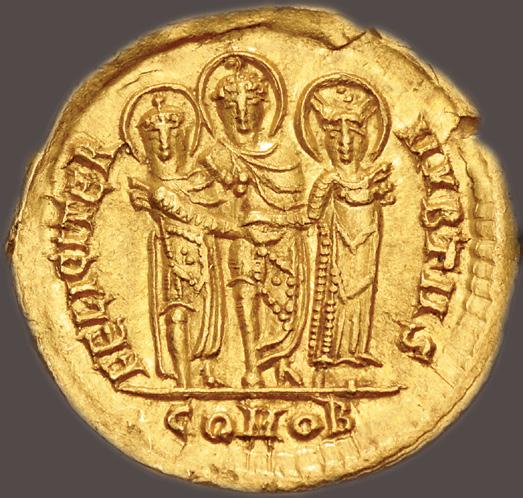
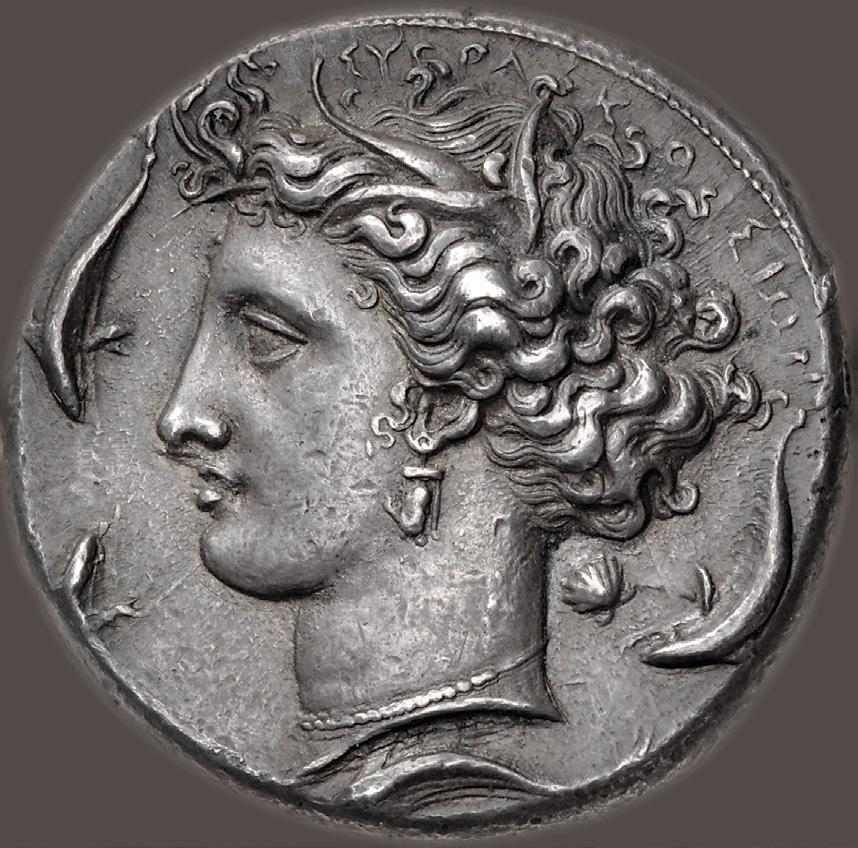

CNG Feature Auction 126 May 28-29, 2024 CNG Classical Numismatic Group, LLC
May 28–29, 2024
To Be Conducted Live Online at the CNG Lancaster Office
Featuring:
The Wild Rose Collection of Ancient Coinage
Two Remarkable Dekadrachms of Syracuse
Extremely Rare Tetradrachm of Mithradates III
Further Selections from the Beniak Collection of Alexandrian Coinage
Roman Republican and Imperial Coins from the GS Collection
A Selection of Romano-British Coinage from the Dr. Malcolm Lyne Collection
Extremely Rare Imperial Marriage Issue Solidus of Valentinian III
Late Roman and Byzantine Coins from the Family of Constantine Collection
Extremely Rare Joint Reign Solidus of Justin II & Tiberius II Constantine
Further Selections from the Causeway Collection of Anglo-Saxon Coinage
‘Fine Work’ William III Gold 5 Guineas in MS 62
Top Pop Gold 5 Guineas of James II

Email cng@cngcoins.com
Classical
Box
(717)
Fax (717)
Bloomsbury Street, London WC1B 3QA, UK Phone +44.20.7495.1888 Fax +44.20.7499.5916
The Hague,
Numismatic Group, LLC US OFFICE PO
479, Lancaster, PA 17608-0479 Phone
390.9194
390.9978 UK OFFICE 20
EU OFFICE Noordeinde 64a, 2514GK,
NL Phone +31.851.301.541 EMAIL & WEBSITE
Website www.cngcoins.com Pennsylvania License Number AY002406 CNG Feature Auction 126
Grading Conditions
English Deutsch Français Italiano
Proof Polierte Platte
Mint State/Uncirculated Stempelglanz
Flan Bruni Fondo Specchio
Fleur de Coin Fior di Conio
Extremely Fine (EF) Vorzüglich Superbe Splendido
Very Fine (VF)
Sehr Schön Très Beau Bellissimo
Fine Schön Beau Molto Bello
Good/Fair Gut
Common Abbreviations
AD Anno Domini
Æ Bronze
AE Actian Era
AH Anno Hegirae
AR Silver
AV Gold
BBS Buy or Bid Sale
Bien Bello
BE Bithynio-Pontic Era IY Indictional Year
BI Billon MBS Mail Bid Sale
CE Common Era mm Mintmark
Cf. Confer (compare) PB Lead
c/m Countermark p. Page
CY Civic Year (Era) pl. Plate
EL Electrum RPE Roman Provincial Era
BC Before Christ FPL Fixed Price List RY Regnal Year
BCE Before the Common Era g Gram SE Seleukid Era
See Bibliography on our website, www.cngcoins.com, for a complete list of reference abbreviations.
Bank Accounts
Beneficiary: Classical Numismatic Group, LLC
US$ Account:
PNC Bank, N.A.
€ Account:
HSBC Bank plc
£ Account:
HSBC Bank plc
249 Fifth Ave., Pittsburgh PA 15222 60 Queen Victoria Street, London EC4N 4TR 60 Queen Victoria Street, London EC4N 4TR
Account Number: 5005069595
ABA Number: 031000053
BIC or SWIFT: PNCCUS33
Account Number: 84309198
Sort code: 40 12 76
IBAN: GB82HBUK40127684309198
BIC or SWIFT: HBUKGB4B
Account Number: 71170910
Sort code: 40 11 60
IBAN: GB45HBUK40116071170910
BIC or SWIFT: HBUKGB4B
Classical Numismatic Group, LLC is a United States limited company. Auction license number AY002406. United Kingdom Registration No. FC035702, Branch No. BR020787.
All lots in this auction were in the possession of CNG in CNG’s Lancaster, Pennsylvania office no later than 1 April 2024. This information is provided for the protection of buyers in the event that US import restrictions are introduced subsequent to that date on any of the types of coins that are included in this auction.
Notice Regarding “Slabs”
Coins that have been encapsulated (“slabbed”) by a grading and/or authentication service may not be returned for any reason, including authenticity, if they have been removed from the encapsulation (“slab”).
Acknowledgement
CNG would like to thank Jan Moens (jan.moens@bvdmc.com) for creating and providing the Numismatica Medievalis font used in this sale.
AUCTION TERMS
This is a public and Internet auction conducted by Classical Numismatic Group, LLC (CNG). Bidding in the auction constitutes acceptance of the following terms:
1. The property listed in this catalogue is offered for sale by CNG for itself and as agent for various owners and other consignors. We reserve the right to reject any bid, to determine the opening price, to set bidding increments, to vary the order of the auction, to reopen bidding in the case of a dispute, to withdraw any lot, to bid on behalf of CNG, to bid on behalf of the consignor, to permit the auctioneer to bid on his own behalf, and to permit the consignor, where reserves have been agreed, to bid on his own lots. CNG may loan or advance money to consignors or prospective bidders, and may have an interest other than commission charges in any lot. CNG may bid on its own account as an “insider” with information not available to the public.
2. A buyer’s fee will be charged to all successful bidders as follows on the hammer price:
A. 25% for written, fax, email, and telephone bids.
B. 22.5% for floor bids placed in person at the auction and electronic bids placed directly on www.cngcoins.com. All written bids, email bids, nonlive telephone bids, live internet bid registrations, and live telephone bid registrations must be received before 5PM Eastern time on the day before the auction begins. CNG reserves the right to change the format of www. cngcoins.com at any time.
3. All coins are guaranteed genuine. Attribution, date, condition, and other descriptions are the opinion of the cataloguer, and no warranty is expressed or implied. Please note that an auction sale is not an approval sale. Lots examined prior to the sale and lots purchased by floor bidders (including bidders executing commission bids on behalf of other parties) may not be returned for any reason except lack of authenticity. All claims of misdescription and all claims of return, except claims regarding authenticity, must be made within 5 days of receipt of material. No refund will be provided due to grade or “adjectival” comments by a third party grading service if a coin is submitted for grading after the sale. Any claim of lack of authenticity must be made in writing by the original purchaser immediately after discovery that an item is not authentic, and upon making such a claim the original purchaser must immediately return the lot to CNG in the same condition as at the time of the auction. Any coin returned as “not authentic” which CNG feels is genuine will be submitted to the International Association of Professional Numismatists Authentication Bureau (IBSCC) for final decision of authenticity. No refund shall be made on such coins until the IBSCC makes their determination. This includes coins that have been submitted to a third-party grading service after the auction. Coins that have been previously encapsulated (“slabbed”) by a grading and/or authentication service may not be returned for any reason, including authenticity, if they have been removed from the encapsulation (“slab”). If payment is made by credit card, rights of return are governed by these Auction Terms which supersede any rights of return promulgated by the card issuer. Estimates are intended as a guide only and not as a statement of opinion of value.
4. Invoices are due and payable immediately upon receipt. Interest and late fees of 2.0% per month, or at the highest rate permitted by law, whichever is less, from the date of the auction, shall be payable on invoices not settled within 30 days of the auction date. Payment may be made by check or bank wire. Credit cards (Visa or MasterCard) will be accepted; credit card payments will not be accepted more than 14 days after the sale date. Payment by credit card for printed sale auctions will be charged a 2.5% handling fee. Payment by check must be made in either US dollars ($) drawn on a US bank or British sterling (£) drawn on a British bank. All successful bidders outside North America and the United Kingdom will be charged an additional $20 fee for bank charges that are the result of international wire transfer fees; this fee will be deducted for credit card or check payment as described above. CNG may reduce or compromise any charge or fee at its discretion.
5. Bidders not known to us must provide us with satisfactory credit references or pay a deposit as determined at CNG’s discretion before bidding. Minors are not permitted to bid without written consent of a parent guaranteeing payment. CNG may require payment in full from any bidder prior to delivery of lots. Title does not pass until lots are paid in full. Upon receipt of lots, the buyer assumes full responsibility for loss or damage. Delivery to the buyer’s address of record shall constitute receipt by the buyer regardless of the identity of the person accepting delivery.
6. Estimates are in U.S. dollars ($US) and bids must be in even dollar ($) amounts. CNG will execute mail bids on behalf of mail bidders. Subject to reserves and opening prices, mail bids will be executed at one bidding increment (approximately 10%) over the next highest bid. In the case of identical bids, the earliest bid wins. A mail bid has priority over an identical floor bid. Bid by lot number. No lots will be broken. Bidders are responsible for errors in bidding. Check your bid sheet carefully.
7. All lots are subject to reserve unless otherwise indicated.
8. Bidders personally guarantee payment for their successful bids, including bidders executing commission bids from other parties and bidders representing corporations or other entities. Buyers accepting commission bids from other parties do so at their own risk and remain responsible for payment under these Auction Terms.
9. At the conclusion of bidding for each lot, the sale contract is concluded and the successful bidder becomes liable for immediate payment under these Auction Terms. In the event a successful bidder fails to make full payment within 30 days of the auction date, CNG reserves the right either: (a) to require payment as provided under these Auction Terms; or (b) to deem the sale incomplete and to re-auction the material, in which case the successful bidder agrees to pay for the reasonable cost of such a sale and also to pay any shortfall between the re-auction price and the successful bidder’s purchase price. CNG reserves all rights that it is entitled to under the Pennsylvania Uniform Commercial Code, including the right to offset any sums due from a successful bidder against any future consignment or purchase or monies or goods in possession of CNG.
10. Sales tax, postage, handling and insurance are the responsibility of the buyer and are added to all invoices where appropriate. For buyers in the United Kingdom, CNG may import lots into the United Kingdom prior to shipment and charge buyers the import Value Added Tax. On any tax not paid by the purchaser which should have been paid, even if not invoiced by CNG, the purchaser agrees to pay the same on demand together with any interest or penalty that may be assessed. It is the responsibility of the buyer to comply with foreign customs and other regulations.
11. Prices realized are published after the sale and are mailed with CNG’s next publication. Prices realized are also posted after the sale on CNG’s web site: www.cngcoins.com
12. Bidders hereby waive any claim for incidental, consequential or exemplary damages arising from this auction. The sole remedy that any participant in the auction shall have for any claim or controversy arising out of the auction shall be a refund, without interest, of all or part of the purchase price paid by the participant.
13. All rights granted by CNG or otherwise available to bidders and purchasers, under these Auction Terms or otherwise, are personal and may not be assigned or transferred to any other person or entity, whether by operation of law or otherwise. No third party may rely on any benefit or right conferred by these Auction Terms. Bidders acting as agents must disclose the agency in writing to CNG prior to the auction; otherwise rights are limited to the agent and are not transferable to the undisclosed principal.
14. Any dispute regarding this auction shall be governed by the laws of Pennsylvania and shall be adjudicated only by the Lancaster County Court of Common Pleas or the U.S. District Court for the Eastern District of Pennsylvania; all bidders submit themselves to the personal jurisdiction of these courts for this purpose, consent to service of process by registered or certified mail, and waive any contrary provisions of Articles 14 or 15 of the French Civil Code and any similar provisions in any jurisdiction. All bidders consent to the confidentiality of consignors’ identities and waive any right to require disclosure of the name of the consignor or owner of any auction lot, whether such right is based on New York GOL §5-701(a) or any other provision in any jurisdiction. In any dispute regarding this auction, the prevailing party shall be entitled to recover its reasonable costs and attorney fees.
Meet the Team















 Mike Gasvoda Managing Director Lancaster Office
Victor England Consulting Director Lancaster Office
Eric McFadden Consulting Director London Office
Dave Michaels Director Shows & Consignments Lancaster Office
Caroline Holmes Numismatist London Office
Lance Hickman Managing Numismatist Consignment Staff Lancaster Office
Steve Lloyd Numismatist Islamic Specialist London Office
Julian Okun-Dubitsky Numismatist Lancaster Office
Jeffrey B. Rill Numismatist Lancaster Office
Bill Dalzell Managing Numismatist Cataloging Staff Lancaster Office
Bradley R. Nelson Senior Numismatist Lancaster Office
D. Scott VanHorn Senior Numismatist Lancaster Office
David Guest Director, London London Office
Paul Hill Director, London London Office
Max Tursi Director, EU EU Office
Tom Mullally Numismatist Lancaster Office
Mike Gasvoda Managing Director Lancaster Office
Victor England Consulting Director Lancaster Office
Eric McFadden Consulting Director London Office
Dave Michaels Director Shows & Consignments Lancaster Office
Caroline Holmes Numismatist London Office
Lance Hickman Managing Numismatist Consignment Staff Lancaster Office
Steve Lloyd Numismatist Islamic Specialist London Office
Julian Okun-Dubitsky Numismatist Lancaster Office
Jeffrey B. Rill Numismatist Lancaster Office
Bill Dalzell Managing Numismatist Cataloging Staff Lancaster Office
Bradley R. Nelson Senior Numismatist Lancaster Office
D. Scott VanHorn Senior Numismatist Lancaster Office
David Guest Director, London London Office
Paul Hill Director, London London Office
Max Tursi Director, EU EU Office
Tom Mullally Numismatist Lancaster Office















 Steve Pruzinsky Chief Financial Officer Lancaster Office
Kate Rill Customer Relations Manager Lancaster Office
David James III Photographer Lancaster Office
Dylan Ossman Office Manager Lancaster Office
Julia Motter Shipping Lancaster Office
Jennifer Ventura Shipping Lancaster Office
Dawn Ahlgren Shipping Lancaster Office
Lynn Gasvoda Administrative Assistant Lancaster Office
Travis Markel Manager IT & Production Lancaster Office
Christian Ventura Photographer Lancaster Office
Veronica Morris Office Manager London Office
Sharon Pruzinsky Accounting Lancaster Office
Bryan Kohn Numismatist Lancaster Office
Kan Liu (Vera) Consignments and Marketing Lancaster Office
Daniel Burch Numismatist Lancaster Office
Katie Vint Numismatist Lancaster Office
Steve Pruzinsky Chief Financial Officer Lancaster Office
Kate Rill Customer Relations Manager Lancaster Office
David James III Photographer Lancaster Office
Dylan Ossman Office Manager Lancaster Office
Julia Motter Shipping Lancaster Office
Jennifer Ventura Shipping Lancaster Office
Dawn Ahlgren Shipping Lancaster Office
Lynn Gasvoda Administrative Assistant Lancaster Office
Travis Markel Manager IT & Production Lancaster Office
Christian Ventura Photographer Lancaster Office
Veronica Morris Office Manager London Office
Sharon Pruzinsky Accounting Lancaster Office
Bryan Kohn Numismatist Lancaster Office
Kan Liu (Vera) Consignments and Marketing Lancaster Office
Daniel Burch Numismatist Lancaster Office
Katie Vint Numismatist Lancaster Office
Meet the Team
John W. Yurchak Printing Control
Islamic
A.J. Gatlin IT Consultant Additional
Tim Wilkes
Consultant
Support
Rill Auctioneer PA License No. AU006206
Jeffrey
B.
Auctioneer PA License No. AU005870
Brian Callahan
With the CNG Bidding Portal, you can:
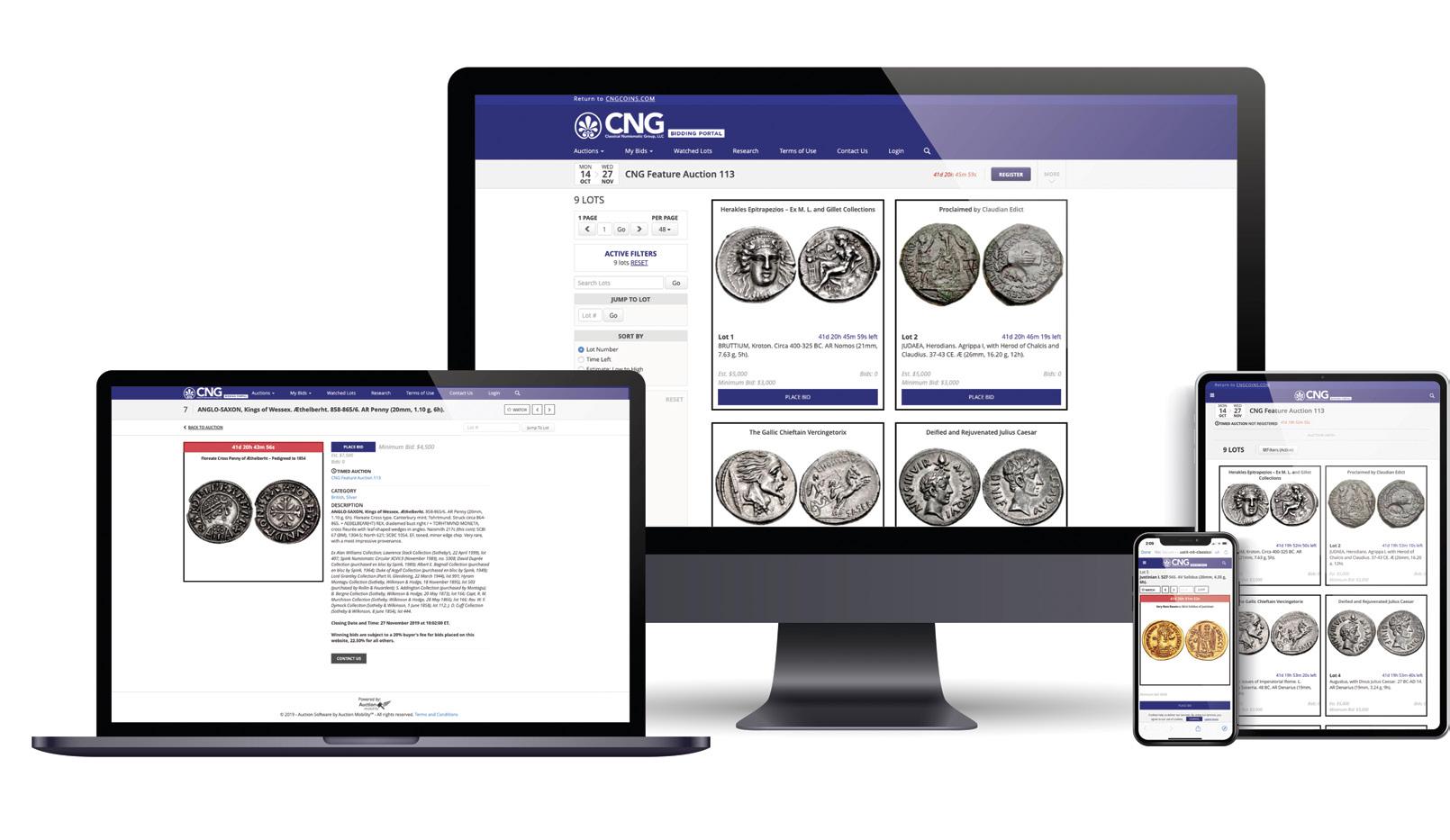
• Log on and bid at any time at auctions.cngcoins.com
• View the lots, follow the bidding, and see hammer prices as they are sold
• Hear and see the auctioneer live
• Enjoy all the advantages of an auction room bidder to win your favorite lots
To bid live in this Feature auction:
• Visit our new Bidding Portal before the auction at auctions.cngcoins.com
• Register online with your email address and a password
• Once approved, you may place pre-bids up until the moment the lot opens in the auction room
• On the auction day, login to join the auction and participate live
Please Note
• If you have not already registered for our bidding platform, you must create a new registration at auctions.cngcoins.com/register. Your old cngcoins.com handle and password will not allow you to log on or bid.
• You must register to bid before 5PM EST on Monday, May 27, 2024
• All lots won through the CNG Bidding Portal will be subject to a 22.5% buyer’s fee






Participate in CNG 126 using CNG’s Bidding Portal
Download our APP now to browse and participate in our auctions! Follow us for more information! App Store Facebook Instagram YouTube X Google play
Lot Viewing
Lancaster, PA
Auction lots may be viewed at our Lancaster Office from April 15 – May 27, 2024, by appointment only, except when they are on exhibition at the viewings below. Lancaster Office Hours: 10 AM - 5 PM (Monday - Friday).
Schaumberg, IL
Select lots will be available for viewing at the Central States Numismatic Convention, May 1–4, 2024, at the Schaumberg Renaissance Hotel and Convention Center, 1551 North Thoreau Drive, Schaumberg, IL.
San Francisco, CA
Select lots will be available for viewing at the San Francisco Historical Bourse, May 11, 2024, at the Doubletree Hotel, 275 S. Airport Blvd., South San Francisco, CA.
Online Viewing
Enlargements of all single lots and selected multiple lots may be viewed on the internet at

NumisBids.com
We are sorry, but photographs of individual coins in multiple lots cannot be provided
Auction Location
This sale will be conducted live Online from our Lancaster, PA Office.
Lot Pickup
Lots will be mailed from our Lancaster, PA Office subsequent to the sale.
7
CNGCOINS.COM SIXBID.COM
ORDER OF SALE
8
Session One – Tuesday Morning – May 28 – 9:00 AM Celtic Coinage 1-9 Greek Coinage (part 1) .................................................... 10-329 Session Two – Tuesday Afternoon – May 28 – 2:00 PM Greek Coinage (part 2) ................................................... 330-385 Oriental Greek Coinage .................................................. 386-406 Central Asian Coinage ................................................... 407-432 Roman Provincial Coinage ................................................ 433-518 The Beniak Collection of Alexandrian Coinage ................................ 519-577 Roman Republican Coinage .............................................. 578-646 Session Three – Wednesday Morning – May 29 – 9:00 AM Roman Imperial Coinage ................................................. 647-906 The Family of Constantine Collection (part 1) ................................. 907-968 Session Four – Wednesday Afternoon – May 29 – 2:00 PM The Family of Constantine Collection (part 2) ................................ 969-1036 Byzantine Coinage .................................................... 1037-1051 Early Medieval Coinage ................................................ 1052-1053 Islamic Coinage ........................................................... 1054 World Coinage ....................................................... 1055-1146 World Medals ........................................................ 1147-1156 United States Coinage .................................................. 1157-1160 British Coinage 1161-1285 British Medals 1286
Dedicated to the memory of Bob Trimble. You are missed, friend.

9
The Wild Rose Collection
The Wild Rose Collection was assembled and carefully curated over a 40-year span by an avid collector/historian who attended university then worked in a public service position until retirement. The collector, who lived near the Canadian Rockies, passed away early this year. He had a lifetime interest in ancient coinage and spent countless hours acquiring, researching, cataloguing and promoting his coins, both for his own enjoyment and the education of others. He regularly wrote articles about individual coins and gave in-person lectures to students and fellow collectors. In the process, he cultivated an extensive network of friends and dealer connections both online and through travelling to shows in Europe and the US. He also supported several educational endeavours, hoping to instil his own passion for history while creating a new generation of students and collectors.
His life focus was on assembling a high-quality group of interesting Greek and Roman coins that exemplified their historical diversity and the artistry of ancient celators. The Wild Rose Collection is offered in celebration of his spirit and for the edification of his many friends
10
Session 1 – Tuesday, May 28, 2024 — 9 AM
CELTIC COINAGE
An Exceptional Example


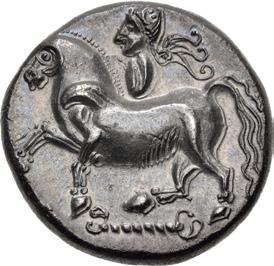
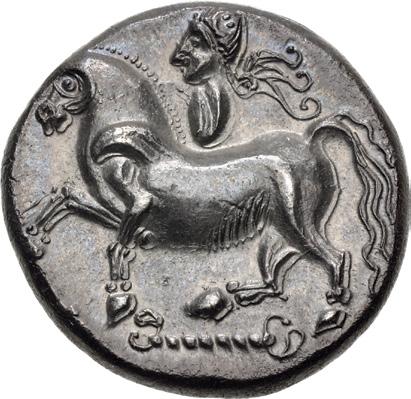
1. EASTERN EUROPE, Imitations of Philip II of Macedon. 2nd century BC. AR Tetradrachm (22mm, 12.08 g, 12h). Kroisbach type. Mint in Burgenland or Western Slovakia. Diademed, beardless head right, with “boxer’s nose” and pronounced jaw line / Rider on horseback left, showing only his torso, hair bound with diadem and tied into a topknot with three trailing curls; below, torque. OTA 749; Lanz 744; CCCBM I 154; KMW 1391. Richly toned. Choice EF. An exceptional piece with superb strike, detail, and metal quality. ($1500)

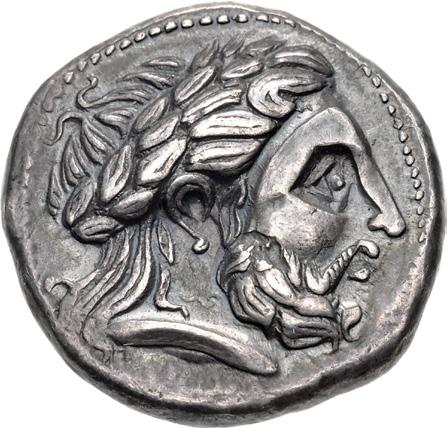
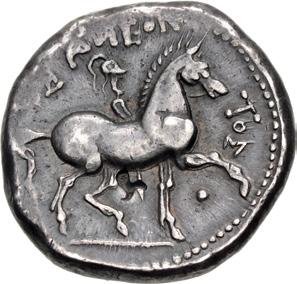
2. EASTERN EUROPE, Imitations of Audoleon of Paeonia. 2nd century BC. AR Tetradrachm (25mm, 13.34 g, 7h). Uncertain mint in the lower Danube region. Laureate head of Zeus right / Helmeted warrior on horseback right; pellet below raised foreleg. OTA 402/1; Lanz 704-6; CCCBM I 114 (same dies); KMW 1320-4. Deeply toned, punch mark on reverse below horse as is normal for this issue. Good VF. ($1000)
Ex Mark & Lottie Salton Collection.
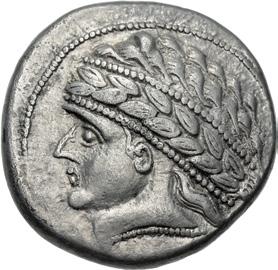


3. CENTRAL EUROPE, Noricum (West). Circa 170-150 BC. AR Tetradrachm (23mm, 12.17 g, 10h). Kugelreiter type. Wreathed, diademed, and beardless head left / Rider on horseback left, with headdress decorated with three balls (kugeln). Göbl, Noricum A1, 1 (dies 1/1); Lanz 107; KMW 782-3. Toned, worn and slightly rusted dies, fingerprint. Good VF. ($1500)
11


4. GAUL, Northwest. Aulerci Eburovices. Late 3rd-early 2nd century BC. AV Hemistater (20.5mm, 2.65 g, 1h). Celticized head of Apollo left, dotted bands with central zig-zag line on cheek; spiral ornaments below / Celticized biga right, with devoloved charioteer above; large X-like ornament to right; below, wolf with large mouth right. Scheers, Eburovices, Series Ic, Class III, 13–6; Depeyrot, NC V, 137; D&T 2395; Flesche 200 (this coin); de la Tour 7019. Irregular flan. Near EF. Very rare, of only 18 examples listed by Depeyrot, nearly half are in museum collections. ($750)
Ex Christian Flesche Collection; CGB 32 (6 December 2007), lot 927.
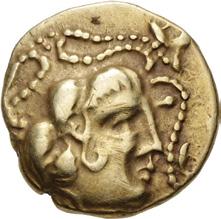
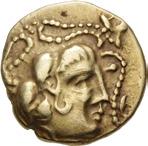
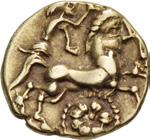

5. GAUL, Northwest. Veneti. 3rd century BC. AV Quarter Stater (12mm, 1.90 g, 10h). Celticized head right, ornamented with pearl strings flowing around / Devolved charioteer, holding reins and long branch connected to vexillum-like device to right, driving biga led by androcephalic horse right; below, rose within pelleted annulet. D&T 2136; Depeyrot, NC 197; de La Tour 6903. Toned, light scratches, struck from worn dies. VF. Well centered. Very rare. ($750)
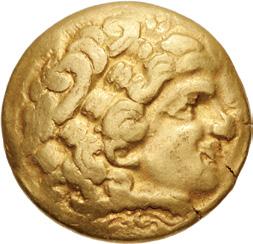
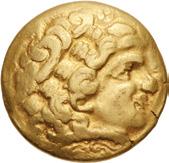
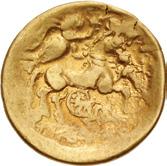
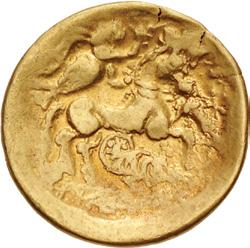
6. GAUL, Northwest. Uncertain tribe. 3rd century BC. AV Quarter Stater (13mm, 1.91 g, 7h). Celticized head right, with traces of laurel wreath / Celticized horse right, being crowned by Victory flying right; hippocamps below and to right. P.-M. Guihard, “La série «aux monstres marins» rattachable au groupe de Normandie,” in Cahiers Numismatiques 169 (September 2006), Class II, fig. 9; D&T S 2066D; Depeyrot, NC VIII 40; de La Tour –. VF. Very rare. ($1000)

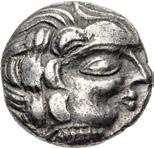

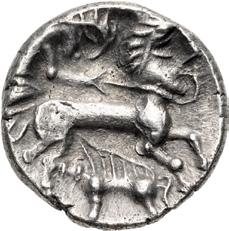
7. GAUL, Northwest. Uncertain tribe. 1st century BC. AR Quarter Stater (13mm, 1.81 g, 2h). Celticized head of Apollo right / Devolved charioteer, holding reins, driving biga led by androcephalic horse right; below, boar standing left. Unpublished in the standard references. EF. Very rare. ($500)
This rare coin does not appear to have any exact parallel in the references. The obverse style most closely resembles the billon staters of the Riedones, particularly in the hair, eyes, and lips, while the reverse with a boar below is known for several tribes.
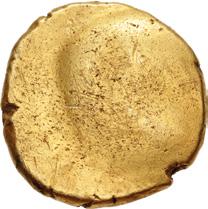
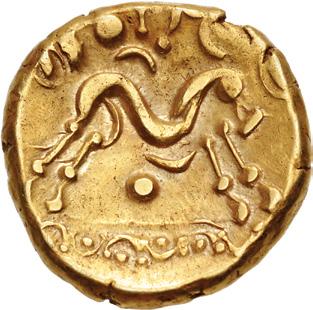
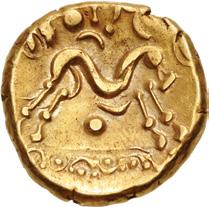
8. GAUL, Northeast. Ambiani. Circa 58-55 BC. AV Stater (18mm, 6.19 g). Gallo-Belgic E. Gallic Wars Issue. Plain bulge / Large disjointed horse right; ornaments around; solid exergue line above pellets-in-crescents. Depeyrot, NC VI, 161; D&T 240; Van Arsdell 52-1; ABC 16; SCBC 11. Light scratches on obverse. VF. ($500)
Ex Dr. Thomas Daily Collection (Classical Numismatic Group 69, 8 June 2005), lot 7.
12
Flesche
Ex
Collection
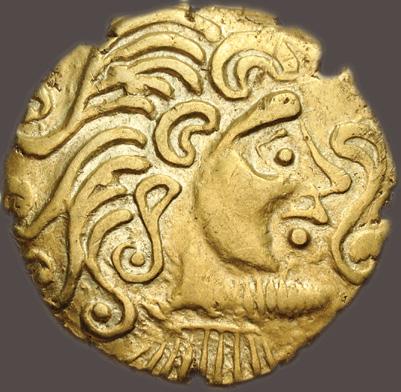
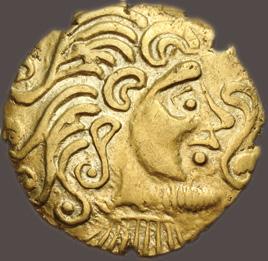


9. GAUL, Northeast. Parisii. 2nd century BC. AV Stater (22mm, 7.41 g, 4h). Class IV (“au nez retroussé”). Celticized head of Apollo right; ornament before / Celticized horse galloping left; the charioteer devolved into a fan shape with checkerboard design, rosette below. CdB fig. 14, 3 (same dies); D&T 81; Depeyrot, NC V, 187; de la Tour 7792; Triton XVI, lot 625 (same dies in later state). Small scuff on obverse, edge splits. EF. Well struck. Very rare. Same dies as Triton XVI example cited above, though in an earlier state, this coin is exceptional for the quality of strike and considerable original luster in devices. ($25,000)
Much of the Celtic gold coinage consisted of stylized derivatives of the ubiquitous gold staters of Philip II type. Originally copied faithfully by Celtic tribes along the Danube, these types of Apollo and chariot slowly spread westward among the coinage of the central and western European tribes, who continually modified their appearance and often added subsidiary symbols that apparently held local significance. The Parisii made their staters into works of art, their coins being among the finest of all Gallic issues. The extraordinarily rich artistic treatment of the horse is characterized by a curvilinear triangular formation above it, the so-called ‘wing’, containing square compartments, each enclosing a pellet, perhaps representing the canopy of heaven. According to Caesar’s De Bello Gallico (VI 3), the capital of the Parisii was the village of Lutetia on a marshy island in the Seine. The Parisii sided with Vercingetorix against the Romans, and the Celtic chieftain sent a force under his lieutenant, Camulogenus, to secure the area. Camulogenus and his men were soon defeated near Melun, and the region came under Roman control. Lutetia was thoroughly Romanized, and although it flourished, the town was of minor importance compared to Agedincum, the capital of its province, Lugdunensis Senona. The town was renamed Paris, after the Celtic tribe, in the third or fourth century, but remained relatively small until the Merovingian Clovis made the city his capital in the early sixth century.
GREEK COINAGE
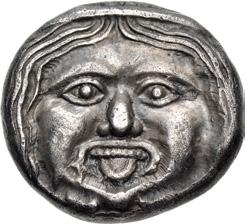
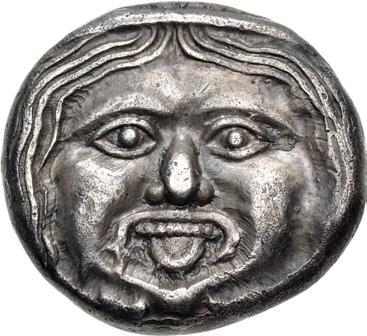
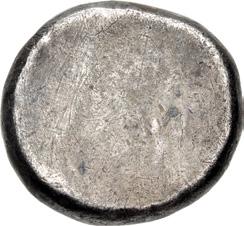
10. ETRURIA, Populonia. 3rd century BC. AR 20 Asses (20mm, 8.15 g). Diademed facing head of Metus; [c / ≈ (mark of value) below] / Blank. EC Group XII, Series 58.11 (O31 – this coin, illustrated); HN Italy 152; SNG BN 6–7 (same die); SNG Lockett 40 = Bement 19 (same die). Toned, light scratches under tone on reverse. Good VF. ($2000)
From the Wild Rose Collection. Ex Dr. P. Vogl Collection (Leu Numismatik 7, 24 October 2020), lot 1075; Leu 57 (25 May 1993), lot 1.

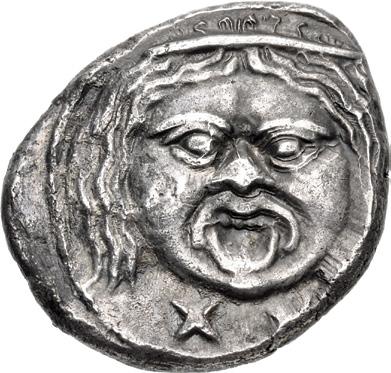
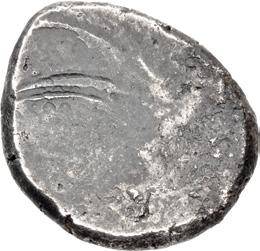
11. ETRURIA, Populonia. 3rd century BC. AR 20 Asses (21mm, 8.27 g). Diademed facing head of Metus; c ≈ (mark of value) below / Blank. EC Group XII, Series 59.45 (O36 – this coin, illustrated); HN Italy 152; BMC 12 (same die); SNG Fitzwilliam 62 (same die). Toned, traces of find patina, minor spots of roughness, a little die wear, some light scratches under tone. VF. ($1000)
From the Mesogeios Collection. Ex Peus 433 (1 November 2022), lot 1009; Gorny & Mosch 141 (10 October 2005), lot 26; Künker 97 (7 March 2005), lot 87; Münzen und Medaillen GmBH 4 (19 March 1999), lot 1; Ahlström 51 (8 April 1995), lot 1534.
13

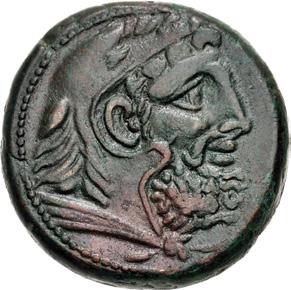
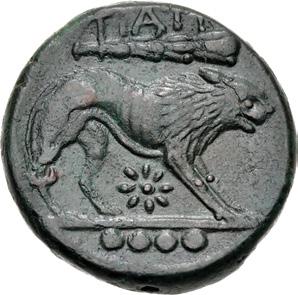
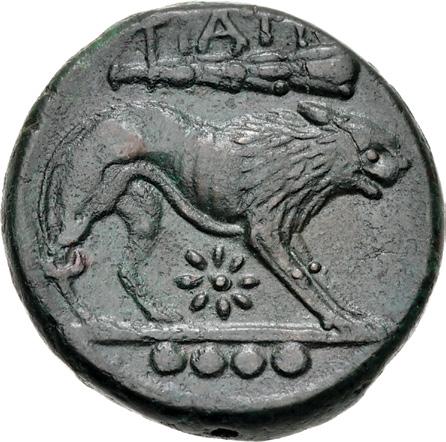
12. APULIA, Teate. Circa 225-200 BC. Æ Quadrunx (25mm, 13.87 g, 2h). Head of Herakles right, wearing lion skin / Lion standing right; club above, star of eight points below, •••• (mark of value) in exergue. HN Italy 704; SNG ANS 753. Attractive dark green patina, with some patches of red. Near EF. Exceptional for issue. ($500)
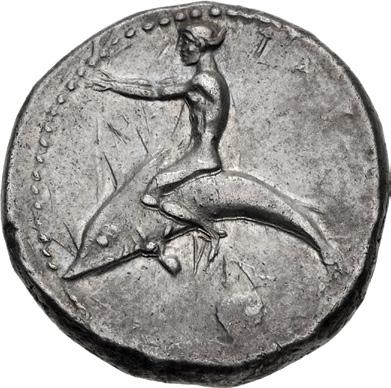
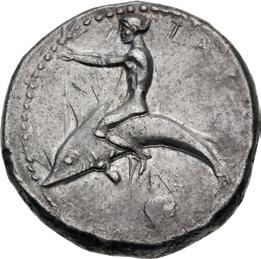

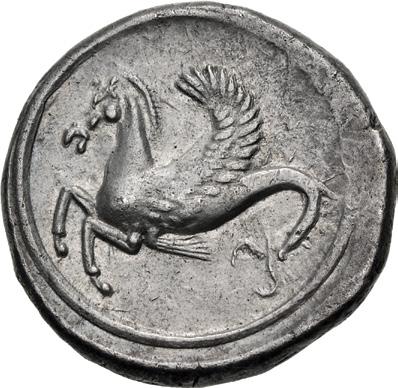
13. CALABRIA, Tarentum. Circa 465-455 BC. AR Nomos (21.5mm, 8.09 g, 4h). Phalanthos, arms extended, riding dolphin left; cockle shell below / Hippocamp left. Fischer-Bossert Group 7, 116 (V61/R78); Vlasto 133; HN Italy 827. Toned, area of weak strike, minor die flaws. Near EF. ($1500)
From the Wild Rose Collection. Ex ArtCoins Roma 19 (11 November 2015), lot 20.
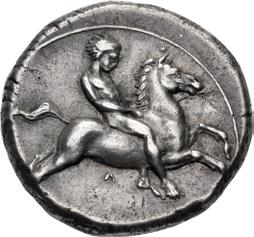


14. CALABRIA, Tarentum. Circa 390-385 BC. AR Nomos (20.5mm, 7.81 g, 12h). Nude youth on horse galloping right; tiny ¬ below / Phalanthos, nude, holding akrostolion, riding dolphin right; tiny ¬ below. Fischer-Bossert Group 28, 398d (V175/R307’ – this coin); Vlasto 375 (same dies); HN Italy 870. Old collection tone, a little off center and light scuff under tone on obverse. Good VF. ($1000)
From the Wild Rose Collection. Ex Matthew Curtis Collection (Classical Numismatic Group 112, 11 September 2019), lot 15; Monetarium 57 (Spring 1992), no. 3; Monetarium 55 (Spring 1991), no. 5; Auctiones AG 20 (8 November 1990), lot 53; Ars Classica XIII (27 June 1928), lot 37.

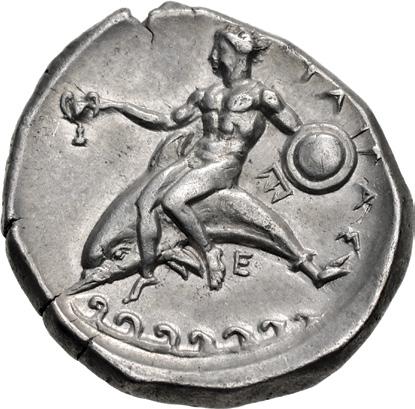

15. CALABRIA, Tarentum. Circa 340-335 BC. AR Nomos (22mm, 7.72 g, 2h). Nude youth, holding rein and crowning horse he rides right; f to right; below, nude youth removing stone from horse’s hoof / Phalanthos, nude, shield on arm, holding kantharos and trident, riding dolphin left; E and waves below. Fischer-Bossert Group 50, 696e (V262/R543 – this coin); Vlasto 510 (same obv. die); HN Italy 818; BMC 183 (same dies); SNG München 637 (same dies); Jameson 141 (same dies); de Luynes 294 (same dies); Nanteuil 99 (same dies). Lightly toned, slight die wear on obverse. Near EF. ($750)
From the Wild Rose Collection. Ex Dr. G. W. Collection (Gorny & Mosch 269, 9 March 2020), lot 84; Monetarium 54 (Autumn 1990), no. 9.
14



16. CALABRIA, Tarentum. Circa 280-272 BC. AR Nomos (22.5mm, 6.41 g, 3h). Reduced standard. Warrior on horseback right, holding shield and two spears, preparing to cast a third; ˝U to left, År5>st5>∏ in three lines below / Phalanthos, nude, holding bow and arrow, riding dolphin right; below, elephant standing right. Vlasto 712; HN Italy 999. Toned, minor lamination on obverse. VF. ($500)
From the Wild Rose Collection, purchased from Shanna Schmidt, 16 March 2020. Ex Berk BBS 179 (24 May 2012), lot 86; Schweizerische Kreditanstalt 1 (22 April 1983), lot 36.


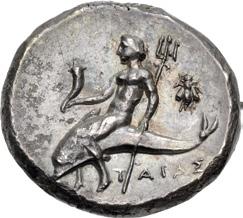
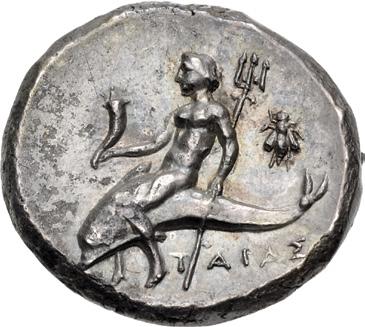
17. CALABRIA, Tarentum. Circa 272-240 BC. AR Nomos (18mm, 6.35 g, 3h). Nude youth crowning horse he rides right; f5 to left, zWπ-Uro-s below / Phalanthos, nude, holding cornucopia and trident, riding dolphin left; bee to right. Vlasto 855–6; HN Italy 1029. Iridescent tone, underlying luster, traces of find patina, minor flan flaws on obverse, small knock on reverse. EF. ($750)
Ex Côte and Pozzi Collections
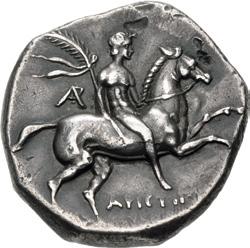
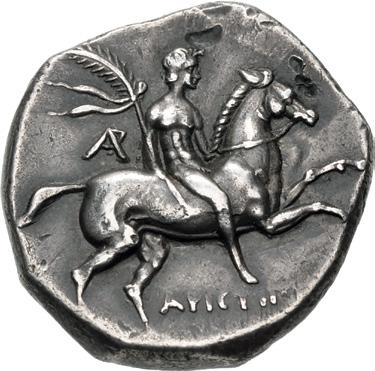

18. CALABRIA, Tarentum. Circa 240-228 BC. AR Nomos (20.5mm, 6.38 g, 11h). Reduced standard. Nude youth, holding filleted palm frond, on horse leaping right; 1 to left, År51t5π[πo1] below / Phalanthos, holding kantharos, on dolphin left; N to right. Vlasto 947–8; HN Italy 1056; Pozzi (Boutin) 385 (this coin). Old cabinet tone, small nicks, edge marks. Good VF. ($1000)
From the Wild Rose Collection. Ex Tom McKenna FPL 88-1 (January 1988), no. 11; Claudius Côte Collection (R. Ratto, 28 January 1929), lot 566; S. Pozzi Collection (not in Naville I sale).
Ex Vlasto Collection – Pedigreed to 1899

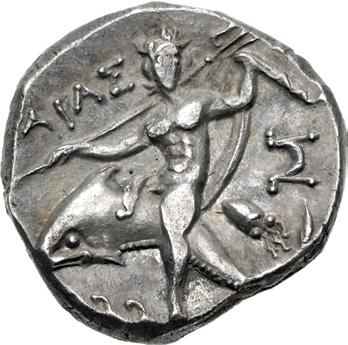
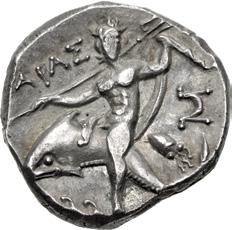
19. CALABRIA, Tarentum. Circa 240-228 BC. AR Nomos (19mm, 6.45 g, 9h). Reduced standard. Dioskouros, head facing, raising hand and holding rein, on horse stepping left; T and pileos to right; [$]E-@o˚rÅ>[t]-˙s in two lines below / Phalanthos, nude, head and torso facing, holding trident over shoulder and lifting drapery, riding dolphin left; to right, S above cuttlefish; waves below. Vlasto 960 (this coin); HN Italy 1058. Deeply toned, with some iridescence, compact flan, some flatness to strike on reverse. Good VF. ($750)
Ex Harlan J. Berk, Ltd. inventory CC19547 (ND); Michel Pandely Vlasto Collection; A. Sambon (11 December 1899), lot 81.
15


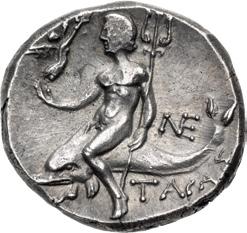

20. CALABRIA, Tarentum. Circa 240-228 BC. AR Nomos (20mm, 6.51 g, 11h). Reduced standard. Warrior, holding Nike, who crowns him, on horse rearing right; t behind, ˚Ŭ¬5˚r[Å]>t˙s in two lines below / Phalanthos, holding Nike, who crowns him, and cradling trident in left arm, riding dolphin left; " to right. Vlasto 963–6; HN Italy 1059. Darkly toned, traces of find patina, spot of flat strike on reverse. EF. Well centered on typically compact flan. ($1000)
From the Wild Rose Collection. Ex Dr. Lawrence A. Adams Collection (Part I, Classical Numismatic Group 100, 7 October 2015), lot 1240; Birkler & Waddell 2 (11 December 1980), lot 8.
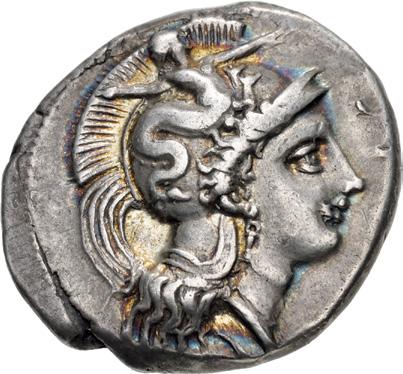
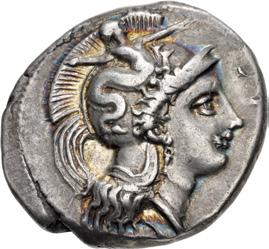
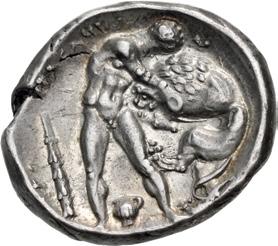

21. LUCANIA, Herakleia. Circa 390-340 BC. AR Nomos (22mm, 7.77 g, 8h). Head of Athena right, wearing singlependant earring, necklace, and crested Attic helmet decorated with Skylla throwing stone held in right hand; EU to right / Herakles standing facing, torso right, strangling the Nemean Lion to right; Åπo¬ and club to left, oinochoe below. Work 46 (same dies); Van Keuren 51 (same obv. die as illustration); HN Italy 1378; Bement 138 (same dies); McClean 825 (same dies). Iridescent tone, slight die wear. Good VF. ($2000)
From the Wild Rose Collection, purchased from Roma Numismatics, 6 December 2013. Ex Numismatica Ars Classica 59 (4 April 2011), lot 495.
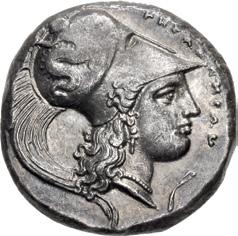
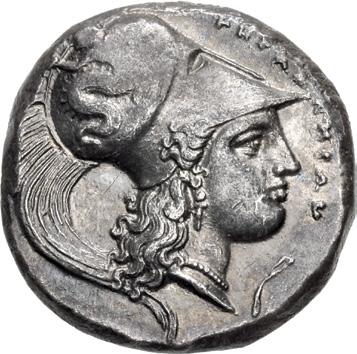
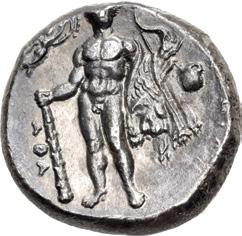
22. LUCANIA, Herakleia. Circa 330/25-281 BC. AR Nomos (19.5mm, 7.75 g, 9h). Helmeted head of Athena right / Herakles standing left, holding club and bow, lion skin draped over arm; to upper left, Nike flying right, crowning him; ÅQÅ to left, oinoechoe to right. Van Keuren 83; HN Italy 1384. Deeply toned, slightly compact flan, area of weak strike and die break on obverse. Near EF. ($750)
From the Mesogeios Collection. Ex Nomos Obolos 19 (8 May 2021), lot 33.
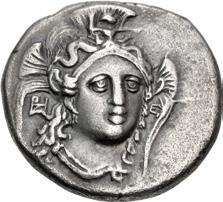


23. LUCANIA, Herakleia. Circa 281-278 BC. AR Drachm (17mm, 3.73 g, 4h). Helmeted head of Athena facing slightly right; ± below left crest, E below right crest / Owl standing right, head facing, on olive branch. Van Keuren 119 (same dies as illustration); HN Italy 1416. Toned, minor porosity, small die break on obverse. Good VF. ($500)
Ex CNG inventory 920694 (February 2012); Deyo Collection (Triton XV, 3 January 2012), lot 1029; Classical Numismatic Group 60 (22 May 2002), lot 69; Classical Numismatic Group 54 (14 June 2000), lot 161.
16
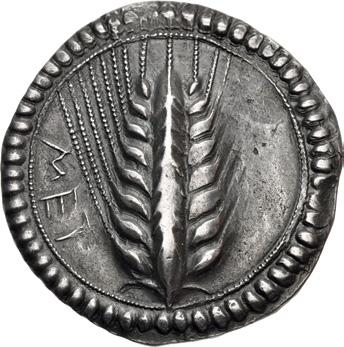
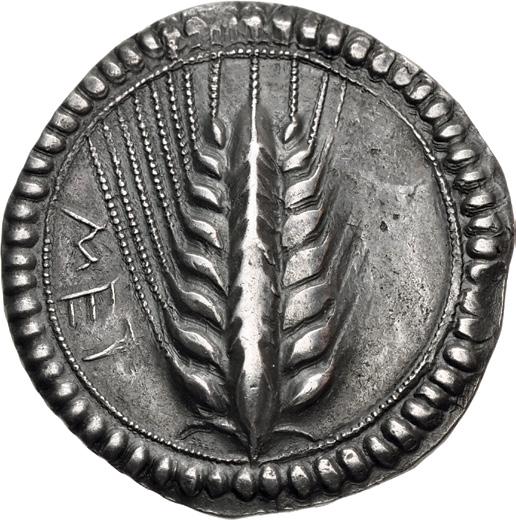
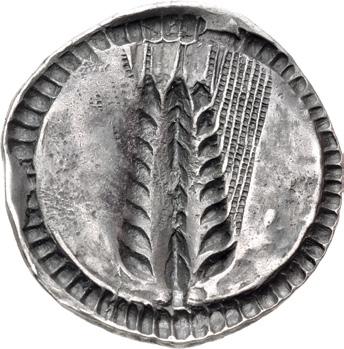
24. LUCANIA, Metapontion. Circa 540-510 BC. AR Nomos (28mm, 8.20 g, 12h). Ear of barley with eight grains and bracts at base; 7eT down left field, concentric dotted and pellet borders / Incuse ear of barley with eight grains; rayed border. Noe Class I, 21; Gorini –; HN Italy 1459. Deeply toned, area of weak strike. VF. Well centered. ($1000)
From the Wild Rose Collection. Ex CNG inventory 968524 (December 2013); Roma VI (29 September 2013), lot 312.


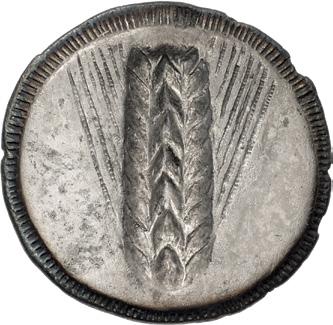
25. LUCANIA, Metapontion. Circa 540-510 BC. AR Nomos (28mm, 6.76 g, 12h). Ear of barley with eight grains; 7etåπ down left field / Incuse ear of barley with eight grains. Noe Class VII, 136 (same dies); HN Italy 1481. Deep, vibrant iridescent tone, cleaning marks, a few minor scratches under tone. Good VF. ($750)
Ex Heritage 232226 (29 June 2022), lot 65005.

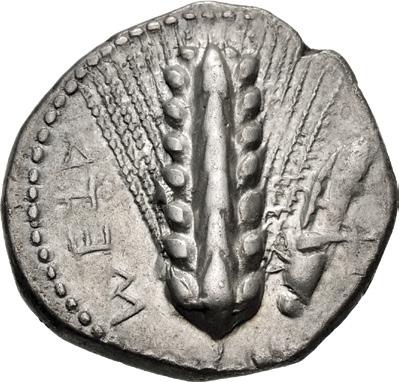
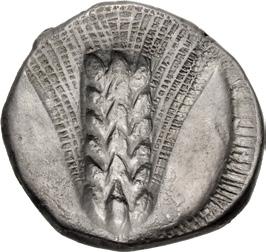
26. LUCANIA, Metapontion. Circa 470-440 BC. AR Nomos (21.5mm, 8.20 g, 12h). Ear of barley with eight grains; ÅtE7 upward to left; to right, grasshopper downward / Incuse ear of barley with six grains. Noe 259 (same dies); HN Italy 1486; SNG ANS 257 (same dies); SNG Fitzwilliam 468 (same dies). Slight weakness to strike. VF. ($1000)
From the Wild Rose Collection. Ex ArtCoins Roma 19 (11 November 2015), lot 52.
Ex Prospero Collection
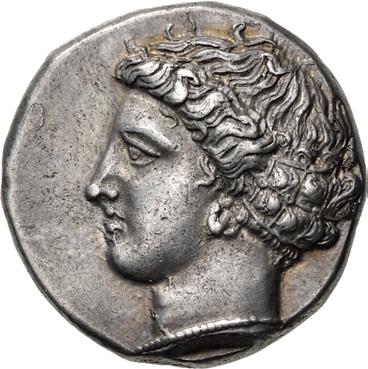


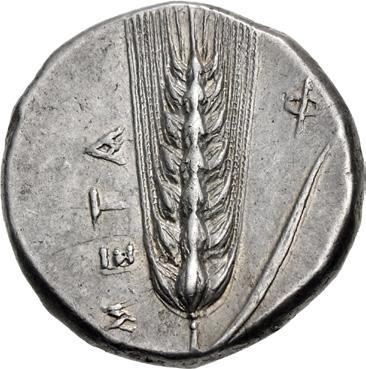
27. LUCANIA, Metapontion. Circa 400-340 BC. AR Nomos (20mm, 7.99 g, 8h). Head of Demeter left, hair bound by net, wearing hoop earring and pearl necklace / Barley ear with leaf to right at base; ÂEt& up left field, f above leaf. Noe 520 (same dies); HN Italy 1546; BMC 130 (same dies); McClean 968 (same dies); Prospero 68 (this coin). Attractive even light gray tone with golden hues around the devices. EF. Fine style. ($4000)
From the Wild Rose Collection. Ex Gasvoda Collection (Triton XXII, 9 January 2019) lot 37; Triton XIX (5 January 2016), lot 13; Triton XVII (7 January 2014), lot 16; Prospero Collection (New York Sale XXVII, 4 January 2012), lot 68.
17
Two Highly Artistic Nomoi from Metapontion
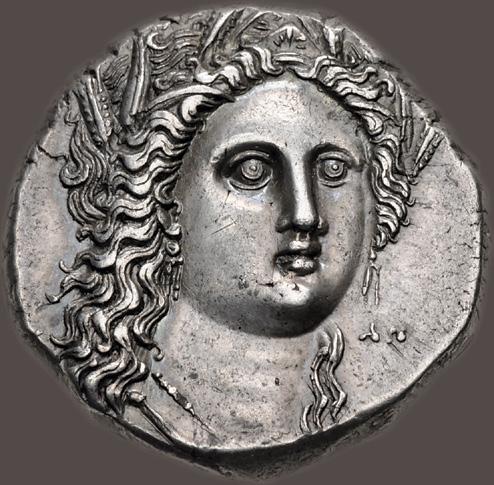
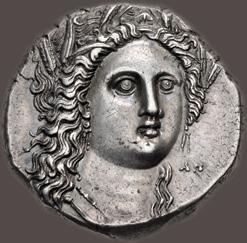

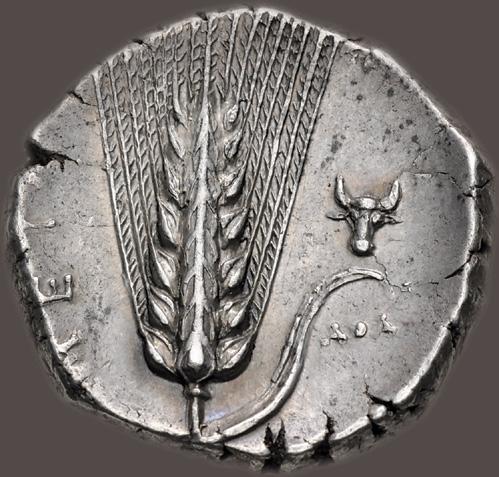
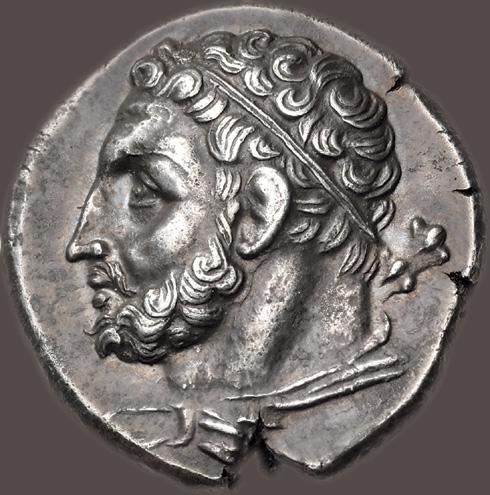

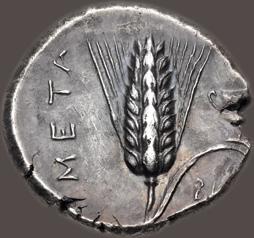
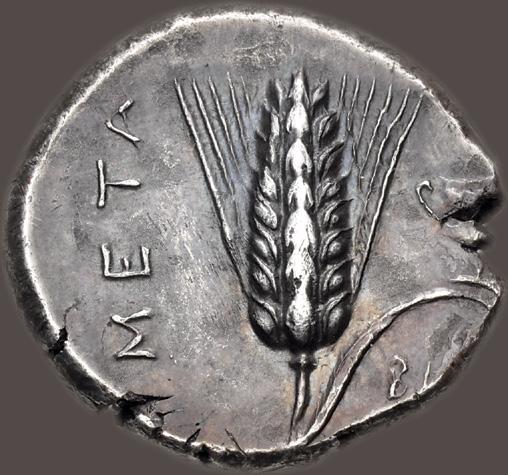
28. LUCANIA, Metapontion. Circa 330-290 BC. AR Nomos (20mm, 7.92 g, 4h). Head of Demeter facing slightly right, wearing grain ear wreath, triple-pendant earrings, and necklace; tiny Åπ to lower right / Barley ear with leaf to right; µEtÅ upward to left, facing bull’s head above leaf, ÅQÅ below. Johnston Class C, 2.2 (same dies); HN Italy 1584; SNG ANS 463–4 (same dies); SNG Fitzwilliam 503 (same dies); SNG München 992 (same dies); Dewing 388 (same dies). Attractive even gray tone with light golden hues around the devices, and underlying luster. Choice EF. Excellent metal and well struck from dies by the hand of a master engraver. ($7500)
From the Wild Rose Collection. Ex J. L. Gomer Collection (Triton XXI, 9 January 2018), lot 317; Tkalec (28 October 1994), lot 24.
29. LUCANIA, Metapontion. Circa 290-280 BC. AR Nomos (20mm, 7.95 g, 3h). Head of Herakles left, wearing tainia, lion skin around neck; club over far shoulder / Grain ear with leaf to right; ÂEtÅ up left field; kantharos above leaf, ∫5 below. Johnston Class D, 4.1 corr. (control letters on rev.; same dies); HN Italy 1621 corr. (same); Leu 61, lot 38 (same obv. die). Deeply toned, minor edge split. EF. Very rare with head left, and among the finest known. ($7500)
From the Wild Rose Collection, purchased from Shanna Schmidt, 20 February 2019. Ex Gasvoda Collection (Classical Numismatic Group 109, 12 September 2018) lot 18; Nomos 13 (7 October 2016), lot 115.
18
28 29
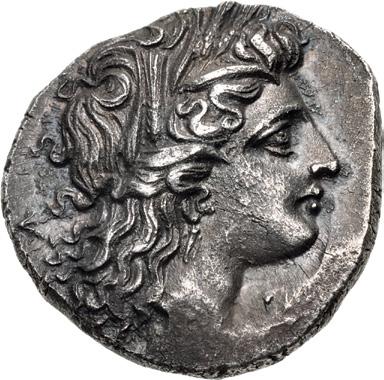
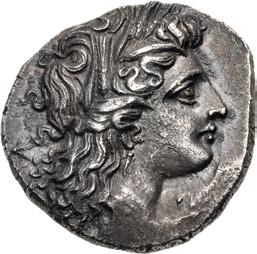
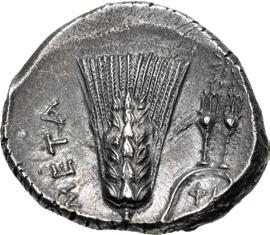
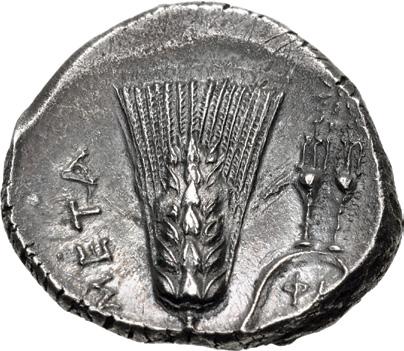
30. LUCANIA, Metapontion. Circa 290-280 BC. AR Nomos (21mm, 7.78 g, 7h). Wreathed head of Demeter right; d to left / Barley ear with leaf to right; above leaf, star above two amphoras; f5 below. Johnston Class D, 4.15 (same dies); HN Italy 1625. Toned, minor die wear, a few tiny flan flaws on obverse. Near EF. ($750)
From the W. Hansen Collection, purchased from D. F. Grotjohann, 20 October 2011. Ex G. Hirsch 233 (12 February 2004), lot 1237.
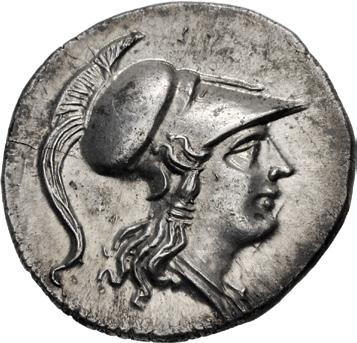


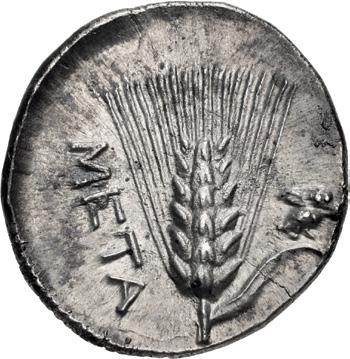
31. LUCANIA, Metapontion. Punic occupation. Circa 215-207 BC. AR Half Shekel – Drachm (19.5mm, 3.69 g, 10h). Helmeted head of Athena right / Barley ear with leaf to right; above leaf, owl standing right, head facing, with wings spread. Robinson, Second, p. 50, 3; HN Italy 1634. Traces of find patina, hairline flan crack, slight die wear on obverse. EF. ($500)
From the DFA Collection.

Ex Moretti Collection
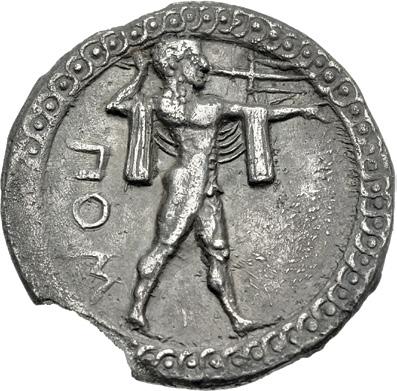

32. LUCANIA, Poseidonia. Circa 530-500 BC. AR Half Nomos – Drachm (21.5mm, 3.27 g, 12h). Poseidon, beardless and nude but for chlamys draped over both arms, standing right, preparing to cast trident / Incuse of obverse type, but no trident and ethnic is in relief. Gorini 6 = Basel 160 (this coin); HN Italy 1108. Old collection tone, edge chip, slightly granular surfaces. Near EF. ($1500)
Ex Gemini X (13 January 2013), lot 8 (edge chipped since); A.D. Moretti Collection (Numismatica Ars Classica 13, 8 October 1998), lot 160.
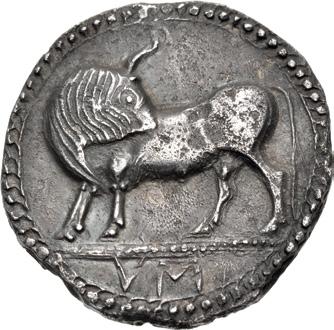
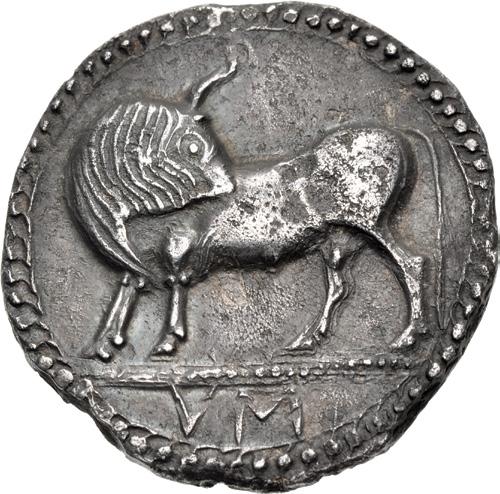
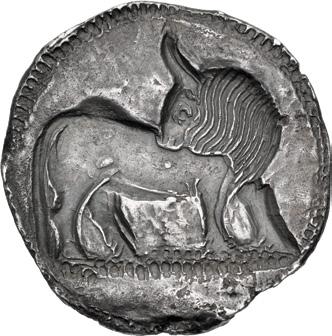
33. LUCANIA, Sybaris. Circa 550-510 BC. AR Nomos (27mm, 7.13 g, 12h). Bull standing left, head right / Incuse bull standing right, head left. S&S Class B, pl. XLVIII, 4–8; Gorini 2; HN Italy 1729. Deep iridescent tone, minor roughness on obverse, old edge chip and small mark on edge. VF. ($1500)
From the Wild Rose Collection, purchased from Baldwin’s, March 2017.
19

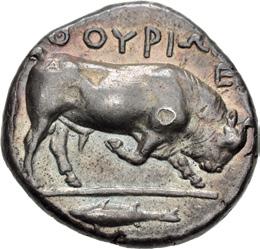

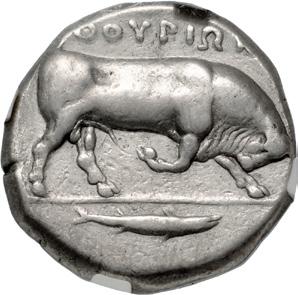
34. LUCANIA, Thourioi. Circa 443-400 BC. AR Nomos (21mm, 7.94 g, 6h). Head of Athena right, wearing crested Attic helmet decorated with laurel wreath / Bull butting right on plain ground line; E to right; in exergue, fish right. Jörgensen 18 (same dies as illustration); HN Italy 1761. Iridescent tone, bump on reverse. Good VF. ($750)
From the Wild Rose Collection. Ex ArtCoins Roma 19 (11 November 2015), lot 67.
35. LUCANIA, Thourioi. Circa 400-350 BC. AR Dinomos – Distater (24mm, 15.73 g, 1h). Head of Athena right, wearing helmet decorated with Skylla scanning; 5d behind neck guard / Bull butting right; in exergue, fish right. Noe, Thurian F28 (same dies); HN Italy 1803; SNG Lloyd 486 (same dies); Pozzi 229 (same dies); Jameson 359 (same dies). In NGC encapsulation 6625609-128, graded VF, Strike: 5/5, Surface: 4/5. ($1000)
Ex Knopke and Lockett Collections

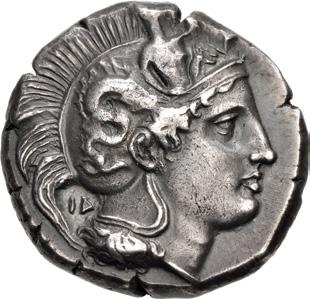

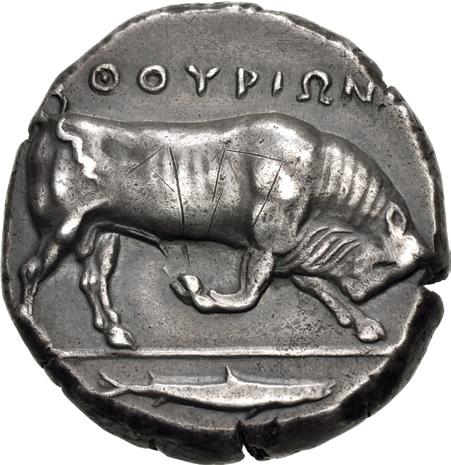
36. LUCANIA, Thourioi. Circa 400-350 BC. AR Dinomos – Distater (25mm, 15.96 g, 8h). Head of Athena right, wearing crested Attic helmet decorated on its bowl with Skylla scanning; 5d behind neck guard / Bull butting right; in exergue, fish right. Noe, Thurian F30 (same dies); HN Italy 1803; SNG Lloyd 486 (same obv. die); SNG Lockett 3489 (this coin); BMC 29 (same dies); Dewing 430 (same obv. die); Gillet 230 (same dies). Toned, faint cleaning marks, graffito (Åπ) on bull. Good VF. ($2000)
From the Wild Rose Collection. Ex Friend of a Scholar Collection (Classical Numismatic Review XLII.1, Winter 2017), no. 410295; Olga H. Knopke Collection (Glendining’s, with Baldwin’s, 10 December 1986), lot 42; Richard Cyril Lockett Collection (Greek Part I, Glendining, 25 October 1955), lot 373.
Ex Metropolitan Museum of Art and Ward Collections – Published in 1901
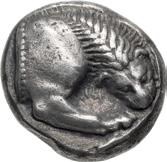

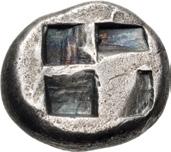
37. LUCANIA, Velia. Circa 510-465 BC. AR Drachm (14mm, 3.79 g). Forepart of lion right, devouring leg of stag / Quadripartite incuse square. Williams Period I, Section 3, 43a (O31/R25) = Ward 80 (this coin, illustrated in both); HN Italy 1259. Old cabinet tone with some iridescence, some minor scratches on reverse, edge marks. Good VF. Great pedigree. ($2000)
Ex Tradart (16 November 1995), lot 13; Leu 48 (10 May 1989), lot 24; Metropolitan Museum of Art Collection (Part II, Sotheby’s Zurich, 4 April 1973), lot 60; John Ward Collection (publ. 1901, donated to the Met by J. P. Morgan in 1905).
Velia, situated on the Tyrrhenian coast of southern Italy south of Poseidonia, was founded circa 540 BC by colonists from Phokaia in western Asia Minor who had fled their homeland following the Persian conquest. Its coinage commenced soon after the city’s foundation and its types (forepart of lion devouring prey/incuse square) and denomination (Phokaian silver drachm) reflect the Asian origin of the early citizenry of Velia. Later, in the 5th century, the weight standard of the Velian coinage was assimilated to that of the Achaian cities of Magna Graecia producing a nomos of about 8 grams. The type of a lion, or a lion attacking its prey, remained popular at Velia throughout the two and a half centuries of its silver coinage, which ceased just prior to the city’s alliance with Rome negotiated circa 275 BC.
20
34 35
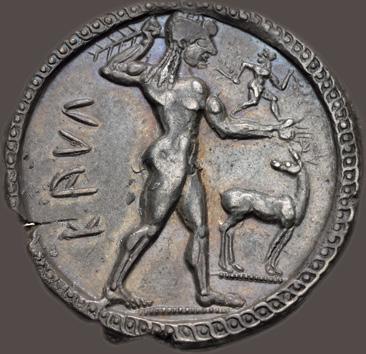
Two Outstanding Kaulonia Nomoi
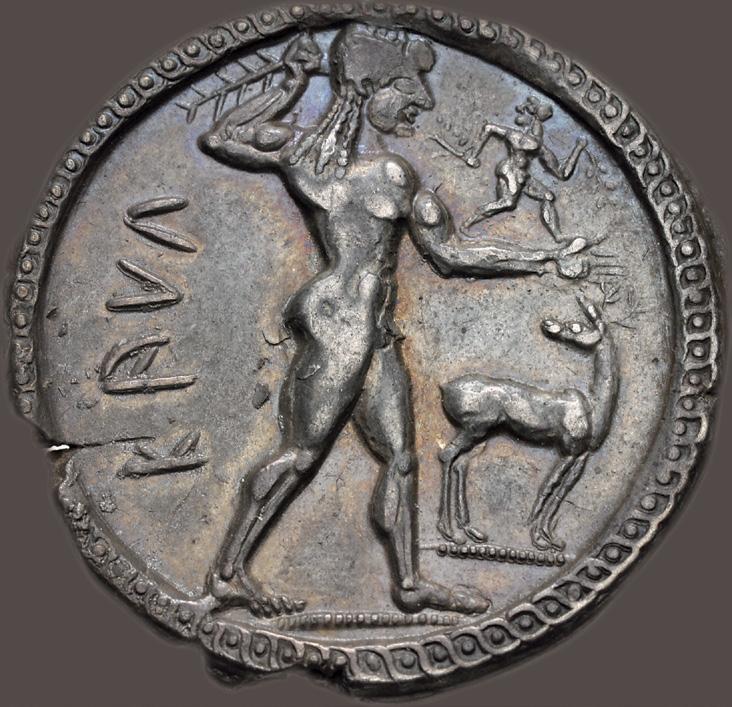
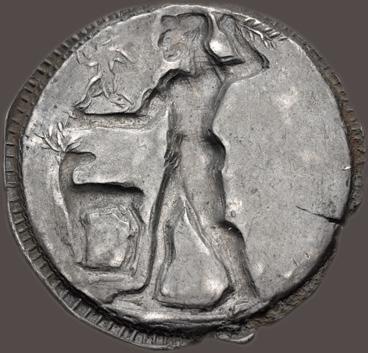
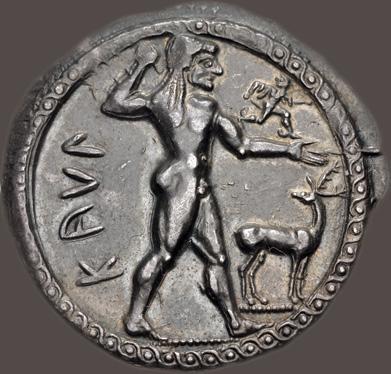
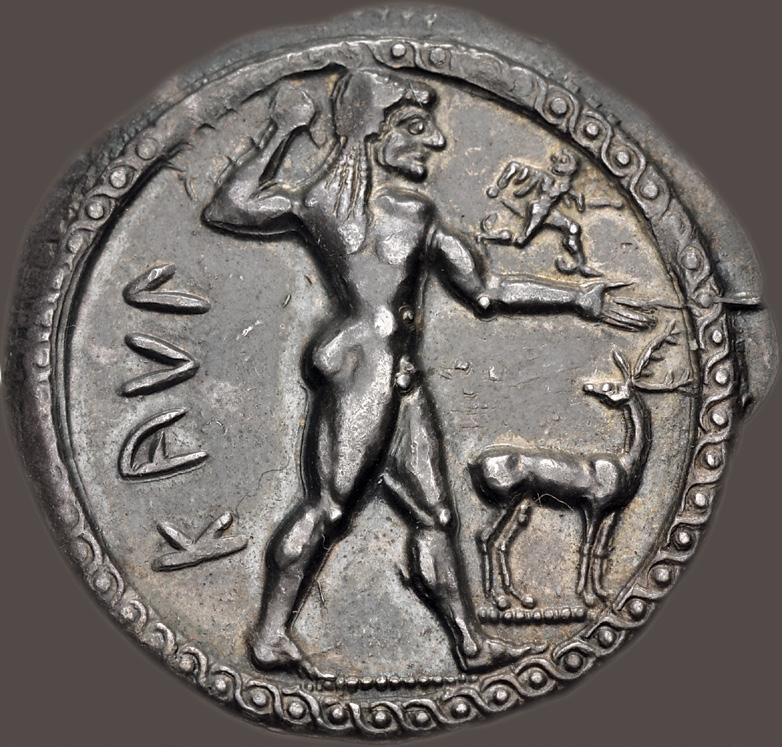
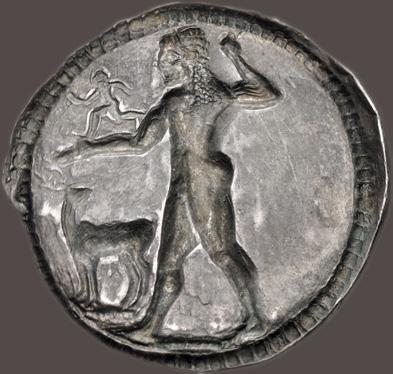
38. BRUTTIUM, Kaulonia. Circa 525-500 BC. AR Nomos (30.5mm, 8.33 g, 12h). Apollo advancing right, holding branch aloft in right hand, left arm extended, upon which a small daimon, holding branch in each hand, runs right, head reverted; ˚å¨Ò to left; to right, stag standing right, head reverted; dot-and-cable border / Incuse of obverse, but daimon, branch, and stag’s antlers in outline and no ethnic; radiate border. Noe, Caulonia, Group A, 5 (same dies); Gorini 3; HN Italy 2035; SNG ANS 142 (same dies); SNG München 1396 (same dies); Gulbenkian 119 (same dies); Hermitage Sale II 163 (same obv. die); Hunterian 2 (same obv. die). Deep iridescent tone, trace deposits, minor edge split. EF. ($7500)
Ex Nomos 13 (7 October 2016), lot 116; Monetarium 47 (Spring 1987), no. 5.
39. BRUTTIUM, Kaulonia. Circa 525-500 BC. AR Nomos (31mm, 7.91 g, 12h). Apollo advancing right, holding branch aloft in right hand, left arm extended, upon which a small daimon, holding branch in each hand, runs right; ˚å¨Ò to left; to right, stag standing right, head reverted; dot-and-cable border / Incuse of obverse, but daimon in outline and no ethnic; radiate border. Noe, Caulonia, Group A, 14; Gorini 3; HN Italy 2035; SNG ANS 147 (same obv. die); McClean 1591 (same dies). Wonderful deep old cabinet tone. EF. ($10,000)
Ex Mark and Lottie Salton Collection.
Kaulonia was founded in the 7th century BC by Achaean Greeks. The location, on the underside of Italy’s “toe,” has long since disappeared beneath the waves, but underwater archaeologists have located more than 100 fluted columns, likely for a large shrine to Apollo, the deity depicted on the city’s beautiful coinage. On this exceptional piece, Apollo’s nude body is shown striding to right, with a small winged daimon on his left arm; to his right stands a stag, sacred to both Apollo and his sister Artemis. The unusual fabric of this piece follows a style peculiar to Greek southern Italy in the archaic period: A broad, thin flan, obverse depicted in relief, the reverse repeating the obverse motif but incuse, and reversed. The reasons for the popularity of this fabric are poorly understood; some scholars have postulated a connection to the mathematician-philosopher Pythagoras, who was active in Italy during this period.
21
38 39
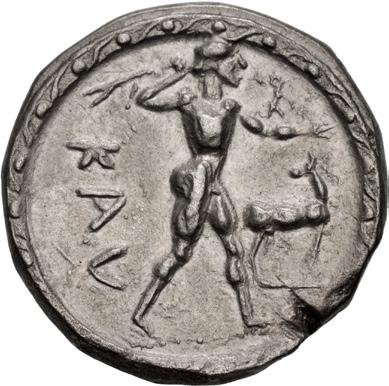
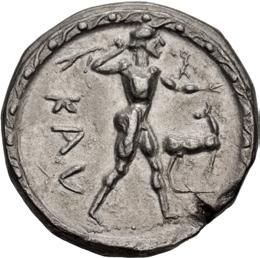
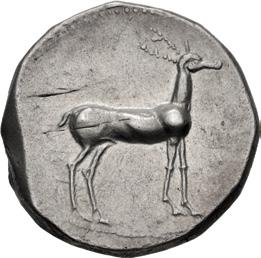
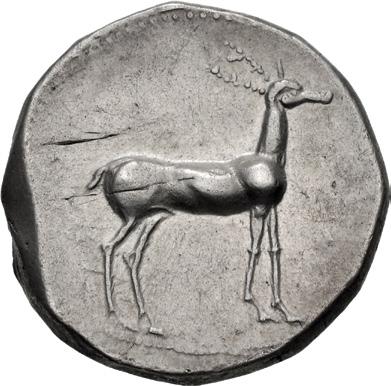
40. BRUTTIUM, Kaulonia. Circa 475-425 BC. AR Nomos (31mm, 8.03 g, 11h). Apollo advancing right, holding branch; small daimon running right on Apollo’s left arm; to right, stag standing right, head reverted / Stag standing right. Noe, Caulonia, Group E, 67 (same dies); HN Italy 2044; De Luynes 688 (same dies). Trace deposits on obverse, minor flan flaws. EF. Well centered. ($750)
From the Wild Rose Collection. Ex ArtCoins Roma 19 (11 November 2015), lot 80.
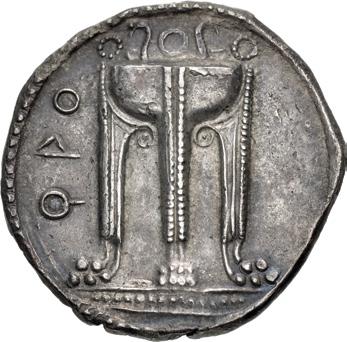
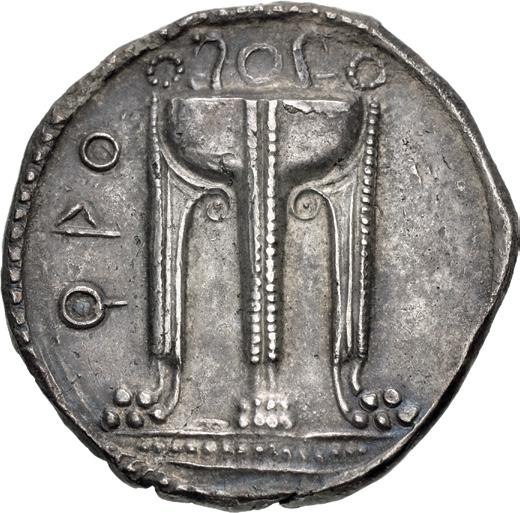
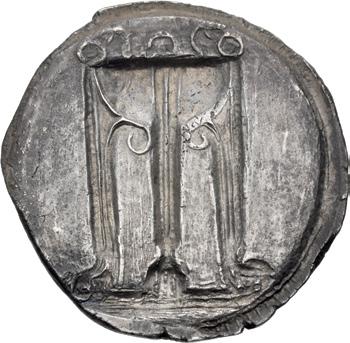
41. BRUTTIUM, Kroton. Circa 530-500 BC. AR Nomos (28.5mm, 8.12 g, 12h). Spread incuse type. Tripod, legs surmounted by wreaths and terminating in lion’s feet, two serpents rising from the bowl, set on basis of three lines, the center dotted / Incuse tripod as obverse, but wreaths and serpents in relief. Attianese 5; HN Italy 2075. Toned, some roughness at edge. Near EF. ($2000)
From the Wild Rose Collection. Ex Künker 295 (25 September 2017), lot 185; Sternberg XV (11 April 1985), lot 94.
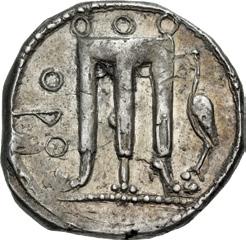
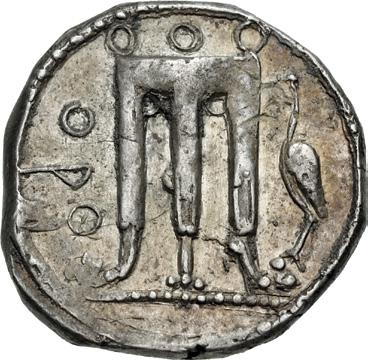
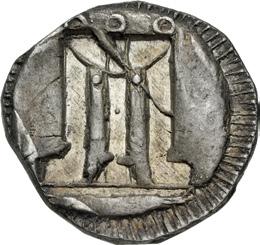
42. BRUTTIUM, Kroton. Circa 480-430 BC. AR Nomos (20mm, 8.15 g, 7h). Tripod with legs terminating in lion’s feet; to right, heron standing left / Incuse tripod. Attianese 47; HN Italy 2102. Lightly toned, trace deposits, indications of undertype on obverse, die break on reverse. Good VF. ($500)

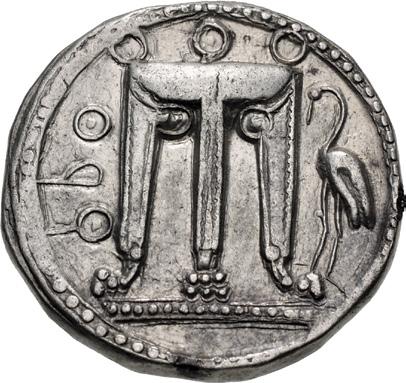
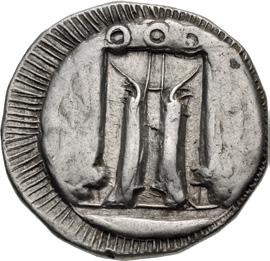
43. BRUTTIUM, Kroton. Circa 480-430 BC. AR Nomos (22mm, 7.99 g, 12h). Dumpy incuse type. Tripod with legs terminating in lion’s feet; to right, heron standing left / Incuse tripod. Attianese 60; HN Italy 2102. Lightly toned, small mark at edge on reverse. Near EF. ($750)
From the Wild Rose Collection. Ex ArtCoins Roma 19 (11 November 2015), lot 88.
22
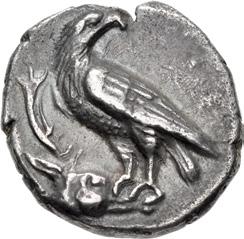
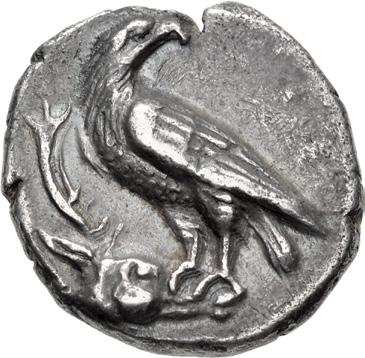

44. BRUTTIUM, Kroton. Circa 425-350 BC. AR Nomos (19.5mm, 7.49 g, 3h). Eagle standing left, head right, on stag’s head / Tripod; ivy leaf to left. Attianese 104 (same obv. die as illustration); HN Italy 2146; SNG ANS 351–2 (same obv. die). Old collection tone, small cleaning scratches on obverse, die break on reverse. Good VF. High relief for issue. ($1000)
From the Mesogeios Collection. Ex Classical Numismatic Group 120 (11 May 2022), lot 35; G. Hirsch 20 (2 April 1959), lot 759.

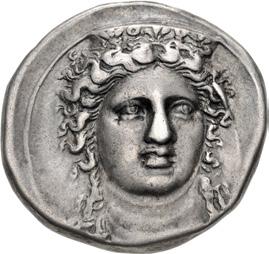

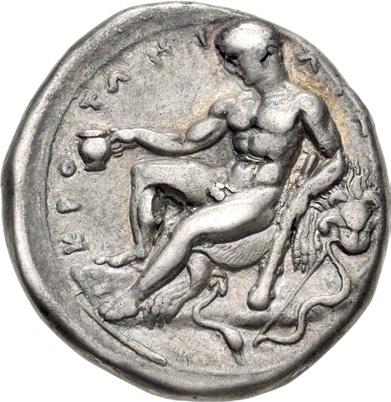
45. BRUTTIUM, Kroton. Circa 400-325 BC. AR Nomos (22mm, 7.71 g, 11h). Head of Hera Lakinia facing slightly right, wearing ornamented stephane / Herakles Epitrapezios: young Herakles, nude, holding cup and club, reclining left on lion skin draped over rock; bow below. Attianese 135 corr. (no signature, same dies as illustration); HN Italy 2167; SNG ANS 371 = Locker Lampson 47 (same obv. die); SNG Ashmolean 1521 = ACGC 636 (same dies); SNG Lloyd 616 (same dies). Toned, minor die break on obverse, light scratch and dig on reverse. VF. ($2000)
From the Wild Rose Collection. Ex Rauch 97 (14 April 2015), lot 60.
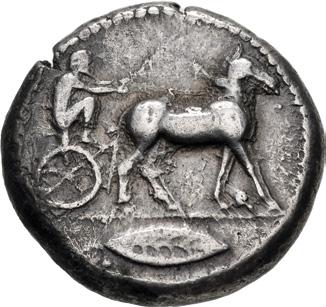

46. BRUTTIUM, Rhegion. Anaxilas. Tyrant, circa 494/3-462/1 BC. AR Tetradrachm (26.5mm, 17.13 g, 2h). Struck circa 475–474 BC. Charioteer driving biga of mules right; in exergue, leaf right / Hare springing right. Caltabiano Series III, 102 (D52/ R60); HN Italy 2472. Toned, some find patina remaining, minor die wear and patch of granularity. VF. ($1000)
From the DFA Collection. Ex Nauman 122 (6 November 2022), lot 16; Leu Numismatic Web Auction 18 (18 December 2021), lot 179.
Fine Style Rhegion Tetradrachm
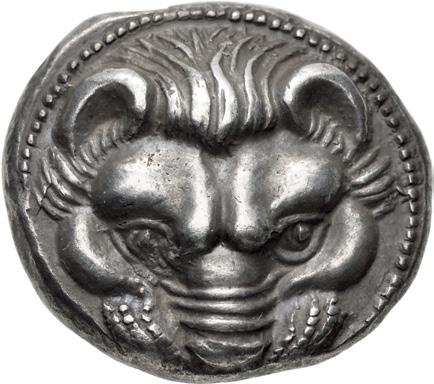
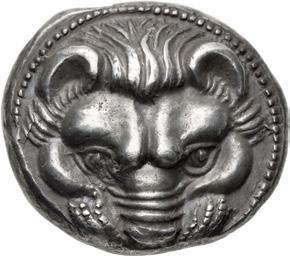

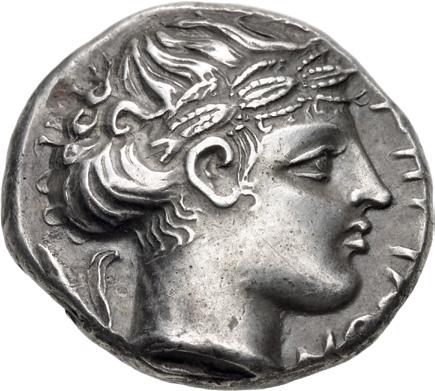
47. BRUTTIUM, Rhegion. Circa 415/0-387 BC. AR Tetradrachm (23mm, 17.19 g, 5h). Lion mask facing / Head of Apollo right, wearing laurel wreath; olive sprig behind neck, r˙˝5˜o˜ to right. Herzfelder 90 (D54c/R77); HN Italy 2496; SNG ANS 661 (same obv. die); SNG Fitzwilliam 851 (same dies, but obv. re-engraved). Toned, minor die wear. Near EF. High relief. ($7500)
From the Wild Rose Collection, purchased from Pars Coins (inv. PCW-G5911), August 2017. Ex Stack’s Bowers and Ponterio 177 (14 August 2013), lot 11017.
23
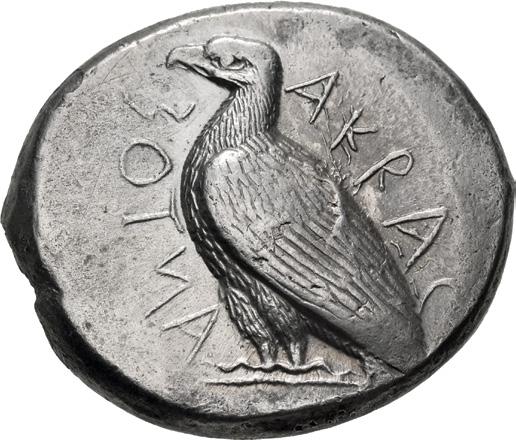



48. SICILY, Akragas. Circa 465/0–445/0 BC. AR Tetradrachm (27.5mm, 17.08 g, 8h). Sea eagle standing left / Crab within shallow incuse circle. Westermark, Coinage, Period II, Group I, 357 (O11/R35); HGC 2, 94. Edge split, minor die wear, light scratches on obverse, minor flan flaws and scuffs on reverse. Near EF. Well centered. ($2000)
From the Wild Rose Collection, purchased from Pars Coins (inv. PCW-G4195), December 2014. Ex Stack’s Bowers and Ponterio 177 (14 August 2013), lot 11018.

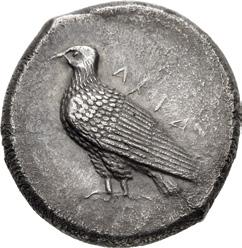
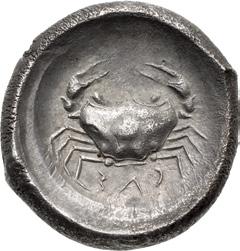

49. SICILY, Akragas. Circa 410-406 BC. AR Didrachm (19.5mm, 8.12 g, 5h). Sea eagle standing left / Crab within incuse circle. Westermark, Coinage, Period III, 216 (O76/R141); HGC 2, 94; SNG ANS 949 (same dies); SNG Copenhagen 34 (same dies); SNG Delepierre 522 (same dies). Toned, light roughness. Near EF. Rare Group III variety with full ethnic, known from only one reverse die. ($1500)
From the Wild Rose Collection, purchased October 2016. Ex Goldberg 75 (24 September 2013), lot 2406.
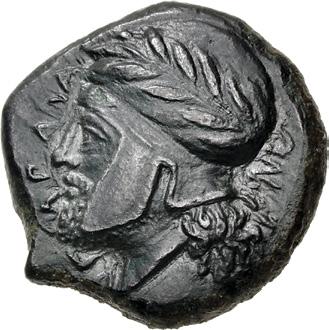

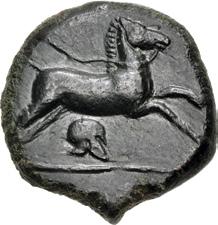
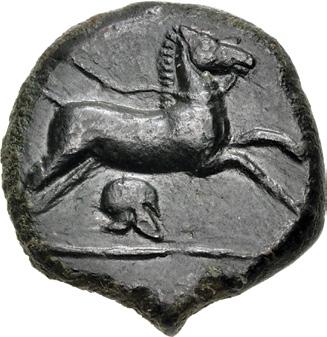
50. SICILY, Entella. Campanian mercenaries. Circa 307-305 BC. Æ (18mm, 6.01 g, 10h). Bearded male head left, wearing Campanian helmet decorated with wreath / Horse galloping right, trailing rein; helmet below. Campana 17; BAR Issue 3; CNS 9; HGC 2, 251. Dark green-brown surfaces, light smoothing and cleaning marks. EF ($500)
Ex Artemide LIV (7 November 2020), lot 71.
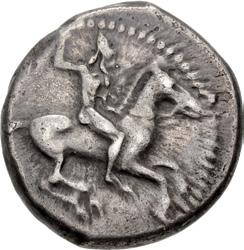
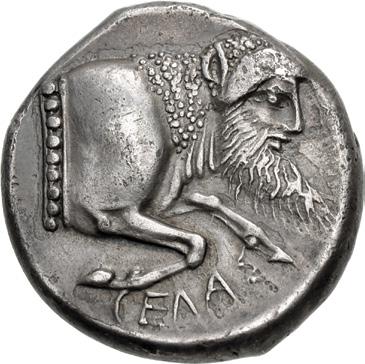

51. SICILY, Gela. Circa 490/85-480/75 BC. AR Didrachm (19.5mm, 8.53 g, 12h). Horseman riding right, preparing to cast javelin / Forepart of man-headed bull right within circular incuse. Jenkins, Gela, Group Ib, 60 (O18/R26); HGC 2, 363. Toned, struck with worn obverse die, minor flan flaws on reverse. VF. ($1000)
From the Weise Collection, purchased 11 November 2001.
24
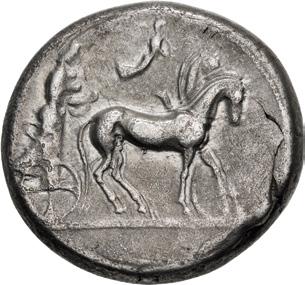
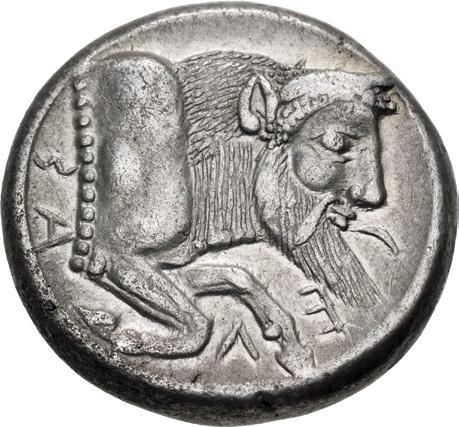

52. SICILY, Gela. Circa 480/75-475/70 BC. AR Tetradrachm (24.5mm, 17.42 g, 6h). Charioteer driving quadriga right; above, Nike flying right, crowning horses / Forepart of man-headed bull right. Jenkins, Gela, Group IIa, 110 (O33/R64); HGC 2, 338; Randazzo 21 (same dies). Toned, light porosity, faint scratches, flan flaw at edge on obverse. VF. ($1500)
From the Wild Rose Collection. Ex Roma IX (22 March 2015), lot 73; Roma VI (29 September 2013), lot 371.


53. SICILY, Gela. Circa 480/75-475/70 BC. AR Tetradrachm (24mm, 17.28 g, 8h). Charioteer driving quadriga right; above, Nike flying right, crowning horses / Forepart of man-headed bull right. Jenkins, Gela, Group IIb, 126 (O36/R77); HGC 2, 338; SNG ANS 30 (same dies). Toned, a few die breaks on obverse. VF. ($1500)
Ex Classical Numismatic Group 91 (19 September 2012), lot 61.
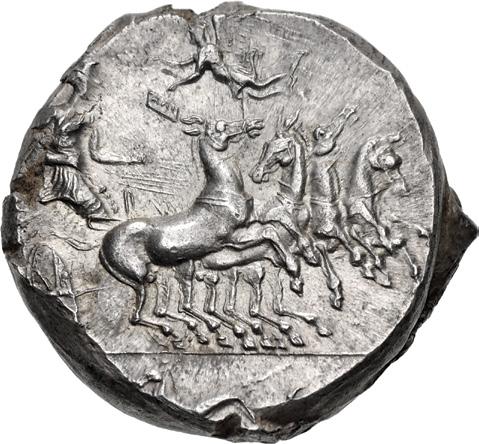
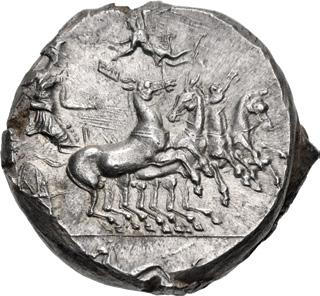
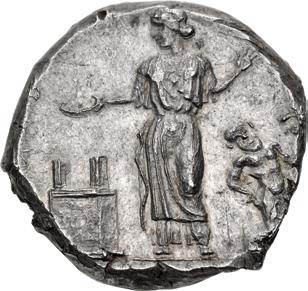
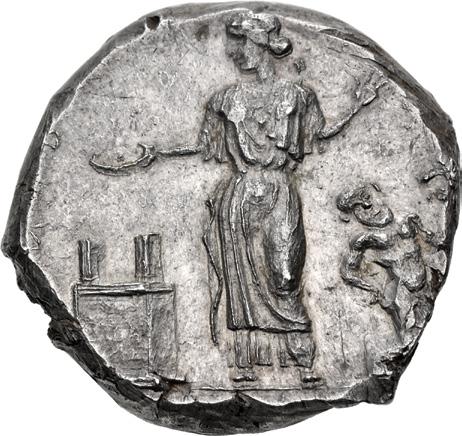
54. SICILY, Himera. Circa 409-407 BC. AR Tetradrachm (25.5mm, 17.44 g, 4h). Obverse die signed by the artist Mai-. The nymph Himera, holding reins in both hands, driving unruly quadriga right; above, Nike flying left, crowning her with wreath held in extended right hand, left hand holding plaque inscribed ÂÅ5; in exergue, ketos left / Himera standing facing, head left, holding in right hand a patera over altar to left; to right, satyr bathing in fountain with lion-headed spout; ˜o[5Å-rEÂ-5˙] counterclockwise around from exergue. Arnold-Biucchi, Monetazione, Group IV, 22 (Q8/H17); Gutmann & Schwabacher 20; HGC 2, 436; SNG Lloyd 1022 (same dies); Basel 306 (same dies); Gillet 434 (same dies); Kraay & Hirmer 71 (same dies); Rizzo pl. XXI, 23 = de Luynes 977 (same dies). Faintly toned over lustrous surfaces, slightly compact flan and minor die rust on reverse, as usual. Choice EF. ($5000)
From the Wild Rose Collection. Ex Numismatica Ars Classica 120 (6 October 2020), lot 254; Künker 236 (7 October 2013), lot 346; Superior (1 December 1990), lot 1936.
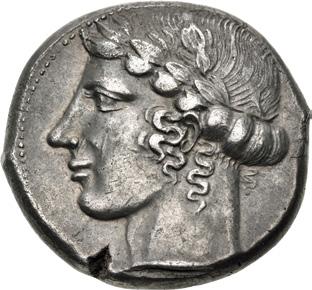
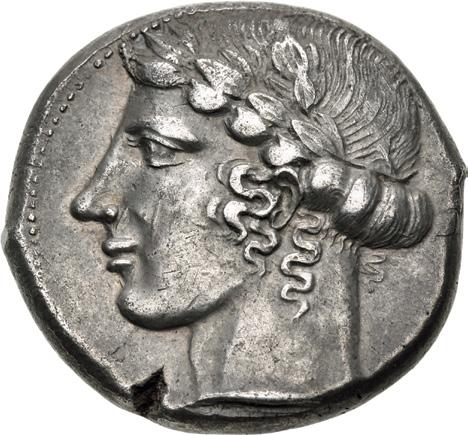

55. SICILY, Leontini. Circa 445-425 BC. AR Tetradrachm (25mm, 17.03 g, 3h). Laureate head of Apollo left / Head of roaring lion left; leaf with berry to right, three barley grains around. Maltese Period III, 118 (D30/R91); Boehringer, Münzgeschichte 53 (same dies); HGC 2, 670 (same dies as illustration); Gillet 449 (same dies); McClean 2338 (same dies). Toned, small edge split, a couple light scuffs on obverse. Good VF. ($2000)
From the Wild Rose Collection. Ex Triton XX (10 January 2017), lot 57; Lanz 125 (28 November 2005), lot 92.
25

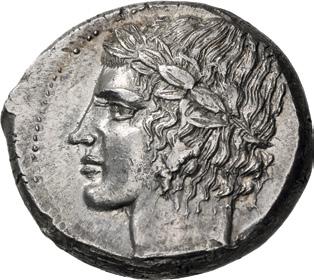
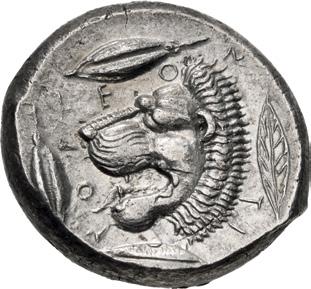
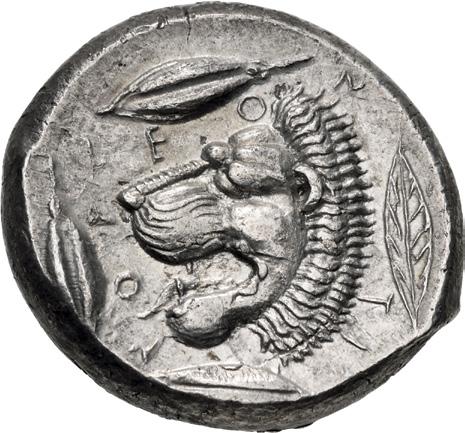
56. SICILY, Leontini. Circa 425-415 BC. AR Tetradrachm (26mm, 17.34 g, 11h). Laureate head of Apollo left / Head of roaring lion left; leaf to right, three barley grains around. Maltese Period IV, 138 (D34/R106); Boehringer, Münzgeschichte
55 (same dies); HGC 2, 671; SNG ANS 257 (same dies); Gilet 453 (same dies); Rizzo, pl. XXIV, 4 (same dies). Faintly toned over lustrous surfaces, typical die break on obverse, slight die wear and a faint scuff on reverse. EF. ($2000)
From the Wild Rose Collection, purchased from Calgary Coin Gallery, March 1994. Reportedly from the Athena Fund.
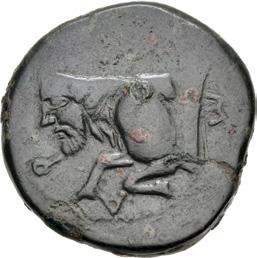


57. SICILY, “Mamar”. Circa 409-403 BC. Æ Hemilitron (21mm, 7.79 g, 7h). Forepart of man-headed bull left; [ÂÅ]Â-Å-r around / Winged nymph advancing left, holding bandage(?); star to left, five pellets (mark of value) around. Campana 1; MSP I 45 (same dies); CNS –; HGC 2, –; SNG Copenhagen 1072; BMC 1. Glossy dark green patina with spots of red, some light scratches. VF. Very rare. ($750)
Ex Martinez Collection (Classical Numismatic Group 120, 11 May 2022), lot 57; Astarte X (12 December 2002), lot 302 (hammer CHF 6400).

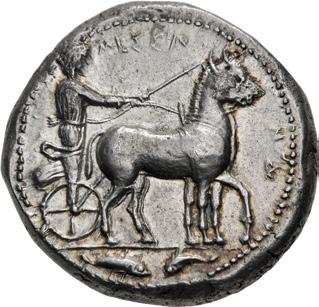
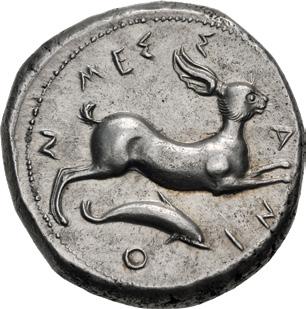

58. SICILY, Messana. 420-413 BC. AR Tetradrachm (25.5mm, 17.15 g, 3h). The nymph Messana, holding kentron in left hand and reins in both, driving slow biga of mules right; µEssÅ-@Å above and before, two dolphins confronted in exergue / Hare springing right; below, dolphin right; µEs-s-Å-˜5-o-˜ around. Caltabiano Series XIV, 525 (D208/R222); HGC 2, 792. Faint iridescent tone over lustrous surfaces, minor die wear on obverse. EF ($5000)
From the Wild Rose Collection, purchased from Calgary Coin Gallery, March 2015.
26
Cited in Caltabiano – Pedigreed to 1913
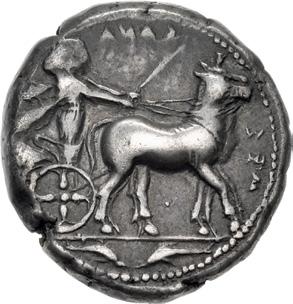

59. SICILY, Messana. 420-413 BC. AR Tetradrachm (24mm, 17.15 g, 7h). The nymph Messana, holding kentron and reins, driving slow biga of mules right; two dolphins confronted in exergue / Hare springing right; below, dolphin right. Caltabiano Series XIV, 538.5 corr. (D212/R230 – this coin, erroneous date for Platt sale); HGC 2, 792. Old cabinet tone, some die wear. VF. ($1500)
Ex Foreign Amateur Collection (Part I, Platt, 8 December 1913), lot 13.


60. SICILY, Petra. 354/3-344 BC. Æ Hemilitron (30mm, 28.71 g, 8h). Bearded head right / Aphrodite seated right on dyphros, holding dove. Castrizio Series I, 1 var. (unlisted dies); CNS 1; Puglisi 261; Campana 1 (this coin referenced); HGC 2, 1097. Forest green patina, some roughness. VF. Very rare. ($750)
Ex Numismatica Ars Classica 64 (17 May 2012), lot 2121; Titano 74 (27 September 1998), lot 37.
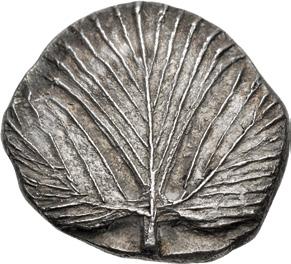

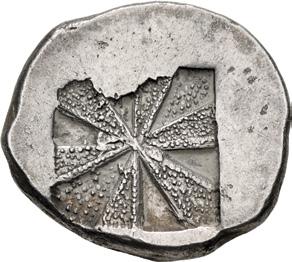
61. SICILY, Selinos. Circa 540-515 BC. AR Didrachm (23.5mm, 8.77 g). Selinon leaf / Incuse square divided into twelve sections. Arnold-Biucchi Group 1; Selinus Hoard 32; HGC 2, 1211. Lightly toned. EF. ($1000)
From the Wild Rose Collection. Ex M. A. Armstrong Collection (Classical Numismatic Group 102, 18 May 2016), lot 115; Sotheby’s (7 March 1996), lot 56.
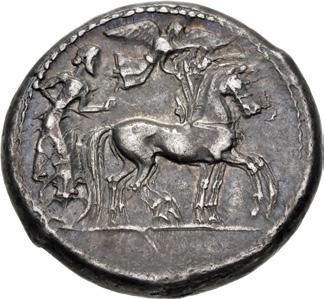

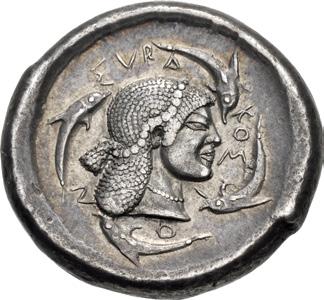
62. SICILY, Syracuse. Gelon I. 485-478 BC. AR Tetradrachm (25mm, 17.36 g, 1h). Struck circa 480-478 BC. Charioteer, holding kentron and reins, driving slow quadriga right; above, Nike flying right, crowning horses / Diademed head of Arethousa right; four dolphins around. Boehringer Series VIb, 85 (V41/R55); HGC 2, 1306; HGC 2, 1306; SNG ANS 21 (same dies); Nanteuil 321 (same dies). Toned. Good VF. Well centered strike from dies of fine style. ($2000)
From the Wild Rose Collection. Ex Numismatica Ars Classica 120 (6 October 2020), lot 264; Classical Numismatic Group 94 (18 September 2013), lot 103.
27
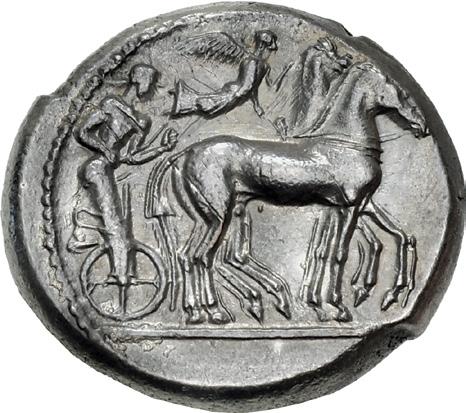
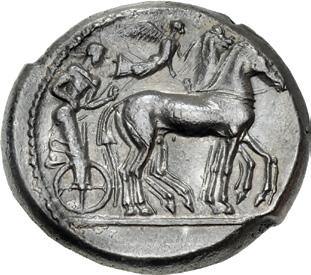
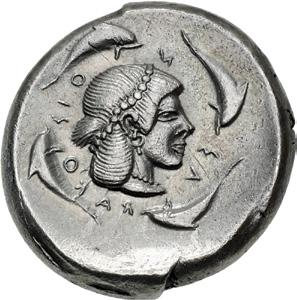
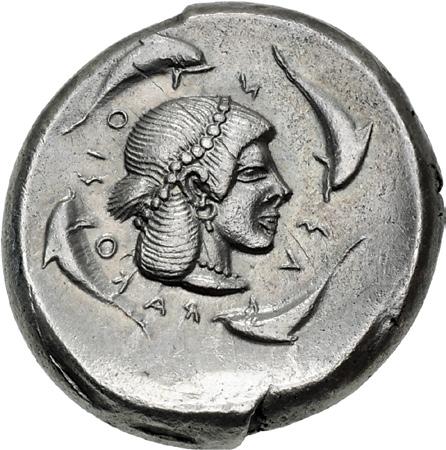
63. SICILY, Syracuse. Hieron I. 478-466 BC. AR Tetradrachm (26mm, 17.11 g, 9h). Struck circa 475-470 BC. Charioteer, holding kentron and reins, driving slow quadriga right; above, Nike flying right, crowning horses / Diademed head of Arethousa right; four dolphins around. Boehringer Series XIId, 351 (V174/R246); HGC 2, 1307. Lightly toned, underlying luster, a few minor flan flaws. Near EF. ($2000)
Ex Goldberg 117 (15 September 2020), lot 2009.
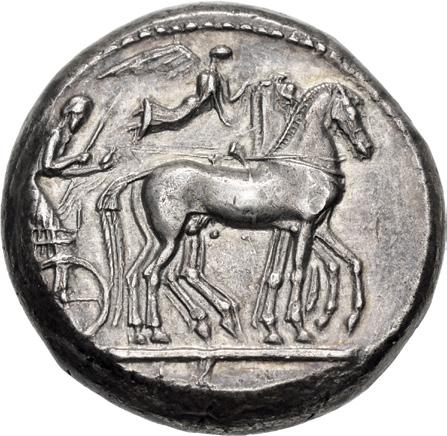

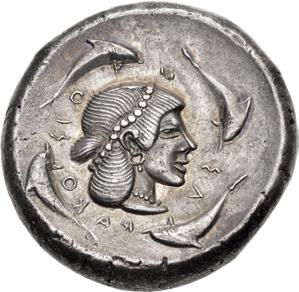

64. SICILY, Syracuse. Hieron I. 478-466 BC. AR Tetradrachm (24mm, 17.34 g, 6h). Struck circa 475-470 BC. Charioteer, holding kentron and reins, driving slow quadriga right; above, Nike flying right, crowning horses / Diademed head of Arethousa right; four dolphins around. Boehringer Series XIId, 353 (V175/R246); HGC 2, 1307; SNG ANS 113 (same dies). Toned. Near EF. ($3000)
Ex CNG inventory 990883 (December 2014); Roma VIII (28 September 2014), lot 101; Roma V (23 March 2013), lot 107.
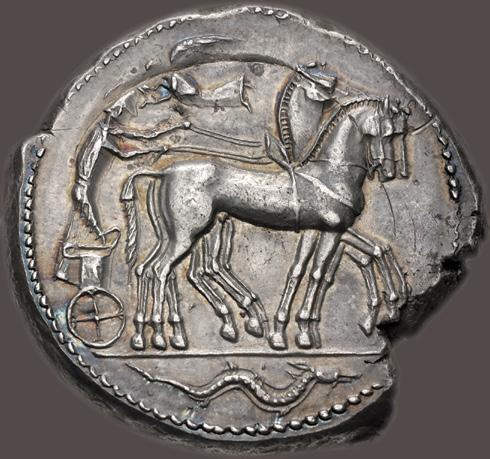


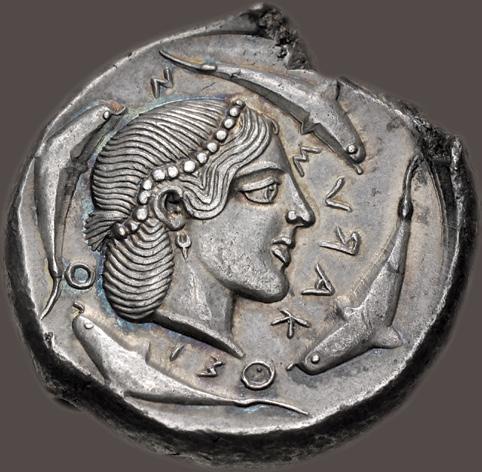
65. SICILY, Syracuse. Second Democracy. 466-405 BC. AR Tetradrachm (26.5mm, 17.40 g, 7h). Struck circa 466-460 BC. Charioteer, holding reins in both hands, driving slow quadriga right; above, Nike flying left, crowning charioteer with wreath held in both hands; in exergue, ketos left / Head of Arethousa right, wearing pearl tainia and hoop earring with pendant; s¨∞Åkos5-o-˜ and four dolphins seimming around. Boehringer Series XIIIb, 438 (V233/R314); HGC 2, 1310; SNG ANS 135 (same dies); Jameson 759 (same dies); Pozzi 572 (same dies). Toned, edge flaw, flan flaw on obverse. Superb EF. Struck from fresh dies. ($7500)
From the Wild Rose Collection. Ex JTB Collection (Triton XXIII, 14 January 2020), lot 117; Geschichtsfreundes (Friend of History) Collection (Künker 304, 19 March 2018), lot 171; LHS 102 (29 April 2008), lot 87.
28
Pedigreed to 1934
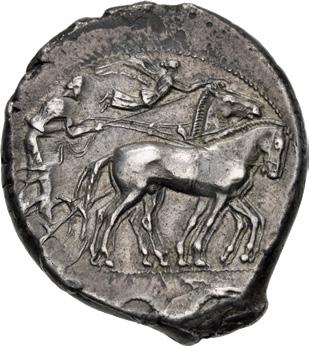
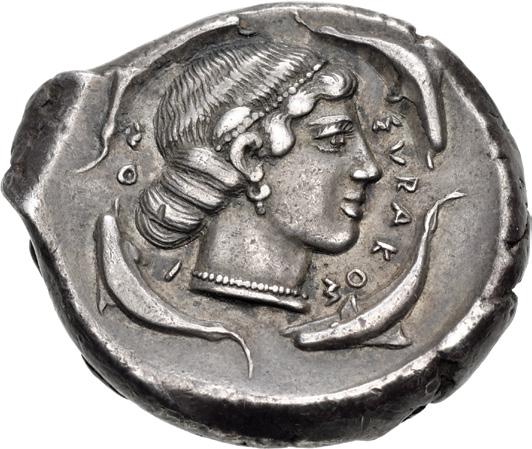

66. SICILY, Syracuse. Second Democracy. 466-405 BC. AR Tetradrachm (25mm, 17.13 g, 9h). Struck circa 450 BC. Charioteer, holding kentron and reins, driving slow quadriga right; above, Nike flying right, crowning horses; in exergue, ketos right / Head of Arethousa right, wearing pearl tainia; four dolphins around. Boehringer Series XV, 515 (V270/R366); HGC 2, 1311; BMC 83 (same dies); Bement 468 (same dies); Jameson 765 (same dies); de Luynes 1174 (same dies); McClean 2660 (same dies); Pozzi 578 (same dies). Old cabinet tone. VF. ($1500)
From the Wild Rose Collection. Ex New York Sale XL (12 January 2017), lot 1020; Goldberg 91 (7 June 2016), lot 1724; Numismatic Fine Arts XXXII (10 June 1993), lot 13; Ars Classica XVII (3 October 1934), lot 199.


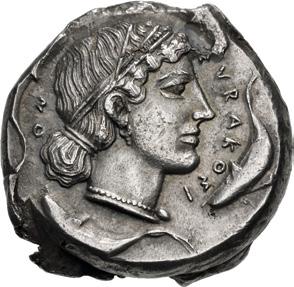
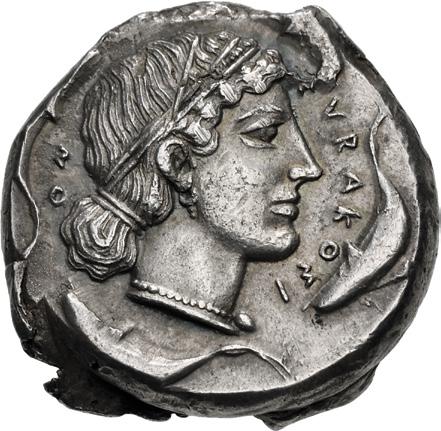
67. SICILY, Syracuse. Second Democracy. 466-405 BC. AR Tetradrachm (25mm, 17.39 g, 1h). Struck circa 450-440 BC. Charioteer, holding kentron and reins, driving slow quadriga right; above, Nike flying right, crowning horses; in exergue, ketos right / Head of Arethousa right, hair in band; four dolphins around. Boehringer Series XVIa, 571 (V287/R391); HGC 2, 1311; SNG ANS 184 (same dies). Lightly toned, slightly compact flan. Near EF. ($3000)
From the Wild Rose Collection, purchased from Wayne Hansen, 28 October 2020. Ex Classical Numismatic Group 66 (19 May 2004), lot 133.
Published in 1898
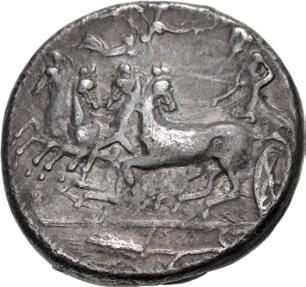
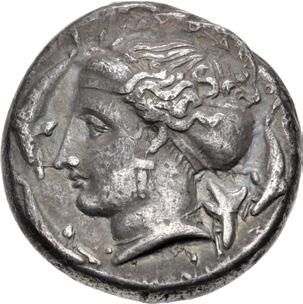
68. SICILY, Syracuse. Second Democracy. 466-405 BC. AR Tetradrachm (24mm, 16.88 g, 6h). Unsigned dies Struck circa 406-405 BC. Charioteer, holding kentron and reins, driving fast quadriga left; above, Nike flying right, crowning charioteer; in exergue, grain ear left / Head of Arethousa left, hair in sphendone; four dolphins around. Fischer-Bossert, Coins 84n (V31/R56) = Comte. A. Du Chastel de la Howardries, Syracuse, ses monnaies d’argent et d’or au point de vue artistique. La coiffure antique et ses développements successifs (London, 1898), pl. 15, 81bis (this coin); Tudeer 84; HGC 2, 1342; SNG Fitzwilliam 1250 (same dies); SNG Lloyd 1395 (same dies); Dewing 851 (same dies); Gulbenkian 294 (same dies); Morgan 148 (same dies). Old cabinet tone, with some iridescence, light roughness, minor scratches. VF. ($2000)
From the Hesiod Collection. Ex White Rose Collection (Spink 23106, 19 April 2023), lot 7722 (erronously noted as being signed by Parmenides); J. Hirsch XVI (5 December 1906), lot 293.
29
Two Remarkable Dekadrachms of Syracuse

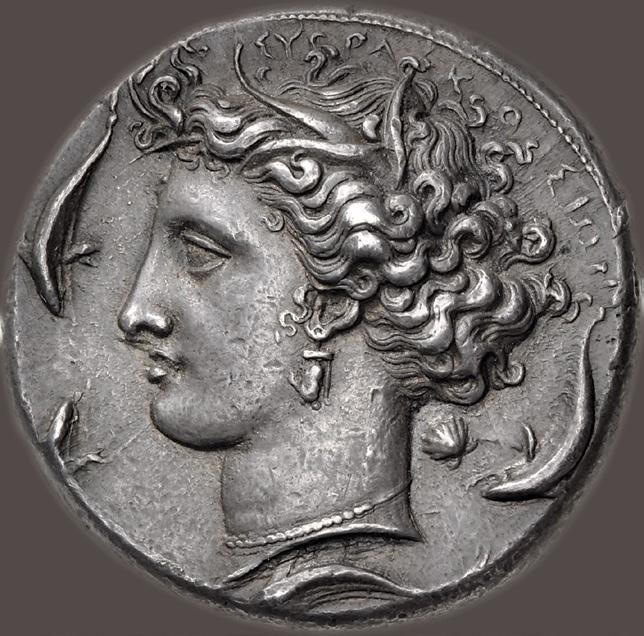

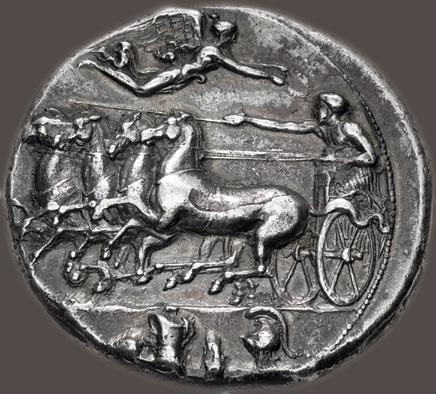
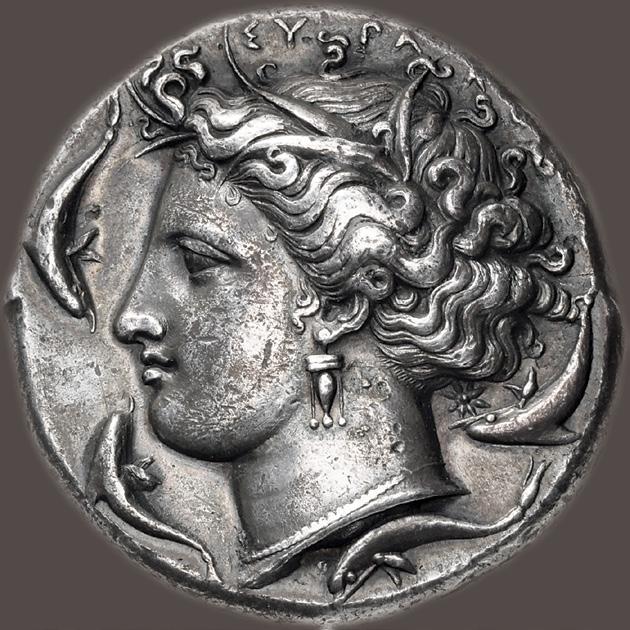
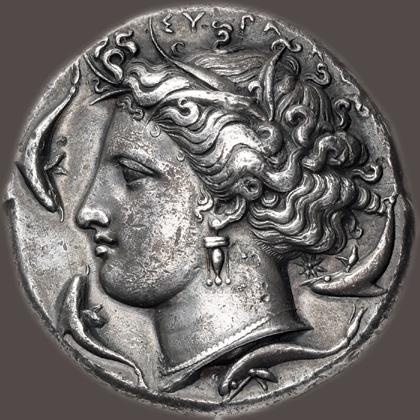
69. SICILY, Syracuse. Dionysios I. 405-367 BC. AR Dekadrachm (35mm, 43.38 g, 1h). Unsigned dies in the style of Euainetos. Struck circa 405-380/67 BC. Charioteer, holding kentron in extended right hand and reins in left, driving fast quadriga left; above, Nike flying right, crowning charioteer with wreath held in her extended hands; below heavy exergual line, [military harness], shield, greaves, cuirass, and crested Attic helmet, all connected by a horizontal spear; [ÅQ]¬Å below / Head of Arethousa left, wearing wreath of grain ears, triple-pendant earring, and pearl necklace; sU-rÅ-k-o-s5W@ above, shell behind neck, four dolphins swimming around. Gallatin dies R.XII/F.II; Scavino dies D12/R22; HGC 2, 1299; SNG Ashmolean 2026 (same dies); Boston MFA 427 = Warren 361 (same dies). Attractive old cabinet tone, a few faint scratches under tone. Near EF. Exceptional for issue, struck from an early die state, with virtually no die rust, and well centered. ($40,000)
Ex Arsantiqva IV (11 October 2003), lot 80.
Dionysios reintroduced the large and ostentatious silver dekadrachms, a denomination that had not been used in Syracuse since the issue of the Demareteion decades earlier. Dionysios entrusted two of the greatest local numismatic artists, Kimon and Euainetos, to design these impressive pieces. The regard for these coins in modern times is reflected by the fact that they are considered a must for any first rank collection of Greek coins.
70. SICILY, Syracuse. Dionysios I. 405-367 BC. AR Dekadrachm (34mm, 42.90 g, 3h). Unsigned dies in the style of Euainetos. Struck circa 405-380/67 BC. Charioteer, holding kentron in extended right hand and reins in left, driving fast quadriga left; above, Nike flying right, crowning charioteer with wreath held in her extended hands; below heavy exergual line, [military harness, shield], greaves, cuirass, and crested Attic helmet, all connected by a horizontal spear; [ÅQ¬Å below]
/ Head of Arethousa left, wearing wreath of grain ears, triple-pendant earring, and pearl necklace; sU-rÅ-k-o-[s5W@] above, star behind neck, four dolphins swimming around. Gallatin dies R.XXIII/K.III; Scavino dies D20/R38; HGC 2, 1299; SNG Blackburn 189 (same dies); SNG München 1082 (same dies). Toned, minor marks. Good VF. ($25,000)
Ex CNG inventory 866444 (February 2009); Gemini V (6 January 2009), lot 468.
30
69 70
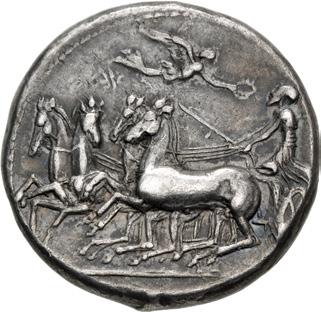

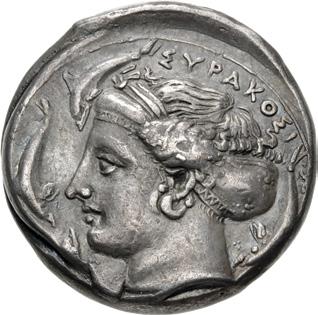
71. SICILY, Syracuse. Dionysios I. 405-367 BC. AR Tetradrachm (25.5mm, 17.18 g, 7h). [Reverse die signed by Eukleidas]. Struck circa 400-395 BC. Charioteer, holding kentron and reins, driving fast quadriga left; above, Nike flying right, crowning charioteer; [grain ear in exergue] / Diademed head of Arethousa left; four dolphins around, [EU˚¬E5 on tablet below neck]. Fischer-Bossert, Coins 86m (O32/R58 – this coin); Tudeer 86; HGC 2, 1342; SNG ANS 292 (same dies); Gillet 659 (same dies); Gulbenkian 295 (same dies); Hermitage Sale II 355 (same dies); Jameson 806 (same dies). Iridescent tone, underlying luster. Good VF. ($3000)
From the Wild Rose Collection. Ex Nomos FPL (Winter–Spring 2014), no. 7 (@ $7950); Leu 71 (24 October 1997), lot 77; Leu 2 (25 April 1972), lot 113.
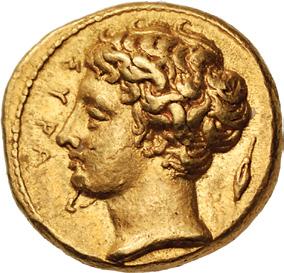

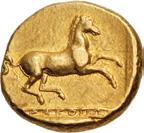
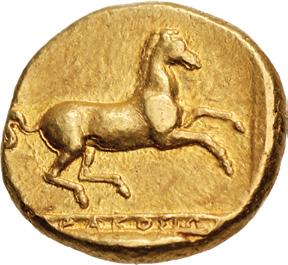
72. SICILY, Syracuse. Dionysios I. 405-367 BC. AV 50 Litrai – Dekadrachm (12mm, 2.89 g, 6h). Struck circa 400-370 BC. Bare head of male (Anapos?) left; barley grain to right / Horse prancing right on exergue line; all within shallow incuse square. Bérend 10.3 (D4bis/R4 – this coin); HGC 2, 1281; SNG ANS 347; Boston MFA 436 = Warren 354; de Luynes 1239; Jameson 1918; Weber 1610 (all from the same dies). Tiny die break on obverse. EF. ($3000)
Ex CNG inventory 852962 (August 2009); Hess-Divo 307 (7 June 2007), lot 1081; Auctiones AG 13 (23 June 1983), lot 90.
Bérend Plate Coin
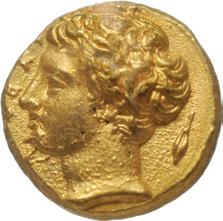
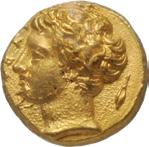


73. SICILY, Syracuse. Dionysios I. 405-367 BC. AV 50 Litrai – Dekadrachm (10mm, 2.88 g, 3h). Struck circa 400370 BC. Bare head of male (Anapos?) left; barley grain to right / Horse prancing right on exergue line; star above; all within shallow incuse square. Bérend 12 (D4bis/R5 – this coin); HGC 2, 1281; SNG ANS 347; Boston MFA 436 = Warren 354; de Luynes 1239; Jameson 1918; Weber 1610 (all from the same dies). In NGC encapsulation 6290579-001, graded Ch AU, Strike: 4/5, Surface: 4/5. ($3000)
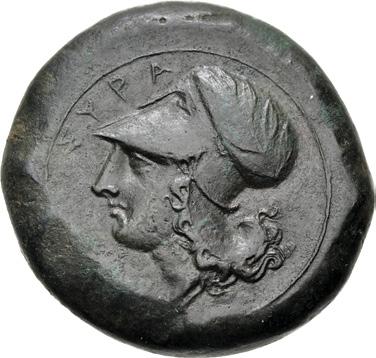
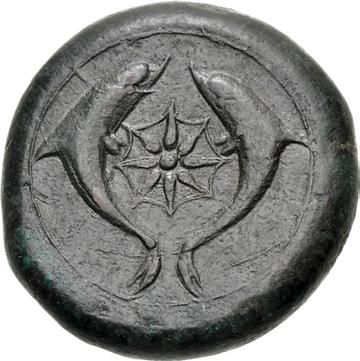
74. SICILY, Syracuse. Dionysios I. 405-367 BC. Æ Drachm (29.5mm, 27.48 g, 1h). Head of Athena left, wearing Corinthian helmet with neck guard and bowl decorated with wreath / Sea-star between two dolphins. CNS 62; HGC 2, 1436. Dark green patina. Good VF. ($1000)
From the Wild Rose Collection. Ex Classical Numismatic Review XLVII.1 (Winter 2022), no. 587343; Mercury Group Collection (Classical Numismatic Group 118, 13 September 2021), lot 22, purchased August 2001.
31
Pedigreed to 1910
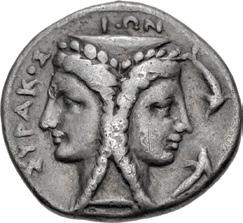

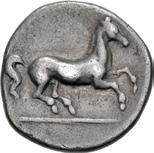

75. SICILY, Syracuse. Timoleon and the Third Democracy. 344-317 BC. AR Dilitron (13mm, 1.58 g, 9h). Struck circa 344-317 BC. Janiform female head; two dolphins to right / Horse galloping right. HGC 2, 1375; SNG ANS 516. Deep old cabinet tone, minor marks and scrapes. VF. ($500)
Ex Max Vogt Collection, purchased from Schweizerische Kreditanstalt, 7 May 1992; Feuardent (9 May 1910), lot 223.

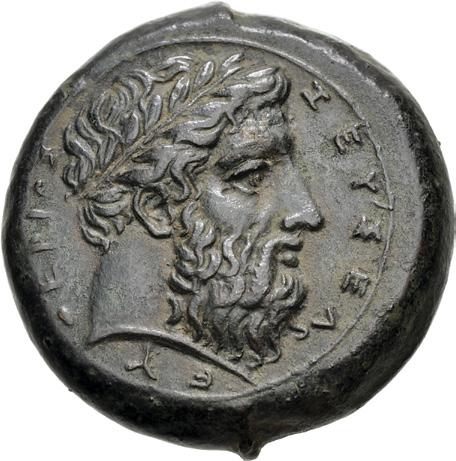

76. SICILY, Syracuse. Timoleon and the Third Democracy. 344-317 BC. Æ Hemidrachm (24mm, 16.56 g, 4h). Timoleontic Symmachy coinage. 1st series, circa 344-339/8 BC. Laureate head of Zeus Eleutherios right / Upright thunderbolt; to right, eagle standing right. Castrizio series I, 1γ; CNS 72 st 3/19 (same dies); HGC 2, 1440. Dark green-brown patina. Good VF. ($750)
From the Wild Rose Collection, purchased from Pars Coins (inv. PCW-G6859), 15 January 2020. Ex Roma XVIII (29 September 2019), lot 532 (hammer £1000).

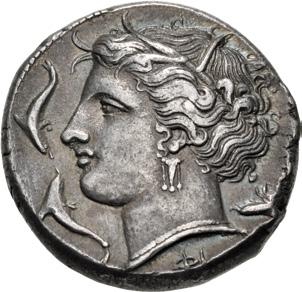

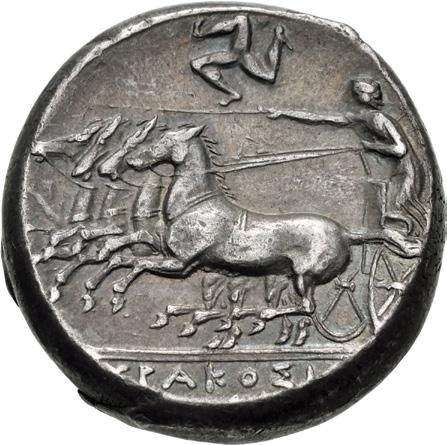
77. SICILY, Syracuse. Agathokles. 317-289 BC. AR Tetradrachm (24mm, 17.03 g, 1h). Struck circa 317-310 BC. Wreathed head of Arethousa left; three dolphins around, f5 below neck / Charioteer, holding kentron and reins, driving fast quadriga left; triskeles above, [[ in exergue]. Ierardi 75 (O13/R49); BAR Issue 2; HGC 2, 1348; SNG ANS 643 (same obv. die); SNG München 1209 (same obv. die); McClean 2816 (same rev. die). Toned. Good VF. ($2000)
From the Wild Rose Collection.
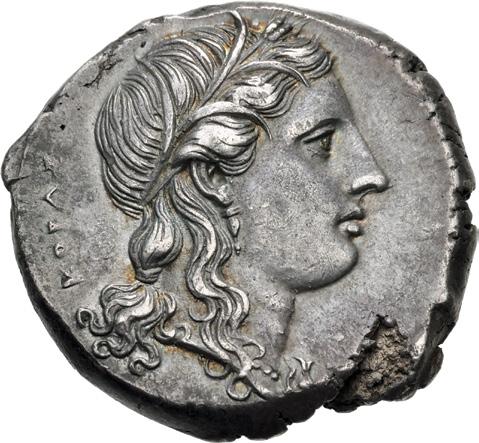

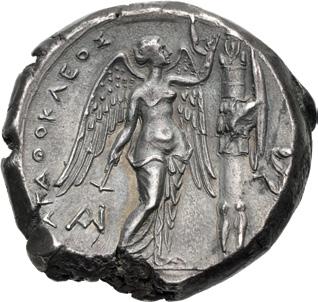
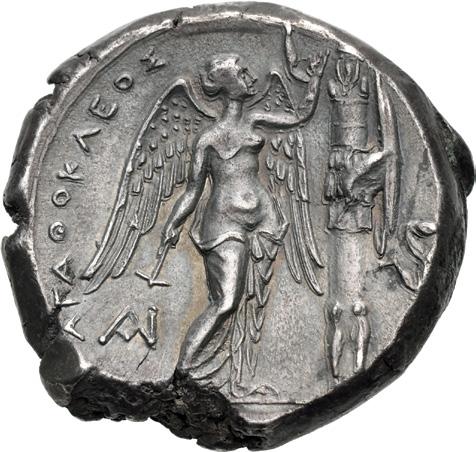
78. SICILY, Syracuse. Agathokles. 317-289 BC. AR Tetradrachm (25mm, 16.97 g, 1h). Struck circa 310-306/5 BC. Wreathed head of Kore right / Nike standing right erecting trophy to right; [ to lower left, triskeles to right. Ierardi 104 (O21/ R65); BAR Issue 23; HGC 2, 1536; SNG Fabricius 259 (same dies); Boston MFA 463 = Warren 406 (same obv. die); Dewing 947 (same rev. die); Ward 320 (same dies). Toned, irregular flan. Good VF. Fine style. ($2000)
From the Wild Rose Collection. Ex RVP Collection (Classical Numismatic Group 94, 18 September 2013), lot 127; Heritage 3000 (29 May 2008), lot 50009; Freeman & Sear 10 (11 February 2004), lot 94.
32

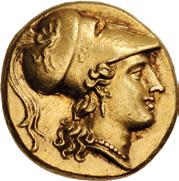
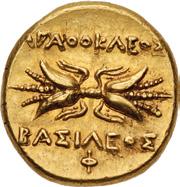

79. SICILY, Syracuse. Agathokles. 317-289 BC. AV 100 Litrai – Double Dekadrachm (14.5mm, 5.71 g, 12h). Struck circa 304-289 BC. Head of Athena right, wearing Corinthian helmet decorated with a griffin / Winged thunderbolt; f below. Bérend, l’or 17 (D5/R4); BAR Issue 29; HGC 2, 1535; SNG ANS 703 (same rev. die); SNG Copenhagen 778 (same dies). Underlying luster, trace deposits, hairlines. EF. Well centered. ($4000)
From the Wild Rose Collection, purchased from Calgary Coin Gallery, January 2016. Ex Edward J. Waddell, Ltd., inventory 44594 (ND); LHS 95 (25 October 2005), lot 531.
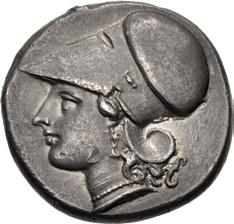
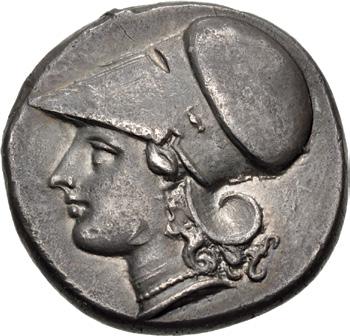
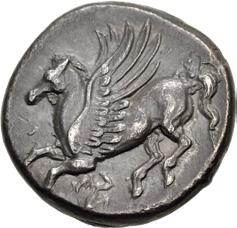
80. SICILY, Syracuse. Agathokles. 317-289 BC. AR Stater (19mm, 6.44 g, 7h). Reduced standard. Struck circa 304289 BC. Helmeted head of Athena left / Pegasos flying left; triskeles below. Pegasi 17; BAR Issue 32; HGC 2, 1407. Find patina, small chip on edge, some light marks, trace deposits. Near EF ($750)
From the Wild Rose Collection. Ex Stack’s Bowers and Ponterio 185 (5 August 2014), lot 241.
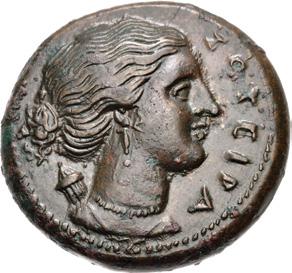


81. SICILY, Syracuse. Agathokles. 317-289 BC. Æ (24mm, 11.13 g, 12h). Struck circa 304-289 BC. Draped bust of Artemis Soteira right, with quiver over shoulder / Winged thunderbolt. CNS 138; BAR Issue 20; HGC 2, 1537. Glossy greenbrown surfaces, trace deposits. EF. ($500)

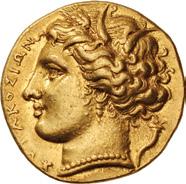
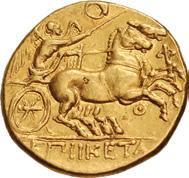
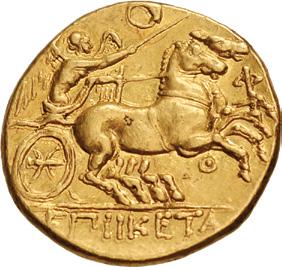
82. SICILY, Syracuse. Hiketas II. 287-278 BC. AV Hemistater – Drachm (15mm, 4.26 g, 6h). Struck circa 279/8 BC. Head of Persephone left, wearing wreath of grain ears, single-pendant earring, and pearl necklace; sUrÅkos5W@ to left, cornucopia to right / Nike, holding kentron in extended right hand and reins in left, driving fast biga right; fibula above, f to right, Q below, Eπ5 5˚EtÅ in exergue. Buttrey, Morgantina, dies 4/I; BAR issue 41; HGC 2, 1277; SNG ANS 778 var. (same obv. die; no Φ); Basel 516 (same dies); Gulbenkian 345 (same dies). Underlying luster, a hint of die rust on obverse, slight die shift on reverse. Near EF. ($5000)
Ex CNG inventory 851501 (March 2010); J. Olphin Collection; Classical Numismatic Group 45 (18 March 1998), lot 129; Classical Numismatic Review XXII.3 (Fall/Winter 1997), no. 8.
Little is known of Hiketas beyond his coinage, but Buttrey pieces together a history based on the numismatic evidence. Following his defeat of Phintias, tyrant of Akragas, Hiketas set out against the Carthaginians. This campaign ended in disaster at the Terias river, northwest of Syracuse. Buttrey, based on his die analysis, concludes that this gold issue was struck very hurriedly towards the end of the reign of Hiketas, and theorizes that this series was issued to pay for his Carthaginian campaign.
33
Pedigreed to 1937

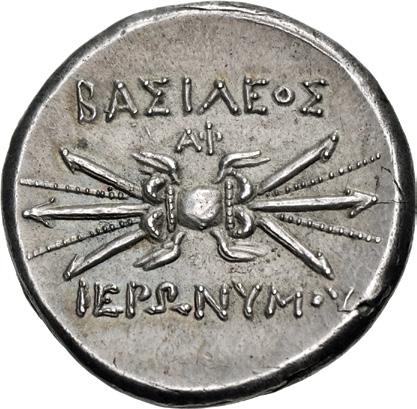
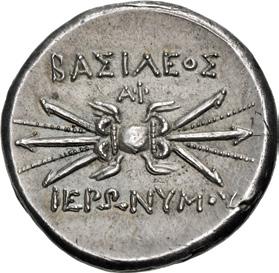
83. SICILY, Syracuse. Hieronymos. 215-214 BC. AR 10 Litrai (22.5mm, 8.51 g, 8h). Diademed head left / Winged thunderbolt; Åf above. Holloway 27d (O12/R22 – this coin); BAR Issue 79; HGC 2, 1567. Attractively toned, a few minor die breaks on obverse. Near EF. ($1500)
From the Wild Rose Collection. Ex Künker 326 (7 October 2019), lot 662 (hammer €6000); Gorny & Mosch 117 (14 October 2002), lot 95; Münzen und Medaillen AG 79 (28 February 1994), lot 203; Münzhandlung Basel 8 (22 March 1937), lot 1935.
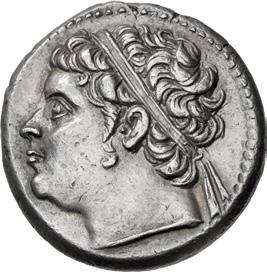


84. SICILY, Syracuse. Hieronymos. 215-214 BC. AR 10 Litrai (22mm, 8.48 g, 7h). Diademed head left / Winged thunderbolt; Åf above. Holloway 28 (O13/R22); BAR Issue 79; HGC 2, 1567. Minor marks on obverse, slight die shift on reverse. EF. ($1000)
Ex CNG inventory 947477 (April 2013); Hunter Collection (Goldberg 72, 5 February 2013), lot 4034.
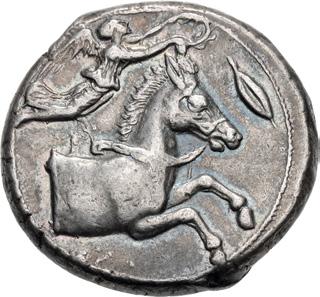
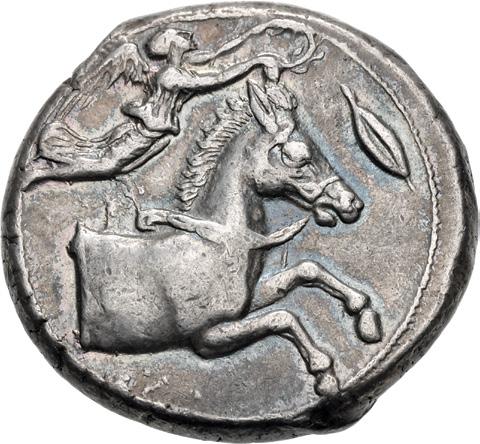

85. SICULO-PUNIC, “Carthage”. Circa 407-398 BC. AR Tetradrachm (26mm, 17.67 g, 6h). Possibly Entella mint. Forepart of horse right, wearing bridle, being crowned by Nike flying right; barley grain to right / Palm tree with two date clusters; tßDJ TeQ (QRT ḤDŠT = “Carthage” in Punic) across lower field. Jenkins, Punic, Series 1, 23 (O6’/R23); CNP 649a; HGC 2, 261. Attractive iridescent tone. Good VF. ($7500)
Ex CNG inventory 979010 (July 2014); Roma VII (22 March 2014), lot 74.

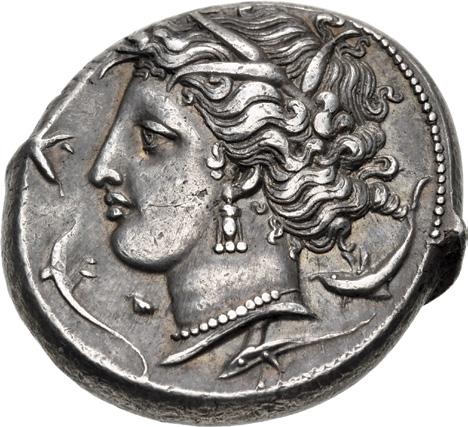

86. SICULO-PUNIC, “The Camp”. Circa 345/38-320/15 BC. AR Tetradrachm (25mm, 17.00 g, 8h). Possibly Entella mint. Wreathed head of Arethousa left; shell below chin, four dolphins around / Horse stepping right; palm tree in background. Jenkins, Punic, Series 2d, 134 (O45/R120’); CNP 199a; HGC 2, 282. Toned, a few light marks under tone, delamination on reverse. Good VF. ($1500)
From the Wild Rose Collection. Ex Stack’s, Bowers and Ponterio 185 (5 August 2014), lot 251; Golden Gate Collection (Coin Galleries, 14 April 1993), lot 198; Classical Numismatic Auctions III (29 April 1998), lot 97.
34

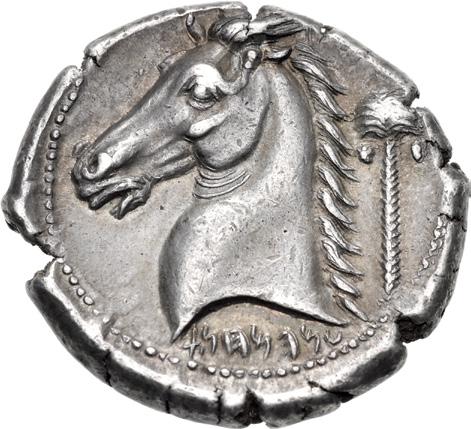
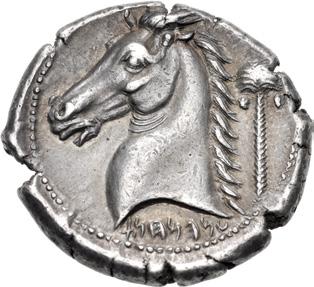
87. SICULO-PUNIC, “The Camp”. Circa 300-289 BC. AR Tetradrachm (24mm, 16.45 g, 3h). Possibly Entella mint. Head of Herakles right, wearing lion skin / Head of horse left; palm tree to right, †nJM∆M` (‘MHMḤNT = “People of the Camp” in Punic) below. Jenkins, Punic, Series 5a, 309 (O97/R252); CNP 271; HGC 2, 293 corr. (varying legend). Attractive old collection tone, minor die break and spot of die rust on obverse. Near EF ($1500) Ex Gorny & Mosch 261 (4 March 2019), lot 124.
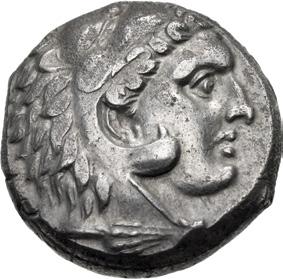

88. SICULO-PUNIC, “The Camp”. Circa 300-289 BC. AR Tetradrachm (23mm, 16.62 g, 12h). Possibly Entella mint. Head of Herakles right, wearing lion skin / Head of horse left; kerykeion to left, palm tree to right, MBß∆M (MHSBM = “Paymasters” in Punic) below. Jenkins, Punic, Series 5b, 329–31 var. (O107/R– [unlisted rev. die; kerykeion unlisted with O107]); CNP 272c; HGC 2, 295. Some weakness to strike, some porosity, a few light marks. VF. ($1000)
Ex Jenkins Collection and Jenkins Plate Coin
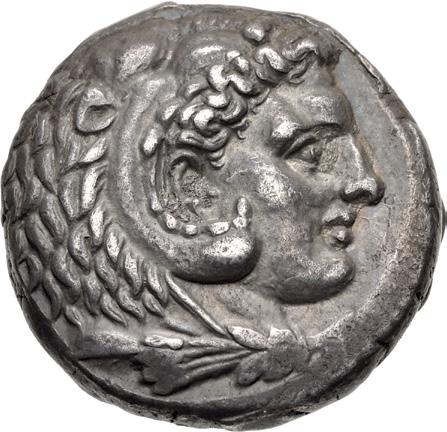
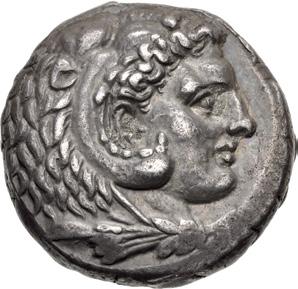
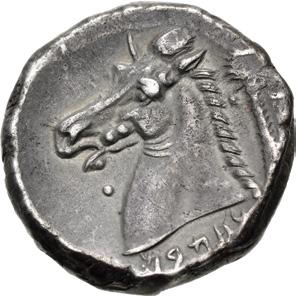
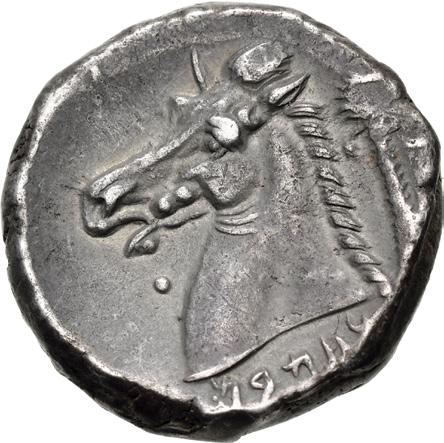
89. SICULO-PUNIC, “The Camp”. Circa 300-289 BC. AR Tetradrachm (24mm, 16.72 g, 6h). Possibly Entella mint. Head of Herakles right, wearing lion skin / Head of horse left; pellet to left, palm tree to right, MBßJM (MḤSBM = “People of the Camp” in Punic) below. Jenkins, Punic, Series 5b, 343 (O110/R281 – this coin referenced and illustrated); CNP 272b; BAR Issue 5; HGC 2, 293 corr. (varying legend). Old collection tone, a couple of tiny spots of die rust on obverse. Good VF. ($2000)
From the Wild Rose Collection. Ex Manhattan Sale III (3 January 2012), lot 103 (hammer $2500); Kirk Davis FPL 39 (Summer 2002), no. 22; Kirk Davis FPL 35 (Summer 2001), no. 16; Numismatica Ars Classica L (18 May 2001), lot 1276; Triton I (2 December 1997), lot 396; G. K. Jenkins Collection (‘Collection Y’ cited in Jenkins).
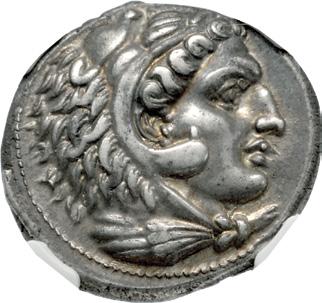
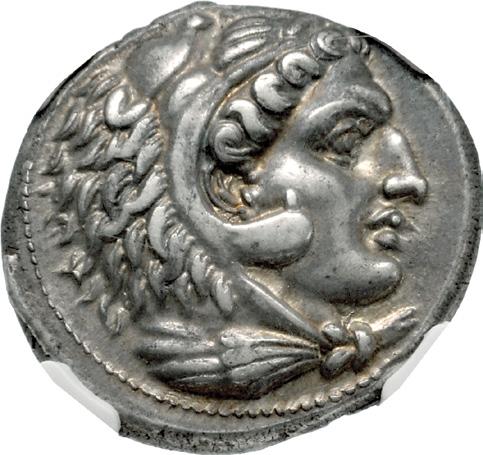

90. SICULO-PUNIC, “The Camp”. Circa 300-289 BC. AR Tetradrachm (26mm, 17.32 g, 6h). Possibly Entella mint. Head of Herakles right, wearing lion skin / Head of horse left; kerykeion to left, palm tree to right, MBß∆M (MHSBM = “Paymasters” in Punic) below. Jenkins, Punic, Series 5b, 350 (O112/R285); CNP 272c; HGC 2, 295; de Luynes 1456 (same dies). In NGC encapsulation 6557502-004, graded XF★, Strike: 5/5, Surface: 5/5. ($2000)
Ex Classical Numismatic Group 121 (6 October 2022), lot 103.
35

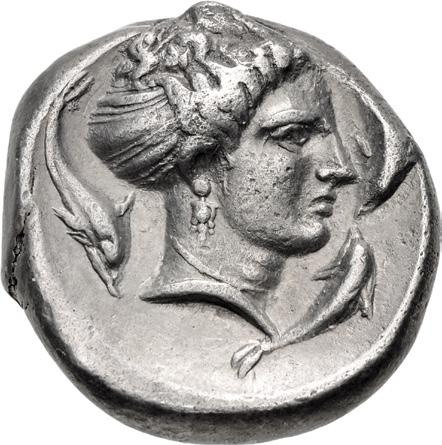
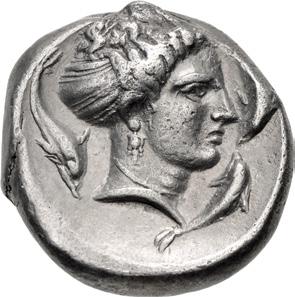
91. SICULO-PUNIC, “Cape of Melkart”. Circa 350-310 BC. AR Tetradrachm (25mm, 16.88 g, 10h). Probably Lilybaion mint. Charioteer, holding kentron and reins, driving fast quadriga right; above, Nike flying left, crowning charioteer; teQ¬M[ße] ([RŠ]MLQRT = “Raš Melqart” in Punic) in exergue / Head of female right, wearing sphendone; three dolphins swimming around. Jenkins, Punic 6 (O5/R5); CNP 315; HGC 2, 731. Lightly toned, minor flan flaws on obverse. Good VF. Very rare early type, and only three examples known with this die combination (one in the ANS, noted by Jenkins, two additional in CoinArchives). ($2000)
Ex Ponterio 97 (10 November 1998), lot 326; Kirk Davis FPL [12] (Fall 1995), no. 32.

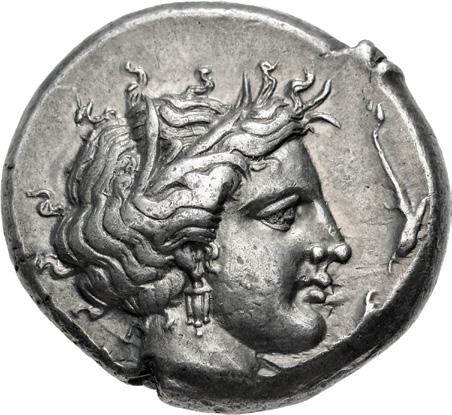
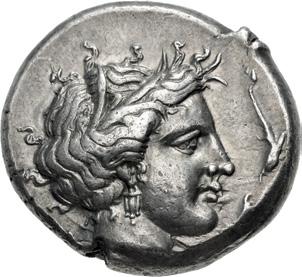
92. SICULO-PUNIC, “Cape of Melkart”. Circa 330-305 BC. AR Tetradrachm (23.5mm, 17.01 g, 3h). Probably Lilybaion mint. Charioteer, holding kentron and reins, driving fast quadriga right; above, Nike flying left, crowning charioteer; [teQ¬M]ße (RŠMLQRT = “Raš Melqart” in Punic) in exergue / Wreathed head of Arethousa right; three dolphins swimming around. Jenkins, Punic 49 (O18/R31); CNP 311; HGC 2, 741; BMC 15 (same dies). Lightly toned, usual compact flan. Good VF. ($2000)
Ex Classical Numismatic Group 118 (13 September 2021), lot 62; David Wray Collection (Classical Numismatic Group 102, 18 May 2016), lot 113.

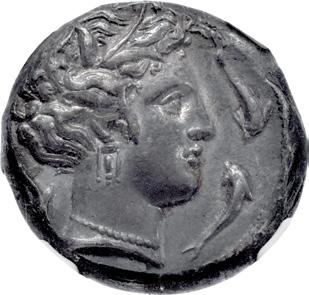


93. SICULO-PUNIC, “Cape of Melkart”. Circa 330-305 BC. AR Tetradrachm (23mm, 17.33 g, 6h). Probably Lilybaion mint. Charioteer, holding kentron and reins, driving fast quadriga left; above, Nike flying right, crowning charioteer; [teQ¬Mße (RŠMLQRT = “Raš Melqart” in Punic) in exergue] / Wreathed head of Arethousa right; three dolphins swimming around. Jenkins, Punic 69 (O24/R52); CNP 344; HGC 2, 743; BMC 4 (same dies); Hirsch 821 (same dies); de Luynes 925 (same dies). In NGC encapsulation 4935331-003, graded Ch XF, Strike: 4/5, Surface: 4/5. ($1500)
94. SICULO-PUNIC, “Ṣyṣ”. Circa 405-380 BC. AR Tetradrachm (24mm, 17.17 g, 3h). Likely Panormos mint. Charioteer, holding kentron and reins, driving fast quadriga left; above, Nike flying right, crowning charioteer; 8$8 (Punic ṢYṢ) and [shell(?)] in exergue / Head of female right; four dolphins around. Jenkins, Punic 21 (O4’/R19); CNS 347a; HGC 2, 1004. Deep old collection tone, minor scratches under tone, edge marks. VF. ($1000)
36
93 94

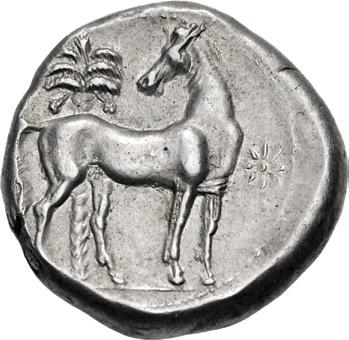

95. CARTHAGE. Circa 300 BC. AR Shekel (19mm, 7.20 g, 3h). Carthage mint. Wreathed head of Tanit left / Horse standing right, head left; palm tree to left in background, star to right. Jenkins & Lewis pl. 26, 15–7; CNP 166; MAA 36 Variante; SNG Copenhagen 141–2. Lightly toned. Good VF. ($1000)
From the Mesogeios Collection.
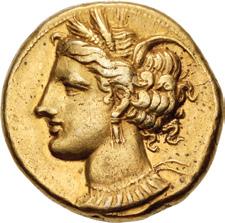


96. CARTHAGE. Circa 290-270 BC. EL Stater (18mm, 7.58 g, 12h). Carthage mint. Wreathed head of Tanit left, wearing necklace with ten pendants / Horse standing right on exergue line; four pellets (in diamond shape) on exergue line behind forelegs. Jenkins & Lewis Group VI, 332 var. (number of pendants; same rev. die); CNP 2.6l var. (same); MAA 13; SNG Copenhagen –. Hairline flan crack, tiny deposits, a few marks, light scrape at edge on reverse. VF. ($1500)
From the Wild Rose Collection. Ex Numismatica Ars Classica 88 (8 October 2015), lot 574; Virginia Collection (Stack’s, 6 September 1973), lot 260.
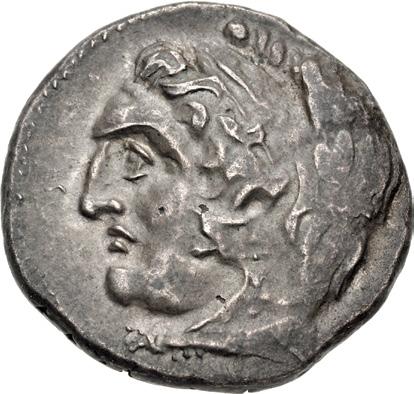


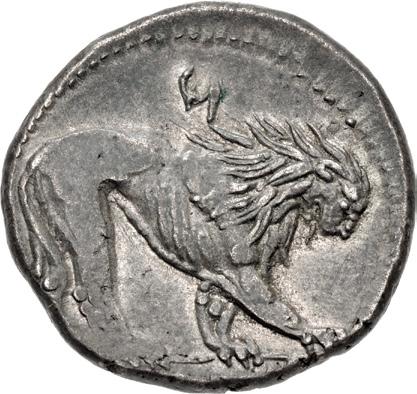
97. CARTHAGE, Libyan Revolt. Circa 241-238 BC. BI Shekel (22.5mm, 7.54 g, 11h). Head of Herakles left, wearing lion skin / Lion standing right; M (Punic M) above. Carradice & La Niece 1; CNP 433b; MAA 53; SNG Copenhagen 239–43. Toned, some weakness to strike, struck with worn obverse die. Good VF. ($750)
From the Wild Rose Collection, purchased from Spink, October 1991.

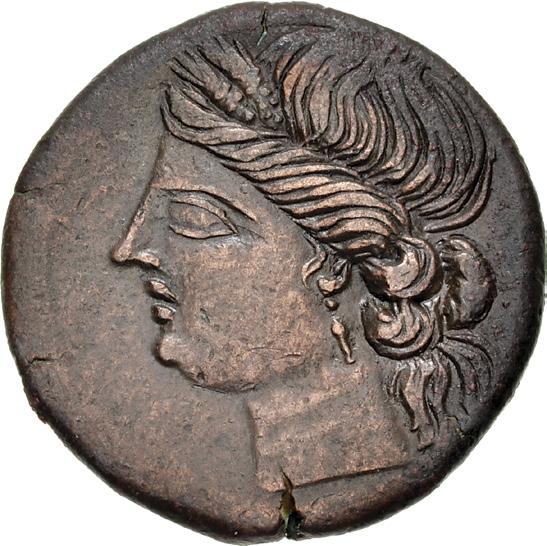
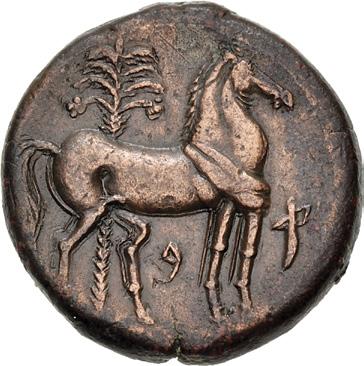
98. CARTHAGE, Second Punic War. Circa 220-215 BC. Æ Trishekel (30mm, 19.47 g, 12h). Wreathed head of Tanit left / Horse standing right; palm tree in left background; ` (Punic A) to right, B (Punic B) below. CNP 164a; MAA 84c; SNG Copenhagen 344 var. (no letters). Brown surfaces, minor scratch in field on reverse. Good VF. ($750)
From the Wild Rose Collection. Ex Künker 341 (1 October 2020), lot 5360 (hammer €1300); Hauck & Aufhäuser 20 (16 October 2007), lot 221; Jacquier FPL 10 (Autumn 1989), lot 108.
37
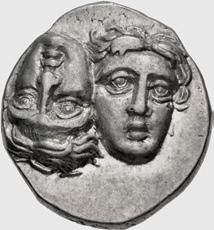

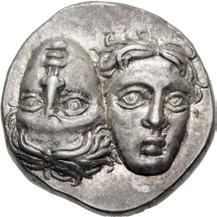
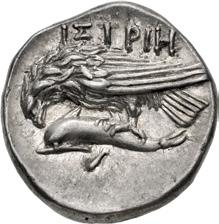
99. MOESIA, Istros. Circa 313-280 BC. AR Drachm (17.5mm, 5.90 g). Facing male heads, the left inverted / Sea-eagle left, grasping dolphin with talons; { below. Dima Group IV, Subgroup IV, 4; AMNG I 417; HGC 3, 1802. Underlying luster, a little die rust on obverse. EF. ($500)
100. MOESIA, Istros. Circa 280-256/5 BC. AR Drachm (17.5mm, 5.84 g). Facing male heads, the left inverted / Seaeagle left, grasping dolphin with talons; Å below. Dima Group IV, Subgroup V, 3, pl. XVIII, 5 (same dies); AMNG I 416; HGC 3, 1803. Lightly toned, underlying luster, a couple of tiny flan flaws, minor die flaws on reverse. EF. ($500)
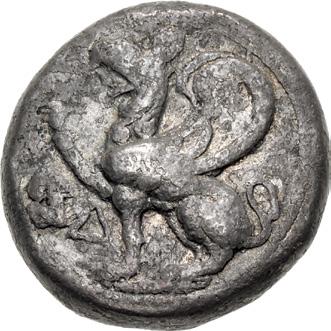
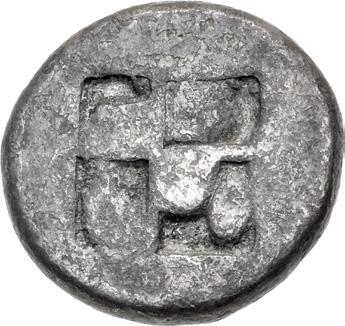
101. THRACE, Abdera. Circa 500-475 BC. AR Oktadrachm (27.5mm, 29.46 g). Griffin seated left, raising left foreleg; grape bunch and d to left / Quadripartite incuse square. May, Abdera, Period II, Group XVIII, 38 (A32/P36); AMNG II 13; HGC 3, 1126; Berlin 1 (same obv. die); Sartiges 159 (same dies); CNG 102, lot 177 (same dies); CNG 97, lot 56 (same dies). Toned, rough surfaces, minor cleaning scratches. Near VF. ($2000)
Ex Numismatik Naumann 111 (5 December 2021), lot 89; Numismatik Naumann 107 (3 September 2021), lot 61.
Very Rare Magistrate
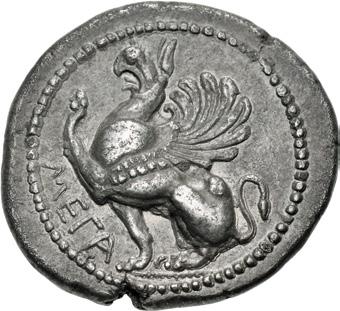

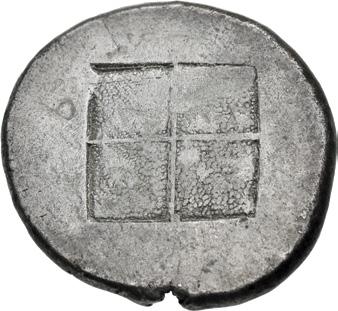
102. THRACE, Abdera. Circa 475-450 BC. AR Tetradrachm (28mm, 14.49 g). Mega–, magistrate. Griffin with curved wing seated left, raising left forepaw; ÂE˝Å to left / Quadripartite incuse square. May, Abdera, Group III, 101 var. (A87/P–[unlisted rev. die\); AMNG II 25; HGC 3, 1133; Berlin 3 (same obv. die). Toned, faint granularity on reverse. Good VF. Well centered. Very rare issue with this magistrate. ($3000)
From the Wild Rose Collection, purchased from Shanna Schmidt, June 2017. Ex Berk BBS 201 (13 July 2017), lot 69.
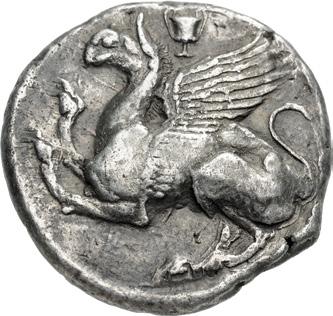
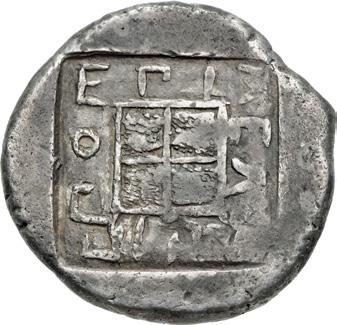
103. THRACE, Abdera. Circa 450-425 BC. AR Tetradrachm (27mm, 14.93 g, 5h). Melanippos, magistrate. Griffin with straight wing leaping left; kantharos above / Magistrate name around raised quadripartite incuse square; all within shallow incuse square. May, Abdera, Period IV, 161 var. (A127/P– [unlisted rev. die]); AMNG II 55; HGC 3, 1136; Jameson 1033 (same obv. die); NAC 126, lot 85 (same obv. die; hammer CHF 26,000). Toned, minor deposits on obverse, some doubling and weakness to strike on reverse. Good VF. Very rare. ($1500)
38
99 100


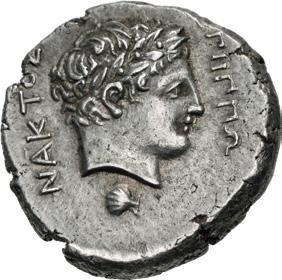
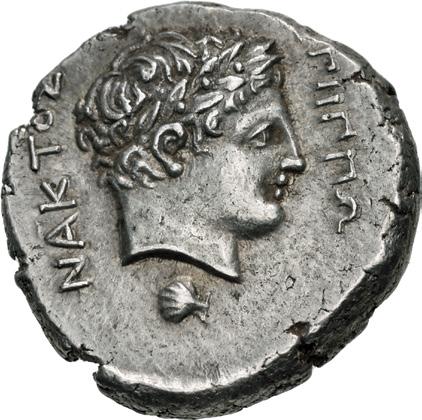
104. THRACE, Abdera. Circa 336-311 BC. AR Stater (23mm, 10.68 g, 3h). Ipponax, magistrate. Griffin lying left, raising right forepaw / Laureate head of Apollo right; [E]π5 5ππW-@Å˚tos at sides, shell below. C-N 126–35 (obv. die 2); May, Abdera 543; AMNG II 153; HGC 2, 1211h. Toned, a little off center. EF. ($2000)
From the Wild Rose Collection. Ex Molard Collection (Nomos 15, 22 October 2017), lot 42; Triton XVIII (6 January 2015), lot 410; Roma III (31 March 2012), lot 179.
Unique Issue Revises May
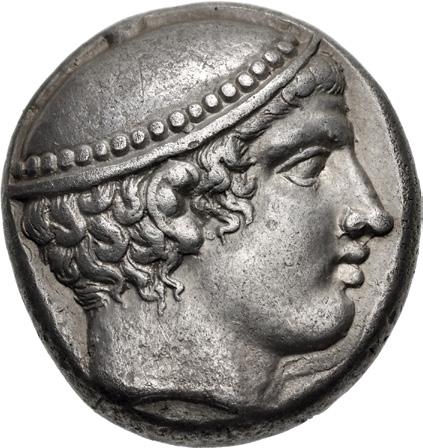


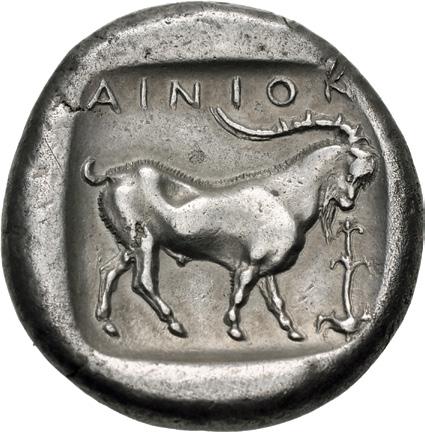
105. THRACE, Ainos. Circa 403/2-402/1 BC. AR Tetradrachm (23mm, 16.69 g, 6h). Persic standard. Head of Hermes right, wearing petasos with pelleted rim / Goat standing right; grain ear on long stalk to right; Å5@5o@ above; all within incuse square. Unpublished issue, but struck from May, Ainos, obverse die A151, with a reverse symbol used for May’s Group 39; cf. HGC 3, 1269. Toned, a few small test cuts on edge. Near EF. Apparently unique. ($4000)
From the Wild Rose Collection, purchased from Gorny & Mosch, 16 January 2020. Ex Roma XVII (28 March 2019), lot 406.
The appearance of this issue requires a revision to the relative chronology of May’s Period II. Tetradrachms of this period were struck on the Persic standard, and feature the profile head of Hermes on the obverse. This coin was struck with an obverse die from May’s Period II, Group 29, but the reverse suggests that this issue was struck much later. Significantly, the reverse here uses the full ethnic AINION, rather than the usual AIN or AINI that appears on all the other Period II tetradrachms. The full ethnic is canonical for the succeeding period III tetradrachms, which were struck on the Chian standard and feature a facing head of Hermes. Moreover, the symbol here, a grain ear on a long stalk, is the symbol that appears on the first tetradrachms of May’s Period III (Group 39). As such, this coin must be from an unpublished final group of May’s Period II, and by virtue of the obverse die link, May’s Group 29 should immediately precede this issue.
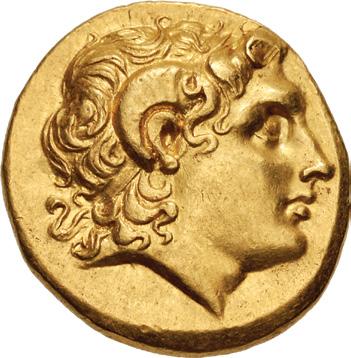
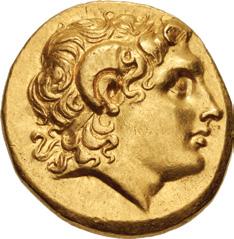
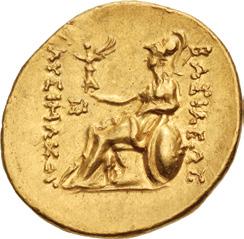
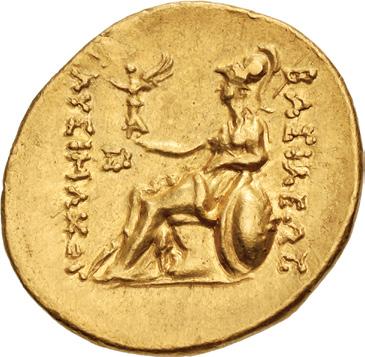
106. THRACE, Byzantion. Circa 260-245 BC. AV Stater (19mm, 8.49 g, 11h). In the name and types of Lysimachos. Diademed head of the deified Alexander right, with horn of Ammon / Athena Nikephoros seated left, left arm resting on shield, transverse spear in background; %5 to inner left. Marinescu Issue 23, 58 (O27/R55); Müller –; HGC 3, 1374. Light graze on reverse. EF. ($3000)
From the Wild Rose Collection, purchased from Calgary Coin Gallery, April 2015. Ex Sayles & Lavender inventory 12215 (ND); Classical Numismatic Group 64 (24 September 2003), lot 155.
39

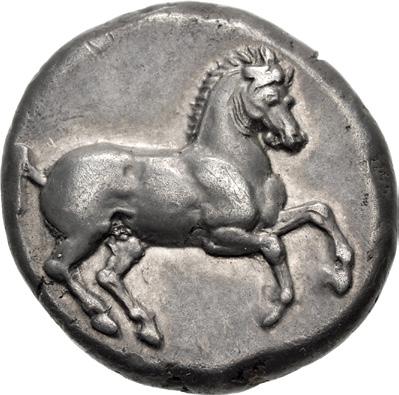

107. THRACE, Maroneia. Circa 365-330s BC. AR Stater (22mm, 10.97 g, 12h). Persic standard. Philonikos, magistrate. Free horse rearing right / Grape arbor in linear square; [Eπ5] f5¬-o@5-˚o[U] around; all within shallow incuse square. Schönert-Geiss Period VIII, 486 (V32/R56); HGC 3, 1533; Traité IV 1477, pl. CCCXLII, 13 (same dies); Triton XXIII, lot 167 (same dies; hammer $8500). Attractive cabinet tone, minor test cut on edge, hairlines, spot of die rust and a few minor marks on obverse. Good VF. Very rare issue, only two examples noted by Schönert-Geiss, both in public collections (Paris and Sofia), and four in CoinArchives (including the present coin). ($1000)
From the Wild Rose Collection. Ex Roma VI (29 September 2013), lot 577.
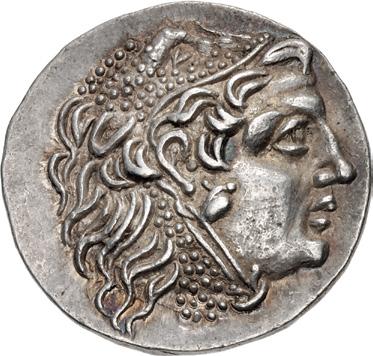
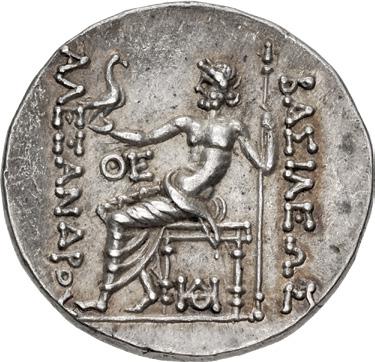
108. THRACE, Odessos. Circa 90-80 BC. AR Tetradrachm (31mm, 16.64 g, 12h). In the name and types of Alexander III of Macedon. Head of Herakles right, wearing lion skin / Zeus Aëtophoros seated left; QE in left field, y (civic monogram) below throne. Callataÿ Group 1, dies D9/R- (unlisted rev. die); Topalov, Odesos 69; Price 1181; HGC 3, 1587. Toned. EF. ($500)
From the Wild Rose Collection. Ex Toliver Besson Collection (Classical Numismatic Group Electronic Auction 473, 29 July 2020), lot 14 (hammer $1100) Heritage 3042 (20 September 2015), lot 32040; Classical Numismatic Group 99 (13 May 2015), lot 49; Classical Numismatic Group 91 (19 September 2012), lot 93; Dr. Patrick H.C. Tan Collection (Classical Numismatic Group 84, 5 May 2010), lot 151; Classical Numismatic Group 42 (29 May 1997), lot 249.

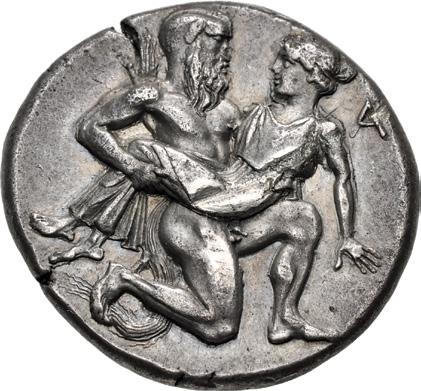
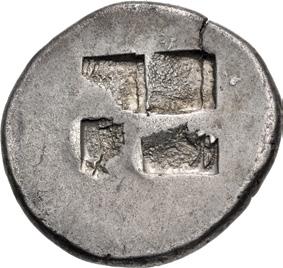
109. ISLANDS off THRACE, Thasos. Circa 412-404 BC. AR Stater (23mm, 8.61 g). Ithyphallic satyr advancing right, carrying off protesting nymph; Å to upper right / Quadripartite incuse square. Le Rider, Thasiennes 6; HPM pl. X, 27–8; HGC 6, 334; Kraay & Hirmer 437. Toned, slight die shift on obverse, light scratches under tone. Near EF. Great detail for issue. ($2000)
From the Wild Rose Collection. Ex Classical Numismatic Review XLVII.1 (Winter 2022), no. 5592090; Gorny & Mosch 280 (11 October 2021), lot 158; Andrian-Werburg Collection; Gorny & Mosch 133 (11 October 2004), lot 111.
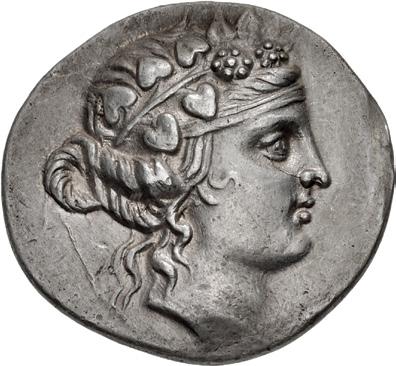
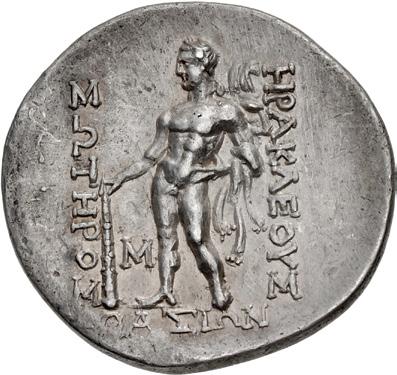
110. ISLANDS off THRACE, Thasos. Circa 150-140 BC. AR Tetradrachm (33mm, 16.97 g, 12h). Wreathed head of young Dionysos right / Herakles standing facing, head left, holding club, lion skin draped over left arm; Â to inner left. Prokopov, Silberprägung, Group V, 57 (V E3/R 51); Le Rider, Thasiennes 51; HGC 6, 358. Faintly toned, minor die breaks, light cleaning marks. Near EF. Well centered. ($500)
From the DFA Collection. Ex Numismatik Naumann 123 (4 December 2022), lot 108.
40

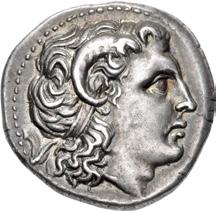

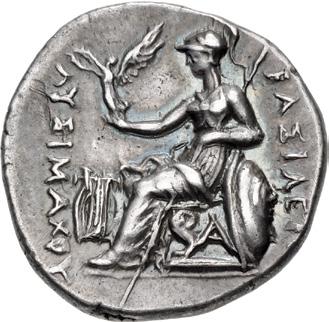
111. KINGS of THRACE, Macedonian. Lysimachos. 305-281 BC. AR Drachm (18mm, 4.33 g, 12h). Ephesos mint. Struck circa 294-287 BC. Diademed head of the deified Alexander right, with horn of Ammon / Athena Nikephoros seated left, left arm resting on shield, transverse spear in background; kithara to inner left, Å on throne. Thompson 174; Müller 355; HGC 3, 1753d. Lovely iridescent tone, minor die flaw in field on reverse. EF ($750)


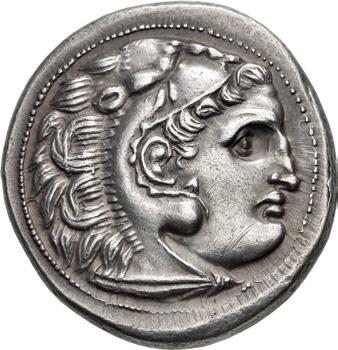
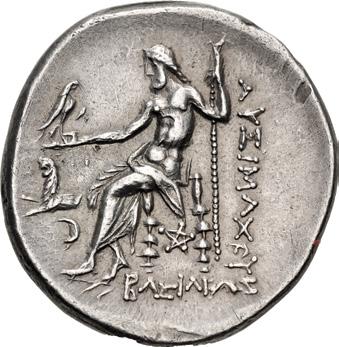
112. KINGS of THRACE, Macedonian. Lysimachos. 305-281 BC. AR Tetradrachm (30mm, 17.22 g, 1h). Lampsakos mint. Struck 297/6-282/1 BC. Diademed head of the deified Alexander right, with horn of Ammon / Athena Nikephoros seated left, left arm resting on shield, transverse spear in background; to inner left, M above crescent. Thompson 61; Müller 395; HGC 3, 1750b; SNG BN 2546. Lightly toned, pitting. EF. ($2000)
From the Wild Rose Collection, purchased from Pars Coins, 15 August 2019. Ex Pars Coins 1 (8 April 2019), lot 68; Heritage 3071 (6 January 2019), lot 33071; Classical Numismatic Group 109 (12 September 2018), lot 72; Triton XXI (9 January 2018), lot 381; New York Sale XXXIV (6 January 2015), lot 55; Numismatica Ars Classica 77 (26 May 2014), lot 38.
113. KINGS of THRACE, Macedonian. Lysimachos. 305-281 BC. AR Tetradrachm (28mm, 17.17 g, 1h). In the types of Alexander III of Macedon. Kolophon mint. Struck circa 299/8-297/6 BC. Head of Herakles right, wearing lion skin / Zeus Aëtophoros seated left; in left field, lion forepart left above crescent; pentagram below throne. Thompson 123; Müller 19; Price L23; HGC 3, 1749a. Lightly toned, a few scratches. Near EF ($1000)
From the Wild Rose Collection. Ex Gorny & Mosch 253 (5 March 2018), lot 105; Pecunem 40 (Numismatik Naumann, 7 February 2016), lot 44.
Very Rare Derrones Issue

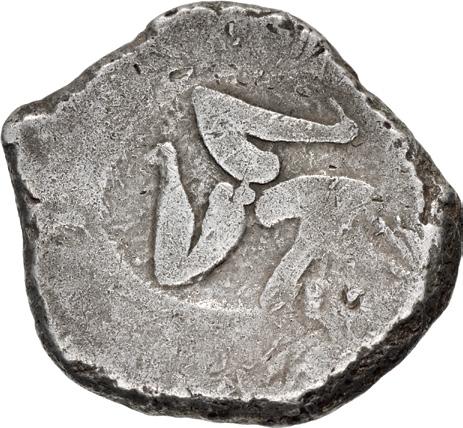
114. THRACO-MACEDONIAN TRIBES, Derrones. Epi–. Circa 475/0-465 BC. AR Dodekadrachm(?) (38.5mm, 35.43 g). Driver, holding goad in right hand, reins in left, driving ox cart right; above, crested Corinthian helmet right; E above, P below, 5 to right / Clockwise triskeles within shallow incuse circle. Triton XXIII, lot 180; CNG 85, lot 264; Freeman & Sear 14, lot 124; Gemini XI, lot 17; Gemini III, lot 84; Helios 3, lot 31; Rauch 85, lot 147 (all from the same obv. die). Toned, a few scratches on reverse. VF. Very rare with these letters on the obverse. ($4000)
From the Wild Rose Collection, purchased from Calgary Coin Gallery, November 2017. Reportedly ex Freeman & Sear inventory, 2007.
41
112 113
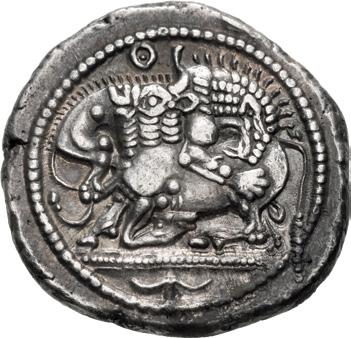
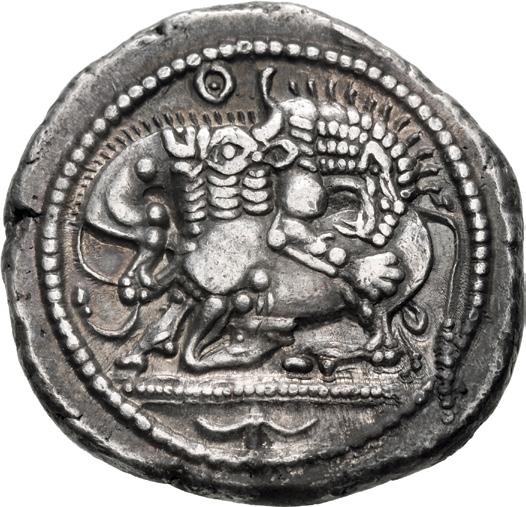

115. MACEDON, Akanthos. Circa 525-470 BC. AR Tetradrachm (28.5mm, 17.63 g). Attic standard. Lion right, attacking bull crouching left, biting into its hindquarter; Q above; floral ornament in exergue / Quadripartite incuse square. Desneux 48–68 var. (unlisted dies); AMNG III/2, 5; HGC 3, 383. Toned, patch of find patina. Near EF. ($3000)
From the Wild Rose Collection. Ex Roma XII (29 September 2016), lot 175.
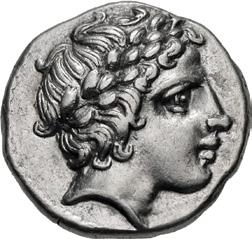
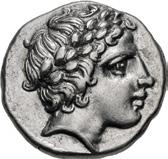
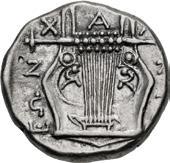

116. MACEDON, Chalkidian League. Circa 383/2 BC. AR Tetrobol (14mm, 2.43 g, 12h). Olynthos mint. Laureate head of Apollo right / Kithara. Robinson & Clement Group H, 70 (A51/P48); HGC 3, 502. Slightly off center on reverse. Good VF. ($500)
From the W. Hansen Collection, purchased from Pars Coins (inv. PCW-G3922), 2012.
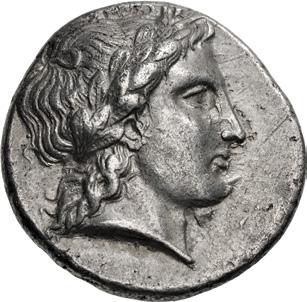
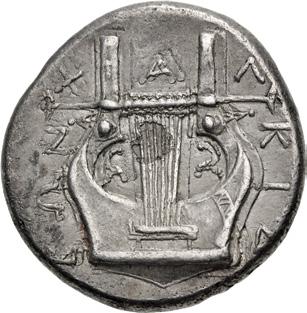
117. MACEDON, Chalkidian League. Circa 380 BC. AR Tetradrachm (25mm, 14.30 g, 12h). Olynthos mint. Laureate head of Apollo right / Kithara. Robinson & Clement Group J, 44 (A33/P40); HGC 3, 498 corr. (some with symbols); Pozzi 750 (same dies). Double struck, a few light scratches on obverse, delamination on reverse. Good VF. ($1500)
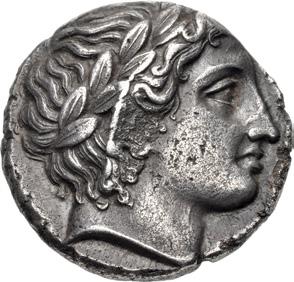
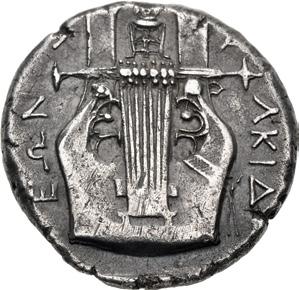
118. MACEDON, Chalkidian League. Circa 359 BC. AR Tetradrachm (24mm, 14.37 g, 3h). Olynthos mint. Laureate head of Apollo right / Kithara; tripod between uprights. Robinson & Clement Group M, – (A–/P68 [unlisted obv. die]); HGC 3, 498 corr. (some with symbols). Toned, some granularity, die break on obverse, marks on reverse. Good VF. ($1500)
Ex Triton XXV, Session 5 (25 January 2022), lot 5041; Sternberg XXVI (16 November 1992), lot 67.
42
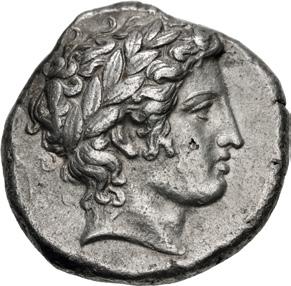
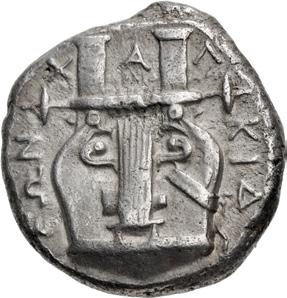
119. MACEDON, Chalkidian League. Circa 353 BC. AR Tetradrachm (25mm, 14.30 g, 12h). Olynthos mint; Archidamos, magistrate. Laureate head of Apollo right / Kithara; Eπ5 Årc5d-ÅÂo-[U] in tiny letters above crossbar. Robinson & Clement Group S, 105 var. (A–/P90); HGC 3, 500. Lightly toned, minor flan flaws, slight die wear. Good VF. ($1500)

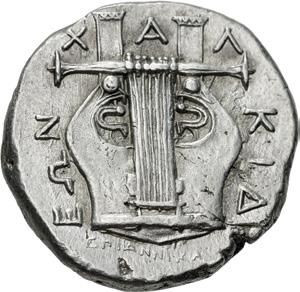
120. MACEDON, Chalkidian League. Circa 351 BC. AR Tetradrachm (23.5mm, 14.43 g, 4h). Olynthos mint; Annikas, magistrate. Laureate head of Apollo right / Kithara; Eπ5 Å@@5˚Å in tiny letters below. Robinson & Clement Group U, 125 (A78/P107); HGC 3, 500; de Luynes 1551 (same dies). A few minor flan flaws, a hint of porosity. Near EF. Attractive style and well centered. ($2000)
Pedigreed to 1976
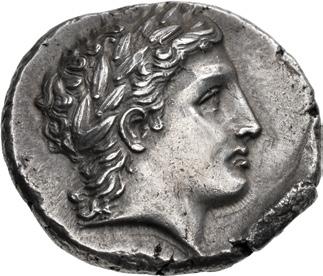
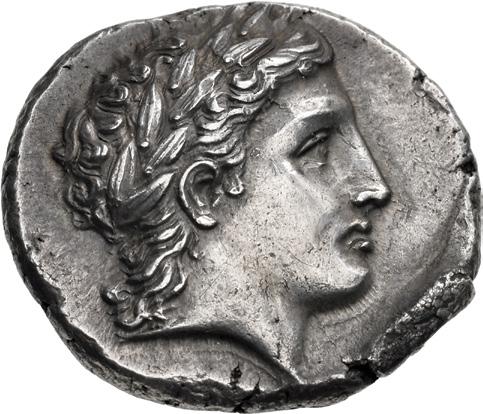
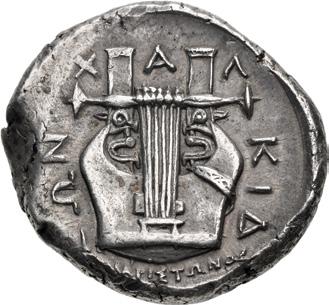
121. MACEDON, Chalkidian League. Circa 350 BC. AR Tetradrachm (25mm, 14.49 g, 10h). Olynthos mint; Ariston, magistrate. Laureate head of Apollo right / Kithara; [Eπ5] År5stW@os below. Robinson & Clement Group V, 128 (A79/P110); HGC 3, 500; SNG ANS 496 (same obv. die). Toned, edge flaw, small mark and minor doubling on obverse. EF. ($2000)
From the Wild Rose Collection. Ex Deyo Collection (Classical Numismatic Group 90, 23 May 2012), lot 415; Leu 15 (4 May 1976), lot 181.
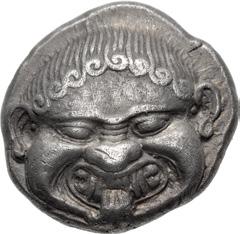

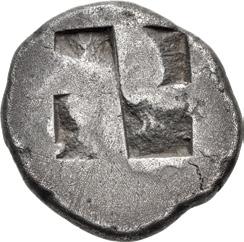
122. MACEDON, Neapolis. Circa 500-480 BC. AR Stater (19.5mm, 9.77 g). Facing gorgoneion with protruding tongue / Quadripartite incuse square. AMNG III/2, 6; HGC 3, 583. Toned, typical granular surfaces, scratches. Good VF. ($1500)
From the Wild Rose Collection, purchased from Valter Dionsi, March 2016. Ex Numismatica Ars Classica 72 (16 May 2013), lot 870.
43
Attractive Alexander AR Tristater – “Oktadrachm”
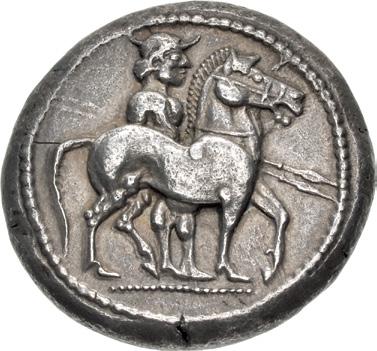

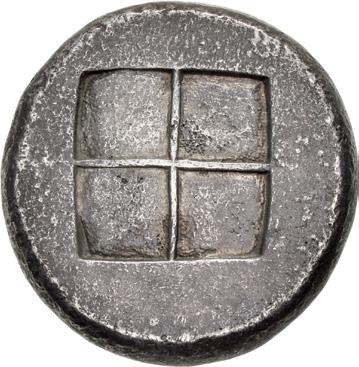
123. KINGS of MACEDON. Alexander I. 498-454 BC. AR Tristater – “Oktadrachm” (30.5mm, 28.43 g). Light Aeginetic standard. Aigai mint. Struck circa 476/5-460 BC. Horseman, wearing chlamys and petasos, and holding two spears, standing right behind horse advancing right / Quadripartite incuse square. Raymond pl. II, 4; AMNG III p. 49, 7 (Bisaltai); HPM pl. XII, 2 (Bisaltai); SNG ANS 1; Athena Fund I 21 (same obv. die); Boston MFA 617 (Bisaltai); Gillet 739; Pozzi 696 = Rhousopoulos 1006 (Bisaltai). Attractive cabinet tone. EF. ($10,000)
From the Wild Rose Collection. Ex Triton XXII (8 January 2019), lot 185; Osaka Collection (Hess-Divo 334, 29 May 2018), lot 40, assembled prior to 2000.
By the end of the sixth century BC, the Kingdom of Macedon became an influential regional power, strategically located between the Persian Empire and the city-states of Greece. The wars with Persia further extended Macedon’s importance, especially that of its young prince, Alexander I, the son of Amyntas. An astute politician, Alexander deftly maneuvered through this precarious situation. Although he early on offered his sister’s hand in marriage to a Persian to offset punishment for his revenge against the high handedness of a Persian embassy in 514-513 BC, Alexander maintained an aloof but cordial relationship with the Persians as they moved through the region in 492 BC, forcing the other tribes to Medize. At the same time, he worked towards a stronger association with the Greeks. Herodotos (9.44) says that on the eve of the battle at Plataia, Alexander entered the Athenian camp to report that a delay in engaging the Persians would help to further diminish their already low supplies. In return, he hoped the Greeks (in particular the Athenians) would assist him when the time came, thereby forging a relationship between the rising power in the north with the rising Greek city-states of Athens, Sparta and their allies.
This coin type had long been ascribed to the Bisaltai, one of the powerful Thraco-Macedonian tribes that struck coinage in the late 6th and early 5th centuries. The weight of the evidence now points to it being the earliest issue of Alexander I, when he was allied with the tribes against the Persians; he presumably struck coins with types that were acceptable to his allies and would, in fact, symbolize their alliance. For a discussion of the weight standard of this issue, see S. Psoma, “Did the So-Called Thraco-Macedonian Standard Exist?” in KAIPOΣ, pp. 167–90.

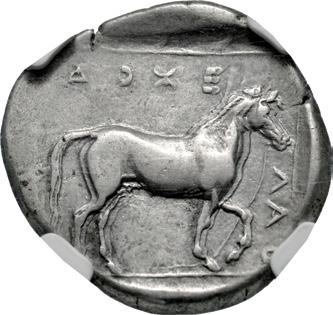
124. KINGS of MACEDON. Archelaos. 413-400/399 BC. AR Stater (23mm, 10.56 g, 4h). Aigai mint. Head of Apollo right, with short hair, wearing tainia / Horse advancing right, trailing rein, in linear square within shallow incuse square. Westermark, Staters, Group II, Series 2, dies O86/R– (unlisted rev. die); AMNG III/2, 3; HGC 3, 795; Hermitage Sale II, lot 614 (same obv. die). In NGC encapsulation 4629462-006, graded Ch VF, Strike: 4/5, Surface: 4/5, Fine Style, die shift. ($1000) Ex CNG inventory 713832 (June 1999).
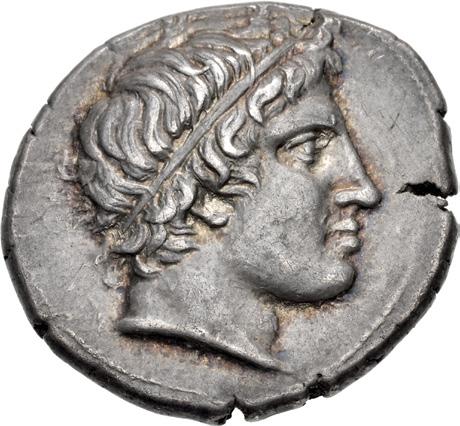
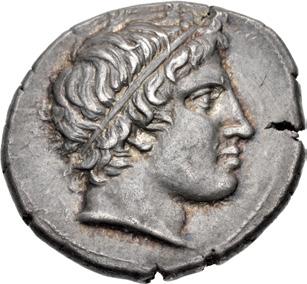
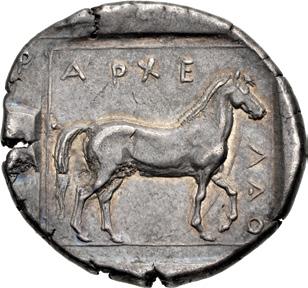

125. KINGS of MACEDON. Archelaos. 413-400/399 BC. AR Stater (25mm, 10.54 g, 1h). Aigai mint. Head of Apollo right, with short hair, wearing tainia / Horse advancing right, trailing rein, in linear square within shallow incuse square. Westermark, Staters, Group II, Series 2, dies O92/R– (unlisted rev. die); AMNG III/2, 3; HGC 3, 795; SNG Alpha Bank 148 (same obv. die). Attractive iridescent tone, light marks, die shift on reverse. EF. ($3000)
From the Wild Rose Collection. Ex Roma XXII (7 October 2021), lot 229; Northern California Gentleman Collection (Triton XXIV, 19 January 2021), lot 451; Classical Numismatic Review XXIII.2 (Fall/Winter 1998), no. 18.
44
An Impressive Selection of the Staters of Philip, Alexander, and Their Successors
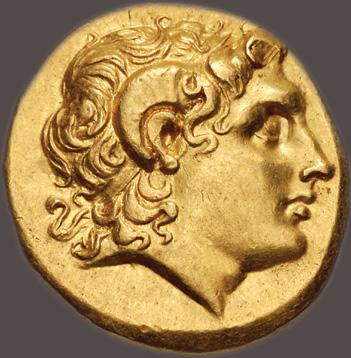



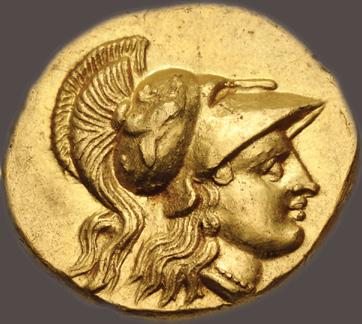
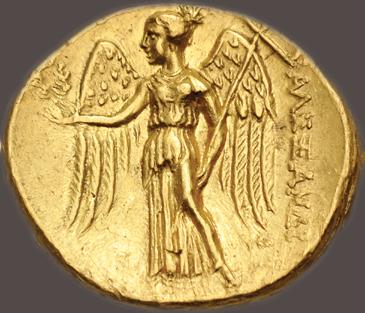
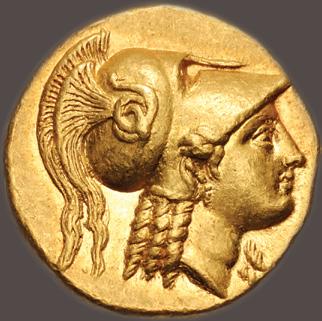
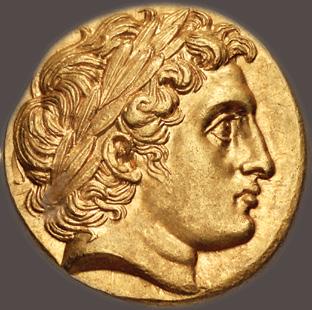

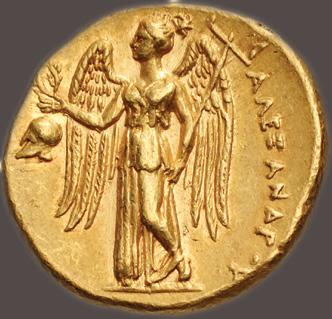

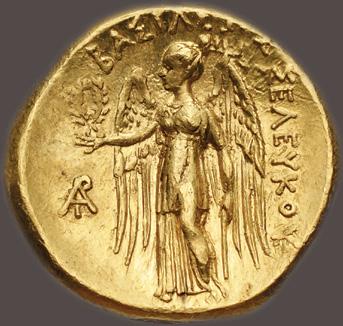

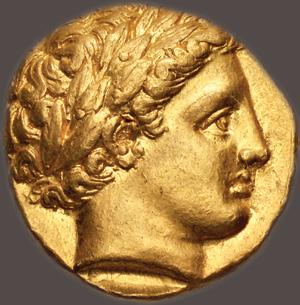
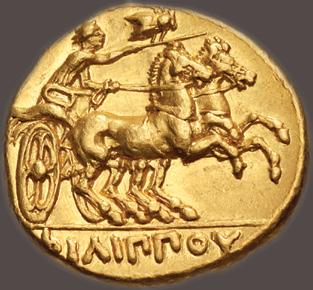


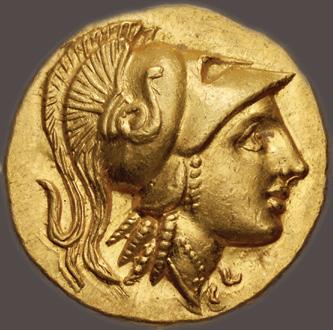
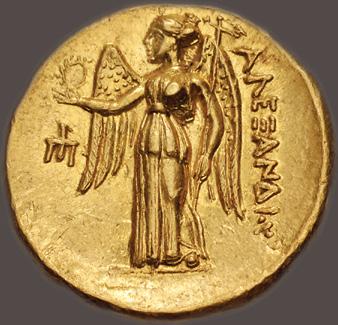
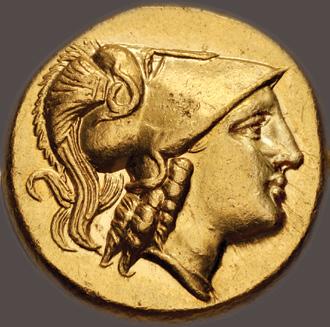
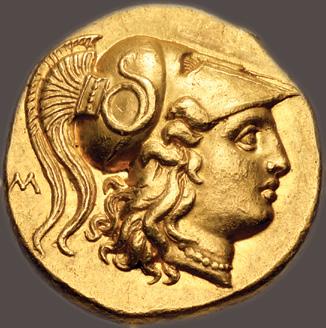
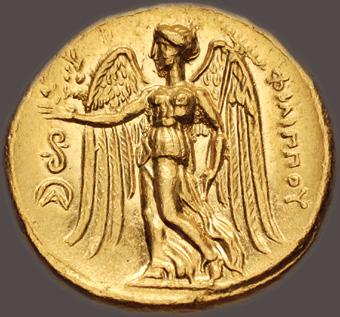
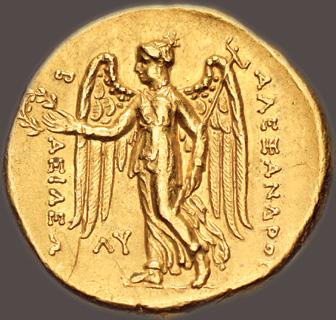


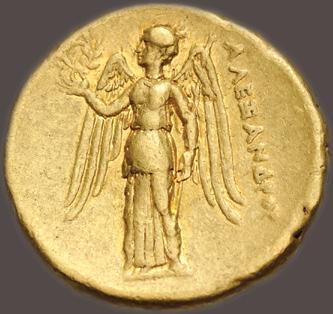
45
126
106
the name
131
128
134
138
Lot
Philip II Lot
In
of Lysimachos Lot
Alexander III Lot
Philip II - Alexander III Lot
Alexander III - Philip III Lot 133 Alexander III Lot
Philip III
Lot 136 Alexander III - Kassander
Lot 141 Philip III
Lot 140 Philip III
Lot 306 Seleukos I
359 Ptolemy I
Lot 303 Seleukos I Lot
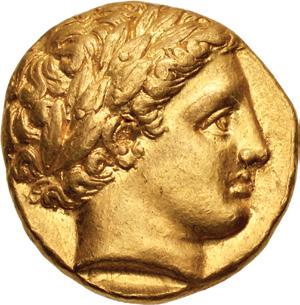
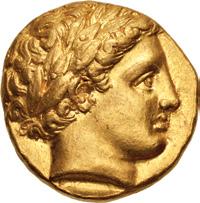
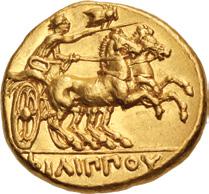

126. KINGS of MACEDON. Philip II. 359-336 BC. AV Stater (16.5mm, 8.59 g, 10h). Pella mint. Struck circa 345/2340/36 BC. Laureate head of Apollo right / Charioteer, holding kentron and reins, driving biga right; cicada above. Le Rider Group I.C, 45–7 var. (D23/R– [unlisted rev. die]); SNG ANS 128 = Weber 2040; SNG Fitzwilliam 2023 (same obv. die). Underlying luster, slight die rust and tiny flan flaw on obverse. EF. ($3000)
From the Wild Rose Collection. Ex Roma XVII (28 March 2019), lot 388.
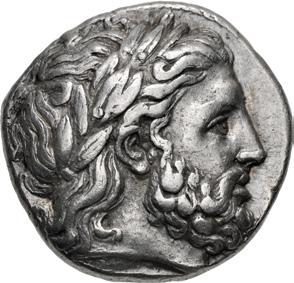
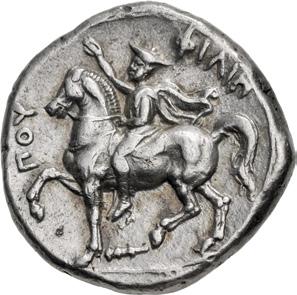
127. KINGS of MACEDON. Philip II. 359-336 BC. AR Tetradrachm (24mm, 14.40 g, 11h). Amphipolis mint. Struck circa 355-349/8 BC. Laureate head of Zeus right / Philip, raising right and holding rein, on horseback left; club below. Le Rider Group I.B, 104 (D45/R87); SNG ANS 469–70. Underlying luster, a couple of tiny marks on reverse. Good VF. ($1000)
From the Wild Rose Collection. Ex Classical Numismatic Auctions XVIII (3 December 1991), lot 131.
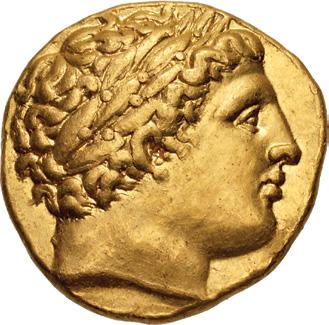
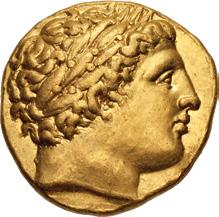
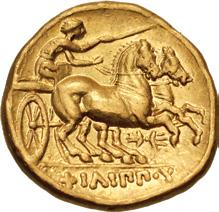

128. KINGS of MACEDON. temp. Philip II – Alexander III. Circa 340/36-328 BC. AV Stater (18mm, 8.61 g, 5h). In the name and types of Philip II. Pella mint. Laureate head of Apollo right / Charioteer, holding kentron and reins, driving biga right; thunderbolt below. Le Rider Group II.1, 80 (D35’/R61); SNG ANS 130. Near EF. Well centered and struck. ($3000)
From the Wild Rose Collection. Ex Classical Numismatic Group 97 (17 September 2014), lot 83.

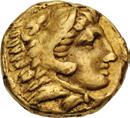

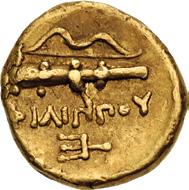
129. KINGS of MACEDON. temp. Philip II – Alexander III. Circa 340/36-328 BC. AV Quarter Stater (10.5mm, 2.12 g, 9h). In the name and types of Philip II. Pella mint. Head of Herakles right, wearing lion skin / Club left; bow above; below, trident left. Le Rider Group II.1, 84 (D54/R40); HGC 3, 851. Traces of find patina, edge marks from prior bezel, minor marks. VF. Rare with trident left. ($1000)
Ex DFA Collection; Trausnitz Collection (Nomos Obolos 18, 21 February 2021), lot 155.
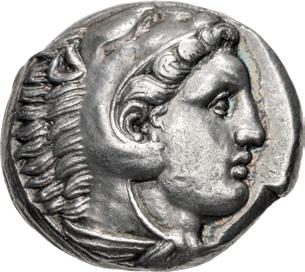
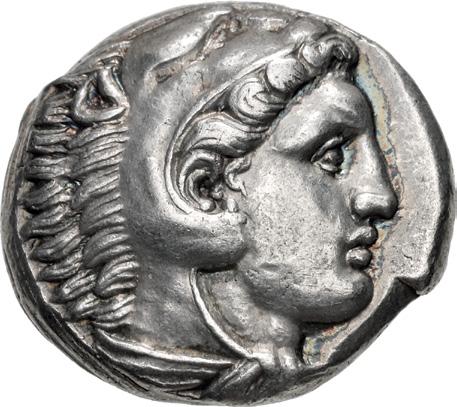
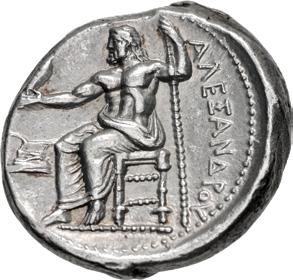
130. KINGS of MACEDON. Alexander III ‘the Great’. 336-323 BC. AR Tetradrachm (24.5mm, 17.22 g, 8h). Amphipolis mint. Struck under Antipater, circa 332-326 BC. Head of Herakles right, wearing lion skin / Zeus Aëtophoros seated left; in left field, prow left. Price 4; Troxell, Studies, Issue A1. Light iridescent tone, underlying luster. Near EF. ($750)
From the Wild Rose Collection. Ex Nomos 22 (22 June 2021), lot 104. Lot includes a Michel Dürr inventory ticket.
46

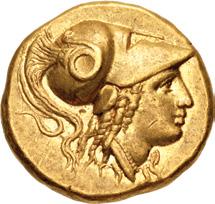
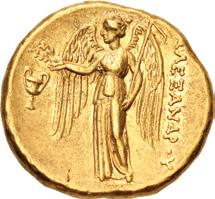
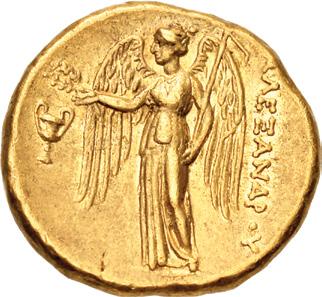
131. KINGS of MACEDON. Alexander III ‘the Great’. 336-323 BC. AV Stater (17.5mm, 8.60 g, 1h). Amphipolis mint. Struck under Antipater, circa 328/5-323 BC. Helmeted head of Athena right / Nike standing left, holding wreath and stylis; kantharos in left field. Price 168; Troxell, Studies, Series 2, 480 (O10/RC4). Underlying luster, mark on obverse. Near EF. Well centered. ($3000)
From the Wild Rose Collection. Ex Dr. Plumacher Collection (Peus 431, 27 April 2022), lot 3157, purchased from Münzhandlung Ritter, 21 August 1998.
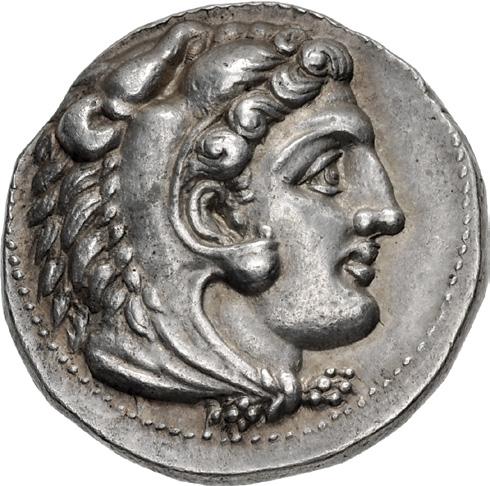



132. KINGS of MACEDON. Alexander III ‘the Great’. 336-323 BC. AR Tetradrachm (27mm, 17.06 g, 2h). Tarsos mint. Struck under Menes or Philotas, circa 327-323 BC. Head of Herakles right, wearing lion skin / Zeus Aëtophoros seated left; plow in left field, Q below throne, small globule above right arm. Price 3032; Newell, Tarsos 38 (obv. die unlisted); ANS 1951.116.13 (same obv. die). Lightly toned. Choice EF. Struck from fine style dies on a broad flan. ($1000)
From the Wild Rose Collection, purchased from Shanna Schmidt, 20 February 2019. Ex Triton XXI (9 January 2018), lot 397; Roma XIII (23 March 2017), lot 178.

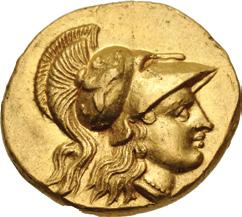

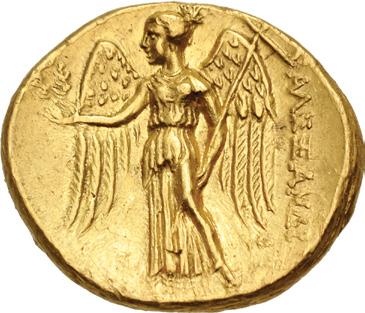
133. KINGS of MACEDON. Alexander III ‘the Great’. 336-323 BC. AV Stater (19.5mm, 8.60 g, 6h). Tyre mint. Struck under Menes. Dated RY 23 of ‘Ozmilk (327/6 BC). Head of Athena right, wearing helmet decorated with griffin / Nike standing left, holding wreath and cradling stylis; a (Phoenician A) below right wing; below left wing, )o (Phoenician ‘K [= ‘Ozmilk]) above ‹‹‹( (Phoenician date [23]). Price 3257 (Ake; same obv. die as illustration); Newell, Dated 27, obv. die K corr. (date); ANS inv. 1956.183.11 corr. (date; same obv. die). Light scratches and indications of undertype on reverse. Near EF. ($3000)
Newell, Dated 27 is referenced by Price 3270, but that is an erroneous entry based off of Newell’s assumption that the date on the coins he inspected was year 27 (he noted that the date on all of the coins he saw was off the flan). Since Newell’s die study, however, several staters using his obverse die K have appeared, including the BM coin that Price illustrates for his no. 3257, clearly showing the date to be year 23. As such, Newell, Dated 27 actually corresponds to Price 3257, which previously had no reference to Newell’s die study.
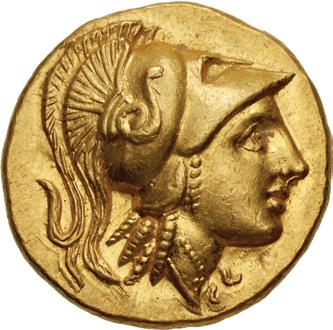
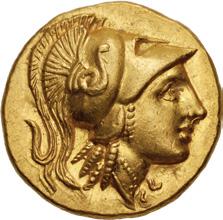
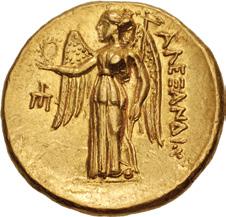
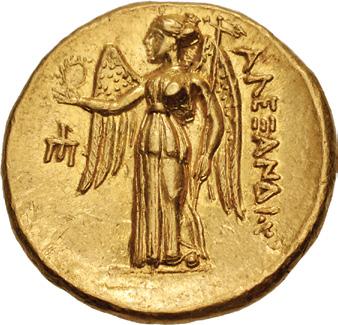
134. KINGS of MACEDON. temp. Alexander III – Philip III. Circa 325-319 BC. AV Stater (18.5mm, 8.60 g, 11h).
In the name of Alexander III. Amphipolis mint. Struck under Antipater. Helmeted head of Athena right / Nike standing left, holding wreath and stylis; in left field, trident head downward. Price 172; Troxell, Studies, p. 125, pl. 25, H. Underlying luster, trace earthen deposits, slight die wear. EF. Well centered. ($4000)
From the Wild Rose Collection, purchased from Pars Coins, March 2017.
47
Pedigreed to 1973
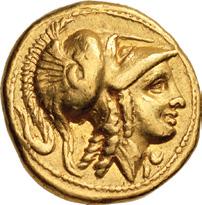

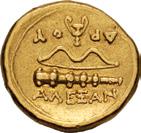
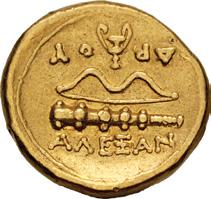
135. KINGS of MACEDON. temp. Alexander III – Philip III. Circa 325-319 BC. AV Quarter Stater (11mm, 2.13 g, 2h). In the name of Alexander III. Amphipolis mint. Struck under Antipater. Helmeted head of Athena right / Bow and club; kantharos above. Price 169b (same dies). Edge marks from prior mount. Good VF. Well centered. ($1000)
From the Wild Rose Collection, purchased from Baldwin’s, March 2016. Ex Numismatica Ars Classica 84 (20 May 2015), lot 1451; Baldwin’s FPL (Summer 2011), no. AG020; Myers 6 (6 December 1973), lot 93.
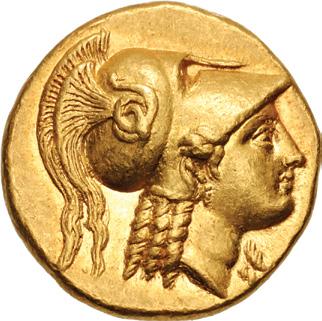
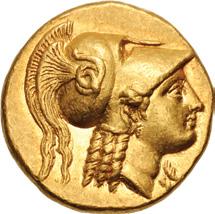
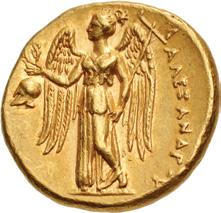
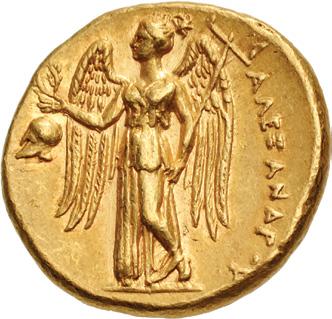
136. KINGS of MACEDON. temp. Alexander III – Kassander. Circa 325-310 BC. AV Stater (17mm, 8.60 g, 10h). In the name and types of Alexander III. Uncertain mint in Greece or Macedon. Helmeted head of Athena right / Nike standing left, holding wreath and stylis; in left field, Corinthian helmet left. Price 794. Underlying luster, a little die rust on obverse. EF. ($3000)
Ex CNG inventory 860186 (January 2010).
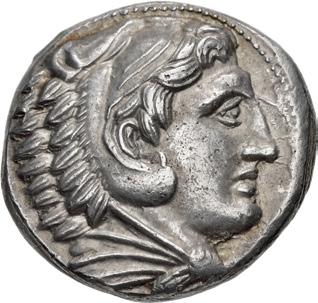
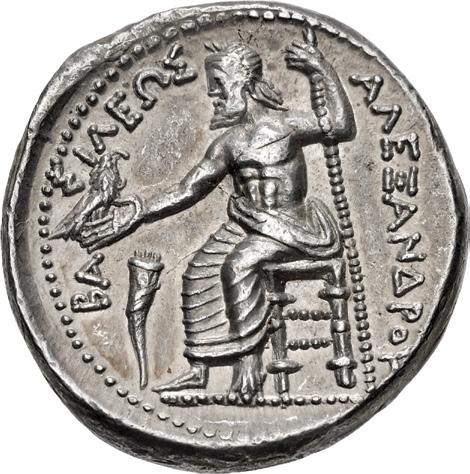
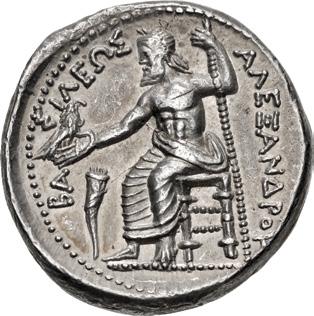
137. KINGS of MACEDON. Philip III Arrhidaios. 323-317 BC. AR Tetradrachm (26mm, 17.20 g, 3h). In the name and types of Alexander III. Amphipolis mint. Struck under Antipater, circa 322-320 BC. Head of Herakles right, wearing lion skin / Zeus Aëtophoros seated left; cornucopia in left field. Price 108; Troxell, Studies, Issue G1. Faintly toned, underlying luster. EF. ($500)
From the Wild Rose Collection, purchased from Pars Coins, May 2013.
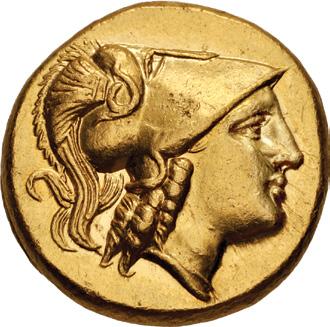
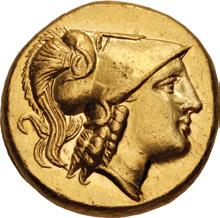
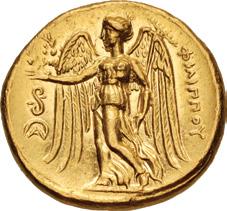
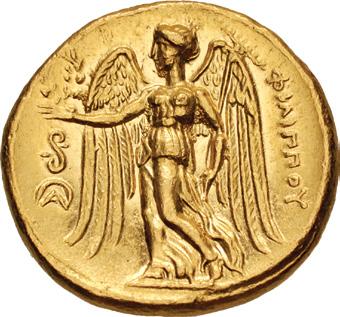
138. KINGS of MACEDON. Philip III Arrhidaios. 323-317 BC. AV Stater (18mm, 8.59 g, 3h). Lampsakos mint. Struck under Leonnatos, Arrhidaios, or Antigonos I Monophthalmos. Helmeted head of Athena right / Nike standing left, holding wreath and stylis; in left field, buckle above e. Price P16; ADM II Series IX. Underlying luster. EF. Well centered. ($3000)
From the Wild Rose Collection. Ex Classical Numismatic Group 105 (10 May 2017), lot 80.
48
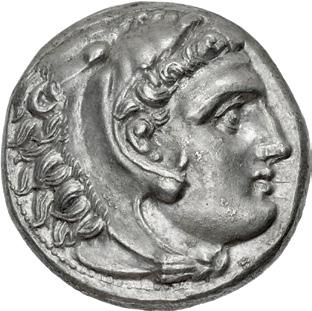
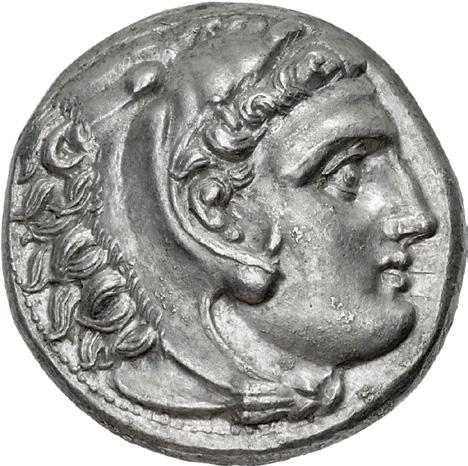
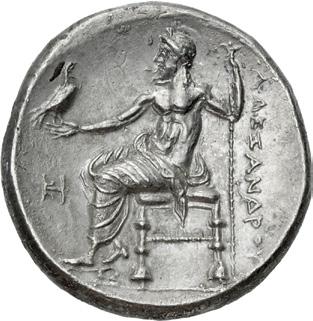
139. KINGS of MACEDON. Philip III Arrhidaios. 323-317 BC. AR Tetradrachm (25.5mm, 17.08 g, 12h). In the name of Alexander III. Miletos mint. Struck under Asandros, circa 323-319 BC. Head of Herakles right, wearing lion skin / Zeus Aëtophoros seated left; ä in left field. Price 2120; ADM I Series VII, dies 181/g. Faintly toned over lustrous surfaces, trace deposits, minor doubling on reverse. EF. Well centered. ($750)
Powerful Hellenistic Portrait of Alexander III

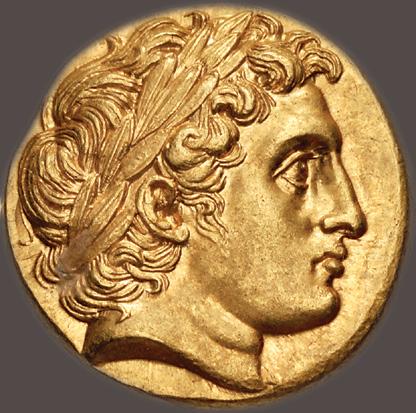

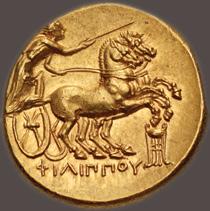

140. KINGS of MACEDON. Philip III Arrhidaios. 323-317 BC. AV Stater (17mm, 8.53 g, 12h). In the types of Philip II. Kolophon mint. Struck under Menander or Kleitos, circa 322-319 BC. Head of Apollo right, with the features of Alexander III, wearing laurel wreath / f5¬5ππoU, charioteer, holding kentron in right hand, reins in left, driving fast biga right; tripod below. Thompson, Philip 12 = Jameson 978 = Kunstfreund 232 = Gillet 785 (same obv. die); Le Rider pl. 90, 16 and pl. 93, 26; SNG ANS 309; SNG Alpha Bank 260 = Alpha Bank, Hellenic 72 = Alpha Bank, Macedonia 26 = Alpha Bank, Alexander 57 (same dies); SNG Ashmolean 2456; Kraay & Hirmer 565. A couple of tiny spots of die rust. Choice EF. Well struck. ($15,000)
From the Wild Rose Collection.
This beautiful gold stater belongs to the period following the death of Alexander the Great when his half-brother, Philip III Arrhidaios, was the nominal head of state together with the conqueror’s infant son by Roxane, Alexander IV. The gem-like delicacy of the engraving of these extraordinary dies singles this issue out as belonging to one of the mints of the Ionian coastal region of western Asia Minor, an area which, of course, was not controlled by the Macedonian monarchy in the time of Philip II. Kolophon is the city to which it is tentatively attributed, the tripod symbol linking it to an issue in the name of Philip III (cf. Price P41).
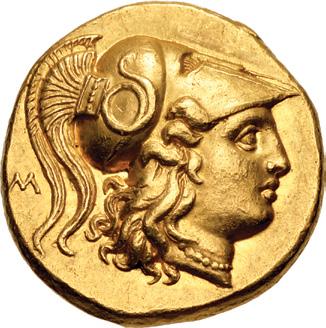
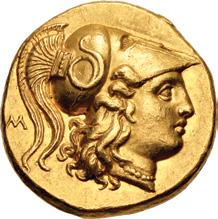
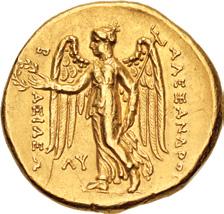
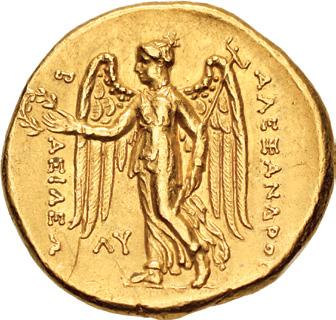
141. KINGS of MACEDON. Philip III Arrhidaios. 323-317 BC. AV Stater (17mm, 8.58 g, 6h). In the name and types of Alexander III. Babylon mint. Struck under Archon, Dokimos, or Seleukos I, circa 323-318/7 BC. Helmeted head of Athena right; Â to left / Nike standing left, holding wreath and cradling stylis; ¬U below left wing. Price 3691. A few minor scratches on reverse, a couple of marks on edge. EF. Fine style. ($3000)
From the Wild Rose Collection. Ex CNG inventory 949460 (May 2013).
49
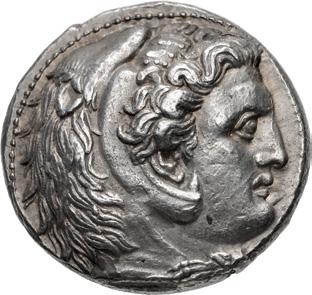


142. KINGS of MACEDON. Antigonos I Monophthalmos. As Strategos of Asia, 320-306/5 BC. AR Tetradrachm (25.5mm, 17.06 g, 5h). In the name and types of Alexander III. Susa mint. Struck under Aspesias, Satrap of Susiana, circa 316-311 BC. Head of Herakles right, wearing lion skin / Zeus Aëtophoros seated left; wreath in left field; below throne, Å5 above strut, Z below. Price 3857. Toned, a few minor marks, small flan flaw on obverse. Near EF. High relief. ($750)
From the Wild Rose Collection, purchased from Calgary Coin Gallery, September 2013. Ex Stack’s Bowers and Ponterio 177 (14 August 2013), lot 11037; Goldberg 70 (2 September 2012), lot 3055; Helios 2 (25 November 2008), lot 95.
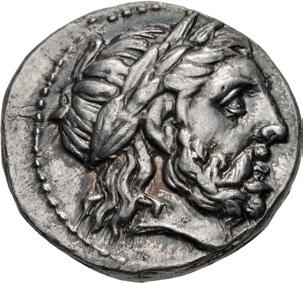
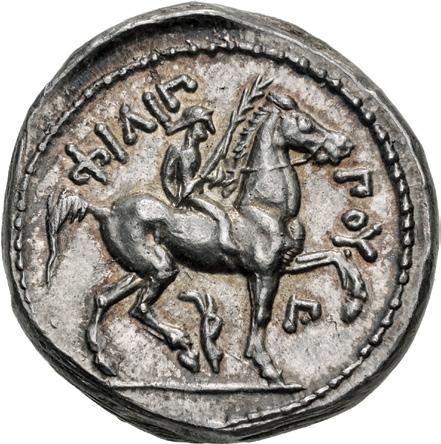
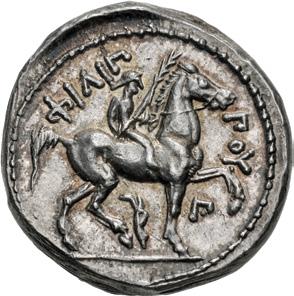
143. KINGS of MACEDON. Kassander. As regent, 317-305 BC. AR Tetradrachm (25mm, 14.39 g, 10h). In the name and types of Philip II. Amphipolis mint. Struck circa 316-311 BC. Laureate head of Zeus left / Nude youth, holding palm frond and rein, on horseback right; aphlaston below, À below raised foreleg. Le Rider pl. 46, 17–8; Troxell, Studies, Group 9, 323-5. Light iridescent tone over lustrous surfaces, struck from slightly worn dies. EF ($1000)
From the DFA Collection. Ex Numismatik Naumann 121 (2 October 2022), lot 158; Leu Numismatic Web Auction 18 (18 December 2021), lot 320.
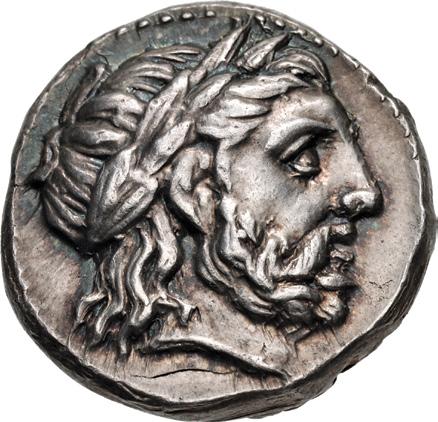
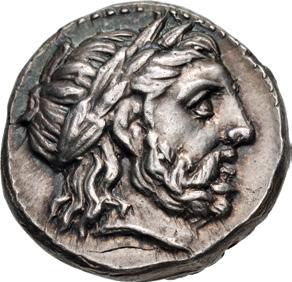


144. KINGS of MACEDON. Kassander. As regent, 317-305 BC. AR Tetradrachm (23.5mm, 14.10 g, 6h). In the name and types of Philip II. Amphipolis mint. Struck circa 316-311 BC. Laureate head of Zeus left / Nude youth, holding palm frond and rein, on horseback right; aphlaston below, À below raised foreleg. Le Rider pl. 46, 17–8; Troxell, Studies, Group 9, 323-5. Dark iridescent toning, struck from slightly worn dies. Near EF. ($750)
From the Wild Rose Collection. Ex Gorny & Mosch 276 (19 April 2021), lot 97; San Vicente Collection (Classical Numismatic Group 114, 13 May 2020), lot 138, purchased from Dr. Arnold Saslow, August 1995; Superior (30 May 1990), lot 6780.
50

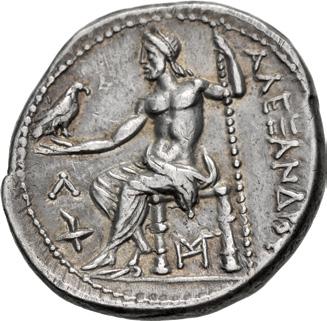
145. KINGS of MACEDON. Kassander. As regent, 317-305 BC, or King, 305-297 BC. AR Tetradrachm (29mm, 17.08 g, 8h). In the name and types of Alexander III. Amphipolis mint. Struck circa 307-297 BC. Head of Herakles right, wearing lion skin / Zeus Aëtophoros seated left; in left field, ¬ above torch; * below throne. Price 447; Ehrhardt 35. Iridescent tone, light scratches and marks. Good VF. ($500)
From the Wild Rose Collection. Ex Gorny & Mosch 276 (19 April 2021), lot 94.
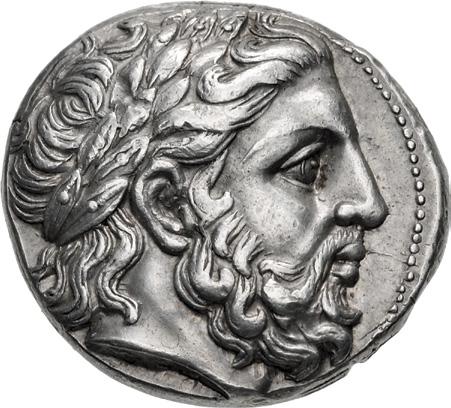
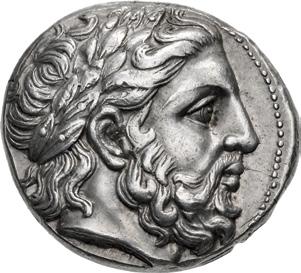
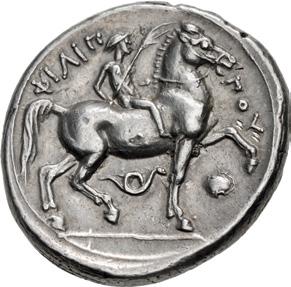
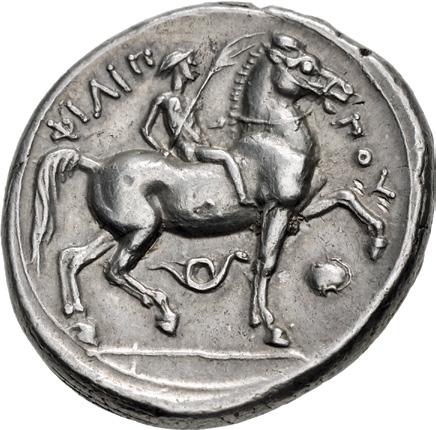
146. KINGS of MACEDON. Kassander. As regent, 317-305 BC. AR Tetradrachm (25mm, 14.36 g, 7h). In the name and types of Philip II. Pella mint. Struck circa 317/6-315/4 BC. Laureate head of Zeus right / Nude youth, holding palm frond, on horseback right; serpent below, Boeotian shield below horse’s raised foreleg. Le Rider Group III, 524 (D279/R432); SNG ANS 450. Lightly toned, shallow test cut on edge, minor die break on obverse. Good VF. Well centered. Fine style head of Zeus. ($1000)
From the Wild Rose Collection. Ex Berk BBS 201 (13 July 2017), lot 52; Gorny & Mosch 244 (13 October 2014), lot 151.
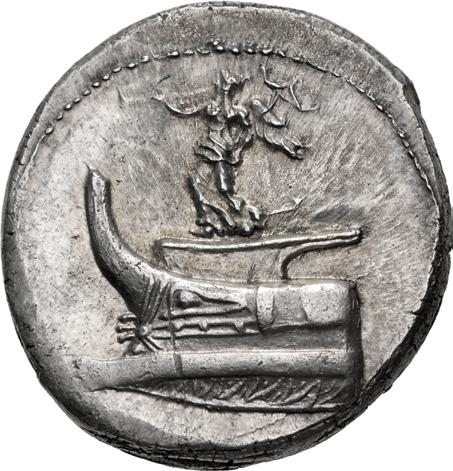


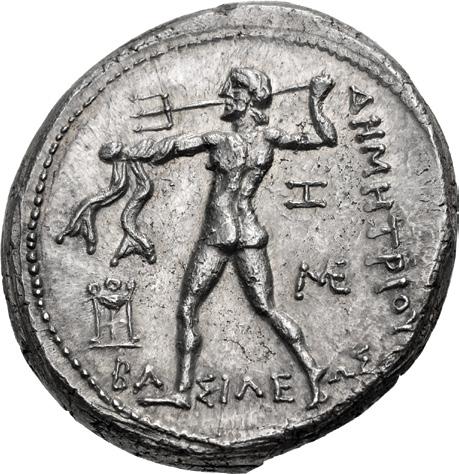
147. KINGS of MACEDON. Demetrios I Poliorketes. 306-283 BC. AR Tetradrachm (24.5mm, 17.17 g, 5h). Amphipolis mint. Struck circa 294-293 BC. Nike standing left on prow of galley left, blowing trumpet and cradling stylis / Poseidon Pelagaios, nude, standing left, seen from behind, preparing to throw trident, chlamys draped over arm; tripod to left; to right, z above m. Newell 94 (dies LXXXV/– [obv. die unlisted for issue, rev. die not known]); HGC 3, 1012f; Triton XIX, lot 102 (same dies); Triton XVII, lot 164 (same dies); CNG 106, lot 220 (same dies). Lustrous, minor die break on obverse (diagnostic for this die). EF. ($3000)
From the Wild Rose Collection, purchased from Calgary Coin Gallery, 12 July 2014. Ex CNG “Very Special Offer” in The Celator Vol. 9, No. 10 (October 1995), p. 23 (this coin illustrated).
51
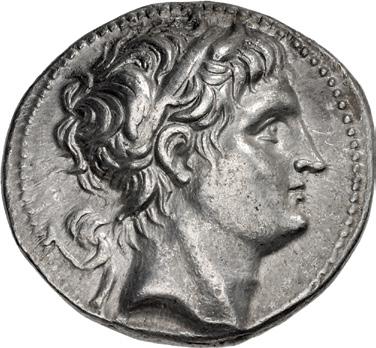
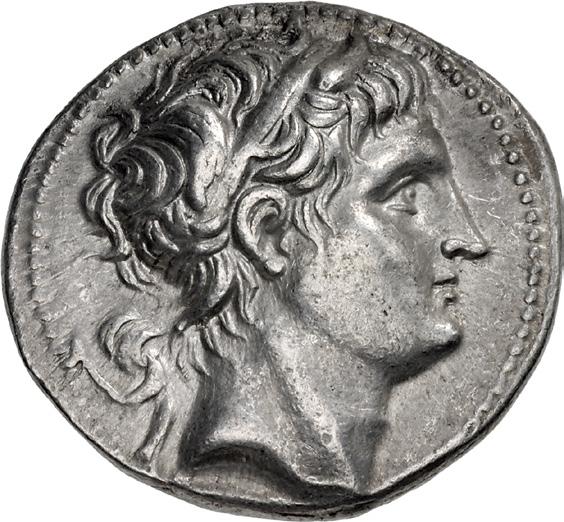

148. KINGS of MACEDON. Demetrios I Poliorketes. 306-283 BC. AR Tetradrachm (31mm, 17.04 g, 1h). Amphipolis mint. Struck circa 290-289 BC. Diademed and horned head right / Poseidon Pelagaios, nude, standing left, foot propped on rock, holding trident; : to inner left, : to inner right. Newell 116 (obv. die CXI); HGC 3, 1014b. EF. ($2000)
From the Wild Rose Collection. Ex Triton XVII (7 January 2014), lot 168.
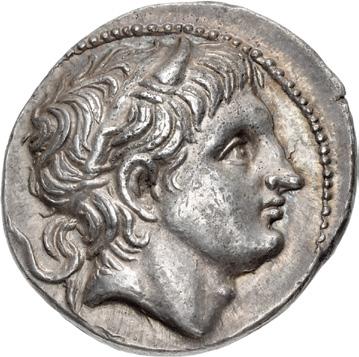
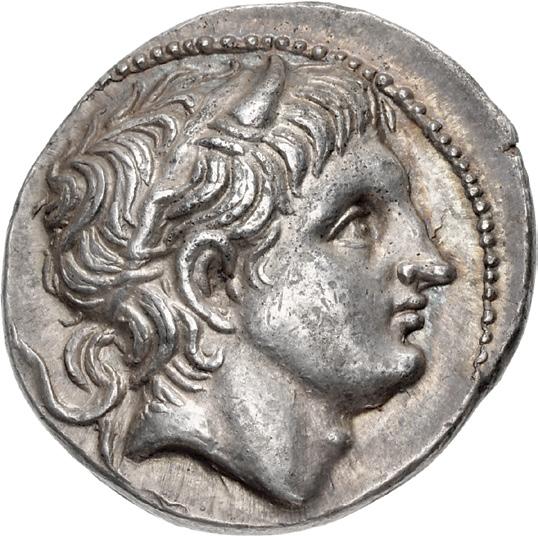
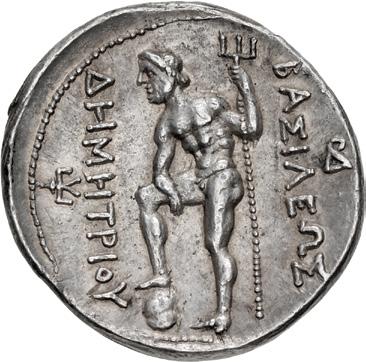
149. KINGS of MACEDON. Demetrios I Poliorketes. 306-283 BC. AR Tetradrachm (30mm, 17.42 g, 12h). Amphipolis mint. Struck circa 289-288 BC. Diademed and horned head right / Poseidon Pelagaios standing left, right foot on rock, holding trident; : to outer left, : to outer right. Newell 124, obv. die CXXII; HGC 3, 1014b; Hirsch 1113 (same obv. die). Deep iridescent tone, minor porosity on obverse. Near EF. ($2000)
Ex CNG inventory 991047 (December 2014); Heritage 3016 (2 January 2012), lot 24432.
Newell Plate Coin – Pedigreed to 1912

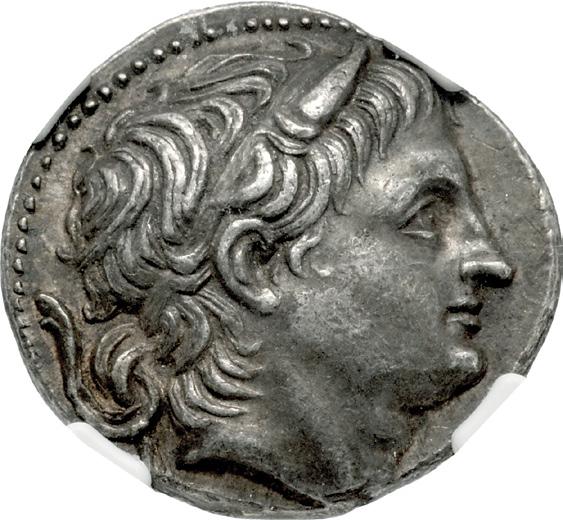

150. KINGS of MACEDON. Demetrios I Poliorketes. 306-283 BC. AR Tetradrachm (29mm, 17.08 g, 4h). Amphipolis mint. Struck circa 289-288 BC. Diademed and horned head right / Poseidon Pelagaios standing left, right foot on rock, holding trident; : to outer left, : to outer right. Newell 124, dies CXXIX/271 (this coin referenced and illustrated); HGC 3, 1014b. In NGC encapsulation 2108628-005, graded AU★, Strike: 5/5, Surface: 4/5, Fine Style. ($2000)
Ex Naville V (18 June 1923), lot 1463; R. Ratto (13 May 1912), lot 648.
52
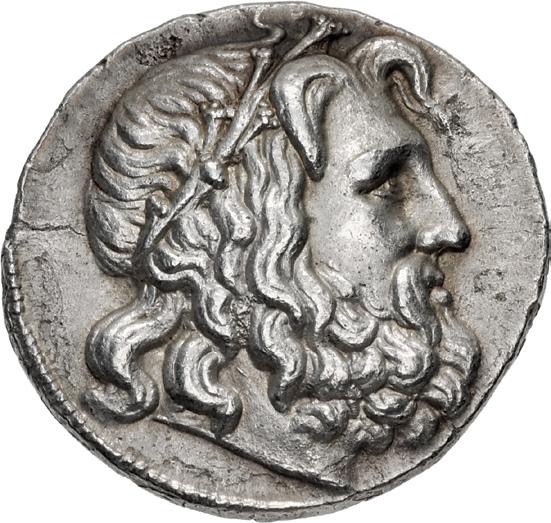
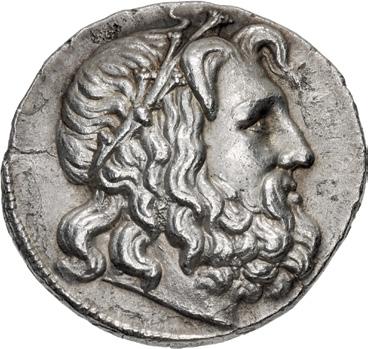

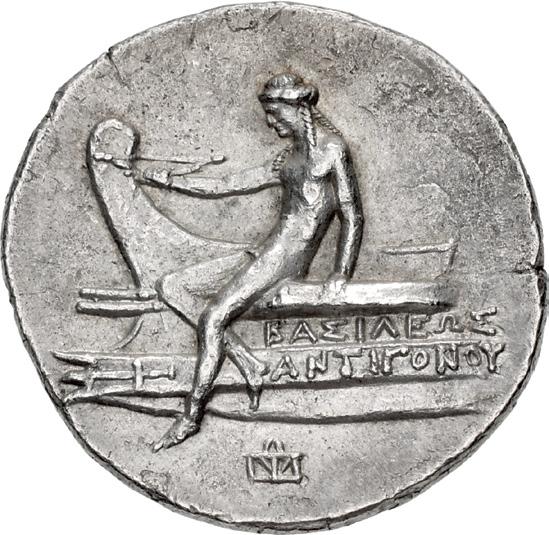
151. KINGS of MACEDON. temp. Antigonos II Gonatas – Demetrios II Aitolikos. 246/5-229 BC. AR Tetradrachm (30.5mm, 16.92 g, 12h). Amphipolis mint. Wreathed head of Poseidon right / Apollo, testing bow, seated left on prow; f below. TEA Period III, Group 45, 226 (O34/R216); SNG Alpha Bank 1046 (same dies); Weber 2191 (same dies). Short hairline flan crack. EF. Well centered. ($2000)
From the Wild Rose Collection, purchased from Numsimatica Ars Classica, January 2020. Ex California Collection (Heritage 3037, 4 January 2015), lot 30909; Kim Werner Collection (Heritage 3020, 6 September 2012), lot 24919, purchased from Tom McKenna, 25 October 1988.
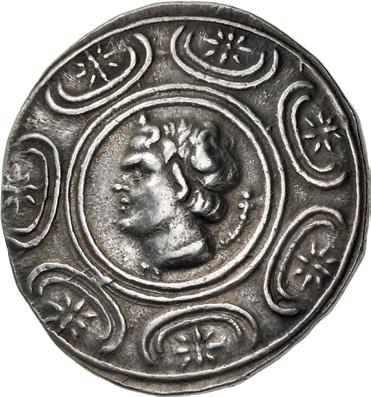

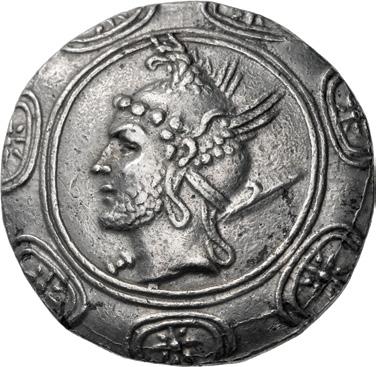
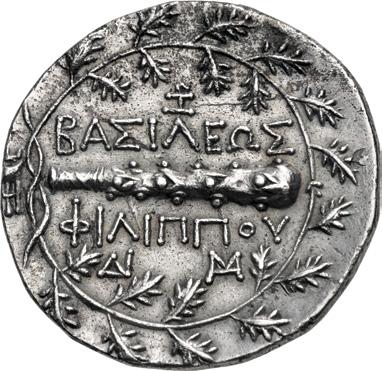
152. KINGS of MACEDON. Antigonos III Doson. 229-221 BC. AR Tetradrachm (31mm, 17.08 g, 11h). Amphipolis mint. Horned head of Pan left, lagobolon behind, in the center of a Macedonian shield / Athena Alkidemos advancing left, shield decorated with aegis on arm, preparing to cast thunderbolt; winged helmet to inner left, t5 to inner right. TEA Period IV, Group 2, 16 corr. (O1/R15; obv. die O1, not O4). Lightly toned, minor die wear. Good VF. Very rare issue with TI and winged helmet. ($750)
From the Wild Rose Collection. Ex Davissons 17 (26 June 2002), lot 121; Giessener Münzhandlung 67 (2 May 1994), lot 124.
153. KINGS of MACEDON. Philip V. 221-179 BC. AR Tetradrachm (31.5mm, 16.42 g, 12h). Attic standard. Pella or Amphipolis mint; Zoilos, mintmaster. Struck circa 184-179 BC. Head of the hero Perseus left, wearing winged helmet surmounted by griffin’s head; harpa in background; all in the center of a Macedonian shield / Club; g (mintmaster’s monogram), 6 to lower left, 8 to lower right; all within oak wreath tying to left; tripod to outer left. Mamroth, Philip 16; HGC 3, 1058. Toned, traces of find patina, light porosity. Good VF. ($1000)
Exceptional Portrait

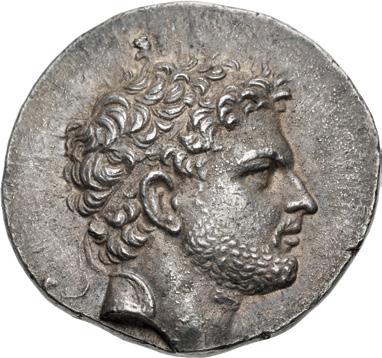
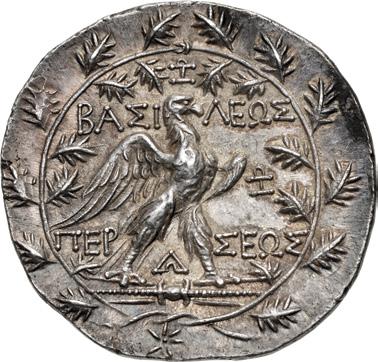
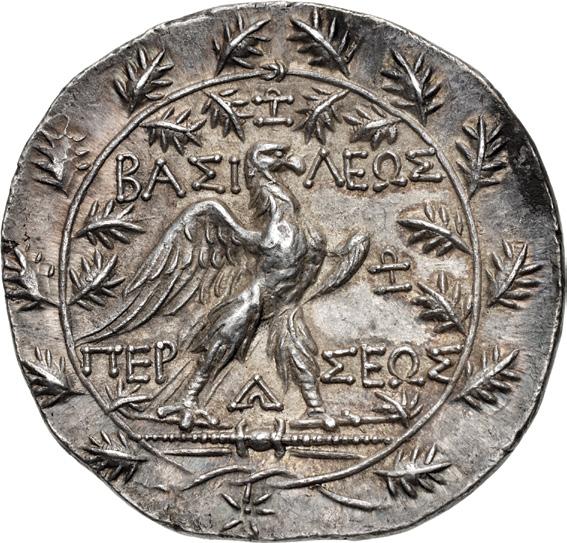
154. KINGS of MACEDON. Perseus. 179-168 BC. AR Tetradrachm (31mm, 16.63 g, 11h). Attic standard. Amphipolis mint. Struck circa 174-170 BC. Diademed head right / Eagle, wings spread, standing right on thunderbolt; g above, g to right, h between legs; all within oak wreath; star below. De Luca, Tetradrachms, Group I, 22 (O11/R21 – this coin, illustrated); Mamroth, Perseus 14; HGC 3, 1091. Iridescent tone, underlying luster, a hint of die wear on obverse, spot of find patina on reverse. EF. Well centered and struck. ($2000)
From the Wild Rose Collection. Ex Gorny & Mosch 244 (13 October 2014), lot 203.
53
152 153
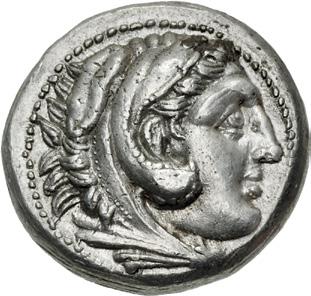


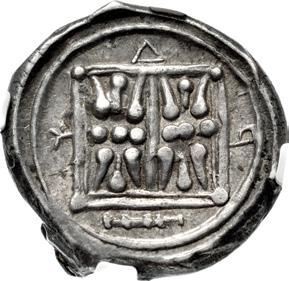
155. KINGS of PAEONIA. Audoleon. Circa 315-286 BC. AR Tetradrachm (25.5mm, 17.18 g, 12h). In the name and types of Alexander III. Astibos or Damastion mint. Struck circa 298-287/6 BC. Head of Herakles right, wearing lion skin / Zeus Aëtophoros seated left; star in left field. Price 644; Waggoner, Reflections, Issue II, dies 10/b; HGC 3, 157; BN Fonds général 589 (same dies). Trace deposits, minor marks, tiny flan flaws on obverse. EF. ($750)
Ex Harlan J. Berk inventory cc50840 (ND).
156. ILLYRIA, Dyrrhachion. Circa 375-280 BC. AR Stater (21.5mm, 11.10 g, 10h). Cow standing right, looking back at suckling calf standing left below / Vertical double stellate pattern, divided by line, in double linear square border; club below. Meta Series II, Group I, dies D12/R17; HGC 3, 34. In NGC encapsulation 6955967-001, graded XF, Strike: 4/5, Surface: 5/5, die shift. ($750)
Ex Paul H. Gerrie Collection (Triton XII, 6 January 2009), lot 213.
Pedigreed to 1963
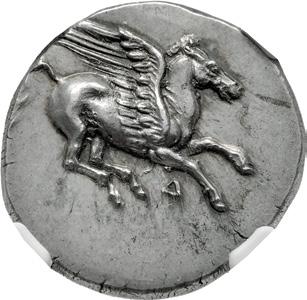
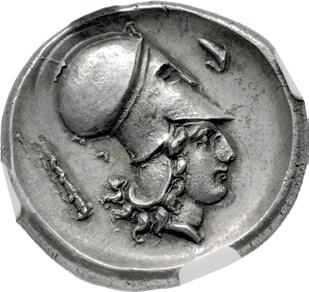
157. ILLYRIA, Dyrrhachion. Circa 350 BC. AR Stater (22.5mm, 8.57 g, 2h). Pegasos flying right / Helmeted head of Athena right; dolphin above, club and s to left. Meta Series I, dies D38/R67; Pegasi 15; HGC 3, 26. In NGC encapsulation 6827184-003, graded Ch AU★, Strike: 4/5, Surface: 4/5, die shift. ($1500)
Ex Regierungsrat Dr. iur. Hans Krähenbühl Collection (Leu Numismatik AG 8, 23 October 2021), lot 57; Münzen und Medaillen AG FPL 230 (March 1963), no. 6.
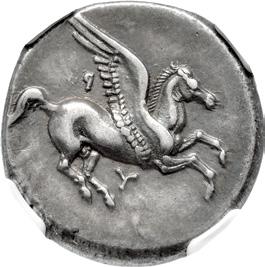
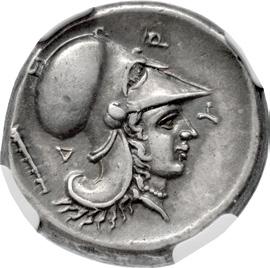
158. ILLYRIA, Dyrrhachion. Circa 350 BC. AR Stater (20mm, 8.61 g, 6h). Pegasos flying right / Helmeted head of Athena right; club to left. Meta Series I, dies D41/R71 (this coin referenced); Pegasi 33; HGC 3, 26. In NGC encapsulation 6827184-002, graded Ch XF★, Strike: 5/5, Surface: 5/5. ($1000)
Ex Künker 382 (16 March 2023), lot 74; Auctiones AG 13 (23 June 1983), lot 187.
Franke Plate Coin – Pedigreed to 1927
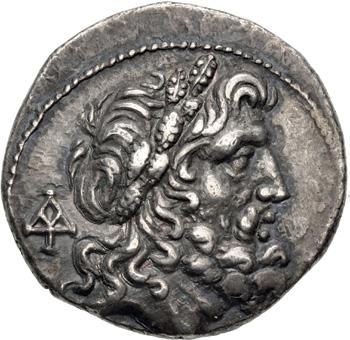
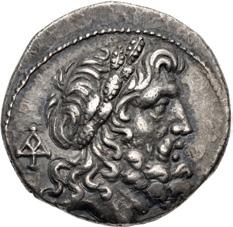

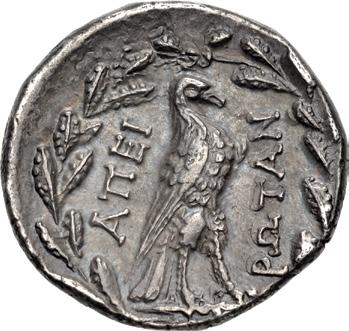
159. EPEIROS, Federal coinage (Epirote Republic). Circa 234/3-168 BC. AR Drachm (19mm, 4.65 g, 1h). Laureate head of Zeus right; Ó to left / Eagle standing right on thunderbolt; all within wreath. Franke Group II, Series 29, 163.1 (V91/ R114 – this coin, illustrated); HGC 3, 171. Deep iridescent tone, minor double strike on reverse. Good VF. ($750)
From the Wild Rose Collection, purchased from Edward J. Waddell (inv. 56681), 12 July 2023. Ex Peus 433 (1 November 2022), lot 1157; Nomos 11 (9 October 2015), lot 85; R. Ratto (4 April 1927), lot 1110. 155
54
156


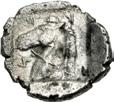

160. THESSALY, Krannon. Circa 462/1-460 BC. AR Hemiobol (9.5mm, 0.38 g, 11h). Hoof of bull; trident horizontally left in background / Head and neck of bridled horse left within incuse square. Liampi, Corpus, Group II.I.H, – (unlisted dies); BCD Thessaly II 114.3; HGC 4, 379. Minor deposits, slight roughness. Good VF. Good metal for issue. Exceptional. ($500)
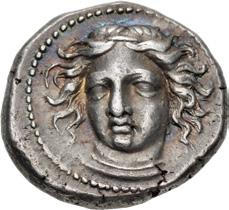
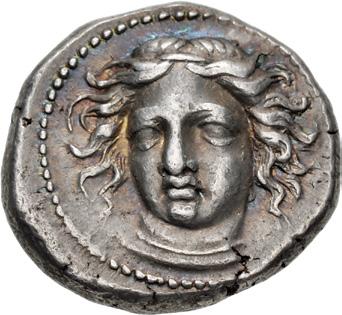
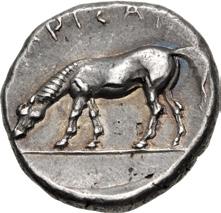
161. THESSALY, Larissa. Circa 400-370 BC. AR Drachm (18.5mm, 6.06 g, 3h). Head of the nymph Larissa facing slightly left / Horse grazing left. L-S Group 1, Head Type 1, dies O5/R4, a = Lorber, Early 28.4(a) (this coin, illustrated in Lorber); BCD Thessaly II 217 (same obv. die); HGC 4, 432. Iridescent tone, a few minor flan flaws. Near EF. ($750)
From the Wild Rose Collection. Ex Berk BBS 104 (16 September 1998), lot 141; Numismatic Fine Arts inventory 4995 (ND); Unknown Findspot, 1989 Hoard (CH IX, 65).

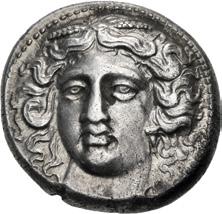

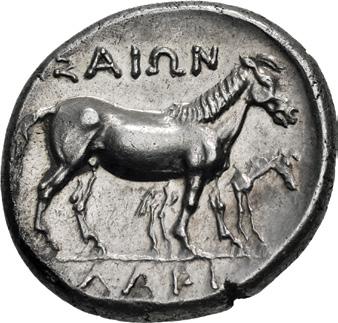
162. THESSALY, Larissa. Circa 380-365 BC. AR Drachm (18mm, 6.06 g, 12h). Head of the nymph Larissa facing slightly left / Mare and foal standing right. L-S Series VI, Type A, dies O4/R1, g (this coin); Lorber, Hoard 8 (same dies); BCD Thessaly II 297; HGC 4, 444; SNG Berry 544 (same dies); McClean 4625 (same dies). Minor patches of find patina. Near EF. Better than most of the examples of middle facing head types on CoinArchives. ($1000) Ex CNG inventory 760505 (October 2005).
Fine Style

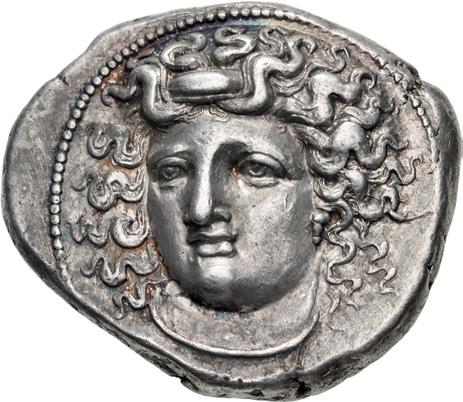
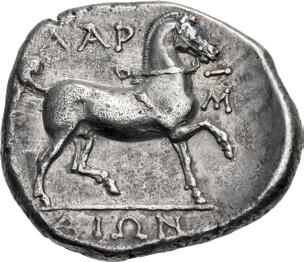
163. THESSALY, Larissa. Circa 356-342 BC. AR Stater (25mm, 12.12 g, 11h). Head of the nymph Larissa facing slightly left, hair in ampyx / Bridled horse prancing right. L-S Type 2, Series A, dies O2/R1; BCD Thessaly II 307 (same rev. die); Lorber, Hoard 67–8 (same obv. die); HGC 4, 409; Boston MFA 894 (same rev. die). Toned, slight die wear, some horn silver and scratches in fields on reverse. EF. Fine style and well struck. ($3000)
From the Wild Rose Collection. Ex San Vicente Collection (Triton XXIII, 14 January 2020), lot 238; Numismatic Fine Arts XXVI (14 August 1991), lot 69.
55



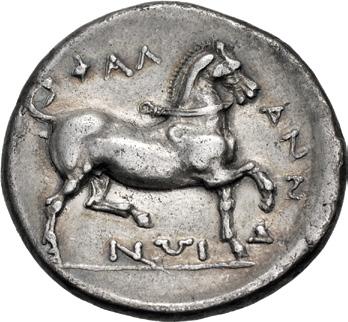
164. THESSALY, Phalanna. Mid 4th century BC. AR Drachm (19mm, 5.52 g, 9h). Bare head of Ares right / Horse prancing right. Papaevangelou-Genakos 1; BCD Thessaly I 1250 (same rev. die); HGC 4, 165. Lightly toned. Good VF. ($750)
From the Mesogeios Collection. Ex Ancient Miniature Art Collection (Classical Numismatic Group Electronic Auction 468, 20 May 2020), lot 47; Gorny & Mosch 224 (13 October 2014), lot 171; Giessener Münzhandlung 55 (14 May 1991), lot 203; Giessener Münzhandlung 50 (24 September 1990), lot 280.



165. THESSALY, Pharsalos. Late 5th-mid 4th century BC. AR Drachm (19.5mm, 6.00 g, 5h). Dies signed by Telephantos. Helmeted head of Athena right; small t˙/5π between crest and neck guard / Warrior, wearing petasos, holding lagobolon over his shoulder, on horseback right; small t˙ in exergue; all within incuse square. Lavva 79 corr. (V41/R47; letters on obv.); BCD Thessaly I 1284; HGC 4, 624. Iridescent tone, light scratches on obverse. Good VF. ($750)
From the Mesogeios Collection. Ex Künker 333 (16 March 2020), lot 750; Roma V (23 March 2013), lot 181.
Ex BCD Collection – Coin Hoard Plate Coin
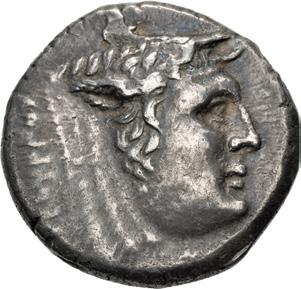
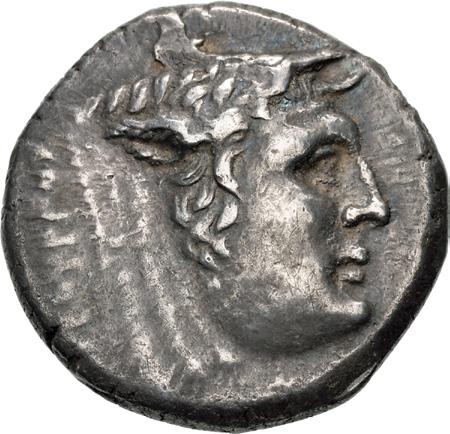

166. AKARNANIA, Federal Coinage (Akarnanian Confederacy). Circa 250-200 BC. AR Stater (25mm, 9.76 g, 4h). Leukas mint; Lykourgas, magistrate. Head of river god Achelöos right; [¬U]˚oUr˝os upward to left / Apollo Aktios, nude, holding bow, seated left; } to left. Imhoof-Blumer, Akarnaniens 23; BCD Akarnania 20.5 = CH IV, fig. 6, 3 (this coin); HGC 4, 721. Old collection tone, typical die wear for issue. Good VF. ($1000)
From the Wild Rose Collection, purchased from Jacquier Numismatique, October 2014. Ex BCD Collection (Münzen & Medaillen GmbH 23, 18 October 2007), lot 20.5; Acarnania, 1977 Hoard (CH IV, 43).
Ex Molard and Kern Collections – Pedigreed to 1968
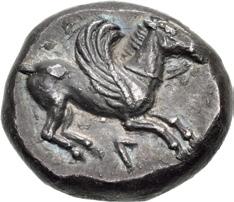
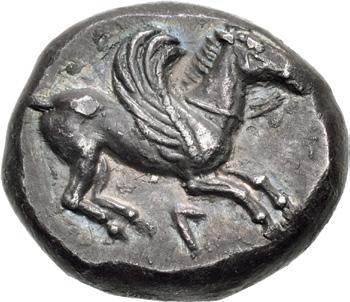
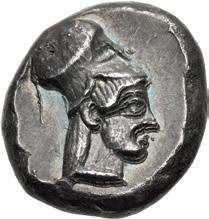
167. AKARNANIA, Leukas. Circa 470-450 BC. AR Stater (18.5mm, 8.10 g, 8h). Pegasos flying right / Helmeted head of Athena right within incuse square. Pegasi 13/2 and 4 (same dies); BCD Akarnania –; HGC 4, 812; SNG Delepierre 1228 (same obv. die); C.M. Kraay, “A Hoard of Corinth and Leucas from N.W. Greece” in CH V, 28–9 (same dies). Dark cabinet tone. EF. Well struck for issue. ($2000)
From the Wild Rose Collection. Ex Molard Collection (Nomos 15, 22 October 2017), lot 97; Jonathan K. Kern Collection (Triton XVIII, 6 January 2015), lot 502; Coin Galleries Numismatic Review IX/4 (1968), no. D53.
56
Illustrated by Tsangari
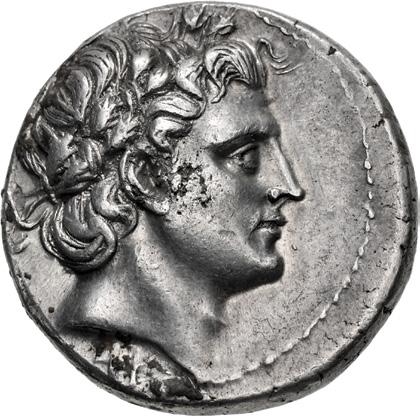
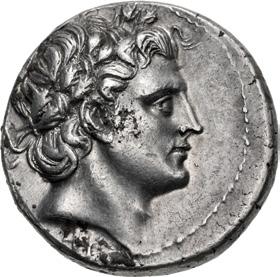
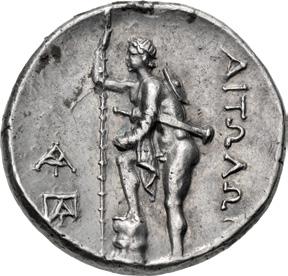

168. AITOLIA, Aitolian League. Circa 220-205 BC. AR Stater (23mm, 10.38 g, 5h). Korkyrean standard. Laureate head of Apollo right; small f5 below / Aitolos standing left, kausia hung around neck and sword slung at waist, holding spear, right foot set on rock, leaning on raised right knee; to left, ˚ above ~. Tsangari Series IV, Emission 36c, 668a (D17/R37 – this coin, illustrated); BCD Akarnania 441 (same obv. die); HGC 4, 942. Lightly toned, minor deposits, some tiny flan flaws on obverse, slight die shift on reverse. Near EF. ($1500)
From the Mesogeios Collection. Ex Giessener Münzhandlung 60 (5 October 1992), lot 146.
Ex BCD Collection – H&D Plate Coin
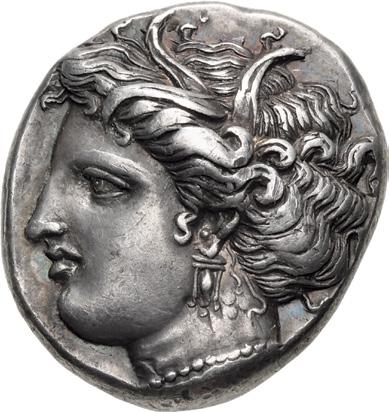

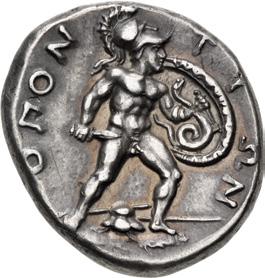
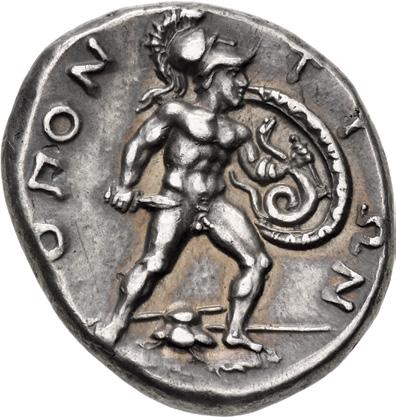
169. LOKRIS, Lokri Opuntii. Circa 370-360 BC. AR Stater (21mm, 12.24 g, 12h). Head of Persephone left, wearing wreath of grain ears, triple-pendant earring, and pearl necklace / Ajax, nude but for crested Corinthian helmet, holding sword in right hand, shield decorated with coiled serpent on left arm, advancing right on rocks; ivy leaf and broken spear below, oπo@-t5W@ around. H&D Group 2, 9a (O1/R3) = BCD Lokris 13 (this coin); HGC 4, 989. Attractive iridescent tone over, underlying luster, some light scratches and scuffs on obverse. Good VF. Rare. ($5000)
From the Wild Rose Collection, purchased from Numismatica Ars Classica, January 2019. Ex BCD Collection (Numismatica Ars Classica 55, 8 October 2010), lot 13 (hammer CHF 10,000).
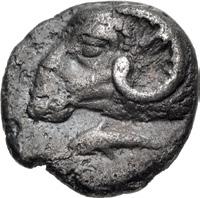

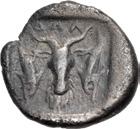

170. PHOKIS, Delphi. Early 5th century BC. AR Trihemiobol (11mm, 1.11 g, 7h). Head of ram left; below, dolphin left / Head of goat facing; dolphin downwards to either side; all within incuse square. Svoronos, Delphi 25; BCD Lokris 383–4; HGC 4, 1126. Toned, some roughness. VF. ($750)
From the Mesogeios Collection. Ex Jim Gilman Collection (Classical Numismatic Group 120, 11 May 2022), lot 216, purchased from Tom Cederlind, September 2014.


171. ATTICA, Athens. Circa 510-500/490 BC. AR Tetradrachm (22mm, 17.43 g, 9h). Helmeted head of Athena right / Owl standing right, head facing; olive spray to left; all within incuse square. Seltman Group L, unlisted dies; Asyut Group IVa; HGC 4, 1589. Faintly toned, struck with worn dies. VF. ($2000)
From the Apollo to Apollo Collection. Ex Numismatik Naumann 70 (7 October 2018), lot 85.
57


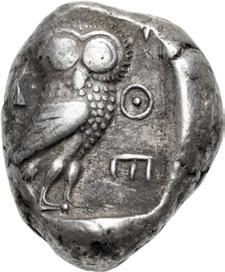
172. ATTICA, Athens. Circa 500/490-485/0 BC. AR Tetradrachm (19mm, 16.84 g, 5h). Helmeted head of Athena right, with frontal eye / Owl standing right, head facing; olive spray to left; all within incuse square. Seltman Group M or G (unlisted dies); Asyut Group IVg, 364 (this coin) HGC 4, 1590. Toned, compact irregular flan. VF. ($1000)
From the Hesiod Collection. Ex Morton & Eden 119 (6 December 2022), lot 36; European Ambassador Collection; 1968/9 Asyut Hoard (IGCH 1644 = CH 2, 17 = CH 4, 11 = CH 8, 44 = CH 9, 680).

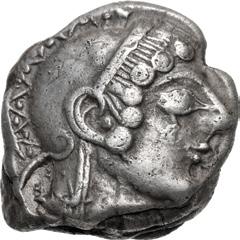
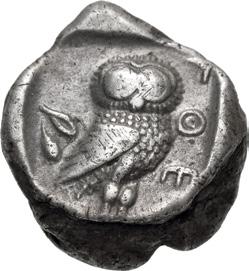
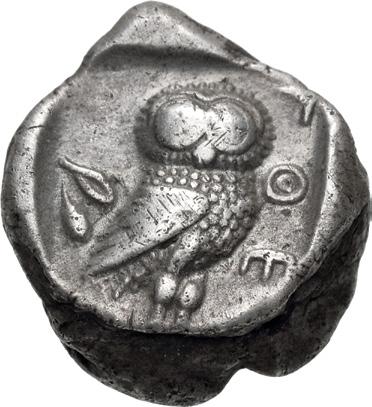
173. ATTICA, Athens. Circa 500/490-485/0 BC. AR Tetradrachm (19.5mm, 17.07 g, 5h). Helmeted head of Athena right, with frontal eye / Owl standing right, head facing; olive spray to left; all within incuse square. Seltman Group Gi (unlisted dies); HGC 4, 1590. Old collection tone, minor marks. VF. Well centered. ($2000)
From the Wild Rose Collection. Ex Roma E-Sale 25 (27 February 2016), lot 50.
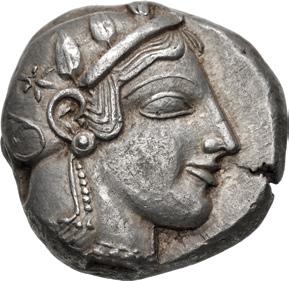
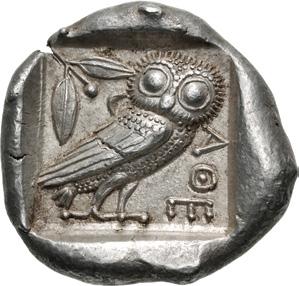

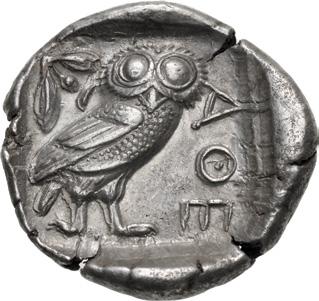
174. ATTICA, Athens. Circa 475-465 BC. AR Tetradrachm (23.5mm, 17.14 g, 10h). Helmeted head of Athena right, with frontal eye / Owl standing right, head facing, with spread tail feathers; olive sprig and crescent to left; all within incuse square. Starr Group IV, unlisted dies; HGC 4, 1595. Lightly toned, edge split, a few minor scratches. EF. ($1000)
From the Wild Rose Collection. Ex Roma XVIII (29 September 2019), lot 557 (hammer £2200).
175. ATTICA, Athens. Circa 454-404 BC. AR Tetradrachm (25mm, 17.08 g, 7h). Helmeted head of Athena right, with frontal eye / Owl standing right, head facing, with closed tail feathers; olive spray and crescent to left; all within incuse square. Kroll 8; HGC 4, 1597. Toned, underlying luster, a couple minor edge splits. EF. Well centered on a broad flan, with most of crest visible. ($1000)
From the Wild Rose Collection. Ex Dr. Patrick H. C. Tan (Triton XX, 10 January 2017), lot 155.
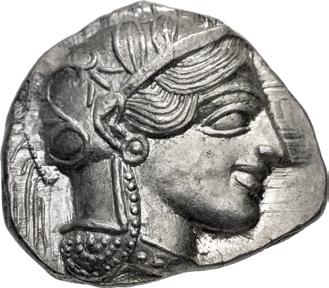
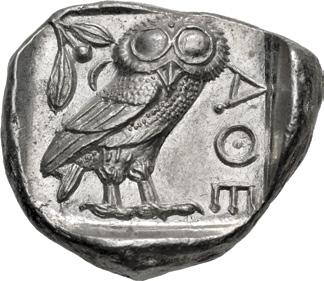

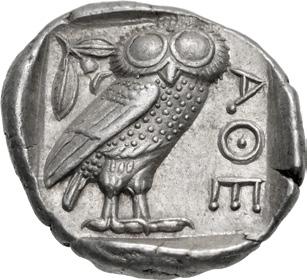
176. ATTICA, Athens. Circa 454-404 BC. AR Tetradrachm (26.5mm, 17.18 g, 7h). Helmeted head of Athena right, with frontal eye / Owl standing right, head facing, with closed tail feathers; olive spray and crescent to left; all within incuse square. Kroll 8; HGC 4, 1597. Lustrous. EF. ($1000)
177. ATTICA, Athens. Circa 454-404 BC. AR Tetradrachm (25mm, 17.17 g, 9h). Helmeted head of Athena right, with frontal eye / Owl standing right, head facing, with closed tail feathers; olive spray and crescent to left; all within incuse square. Kroll 8; HGC 4, 1597. Underlying luster. EF. High relief and well centered. ($1000)
58
Asyut Hoard
Ex
175 176 177
174
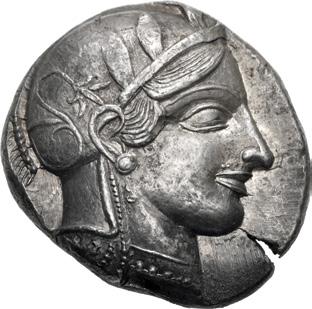
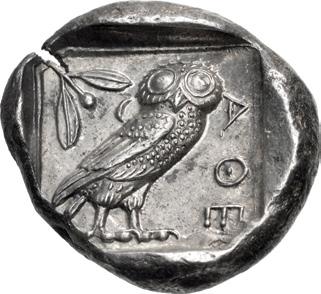

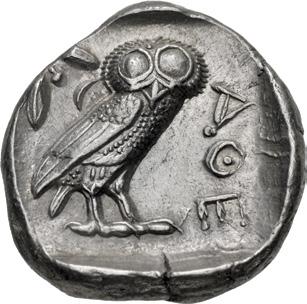
178. ATTICA, Athens. Circa 454-404 BC. AR Tetradrachm (25.5mm, 17.19 g, 9h). Helmeted head of Athena right, with frontal eye / Owl standing right, head facing, with closed tail feathers; olive spray and crescent to left; all within incuse square. Kroll 8; HGC 4, 1597. Toned, underlying luster, edge split. EF. ($1000)
From the Wild Rose Collection. Ex Roma XII (29 September 2016), lot 159 (hammer £2400).
179. ATTICA, Athens. Circa 454-404 BC. AR Tetradrachm (25.5mm, 17.18 g, 4h). Helmeted head of Athena right, with frontal eye / Owl standing right, head facing, with closed tail feathers; olive spray and crescent to left; all within incuse square. Kroll 8; HGC 4, 1597. Underlying luster, minor double strike on obverse. EF. High relief. ($1000)
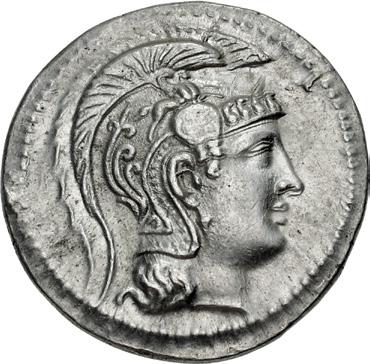
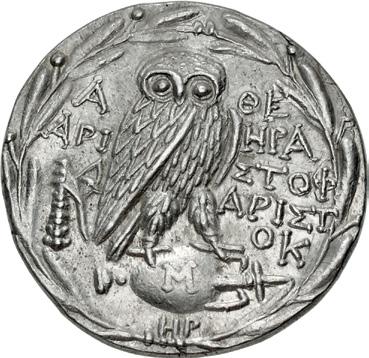


180. ATTICA, Athens. Circa 165-42 BC. AR Tetradrachm (30.5mm, 16.80 g, 12h). New Style coinage. Hera–, Aristoph–, and Aristok–, magistrates. Struck 136/5 BC. Helmeted head of Athena Parthenos right / Owl standing right, head facing, on amphora; magistrates’ names in fields; club draped with lion’s skin to left, Â on amphora, ˙r below; all within wreath. Thompson 339i–j (same obv. die); HGC 4, 1602. Minor die wear, light doubling on reverse. Near EF. ($750)
181. ATTICA, Athens. Circa 165-42 BC. AR Tetradrachm (31mm, 16.82 g, 12h). New Style coinage. Mened–, Epigeno–, and Thoph–, magistrates. Struck 135/4 BC. Helmeted head of Athena Parthenos right / Owl standing right, head facing, on amphora; magistrates’ names in fields; to left, Asklepios standing left, holding serpent-entwined scepter; Å on amphora, ˝¬ below; all within wreath. Thompson 347a–c (same obv. die); HGC 4, 1602. Underlying luster. EF. Well centered. ($750)

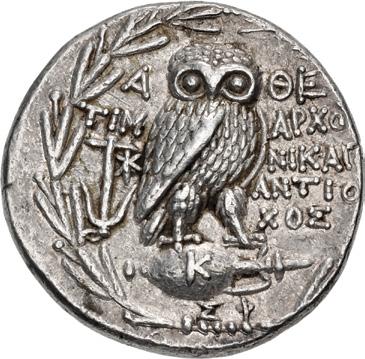
182. ATTICA, Athens. Circa 165-42 BC. AR Tetradrachm (30.5mm, 16.80 g, 11h). New Style coinage. Timarchos, Nikago–, and Antiochos, magistrates. Struck 134/3 BC. Helmeted head of Athena Parthenos right / Owl standing right, head facing, on amphora; magistrates’ names in fields, anchor and star to left, ˚ on amphora, %f below; all within wreath. Thompson 367b var. (same obv. die; different letters in exergue); HGC 4, 1602. Lightly toned. Good VF. ($750)
From the Wild Rose Collection, purchased from Shanna Schmidt, 16 March 2020. Ex Harlan J. Berk inventory cc77832 (2012); Redpath Collection.
59
178 179 180 181

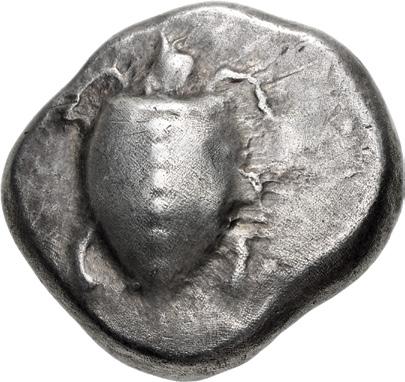
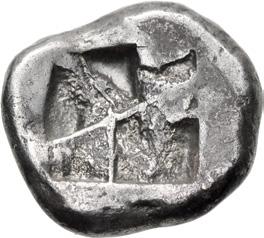
183. ISLANDS off ATTICA, Aegina. Circa 550-530/25 BC. AR Stater (22mm, 12.28 g). Sea turtle, head in profile, with heavy collar and row of dots down its back / Rough incuse square with irregular lines. Holloway, Archaic, Group A, unlisted dies; Meadows, Aegina, Group Ia; cf. Milbank Period I, pl. I, 1; HGC 6, 423; Selinus Hoard 47 (same obv. punch). Granular surfaces, struck with somewhat worn obverse die. VF. Well centered on a broad flan. Very rare issue from the beginning of coinage at Aegina. ($1500)
From the Apollo to Apollo Collection.
Pedigreed to 1921
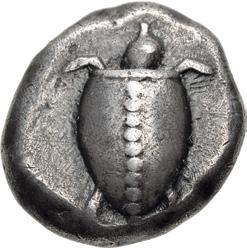
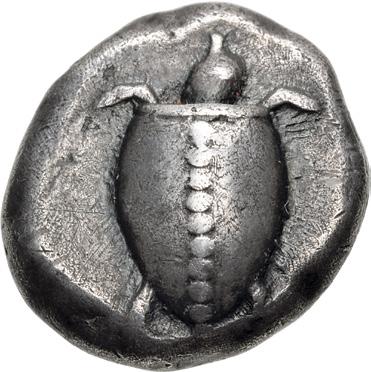
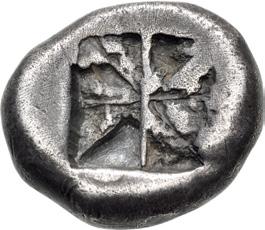
184. ISLANDS off ATTICA, Aegina. Circa 550-530/25 BC. AR Stater (19.5mm, 11.88 g). Sea turtle, head in profile, with thin collar and row of dots down its back / Deep incuse square with proto-“Union Jack” pattern. Holloway, Archaic, Group A, unlisted dies; Meadows, Aegina, Group Ia; cf. Milbank Period I, pl. I, 3; HGC 6, 424. Toned, granular surfaces, light scratch in field on obverse. VF. ($1500)
From the Wild Rose Collection. Ex Numismatic Fine Arts [XXIII] (14 December 1989), lot 518; John Story Jenks Collection (Henry Chapman, 7 December 1921), lot 101.

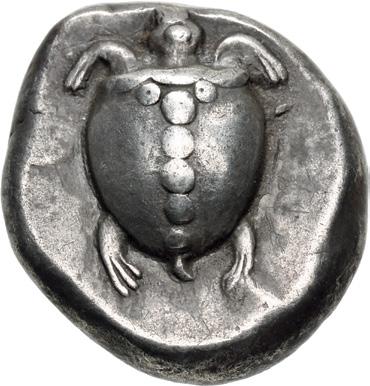
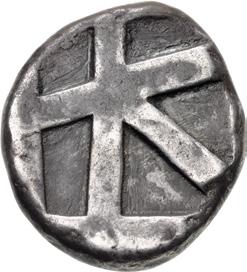
185. ISLANDS off ATTICA, Aegina. Circa 480-457 BC. AR Stater (20mm, 12.31 g, 12h). Sea turtle, head in profile, with ‘T-back’ design on shell / Large square incuse with skew pattern. Meadows, Aegina, Group IIIa; Milbank Period III; HGC 6, 448. Toned, patches of find patina, some cleaning scratches. Good VF. ($3000)
From the Wild Rose Collection. Ex Roma XIX (26 March 2020), lot 348 (hammer £5000); Numismatica Ars Classica 114 (6 May 2019), lot 189; Numismatic Fine Arts XII (23 March 1983), lot 55.
Exceptional Early Tortoise



186. ISLANDS off ATTICA, Aegina. Circa 456/45-431 BC. AR Stater (18.5mm, 12.27 g, 12h). Land tortoise with segmented shell / Large square incuse with heavy skew pattern. Meadows, Aegina, Group IIIb; Milbank Period IV, pl. II, 12; HGC 6, 437. Toned, patches of find patina on reverse. Choice EF. Exceptional for issue. ($5000)
From the Wild Rose Collection. Ex Numismatica Ars Classica 120 (6 October 2020), lot 313; Leu 79 (31 October 2000), lot 579.
60
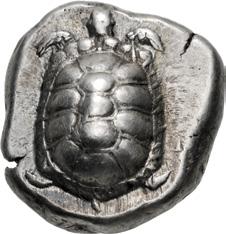
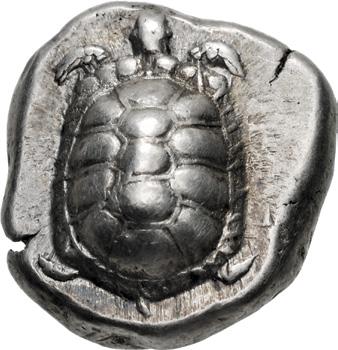
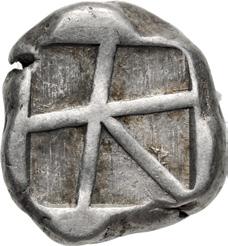
187. ISLANDS off ATTICA, Aegina. Circa 456/45-431 BC. AR Stater (18.5mm, 12.37 g, 6h). Land tortoise with segmented shell / Large square incuse with heavy skew pattern. Meadows, Aegina, Group IIIb; Milbank Period IV, pl. II, 12; HGC 6, 437. Lightly toned, minor marks. Good VF. ($2000)
Purchased by the consignor from Brian Kritt, December 1999.

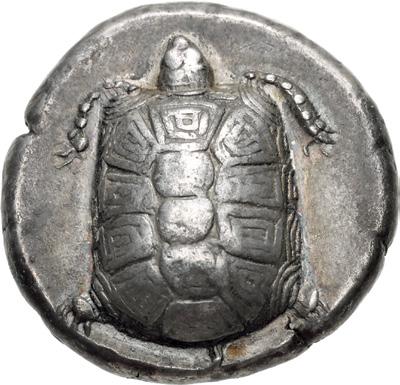
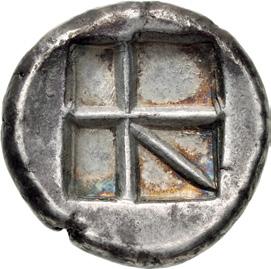
188. ISLANDS off ATTICA, Aegina. Circa 370 BC. AR Stater (21.5mm, 12.07 g, 5h). Land tortoise with segmented shell / Incuse square of thin skew pattern and no control markings. Milbank pl. II, 14; HGC 6, 438; SNG München 566–9; SNG Delepierre 1545; Dewing 1686. Dark iridescent tone. Good VF. Well centered and struck. ($2000)
From the Wild Rose Collection, purchased from Warden Numismatics, January 2018. Ex George Bernert Collection (Classical Numismatic Group 106, 13 September 2017), lot 275; Numismatic Fine Arts VI (27 February 1979), lot 204.
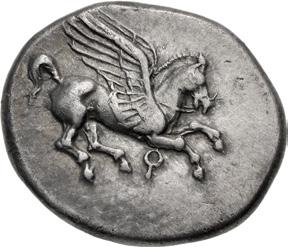
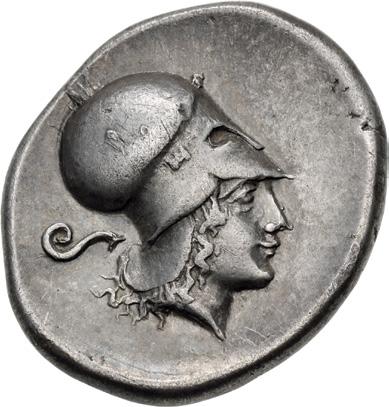
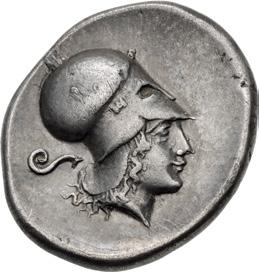
189. CORINTHIA, Corinth. Circa 400-350/45 BC. AR Stater (23.5mm, 8.46 g, 1h). Pegasos flying right / Helmeted head of Athena right; serpent to left. Ravel Period IV, 521 (P258/T364); Pegasi 222; BCD Corinth 63; HGC 4, 1834; Pozzi 1668 (same dies); Sartiges 275 (same dies). Toned, slight die wear, light scratches. Good VF. ($750)
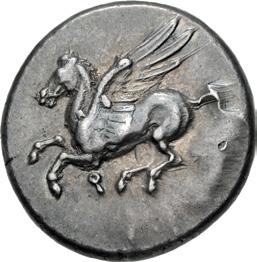

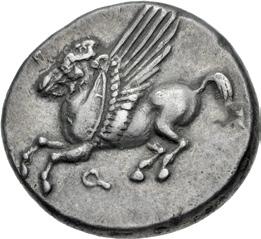

190. CORINTHIA, Corinth. Circa 350/45-285 BC. AR Stater (21mm, 8.56 g, 4h). Pegasos flying left / Helmeted head of Athena left, with laurel wreath on the helmet; Å-r flanking neck truncation, aegis to right. Ravel Period V, 1009; Pegasi 427; BCD Corinth –; HGC 4, 1848. Deep iridescent tone, some die wear on obverse. Good VF. ($1000)
191. CORINTHIA, Corinth. Circa 350/45-285 BC. AR Stater (21.5mm, 8.59 g, 4h). Pegasos flying left / Helmeted head of Athena left, helmet decorated with laurel wreath; Å r flanking neck truncation; to right, Athena Promachos right. Ravel Period V, 1014; Pegasi 432; BCD Corinth –; HGC 4, 1848. Old collection tone, trace deposits, minor marks. Good VF. ($750)
Ex Mark and Lottie Salton Collection (Stack’s Bowers Galleries, 13 January 2023), lot 26216.
61
190 191
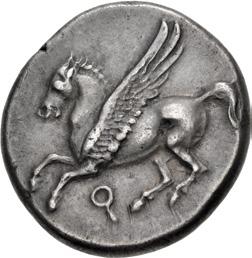


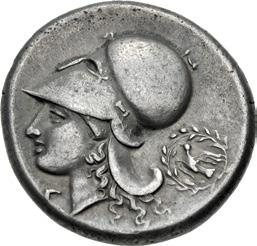
192. CORINTHIA, Corinth. Circa 350/45-285 BC. AR Stater (20.5mm, 8.60 g, 8h). Pegasos flying left / Helmeted head of Athena left, with laurel wreath on the helmet; Å-r flanking neck truncation; to right, plow right. Ravel Period V, 1021; Pegasi 439; BCD Corinth 107; HGC 4, 1848. Toned, minor die wear on obverse, a little porosity on reverse. Good VF. ($1000)
From the Wild Rose Collection. Ex Classical Numismatic Group 121 (6 October 2022), lot 272; Mark and Lottie Salton Collection (Part I, Stack’s Bowers Galleries, 14 January 2022), lot 4299.
193. CORINTHIA, Corinth. Circa 350/45-285 BC. AR Stater (21mm, 8.55 g, 12h). Pegasos flying left / Helmeted head of Athena left; ˝ below chin; to right, dove flying left within wreath. Ravel Period V, 1029; Pegasi 419; BCD Corinth 110 = SNG Lockett 2094; HGC 4, 1848. Old collection tone, a few minor scratches on obverse, trace deposits on reverse. Good VF. ($750)
Ex Mark and Lottie Salton Collection (Stack’s Bowers Galleries, 13 January 2023), lot 26211.
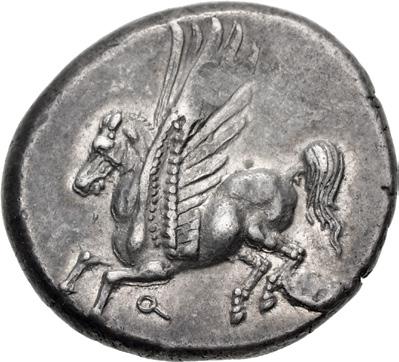
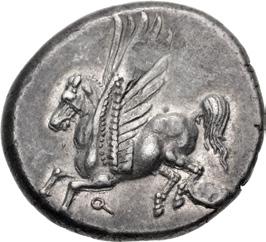
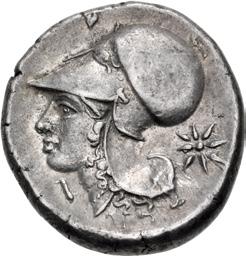

194. CORINTHIA, Corinth. Circa 350/45-285 BC. AR Stater (21.5mm, 8.53 g, 10h). Pegasos flying left / Helmeted head of Athena right; 5 before neck, star to right. Ravel Period V, 1034; Pegasi 425; BCD Corinth –; HGC 4, 1848. Toned, underlying luster, die break and area of weak strike on obverse, some die rust and couple of scratches on reverse. EF. ($1500)
Ex Mark & Lottie Salton Collection.
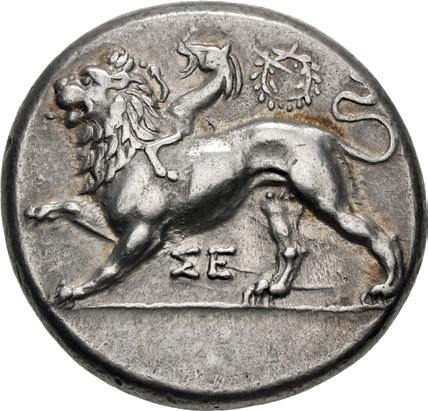
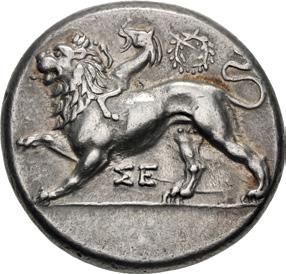
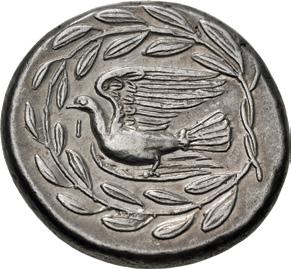

195. SIKYONIA, Sikyon. Circa 335-330 BC. AR Stater (23.5mm, 12.22 g, 5h). Chimaera standing left, raising left forepaw; wreath above, sE below / Dove flying left; 5 to left; all within wreath. BCD Peloponnesos 219; HGC 5, 201; BMC 56. Light iridescent tone, minor die wear on obverse, a few hairlines on reverse. Good VF. ($2000)
From the Wild Rose Collection, purchased from Pars Coins, May 2013.
62
192
193

Very Rare Zeus Mint Stater
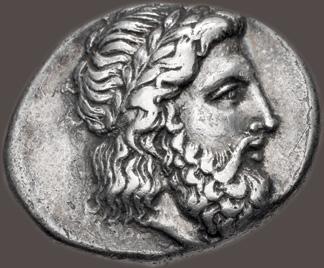
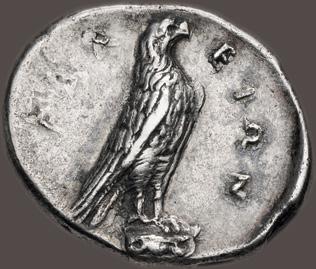
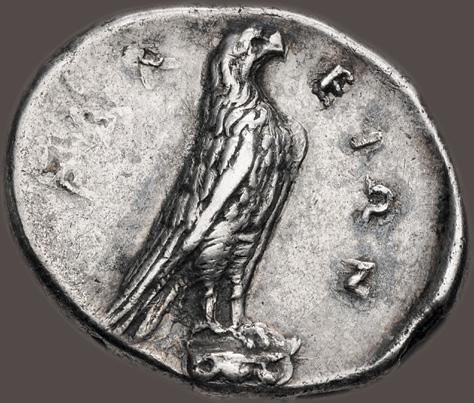
196. ELIS, Olympia. 107th Olympiad. 352 BC. AR Stater (26.5mm, 11.89 g, 12h). ‘Zeus’ mint. Head of Zeus right, wearing laurel wreath / Eagle, with closed wings, standing right on Ionic capital; VŬ-E5W@ around. Seltman, Temple 189 (dies CE/δφ); BCD Olympia 131 (same obv. die); HGC 5, 373; SNG Copenhagen 386 (same obv. die); BMC 82 (same obv. die); Boston MFA 1218 = Warren 929 (same obv. die); Gillet 990 (same obv. die); de Sartiges 312 (same obv. die); Triton XXI, lot 428 (same obv. die; hammer $16,000). Lightly toned, underlying luster, traces of find patina, some light scratches, minor double strike on reverse. VF. Very rare reverse die, only one example noted by Seltman with this die, none in CoinArchives. ($10,000)
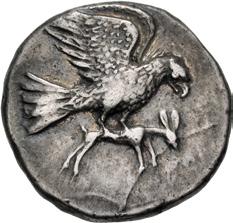

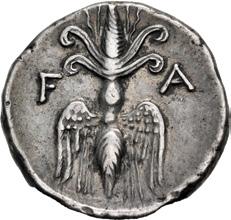
197. Elis, Olympia. 134th-143rd Olympiad. Circa 244-208 BC. AR Drachm (19mm, 4.72 g, 7h). Eagle flying right, holding hare / Upright thunderbolt. Elis Hoard Group II, 11 (same dies); BCD Olympia 238 (same dies); HGC 5, 508. Attractively toned, very minor lamination on obverse. VF. ($750)
Ex W. Hansen Collection; BCD Collection (Classical Numismatic Group Electronic Auction 260, 20 July 2011), lot 162.



198. CRETE, Rhaokos. Circa 330-270 BC. AR Stater (24mm, 11.45 g, 7h). Nude Poseidon standing right, holding trident and hand holding rein of horse standing right in background / Trident head. Svoronos, Numismatique 11; Le Rider, Crétoises, pl. VI, 14 (same obv. die); Weber 4589 (same dies). Toned, overstruck on uncertain type, die break and minor scratch on obverse, struck with worn obverse die. VF. ($750)
Ex Künker 382 (16 March 2023), lot 134; Schweizerischer Bankverein 33 (20 September 1993), lot 267.
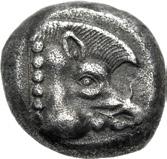

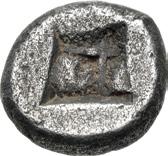
199. CYCLADES, Kythnos. Circa 475-460 BC. AR Drachm or Tetrobol (13mm, 3.96 g). Forepart of boar right / Quadripartite incuse square. Sheedy Series III, unlisted die; HGC 6, 602 corr. (forepart, not head). Toned, traces of find patina, lightly granular surfaces. Good VF. Very rare. ($2000)
63
Referenced by Tully
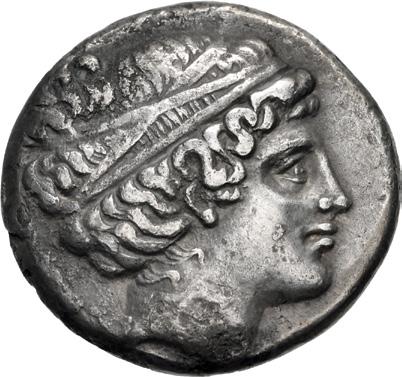
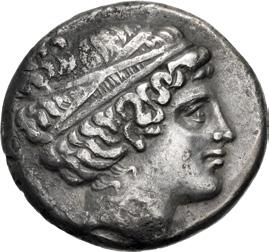
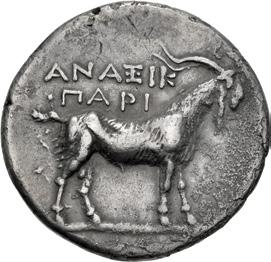

200. CYCLADES, Paros. Early 2nd century BC. AR Didrachm (22mm, 7.35 g, 12h). Anaxik–, magistrate. Head of female (Artemis?) right, hair tied over head with ribbon wrapped three times / Goat standing right. Tully Series Di2.A, 3b (O1/R3 – this coin); HGC 6, 661; SNG Manchester 1144 (same dies); Consul Weber 2236 = Rhousopoulos 3166 (same dies). Toned, some horn silver, minor marks. VF. ($2000)
Ex Rauch 34 (14 January 1985), lot 128.
Mint State Pantikapaion Stater
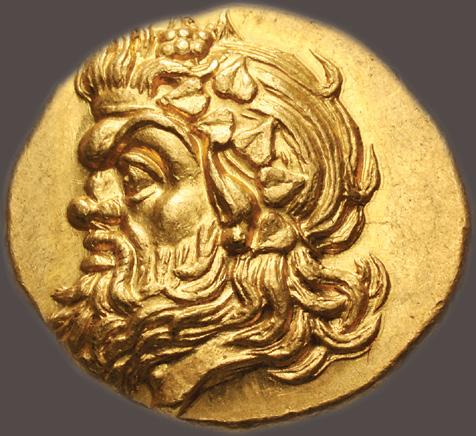
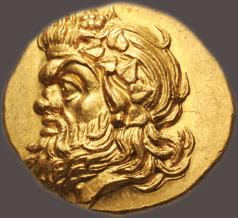
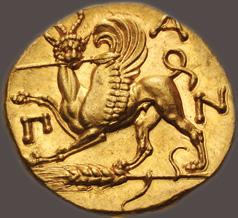
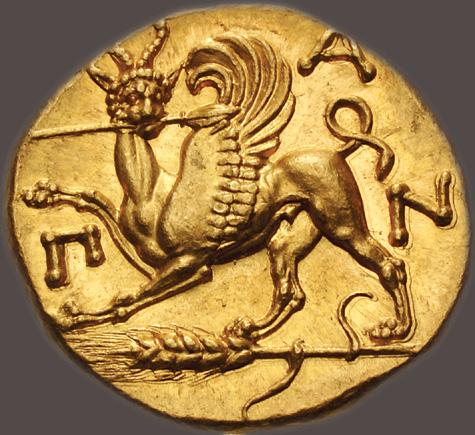
201. CIMMERIAN BOSPOROS, Pantikapaion. Circa 340-325 BC. AV Stater (19mm, 9.13 g, 12h). Bearded head of Pan left, wearing ivy wreath / Griffin, holding spear in its mouth, standing left, head facing, forepaw raised, on grain ear; ∏-Å@ around. Frolova, Catalogue, Group III, dies unlisted; Anokhin 1021; MacDonald 54; HGC 7, 20; SNG BM Black Sea 864; Gulbenkian 588–90;
Pantikapaion was founded by Greek colonists from Miletos in the late seventh century BC. Situated on the west side of the Cimmerian Bosporos, in what is now called the Crimea, it achieved great prosperity through its exploitation of the abundant fisheries of the straits and the export of wheat from the Crimea. This wealth is attested by its splendid gold coinage, which commenced in the mid-4th century BC, and by the magnificently furnished rock tombs of its principal citizens in the same period. Later, it was to become a regional capital of the kingdom of Mithradates VI of Pontos (120-63 BC) and later still the seat of the kings of Bosporos (first century BC – fourth century AD). The coinage of Pantikapaion seems to have commenced with silver issues in the latter part of the fifth century BC, but it is for its beautiful gold staters that the mint is chiefly noted. They depict the head of the god Pan (a pun on the name of the city) and on the reverse, the griffin that Herodotos describes as being the guardian of the remote sources of gold.
64
Jameson 1361; Pozzi 1150; Sartiges 1580; CNG 111, lot 178 (same dies); Triton XXIII, lot 282 (same obv. die). Lustrous. NGC photo certification 6828214-001, graded MS, Strike: 5/5, Surface: 4/5, Fine Style. Struck from fresh dies, showing excellent detail. ($75,000)
Extremely Rare Tetradrachm of Mithradates III
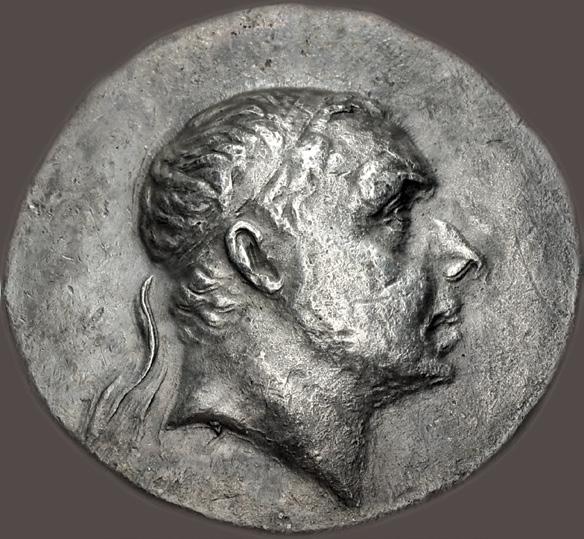
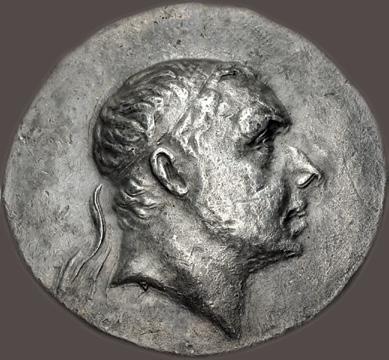


202. KINGS of PONTOS. Mithradates III. Circa 220-200 BC. AR Tetradrachm (32mm, 16.57 g, 12h). Amisos mint. Diademed head right / ∫Å%5¬EW% Â5QrÅdÅtoU, Zeus Aëtophoros seated left; to inner left, star-in-crescent above Ż Callataÿ, First, dies O1/R1; Mattingly 2 (same dies); RG 2 (same dies as illustration); HGC 7, 319 (same dies as illustration); SNG BN 771–2 (same dies). Toned, minor doubling, slightly soft strike and light scratch in field on obverse. Good VF. Extremely rare, only four examples noted by Callataÿ, including the two in CoinArchives. ($20,000)
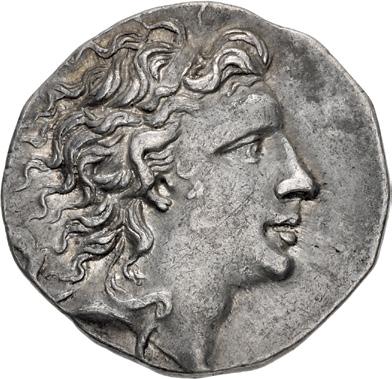

203. KINGS of PONTOS. Mithradates VI Eupator. Circa 120-63 BC. AR Tetradrachm (32.5mm, 16.80 g, 11h). Pergamon mint. Dated month 3, year 224 BE (December 74 BC). Diademed head right / Stag grazing left; to left, star-increscent above d˚s (year); to right, n above #; ˝ (month) in exergue; all within Dionysiac wreath of ivy and fruit. Callataÿ p. 21, obv. die D62; HGC 7, 340; DCA2 561. Toned, a few light scratches. Good VF. ($1500)
From the Wild Rose Collection, purchased from Gorny & Mosch, January 2018. Ex. Roma XIV (21 September 2017), lot 274; Roma XII (29 September 2016), lot 359.


204. PAPHLAGONIA, Sinope. Circa 350/30-300 BC. AR Drachm (17.5mm, 6.08 g, 5h). Aiginetic standard. Phageta–, magistrate. Head of nymph left, hair in sakkos; aphlaston to left / Sea-eagle standing left, wings spread, on dolphin left. RG 31; HGC 7, 391. Deep iridescent tone. Good VF. Well centered. ($500)
65

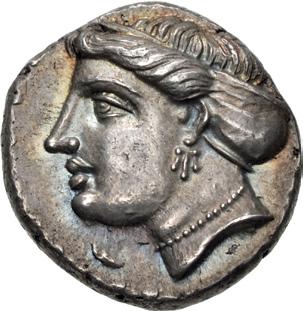
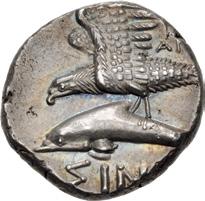
205. PAPHLAGONIA, Sinope. Circa 350/30-300 BC. AR Siglos or Drachm (16mm, 5.01 g, 5h). Persic standard. Agreos, magistrate. Head of nymph left, hair in sakkos / Sea-eagle standing left, wings spread, on dolphin left. RG 34; HGC 7, 399. Deep iridescent tone, compact flan. EF. ($500)
From the Wild Rose Collection, purchased from Baldwin’s, December 2013. Ex New York Sale XXX (9 January 2013), lot 132.

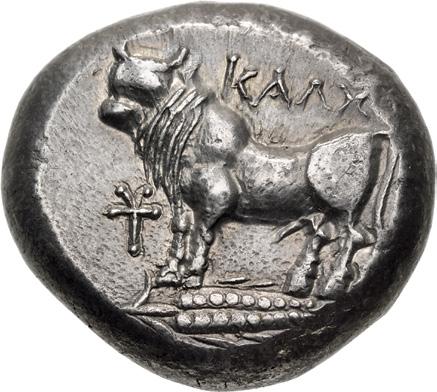
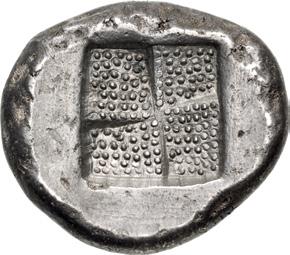
206. BITHYNIA, Kalchedon. Circa 367/6-340 BC. AR Stater (23.5mm, 15.10 g). Rhodian standard. Bull standing left on grain ear right; ì to left / Quadripartite incuse square with stippled surface. RG 14; HGC 7, 509. Toned, underlying luster, slight die wear and minor mark on obverse. Near EF. ($500)
From the Wild Rose Collection. Ex Lanz 162 (6 June 2016), lot 69.
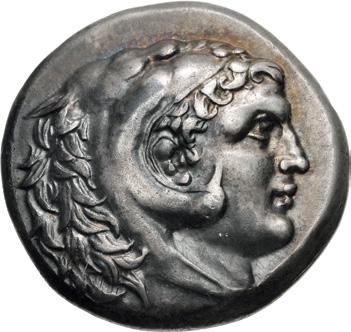
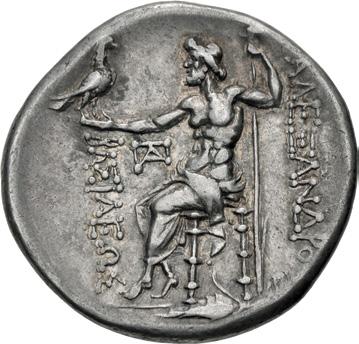
207. BITHYNIA, Kalchedon. Circa 260-220 BC. AR Tetradrachm (29mm, 16.84 g, 12h). In the name and types of Alexander III of Macedon. Head of Herakles right, wearing lion skin / Zeus Aëtophoros seated left; , in left field, grain ear in exergue. Price 926 (Kallatis); Türkoğlu –; HGC 7, 521; Black Sea Hoard 26 (same dies). Toned, underlying luster, slight die shift on reverse. Good VF. ($750)
See U. Wartenberg & J.H. Kagan, “Some Comments on a New Hoard from the Balkan Sea” in Travaux Le Rider, pp. 402–5, for the reattribution of this, and many of the other issues Price assigned to Kallatis, to Kalchedon.
Rare Depiction of the Dianafisch
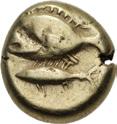
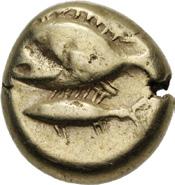
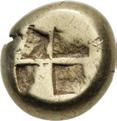
208. MYSIA, Kyzikos. Circa 600-550 BC. EL Hekte – Sixth Stater (9.5mm, 2.63 g). Louvar left; below, tunny left / Quadripartite incuse square. Hurter & Liewald III p. 14, 3; CNG 105, lot 143; CNG 99, lot 170; CNG E-387, lot 122; CNG inventory 922164; Savoca 203, lot 112; otherwise unpublished. A little off center, minor scratches and scrapes. VF. Very rare. ($500)
The only extant species in the genus Luvarus and the family Luvaridae, the louvar, known in German as the Dianafisch and in Spanish as the emperador, dates from the Paleogene period, and is closely related to the surgeonfish. A large ellipsoidal fish, it can grow up to 2m (over 6 feet) in length and is considered a delicacy, but is rarely found in fish stores and is usually caught ‘by-catch.’ See Gemini VII, lot 462 for the stater of this issue, and CNG 99, lot 170 for the hemihekte. Hurter & Liewald placed this issue in a section of coins “associated to Kyzikos”, as they doubted the attribution without further information (they knew of only one example appearing in a private collection). However, a few more of these have recently come to market alongside contemporary issues definitively placed at Kyzikos, so the attribution to that city must be accepted.
66

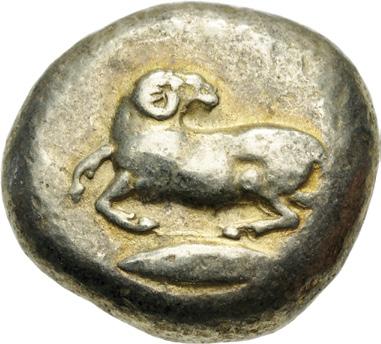
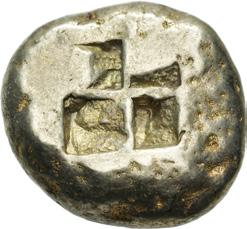
209. MYSIA, Kyzikos. Circa 550-450 BC. EL Stater (20mm, 16.07 g). Ram seated left, head reverted; below, tunny left / Quadripartite incuse square. Von Fritze I 47; Boston MFA 1419 = Warren 1555; SNG BN –. Lightly toned. VF. ($2000)
Ex Siren Collection (Classical Numismatic Group Electronic Auction 484, 27 January 2021), lot 254.
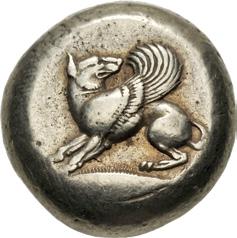
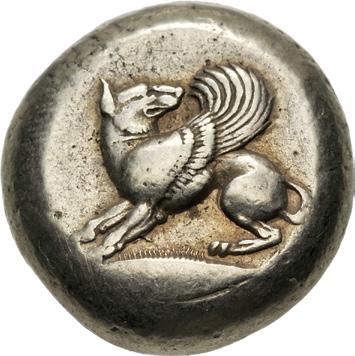
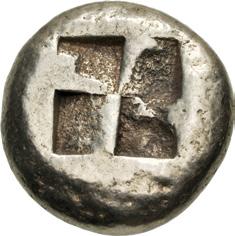
210. MYSIA, Kyzikos. Circa 550-450 BC. EL Stater (19mm, 16.07 g). Winged dog squatting left, head right, on tunny left / Quadripartite incuse square. Von Fritze I 104; Boston MFA 1433 = Warren 1568; SNG BN 245. Good VF. ($3000)
From the Wild Rose Collection. Ex Triton XX (10 January 2017), lot 204.
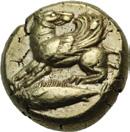

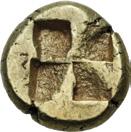
211. MYSIA, Kyzikos. Circa 550-450 BC. EL Hekte – Sixth Stater (10.5mm, 2.69 g). Winged dog squatting left, head reverted, on tunny fish left / Quadripartite incuse square. Von Fritze I 104; cf. Boston MFA 1433 = Warren 1568 (stater); SNG BN 246–7. Edge splits, minor flan flaw on obverse. EF. Well centered. ($750)
From the Siren Collection.
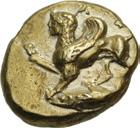


212. MYSIA, Kyzikos. Circa 550-450 BC. EL Hekte – Sixth Stater (11.5mm, 2.66 g). Sphinx crouching left, raising forepaw, on tunny left / Quadripartite incuse square. Von Fritze I 72; Boston MFA 1451; SNG BN 201–2. Some scratches and scrapes. Near EF. ($1500)
From the Siren Collection.
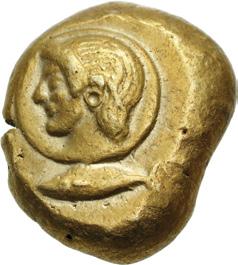

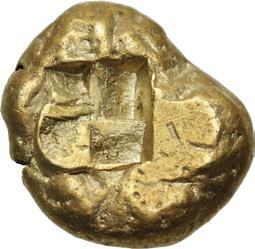
213. MYSIA, Kyzikos. Circa 550-450 BC. EL Stater (18.5mm, 16.03 g). Head of ephebos left on diskos; below, tunny left / Quadripartite incuse square. Von Fritze I 105; cf. Boston MFA 1476 = Warren 1496 (hekte); SNG BN 248. Toned, light scratches and scrapes. VF. Extremely rare as a stater, only four in CoinArchives. ($3000)
From the Siren Collection.
67

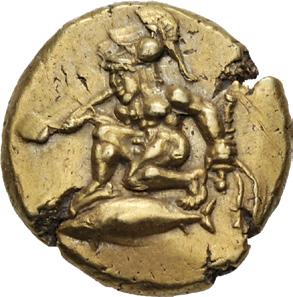
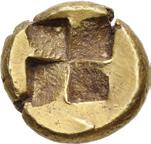
214. MYSIA, Kyzikos. Circa 450-330 BC. EL Hekte – Sixth Stater (12mm, 2.65 g). Warror, nude but for helmet, kneeling right, testing arrow and holding sheathed sword; below, tunny left / Quadripartite incuse square. Von Fritze I 115; Boston MFA –; cf. SNG BN 261–2 (stater and myshemihekte). Edge splits, hairlines, triple struck on obverse. Good VF. Very rare as a hekte, only four in CoinArchives (the most recent being in 2013), and the first CNG has handled since CNG 61 in 2002. ($750)
From the Siren Collection.

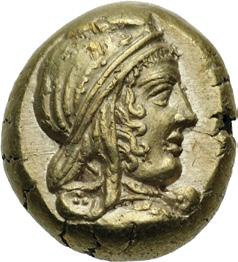
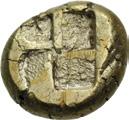
215. MYSIA, Kyzikos. Circa 450-330 BC. EL Hekte – Sixth Stater (9.5mm, 2.68 g). Head of Attis right, wearing Phrygian headdress; below, tunny right / Quadripartite incuse square. Von Fritze I 142; Boston MFA 1523; SNG BN 292–3. Scratches and marks, scrape om obverse. EF. ($1000)
From the Siren Collection.
The portrait on this particular issue is thought to be Attis, the consort of Phrygian Kybele. The androgynous Kybele/Agdistis was castrated by the gods. From the severed parts grew an almond tree from which Attis sprang. Attis appears infrequently in Greek art, but he was raised in status when the Romans adopted the cult of Kybele.
Extremely Rare Hekte
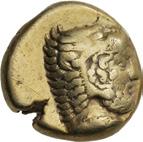

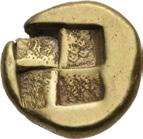
216. MYSIA, Kyzikos. Circa 450-330 BC. EL Hekte – Sixth Stater (11.5mm, 2.72 g). Head of Herakles right, wearing lion skin / Quadripartite incuse square. Cf. Von Fritze I 104 (unlisted denomination); cf. Boston MFA 1527 (myshemihekte); cf. SNG BN 289 (stater); Hurter & Liewald II –. Edge split, scrapes and scratches. VF. Extremely rare as a hekte, unpublished in the standard references, only two in CoinArchives. ($1500)
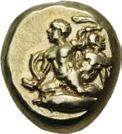


217. MYSIA, Kyzikos. Circa 450-330 BC. EL Hekte – Sixth Stater (10mm, 2.67 g). Nude Herakles kneeling left in foreground, and his brother, Iphikles, also nude, kneeling right in background, fighting Hera’s serpents on tunny left / Quadripartite incuse square. Von Fritze I 208; cf. Boston MFA 1531 = Warren 1477 (stater); cf. SNG BN 341 (stater). A couple of minor scratches, a touch off center. Good VF. ($1000)
From the Siren Collection.
68
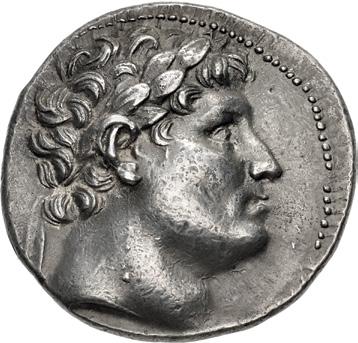
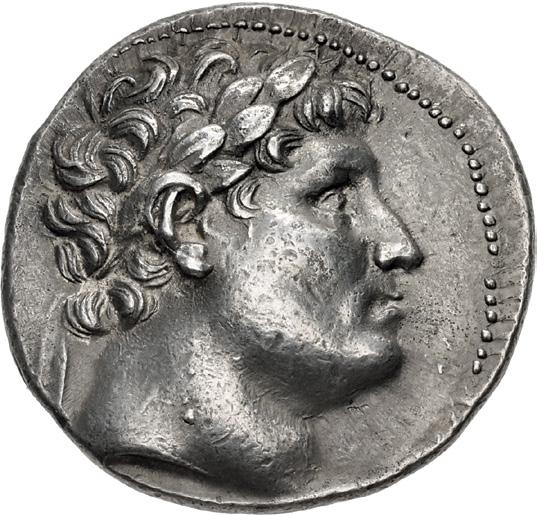
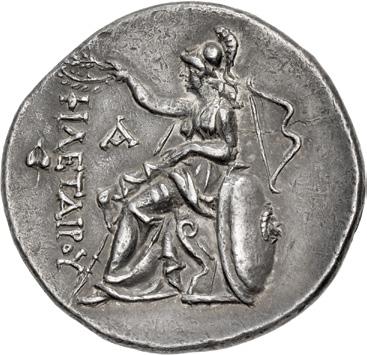
218. KINGS of PERGAMON. Eumenes I. 263-241 BC. AR Tetradrachm (30mm, 17.05 g, 1h). In the name of Philetairos. Pergamon mint. Struck circa 255/50-241 BC. Laureate head of Philetairos right / Athena enthroned left, elbow resting on shield to right, crowning dynastic name with wreath; transverse spear in background, ivy leaf to outer left, v to inner left, bow to right. Westermark Group IVA, dies V.LVII/R1; SNG BN 1610; Winterthur 2616 (same obv. die). Toned, some find patina, a little die wear on obverse, die break and light scratch on reverse. Near EF ($1500)
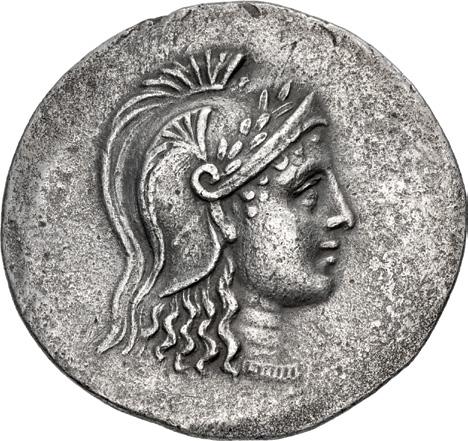
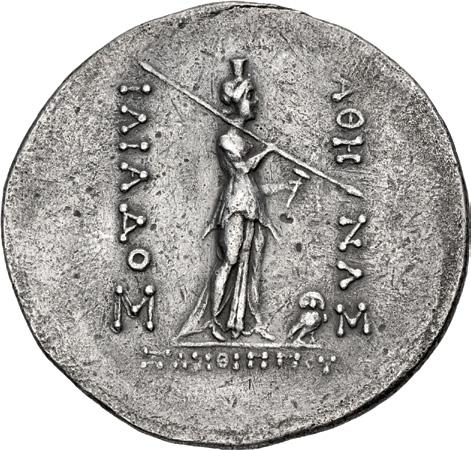
219. TROAS, Ilion. Circa 185-50 BC. AR Tetradrachm (39mm, 15.26 g, 12h). Xanthippos, president of the aonothetai Helmeted head of Athena right / The Palladion: Athena Ilias standing right, holding distaff and filleted spear; to inner right, owl standing left, head facing. Ellis-Evans dies O2/R8; Bellinger T36 (same dies as illustration); Mionnet II 190 (same dies). Lightly toned, porous, cleaning marks. VF. Well centered on a broad flan. Extremely rare, apparently the third known; only the Mionnet piece (in the BN) published, and just one in CoinArchives. ($500)
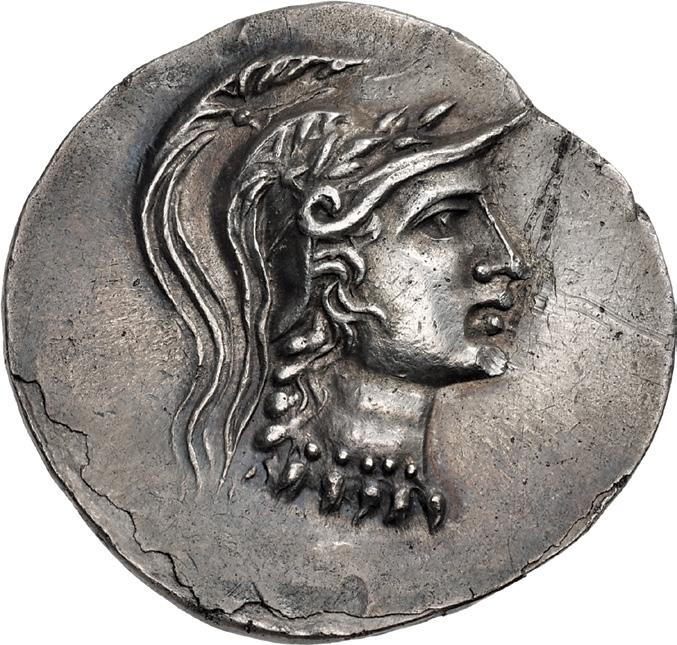
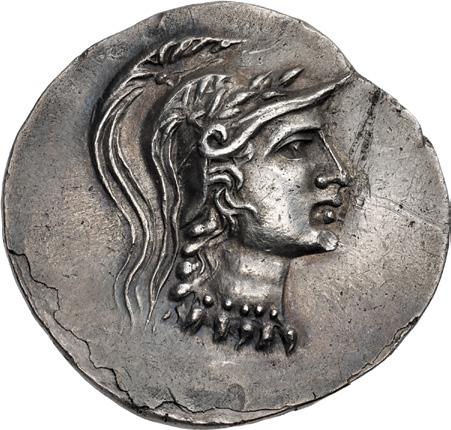
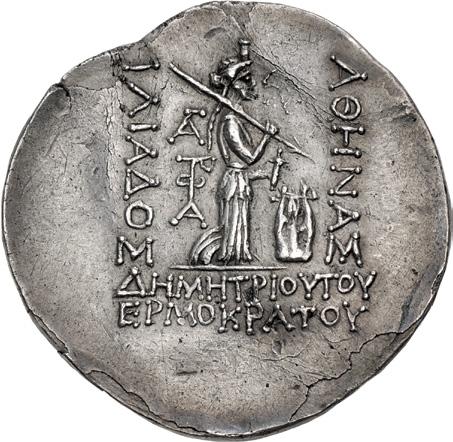

220. TROAS, Ilion. Circa 185-50 BC. AR Tetradrachm (37.5mm, 16.49 g, 12h). Demetrios, son of Hermokrates, president of the agonothetai. Helmeted head of Athena right / The Palladion: Athena Ilias standing right, holding distaff and filleted spear; to inner left, 6 above monogram; kithara to inner right. Unpublished. Lightly toned, crimped flan, with stress cracks and slight wave to flan, chipping around edge, a couple scrapes on obverse. VF. Apparently unique. ($750)
From the Wayne Scheible Collection.
69
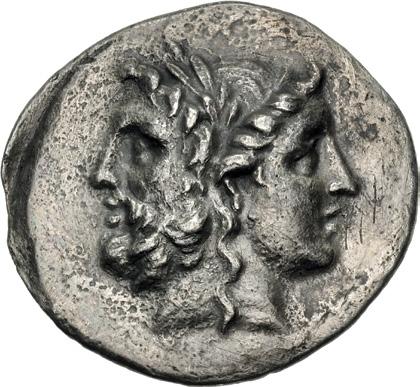

221. ISLANDS off TROAS, Tenedos. Circa 100-70 BC. AR Tetradrachm (35mm, 14.32 g, 12h). Janiform head of a bearded male left, laureate, and female right, wearing stephanos / Labrys; grape bunches on vines flanking handle; all within wreath. Callataÿ, Tenedos 1 var. (D1/R– [unlisted rev. die]); HGC 6, 390. Toned, rough surfaces, heavy cleaning marks. VF. Very rare issue with two grape bunches; only one noted by Callataÿ, and this coin is one of only four in CoinArchives. ($1000)
Ex Numismatik Naumann 122 (6 November 2022), lot 279 (hammer €14,000; conserved since).
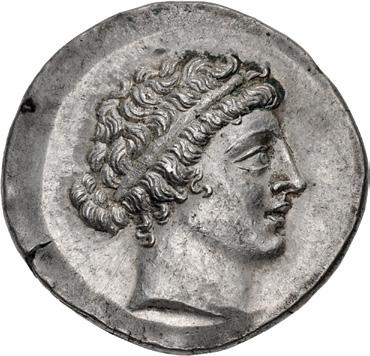
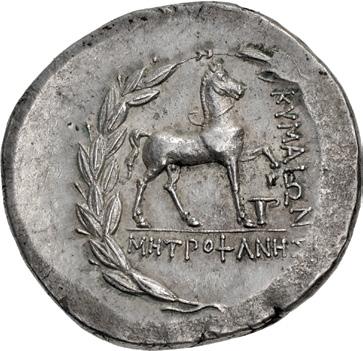
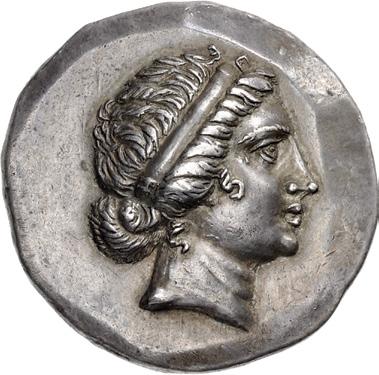

222. AEOLIS, Kyme. Circa 155-143 BC. AR Tetradrachm (31mm, 16.75 g, 11h). Stephanophoric type. Metrophanes, magistrate. Head of the Amazon Kyme right, wearing tainia / Horse prancing right; one-handled cup below raised foreleg; all within wreath. Oakley obv. die 8; SNG Copenhagen 104 (same obv. die); Dewing 2229 (same obv. die); Warren 1060 (same obv. die). Lightly toned, some verdigris, minor die break on obverse. EF. ($750)
From the Wild Rose Collection. Ex Lanz 46 (28 November 1988), lot 259.
Inscribed Taenia
223. AEOLIS, Kyme. Circa 155-143 BC. AR Tetradrachm (31.5mm, 16.73 g, 12h). Stephanophoric type. Olympios, magistrate. Head of the Amazon Kyme right, wearing taenia with small ˙ inscribed near the back end / Horse prancing right; one-handled cup below raised foreleg; all within wreath. Oakley dies 50/a; BMC 80 (same dies). Attractively toned. Good VF. ($750)
Ex Classical Numismatic Group 81 (20 May 2009), lot 501.
The small H on the tainia is clearly visible on both specimens cited by Oakley for this obverse die, but no mention of it is made in his article.
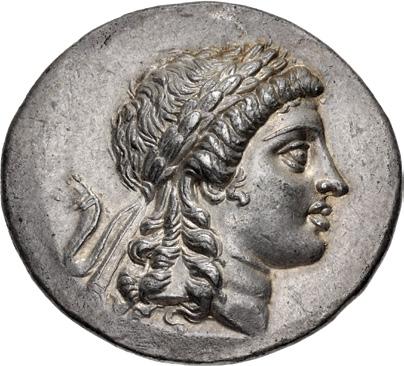

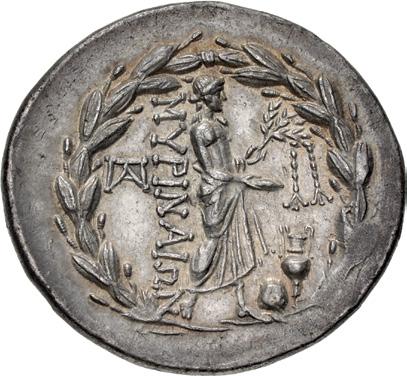
224. AEOLIS, Myrina. Circa 160-143 BC. AR Tetradrachm (33.5mm, 16.76 g, 12h). Stephanophoric type. Laureate head of Apollo right / Apollo Grynios standing right, holding branch and phiale; , to left, omphalos and amphora at feet; all within laurel wreath. Sacks Issue 20, obv. die 19; SNG Copenhagen 223. Even gray tone with golden hues. EF. ($750)
From the Wild Rose Collection. Ex CNG inventory 505838 (February 2019, priced $1650); Roma E-Sale 42 (6 January 2018), lot 134; Spink 183 (26 September 2006), lot 672.
70
222 223

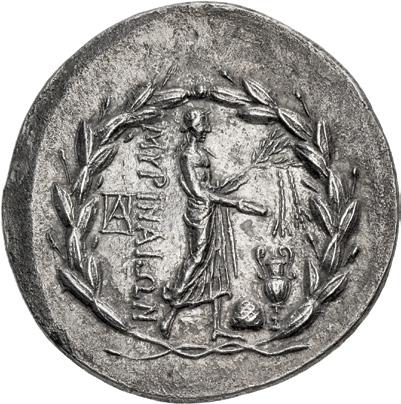
225. AEOLIS, Myrina. Circa 160-143 BC. AR Tetradrachm (33mm, 16.09 g, 12h). Stephanophoric type. Laureate head of Apollo right / Apollo Grynios standing right, holding branch and phiale; ó to left, omphalos and amphora at feet; all within laurel wreath. Sacks Issue 45, obv. die 91; BMC 2; Ward 637. Lightly toned, slightly rough surfaces, minor double strike on reverse. Near EF. ($750)
Pedigreed to 1972
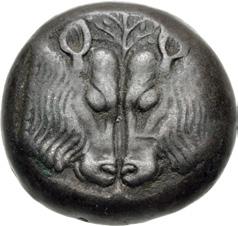
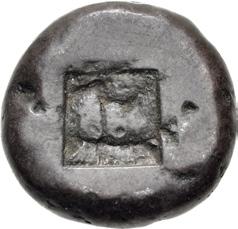
226. LESBOS, Unattributed Koinon mint. Circa 510-480 BC. BI Stater (19mm, 11.27 g). Confronted calves’ heads; olive tree between / Small incuse square punch. Lazzarini, Contribution, Series III; HGC 6, 1076. Deeply toned. VF. ($750)
From the Wild Rose Collection. Ex Nomos 12 (22 May 2016), lot 93; Leu 2 (25 April 1972), lot 237.

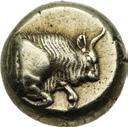
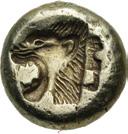
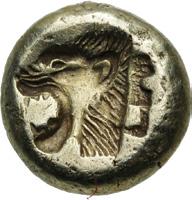
227. LESBOS, Mytilene. Circa 521-478 BC. EL Hekte – Sixth Stater (10mm, 2.62 g, 1h). Forepart of bull right / Incuse head of lion left; rectangular punch behind. Bodenstedt Em. 5; HGC 6, 929. Slight die wear on obverse, hairlines on reverse. Good VF. ($1500)
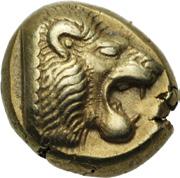

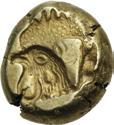
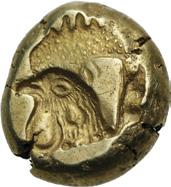
228. LESBOS, Mytilene. Circa 521-478 BC. EL Hekte – Sixth Stater (9.5mm, 2.55 g, 1h). Head of roaring lion right / Incuse head of cock left; rectangular punch to right. Bodenstedt Em. 7; HGC 6, 931. Edge split. Near EF. Well centered.

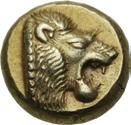
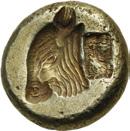

229.

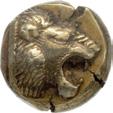
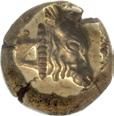

230. LESBOS, Mytilene. Circa 521-478 BC. EL Hekte – Sixth Stater (9.5mm, 2.52 g). Head of roaring lion right; wart on
/ Incuse head of calf right; rectangular
left. Bodenstedt Em. 13; HGC 6, 938. Toned. In NGC encapsulation 6556560-001, graded Ch XF, Strike: 5/5, Surface: 4/5. Well centered and in high relief. ($750)
Ex Weise Collection (Classical Numismatic Group 114, 13 May 2020), lot 250, purchased from Baldwin’s, 10 January 2008.
71
($500)
LESBOS, Mytilene. Circa 521-478 BC. EL Hekte – Sixth Stater (10.4mm, 2.54 g, 1h). Head of roaring lion right; wart on nose / Incuse head of calf left; rectangular punch behind. Bodenstedt Em. 12; HGC 6, 937. Some light scratches on reverse. EF. ($750)
nose
punch to

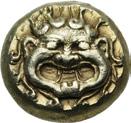
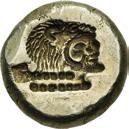
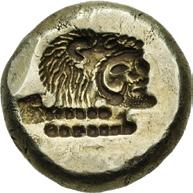
231. LESBOS, Mytilene. Circa 521-478 BC. EL Hekte – Sixth Stater (10.5mm, 2.55 g, 3h). Gorgoneion / Incuse head of Herakles right, wearing lion skin headdress; rectangular punch to left. Bodenstedt Em. 19.1; HGC 6, 944. Tiny die break on obverse. Near EF. Well centered. ($1000)
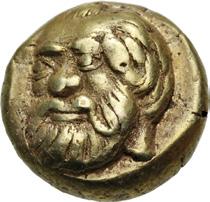

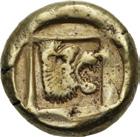

232. LESBOS, Mytilene. Circa 454-428/7 BC. EL Hekte – Sixth Stater (11mm, 2.53 g, 6h). Head of Silenos facing slightly left / Head of lion right within incuse square. Bodenstedt Em. 38; HGC 6, 964. Tiny mark on obverse, struck with worn reverse die. VF. Well centered. ($1500)
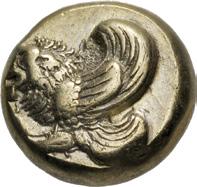
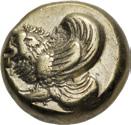

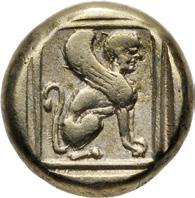
233. LESBOS, Mytilene. Circa 412-378 BC. EL Hekte – Sixth Stater (10.5mm, 2.51 g). Forepart of winged lion left / Sphinx seated right in linear square within incuse square. Bodenstedt Em. 63; HGC 6, 989 corr. (winged lion, not boar). Slightly off center and some die rust on obverse. Good VF. ($500)
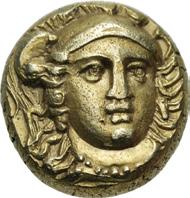

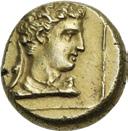

234. LESBOS, Mytilene. Circa 377-326 BC. EL Hekte – Sixth Stater (10mm, 2.56 g, 6h). Helmeted head of Athena facing slightly right / Head of Hermes right, wearing kausia behind his draped neck, within linear square. Bodenstedt Em. 86; HGC 6, 1012. Minor marks, a little off center on reverse. Good VF. ($1000)
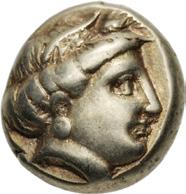
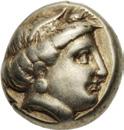
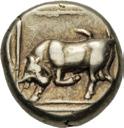

235. LESBOS, Mytilene. Circa 377-326 BC. EL Hekte – Sixth Stater (10mm, 2.54 g, 6h). Wreathed head of Persephone right / Bull butting left in linear square within shallow incuse square. Bodenstedt Em. 88; HGC 6, 1014 corr. (bull butting

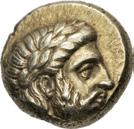
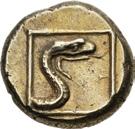
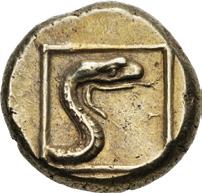
236.
Ex Papillon 5 (6 March 2021), lot 183.

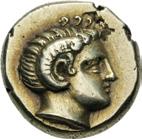
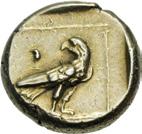
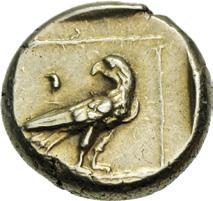
237.
72
left, not right). Lightly toned. VF. ($600)
LESBOS, Mytilene. Circa 377-326 BC. EL Hekte – Sixth Stater (11mm, 2.56 g, 6h). Laureate head of Zeus right / Forepart of serpent right within linear frame. Bodenstedt Em. 96; HGC 6, 1022. Lightly toned, a little off center on obverse. Good VF. ($750)
LESBOS, Mytilene. Circa 377-326 BC. EL Hekte – Sixth Stater (11.5mm, 2.55 g, 9h). Head of Apollo Karneios right, with horn of Ammon / Eagle standing right, head reverted, in linear square within incuse square. Bodenstedt Em. 104; HGC 6, 1030. Lightly toned, flan flaw on obverse, slightly off center and tiny die break on reverse. Good VF. ($750)

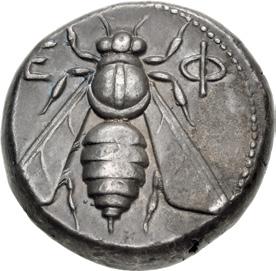

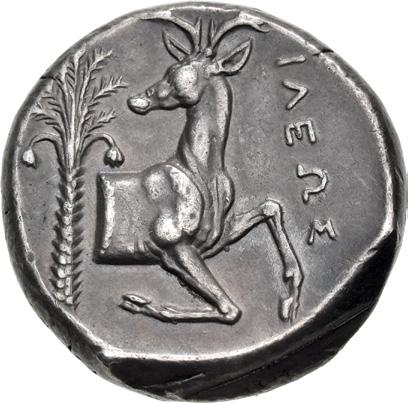
238. IONIA, Ephesos. Circa 390-325 BC. AR Tetradrachm (22mm, 15.25 g, 12h). Ileos, magistrate. Struck circa 350340 BC. Bee with straight wings / Forepart of stag right; palm tree to left. Karwiese II, Series 11.1, 365, dies O119/R1 (this coin referenced). Deeply toned, light scratch on reverse. Good VF. ($2000)
From the Wild Rose Collection. Ex Graeculus Collection (Peus 428, 28 April 2021), lot 228; Peus 348 (May 1996), lot 165; 1978 Pixodarus Hoard (CH IX, 421).
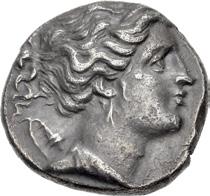


239. IONIA, Ephesos. Circa 340-325 BC. AR Oktobol (17mm, 4.83 g, 12h). Hegesipolis, magistrate. Draped bust of Aremis right, wearing stephane; bow and quiver over shoulder / Forepart of stag right, head left; palm tree to left, bee to inner right. SNG Kayhan 263; SNG von Aulock 1841. Deeply toned, some find patina, small delaminations, a little porosity. Good VF. ($750)
From the Wild Rose Collection. Ex Berk BBS 115 (2 August 2000), lot 281.
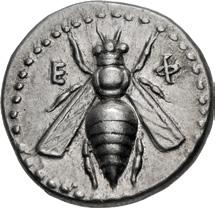
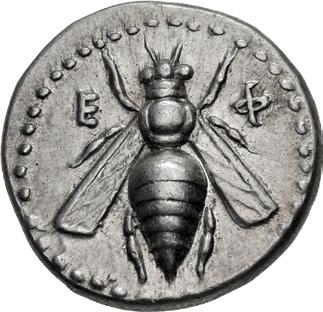
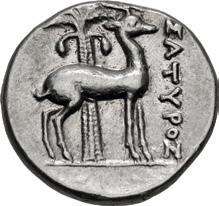
240. IONIA, Ephesos. Circa 202-150 BC. AR Drachm (18mm, 4.21 g, 11h). Satyros, magistrate. Bee / Stag standing right; palm tree in background. Kinns, Attic, p. 90, obv. die 46; SNG Copenhagen 298; BN Fonds général 496 (same obv. die). Lustrous. Near EF. ($750)

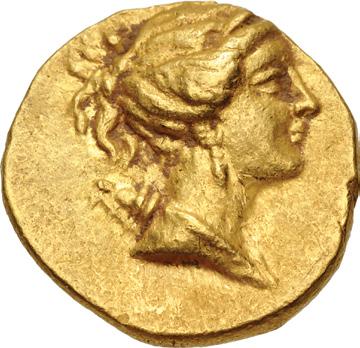
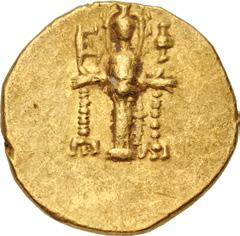
241. IONIA, Ephesos. Circa 123-119 BC. AV Stater (20mm, 8.37 g, 12h). Draped bust of Artemis right, wearing stephanos and single-pendant earring, hair drawn together and tied in the back, bow and quiver over shoulder / Cult statue of Artemis of Ephesos facing, arms outstretched horizontally at sides, fillet hanging from each; thymiaterion to inner right. Jenkins, Hellenistic, pl. B, 6 = BM 1896,0601.67 = Montagu I 567 (same dies); Head p. 69, 2–6 var. (control mark); Gulbenkian 985 var. (same); CNG E-460, lot 242 (same dies); Münzen und Medaillen AG 41, lot 191 (same dies). Deposits, struck with worn dies, minor marks. VF. Rare. ($3000)
73
Ex 1978 Pixodaros Hoard
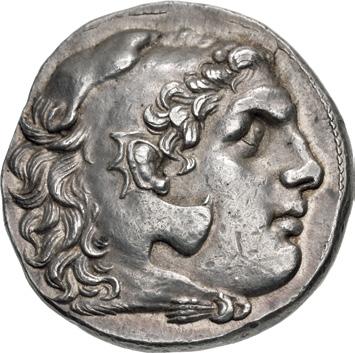
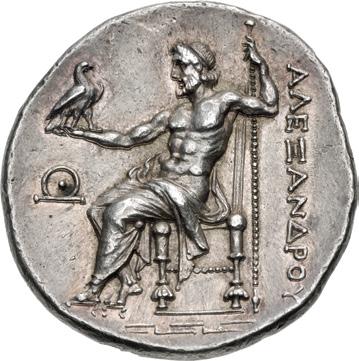
242. IONIA, Magnesia ad Maeandrum. Circa 280-270 BC. AR Tetradrachm (29mm, 17.22 g, 12h). In the name and types of Alexander III of Macedon. Head of Herakles right, wearing lion skin / Zeus Aëtophoros seated left; Ź in left field, maeander pattern in exergue. Vădan Group 1, dies 7/29, 2 (this coin); Price 2020. Toned, with reddish hues, minor marks, slight die shift on reverse, edge marks. Good VF. ($750)
From the Wild Rose Collection, purchased from Edward J. Waddell (inv. 53177), January 2017; Hess-Divo 327 (22 October 2014), lot 22; Classical Numismatic Auctions XVIII (3 December 1991), lot 66.
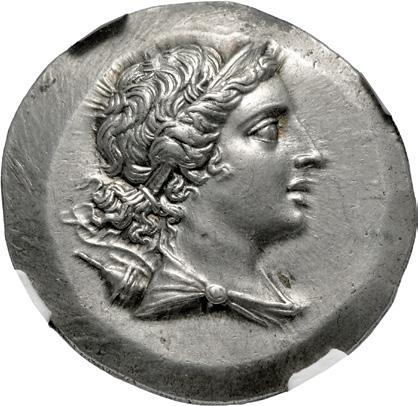
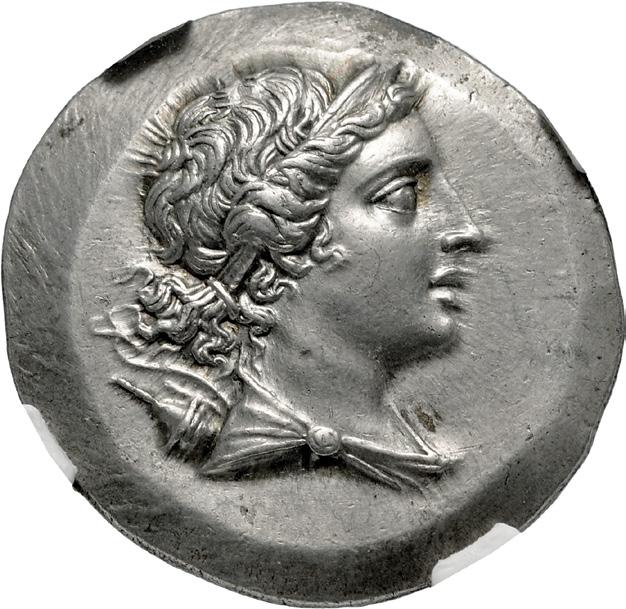
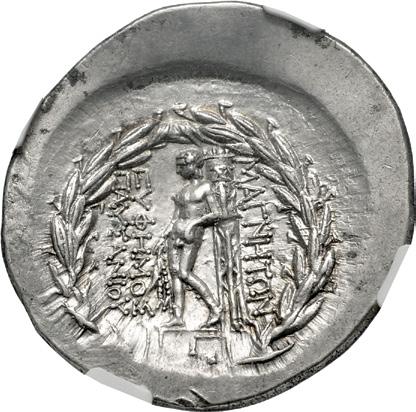
243. IONIA, Magnesia ad Maeandrum. Mid 140s BC. AR Tetradrachm (32mm, 16.76 g, 12h). Stephanophoric type. Euphemos, son of Pausanios, “magistrate”. Diademed and draped bust of Artemis right, bow and quiver over shoulder / Apollo standing left, elbow resting on tall tripod behind, holding a branch tied with fillet; meander pattern below; all within laurel wreath. Ellis-Evans, Wreathed, dies 10/EP18, 4 (this coin); Jones dies 9/c; ANS inv. 1977.158.353 (same dies). In NGC encapsulation 6655001-001, graded AU, Strike: 5/5, Surface: 4/5, Fine Style. ($2000)
Ex Palombo 19 (12 December 2020), lot 49; Palombo 16 (21 October 2017), lot 15.
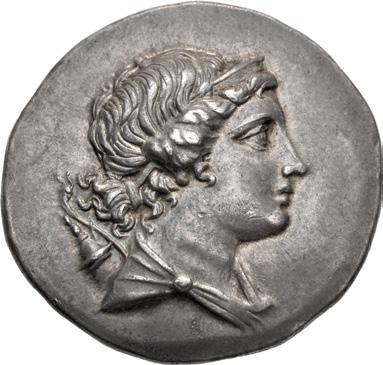
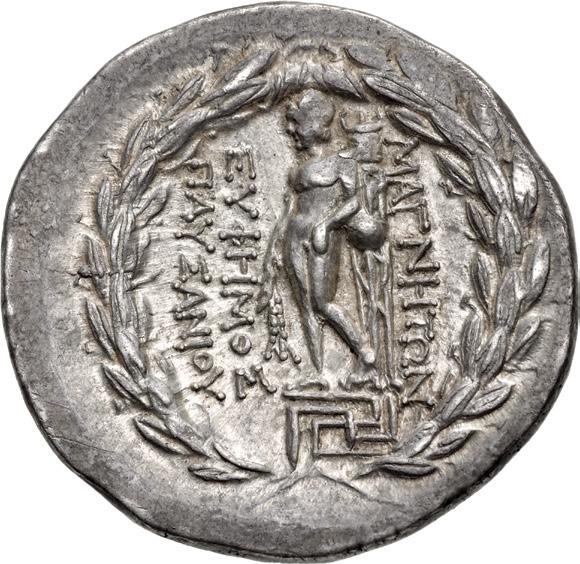
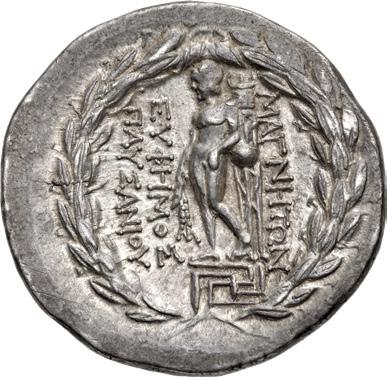
244. IONIA, Magnesia ad Maeandrum. Mid 140s BC. AR Tetradrachm (31.5mm, 16.84 g, 12h). Stephanophoric type. Euphemos, son of Pausanios, “magistrate”. Diademed and draped bust of Artemis right, bow and quiver over shoulder / Apollo standing left, resting on tall tripod to right, holding branch tied with fillet; meander pattern below; all within laurel wreath. Ellis-Evans, Wreathed, dies 19/EP24, 3 (this coin); Jones dies 13/a; E&E-Ö 65 (same obv. die). Toned, underlying luster. Near EF. ($1500)
From the Wild Rose Collection. Ex Cederlind 169 (20 May 2013), lot 122; Cederlind 166 (3 October 2012), lot 75; Cederlind 163 (28 February 2012), lot 96; Stack’s Bowers and Ponterio 164 (6 January 2012), lot 255; V. C. Vecchi 1 (with Schwer Coins, 13 May 1983), lot 69; Schweizerische Kreditanstalt FPL 28 (April 1979), no. 60; Schweizerische Kreditanstalt FPL 21 (December 1976), no. 60.
74
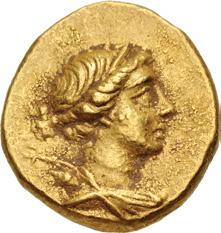

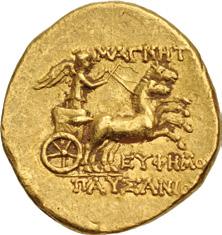
245. IONIA, Magnesia ad Maeandrum. Circa 125-120 BC. AV Stater (18mm, 8.44 g, 12h). Euphemos, son of Pausanias, “magistrate”. Draped bust of Artemis right, wearing stephanos, hair drawn together and tied in the back, bow and quiver over shoulder / Nike, holding kentron in right hand, reins in left, driving fast biga of horses right. A. Ellis-Evans, “The Wreathed Tetradrachms and Gold Staters of Magnesia on the Maeander” in A. Meadows & U. Wartenberg, Presebus: Studies in Ancient Coinage Presented to Richard Ashton (New York, 2021), fig. 2, A (same dies). Deposits, typical die rust on obverse. Near EF. ($3000)
Among the Rarest Issues of Miletos
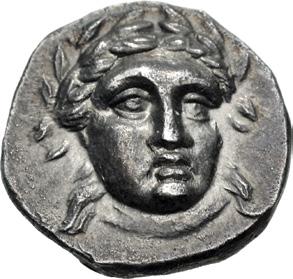
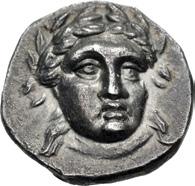
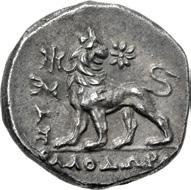
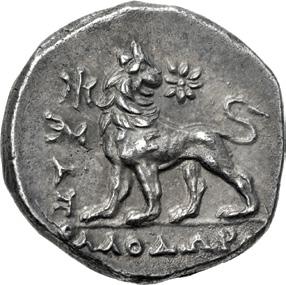
246. IONIA, Miletos. Circa 205 BC. AR Hemidrachm (15.5mm, 2.76 g, 11h). Persic standard. Apollodoros, magistrate. Laureate head of Apollo facing slightly right / Lion standing left, head right; star above; to left, ˇ (civic monogram) above \. Ashton & Kinns II pp. 11–2; D-L 634 (V2/R2); Marcellesi Series 37; Winterthur 6227. Lightly toned, slight die shift on reverse. EF. Extremely rare. ($750)
This facing head Apollo silver series is among the rarest from Miletos. At the time of Deppert-Lippitz’s study (1984), only two examples were known, both hemidrachms in the name of Apollodoros. Ashton & Kinns (2003) note a further two hemidrachms of Apollodoros, as well as two hemidrachms in the name of Menandros. Over the following two decades, another hemidrachm of Menander appeared (Roma E-26, lot 212), and the first drachm in the series, also in the name of Menander (Roma XI, lot 298). This coin is the first example of an issue of Apollodoros to be available on the market since Aufhäuser 17 sale in 2003.
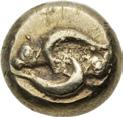
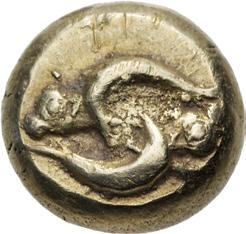
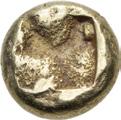
247. IONIA, Phokaia. Circa 521-478 BC. EL Hekte – Sixth Stater (10mm, 2.52 g). Two seals, belly-to-belly, swimming in opposite directions / Quadripartite incuse square. Bodenstedt Em. 46. Scrapes and scratches, die rust on obverse, marks on edge. VF. ($750)
Ex Roma XXI (24 March 2021), lot 183.

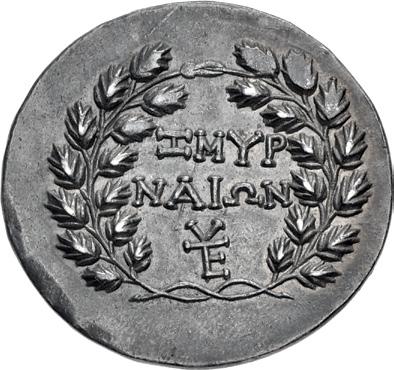
248. IONIA, Smyrna. Circa 150-143 BC. AR Tetradrachm (32.5mm, 16.60 g, 12h). Stephanophoric type. Eut–(?), magistrate. Turreted head of Tyche right / Ethnic and W within laurel wreath. Milne, Silver –; Milne, Autonomous 156; SNG von Aulock –; SNG Copenhagen –; BMC –; SNG Lewis 948. Dark find patina, hairline on obverse. Near EF. ($2000)
From the Wild Rose Collection, purchased from Shanna Schmidt, June 2017. Ex Gemini XIII (6 April 2017), lot 75; Lanz 160 (15 June 2015), lot 221.
75
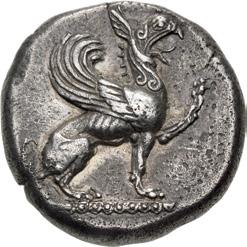
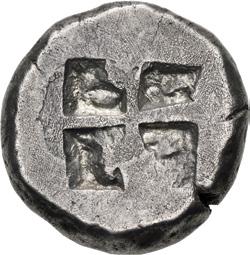
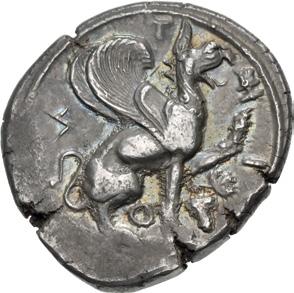
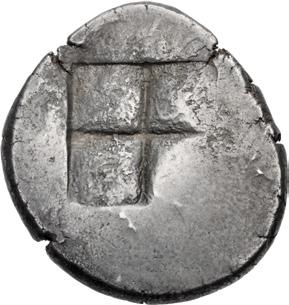
249. IONIA, Teos. Late 6th-early 5th century BC. AR Stater (20mm, 11.74 g). Griffin seated right, raising forepaw / Quadripartite incuse square. Matzke Series Bc1; Balcer Group I; SNG von Aulock 2252. Toned, some granularity and pitting. Good VF. Well centered on a broad flan. ($2000)
From the Wild Rose Collection, purchased from Shanna Schmidt, 28 May 2020. Ex Wilhelmstrasse Collection (Nomos 17, 26 October 2018), lot 178.
250. IONIA, Teos. Circa 450-425 BC. AR Stater (24mm, 11.90 g). Griffin seated right, raising forepaw; grape bunch and leaf to lower right / Quadripartite incuse square. Matzke Series Cb1; Balcer Group LIII, 102 (A102/P134); Jameson 1517 (same dies). Deep iridescent tone, minor edge splits, some weakness to strike. Good VF. ($1000)
From the Mesogeios Collection, purchased from James E. Beach.
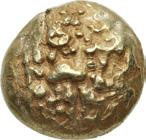
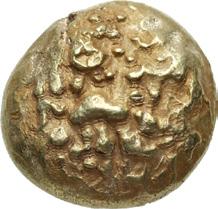

251. IONIA, Uncertain. Circa 650-600 BC. EL Trite – Third Stater (12mm, 4.64 g). Lydo-Milesian standard. Globular surface with cluster of pellets / Two incuse squares. Weidauer –; Artemision –; Traité I 3; SNG Kayhan –; SNG von Aulock 7761. Minor doubling. As made. ($1000)
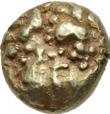


252. IONIA, Uncertain. Circa 650-600 BC. EL Hekte – Sixth Stater (9.5mm, 2.27 g). Lydo-Milesian standard. Globular surface with cluster of pellets / Two incuse squares. Weidauer –; Artemision –; Traité I –; SNG Kayhan –; SNG von Aulock –; Elektron 10. As made. Very rare as a hekte. ($750)
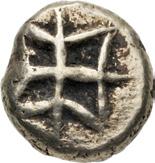
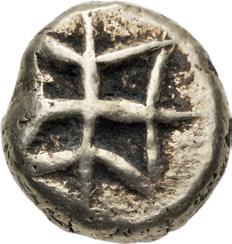
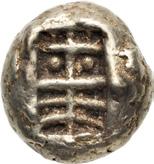
253. IONIA, Uncertain. Circa 625-600 BC. EL Trite – Third Stater (12mm, 4.56 g). Lydo-Milesian standard. Geometric figure resembling a star, composed of a cross centered upon a polygon of eight sides / Rectangular incuse divided horizontally and vertically into four compartments by two perpendicular lines; the upper two compartments divided into halves by a single line, the upper halves each containing a pellet, the lower halves bisected by two small vertical lines; the lower two compartments divided into thirds by two parallel lines. McFadden 1; Konuk & Lorber fig. 14; Elektron I 16; Rosen Sale 12; Traité –; Zhuyuetang 2; SNG von Aulock –; SNG Copenhagen (Cyprus, etc.), pl. 10, 318; SNG Kayhan 697. Deposits. Good VF. ($2000)
From the GS Collection.
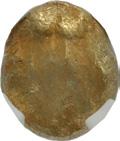
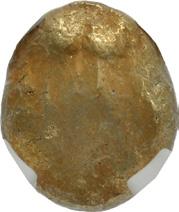
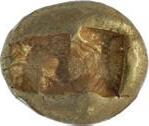
254. IONIA, Uncertain. Circa 600-550 BC. EL Hekte - Sixth Stater (8mm, 2.35 g). Lydo-Milesian standard. Carapace of scarab beetle / Two incuse squares. Weidauer –; Artemision –; Traité –; SNG Kayhan –; cf. Konuk & Lorber 36 = Linzalone 1110 (trite, patterned incuses; “ram”); CNG 81, lot 534. In NGC encapsulation 5872782-032, graded Ch AU, Strike: 4/5, Surface: 4/5. Very rare. ($750)
76
249 250



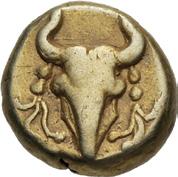
255. IONIA, Uncertain. 5th century BC. EL Hemihekte(?) – Twelfth Stater (7mm, 0.97 g, 5h). Uncertain standard. Siren standing right, right hand playing tympanon it holds in its left hand / Facing boukranion with fillet hanging from each horn. Weidauer –; Traité –; SNG Kayhan –; SNG von Aulock –; Elektron –; Rosen 369. Faint cleaning marks. VF. Well centered. Extremely rare. ($1000)
Unique
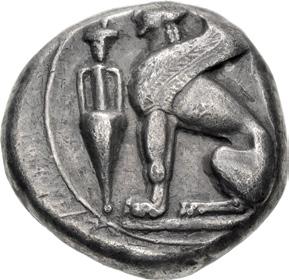


256. ISLANDS off IONIA, Chios. Circa 380-350 BC. AR Tetradrachm (23.5mm, 14.74 g, 3h). Ammonios, magistrate. Sphinx seated left; to left, grape bunch above amphora; all on shallow convex surface / Quadripartite incuse square, with striated quarters and thick bands; ÅÂÂW@5os on horizontal band. Cf. Mavrogordato 49 (unlisted magistrate); HGC 6, 1116 var. (unlisted magistrate). Toned, some find patina, scratches and cleaning marks under tone, a little off center. VF. Unpublished and unique with this magistrate. ($1000)
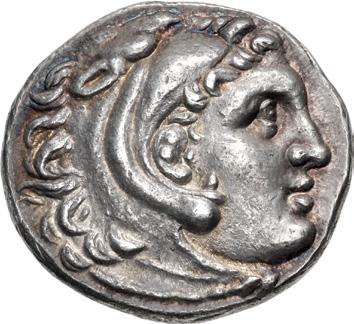

257. ISLANDS off IONIA, Chios. Circa 270-220 BC. AR Tetradrachm (29.5mm, 17.02 g, 12h). In the name and types of Alexander III of Macedon. Head of Herakles right, wearing lion skin / Zeus Aëtophoros seated left; in left field, sphinx seated left above Z; ∏ below throne. Bauslaugh, Posthumous, Series 27, dies 36/72 (obv. die unlisted for series, but known for Series 28); Price 2358; HGC 6, 1132. Iridescent tone. EF. Well centered on a broad flan. Extremely rare, only one example noted by Bauslaugh, one additional in Pella (from the same dies), none in CoinArchives, nor the ANS photofile. ($500)
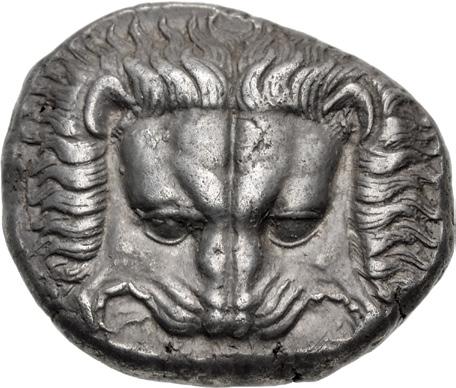
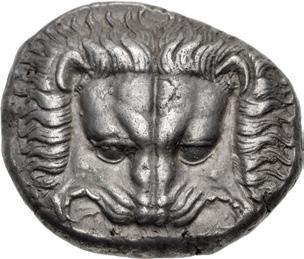
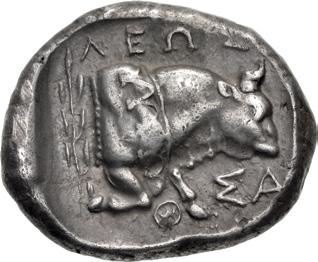
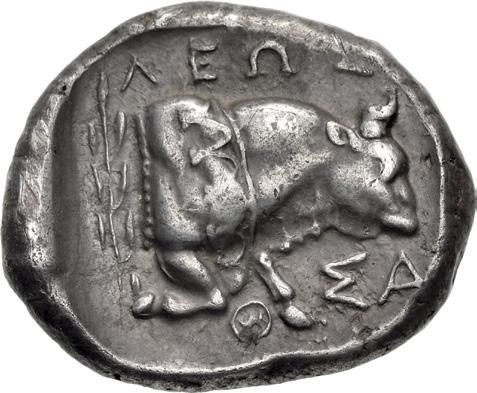
258. ISLANDS off IONIA, Samos. Circa 408/4-380/66 BC. AR Tetradrachm (24.5mm, 15.18 g, 5h). Leos, magistrate. Facing lion scalp / Forepart of bull right; olive branch to left, g below; all within shallow incuse square. Barron Class X, 134 (A63/P128); HGC 6, 1218; Weber 6305 (same dies). Old cabinet tone, minor die wear on reverse. Good VF. ($4000)
From the Wild Rose Collection. Ex MPM Collection (Numismatica Ars Classica 92, 23 May 2016), lot 218, reportedly purchased privately in 1928.
77

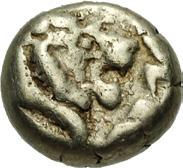

259. KINGS of LYDIA. Alyattes. Circa 620/10-564/53 BC. EL Hemihekte – Twelfth Stater (7.5mm, 1.12 g). LydoMilesian standard. Sardes mint. Head of roaring lion right; [eÒ]√Òå[√] (WALWEL in retrograde Lydian) downward to right / Incuse square. Weidauer Group XVII, 111–2; Kurth G20; cf. SNG Ashmolean 756 (hekte). Some faint scratches, usual minor die wear on obverse. VF. ($750)
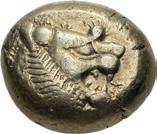
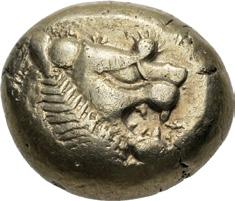
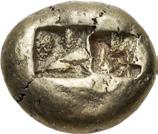
260. KINGS of LYDIA. temp. Alyattes – Kroisos. Circa 620/10-550/39 BC. EL Trite – Third Stater (12mm, 4.74 g). Lydo-Milesian standard. Sardes mint. Head of roaring lion right; sun with multiple rays on forehead / Two incuse squares. Weidauer Group XVI, 89; Kurth G26; SNG Ashmolean 749–51. Minor marks. Good VF. ($1000)
From the Wild Rose Collection. Ex Lanz 156 (2 June 2013), lot 209.
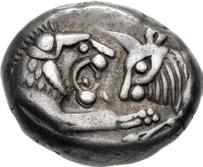

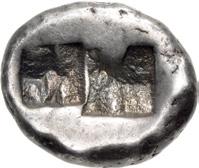
261. KINGS of LYDIA. temp. Cyrus – Darios I. Circa 550/39-520 BC. AR Siglos (16.5mm, 5.35 g). Sardes mint. Confronted foreparts of lion and bull / Two incuse squares. Berk 22; Kurth S11; SNG Ashmolean 762–71. Old collection tone. VF. Well centered. ($750)
From the Wild Rose Collection, purchased from Ancient Numismatic Enterprise, November 2012. Ex Numismatic Fine Arts IV (24 March 1977), lot 320.


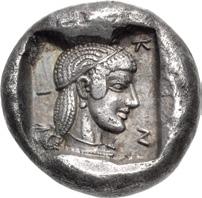
262. CARIA, Knidos. Circa 465-449 BC. AR Drachm (16mm, 6.20 g, 3h). Forepart of roaring lion right / Head of Aphrodite right, wearing stephanos, within incuse square. Cahn Series IV, 83 (V39/R58); HN Online 666; SNG Copenhagen 240–1 (same dies); BMC 14 (same dies); Boston MFA 1985–6 (same dies); McClean 8473 (same dies); Pozzi 2585–6 (same dies); Weber 6470–1 (same dies). Toned, off center on obverse. Good VF. Fine style. ($1000)
From the Mesogeios Collection. Ex Classical Numismatic Group 121 (6 October 2022), lot 407; Mark and Lottie Salton Collection (Part I, Stack’s Bowers Galleries, 14 January 2022), lot 4340.
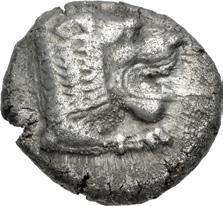
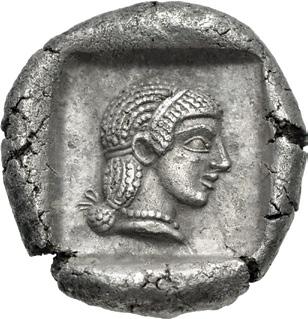
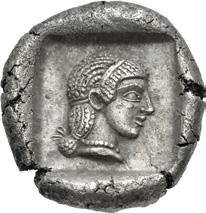
263. CARIA, Knidos. Circa 449-411 BC. AR Drachm (18mm, 6.22 g, 8h). Forepart of roaring lion right / Head of Aphrodite right, wearing stephanos, within incuse square. Cahn Series V, 86A–8 (V41/R– [unlisted rev. die]); HN Online 610. Some granularity, struck with worn obverse die. Near EF. Well centered, with a fine archaized portrait of Aphrodite. ($1500)
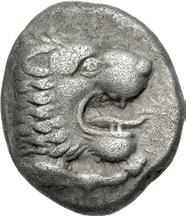

264. CARIA, Knidos. Circa 411-405/4 BC. AR Drachm (15mm, 6.06 g, 3h). Forepart of lion roaring right / Head of Aphrodite right, hair in sphendone, within incuse square. Cahn Series VI.1, 92 (V45/R63); HN Online 302; SNG Ashmolean 84 (same dies). Lightly toned, granular surfaces. Good VF. Well centered. ($1000)
78
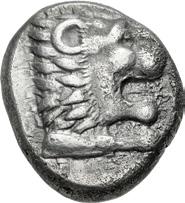
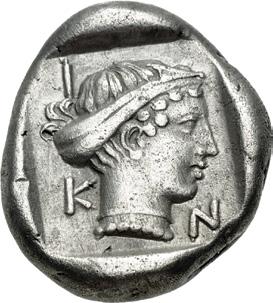

265. CARIA, Knidos. Circa 411-405/4 BC. AR Drachm (15mm, 5.97 g, 6h). Forepart of lion roaring right / Head of Aphrodite right, hair in band, within incuse square. Cahn Series VI.2, 112 (V56/R74); HN Online 478. Light granularity, some roughness on obverse. Good VF. ($1000)
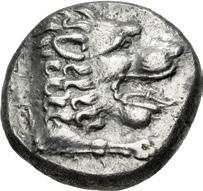
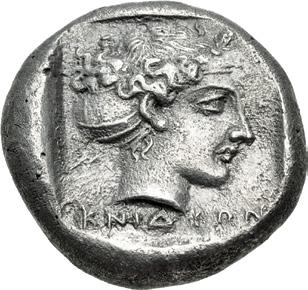

266. CARIA, Knidos. Circa 411-405/4 BC. AR Drachm (16mm, 6.03 g, 12h). Forepart of lion roaring right / Head of Aphrodite right, hair in sphendone and ampyx, within incuse square. Cahn Series VI.2, 121 (V62/R82); HN Online 304; SNG Copenhagen 257 (same dies); SNG von Aulock 2600 = Pozzi 2588 (same dies); de Luynes 2500 (same dies). Trace deposits, a little die wear. Good VF. Attractive style. ($1000)
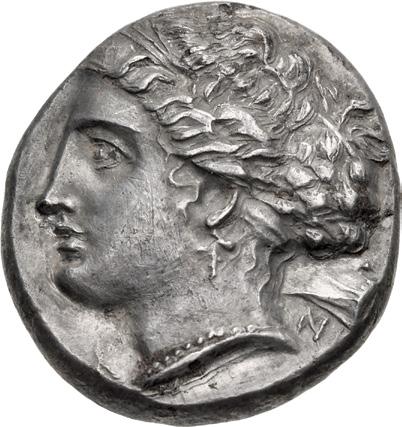
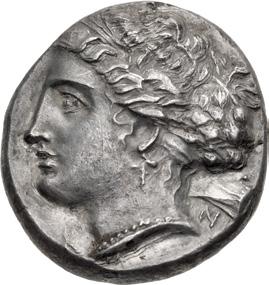
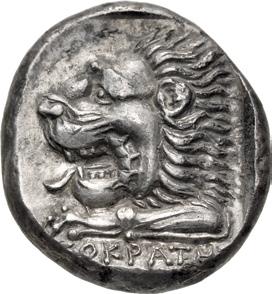
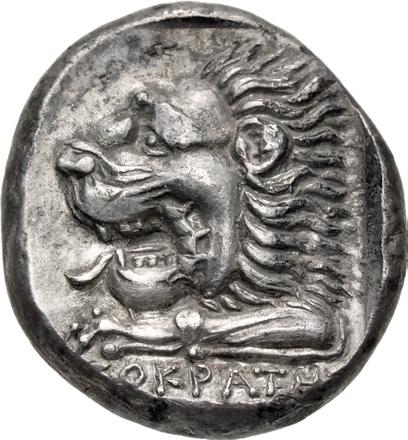
267. CARIA, Knidos. Circa 395-380 BC. AR Tetradrachm (21.5mm, 14.48 g, 12h). Kleokrates, magistrate. Head of Aphrodite left, hair in ampyx and sphendone; behind neck, prow left / Forepart of lion left within incuse square. Hecatomnus 4b (A4/P3 – this coin); HNO –; SNG Keckman –. Lightly toned, minor scratches on obverse. EF. Extremely rare, one of only three examples known with this magistrate. ($3000)
From the Wild Rose Collection. Ex Classical Numismatic Review XLVII.1 (Winter 2022), no. 5591384; Stack’s Bowers Galleries (16 August 2021), lot 43062; Superior (6 December 1991), lot 469; Superior (31 May 1988), lot 1528.
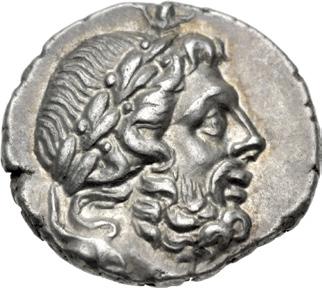



268. CARIA, Myndos. Mid 2nd century BC. AR Drachm (17mm, 3.86 g, 12h). Demophon, magistrate. Laureate head of Sarapis right / Headdress of Isis set on two grain ears; horizontal torch below. Myndos 20 (A5/P– [unlisted rev. die]); HN Online 737. Attractively toned, underlying luster. EF. ($500)
From the Wild Rose Collection. Ex Künker 333 (16 March 2020), lot 308; Münzen & Medaillen GmbH 38 (5 June 2013), lot 47; Tkalec (29 February 2000), lot 145.
79
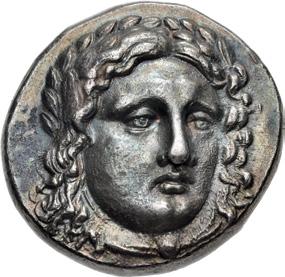
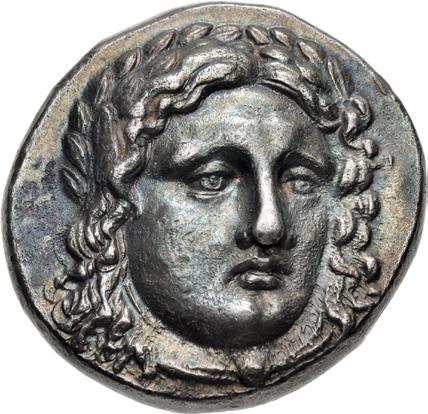
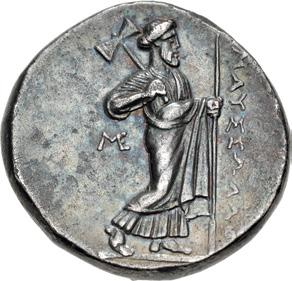
269. SATRAPS of CARIA. Maussolos. Circa 377/6-353/2 BC. AR Tetradrachm (23mm, 15.13 g, 12h). Chian standard. Halikarnassos mint. Struck circa 370-360 BC. Laureate head of Apollo facing slightly right, drapery around neck / Zeus Labraundos standing right; m to left. Konuk, Identities 21; HN Online 227; SNG von Aulock 2358 (same obv. die). Deep iridescent tone. Near EF. Well centered. ($2000)
From the Wild Rose Collection. Ex Triton XX (10 January 2017), lot 306.
Exceptional Specimen from the Pixodarus Hoard
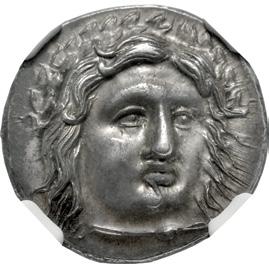
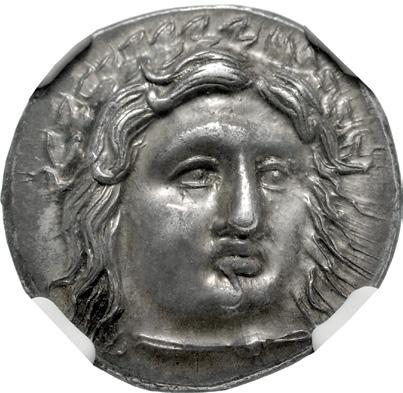
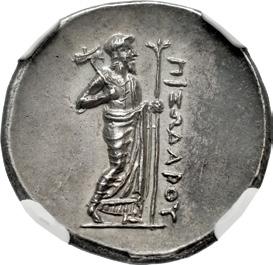
270. SATRAPS of CARIA. Pixodaros. Circa 341/0-336/5 BC. AR Didrachm (20mm, 6.91 g, 12h). Halikarnassos mint. Head of Apollo facing slightly right, wearing laurel wreath, drapery around neck / Zeus Labraundos standing right. Pixodarus 25h (A3/P11 – this coin); Konuk, Identities 30; HN Online 2216; SNG München 15 (same dies); Weber 6608 (same dies). In NGC encapsulation 6156139-005, graded Ch AU, Strike: 5/5, Surface: 5/5, Fine Style. ($4000)
Ex Classical Numismatic Group 121 (6 October 2022), lot 421; Classical Numismatic Group 117 (19 May 2021), lot 240; Künker 333 (16 March 2020), lot 823; Gasvoda Collection (Triton XXII, 9 January 2019) lot 270; CNG inventory 995859 (January 2015); Numismatica Ars Classica 78 (26 May 2014), lot 318; Roma VI (29 September 2013), lot 656; Leu 91 (10 May 2004), lot 173; Peus 343 (26 April 1995), lot 150; Pixodarus Hoard (CH IX, 421).
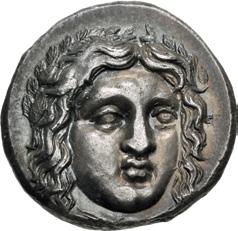

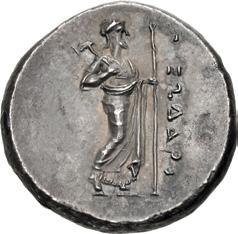
271. SATRAPS of CARIA. Pixodaros. Circa 341/0-336/5 BC. AR Didrachm (19.5mm, 6.97 g, 12h). Halikarnassos mint. Laureate head of Apollo facing slightly right, drapery around neck / Zeus Labraundos standing right. Konuk, Identities 30; HN Online 241. Toned, some find patina. Near EF. Well centered. ($750)
From the W. Hansen Collection, purchased from Ancient Numismatic Enterprise, 3 March 2012. Ex CNG inventory 906224 (November 2011).
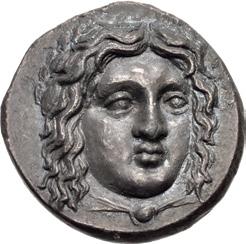

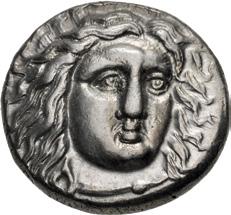
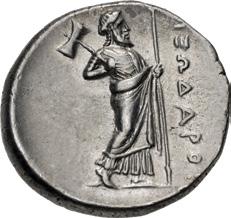
272. SATRAPS of CARIA. Pixodaros. Circa 341/0-336/5 BC. AR Didrachm (20mm, 6.20 g, 11h). Halikarnassos mint. Laureate head of Apollo facing slightly right, drapery around neck / Zeus Labraundos standing right. Konuk, Identities 30; HN Online 241. Deeply toned, some find patina, slight roughness on reverse. Near EF. Well centered. ($500)
From the Wild Rose Collection, purchased from Shanna Schmidt, August 2017. Ex Banque Populaire du Nord FPL [32] (June 1984), no. 129; Kricheldorf XXXVI (4 December 1982), lot 72; Lanz 22 (10 May 1982), lot 395.
273. SATRAPS of CARIA. Pixodaros. Circa 341/0-336/5 BC. AR Didrachm (19mm, 6.94 g, 12h). Halikarnassos mint. Laureate head of Apollo facing slightly right, drapery around neck / Zeus Labraundos standing right. Konuk, Identities 30; HN Online 241. Underlying luster, a little die rust on obverse. Good VF. ($500)
80
272
273
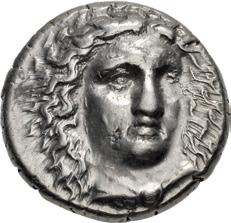
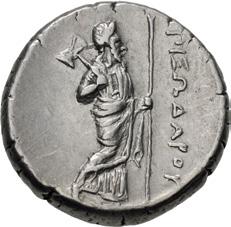
274. SATRAPS of CARIA. Pixodaros. Circa 341/0-336/5 BC. AR Didrachm (19mm, 6.99 g, 1h). Halikarnassos mint. Laureate head of Apollo facing slightly right, drapery around neck / Zeus Labraundos standing right. Konuk, Identities 30; HN Online 241. Struck with worn obverse die, a few tiny flan flaws on obverse. Good VF. Well centered. ($500)


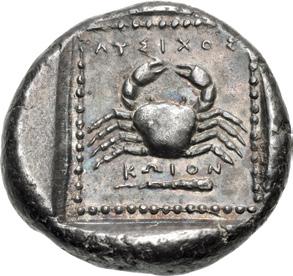
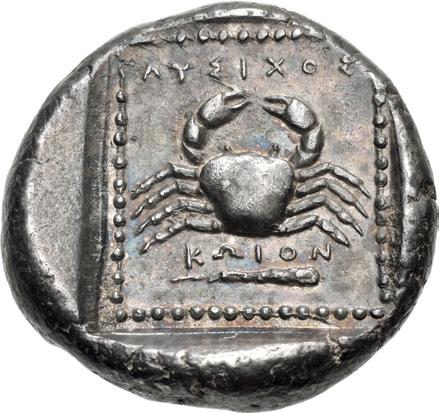
275. ISLANDS off CARIA, Kos. Circa 400-385 BC. AR Tetradrachm (22.5mm, 14.82 g, 8h). Lysichos, magistrate. Bearded head of Herakles left, wearing lion skin / Crab; club below; all in dotted square within incuse square. Stefanaki Series IV, Issue 7, 153–60; HGC 6, 1301. Toned, a few light marks. Good VF. ($2000)
From the Wild Rose Collection. Ex New York Sale XLIII (10 January 2018), lot 215; Classical Numismatic Group 105 (10 May 2017), lot 378.
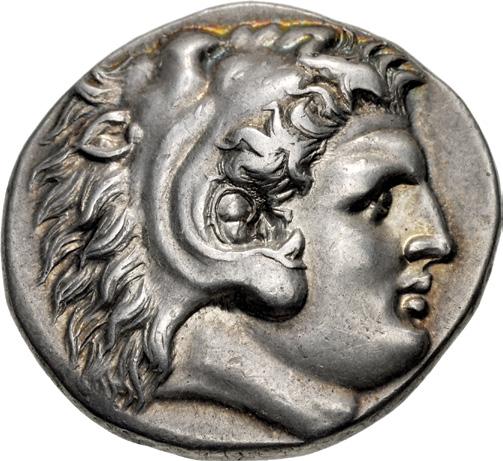
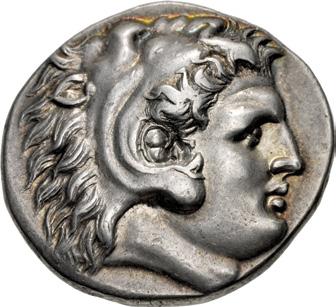

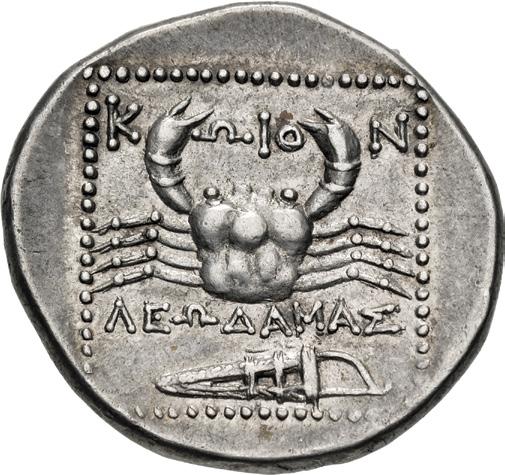
276. ISLANDS off CARIA, Kos. Circa 280-250 BC. AR Tetradrachm (28mm, 15.16 g, 12h). Leodamas, magistrate. Head of Herakles right, wearing lion skin / Crab; ˚W5o@ above; below, ¬EWdÅÂÅ% above bow-in-bowcase; all within dotted square. Requier Group III, 40 (D8/R34); Stefanaki Series VII, Issue 17, 821–2 (same dies); HGC 6, 1308; SNG Copenhagen 627; SNG Delepierre 2729. Lightly toned. Near EF. Well centered on a broad flan. Struck from artistic dies. ($5000)
From the Wild Rose Collection. Ex Classical Numismatic Review XLV.2 (Summer 2020), no. 531921; Triton XXIII (14 January 2020), lot 437.
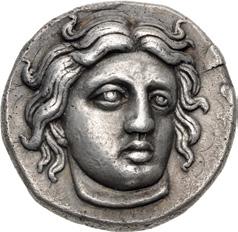
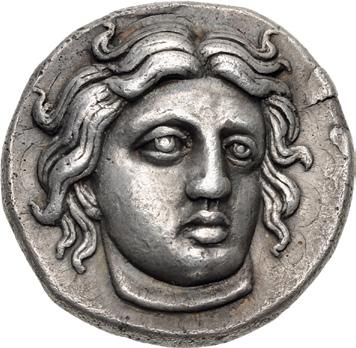
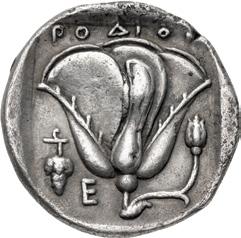
277. ISLANDS off CARIA, Rhodos. Rhodes. Circa 340-316 BC. AR Didrachm (19.5mm, 6.88 g, 12h). Chian standard. Head of Helios facing slightly right / Rose with bud to right; grape bunch and E to left; all within incuse square. Ashton 98; HN Online 813; HGC 6, 1433. Old collection tone, trace deposits, a few pits, slight doubling on obverse. Good VF. ($1500)
From the Wild Rose Collection, purchased from Shanna Schmidt, 16 March 2020. Ex G. Hirsch 355 (12 February 2020), lot 1800 (hammer €3200); Leu 76 (17 October 1999), lot 196.
81


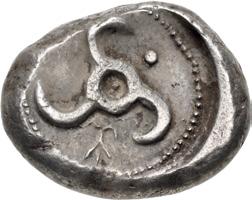
278. DYNASTS of LYCIA. Khinakha(?). Circa 440/30-400 BC. AR Stater (19.5mm, 9.84 g). Uncertain mint (possibly Limyra). Pegasos flying left; pellet below; all on raised round shield / Triskeles with central pellet; conjoined ᛉ and diskeles in one section, pellet in another; in pelleted circle within circular incuse. Müseler IV, 79–80 var. (no pellet on obv.; same rev. die); Falghera –; SNG Copenhagen Supp. –; SNG von Aulock 4089 var. (no controls on rev.; same obv. die). Lightly toned, light deposits. VF. ($500)
From the Wild Rose Collection. Ex Gorny & Mosch 233 (6 October 2015), lot 1693.
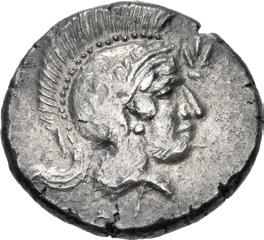
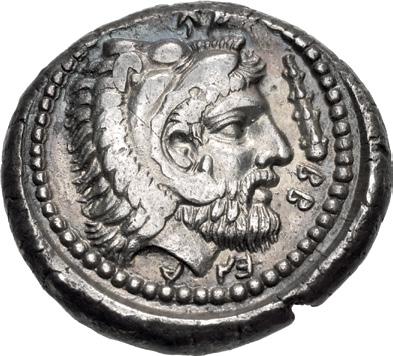

279. DYNASTS of LYCIA. Erbbina. Circa 390-380 BC. AR Stater (21.5mm, 8.54 g, 6h). Telmessos mint. Helmeted head of Athena right; i at forehead / Head of Herakles right, wearing lion skin; club to right; dotted circular border. Mørkholm & Zahle II 70; Müseler VI, 88 (same dies); Falghera 183/184 (for obv./rev. dies); SNG Copenhagen Supp. 462 var. (symbol on rev.; same obv. die). Iridescent tone, struck with worn obverse die. Good VF. ($500)
From the Mesogeios Collection. Ex Gorny & Mosch 269 (9 March 2020), lot 462; G. Hirsch 275 (22 September 2011), lot 3933; G. Hirsch 145 (27 February 1984), lot 114; Numismatic Fine Arts VII (6 December 1979), lot 234.
Pedigreed to 1960
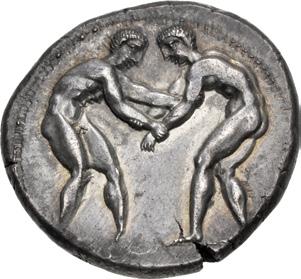
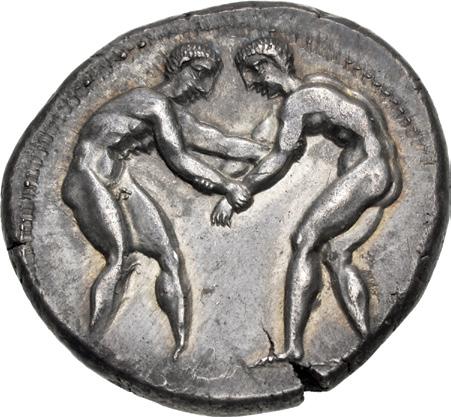
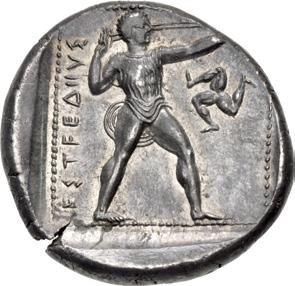
280. PAMPHYLIA, Aspendos. Circa 400-380 BC. AR Stater (25mm, 10.90 g, 11h). Two wrestlers grappling / Slinger in throwing stance right; counterclockwise triskeles to right; all within pelleted square border. Tekin Series 3; SNG BN 53. Old collection tone, with iridescence around the devices, minor edge split. EF. ($1500)
From the Wild Rose Collection. Ex Roma XVIII (29 September 2019), lot 644 (hammer £2800); Giessener Münzhandlung 60 (5 October 1992), lot 232; Münzen und Medaillen AG 32 (20 October 1960), lot 133.
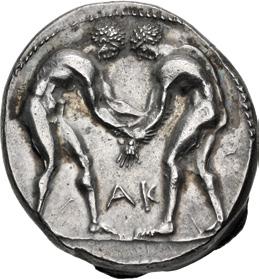
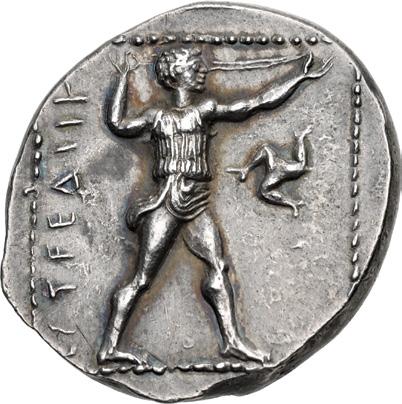
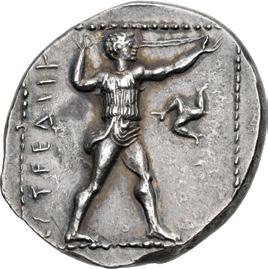
281. PAMPHYLIA, Aspendos. Circa 380/75-330/25 BC. AR Stater (21mm, 11.01 g, 12h). Two wrestlers grappling; Å˚ between / Slinger in throwing stance right; triskeles to right; all within pelleted square border. Tekin Series 4; SNG BN 84; SNG Von Aulock 4561 (same obv. die). Light iridescent tone, trace deposits. Good VF. ($750)
82
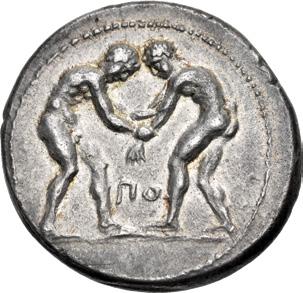
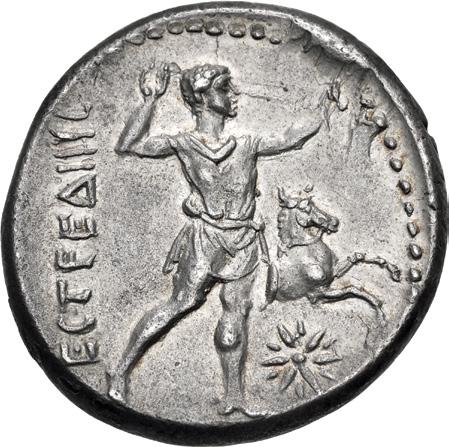
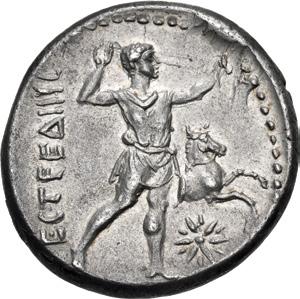
282. PAMPHYLIA, Aspendos. Circa 330/25-300/250 BC. AR Stater (25mm, 10.46 g, 1h). Two wrestlers grappling; ∏o between / Slinger in throwing stance right; to right, forepart of horse right above star; all within pelleted circular border. Tekin Series 5; SNG BN 114. Toned, with faint iridescence around the devices, area of die wear on reverse. Near EF. ($1000)
From the Wild Rose Collection. Ex CNG inventory 576836 (July 2021); Sheik Saud Al Thani Collection (Part II, Numismatica Ars Classica 123, 9 May 2021), lot 766 (hammer CHF 1800); Roma II (2 October 2011), lot 319.
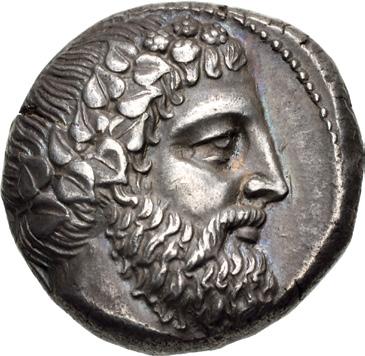
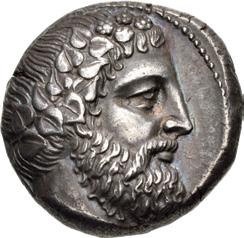
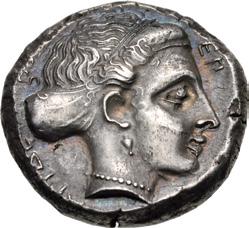
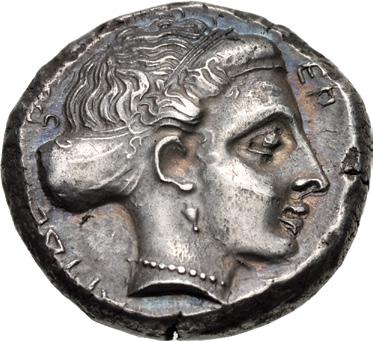
283. CILICIA, Nagidos. Circa 380 BC. AR Stater (19.5mm, 10.66 g, 8h). Head of Dionysos right, wearing ivy wreath / Head of Aphrodite right, hair bound in sphendone; [[@]Å˝5dE[W@] behind neck, Eπ to upper right. Casabonne Type 7; Lederer 14; SNG BN –; SNG Levante 2 (same dies); Boston MFA 2120 (same dies); Jameson 2327 = Pozzi 2827 (same dies); McClean 9070 (same dies). Toned. EF. Splendid portrait of Dionysos. ($5000)
From the Wild Rose Collection. Ex Leu Numismatik 7 (24 October 2020), lot 1301 (hammer CHF 9000); Triton XX (10 January 2017), lot 324; Numismatica Ars Classica 84 (21 May 2015), lot 681; Numismatica Ars Classica 54 (24 March 2010), lot 133.
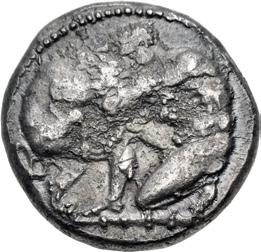
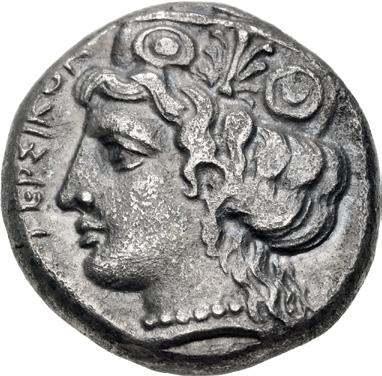
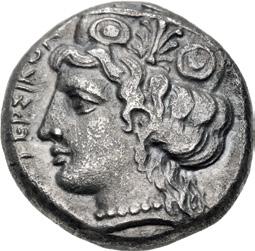
284. CILICIA, Tarsos. Circa 389-375 BC. AR Stater (21mm, 10.40 g, 9h). Herakles wrestling the Nemean Lion; club below / Head of Hera left, wearing stephanos decorated with palmette between two circles containing large pellets. Casabonne Group J1; SNG BN 235; SNG Levante 63. Toned, struck with worn obverse die, scratch on obverse, light roughness on reverse. VF. ($1000)
From the Hesiod Collection. Ex Heritage 3103 (7 December 2022), lot 35026.

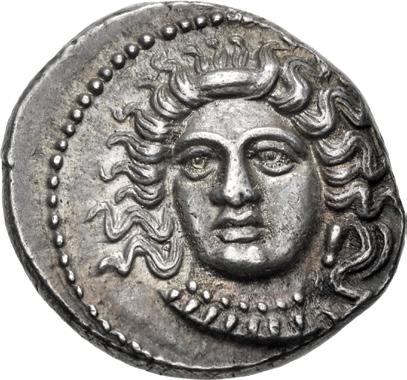
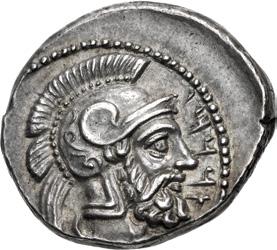
285. CILICIA, Tarsos. Tarkumuwa (Datames). Satrap of Cilicia and Cappadocia, 384-361/0 BC. AR Stater (22mm, 10.98 g, 5h). Struck circa 380 BC. Female head facing slightly left, hair in ampyx, wearing necklace / Bearded male head (Ares?) right, wearing crested Attic helmet. Casabonne Type 1; Moysey Issue 4; SNG BN 258-70; SNG Levante 79. Attractive old iridescent tone, a little off center, a touch of die rust on obverse. Near EF. ($500)
83
Ex Sheikh Al Thani Collection
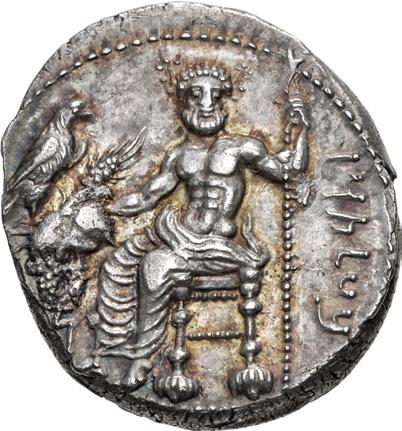
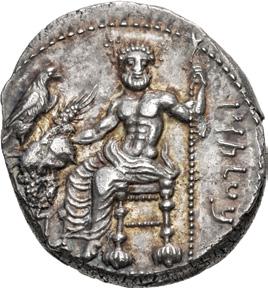

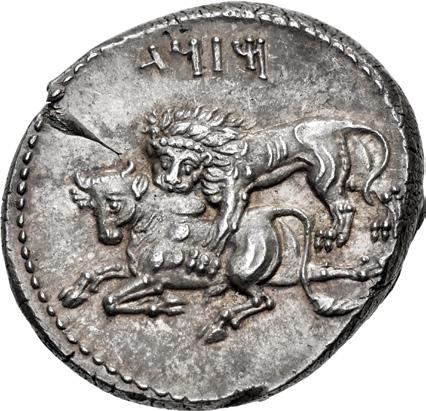
286. CILICIA, Tarsos. Mazaios. Satrap of Cilicia, 361/0-334 BC. AR Stater (22mm, 11.00 g, 11h). Baal of Tarsos seated left, head and torso facing, holding eagle, grain ear, grape bunch and lotus-tipped scepter; n (N in Aramaic) to lower left / Lion attacking bull left. Casabonne Series 2, Group C; SNG BN –; SNG Levante 100. Attractive iridescent tone, underlying luster, a few die breaks on obverse, minor flan flaw on reverse. EF. ($1000)
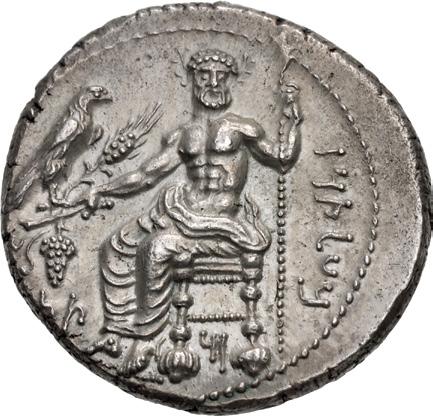


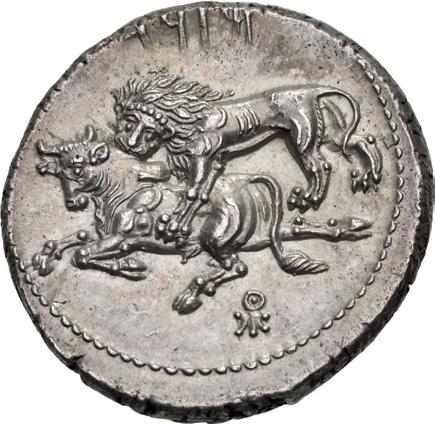
287. CILICIA, Tarsos. Mazaios. Satrap of Cilicia, 361/0-334 BC. AR Stater (24mm, 10.76 g, 7h). Baal of Tarsos seated left, head and torso facing, holding eagle, grain ear, grape bunch and lotus-tipped scepter; rt (TN in Aramaic) to left, M (M in Aramaic) below throne / Lion attacking bull left; å below. Casabonne Series 2, Group C; SNG BN –; SNG Levante 106. Lightly toned, slightly off center. EF. ($1000)
From the Wild Rose Collection, purchased from Calgary Coin Gallery, August 2015.
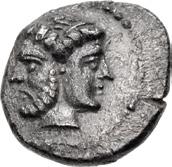
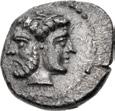
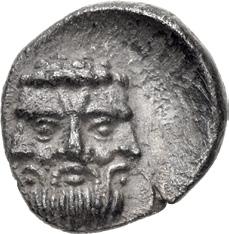
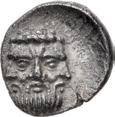
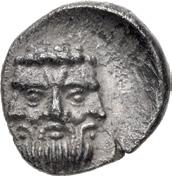
of Bes. Göktürk 37; SNG BN –; SNG Levante 201–2. Find patina, slightly off center. EF. ($500)
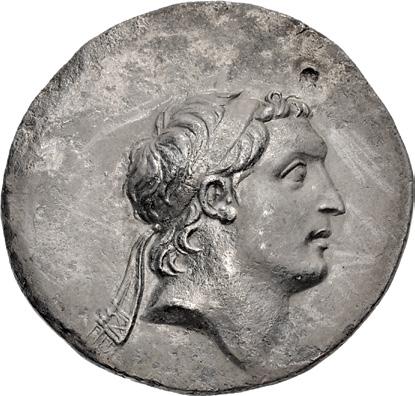
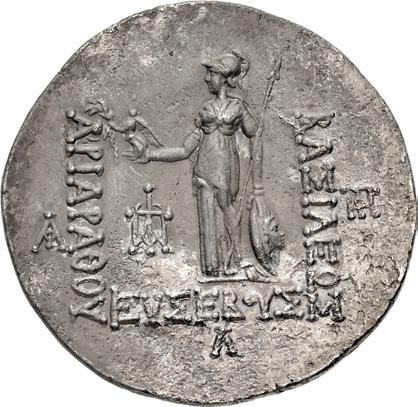
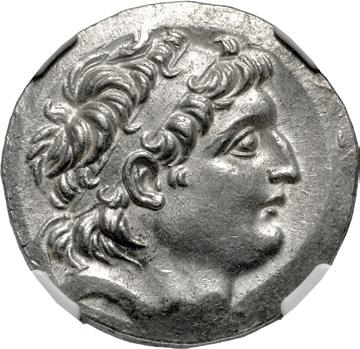
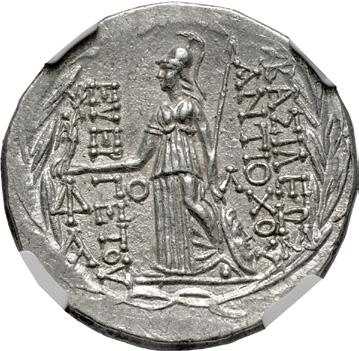
289. KINGS of CAPPADOCIA. Ariarathes V Eusebes Philopator. Circa 163-130 BC. AR Tetradrachm (34.5mm, 16.01 g, 12h). Mint A (Eusebeia-Mazaca). Dated RY 30 (133/2 BC). Diademed head right / Athena Nikephoros standing left; T to outer left, U to inner left, ] to outer right, ¬ (date) in exergue. Simonetta 4 (Ariarathes IV; same obv. die as illustration); HGC 7, 810; DCA2 518; SNG von Aulock 6263 (same obv. die). Toned, some find patina, roughness, a few marks, flan flaw in field on obverse. Good VF. ($1500)
From the Mesogeios Collection. Ex Edgar L. Owen inventory 11518 (ND); Freeman & Sear inventory G12519 (ND).
290. KINGS of CAPPADOCIA. Ariarathes VII Philometor. Circa 107/6-101/0 BC. AR Tetradrachm (27mm, 16.54 g, 12h). In the name and types of Antiochos VII of Syria. Mint A (Eusebia-Mazaka). Struck circa 107/6-104/3 BC. Diademed head right / Athena Nikephoros standing left; : above & to outer left, o to inner left, ¬ to inner right; all within laurel wreath. Lorber & Houghton Series 1, Issue 3, 85–97 (obv. die A3); SC 2148; HGC 7, 829; HGC 9, 1069 (Antiochos VII). In NGC encapsulation 4162370-004, graded Ch AU★, Strike: 5/5, Surface: 5/5. ($500)
Ex Heritage 232303 (18 January 2023), lot 63090.
84
288. CILICIA, Uncertain. 4th century BC. AR Obol (9mm, 0.81 g, 4h). Janiform head, the left a bearded male, the right a female wearing stephane / Head
289
290


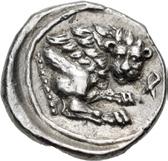

291. CYPRUS, Amathos. Rhoikos. Circa 350 BC. AR Tetrobol (14mm, 2.20 g, 8h). Head of lion right / Forepart of lion right, head facing. Amandry, Amathonte 133, A, 38 (D10/R22); Zapiti & Michaelidou 22; Tziambazis 10. Bright surfaces, minor doubling. Near EF. Excellent metal for issue. ($500)
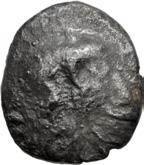

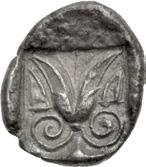
292. CYPRUS, Idalion. Uncertain king. Circa 480-470 BC. AR Sixth Stater (11.5mm, 1.55 g, 12h). Head of female right / Lotus flower on two spiral tendrils within incuse square. Cf. Zapiti & Michaelidou 4 (twelfth stater); cf. Tziambazis 45 (same). Find patina, struck with worn obverse die. VF. Extremely rare, none in CoinArchives. ($500)
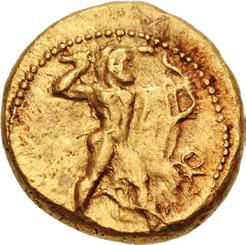
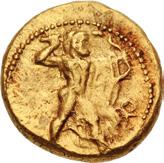
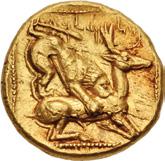

293. CYPRUS, Kition. Melekiathon. Circa 392-362/1 BC. AV Hemistater (13.5mm, 4.17 g, 8h). Herakles advancing right, holding club, bow, and arrow, lion skin draped over arm; e to right / Lion right, biting into the back of a stag couchant right; all in dotted square border. Markou, L’or 12–6 var. (unlisted dies); Zapiti & Michaelidou 23; Tziambazis 29. Struck with worn dies. Good VF. Very rare. ($5000)

294. CYPRUS,
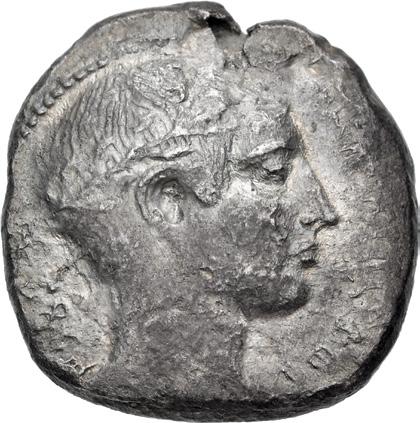
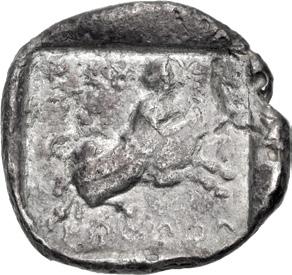
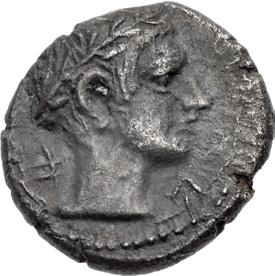
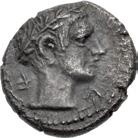
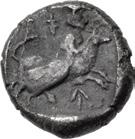
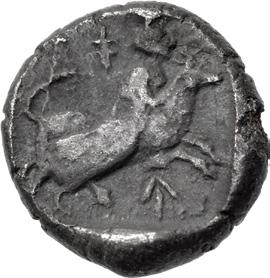
295.
85
Marion. Timocharis. Early 4th century BC. AR Stater (22.5mm, 9.47 g, 9h). Laureate head of Apollo right / Goddess (Europa?) holding on to horns of bull running right; all within incuse square. Destrooper-Georgiades, Coins 4; Schwabacher, Coins 38–46 (dies B/C); Zapiti & Michaelidou –; Tziambazis 53. Toned, rough surfaces. Near VF. Rare, but extremely so in the marketplace; only one in CoinArchives. ($2000)
CYPRUS, Marion. Timocharis. Early 4th century BC. AR Sixth Stater (11.5mm, 1.65 g, 5h). Laureate head of Apollo right / Goddess (Europa?) holding on to horns of bull running right; all within incuse square. Cf. Destrooper-Georgiades, Coins 5–7 (stater); Schwabacher, Coins 91–130 (same dies); Zapiti & Michaelidou 4; cf. Tziambazis 54 (third stater). Find patina, slight roughness. VF. Extremely rare in the marketplace; only two in CoinArchives. ($1500)
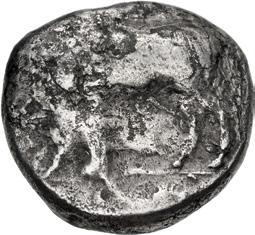


296. CYPRUS, Paphos. Pny[tos?]. Early 5th cenutry BC. AR Stater (21mm, 10.66 g, 1h). Bull standing left / Head of eagle left; palmette to upper left, spiral decoration below; all in linear square within incuse square. Zapiti & Michaelidou 1; Tziambazis 75. Toned, rough and granular surfaces, cleaning marks, struck with worn obverse die. Near VF. Very rare. ($750)

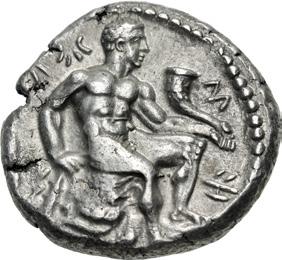
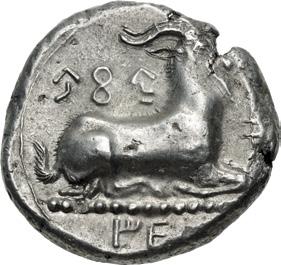

297. CYPRUS, Salamis. Evagoras I. Circa 411-374/3 BC. AR Stater (22.5mm, 11.11 g, 1h). Herakles seated right on rock draped with lion’s skin, leaning on club held and holding cornucopia / Goat couchant right. McGregor Group K.AR.I.a, 414–5 var. (unlisted dies); Zapiti & Michaelidou 1; Tziambazis –. A little off center, some die wear on reverse. Near EF. ($1500)
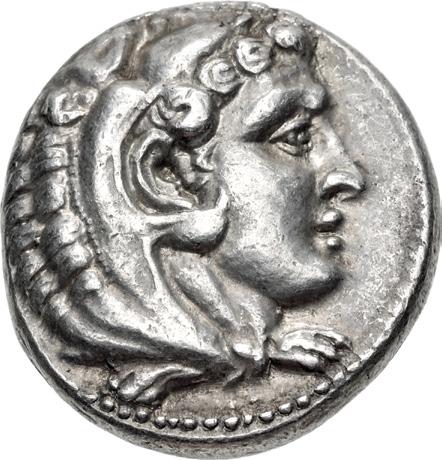

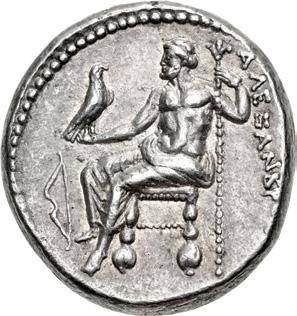

298. CYPRUS, Salamis. Nikokreon. Circa 331-310 BC. AR Tetradrachm (24mm, 17.16 g, 12h). In the name and types of Alexander III of Macedon. Struck circa 332/1-323 BC. Head of Herakles right, wearing lion skin / Zeus Aëtophoros seated left; bow in left field. Zapiti & Michaelidou 5–6; Price 3139; Newell, Some 7; Tziambazis 14. Lightly toned. Good VF. ($500)
From the Wild Rose Collection, purchased from Pars Coins (inv. PCW-G4228), December 2013.
86
Bronze Age Oxhide Copper Ingot

Photo reduced
299. CYPRUS. Late bronze age, circa 1600-1000 BC. Copper ingot in the shape of an oxhide (79x52x8cm); 27.4 kg. For a comprehensive study of oxhide tablets, see M. R. Jones, Oxhide Ingots, Copper Production, and the Mediterranean Trade in Copper and Other Metals in the Bronze Age. (Unpublished Masters Dissertation, College Station, TX, Texas A&M, 2007). Brown patina with natural deposits, casting flaw in one corner. As made and intact. ($30,000)
Ex Prof. Erwin Richter Collection (Vienna), with a copy of his statement dated 2012; acquired from Galerie Schönbrunn (Vienna), 22 August 1998, with a copy of their invoice; acquired from Dr. Alexander Atanasov Collection (Munich), 1992; acquired from Münchner Münzhandlung Karl Kreß (Otto Helbing Nachf.) (Munich), 1986.
The rich mines of the Troodos Mountains in Cyprus were a principal source of copper throughout antiquity. Although oxhide ingots were widely traded and are found today across much of the eastern Mediterranean and Near East, lead isotope analyses have confirmed that most oxhide ingots are from copper sources in Cyprus. Such was the dominance of Cyprus in the metal’s production that the late Latin term for the metal (cuprum) and hence our word “copper” are derived from the name of the island.
Although copper ingots had long been produced in various shapes, by the Late Bronze Age the oxhide ingot shape became an international standard. Earlier scholars suggested that the shape was designed to resemble an oxhide and was related to the value of an ox, but this seems unlikely. The earliest such ingots do not have well-developed “legs” or handles, indicating that the shape was adopted for some other reason, and in any event the copper in such an ingot was worth far more than an ox. The shape was more probably developed for ease of handling and transport. The handles would have made them particularly convenient for carrying by men or pack animals, and it has been suggested that ingots may have been loaded into side packs slung over an animal’s flanks.
Such ingots were widely traded throughout the eastern Mediterranean and Near East. At least 130 have been found on terrestrial sites, although most of those are fragmentary. Find spots on land have been as far east as Iraq and as far north as Bavaria. Larger numbers have been found underwater, usually associated with shipwrecks, from as far west as the coast of southern France and as far north as Bulgaria. The largest finds are the 354 complete ingots from the Uluburun shipwreck (c. 1300 BC) and the 34 complete ingots and 17 fragmentary ingots from the Cape Gelidonya wreck (c. 1200 BC), both sites off the south coast of Turkey. The largest land finds have been from the storerooms of Minoan palaces.
Oxhide ingots feature widely in the art and texts of the Assyrians, Egyptians, and Mycenaeans. They represented not only the standard form for the essential commodity of the time, but also served as a form of payment, a prestige good for elite gift-exchange and tribute, and as a store of wealth.
Oxhide ingots are rarely offered for sale, as the great majority are in museums. CNG handled one specimen previously, over 25 years ago. We have been able to find only two more recent sale records, both for broken examples: one in Gorny & Mosch in 2014 and one in Hermann Historica in 2019. The present complete and intact example represents a once-in-a-generation opportunity.
87

Apparently Unique
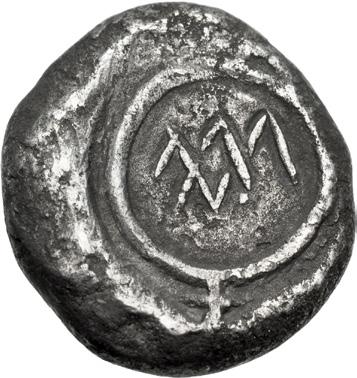
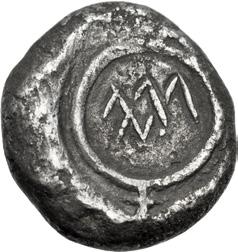
300. LEVANTINE REGION, Uncertain. Early-mid 5th century BC. AR Stater (19mm, 9.59 g, 12h). Figure, wearing long chiton, holding short scepter or torch in extended right hand; unclear legend to right / ygg (ggy in Phoenician) inscribed within upper portion of a large ankh; all within incuse circle. Cf. Roma XIV, lot 400 (hemistater); otherwise, unpublished in the standard references. See also Roma XIV, lot 401, a quarter stater with this same reverse type, but an obverse featuring two dolphins swimming in opposite directions. Toned, rough surfaces, two test cuts on obverse. Near VF. Apparently unique as a stater. ($1000)
From the Norman Frank Collection. Ex Classical Numismatic Group 55 (13 September 2000), lot 653.
Unique as a Drachm


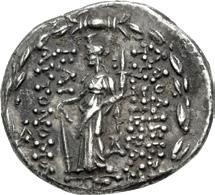

301. SELEUKIS and PIERIA, Laodikeia. 78/7-16/5 BC. AR Drachm (18mm, 3.73 g, 12h). Dated CY 4 (78/7 BC). Turreted, veiled, and draped bust of Tyche right / Athena standing left, hand on grounded rudder to left, and cradling cornucopia in arm; d (date) to low inner right, uncertain letters (or monogram) in exergue. Cf. HGC 9, 1404 (hemidrachm); cf. DCA2 319 (same). Toned, trace deposits, flan crack, edge chip. Good VF. Unique as a drachm. ($750)
Le Rider Plate Coin
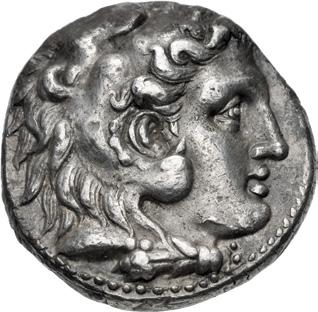

302. SELEUKID EMPIRE. Seleukos I Nikator. Second satrapy and kingship, 312-281 BC. AR Tetradrachm (27mm, 16.96 g, 5h). Seleukeia in Pieria mint. Struck circa 300-281 BC. Head of Herakles right, wearing lion skin / Zeus Nikephoros seated left; Ç in left field, KP below throne. SC 29.1b; Le Rider, Antioche 27 (A4/P13 – this coin, illustrated); HGC 9, 16d. Attractive old collection tone, patches of find patina, small die break on obverse, cleaning scratches on reverse. Near EF. ($750)
From the Wild Rose Collection. Ex Robert W. Bartlett Bequest Sold for the Benefit of the American Numismatic Society (Classical Numismatic Group Keystone Auction 4, 2 September 2021), lot 91; Numismatic Fine Arts XVI (2 December 1985), lot 238.
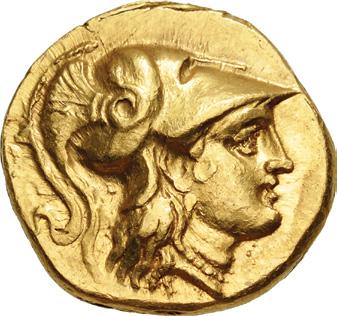
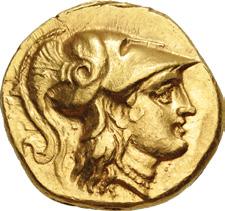
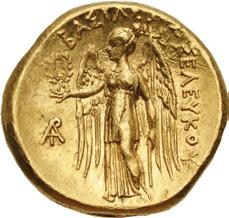
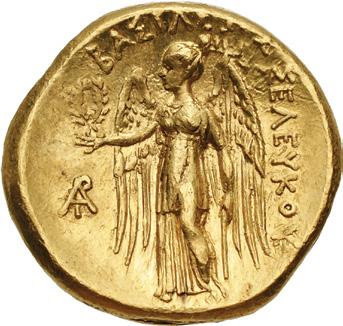
303. SELEUKID EMPIRE. Seleukos I Nikator. Second satrapy and kingship, 312-281 BC. AV Stater (18.5mm, 8.58 g, 12h). In the types of Alexander III of Macedon. Karrhai mint. Struck circa 310-290 BC. Helmeted head of Athena right / Nike standing left, holding wreath and cradling stylis; 5 below right wing. SC 40.1a; HGC 9, 4 corr. (unlisted mint; erroneously listed under 2a). Lustrous, light marks, some die wear, tiny bump on obverse. Near EF. ($2000)
88
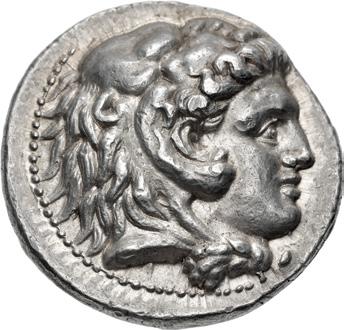
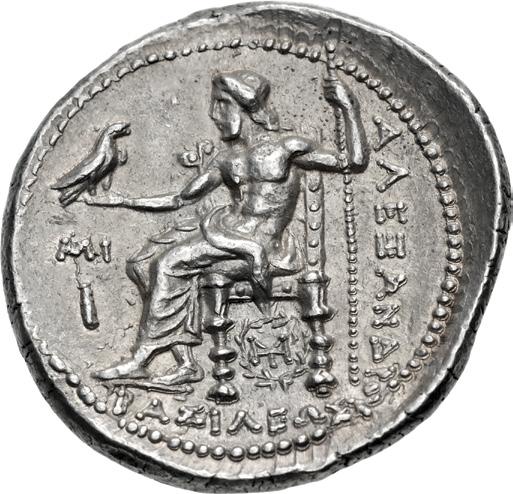

304. SELEUKID EMPIRE. Seleukos I Nikator. Second satrapy and kingship, 312-281 BC. AR Tetradrachm (28mm, 17.12 g, 6h). In the name and types of Alexander III of Macedon. Babylon I mint. Struck circa 311-300 BC. Head of Herakles right, wearing lion skin / Zeus Aëtophoros seated left; in left field, Â5 above club; ® below throne. SC 82.3i; Price 3765; HGC 9, 10f. Lightly toned, minor die shift. EF. ($750)
Purchased by the consignor from Brian Kritt, 29 June 2005 (his ticket included).
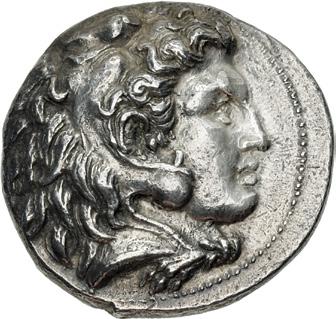

305. SELEUKID EMPIRE. Seleukos I Nikator. Second satrapy and kingship, 312-281 BC. AR Tetradrachm (28mm, 16.93 g, 1h). In the name and types of Alexander III of Macedon. Babylon I mint. Struck circa 311-300 BC. Head of Herakles right, wearing lion skin / Zeus Aëtophoros seated left; ¶ in left field, Â5 below throne. SC 82.5b; Price 3747; HGC 9, 10f. Lightly toned, minor marks and pitting, slight doubling on obverse. Near EF ($500)
Ex GTP Collection; Berk BBS 182 (3 January 2013), lot 83.
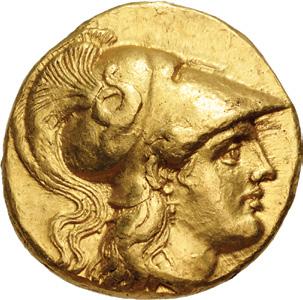
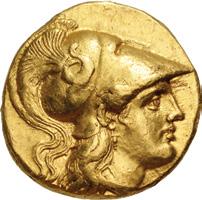

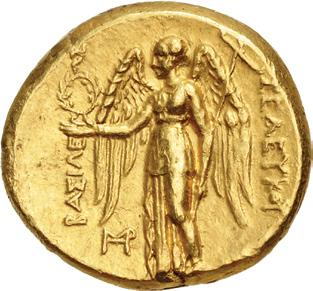
306. SELEUKID EMPIRE. Seleukos I Nikator. Second satrapy and kingship, 312-281 BC. AV Stater (16.5mm, 8.59 g, 8h). In the types of Alexander III of Macedon. Seleukeia on the Tigris mint I. Struck circa 300-296/5 BC. Helmeted head of Athena right / Nike standing left, holding wreath and cradling stylis; A below right wing. SC 115.2 var. (monogram and position); HGC 9, 4d; ANS 1977.158.105 var. (same; same obv. die); Triton XIX, lot 2066 (same dies; hammer $10,000).
Underlying luster, slight die wear, light scuff on obverse. Good VF. Very rare variety. ($2000)
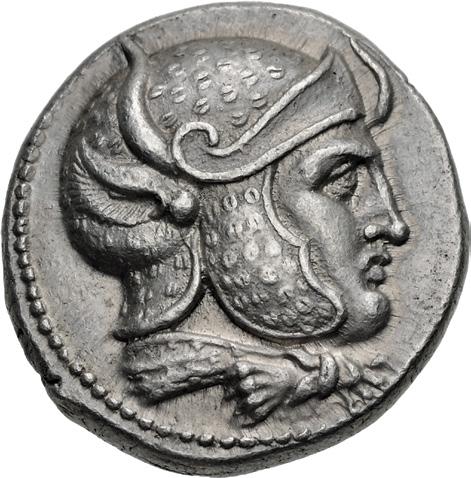
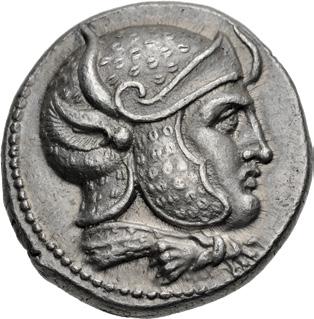
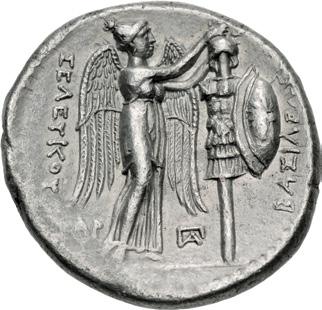
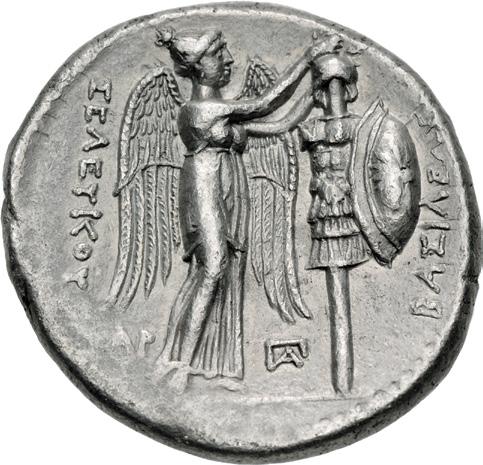
307. SELEUKID EMPIRE. Seleukos I Nikator. Second satrapy and kingship, 312-281 BC. AR Tetradrachm (25mm, 16.99 g, 7h). Susa mint. Struck circa 300-295 BC. Head of hero (Alexander or Seleukos?) right, wearing helmet covered with panther skin and adorned with the ear and horns of a bull / Nike standing right, holding in both hands a wreath that she places on trophy to right; År to lower left, Z in lower middle field. SC 173.15; ESMS Tr.106 var. (A63/P1); Marest-Caffey Group 1.11, 178–9 (A25/P79); HGC 9, 20. Lightly toned, area of weak strike on reverse. EF. ($2000)
From the Wild Rose Collection, purchased from Pars Coins (inv. PCW-G1234), January 2019.
89
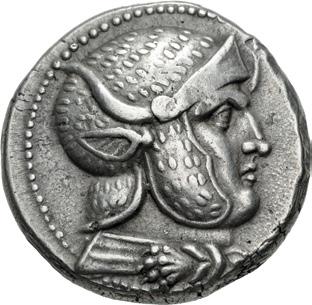
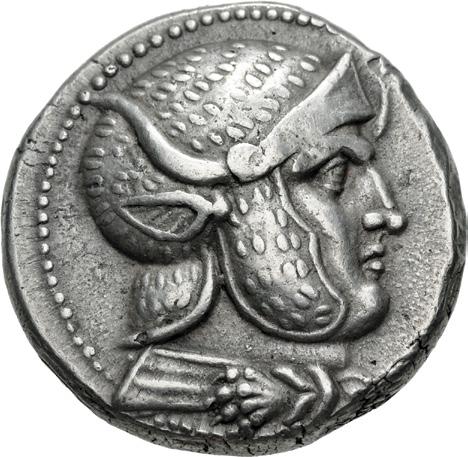

308. SELEUKID EMPIRE. Seleukos I Nikator. Second satrapy and kingship, 312-281 BC. AR Tetradrachm (25mm, 16.98 g, 8h). Uncertain mint in Persis. Struck circa 295-281 BC. Head of hero (Alexander or Seleukos?) right, wearing helmet covered with panther skin and adorned with the ear and horns of a bull / Nike standing right, holding in both hands a wreath that she places on trophy to right; ˙ to lower left, ®d (DW[?] in Aramaic) in lower middle field. SC 195; HGC 9, 21 (same dies as illustration). Lightly toned, a touch off center, small spot of flat strike on obverse. Good VF. Extremely rare, two noted in SC, including the sole example in SCO; one additional in CoinArchives. ($1500)

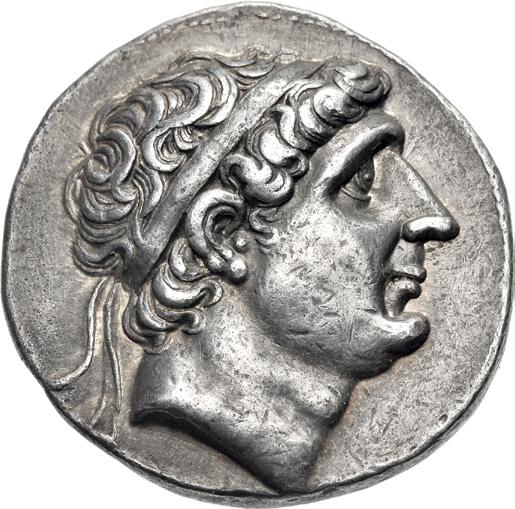
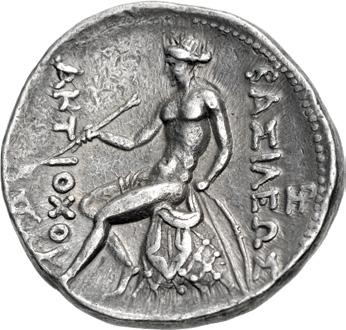
309. SELEUKID EMPIRE. Antiochos I Soter. 281-261 BC. AR Tetradrachm (27.5mm, 17.18 g, 9h). Seleukeia on the Tigris mint. Diademed head right / Apollo, testing arrow and placing hand on grounded bow, seated left on omphalos; Û to outer left, A to outer right. SC 379.3a; HGC 9, 128g. Toned, some marks, area of light porosity on obverse, minor die wear on reverse. Near EF. ($1000)
From the Mesogeios Collection. Ex Classical Numismatic Group 115 (16 September 2020), lot 277; Roma E-Sale 71 (28 May 2020), lot 620; Roma XIV (21 September 2017), lot 306.
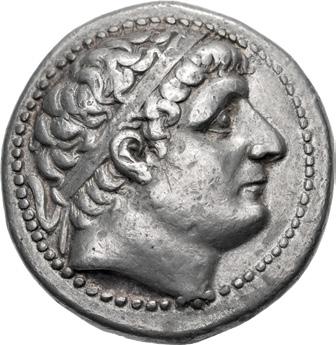
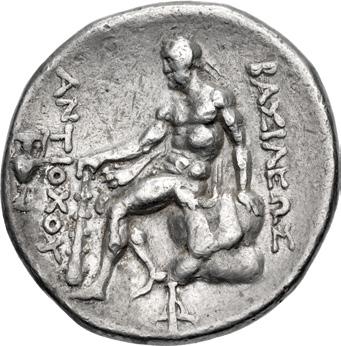
310. SELEUKID EMPIRE. Antiochos II Theos. 261-246 BC. AR Tetradrachm (27mm, 16.98 g, 11h). Myrina mint. Diademed head right / Herakles, holding club set on ground, seated left on rock draped with lion’s skin; amphora to outer left, ÷ in exergue. SC 500.1b; HGC 9, 241b. Toned. VF. Rare mint. ($500)
From the Mesogeios Collection. Ex Weise Collection; Classical Numismatic Group 55 (13 September 2000), lot 664.

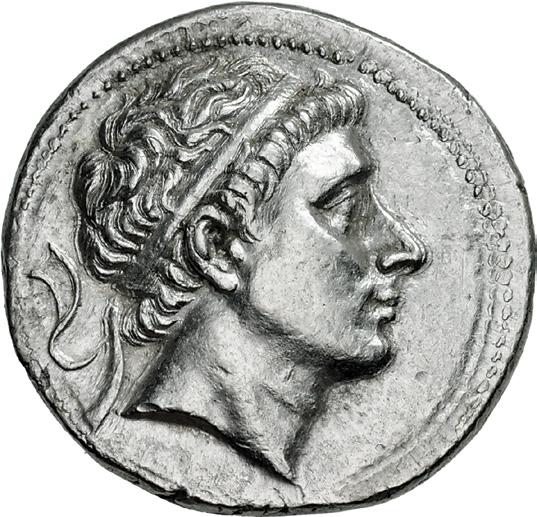

311. SELEUKID EMPIRE. Antiochos II Theos. 261-246 BC. AR Tetradrachm (30mm, 16.70 g, 12h). Antioch on the Orontes mint. Diademed head right / Apollo, testing arrow and placing hand on grounded bow, seated left on omphalos; M to outer left, Ò to outer right. SC 571.2a; Le Rider, Antioche 37–45 (obv. die A4); HGC 9, 238o. Bright surfaces, underlying luster, minor doubling on obverse. EF. Struck on a broad flan. ($1000)
90
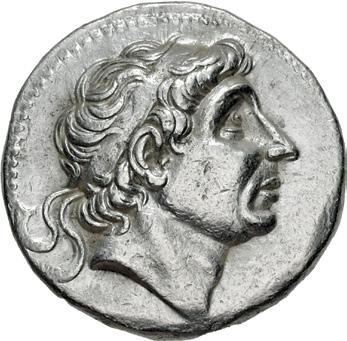
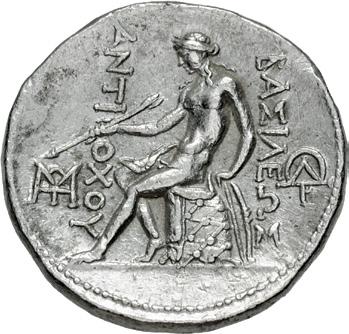
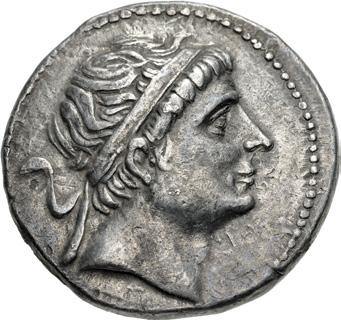
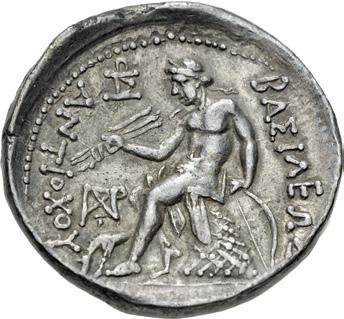
312. SELEUKID EMPIRE. Antiochos II Theos. 261-246 BC. AR Tetradrachm (29mm, 17.00 g, 7h). Seleukeia on the Tigris mint. Diademed head of Antiochos I right / Apollo, testing arrow and placing hand on grounded bow, seated left on omphalos; q to outer left, ¶ to outer right. SC 587.1a; HGC 9, 236g. Underlying luster, minor marks, slight die wear on reverse. Near EF. ($750)
313. SELEUKID EMPIRE. Antiochos II Theos. 261-246 BC. AR Tetradrachm (27.5mm, 16.43 g, 6h). Ekbatana mint. Diademed head right / Apollo, testing three arrows and placing hand on grounded bow, seated left on omphalos; to inner left, é above arm, ë below; at feet, forepart of horse grazing left. SC 607b; HGC 9, 238v. Toned. Good VF. Very rare, only one recorded in ESM (in Berlin), two in CoinArchives. ($750)
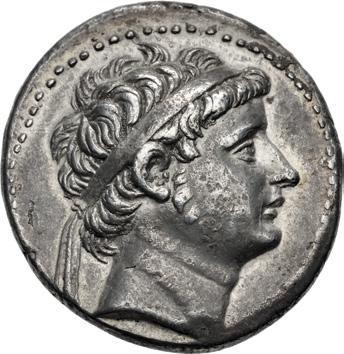
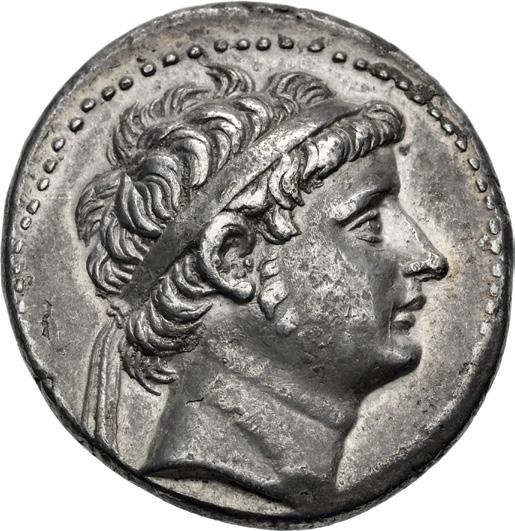

314. SELEUKID EMPIRE. Seleukos II Kallinikos. 246-225 BC. AR Tetradrachm (28mm, 16.55 g, 12h). Teos(?) mint. Diademed head right, wearing long sideburn / Apollo standing left, testing arrow and resting elbow on tall tripod to right; palm frond to inner left. SC 645; HGC 9, 303c. Minor die rust on reverse. Good VF. Very rare. ($500)
From the Wild Rose Collection, purchased from Baldwin’s, December 2013. Ex Spink 221 (2 December 2013), lot 110; Triton XIII (5 January 2010), lot 1339; Gorny & Mosch 169 (12 October 2008), lot 139; G. Hirsch 256 (5 May 2008), lot 354.
Second and Finest Known
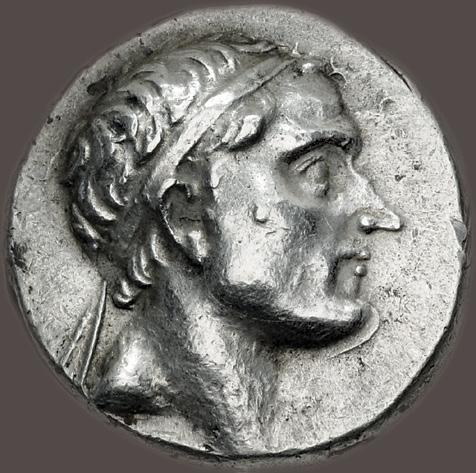
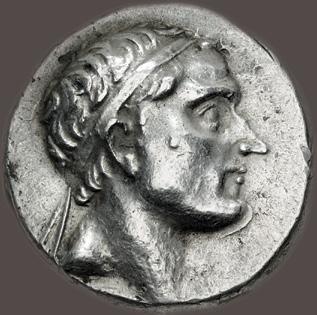
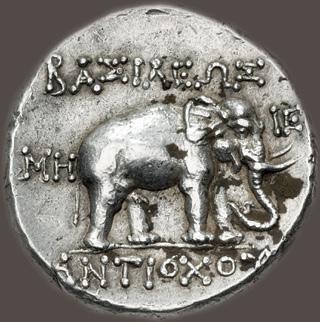
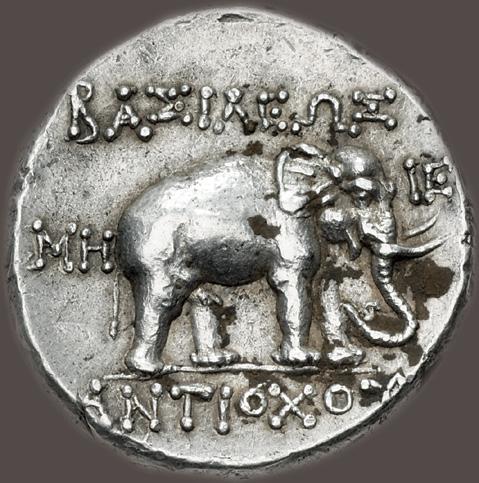
315. SELEUKID EMPIRE. Antiochos III ‘the Great’. 222-187 BC. AR Tetradrachm (26mm, 16.86 g, 12h). Uncertain mint 56, in western Asia Minor (possibly Sardes). Struck circa 192/0-187 BC. Diademed head (Type E) right / ∫Å%5¬EW% Å@ t5ocoU, elephant standing right; MH to left, IE to right. SC 987.3 corr. (control to right; same obv. die as referenced coin); HGC 9, 451a. Minor double strike on obverse with worn die, deposits on reverse. Near EF. Extremely rare, apparently the second known of this issue; and the one example published (ANHS 251 = Peus 376, lot 518 = Berk BBS 45, lot 227) has the right field control mark off the flan. ($5000)
91
312 313

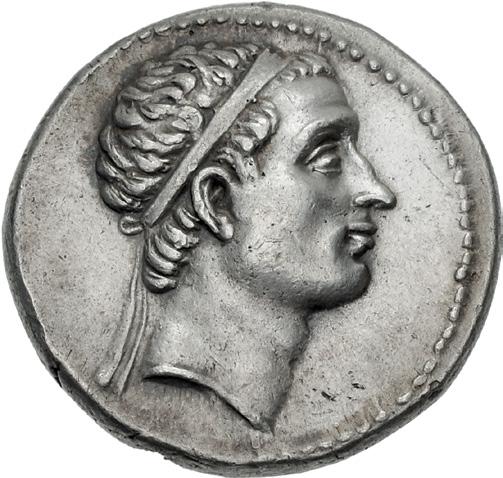

316. SELEUKID EMPIRE. Antiochos III ‘the Great’. 222-187 BC. AR Tetradrachm (28mm, 17.02 g, 12h). ΔI mint, in Southern or Eastern Syria. Struck circa 192/0-187 BC. Diademed head (Type E) right / Apollo, testing arrow and placing hand on grounded bow, seated left on omphalos; d5 in exergue. SC 1112; HGC 9, 447y. Lightly toned, scrape on reverse. EF. Excellent late portrait. ($1000)
Ex Classical Numismatic Group Electronic Auction 484 (27 January 2021), lot 484 (hammer $2000).
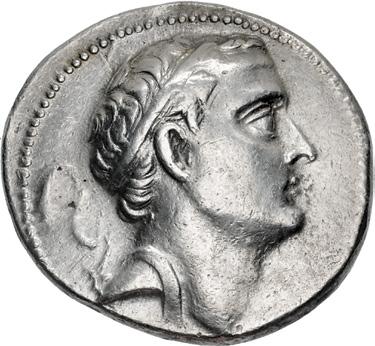
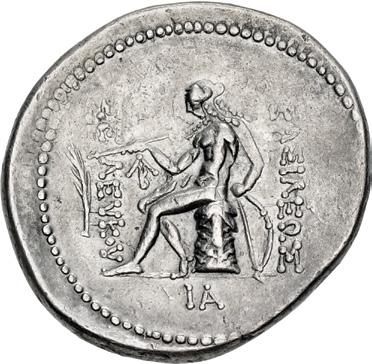
317. SELEUKID EMPIRE. Seleukos IV Philopator. 187-175 BC. AR Tetradrachm (30mm, 16.88 g, 12h). Ptolemaïs (Ake) mint. Struck circa 180-175 BC. Diademed head right / Apollo, testing arrow and placing hand on grounded bow, seated left on omphalos; palm frond to outer left, J to inner left, IA in exergue. SC 1331a; Le Rider, Séleucos 85 (D1/R2); HGC 9, 580h. Struck with slightly worn obverse die, double struck on reverse. Good VF. Rare. ($750)
Ex Classical Numismatic Group 87 (18 May 2011), lot 622.
Ex Hunt Collection – Referenced by Le Rider


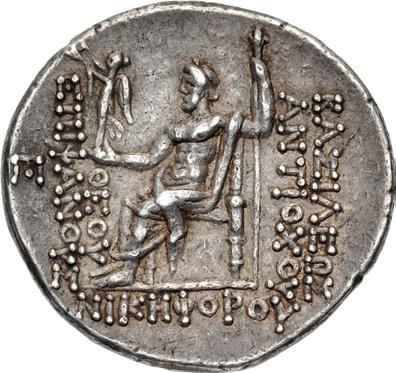
318. SELEUKID EMPIRE. Antiochos IV Epiphanes. 175-164 BC. AR Tetradrachm (32mm, 16.88 g, 1h). Antioch on the Orontes mint. Series 3, struck 168-164 BC. Diademed head right / Zeus Nikephoros seated left; ∫ to outer left. SC 1400d; Le Rider, Antioche, Series IIIB, 403 (A39/P285) = Hunt IV 458 (this coin); Mørkholm Series III, 17; HGC 9, 620a. Attractive old cabinet tone. VF. ($750)
From the Wild Rose Collection. Ex Nelson Bunker Hunt Collection (Part IV, Sotheby’s, 19 June 1991), lot 458; Numismatic Fine Arts (Gans) 15 (4 May 1955), lot 155; Glendining (9 March 1931), lot 1149; Santamaria (27 March 1928), lot 280.
92
Extremely Rare Eagle Type Drachm
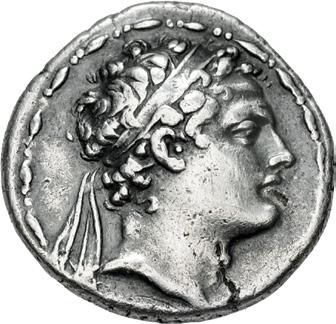

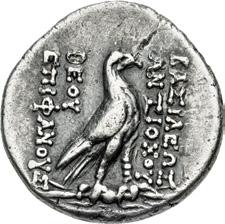
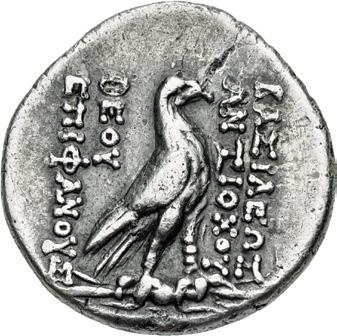
319. SELEUKID EMPIRE. Antiochos IV Epiphanes. 175-164 BC. AR Drachm (18mm, 4.00 g, 12h). Antioch on the Orontes mint. Stuck circa 169 BC. Diademed head right / Eagle standing right on thunderbolt. SC 1404; Le Rider, Antioche, Series II, 23 var. (A2/P– [unlisted rev. die]); HGC 9, 627. Lightly toned, hairline flan crack, faint cleaning scratches. VF. Extremely rare. ($3000)
Ex Fox and Hunt Collections
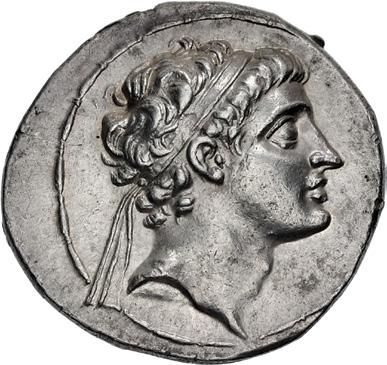
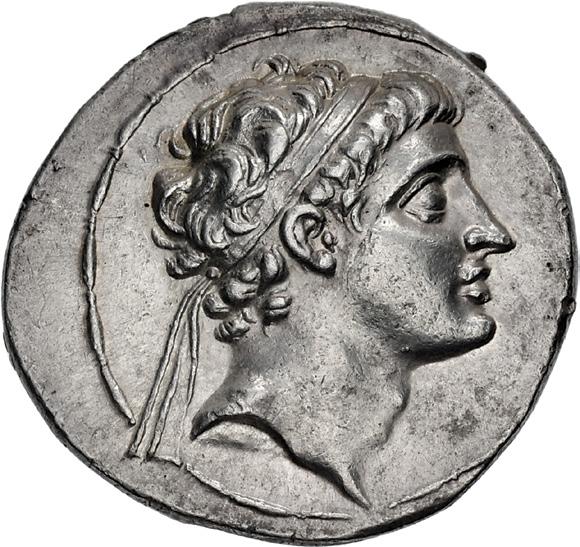
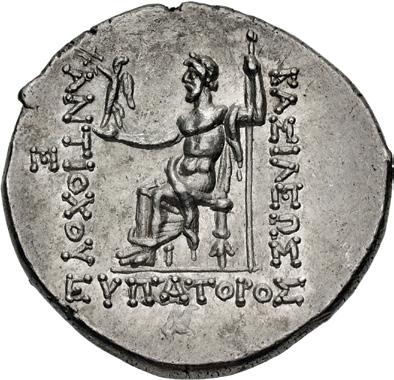
320. SELEUKID EMPIRE. Antiochos V Eupator. 164-162 BC. AR Tetradrachm (32mm, 16.57 g, 1h). Antioch on the Orontes mint. Diademed head right / Zeus Nikephoros seated left; ∫ to outer left. SC 1575.2; Le Rider, Antioche 192 (A11/ P142) = Hunt Sale IV 592 (this coin); HGC 9, 752. Lightly toned over lustrous surfaces, die erasure in exergue on reverse. Near EF. ($1500)
From the Wild Rose Collection. Ex James Fox Collection; Nelson Bunker Hunt Collection (Part IV, Sotheby’s, 19 June 1991), lot 592.

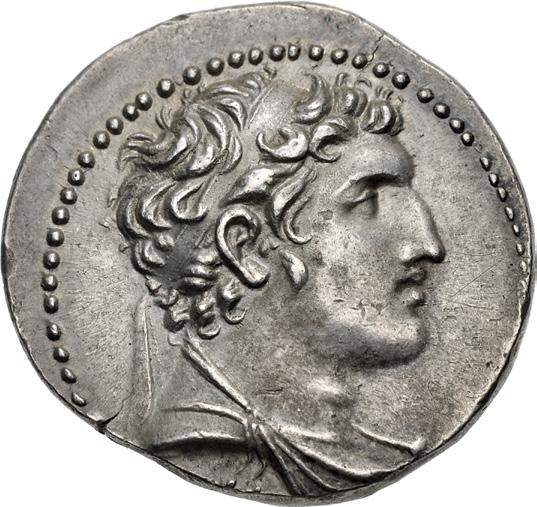
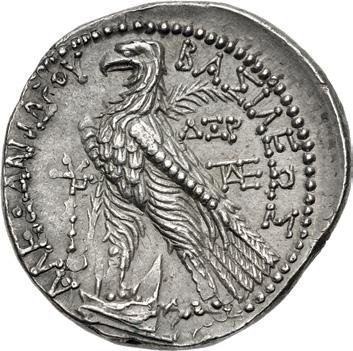
321. SELEUKID EMPIRE. Alexander I Balas. 152-145 BC. AR Tetradrachm (29mm, 14.21 g, 1h). Tyre mint. Dated SE 164 (149/8 BC). Diademed and draped bust right / Eagle standing left on prow left; palm frond behind; to left, club surmounted by i (Tyre monogram); to right, d$r (date) above ÿ. SC 1835.3b; HGC 9, 883; DCA2 62. Lightly toned, light graffito in field on obverse, double struck on reverse. Near EF. ($500)
From the Wild Rose Collection. Ex Roma V (23 March 2013), lot 463 (hammer £800).
93
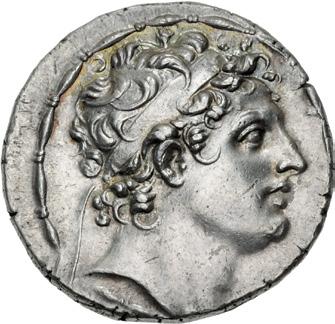
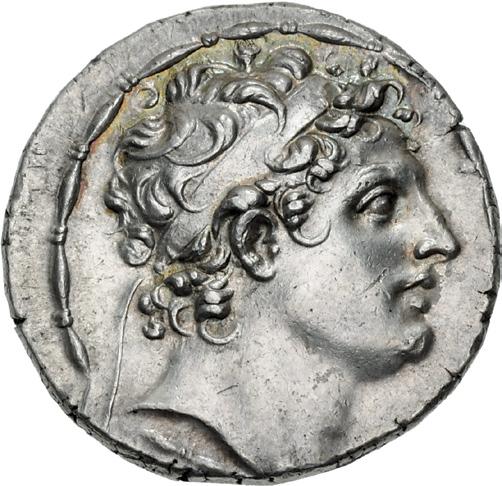
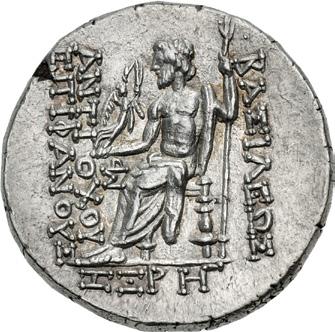
322. SELEUKID EMPIRE. Posthumous Issues of Antiochos IV. 146/5 BC. AR Tetradrachm (27.5mm, 16.64 g, 12h).
Antioch on the Orontes mint. Dated SE 167 (146/5 BC). Diademed head right / Zeus Nikephoros seated left; · to inner left, z$r (date) and £ in exergue. SC 1885.3; Mørkholm, Posthumous 2 (A1/P– [unlisted rev. die]); HGC 9, 744; DCA2 37. Light iridescent tone, a few marks on obverse. EF. Struck from fresh dies. Extremely rare, only the BN piece published (Babelon, Rois 987), one additional in CoinArchives (Künker 304, lot 633). ($1000)
Ex Heritage Europe 78 (23 May 23 2023), lot 4887; Giessener Münzhandlung 90 (12 October 1998), lot 461.
In the final year of Alexander I Balas’ reign, Demetrios II Nikator, seeking to avenge the death of his father, Demetrios I Soter, advanced on Alexander from Cilicia, supported by troops of Ptolemy VI of Egypt that advanced from Palestine. Alexander fled from Antioch to rally his forces at a chosen location to the east. Between this time and the arrival of Demetrios’ forces, Antioch struck a very short series of tetradrachms and drachms in the name of Antiochos IV, which is confirmed by the dated tetradrachm issues. While the chronology is certain, the purpose of the issue remains unknown.
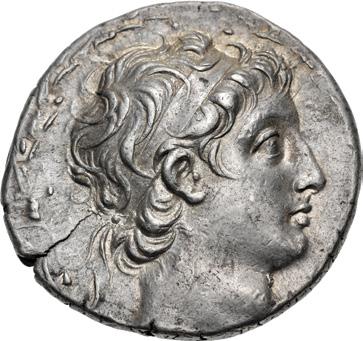

323. SELEUKID EMPIRE. Demetrios II Nikator. First reign, 146-138 BC. AR Tetradrachm (29.5mm, 16.59 g, 1h). Antioch on the Orontes mint. Dated SE 168 (145/4 BC). Diademed head right within wreath / Apollo, testing arrow and resting hand on grounded bow, seated left on omphalos; , to inner left, 8 between legs, [˙]$r (date) in exergue. SC 1907.1b; HGC 9, 957d; DCA2 85. Lightly toned, flan crack, a little off center. Near EF. ($500)
From the Wild Rose Collection. Ex Classical Numismatic Group 55 (13 September 2000), lot 678; Classical Numismatic Group 39 (18 September 1996), lot 685; Classical Numismatic Group 37 (20 March 1996), lot 649.
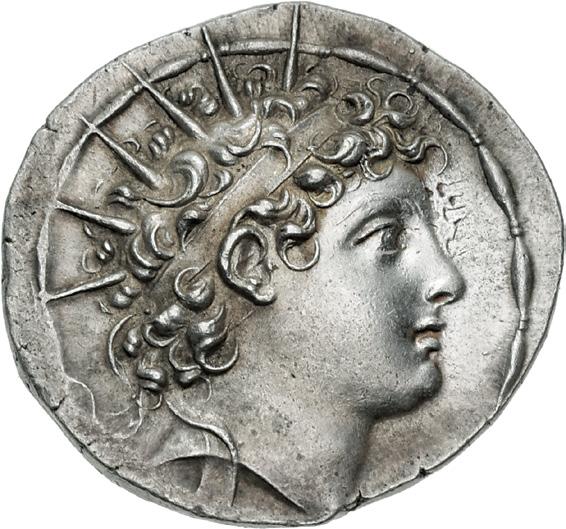
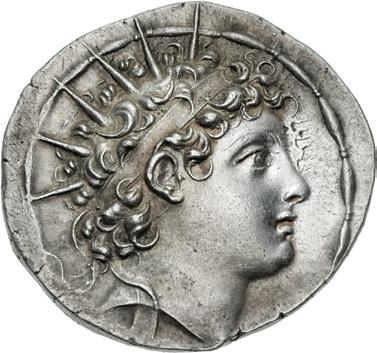
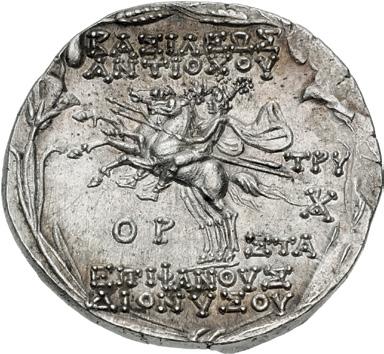
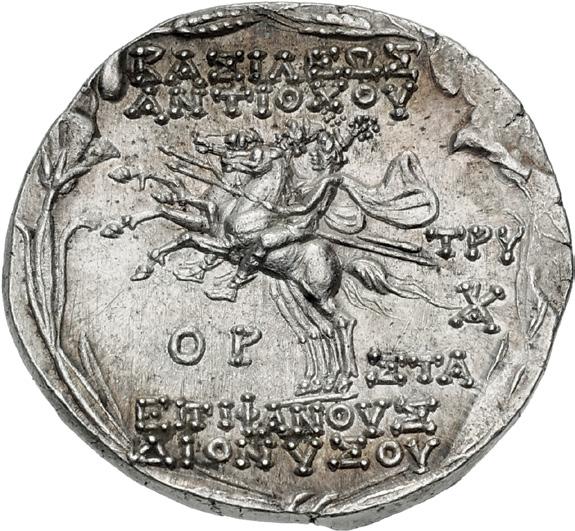
324. SELEUKID EMPIRE. Antiochos VI Dionysos. 144-142 BC. AR Tetradrachm (31.5mm, 16.58 g, 1h). Antioch on the Orontes mint. Dated SE 170 (143/2 BC). Radiate and diademed head right / The Dioskouroi, holding reins and couched lances, on horses rearing left; to right, trU above – above %tÅ; or (date) below; all within wreath of laurel, ivy, and grain ears. SC 2000.3d; HGC 9, 1032; DCA2 118. Lightly toned, a couple minor die flaws on obverse. EF. Fine style. Well centered. ($2000)
Ex Hess-Divo 317 (27 October 2010), lot 288 (hammer CHF 3400).
94
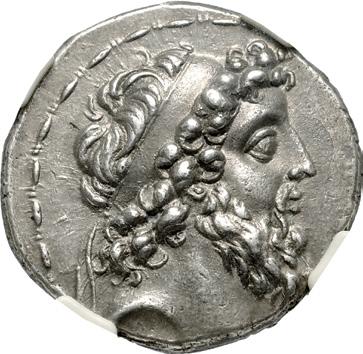
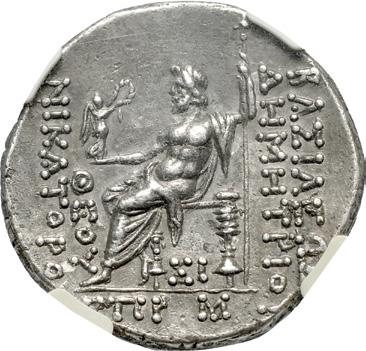


325. SELEUKID EMPIRE. Demetrios II Nikator. Second reign, 129-125 BC. AR Tetradrachm (29.5mm, 16.19 g, 1h). Sidon mint. Dated SE 185 (128/7 BC). Diademed head right / Zeus Nikephoros seated left; %5 below throne, E∏r (date) and Ò in exergue. SC 2187a; HGC 9, 1117e; DCA2 165. In NGC encapsulation 3959045-012, graded AU, Strike: 5/5, Surface: 3/5, Fine Style. ($750)
Ex Classical Numismatic Group 118 (13 September 2021), lot 363.
326.
SELEUKID EMPIRE. Alexander II Zabinas. 128-122 BC. AR Tetradrachm (29.5mm, 16.55 g, 1h). Antioch on the Orontes mint. Diademed head right / Zeus Nikephoros seated left; $ to outer left, d below throne. SC 2220.1b; SMA 347; HGC 9, 1149d; Babelon, Rois 1289. Lightly toned, deposits and light cleaning marks on reverse. EF. Rare. ($1000)
From the Wild Rose Collection. Ex MNL Collection (Triton XXII, 9 January 2019) lot 331; Numismatica Ars Classica 78 (26 May 2014), lot 1536.
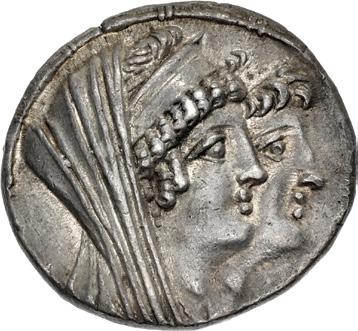
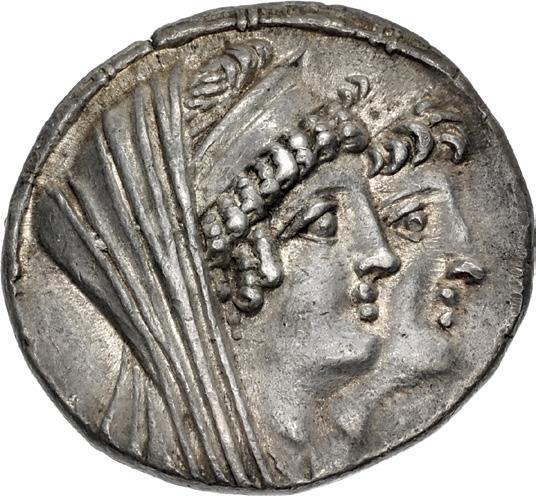
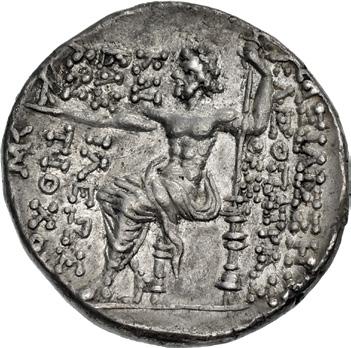
327. SELEUKID EMPIRE. Kleopatra Thea & Antiochos VIII. 125-121 BC. AR Tetradrachm (29.5mm, 16.51 g, 12h). Ptolemaïs (Ake) mint. Undated issue, struck circa 124 BC. Jugate heads right / Zeus Nikephoros seated left; † to outer left. SC 2271.1; HGC 9, 1182g. Lightly toned. Good VF. Well centered. ($1000)
From the Wild Rose Collection. Ex Classical Numismatic Group 100 (7 October 2015), lot 1570.

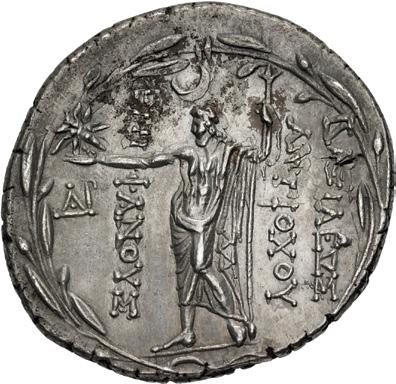
328. SELEUKID EMPIRE. Antiochos VIII Epiphanes (Grypos). 121/0-97/6 BC. AR Tetradrachm (33mm, 16.06 g, 12h). Ptolemaïs (Ake) mint. Struck circa 121/0-113 BC. Diademed head right / Zeus Ouranios, drapery around waist, standing left, holding star and scepter; D to outer left; all within wreath. SC 2336.2a; LSM 35; HGC 9, 1197h. Lightly toned, thin die break on obverse, trace deposits and double struck on reverse. EF ($500)
From the Wild Rose Collection. Ex Goldberg 87 (15 September 2015), lot 2057.
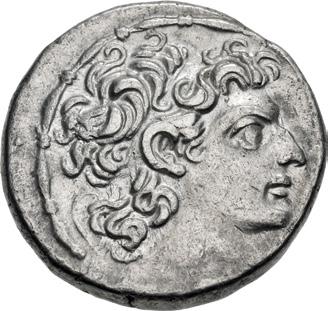
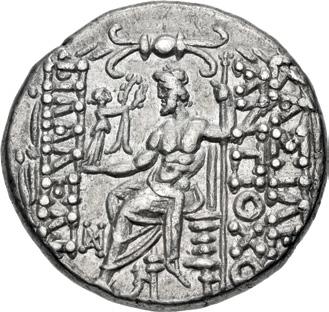
329. SELEUKID EMPIRE. Antiochos XIII Philadelphos (Asiatikos). First reign, 69/8-67 BC. AR Tetradrachm (26.5mm, 15.88 g, 12h). Antioch on the Orontes mint. Diademed head right / Zeus Nikephoros seated left; 7 to inner left; all within laurel wreath. SC 2487a; HGC 9, 1340. Minor die wear on obverse. Near EF ($1500)
End of Session 1
95
325 326
Session 2 – Tuesday, May 28, 2024 — 2 PM
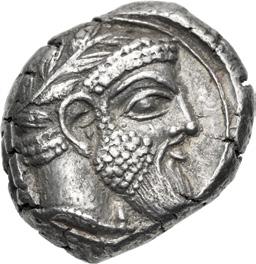
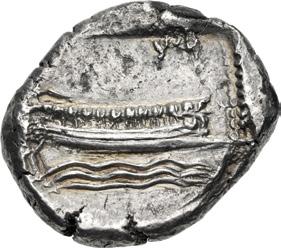
330. PHOENICIA, Arados. Uncertain king. Circa 420-400 BC. AR Shekel (20.5mm, 10.91 g, 3h). Laureate head of Ba’al-Arwad right / Galley right, Pataikos on prow, above waves; ^M (M ’ in Aramaic) above; all in half-square incuse with semicircle bottom. E&E-A Group III.1.1; HGC 10, 29. Lightly toned, traces of horn silver, minor cleaning marks on obverse. Near EF. ($500)
From the Wild Rose Collection, purchased from Shanna Schmidt, 28 May 2020. Ex Künker 326 (7 October 2019), lot 934; Hagen Tronnier Collection (Künker 94, 27 September 2004), lot 1444; Münzen und Medaillen AG FPL 378 (May 1976), no. 6.
E&E-S Plate Coin



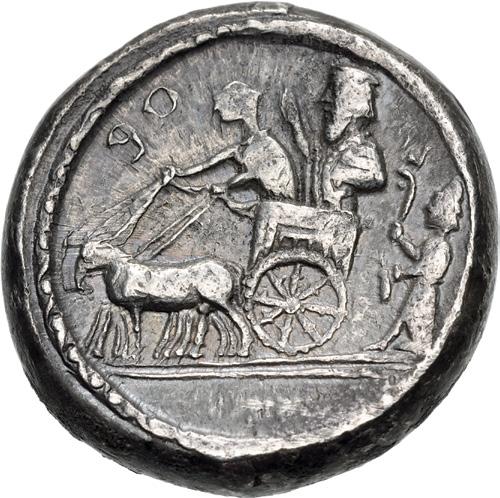
331. PHOENICIA, Sidon. `Abd`aštart (Straton) I. Circa 365-352 BC. AR Dishekel (27mm, 25.59 g, 12h). Dated RY 10 (356/5). Phoenician galley left; 0 (10 in Phoenician [date]) above, waves below / King of Persia and driver in chariot drawn by two horses left; to right, King of Sidon standing left, in Egyptian dress, holding cultic scepter and votive vase; bo (‘B in Phoenician) above. E&E-S Group IV.2.1.j, 1315 (D25/R11 – this coin); HGC 10, 242; DCA2 820. Toned, cleaning marks. Good VF. ($1500)
From the Wild Rose Collection, purchased from Edward J. Waddell (inv. 55403), 16 January 2020. Ex Künker 326 (7 October 2019), lot 938; Auctiones AG 8 (27 June 1978), lot 365; Numismatica IV (22 April 1974), lot 226.
Illustrated in DCA-Tyre

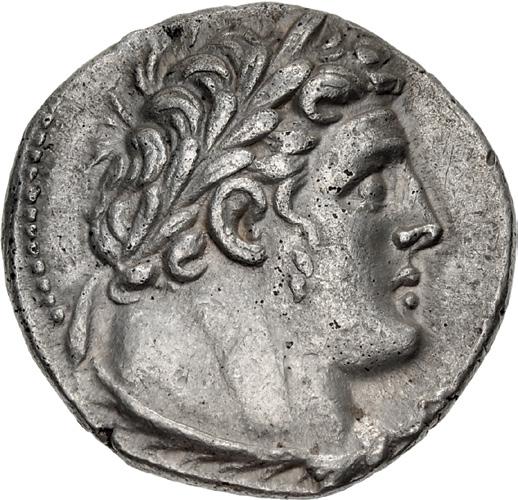
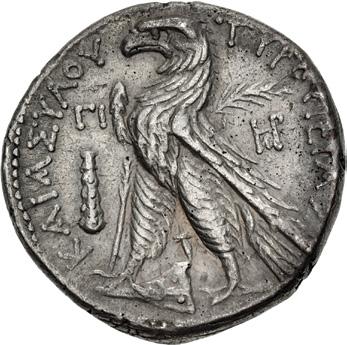
332. PHOENICIA, Tyre. 126/5 BC-AD 65/6. AR Shekel (28.5mm, 14.29 g, 12h). Dated CY 13 (114/3 BC). Laureate bust of Melkart right, lion skin around neck / Eagle standing left on prow; palm frond in background; to left, ˝5 (date) above club; Ê to right; W (Phoenician A) between legs. DCA-Tyre 34 (this coin illustrated); HGC 10, 357; DCA2 946. Lightly toned, some pitting. Good VF. ($1000)
From the Wild Rose Collection, purchased from Calgary Coin Gallery, April 1993.
96

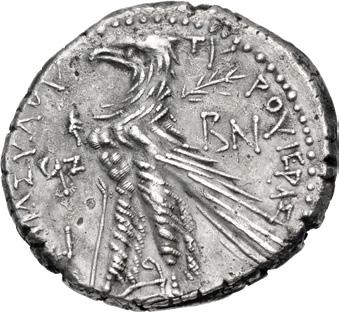
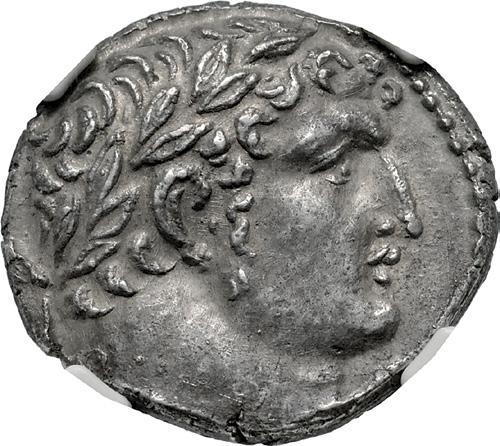



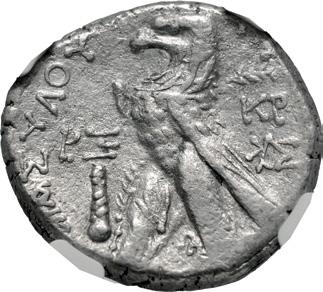
333. PHOENICIA, Tyre. 126/5 BC-AD 65/6. AR Shekel (27.5mm, 14.20 g, 12h). Dated CY 97 (30/29 BC). Laureate bust of Melkart right, lion skin around neck / Eagle standing left on prow; palm frond in background; to left, rZ (date) above club; ∫@ to right, b (Phoenician B) between legs. DCA-Tyre 340 (same dies as illustration); HGC 10, 357; DCA2 946. Traces of horn silver, minor cleaning scratches, a couple pits on reverse. Good VF. Rare date. ($1500)
Lifetime of Christ Issue
334. PHOENICIA, Tyre. 126/5 BC-AD 65/6. AR Shekel (27mm, 14.02 g, 12h). Dated CY 146 (AD 20/1). Lifetime of Christ Issue. Laureate bust of Melkart right, [lion skin around neck] / Eagle standing left on prow; palm frond in background; to left, rÂ? (date) above club; to right, ˚r above ÷; b (Phoenician B) between legs. DCA-Tyre 527 (this coin illustrated); HGC 10, 357; DCA2 947. Attractively toned. In NGC encapsulation 6158800-001, graded Ch AU, Strike: 4/5, Surface: 4/5. ($1500)
From the Jonathan Kern Collection. Ex Ray Neff Collection (Triton XXV, 11 January 2022), lot 338.
335. PHOENICIA, Tyre. 126/5 BC-AD 65/6. AR Shekel (23mm, 13.37 g, 1h). Dated CY 160 (AD 34/5). Laureate head of Melkart right, lion skin around neck / Eagle standing left on prow; palm frond in background; to left, r$ (date) above club; to right, ˚r above Ģ; b (Phoenician B) between legs. DCA-Tyre 587; HGC 10, 357; DCA2 947. In NGC encapsulation 6556045-011, graded XF, Strike: 4/5, Surface: 3/5. ($750)
Ex Classical Numismatic Group Electronic Auction 517 (1 June 2022), lot 270.
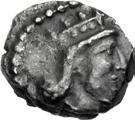



336. SAMARIA, “Middle Levantine” Series. Circa 375-333 BC. AR Hemiobol (7mm, 0.26 g, 11h). Bearded head right, wearing crown (Persian Great King?) / Crowned, four-winged, three-quarter length figure right, raising hand, within incuse square. Cf. Meshorer & Qedar 51–2 (for obv. type), 84 and 100 (for rev. type); cf. Sofaer 70–3 (for obv. type), 41–2 and 149–50 (for rev. type). Deeply toned. Good VF. Apparently unpublished and unique. ($750)
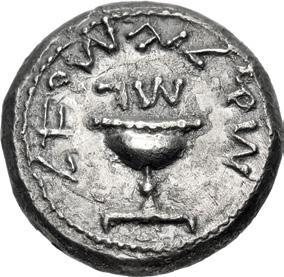
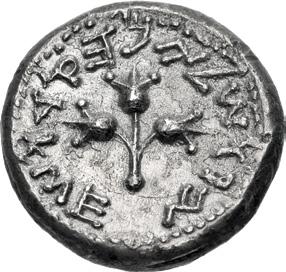
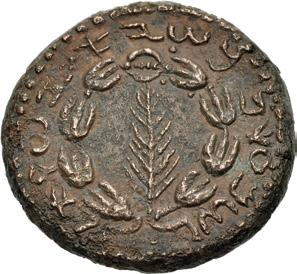

337. JUDAEA, Jewish War. 66-70 CE. AR Shekel (23mm, 13.68 g, 12h). Jerusalem mint. Dated year 3 (68/9 CE). Omer cup; Gc (“Y[ear] 3” in Hebrew = date) above, L!Rc¥ LQc (“Shekel of Israel” in Hebrew) around / Sprig of three pomegranates; YcurQY 2¥Lcur¥ (“Jerusalem the holy” in Hebrew) around. Deutsch 61 (O7/R60); Hendin 6390; Meshorer 202; Kadman 20. Some roughness, minor flan flaws. Good VF. ($3000)
338. JUDAEA, Bar Kochba Revolt. 132-135 CE. Æ (24mm, 11.70 g, 2h). Dated year 1 (132/3 CE). Palm frond within laurel wreath / Nevel with five strings. Mildenberg 23 (O1/R4); Hendin 6406; Meshorer 223. Brown surfaces, slight roughness. Good VF. ($500)
97
333 334 335
337 338


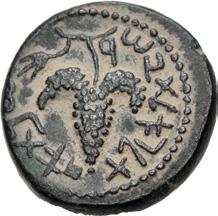
339. JUDAEA, Bar Kochba Revolt. 132-135 CE. Æ (17.5mm, 5.51 g, 12h). Dated year 1 (132/3 CE). Palm tree with two bunches of dates / Grape bunch on vine with small leaf. Mildenberg 149 (O1/R3); Meshorer 225; Hendin 6409c. Earthen dark green surfaces. Good VF. ($500)
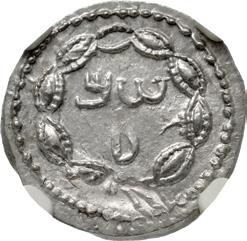
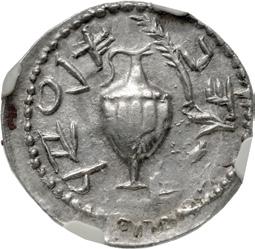

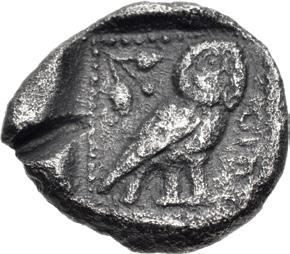
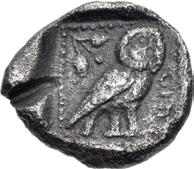
340. JUDAEA, Bar Kochba Revolt. 132-135 CE. AR Zuz – Denarius (18mm, 3.17 g, 1h). Undated, struck early year 2 (133/4 CE). o2C (“Shim‘” in Hebrew) within wreath / Flagon with handle; palm frond to right; 5Y∑;Y R$oL! (“Eleazar the Priest” in Hebrew) around. Mildenberg 5 (O3/R3); Hendin 6413; Meshorer 234a. In NGC encapsulation 4631304-008, graded Ch AU, Strike: 4/5, Surface: 3/5, overstruck. ($2000)
Ex Heritage 231910 (7 March 2019), lot 61062.
341. PHILISTIA (PALESTINE), Gaza (‘Azah). Mid 5th century-333 BC. AR Drachm (15.5mm, 3.74 g, 12h). Head of bearded male right / Owl standing right; olive spray to left, `zh (AZH in Aramaic) to right; all in dotted square border within incuse square. Gitler & Tal V.1D. Toned, porous, test cut at edge on reverse. VF. Very rare. ($1000)
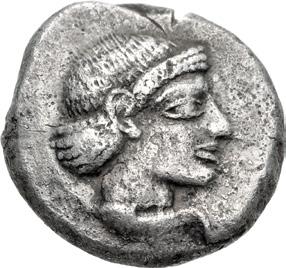

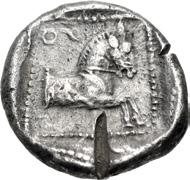
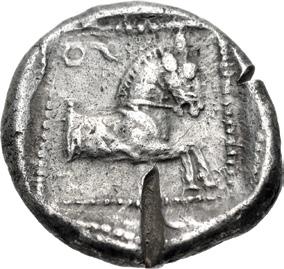
342. PHILISTIA (PALESTINE), Gaza (‘Azah). Mid 5th century-333 BC. AR Drachm (15.5mm, 3.98 g, 9h). Head of female right, with oriental hairstyle / Forepart of horse right in pelleted square border within incuse square. Gitler & Tal VI.2D. Lightly toned, a little porosity, test cuts on reverse and edge. Good VF. Well centered. ($1000)
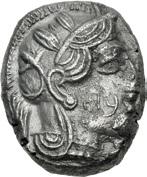
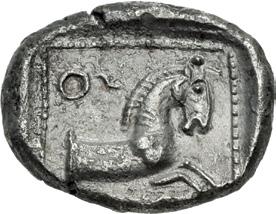
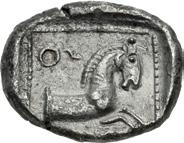
343. PHILISTIA (PALESTINE), Gaza (‘Azah). Mid 5th century-333 BC. AR Drachm (12mm, 3.09 g, 9h). Helmeted head of Athena right; 74 (BM[?] in Phoenician) on cheek / Forepart of horse right; oZ (Phoenician AZ) to upper left; all in pelleted square border within incuse square. Cf. Gitler & Tal Type VI (for rev. type); Roma XXIII, lot 510 (same dies). Toned, light roughness and porosity. EF. Extremely rare, possibly the second known. ($1000)

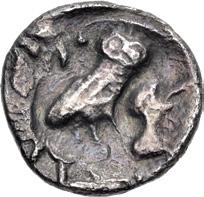
344. PHILISTIA (PALESTINE), Uncertain mint. Mid 5th century-333 BC. AR Drachm (17mm, 3.67 g, 9h). Imitating Athens. Crude helmeted head of Athena right / Owl standing right, head facing; olive spray and crescent to left; to right, lion upward; all within incuse square. Gitler & Tal XII.1D. Dark iridescent tone, struck with worn dies, rotated double strike, extensive cleaning scratches. VF. Extremely rare. ($1000)
98
340
341
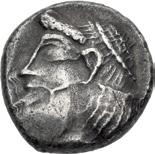


345. PHILISTIA (PALESTINE), Uncertain mint. Mid 5th century-333 BC. AR Drachm (13mm, 2.59 g, 5h). Bearded head left / Paradise flower/Phoenician palmette; h`[;]¥ (YN’H or YW’H in Aramaic) clockwise around from upper right; in dotted square within incuse square. Gitler & Tal XVII.1D; HGC 10, 604. Toned, minor porosity, die break on obverse, test cut on reverse. VF. ($750)
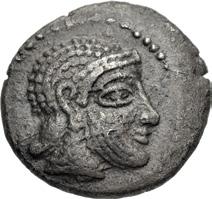
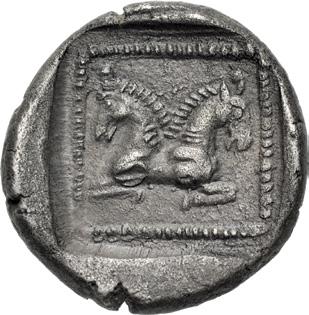
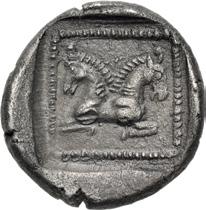
346. PHILISTIA (PALESTINE), Uncertain mint. Mid 5th century-333 BC. AR Drachm (17mm, 3.48 g, 3h). Bearded male head right, with oriental hairstyle / Two horse foreparts left and right, respectively, conjoined, in pelleted square within incuse square. Gitler & Tal XXVII.9D. Toned, light porosity, minor marks and scuff. Good VF. Very rare, and well struck for issue. ($3000)
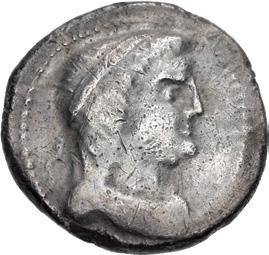
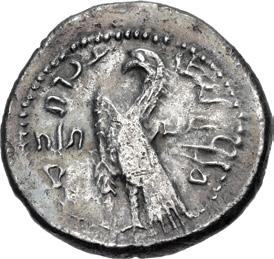
347. NABATAEA. Obodas II. Circa 30-9 BC. AR Half Shekel (22mm, 6.79 g, 12h). Pre-reform coinage. Petra
Dated RY 3 (28/7 BC). Diademed and draped bust right / Eagle standing left; tbt tn! (ŠNT TLT in Nabataean = year three [date]) across central field. CN 24; Barkay,
Meshorer, Nabataea –; DCA2 1011. Toned, some find patina, minor pitting, scratches, some die wear. VF. Struck on an unusually broad flan. Very rare. ($1000)

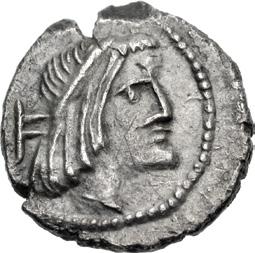

348. NABATAEA. Syllaios. Usurper, circa 9-6 BC. AR Half Sela’ (14mm, 2.32 g, 12h). Petra mint. Diademed head right / Eagle standing left. CN 69; Barkay, Usurper 1; Meshorer, Nabataea 40. Toned, edge split, some roughness, a few light scratches. EF. Exceptional for issue. Very rare. ($750)
Unpublished and Unique
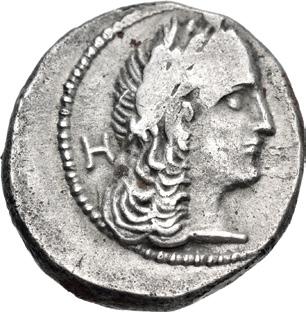
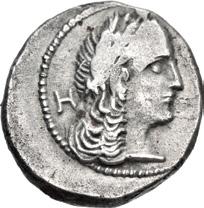
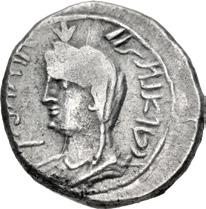
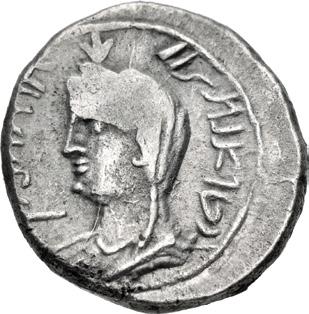
349. NABATAEA. Aretas IV, with Huldu. Circa 9/8 BC-AD 40. AR Sela’ – “Drachm” (16.5mm, 4.37 g, 12h). Petra mint. Dated RY 7 (3/2 BC). Laureate head of Aretas right; h (Nabataean Ḥ) to left / eT[∫n] B¬m ttrh (ḤRTT MLK NBṬW in Nabataean = Aretas King of the Nabataeans), veiled and draped bust of Huldu left, wearing diadem with Isis crown; 11W t[n! (ŠNT 7 in Nabataean = year 7 [date]) at end of legend to right. Unpublished, but cf. Triton XXVII, lot 361 for a similar type dated RY 6. Faintly toned, a little off center, area of weak strike. VF. Apparently unique. ($1000)
99
mint.
King 5;
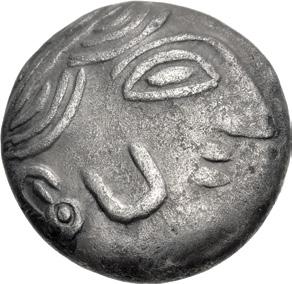
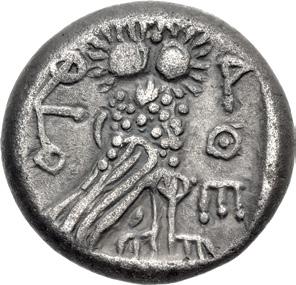

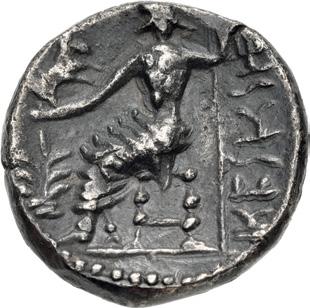
350. ARABIA, Northwestern. Lihyan. 2nd–1st centuries BC. AR Tetradrachm (23.5mm, 14.70 g, 10h). Imitating Athens. Helmeted head of Athena right, with frontal eye; upward crescent on cheek / Owl standing right, head facing; olive spray and crescent to left; all within incuse square. Huth, Athenian, fig. 5, a = Huth 39. Lightly toned, porous, faint marks and scratches. VF. Distinctive style. ($500)
351. ARABIA, Eastern. Mleiha. Uncertain. 2nd – 1st centuries BC. AR Tetradrachm (25mm, 15.96 g, 11h). Imitating the types of Alexander III of Macedon. Schematic head of Herakles right, wearing lion skin / ‘Ruler’ seated left on throne, holding scepter, extending right arm; on right arm, horse standing right; palm tree in left field. Van Alfen, Die, NS 3, 87a (O1/ R2 – this coin); Potts Class S4/5; Huth 127 (same obv. die). Find patina, light porosity. VF. Very rare. ($1000)
From the Norman Frank Collection. Ex Spink 165 (8 October 2003), lot 90.
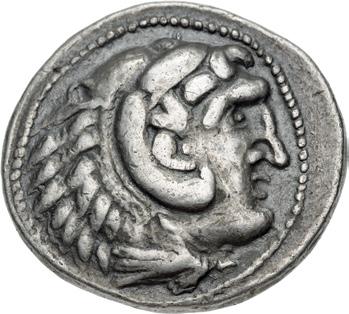
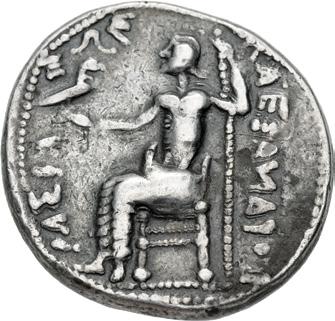
352. ARABIA, Uncertain. 3rd century BC. AR Tetradrachm (28mm, 16.63 g, 5h). Imitating type of Alexander III of Macedon from Amphipolis mint. Head of Herakles right, wearing lion skin / Zeus Aëtophoros seated left; no control marks. Cf. Le Rider, Suse 639 (fourrée); otherwise, unpublished. Toned, minor double strike on reverse. VF. ($1000)
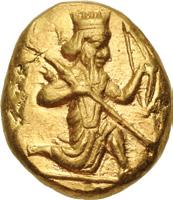
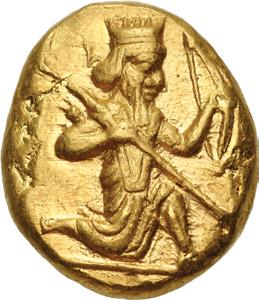
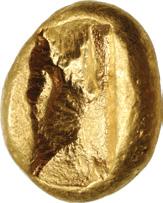
353. PERSIA, Achaemenid Empire. temp Xerxes I to Darios II. Circa 485-420 BC. AV Daric (14mm, 8.31 g). LydoMilesian standard. Sardes mint. Persian king or hero, wearing kidaris and kandys, quiver over shoulder, in kneeling-running stance right, holding spear and bow / Incuse punch. Carradice Type IIIb, Group A/B (pl. XIII, 27); Meadows, Administration 321; BMC Arabia pl. XXIV, 26; Sunrise 24. Lustrous. EF. Well centered and struck. ($2000)
Ex Classical Numismatic Group inventory 751123 (December 2004).
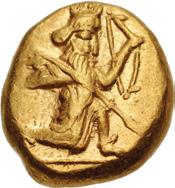
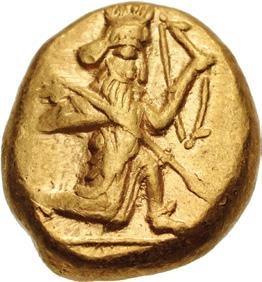
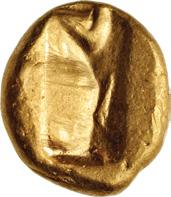
354. PERSIA, Achaemenid Empire. temp Xerxes I to Darios II. Circa 485-420 BC. AV Daric (14mm, 8.39 g). LydoMilesian standard. Sardes mint. Persian king or hero, wearing kidaris and kandys, quiver over shoulder, in kneeling-running stance right, holding spear and bow / Incuse punch. Carradice Type IIIb, Group A/B (pl. XIII, 27); Meadows, Administration 321; BMC Arabia pl. XXIV, 26; Sunrise 24. Near EF. Well centered and struck. ($1500)
From the Wild Rose Collection, purchased from Calgary Coin Gallery, April 2015.
100
350 351
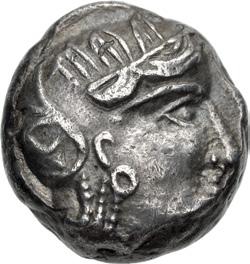
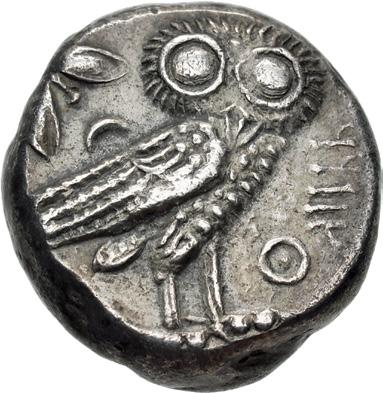
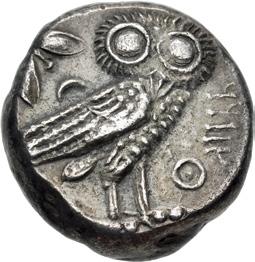
355. PERSIA, Alexandrine Empire. Mazakes. Satrap of Mesopotamia, circa 331-323/2 BC. AR Tetradrachm (20mm, 16.99 g, 7h). Imitating Athens. Helmeted head of Athena right, with profile eye / Owl standing right, head facing; olive spray and crescent to left, small Q and kdzM (MZDK in Aramaic) to right. Le Rider, Alexander, pp. 214-9; Van Alfen, Owls, Group IVd, 97–8. Toned. VF. Excellent example for the type, without the usual test cut(s). ($1000)
From the Wild Rose Collection, purchased from Mike Vosper, 15 October 2014.
Impressive Mazaios Double Daric

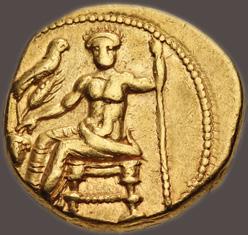
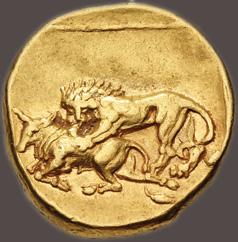
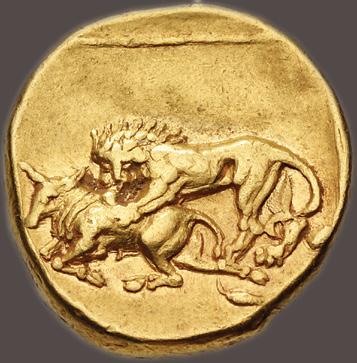
356. PERSIA, Alexandrine Empire. Mazaios. Satrap of Babylon, circa 331-328 BC. AV Double Daric (20mm, 17.09 g, 3h). Baal seated left, head and torso facing, holding scepter in right hand, grain ear and grape bunch on vine in left, upon which an eagle, wings folded, stands right / Lion left, grasping the back of a bull collapsing left, biting into its neck; all in linear square. F. Holt & O. Bopearachchi, The Alexander Medallion (2011), note 106; ibid. figs. 51–2 var. = Miho Museum, Treasures of Ancient Bactria (2002), 44 a–b var. (rev. type right); CNG 117, lot 322; Heritage 3073, lot 30206. For Mazaios’ Cilician silver prototype, cf. SNG Levante 100–6, and for similar local issues of the same type struck contemporaneously with this issue, cf. SNG BN 352–3. A little off center. VF. ($15,000)
This extraordinary gold issue, unknown until the discovery of two examples in the Mir Zakah II deposit, bears the familiar types used by Mazaios as satrap of Cilicia for his silver staters, but without the usual legend and monograms. Mazaios was appointed satrap of Cilicia about 361 BC, and the region known as ‘Across the River’ (modern Syria, Lebanon, and Israel) was later added to his domain. In 331 BC, as Alexander marched into the heart of the Persian Empire, Mazaios at first led a spirited resistance, then abruptly surrendered Babylon to him and switched sides. Alexander rewarded Mazaios by retaining him as governor, a position he held until his death in 328 BC. Alexander made Babylon one of his most important mints, where a large quantity of regular ‘imperial’ coinage was struck. Babylon also produced a substantial group of local coinages, and it is among these that the present type is to be placed. Persian gold was routinely issued without legend, as were many of Mazaios’ standard double darics of the ‘running king’ type (MIG Type 14 = BMC Persia XX, 1). Perhaps it was an initial emergency issue that was later superseded, or perhaps it was a local variation for a special purpose.
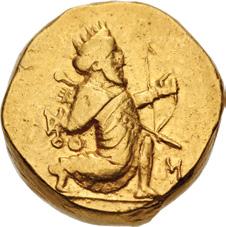

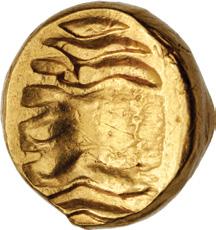
357. PERSIA, Alexandrine Empire. temp Stamenes – Seleukos. Satraps of Babylon, circa 328/3-311 BC. AV Double Daric (17.5mm, 16.69 g). Babylon mint. Persian king or hero, wearing kidaris and kandys, quiver over shoulder, in kneelingrunning stance right, holding spear in right hand, bow in left; ± and o to left, Â to right / Patterned incuse punch. NicoletPierre 3; Babelon, Perses 113; Traité II 754; SNG Berry 1454. Area of weak strike, some die wear. Good VF. ($5000)
From the Wild Rose Collection. Ex Pars Coins 2 (15 July 2019), lot 168.
101
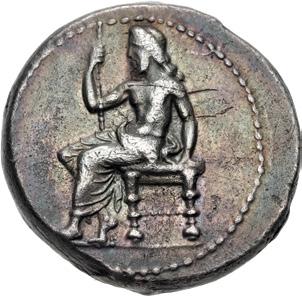
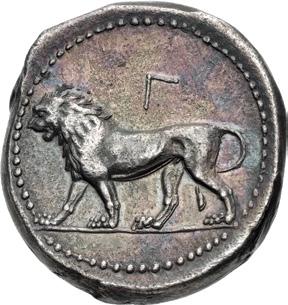
358. PERSIA, Alexandrine Empire. temp Stamenes – Seleukos. Satraps of Babylon, circa 328/3-311 BC. AR Stater (24mm, 16.64 g, 1h). Babylon mint. Baal seated left, holding scepter propped on thigh / Lion advancing left; ˝ above. NicoletPierre 7. Deep iridescent tone, minor scratches, flan flaw and small die break on obverse. Good VF. ($500)
From the Wild Rose Collection, purchased from Warden Numismatics, January 2018. Ex Spink 221 (2 December 2013), lot 20.
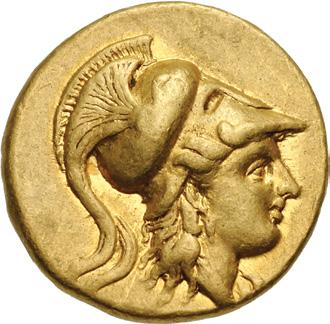


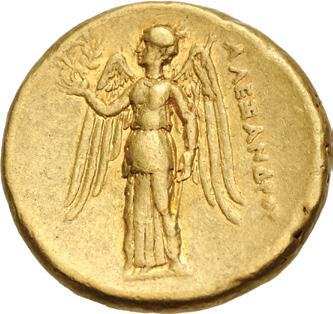
359. PTOLEMAIC KINGS of EGYPT. Ptolemy I Soter. As satrap, 323-305/4 BC. AV Stater (18mm, 8.52 g, 12h). In the name and types of Alexander III of Macedon. Memphis mint. Struck circa 323 BC. Helmeted head of Athena right / Nike standing left, holding wreath and cradling stylis; no control marks. CPE 2; Svoronos –; Zervos Issue 72, dies 727/– (unlisted rev. die); Price 3961. Underlying luster. VF. ($3000)
From the Jonathan K. Kern Collection.


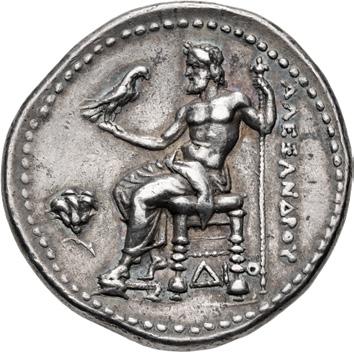
360. PTOLEMAIC KINGS of EGYPT. Ptolemy I Soter. As satrap, 323-305/4 BC. AR Tetradrachm (28mm, 17.11 g, 12h). In the name and types of Alexander III of Macedon. Memphis or Alexandreia mint. Struck circa 323-317 BC. Head of Herakles right, wearing lion skin / Zeus Aëtophoros seated left; rose in left field, d5-o below throne. CPE 19; Svoronos –; Zervos Issue 2C, dies 205/– (unlisted rev. die); Price 3971; Kraay & Hirmer 569 (same obv. die). Attractive iridescent tone, minor double strike on obverse. Near EF. Well centered and of fine style. ($1500)
Ex Edward J. Waddell inventory 48004 (ND); Baron di Portanova Collection (Spink 172, 31 March 2005), lot 50.
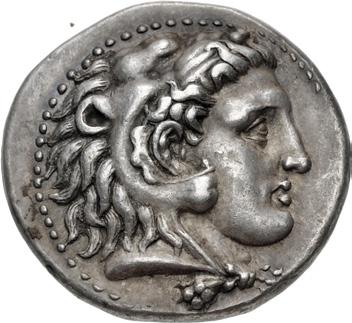
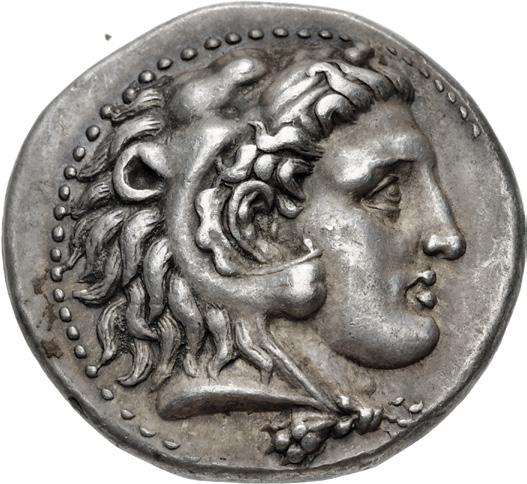
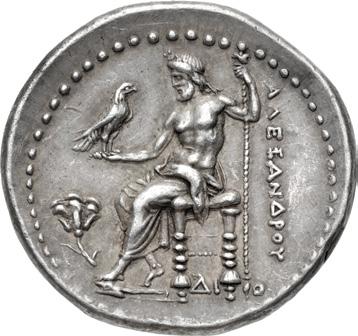
361. PTOLEMAIC KINGS of EGYPT. Ptolemy I Soter. As satrap, 323-305/4 BC. AR Tetradrachm (28.5mm, 17.17 g, 12h). In the name and types of Alexander III of Macedon. Memphis or Alexandreia mint. Struck circa 323-317 BC. Head of Herakles right, wearing lion skin / Zeus Aëtophoros seated left; rose in left field, d5-o below throne. CPE 19; Svoronos –; Zervos Issue 2C, dies 205/– (unlisted rev. die); Price 3971. Attractively toned, trace deposits, a few faint scratches, small mark in field on reverse. Good VF. Fine style. ($1500)
From the Wild Rose Collection, purchased from Marc Walter, November 2014.
102

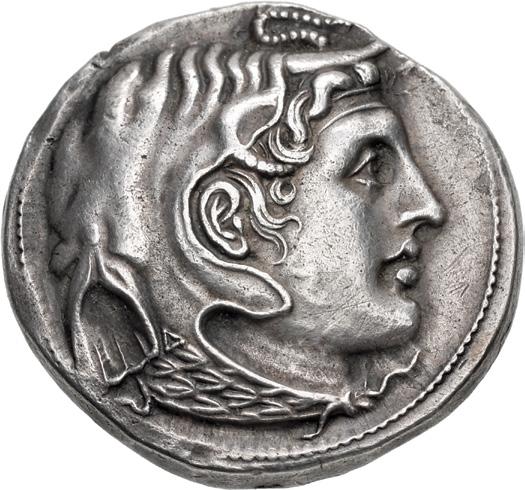
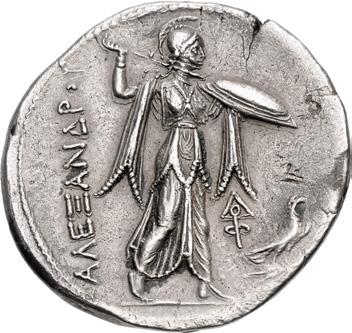
362. PTOLEMAIC KINGS of EGYPT. Ptolemy I Soter. As satrap, 323-305/4 BC. AR Tetradrachm (28mm, 16.83 g, 12h). Attic standard. In the name of Alexander III of Macedon. Alexandreia mint. Struck circa 307/6 BC. Diademed head of the deified Alexander right, wearing elephant skin, aegis around neck with tiny d in scales / Athena Alkidemos advancing right; to right, » and eagle standing right on thunderbolt. CPE 56; Svoronos 37; Zervos Issue 21, dies 304/– (unlisted obv. die); SNG Copenhagen –. Toned, trace deposits, some faint scratches, a few tiny flan flaws and minor double strike on reverse. Near EF. ($2000)
Ex Berk BBS 209 (23 March 1995), lot 176.
Extremely Rare and Pedigreed to 1935

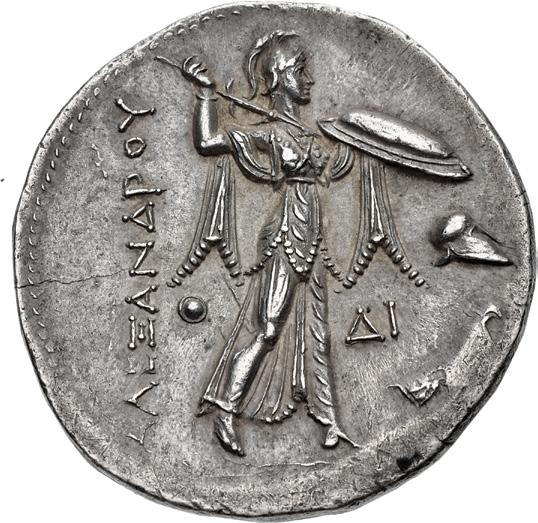

363. PTOLEMAIC KINGS of EGYPT. Ptolemy I Soter. As satrap, 323-305/4 BC or king, 305/4-282 BC. AR Tetradrachm (27.5mm, 15.75 g, 1h). Ptolemaic standard. In the name of Alexander III of Macedon. Alexandreia mint. Struck circa 306-300 BC. Diademed head of the deified Alexander right, wearing elephant skin, aegis around neck / Athena Alkidemos advancing right; small round shield to inner left; to right, helmet, d5, and eagle standing right on thunderbolt. CPE 74; Svoronos 176; Zervos Issue 32 (dies 532/a – this coin referenced); SNG Copenhagen –; Künker 111, lot 6343 = Banque Populaire du Nord FPL April 1987, no. 258 (same dies). Attractive old collection tone, hairline flan crack, minor area of flat strike at edge on reverse. EF. Extremely rare issue, one of only six noted by Zervos, with one additional in CoinArchives; five are in museum collections (Alexandria [Graeco-Roman Museum], Berlin [Staatliche Museen, 2 coins], New York [ANS], and Paris [BN]). ($2000)
From the Wild Rose Collection. Ex Triton XXII (8 January 2019), lot 403; Santamaria (24 January 1938), lot A168; Richard Cartwright Collection (Münzhandlung Basel 4, 1 October 1935), lot 949. Lot also includes two old collection tickets.

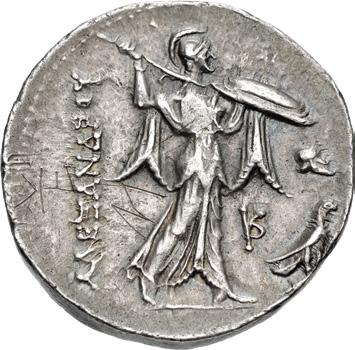
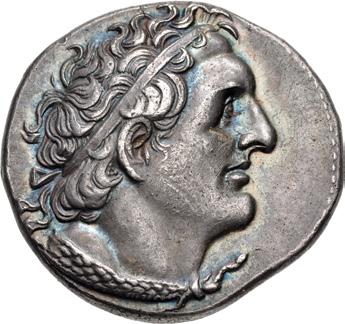
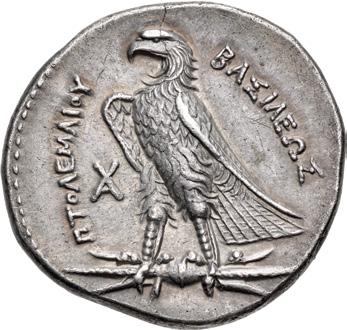
364. PTOLEMAIC KINGS of EGYPT. Ptolemy I Soter. As satrap, 323-305/4 BC, or king, 305/4-282 BC. AR Tetradrachm (28.5mm, 15.69 g, 1h). Ptolemaic standard. In the name of Alexander III of Macedon. Alexandreia mint. Struck circa 306-300 BC. Diademed head of the deified Alexander right, wearing elephant skin, aegis around neck with tiny d in scales / Athena Alkidemos advancing right; to right, ’, Corinthan helmet right, and eagle standing right on thunderbolt. CPE 70; Svoronos 164; Zervos Issue 29, dies 517/b; SNG Copenhagen –; Noeske –; SNG Lockett 3393; Weber 8226 (same obv. die). Deep cabinet tone, with some iridescence, minor marks, slight die shift and graffiti in fields on reverse. Good VF. ($1000)
From the Mesogeios Collection.
365. PTOLEMAIC KINGS of EGYPT. Ptolemy I Soter. 305/4-282 BC. AR Tetradrachm (28mm, 14.87 g, 1h). Alexandreia mint. Struck circa 294-282 BC. Diademed head right, wearing aegis around neck, tiny d behind ear / Eagle standing left on thunderbolt; ( to left. CPE 141a; Svoronos 234; SNG Copenhagen –. Iridescent tone, minor flan crack, light scratches and marks, edge marks. Good VF. ($750)
Ex Victor England inventory 81651 (ND); Stack’s (8 September 1988), lot 673.
103
364
365
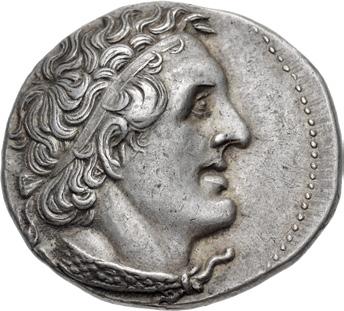
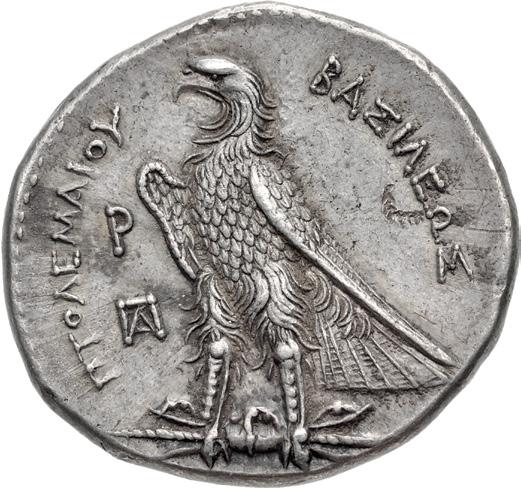
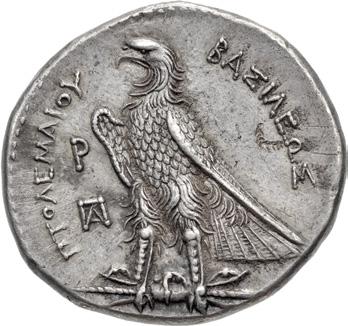
366. PTOLEMAIC KINGS of EGYPT. Ptolemy I Soter. 305/4-282 BC. AR Tetradrachm (28mm, 14.23 g, 12h). Alexandreia mint. Struck circa 294-282 BC. Diademed head right, wearing aegis around neck, tiny d behind ear / Eagle standing left on thunderbolt; to left, r above ,. CPE 154; Svoronos 256; SNG Copenhagen –. Attractive old collection tone, trace deposits, hairlines, zig-zag pattern and light graffito in field on reverse. Good VF. ($750)
From the Jeffrey H. Miller Collection.


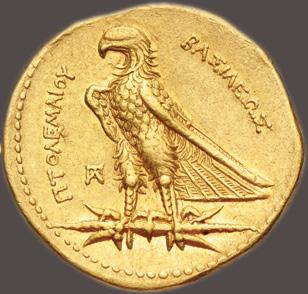

367. PTOLEMAIC KINGS of EGYPT. Ptolemy I Soter. 305/4-282 BC. AV Trichryson – ‘Pentadrachm’ (24.5mm, 17.75 g, 12h). Alexandreia mint. Struck circa 294-282 BC. Diademed head right, wearing aegis around neck, small d behind ear / ∫Ås5¬EWs πto¬EµÅ5oU, eagle standing left on thunderbolt; O to left. CPE 166; Svoronos 210; SNG Copenhagen –; Boston MFA 2263; Dewing 2740. Minor edge marks, small flan flaw on obverse. Good VF. ($10,000)
From the Wild Rose Collection, purchased from Calgary Coin Gallery, August 2015. Ex CNG inventory 735221 (April 2003); Gorny & Mosch 121 (10 March 2003), lot 285.
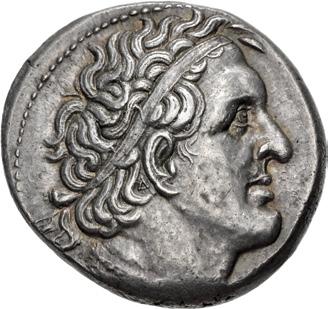

368. PTOLEMAIC KINGS of EGYPT. Ptolemy I Soter. 305/4-282 BC. AR Tetradrachm (26.5mm, 14.25 g, 12h). Alexandreia mint. Struck circa 294-282 BC. Diademed head right, wearing aegis around neck, tiny d behind ear / Eagle standing left on thunderbolt; to left, r above O. CPE 168; Svoronos 255; SNG Copenhagen 70–1. Old collection tone. Near EF. ($1500)
From the Wild Rose Collection, purchased from Edward J. Waddell (inv. 56908), 3 October 2023. Ex Classical Numismatic Group 38 (6 June 1996), lot 556.
104
Pedigreed to 1958
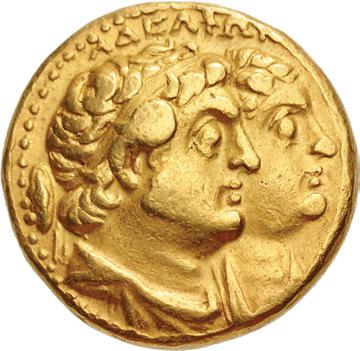
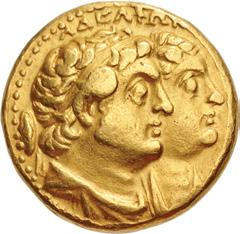
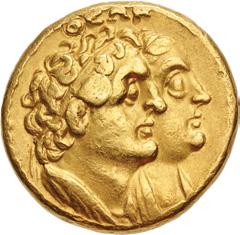

369. PTOLEMAIC KINGS of EGYPT. Ptolemy II Philadelphos, with Arsinöe II, Ptolemy I, and Berenike I. 285246 BC. AV Half Mnaïeion – ‘Tetradrachm’ (19.5mm, 13.80 g, 12h). Alexandreia mint. Struck circa 272-261/0 BC. Conjoined busts of Ptolemy II and Arsinöe II right; Ptolemy is diademed and draped, Arsinöe is diademed and veiled; ÅdE¬fW@ above, shield to left / Conjoined busts of Ptolemy I and Berenike I; Ptolemy is diademed and draped, Berenike is diademed and veiled; QEW@ above. CPE 314; Svoronos 604; Olivier & Lorber dies 8/24; SNG Copenhagen 133; Adams III 2084; Boston MFA 2275; Dewing 2753-4; Noeske 38. A few minor marks. Good VF. ($4000)
From the Jeffrey H. Miller Collection. Ex G. Hirsch 16 (16 April 1958), lot 133.
From the First Issue of Arsinoe Dekadrachms
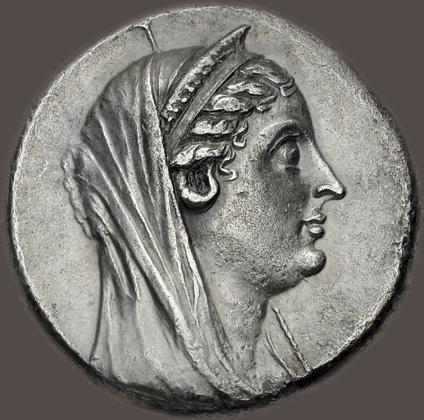
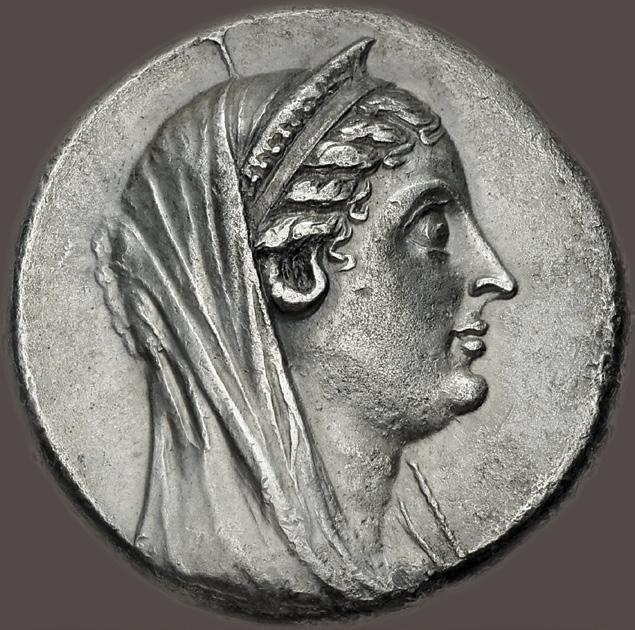
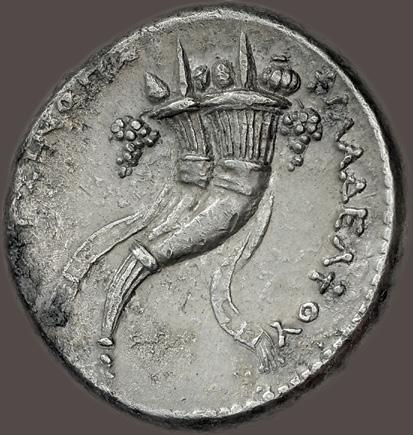
370. PTOLEMAIC KINGS of EGYPT. Arsinoe II Philadelphos. Died 270/268 BC. AR Dekadrachm (34.5mm, 35.13 g, 11h). Alexandreia mint. Struck under Ptolemy II, circa 270-261/0 BC. Head right, with ram’s horn, veiled and wearing stephane; lotus-tipped scepter in background / År%5@o˙% f5¬ÅdE¬foU, double cornucopia with grape bunches hanging at sides, bound with fillet. CPE 320 (Ptolemy II); Svoronos 409; Troxell, Arsinoe, Group 3, p. 41 and pl. 2, 1 (same obv. die); SNG Copenhagen –. Lightly toned, traces of find patina, spots of porosity and roughness, some marks. Near EF. From the very rare first issue of Arsinoe dekadrachms, the sole unmarked issue in the series. ($10,000)
Arsinoe II, daughter of Ptolemy I and Berenike I, was born in 316 BC. Her early life saw her married off to Lysimachos of Thrace at the age of 15 and then to her half-brother, the brutal Ptolemy Keraunos. She conspired against the latter and was forced to flee circa 280 BC to the protection of Egypt, ruled by her younger full brother, Ptolemy II. Her beauty, charm and intelligence utterly captivated Ptolemy, and, after eliminating his previous wife with an accusation of treason, Arsinoe married her brother, probably about 276 BC. Sibling marriage was traditional among Egyptian royalty, but among the Greeks it was known only between deities; thus their union advanced the concept of rulers being worshipped as divinities. Though unscrupulous, Arsinoe proved a capable queen and co-ruler, taking charge of Egypt’s foreign affairs. Her death in 270 or 268 BC was marked by her full deification and a huge outpouring of gold and silver coinage bearing her veiled portrait. The ram’s horn just visible emerging from the veil is a further symbol of her deification, reminiscent of the horn of Ammon on images of the deified Alexander.
105
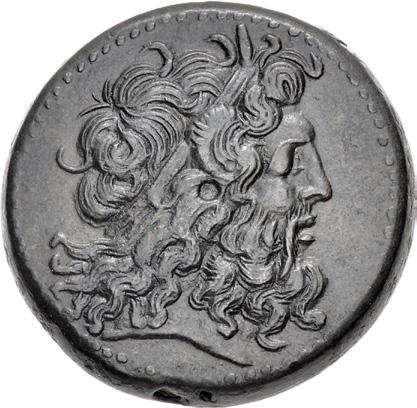
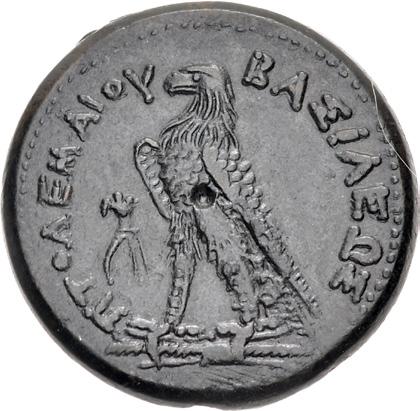
371. PTOLEMAIC KINGS of EGYPT. Ptolemy III Euergetes. 246-222 BC. Æ Hemidrachm – Triobol (34.5mm, 34.55 g, 12h). Alexandreia mint. Series 5A. Horned head of Zeus-Ammon right, wearing tainia with basileion / Eagle standing left on thunderbolt; filleted cornucopia to left, no control marks. CPE B393; Svoronos 1003; SNG Copenhagen 189-90. Attractive even dark brown patina. EF. ($750)
Ex Jack A. Frazer Collection (Classical Numismatic Group 114, 13 May 2020), lot 440; Freeman & Sear FPL 7 (Spring 2003), no. G99.
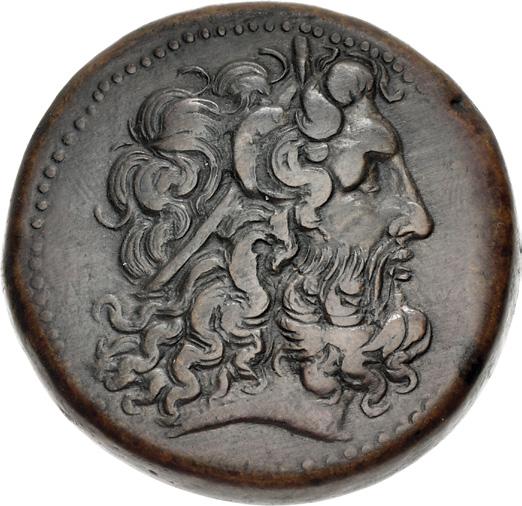

372. PTOLEMAIC KINGS of EGYPT. Ptolemy III Euergetes. 246-222 BC. Æ Drachm (43mm, 74.64 g, 12h). Alexandreia mint. Series 5B. Horned head of Zeus-Ammon right, wearing tainia with basileion / Eagle standing left on thunderbolt; cornucopia to left, ^ between legs. CPE B395; Svoronos 964; SNG Copenhagen 171–2. Attractive dark brown surfaces, with reddish hues. VF. ($500)
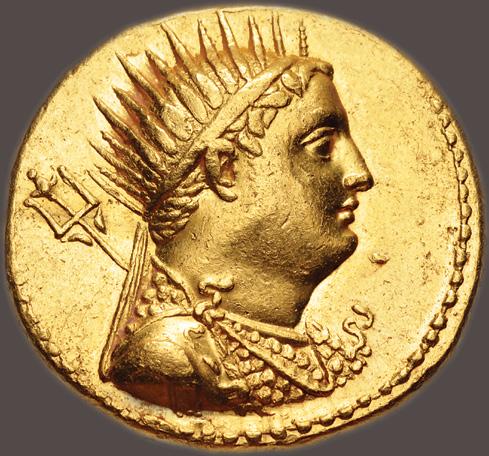
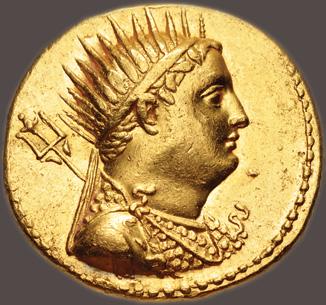
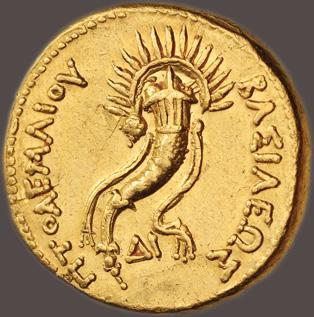
373. PTOLEMAIC KINGS of EGYPT. Ptolemy III
11h). Posthumous issue
Ptolemy IV.
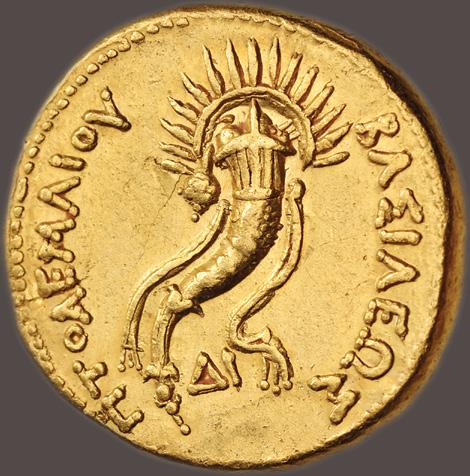
Mnaïeion
Struck circa 219-217 BC. Bust of the deified Ptolemy III right, wearing radiate diadem and aegis; trident over left shoulder, middle prong ends in a lotus finial / ∫Å%5¬EW% ∏to¬EÂÅ5oU, radiate and filleted cornucopia; d5 below. CPE 888; Svoronos 1117; Olivier & Lorber
3/10; SNG Copenhagen 196. Lustrous, a couple tiny die breaks and usual light die rust on obverse, minor lamination on reverse. Good VF. ($10,000)
From the Wild Rose Collection. Ex J.B. Collection (Classical Numismatic Group Electronic Auction 455, 30 October 2019), lot 196, purchased from Calgary Coin Gallery, Spring 2016.
106
Euergetes. 246-222 BC. AV
– “Oktadrachm” (26mm, 27.82 g,
under
Alexandreia mint.
dies
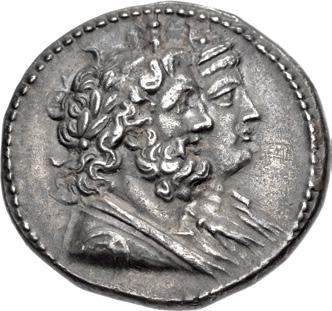
Ex 1922 Delta Hoard


374. PTOLEMAIC KINGS of EGYPT. Ptolemy IV Philopator. 222-205/4 BC. AR Tetradrachm (27mm, 13.98 g, 12h). Alexandreia mint. Struck circa 219-217 BC. Jugate draped busts right of Serapis and Isis / Eagle standing left, head right, on thunderbolt; filleted double cornucopia over shoulder, d5 between legs. CPE 892; Svoronos 1123–4; Landvatter Group 4, 44a (O12/R33 – this coin, illstrated, but erroneously as 43a on the plate); SNG Copenhagen 197-8. Old cabinet tone, patches of find patina, a few minor scratches. Good VF. ($2000)
From the Wild Rose Collection, purchased from Shanna Schmidt, 16 January 2020. Ex Künker 288 (13 March 2017), lot 242; Leu 7 (9 May 1973), lot 471; Ars Classica & Naville XII (27 June 1928), lot 2604; Delta, 1922 Hoard (IGCH 1690).
Extremely rare
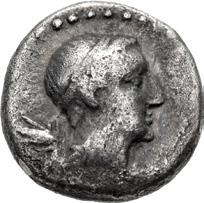

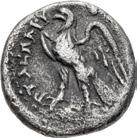

375. PTOLEMAIC KINGS of EGYPT. Ptolemy V Epiphanes. First sole reign, 180-170 BC. AR Triobol (11mm, 1.48 g, 12h). Uncertain mint on Cyprus. Diademed head right; half-thunderbolt behind neck / Eagle, with spread wings, standing left on thunderbolt; no control marks. CPE 1019; Svoronos 1787; Olivier 2572–4; SNG Copenhagen Supp. 1324. Lightly toned, minor granularity. VF. Extremely rare, only three noted by Olivier, none in CoinArchives. ($1000)
Second Known

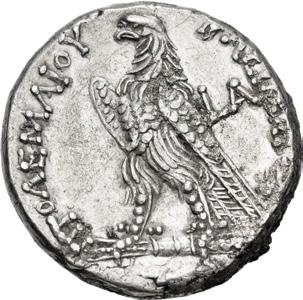
376. PTOLEMAIC KINGS of EGYPT. Ptolemy V Epiphanes. 204-180 BC. AR Tetradrachm (24mm, 14.06 g, 12h). Uncertain mint in the Levant. Dated RY 1 (204 BC). Diademed head of Ptolemy I right, aegis around neck / Eagle standing left on thunderbolt; lÅ to right. CPE 1038; Svoronos 1192 var. (dated RY 4, but same obv. die as illustration); Olivier 2931–4 var. (same; obv. die D3); SNG Copenhagen 1303 var. (same; same obv. die); DCA2 1102 (same dies as illustration). Horn silver, cleaning scratches. Near EF. Extremely rare date, only one example published, in the collection of the author of DCA2. ($500)
107
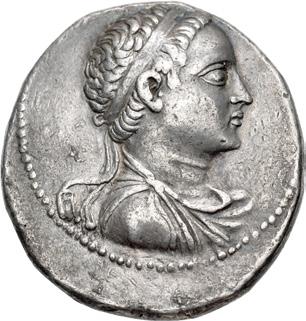
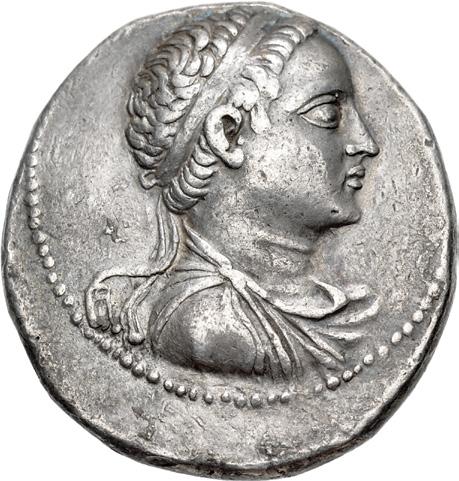
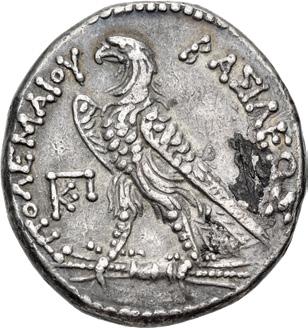
377. PTOLEMAIC KINGS of EGYPT. Ptolemy V Epiphanes. 204-180 BC. AR Tetradrachm (25mm, 13.96 g, 12h). Uncertain mint 46, probably on the Levantine Coast. Struck circa 199/8 BC. Diademed and draped bust right / Eagle standing left on thunderbolt; ò to left. CPE 1109; Svoronos 1258; Carlen & Lorber p. 169; Mørkholm, Coins 21 (A4/P7); SNG Copenhagen Supp. 1301 var. (also wearing aegis). Toned, patches of find patina, a few hairlines. VF. Rare. ($1500)
From the Wild Rose Collection.
The boy king Ptolemy V was the only Ptolemaic ruler, other than the first, to strike coins with his own portrait in significant numbers. Following his reign, subsequent Ptolemaic rulers reverted to the practice of depicting Ptolemy I Soter on their silver coinage, with a very few exceptions.
Extremely Rare Issue
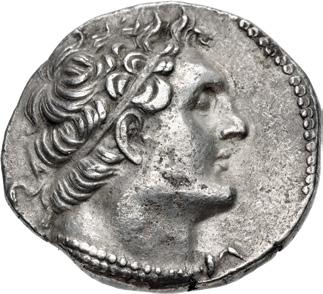
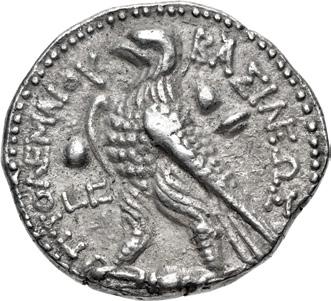
378. PTOLEMAIC KINGS of EGYPT. Ptolemy VI Philometor. First sole reign, 180-170 BC. AR Tetradrachm (26mm, 14.09 g, 12h). Salamis mint. Dated RY 6 (176/5 BC). Diademed head of Ptolemy I right, aegis around neck / Eagle standing left on thunderbolt; piloi of the Dioskouroi across upper field, l4 (date) to left, petasos with diadem to right. Svoronos 1330; Olivier 273–6 (V56/R145); Mørkholm & Kromann 44–7 (A9/P27); SNG Copenhagen 566 var. (mint signature on rev.; same obv. die). Lightly toned, trace deposits, struck with worn reverse die. Near EF. Extremely rare issue without mint signature, only four noted by Olivier (all in public collections), none in CoinArchives. ($750)
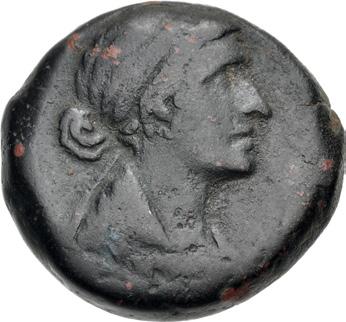
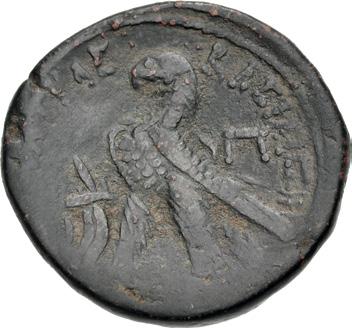
379. PTOLEMAIC KINGS of EGYPT. Kleopatra VII Thea Neotera. 51-30 BC. Æ Diobol – 80 Drachmai (28mm, 18.12 g, 12h). Alexandreia mint. Diademed and draped bust right / Eagle standing left on thunderbolt; cornucopia to left, ∏ (mark of value) to right. Svoronos 1871; SNG Copenhagen 419–21. Dark brown surfaces, light deposits. Near VF. Good portrait. ($750)

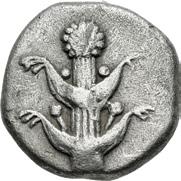
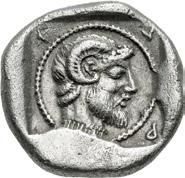

380. KYRENAICA, Kyrene. Circa 475-435 BC. AR Drachm (15mm, 3.33 g, 3h). Asiatic standard. Period II, Group I. Silphion plant / Head of Zeus Ammon right in dotted circle; all within incuse square. Buttrey, Catalogue 88–9; BMC 50; SNG Copenhagen 1177. Lightly granular surfaces, spot of weak strike on obverse. VF. Struck on a broad flan. ($1000)
108
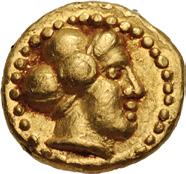


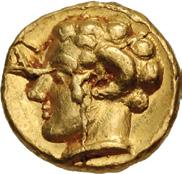
381. KYRENAICA, Kyrene. Circa 331-322 BC. AV Tenth Stater (7.5mm, 0.88 g, 11h). Jason, magistrate. Head of Kyrene right / Head of Apollo Karneios left. Naville 42 (same dies); SNG Copenhagen –. Lustrous, die breaks on reverse, edge marks. Near EF. Well centered and struck. Very rare, only three noted by Naville, one in CoinArchives. ($500)
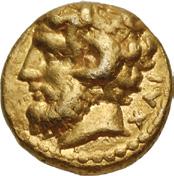



382. KYRENAICA, Kyrene. temp. Ophellas. Ptolemaic governor, first reign, circa 322-313 BC. AV Tenth Stater (7mm, 0.86 g, 12h). Chairis, magistrate. Head of Ammon left / Head of the nymph Kyrene facing slightly right. Naville 114 (same dies); SNG Copenhagen 1213 (same dies); BMC 139 (same dies). Underlying luster. Good VF. Well centered and struck. Exceptional for issue. ($1000)
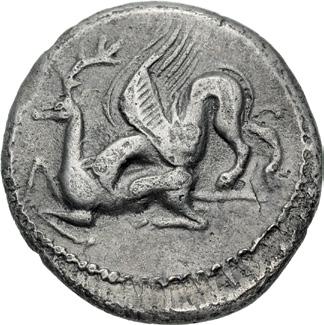
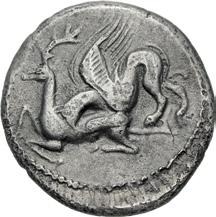
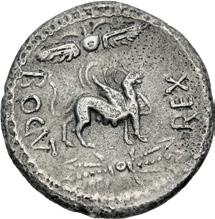
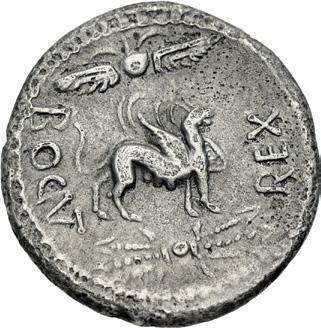
383. KINGS of MAURETANIA. Bogud. 49-38 BC. AR Denarius (18mm, 3.55 g, 6h). Caesarea mint. Griffin left, attacking recumbent stag left / Griffin standing right; winged solar disk above, thunderbolt below. Mazard 104; MAA 57; SNG Copenhagen 536 (same dies). Toned, porous. VF. Very rare, four in CoinArchives. ($1500)
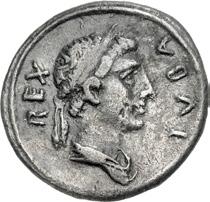

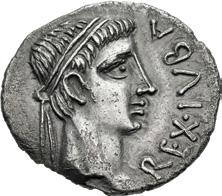

384. KINGS of MAURETANIA. Juba II, with Ptolemy. 25 BC-AD 24. AR Denarius (17mm, 2.70 g, 1h). Caesarea mint. Dated RY 31 (AD 6). Diademed and draped bust of Juba right / Diademed and draped bust of Ptolemy right. Spoerri-Butcher Group 4.a, dies H1/R– (unlisted rev. die); Mazard 377; MAA 133; SNG Copenhagen –. Toned, some find patina, minor roughness and porosity, a few faint scratches. VF. Well centered. Very rare, only eight examples recorded by Spoerri-Butcher, two additional in CoinArchives (Roma E-60, lot 106 [hammer £2600], and Roma XVII, lot 340 [hammer £4200]). ($750)
385. KINGS of MAURETANIA. Juba II. 25 BC-AD 24. AR Denarius (18mm, 2.61 g, 4h). Caesarea mint. Dated RY 45 (AD 20/1). Diademed head right / Hippocamp right, cornucopia on shoulder; globe to right. Spoerri-Butcher Group 49.a, 525–34 var. (unlisted dies); Mazard 217; MAA 185; SNG Copenhagen 597. Toned, edge chip, scratches, areas of roughness, stress cracks at edge on obverse. Good VF. ($500)
109
384 385
ORIENTAL GREEK COINAGE
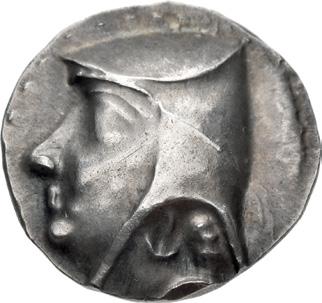
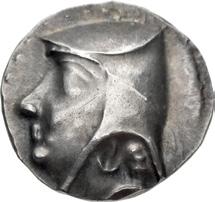
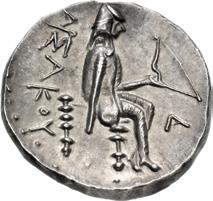

386. KINGS of PARTHIA. Arsakes I. 247-211 BC. AR Drachm (18mm, 4.19 g, 11h). Hekatompylos mint. Head left, wearing bashlyk / Archer (Arsakes I) seated right on backless throne, holding bow; ~ to right. Sellwood 5.1 (Arsakes II); A&S Type 5, 11 (Arsakes II; same dies); Sunrise 240; Shore 3 (Arsakes II). Iridescent toning, obverse struck with worn die. EF. ($750)
Ex Classical Numismatic Group 123 (33 May 2023), lot 297.
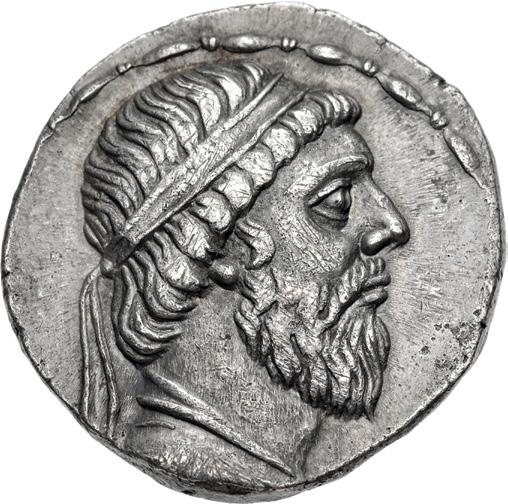
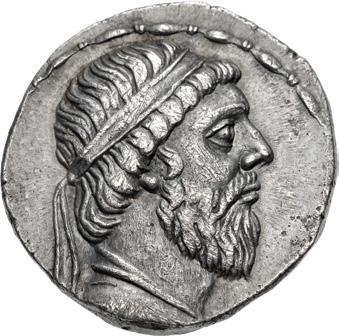
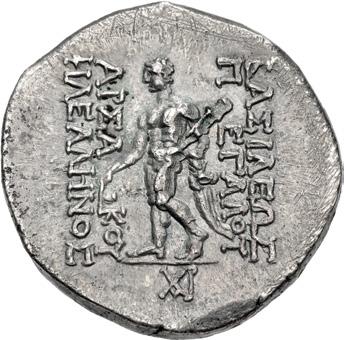
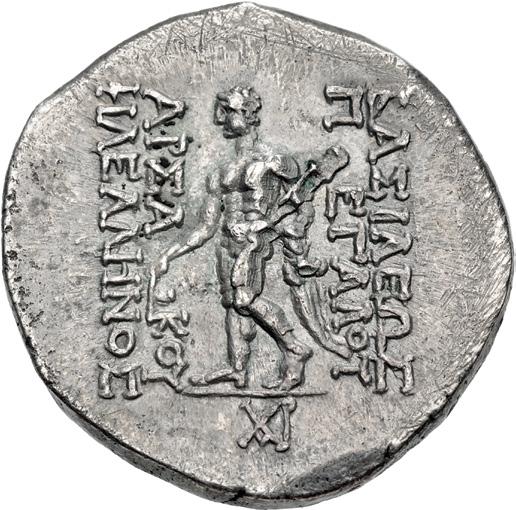
387. KINGS of PARTHIA. Mithradates I. 165-132 BC. AR Tetradrachm (28mm, 15.34 g, 12h). Seleukeia on the Tigris mint. Struck circa 141/0 BC. Diademed and draped bust right, within bead-and-reel border / ∫Å%5¬EW% ÂE˝ Ŭo U År%Å ˚oU f5¬E¬¬˙ @o%, diademed and beardless young Herakles standing left, holding skyphos in extended right hand and cradling club in lion skin-draped left arm; Q in exergue. Sellwood 13.2; Sunrise 260; Shore 35. Toned with iridescence, slight porosity and hint of double strike, scratches on reverse. Good VF. Rare and attractive example. ($5000)
Ex Triton VI (14 January 2003), lot 500.
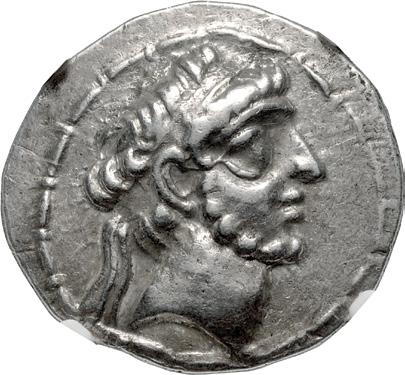
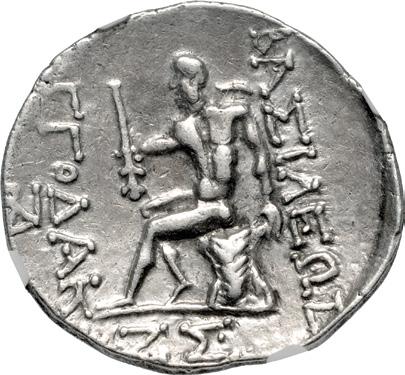
388. KINGS of CHARACENE. Apodakos. Circa 124-104/03 BC. AR Tetradrachm (33mm, 16.33 g, 12h). CharaxSpasinu mint. Dated SE 207 (106/5 BC). Diademed head right / Herakles seated left on rock, holding club on knee; i to outer left; Z% (date) in exergue. Alram 495 var. (date); De Morgan 2 and pl. XL, 3 var. (same); BMC –; Sunrise –; DCA 481. In NGC encapsulation 6557964-002, graded Ch VF, Strike: 5/5, Surface: 4/5. ($1000)

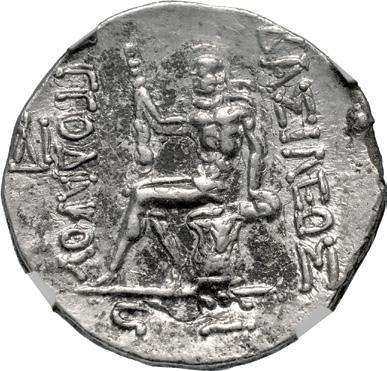
389. KINGS of CHARACENE. Apodakos. Circa 124-104/03 BC. AR Tetradrachm (33mm, 16.33 g, 12h). CharaxSpasinu mint. Dated SE 207 (106/5 BC). Diademed head right / Herakles seated left on rock, holding club on knee; i to outer left; ?% (date) in exergue. Alram 495 var. (date); De Morgan 2 and pl. XL, 3 var. (same); BMC –; Sunrise –; DCA 481. In NGC encapsulation 6826440-003, graded Ch VF, Strike: 4/5, Surface: 3/5. Overstruck on an Antioch on the Orontes mint tetradrachm of Antiochos VII Euergetes (Sidetes) (SC 2061.2). ($500)
110
Interesting Alexander III Type Overstrikes
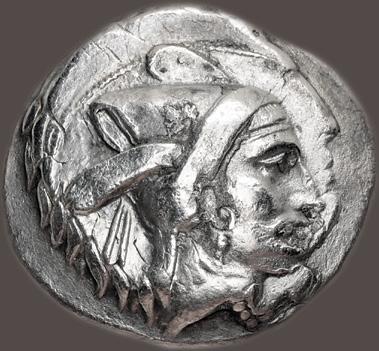
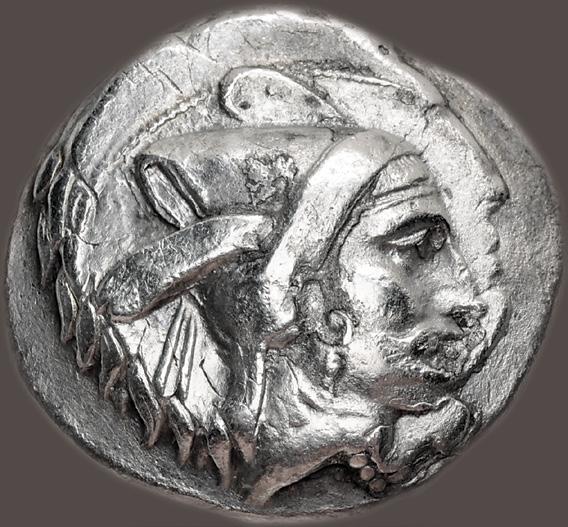
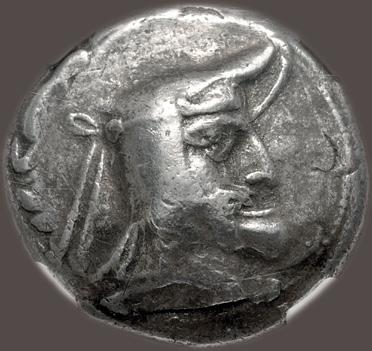
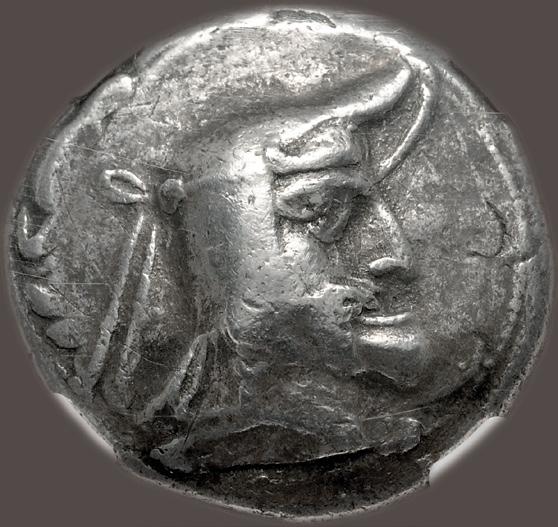
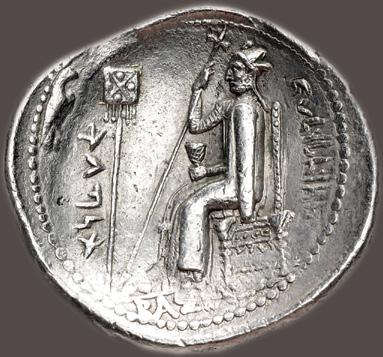

390. KINGS of PERSIS. Baydād (Bagadat). Early 3rd century BC. AR Tetradrachm (32mm, 16.69 g, 12h). “Coronation” type. Istakhr (Persepolis) mint. Head right, with short beard, mustache, and earring, wearing kyrbasia with flaps tied behind / Baydād enthroned left, holding scepter and cup; standard to inner left; !3%;! (’lhy’ = of the gods in Aramaic up left), !KR†Rp †D3b (bgdt prtrk’ = Baydad frataraka in Aramaic) down right. van’t Haaff, Persis, Type 511/514 a (same obv. die as illustration); K&M 2/1; Alram 511; Sunrise 557. Light iridescenct toning, slight porosity/die rust, cleaning marks/minor smoothing, k’m in Aramic graffiti on obverse. Good VF. Overstruck on a Babylon I or II mint tetradrachm of Seleukos I as king in the name and types of Alexander III. ($4000)
391. KINGS of PERSIS. Vādfradād (Autophradates) I. 3rd century BC. AR Tetradrachm (30mm, 16.68 g, 12h). Istakhr (Persepolis) mint. Diademed head right, wearing kyrbasia / Fire temple of Ahura-Mazda; to left, Vādfradād standing right; bow set on ground before; standard to right; RP†w (wtpr in Aramaic to outer right); P (p in Aramaic to inner right); ⁄%; (lh’ in Aramaic) in exergue. Cf. van’t Haaff Type 533/535/538; cf. K&M Nachtrage 2/18 (for a similar overstrike); Alram –; Sunrise –; Zeno –. In NGC encapsulation 6557964-001, graded VF, Strike: 4/5, Surface: 3/5. Overstruck on an uncertain mint in western Asia Minor tetradrachm of Alexander III of Macedon. ($1500)

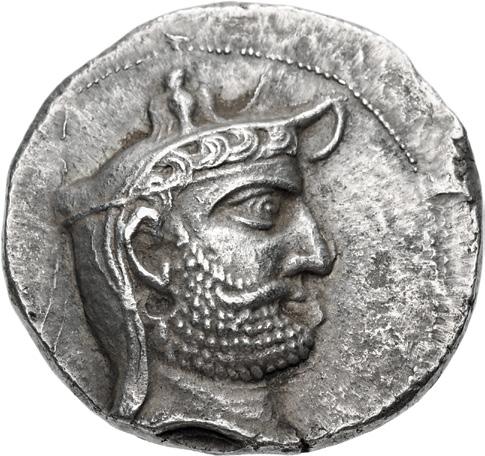
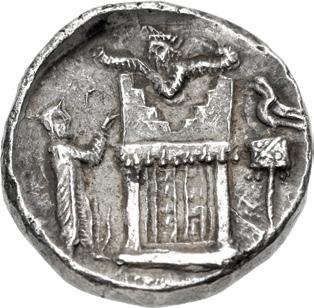
392. KINGS of PERSIS. Vādfradād (Autophradates) II. Early-mid 2nd century BC. AR Tetradrachm (25.5mm, 16.46 g, 10h). Istakhr (Persepolis) mint. Bearded head right, wearing diadem and kyrbasia adorned with eagle / Fire temple of Ahura-Mazda; above, half-figure of Ahura-Mazda; to left, Vādfradād standing right, bow before; to right, eagle standing left on standard; ! (’ in Aramaic) to inner right; traces of additional legend in exergue. van’t Haaff, Persis Type 546a (same obv. die as illustration) K&M 3/1 var. (no legend on rev. - same obv. die); Alram 546 var. (no legend on rev.); DeMorgan, pl. XXVIII, 7 and 10 var. (same); cf. BMC 1 (Darius[?]; for type); Sunrise –; MACW –; Roma XXI, lot 306 (same obv. die); Leu Web Auction 14, lot 648 (same obv. die); Nomos 14, lot 172 (same obv. die); VAuctions 354/Pars Coins 10, lot 111 = VAuctions 350/Pars Coins 7, lot 169 (same dies); CNG 111, lot 441 (same obv. die). Deposits, hairline die break on reverse. EF. ($1500)
Ex Hess-Divo 341 (13 December 2023), lot 43; Triton XXVI (9 January 2023), lot 456; Gorny & Mosch 228 (9 March 2015), lot 180.
111
390
391
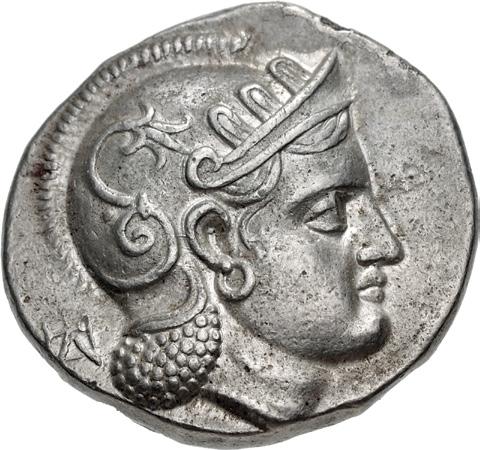
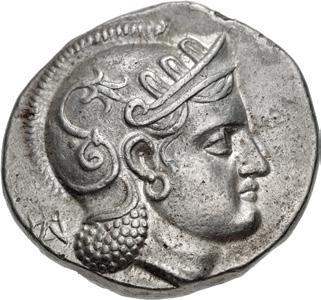
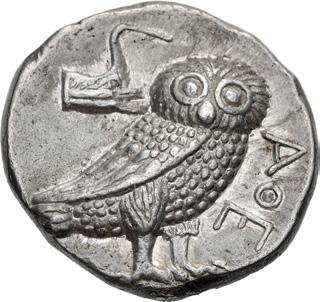
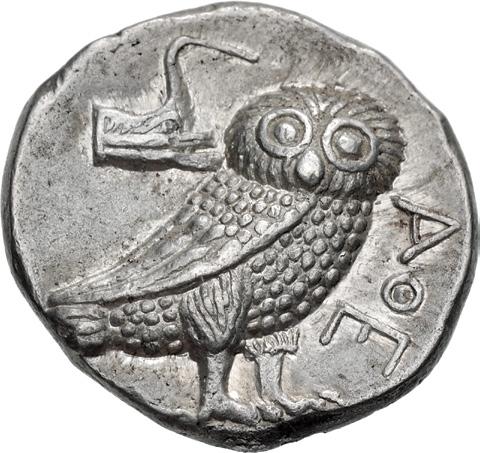
393. BAKTRIA, Local issues. Circa 295/3-285/3 BC. AR Tetradrachm (26mm, 17.07 g, 6h). Local standard. Uncertain mint in the Oxus region. Head of Athena right, wearing earring and crested Attic helmet decorated with three olive leaves over visor and a spiral palmette on the bowl; ( to left / Owl standing right, head facing; to upper left, prow of galley right; ÅOE to right. Taylor, Birds, Group 2.12, 70 (dies A14/P241) = Nicolet-Pierre & Amandry 38 (same dies); Bopearachchi, Sophytes, –; SMAK, pp. 64-70; HGC 12, –. Light iridescent toning, slight porosity. Near EF. Possbly second known reverse die for the series. ($1500)
From the Wild Rose Collection. Ex Goldberg 106 (4 September 2018), lot 1476; Roma XV (5 April 2018), lot 322.

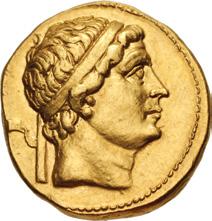
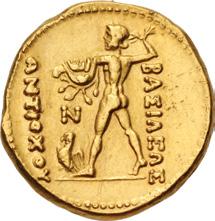
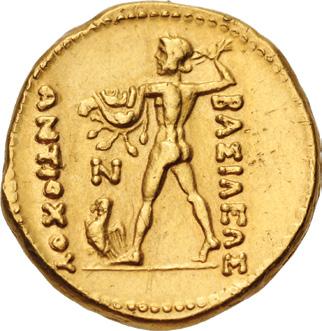
394. BAKTRIA, Greco-Baktrian Kingdom. Diodotos I Soter. Circa 255-235 BC. AV Stater (18mm, 8.34 g, 6h). In the name of Antiochos II of Syria. Mint A (near Aï Khanoum). Diademed head right / ∫Å%5GE∑% to right, Å@t5ocoU to left, Zeus Bremetes, seen from behind, advancing left, extended left arm draped with aegis, preparing to hurl thunderbolt in right hand; in inner left field, @ above eagle standing left. Kritt, New, A7, Style 1; cf. Holt Series A, Group 7 (tetradrachm); Bopearachchi –; Bopearachchi & Rahman –; SNG ANS –; SC 629.1 (Antiochos II of Syria) var. (same); HGC 9, 233. Lightly toned, slight edge mark. EF. Rare without the typical test cut. ($5000)
From the Wild Rose Collection, purchased from Calgary Coin Gallery, September 2017. Ex George W. La Borde Collection.
Illustrated in MPHB

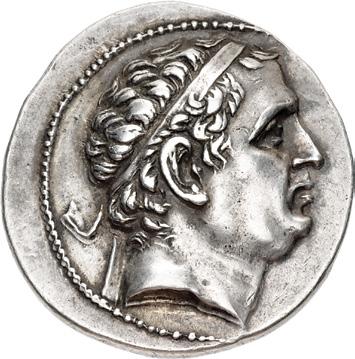
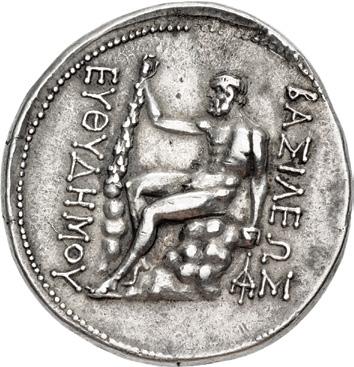

395. BAKTRIA, Greco-Baktrian Kingdom. Euthydemos I Theos Megas. Circa 225-200/195 BC. AR Tetradrachm (29.5mm, 16.57 g, 12h). Mint A (near Aï Khanoum). Struck circa 206-200 BC. Diademed head right, with elderly features / Herakles seated left on rock, holding club set on rocks; d below rock. Kritt A17; Bopearachchi 11A; MPHB A Group III, 231 (O69/R184 – this coin referenced and illustrated); SNG ANS 141 var. (monogram); HGC 12, 40. Iridescent toning, areas of find patina, slight porosity, light marks, tiny hairline die break on reverse. Near EF. Apparently unique die pair of which this coin is the only example. ($2000)
From the Wild Rose Collection. Ex Numismatica Ars Classica 120 (6 October 2020), lot 452 (hammer CHF 4000); Numismatica Ars Classica 48 (21 October 2008), lot 106; Numismatica Ars Classica 29 (11 May 2005), lot 232.
112
New Monogram in the Series
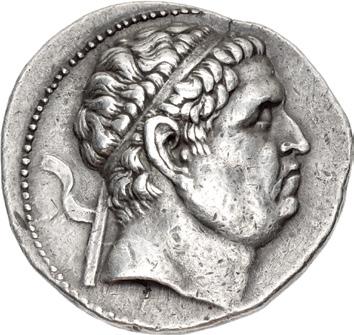

396. BAKTRIA, Greco-Baktrian Kingdom. Euthydemos I Theos Megas. Circa 225-200/195 BC. AR Tetradrachm (30mm, 16.54 g, 12h). Mint B (“Baktra”). Struck circa 206-200 BC. Diademed older head right / Herakles seated left on rock, holding club set on knees; } below rock. Kritt B17; Bopearachchi 12A; MPHB 522 (dies 149/362 – this coin referenced and illustrated); SNG ANS 143-4; HGC 12, 43. Toned with iridescence, some porosity, marks. VF. ($1000)
From the Mesogeios Collection. Ex Peus 431 (27 April 2022), lot 3330; Peus 393 (31 October 2007), lot 366; Gorny & Mosch 156 (5 March 2007), lot 1565; Lanz 117 (24 November 2003), lot 429.
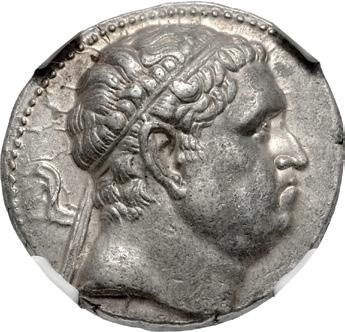
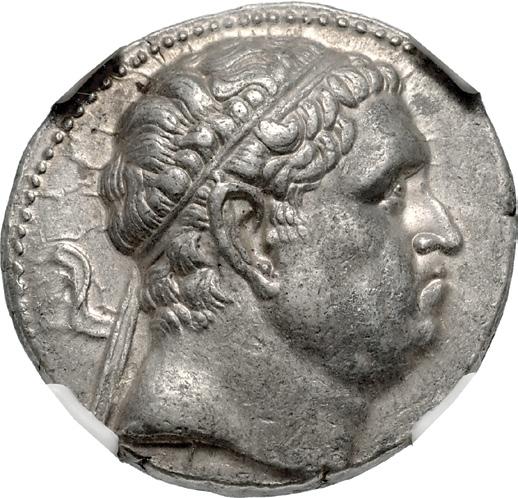
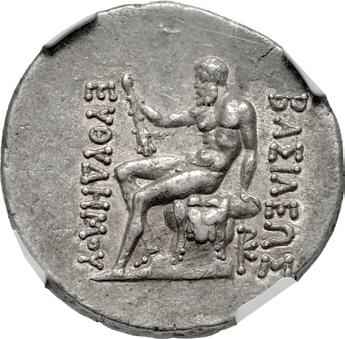
397. BAKTRIA, Greco-Baktrian Kingdom. Euthydemos I Theos Megas. Circa 225-200/195 BC. AR Tetradrachm (28mm, 16.56 g, 12h). Mint B (“Baktra”). Struck circa 206-200 BC. Diademed older head right / Herakles seated left on rock, holding club set on rocks; } below rock. Kritt B17; Bopearachchi 12A; MPHB 523 (dies 149/411 – an unlisted die combination); SNG ANS 143-4; HGC 12, 43. In NGC encapsulation 2111098-006, graded AU, Strike: 5/5, Surface: 4/5, Fine Style. ($1500)
Ex Roma XIX (26 March 2020), lot 630.
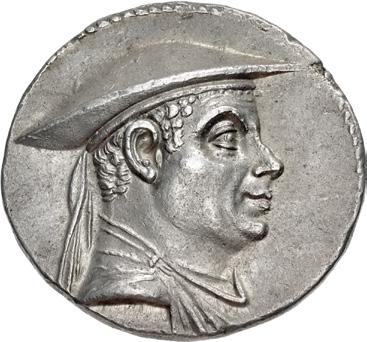
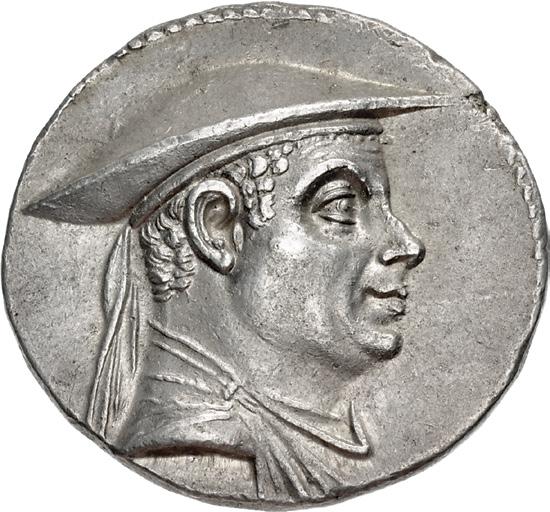
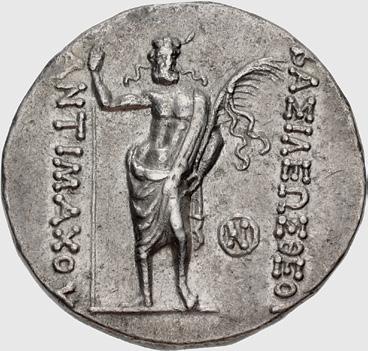
398. BAKTRIA, Greco-Baktrian Kingdom. Antimachos I Theos. Circa 180-170 BC. AR Tetradrachm (30mm, 16.80 g, 12h). Diademed and draped bust right, wearing kausia / Poseidon, laureate, standing facing, holding trident and filleted palm; K to inner right. Bopearachchi 1D; MPHB Group III, 248 (this coin referenced and illustrated); SNG ANS 276-7; HGC 12, 106. Iridescent toning. EF. ($1000)
From the Wild Rose Collection. Ex Classical Numismatic Group 94 (18 September 2013), lot 835; Classical Numismatic Group 58 (19 September 2001), lot 827.
113
Illustrated in MPHB
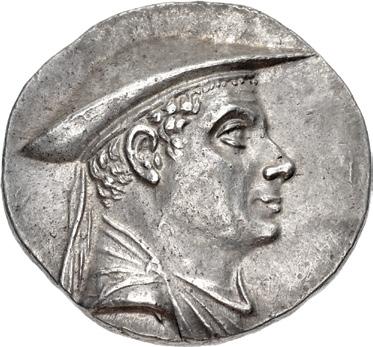


399. BAKTRIA, Greco-Baktrian Kingdom. Antimachos I Theos. Circa 180-170 BC. AR Tetradrachm (30mm, 16.80 g, 12h). Diademed and draped bust right, wearing kausia / Poseidon, laureate, standing facing, holding trident and filleted palm; K to inner right. Bopearachchi 1D; MPHB Group III, 329 (this coin referenced and illustrated); SNG ANS 276-7; HGC 12, 106. Iridescent toning. EF. ($1500)
From the Mesogeios Collection. Ex Numismatic Ars Classica 138 (18 May 2023), lot 289; Triton II (1 December 1998), lot 597.
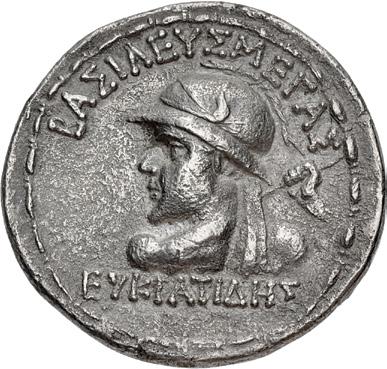
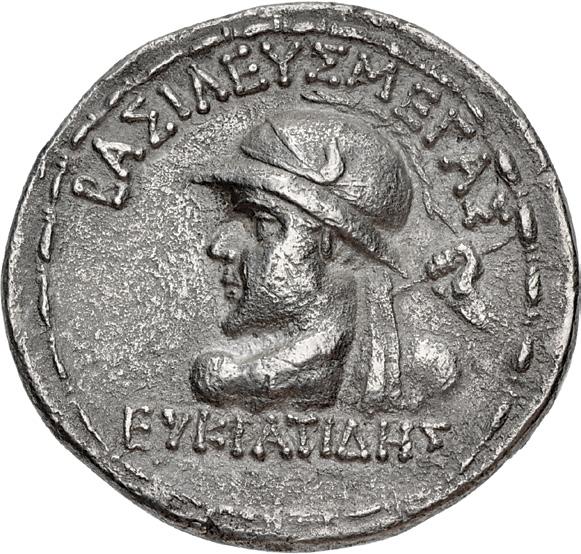
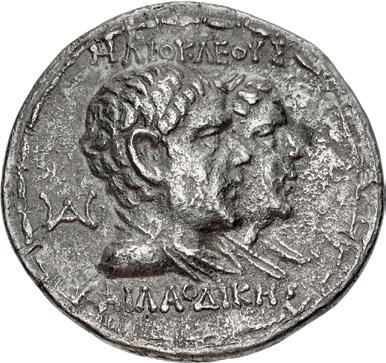
400. BAKTRIA, Greco-Baktrian Kingdom. Eukratides I Megas. Circa 170-145 BC. AR Tetradrachm (32mm, 15.91 g, 12h). Heroic bust of Eukratides left, wearing helmet adorned with bull’s horn and ear, seen from behind, brandishing spear in his right hand / Conjoined draped busts of Heliokles and Laodike, wearing tainia, right; T to left. Bopearachchi 16A; SNG ANS 528-9; HGC 12, 134. Toned, deposits, porosity, corrosion, crystallized. VF. Very rare. ($1500)

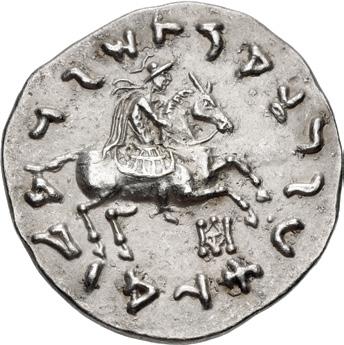
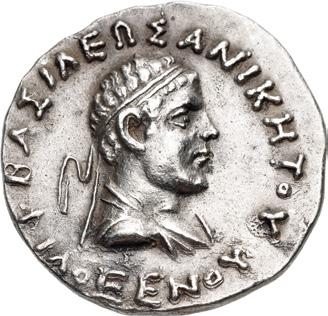

401. BAKTRIA, Indo-Greek Kingdom. Philoxenos Aniketos. Circa 125-110 BC. AR Tetradrachm (28mm, 9.83 g, 12h). Diademed and draped bust right / Philoxenos on horse rearing right; § below. Bopearachchi 3E; SNG ANS 1162-3; HGC 12, 267. Iridescent toning, some porosity, areas of slight double strike, traces of die rust. Good VF. ($500)
402. BAKTRIA, Indo-Greek Kingdom. Philoxenos Aniketos. Circa 125-110 BC. AR Tetradrachm (27.5mm, 10.07 g, 12h). Diademed and draped bust right / Philoxenos on horse rearing right; % and N below. Bopearachchi 3H; SNG ANS 1168; HGC 12, 267. Iridescent toning, deposits, some porosity, traces of die rust. Near EF. ($500)
114
401
402

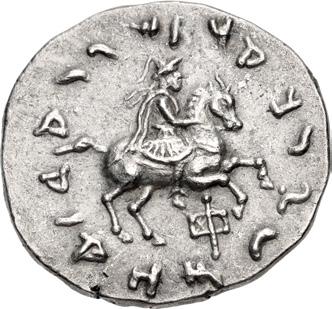
403. BAKTRIA, Indo-Greek Kingdom. Philoxenos Aniketos. Circa 125-110 BC. AR Tetradrachm (27mm, 9.97 g, 12h). Diademed and draped bust right / Philoxenos on horse rearing right; G below. Bopearachchi 3I; SNG ANS 1168; HGC 12, 267. Iridescent toning, slight porosity and die rust, a couple of tiny edge splits. Near EF. ($500)


404. BAKTRIA, Indo-Greek Kingdom. Philoxenos Aniketos. Circa 125-110 BC. AR Tetradrachm (27mm, 9.52 g, 12h). Diademed and draped bust right / Philoxenos on horse rearing right; Å below. Bopearachchi 3J; SNG ANS –; HGC 12, 267. Lightly toned, deposits/encrustation, porosity. Good VF. ($500)
Third Recorded

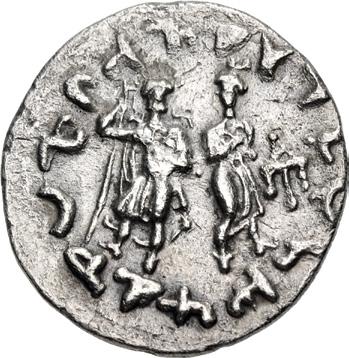
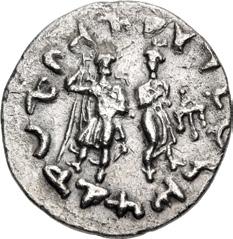
405. BAKTRIA, Indo-Greek Kingdom. Telephos Euergetes. Circa 80-70 BC. AR Drachm (17.5mm, 2.12 g, 12h). Anguipede, the limbs terminating in lotus blossoms / Helios, radiate and holding scepter, standing left, and Selene, wearing crescent diadem, standing right; G to lower right. Bopearachchi Série 1 (monogram unlisted), but cf. Série 1 ([Æ] for monogram); Bopearachchi & Rahman –; SNG ANS –; Zeno 64512 = Triton XII, lot 413; Zeno 98193 = NAC 123, lot 887 = CNG 87, lot 748; HGC 12, 409. Iridescent toning, roughness, struck with worn dies. VF. Third recorded specimen with this monogram. ($750)
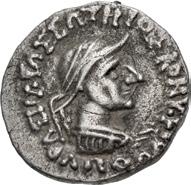
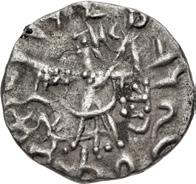
406. BAKTRIA, Indo-Greek Kingdom. Apollophanes Soter. Circa 35-25 BC. AR Drachm (16mm, 2.39 g, 12h). Diademed, helmeted, and draped bust right / Athena Alkidemos advancing left, brandishing thunderbolt and aegis; Ó (hi in Kharosthi); to right, ! above m (ma in Kharosthi). Bopearachchi 1A; SNG ANS 1690-3; HGC 12, 475. Toned, deposits/ encrustation, some porosity, metal flaws. VF. Rare. ($750)
115
CENTRAL ASIAN COINAGE
Extemely Rare – First Time At Auction

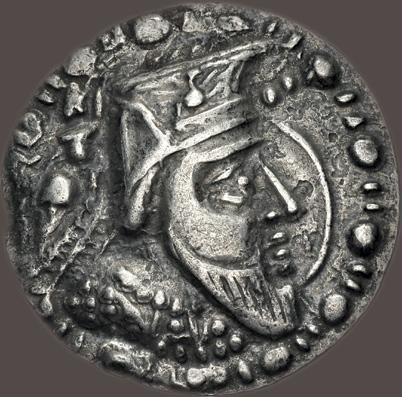
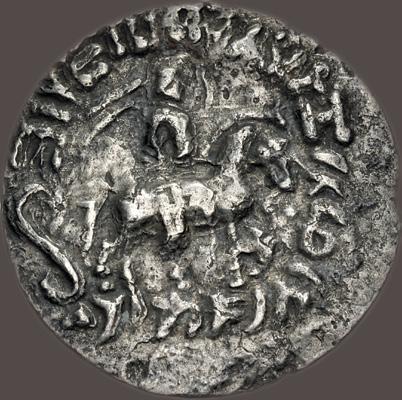

407. KHWAREZMIA. Ärtramūš I. First half of 3rd century AD. AR Tetradrachm (33.5mm, 12.80 g, 12h). Diademed bust right, wearing cap-like headdress decorated with eagle; to left, Nike right, crowning him with wreath; crescent to right; all within bead-and-reel border / E5¨E∑5E52¨[...]$ above, zMwp rIawnww (wrtrmwš mlk’ in Khwarezmian) below, king on horseback right; Í to left. Vainberg Б1 IV and pl. XXII, Б1 IV = Zeno 85992; Tolstov –; Whitehead –; Göbl, Dokumente –; MIG –; Sunrise –. Areas of find patina, porous, crystallized, edge slightly chipped. Near VF. Extremely rare, none in CoinArchives, only the Vainberg scan in Zeno. ($7500)
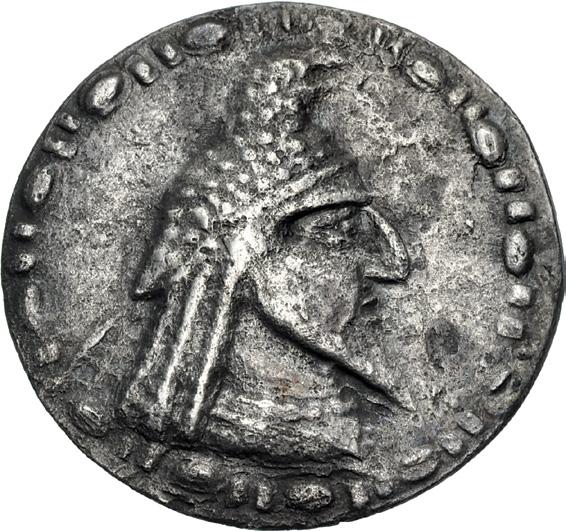
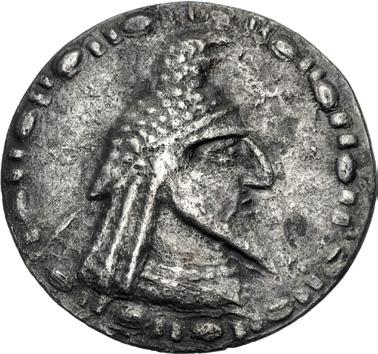
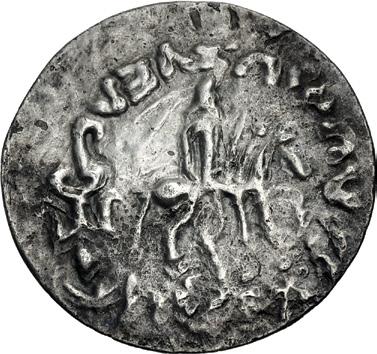

408. KHWAREZMIA. Wazamar. Late 3rd-first quarter of 4th centuries AD. AR Tetradrachm (32mm, 7.39 g, 12h). Diademed bearded bust right, wearing headdress in form of falcon, all within a bead-and-reel border / ¨E2x∑$∑¨ above, zMwpMfnww (wzm’r mlk’ in Khwarezmian) below, king on horseback right; 5 to left. Vainberg Б2 V; Tolstov pl. I, 1; Whitehead –; Göbl, Dokumente –; cf. MIG Type 499; Sunrise –; Zeno –. Areas of find patina, porous, crystallized. VF. Extremely rare. ($3000)
116
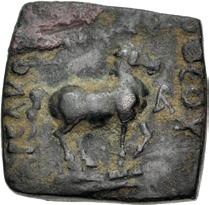
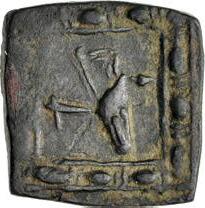
409. INDO-PARTHIANS, Early Period. Arsakes Theos. Late 2nd-1st century BC. CU Drachm (17x17mm, 4.42 g, 3h). Square module. Horse standing right with left foreleg raised; U to right / Bow-in-bowcase; uncertain symbols to left and right. Senior 12.1D; Zeno 184842. Earthen dark green patina, area of red, traces of cleaning marks. VF. Extremely rare. ($500)
From the Robert J. Weinstein Collection.


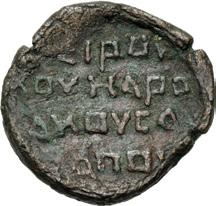
410. INDO-PARTHIANS, Aria or Sakastann. Cheiroukes. Satrap of Marsakes, mid to late 1st century BC. Æ Drachm (17mm, 3.27 g, 6h). Draped bust left, wearing Parthian-style tiara with ear flap / [≈](5!äU>˚äU hÅ!ä>Å˚äU 4Å[t>!]Å∏äU in four lines. Senior 190.2D; Alram 1270; MIG Type 1079; CNG 63, lot 883; cf. J. Rosenfeld, The Dynastic Art of the Kushans, pl. XVI, 2 (for seal with inscription MAPΣAKOY). Rough brown and green patina. Near VF. ($500)
From the Robert J. Weinstein Collection. Ex Classical Numismatic Group 87 (18 May 2011), lot 751.
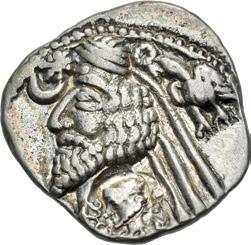
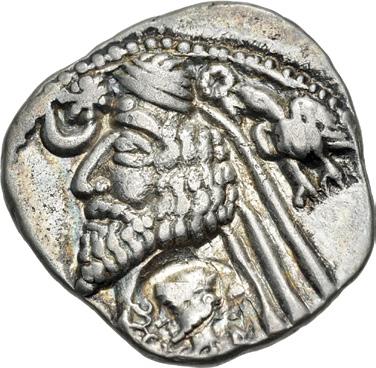

411. INDO-PARTHIANS, Aria or Margiana. Tanlis Mardates. Mid-late 1st century BC. Æ Drachm (21mm, 3.08 g, 12h). Countermarked Mithradatkart mint drachm of Phraates IV (Sellwood type 54.8). Diademed bust left; star in crescent to left; to right, eagle flying left, crowning Phraates with wreath; c/m: head left, tÅN lhcTAИ ΛHC around; all within incuse / Archer (Arsakes I) seated right on throne, holding bow; ! below bow. Senior 195.7D; cf. HGC 12, p. 197 ([first example] for c/m). Iridescent toning, c/m slightly double struck, slightly wavy flan. Countermark and coin Good VF. ($500)
From the Robert J. Weinstein Collection.
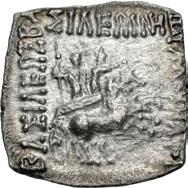

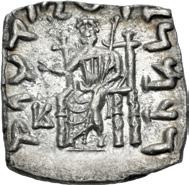
412. INDO-SKYTHIANS. Maues. Circa 125-85 BC. AR Drachm (16x16mm, 2.01 g, 12h). Square module. Uncertain northwestern mint. Radiate deity, holding scepter, and driver, holding wand and reins, in biga right / Zeus enthroned facing slightly left, extending hand in benediction and holding scepter; H to left. Senior 2.1aD; HGC 12, 529. Iridescent toning, light porosity and roughness. Good VF. Extremely rare. ($500)
From the Robert J. Weinstein Collection.
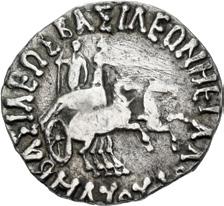
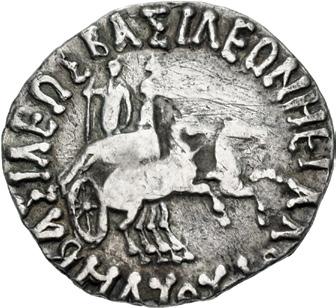
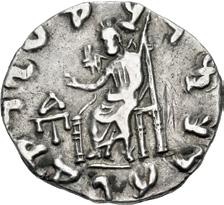
413. INDO-SKYTHIANS. Maues. Circa 125-85 BC. AR Drachm (17.5mm, 1.95 g, 12h). Round module. Uncertain northwestern mint. Radiate deity, holding scepter, and driver, holding wand and reins, in biga right / Zeus enthroned facing slightly left, extending hand in benediction and holding scepter; G to left. Senior 2.2D; HGC 12, 528. Iridescent toning, traces of deposits, slight porosity, slight double strike on reverse, cleaning marks. Near VF. Very rare. ($500)
From the Robert J. Weinstein Collection. Ex Classical Numismatic Group Electronic Auction 122 (7 September 2005), lot 187.
117
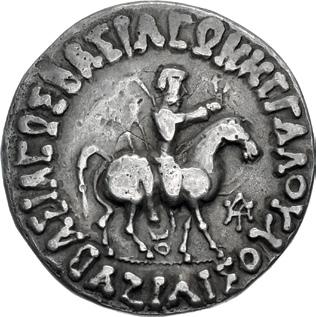

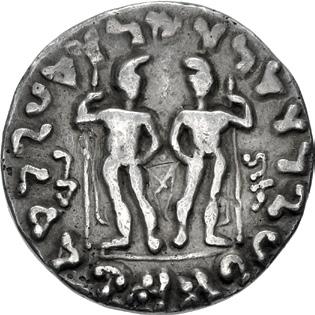
414. INDO-SKYTHIANS. Azilises. Circa 85-45/35 BC. AR Tetradrachm (28mm, 9.11 g, 12h). King right on horseback, holding whip; monogram to right; nanipada below horse / The Dioskouroi standing facing, each holding spear; Kharosthi monograms to left and right. Senior 37.7 T; HGC 12, 566. Toned, traces of find patina in devices, obverse lamination, a few marks. Near VF. Extremely rare, none in CoinArchives, nor on Zeno. ($750)
From the Robert J. Weinstein Collection.
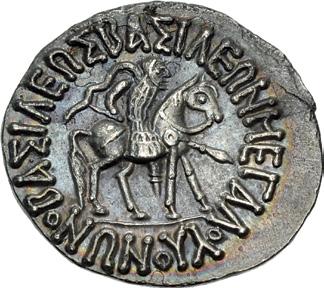

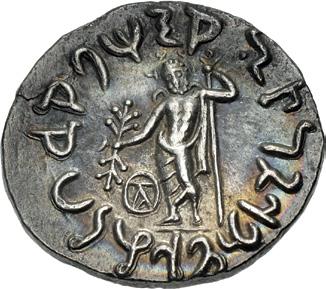
415. INDO-SKYTHIANS. Vonones, with Spalagadames. Circa 65 BC. AR Tetradrachm (27mm, 9.52 g, 12h). King right on horseback right, holding spear / Zeus standing facing slightly left, holding thunderbolt and scepter; monogram to inner right. Senior 67.3aT; HGC 12, 610. Attractively toned with iridescence, slight double strike on reverse. Near EF. ($500)
From the Robert J. Weinstein Collection, purchased from R.C. Senior.

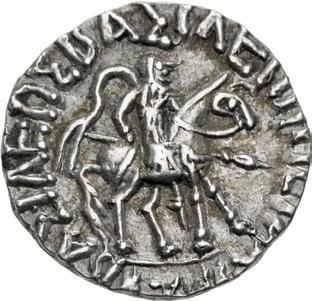
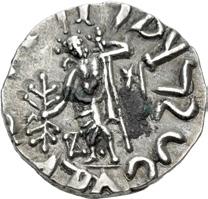
416. INDO-SKYTHIANS. Azes. Circa 58-12 BC. AR Drachm (17mm, 2.26 g, 12h). King on horseback right, holding spear / Zeus standing slightly left, holding thunderbolt and scepter; B to left, u (ji in Kharosthi) to right. Senior 80.25D (listed as not seen); Zeno –; HGC 12, 641. Iridescent toning, encrustation on reverse. Near EF. Unpublished denomination with these control marks. ($500)
From the Robert J. Weinstein Collection, purchased from Bob Reis.
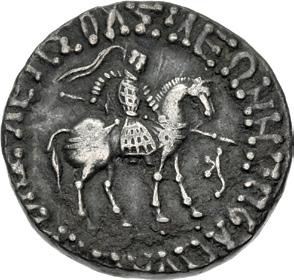
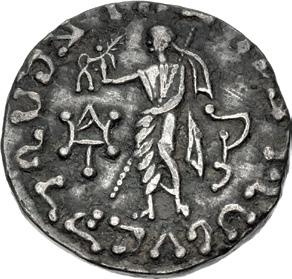
417. INDO-SKYTHIANS. Azes. Circa 58-12 BC. AR Tetradrachm (25mm, 9.09 g, 11h). Azes on horseback right, holding spear and reins; J (jha in Kharosthi) to right / Zeus standing left, holding Nike and long scepter; Û to left, å (sam in Kharosthi) to right. Cf. Senior 93.5T/105.657T (for obv./rev.; same obv. die); HGC 12, 632. Find patina, deposits. VF. Extremely rare. ($750)
From the Robert J. Weinstein Collection. Ex Classical Numismatic Group 88 (14 September 2011), lot 634; Triton XII (6 January 2009), lot 416.
118
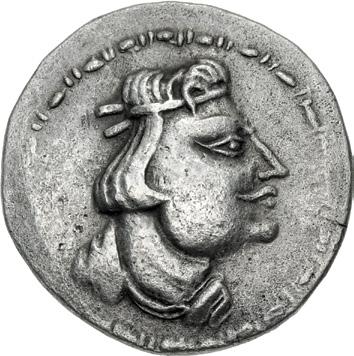
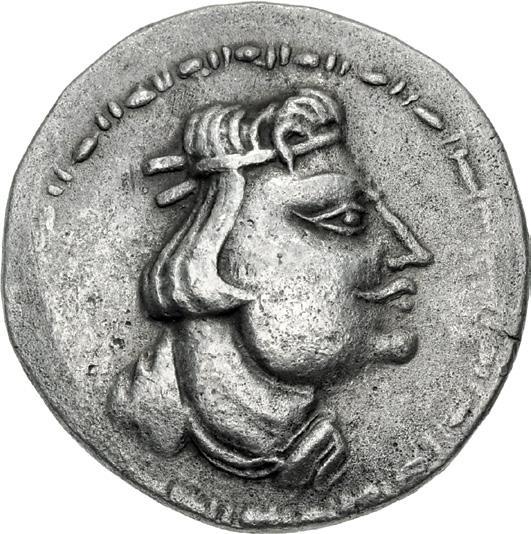

418. INDIA, Kushan Empire. Hsi-Hou Kushan (“Heraios”) or Kujula Kadphises. Circa AD 50-90. AR Tetradrachm (30mm, 15.16 g, 12h). ‘Heraus’ type. Diademed and draped bust right / Heraios on horseback right; behind, Nike flying right, crowning him with wreath; % Å@ Å∫ below horse. Loeschner fig. 6a; Cribb, Heraus 18 (O 12/R Va.2; Senior B1.2T; cf. Donum Burns 9; Sunrise –, but cf. 520-1. Lightly toned, traces of find patina/deposits in devices, porous, slight double strike on reverse. Good VF. ($750)

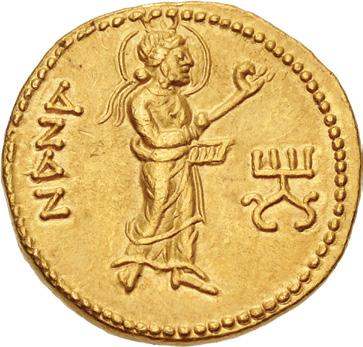
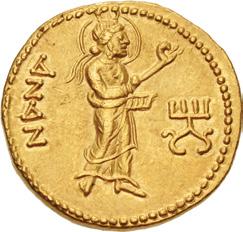
419. INDIA, Kushan Empire. Kanishka I. Circa AD 127-151. AV Dinar (20.5mm, 7.97 g, 12h). Main mint in Baktria (Balkh?). Early phase. Kanishka, diademed and crowned, standing facing, head left, holding goad and scepter, sacrificing over altar to left; flame at shoulder / Nana, nimbate, wearing fillet and crescent, standing right, holding scepter and box; 8 to right. MK 35 (O3/R – [unlisted rev. die]); ANS Kushan 370; Donum Burns 117. Lightly toned, tiny scrape on obverse, trace of underlying luster. Good VF. ($1500)
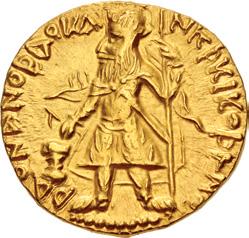
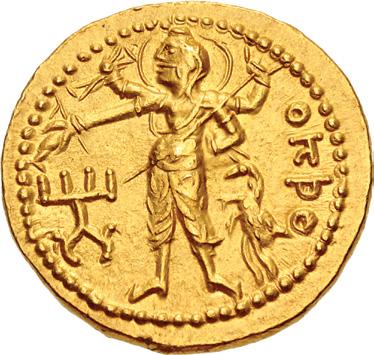

420. INDIA, Kushan Empire. Kanishka I. Circa AD 127-151. AV Dinar (21mm, 7.95 g, 12h). Main mint in Baktria (Balkh?). Late phase. Kanishka, diademed and crowned, standing facing, head left, holding goad and scepter, sacrificing over altar to left; flame at shoulder / Siva, nimbate, standing facing, head left, pouring water from flask and holding vajra (thunderbolt), trident, and he-goat; 8 to left. MK 62 (unlisted dies); ANS Kushan 382; Donum Burns 131. Lightly toned, traces of underlying luster. Near EF. ($1000)
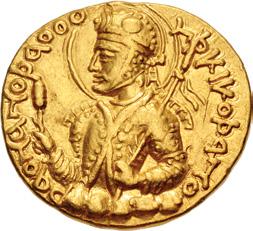


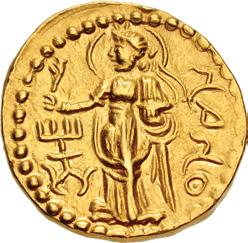
421. INDIA, Kushan Empire. Huvishka. Circa AD 151-190. AV Dinar (21.5mm, 7.89 g, 12h). Main mint in Baktria (Balkh?). Late phase. Crowned and diademed bust left on clouds, holding mace scepter and goad; flames over shoulder / Mao, nimbate, lunar “horns” at shoulders, standing facing, head left, holding diadem and sword; & to left. MK 214 (O1/R –[unlisted rev. die]); ANS Kushan 735 var. (Mao without diadem); Donum Burns –. Lightly toned, some double striking, hint of underlying luster. Good VF. Very rare. ($1500)
422. INDIA, Kushan Empire. Huvishka. Circa AD 151-190. AV Dinar (21mm, 7.90 g, 12h). Subsidiary mint in Gandhara (Peshawar?). Early phase. Crowned and diademed bust left on clouds, holding mace scepter and goad; flames over shoulder / Nana, nimbate and wearing stephane, standing left, holding scepter in right hand and bowl in left; 8 to right. MK 328 (O1/R7); ANS Kushan –; Donum Burns 286. Lightly toned, traces of die rust, obverse struck with worn die, edge bump. Near EF. Very rare. ($750)
119
421 422
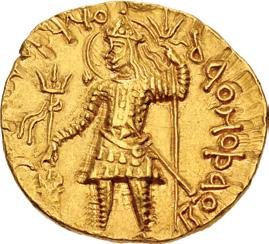
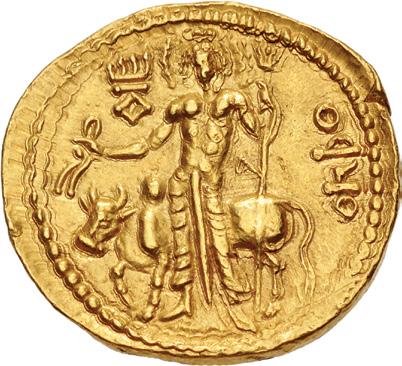
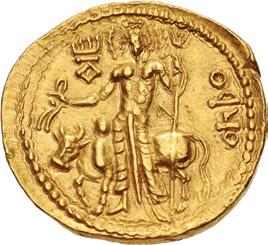
423. INDIA, Kushan Empire. Vasudeva I. Circa AD 190-230. AV Dinar (22mm, 8.01 g, 12h). Subsidiary mint in Gandhara (Peshawar?). Middle phase. Vasudeva, nimbate, helmeted, and diademed, standing facing, head left, holding trident, sacrificing over altar to left; filleted trident to left / Siva standing facing, holding a garland or diadem in extended right hand and trident in left; behind, the bull Nandi standing left; 6 to upper left. MK 532 ([Vasudeva II] unlisted dies); ANS Kushan –; Donum Burns 442. Lightly toned, multiple strikes, tiny edge split. EF. ($750)
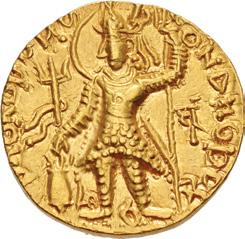
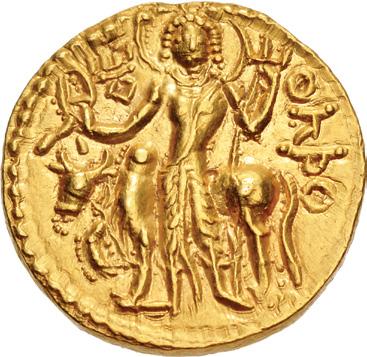
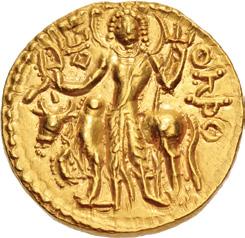
424. INDIA, Kushan Empire. Vasishka. Circa AD 247-267. AV Dinar (20.5mm, 7.82 g, 12h). Main mint in Gandhara. Late phase. Vasishka standing left, holding filleted standard, sacrificing over altar to left; filleted trident to left; h (ha in Brahmi) to right of altar; † (tha) in Brahmi between legs; † (a in Brahmi) to right / Ithyphallic Siva standing facing, holding a garland or diadem and trident; behind, the bull Nandi standing left; 6 to upper left. MK 622 (dies unlisted); ANS Kushan –; Donum Burns 695. Lightly toned, traces of underlying luster. EF. ($750)

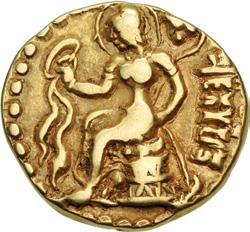
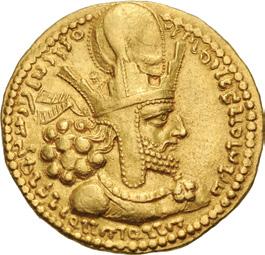
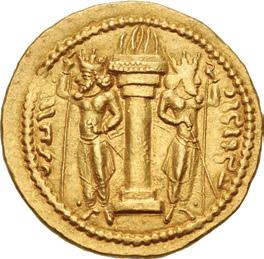
425. INDIA, Gupta Empire. First Dynasty. Kumaragupta I Mahendraditya. Circa AD 413-455. AV Dinar (21mm, 8.00 g, 12h). Horseman type. Kumaragupta, holding reins, on horseback right / Lakshmī, nimbate, seated left on basket, holding diadem and lotus. Kumar Class I Variety C.1; BKB 151 (same dies); BMC Guptas 205 and p. 71, –; Altekar Class I, Variety C; Bayana 1396-1432. Toned, deposits in devices. VF. ($1000)
Ex Künker 376 (18 October 2022), lot 5212.
426. SASANIAN KINGS. Šābuhr (Shahpur) I. AD 240-272. AV Dinar (22mm, 7.32 g, 3h). Mint I (“Ctesiphon”).
Phase 1b, circa AD 244-252/3. Bust right, wearing diadem and mural crown with korymbos and ribbons / Fire altar; flanked by two attendants wearing mural crowns, each without korymbos and pellet at feet. SNS type IIc/1a, style A, Group b; cf. Saeedi AV9 (for type); Sunrise –. Lightly toned, light die rust, minor double strike and weakness. Near EF. ($2500)
From the Jonathan K. Kern Collection.
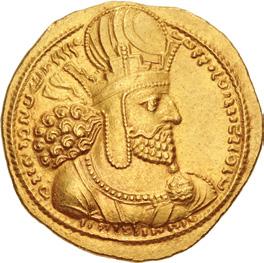
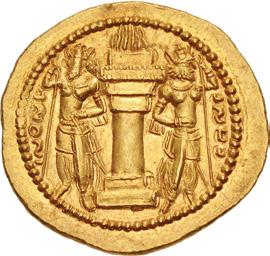

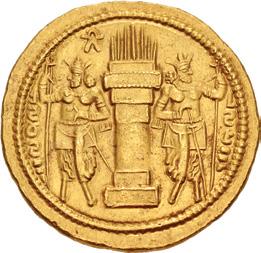
427. SASANIAN KINGS. Šābuhr (Shahpur) I. AD 240-272. AV Dinar (22mm, 7.37 g, 3h). Mint I (“Ctesiphon”). Phase 2, circa AD 260-272. Bust right, wearing diadem and mural crown with korymbos and ribbons / Fire altar; flanked by two attendants wearing mural crowns. SNS type IIc/1b, style P, group b; Saeedi AV4; Sunrise 739. Lightly toned, hint of die rust, tiny marks at edge of reverse at 12 o’clock. EF. ($2500)
428. SASANIAN KINGS. Šābuhr (Shahpur) I. AD 240-272. AV Dinar (22mm, 7.40 g, 3h). Mint I (“Ctesiphon”). Phase 2, circa AD 260-272. Bust right, wearing diadem and mural crown with korymbos; one pellet above and two pellets below diadem ties / Fire altar; flanked by two attendants wearing mural crowns; > to left of flames. SNS type IIc/1b, style P, group d/1 and pl. 31, 143; Saeedi AV5; Sunrise 740. Lightly toned, hint of deposits, slight scratch on cheek. EF. ($2500)
Ex Hess-Divo 341 (13 December 2023), lot 44.
120
425
426
427
428
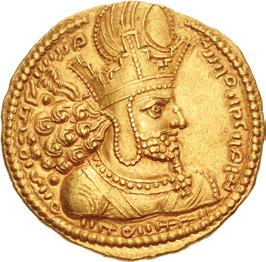
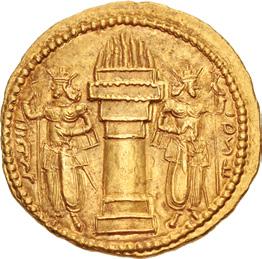
429. SASANIAN KINGS. Šābuhr (Shahpur) I. AD 240-272. AV Dinar (22.5mm, 7.39 g, 3h). Mint I (“Ctesiphon”). Phase 2, circa AD 260-272. Bust right, wearing diadem and mural crown with korymbos; pellets to left of diadem tie and shoulder / Fire altar; flanked by two attendants wearing mural crowns. SNS type IIc/1b, style P, group d/1 var. (number and placement of pellets); Saeedi AV5; Sunrise 740. Lightly toned, slight double strike, slight scuff on cheek. EF. ($2500)
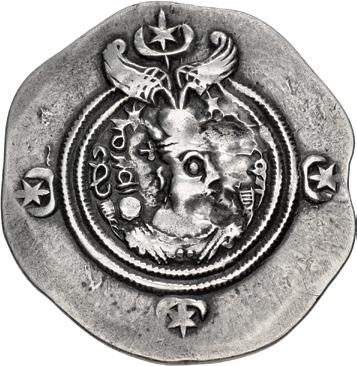

430. SASANIAN KINGS. Ohrmazd (Hormizd). Usurper, AD 593. AR Drachm (35.5mm, 3.90 g, 3h). Uncertain (WSY) mint. Dated RY 2. Bust right, wearing mural crown with frontal crescent, two wings, and star-in-crescent, ribbons and crescents on shoulders; stars flanking crown / Fire altar with ribbons; flanked by two attendants; star and crescent flanking flames. Cf. Mochiri 651; Malek, Late, p. 492 (VSP mint; date for this mint unlisted) SC Tehran –; cf. SNS Schaaf 623; Saeedi –; Sunrise –. Light iridescent toning, traces of deposits, areas of ghosting, light circulation marks/scratches under tone. VF. ($750)

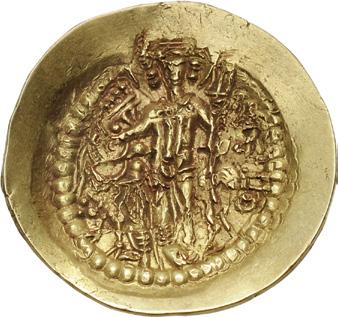
431. KUSHANO-SASANIANS. temp. Pērōz (Fīrūz) I – II. Circa AD 255-310. AV Dinar (28mm, 8.05 g, 12h). Imitating Kushan king Vasudeva I. Uncertain mint in Baktria. Early series. Vasudeva standing left, flames on shoulder, holding trident, sacrificing over altar to left; filleted trident to left; D to left of filleted trident; 9 between legs; ˘ below arm; 0 to right / Ithyphallic Siva standing facing, holding a garland or diadem and trident with o on shaft; behind, the bull Nandi standing left; • and ^ to upper left; ≥ below Nandi’s head. MK 694 (Vasudeva II) corr. (pellets below arm); ANS Kushan 1700; Donum Burns 476. Toned, multiple strikes, areas of peripheral weakness. EF. ($750)
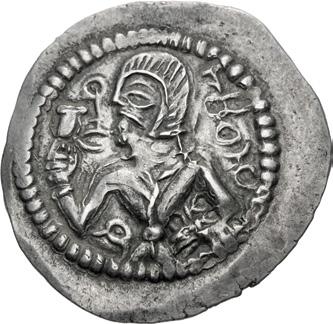
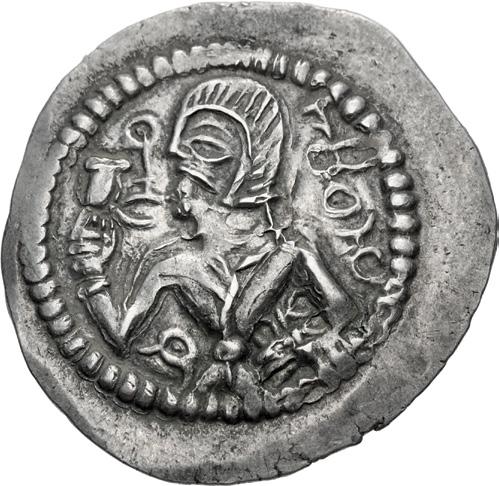
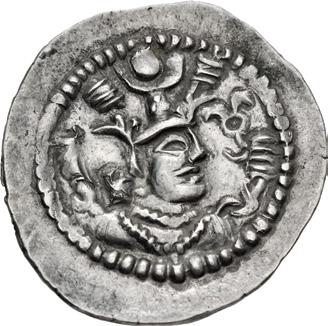
432. HUNNIC TRIBES, Hephthalites. Anonymous. Circa 484/8-560. AR Drachm (29mm, 4.19 g, 3h). Hephthalite Prince type. Mustachioed half-length bareheaded bust of prince facing, head left, holding drinking cup / Sasanian style bust imitating Vahrām (Bahram) V right; 3 to right. Vondrovec [Göbl, Hunnen] Type 287B; cf. Alram & Pfisterer, p. 32; cf. Alram, Schatzfund 47; cf. Zeno 88664 = CNG 85, lot 575. Lightly toned, deposits, slight doubling. Good VF. Extremely rare. ($1000)
121
ROMAN PROVINCIAL COINAGE
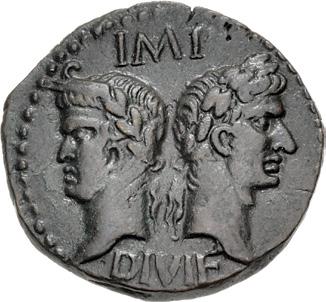
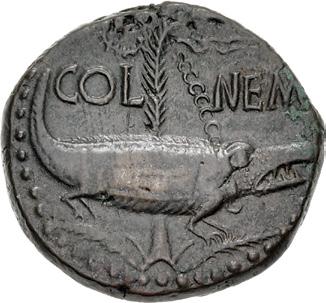
433. GAUL, Nemausus. Augustus, with Agrippa. 27 BC-AD 14. Æ Dupondius (27mm, 12.52 g, 12h). Struck circa 9/8-3 BC. Heads of Agrippa left, wearing rostral crown and laurel wreath, and Augustus right, wearing laurel wreath, back to back / Crocodile right chained to palm frond with short fronds; wreath with long ties above, palms fronds below. RPC I 524; SNG Copenhagen 699. Dark brown patina, light adjustment marks. Good VF. ($1000)
From the Wild Rose Collection, purchased from Shanna Schmidt Numismatics, 24 July 2018. Ex WN Collection (Classical Numismatic Group 106, 13 September 2017), lot 601; Collection of a Director (Classical Numismatic Group 88, 14 September 2011), lot 675; Peus 290 (5 October 1976), lot 220.
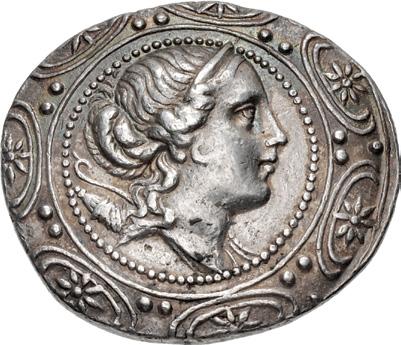
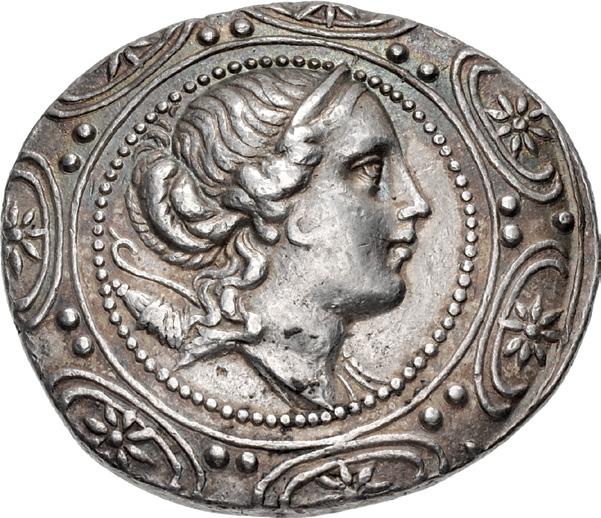
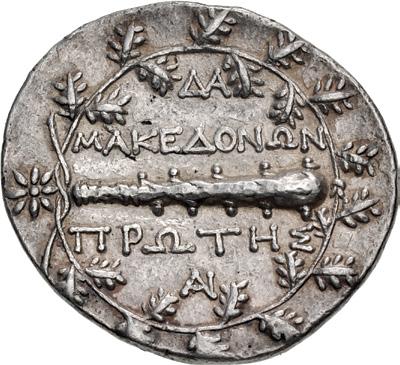
434. MACEDON, Republican period. First Meris. Circa 174/3-149 BC. AR Tetradrachm (33mm, 16.57 g, 11h). Amphipolis mint. Struck circa 174/3–158 BC. Diademed and draped bust of Artemis right, bow and quiver over shoulder, in the center of a Macedonian shield / Club; monogram above; all within oak wreath, star to left. Prokopov, Silver, Group I.A, 47.2 (O11/R37 – this coin); HGC 3, 1103. Toned with iridescence, trace deposits, minor marks. Near EF. Very rare with star instead of thunderbolt; only known for a few issues in the first series. ($500)
Ex Robert Weimer Collection (Triton IX, 10 January 2006), lot 838; CNG inventory 778196 (October 2006); Classical Numismatic Group 43 (24 September 1997), lot 293.
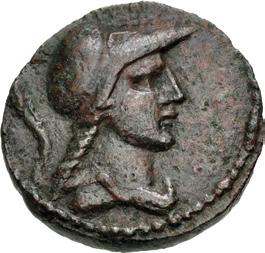
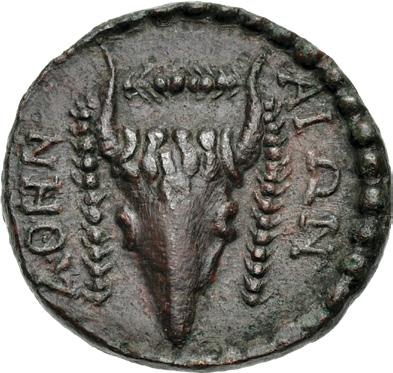

435. ATTICA, Athens. temp. Gallienus. AD 253-268. Æ (21.5mm, 7.53 g, 11h). Head of Athena right wearing crested Corinthian helmet / Facing bucranium with fillets hanging from horns. Kroll 403 (same rev. die as plated specimen); RPC X Online 59897; Svoronos, Athenes pl. 99, 11. Red-brown surfaces, light roughness, smoothing. Near EF. ($500)
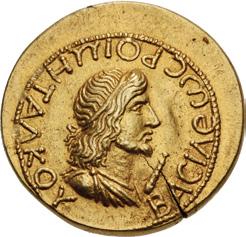
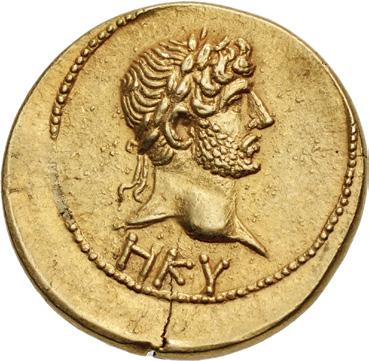
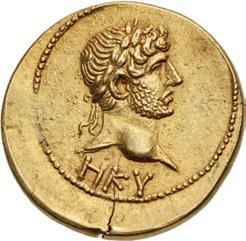
436. KINGS of BOSPORUS. Rhoemetalces, with Hadrian. AD 131/2-153/4. AV Stater (20mm, 7.78 g, 1h). Dated Bosporan Era 428 (AD 131/2). Diademed and draped bust of Rhoemetalces right; to right, club downward / Laureate head of Hadrian right; HKY (date) below. Frolova p. 143, A/a corr. (symbol incorrectly listed as spear); MacDonald 437/2; RPC III 908.5 (this coin); Anokhin 502a. Flan crack, a bit off center. Near EF. ($1000)
From the Wild Rose Collection. Ex Classical Numismatic Group 66 (19 May 2004), lot 1030.
122

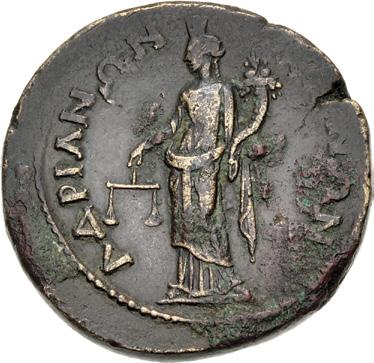
437. BITHYNIA, Cius. Sabina. Augusta, AD 128-136/7. Æ (31mm, 20.24 g, 6h). Draped bust right, hair coiled with pearls atop double stephane / Dikaiosyne standing left, holding scales and cornucopia. RG 36 corr. (rev. description); RPC III 1053.2 (this coin, illustrated). Red-brown patina, deposits, scratches, small edge split. VF. Extremely rare and with a fine style portrait, only two known to RPC. ($750)
From the Mesogeios Collection, purchased from Edgar L. Owen. Ex Marcel Burstein Collection (Classical Numismatic Group 91, 19 September 2012), lot 509; Münzen & Medaillen AG FPL 325 (July 1971), no. 20.
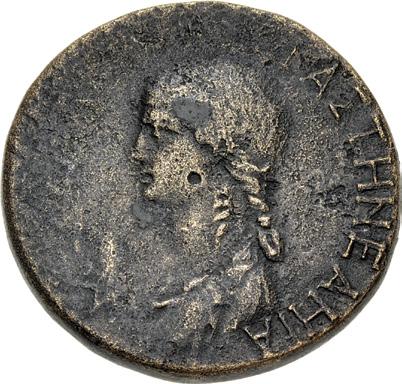

438. BITHYNIA, Nicaea. Messalina. Augusta, AD 41-48. Æ (33mm, 22.90 g, 7h). C. Cadius Rufus, proconsul. Struck circa AD 47-48. Draped bust left, hair in long plait / Façade of basilica: a two story tetrastyle central bay with two story wings flanking; inscribed entablature above, clippeus in pediment. RG 33 var. (bust right); RPC I 2034. Yellow-brown patina, light tooling. Good Fine. Extremely rare. ($750)
Two Extremely Rare Bithynian Cistophori

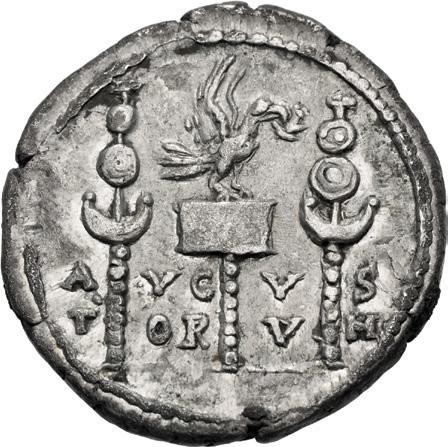
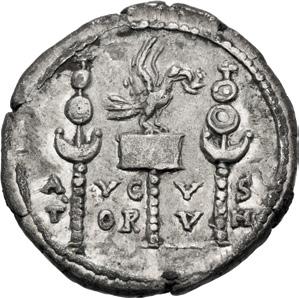
439. BITHYNIA, Uncertain. Septimius Severus. AD 193-211. AR Cistophorus (24.5mm, 7.90 g, 6h). Struck circa AD 198-202. Laureate head right / Legionary aquila right between two vexilla. Metcalf, Severan 1 (OS1/R1); Calomino, Severan pp. 153; BMC 758. Lightly toned with luster, minor edge marks, trace deposits. VF. Extremely rare, only this coin in CoinArchives. ($1000)
From the Weise Collection. Ex Gorny & Mosch 126 (14 October 2003), lot 1790 (hammer €1700).
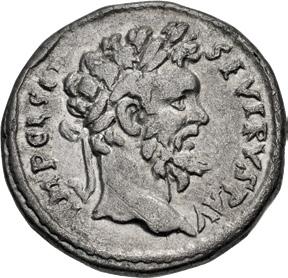
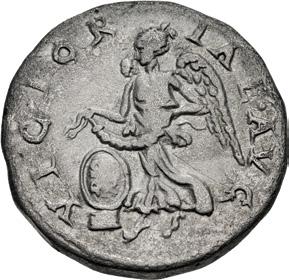
440. BITHYNIA, Uncertain. Septimius Severus. AD 193-211. AR Cistophorus (23.5mm, 9.18 g, 12h). Struck circa AD 198-202. Laureate head right / Victory advancing left, holding open wreath in both hands over shield inscribed SP/QR set on low base. Metcalf, Severan 6 (OS2/R6); Calomino, Severan pp. 153; BMC 759n. Lustrous, light porosity, light scratch on obverse, reverse scrape. VF. Extremely rare, possibly the second known. ($1000)
From the Weise Collection. Ex Classical Numismatic Group 64 (24 September 2003), lot 1138 (hammer $1660).
123
Plate Coin
RPC
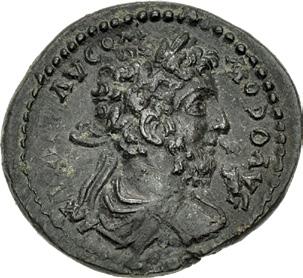
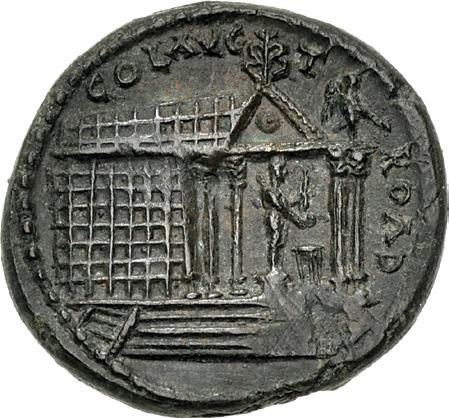

441. TROAS, Alexandria Troas. Commodus. AD 177-192. Æ (25mm, 7.78 g, 1h). Struck circa AD 184-190. Laureate, draped, and cuirassed bust right, seen from behind / Statue of Apollo Smintheus standing right on base, quiver over shoulder, holding bow and sacrificing from patera over tripod altar to right, within tetrastyle temple seen in perspective with steps, pellet in pediment, decorated with acrostolium; on right column, Nike standing right. Bellinger A220 var. (no altar); RPC IV.2 Online 24 corr. (Nike not described). Dark green-brown patina, minor scratches. Near EF. Extremely rare, two in RPC, none in CoinArchives. An extremely well-detailed reverse scene. ($500)

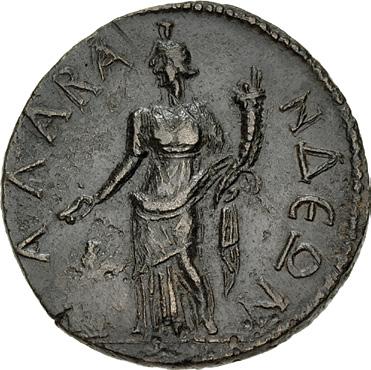

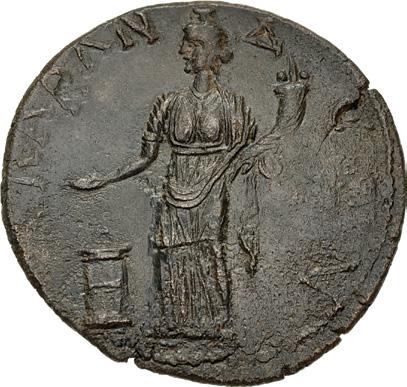
442. CARIA, Alabanda. Septimius Severus. AD 193-211. Æ (31mm, 16.42 g, 1h). Laureate, draped, and cuirassed bust right, seen from behind; c/m; bust of Geta or Caracalla right, within incuse circle / Homonoia standing facing, head left, wearing calathus, holding patera and cornucopia, to left, lighted altar. Waddington 2113. For c/m: Howgego 39. Brown patina, light porosity, small scrape on reverse. Near EF. Extremely rare. ($500)
443. CARIA, Alabanda. Caracalla. AD 198-217. Æ (33mm, 16.01 g, 6h). Laureate, draped, and cuirassed bust right, seen from behind; c/m: bust of Caracalla right within incuse circle / Homonoia standing facing, head left, wearing calathus, holding patera and cornucopia, to left, lighted altar. BMC 49; SNG München 43. For c/m: Howgego 39. Dark brown patina, light porosity. Good VF. Very rare. ($500)


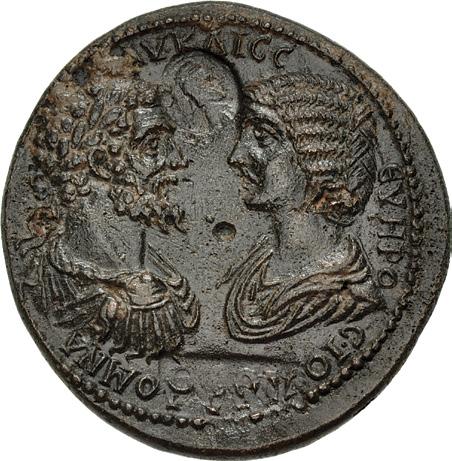
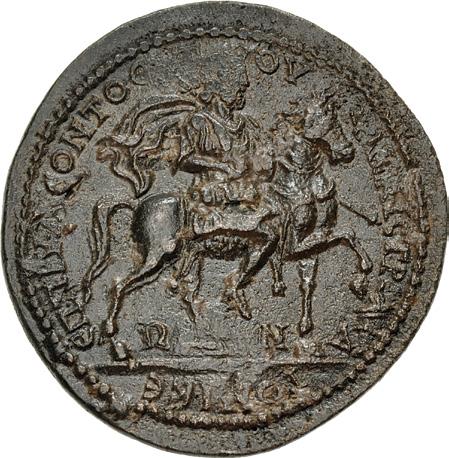
444. CARIA, Stratonicaea. Septimius Severus, with Julia Domna. AD 193-211. Æ (36.5mm, 24.78 g, 12h). Leon, son of Alcaios, prytanis. Laureate, draped, and cuirassed bust of Septimius vis-à-vis draped bust of Domna; c/ms: helmeted head of Roma within circular incuse, and ΘEOY within rectangular incuse / Hecate standing facing, head left, wearing calathus, holding patera and torch; at feet left, dog standing left, looking right. BMC 56; SNG von
minor porosity, area of light weakness on reverse. Good VF. ($500)
124
Aulock 2674. For c/ms: Howgego 188; 536. Brown patina with earthen highlights, reverse porosity, flan adjustment marks. Good VF. ($500)
445. CARIA, Stratonicaea. Septimius Severus, with Julia Domna. AD 193-211. Æ (37mm, 24.32 g, 6h). Leon, son of Alcaios, prytanis. Laureate, draped, and cuirassed bust of Septimius vis-à-vis draped bust of Domna; c/ms: helmeted head of Roma within circular incuse, and ΘEOY within rectangular incuse / Zeus Panamaros, draped, on horseback right, holding scepter; at feet right, lighted altar. BMC 55; SNG von Aulock 2668. For c/ms: Howgego 188; 536. Brown patina with earthen highlights,
442
443
444
445
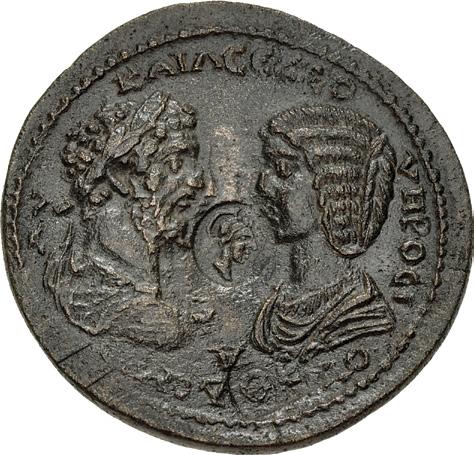

446. CARIA, Stratonicaea. Septimius Severus, with Julia Domna. AD 193-211. Æ (39mm, 23.82 g, 12h). Tiberius Claudius Aristeas, magistrate. Laureate, draped, and cuirassed bust of Septimius vis-à-vis draped bust of Domna; c/ms: helmeted head of Roma within circular incuse, and ΘEOY within rectangular incuse / Cult statue of Artemis Ephesia, facing, wearing calathus and having supports, flanked by stags; star and crescent in upper field. SNG von Aulock 2670. For c/ms: Howgego 188; 536. Brown patina, flan adjustment marks, light roughness on reverse. VF. ($500)
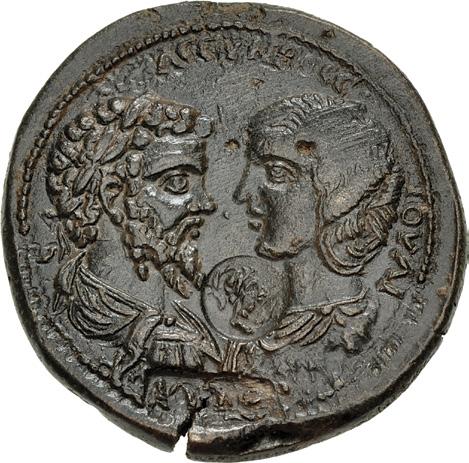

447. CARIA, Stratonicaea. Septimius Severus, with Julia Domna. AD 193-211. Æ (39mm, 28.61 g, 12h). Iason, son of Cleoros, grammateus. Struck circa AD 205-209. Laureate, draped, and cuirassed bust of Septimius vis-à-vis draped bust of Domna; c/ms: helmeted head of Roma within circular incuse, and ΘEOY within rectangular incuse / Hecate standing facing,
cleaning scratches, small flan crack, reverse double struck. Good VF. ($500)
Two Damnatio Memoriae Issues of Geta in December AD 211
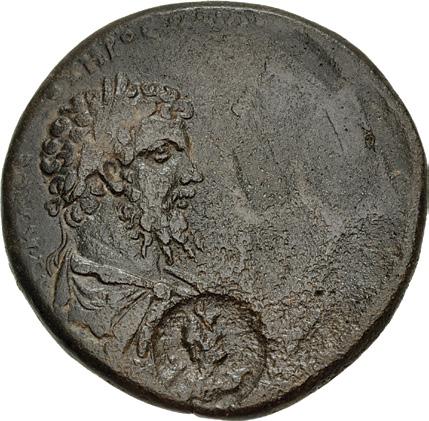
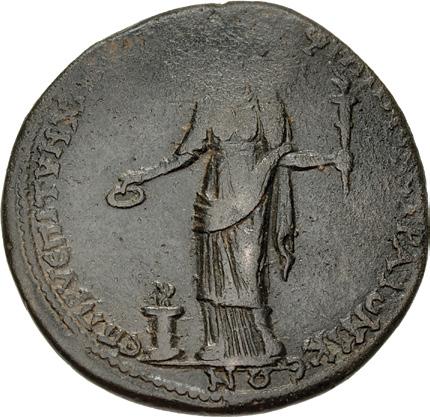
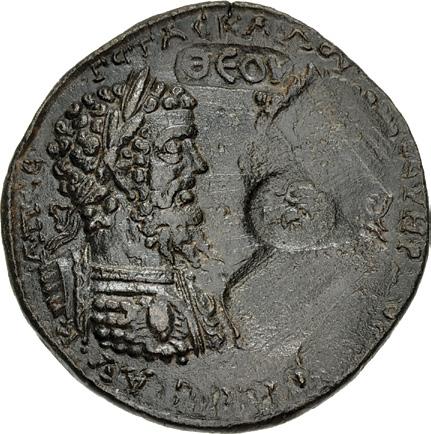
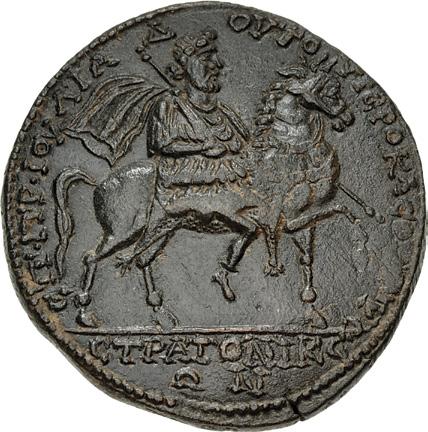
448. CARIA, Stratonicaea. Septimius Severus, with Geta as Caesar. AD 193-211. Æ (35.5mm, 20.45 g, 5h). Damnatio Memoriae. Philon, prytanis. Laureate, draped, and cuirassed bust of Septimius vis-à-vis [laureate, draped, and cuirassed bust of Geta]; c/m: laureate bust of Caracalla right within circular incuse / Hecate standing facing, head left, wearing calathus, holding patera and torch; at feet left, lighted altar. BMC 71; SNG von Aulock 2678. For c/m: Howgego 84. Brown patina, light porosity. VF. Portrait of Geta erased, Caracalla’s damnatio memoriae of Geta applied after his murder in AD 211. ($500)
449. CARIA, Stratonicaea. Septimius Severus, with Geta as Caesar. AD 193-211. Æ (35mm, 22.97 g, 6h). Damnatio Memoriae. Iouliades, son of Hierokles, prytanis. Laureate and cuirassed bust of Septimius, gorgoneion on breastplate vis-àvis [laureate, draped, and cuirassed bust of Geta]; c/ms: helmeted head of Roma within circular incuse, and ΘEOY within rectangular incuse / Zeus Panamaros, draped, on horseback right, holding scepter; at feet right, lighted altar. SNG von Aulock 2679. For c/ms: Howgego 188; 536. Dark brown patina, minor marks. Near EF. Portrait of Geta erased, Caracalla’s damnatio memoriae of Geta applied after his murder in AD 211. ($500)
125
head left, wearing calathus, holding patera and torch; at feet left, dog standing left, looking right. SNG Copenhagen 507. For c/ms: Howgego 188; 536. Brown patina with earthen highlights, minor pitting, flan adjustment marks,
448
449
The Marriage of Caracalla and Plautilla
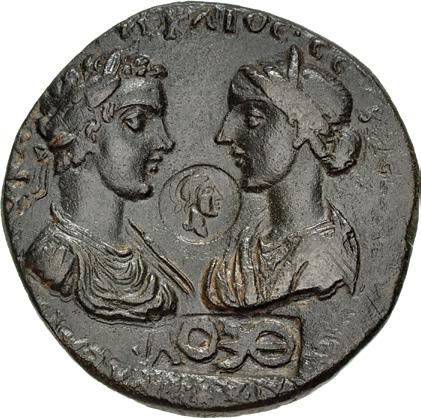

450. CARIA, Stratonicaea. Caracalla, with Plautilla. AD 198-217. Æ (34.5mm, 21.51 g, 12h). Tiberius Claudius Dionysios, president of the college of the grammateis. Struck AD 202-205. Laureate, draped, and cuirassed bust of Caracalla vis-à-vis draped bust of Plautilla; c/ms: helmeted head of Roma within circular incuse, and ΘEOY within rectangular incuse / Hecate standing facing, head left, wearing calathus, holding patera and torch; at feet left, dog standing left, looking right. BMC 65; SNG von Aulock 2694. For c/ms: Howgego 188; 536. Brown patina, light peripheral roughness, flan adjustment marks. VF. ($500)
Three Carian cities - Alinda, Alabanda, and Stratonicaea - commemorated the marriage between Caracalla and Plautilla by issuing coins with dual portraits proclaiming the young empress as “the new goddess Hera.” As Ken Harl notes (Civic Coins and Civic Politics in the Roman East: A.D. 180-275 [Berkeley, CA: University of California Press], p. 41): “By implication, Caracalla was envisioned as a youthful Zeus, so that the imperial marriage became a symbolic reenactment of the celestial one.”

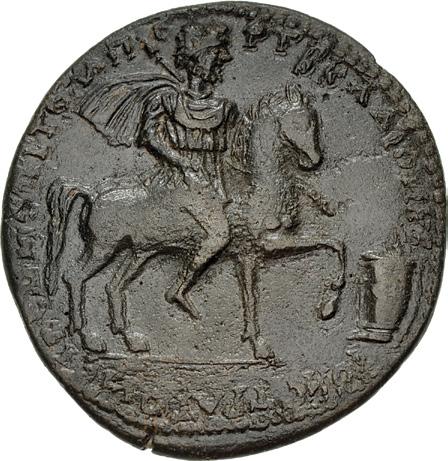
451. CARIA, Stratonicaea. Caracalla, with Plautilla. AD 198-217. Æ (37mm, 21.39 g, 12h). Tiberius Claudius Dionysios, president of the college of the grammateis. Struck AD 202-205. Draped bust of Plautilla vis-à-vis laureate, draped, and cuirassed bust of Caracalla; c/m: ΘEOY within rectangular incuse / Zeus Panamaros, draped, on horseback right, holding scepter; at feet right, lighted altar. BMC 66; SNG von Aulock 2695. For c/m: Howgego 536. Brown patina, light roughness, rub on obverse. Good VF. ($500)
The Damnatio Memoriae of Geta in December of AD 211
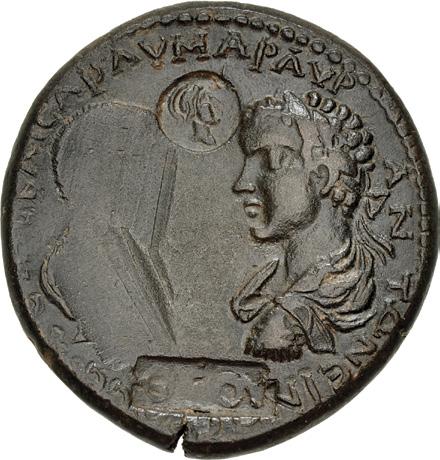
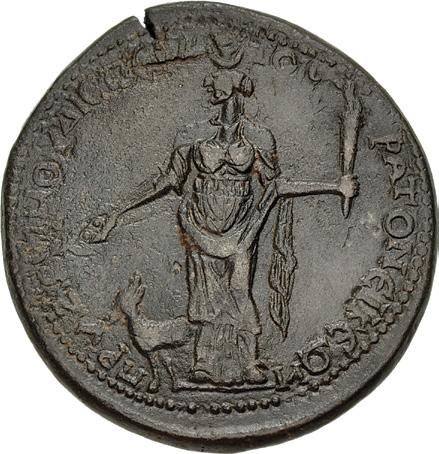
452. CARIA, Stratonicaea. Caracalla, with Geta as Caesar. AD 198-217. Æ (36mm, 26.35 g, 6h). Damnatio Memoriae. Zosimos II, grandson of Posittos, prytanis. Struck under Septimius Severus, circa AD 198-202. [Bareheaded and draped bust of Geta] vis-à-vis laureate, draped, and cuirassed bust of Caracalla; c/ms: helmeted head of Roma within circular incuse, and ΘEOY within rectangular incuse / Hecate standing facing, head left, wearing calathus, holding patera and torch; at feet left, dog standing left, looking right. SNG von Aulock 2692. For c/ms: Howgego 188; 536. Brown patina, scrape on reverse, small flan crack. Good VF. Portrait of Geta erased, Caracalla’s damnatio memoriae of Geta applied after his murder in AD 211. ($500)
Upon Septimius’ passing in AD 211, his sons Caracalla and Geta assumed joint rule of the empire. Their joint rule was a failure, the Imperial Palace was separated into two sections and they threatened to divide the empire between them. During the Festival of Saturnalia, December 211, Caracalla tried unsuccessfully to have his brother assassinated. But a week later, at an arranged meeting in their mother’s quarters, Geta was murdered by Caracalla’s centurions.
Caracalla immediately ordered a damnatio memoriae of his brother’s image: statues were removed, paintings were destroyed or, like the Severan Tondo erased, and coins were recalled to have his image carved out. This damnatio was especially apparent on the provincial coinage of Pergamum in Mysia and Stratonicaea in Caria. It is estimated that approximately 95% of the dual bust types at Stratonicea have had the portrait of Geta erased, many of them having a countermark of Roma or Caracalla stamped over his bust.
126
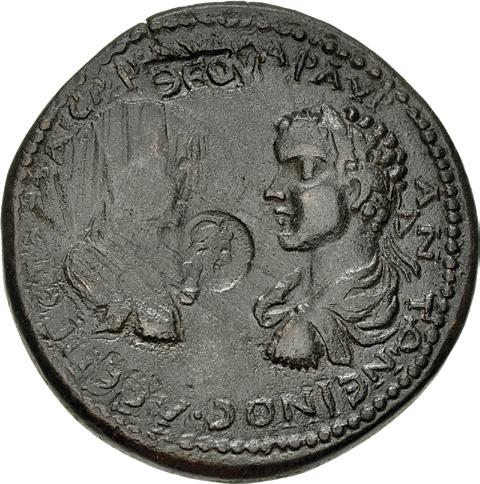

453. CARIA, Stratonicaea. Caracalla, with Geta as Caesar. AD 198-217. Æ (39.5mm, 33.78 g, 6h). Damnatio Memoriae. Zosimos II, grandson of Posittos, prytanis. Struck under Septimius Severus, circa AD 198-202. [Bareheaded and draped bust of Geta] vis-à-vis laureate, draped, and cuirassed bust of Caracalla; c/ms: helmeted head of Roma within circular incuse, and ΘEOY within rectangular incuse / Zeus Panamaros, draped, on horseback right, holding scepter; at feet right, lighted altar. SNG von Aulock 2691; SNG Copenhagen 510. For c/ms: Howgego 188; 536. Dark brown patina, flan adjustment marks, a few pits. VF. Portrait of Geta erased, Caracalla’s damnatio memoriae of Geta applied after his murder in AD 211. ($500)
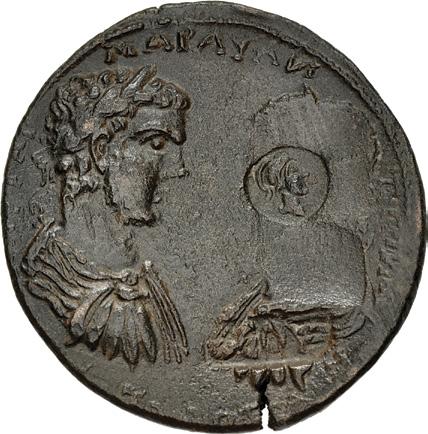
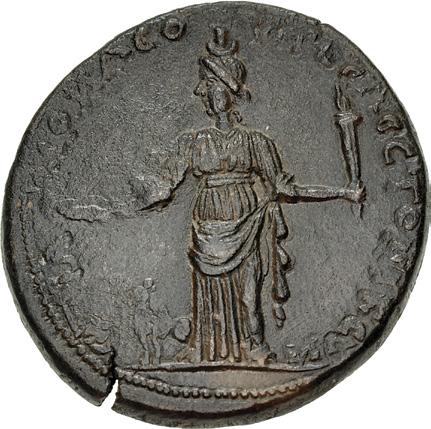
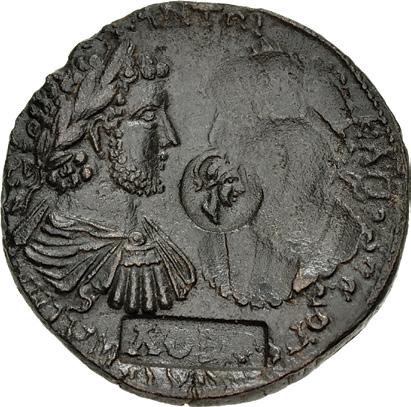
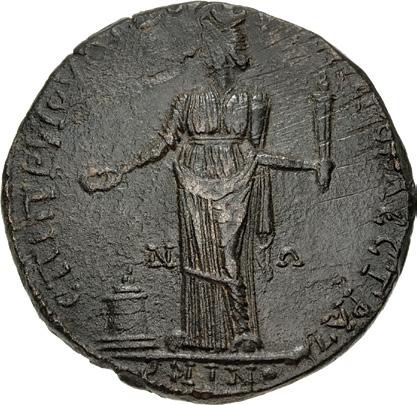
454. CARIA, Stratonicaea. Caracalla, with Geta as Caesar. AD 198-217. Æ (35mm, 25.40 g, 11h). Damnatio Memoriae. Flavius Leon Lena, archon. Struck under Septimius Severus, circa AD 205-209. Laureate, draped, and cuirassed bust of Caracalla vis-à-vis [laureate, draped, and cuirassed bust of Geta]; c/ms: helmeted head of Roma within circular incuse, and ΘEOY within rectangular incuse / Hecate standing facing, head left, wearing calathus, holding patera and torch; at feet left, dog standing left, looking right. SNG von Aulock 2686 var. (legends). For c/ms: Howgego 188; 536. Brown patina, flan adjustment marks, small flan crack. Good VF. Portrait of Geta erased, Caracalla’s damnatio memoriae of Geta applied after his murder in AD 211. ($500)
455. CARIA, Stratonicaea. Caracalla & Geta. AD 209-211. Æ (34mm, 21.85 g, 7h). Damnatio Memoriae. Iouliades, son of Hierokles, prytanis. Laureate, draped, and cuirassed bust of Caracalla vis-à-vis [laureate, draped, and cuirassed bust of Geta]; c/ms: helmeted head of Roma within circular incuse, and ΘEOY within rectangular incuse / Hecate standing facing, head left, wearing calathus, holding patera and torch; at feet left, lighted altar. Cf. Leu EA 23, lot 3627 (same obv. die, same magistrate). For c/ms: Howgego 188; 536. Brown patina, light porosity, flan adjustment marks. Near EF. Very rare. Portrait of Geta erased, Caracalla’s damnatio memoriae of Geta applied after his murder in AD 211. ($500)
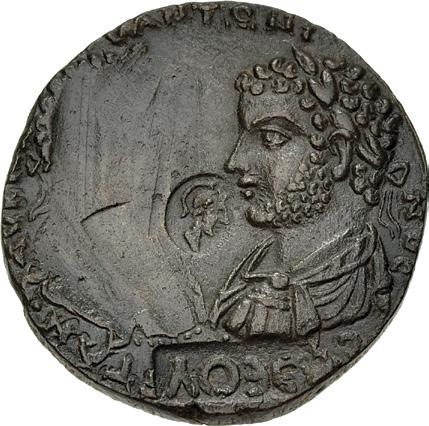
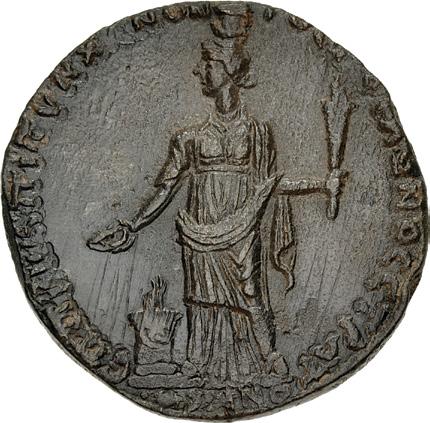
456. CARIA, Stratonicaea. Caracalla & Geta. AD 209-211. Æ (35mm, 26.72 g, 12h). Damnatio Memoriae. Philon, prytanis. [Laureate, draped, and cuirassed bust of Geta] vis-à-vis laureate, draped, and cuirassed bust of Caracalla; c/ms: helmeted head of Roma within circular incuse, and ΘEOY within rectangular incuse / Hecate standing facing, head left, wearing calathus, holding patera and torch; at feet left, lighted altar. SNG Leypold 849. For c/ms: Howgego 188; 536. Brown patina, cleaning scratches, lightly double struck. Near EF. Portrait of Geta erased, Caracalla’s damnatio memoriae of Geta applied after his murder in AD 211. ($500)
127
454 455
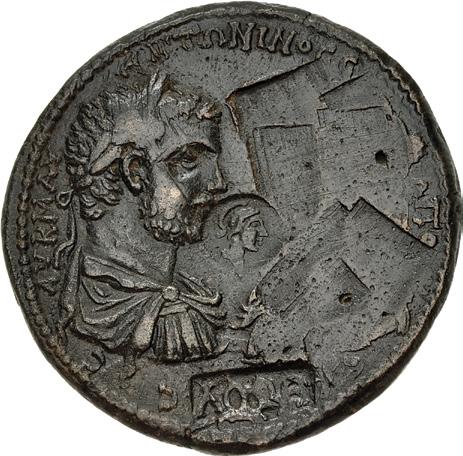
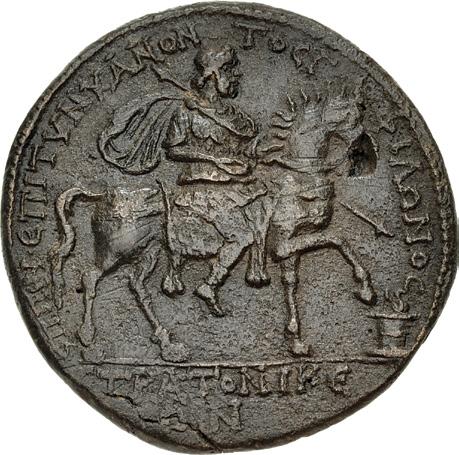
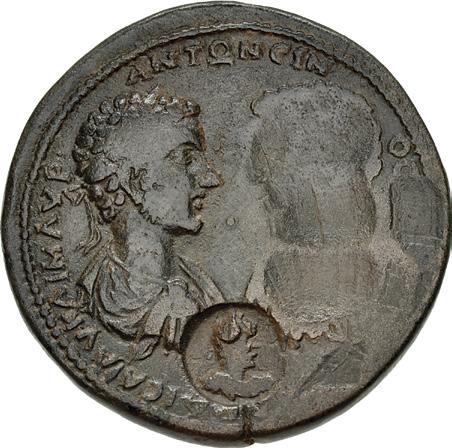
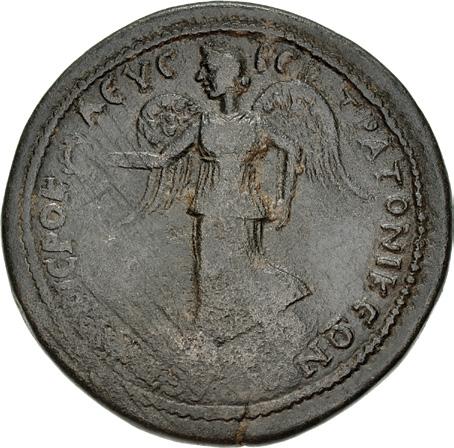
457. CARIA, Stratonicaea. Caracalla & Geta. AD 209-211. Æ (38mm, 27.02 g, 12h). Damnatio Memoriae. Philon, prytanis. Laureate, draped, and cuirassed bust of Caracalla vis-à-vis [laureate, draped, and cuirassed bust of Geta]; c/ms: helmeted head of Roma within circular incuse, and ΘEOY within rectangular incuse / Zeus Panamaros, draped, on horseback right, holding scepter; at feet right, lighted altar. CNG EA 306, lot 262. For c/ms: Howgego 188; 536. Dark brown patina, reverse flan crack, a few pits. Good VF. Very rare. Portrait of Geta erased, Caracalla’s damnatio memoriae of Geta applied after his murder in AD 211. ($500)
458. CARIA, Stratonicaea. Caracalla & Geta. AD 209-211. Æ (37mm, 26.08 g, 12h). Damnatio Memoriae. Hierokles II, archon. Laureate, draped, and cuirassed bust of Caracalla vis-à-vis [laureate, draped, and cuirassed bust of Geta]; c/m: laureate and draped bust of Caracalla within circular incuse / Nike advancing left, holding wreath and palm frond. SNG von Aulock 2684. For c/m: Howgego 84. Brown patina, light porosity, flan adjustment marks. VF. Portrait of Geta erased, Caracalla’s damnatio memoriae of Geta applied after his murder in AD 211. ($500)
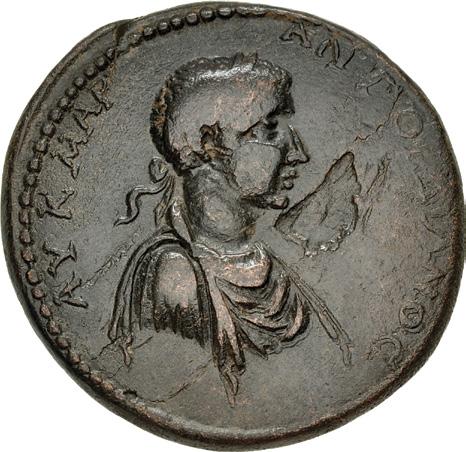

459. CARIA, Stratonicaea. Gordian III. AD 238-244. Æ (39mm, 26.67 g, 12h). Laureate, draped, and cuirassed bust right, seen from the front / Nike standing left, holding wreath and palm frond. RPC VII.1 659A (same obv. die). Brown patina, reverse porosity, flan flaws and scratches, flan crack. Near VF. Extremely rare, only one recorded in RPC, possibly the second known. ($500)
Cited in RPC
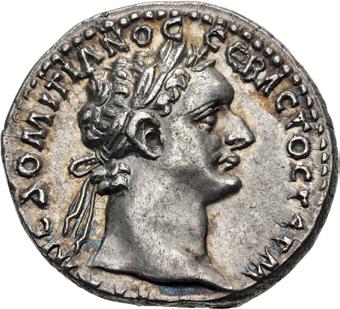


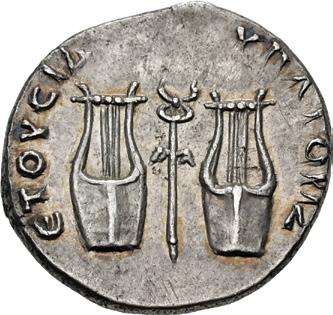
460. LYCIAN LEAGUE. Domitian. AD 81-96. AR Drachm (18mm, 3.45 g, 6h). Probably Rome mint. Struck AD 95. Laureate head right / ЄTOYC IΔ YΠATOC IZ (date), winged caduceus between two lyres. RPC II 1504.11 (this coin); SNG von Aulock 4265 (same dies); BMC 7. Lightly toned with iridescence, light marks and scratches. EF. ($500)
From the Wild Rose Collection. Ex Benito Collection (Classical Numismatic Group 114, 13 May 2020), lot 515; Group CEM (Triton XVI, 8 January 2013), lot 707; Lanz 112 (25 November 2002), lot 429.
128
457
458
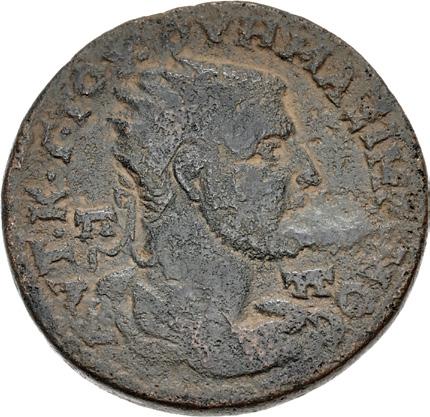
The Judgement of Paris
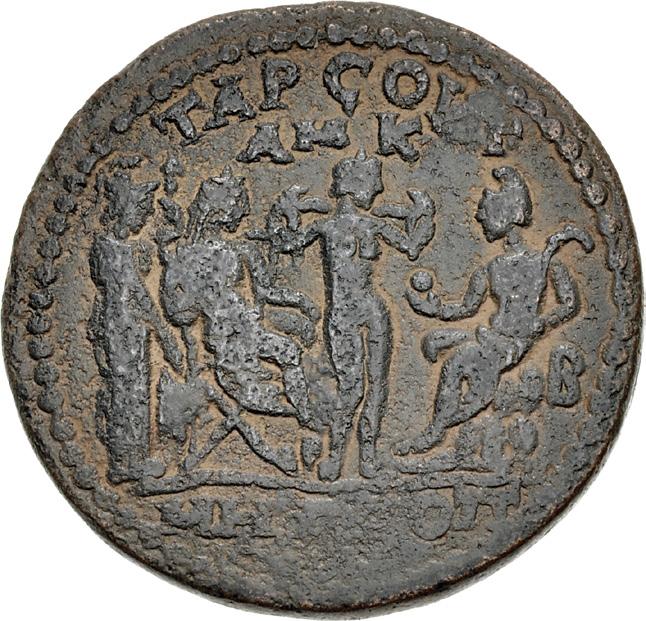
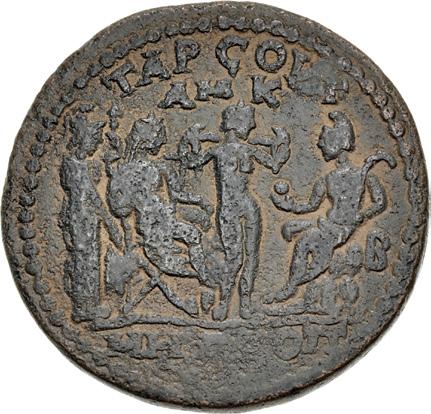
461. CILICIA, Tarsus. Maximinus I. AD 235-238. Æ (36mm, 23.63 g, 1h). Radiate, draped, and cuirassed bust right, seen from behind / The Judgement of Paris: Paris seated left on rock, wearing Phrygian cap and holding apple and pedum, facing Aphrodite, nude, standing right, drawing drapery from shoulders, veiled Hera enthroned right, and Athena standing right, resting shield on ground before her and holding spear. SNG BN 1587 (same dies); RPC VI Online 7109.10 (this coin); SNG Levante –; Cornell 117 (this coin). Earthen red-brown patina, slight roughness. VF. Rare. ($2000)
From the Hesiod Collection. Ex Historical Scholar Collection (Heritage 3101, 25 August 2022), lot 32073; David Simpson Collection (Triton V, 15 January 2002), lot 1755; Classical Numismatic Group XXIV (9 December 1992), lot 497.
Before the birth of her second son, Hekaba, wife of King Priam of Troy, dreamed that she had brought forth a flaming firebrand that destroyed the city, and the new-born child was therefore exposed on Mount Ida. Brought up by a shepherd, he was called Paris, and later, by his courage, earned the name Alexander or ‘defender of men’. He was beloved by the nymph Oenone, but he deserted her as a result of a tempting suggestion by Aphrodite which led to the Judgement of Paris. When Hermes came to Mount Ida with the three goddesses he called Paris and said to him: “Come here and decide which is the more excellent beauty of face, and to the fairer give this apple’s lovely fruit.” (Colluthus, The Rape of Helen 130). While Paris reflected, the goddesses, who for the occasion had bathed their immortal bodies, offered him bribes in order to win the apple award of beauty: Athena offered him the command of Phrygia and the destruction of Hellas, or as some say, that he would be bravest of mortals and skilled in every craft. Likewise Hera offered him, besides wealth, the dominion over Asia and Europe. But Aphrodite offered him the hand of Helen, whose beauty was famous worldwide, and this bribe won the apple.
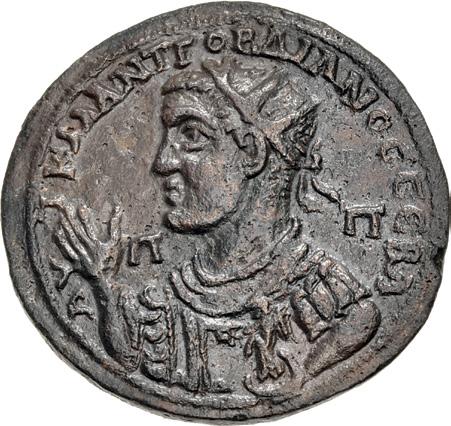

462. CILICIA, Tarsus. Gordian III. AD 238-244. Æ (37mm, 28.77 g, 6h). Radiate and cuirassed bust left, seen from the front, right hand raised, holding Nike in left / Gordian standing facing, head left, holding Nike and long scepter; bound Persian captive seated to left. RPC VII.2 3067; SNG BN 1723 (same dies); SNG Levante 1146 (same dies). Dark brown patina, light pitting, minor smoothing. Good VF. Rare. ($500)
Ganschow Plate Coin
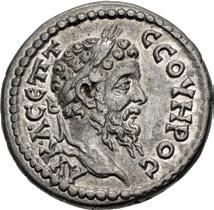

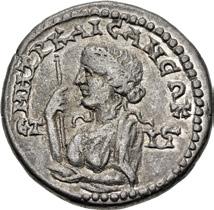
463. CAPPADOCIA, Caesarea-Eusebia. Septimius Severus. AD 193-211. AR Drachm (17.5mm, 2.98 g, 6h). Dated RY 16 (AD 207/8). Laureate head right / Half-length female bust left (Artemis?), holding scepter and patera; ЄT Iς (date) across field. Ganschow, Münzen 437c (this coin); Sydenham, Caesarea –. Toned, lustrous, minor marks. VF. Extremely rare, only this coin known to Ganschow, three in CoinArchives. ($500)
From the Weise Collection. Ex Künker 77 (30 September 2002), lot 520; Lanz 109 (27 May 2002), lot 576.
129
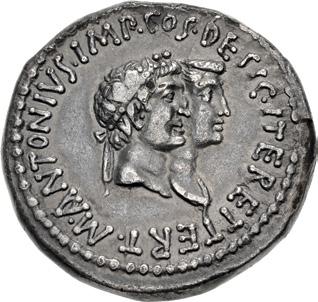
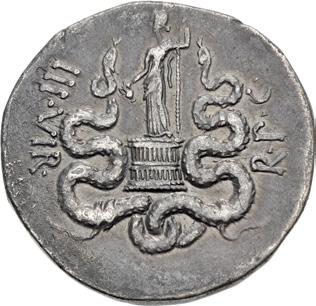

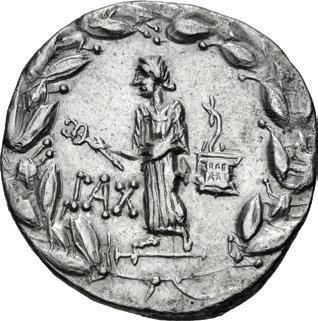
464. ASIA MINOR, Uncertain. Mark Antony and Octavia. Summer-autumn 39 BC. AR Cistophorus (26mm, 11.71 g, 11h). Ephesus mint(?). Conjoined heads right of Mark Antony, wearing ivy wreath, and Octavia, slight drapery / Dionysus, holding cantharus and thyrsus, standing left on cista mystica, flanked by interlaced serpents. Hiltmann, Type 2; RPC I 2202 (Cistophoric Mint); CRI 263; Sydenham 1198; RSC 3. Deeply toned, light roughness, scattered marks. Good VF. ($500)
From the Wild Rose Collection. Ex Roma XVI (26 September 2018), lot 461.
465. ASIA MINOR, Uncertain. Octavian. 28 BC. AR Cistophorus (26mm, 11.76 g, 1h). Ephesus mint(?). Laureate head right / Pax standing left, holding caduceus; to right, serpent arising from cista mystica; all within laurel wreath. Sutherland Group I, 50 var. (O72/R– [unlisted rev. die]); RPC I 2203 (Cistophoric mint); RSC 218. Minor marks, trace deposits. Good VF. Well centered and struck. ($750)
Pedigreed to 1926
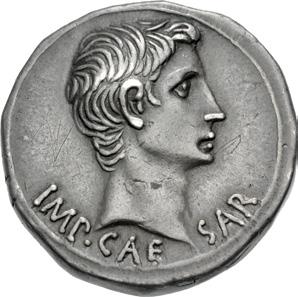
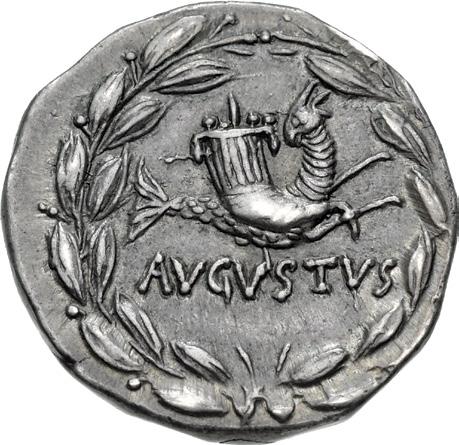

466. ASIA MINOR, Uncertain. Augustus. 27 BC-AD 14. AR Cistophorus (24mm, 11.92 g, 12h). Ephesus mint(?). Struck circa 25-20 BC. Bare head right / AVGVSTVS, capricorn right, head left, cornucopia on back; all within laurel wreath. Sutherland Group VI, 239a (O33/R43, this coin); RPC I 2213 (Cistophoric mint); RSC 16. Cabinet toning, minor marks, graffito on obverse. Good VF. ($1000)
Ex Lempertz 243 (21 September 1926), lot 293.
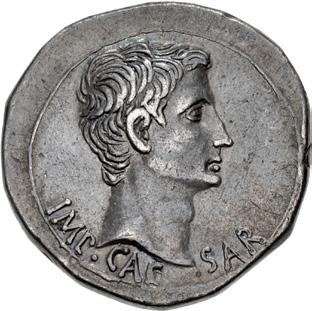
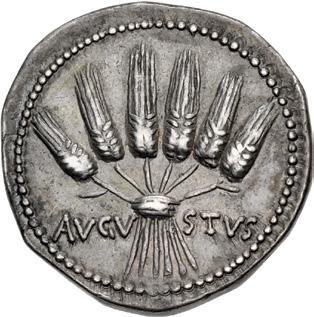
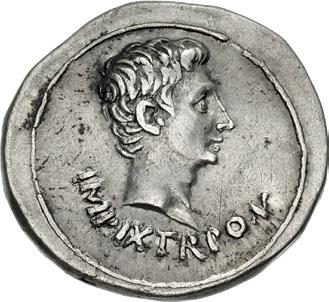
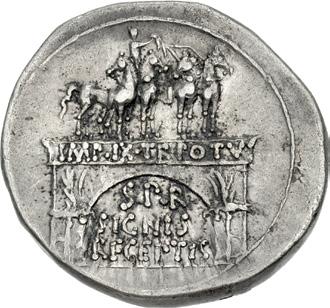
467. ASIA MINOR, Uncertain. Augustus. 27 BC-AD 14. AR Cistophorus (26mm, 11.81 g, 12h). Ephesus mint(?). Struck circa 25-20 BC. Bare head right / AVGVSTVS, six grain ears bound together. Sutherland Group VI 276 var. (O61/R– [unlisted rev. die]); RPC I 2214 (Cistophoric mint); RSC 32b. Toned with hints of iridescence, minor marks. Good VF. ($1000)
From the Wild Rose Collection, purchased from Herb Kreindler, January 2018. Ex Gorny & Mosch 224 (13 October 2014), lot 358 (hammer €2800); Gorny & Mosch 22 (25 May 1982), lot 407.
468. ASIA MINOR, Uncertain. Augustus. 27 BC-AD 14. AR Cistophorus (27mm, 11.72 g, 12h). Pergamum mint(?). Struck circa 19-18 BC. Bare head right / Triumphal Arch of Augustus, surmounted by charioteer in facing quadriga; an aquila before each side wall; IMP • IX • TR • POT • V • on entablature. Sutherland Group VIIα (unlisted dies); RPC I 2218 (Cistophoric mint); RSC 298. Toned, small patches of find patina, some scratches. VF. ($1500)
Ex Classical Numismatic Group 117 (19 May 2021), lot 521 (hammer $3,750, since conserved).
130
464
465
467
468
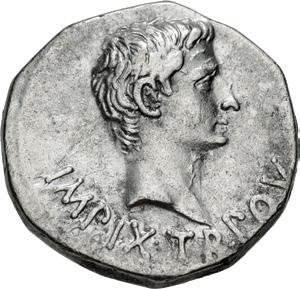
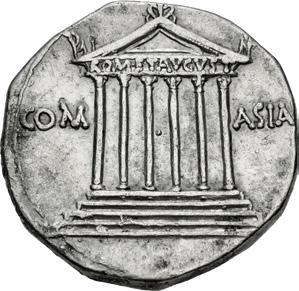
469. ASIA MINOR, Uncertain. Augustus. 27 BC-AD 14. AR Cistophorus (24mm, 11.94 g, 1h). Pergamum mint(?). Struck circa 19-18 BC. Bare head right / Hexastyle Temple of Rome and Augustus set on five-tiered base; pediment surmounted by acroteria; ROM ET AVGVST on entablature. Sutherland Group VIIβ, 513-7 var. (O12/R–; unrecorded rev. die); RPC I 2219 (Cistophoric mint); RSC 86. Minor marks, find patina remaining, edge filing. VF. ($750)
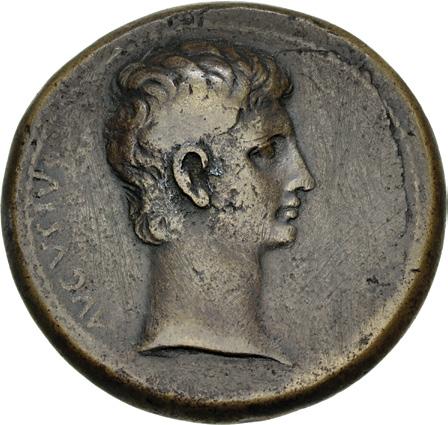
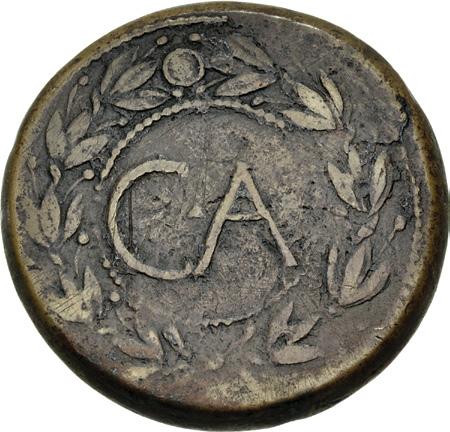
470. ASIA MINOR, Uncertain. Augustus. 27 BC-AD 14. Æ “Sestertius” (37mm, 28.98 g, 12h). Struck circa 25 BC. Bare head right / Large CA within laurel wreath framed by double-pelleted border. Howgego, Coinage, Class 2a; RPC I 2233; SNG von Aulock 6671. Light brown patina, cleaning marks. Near VF. ($750)
Ex Rudolf Berk Collection (Classical Numismatic Group 69, 8 June 2005), lot 1190 (hammer $2000).

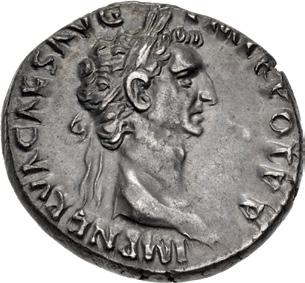
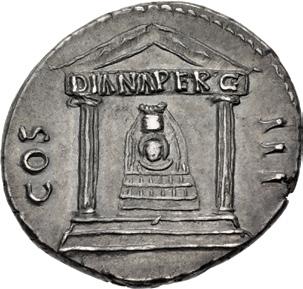
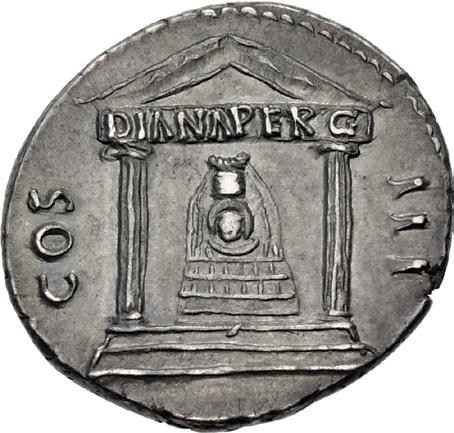
471. ASIA MINOR, Uncertain. Nerva. AD 96-98. AR Cistophorus (25mm, 10.79 g, 6h). Struck in Rome for circulation in Asia Minor. Struck January-November AD 97. Laureate head right / Cult statue of Diana of Perge within distyle temple on three steps; DIΛNΛ PERG across entablature. Woytek, Cistophore 3a; RPC III 1301 (Uncertain Cistophoric mint); RSC 42. Toned. Near EF. A superb example of the type. ($1000)
From the Wild Rose Collection, purchased from Warden Numismatics. Ex Stack’s Bowers Galleries (5 August 2020), lot 20124; Classical Numismatic Group 57 (4 April 2001), lot 1182.
472. NO LOT.

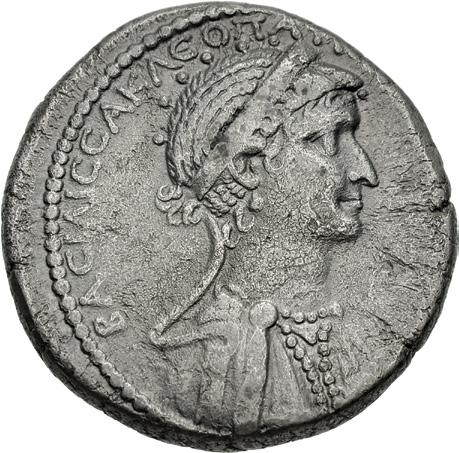
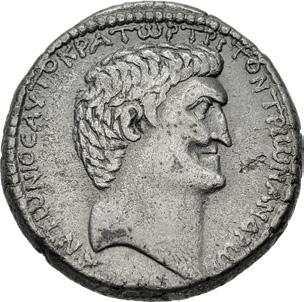
473. SELEUCIS and PIERIA, Antioch. Mark Antony & Cleopatra VII of Egypt. 36 BC. AR Tetradrachm (25mm, 14.68 g, 12h). Struck circa 36-34 BC. Diademed bust of Cleopatra right, wearing earring, necklace, and embroidered dress / Bare head of Antony right. McAlee 174; Prieur 27; RPC I 4094. Toned, light porosity, obverse off center, trace deposits. VF. ($5000)
131
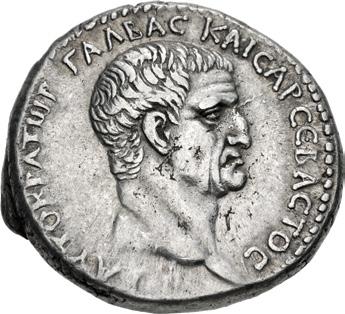
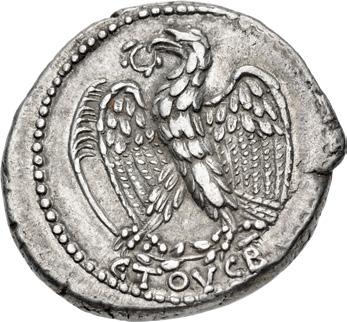
474. SELEUCIS and PIERIA, Antioch. Galba. AD 68-69. AR Tetradrachm (27.5mm, 15.68 g, 1h). Dated RY 2 (AD 68/9). Bare head right / Eagle standing left on wreath, with wings displayed, holding wreath in beak; palm frond to left, ЄTOYC B (date) in exergue. McAlee 308; RPC I 4198; Prieur 100. Lightly toned with traces of iridescence, obverse scratch, minor marks. VF. ($500)
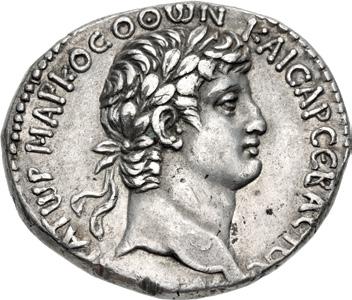
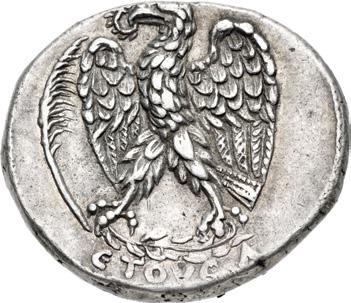
475. SELEUCIS and PIERIA, Antioch. Otho. AD 69. AR Tetradrachm (28mm, 15.52 g, 12h). Dated RY 1 (AD 69). Laureate head right / Eagle standing facing on wreath, with wreath in beak and wings displayed; palm frond to left; ЄTOYC A (date) in exergue. McAlee 315; RPC I 4200; Prieur 102. Lightly toned, minor porosity, small edge rub, trace deposits. Good VF. ($750)
Ex Prieur Collection


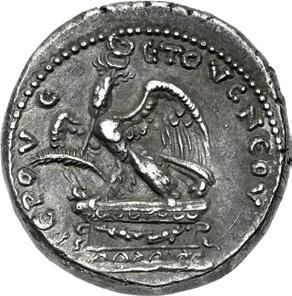
476. SELEUCIS and PIERIA, Antioch. Vespasian. AD 69-79. AR Tetradrachm (24mm, 14.73 g, 12h). Dated “New Holy Year” 5 (AD 72/3). Laureate bust left, slight drapery / Eagle standing left on garlanded altar, with wings displayed, holding caduceus in beak, palm frond in right talon. McAlee 360/2 (this coin illustrated); RPC II 1975.4 (this coin); Prieur 138 (this coin illustrated). Toned, scratches in obverse field. Good VF. Attractive portrait in high relief. Very rare. ($1000) Ex Peter Corcoran Collection (New York Sale LIV, 11 January 2022), lot 248; Michel Prieur Collection (Triton XXII, 7 January 2019), lot 583.

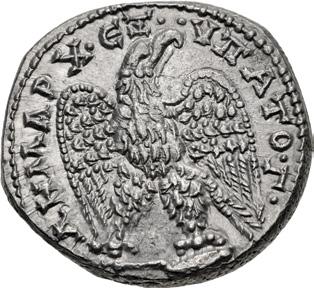
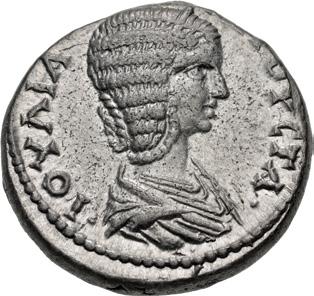
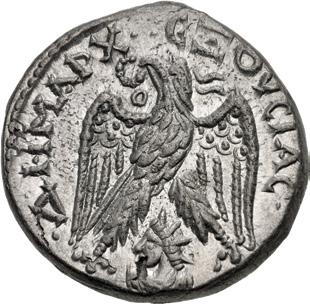
477. SELEUCIS and PIERIA, Antioch. Septimius Severus. AD 193-211. BI Tetradrachm (25.5mm, 13.14 g, 11h). Struck circa AD 202-204. Laureate head right / Eagle standing facing on leg and thigh of sacrificial animal, head and tail right, with wings displayed. McAlee 658; Prieur 186. Lustrous, minor marks. EF. A superb specimen. ($500)
478. SELEUCIS and PIERIA, Emesa. Julia Domna. Augusta, AD 193-217. BI Tetradrachm (25.4mm, 13.40 g, 12h). Officina O. Struck AD 215-217. Draped bust right, wearing stephane / Eagle standing facing, head and tail left, with wings displayed, holding wreath in beak; O beneath eagle’s head to left; between legs, radiate bust of Shamash left. Prieur 995. Lustrous, light porosity, minor flan flaws on reverse. EF. ($500)
132
477
478
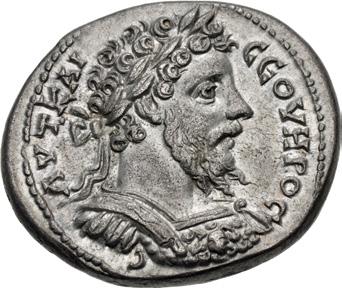
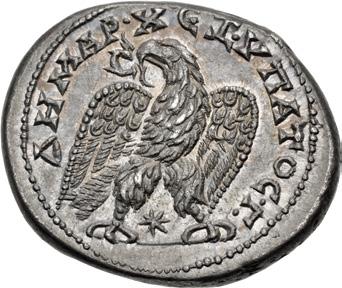

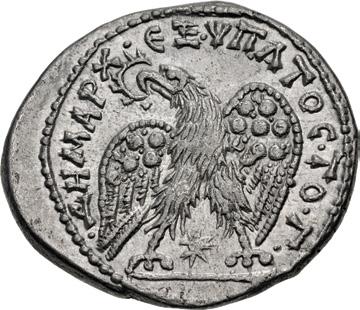
479. SELEUCIS and PIERIA, Laodicea ad Mare. Septimius Severus. AD 193-211. BI Tetradrachm (28mm, 13.55 g, 12h). Struck AD 207-209. Laureate and cuirassed bust right, seen from the front, gorgoneion on breastplate / Eagle standing facing, head left, with wings displayed, holding wreath in beak; star between legs. Prieur & Amandry Group II, 21 (this coin, illustrated on pl. XVI); McAlee, Severan, Group 1, 15; Prieur 1141 (this coin illustrated). Toned. EF. ($750)
From the Wild Rose Collection, purchased from Shanna Schmidt Numismatics. Ex Michel Prieur Collection (Triton XXII, 8 January 2019), lot 662; Schweizerische Kreditanstalt 4 (3 December 1985), lot 560; Hess-Leu 41 (24 April 1969), lot 280.
480. SELEUCIS and PIERIA, Laodicea ad Mare. Septimius Severus. AD 193-211. BI Tetradrachm (29mm, 11.74 g, 12h). Struck AD 208-209. Laureate and cuirassed bust right, with trabea, seen from the front, gorgoneion on breastplate, slight drapery on left shoulder / Eagle standing facing, head and tail left, with wings displayed, holding wreath in beak; star between legs. Prieur & Amandry Group I, –; McAlee, Severan, Group 3, 24; Prieur 1151. Underlying luster, minor marks. Good VF. Rare. ($500)
Extremely Rare and Superior to Prieur
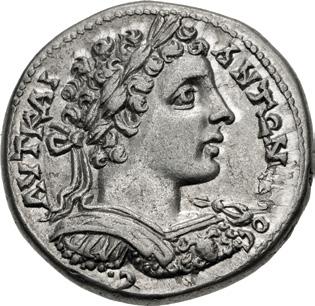
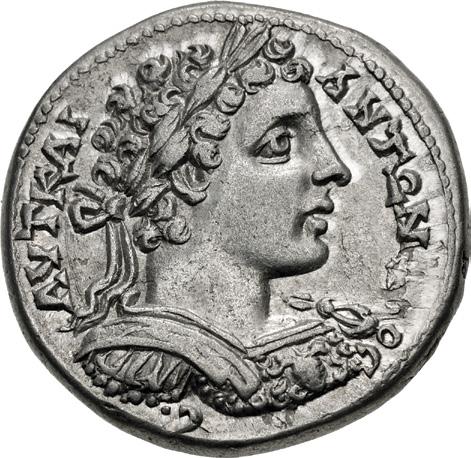

481. SELEUCIS and PIERIA, Laodicea ad Mare. Caracalla. AD 198-217. BI Tetradrachm (26mm, 12.31 g, 12h). Struck AD 205-207. Laureate and cuirassed bust right, slight drapery, seen from the front, gorgoneion on breastplate / Eagle standing facing, head and tail right, with wings displayed, holding wreath in beak; star between legs. Prieur & Amandry Group I, 15; McAlee, Severan, Group 1, –; Prieur 1129 (same obv. die). Toned with underlying luster. Near EF. Extremely rare, only one known to Prieur, only the Prieur specimen in CoinArchives, this coin far superior to the Prieur specimen. ($500)
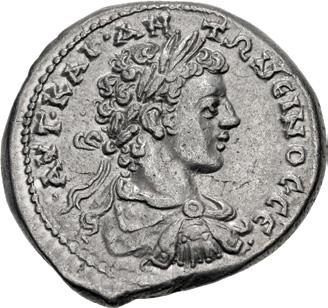
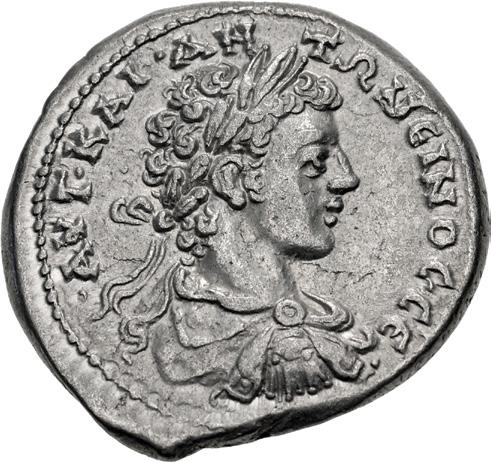
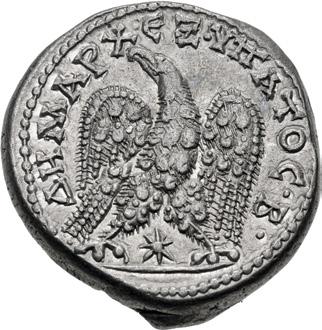
482. SELEUCIS and PIERIA, Laodicea ad Mare. Caracalla. AD 198-217. BI Tetradrachm (26.5mm, 14.51 g, 12h). Struck AD 205-207. Laureate, draped, and cuirassed bust right, seen from behind / Eagle standing facing, head left, with wings displayed; star between legs. Prieur & Amandry Group I, 10; McAlee, Severan, Group I, 5; Prieur 1132. Lightly toned, minor marks. EF. Very rare, two known to Prieur, two in CoinArchives. ($500)
133
479 480
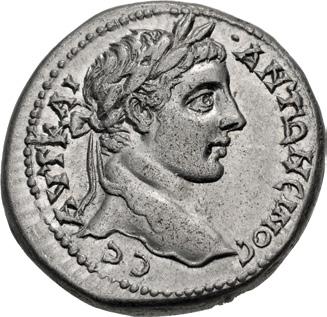
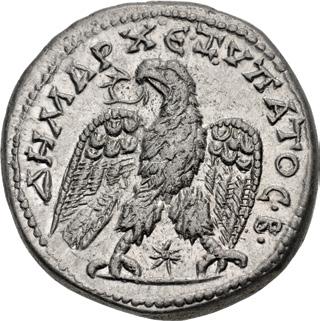
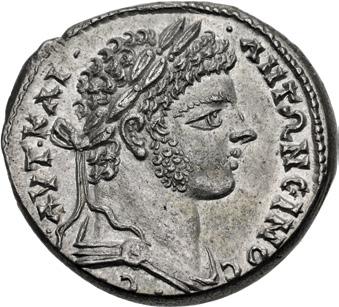
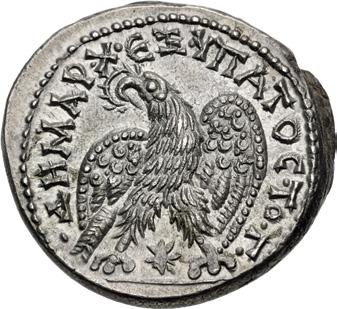
483. SELEUCIS and PIERIA, Laodicea ad Mare. Caracalla. AD 198-217. BI Tetradrachm (27mm, 13.18 g, 11h). Struck AD 207-209. Laureate head right / Eagle standing facing, head left, with wings displayed, holding wreath in beak; star between legs. Prieur & Amandry Group II, 27; McAlee, Severan, Group I, 15; Prieur 1142. Lightly toned with underlying luster, small obverse die flaw, light porosity. Near EF. Extremely rare, two known to Prieur, no additional specimens in CoinArchives. ($500)
484. SELEUCIS and PIERIA, Laodicea ad Mare. Caracalla. AD 198-217. BI Tetradrachm (27mm, 13.90 g, 12h). Struck AD 208-209. Laureate and draped bust right / Eagle standing facing, head left, with wings displayed, holding wreath in beak; star between legs. Prieur & Amandry Group III, 38 (this coin, obv. illustrated on pl. XVIII); McAlee, Severan, Group III, 28, pl. V, 28; Prieur 1153 (this coin illustrated). Toned with underlying luster. EF. ($500)
From the Wild Rose Collection. Ex Michel Prieur Collection (Triton XXII, 8 January 2019), lot 662; Münzen und Medaillen AG 66 (22 October 1984), lot 726.


485. SELEUCIS and PIERIA, Laodicea ad Mare. Caracalla. AD 198-217. BI Tetradrachm (28mm, 13.58 g, 12h). Struck AD 208-209. Laureate and draped bust right / Eagle standing facing, head left, with wings displayed, holding wreath in beak; star between legs. Prieur & Amandry Group III, 38; McAlee, Severan, Group III, 28, pl. V, 28; Prieur 1153. Lustrous, small obverse die flaw. Choice EF. ($750)

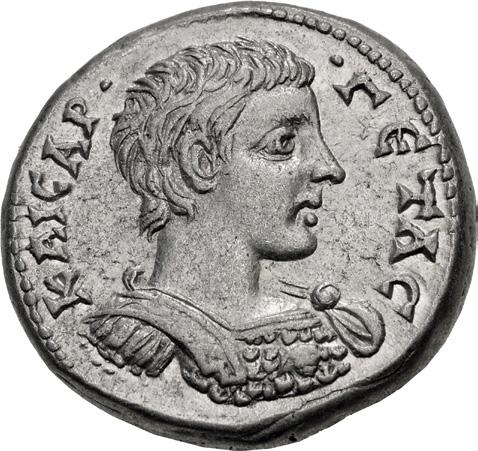
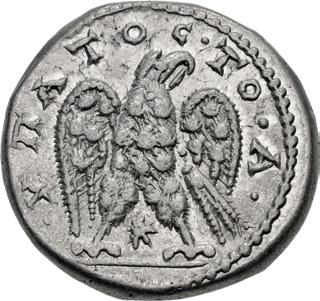
486. SELEUCIS and PIERIA, Laodicea ad Mare. Geta. As Caesar, AD 198-209. BI Tetradrachm (26mm, 15.43 g, 11h). Struck AD 205-207. Bareheaded and cuirassed bust right, slight drapery, with aegis on cuirass, seen from the front / Eagle standing facing, head and tail right, with wings spread, holding wreath in beak; star between legs. Prieur & Amandry Group I, 20; McAlee, Severan, Group I, 11; Prieur 1136 (same obv. die as illustration). Lightly toned with underlying luster, light marks. Good VF. Fine style. Extremely rare, one known to Prieur, only one in CoinArchives. ($500)


487. COELESYRIA, Chalcis ad Belum. Mark Antony and Cleopatra. 32-31 BC. Æ (20.5mm, 6.20 g, 12h). Dated RY 21 (Egyptian) and 6 (Phoenician) of Cleopatra (32/1 BC). Diademed and draped bust of Cleopatra right / Bare head of Antony right. RPC I 4771; Rouvier 438-40; Svoronos 1887; Sofaer 43. Green and brown patina, light roughness. VF. Attractive portraits. ($500)
134
483
484
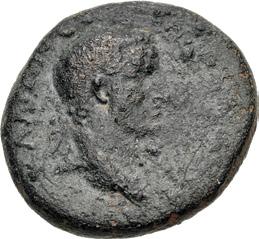
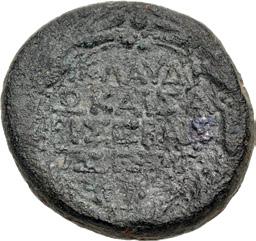
488. COELESYRIA, Chalcis ad Belum. Herod of Chalcis. AD 41-48. Æ Half unit (21mm, 8.12 g, 12h). Caesarea Maritima mint. Dated RY 3 (AD 43/4). Diademed head right / KΛAVΔI/Ω KAIΣA/PI ΣEBAΣ/TΩ ET Γ (date) in four lines within a circle within wreath. Meshorer 363; Hendin 6283; RPC I 4779. Dark green surfaces, roughness. Near VF. Extremely rare, only three in RPC, one in CoinArchives. ($1000)
Continued Herodian support of the Romans allowed the dynasty to extend its influence beyond Jewish territories. Herod V, the grandson of Herod the Great, was granted the kingdom of Chalkis by Claudius in 41 upon the request of Agrippa I, and all of Herod’s rare coins name the emperor. His friendship with and loyalty to the emperor continued to benefit him; following the death of Agrippa in 44, Claudius granted Herod authority over affairs at the Temple in Jerusalem, a right he retained until his death some four years later.



489. DECAPOLIS, Abila. Elagabalus. AD 218-222. Æ (30mm, 16.61 g, 12h). Dated CY 282 (AD 218/9). Laureate, draped, and cuirassed bust right / Lighted altar within hexastyle temple with arched central bay set on steps; pediment surmounted by Nike; on either side, crenellated multistory towers, each with arched entryway; BΠ C (date) above. Spijkerman 25; RPC VI Online 9242; Rosenberger 21; Sofaer –. Earthen green-brown patina, small pit on reverse. Near VF. Rare. ($500)

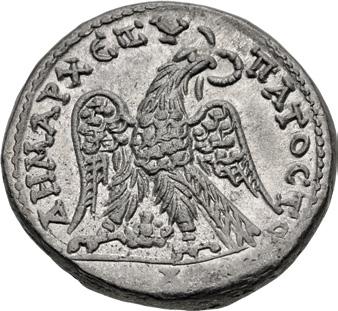
490. PHOENICIA, Aradus. Caracalla. AD 198-217. BI Tetradrachm (27mm, 12.59 g, 11h). Struck AD 215-217. AYT K MAY ANΩTNEINOC, laureate, draped, and cuirassed bust right, seen from behind / Eagle standing facing, head and tail right, with wings displayed, holding wreath in beak; between legs, bull’s head right. Prieur 1238 var. (obv. legend); Triton XXVII, lot 5501. Lustrous, minor marks, areas of peripheral weakness. Near EF. Extremely rare variety. ($500)

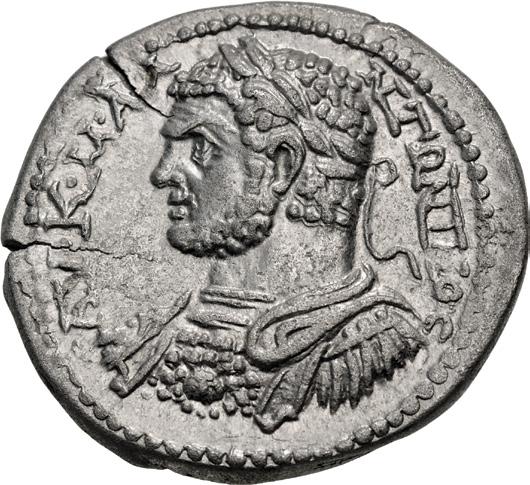
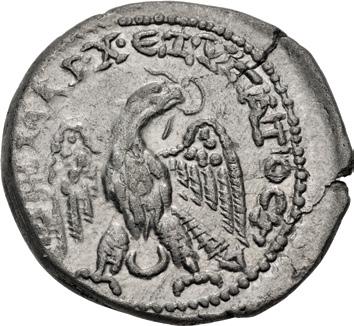
491. PHOENICIA, Aradus. Caracalla. AD 198-217. BI Tetradrachm (29mm, 12.16 g, 12h). Struck AD 215-217. Laureate and cuirassed bust left, with gorgoneion on breastplate, trabea over shoulder, seen from the front / Eagle standing facing, head right, with wings displayed, holding wreath in beak; crescent between legs. Prieur 1262. Lustrous, flan cracks. Near EF. Extremely rare, only one known to Prieur, two in CoinArchives. ($500)
135
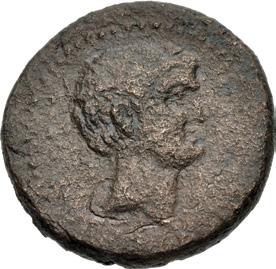
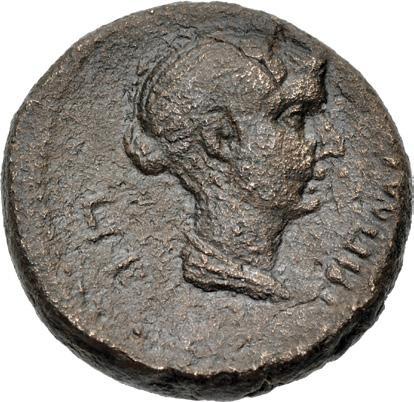

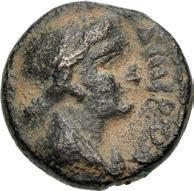
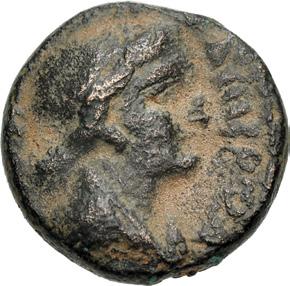
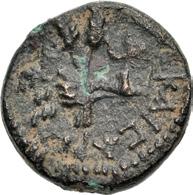
492. PHOENICIA, Tripolis. Mark Antony, with Fulvia. 42/1 BC. Æ (22mm, 10.04 g, 1h). Dated year 23 of the Pompeian Era (42/1 BC). Bare head of Mark Antony right / Draped bust of Fulvia right; L ΓK (date) behind. RPC I 4509; Rouvier 1641. Red-brown surfaces, light roughness. Near VF. Very rare, two attractive portraits. ($750)
Queen Cypros, Wife of Agrippa
493. JUDAEA, Herodians. Agrippa I, with Queen Cypros. 37-43 CE. Æ (15.5mm, 3.69 g, 12h). Caesarea Paneas mint. Dated RY 2 (37/8 CE). ΚΥΠΡΟC, draped bust of Cypros (wife of Agrippa) right / Hand holding three ears of grain; L B (date) flanking, vine in right field. Meshorer 114; Hendin 6269; RPC I 4975; Sofaer 149. Earthen brown surfaces, small spot of verdigris. VF. Very rare. ($750)

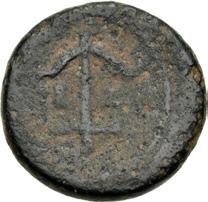
494. JUDAEA, Herodians. Agrippa I. 37-43 CE. Æ (16.5mm, 3.91 g, 12h). Caesarea Maritima mint. Dated RY 7 (42/3 CE). Bare head of Agrippa II left / Inverted anchor; L Z (date) flanking. Meshorer 123; Hendin 6277; RPC I 4987; Sofaer –. Black surfaces with earthen highlights, light porosity. Fine. Extremely rare. ($1000)
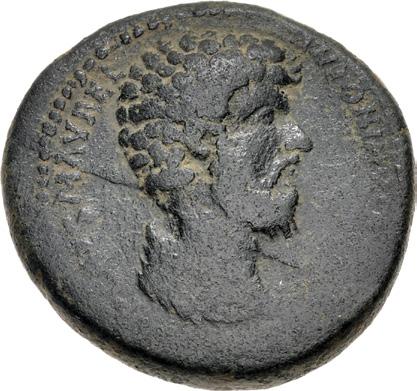
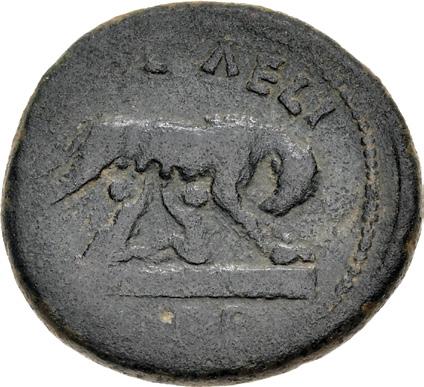
495. JUDAEA, Aelia Capitolina (Jerusalem). Marcus Aurelius. 161-180 CE. Æ (34mm, 33.05 g, 11h). Bareheaded and draped bust right / She-wolf standing right, head left, suckling the twins Romulus and Remus. Meshorer, Aelia 43 var. (bust type); RPC IV.3 Online 9270 var. (same); Rosenberger –; Sofaer 45 corr. (bust type). Brown patina with earthen green highlights, porosity, obverse die break. Good Fine. Extremely rare, the second known. ($1000)
The Third Known
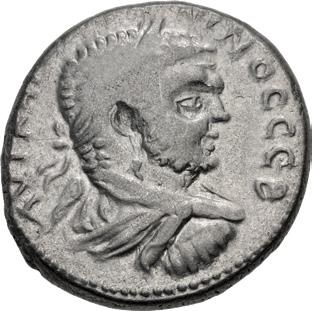

496. JUDAEA, Aelia Capitolina (Jerusalem). Caracalla. 198-217 CE. BI Tetradrachm (25mm, 14.83 g, 12h). Struck 215217 CE. AVT KAI ANT ωNЄINOC C B, laureate, draped, and cuirassed bust right, seen from behind / ΔHMAPX ЄΞ VΠATOC TO Δ, eagle standing facing on filleted thyrsus, head and tail left, with wings displayed, holding wreath in beak; in exergue, panther seated right with paw on wine jar. Meshorer, Aelia –; Prieur –; Sofaer –; Triton XXVII, lot 502 (same dies; hammer $3000). Lustrous, areas of flatness, struck on a small flan. VF. Extremely rare. Unpublished and the third known. ($500)
136
492
493
Extremely Rare

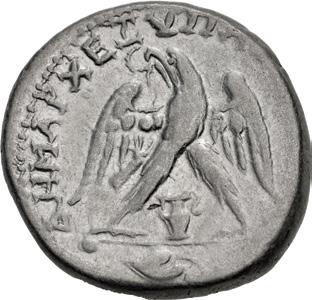
497. JUDAEA, Aelia Capitolina (Jerusalem). Caracalla. 198-217 CE. BI Tetradrachm (26.5mm, 12.89 g, 11h). Struck 215-217 CE. Laureate, draped, and cuirassed bust right, seen from behind / Eagle standing facing thyrsus, head and tail left, with wings displayed, holding wreath in beak; between legs, wine jar, ivy leaf in exergue. Meshorer, Aelia 88; Prieur 1635; Sofaer –. Lightly toned with hints of luster, peripheral weakness. Near VF. Extremely rare, only three known to Prieur, two in CoinArchives. ($500)


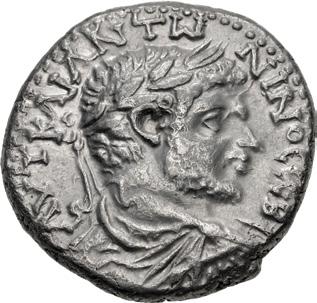
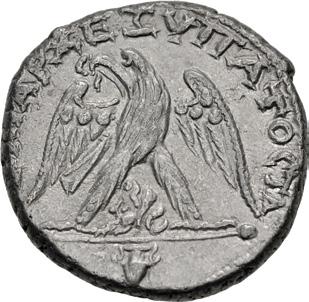
498. JUDAEA, Aelia Capitolina (Jerusalem). Caracalla. 198-217 CE. BI Tetradachm (26mm, 12.70 g, 12h). Struck 215-217 CE. Laureate, draped, and cuirassed bust right, seen from behind / Eagle standing facing on filleted thyrsus, head and tail left, with wings displayed, holding wreath in beak; vine leaf between legs. Meshorer, Aelia 95; Prieur 1617; Sofaer 82-3. Toned with traces of luster, obverse surface cracks. VF. ($500)
499. JUDAEA, Aelia Capitolina (Jerusalem). Caracalla. 198-217 CE. BI Tetradachm (25.5mm, 14.36 g, 5h). Struck 215-217 CE. Laureate, draped, and cuirassed bust right, seen from behind / Eagle standing facing on filleted thyrsus, head and tail left, with wings displayed, holding wreath in beak; between legs, mask of Silenus left; wine cup in exergue. Meshorer, Aelia 94 var. (obv. legend); Prieur 1620A; Sofaer –. Slight roughness. Good VF. Extremely rare, only one known to Prieur, and five in CoinArchives. ($500)
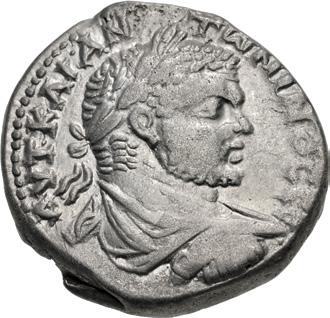

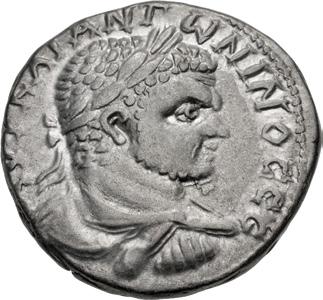

500. JUDAEA, Aelia Capitolina (Jerusalem). Caracalla. 198-217 CE. BI Tetradrachm (27mm, 14.81 g, 6h). Struck 215217 CE. Laureate, draped, and cuirassed bust right, seen from behind / Eagle standing facing on filleted thyrsus, head and tail left, with wings displayed, holding wreath in beak; between legs, wine jar in good style. Meshorer, Aelia 89; Prieur 1630; Sofaer –. Lightly toned with hints of luster, areas of flatness. VF. Very rare, only one known to Prieur, six in CoinArchives. ($500)
501. JUDAEA, Aelia Capitolina (Jerusalem). Caracalla. 198-217 CE. BI Tetradachm (26mm, 12.00 g, 11h). Struck 215-217 CE. Laureate, draped, and cuirassed bust right, seen from behind / Eagle standing facing on vine branch with three bunches of grapes, head and tail left, with wings displayed, holding wreath in beak; wine jar between legs. Meshorer, Aelia –; Prieur 1633; Sofaer –. Lightly toned with underlying luster, small obverse die flaw, slight reverse die shift. VF. ($500)

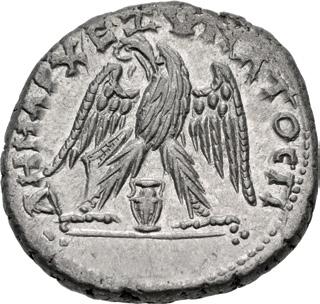
502. JUDAEA, Aelia Capitolina (Jerusalem). Diadumenian. As Caesar, 217-218 CE. BI Tetradrachm (26mm, 13.63 g, 6h). Bareheaded, draped, and cuirassed bust right, seen from the front / Eagle standing facing on thyrsus, head and tail left, with wings displayed, holding wreath in beak; wine jar between legs. Meshorer, Aelia 99a; Prieur 1646 var. (rev. legend); Sofaer 96. Lustrous, minor marks, obverse edge chip. Near EF. Extremely rare, only two known to Prieur, four in CoinArchives. ($1000)
137
500 501 498 499
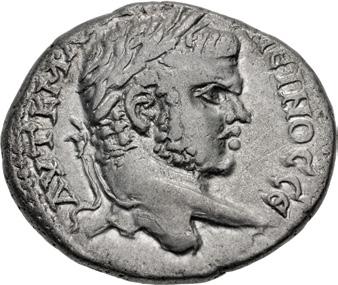
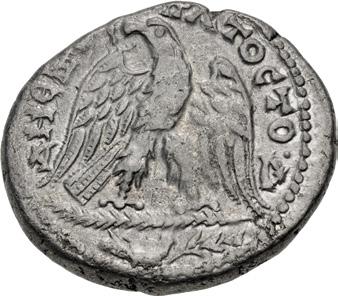
503. JUDAEA, Ascalon. Caracalla. 198-217 CE. BI Tetradrachm (27.5mm, 14.56 g, 12h). Struck 215-217 CE. Laureate head right / Eagle standing facing on palm frond, head and tail left, with wings displayed, holding wreath in beak; in exergue, dove right with olive branch in beak. Prieur 1654; Sofaer 177. Lightly toned with hints of luster, obverse scrapes. VF. ($500)
Unpublished Judaean Mystery Mint

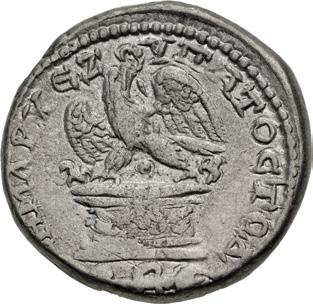
504. JUDAEA, Neapolis(?). Caracalla. 198-217 CE. BI Tetradrachm (25mm, 13.58 g, 12h). Struck 215-217 CE. AVT KAI M ANTWNINOC CЄ, laureate head right / ΔHMPX ЄΞ YΠATOCTO Δ, eagle standing left atop garlanded altar, head and tail right, with wings displayed, holding wreath in beak; between legs, pellet-in-annulet; below, serpent-entwined torch. Kropp –; Prieur –. Unpublished. Struck from worn dies, minor marks. VF. Extremely rare. ($750)
This coin shows traits of two different mints. The eagle on altar is prevalent on the coins of Neapolis (reattributed to Neapolis by Kropp, Byblus in Prieur), although the eagle is facing the opposite direction and is lacking the K or other field marks. The pellet-in-annulet and serpent-entwined torch is a common feature on the tetradrachms of Caesarea Maritima, but the altar reverse is not known for this city. None of this type are found in CoinArchives yet the die wear on the coin shows there must have been a significant number of these coins made. The attribution to which city is uncertain.
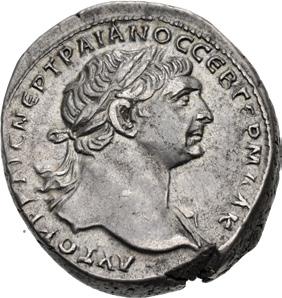
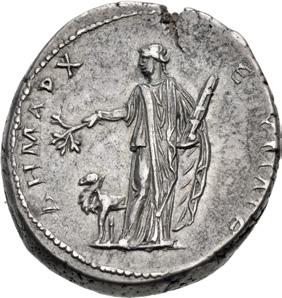
505. ARABIA, Bostra. Trajan. AD 98-117. AR Tridrachm (23mm, 11.53 g, 12h). Struck AD 111. Laureate bust right, drapery on shoulder / Arabia standing left, holding branch and bundle of cinnamon sticks; behind, camel standing left. Ganschow, Münzen X12b; RPC III 4051; Sydenham, Caesarea 182; Metcalf, Tell Kalak 2. Light cabinet tone, minor surface marks, edge chip. Good VF. ($500)
From the Wild Rose Collection. Ex Roma E-Live Auction 6 (25 March 2023), lot 96; Numismatica Ars Classica Spring Sale 2020 (25 May 2020), lot 983; Roma E-Sale 77 (26 November 2020), lot 739; Peus 386 (26 April 2006), lot 738; Müller 55 (12 June 1987), lot 162.
The Second Known
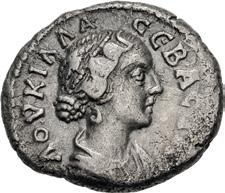
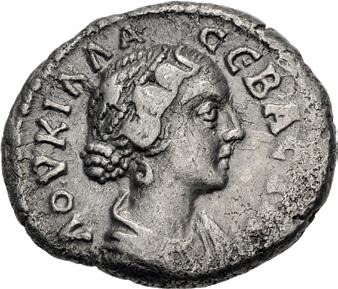
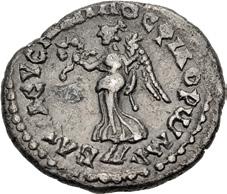
506. MESOPOTAMIA, Edessa. Ma’nu VIII, Philoromaios, with Lucilla. Augusta, AD 164-182. AR Drachm (18.5mm, 3.51 g, 6h). Struck circa AD 167-169. Diademed and draped bust of Lucilla right / Nike advancing left, holding wreath and palm frond. RPC IV.3 9619. Toned, light porosity. VF. Extremely rare, the second known. ($750)
Edessa was the capital of the client state of Osrhoene and became a Roman colony in the first century BC. While it aided Rome in their campaigns against the Parthians on several occasions, in AD 116, the Romans quelled an uprising which put an end to Osrhoene’s independence. But in 123, Hadrian restored the client kingdom under Ma’nu VII. Marcus Aurelius subsequently expanded the forts and city walls and stationed a garrison at Nisibis.
138
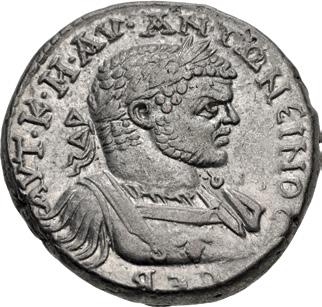
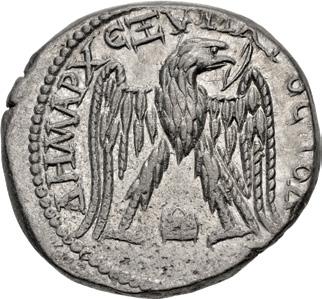
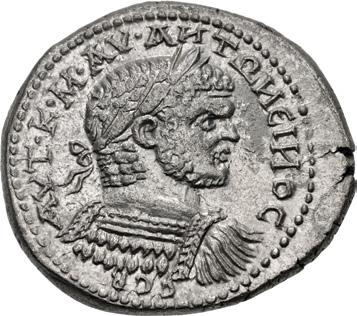
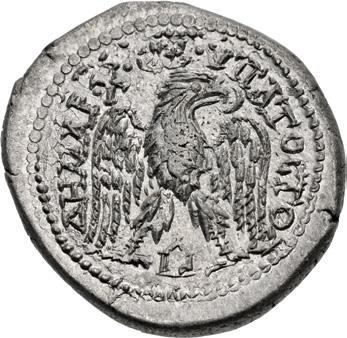
507. MESOPOTAMIA, Edessa. Caracalla. AD 198-217. BI Tetradrachm (26mm, 12.87 g, 12h). Struck circa AD 215217. Laureate and cuirassed bust right, seen from the front, with gorgoneion on breastplate / Eagle standing facing, head and tail right, with wings displayed, holding wreath in beak; between legs, shrine with pediment. Prieur 843. Lustrous, light porosity, minor marks and scratches. Near EF. ($500)
508. MESOPOTAMIA, Edessa. Caracalla. AD 198-217. BI Tetradrachm (29mm, 13.37 g, 11h). Struck circa AD 215217. Laureate and cuirassed bust right, seen from behind / Eagle standing facing, head and tail right, with wings displayed, holding wreath in beak; between legs, shrine with pediment. Prieur 845 (same obv. die). Lustrous, light obverse roughness, small flan cracks. EF. ($500)
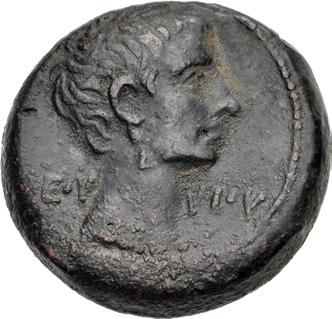

509. EGYPT, Alexandria. Augustus. 27 BC-AD 14. Æ Diobol – 80 Drachmai (27mm, 19.33 g, 11h). First series, struck circa 30-28 BC. Bare head right / Eagle standing left on thunderbolt; cornucopia to left, Π (mark of value) to right. Köln 1; Dattari (Savio) 2; K&G 2.5; RPC I 5001; Emmett 1. Dark brown patina with light earthen highlights. Good VF. Rare, one of the finest known specimens. ($750)
The first coinage of the new province of Egypt was a direct copy of the bronze coinage of Cleopatra, the last Ptolemaic ruler, with the portrait of Augustus replacing the Queen’s. Egypt, wealthy and a vital source of grain for the empire, was to be never allowed again as a potential leaping-off point for a rival emperor. The new province was held under tight control by the emperor. Its governor was to be an equestrian prefect answerable to Augustus, with a legion under his direct command. The Senate would have no say in the administration of the province, and in fact, senators were forbidden to travel there without permission.
Ex Dattari Collection


510. EGYPT, Alexandria. Hadrian. AD 117-138. Æ Drachm (34mm, 25.82 g, 1h). Dated RY 16 (AD 131/2). Laureate, draped, and cuirassed bust right, seen from behind / Nilus seated left on crocodile, holding reed and cornucopia; pile of rocks below; L I ς (date) in left field. Köln 1056 var. (date arrangement); Dattari (Savio) 1794 = RPC III 5791.68 (this coin); K&G 32.519; Emmett 1016.16. Brown patina, edge chips with flan crack, spot of verdigris. EF ($1500)
From the Wild Rose Collection, purchased from Numismatica Ars Classica, 19 January 2020. Ex Giovanni Dattari Collection (Numismatica Ars Classica 114, 6 May 2019), lot 684 (hammer CHF 3000).
139
507 508
Herakles’ Second Labor - A Non-Canonical Interpretation
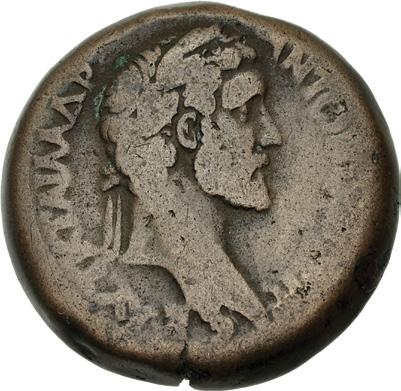
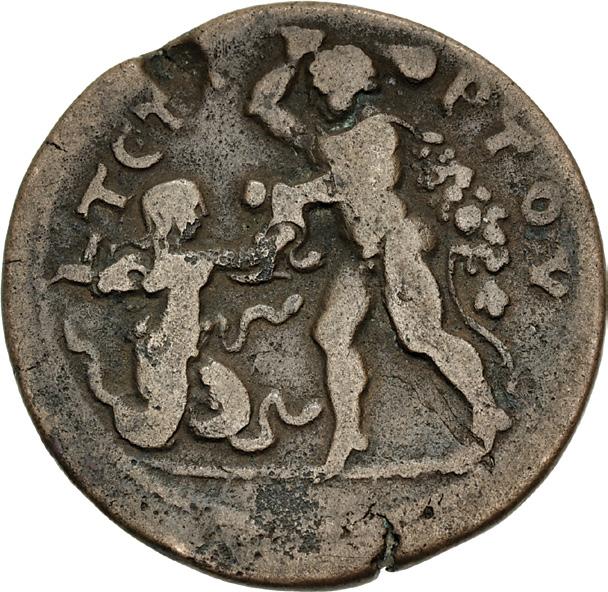

511. EGYPT, Alexandria. Antoninus Pius. AD 138-161. Æ Drachm (33mm, 25.34 g, 12h). Labor of Herakles type. Dated RY 4 (AD 140/1). Laureate head right / Herakles standing left, lion’s skin over left shoulder, holding club overhead in right hand, in left hand the right arm-tentacle of the anthropomorphized Lernaean Hydra; L TЄTA PTOV (date) around. Köln 1347 (same dies); Dattari (Savio) 8487 (same rev. die); K&G 35.89; RPC IV.4 248; Emmett 1545.4 (R5). Brown surfaces, light porosity, flan flaw on reverse. Near VF. Very rare, six recorded in RPC, two in CoinArchives. A very rare and interesting depiction of the Lernaean Hydra. ($1500)
Ex Dattari Collection
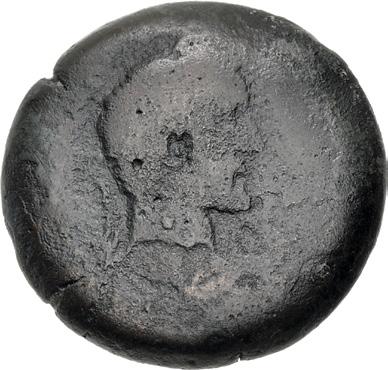
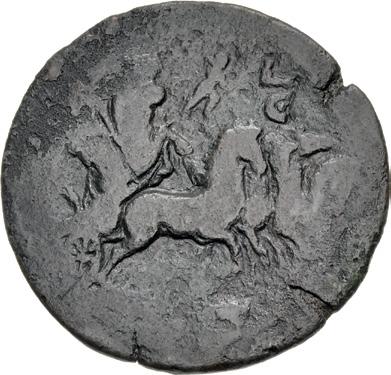
512. EGYPT, Alexandria. Antoninus Pius. AD 138-161. Æ Drachm (32mm, 20.27 g, 12h). Dated RY 5 (AD 141/2). Laureate head right / The Abduction of Persephone – Hades standing slightly right, head left, in quadriga right, holding the limp body of Persephone with his right hand and the reins of the quadriga with his left; above, Eros flying right, below, rocks designating the cave entrance to the underworld; L Є (date) above. Köln 1410; Dattari (Savio) 8851 = RPC IV.4 444.5 (this coin); K&G 35.158; Emmett 1525.5 (R5). Brown surfaces, some roughness. Fine. Extremely rare. ($750)
Ex Giovanni Dattari Collection (Naville Numismatics 69, 14 November 2021), lot 216.
Hades fell in love with Persephone, the daughter of Demeter, and asked Zeus for permission to marry her. Fearing to offend his eldest brother by a downright refusal, but also knowing that Demeter would not forgive him if Persephone were committed to the underworld, Zeus diplomatically answered that he could neither give nor withhold his consent. This act emboldened Hades to abduct Persephone as she was picking flowers in a meadow and carry her away in his horse-drawn chariot to the underworld.
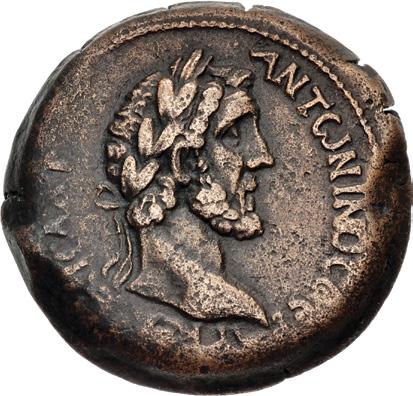
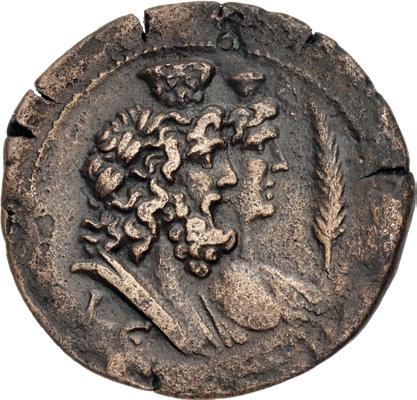
513. EGYPT, Alexandria. Antoninus Pius. AD 138-161. Æ Drachm (34mm, 24.08 g, 12h). Dated RY 5 (AD 141/2).
Laureate head right / Jugate busts of Serapis and Hermanubis right, both wearing calathus; Serapis draped, Hermanubis draped left shoulder; palm frond to right; L Є (date) below. Köln 1413; Dattari (Savio) –; K&G –; RPC IV.4 534; Emmett 1655.5 (R5).
Brown surfaces, light porosity. VF. Extremely rare, three known to RPC. ($500)
140
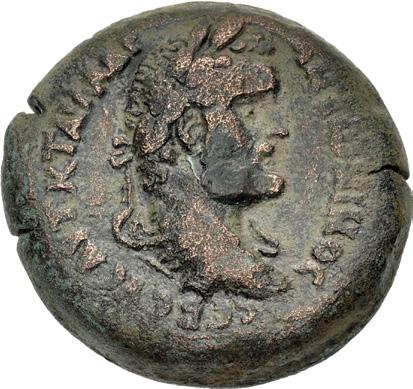
Jupiter in Pisces


The Great Sothic Cycle was a calendrical cycle based on the heliacal rising in July of the star Sirius (known to the Greeks as Sothis) and lasting approximately 1460 years. According to ancient Egyptian mythology, in a Golden Age, the beginning of the flooding of the Nile coincided exactly with the rising of Sirius, which was reckoned as the New Year. Only once every 1460 years did Sirius rise at exactly the same time. Thus, the coincidence of this along with the concurrent beginning of the flooding of the Nile gave the event major cosmological significance by heralding not just the beginning of a new year, but the beginning of a new eon. This event also was thought to herald the appearance of the phoenix, a mythological bird which was reborn every 500 to 1000 years out of its own ashes. According to one version of the myth, each new phoenix embalmed its old ashes in an egg of myrrh, which it then deposited in the Egyptian city of Heliopolis. So important was the advent of the new Great Sothic Cycle, both to the realignment of the heavens and its signaling of the annual flooding of the Nile, that the Egyptians celebrated it in a five-day festival, which emphasized the important cosmological significance.
In the third year of the reign of Antoninus Pius (AD 139/40), a new Great Sothic Cycle began. To mark this event, the mint of Alexandria struck an extensive series of coinage, especially in large bronze drachms, each related in some astrological way to the reordering of the heavens during the advent of the new Great Sothic Cycle. This celebration would continue throughout Pius’ reign, with an immense output of coinage during the eighth year of his reign in Egypt, which included this coin type, part of the Zodiac series.
The Second Known
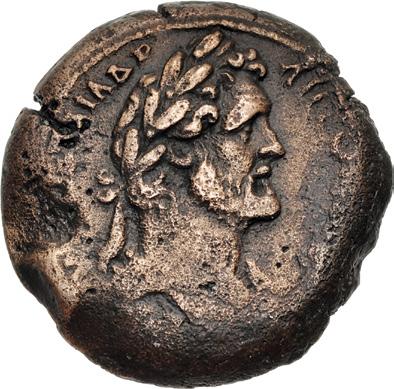
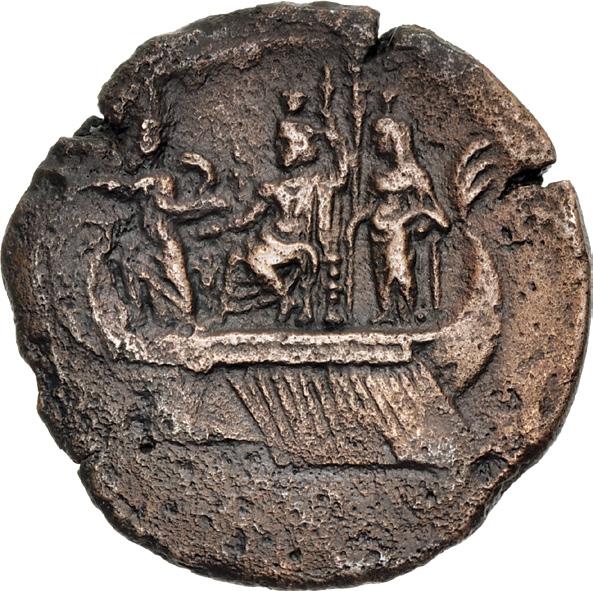

515. EGYPT, Alexandria. Antoninus Pius. AD 138-161. Æ Drachm (32.5mm, 22.18 g, 12h). Dated RY 21 (AD 157/8). Laureate and draped bust right / Barge of Sarapis: Sarapis enthroned left on the middle of a galley left, holding long scepter and extending right hand over Cerberus, seated at his feet left, on the throne back is Nike crowning him with a wreath; to the left; Isis Pharia standing left, holding billowing sail; to the right, Demeter, veiled, standing facing, head left, holding grain ears; [L KA (date) in exergue]. Köln 1871 (uncertain bust and year); Dattari (Savio) 2860; K&G –; RPC IV.4 1965.1 (same rev. die); Emmett 1673.21 (R5). Brown surfaces, pitting, flan flaw. VF. Extremely rare, the second known and superior to the ANS specimen. ($750)
141
514. EGYPT, Alexandria. Antoninus Pius. AD 138-161. Æ Drachm (34mm, 26.95 g, 11h). Zodiac series. Dated RY 8 (AD 144/5). Laureate head right / Jupiter in Pisces – Bust of Zeus (Jupiter) right, wearing taenia and draped on left shoulder, transverse scepter across right shoulder; star of eight rays before; fish right and left below; L H (date) across field. Köln –; Dattari (Savio) 2981; K&G 35.260; RPC IV.4 837; Emmett 1692.8. Earthen green patina, bare metal exposed. Near VF. ($1500)

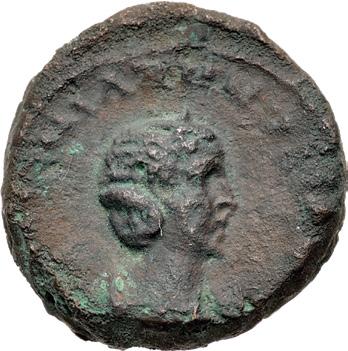
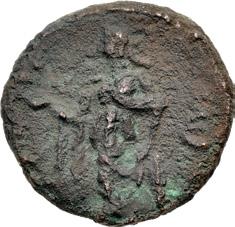
516. EGYPT, Alexandria. Zenobia. Usurper, AD 268-272. Potin Tetradrachm (19mm, 6.50 g, 12h). Dated RY 5 of Vabalathus (March - June AD 272). Diademed and draped bust right, wearing stephane / Elpis advancing left, holding flower and lifting hem of skirt; L Є (date) across field. Bland, Coinage 56; Köln 3065; Dattari (Savio) 5511; K&G 108.1; RPC X Online 75756; Emmett 3911.5. Red-brown surfaces with spots of verdigris, light roughness. Near VF. ($1000)

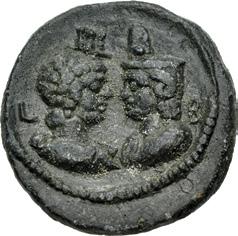
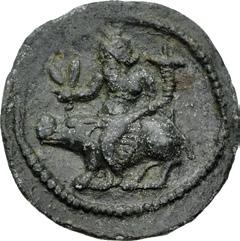

517. EGYPT, Antinoöpolis. 2nd-3rd centuries AD. PB Tessera (19.5mm, 4.67 g, 12h). Dated RY 2 of Antoninus Pius (?) (AD 138/9). Confronted busts of Antinous, draped and wearing hem-hem crown, and Isis, draped and wearing headdress; L B (date) flanking / Nilus reclining left on hippopatumus, holding cornucopia and reeds. Wilding 1; Milne –; Dattari (Savio) –; Köln 3567-8 corr. (Isis on obverse, not Horus). Gray patina. Good VF. Rare. The finest of its type in CoinArchives. ($500) Ex Leu Numismatik AG 4 (25 May 2019), lot 534 (hammer 1900 CHF).
Denise Wilding provides the first comprehensive examination of the lead tokens of Antinoüs, cataloging a number of otherwise unpublished types. Noting that they appear most often with the years 2, 4, 6, and 8, she suggests that the pieces were a continuation of the bronze coinage in the name of Antinoüs issued under Hadrian in years 19 and 21, with the lead pieces bearing regnal dates of Antoninus Pius. The tokens were likely issued in connection with biennial festivities of the cult of Antinoüs. For more information, see: Wilding, Denise. “Tokens of Antinous from the Province of Roman Egypt,” in Tokens: Culture, Connections, Communities. (London: Royal Numismatic Society, 2019).

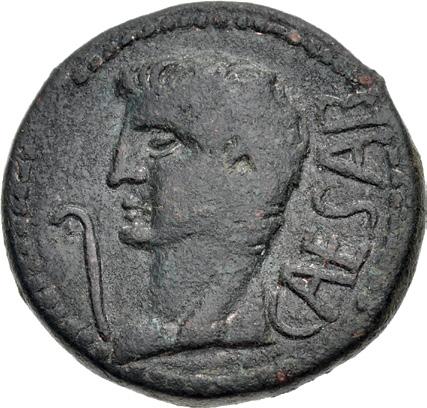
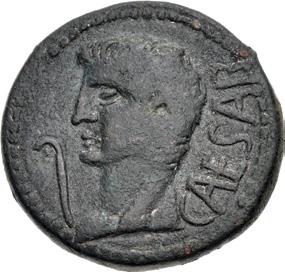
518. SYRTICA, Sabratha. Divus Augustus. Died AD 14. Æ Dupondius (23.5mm, 9.89 g, 9h). Struck under Tiberius, circa AD 8-14. Head of Serapis left, wearing calathus; Neo-Punic “GD RS” in front / Radiate head of Divus Augustus left; lituus before. RPC I 820; MAA 43c; Müller –. Dark green and red patina, light porosity. VF. Very rare, excellent for the type. ($500)
142
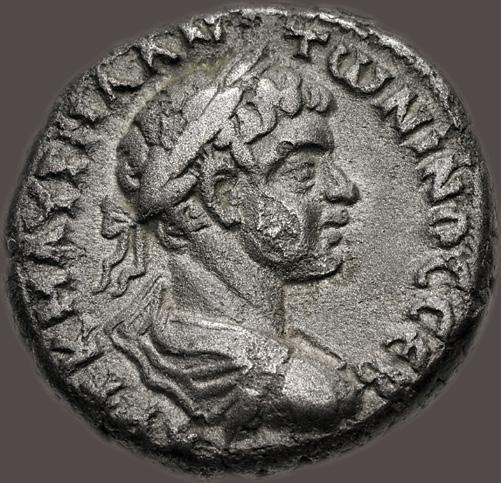
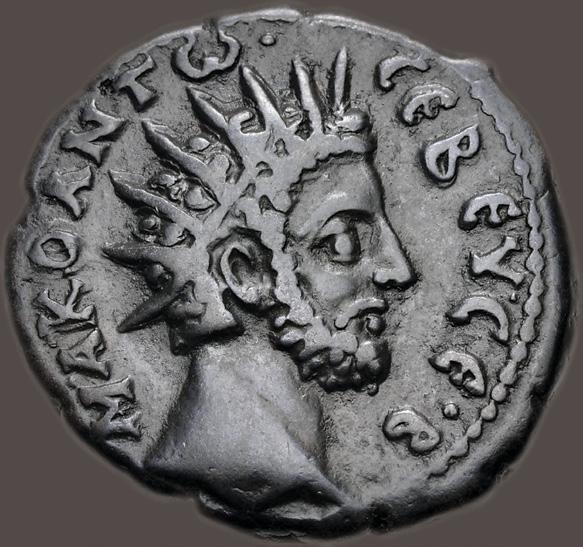
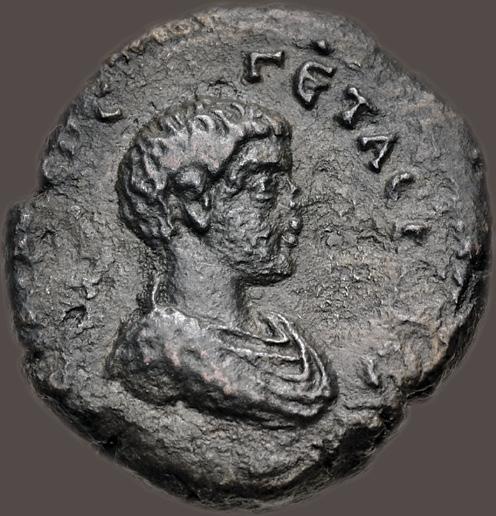
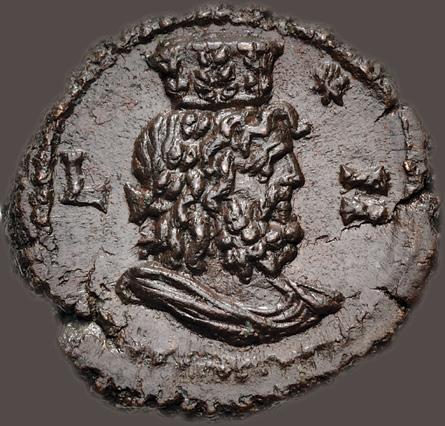
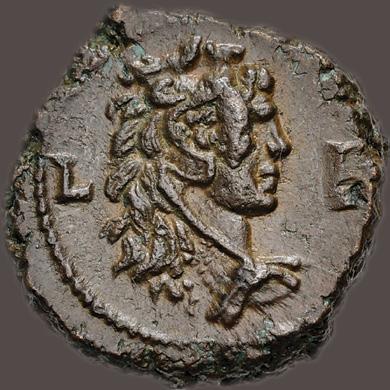
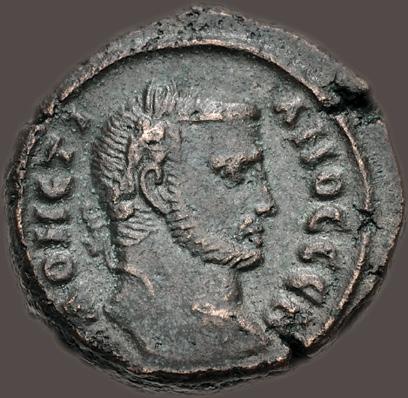 Further Selections from the Dr. Thomas E. Beniak Collection
Further Selections from the Dr. Thomas E. Beniak Collection
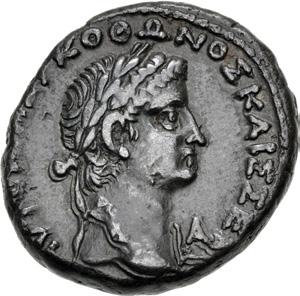
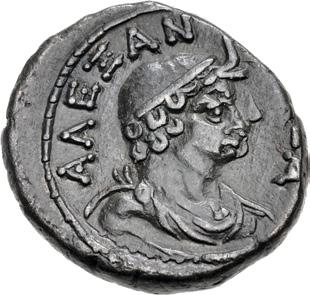
519. EGYPT, Alexandria. Otho. AD 69. BI Tetradrachm (25mm, 13.62 g, 12h). Dated RY 1 (AD 69). Laureate head right; L A (date) below chin / AΛEΞAN ΔPIA, draped bust of Alexandria right, wearing elephant’s skin headdress. Köln 245; Dattari (Savio) 324; K&G 18.1; RPC I 5358; Emmett 182.1 (R2). Deeply toned, minor marks and scratches, reverse die shift, reverse slightly off center. VF. An excellent example. ($500)
From the Dr. Thomas E. Beniak Collection, purchased from Nilus Coins, 1 August 2018. Ex The New Orleans Collection.

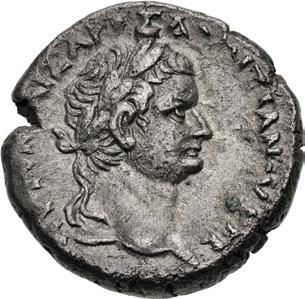
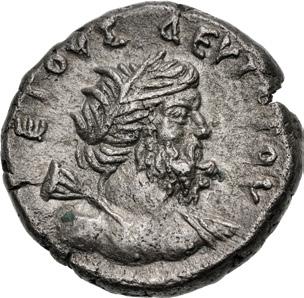
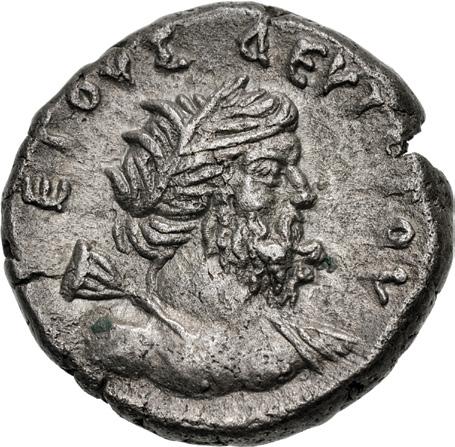
520. EGYPT, Alexandria. Domitian. AD 81-96. BI Tetradrachm (25mm, 13.21 g, 12h). Dated RY 2 (AD 82/3). Laureate head right / ETOYΣ ΔEYTEPOY, wreatned bust of Nilus right, drapery on left shoulder, lotus on right shoulder. Köln –; Dattari (Savio) 440 corr. (legends); K&G 24.4; RPC II 2477; Emmett 245.2 (R4). Toned, slight roughness, small edge chip. Good VF. Extremely rare, only four known to RPC, one more in CoinArchives. ($500)
From the Dr. Thomas E. Beniak Collection, purchased from Nilus Coins, 27 September 1997.
Extremely Rare - One of Two Known
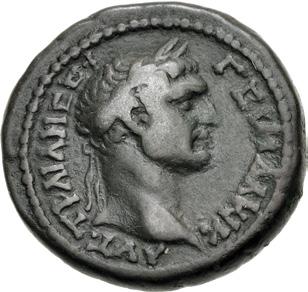
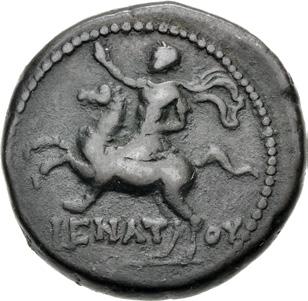
521. EGYPT, Alexandria. Trajan. AD 98-117. BI Tetradrachm (25mm, 13.99 g, 12h). Dated RY 9 (AD 105/6). Laureate head right / Trajan, laureate and in military attire, galloping on horseback left, raising right hand, chalmys billowing behind; L ENAT OY (date) below. Köln –; Dattari (Savio) –; K&G –; RPC III 4182.2 (this coin); Emmett 380.9 (R5). Brown patina, slight porosity. VF. Extemely rare, one of two known. ($500)
From the Dr. Thomas E. Beniak Collection, purchased from Nilus Coins, 11 January 2007. Ex Marcel Jungfleisch Collection (Part II, Sotheby’s, 9 March 1972), lot 51 (part of).
Rare One Year Type


522. EGYPT, Alexandria. Hadrian. AD 117-138. BI Tetradrachm (24mm, 13.08 g, 12h). Dated RY 2 (AD 117/8). Laureate bust right, slight drapery on left shoulder / Herakles standing facing, head right, holding club set on ground with his right hand, lion’s skin draped over his left arm; L B (date) in field. Köln –; Dattari (Savio) 1386; K&G 32.20; RPC III 4998.2 (this coin); Emmett 855.2 (R5). Toned, light porosity. VF. Extremely rare, the second known. ($500)
From the Dr. Thomas E. Beniak Collection, purchased from Holyland Numismatics, 8 January 2010.
144
The Second Known – Published in RPC
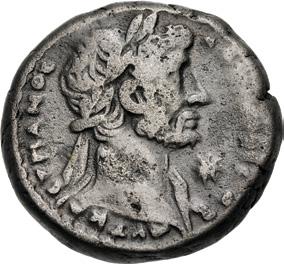

523. EGYPT, Alexandria. Hadrian. AD 117-138. BI Tetradrachm (23mm, 13.66 g, 12h). Dated RY 2 (AD 117/8). Laureate bust right, slight drapery on left shoulder; star before / Diademed head of Herakles right; L B (date) across field. Köln –; Dattari (Savio) –; K&G –; RPC III 5083.2 (this coin); Emmett 854.2 (date unrecorded). VF. Extremely rare, the second known. ($500)
From the Dr. Thomas E. Beniak Collection, purchased from Holyland Numismatics, 8 January 2010.

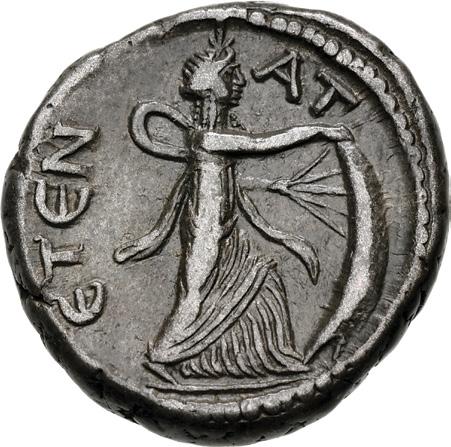
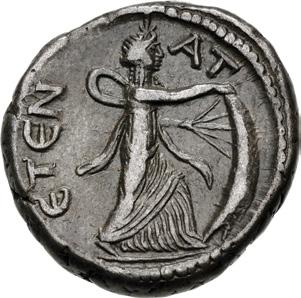
524. EGYPT, Alexandria. Hadrian. AD 117-138. BI Tetradrachm (24.5mm, 13.83 g, 11h). Dated RY 9 (AD 124/5). Laureate, draped, and cuirassed bust right, seen from behind / Isis Pharia standing right, holding billowing sail with both hands; ЄT ЄN AT (date) around. Köln 3463; Dattari (Savio) 1404; K&G 32.302; RPC III 5506; Emmett 868.9 (R5). Toned, small lamination flaw. Good VF. Very rare. ($500)
From the Dr. Thomas E. Beniak Collection. Ex Münzen und Medaillen GmbH 1 (16 September 1997), lot 523.
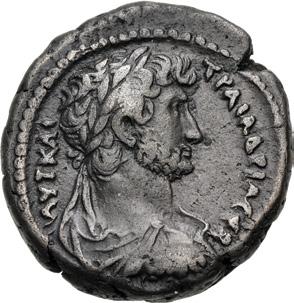
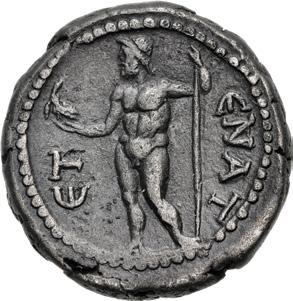
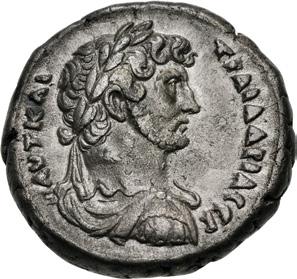

525. EGYPT, Alexandria. Hadrian. AD 117-138. BI Tetradrachm (24mm, 12.86 g, 12h). Dated RY 9 (AD 124/5). Laureate, draped, and cuirassed bust right, seen from behind / Zeus standing facing, head left, holding eagle in right hand, long scepter in left; ЄT ЄNAT (date) around. Köln –; Dattari (Savio) 1513; K&G 32.314; RPC III 5520; Emmett –. Toned, light porosity, edge chip, small flan flaw on reverse. VF. Extremely rare, only two known to RPC. ($500)
From the Dr. Thomas E. Beniak Collection, purchased from Holyland Numismatics, 8 January 2010.
Extremely Rare – Ex Dattari
526. EGYPT, Alexandria. Hadrian. AD 117-138. BI Tetradrachm (24mm, 13.25 g, 12h). Dated RY 10 (AD 125/6). Laureate, draped, and cuirassed bust right, seen from behind / Athena advancing left, holding spear in right hand, round shield in left; below, serpent left; L ΔEK ATOV (date) around. Köln –; Dattari (Savio) 1309bis = RPC III 5573.3 = Figari & Mosconi 229 (this coin); K&G 32.342; Emmett 820.10 (date unrecorded). Gray patina with residual luster. Good VF. Extremely rare, one of three known specimens. ($500)
From the Dr. Thomas E. Beniak Collection. Ex Hauck & Aufhäuser 16 (16 October 2001), lot 331; Kress 154 (21 March 1972), lot 337; Giovanni Dattari Collection.
145
525
526
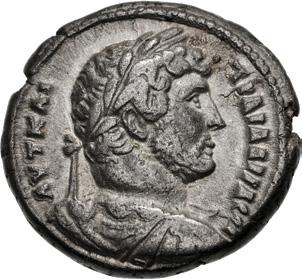

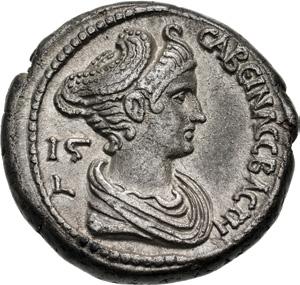
527. EGYPT, Alexandria. Hadrian, with Sabina. AD 117-138. BI Tetradrachm (25mm, 13.00 g, 11h). Dated RY 16 (AD 131/2). Laureate, draped, and cuirassed bust of Hadrian right, seen from behind / CABЄINA CЄBACTH, draped bust of Sabina right, wearing stephane; L Iς (date) behind. Köln 1040; Dattari (Savio) 1250; K&G 32.515; RPC III 5787; Emmett 886.16. Toned with considerable luster. Good VF. Excellent portraits. ($500)
From the Dr. Thomas E. Beniak Collection, purchased from Smythe, 8 April 2000.

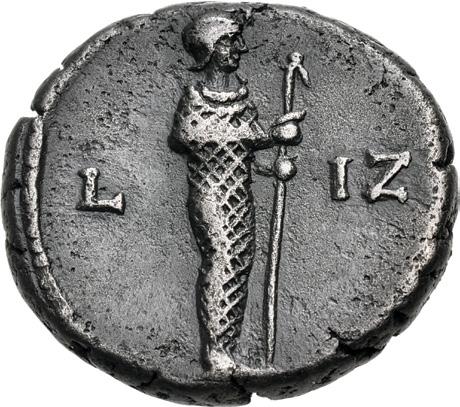
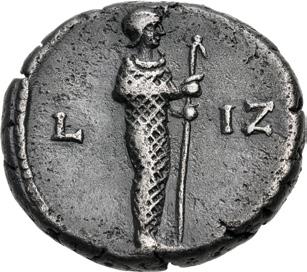
528. EGYPT, Alexandria. Hadrian. AD 117-138. BI Tetradrachm (25mm, 13.39 g, 11h). Dated RY 17 (AD 132/3). Laureate, draped, and cuirassed bust right, seen from behind / Mummiform Osiris (Ptah-Sokar-Osiris) standing right, holding scepter tipped with jackal-head; L IZ (date) across field. Köln –; Dattari (Savio) 1446 corr. (date given as L Z); K&G 32.535; RPC III 5823; Emmett 883.17 (R5 = Dattari 1446). Toned, some porosity. Good VF. Very rare. ($500)
From the Dr. Thomas E. Beniak Collection, purchased from Holyland Numismatics, 8 January 2010.
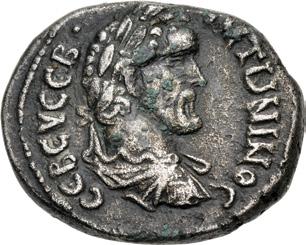
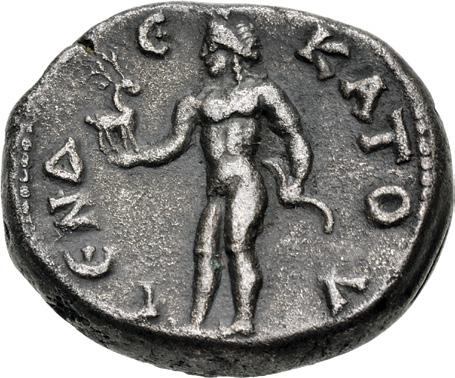

529. EGYPT, Alexandria. Antoninus Pius. AD 138-161. BI Tetradrachm (25mm, 13.08 g, 12h). Dated RY 11 (AD 147/8). Laureate, draped, and cuirassed bust right, seen from behind / Apollo Didymeus standing left, holding stag in left hand and bow in right; L ЄNΔЄ KATOV (date) around. Köln 1564 var. (legend arrangement); Dattari (Savio) 2145; K&G 35.387; RPC IV.4 1033; Emmett 1359.9 (year unrecorded). Toned, porosity, spots of verdigris. VF. Very rare. ($500)
From the Dr. Thomas E. Beniak Collection, purchased from Holyland Numismatics, 28 April 2012.
The cult center of Apollo Didymeus near Miletos achieved a high level of fame throughout the ancient world. The 26th Dynasty pharaoh Necho II (610-595 BC) won two great battles in Syria, and dedicated his armor to the shrine of Apollo (Herodotus ii, 159). Its oracle was second in popularity only to that of Delphi. His influence played a significant role in initiating Diocletian’s persecution of the Christians in the fourth century. His popularity continued until 314 when Constantine I declared Christianity the only official religion of the Roman empire. The temple of the Oracle at Dydima was sacked and its pagan priests tortured–many to their deaths. Soon after, a Christian church was built on its foundation.
146
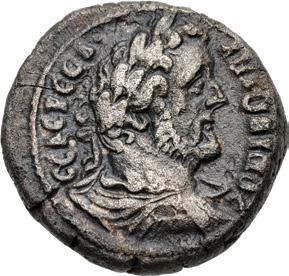
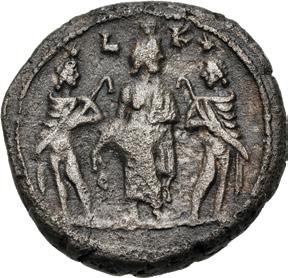
530. EGYPT, Alexandria. Antoninus Pius. AD 138-161. BI Tetradrachm (24mm, 12.32 g, 12h). Dated RY 20 (AD 156/7). Laureate, draped, and cuirassed bust right, seen from behind / Serapis standing facing, head right, wearing calathus, and holding taenia(?) in lowered right hand; on either side, Dioscuri, standing facing, heads turned to him, each holds a whip, star above each; L K (date) above. Köln 1772; Dattari (Savio) 2379 var. (bust); K&G 35.710; RPC IV.4 1843; Emmett 1430.20 (R5). Brown and gray patina, roughness, flan crack. VF. Rare one year issue. ($500)
From the Dr. Thomas E. Beniak Collection, purchased from Holyland Numismatics, 23 April 2010.
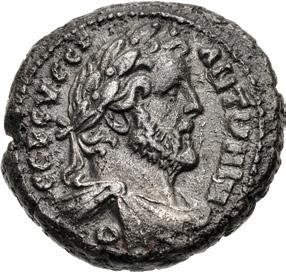
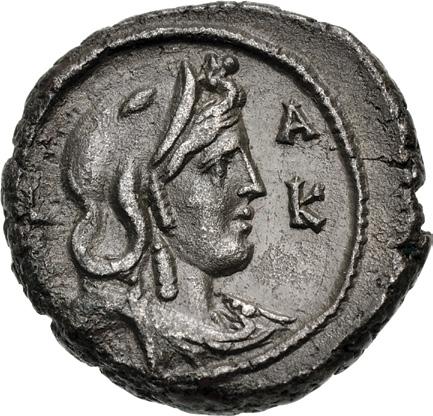

531. EGYPT, Alexandria. Antoninus Pius. AD 138-161. BI Tetradrachm (24mm, 13.44 g). Dated RY 21 (AD 157/8). Laureate and draped bust right / Draped bust of Alexandria right, wearing elephant’s skin headdress; L A/K (date) above. Köln 1788 var. (date arrangement); Dattari (Savio) 2131; K&G 35.728; RPC IV.4 1925; Emmett 1355.21. Toned, light roughness. Good VF. ($500)
From the Dr. Thomas E. Beniak Collection. Ex Classical Numismatic Group 43 (24 September 1997), lot 1174.
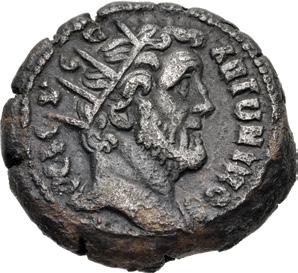


532. EGYPT, Alexandria. Antoninus Pius. AD 138-161. BI Tetradrachm (24.5mm, 11.96 g, 12h). Dated RY 23 (AD 159/60). ANT℧NINOC CЄB ЄVCЄB, radiate bust right, traces of drapery on left shoulder / Radiate and draped bust of Serapis-Pantheos right, wearing calathus and horn of Ammon; cornucopia over left shoulder, dolphin-entwined trident to right, L K Γ (date) across upper field. Köln 1847 var. (laur. bust left); Dattari 2380 var. (laur. bust right); K&G 35.819 var. (laur. bust left); RPC IV.4 2147 var. (laur. bust left); Emmett 1435.23 (R5). Dark gray patina, light roughness. VF. An unpublished variety of an already extremely rare type. ($500)
From the Dr. Thomas E. Beniak Collection, purchased from Holyland Numismatics, 8 January 2010.
Serapis was a syncretic god, a combination formed from Hellenistic Greek and Egyptian religious concepts. His name is of Egyptian origin and derives from a synthesis of Ausar (Greek, Osiris), the Egyptian god of the Underworld, and Hapi (Greek, Apis), a manifestation of the god Ptah. Under the Ptolemies, Serapis became the chief tutelary god and the subject of a royally-sponsored cult, whose emphasis on an afterlife made the worship of Serapis one of the more popular mystery cults. His immense popularity soon promoted his creation as Serapis-Pantheos, a hybrid deity incorporating other divine elements. In Alexandria, a large temple complex called the Serapeum was constructed that remained highly patronized well into the fourth century AD. Shortly after the imperial decree of AD 391, officially ordering pagan temples closed, the Serapeum was besieged, plundered, and destroyed.
147
Unpublished
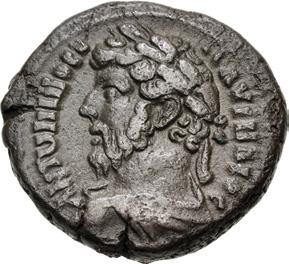

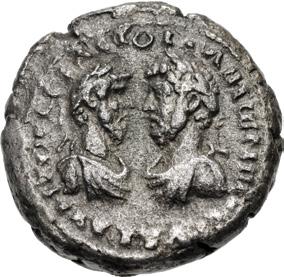

533. EGYPT, Alexandria. Marcus Aurelius. AD 161-180. BI Tetradrachm (24mm, 11.77 g, 12h). Dated RY 2 (AD 161/2).
Laureate, draped, and cuirassed bust left, seen from behind / Draped bust of Zeus-Ammon right, wearing ram’s horn, crown of solar disc and uraei; L B (date) across fields. Köln 1999 var. (obv. bust type & legend); Dattari (Savio) 3406 var. (obv. legend); K&G 37.124 var. (obv. legend); RPC IV.4 2311; Emmett 2090.2. Toned, short flan crack. Good VF. Rare. ($500)
From the Dr. Thomas E. Beniak Collection, purchased from Nilus Coins, 27 September 1997. Ex Lucius S. Ruder Collection (Coin Galleries, 19 August 1987), lot 367.
534. EGYPT, Alexandria. Marcus Aurelius & Lucius Verus. AD 161-169. BI Tetradrachm (23mm, 12.11 g, 12h). Dated RY 1 (AD 161/2). Laureate and draped busts of Lucius Verus and Marcus Aurelius, vis-à-vis / ЄIPHNH, Eirene seated left, holding patera, resting forearm on chair back; cornucopia at side; L A (date) across field. Köln –; Dattari (Savio) 9146; K&G 37.418; RPC IV.4 2269; Emmett 2041 (R3). Toned, roughness, trace deposits. VF. Rare. ($500)
From the Dr. Thomas E. Beniak Collection, purchased from Nilus Coins, 4 April 1997.


535. EGYPT, Alexandria. Lucius Verus. AD 161-169. BI Tetradrachm (24mm, 13.66 g, 12h). Dated RY 3 (AD 162/3). Laureate, draped, and cuirassed bust right, seen from behind / Marcus Aurelius and Lucius Verus, both togate, standing facing each other, clasping hands, the emperor on left (Marcus Aurelius?) holds a scroll; L Γ (date) across field. Köln –; Dattari (Savio) –; K&G –; RPC IV.4 2406; Emmett 2343.3 (R5). Toned, light porosity, deposits. VF. Very rare. ($500)
From the Dr. Thomas E. Beniak Collection, purchased from Nilus Coins, 2 September 2020. Ex Empire Coins 2 (30 September 1984), lot 137; The New Orleans Collection; Capers Collection.
RPC Plate Coin – Presently Unique
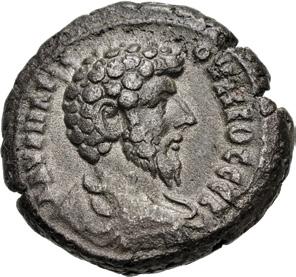
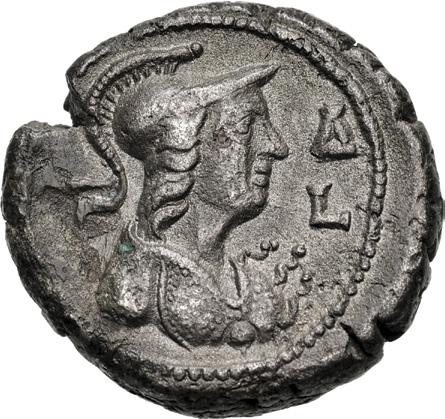
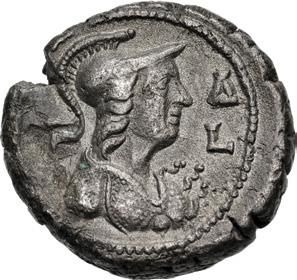
536. EGYPT, Alexandria. Lucius Verus. AD 161-169. BI Tetradrachm (24mm, 13.05 g, 11h). Dated RY 4 (AD 163/4). Bareheaded, draped, and cuirassed bust right, seen from behind / Helmeted bust of Athena right, wearing aegis; L Δ (date) to right. Köln –; Dattari (Savio) 9397 = K&G 39.64 = RPC IV.4 2594.1 = Figari & Mosconi 904 (this coin); Emmett 2332.4 (R5). Lightly toned, lamination flaw on reverse, edge chip. VF. Extremely rare and presently unique. ($500)
From the Dr. Thomas E. Beniak Collection. Ex Numismatic Fine Arts [XXIV] (18 October 1990), lot 2420; Auctiones AG 7 (7 June 1977), lot 456.
148
533 534
Four Known to RPC
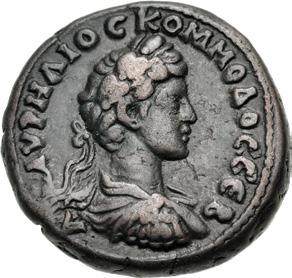
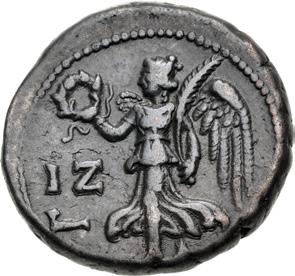
537. EGYPT, Alexandria. Commodus. AD 177-192. BI Tetradrachm (24mm, 13.55 g, 12h). Dated RY 17 of Marcus Aurelius (AD 177). Laureate, draped, and cuirassed bust right, seen from behind / Nike advancing left, holding wreath and palm frond; IZ/L (date) to left. Köln –; Dattari (Savio) –; K&G 14.10; RPC IV.4 3325.4 (this coin); Emmett 2487.17 (R5). Dark brown surfaces, minor marks and scratches. VF. Very rare first issue after Commodus’ elevation to Augustus. Only four known to RPC. ($500)
From the Dr. Thomas E. Beniak Collection. Ex Hermanubis Collection (Classical Numismatic Group 105, 10 May 2017), lot 606.
Unpublished for Year 24
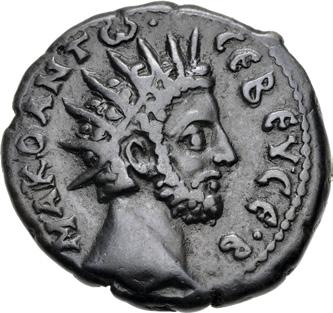

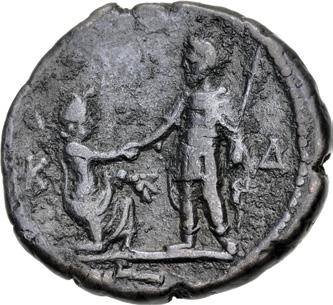
538. EGYPT, Alexandria. Commodus. AD 177-192. BI Tetradrachm (27.5mm, 12.93 g, 11h). Dated RY 24 (AD 183/4). M A KO ANTω CЄB ЄYCЄ B, radiate head right / Commodus, in military dress, standing left, holding scepter in right hand, raising Alexandria kneeling right, wearing elephant’s skin cap and holding grain ears: L/K Δ (date) across field. Cf. Emmett 2539 (RY 25 and 26, RY 24 unrecorded); otherwise, unpublished. Deeply toned, reverse deposits. VF. Spectacular radiate bust. Apparently unique. ($1000)
From the Dr. Thomas E. Beniak Collection, purchased from Nilus Coins, 19 April 2018. Ex New Orleans Collection.
Extremely Rare Crispina
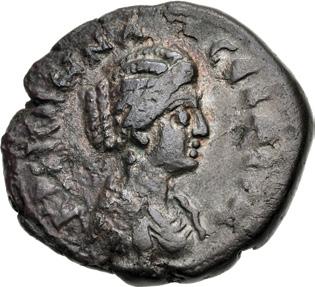

539. EGYPT, Alexandria. Crispina. Augusta, AD 178-182. BI Tetradrachm (26mm, 10.96 g, 12h). Dated RY 21 of Commodus (AD 180/1). Draped bust right / Tyche enthroned left, holding rudder in right hand and double cornucopia in left; wheel below throne; L KA (date) to upper left. Köln 2262; Dattari (Savio) 3974; K&G 42.8; RPC IV.4 3384; Emmett 2629.21. Toned with some iridescence, edge roughness, some silvering remains. Near VF. All of the coinage of Crispina from Alexandria is extremely rare. ($750)
From the Dr. Thomas E. Beniak Collection. Ex Philip DeVicci Collection (Triton IV, 5 December 2000), lot 371 (hammer $1300); Classical Numismatic Auctions IV (21 September 1988), lot 306; Empire Coins 3 (5 May 1985), lot 237.
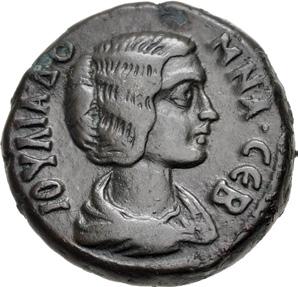
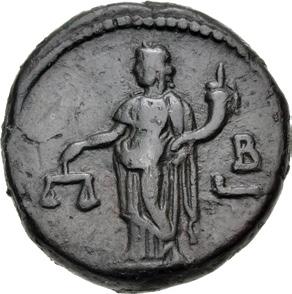
540. EGYPT, Alexandria. Julia Domna. Augusta, AD 193-217. BI Tetradrachm (24mm, 13.91 g, 12h). Dated RY 2 of Septimius Severus (AD 193/194). Draped bust right / Dikaiosyne standing left, holding scales and cornucopia; L B (date) to right. Köln –; Dattari (Savio) –; K&G –; Curtis 911 = Emmett 2728.2 (R5); CNG E-Sale 355, lot 400 (same obv. die). Dark brown patina, light porosity, reverse metal flaw. VF. Very rare. ($500)
From the Dr. Thomas E. Beniak Collection, purchased from Holyland Numismatics, 8 January 2010.
149

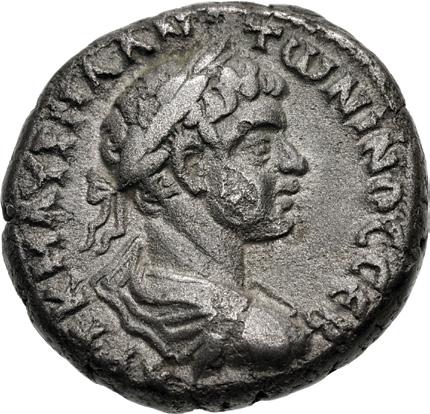
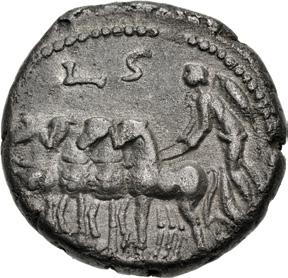
541. EGYPT, Alexandria. Caracalla. AD 198-217. BI Tetradrachm (23.5mm, 13.46 g, 12h). Dated RY 6 of Septimius Severus (AD 197/8). Laureate and draped bust right, seen from behind / Nike driving quadriga left; L ς (date) above. Köln –; Dattari (Savio) 9752 (this coin); K&G –; Emmett 2767.6 (R5). Toned, lamination flaw, some underlying luster. Good VF. Extremely rare, the second known. K&G do not record any coins of year 6. ($2000)
From the Dr. Thomas E. Beniak Collection. Ex Günther Schlüter Collection [Chairman of the German Numismatic Society from 1975-77] (Künker 347, 22 March 2021), lot 280, purchased from Rüdiger Kaiser, October 1976; Giovanni Dattari Collection.
The Second Known
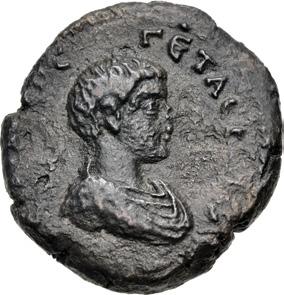
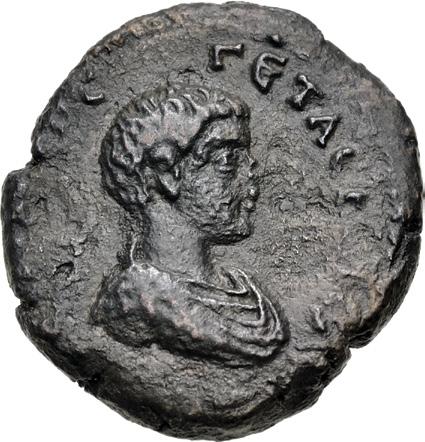
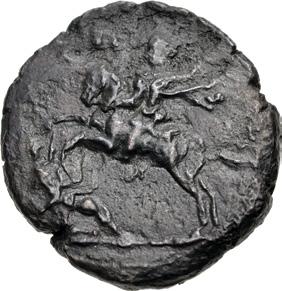
542. EGYPT, Alexandria. Geta. As Caesar, AD 198-209. BI Tetradrachm (23mm, 10.73 g, 12h). Dated RY 8 of Septimius Severus (AD 199/200). Bareheaded and draped bust right, seen from the front / Geta on horseback left, spearing fallen enemy; L H (date) in upper left field. Köln –; Dattari 4079 var. (date); K&G 53.2 var. (horse right); Sallet, Alexandrinische 6 = Emmett 2796.8 (R5). Toned, double strike on reverse, rough surfaces. Near VF. Extremely rare, the second known. ($1500)
From the Dr. Thomas E. Beniak Collection. Ex Classical Numismatic Group 78 (14 May 2008), lot 1515 (hammer $2450).
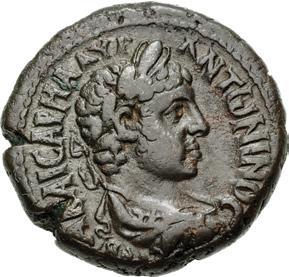

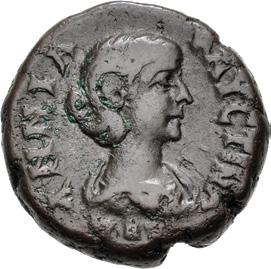

543. EGYPT, Alexandria. Elagabalus. AD 218-222. Potin Tetradrachm (23mm, 13.05 g, 12h). Dated RY 5 (AD 221/2). Laureate and draped bust right / Nilus reclining left, holding a cornucopia, from which emerges a genius, and a reed; to left, a Nilometer as an obelisk with two genii attendants; two additional genii by the reed; L Є (date) in exergue. Köln 2347; Dattari (Savio) 9821; K&G 56.65; RPC VI Online 10156; Emmett 2947.5. Dark brown patina. Good VF. Rare and popular type. ($500)
From the Dr. Thomas E. Beniak Collection, purchased from Nilus Coins, 27 September 1997.
The Nilometer, in this case a stone obelisk that measured the inundation of the Nile, was a prominent landmark in Egyptian culture. It was vital as a calendar to mark the passing of the seasons and for assessing the fertility of the land, which depended on the annual Nile flood. It occurs frequently in Egyptian art, surrounded by attendants and the fruits of the fertile river
544. EGYPT, Alexandria. Annia Faustina. Augusta, AD 221. Potin Tetradrachm (22mm, 12.70 g, 12h). Dated RY 5 of Elagabalus (AD 221). Draped bust right / Head of Zeus-Ammon right, wearing ram’s horn, crown of solar disc and uraei; L Є (date) across field. Köln –; Dattari (Savio) 4200; K&G 59.1; RPC VI Online 10197; Emmett 3042.5 (R5). Red-brown patina, light porosity. VF. Very rare. ($500)
From the Dr. Thomas E. Beniak Collection, purchased from Nilus Coins, 12 September 2009. Ex NFA French Collection.
150 Ex Dattari Collection
543
544
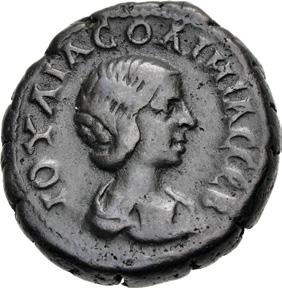

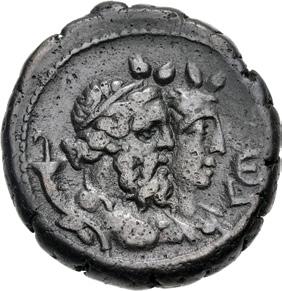
545. EGYPT, Alexandria. Julia Soaemias. Augusta, AD 218-222. Potin Tetradrachm (23mm, 12.94 g, 12h). Dated RY 5 of Elagabalus (AD 221). Draped bust right / Jugate busts of Serapis and Euthenia right; Nilus wearing taenia with lotus buds, cornucopia behind his shoulder, Euthenia wearing grain ears; L Є (date) to right. Köln –; Dattari (Savio) 4212 & 8933; K&G 60.15 (Serapis & Isis); RPC VI Online 10181.1 (this coin); Emmett 2999.5 (R5). Gray-brown patina, light porosity. VF. Extremely rare. ($500)
From the Dr. Thomas E. Beniak Collection. Ex Classical Numismatic Auctions VI (1 March 1989), lot 308; Virginia Ruzicka Collection (Malter XXVIII, 8 December 1984), lot 110.
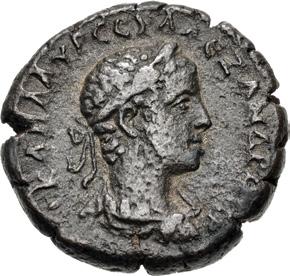
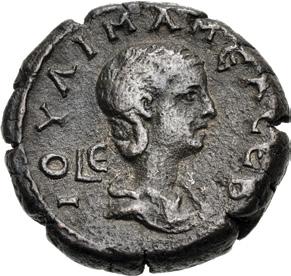
546. EGYPT, Alexandria. Severus Alexander, with Julia Mamaea. AD 222-235. Potin Tetradrachm (24mm, 12.83 g, 12h). Dated RY 5 (AD 225/6). Laureate, draped, and cuirassed bust of Severus Alexander right, seen from behind / Draped bust of Julia Mamaea right; L Є (date) to left. Köln 2433 var. (obv. legend, date spelled out); Dattari (Savio) 9847; K&G 62.71 var. (same); RPC VI Online 10301; Emmett 3113.5 (R5). Gray brown patina, roughness. Near VF. Extremely rare. ($500)
From the Dr. Thomas E. Beniak Collection. Ex Classical Numismatic Group 43 (24 September 1997), lot 1185.
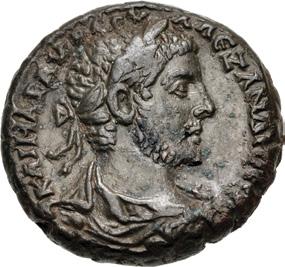
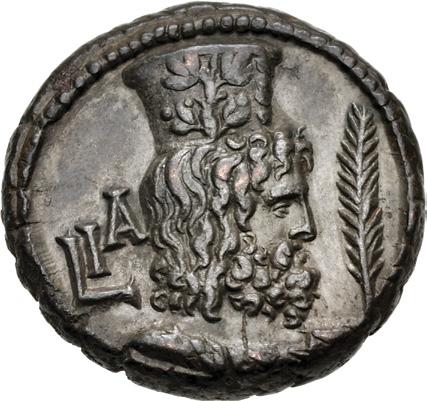
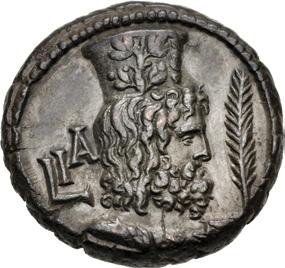
547. EGYPT, Alexandria. Severus Alexander. AD 222-235. Potin Tetradrachm (23mm, 12.28 g, 12h). Dated RY 11 (AD 231/2). Laureate, draped, and cuirassed bust right, seen from behind / Draped bust of Serapis right, wearing ornate calathus, palm frond to right; L IA (date) to left. Köln 2471; Dattari 4353 var. (date arrangement); K&G 62.165; RPC VI Online 10530; Emmett 3133.11. Dark gray patina. Good VF. ($500)
From the Dr. Thomas E. Beniak Collection. Ex London Coin Galleries 3 (10 November 2016), lot 266.
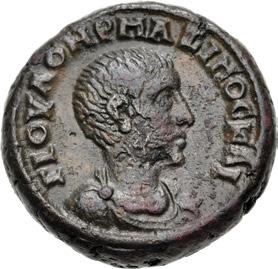

548. EGYPT, Alexandria. Maximus. Caesar, AD 235/6-238. Potin Tetradrachm (22.5mm, 13.28 g, 12h). Dated RY 3 of Maximinus I (AD 236/7). Bareheaded, draped, and cuirassed bust right, seen from the front / Jugate busts of Helios and Selene right; Helios is radiate and draped, Selene wears a taenia and chiton; L Γ (date) to left. Köln –; Dattari (Savio) 4624; K&G 67.15; RPC VI Online 10718; Emmett 3317.3 (R4). Red-brown patina, light roughness. VF. Very rare. ($500)
From the Dr. Thomas E. Beniak Collection. Ex Pegasi XXIX (5 November 2013), lot 363.
151 Published in RPC
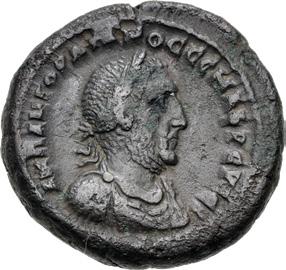
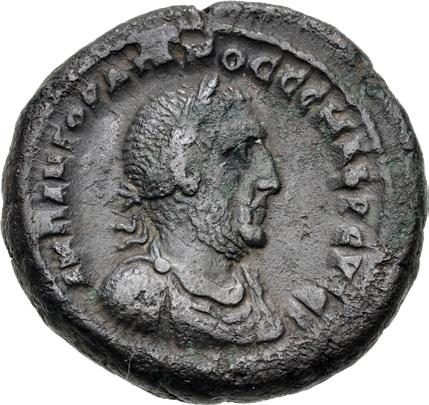
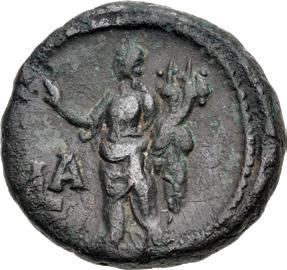
549. EGYPT, Alexandria. Gordian I. AD 238. Potin Tetradrachm (23mm, 12.69 g, 11h). Dated RY 1 (AD 238). Laureate, draped, and cuirassed bust right, seen from the front / Homonoia standing facing, head left, raising hand and holding double cornucopia; L A (date) to lower left. Köln 2601; Dattari (Savio) 4657; K&G 68.7; RPC VII.2.19 (this coin); Emmett 3344.1 (R3). Brown and green patina, some roughness. Near VF. ($750)
From the Dr. Thomas E. Beniak Collection. Ex Roma IV (30 September 2012), lot 742.
A Look at the Rarity of Gordian II Alexandrian Tetradrachms



550. EGYPT, Alexandria. Gordian II. AD 238. Potin Tetradrachm (22mm, 12.52 g, 11h). Dated RY 1 (AD 238). Laureate, draped, and cuirassed bust right, seen from behind / Zeus seated left, holding patera in right hand, long scepter in left; at feet left, eagle standing left, head right; L A (date) in upper left field. Köln –; Dattari (Savio) 4669; K&G 69.8; RPC VII.2 3649.3 (this coin); Emmett 3360.1. Dark brown patina, light porosity, small scratch on reverse. VF. Extremely rare. ($1500)
From the Dr. Thomas E. Beniak Collection. Ex Kerry K. Wetterstrom Collection (Classical Numismatic Auctions IV, 21 September 1988), lot 316.
A note from the consignor: Most collectors of Roman coinage do not start with Roman Egypt. They are more likely to begin with Roman Imperial coinage, especially denarii. Upon delving into the coinage of Alexandria, in particular billon tetradrachms, one soon becomes aware of significant differences in the relative rarity of rulers. These differences can even extend to very closely related issues. Such is the case of the joint (father and son) emperors of 238 A.D. Gordian I and II.
The Gordians have the dubious distinction of being the most ephemeral Roman Emperors in history, their royal tenure lasting a mere 22 days. Despite this brevity, they managed to produce a surprisingly complete imperial coinage (denarii and sestertii) though less complete Alexandrian (billon tetradrachms but no bronze issues).
While all coinage of the Gordians is scarce, an unexpected discrepancy exists. The imperial issues of the Gordians tend to be of comparable rarity. This equivalence is in no way replicated in the billon tetradrachms for reasons unknown. In building my collection, I had the good fortune of obtaining the present specimen in 1988 (CNA IV sale). Try as I might, it was not until nearly thirty years later that I acquired my second and last Gordian II. Over the same time span, I acquired eleven Gordian I tetradrachms.
A brief statistical summary supports my collecting experience. Review of the past twenty years of CoinArchives lists less than ten specimens with perhaps eight times as many Gordian I coins. Finally, a survey of the major published Alexandrian collections shows the following:
Gordian I Gordian II
Dattari 9 4
Demetrio 1 0
BMC 8 2
Milne 8 0
Köln 8 0
Curtis 8 0
TOTAL 42 6
These numbers are similar to the ratio found in RPC where Gordian I has 216 specimens compared to Gordian II’s 38.
152


551. EGYPT, Alexandria. Balbinus. AD 238. Potin Tetradrachm (23mm, 11.78 g, 11h). Dated RY 1 (AD 238). Laureate, draped, and cuirassed bust right / Athena standing facing, head left, holding spear and resting hand set on grounded shield; L A (date) across field. Köln 2609; Dattari (Savio) 4680; K&G 70.3; RPC VII.2 3670; Emmett 3371.1 corr. (Athena holding Nike, spear, and shield). Red-brown patina, peripheral roughness on the reverse. VF. Rare. ($500)
From the Dr. Thomas E. Beniak Collection. Ex Classical Numismatic Group 47 (16 September 1998), lot 1027.
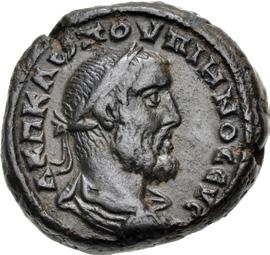
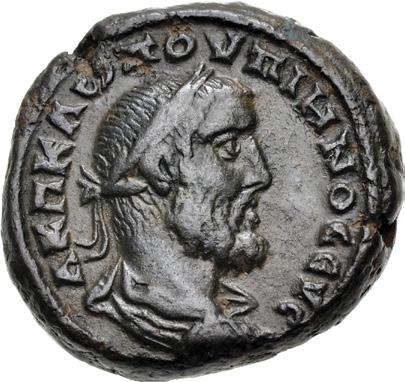

552. EGYPT, Alexandria. Pupienus. AD 238. Potin Tetradrachm (22mm, 11.99 g, 11h). Dated RY 1 (AD 238). Laureate, draped, and cuirassed bust right, seen from behind / Nilus reclining left, holding cornucopia and reed; L A (date) to left. Köln –; Dattari (Savio) 4674 var. (obv. legend); K&G –; RPC VII.2 3662.6 (this coin); Emmett 3367.1 corr. (reclining on hippopotamus - R5). Red-brown patina, light earthen deposits. VF. Very rare. ($750)
From the Dr. Thomas E. Beniak Collection. Ex CNG inventory 936428 (November 2012); Roma IV (30 September 2012), lot 746.
RPC Plate Coin – Presently Unique
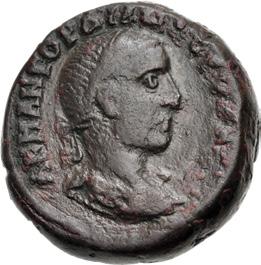
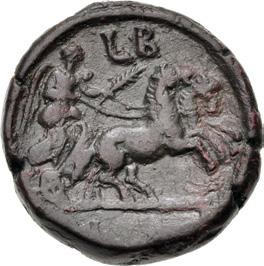
553. EGYPT, Alexandria. Gordian III. AD 238-244. Potin Tetradrachm (22mm, 12.11 g, 12h). Dated RY 2 (AD 238/9). Laureate, draped, and cuirassed bust right, seen from behind / Nike driving biga right, holding reins and palm frond; L B (date) above. Köln –; Dattari (Savio) –; K&G –; RPC VII.2 3723.1 (this coin); Emmett 3417.2 (R5). Red-brown patina, some roughness, cleaning marks. Near VF. Extremely rare, presently unique. ($500)
From the Dr. Thomas E. Beniak Collection, purchased from Nilus Coins, 28 April 2001. Ex Bill Kalmbach Collection.

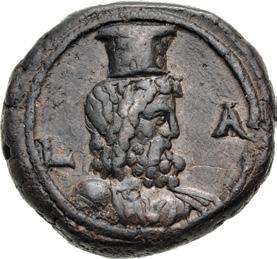


554. EGYPT, Alexandria. Philip I. AD 244-249. Potin Tetradrachm (23mm, 12.99 g, 12h). Dated RY 1 (AD 244). Laureate and cuirassed bust right, seen from the front, cuirass decorated with gorgoneion / Draped bust of Serapis right, wearing ornate calathus; L A (date) across field. Köln –; Dattari (Savio) 4907; K&G 74.11; RPC VIII Online 2981; Emmett 3505.1 (R5). Brown patina, reverse graffito. VF. Extremely rare, only three known to RPC. ($500)
From the Dr. Thomas E. Beniak Collection. Ex CNG inventory 819367 (September 2008).
555. EGYPT, Alexandria. Philip I. AD 244-249. Potin Tetradrachm (23mm, 11.82 g, 12h). Dated RY 4 (AD 246/7). Laureate, draped, and cuirassed bust right, seen from behind / Radiate bust of Serapis-Pantheos right, wearing calathus and horn of Ammon, slight drapery on left shoulder; dolphin-entwined trident over left shoulder, cornucopia to right, L Δ (date) across upper field. Köln 2732 var. (legend); Dattari (Savio) 4916; K&G 72.73; RPC VIII Online 2808; Emmett 3505.4. Dark brown patina. Good VF. ($500)
From the Dr. Thomas E. Beniak Collection. Ex Classical Numismatic Group XXI (26 June 1992), lot 523.
153
554
555

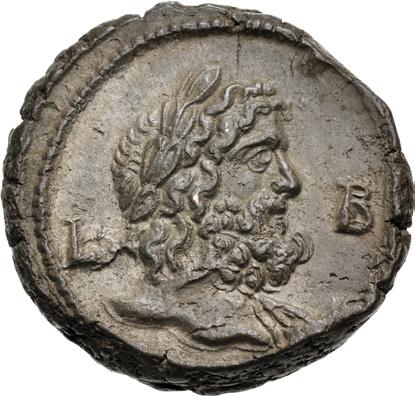
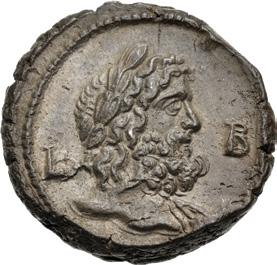
556. EGYPT, Alexandria. Otacilia Severa. Augusta, AD 244-249. Potin Tetradrachm (23mm, 11.53 g, 11h). Dated RY 2 of Philip I (AD 244/5). Draped bust right, wearing stephane / Laureate bust of Zeus right, draped left shoulder; L B (date) across field. Köln –; Dattari (Savio) 5005; K&G 75.21; RPC VIII Online 3195 (this coin cited); Emmett 3570.2 (R5). Gray patina, minor marks, some silvering remains. Near EF. Extremely rare and among the finest known examples. ($500)
From the Dr. Thomas E. Beniak Collection. Ex VAuctions 321/London Coin Galleries 3 (10 November 2016), lot 278.
The Finest Known

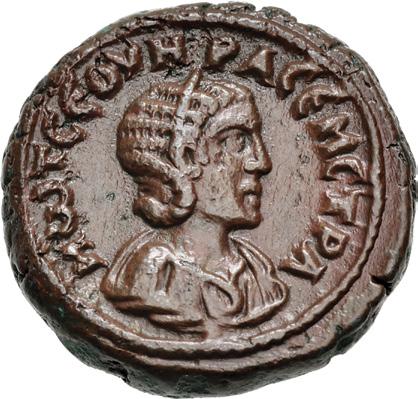

557. EGYPT, Alexandria. Otacilia Severa. Augusta, AD 244-249. Potin Tetradrachm (23mm, 12.45 g, 11h). Dated RY 2 of Philip I (AD 244/5). Draped bust right, wearing stephane / Bust of Zeus-Ammon right, wearing ram’s horn, crown of solar disc and uraei, drapery on left shoulder; L B (date) across field. Köln –; Dattari (Savio) 10437; K&G –; RPC VIII Online 2647 (this coin cited); Emmett 3571.2 (R5). Red-brown patina, minor marks. Near EF. Extremely rare and finest known example. ($500)
From the Dr. Thomas E. Beniak Collection. Ex Künker 89 (8 March 2004), lot 1825.
Two Ex Dattari Tetradrachms
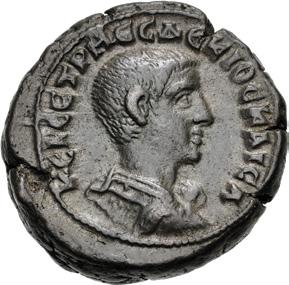

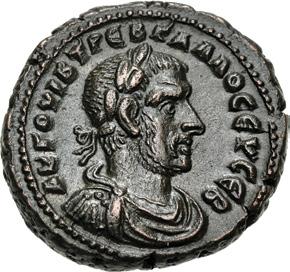

558. EGYPT, Alexandria. Herennius Etruscus. As Caesar, AD 249-251. Potin Tetradrachm (23.5mm, 12.76 g, 12h). Dated RY 2 of Trajan Decius (AD 250/1). Bareheaded, draped, and cuirassed bust right, seen from behind / Decius galloping right, spearing fallen enemy below; L B (date) to left. Köln –; Dattari (Savio) 10505 = RPC IX 2290.3 (this coin); K&G 81.4 var. (obv. legend); Emmett 3655.2 (R5). Brown patina. Good VF. Extremely rare. ($500)
From the Dr. Thomas E. Beniak Collection. Ex Peus 360 (27 April 1999), lot 727; Giovanni Dattari Collection, no. 10505.
559. EGYPT, Alexandria. Trebonianus Gallus. AD 251-253. Potin Tetradrachm (23mm, 10.77 g, 12h). Dated RY 3 (AD 252/3). Laureate, draped and cuirassed bust right, seen from the front / Dikaiosyne seated left, holding scales in right hand, cornucopia in left; L Γ (date) across field. Köln 2835; Dattari (Savio) 5113 = RPC IX 2300.14 (this coin); K&G 83.5 Emmett 3666.3. Red-brown patina, reverse slightly off center. EF. ($500)
From the Dr. Thomas E. Beniak Collection, purchased from Dr. Martina Dieterle, 4 September 2019. Ex Giovanni Dattari Collection.
154
Coin
RPC Plate
558
559
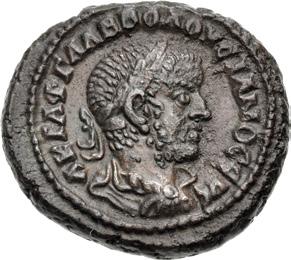
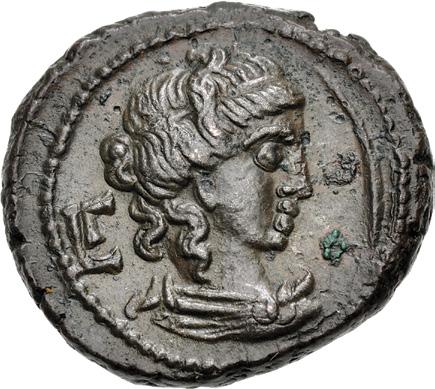

560. EGYPT, Alexandria. Volusian. AD 251-253. Potin Tetradrachm (24mm, 10.74 g, 12h). Dated RY 3 of Trebonianus Gallus (AD 252/3). Laureate, draped, and cuirassed bust right, seen from behind / Draped bust of Selene right, wearing taenia, crescent moon before; L Γ (date) to left. Köln 2843-4; Dattari (Savio) 5131; K&G 84.10; RPC IX 2323.12 (this coin); Emmett 3689.3. Brown patina, minor deposits. Near EF. ($500)
From the Dr. Thomas E. Beniak Collection. Ex Classical Numismatic Group 41 (19 March 1997), lot 1324; Malter 1 (9 November 1973), lot 310.


561. EGYPT, Alexandria. Aemilian. AD 253. Potin Tetradrachm (23mm, 9.95 g, 12h). Dated RY 2 (AD 253). Laureate and cuirassed bust right, seen from the front / Homonoia standing left, raising right hand, holding double cornucopia in left; L B (date) across field. Köln –; Dattari (Savio) 5136; K&G 85.5; RPC IX 2330.3 (this coin); Emmett 3685.2 (R4). Dark brown patina, slight roughness. Good VF. Extremely rare. ($500)
From the Dr. Thomas E. Beniak Collection. Ex Gordon J. Dickie Collection (Empire Coins 7, 2 May 1987), lot 228; Numismatic Fine Arts VI (27 February 1979), lot 865.
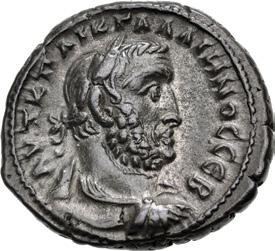
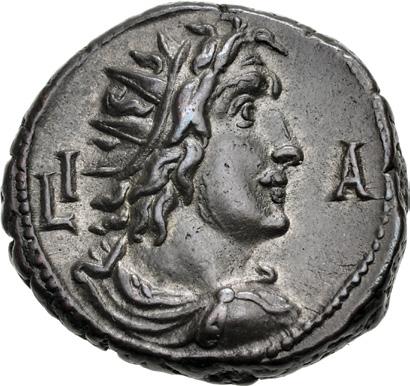

562. EGYPT, Alexandria. Gallienus. AD 253-268. Potin Tetradrachm (23mm, 9.09 g, 11h). Dated RY 11 (AD 263/4). Laureate, draped, and cuirassed bust right, seen from behind / Radiate and draped bust of Helios right; L IA (date) across field. Köln 2917; Dattari (Savio) 5238; K&G 90.71; RPC X Online 75489; Emmett 3813.11. Dark gray patina, silvering remains. Near EF. ($500)
From the Dr. Thomas E. Beniak Collection. Ex Jonathan K. Kern Collection. Ex Dattari Collection
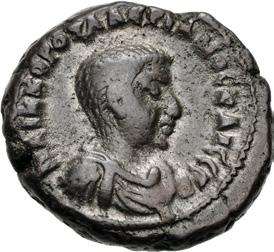
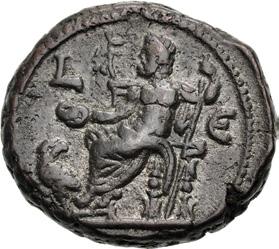
563. EGYPT, Alexandria. Valerian II. Caesar, AD 256-258. Potin Tetradrachm (23mm, 11.81 g, 11h). Dated RY 5 of Valerian I and Gallienus (AD 257/8). Bareheaded, draped, and cuirassed bust right, seen from the front / Zeus enthroned left, holding patera and long scepter; at feet left, eagle standing left, head right; L Є (date) across field. Köln –; Dattari (Savio) 5372 (Saloninus) = K&G 92.13 = RPC X 76773 (this coin cited); Emmett 3773.5 (R5). Gray patina, some silvering remains. VF. Extremely rare, only two known to RPC including this coin. ($500)
From the Dr. Thomas E. Beniak Collection, purchased from Edward J. Waddell, 10 December 2010. Ex Künker 174 (27 September 2010), lot 958; Giovanni Dattari Collection, no. 5372.
155


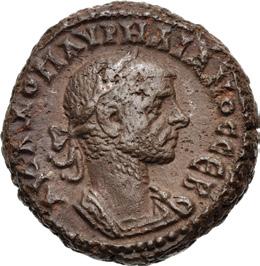
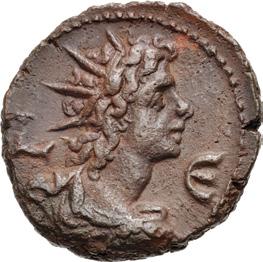


564. EGYPT, Alexandria. Quintillus. AD 270. Potin Tetradrachm (20mm, 8.56 g, 12h). Dated RY 1 (AD 270). Laureate, draped, and cuirassed bust right, seen from the front / Eagle standing right, head left, wings closed, holding wreath in beak; L A (date) across field. Köln 3049; Dattari (Savio) 5419; K&G 105.1; RPC X Online 75638; Emmett 3907.1. Red-brown patina. EF. Exceptional. ($500)
From the Dr. Thomas E. Beniak Collection. Ex Coin Galleries (13 November 1985), lot 220.
Extremely Rare
565. EGYPT, Alexandria. Aurelian. AD 270-275. Potin Tetradrachm (21mm, 10.60 g, 11h). Dated RY 5 (AD 273/4). Laureate and cuirassed bust right, seen from the front / Radiate and draped bust of Helios right; L Є (date) across field. Köln –; Dattari (Savio) –; K&G –; RPC X Online 75730; Emmett –. Brown patina, light roughness, minor red deposits. VF. Extremely rare. Only the third known and the only one not in a public collection (the others are in the ANA and Athens). ($500)
From the Dr. Thomas E. Beniak Collection, purchased from Moneta, 17 March 2013.
566. EGYPT, Alexandria. Vabalathus. Usurper, AD 268-272. Potin Tetradrachm (20mm, 9.31 g, 11h). Dated RY 5 (March - June AD 272). Laureate, draped, and cuirassed bust right, seen from behind / Homonoia standing facing, head left, raising her right hand and holding a double cornucopia with her left; L Є (date) to left. Bland, Coinage 52; Köln 3064 var. (date arrangement); Dattari (Savio) 10610; K&G 109.2; RPC X Online 75757; Emmett 3910.5. Red-brown patina, light roughness. Good VF. ($500)
From the Dr. Thomas E. Beniak Collection, purchased from Nilus Coins.
The Second Known
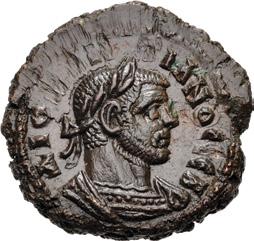
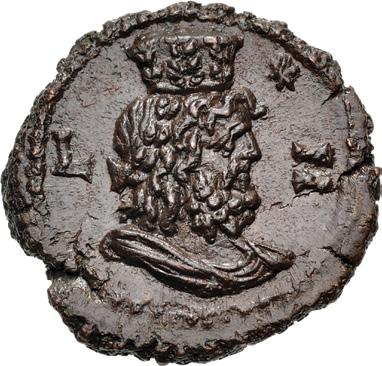
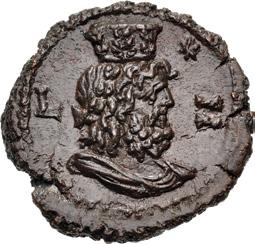
567. EGYPT, Alexandria. Diocletian. AD 284-305. Potin Tetradrachm (21mm, 7.00 g, 1h). Dated RY 7 (AD 290/1). Laureate and cuirassed bust right, seen from the front / Draped bust of Serapis right, wearing ornate calathus, star in upper right field; L Z (date) across field. Köln –; Dattari (Savio) –; K&G –; RPC X Online 76085 corr. (star not described); Emmett 4074.7 (R5). Red-brown patina, area of weakness, edge chip. Near EF. Extremely rare, only the ANS specimen known to RPC, this the second known. ($1000)
From the Dr. Thomas E. Beniak Collection, purchased from Holyland Numismatics, 7 January 2011.
Rare Depiction of Herakles with Cerberus
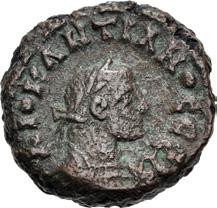
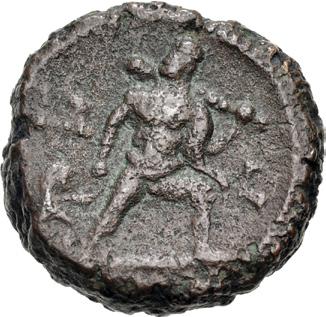
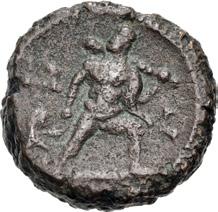
568. EGYPT, Alexandria. Diocletian. AD 284-305. Potin Tetradrachm (18mm, 7.17 g, 12h). Dated RY 11 (AD 294/5). Laureate and cuirassed bust right, seen from the front / Herakles advancing right, head left, holding club over his left shoulder and pulling Cerberus by his leash to his left; IA L (date) across field. Köln –; Dattari (Savio) –; K&G –; RPC X Online 88936; Emmett 4058.11 (R5). Red-brown patina with green, porosity. Near VF. Extremely rare, only the third known. ($500)
From the Dr. Thomas E. Beniak Collection, purchased from Ancient Imports, 8 May 2014.
156
564 565 566
The Second Known

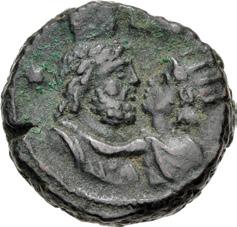
569. EGYPT, Alexandria. Maximianus. First reign, AD 286-305. Potin Tetradrachm (19mm, 8.41 g, 12h). Dated RY 2 (AD 286/7). Laureate, draped, and cuirassed bust right, seen from behind / Draped bust of Serapis right, wearing ornate calathus vis-à-vis radiate and draped bust of Helios left, to left, star; L B (date) above. Köln –; Dattari (Savio) 5983; K&G 120.21; RPC X Online 75982; Emmett 4156.2 (R5). Earthen green patina. VF. Extremely rare, the second known, only the Dattari coin listed in RPC, none in CoinArchives. ($750)
From the Dr. Thomas E. Beniak Collection, purchased from Frank Kovacs. Reportedly ex Henry Clay Lindgren Collection.
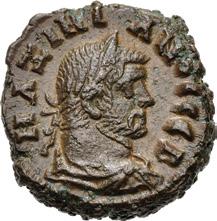
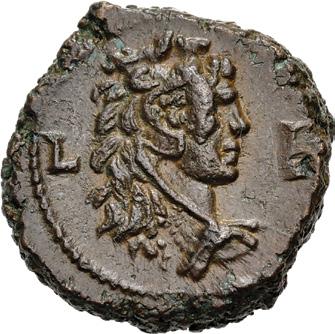
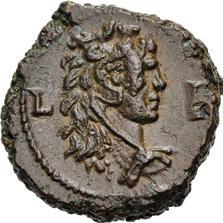
570. EGYPT, Alexandria. Maximianus. First reign, AD 286-305. Potin Tetradrachm (18mm, 7.52 g, 12h). Dated RY 10 (AD 294/5). Laureate, draped, and cuirassed bust right, seen from behind / Draped bust of Herakles right, wearing lion’s skin headdress; L I (date) across field. Köln 3337; Dattari (Savio) 5900; K&G 120.98; RPC X Online 76189; Emmett 4129.10 (R5). Red-brown patina. Near EF. Rare. Only this coin and the Dattari specimen in CoinArchives. ($750)
From the Dr. Thomas E. Beniak Collection, purchased from Beast Coins, 17 June 2009. Ex Keith Emmett Collection; Classical Numismatic Group 43 (24 September 1997), lot 1198.
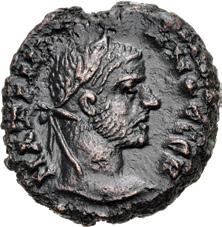
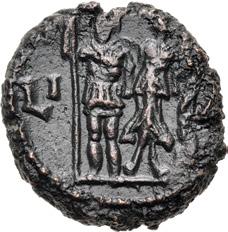
571. EGYPT, Alexandria. Maximianus. First reign, AD 286-305. Potin Tetradrachm (18mm, 7.30 g, 12h). Dated RY 11 (AD 295/6). Laureate head right / Maximianus standing facing, head right, holding spear; on right, Nike standing left, crowning him with wreath and holding palm frond; L I A (date) across field. Köln –; Dattari (Savio) 5830; K&G 120.134; RPC X Online 76220; Emmett 4120.11 (R5). Brown patina, peripheral roughness. Good VF. Rare. ($500)
From the Dr. Thomas E. Beniak Collection, purchased from Holyland Numismatics, 24 April 2008.
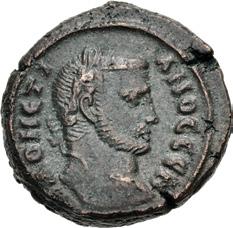


572. EGYPT, Alexandria. Domitius Domitianus. Usurper, AD 297-298. Potin Tetradrachm(?) (19mm, 8.31 g, 11h). Dated RY 2 (AD 297/8). Laureate head right / Nike advancing right, holding wreath in her extended right hand and palm frond over her left shoulder with her left hand; L B (date) across field. Köln 3368; Dattari (Savio) 6183; K&G 126.7; RPC X Online 76415; Emmett 4244.2. Red-brown patina. Good VF. ($1500)
From the Dr. Thomas E. Beniak Collection. Ex Peus 409 (25 April 2013), lot 1141.
The revolt of Domitius Domitianus in Egypt destabilized a vitally strategic region by interrupting the grain supply to Rome and opening the possibility of a Sasanian invasion. For almost a year, Domitius Domitianus controlled Alexandria and its mint, striking aurei and folles, as well as a series of pre-reform provincial denominations. Diocletian regained control of Alexandria in March, 298 and ended the long tradition of provincial coinage. From this point forward, only imperial denominations were struck at Alexandria until the fall of the Roman empire.
157

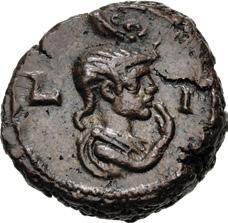
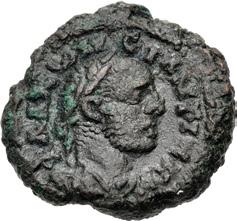
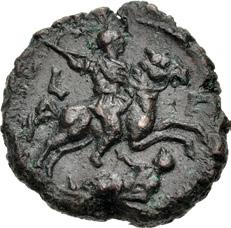
573. EGYPT, Alexandria. Constantius I. As Caesar, AD 293-305. Potin Tetradrachm (19mm, 7.93 g, 12h). Dated RY 3 (AD 294/5). Laureate, draped, and cuirassed bust right, seen from the front / Draped bust of Harpocrates right, with right hand raised to mouth; L Γ (date) across field. Köln –; Dattari (Savio) 6065; K&G 121.22; RPC X Online 76179; Emmett 4189.3 (R5). Red-brown patina, flan crack. Good VF. Extremely rare. ($500)
From the Dr. Thomas E. Beniak Collection, purchased from Holyland Numismatics, 5 January 2012.
Ex Emmett Collection
574. EGYPT, Alexandria. Constantius I. As Caesar, AD 293-305. Potin Tetradrachm (19.5mm, 6.11 g, 11h). Dated RY 3 (AD 294/5). Laureate, draped, and cuirassed bust right, seen from the front / Constantius galloping right, spearing fallen enemy below; L Γ (date) in across field. Köln –; Dattari (Savio) –; K&G –; RPC X Online 76110.3 (this coin); Emmett 4187.3 (R5). Brown patina, light roughness, spots of verdigris, edge roughness, edge chip. VF. Extremely rare, three known to RPC. ($500)
From the Dr. Thomas E. Beniak Collection, purchased from Beast Coins, 17 June 2009. Ex Keith Emmett Collection, purchased from 7-Seas (July 1982).
Ex Wetterstrom Collection
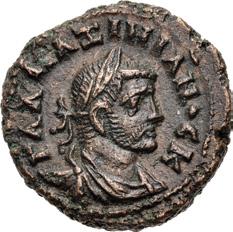
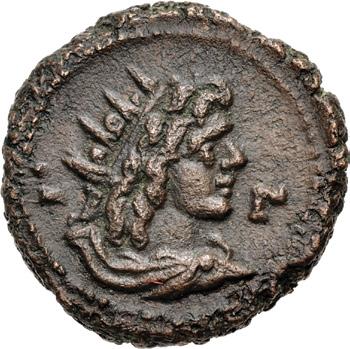

575. EGYPT, Alexandria. Galerius. As Caesar, AD 293-305. Potin Tetradrachm (19mm, 7.29 g, 12h). Dated RY 3 (AD 294/5). Laureate, draped, and cuirassed bust right, seen from the front / Radiate and draped bust of Helios right; L Γ (date) across field. Köln –; Dattari (Savio) 6134; K&G 122.24; RPC X Online 76120; Emmett 4224.3 (R3). Red-brown surfaces. Good VF. Rare. ($500)
From the Dr. Thomas E. Beniak Collection. Ex Kerry K. Wetterstrom Collection (Classical Numismatic Auctions IV, 21 September 1988), lot 354.
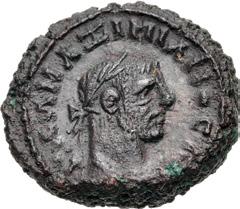


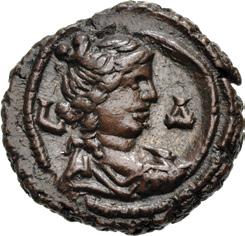
576. EGYPT, Alexandria. Galerius. As Caesar, AD 293-305. Potin Tetradrachm (20mm, 7.23 g, 12h). Dated RY 3 (AD 294/5). Laureate and cuirassed bust right, seen from the front / Bust of Zeus right, wearing taenia, drapery on left shoulder; L Γ (date) across field. Köln –; Dattari (Savio) –; K&G –; RPC X Online 76117; Emmett 4240.3 (R5). Brown patina, light roughness, cleaning scratches. Good VF. Extremely rare. ($500)
From the Dr. Thomas E. Beniak Collection, purchased from Holyland Numismatics, 5 January 2012.
577. EGYPT, Alexandria. Galerius. As Caesar, AD 293-305. Potin Tetradrachm (20mm, 6.51 g, 12h). Dated RY 4 (AD 295/6). Laureate, draped, and cuirassed bust right, seen from the front / Draped bust of Selene right, wearing taenia, crescent moon before; L Δ (date) across field. Köln 3366; Dattari (Savio) 6160; K&G 122.61; RPC X Online 76354; Emmett 4237.4 (R5). Red-brown patina. Near EF. Very rare. ($500)
From the Dr. Thomas E. Beniak Collection. Ex Classical Numismatic Auctions X (21 March 1990), lot 413.
158
573
574
576
577
ROMAN REPUBLICAN COINAGE
Ex Haeberlin Collection – Pedigreed to 1933


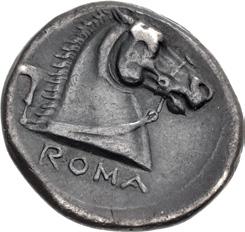
578. Anonymous. Circa 240 BC. AR Didrachm (18.5mm, 6.50 g, 8h). Sickle series. Rome mint. Head of Mars right, wearing crested Corinthian helmet decorated with a griffin / Head of horse right, wearing bridle, bit, and reins; sickle to left. Crawford 25/1; Sydenham 24; RSC 34; RBW 38. Deeply toned, minor marks, edge marks. VF. ($1000)
From the Wild Rose Collection. Ex Bertolami Fine Arts 24 (22 June 2016), lot 342; Ernst Justus Haeberlin Collection (Cahn 84, with A. Hess, 17 July 1933), lot 33.
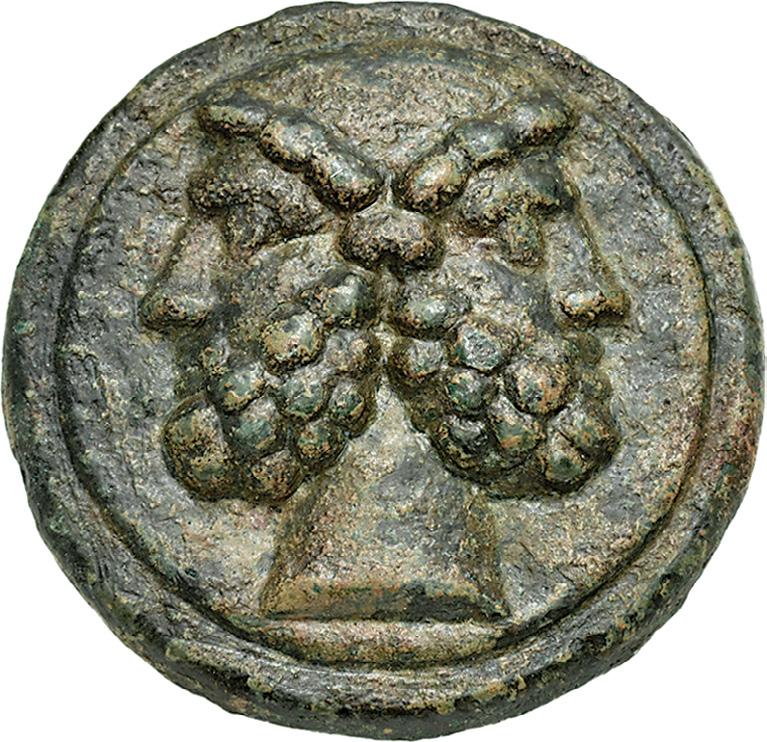

579. Anonymous. Circa 225-217 BC. Æ Aes Grave As (62mm, 272.48 g, 12h). Rome mint. Head of bearded Janus; no mark of value; all on a raised disk / Prow of galley right; i (mark of value) above; all on a raised disk. Crawford 35/1; ICC 75; Sydenham 72; HN Italy 337; RBW 84–5. Natural green patina with red and brown deposits. Good VF. ($1500)
From the Wild Rose Collection, purchased from Shanna Schmidt, November 2018. Ex Künker 312 (8 October 2018), lot 2624 (hammer €3000).


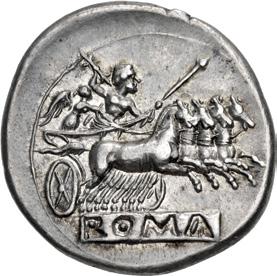
580. Anonymous. Circa 225-212 BC. AR Didrachm – Quadrigatus (23mm, 6.67 g, 9h). Rome mint. Laureate head of Janus, two small annulets at top of head, curved truncation / Jupiter, hurling thunderbolt and holding scepter, in galloping quadriga driven right by Victory; rOÂa incuse on raised tablet in exergue. Crawford 28/3; Sydenham 64; HN Italy 334; RSC 23; RBW 63. Lightly toned with iridescence, minor scratches, traces of find patina. Near EF. ($1000)
159

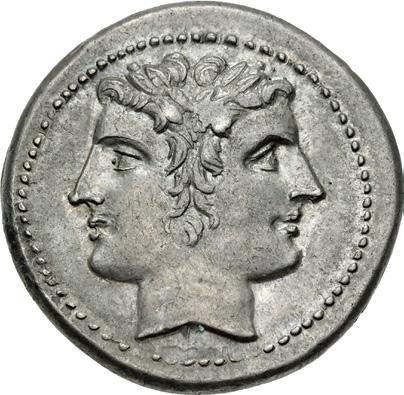
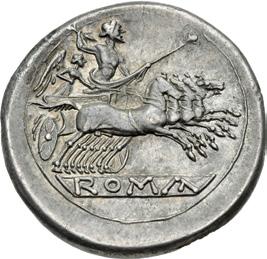
581. Anonymous. Circa 225-212 BC. AR Didrachm – Quadrigatus (21.5mm, 6.48 g, 5h). Uncertain mint. Laureate head of Janus, with indented truncation / Jupiter, hurling thunderbolt and holding scepter, in galloping quadriga driven right by Victory; rOÂa incuse on raised tablet in exergue. Crawford 29/3; Sydenham 64d; HN Italy 334; RSC 23/24; RBW 75–6. Lightly toned, minor flan crack, minor marks. EF. ($1500)
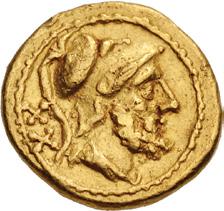

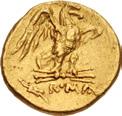
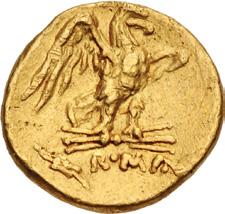
582. Anonymous. 211-210 BC. AV 20 Asses (10mm, 1.11 g, 12h). Grain ear (third) series. Uncertain mint in Sicily. Bearded head of Mars right, wearing crested Corinthian helmet; xx (mark of value) to left / Eagle standing right on thunderbolt, with wings spread; grain ear and rOÂa below. Crawford 72/2; Sydenham 234; Bahrfeldt 6b; Biaggi –; RBW 303-4. Light scrapes, patch of obverse roughness. Good VF. Rare. ($3000)
From the Wild Rose Collection. Ex Roma VII (22 March 2014), lot 924.
Ex McCabe Collection
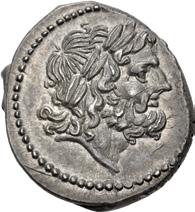
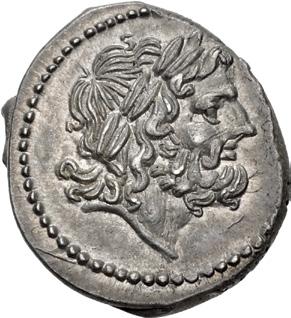

583. Anonymous. 211-210 BC. AR Victoriatus (16mm, 3.23 g, 7h). Luceria L-T series. Luceria mint. Laureate head of Jupiter right / Victory standing right, placing wreath on trophy; T between. Crawford 98A/1b; Sydenham 137; RSC 36g; RBW 429. Lightly toned with underlying luster. Superb EF. ($500)
From the Wild Rose Collection. Ex Andrew McCabe Collection (Classical Numismatic Group Electronic Auction 443, 1 May 2019), lot 443; Classical Numismatic Review XLII.1 (Winter 2017), no. 439941.
A note from Andrew McCabe: “In my article “The Roman Bronze Coinage struck in Apulia and South East Italy in the Second Punic War,” in Proceedings XV International Numismatic Congress Taormina 2015, I address the location of the mint with marks L-T in the context of the bronze coinage, but the conclusions also apply to the silver. I concluded that the L-T and related coinage with L mintmark was a consequence of “The relocation of Quintus Fabius Maximus filius from Luceria to a semi-permanent camp near Herdonia, and subsequent activities in the area from 214 onwards.” In my earlier work on anonymous bronzes in Essays Hersh, I observed unmistakeable links between the silver and post-semilibral weight coinage in Luceria. These most likely imply that this Victoriatus issue with LT, and likely the quinarii and sestertii of RRC 98 too, relate to the activities of Quintus Fabius Maximus filius in the central Apulia area (Herdonia) in the 214-212 BC period, and not as previously understood to a post 212 BC issue from Luceria itself.”
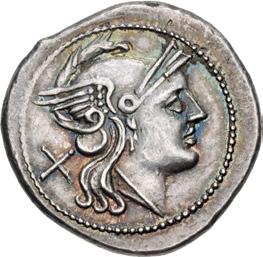
584
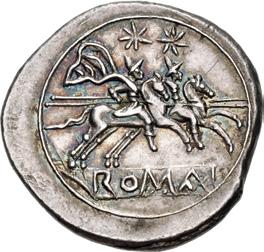
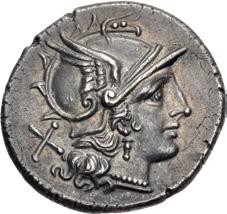
585

584. Anonymous. After 211 BC. AR Denarius (21.5mm, 4.81 g, 9h). Unmarked series. Rome mint. Helmeted head of Roma right; x (mark of value) to left / The Dioscuri, each holding spear, on horseback riding right; rOÂA in linear frame in exergue. Crawford 53/2; Sydenham 311; RSC –; RBW 192–3. Iridescent tone, minor marks. EF. ($500)
From the Wild Rose Collection. Ex Dr. Nicolas Lowe Collection (Roma XVIII, 29 September 2019), lot 796; Asta de Titano 12 (22 September 2002), lot 76.
585. Anonymous. 207 BC. AR Denarius (18.5mm, 3.87 g, 8h). Crescent (first) series. Rome mint. Helmeted head of Roma right; x (mark of value) to left / The Dioscuri, each holding spear, on horseback riding right; crescent above. Crawford 57/2; Sydenham 265; RSC 20i; RBW 218. Toned with light iridescence, surface cracks. EF. ($500)
From the Wild Rose Collection, purchased from Numismatica Ars Classica, September 2018. Ex Volteia Collection (CNG inventory 422079, January 2016).
160
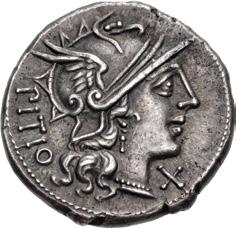
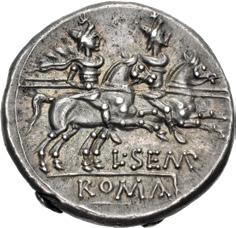
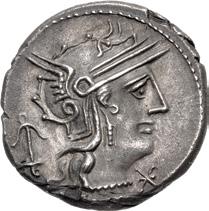
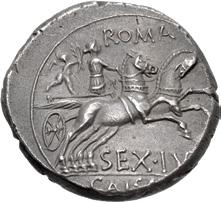
586. L. Sempronius Pitio. 148 BC. AR Denarius (19mm, 4.50 g, 12h). Rome mint. Helmeted head of Roma right; x (mark of value) below chin / The Dioscuri, each holding spear, on horseback riding right. Crawford 216/1; Sydenham 402; Sempronia 2; RBW 926. Beautifully toned, light scratches on reverse. EF. ($750)
Ex Classical Numismatic Group 114 (13 May 2020), lot 554; Dr. Erik Miller Collection (Spink, 27 March 2019), lot 159, purchased from Baldwins, 29 August 1969.
587. Sex. Julius Caesar. 129 BC. AR Denarius (17mm, 3.89 g, 7h). Rome mint. Helmeted head of Roma right; upturned anchor to left, • (mark of value) below chin / Venus Genetrix, holding reins and being crowned with wreath by Cupid standing behind, driving galloping biga right. Crawford 258/1; Sydenham 476; Julia 2; RBW 1053. Cabinet tone with some iridescence, granularity, flan flaw on reverse. Near EF. ($500)
Ex Alba Longa Collection (Áureo & Calicó 319, 7 November 2018), lot 400; Numismatica Ars Classica 8 (3 April 1995), lot 507.

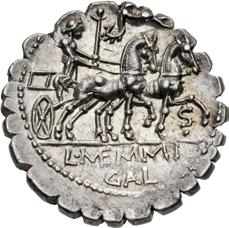
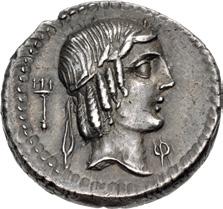
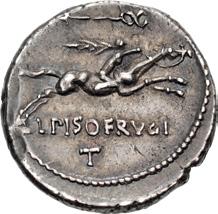
588. L. Memmius Galeria. 106 BC. AR Serrate Denarius (19mm, 3.89 g, 6h). Rome mint. Laureate head of Saturn left; harpa to right / Venus, holding scepter and reins, driving biga right; above, Cupid flying left, holding wreath; S/• below horses. Crawford 313/1c; Sydenham 574a; Memmia 2a; RBW –. Iridescent toning, whisper of deposits, traces of underlying luster. EF. An attractive example. ($500)
Ex Numismatica Ars Classica 15 (18 May 1999), lot 81.
Ex Haeberlin Collection – Pedigreed to 1933
589. L. Calpurnius Piso Frugi. 90 BC. AR Denarius (18mm, 4.11 g, 9h). Rome mint. Laureate head of Apollo right; trident to left, f below chin / Horseman, holding palm frond, galloping right; caduceus above, T below. Crawford 340/1; Sydenham 663e var. (controls); Calpurnia 11; RBW 1262 var. (same). Deep cabinet tone, minor marks. Good VF. ($500)
From the Wild Rose Collection. Ex Numismatica Ars Classica 106 (9 May 2018), lot 398; Ernst Justus Haeberlin Collection (Cahn-Hess 84, 17 July 1933), lot 1262.
Four Symbols Variety
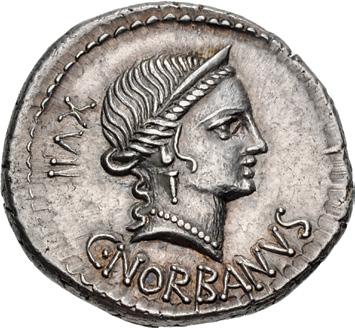
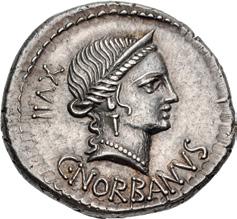
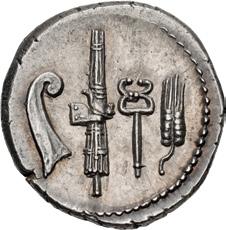

590. C. Norbanus. 83 BC. AR Denarius (19mm, 3.93 g, 1h). Rome mint. Diademed head of Venus right; xuii to left / Prow stem, fasces with axe, caduceus, and grain ear. Crawford 357/1a; Sydenham 740; Norbana 1; RBW 1362 var. (control). Lightly toned with hints of iridescence. Superb EF. ($1000)
From the Wild Rose Collection. Ex Michele Gioradano Collection (G. Hirsch 355, 12 February 2020), lot 1960; Numismatica Genevensis SA 6 (30 November 2010), lot 128; Tkalec (24 October 2003), lot 183.
161
586 587 588 589

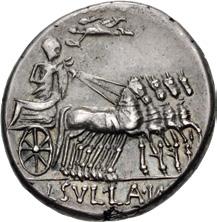
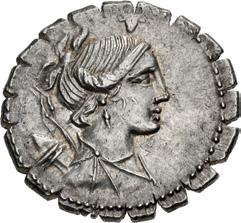

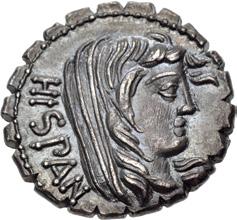

591. L. Sulla and L. Manlius Torquatus. 82 BC. AR Denarius (19mm, 3.96 g, 2h). Military mint moving with Sulla. Helmeted head of Roma right / Sulla, holding branch and reins, driving triumphal quadriga right; above, Victory flying left, crowning him with laurel wreath. Crawford 367/5; Sydenham 757; Manlia 4; RBW 1386. Toned and well centered. Good VF. ($500)
From the Wild Rose Collection. Ex Dr. Walter Stoecklin (†1975) Collection (Nomos Obolos 9, 25 March 2018), lot 57.
592. A. Postumius A.f. Sp.n. Albinus. 81 BC. AR Serrate Denarius (20mm, 3.99 g, 9h). Rome mint. Draped bust of Diana right, with bow and quiver over shoulder; bucranium above / Togate figure standing left on rock, holding aspergillum over head of ox standing right; lighted altar between them. Crawford 372/1; Sydenham 745; Postumia 7; RBW 1392. Slight porosity, light iridescence. Near EF. ($500)
From the Wild Rose Collection, purchased from Martina Dieterle, 16 January 2020. Ex Áureo & Calicó 319 (7 November 2018), lot 630; Numismatica Ars Classica 8 (3 April 1995), lot 537.
Ex RBW Collection – Pedigreed to 1965
593. A. Postumius A.f. Sp.n. Albinus. 81 BC. AR Serrate Denarius (19mm, 3.93 g, 4h). Rome mint. Veiled head of Hispania right / Togate figure standing left, raising hand, between aquila and fasces. Crawford 372/2; Sydenham 746; Postumia 8; RBW 1393 (this coin). Deeply toned with iridescence, obverse scrape under tone, hairlines. Near EF ($500)
From the Wild Rose Collection. Ex Numismatica Ars Classica 114 (6 May 2019), lot 431; Goldberg 72 (5 February 2013), lot 4118; RBW Collection (Part II, Numismatica Ars Classica 63, 17 May 2012), lot 169, purchased from F. S. Knobloch, May 1965.
Ex McCabe and RBW Collections
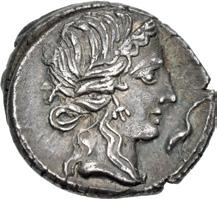


594. Q. Caecilius Metellus Pius. 81 BC. AR Denarius (18mm, 3.90 g, 8h). Uncertain mint in northern Italy. Diademed head of Pietas right; to right, stork standing right / Elephant walking left. Crawford 374/1; Sydenham 750; Caecilia 43; RBW 1396 (this coin). Deeply toned with light iridescence, a few scratches. Good VF. Well struck for issue. ($750)
From the Wild Rose Collection. Ex Andrew McCabe Collection (Roma E-Sale 93, 6 January 2022), lot 917; RBW Collection (Numismatica Ars Classica 63, 17 May 2012), lot 172, purchased from Kirk Davis, May 2000; J.B. Parker Collection (Superior, 2 June 1998), lot 6856; Coin Galleries (12 February 1986), lot 406.


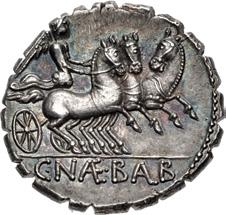
595. C. Naevius Balbus. 79 BC. AR Serrate Denarius (18mm, 3.90 g, 1h). Rome mint. Diademed head of Venus right; F below chin / Victory, holding reins, driving galloping triga right. Crawford 382/1a; Sydenham 769; Naevia 6b; RBW 1409 var. (control). Toned with iridescence, minor marks. EF. ($500)
From the Wild Rose Collection, purchased from Shanna Schmidt, March 2018. Ex Schweizerischer Bankverein 28 (17 September 1991), lot 332.
162
591 592 593

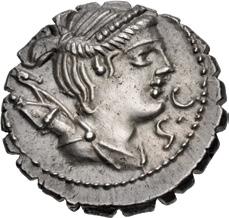
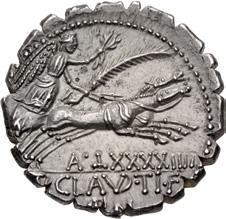
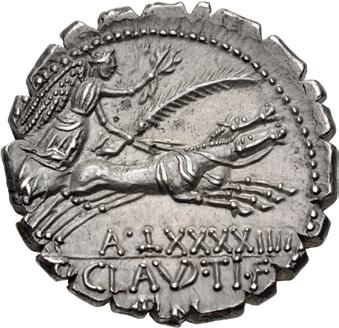
596. Ti. Claudius Ti.f. Ap.n. Nero. 79 BC. AR Serrate Denarius (19mm, 3.87 g, 4h). Rome mint. Diademed and draped bust of Diana right, quiver and bow with stag’s head termination over her shoulder / Victory, holding wreath, reins, and palm frond, driving galloping biga right; A • %xxxxiiii below. Crawford 383/1; Sydenham 770a; Claudia 6; RBW 1411 var. (control mark). Lightly toned, slight porosity, minor cleaning marks. EF. ($500)



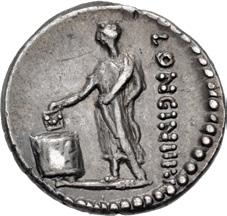
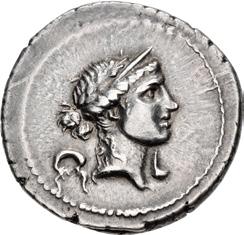

597. C. Hosidius C.f. Geta. 64 BC. AR Serrate Denarius (19mm, 3.97 g, 6h). Rome mint. Draped bust of Diana right, bow and quiver over shoulder / Calydonian boar standing right, pierced by spear and attacked by dog. Crawford 407/1; Sydenham 904; Hosidia 2; RBW 1455. Toned. Near EF. ($500)
From the Wild Rose Collection, purchased from Shanna Schmidt, March 2018. Ex Preussag Collection (London Coin Galleries 1, 30 October 2015), lot 1134; Numismatica Ars Classica 73 (18 November 2013), lot 133.
598. L. Cassius Longinus. 60 BC. AR Denarius (18mm, 3.98 g, 7h). Rome mint. Veiled and draped bust of Vesta left; L to left, calix to right / Voter standing left, dropping tablet inscribed u (Uti rogas) into cista to left. Crawford 413/1; Sydenham 935; Cassia 10; RBW 1493. Toned, minor marks and scratches. Near EF. ($500)
From the Wild Rose Collection. Ex Numismatica Ars Classica 114 (6 May 2019), lot 453; Student and His Mentor Collection (Part III, Numismatica Ars Classica 83, 20 May 2015), lot 366, purchased from Spink, 1969.
599. M. Aemilius Lepidus. 58 BC. AR Denarius (20mm, 3.72 g, 3h). Rome mint. Laureate and diademed female head (Roma?) right; wreath with fillet to left, simpulum to right / Equestrian statue of M. Aemilius Lepidus right, holding trophy over shoulder. Crawford 419/1d; Sydenham 828; Aemilia 20; RBW 1508. Lightly toned, reverse flan flaw, slightly off center reverse. Near EF. ($750)
Ex Hess-Divo 326 (28 May 2014), lot 73; Numismatica Ars Classica 54 (24 March 2010), lot 235; Vico 119 (2 April 2009), lot 580.
Melpomene – Muse of Tragedy

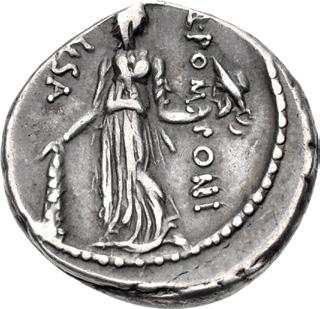
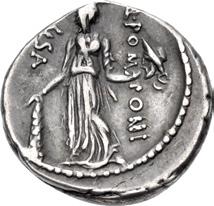
600. Q. Pomponius Musa. 56 BC. AR Denarius (17mm, 3.86 g, 4h). Rome mint. Laureate head of Apollo right; scepter to left / Melpomene, the Muse of Tragedy, standing right, wearing sword, holding club and tragic mask. Crawford 410/4; Sydenham 816; Pomponia 14; RBW 1486. Deep cabinet tone, banker’s mark. Good VF. ($750)
From the Mesogeios Collection.
163
599
597
598
Thalia – Muse of Comedy

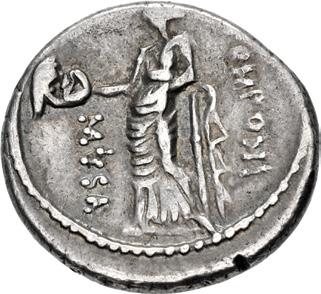
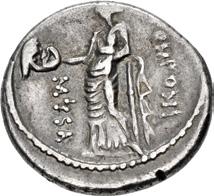
601. Q. Pomponius Musa. 56 BC. AR Denarius (17mm, 3.86 g, 5h). Rome mint. Laureate head of Apollo right; sandal to left / Thalia, the Muse of Comedy, standing left and leaning on column, holding persona (comic mask). Crawford 410/9b; Sydenham 821; Pomponia 19; RBW –. Toned with light iridescence, light scratches, edge mark. VF. ($500)
From the Mesogeios Collection.
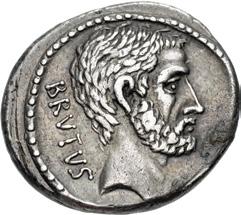

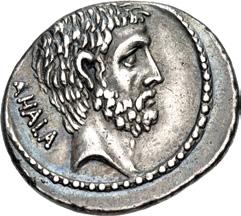
602. Q. Servilius Caepio (M. Junius) Brutus. 54 BC. AR Denarius (19.5mm, 4.15 g, 8h). Rome mint. Bare head of L. Junius Brutus right / Bare head of C. Servilius Ahala right. Crawford 433/2; Sydenham 907; Junia 30; RBW 1543. Deeply toned, minor encrustations. Good VF. ($500)
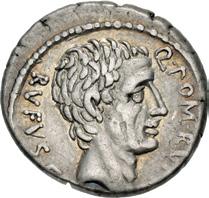


603. Q. Pompeius Rufus. 54 BC. AR Denarius (17mm, 3.63 g, 5h). Rome mint. Bare head of the consul Q. Pompeius Rufus right / Bare head of Sulla right. Crawford 434/1; Sydenham 908; Pompeia 4; RBW 1544. Lightly toned with a hint of iridescence, a few light marks. Good VF. Excellent portrait of Sulla. ($1500)
From the Wild Rose Collection. Ex John L. Cowan Collection (Classical Numismatic Group 114, 13 May 2020), lot 616; Gemini II (10 January 2006), lot 265.
This coin issue bears the only portrait of the dictator Sulla. The moneyer was the grandson of Sulla and his home would likely have had portraits of their famous ancestor. Thus, although posthumously struck, the portrait on these coins is probably an accurate representation.
Ex RBW Collection
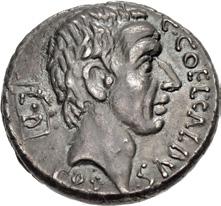
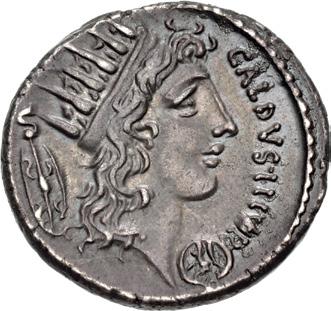

604. C. Coelius Caldus. 53 BC. AR Denarius (18mm, 4.01 g, 1h). Rome mint. Bare head of C. Coelius Caldus right; to left, L • D (Libero : Damno) inscribed on tablet / Radiate head of Sol right; to left, Í above oval shield decorated with thunderbolt; round shield below chin. Crawford 437/1b; Sydenham 892; Coelia 5; RBW 1550 (this coin illustrated). Deeply toned. Near EF. ($1000)
From the Wild Rose Collection, purchased from Numismatica Ars Classica, 16 January 2020. Ex Gemini XII (11 January 2015), lot 307; RBW Collection (Part II, Numismatica Ars Classica 63, 17 May 2012), lot 326, purchased from A. H. Baldwin and Sons, September 1976.
The obverse of this type refers to past events, such as the moneyer’s grandfather, consul in 94 BC, as well as the Lex Coelia Tabellaria, which passed while he was tribunus plebis in 107 BC. Conversely, the reverse most likely refers to contemporaneous victories in the East, as symbolized by the bust of Sol and a Macedonian shield
164
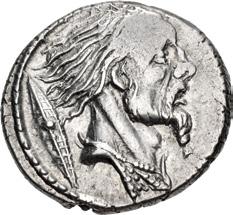
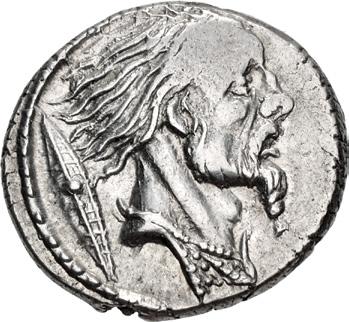

605. Moneyer issues of Imperatorial Rome. L. Hostilius Saserna. 48 BC. AR Denarius (19mm, 3.84 g, 12h). Rome mint. Head of Gallic captive (Vercingetorix?) right; Gallic shield to left / Two warriors in galloping biga right: one driving, holding whip and reins, and the other, facing backward, holding shield and brandishing spear. Crawford 448/2a; CRI 18; Sydenham 952; Hostilia 2; RBW 1569. Small area of flat strike, reverse slightly off center. Good VF. ($1000)
From the Mesogeios Collection. Ex Cayón Online 80 (28 February 2022), lot 30397.
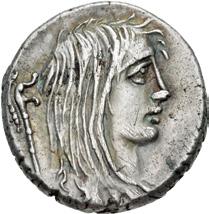
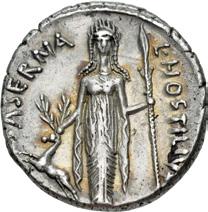

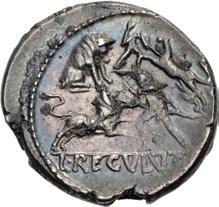
606. Moneyer issues of Imperatorial Rome. L. Hostilius Saserna. 48 BC. AR Denarius (17mm, 3.94 g, 6h). Rome mint. Bare head of Gallia right; carnyx (Gallic trumpet) to left / Diana (Artemis) of Ephesus standing facing, placing hand on head of stag, leaping left, and holding spear. Crawford 448/3; CRI 19; Sydenham 953; Hostilia 4; RBW 1570. Lightly toned with iridescence, some find patina, minor marks. Good VF. ($500)
607. Moneyer issues of Imperatorial Rome. L. Livineius Regulus. 42 BC. AR Denarius (18mm, 3.91 g, 5h). Rome mint. Bare head right / Venatio scene: in foreground, lion charging right toward a bestiarius who spears it; in background on left, a wounded bear sits right; on right, another bestiarius, holding sword and shield, defends himself against a tiger charging left. Crawford 494/30; CRI 179; Sydenham 1112; Livineia 12; RBW 1735. Toned with iridescence, scratches, deposits, off center, graffiti in obverse fields. Good VF. ($500)
This popular type depicts a venatio, a contest between bestiarii and various animals. Such activities served as the morning entertainment during a day at the games, with the “main event” – the gladiatorial contests – taking place in the afternoon.
Outstanding Pedigree
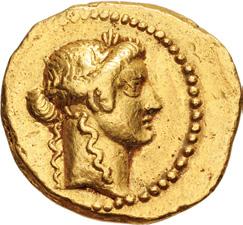

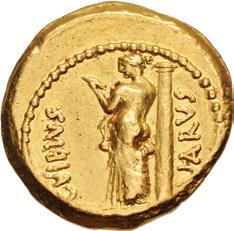
608. Moneyer issues of Imperatorial Rome. C. Vibius Varus. 42 BC. AV Aureus (20mm, 8.04 g, 7h). Rome mint. Laureate head of Apollo right / Venus, half nude and seen from behind, standing left beside a column, looking at herself in mirror. Crawford 494/34; CRI 190; Sydenham 1137; Bahrfeldt 36; Calicó 33; RBW 1738. Minor marks, slightly off center. VF. ($4000)
From the Wayne Scheible Collection. Ex Triton III (30 November 1999), lot 835; Sternberg XVIII (20 November 1986), lot 372; Münzen und Medaillen AG 52 (19 June 1975), lot 372; Enrico Caruso Collection (Canessa, 28 June 1923), lot 130; P.M. Stroehlin Collection (Sotheby, Wilkinson & Hodge, 25 May 1903), lot 3.
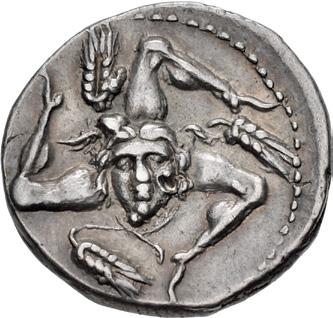



609. The Pompeians. L. Cornelius Lentulus and C. Claudius Marcellus. April-June 49 BC. AR Denarius (18mm, 3.92 g, 1h). Military mint in the East, moving with Pompey. Triskeles, with winged facing head of Medusa at center; ear of grain between each leg / Jupiter standing right, holding thunderbolt and eagle; harpa to right. Crawford 445/1a; CRI 4; Sydenham 1029a; Cornelia 64; RBW 1561. Light iridescence with minor marks, banker’s mark, well centered. Near EF. ($750)
From the Wild Rose Collection. Ex Numismatica Ars Classica 106 (9 May 2018), lot 465; Asta Internazionale del Titano 53 (5 June 1993), lot 110.
165
606
607
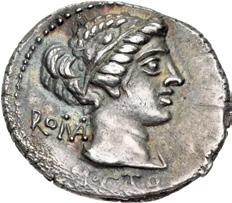
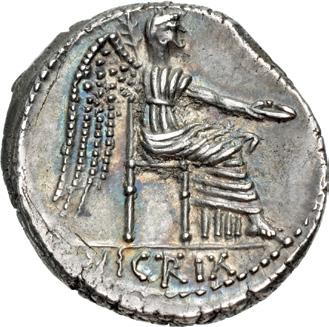

610. The Pompeians. M. Porcius Cato. Spring 47- Spring 46 BC. AR Denarius (19mm, 3.92 g, 10h). Utica mint. Draped bust of female (Roma?) right / Victory seated right, holding patera and palm frond over shoulder. Crawford 462/1a; CRI 46a; Sydenham 1053; Porcia 10; RBW –. Toned with iridescence, obverse scrapes and peripheral roughness, obverse legend weakly struck. Near EF. ($500)

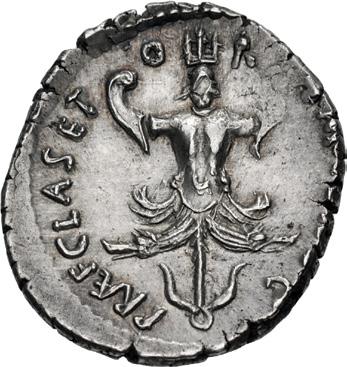
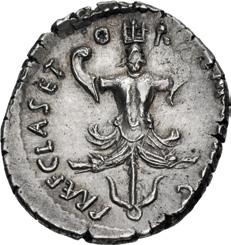
611. The Pompeians. Sextus Pompey. 37/6 BC. AR Denarius (19mm, 3.95 g, 11h). Uncertain Sicilian mint. Diademed and bearded head of Neptune right; trident over left shoulder / Naval trophy set on anchor, top of trident visible above helmet; the arms composed of the stem of a prow in right and apluster in left; heads of Scylla and Charybdis at base. Crawford 511/2b; CRI 333; Sydenham 1347; RSC 1a; cf. RBW 1784 (for type). Lightly toned with hints of iridescence, areas of soft strike, a bit off center. Near EF. ($750)
Ex Naville Numismatics 43 (23 September 2018), lot 408; Numismatica Ars Classica N (26 June 2003), lot 1646.
Pedigreed to 1976
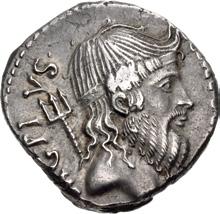

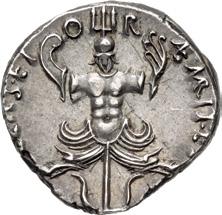
612. The Pompeians. Sextus Pompey. 37/6 BC. AR Denarius (18mm, 3.88 g, 12h). Uncertain Sicilian mint. Diademed and bearded head of Neptune right; trident over left shoulder / Naval trophy set on anchor, top of trident visible above helmet; the arms composed of the stem of a prow in right and apluster in left; heads of Scylla and Charybdis at base. Crawford 511/2b; CRI 333; Sydenham 1347; RSC 1a; cf. RBW 1784 (for type). Attractive cabinet toning. Near EF. ($1000)
From the Wild Rose Collection. Ex Andrew McCabe Collection (Classical Numismatic Group 112, 11 September 2019), lot 547; Student and His Mentor Collection (Part II, Numismatica Ars Classica 73, 18 November 2013), lot 239; Sternberg VII (24 November 1977), lot 470; Numismatic Fine Arts II (25 March 1976), lot 363.
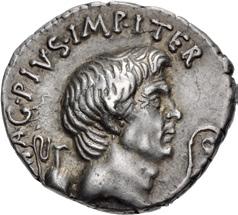
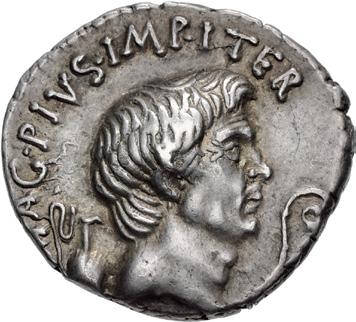
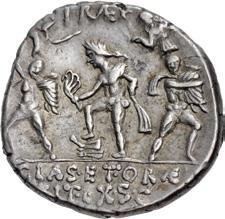
613. The Pompeians. Sextus Pompey. 37/6 BC. AR Denarius (20mm, 3.67 g, 10h). Uncertain Sicilian mint. Bare head of Pompey the Great right; capis to left, lituus to right / Neptune standing left, holding apluster and resting foot on prow between the Catanaean brothers Anapias and Amphinomus running in opposite directions, bearing their parents on their shoulders. Crawford 511/3a; CRI 334; Sydenham 1344; RSC 17 (Pompey the Great); RBW 1785. Attractive cabinet toning. EF. High relief and fine style. ($1500)
Ex Historical Scholar Collection (Heritage 3101, 25 August 2022), lot 32085; Leu 50 (25 April 1990), lot 264.
166


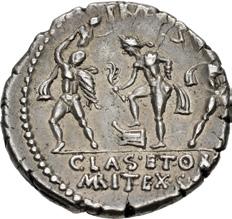
614. The Pompeians. Sextus Pompey. 37/6 BC. AR Denarius (19mm, 3.81 g, 6h). Uncertain Sicilian mint. Bare head of Pompey the Great right; capis to left, lituus to right / Neptune standing left, holding apluster and resting foot on prow between the Catanaean brothers Anapias and Amphinomus running in opposite directions, bearing their parents on their shoulders.
Crawford 511/3a; CRI 334; Sydenham 1344; RSC 17 (Pompey the Great); RBW 1785. Light iridescent tone, short flan crack. Near EF. ($1500)
From the Wild Rose Collection, purchased from Pars Coins, March 2017. Ex Elvira Elisa Clain-Stefanelli Collection (Numismatica Ars Classica 92, Part II, 24 May 2016), lot 1936.
Sextus Pompey came of age during the ascendancy of his father, Gnaeus Pompeius Magnus (Pompey the Great), as the leading general of Rome. After Pompey’s defeat by Julius Caesar at Pharsalus in August of 48 BC, and his treacherous murder in Egypt later that year, Sextus joined the Pompeian resistance to Caesar in Spain. Caesar’s assassination on March 15, 44 BC brought a brief revival of Senatorial control, during which Sextus relocated to Massalia in southern Gaul. In April of 43 BC, the Senate appointed him commander of the Roman fleet. Although the promotion was rescinded three months later, Sextus wasted no time in seizing Sicily and spent the next months building an impregnable power base on the island even as Rome fell under the sway of Caesar’s political heirs, the Triumvirs Antony, Octavian and Lepidus. While the Triumvirs hunted down Caesar’s assassins, Sextus enjoyed a rollicking life as a pirate king, using his fleet to raid far and wide.
This attractive denarius belongs to his piratical period on Sicily and honors his father, Pompey the Great, on the obverse, while the reverse depicts the sea god Neptune along with the semi-legendary Catanaean twins, Anapius and Amphinomus, who rescued their parents from an eruption of Mount Aetna and became symbols of filial piety.

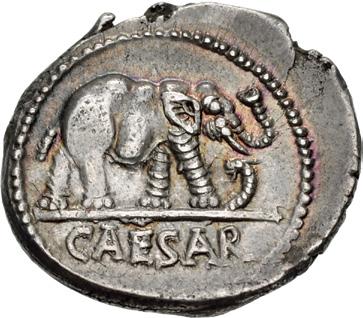
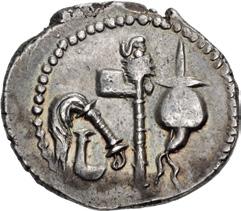
615. The Caesarians. Julius Caesar. April-August 49 BC. AR Denarius (19mm, 3.83 g, 12h). Military mint traveling with Caesar. Elephant advancing right, trampling on horned serpent / Emblems of the pontificate: simpulum, aspergillum, securis, and apex. Crawford 443/1; CRI 9; Sydenham 1006; RSC 49; RBW 1557. Toned, with hints of iridescence, areas of slight flatness of strike. Near EF. ($1000)
From the Wild Rose Collection. Ex Bruce R. Brace Collection (Classical Numismatic Group 90, 23 May 2012), lot 1382, purchased from Spink, May 1960.
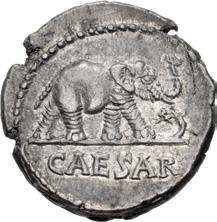


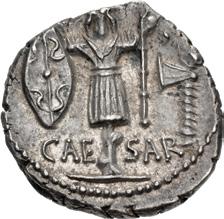
616. The Caesarians. Julius Caesar. April-August 49 BC. AR Denarius (18mm, 3.95 g, 2h). Military mint traveling with Caesar. Elephant advancing right, trampling on horned serpent / Emblems of the pontificate: simpulum, aspergillum, securis, and apex. Crawford 443/1; CRI 9; Sydenham 1006; RSC 49; RBW 1557. Toned, light porosity, scrapes and scratches, some find patina. Near EF. ($750)
From the Mesogeios Collection. Ex Numismatica Ars Classica 132 (30 May 2022), lot 445.
617. The Caesarians. Julius Caesar. Late spring-early summer 48 BC. AR Denarius (19mm, 3.99 g, 11h). Military mint traveling with Caesar. Diademed female head (Clementia?) right, wearing oak wreath; %ii (= 52, Caesar’s age) to left / Gallic trophy, holding oval shield and carnyx surmonted by wolf’s head; securis to right. Crawford 452/2; CRI 11; Sydenham 1009; RSC 18; DCA 937; RBW –. Toned, patches of iridescence, minor deposits. EF. ($750)
From the Wild Rose Collection. Ex Classical Numismatic Group 123 (33 May 2023), lot 491; J. Westervelt Collection (Knobloch FPL 25 [December 1964]), no. 246.
The letters LII behind the female head have long been recognized as representing Caesar’s age, thereby placing this issue firmly within the year 48 BC. Caesar’s fifty-second birthday was on 13 July 48 BC; the battle at Pharsalus, the final major conflict between the Caesarian and Pompeian forces occurred one month later.
167
616 617
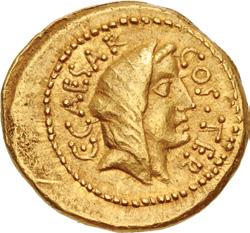

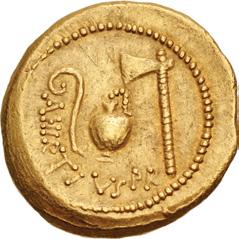
618. The Caesarians. Julius Caesar. Early 46 BC. AV Aureus (20mm, 7.94 g, 7h). Rome mint; A. Hirtius, praetor. Veiled head of female (Vesta or Pietas?) right; C • CAeÍAr COÍ • Ter around / Emblems of the augurate and pontificate: lituus, capis, and securis; A • hirTiuÍ • pr around from lower left. Crawford 466/1; Molinari 217 (D23/R223); CRI 56; Sydenham 1018; Bahrfeldt 19; Calicó 37; Biaggi –; RBW 1634. Light rose tone, minor roughness, reverse graffito. Good VF. ($5000)
From the Wild Rose Collection. Ex Dr. Walter Stoecklin (†1975) Collection (Nomos 14, 17 May 2017), lot 279.
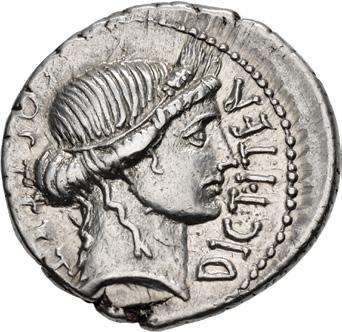


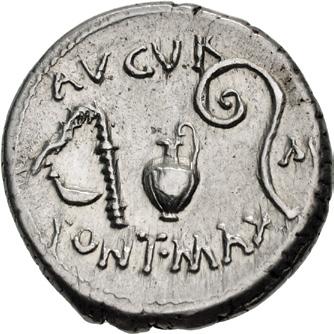
619. The Caesarians. Julius Caesar. January-April 46 BC. AR Denarius (19mm, 4.03 g, 11h). Uncertain mint, possibly Utica. Head of Ceres right, wearing wreath of grain / Emblems of the augurate and pontificate: simpulum, aspergillum, guttus, and lituus; Â (munus = gift) to right. Crawford 467/1b; CRI 57a; Sydenham 1024; RSC 4; RBW 1638. Minor marks. EF. ($500)
From the Wild Rose Collection. Ex Numismatica Ars Classica 64 (17 May 2012), lot 974.
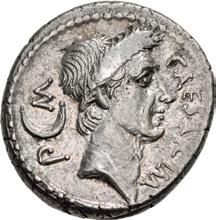
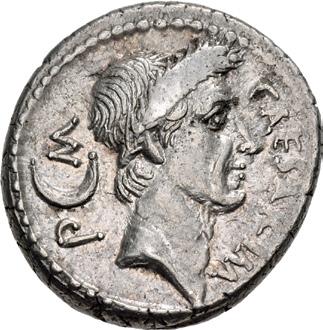
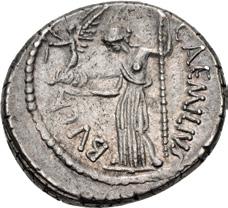
620. The Caesarians. Julius Caesar. January-February 44 BC. AR Denarius (17mm, 4.35 g, 3h). Lifetime issue. Rome mint. L. Aemilius Buca, moneyer. Laureate head right / Venus Victrix standing left, holding Victory and leaning on scepter. Crawford 480/4; Alföldi Type IV, 49 (A6/R2); CRI 102; Sydenham 1060; RSC 22; RBW –. Lightly toned with hints of iridescence, minor marks and scratches, some flatness. Good VF. ($2000)
From the Wild Rose Collection. Ex Classical Numismatic Review XVI.2 (Second Quarter, 1991), no. 107; Numismatica Ars Classica 2 (21 February 1990), lot 472; Classical Numismatic Review XV.4 (4th Quarter, 1990), no. 50.
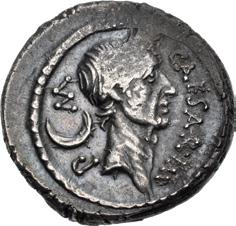
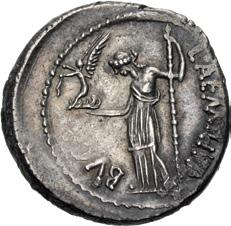


621. The Caesarians. Julius Caesar. January-February 44 BC. AR Denarius (19mm, 4.23 g, 4h). Lifetime issue. Rome mint. L. Aemilius Buca, moneyer. Laureate head right / Venus Victrix standing left, holding Victory and leaning on scepter. Crawford 480/4; Alföldi Type IV, 118 (A36/R37); CRI 102; Sydenham 1060; RSC 22; RBW –. Toned with light iridescence, areas of soft strike, banker’s mark and die flaw on obverse. Good VF. ($1500)
622. The Caesarians. Julius Caesar. April-May 44 BC. AR Denarius (18mm, 3.72 g, 12h). Rome mint; P. Sepullius Macer, moneyer. Struck under Mark Antony. Tetrastyle temple with globe in pediment / Desultor (horseman who leaps from one horse to another), wearing conical cap and holding whip, right on horseback, second horse at side in background; palm frond and wreath to left. Crawford 480/21; Alföldi Type XXII, 42 (A1/R1); CRI 110; Sydenham 1076; RSC 44; RBW 1688. Toned, part of flan unstruck. VF. ($750)
From the GS Collection. Ex Tony Hardy Collection (Classical Numismatic Group 64, 24 September 2003), lot 835.
This coin is one of the first issues of Mark Antony, struck shortly after Caesar’s assassination. The horseman is believed to be a reference to the Parilian Games, celebrated on 21 April. Both the games and the temple (never constructed) celebrated Caesar’s victories and honor.
168
621
622


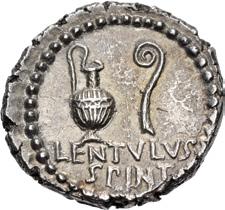
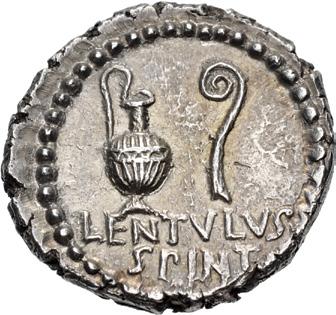
623. The Republicans. C. Cassius Longinus. Spring 42 BC. AR Denarius (18mm, 3.99 g, 6h). Military mint, probably at Smyrna; P. Cornelius Lentulus Spinther, legatus. Tripod surmounted by cortina and two laurel branches, fillet hanging on either side / Capis and lituus. Crawford 500/1; CRI 219; Sydenham 1308; RSC 7; RBW 1761. Toned with light iridescence. EF. Rare. ($1000)
Ex Gemini XII (17 January 2015), lot 321; Gemini IX (8 January 2012), lot 250.
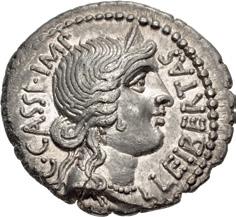
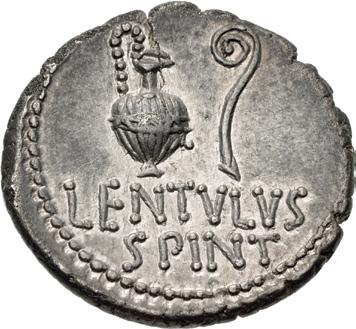
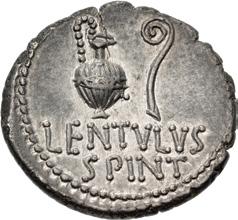
624. The Republicans. C. Cassius Longinus. Spring 42 BC. AR Denarius (19mm, 3.58 g, 6h). Military mint, probably at Smyrna; P. Cornelius Lentulus Spinther, legatus. Veiled, diademed, and draped bust of Libertas right / Capis and lituus. Crawford 500/5; CRI 223; Sydenham 1305; RSC 6; RBW 1764. Toned with luster, minor edge chipping, flan crack. EF. ($1000)
From the Wild Rose Collection. Ex Classical Numismatic Group Electronic Auction 269 (30 November 2011), lot 321.
Extremely Rare

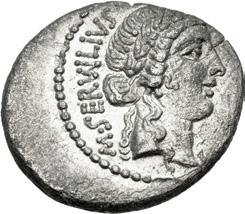
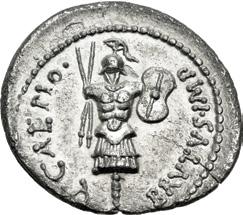
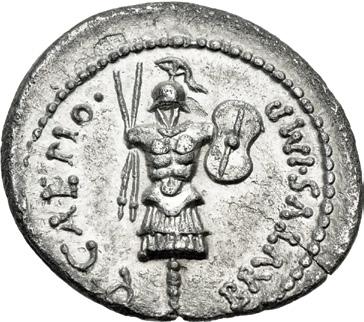
625. The Republicans. C. Cassius Longinus. Summer 42 BC. AR Denarius (20mm, 3.60 g, 6h). Military mint traveling with Brutus and Cassius, probably at Sardis; M. Servilius, legatus. Laureate head of Libertas right / Helmeted and cuirassed trophy with two spears and shield. Crawford 505/5; CRI 207; Sydenham –; RSC 9a; RBW 1776. Toned, lustrous, light porosity, flan crack. Good VF. Extremely rare. ($7500)
C. Cassius Longinus was one of the principal conspirators against Julius Caesar. Following the assassination, he moved to the east, where he sought to amass an army. His prior reputation of military success against the Parthians while governing the province of Syria proved invaluable, and by 43 BC his army boasted nearly twelve legions. He was able to stave off Antony’s general Dolabella, secured his base in Syria, and begin preparations for an invasion of Egypt. At the same time, Antony, Octavian, and Lepidus formed the triumvirate, and this posed too great a threat to ignore. Cassius halted his impending invasion of Egypt and moved west to meet up with Brutus’ forces at Smyrna. The two regicides agreed to take joint action against the triumvirs, and began by attacking their allies in Asia. The following year the pair moved into Thrace and chose a position outside Philippi to meet the approaching army of Antony and Octavian. Brutus moved against Octavian with great success, capturing the young Caesarian’s camp, but Cassius’ army was routed by Antony. Unaware of his partner’s success, Cassius thought the entire cause was lost and had his freedman Pindarus slay him.
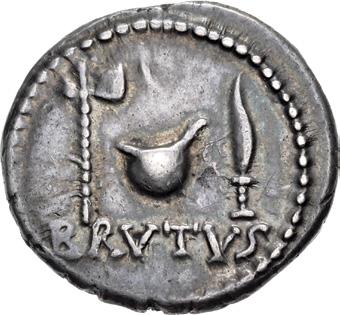

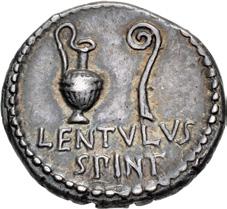
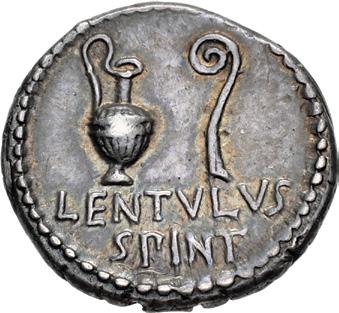
626. The Republicans. Brutus. Early 42 BC. AR Denarius (18.5mm, 4.00 g, 11h). Military mint, probably at Smyrna; P. Cornelius Lentulus Spinther, legatus. Emblems of the pontificate: securis, simpulum, and secespita / Emblems of the augurate: capis and lituus. Crawford 500/7; CRI 198; Sydenham 1310; RSC 6; BMCRR East 80-1; Kestner 3770; RBW 1766. Toned with hints of iridescence, small obverse die flaw, reverse scratches. Good VF. ($1500)
From the Wayne Scheible Collection, purchased from Harlan J. Berk, Ltd.
169
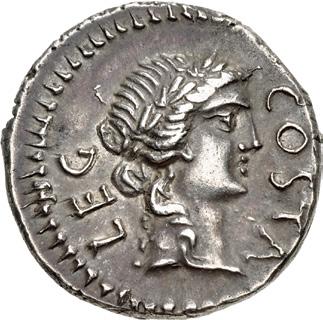



627. The Republicans. Brutus. Late summer-autumn 42 BC. AR Denarius (17.5mm, 3.75 g, 12h). Military mint traveling with Brutus and Cassius in western Asia Minor or northern Greece; Pedanius Costa, legatus. Laureate head of Apollo right / Trophy composed of cuirass, crested helmet, oval shield with incurved sides, and two crossed spears. Crawford 506/2; CRI 209; Sydenham 1296; RSC 4; RBW 1778. Lightly toned with underlying luster. Near EF. ($1500)
From the Wild Rose Collection. Ex Numismatica Ars Classica 114 (6 May 2019), lot 531; Numismatica Ars Classica 51 (5 March 2009), lot 112; Numismatica Ars Classica 40 (16 May 2007), lot 612.
Brutus is best known for his role in the assassination of Julius Caesar on March 15, 44 BC. This action, while often thought as an attempt to save liberty and justice, was actually meant to try to preserve aristocracy and privilege. Brutus and the other conspirators wanted to restore power to the Senate, comprised of the wealthiest and most powerful of Roman citizens. This brought him in conflict with Julius Caesar, who wanted to break the old power holds in the Senate, populating it with men of lower rank and birth. In a way, Julius Caesar could be seen as promoting a dictatorship with some flavor of a democracy, whereas Brutus and the other conspirators were attempting to save the aristocracy.
After their assassination of Julius Caesar, Brutus and Cassius occupied Rome but had to flee when a funeral oration delivered by Caesar’s protégé, Mark Antony, turned public opinion against them. Brutus and Cassius went their separate ways but met again in early 42 BC in Smyrna, Ionia, where they began preparations for the inevitable conflict that would ensue between them and Marc Antony and Octavian, Caesar’s grandnephew. They began using their armies to conquer cities, for which this series of coins was undoubtedly issued. The title IMP on the reverse shows that Brutus still styled himself the savior of the Republic, as that was a title only the Senate could award.
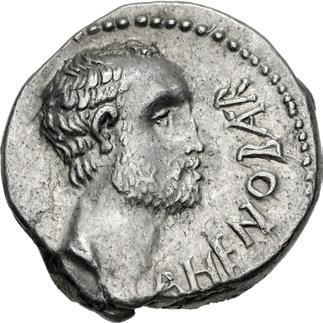
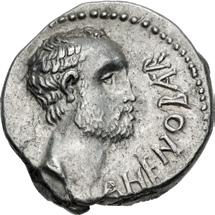
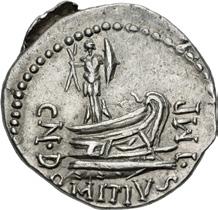
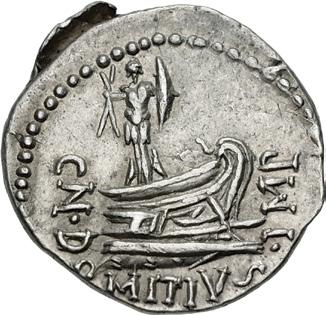
628. The Republicans. Cn. Domitius L.f. Ahenobarbus. 41-40 BC. AR Denarius (17.5mm, 3.71 g, 6h). Uncertain mint in the region of the Adriatic or Ionian Sea. Bare head of Ahenobarbus right, wearing short beard / Prow right surmounted by a military trophy. Crawford 519/2; CRI 339; Sydenham 1177; Domitia 21; RBW 1803. Toned, irregular flan. Good VF. ($1000)
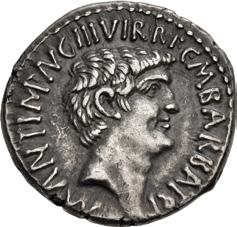
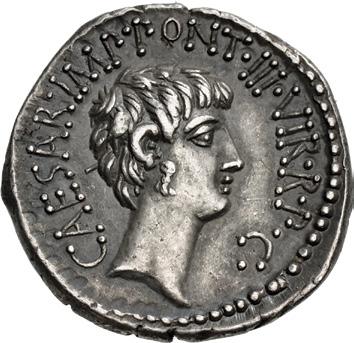
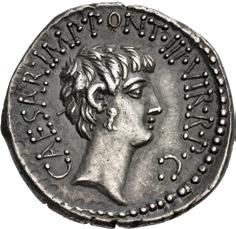
629. The Triumvirs. Mark Antony and Octavian. Spring-early summer 41 BC. AR Denarius (19mm, 3.78 g, 11h). Ephesus mint; M. Barbatius Pollio, quaestor pro praetore. Bare head of Mark Antony right / Bare head of Octavian right. Crawford 517/2; CRI 243; Sydenham 1181; RSC 8; RBW 1798 var. (Octavian with slight beard). Toned, minor marks and scratches. Near EF. ($1000)
From the Wild Rose Collection. Ex Numismatica Ars Classica 106, Part II (10 May 2018), lot 1316.
170
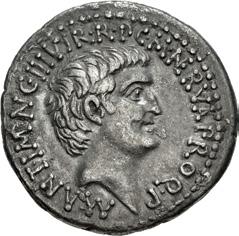

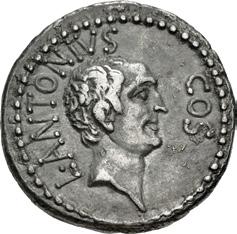
630. The Triumvirs. Mark Antony and Lucius Antony. Summer 41 BC. AR Denarius (19mm, 4.04 g, 12h). Ephesus mint; M. Cocceius Nerva, proquaestor pro praetore. Bare head of Mark Antony right / Bare head of Lucius Antony right. Crawford 517/5a; CRI 246; Sydenham 1185; RSC 2; RBW 1799. Gray toning, some die rust, small flan flaw on reverse. Good VF. ($750)

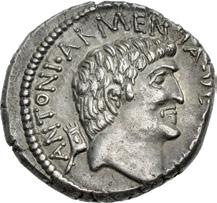
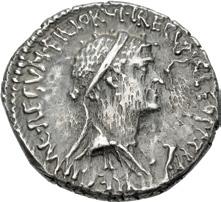
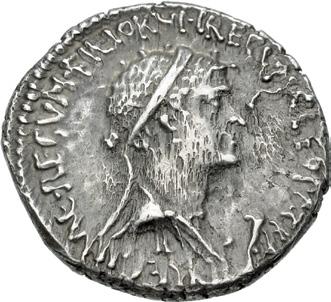
631. The Triumvirs. Mark Antony and Cleopatra. Autumn 34 BC. AR Denarius (17mm, 3.99 g, 12h). Alexandria mint(?). Bare head of Mark Antony right; Armenian tiara to left / Diademed and draped bust of Cleopatra right; at point of bust, prow right. Crawford 543/1 note; CRI 345; Sydenham 1210 var. (rev. legend); RSC 1c; RBW –. Toned, hairline flan crack, obverse struck slightly off center, die wear and porosity on reverse. Good VF. ($5000)



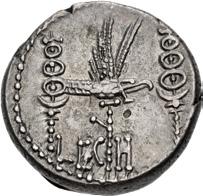
632. The Triumvirs. Mark Antony. Summer 32 BC. AR Denarius (20mm, 3.54 g, 10h). Athens mint. Bare head right; small p (signature) in hair below ear / ANTONiuÍ/Aug • iÂp • iii in two lines. Crawford 542/2; CRI 347; Sydenham 1209; RSC 2; RBW 1831. Find patina, banker’s mark on obverse, trace deposits. Good VF. Good portrait. ($500)
633. The Triumvirs. Mark Antony. Autumn 32-spring 31 BC. AR Denarius (16mm, 3.75 g, 6h). Legionary type. Patrae(?) mint. Praetorian galley right / Aquila between two signa; Leg ii across lower field. Crawford 544/14; CRI 349; Sydenham 1216; RSC 27; RBW 1838. Lightly toned, minor marks and scratches, graffito on obverse, banker’s mark on reverse. Near EF. ($500)
From the Wild Rose Collection.
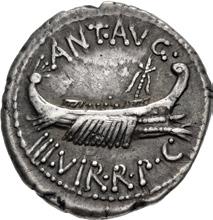

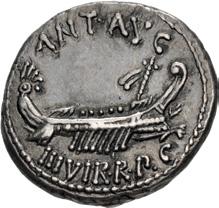
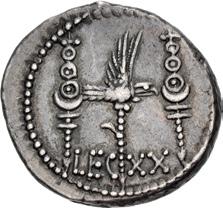
634. The Triumvirs. Mark Antony. Autumn 32-spring 31 BC. AR Denarius (17mm, 3.64 g, 6h). Legionary type. Patrae(?) mint. Praetorian galley right / Aquila between two signa; Leg uiii across lower field. Crawford 544/21; CRI 358; Sydenham 1225; RSC 35; RBW –. Toned, reverse scratches. Good VF. ($500)
Ex Künker 236 (7 October 2013), lot 877.
635. The Triumvirs. Mark Antony. Autumn 32-spring 31 BC. AR Denarius (18mm, 3.78 g, 6h). Legionary type. Patrae(?) mint. Praetorian galley right / Aquila between two signa; Leg xx across field. Crawford 544/36; CRI 380; Sydenham 1243; RSC 57; RBW 1848. Toned, minor porosity. Near EF. Fine style. ($750)
Ex Pat Coyle Collection (Goldberg 69, 29 May 2012), lot 3476; CNG inventory 928434 (August 2012); Classical Numismatic Review XX/2 Supplement (Summer 1995), no. 288; Crédit de la Bourse (19 April 1995), lot 1209.
171
632 633
634
635
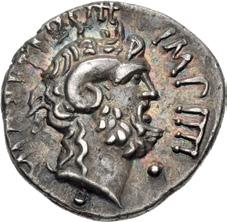
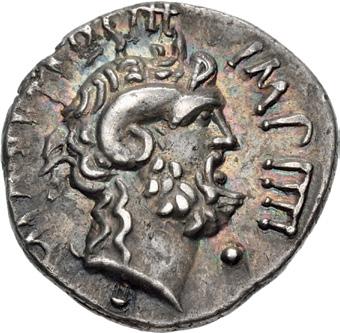
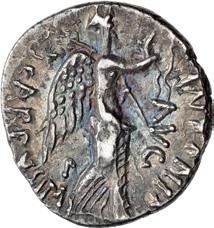
636. The Triumvirs. Mark Antony. Summer 31 BC. AR Denarius (18.5mm, 3.45 g, 11h). Cyrene mint; L. Pinarius Scarpus, imperator. Head of Jupiter Ammon right / Victory advancing right, holding wreath and palm frond over left shoulder.
Crawford 546/2a; CRI 390; Sydenham 1280; RSC 1; RBW 1852. Iridescent tone, reverse deposits. Good VF. ($750)
Ex Heritage 3071 (6 January 2019), lot 33245.
The final issue struck in Antony’s name before his defeat at Actium and his eventual suicide. Ex Nicolas Collection
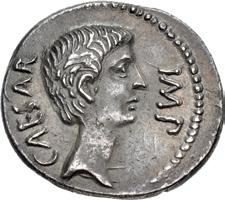
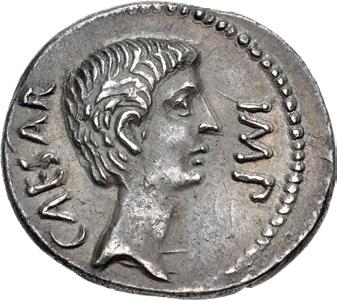

637. The Triumvirs. Octavian and Mark Antony. Late 40-early 39 BC. AR Denarius (18mm, 3.15 g, 6h). Military mint traveling with Octavian in Gaul. Bare head of Octavian right, wearing slight beard / Winged caduceus. Crawford 529/2a; CRI 302; Sydenham 1327a; RSC 6; RBW –. Toned with light iridescence, a few light scratches, reverse scrapes, reverse off center. Near EF. ($1000)
From the Wild Rose Collection, purchased from Martina Dieterle, March 2017. Ex Student and His Mentor Collection (Part III, Numismatica Ars Classica 83, 20 May 2015), lot 514; Dr. E. P. Nicolas Collection (Leu 17, 3 May 1977), lot 861.



638. The Triumvirs. Octavian and Divus Julius Caesar. 38 BC. Æ Sestertius (or Dupondius?) (31mm, 21.97 g, 11h).
Southern Italian(?) mint. Bare head of Octavian right, wearing slight beard / Laureate head of Divus Julius Caesar right.
Crawford 535/1; Alföldi & Giard 9 (D3/R7); CRI 308; Sydenham 1335; RPC I 620; RBW 1822. Natural brown surfaces, adjustment marks, minor pitting, edge mark. Good VF. A well struck example for this issue. ($2000)
Ex Michael Weller Collection (Triton VIII, 11 January 2005), lot 984 (hammer $3,750); Freeman & Sear FPL 11 (Spring/Summer 2006), no. 87.
172
Pedigreed
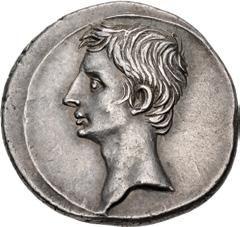
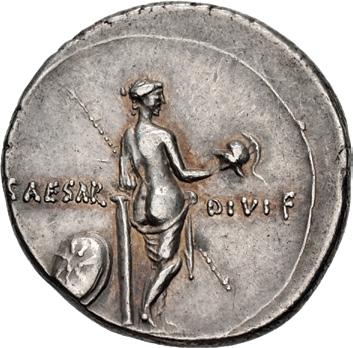

639. The Triumvirs. Octavian. Autumn 32-summer 31 BC. AR Denarius (19.5mm, 4.02 g, 3h). Uncertain mint in Italy (Rome?). Bare head left / Venus standing right, seen from the back and with drapery covering only her thighs, holding transverse scepter in left hand and helmet in right, resting left elbow on column to left; to left, shield with star motif set on ground, leaning against column; CAESAR DIVI • F across field. CRI 396; RIC I 250b; RSC 63; BMCRR Rome 4334 = BMCRE 601; BN 24–5; CNR V 414 (this coin). Lightly toned with iridescence, light porosity and hairlines. Near EF. ($2000)
From the Wayne Scheible Collection. Ex UBS 78 (9 September 2008), lot 1222 (hammer CHF 7000); Münzen und Medaillen AG XVII (2 December 1957), lot 348.


640. The Triumvirs. Octavian. Autumn 32-summer 31 BC. AR Denarius (19.5mm, 3.98 g, 10h). Uncertain mint in Italy (Rome?). Diademed head of Venus right / Octavian advancing left, extending arm and holding spear. CRI 397; RIC I 251; RSC 70. Lightly toned, minor flan flaw on obverse, faint hairlines. Good VF. ($500)
From the Wild Rose Collection. Ex Alberto Campana Collection (Numismatica Ars Classica 64, 17 May 2012), lot 2354; Rauch 65 (10 April 2000), lot 192.
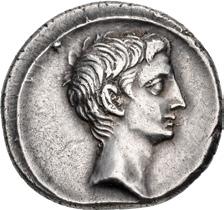

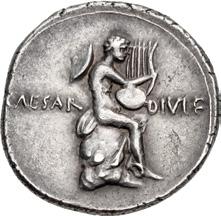
641. The Triumvirs. Octavian. Autumn 32-summer 31 BC. AR Denarius (18mm, 4.08 g, 9h). Uncertain mint in Italy (Rome?). Bare head right / Mercury or Apollo seated right on rock, playing lyre; petasus slung on his back. CRI 401; RIC I 257; RSC 61. Attractive toning, traces of die rust. Near EF. ($2000)
Ex Edward J. Waddell inventory 50869 (9 January 2014); Künker 243 (21 November 2013), lot 4713; A. Lynn Collection (Helios 4, 14 October 2009), lot 196; Numismatica Ars Classica 23 (19 March 2002), lot 1449.

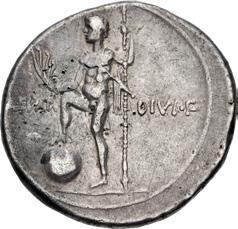
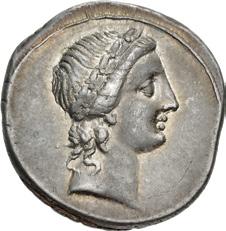
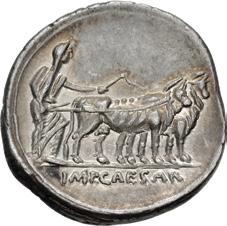
642. The Triumvirs. Octavian. Autumn 31-summer 30 BC. AR Denarius (19mm, 3.87 g, 3h). Uncertain mint in Italy (Rome?). Winged bust of Victory right / Octavian, as Neptune, standing left, foot set on globe, holding apluster and scepter. CRI 409; RIC I 256; RSC 60. Toned, faint hairlines, pits and marks on reverse. Good VF. ($500)
From the Wild Rose Collection. Ex Seaby Coin & Medal Bulletin 840 (May 1989), no. C250.
643. The Triumvirs. Octavian. Autumn 30-summer 29 BC. AR Denarius (18mm, 3.86 g, 6h). Uncertain mint in Italy (Rome?). Laureate head of Apollo of Actium right, with features resembling Octavian / Octavian, as city founder, holding whip and plow-handle, plowing right with yoke of oxen. CRI 424; RIC I 272; RSC 117. Lightly toned with peripheral iridescence, underlying luster. Near EF. ($750)
From the Wild Rose Collection, purchased from Sovereign Rarities, September 2018. Ex Numismatica Ars Classica 106 (9 May 2018), lot 840.
173
to 1957 – Illustrated in CNR
642
643

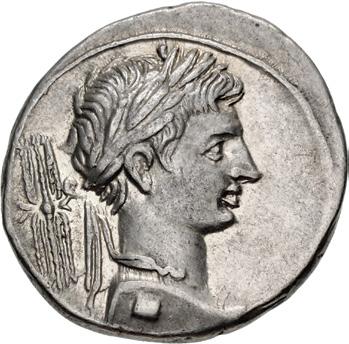

644. The Triumvirs. Octavian. Autumn 30-summer 29 BC. AR Denarius (19mm, 3.82 g, 3h). Uncertain mint in Italy (Rome?). Laureate bust of Octavian, as Jupiter Terminus, right; winged thunderbolt to left / Octavian seated left on curule chair, holding Victory. CRI 427; RIC I 270; RSC 116. Faint hairlines, traces of deposits on reverse. EF. ($750)
From the Wild Rose Collection. Ex Solidus 17 (18 May 2014), lot 161; Gitbud & Naumann 9 (3 November 2013), lot 417 (hammer €1700).
The Battle of Naulochus
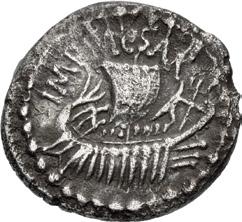

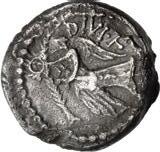
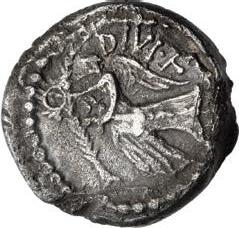
645. The Triumvirs. Octavian. 36-35 BC. AR Quinarius (113mm, 1.67 g, 3h). Uncertain mint. Galley with rowers sailing right / Victory advancing left, holding wreath, palm frond, and rudder. CRI 315A; Sydenham 1339; King 83; RSC 94. Toned, porosity. VF. Very rare, only five in CoinArchives. ($750)
Purchased by the consignor from Marcantica, 5 December 2015.
Although Crawford assigned this issue to the period after Actium, Octavian’s titles are consistent with the earlier 30s BC. The strong naval theme clearly alludes to a naval engagement. Sydenham believed it to have been struck to commemorate Agrippa’s victory at the Battle of Naulochus in September of 36 BC.
Ex Ploil and Steinberg Collections
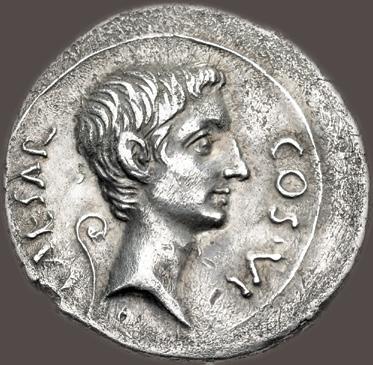
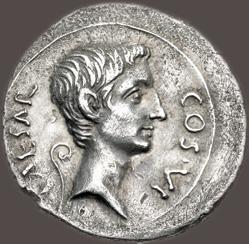

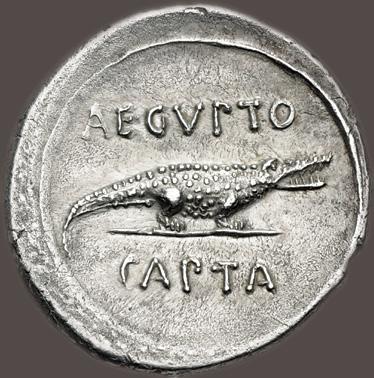
646. The Triumvirs. Octavian. 28 BC. AR Denarius (20mm, 3.72 g, 12h). “Aegypto Capta” commemorative. Uncertain mint in Italy (Rome?). Bare head right; lituus behind neck / Crocodile standing right with jaws open; AegupTO above, CApTA below. CRI 430; RIC I 275a; RSC 2. Toned with iridescence, light porosity, scratches. Good VF. ($10,000)
From the Wild Rose Collection. Ex Long Valley River Collection (Roma XX, 29 October 2020), lot 489 (hammer £15,000); Ernst Ploil Collection (Numismatica Ars Classica 101 (24 October 2017), lot 49; Peus 366 (25 October 2000, lot 1268; Gilbert Steinberg Collection (Numismatica Ars Classica/Spink Tasei, 16 November 1994), lot 131; Leu 48 (10 May 1989), lot 308.
Following the decisive battle of Actium, in August of 30 BC Octavian invaded Egypt and founded the Prefecture of Egypt, leaving intact the Ptolemaic structures in culture and administration. Octavian struck this issue to commemorate the event; the reverse depicts a crocodile, which was the symbol of the country and, locally, an important deity.
End of Session 2
174
Session 3 – Wednesday, May 29, 2024 — 9 AM
ROMAN IMPERIAL COINAGE
Pedigreed to 1932
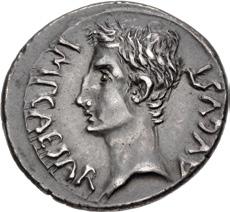
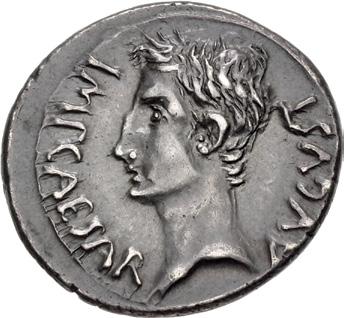
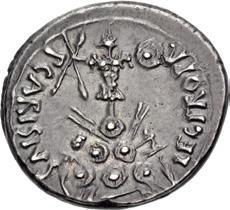
647. Augustus. 27 BC-AD 14. AR Denarius (18.5mm, 3.85 g, 76h). Emerita mint; P. Carisius, legate. Struck circa 25-23 BC. Bare head left / Trophy of Celtiberian arms, consisting of helmet, cuirass, shield, and javelins, erected on heap of round shields, lances, and other arms. RIC I 4b; RSC 402; CNR II 124/4 (this coin). Wonderful old cabinet tone. Near EF. ($1500)
From the Wild Rose Collection. Ex Áureo & Calicó 339 (14 November 2019), lot 1326; New York Sale IV (17 January 2002), lot 339; L. Hamburger 96 (25 October 1932), lot 729.
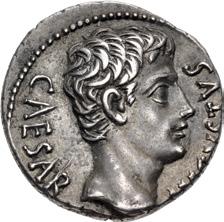


648. Augustus. 27 BC-AD 14. AR Denarius (18mm, 3.88 g, 5h). Uncertain Spanish mint (Colonia Patricia?). Struck 1918 BC. Bare head right / OB/ CIVIS/ SERVATOS in three lines within oak wreath with wreath ties drawn upward. RIC I 77a; RSC 208. Wonderful toning, struck slightly off center. Good VF. ($750)
From the Wild Rose Collection. Ex Spink Numismatic Circular CXIX.3 (July 2011), no. RM4451; Spink Numismatic Circular CXVI.6 (December 2008), no. RM3921; Timothy L. Taylor Collection (Baldwin’s 57, 23 September 2008), lot 71; New York Sale IX (13 January 2005), lot 157.


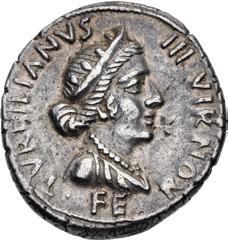
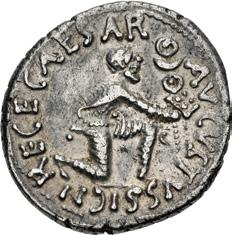
649. Augustus. 27 BC-AD 14. AR Denarius (17mm, 3.64 g, 4h). Lugdunum (Lyon) mint. Struck 15 BC. Bare head right / Apollo Citharoedus of Actium, standing left, holding plectrum and lyre. RIC I 171a; Lyon 28; RSC 144. Iridescent toning, die break across forehead, a few faint scratches. Near EF. ($500)
Ex Numismatica Ars Classica 138 (18 May 2023), lot 630.
650. Augustus. 27 BC-AD 14. AR Denarius (18mm, 4.03 g, 4h). Rome mint; P. Petronius Turpilianus, moneyer. Struck 19/8 BC. Draped bust of Feronia right, wearing pearl necklace and stephane, above which is a row of berries / Bareheaded Parthian kneeling on right knee right, extending in right hand a signum, to which is attached a vexillum marked with X, and holding out left hand below left knee. RIC I 288; RSC 484. Toned, banker’s mark on obverse, a few shallow scratches. VF. ($500)
From the Wild Rose Collection. Ex Rauch 86 (12 May 2010), lot 567; Superior (10 December 1988), lot 2263.
175
649
650
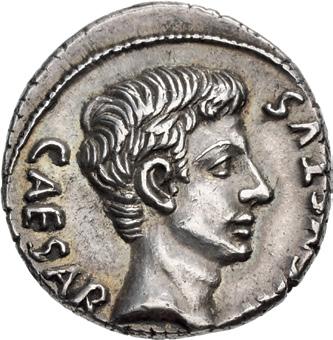
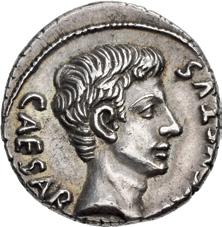
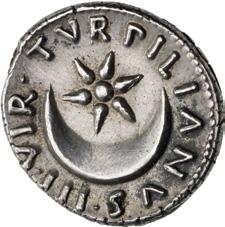
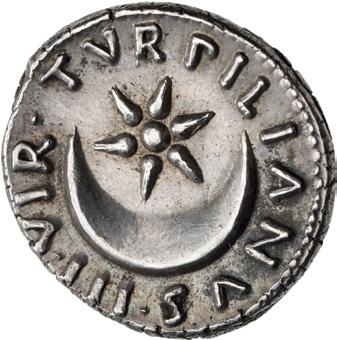
651. Augustus. 27 BC-AD 14. AR Denarius (18mm, 4.08 g, 1h). Rome mint; P. Petronius Turpilianus, moneyer. Struck 19/8 BC. Bare head right / Six-rayed star above large crescent. RIC I 300; RSC 495. Attractive cabinet toning, a few minor contact marks on obverse. Near EF. ($3000)
From the Wild Rose Collection. Ex Numismatica Ars Classica 72 (16 May 2013), lot 568; Nomisma 16 (27 September 2000), lot 205.


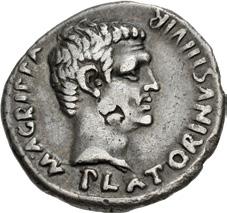

652. Augustus, with Agrippa. 27 BC-AD 14. AR Denarius (18mm, 3.83 g, 9h). Rome mint; C. Sulpicius Platorinus, moneyer. Struck 13 BC. Bare head of Augustus right / Bare head of Agrippa right. RIC I 408; RSC 3 (Agrippa and Augustus). Toned, bankers’ marks on obverse and reverse, edge tests and marks. VF. Rare. ($1000)
From the I.L. Collection. Ex Peter J. Merani Collection (Classical Numismatic Group Electronic Auction 490, 21 April 2021), lot 233; Classical Numismatic Group 45 (18 March 1998), lot 1846; Classical Numismatic Review XXII.2 (Spring/Summer 1997), no. 27.

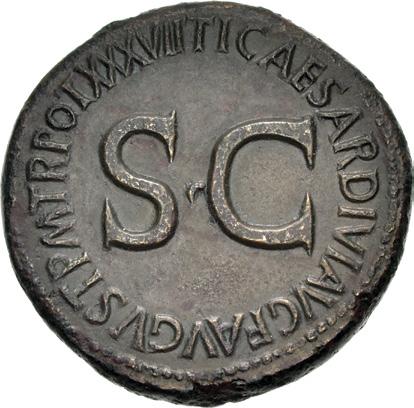

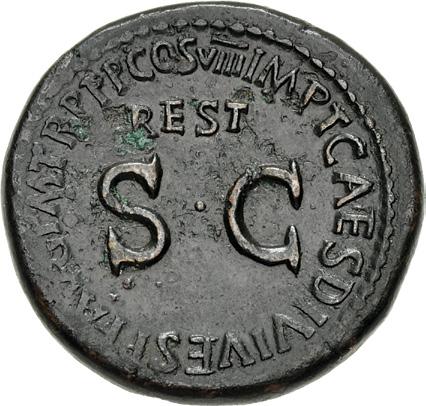
653. Divus Augustus. Died AD 14. Æ Sestertius (33.5mm, 27.24 g, 1h). Rome mint. Struck under Tiberius, AD 35-36. OB/ CIVES/ SER in three lines on shield within oak-wreath supported by two capricorns; globe below / Legend around large S • C. RIC I 63 (Tiberius). Brown surfaces, smoothing, some tooling. EF. ($750)
From the Wild Rose Collection. Ex Lanz 160 (15 June 2015), lot 343.
Pedigreed to 1912
654. Divus Augustus. Died AD 14. Æ Sestertius (34.5mm, 27.65 g, 6h). Restitution issue. Rome mint. Komnick Group I.1, under Titus, AD 80-81. Augustus seated left on throne with back, holding branch and scepter, foot on footstool; lighted altar to left / IMP T CAES DIVI VESP F AVG P M TR P P P COS VIII, REST above S C in center. RIC II.1 399 (Titus); Komnick Type 1.0, 12.34 (V3/R10) = CNR VI 942 (this coin). Dark green and brown patina, a few hard green deposits. VF. ($500)
From the collection of a Gentleman, Kent, England. Ex George Bauer Collection (Glendining, 23 January 1963), lot 1144; Naville II (12 June 1922), lot 180; Egger XXXIX (15 January 1912), lot 670.
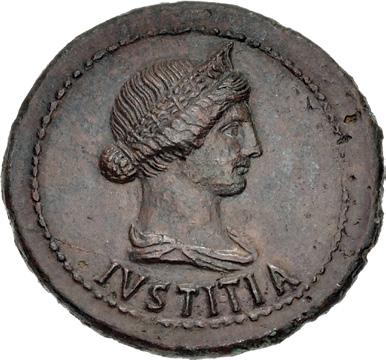
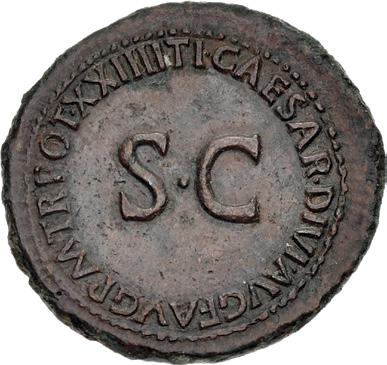
655. Julia Augusta (Livia). Augusta, AD 14-29. Æ Dupondius (32mm, 12.63 g, 12h). Rome mint. Struck under Tiberius, AD 22-23. IVSTITIA below, diademed and draped bust of Justitia right / Legend around large S • C. RIC I (Tiberius) 46 corr. (rev. legend). Brown and green surfaces, smoothed. Near EF. Well centered on a broad flan. ($1000)
From the Wild Rose Collection. Ex Gorny & Mosch 228 (9 March 2015), lot 570.
176
653
654
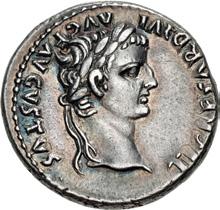
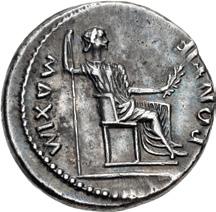
656. Tiberius. AD 14-37. AR Denarius (18mm, 3.73 g, 7h). “Tribute Penny” type. Lugdunum (Lyon) mint. Group 1, AD 15-18. Laureate head right / Livia (as Pax) seated right on chair, holding scepter and olive branch; plain chair legs, double line below. RIC I 26; Lyon 144; RSC 16. Iridescent tone, hairlines. Near EF. Fine style, small, refined bust. ($1000)
From the Wild Rose Collection. Ex Dr. Allan Smith Collection (Triton XXI, 8 January 2018), lot 701; Hirsch 314 (23 September 2015), lot 2690.
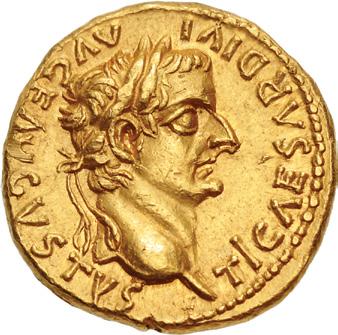

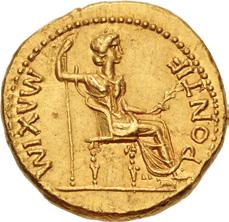
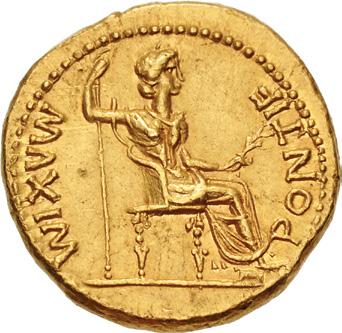
657. Tiberius. AD 14-37. AV Aureus (18mm, 7.79 g, 6h). “Tribute Penny” type. Lugdunum (Lyon) mint. Group 4, AD 18-35. TI CΛESΛR DIVI ΛVG F ΛVGVSTVS, laureate head right; one ribbon on shoulder / PONTIF MΛXIM, Livia (as Pax) seated right on chair, feet on footstool, holding scepter in right hand and olive branch in left; ornate chair legs, single line below. RIC I 29; Lyon 149; Calicó 305a; BMCRE 46; BN 22-7; Biaggi 168. Shallow scrape on obverse, patch of hairlines on reverse. EF. Portrait struck in high relief. ($5000)
From the Wild Rose Collection. Ex Numismatica Ars Classica 80 (20 October 2014), lot 54.

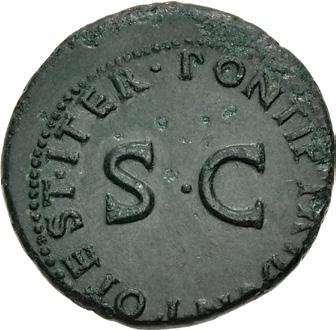
658. Drusus. Died AD 23. Æ As (27.5mm, 10.52 g, 7h). Rome mint. Struck under Tiberius, AD 22-23. Bare head left / Legend around large S • C. RIC I 45 (Tiberius). Dark green surfaces, smoothed, a few scratches on obverse, some pitting on reverse. Good VF. ($500)
From the collection of a Gentleman, Kent, England, purchased from Baldwin’s, 13 February 2014.
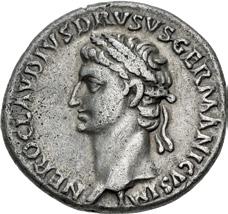
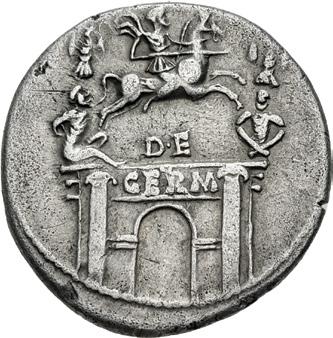

659. Nero Claudius Drusus. Died 9 BC. AR Denarius (18.5mm, 3.68 g, 9h). Lugdunum (Lyon) mint. Struck under Claudius, AD 41-42. Head left, wearing oak wreath / DE above and GERM on architrave of triumphal arch, surmounted by equestrian statue right between two trophies; the rider carries spear in rest in right hand; at the foot of each trophy sits a captive with hands tied behind his back, the one on left looking right, the one on right facing. RIC I 70 (Claudius; Rome mint); von Kaenel Type 12 (unlisted dies); Lyon (Claudius) 23, 4a (D–/R102 [unlisted obv. die]); RSC 2; cf. Elkins, Monuments Figure 73 (for rev. type). Toned, porosity, minor scratches, a couple of shallow edge tests. VF. ($1500)
From the I.L. Collection. Ex Naville Numismatics 52 (22 September 2019), lot 474; Naville Numismatics 17 (13 September 2015), lot 456.
177
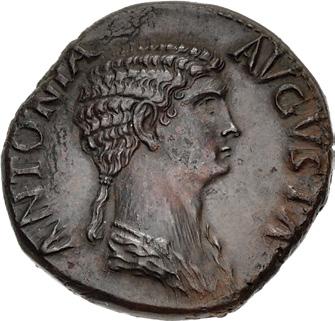
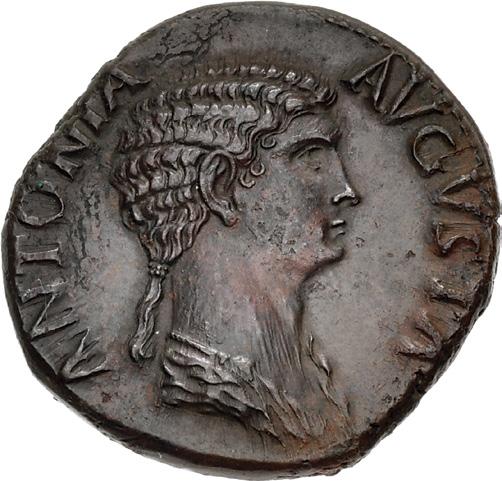
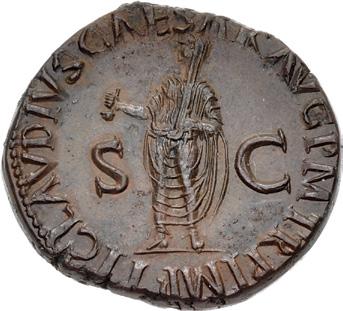
660. Antonia Minor. Augusta, AD 37 and 41. Æ Dupondius (27.5mm, 14.24 g, 7h). Rome mint. Struck under Claudius, AD 41-42. Draped bust right / Claudius, veiled and togate, standing left, holding simpulum and volumen. RIC I 92 (Claudius); von Kaenel Type 59. Red-brown patina, edge smoothing. EF. ($1000)
From the Wild Rose Collection. Ex Edward J. Waddell inventory 53775 (14 August 2019); Künker 295 (25 September 2017), lot 690 (hammer €1900); Leu 59 (17 May 1994), lot 254.
Pedigreed to 1911

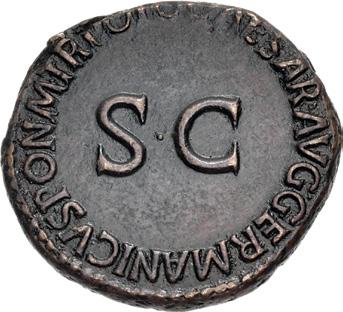
661. Germanicus. Died AD 19. Æ As (28.5mm, 11.42 g, 6h). Rome mint. Struck under Gaius (Caligula), AD 37-38. Bare head left / Legend around large S • C. RIC I 35 (Gaius). Handsome brown patina, smoothing. Good VF. ($750)
From the Wild Rose Collection. Ex B.G. Collection (Classical Numismatic Group 114, 13 May 2020), lot 739; Dr. Walter Stoecklin (†1975) Collection (Nomos Obolos 9, 25 March 2018), lot 166; Hess (22 May 1935), lot 452; J. Hirsch XXX (11 May 1911), lot 888.
Pedigreed to 1950

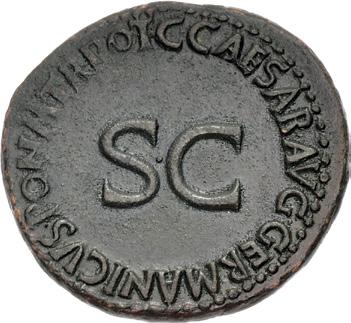
662. Germanicus. Died AD 19. Æ As (28.5mm, 11.44 g, 6h). Rome mint. Struck under Gaius (Caligula), AD 37-38. Bare head left / Legend around large S • C. RIC I 35 (Gaius). Dark brown and green patina. EF. Wonderful portrait. ($500)
Ex Jürgen K. Schmidt Collection (Classical Numismatic Group 61, 25 September 2002), lot 1631; Elsen 58 (12 June 1999), lot 1196; Kunst und Münzen XX (8 November 1979), lot 31; Canessa & Nicola FPL (December 1950), no. 167.
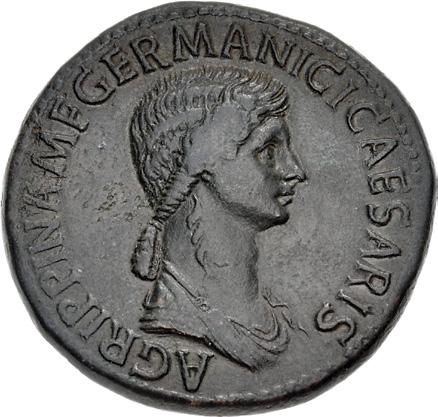
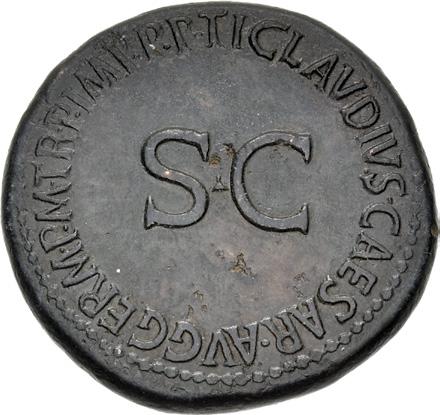
663. Agrippina Senior. Died AD 33. Æ Sestertius (36mm, 28.26 g, 6h). Rome mint. Struck under Claudius, AD 42-43. Draped bust right / Legend around large S • C. RIC I 102 (Claudius); von Kaenel Type 78. Green-brown patina, smoothing. Good VF. ($750)
From the Wild Rose Collection. Ex Praefectus Coins inventory ROS3483 (May 2017); Naville Numismatics 29 (26 February 2017), lot 598; Numismatica Ars Classica 84 (20 May 2015), lot 1769.
178
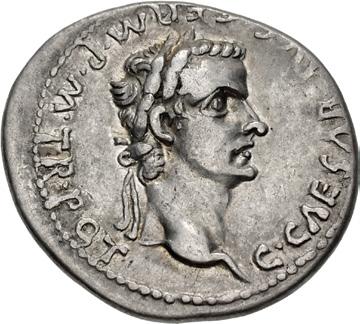
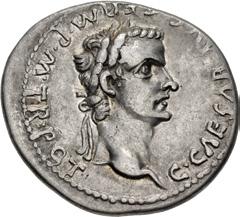
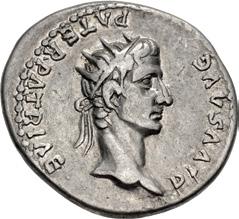
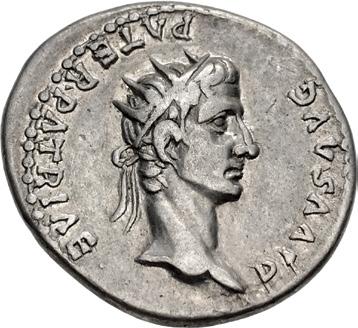
664. Gaius (Caligula), with Divus Augustus. AD 37-41. AR Denarius (19mm, 3.72 g, 4h). Lugdunum (Lyon) mint. 2nd emission, 2nd phase, late AD 37-early 38. Laureate head of Gaius (Caligula) right / Radiate head of Divus Augustus right. RIC I 16 (Rome); Lyon 167; RSC 2. Lightly toned. VF. ($2000)
From the Wild Rose Collection, purchased from Calgary Coin Gallery, November 2008.
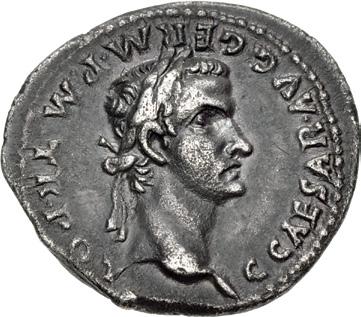
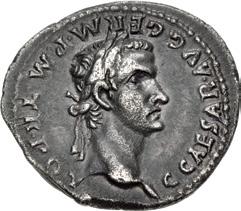
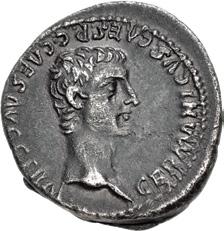

665. Gaius (Caligula), with Germanicus. AD 37-41. AR Denarius (20mm, 3.51 g, 9h). Lugdunum (Lyon) mint. 2nd emission, 1st phase, late AD 37. Bare head of Gaius (Caligula) right / Bare head of Germanicus right. RIC I 12 (Rome mint); Lyon 165 (unlisted dies); RSC 4 (Caligula and Germanicus). Deep old cabinet tone with a hint of porosity, small patch of smoothing in obverse field. Good VF. ($3000)
From the CJR Collection.
Three Sisters Sestertius
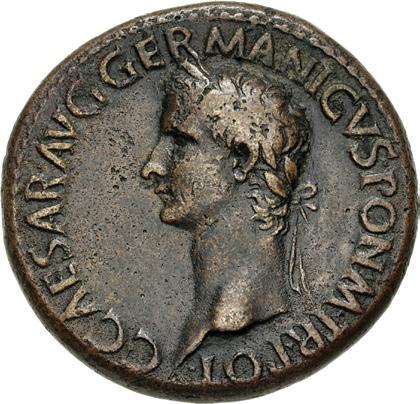
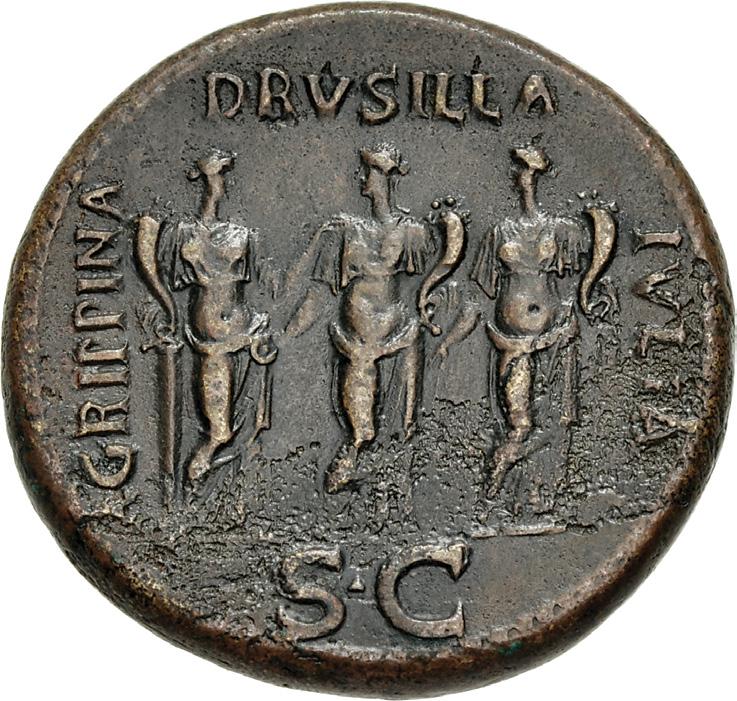

666. Gaius (Caligula). AD 37-41. Æ Sestertius (34mm, 27.91 g, 6h). Rome mint. Struck AD 37-38. Laureate head left / Gaius’ three sisters standing facing: Agrippina (as Securitas), head right, holding cornucopia and leaning on column, placing hand on shoulder of Drusilla (as Concordia), head left, holding patera and cornucopia; on right, Julia (as Fortuna), head left, holding rudder and cornucopia. RIC I 33. Brown surfaces, areas of pitting. Good VF. ($1500)
From the collection of a Gentleman, Kent, England.
179
667.

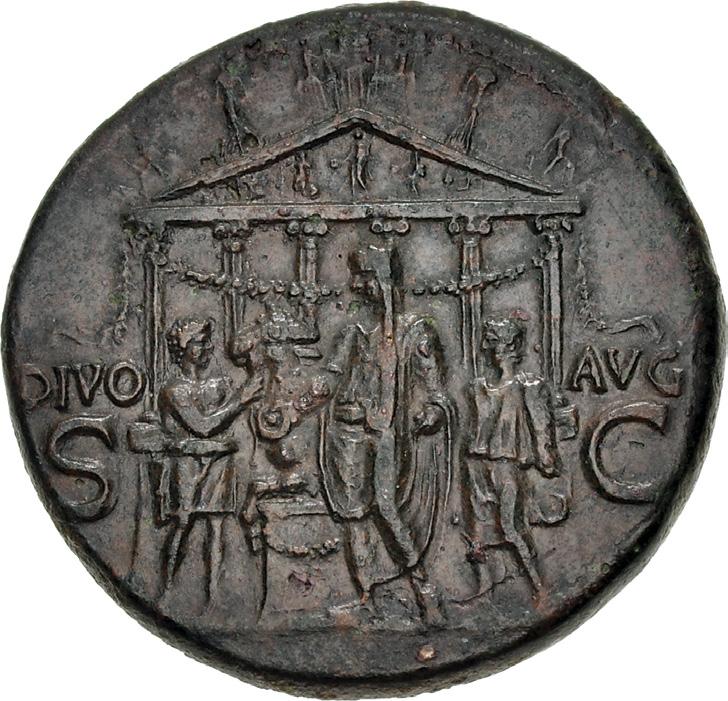
37-41.
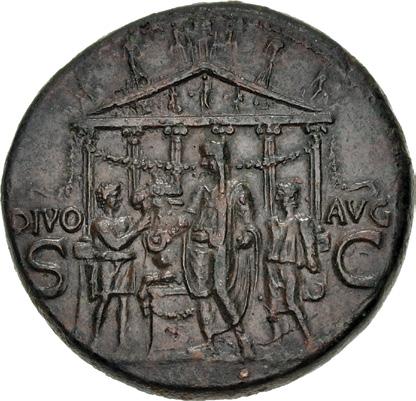
37-38.
Good VF. The reverse exhibits an artistic composition. ($1500)
From the Wild Rose Collection. Ex Numismatica Ars Classica 78 (26 May 2014), lot 2114; Gorny & Mosch 107 (2 April 2001), lot 354.
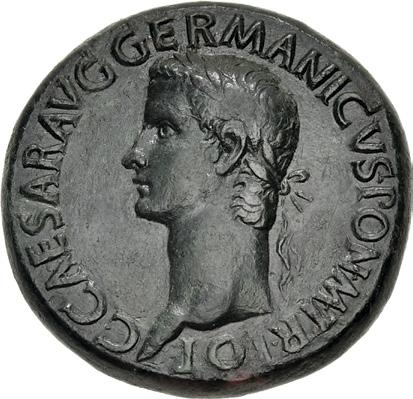
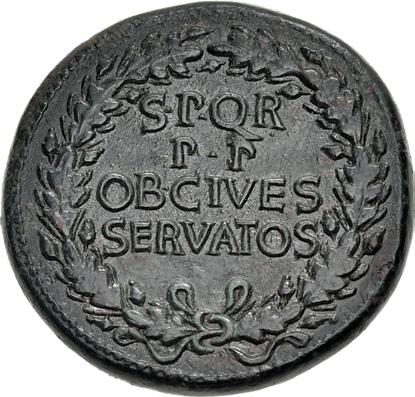
668. Gaius (Caligula). AD 37-41. Æ Sestertius (34mm, 27.83 g, 6h). Rome mint. Struck AD 37-38. Laureate head left / S • P • Q • R/ P • P/ OB • CIVES/ SERVATOS in four lines within oak wreath. RIC I 37. Dark green patina, light cleaning scratches and smoothing. Near EF. ($1500)
From the Wild Rose Collection, purchased from H. D. Rauch, 2005.

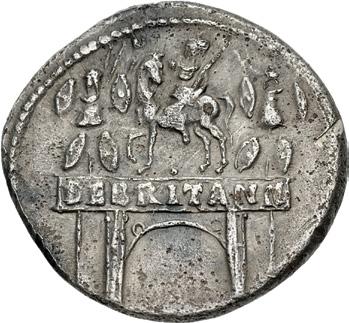
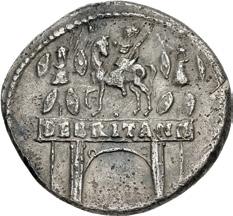
669. Claudius. AD 41-54. AR Denarius (19mm, 3.55 g, 6h). Lugdunum (Lyon) mint. Struck AD 46-47. Laureate head right / DE BRITANN on architrave of triumphal arch surmounted by equestrian statue left between two trophies. RIC I 34; von Kaenel Type 27 (unlisted dies); Lyon 53 (unlisted dies); RSC 18; SCBC 634. Toned, light porosity, some hairlines. VF. ($1000)
From the Dr. Malcolm Lyne Collection, purchased from Sovereign Rarities, 17 October 2016.
180
Gaius (Caligula). AD
Æ Sestertius (33.5mm, 26.87 g, 6h). Rome mint. Struck AD
Pietas seated left, holding patera and resting arm on small draped figure standing facing on basis / Gaius (Caligula) standing left, holding patera over altar; on either side, victimarius, holding bull for sacrifice, and attendant, holding patera; hexastyle, garlanded temple of Divus Augustus in background. RIC I 36; Elkins, Monuments Figure 70. Dark green and brown patina, smoothing.
Roman Conquest of Britain
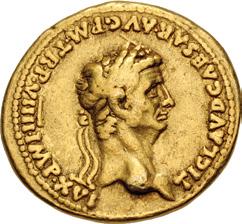
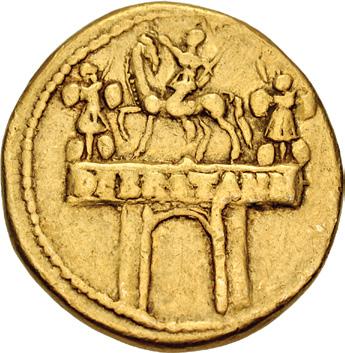
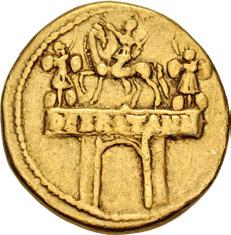
670. Claudius. AD 41-54. AV Aureus (20mm, 7.81 g, 4h). Lugdunum (Lyon) mint. Struck AD 49-50. Laureate head right / DE BRITANN on architrave, triumphal arch, surmounted by an equestrian statue of Claudius left, between two trophies. RIC I 44; von Kaenel Type 31, – (V558/R567 – [unlisted die marriage]); Lyon 60; Calicó 351; BMCRE 49 (same rev. die); BN –; cf. SCBC 633 (for rev. type). Toned, minor edge scrape on reverse. Fine. Rare. The reverse celebrates the Roman conquest of Britain, which began in AD 43. ($2000)
From the Dr. Malcolm Lyne Collection. Ex Baldwin’s FPL (Winter 2013-2014), no. AR039.
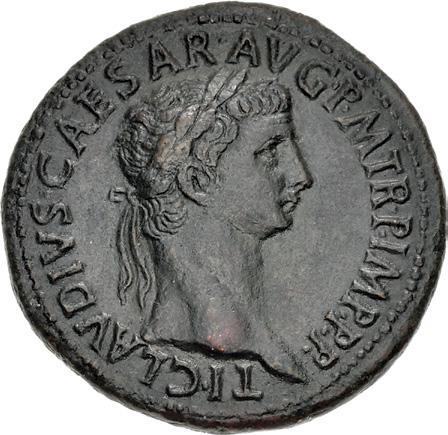
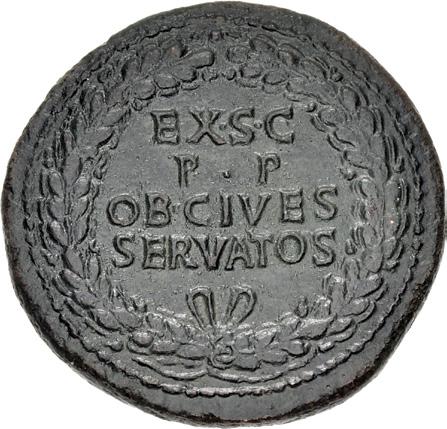
671. Claudius. AD 41-54. Æ Sestertius (36.5mm, 25.75 g, 6h). Rome mint. Struck AD 42-43. Laureate head right / EX • S • C/ P • P/ OB • CIVES/ SERVATOS in four lines within oak wreath. RIC I 112; von Kaenel Type 69. Green surfaces. Good VF. ($1000)
From the Wild Rose Collection, purchased from Pars Coins, March 2017.
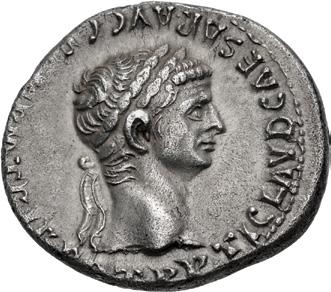

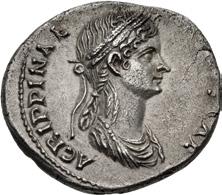
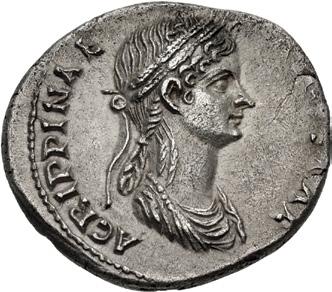
672. Claudius, with Agrippina Junior. AD 41-54. AR Denarius (18mm, 3.60 g, 6h). Rome mint. Struck AD 51. Laureate head of Claudius right / Draped bust of Agrippina right, wearing wreath of grain ears. RIC I 81; von Kaenel Type 50 (unlisted dies); RSC 4. Toned, granular surfaces. Near EF. Two excellent portraits. ($2500)
From the Wild Rose Collection. Ex Numismatica Ars Classica 125 (23 June 2021), lot 633; Vecchi 16 (9 October 1999), lot 413.
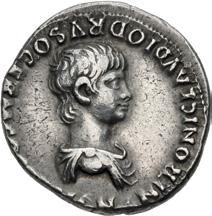
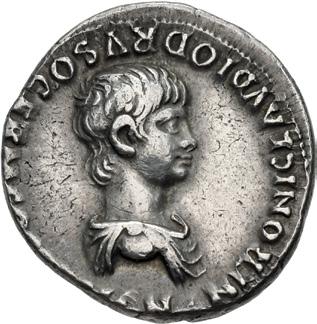
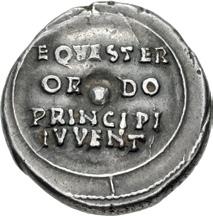
673. Nero. As Caesar, AD 50-54. AR Denarius (17mm, 3.71 g, 6h). Rome mint. Struck under Claudius, AD 51. Young bareheaded and draped bust right / EQVESTER/OR DO/PRINCIPI/IVVENT in four lines on a shield; behind it, a vertical spear, pointing upward. RIC I 79 (Claudius); von Kaenel Type 53 (unlisted dies); RSC 97. Deep cabinet tone, slightly off center, minor die wear on reverse. Good VF. ($750)
181
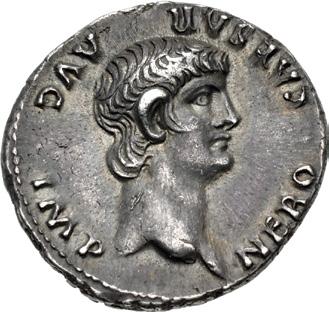
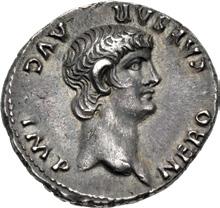
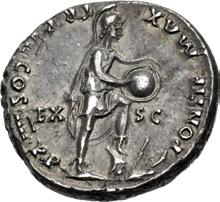
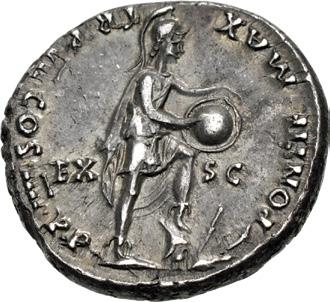
674. Nero. AD 54-68. AR Denarius (18mm, 3.67 g, 8h). Lugdunum (Lyon) mint. Struck AD 60-61. Youthful bare head right / Roma standing right, holding and inscribing shield supported on knee, foot on helmet; dagger and bow at feet to right. RIC I 28; Lyon 28 (unlisted dies); RSC 222. Lovely old cabinet toning, contact mark on obverse under tone. Near EF. ($3000)
From the Wild Rose Collection. Ex Gasvoda Collection (Part II, Numismatica Ars Classica 94, 6 October 2016), lot 116; C.K. Collection (Triton XIV, 4 January 2011), lot 653; Classical Numismatic Group XXXII (7 December 1994), lot 361; Numismatica Ars Classica 7 (2 March 1994), lot 691.
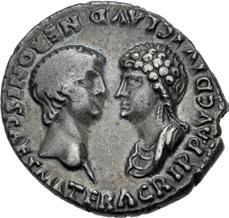
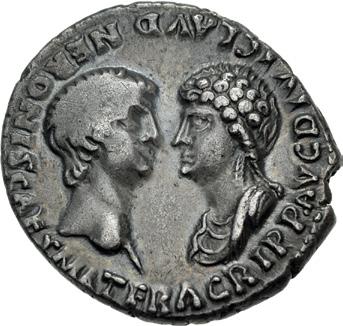
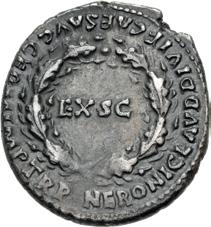
675. Nero, with Agrippina Junior. AD 54-68. AR Denarius (18mm, 3.56 g, 7h). Rome mint. Struck circa OctoberDecember AD 54. Bare head of Nero right, facing draped bust of Agrippina Junior left / Legend within oak wreath. RIC I 2; RSC 7. Old collection toning, area of flat strike. VF. Rare. ($2000)
Ex Libertas Collection, purchased 14 December 1980; Frederick S. Knobloch Collection (Stack’s, 1 May 1980), lot 192.
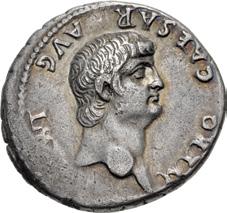

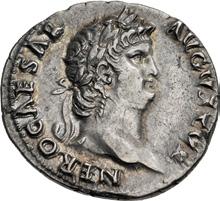

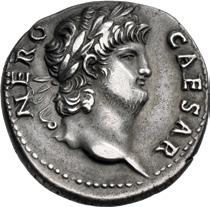

676. Nero. AD 54-68. AR Denarius (19mm, 3.38 g, 12h). Rome mint. Struck AD 60-61. Youthful bare head of Nero right / [PON]TIF • MAX • TR • P • VII • COS • IIII • P • [P] around oak wreath enclosing EX • S C. RIC I 22; RSC 216. Areas of flat strike, enhanced details in hair. Good VF. Beautiful old cabinet tone. ($750)
Ex Peter Corcoran Collection; Berk BBS 198 (7 July 2016), lot 202; Lanz 138 (26 November 2007), lot 577.
677. Nero. AD 54-68. AR Denarius (18mm, 3.42 g, 6h). Rome mint. Struck circa AD 64-65. Laureate head right / Nero, holding patera and scepter, and Messalina, holding patera and cornucopia, standing left. RIC I 45; RSC 43. Lightly toned with traces of luster, slight die shift on obverse. Good VF. ($1000)
From the Wayne Scheible Collection. Ex Numismatica Ars Classica 29 (11 May 2005), lot 481 (hammer CHF 3000).
678. Nero. AD 54-68. AR Denarius (17mm, 3.22 g, 6h). Rome mint. Struck circa AD 64-65. Laureate head right / Nero standing facing, radiate and togate, holding branch and Victory on globe. RIC I 47; RSC 45. Attractive toning. Near EF. Fantastic portrait. ($1500)
Ex Prof. David R. Beatty Collection (Classical Numismatic Group 114, 13 May 2020), lot 761; CNG Inventory 717644 (December 1999).
The reverse depicts Nero’s Colossus, a roughly 120 foot tall bronze statue of the emperor as Sol that was created by Zenodorus for the vestibule of the Domus Aurea, or Golden House, the massive palace constructed by Nero after the fire of AD 64. Hadrian moved Zenodorus’ work, by this point altered so that it no longer represented Nero, closer to the Flavian Amphitheater. The sculpture’s memory was retained in the popular name of that amphitheater - the Colosseum.
182
676
677
678

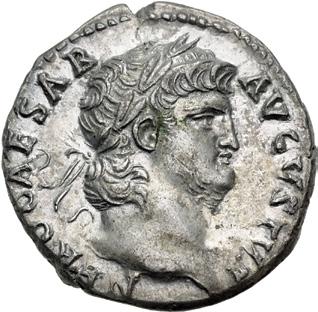

679. Nero. AD 54-68. AR Denarius (17mm, 2.98 g, 6h). Rome mint. Struck circa AD 64-65. Laureate head right / Jupiter seated left on throne, holding thunderbolt and scepter. RIC I 53; RSC 119. Lustrous, minor marks. Near EF. ($1000)
Ex Weise Collection; Marian A. Sinton Collection (Triton III, 30 November 1999), lot 1008.
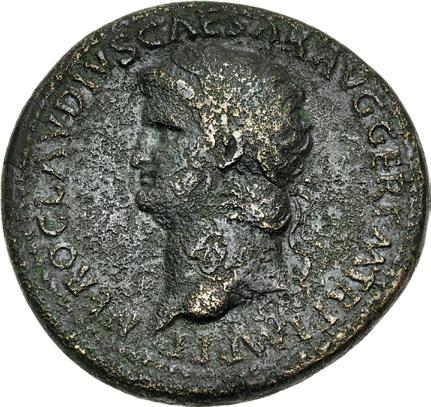

680. Nero. AD 54-68. Æ Sestertius (35.5mm, 26.81 g, 6h). Rome mint. Struck circa AD 64. Laureate head left / Port of Ostia: eleven ships within the harbor; at the top is a pharus surmounted by a statue of Neptune; below is a reclining figure of Tiber, holding a rudder and dolphin; to left, crescent-shaped pier with portico, terminating with figure sacrificing at altar and with building; to right, crescent-shaped row of breakwaters or slips, terminating with a figure seated on rock. RIC I 182; WCN 113; cf. Elkins, Monuments Figure 83 (for rev. type); Heritage 3032, lot 23914 (same dies). Dark green surfaces, roughness and pitting. VF. ($1500)
While Julius Caesar recognized the value of expanding Rome’s port facilities at Ostia, it was Claudius who began actual building in AD 42. As part of the construction, one of Caligula’s pleasure galleys was scuttled and filled with cement; above it was constructed a lighthouse surmounted by a statue of Neptune. Although the actual date of completion is not certain, it must have occurred shortly before this sestertius was minted. A further expansion of the facilities was required under Trajan and Hadrian. By the fourth century, however, the port’s importance began to diminish as a result of silting. Soon the region became a breeding ground for malaria and was abandoned.
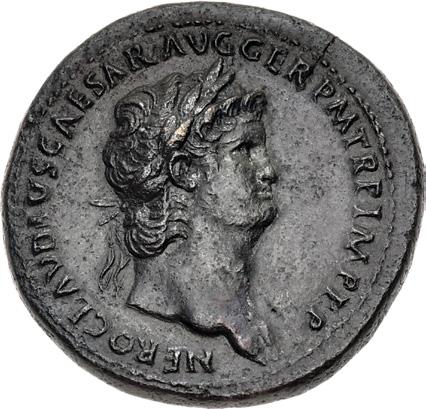

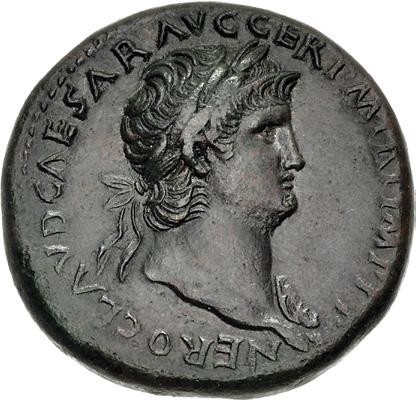
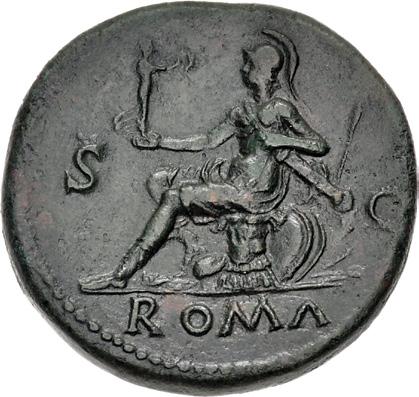
681. Nero. AD 54-68. Æ Sestertius (35mm, 25.44 g, 6h). Rome mint. Struck circa AD 65. Laureate bust right, wearing aegis / Temple of Janus with latticed windows to left and garland hung across closed double doors to right. RIC I 266; WCN 139; Elkins, Monuments Figure 77. Dark brown patina, smoothing, minor porosity. Good VF. ($1000)
From the Wild Rose Collection. Ex Lanz 158 (5 June 2014), lot 495.
682. Nero. AD 54-68. Æ Sestertius (34mm, 27.40 g, 6h). Rome mint. Struck circa AD 65. Laureate bust right, wearing aegis / Roma seated left on cuirass, holding Victory and parazonium; shields to right. RIC I 273; WCN 145. Dark green and red patina, minor smoothing. Near EF. ($1000)
From the Wild Rose Collection, purchased from Calgary Coin Gallery, October 2001.
183
681
682

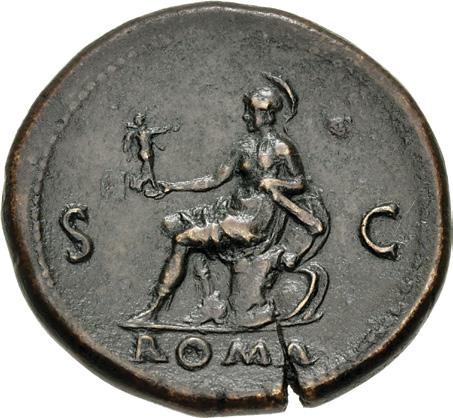
683. Nero. AD 54-68. Æ Sestertius (37mm, 28.46 g, 6h). Rome mint. Struck circa AD 65. Laureate head right / Roma seated left on cuirass, foot on helmet, holding Victory and resting hand on parazonium; shields to right. RIC I 273 var. (aegis); WCN 145 var. (same). Green-brown patina, edge split. Good VF. Attractive. ($750)
From the collection of a Gentleman, Kent, England.
An Impressive Nero Aureus Pedigreed to 1961 – Illustrated in CNR
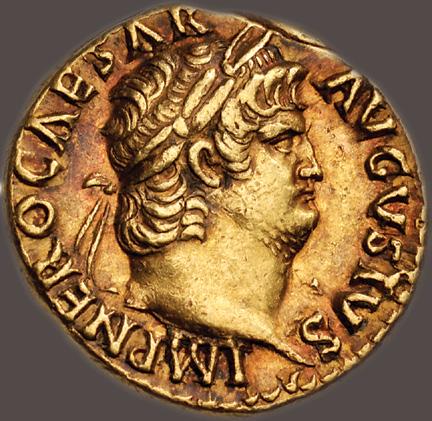



684. Nero. AD 54-68. AV Aureus (18mm, 7.32 g, 5h). Rome mint. Struck circa AD 66-67. IMP NERO CAESAR AVGVSTVS, laureate head right / IVPPITER CVSTOS, Jupiter, bare to waist, cloak around lower limbs, seated left on throne, holding thunderbolt in right hand, scepter in left. RIC I 63; WCN 30; Calicó 413; BMCRE 77-9; BN 231-2; Adda 32; Biaggi 227-8; Mazzini 120 and 120*; CNR XVI 73/1 (this coin). Attractive violet-red toning, characteristic of aurei from Boscoreale. Good VF. ($7500)
From the Wild Rose Collection. Ex Numismatica Ars Classica 114 (6 May 2019), lot 621; Coppens Collection (Bourgey, 6 December 1961), lot 27. Possibly from the Boscoreale Hoard of 1895.
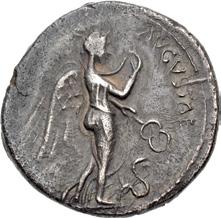


685. Civil War. AD 68-69. AR Denarius (18mm, 4.12 g, 5h). ‘S P Q R Group’. Uncertain mint in Gaul or Rhine Valley. Struck May-December AD 68. [PACI] AVGVSTAE, Pax-Nemesis, winged, standing right, holding winged caduceus in left hand and holding out fold of drapery with her right, snake at feet / S P Q R enclosed within oak wreath, jewel at top. BMC 26 and pl. 50, 14; Martin 81 and pl. 8, 81 L = Nicolas 63 and pl. II, 63 BR = RIC I 56 (same dies). Deeply toned, minor areas of weakness. Good VF. Extremely rare; one of two known specimens, and by far the finer. ($1500)
Ex Dipl.-Ing. Christian Gollnow Collection (Leu Numismatik 9, 24 October 2021), lot 1116; Künker 182 (14 March 2011), lot 590.
184


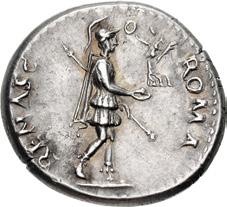
686. Galba. AD 68-69. AR Denarius (18mm, 3.58 g, 6h). Uncertain Spanish mint (Tarraco?). Struck circa April to late AD 68. Laureate head right, globe at point of neck / Roma, helmeted and in military dress, advancing right, holding Victory on globe and transverse spear. RIC I 57; CSB 46; RSC 197. Light iridescent tone. Near EF. Very rare. Exceptional for the type. ($1500)
Ex Roma XXV (22 September 2022), lot 968; Áureo & Calicó 252 (28 May 2013), lot 39.
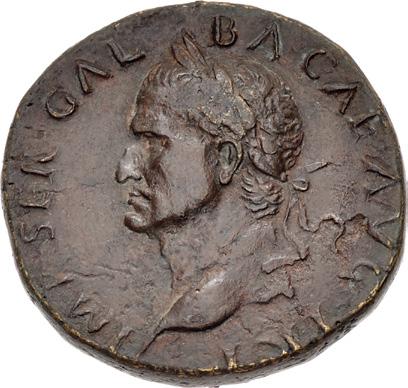
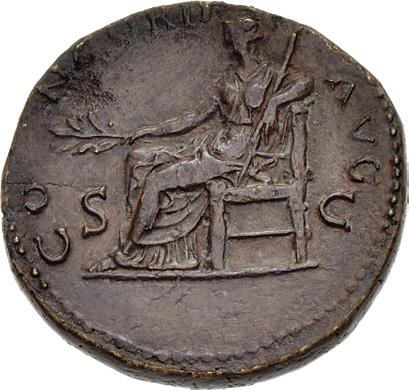
687. Galba. AD 68-69. Æ Sestertius (33mm, 26.20 g, 6h). Rome mint, 2nd officina. Struck circa October AD 68. Laureate head left / Concordia seated left on throne, holding olive branch and transverse scepter. RIC I 339; ACG 106 (A62/P227). Brown surfaces, applied patina delaminating, light corrosion. Good VF. Impressive portrait. ($1000)
From the Wild Rose Collection. Ex G. Hirsch 346 (13 February 2019), lot 2534 (hammer €3000).
Ex Rashleigh Collection – Pedigreed to 1953

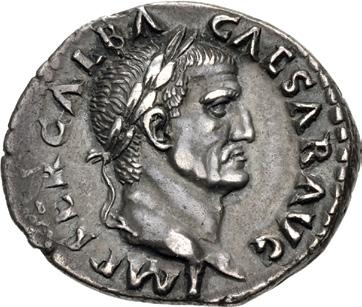
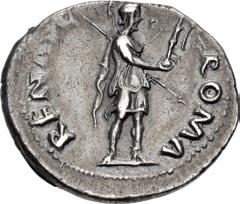
688. Galba. AD 68-69. AR Denarius (20mm, 3.42 g, 6h). Rome mint. Struck circa July AD 68-January 69. Laureate head right / Roma standing right, holding Victory and transverse scepter. RIC I 199; RSC 200. Rich cabinet toning. EF. Bold portrait. ($1500)
From the Wild Rose Collection. Ex Galba Collection (Hess-Divo 333, 30 November 2017), lot 148; Leu 71 (24 October 1997), lot 321; J. C. S. Rashleigh Collection (Part I, Glendining, 14 January 1953), lot 505.
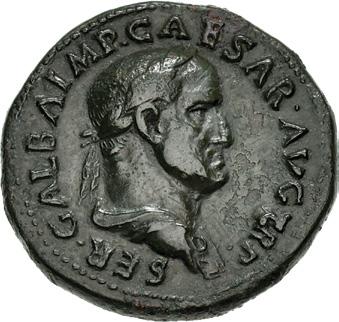

689. Galba. AD 68-69. Æ Dupondius (27.5mm, 14.50 g, 6h). Rome mint. Struck circa October AD 68. Laureate and draped bust right / Felicitas standing left, holding caduceus and cornucopia. RIC I 412; ACG –. Attractive glossy dark green patina, smoothing, minor cleaning marks. Good VF. Rare. Only two examples in CoinArchives. ($750)
From the collection of a Gentleman, Kent, England, purchased from Baldwin’s, 30 January 2014.
185

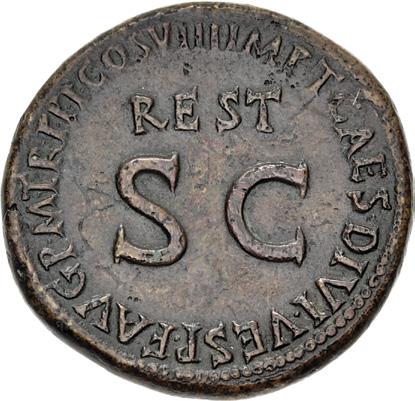
690. Galba. AD 68-69. Æ Sestertius (34mm, 24.52 g, 6h). Restitution issue. Rome mint. Group I 1 under Titus, AD 80-81. Laureate head of Galba right / IMP T CAES DIVI VESP F AVG P M TR P P P COS VIII, REST above S C in center. RIC II.1 421 (Titus); Komnick Type 13.0, 19 (V10/R11 – this coin referenced); Mazzini 350 (this coin). Brown patina, minor smoothing, cleaning scratches, edge marks, some pitting. VF. ($750)
Ex Historical Scholar Collection (Heritage 61297, 23 October 2022), lot 98218, purchased from Joel Malter, 1 June 1973; Peus 271 (25 November 1969), lot 125; Giuseppe Mazzini Collection (publ. 1957).
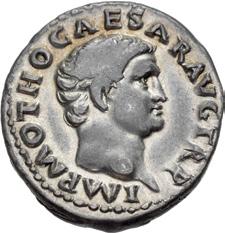
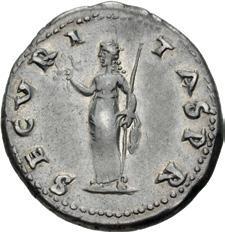
691. Otho. AD 69. AR Denarius (18mm, 3.70 g, 6h). Rome mint. Struck 15 January–8 March. Bare head right / Securitas standing left, holding wreath and scepter. RIC I 8; Muona Group 1, Type 4B, Portrait Type A; RSC 17. Iridescent tone, minor marks, faint hairlines. VF. Complete legends on a broad flan, desirable as such. ($1000)
From the I.L. Collection. Ex Künker eLive 19 (26 June 2013), lot 402; Künker 153 (14 March 2009), lot 8653.
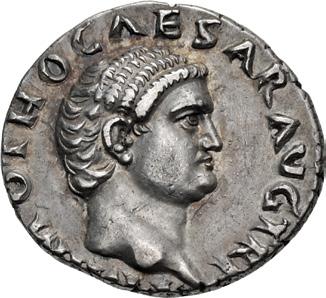
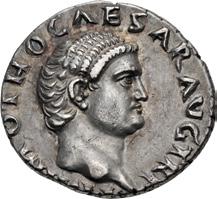
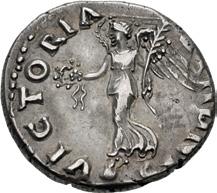

692. Otho. AD 69. AR Denarius (18mm, 3.33 g, 5h). Rome mint. Struck 15 January-8 March. Bare head right / Victory advancing left, holding wreath and palm frond. RIC I 16; Muona Group 1, Type 2B, Portrait Type A; RSC 24. Attractive toning, some iridescence, shallow edge test cut. Good VF. Wonderful portrait. ($3000)
From the Wild Rose Collection. Ex Galba Collection (Hess-Divo 333, 30 November 2017), lot 156; New York Sale III (7 December 2000), lot 628.
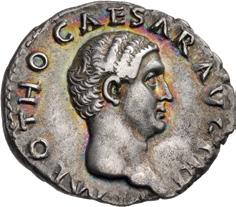


693. Otho. AD 69. AR Denarius (19.5mm, 3.50 g, 6h). Rome mint. Struck 9 March-mid April. Bare head right / Jupiter seated right on throne, holding thunderbolt and scepter. RIC I 21; Muona Group 3, Type 13B; RSC 8. Iridescent toning. VF. Struck on a very broad flan. Rare reverse type. ($1500)
From the Wayne Scheible Collection. Ex Numismatica Ars Classica 46 (2 April 2008), lot 1003.
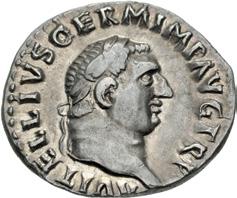
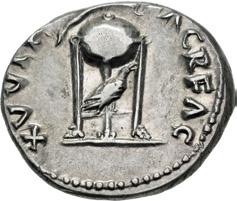
694. Vitellius. AD 69. AR Denarius (18.5mm, 3.44 g, 6h). Rome mint. Struck circa late April-20 December. Laureate head right / Tripod-lebes surmounted by dolphin right; below, raven perched right. RIC I 109; RSC 111. Lightly toned and lustrous, slight flatness on the high points. Good VF. ($500)
Ex New York Sale LIV (11 January 2022), lot 243.
186
Ex Mazzini Collection – Published in 1957

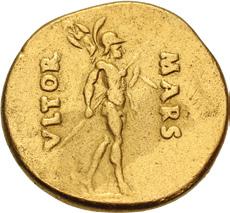
695. Vespasian. AD 69-79. AV Aureus (18mm, 7.03 g, 6h). Uncertain Spanish mint (Tarraco?). Struck circa late AD 6970. Laureate head right / Mars Ultor advancing right, holding transverse spear and trophy over shoulder. RIC II.1 1297; CSB Au-2 (dies A2/Rma3); Calicó 651 (same dies as illustration). Slightly granular surfaces. VF. ($2000)
Ex Libertas Collection; Superior (19 August 1975), lot 3062.
Rare Spanish Mint Issue – CSB Plate Coin
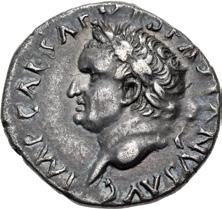
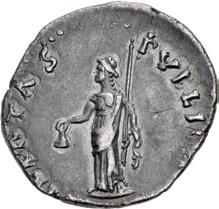
696. Vespasian. AD 69-79. AR Denarius (18.5mm, 3.08 g, 7h). Uncertain Spanish mint. Struck circa AD 69-70. Laureate head left / Libertas standing left, holding pileus and vindicta. RIC II.1 1339; CSB D-10.9 (dies A10/Rli3 – this coin, illustrated); ACIP 4298; RSC 259b. Attractive gray and iridescent blue toning, faint hairlines, flan crack. Good VF. Rare Spanish mint issue. ($500)
From the Wild Rose Collection. Ex Áureo & Calicó 379 (15 December 2021), lot 1160; Harry N. Sneh Collection (Gemini IX, 8 January 2012), lot 409; Classical Numismatic Group 63 (21 May 2003), lot 1273; Lanz 112 (25 November 2002), lot 376.
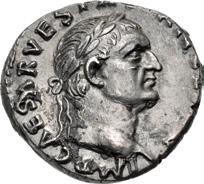

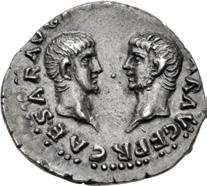
697. Vespasian, with Titus and Domitian as Caesares. AD 69-79. AR Denarius (17mm, 3.10 g, 6h). Dynastic issue. Rome mint. Struck January-June AD 70. Laureate head of Vespasian right / Confronted bare heads of Titus right and Domitian left. RIC II.1 16; RSC 5; Leu 18, lot 308 (same dies). Toned, remnants of find patina, deposits, die break on obverse, minor scratches, flan flaw on edge. Near EF. ($750)
From the GS Collection. Ex Dr. Walter Stoecklin (†1975) Collection (Nomos 14, 17 May 2017), lot 343.

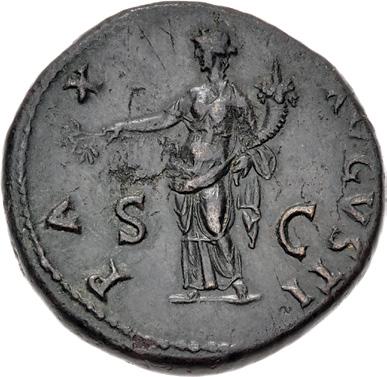
698. Vespasian. AD 69-79. Æ Sestertius (31.5mm, 26.23 g, 5h). Rome mint. Struck AD 71. Laureate head right / Pax standing left, holding olive branch and cornucopia. RIC II.1 243. Green-brown patina, a few flan flaws. Good VF. ($500)
From the Wild Rose Collection. Ex Münzen und Medaillen AG 76 (19 September 1991), lot 864.
187
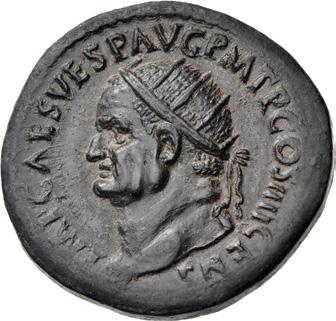
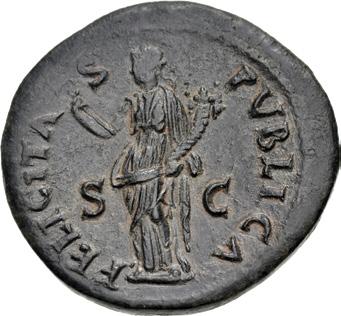
699. Vespasian. AD 69-79. Æ Dupondius (27.5mm, 11.93 g, 6h). Rome mint. Struck AD 73. Radiate head left / Felicitas standing left, holding caduceus and cornucopia. RIC II.1 581. Dark green-brown patina, earthen highlights, a hint of smoothing on obverse. Near EF. ($500)
From the Wild Rose Collection. Ex Jack A. Frazer Collection (Classical Numismatic Group Electronic Auction 460, 29 January 2020), lot 619; Victor England BBS XI.1 (17 February 1986), lot 84.
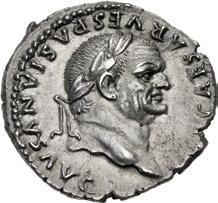

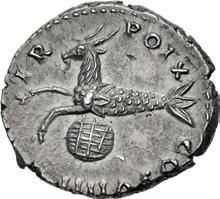
700. Vespasian. AD 69-79. AR Denarius (18mm, 3.39 g, 6h). Rome mint. Struck AD 79. Laureate head right / Capricorn left; globe below. RIC II.1 1058; RSC 554. Lightly toned. EF. ($750)
From the Wild Rose Collection. Ex Áureo & Calicó 300 (9 November 2017), lot 30; Tkalec (29 February 2000), lot 246; Triton I (2 December 1997), lot 1361; Classical Numismatic Group 41 (19 March 1997), lot 1825; Classical Numismatic Group 38 (6 June 1996), lot 931; Dr. John Jacobs Collection (Superior, 13 August 1995), lot 760; Numismatic Fine Arts XX (9 March 1988), lot 146; Numismatic Fine Arts XII (23 March 1983), lot 224.
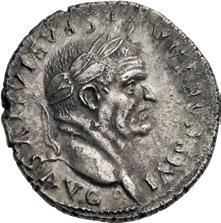

701. Vespasian. AD 69-79. AR Denarius (18mm, 3.06 g, 12h). Ephesus mint. Struck AD 76. Laureate head right; small annulet (‘o’) below neck truncation / Winged caduceus. RIC II.1 1477; RPC II 1453; RSC 375a. Toned, some roughness. VF. ($500)
From the Wild Rose Collection, purchased from Ancient Resource, 6 February 2009.
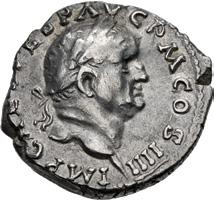

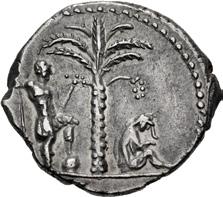
702. Vespasian. AD 69-79. AR Denarius (18mm, 3.43 g, 6h). “Judaea Capta” commemorative. Antioch mint. Struck AD 72-73. Laureate head right / Palm tree; to left, Vespasian standing right, holding spear and parazonium, left foot on helmet; to right, Judaea, in attitude of mourning, seated right. RIC II.1 1558; Hendin 6520; RPC II 1930; RSC 645. Lightly toned, struck with a worn obverse die. Good VF. ($1000)
From the Wild Rose Collection. Ex Dr. Jay M. Galst Collection (Triton XXV, 11 January 2022), lot 842, purchased from Brian Kritt, 8 June 1996.
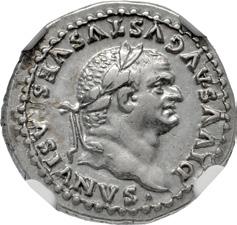
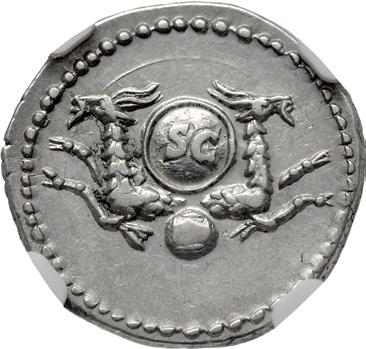
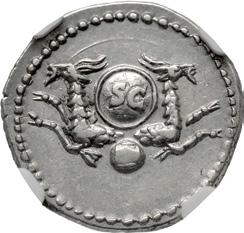
703. Divus Vespasian. Died AD 79. AR Denarius (19mm, 3.55 g, 6h). Rome mint. Struck under Titus, AD 80-81. Laureate head right / Foreparts of two capricorns, left and right, back to back, supporting round shield inscribed S C; globe below. RIC II.1 357; RSC 497. In NGC encapsulation 6827184-005, graded Ch XF, Strike: 5/5, Surface: 4/5. ($500)
188
Unique Aureus of Titus, as Caesar
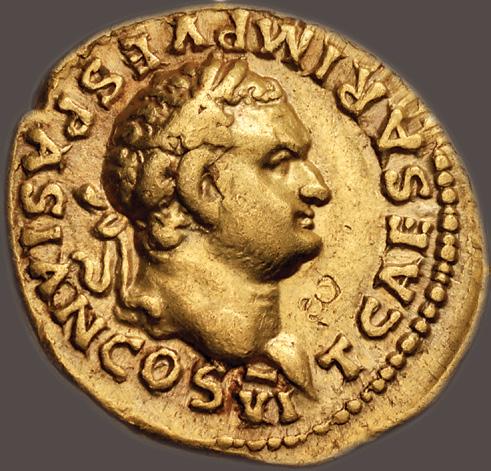


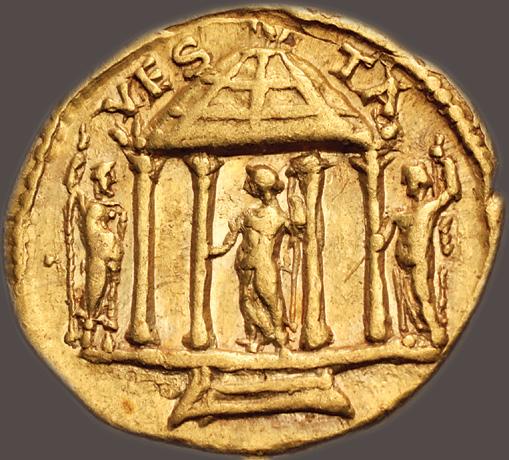
704. Titus. As Caesar, AD 69-79. AV Aureus (20mm, 7.36 g, 11h). Lugdunum (Lyon) mint(?). Struck under Vespasian, AD 77-78. T CAESAR IMP VESPASIAN COS VI, laureate head right / VES TA, Temple of Vesta: round-domed, tetrastyle temple with statue of Vesta, holding scepter in left hand, within, flanked by statue to right and left of temple, each holding a scepter. RIC II.1 –; Calicó –; BMCRE –; BN –. Minor scratches, shallow banker’s mark in field on obverse. VF. A completely new legend for Titus. Unique. ($7500)
Ex New York Sale XL (11 January 2017), lot 1218.
The obverse legend is apparently unique for this denomination, dating it to AD 77-78. The Temple of Vesta reverse is dated to AD 73 and 74. Therefore, this coin may represent a mule involving an otherwise unrecorded obverse die.

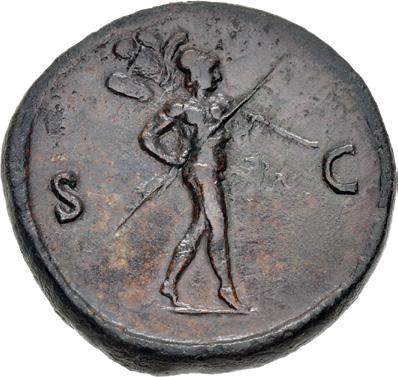
705. Titus. As Caesar, AD 69-79. Æ Sestertius (32mm, 26.98 g, 6h). Rome mint. Struck under Vespasian, 1 July AD 72–30 June 73. Laureate head right / Mars advancing right, holding spear and trophy. RIC II.1 500 (Vespasian). Red-brown patina, smoothed. Good VF. ($1000)
From the Wild Rose Collection. Ex Warden Numismatics inventory 4214V223V823 (ND); Classical Numismatic Group 105 (10 May 2017), lot 850.
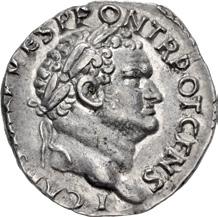

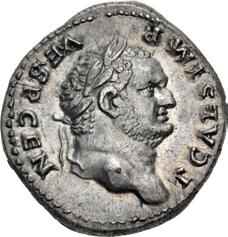

706. Titus. As Caesar, AD 69-79. AR Denarius (18mm, 3.49 g, 6h). Rome mint. Struck under Vespasian, AD 73. Laureate head right / Clasped right hands, holding two grain ears, two poppies, and a winged caduceus. RIC II.1 528 (Vespasian); RSC 87b. Lightly toned, minor scratches, traces of deposits. Near EF ($500)
From the GS Collection. Ex Numismatica Ars Classica P (12 May 2005), lot 1973.
707. Titus. As Caesar, AD 69-79. AR Denarius (19mm, 3.38 g, 12h). Rome mint. Struck under Vespasian, AD 73. Laureate head right / Titus seated right on curule chair, feet on footstool, holding scepter and branch. RIC II.1 553 (Vespasian); RSC 158a. Light iridescent toning, some deposits, scratches. Near EF ($500)
From the GS Collection. Ex Collection of a Perfectionist (Numismatica Ars Classica 106, 9 May 2018), lot 593; Gorny & Mosch 224 (13 October 2014), lot 488. 706 707
189
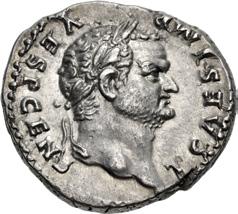
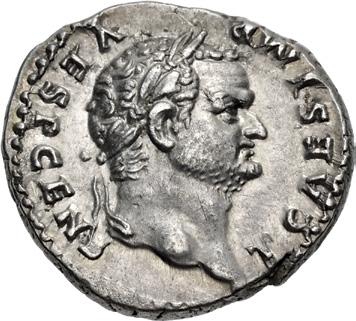
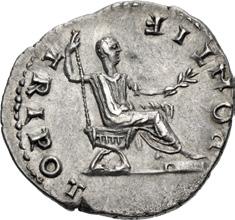
708. Titus. As Caesar, AD 69-79. AR Denarius (19.5mm, 3.30 g, 12h). Rome mint. Struck under Vespasian, AD 73. Laureate head right / Titus seated right on curule chair, feet on footstool, holding scepter and branch. RIC II.1 556; RSC 169. Lightly toned, minor scratches on reverse. Good VF. ($750)
From the GS Collection. Ex Numismatik Naumann 56 (6 August 2017), lot 553.

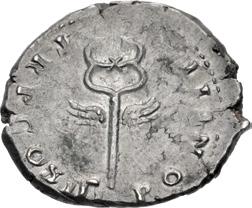
709. Titus. As Caesar, AD 69-79. AR Denarius (20mm, 3.27 g, 6h). Rome mint. Struck under Vespasian, AD 74. Laureate head right / Winged caduceus. RIC II.1 706; RSC 160. Toned with some iridescence, minor flan flaws, a few deposits. Near EF. ($500)
From the GS Collection. Ex CNG inventory 475391 (December 2017).

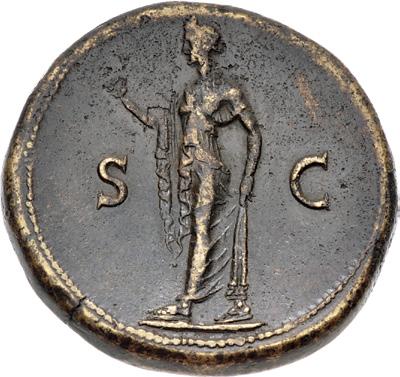
710. Titus. As Caesar, AD 69-79. Æ Sestertius (33mm, 26.36 g, 6h). Rome mint. Struck under Vespasian, AD 74. Laureate head right / Spes standing left, holding flower and raising hem of skirt. RIC II.1 739 (Vespasian). Brown patina, minor porosity, some scratches. VF. Rare. One of only four examples in CoinArchives. ($1500) Ex Classical Numismatic Group Electronic Auction 529 (14 December 2022), lot 639.
Calicó Plate Coin – Pedigreed to 1975
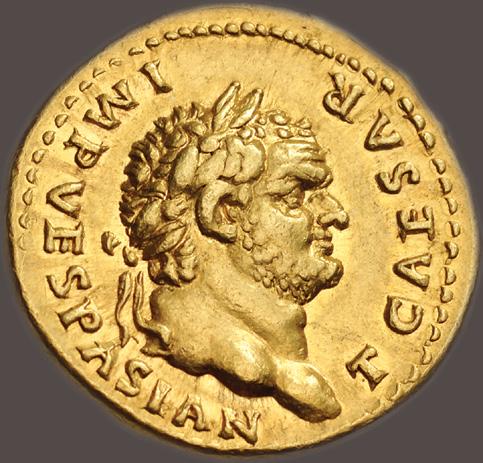

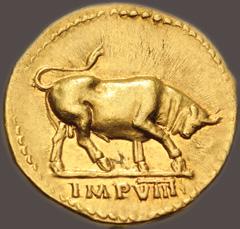

711. Titus. As Caesar, AD 69-79. AV Aureus (20mm, 7.34 g, 6h). Rome mint. Struck under Vespasian, AD 75. T CAESAR IMP VESPASIAN, laureate head right / IMP VIII in exergue, bull butting right, lashing his tail. RIC II.1 786 (Vespasian); Calicó 741 (this coin illustrated); BMCRE 175 (Vespasian – same rev. die); BN –; Biaggi –; Jameson –; Mazzini –. Lustrous, faint hairlines on obverse, small flan flaw on reverse. Near EF. Struck on a broad flan. ($10,000)
From the Jonathan K. Kern Collection. Ex Classical Numismatic Group 120 (11 May 2022), lot 805 (hammer $15,000); Giessener Münzhandlung 71 (3 May 1995), lot 645; Leu 13 (29 April 1975), lot 422.
190


712. Titus. As Caesar, AD 69-79. AR Denarius (20mm, 3.36 g, 6h). Rome mint. Struck under Vespasian, AD 75. Laureate head right / Pax seated left, holding olive branch and resting arm on armrest of throne. RIC II.1 783 (Vespasian); RSC 162. Deep iridescent toning, a few scratches on obverse under tone. EF ($750)
From the GS Collection. Ex Künker 295 (25 September 2017), lot 753; Leu 59 (17 May 1994), lot 261.
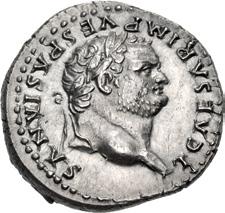
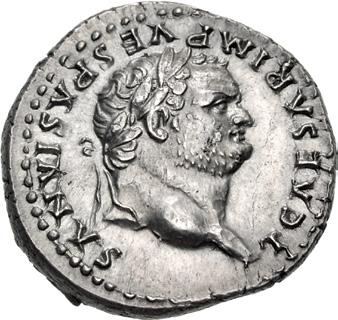
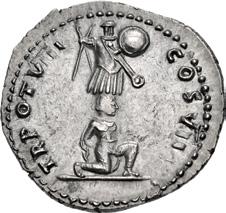
713. Titus. As Caesar, AD 69-79. AR Denarius (18mm, 3.59 g, 6h). “Judaea Capta” commemorative. Rome mint. Struck under Vespasian, AD 79 to 24 June. Laureate head right / Trophy; below, captive kneeling right. RIC II.1 1076 (Vespasian); Hendin 6516; RSC 334. Lightly toned, minor flan flaw on obverse, faint hairlines. EF ($1000)
From the GS Collection. Ex Áureo & Calicó 300 (9 November 2017), lot 33.
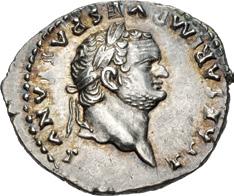
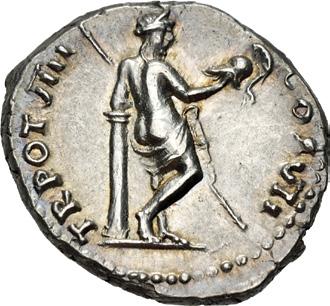
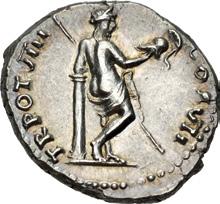
714. Titus. As Caesar, AD 69-79. AR Denarius (19mm, 3.50 g, 6h). Rome mint. Struck under Vespasian, AD 79, to 24 June. Laureate head right / Venus standing right, viewed half from behind, leaning on column, holding spear and helmet. RIC II.1 1078 (Vespasian); RSC 332. Wonderful iridescent toning, faint hairlines. Near EF. A pretty coin in hand. ($1500)
From the Wayne Scheible Collection. Ex Classical Numismatic Group 40 (in association with Numismatica Ars Classica, 4 December 1996), lot 1438.

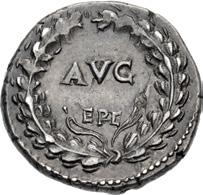
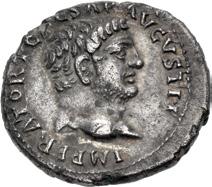
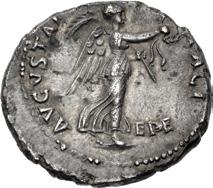
715. Titus. As Caesar, AD 69-79. AR Denarius (16.5mm, 3.34 g, 6h). Ephesus mint. Struck under Vespasian, AD 71. Laureate head right / AVG and E(PHE ligate) in two lines within oak wreath. RIC II.1 1436 (Vespasian); RPC II 841; RSC 23. Deep old cabinet toning, a few minor flan flaws, a couple of scratches on obverse under tone. VF. Rare. ($500)
From the GS Collection. Ex Numismatica Ars Classica 100 (29 May 2017), lot 1814.
716. Titus. As Caesar, AD 69-79. AR Denarius (17mm, 3.38 g, 6h). Ephesus mint. Struck under Vespasian, AD 71. Bare head right / Victory advancing right, holding palm frond and wreath; E(PHE ligate) to lower right. RIC II.1 1441 (Vespasian); RPC II 838; RSC 124. Iridescent toning, deposits, minor marks. Good VF. Very rare with bare head right. ($500)
From the GS Collection.

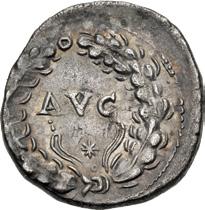

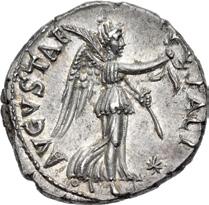
717. Titus. As Caesar, AD 69-79. AR Denarius (17mm, 3.25 g, 11h). Ephesus mint. Struck under Vespasian, AD 74. Laureate head right / AVG/ */ ° in three lines within oak wreath. RIC II.1 1459 (R2); RPC II 855; RSC 21. Toned, a couple of flan flaws. Good VF. Very rare, RPC II lists five examples. ($500)
From the Wild Rose Collection. Ex Rauch 94 (9 April 2014), lot 804.
718. Titus. As Caesar, AD 69-79. AR Denarius (17mm, 3.29 g, 12h). Ephesus mint. Struck under Vespasian, AD 74. Laureate head right / Victory advancing right, holding palm frond and wreath; ° to lower left; * to lower right. RIC II.1 1470 (Vespasian); RPC II 857; RSC 123. Light iridescent toning, some earthen deposits on reverse. Near EF. ($1000)
From the GS Collection. Ex Numismatica Ars Classica 78 (26 May 2014), lot 894; Harry N. Sneh Collection (Gemini IX, 9 January 2012), lot 430.
191
715 716 717 718
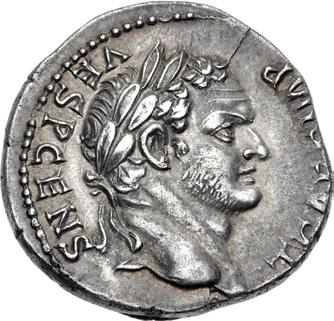
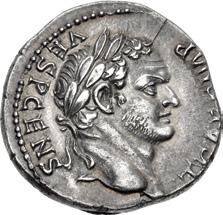
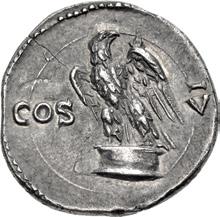

719. Titus. As Caesar, AD 69-79. AR Denarius (18mm, 2.97 g, 12h). Uncertain mint in Asia Minor (Ephesus?). Struck under Vespasian, AD 76. Laureate head right / Eagle standing left on low cippus, wings open, head right. RIC II.1 1481; RPC II 1457; RSC 61. Lovely old toning, light marks, hairline flan crack. Near EF. Well struck with fresh dies. Die engraver’s guide circle still complete on reverse. Wonderful portrait. ($750)
From the GS Collection. Ex Leu Numismatik 3 (27 October 2018), lot 228; Antike Numismatik (Dr. Michael Brandt) FPL 3 (Summer 2003), no. 72.


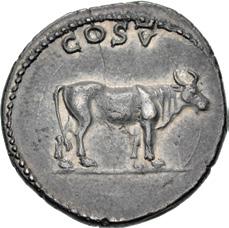
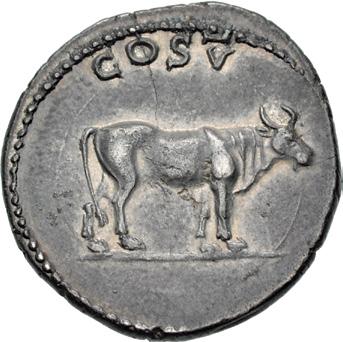
720. Titus. As Caesar, AD 69-79. AR Denarius (18.5mm, 2.74 g, 6h). Uncertain mint in Asia Minor (Ephesus?). Struck AD 76. Laureate head right; annulet below / Bull standing right. RIC II.1 1483 (Vespasian); RPC II 1458.4 (this coin); RSC 56a. Iridescent toning, hairline flan crack. Near EF. Very rare. Exceptional for issue. ($2000)
From the GS Collection. Ex Roma XII (29 September 2016), lot 700; Numismatica Ars Classica 78 (26 May 2014), lot 896; Triton V (15 January 2002), lot 1927.
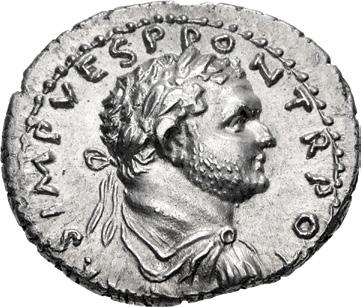
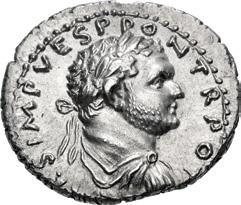


721. Titus. As Caesar, AD 69-79. AR Denarius (20mm, 3.14 g, 6h). Antioch mint. Struck under Vespasian, AD 72-73. Laureate, draped, and cuirassed bust right / Neptune standing left, foot on globe, holding acrostolium and scepter. RIC II.1 1561 corr. (bust type; Vespasian); RPC II 1933; cf. RSC 122. (for issue). Minor marks on reverse. EF. ($1000)
From the GS Collection. Ex Numismatica Ars Classica 138 (18 May 2023), lot 666.


722. Titus. As Caesar, AD 69-79. AR Denarius (18.5mm, 3.32 g, 7h). “Judaea Capta” commemorative. Antioch mint. Struck under Vespasian, AD 72-73. Laureate, draped, and cuirassed bust right / Titus driving triumphal quadriga right, holding scepter, branch, and reins. RIC II.1 1563 corr. (bust type; Vespasian); Hendin 6523; RPC II 1935; RSC 395 corr. (same). Lightly toned, some roughness, short hairline flan crack. Near EF. ($750)
From the GS Collection. Ex G. Hirsch 323 (22 September 2016), lot 2403; G. Hirsch 289 (2 May 2013), lot 724.
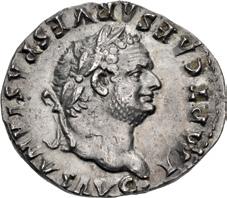
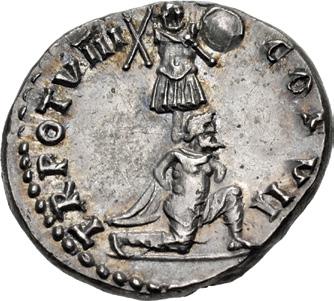

723. Titus. AD 79-81. AR Denarius (18.5mm, 3.26 g, 6h). “Judaea Capta” commemorative. Rome mint. Struck 24 June–1 July AD 79. Laureate head right / Trophy; below, Jewish male captive kneeling right, hands bound behind him. RIC II.1 1; Hendin 6516 corr. (obv. legend); RSC 334a. Light iridescent toning, scratch and some deposits on obverse, scratches on reverse. Near EF. ($500)
From the GS Collection. Ex Gorny & Mosch 249 (11 October 2017), lot 570.
192
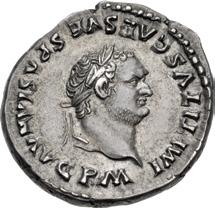
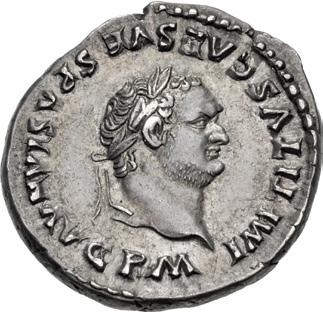

724. Titus. AD 79-81. AR Denarius (18mm, 3.48 g, 4h). “Judaea Capta” commemorative. Rome mint. Struck AD 79, after 1 July. Laureate head right / Slow quadriga left, bearing grain ears. RIC II.1 25; Hendin –; RSC 278. Toned, faint hairlines, shallow scratches on reverse. Good VF. ($750)
From the GS Collection. Ex New York Sale XLII (9 January 2018), lot 450; Künker 280 (26 September 2016), lot 551; Sternberg [1] (30 November 1973), lot 85.
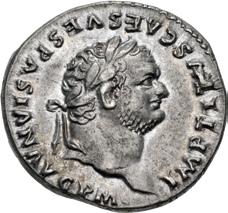

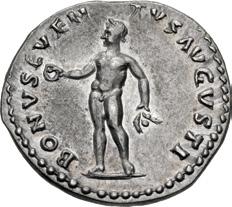
725. Titus. AD 79-81. AR Denarius (19mm, 3.52 g, 6h). Rome mint. Struck AD 79-80. Laureate head right / Bonus Eventus standing left, holding patera, grain ears, and poppy. RIC II.1 89; RSC 25. Lightly toned, underlying luster, small flan flaw and die break on obverse. EF. ($500)
From the GS Collection. Ex Berk BBS 202 (26 October 2017), lot 179.

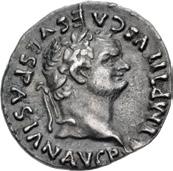
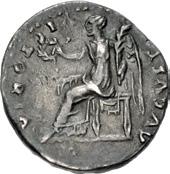
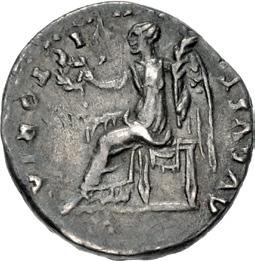
726. Titus. AD 79-81. AR Quinarius (14mm, 1.50 g, 5h). Rome mint. Struck AD 79-80. Laureate head right / Victory seated left, holding wreath and palm frond. RIC II.1 94; King 6; RSC 370a. Deeply toned, some marks under tone. Good VF. ($500)
From the GS Collection. Ex Dr. Walter Stoecklin (†1975) Collection (Nomos 14, 17 May 2017), lot 349, purchased from Dr. R. Gaettens in Heidelberg.
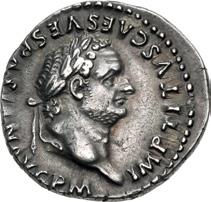
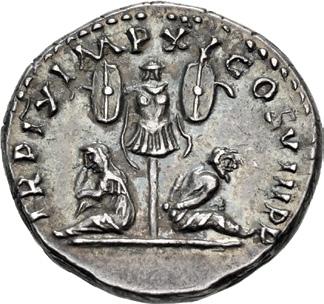
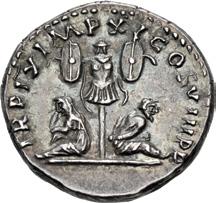
727. Titus. AD 79-81. AR Denarius (17.5mm, 3.50 g, 6h). “Judaea Capta” commemorative. Rome mint. Struck 1 January-30 June AD 80. Laureate head right / Trophy of arms; to left, female captive seated left in attitude of mourning; to right, bound male captive seated right. RIC II.1 102; Hendin 6615; RSC 306. Deep iridescent toning, minor flan flaws on obverse, traces of deposits on reverse. Good VF. ($500)
From the GS Collection. Ex Künker 295 (25 September 2017), lot 757.
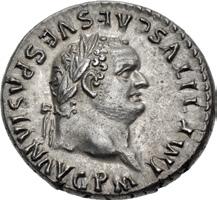

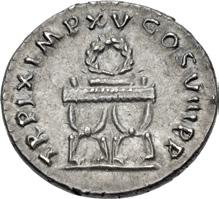
728. Titus. AD 79-81. AR Denarius (17.5mm, 3.61 g, 6h). Rome mint. Struck 1 January-30 June AD 80. Laureate head right / Pulvinar (throne) of Mars and Venus: curule chair surmouted with wreath. RIC II.1 108; RSC 318. Toned. EF. ($500)
From the GS Collection. Ex Gasvoda Collection (Part II, Numismatica Ars Classica 94, 6 October 2016), lot 168, purchased from Harlan J. Berk Ltd.
193
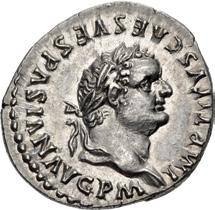
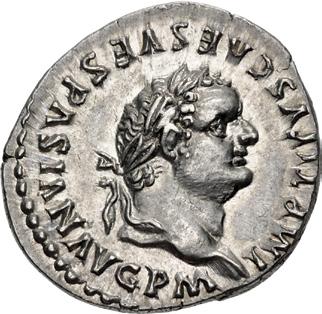
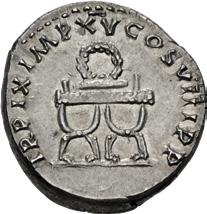
729. Titus. AD 79-81. AR Denarius (17.5mm, 3.48 g, 5h). Rome mint. Struck 1 January-30 June AD 80. Laureate head right / Pulvinar (throne) of Mars and Venus: curule chair surmouted with wreath. RIC II.1 108; RSC 318. Lustrous. EF. ($750)
From the Wild Rose Collection. Ex Jack A. Frazer Collection (Classical Numismatic Group Electronic Auction 460, 29 January 2020), lot 625; Ponterio 124 (17 January 2003), lot 453.
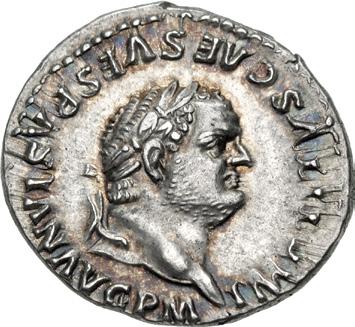
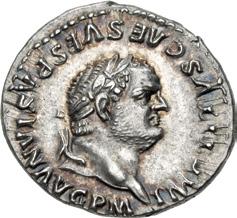

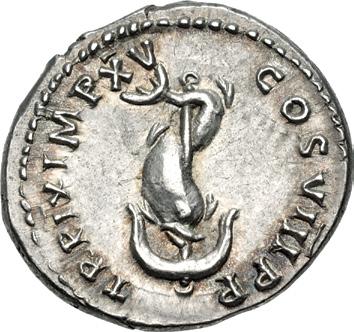
730. Titus. AD 79-81. AR Denarius (19mm, 3.66 g, 12h). Rome mint. Struck 1 January-30 June AD 80. Laureate head right / Dolphin coiled around anchor. RIC II.1 112; RSC 309. Beautiful iridescent toning, lustrous. Superb EF. Bold portrait. Very attractive in hand. ($1500)
From the GS Collection. Ex Gasvoda Collection (Part II, Numismatica Ars Classica 94, 6 October 2016), lot 169; C.K. Collection (Triton XIV, 3 January 2011), lot 681; Triton I (2 December 1997), lot 1384.


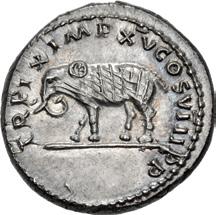
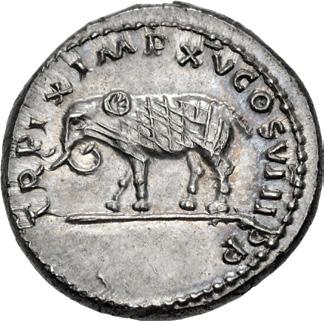
731. Titus. AD 79-81. AR Denarius (18mm, 3.54 g, 6h). Rome mint. Struck 1 January-30 June AD 80. Laureate head right / Elephant, wearing armor, walking left on exergual line. RIC II.1 115; RSC 303. Light iridescent toning, minor metal flaw on obverse. Superb EF. An absolutely gorgeous coin in hand. ($1500)
From the GS Collection. Ex Yves Gunzenreiner Collection (Leu Numismatik AG 1, 25 October 2017), lot 186; Gorny & Mosch 114 (4 March 2002), lot 260.
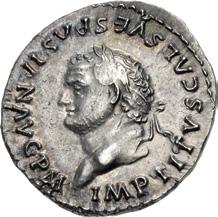
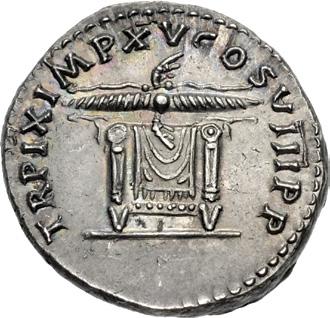

732. Titus. AD 79-81. AR Denarius (18mm, 3.23 g, 6h). Rome mint. Struck 1 January-30 June AD 80. Laureate head left / Pulvinar (throne) of Jupiter and Juno: square seat, draped and surmounted by winged thunderbolt. RIC II.1 120; RSC 314. Colorful iridescent toning, minor weakness on obverse. Superb EF. Struck with a fresh reverse die. ($750)
From the GS Collection. Ex Numismatica Ars Classica 120 (6 October 2020), lot 734; Numismatica Ars Classica 51 (5 March 2009), lot 233.
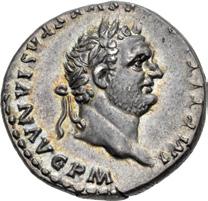
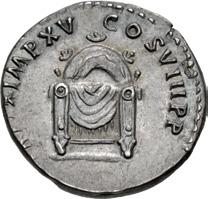
733. Titus. AD 79-81. AR Denarius (17mm, 3.52 g, 5h). Rome mint. Struck 1 January-30 June AD 80. Laureate head right / Pulvinar (throne) of Apollo and Diana(?): square seat with semi-circular back, decorated with three palmettes. RIC II.1 122; RSC 313. Iridescent toning. Near EF. ($500)
From the GS Collection. Numismatica Ars Classica 120 (6 October 2020), lot 732; Tkalec (17 May 2010), lot 181.
194
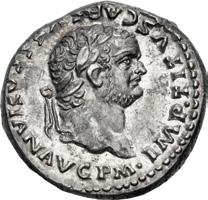


734. Titus. AD 79-81. AR Denarius (17mm, 3.48 g, 6h). Rome mint. Struck 1 January-30 June AD 80. Laureate head right / Pulvinar (throne) of Jupiter and Juno: square seat, draped, with tassels: it has a triangular frame on it, on which are four vertical bars on each side and one palmette in center. RIC II.1 124; RSC 313a. Lightly toned, underlying luster, some hairlines. EF. ($500)
From the GS Collection.
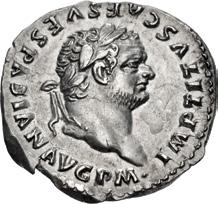
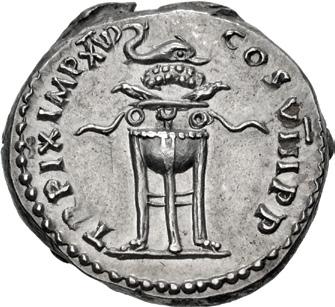
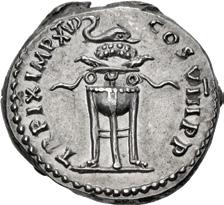
735. Titus. AD 79-81. AR Denarius (18mm, 3.42 g, 5h). Rome mint. Struck 1 January-30 June AD 80. Laureate head right / Filleted tripod surmounted by dolphin. RIC II.1 128; RSC 321. Flan flaw on obverse, some hairlines, minor deposits on reverse. Superb EF. ($1000)
From the GS Collection. Ex Naville Numismatics 63 (7 February 2021), lot 474.
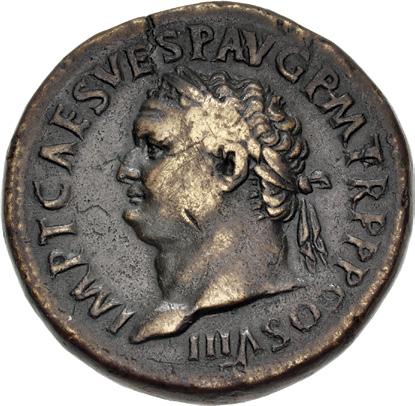
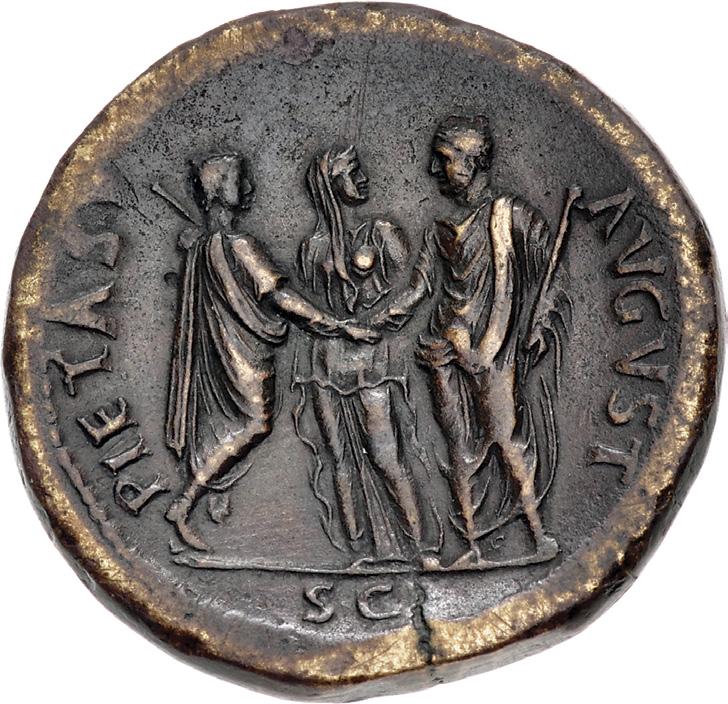
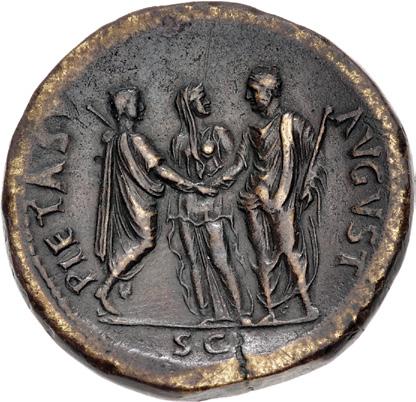
736. Titus. AD 79-81. Æ Sestertius (34mm, 26.67 g, 7h). Rome mint. Struck AD 80-81. Laureate head left / Titus and Domitian, bareheaded and togate, standing left and right, facing one another, clasping right hands; between and behind them, Concordia (or Pietas), veiled and draped, standing front, looking right at Titus and joining their right hands. RIC II.1 160. Brown patina, brassy highlights, scratches, flan crack, a couple areas of edge filing. VF. ($1500)
From the Wayne Scheible Collection, purchased from Harlan J. Berk, Ltd.


737. Titus. AD 79-81. Æ Sestertius (33.5mm, 26.56 g, 6h). Uncertain Eastern mint (Thrace?). Struck AD 80-81. Laureate head right / Pax standing left, holding olive branch and cornucopia. RIC II.1 498; RPC II 501. Dark green-brown patina, cleaning scratches. Good VF. ($1500)
From the Wild Rose Collection. Ex Peter Corcoran Collection (New York Sale LIV, 11 January 2022), lot 257; Triton XX (10 January 2017), lot 703.
195
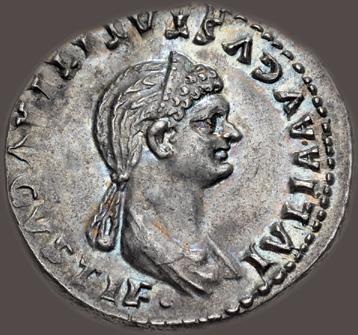
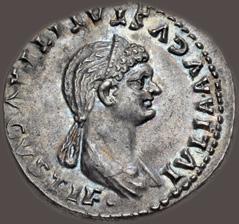
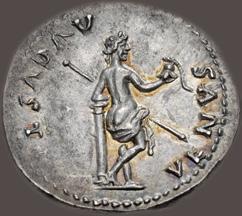
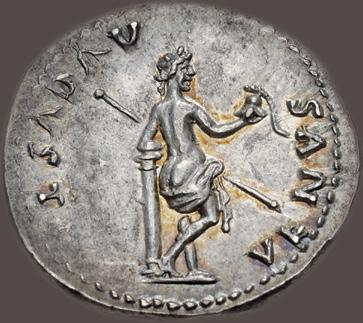
738. Julia Titi. Augusta, AD 79-90/1. AR Denarius (19.5mm, 3.42 g, 6h). Rome mint. Struck under Titus, AD 80-81. IVLIA AVGVSTA TITI AVGVSTI F •, diademed and draped bust right; hair in long plait / VENVS AVGVST, Venus, seen half from behind, naked to the hips, standing right, resting elbow on column, holding transverse scepter and crested helmet. RIC II.1 388 (Titus); RSC 14; BMCRE 141-3 (Titus); BN 106-7 (Titus). Iridescent toning, light marks under tone. EF. ($5000)
Ex Numismatica Ars Classica 78 (26 May 2014), lot 902 (hammer CHF 7500); Tkalec (27 October 2011), lot 164.
In AD 79, Vespasian died and Titus became sole emperor. One of his first official acts was to raise his daughter Julia to the rank of Augusta, or Empress, the first woman in more than a decade to hold that exalted position. He struck this lovely coin for the occasion. Julia thus became the first reigning Roman empress to be honored with a regular issue of Roman coins struck solely in her own name.
RIC Plate Coin
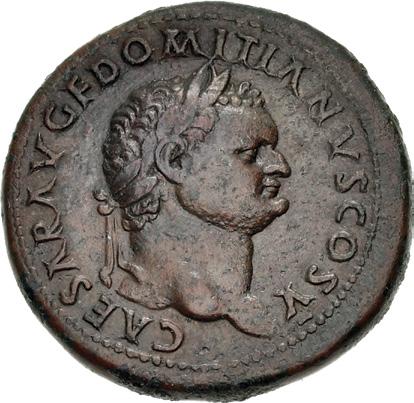
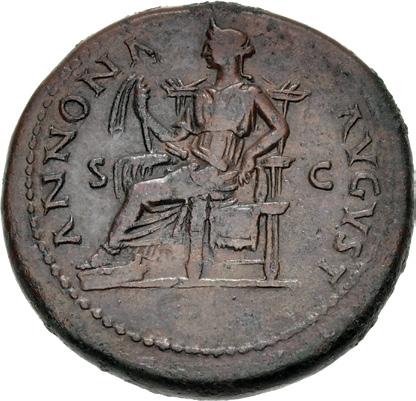
739. Domitian. As Caesar, AD 69-81. Æ Sestertius (33mm, 26.47 g, 6h). Rome mint. Struck under Vespasian, AD 77-78. Laureate head right / Annona seated left, holding grain ears and sack of grain ears; S C in field. RIC II.1 1040 (this coin cited and illustrated). Brown patina, minor smoothing on reverse, some roughness. Good VF. ($750)
From the Wild Rose Collection, purchased from Calgary Coin Gallery. Ex Edward J. Waddell inventory 33536 (ND); V.J.E. Ryan Collection (Part V, Glendining, 2 April 1952), lot 2396 (part of; with collector’s ticket).

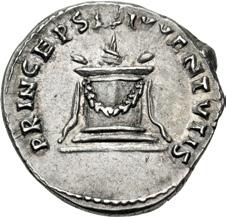
740. Domitian. As Caesar, AD 69-81. AR Denarius (19mm, 3.54 g, 6h). Rome mint. Struck under Titus, AD 80-81. Laureate head right / Garlanded and lighted altar. RIC II.1 266 (Titus); RSC 397a. Lovely light toning, underlying luster, minor marks. EF. ($500)
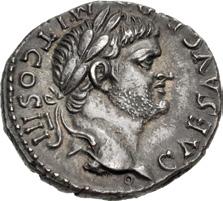
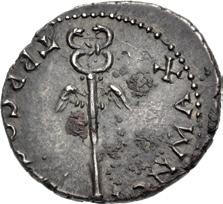
741. Domitian. As Caesar, AD 69-81. AR Denarius (18mm, 3.50 g, 2h). Ephesus(?) mint. Struck under Vespasian, AD 76. Laureate head right; small annulet below / Winged caduceus. RIC II.1 1491 (Vespasian); BMCRE 494; RPC 1463; RSC –. Toned, encrustations, reverse off center. Near EF. ($500)
From the Wild Rose Collection, purchased from Dr. Paul Rynearson, June 2006.
196
Ex Adda and Evans Collections – Pedigreed to 1909


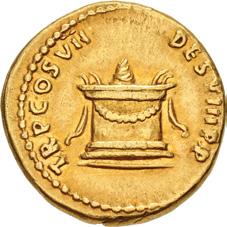
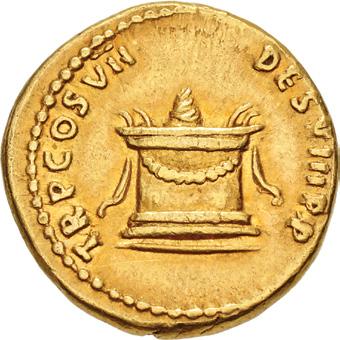
742. Domitian. AD 81-96. AV Aureus (18.5mm, 7.17 g, 6h). Rome mint. Struck 13 September-31 December AD 81. IMP CΛES DOMITIΛNVS ΛVG P M, laureate head right / TR P COS VII DES VIII P P, lighted and garlanded altar with flame in the center and horns right and left. RIC II.1 42; Calicó 929a; BMCRE p. 302, note 23; Adda 77 (this coin); Biaggi 435. A few faint hairlines. Good VF. Pretty color. ($5000)
From the Wild Rose Collection. Ex Numismatica Ars Classica 114 (6 May 2019), lot 1491; George C. Hopkins Collection (Empire Coins 10, 6 May 1989), lot 220; Property of a Lady Collection (Christie’s, 8 October 1985), lot 103; Victor A. Adda (†1965) Collection; Sir John Evans Collection (Rollin & Feuardent, 26 May 1909), lot 81.
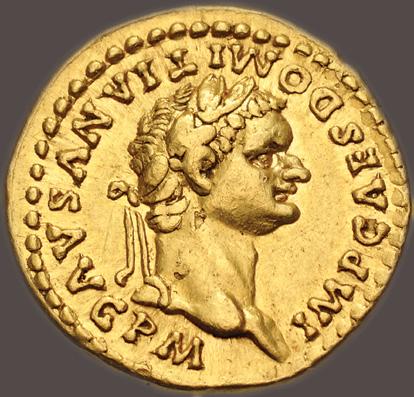
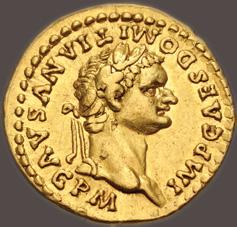
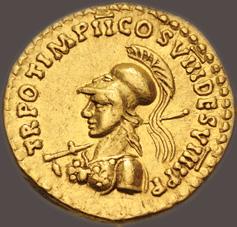
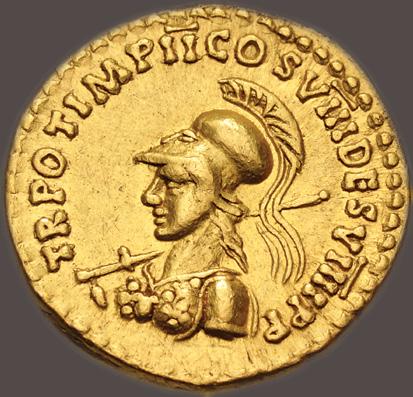
743. Domitian. AD 81-96. AV Aureus (19mm, 7.81 g, 6h). Rome mint. Struck AD 82. IMP CΛES DOMITIΛNVS ΛVG P M, laureate head right / TR POT IMP II COS VIII DES VIIII P P, cuirassed bust of Minerva left, wearing crested Corinthian helmet and aegis; transverse scepter over right shoulder. RIC II.1 137; Calicó 936; BMCRE –; BN 36; Biaggi 437. Minor marks, some luster remains. Good VF. Excellent portraits. Very rare. ($7500) Ex Libertas Collection.

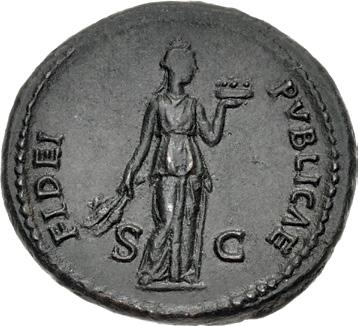
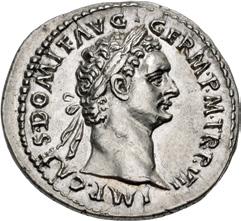
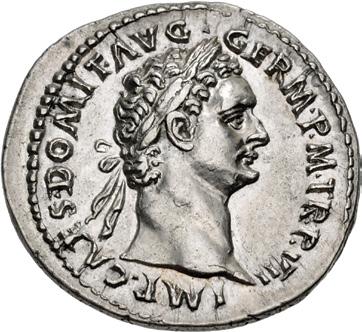
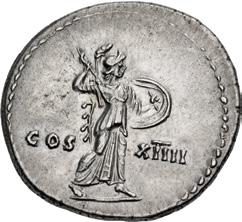
744. Domitian. AD 81-96. Æ As (29mm, 11.93 g, 6h). Rome mint. Struck AD 86. Laureate bust right, wearing aegis / Fides Publica standing right, holding two grain ears and poppy and dish of fruits. RIC II.1 486. Dark green patina. EF. Well centered. ($500)
From the Wild Rose Collection, purchased from Calgary Coin Gallery, May 2014. Ex CNG inventory 931031 (August 2012).
745. Domitian. AD 81-96. AR Denarius (19.5mm, 3.50 g, 6h). Rome mint. Struck early AD 88. Laureate head right / Minerva advancing right, holding spear and shield. RIC II.1 552 (R2); cf. RSC 66/67 (for obv./rev. types). EF. A beautiful example of this rare issue. ($500)
From the Wild Rose Collection. Ex Dr. Klaus Berthold Collection (Künker 318, 11 March 2019), lot 1149; Baldwin’s 57 (23 September 2008), lot 87, purchased from Spink, 2002.
197
744
745
Exceptional Ludi Saeculares Denarius

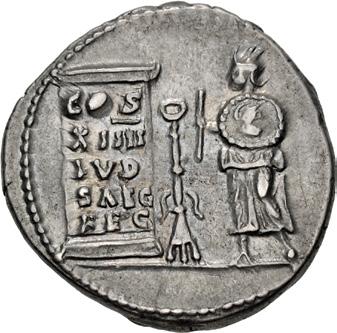
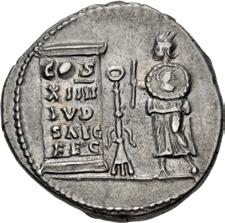
746. Domitian. AD 81-96. AR Denarius (18mm, 3.53 g, 6h). Ludi Saeculares (Secular Games) issue. Rome mint. Struck 14 September-31 December AD 88. Laureate head right / Cippus inscribed COS/ XIIII/ LVD/ SAEC/ FEC in five lines; to right, herald standing left, holding wand and shield; candelabrum between. RIC II.1 601; RSC 73. Light toning, some underlying luster. Near EF. Well centered on both sides. Bold portrait. ($750)
From the Wild Rose Collection. Ex Dr. Nicholas Lowe Collection (Roma XVIII, 29 September 2019), lot 1135; Classical Numismatic Group 75 (23 May 2007), lot 1027.

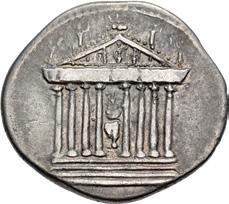
747. Domitian. AD 81-96. AR Denarius (18.5mm, 3.07 g, 6h). Rome mint. Struck AD 95-96. Bare head right / Octastyle temple on podium of four steps; in center, seated figure facing; in pediment, three standing figures; on roof, statues. RIC II.1 816 (R2); RSC 175; Elkins, Monuments Figure 107. Toned, scratches. VF. Very rare. ($500)
From the Wild Rose Collection. Ex Cederlind 126 (19 November 2002), lot 108.
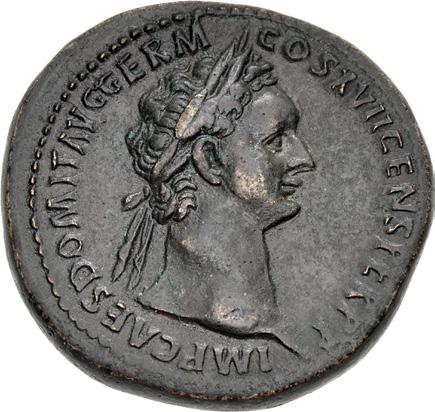
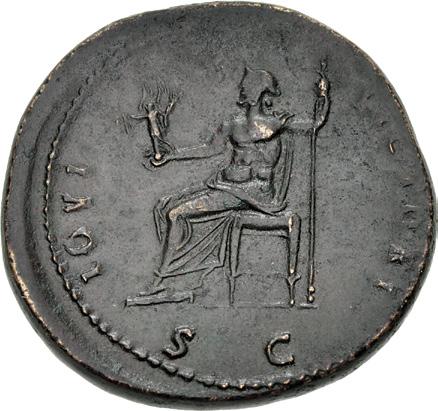
748. Domitian. AD 81-96. Æ Sestertius (35mm, 28.36 g, 6h). Rome mint. Struck AD 95-18 September 96. Laureate head right / Jupiter seated left, holding Victory and scepter. RIC II.1 794. Attractive green-brown patina, areas of weak strike on reverse. Good VF. Struck on a broad flan. ($1000)
From the Wild Rose Collection. Ex Numismatica Ars Classica 106, Part II (10 May 2018), lot 1423; G. Hirsch 203 (24 February 1999), lot 540.
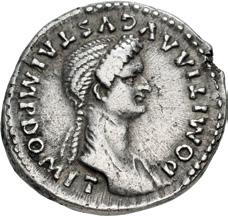
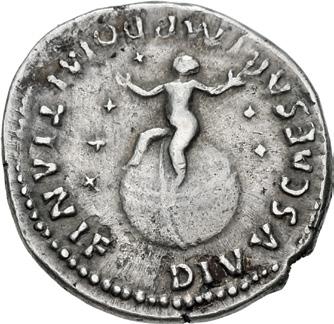

749. Domitia. Augusta, AD 82-96. AR Denarius (19mm, 3.43 g, 5h). Rome mint. Struck under Domitian, AD 82-83. Draped bust right, wearing necklace, her hair is knotted in long plait on neck and massed high in front above forehead / Naked infant boy (Divus Caesar as a baby Jupiter) seated on a globe, marked with cross zones, stretching out hands at sides; seven stars (septentriones) above and around. RIC II.1 153 (Domitian); RSC 11. Toned, minor edge marks. VF. Very rare. ($1500)
From the I.L. Collection. Ex Naville Numismatics 15 (7 June 2015), lot 426.
Domitia bore Domitian two children, first a girl, then a boy about a year later. The son died young and was deified. He is shown on the reverse of this coin as a baby Jupiter seated on a globe, surrounded by the Septentriones, the seven stars in Ursa Major that make up the Big Dipper.
198
The Formidable Empress Domitia
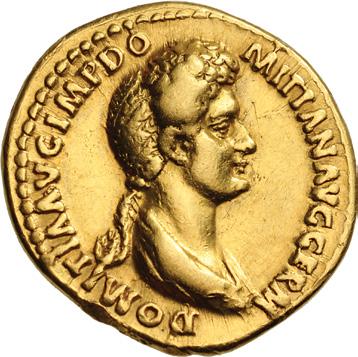
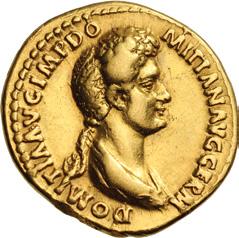
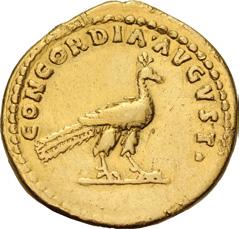
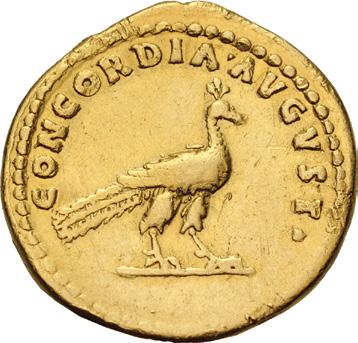
750. Domitia. Augusta, AD 82-96. AV Aureus (19.5mm, 7.52 g, 6h). Rome mint. Struck under Domitian, AD 88-89. DOMITIΛ ΛVG IMP DO MITIΛN ΛVG GERM, draped bust right, wearing hair massed high in front and in long plait behind / CONCORDIΛ • ΛVGVST •, peacock standing right. RIC II.1 678 (Domitian); Calicó 946b (same dies as illustration); BMCRE 249 note (Domitian); BN 217 (Domitian; same obv. die); Biaggi 446; Jameson 83 (same obv. die). Minor smoothing in obverse field, some scratches and marks on reverse, a few edge marks. VF. Artistic portrait in high relief. ($5000)
From the Jonathan K. Kern Collection. Ex Classical Numismatic Group 120 (11 May 2022), lot 813.
Domitia Longina, the daughter of a famous Roman general, married Domitian in AD 71. A boy was soon born to the couple, but died very young. The marriage was a tempestuous one and Domitia endured a period of exile, but was back in favor after AD 84. The historian Cassius Dio states Domitia played a role in her husband’s assassination on 18 September AD 96. She died peacefully sometime between AD 126 and AD 130. Her aurei are especially rare.
Ex Levis Collection – Pedigreed to 1925
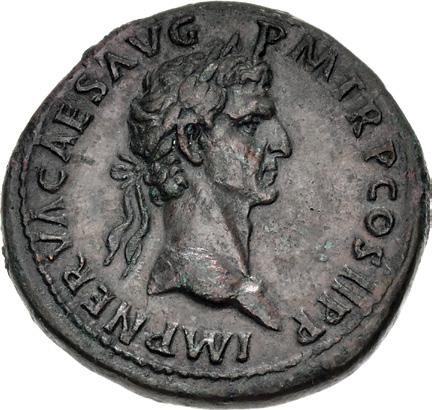
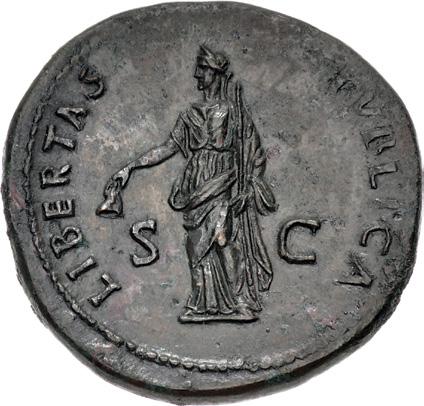
751. Nerva. AD 96-98. Æ Sestertius (35.5mm, 26.01 g, 5h). Rome mint. Struck AD 96. Laureate head right / Libertas standing left, holding pileus and vindicta. RIC II 64; Banti 31 (this coin illustrated). Brown patina, some red and green, smoothed. Good VF. ($750)
Ex H. C. Levis Collection (Ars Classica XI, 18 June 1925), lot 495.
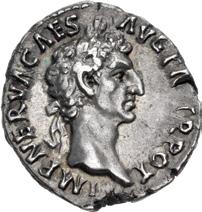


752. Nerva. AD 96-98. AR Denarius (16.5mm, 3.33 g, 6h). Rome mint. Struck AD 97. Laureate head right / Emblems of the pontificate: simpulum, aspergillum, guttus, and lituus. RIC II 24; RSC 48. Attractively toned, some iridescence. Near EF. ($500)
Ex Classical Numismatic Group XXXII (7 December 1994), lot 374.
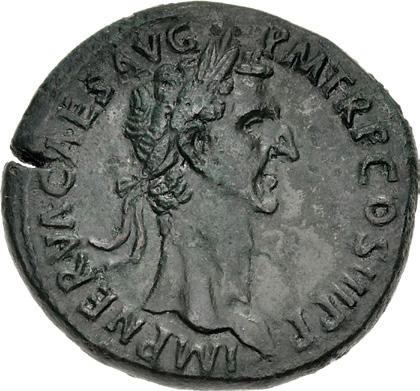
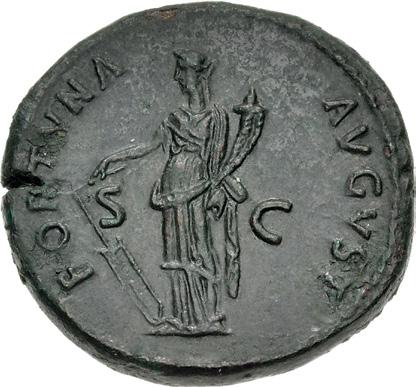
753. Nerva. AD 96-98. Æ Sestertius (34mm, 28.49 g, 5h). Rome mint. Struck AD 97. Laureate head right / Fortuna standing facing, holding rudder and cornucopia; S C across field. RIC II 83; Banti 21. Green patina, edge split. Good VF. ($750)
From the Wild Rose Collection. Ex New York Sale III (7 December 2000), lot 669.
199
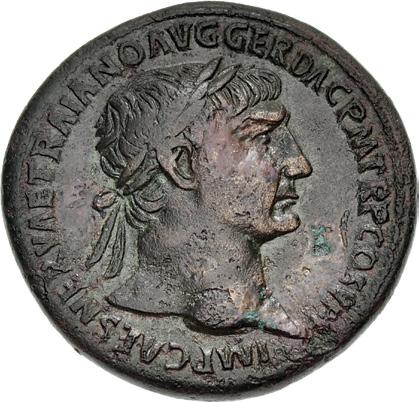
The Circus Maximus
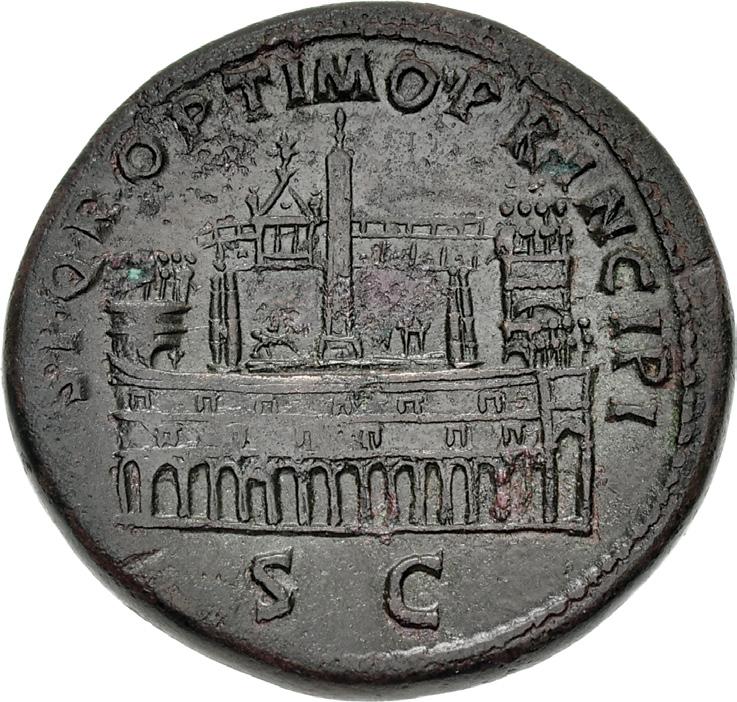
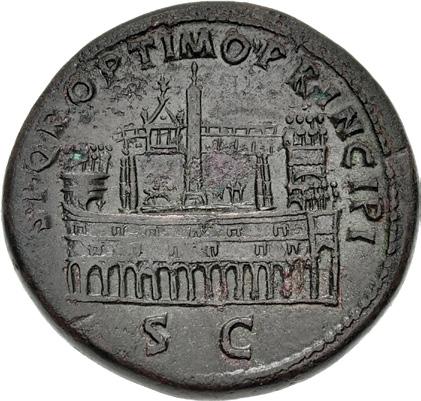
754. Trajan. AD 98-117. Æ Sestertius (34mm, 25.56 g, 6h). Rome mint. Struck circa AD 103-104. Laureate head right / View of the Circus Maximus, showing a colonnaded front, with arch, indicating gateway, surmounted by facing quadriga, on right, and, behind it, higher up, a similar arch with quadriga, and another arch, surmounted by quadriga facing right at extreme left: the sides of the Circus are not seen but the back is indicated by a sweep of colonnades: in the interior is the great obelisk in center; to left and right smaller obelisks. RIC II 571; Woytek 175a; Banti 272; Elkins, Monuments Figure 111. Dark greenbrown patina, some red, areas of smoothing and light pitting, several spots of fill. VF. ($3000)
From the Bellwether Collection, purchased from Freeman & Sear, April 1994. The Circus Maximus, perhaps the second greatest monument built for the benefit of Rome’s citizens after the famed Flavian Amphitheater (Colosseum), was restored by Trajan in AD 103.


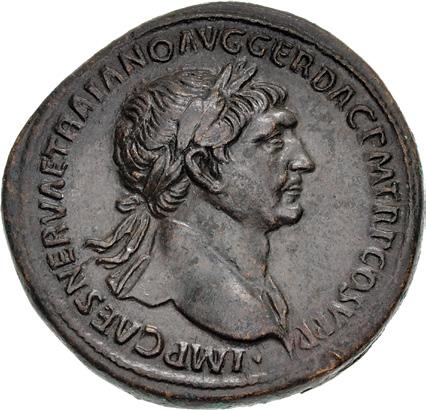
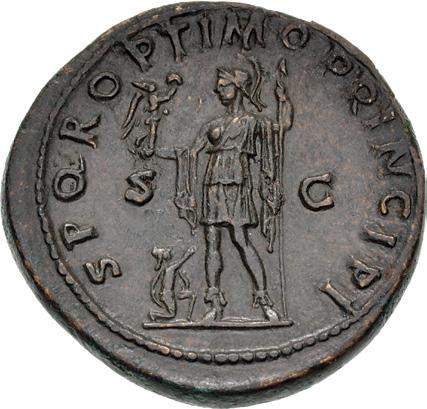
755. Trajan. AD 98-117. Æ Sestertius (35mm, 28.90 g, 6h). Rome mint. Struck circa AD 104/5-107. Laureate bust right, wearing aegis / Victory standing right, left foot set on helmet, holding stylus in right hand and resting left on shield inscribed VIC/ DAC in two lines set on palm tree trunk. RIC II 528; Woytek 204cA; Banti 168. Brown patina, smoothing. Good VF. ($500)
From the Wild Rose Collection. Ex Toliver Besson Collection (Classical Numismatic Group 115, 16 September 2020), lot 641; Heritage 3046 (14 April 2016), lot 29292; Daniel M. Friedenberg Collection (Goldberg 25, 31 May 2004), lot 3155; Classical Numismatic Group 38 (6 June 1996), lot 969; Superior Stamp & Coin FPL (Summer 1981), no. 117.
756. Trajan. AD 98-117. Æ Sestertius (34.5mm, 26.42 g, 6h). Rome mint. Struck circa AD 106-107. Laureate bust right, slight drapery / Roma standing left, holding Victory and spear; at feet to left, Dacian kneeling right, raising hands. RIC II 486 var. (bust type); Woytek 250b; Banti 122. Brown patina, cleaning scratches. Near EF. Bold portrait. ($750)
From the Wild Rose Collection, purchased from Pars Coins, March 2017.
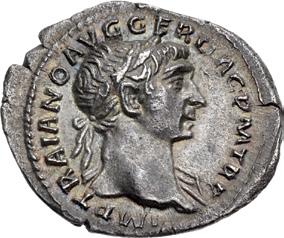
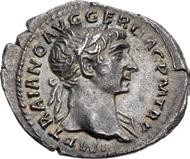
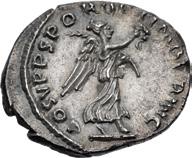
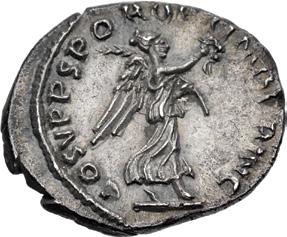
757. Trajan. AD 98-117. AR Quinarius (15.5mm, 1.59 g, 6h). Rome mint. Struck circa mid AD 107-111. Laureate bust right, slight drapery / Victory advancing right, holding palm frond and wreath. RIC II 133; Woytek 372bC; King 4; RSC 79. Iridescent toning. EF. An exceptional grade for this scarce denomination. ($1000)
From the Wild Rose Collection. Ex Numismatica Ars Classica 87 (8 October 2015), lot 216; Rauch 72 (20 September 2003), lot 567; Numismatica Ars Classica 11 (29 April 1998), lot 418.
200
755
756

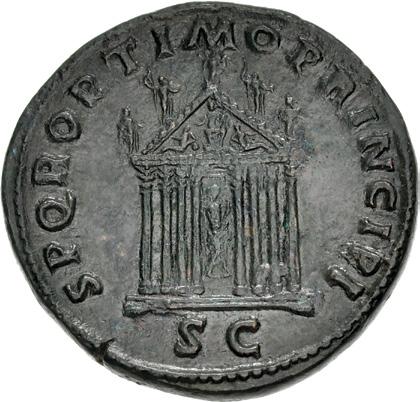
758. Trajan. AD 98-117. Æ Sestertius (34mm, 25.14 g, 6h). Rome mint. Struck circa mid AD 107-108. Laureate bust right, slight drapery / Front view of octastyle temple on podium of three steps: togate figure standing in the center of the columns; in pediment, seated figure between reclining figures; on roof, five standing figures. RIC II 575; Woytek 302bD (this coin cited and illustrated); Banti 290; Elkins, Monuments Figure 115. Attractive green patina, lightly smoothed. Near EF. A handsome architectural type. ($1500)
From the Wild Rose Collection. Ex Classical Numismatic Group 111 (29 May 2019), lot 684; Lanz 109 (27 May 2002), lot 403.
Danube Bridge Type

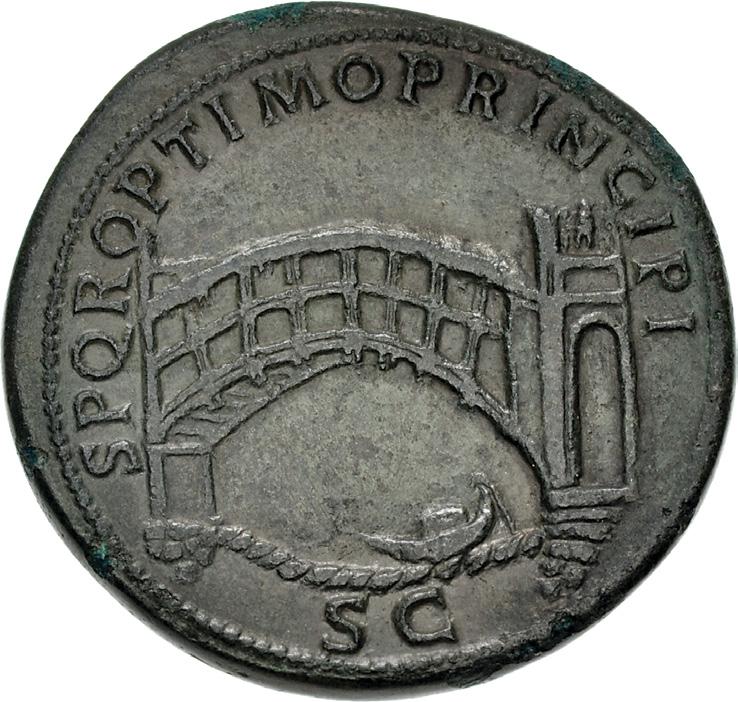
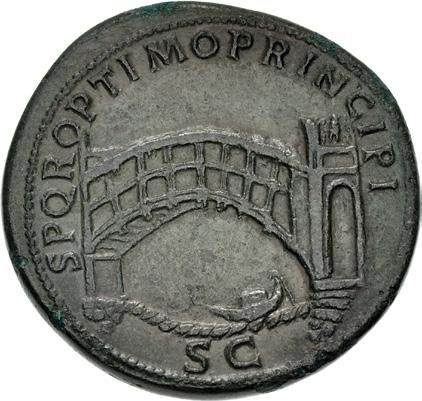
759. Trajan. AD 98-117. Æ Sestertius (34mm, 25.77 g, 6h). Rome mint. Struck circa mid AD 107-110. Laureate bust right, slight drapery / Arched, single-span bridge with seven posts across river; single-bay arches at either end; boat sailing left in river below. RIC II 569; Woytek 314bC4; Banti 262. Green patina, smoothed. Good VF. ($1000)
From the Wild Rose Collection. Ex Lanz 161 (7 December 2015), lot 292.
The bridge on the reverse of this coin is generally thought to be that constructed across the Danube by Trajan’s architect, Apollodorus of Damascus, in AD 104. There is good circumstantial evidence for this. The date range for this coin’s issue is closely contemporary with the date of the bridge’s construction and would fit in well programmatically with those warrelated issues of the same time frame.
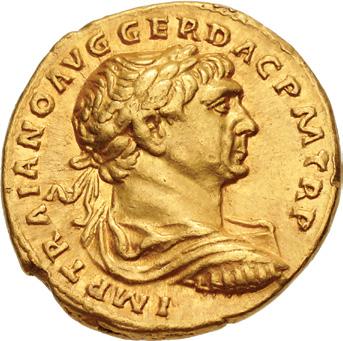
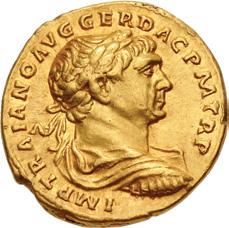
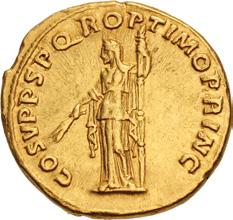

760. Trajan. AD 98-117. AV Aureus (18.5mm, 7.29 g, 6h). Rome mint. Struck circa AD 108-110. IMP TRAIANO AVG
GER DAC P M TR P, laureate, draped, and cuirassed bust right / COS V P P S P Q R OP TIMO PRINC, Ceres, draped, wearing wreath of grain ears, standing left, holding grain ears pointed downward in right hand and long vertical torch in left. RIC II 109 var. (bust type); Allen Series 42, Type IX (dies 26/ix.1); Woytek 291f; Calicó 996a (same rev. die as illustration); BMCRE 258-9; BN 413-5; Biaggi 469 var. (break in rev. legend); Mazzini 65 v.; Heritage 3071, lot 33274 (same dies). Lightly toned, underlying luster, edge marks. Near EF. ($4000)
Ex Grand Haven Collection (Triton XXIV, 19 January 2021), lot 1081; Triton XXI (9 January 2018), lot 750.
201
Woytek Plate Coin



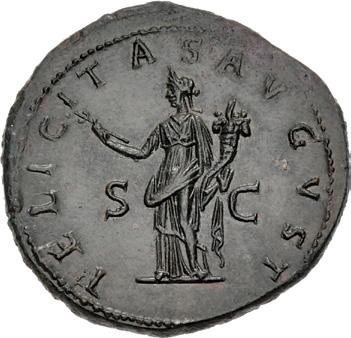
761. Trajan. AD 98-117. Æ Sestertius (31.5mm, 24.10 g, 6h). Rome mint. Struck AD 111. Laureate head right / Arabia standing left, holding branch and bundle of cinnamon sticks; to left, camel advancing left. RIC II 466 var. (bust type); Woytek 363a; Banti 23. Green-brown patina, smoothing. Near EF. ($750)
From the Wild Rose Collection. Ex T. R. Fehrenbach Collection (Heritage 3089, 21 January 2021), lot 32191; Lanz 60 (11 June 1992), lot 433.
Woytek Plate Coin
762. Trajan. AD 98-117. Æ Dupondius (28.5mm, 11.43 g, 6h). Rome mint. Struck circa AD 112/113-114. Radiate bust right, wearing aegis / Felicitas standing left, holding caduceus and cornucopia. RIC II 626 var. (bust type); Woytek 481c (this coin cited and illustrated). Mottled green-brown and red surfaces, smoothed, details enhanced. Near EF. Rare with this bust type. ($500)
From the Wild Rose Collection. Ex Numismatica Ars Classica 98 (12 December 2016), lot 1158; Gorny & Mosch 176 (10 March 2009), lot 2255; Gorny & Mosch 160 (9 October 2007), lot 2314.
One of Two Known
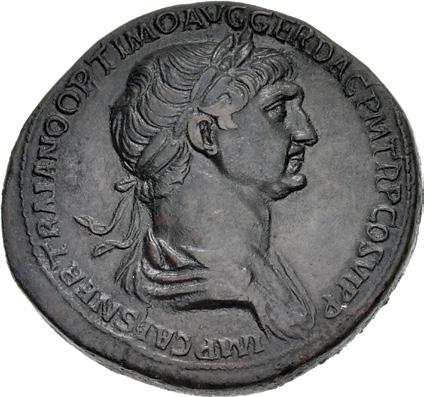

763. Trajan. AD 98-117. Æ Sestertius (34mm, 27.60 g, 6h). Rome mint. Struck winter AD 114-early 116. Laureate and draped bust right / S C across field, Fortuna Redux seated left, holding rudder and cornucopia. RIC II 652 var. (S C in exergue); Woytek 542v-2 (this coin cited); Banti 66 var. (same). Brown patina, light smoothing. VF. Woytek knew of only two examples with S C across field, including this coin. ($500)
From the Wild Rose Collection. Ex Classical Numismatic Group 66 (19 May 2004), lot 1432.
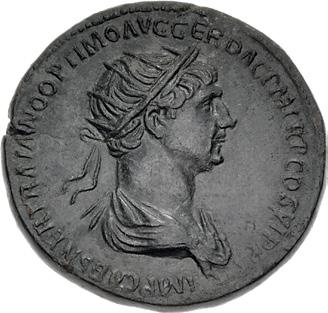
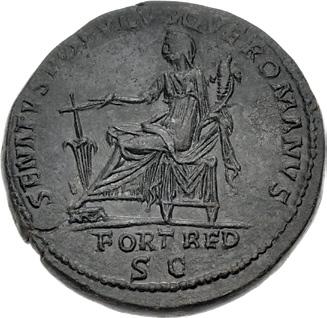
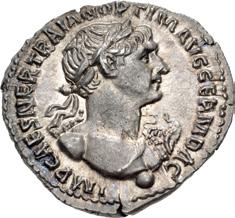
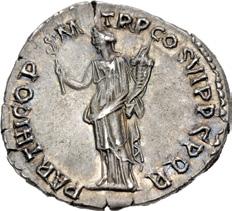
764. Trajan. AD 98-117. Æ Dupondius (26.5mm, 14.23 g, 6h). Rome mint. Struck winter AD 114-early 116. Radiate and draped bust right / Fortuna seated left, holding rudder set on ground and cornucopia. RIC II 653; Woytek 543v. Attractive dark green patina, minor marks, smoothing, flan crack. Near EF. ($500)
765. Trajan. AD 98-117. AR Denarius (19mm, 3.19 g, 6h). Rome mint. Struck circa autumn AD 116-August AD 117. Laureate bust right, wearing aegis, with bare chest showing, wearing balteus; globe below / Felicitas standing left, holding caduceus and cornucopia. RIC II 333 var. (bust type); Woytek 570tt+; RSC 192 var. (same). Toned, some underlying luster, flan crack. EF. Very rare with this bust type. Woytek listed four examples. ($500)
From the Wild Rose Collection. Ex Michael Kelly Collection (Roma XVII, 29 March 2019), lot 745; Spink E-Sale 18055 (7 November 2018), lot 325.
202
761
762
764
765
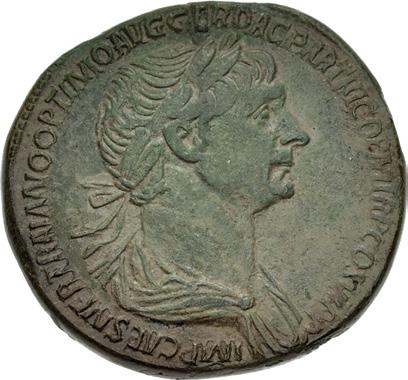
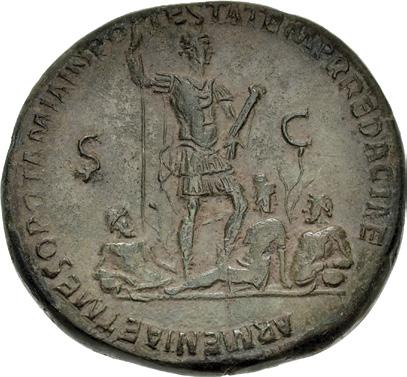
766. Trajan. AD 98-117. Æ Sestertius (33mm, 24.88 g, 6h). Rome mint. Struck after 20 February AD 116-August 117. Laureate and draped bust right / Trajan, laureate and in military attire, standing right, holding reversed spear and parazonium; around feet, Mesopotamia seated left, head right, and the Tigris and Euphrates seated right, facing one another, leaning on inverted urn from which water flows. RIC II 642; Woytek 590v–2; Banti 30 (same rev. die as illustration). Green patina, areas of smoothing, edge smoothed, earthen deposits. Good VF. ($1000)
Ex Niggeler and Platt Hall Collections – Pedigreed to 1950

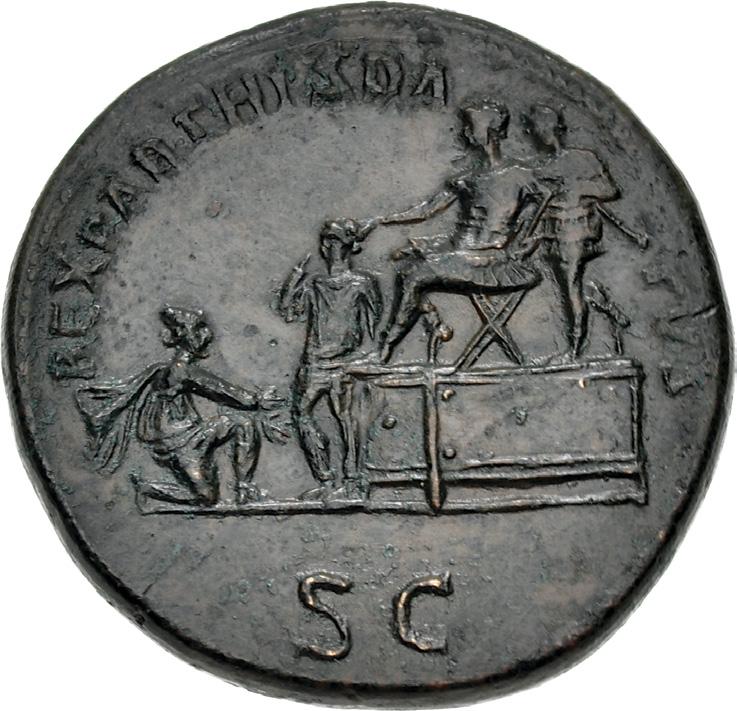
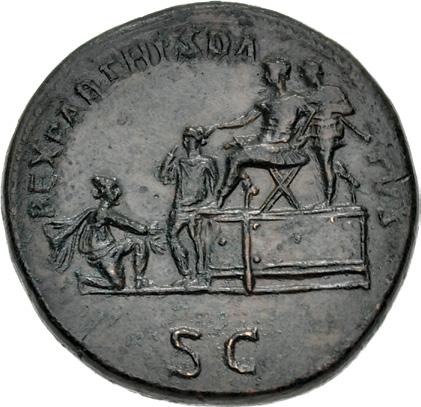
767. Trajan. AD 98-117. Æ Sestertius (34mm, 28.73 g, 5h). Rome mint. Struck 20 February AD 116-August 117. Laureate and draped bust right / Trajan seated left on daïs, presenting Parthamaspates to Parthia kneeling right; to right of Trajan, prefect standing left. RIC II 667; Woytek 594v–25 (this coin, cited and illustrated); Banti 96. Dark green and tan patina, scratches, smoothing. Good VF. ($2000)
From the Wild Rose Collection. Ex Rauch 108 (4 June 2019), lot 171; Rauch 102 (7 November 2016), lot 387; Vinchon (24 November 1994), lot 438; Walter Niggeler Collection (Part 3, Bank Leu/Münzen und Medaillen AG, 2 November 1967), lot 1232; Henry Platt Hall Collection (Part II, Glendining’s, 16 November 1950), lot 1309.
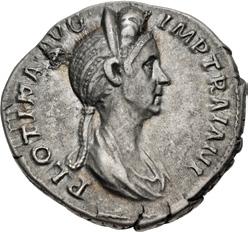
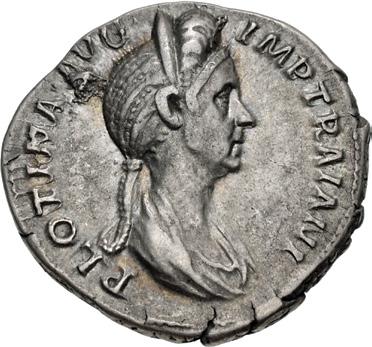
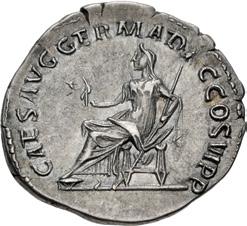
768. Plotina. Augusta, AD 105-123. AR Denarius (20.5mm, 3.34 g, 6h). Rome mint. Struck under Trajan, AD 112-summer 114. Draped bust right, wearing hair bunched high in front and held in position by a double stephane, hair elaborately waved at back and falls down in a queue / Vesta, veiled and draped, seated left on chair without back, holding palladium and transverse scepter. RIC II 730 (Trajan); Woytek 705–1 (Trajan); RSC 3. Lightly toned, small die flaw on obverse. Good VF. Struck on a broad flan from dies of excellent style. ($3000)
From the Wild Rose Collection. Ex Thomas A. Palmer Collection (Triton XXV, 11 January 2022), lot 877; Helios 6 (9 March 2011), lot 153 (hammer €6,000).
203
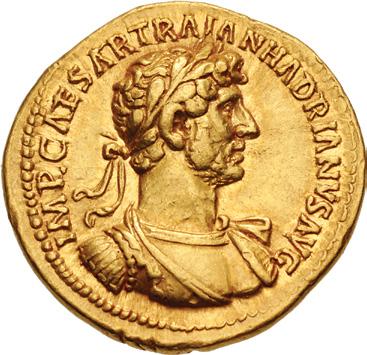
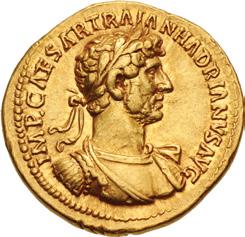

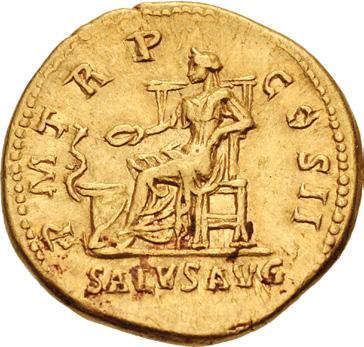
769. Hadrian. AD 117-138. AV Aureus (20mm, 7.13 g, 6h). Rome mint. Struck AD 118. IMP CAESAR TRAIAN HADRIANVS AVG, laureate and cuirassed bust right with exposed upper part of breastplate visible, wearing balteus / P M TR P COS II, SALVS AVG in exergue, Salus, draped, seated left on throne, feeding out of patera in right hand snake coiled around and rising from altar to left and resting left arm on back of throne. RIC II.3 135; Strack 40; Calicó 1369a (same obv. die as illustration); BMCRE p. 250, note 84; Biaggi 654. Attractively toned, light marks, minor deposits. Good VF. Bold portrait struck in high relief. ($5000)
From the LCM Collection. Ex Roma XXI (24 March 2021), lot 593; Numismatica Ars Classica 92 (23 May 2016), lot 546.
Bonfire of Tax Arrears
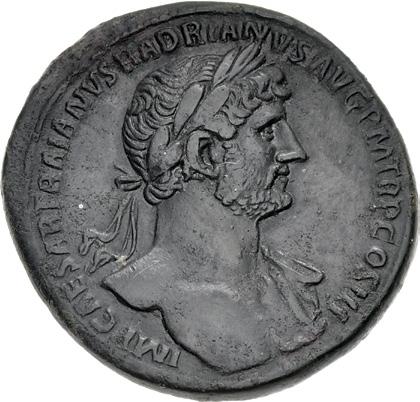

770. Hadrian. AD 117-138. Æ Sestertius (34mm, 25.59 g, 6h). Rome mint. Struck AD 119-circa mid 120. Laureate bust with bare chest right, slight drapery / Lictor standing left, holding brand and setting fire to a heap of bonds on ground to left, and holding fasces with ax upright; to left, three citizens standing right, raising right hands in celebration. RIC II.3 264; Banti 624. Dark green-brown patina, smoothing. VF. ($750)
From the Wild Rose Collection, purchased from Notaras Coins & Antiquities (David Morgan), November 2015.
To promote his popularity, Hadrian cancelled debts and burned promissory notes in a general amnesty for tax arrears, the event this sestertius commemorates. The reverse depicts either Hadrian himself or a lictor applying a torch to a heap of documents (sungrafoi) symbolizing the debts being cancelled. The burning occurred in Trajan’s Forum, where Hadrian erected a monument inscribed “the first of all principes and the only one who, by remitting nine hundred million sesterces owed to the fiscus, provided security not merely for his present citizens but also for their descendants by this generosity.”
The legend RELIQVA VETERA HS NOVIES MILL ABOLITA literally translates to “old receipts in the amount of nine times a hundred thousand sestertii cancelled.” The HS is a standard abbreviation for sestertii and, depending upon its context, it can mean a single sestertius, a unit of one thousand sestertii, or a unit of one hundred thousand sestertii. Novies means “nine times” and applies to the sestertius as a unit of one thousand sestertii. Taken in context with the monument’s inscription, the HS in the legend of this sestertius should be read with a thousand, or mille, understood. Thus, the figure should be increased to 900 million sestertii, equaling the sum named on Hadrian’s monument.
Britannia As of Hadrian
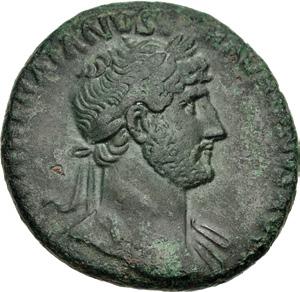
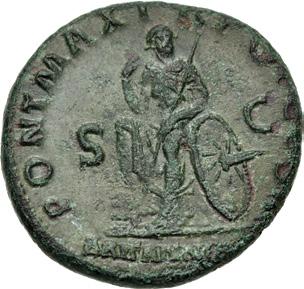
771. Hadrian. AD 117-138. Æ As (24mm, 8.76 g, 5h). Rome mint. Struck AD 119-circa mid 120. Laureate bust right, slight drapery / BRITANNIA in exergue, Britannia seated left, head facing, foot on rock, resting head on hand and holding scepter, elbow resting on large shield. RIC II.3 241; SCBC 635. Attractive green patina. Good VF. ($750)
From the Dr. Malcolm Lyne Collection, purchased from Spink, 17 February 2004.
204
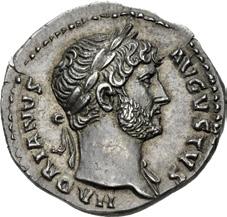
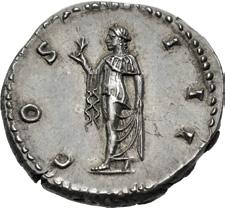
772. Hadrian. AD 117-138. AR Denarius (18mm, 3.34 g, 6h). Rome mint. Struck circa AD 124-125. Laureate bust right, slight drapery / Spes advancing left, holding flower and raising hem of dress. RIC II.3 714; RSC 390. Attractive iridescent cabinet tone. Near EF. Well struck with fresh dies. ($500)
From the I.L. Collection.
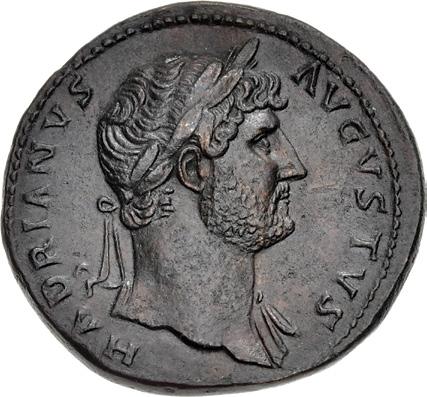
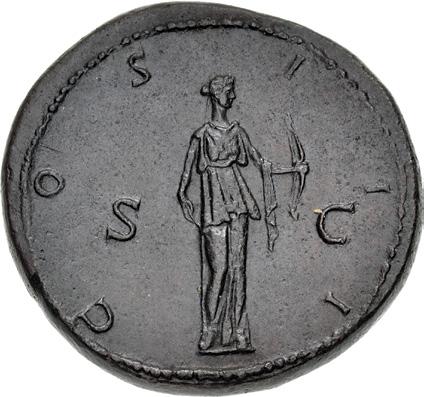
773. Hadrian. AD 117-138. Æ Sestertius (35mm, 28.26 g, 5h). Rome mint. Struck AD 124-127. Laureate bust right, slight drapery / Diana standing right, holding bow and arrow. RIC II.3 738; Banti 177. Brown patina, smoothed. Near EF. ($750)
From the Wild Rose Collection, purchased from Pars Coins. Ex Bertolami Fine Arts 37 (19 September 2017), lot 547; Bertolami 6 (10 December 2012), lot 907.
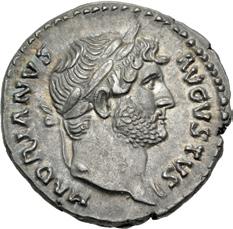
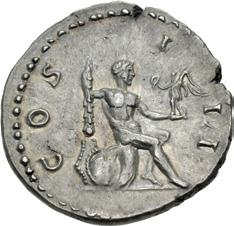
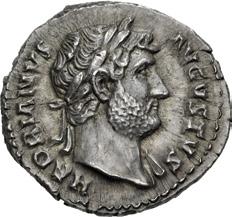
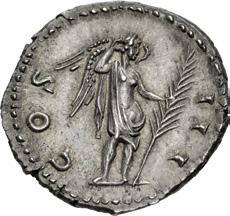
774. Hadrian. AD 117-138. AR Denarius (18.5mm, 3.52 g, 6h). Rome mint. Struck circa AD 125-126/7. Laureate bust right, slight drapery / Hercules, naked, seated right on cuirass, holding club resting on shields, and Victory on extended other hand. RIC II.3 786; RSC 332. Iridescent tone, flan flaw on reverse. EF. ($500)
Ex New York Sale LIV (11 January 2022), lot 289 (hammer $1050); Numismatica Ars Classica 84 (20 May 2015), lot 992.
775. Hadrian. AD 117-138. AR Denarius (18.5mm, 3.44 g, 7h). Rome mint. Struck circa AD 126-127. Laureate bust right, slight drapery / Victory, naked to waist, standing right, crowning herself and holding long palm frond. RIC II.3 848; RSC 358. Attractively toned. EF. ($500)
From the I.L. Collection.
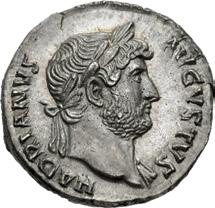


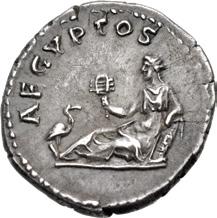
776. Hadrian. AD 117-138. AR Denarius (17.5mm, 3.59 g, 6h). Rome mint. Struck circa AD 126-127. Laureate bust right, slight drapery / Roma or Virtus standing right, left foot on helmet, holding spear and parazonium. RIC II.3 851; RSC 353a. Attractively toned, minor marks on obverse, a patch of hairlines. EF. ($500)
From the I.L. Collection.
777. Hadrian. AD 117-138. AR Denarius (18mm, 3.09 g, 6h). “Travel series” issue (“Provinces cycle”) – The province alone. Rome mint. Struck circa AD 130-133. Bare head right / AEGYPTOS, Egypt reclining left, holding sistrum and resting arm on basket; at feet to left, ibis standing right. RIC II.3 1482; RSC 99. Attractive old cabinet tone, a few shallow scratches under tone. Good VF. ($500)
From the LCM Collection. Ex Roma XX (30 October 2020), lot 602; Arthur Bally-Herzog Collection (Part I, Münzen und Medaillen AG 93, 16 December 2003), lot 157.
205
774
775
776
777
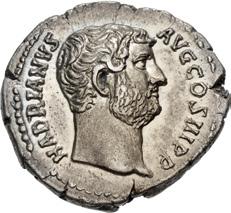
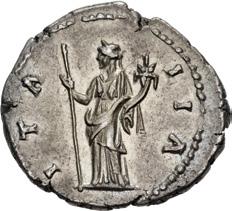
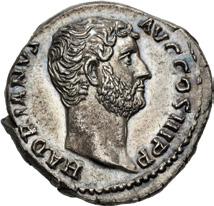
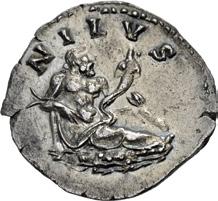
778. Hadrian. AD 117-138. AR Denarius (19mm, 3.07 g, 6h). “Travel series” issue (“Provinces cycle”) – The province alone. Rome mint. Struck circa AD 130-133. Bare head right / ITA LIA, Italia standing left, holding scepter and cornucopia. RIC II.3 1541; RSC 867. Toned, scratches under tone. Good VF. ($500)
From the Wild Rose Collection. Ex Dr. Klaus Berthold Collection (Künker 318, 11 March 2019), lot 1241 (hammer €1200); Gorny & Mosch 113 (18 October 2001), lot 5798.
779. Hadrian. AD 117-138. AR Denarius (17.5mm, 3.17 g, 6h). “Travel series” issue (“Provinces cycle”) – The province alone. Rome mint. Struck circa AD 130-133. Bare head right / NILVS, Nilus reclining right, holding reed and cornucopia; hippopotamus to right. RIC II.3 1544; RSC 989. Toned, some iridescence, a few shallow scratches. EF. ($750)
From the Wild Rose Collection. Ex Dr. Klaus Berthold Collection (Künker 318, 11 March 2019), lot 1242 (hammer €1200); Giessener Münzhandlung 101 (6 March 2000), lot 815.



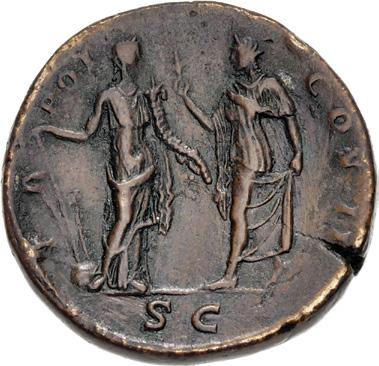
780. Aelius. Caesar, AD 136-138. Æ Sestertius (31mm, 27.56 g, 5h). Rome mint. Struck AD 137. Bare head right / Salus seated left, feeding out of patera snake coiled around and rising from altar to left, resting arm on back of chair. RIC II.3 2672; Banti 27. Green patina, some roughness and porosity. Near EF. ($1000)
From the Wild Rose Collection. Ex Künker 341 (1 October 2020), lot 5915; Nomisma 52 (12 May 2015), lot 89; Astarte 12 (12 September 2003), lot 352; UBS 56 (28 January 2003), lot 267; UBS 55 (16 September 2002), lot 1938; Leu 77 (11 May 2000), lot 699.
781. Aelius. Caesar, AD 136-138. Æ Sestertius (30mm, 22.34 g, 6h). Rome mint. Struck AD 137. Bare head right / Fortuna standing right, holding rudder set on globe and cornucopia, and Spes advancing left, holding flower and raising hem of skirt. RIC II.3 2683; Banti 39. Brown patina, edge split, minor smoothing, a few light scratches. Near EF. An imposing portrait. ($750)
From the Wayne Scheible Collection, purchased from Pars Coins (inv. PCW-R4353). Ex Harlan J. Berk inventory (ticket included); Leu 71 (24 October 1997), lot 385; Schweizerische Kreditanstalt 4 (3 December 1985), lot 5514.
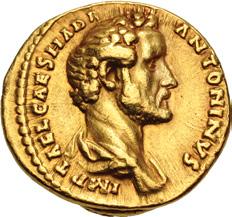

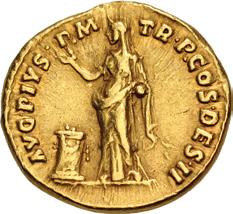
782. Antoninus Pius. AD 138-161. AV Aureus (18.5mm, 6.83 g, 6h). Rome mint. Struck AD 138. Bareheaded and draped bust right / Pietas standing left, raising hand over altar set on ground to left and holding acerra (incense box). RIC III 14b; Calicó 1478 (same obv. die as illustration); Biaggi –. A few light marks, residual luster. VF. ($2000)
206
778 779
780 781
Decastyle Temple of Venus and Roma
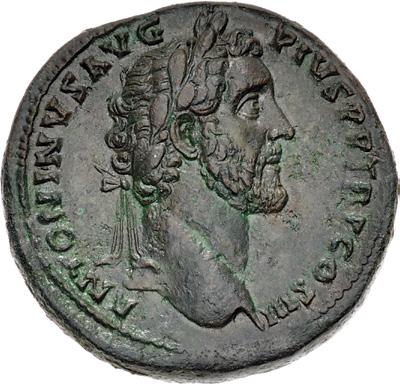
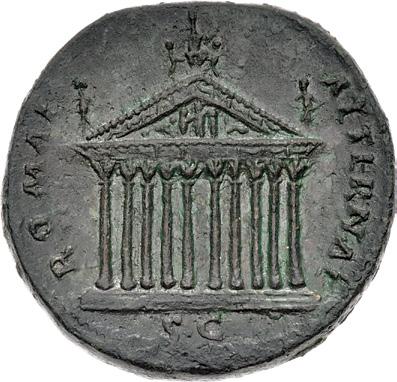
783. Antoninus Pius. AD 138-161. Æ Sestertius (32mm, 27.02 g, 12h). Rome mint. Struck circa AD 141-143. Laureate head right / Decastyle Temple of Venus and Roma on podium of three steps; in pediment, figure in center standing left, flanked by standing and recumbent figures; on roof, in center, Roma seated front on throne, with small figures at left and right; on angles, two Victories(?) holding out open diadems in both hands. RIC III 622; Banti 333; Elkins, Monuments Figure 132. Green-brown patina, areas of minor roughness. Near EF. A wonderful architectural type. ($1000)
From the Wild Rose Collection. Ex Rauch 83 (14 November 2008), lot 255 (hammer €2000).
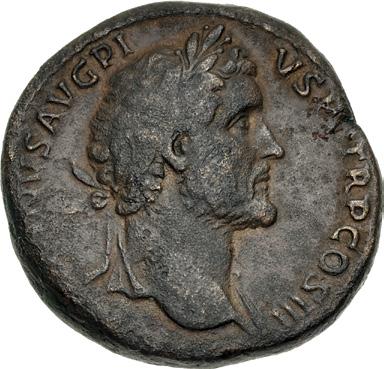
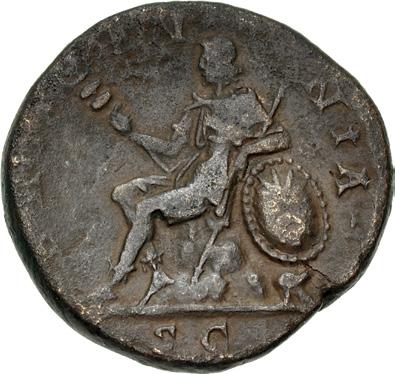
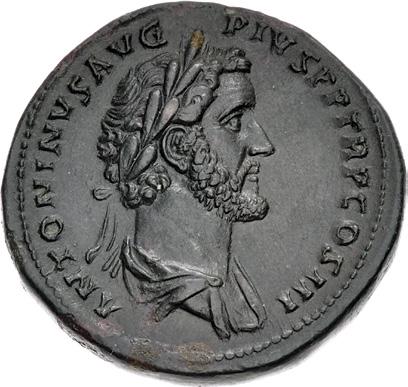

784. Antoninus Pius. AD 138-161. Æ Sestertius (31.5mm, 23.39 g, 5h). Rome mint. Struck circa AD 141-143. Laureate bust right, slight drapery / Britannia seated left on heap of rocks, holding signum and spear, leaning on shield set on helmet. RIC III 742; Banti 44 var. (bust type); SCBC 640 var. (without spear). Rough dark brown surfaces. Near VF. Rare. ($750)
From the Dr. Malcolm Lyne Collection, purchased from David Miller, 30 September 2014.
785. Antoninus Pius. AD 138-161. Æ Sestertius (33mm, 27.10 g, 11h). Rome mint. Struck circa AD 141-143. Laureate and draped bust right / Italia, wearing turreted crown, seated left on globe with zones and stars, holding cornucopia and scepter. RIC III 746b; Banti 195. Green-brown patina, smoothed. Near EF. ($1000)
From the Wild Rose Collection. Ex Michele Gioradano Collection (G. Hirsch 355, 12 February 2020), lot 2160; Lanz 156 (2 June 2013), lot 324.
British Victory Issues
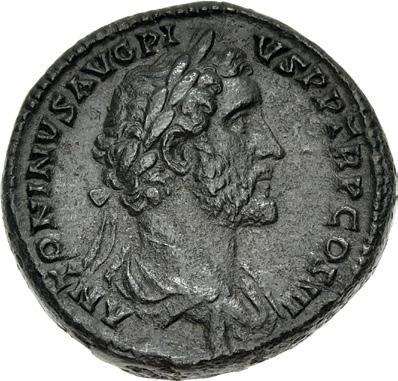
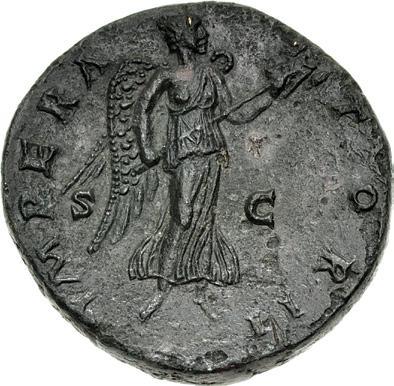
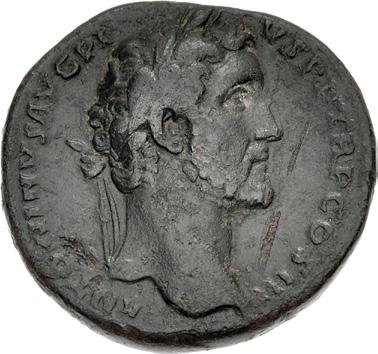

786. Antoninus Pius. AD 138-161. Æ Sestertius (32.5mm, 27.52 g, 11h). British Victory issue. Rome mint. Struck AD 143-144. Laureate and draped bust right / Victory flying right, holding trophy in both hands. RIC III 717b; Banti 179. Dark green-brown patina, slightly rough surfaces. Near EF. ($750)
From the Dr. Malcolm Lyne Collection. Ex Jack A. Frazer Collection (Classical Numismatic Group 114, 13 May 2020), lot 888; Triton IV (5 December 2000), lot 562.
787. Antoninus Pius. AD 138-161. Æ Sestertius (31mm, 21.79 g, 5h). British Victory issue. Rome mint. Struck AD 143144. Laureate head right / IM[PERA] T OR II around, BRI TAN/ S C in two lines across field, Victory standing left on globe, holding wreath and palm frond. RIC III 719; Banti 45; SCBC 643. Dark green patina, minor chipping, scratch on obverse, earthen deposits. VF. ($500)
207
784
785
786
787

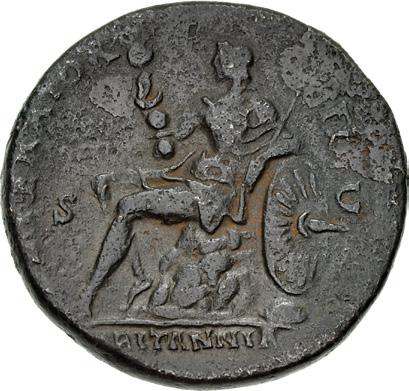
788. Antoninus Pius. AD 138-161. Æ Sestertius (33mm, 24.75 g, 5h). British Victory issue. Rome mint. Struck AD 143144. Laureate head right / [B]RITANNIA in exergue, Britannia seated left on heap of rocks, holding signum and spear, resting left elbow on shield set on cuirass. RIC III 745; Banti 48; SCBC 643A. Dark brown surfaces, a few pits. VF. Rare. ($500)
From the Dr. Malcolm Lyne Collection. Ex CNG inventory 151995 (March 2004).
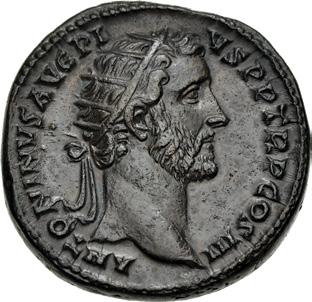



789. Antoninus Pius. AD 138-161. Æ Dupondius (25.5mm, 12.14 g, 12h). British Victory issue. Rome mint. Struck AD 143-144. Radiate head right / Victory, winged and draped, flying right, holding trophy with both hands, pointing upward to right. RIC III 724. Brown surfaces, minor roughness on reverse. EF. ($750)
From the Dr. Malcolm Lyne Collection. Ex Jack A. Frazer Collection (Classical Numismatic Group 114, 13 May 2020), lot 889; Triton IV (5 December 2000), lot 564.
790. Antoninus Pius. AD 138-161. Æ Sestertius (31mm, 28.74 g, 12h). Rome mint. Struck AD 147-148. Laureate head right / Antoninus Pius seated left on daïs; to left, Liberalitas standing left, holding abacus and cornucopia; to right, officer standing left, holding scepter; below, citizen standing right, holding out fold of toga. RIC III 774; Banti 211. Green patina, traces of red, smoothing, some details enhanced, deposits on edge. Good VF. ($750)
From the Wild Rose Collection. Ex Classical Numismatic Group 75 (23 May 2007), lot 1073.
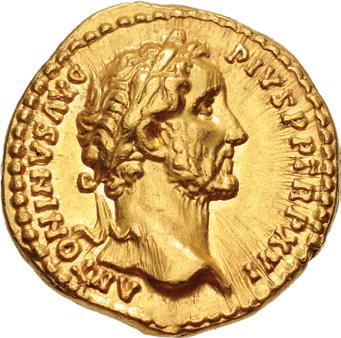
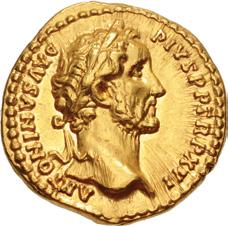
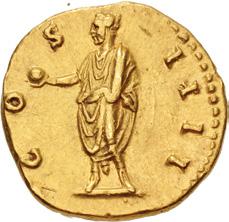
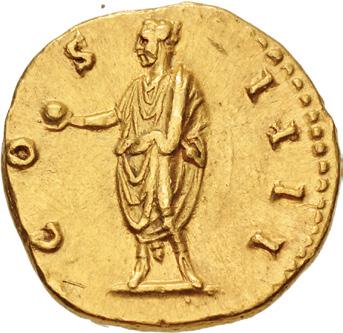
791. Antoninus Pius. AD 138-161. AV Aureus (18.5mm, 7.26 g, 6h). Rome mint. Struck AD 152-153. Laureate head right / Antoninus Pius, togate, standing left, holding globe and volumen. RIC III 226c; Calicó 1521 (same obv. die as illustration; same rev. die as illustration of Calicó 1521a). Lustrous, minor marks and edge marks. Near EF. ($3000)
From the Wild Rose Collection. Ex Münzen und Medaillen AG FPL 541 (March 1991), no. 27.
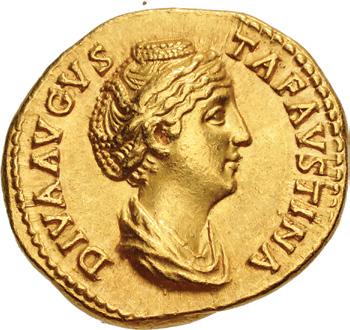


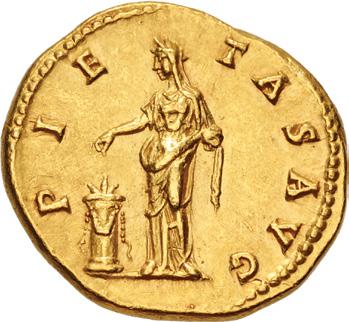
792. Diva Faustina Senior. Died AD 140/1. AV Aureus (19mm, 7.24 g, 6h). Rome mint. Struck under Antoninus Pius, AD 140-145. Draped bust right, wearing hair bound in pearls on top of her head / Pietas, veiled and draped, standing left, holding acerra and dropping incense on lighted and garlanded altar to left. RIC III 394c(a) (Pius); Beckmann dies daf7/PA12; Calicó 1794 (same dies as illustration); Biaggi 826 (same dies); Mazzini 232 (same dies). Underlying luster. EF. ($3000)
From the Wild Rose Collection. Ex Classical Numismatic Group 111 (29 May 2019), lot 710; Stack’s (2 December 1997), lot 357.
208
789
790

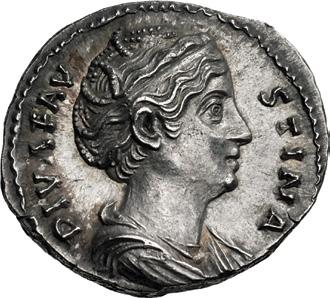

793. Diva Faustina Senior. Died AD 140/1. AR Denarius (18.5mm, 3.44 g, 6h). Rome mint. Struck under Antoninus Pius, circa AD 146-161. Draped bust right, wearing pearls bound on top of her head / Ceres standing left, holding grain ears and torch. RIC III 360 (Pius); RSC 78. Lustrous with a hint of peripheral toning, a tiny delamination on reverse. Superb EF. Struck with fresh dies. ($750)
From the Wayne Scheible Collection. Ex Gemini II (11 January 2006), lot 450 (hammer $3200).
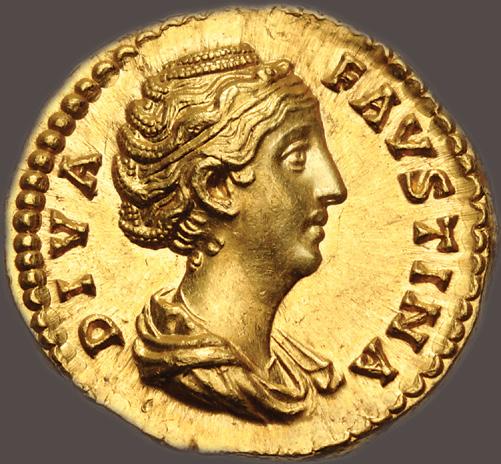
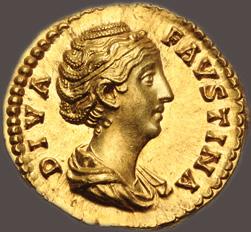
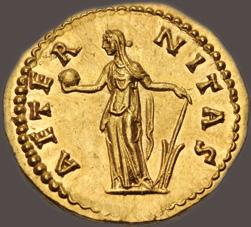
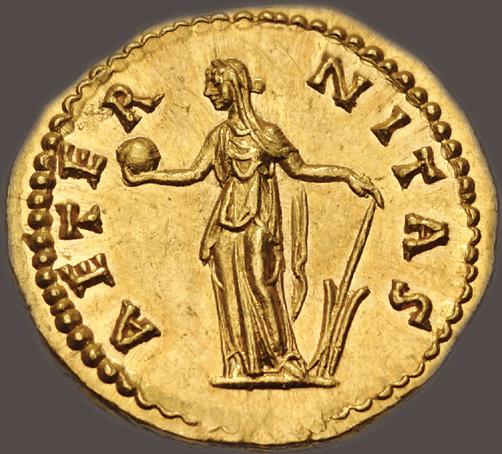
794. Diva Faustina Senior. Died AD 140/1. AV Aureus (20mm, 7.28 g, 6h). Rome mint. Struck under Antoninus Pius, AD 150-161. DIVA FAVSTINA, draped bust right, wearing hair bound in pearls on top of her head / AETE R NITAS, Aeternitas standing left, holding globe in outstretched right hand and rudder set on ground in left. RIC III 348; Beckman dies Df31/AB6; Calicó 1747 (same dies as illustration); BMCRE 359 (Pius); Adda 239; Mazzini 5. Fully lustrous and fine style, some insignificant scratches and a very small dig on reverse. Superb EF. ($10,000)
Ex Willamette Valley Collection; Tauler and Fau 50 (5 February 2020), lot 234; Roma XVIII (29 September 2019), lot 1168; Triton XXII (8 January 2019), lot 1101; Numismatica Ars Classica 106 (9 May 2018), lot 964; PML Collection (Numismatica Ars Classica 100, 29 May 2017), lot 504.
Banti Plate Coin
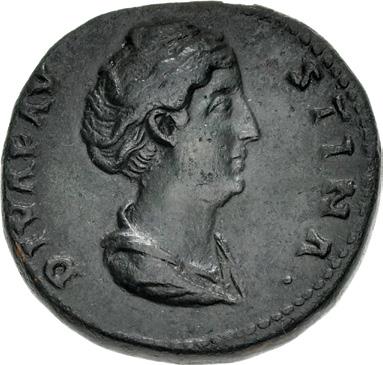
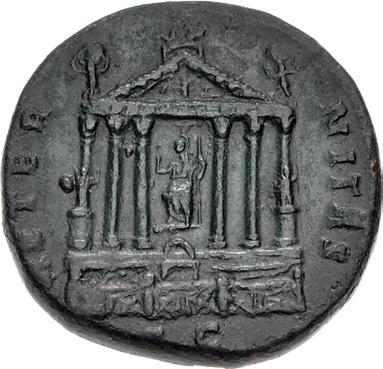
795. Diva Faustina Senior. Died AD 140/1. Æ Sestertius (31.5mm, 25.55 g, 6h). Rome mint. Struck under Antoninus Pius, circa AD 150-151. Draped bust right, wearing hair bound in pearls on top of her head / Temple of Diva Faustina: façade of hexastyle temple on podium of three steps, railing in front, statues before outer columns, relief in base and pediment, quadriga and Victories as acroteria; within, statue of Faustina seated left, holding globe in right hand and spear in left. RIC III 1115a (Antoninus Pius); Banti 27 (this coin illustrated); Elkins, Monuments, Figure 130. Dark green patina, smoothing. VF. ($2000)
From the Wild Rose Collection. Ex DMS Collection (Triton XXVI, 10 January 2023), lot 773 (hammer $4000); CNG inventory 998515 (April 2015); Morton & Eden 72 (15 December 2014), lot 112; Galerie des Monnaies (9 June 1978), lot 1745.
209
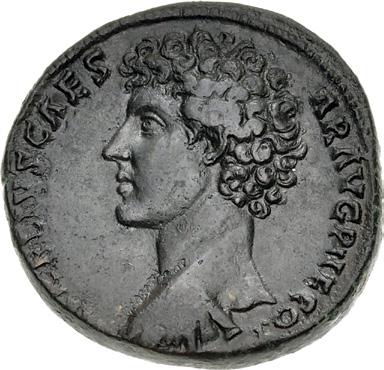
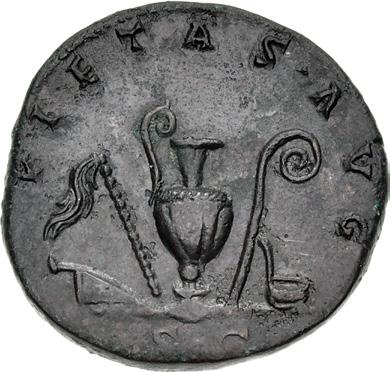
796. Marcus Aurelius. As Caesar, AD 139-161. Æ Sestertius (31mm, 22.59 g, 12h). Rome mint. Struck under Antoninus
Pius, AD 140-144. Bareheaded and cuirassed bust left / Emblems of the pontificate: secespita, aspergillum, guttus, lituus, and simpulum. RIC III 1234 (Pius) var. (bust type); Banti 235 var. (break in obv. legend). Green-brown and red-brown patina, lightly smoothed. Near EF. Young portrait of excellent style. ($500)
From the Wild Rose Collection, purchased from Pars Coins, September 2018.
Extremely Rare With Gorgon on Cuirass
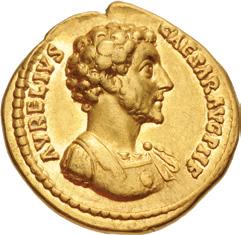

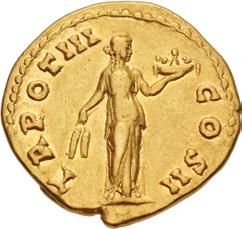
797. Marcus Aurelius. As Caesar, AD 139-161. AV Aureus (19.5mm, 7.05 g, 6h). Rome mint. Struck under Antoninus
Pius, AD 148-149. AVRELIVS CAESAR AVG P II F, Bareheaded and cuirassed bust right, wearing gorgon on cuirass / TR
POT III COS II, Fides, draped, standing right, holding two grain ears in lowered right hand and dish of fruit on raised left hand. RIC III –; Calicó – Strack 199 (same obv. die as illustration); BMCRE –; Leu 86, lot 861 (same dies). Obverse scratch, hairlines. VF. Apparently the fourth known with the gorgon on cuirass (the others: Munich 183854; Leu 86, 861; and NAC 131, 40). ($3000)
From the Wayne Scheible Collection. Ex Adda Collection – Calicó Plate Coin
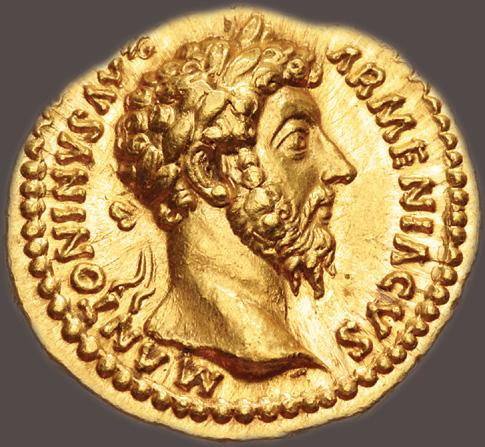
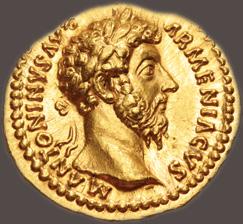
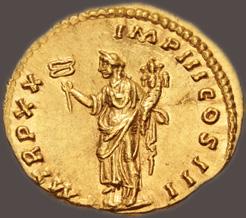

798. Marcus Aurelius. AD 161-180. AV Aureus (19.5mm, 7.29 g, 6h). Rome mint. Struck AD 166. M ΛNTONINVS
ΛVG ΛRMENIΛCVS, laureate head right / P M TR P XX IMP III COS III, Felicitas, draped, standing left, right foot on globe, holding caduceus in right hand and cornucopia in left. RIC III 153; MIR 18, 124-2/30; Calicó 1899 (this coin illustrated); BMCRE p. 439, note 393; Adda 276 (this coin – wrong photo of rev.); Biaggi –; Jameson –; Mazzini –. Lustrous. Superb EF. Portrait of artistic merit. ($7500)
From the Wild Rose Collection. Ex Numismatica Ars Classica 119 (with Jesús Vico, 6 October 2020), lot 103; The Property of a Lady Collection (Christie’s, 8 October 1985), lot 103; Victor A. Adda (†1965) Collection.
210

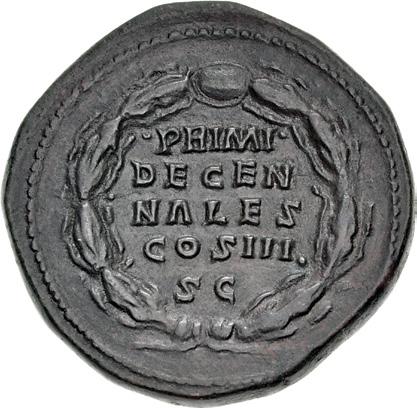


799. Marcus Aurelius. AD 161-180. Æ Sestertius (33.5mm, 30.51 g, 5h). Rome mint. Struck AD 171. Laureate head right / PRIMI/ DECEN/NALES/ COS III/ S C in five lines within wreath. RIC III 1006; MIR 18, 219-6/30; Banti 241. Dark brown patina, minor smoothing. Good VF. Struck on a magnificent medallic flan. ($1000)
From the Wild Rose Collection. Ex J.S. Wagner Collection (Classical Numismatic Group 79, 17 September 2008), lot 1121.
Pedigreed to 1931
800. Faustina Junior. Augusta, AD 147-175. Æ Sestertius (31mm, 25.00 g, 12h). Rome mint. Struck under Antoninus Pius, circa AD 147-150. Draped bust right, wearing double band of pearls around head / Venus standing left, holding apple and anchor, around which a dolphin is coiled. RIC 1388c (Pius); Banti 137. Dark brown patina, smoothed, some roughness on reverse. Good VF. Charming portrait from dies of artistic merit. ($750)
From the Wild Rose Collection. Ex Classical Numismatic Review XLVI.1 (Winter 2021), no. 563143; Hess-Divo 339 (22 October 2020), lot 111; Leu 10 (29 May 1974), lot 183; Helbing 63 (29 April 1931), lot 812.

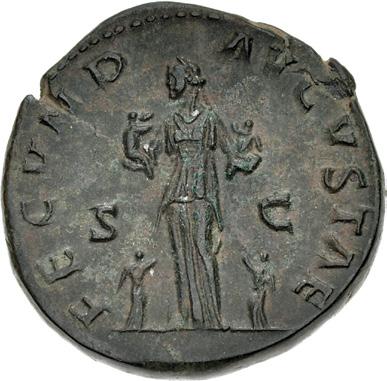

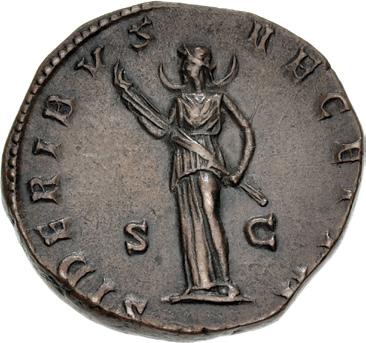
801. Faustina Junior. Augusta, AD 147-175. Æ Sestertius (31.5mm, 23.70 g, 12h). Rome mint. Struck under Marcus Aurelius and Lucius Verus, circa AD 161. Draped bust right / Fecunditas standing left, holding an infant in each arm; a child standing facing her on either side with arm extended upward. RIC III 1635 (Aurelius); MIR 18, 10-6a; Banti 55. Lovely green and brown patina, minor flan flaw on reverse, flan crack. Near EF. A delicate portrait. ($1000)
From the Wild Rose Collection. Ex Edward J. Waddell inventory 53668 (16 January 2020); Numismatica Ars Classica 100 (29 May 2017), lot 523.
802. Diva Faustina Junior. Died AD 175/6. Æ Sestertius (29.5mm, 19.85 g, 7h). Rome mint. Struck under Marcus Aurelius, circa AD 175-176. Draped bust right / Diana Lucifera, standing left, holding torch, crescent behind neck. RIC III 1716 (Aurelius); Banti 122. Attractive brown patina. Good VF. A pleasing portrait. ($500)
From the Wayne Scheible Collection. Ex Classical Numismatic Group 46 (24 June 1998), lot 1287; Triton I (2 December 1997), lot 1498; Classical Numismatic Group 41 (19 March 1997), lot 1972; Classical Numismatic Group 38 (6 June 1996), lot 1029; Giessener Münzhandlung 73 (11 October 1995), lot 395; Giessener Münzhandlung 67 (2 May 1994), lot 550.
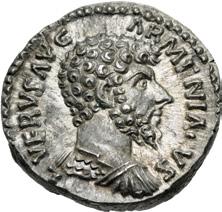
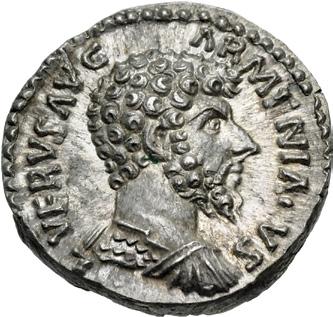
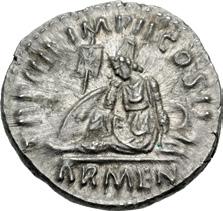
803. Lucius Verus. AD 161-169. AR Denarius (17.5mm, 3.50 g, 6h). Rome mint. Struck AD 164. Bareheaded and cuirassed bust right / Armenia seated left on ground in attitude of mourning; shield and vexillum to left, bow and quiver to right. RIC III 509 var. (bust type); MIR 18, 69-14/15; RSC 8 var. (same). Lightly toned, underlying luster, traces of green deposits on obverse. EF. Rare bust variety. ($500)
Ex Künker 262 (13 March 2015), lot 8116.
211
799 800 801 802
Ex Dr. Paul Hartwig Collection – Pedigreed to 1910
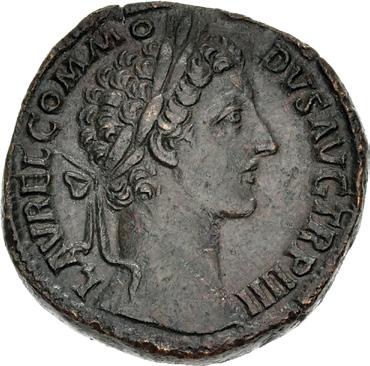
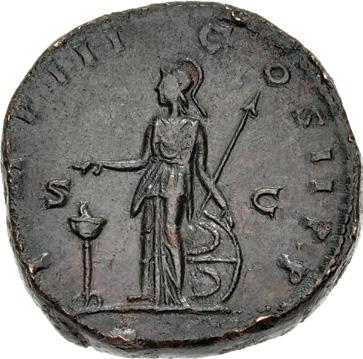
804. Commodus. AD 177-192. Æ Sestertius (30.5mm, 26.45 g, 6h). Rome mint. Struck under Marcus Aurelius and Commodus, AD 179. Laureate head right / Minerva standing left, dropping incense on candelabrum and holding shield set on ground; transverse spear rests against her left arm. RIC III (Aurelius) 1607 corr. (obv. legend); MIR 18, 452-16/30 (this coin cited and rev. illustrated on plate 12, Minerva 1); Banti 132 (this coin cited and illustrated). Green and brown patina, smoothed, details strenghtened. Good VF. ($500)
From the Wayne Scheible Collection, purchased from Harlan J. Berk, Ltd. Ex Dr. Paul Hartwig Collection (Santamaria [2], 7 March 1910), lot 1687.
Pedigreed to 1970

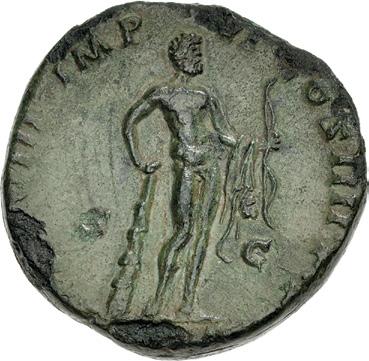
805. Commodus. AD 177-192. Æ Sestertius (30mm, 21.49 g, 12h). Rome mint. Struck AD 183. Laureate head right / Hercules, naked, standing front, head right, resting hand on club set on ground and holding bow, lion skin over left arm. RIC III 365; MIR 18, 585-6/30; Banti 460. Light green patina, chipped at edges, shallow cleaning scratches on reverse. Good VF. ($500)
From the Wild Rose Collection. Ex Hess-Leu 45 (12 May 1970), lot 565.
British Victory Issue

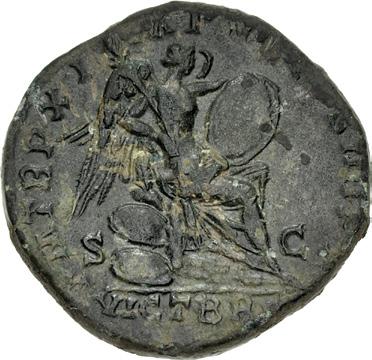
806. Commodus. AD 177-192. Æ Sestertius (30.5mm, 19.94 g, 11h). British Victory issue. Rome mint. Struck AD 185. Laureate head right / VICT BRIT in exergue, Victory seated right on heap of stones, holding long stylus, and placing hand on shield set on knee; two shields on ground to left. RIC III 452; MIR 18, 665-6/30 var. (VIC BRIT); Banti 486; SCBC 648. Attractive dark green patina. Good VF. ($750)
From the Dr. Malcolm Lyne Collection, purchased from Baldwin’s, 8 May 2015.
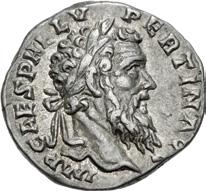
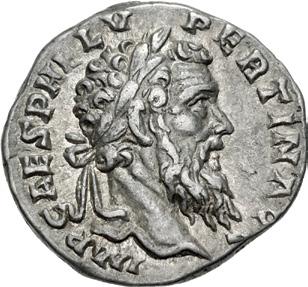
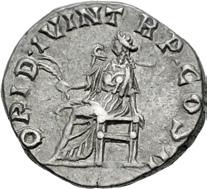
807. Pertinax. AD 193. AR Denarius (17mm, 3.12 g, 6h). Rome mint. 2nd emission. Laureate head right / Ops seated left, holding two grain ears and resting hand on seat of throne. RIC IV 8a; Lempereur Type 9, 487 (D177/R258); RSC 33. Toned. Good VF. ($1000)
From the I.L. Collection. Ex Naville Numismatics 45 (9 December 2018), lot 496.
212
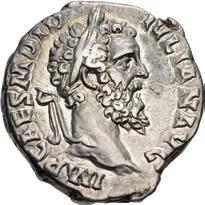

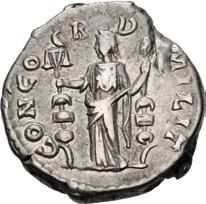
808. Didius Julianus. AD 193. AR Denarius (16.5mm, 3.11 g, 6h). Rome mint. Laureate head right / Concordia standing left, holding aquila and signum. RIC IV 1; RSC 2. Lightly toned, flan flaw on reverse. VF. ($1000)
From the Wild Rose Collection. Ex Gorny & Mosch 216 (15 October 2013), lot 3095.
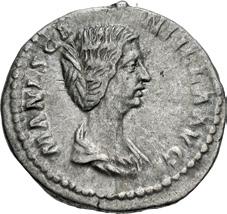
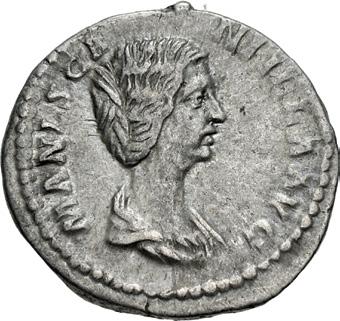
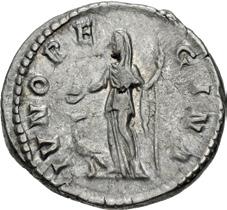
809. Manlia Scantilla. Augusta, AD 193. AR Denarius (18.5mm, 3.30 g, 11h). Rome mint. Struck under Didius Julianus. Draped bust right / Juno standing left, holding patera and scepter; at feet, peacock standing left. RIC 7a (Julianus); RSC 2. Toned, faint hairlines, minor flan flaw and a couple of deposits on reverse. VF. ($1000)
From the I.L. Collection. Ex Dr Klaus Berthold Collection (Künker 318, 11 March 2019) lot 1364; Lanz 86 (18 May 1998), lot 512.
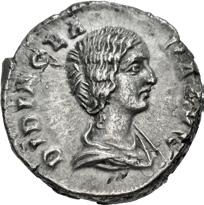
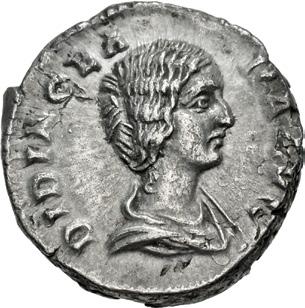

810. Didia Clara. Augusta, AD 193. AR Denarius (16.5mm, 2.57 g, 12h). Rome mint. Struck under Didius Julianus. Draped bust right / Hilaritas standing left, holding long palm frond and cornucopia. RIC IV 10 (Julianus); RSC 3. Lightly toned, flan flaws. Near EF. Wonderful portrait. ($1500)
From the I.L. Collection. Ex Numismatica Ars Classica 84 (20 May 2015), lot 1052.
Ex Bement Collection – Pedigreed to 1924
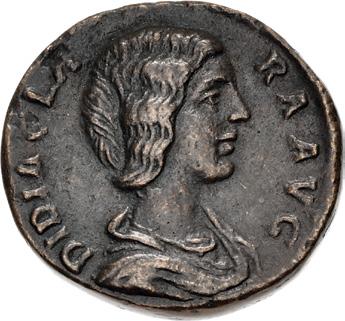

811. Didia Clara. Augusta, AD 193. Æ Sestertius (28mm, 17.15 g, 12h). Rome mint. Struck under Didius Julianus. Draped bust right / Hilaritas standing left, holding long palm frond and cornucopia. RIC IV 20 (Didius); Woodward, Didius 2 (dies 2/N – this coin illustrated); Banti 1 (this coin illustrated). Beautiful brown patina, hints of smoothing. Good VF. Wonderful portrait. The sole Didia Clara sestertius illustrated by Banti. ($750)
From the Wayne Scheible Collection. Ex Clarence S. Bement Collection (Naville VIII, 25 June 1924), lot 1148.
213
Ex Garrett Collection – Pedigreed to 1921
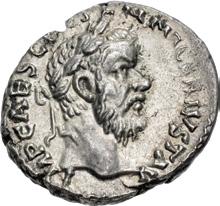

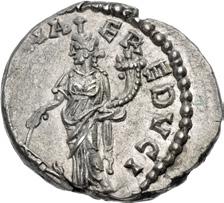
812. Pescennius Niger. AD 193-194. AR Denarius (18mm, 3.69 g, 12h). Antioch mint. Laureate head right / Fortuna standing left, holding rudder and cornucopia. RIC IV 26c; RSC 28a. Toned, traces of deposits, reverse struck off center, test cut on edge. Near EF. ($1500)
From the Wild Rose Collection. Ex C.G. Collection (Numismatica Ars Classica 80, 20 October 2014), lot 123; ‘A Friend of the Romans’ Collection (Münzen und Medaillen AG 92, 22 November 2002), lot 123; Numismatic Fine Arts XX (9 March 1988), lot 241; Johns Hopkins University Collection [inv. 44.6.318] (Part I, Numismatic Fine Arts and Bank Leu, 16 October 1984), lot 828; John Work Garrett Collection [inv. 800], purchased from S. H. Chapman, 15 February 1921.
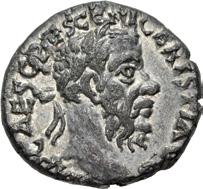


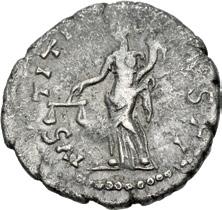
813. Pescennius Niger. AD 193-194. AR Denarius (16.5mm, 3.09 g, 12h). Antioch mint. IMP CAES C PESCE NIGER ISTI AVG, laureate head right / INVICTO IMPER[AT], trophy with arms at base. RIC IV 34a var. (obv. legend); RSC 33 var. (same). Attractively toned. Good VF. Rare variety. ($2000)
From the I.L. Collection. Ex Künker 216 (8 October 2012), lot 1100.
814. Pescennius Niger. AD 193-194. AR Denarius (17.5mm, 3.02 g, 6h). Antioch mint. Laureate head right / Justitia standing left, holding scales and cornucopia. RIC IV 47c var. (obv. legend); RSC 47b. Toned, porosity. VF. ($1500)
From the I.L. Collection. Ex Classical Numismatic Group Electronic Auction 348 (8 April 2015), lot 642.
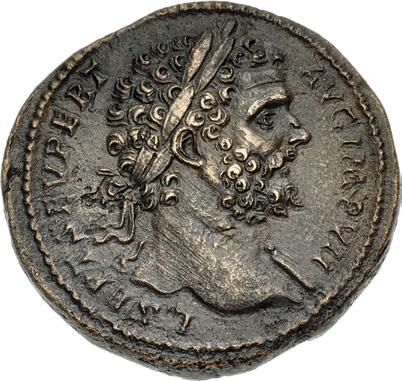
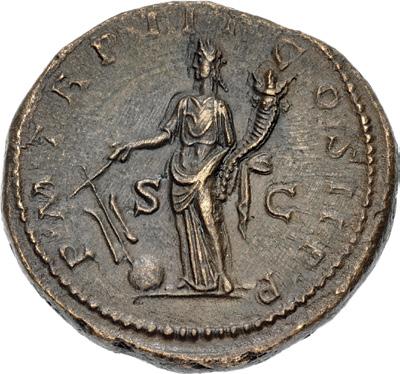
815. Septimius Severus. AD 193-211. Æ Sestertius (32.5mm, 26.24 g, 12h). Rome mint. Struck AD 195-196. Laureate bust right, slight drapery / Fortuna standing left, holding rudder set on globe and cornucopia. RIC IV 706; Banti 92. Brown surfaces, brassy highlights. Near EF. Wonderful portrait. Rare in this condition. ($2000)
From the Wild Rose Collection. Ex Vico 137 (6 March 2014), lot 426 (hammer €4000).
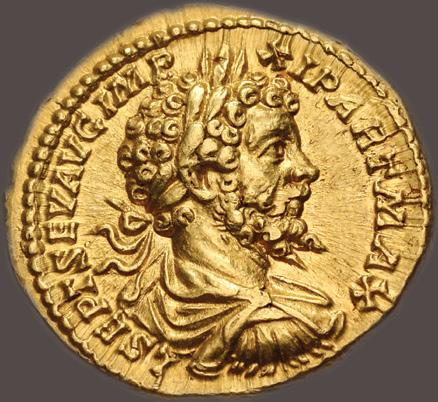

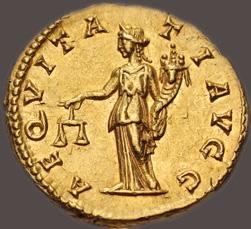
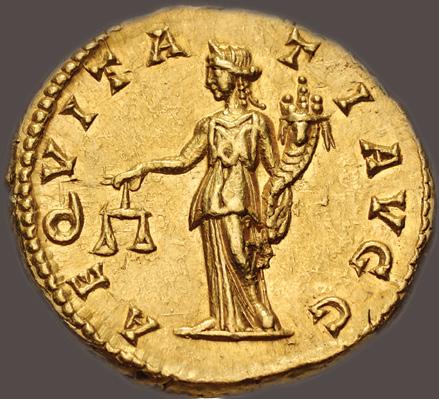
816. Septimius Severus. AD 193-211. AV Aureus (20mm, 7.32 g, 6h). Rome mint. Struck AD 198-200. L SEPT SEV
AVG IMP XI PART MAX, laureate, draped, and cuirassed bust right / AEQVITA T I AVGG, Aequitas, draped, standing left, holding scales in right hand and cornucopia in left. RIC IV 122a; Calicó 2431a (same rev. die as illustration); Biaggi 1063. Lustrous, shallow scrape on obverse. EF. ($7500)
214
813
814
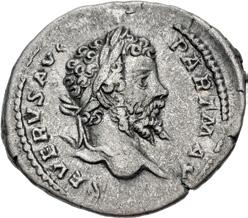
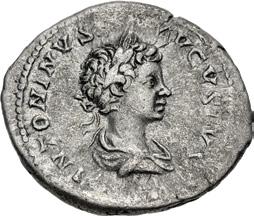
817. Septimius Severus, with Caracalla. AD 193-211. AR Denarius (20.5mm, 3.21 g, 6h). Dynastic issue. Rome mint. Struck AD 200-201. Laureate head of Septimius Severus right / Laureate and draped bust of Caracalla right. RIC IV 157; RSC 2b. Toned, granular surfaces. VF. ($500)
From the Weise Collection. Ex Classical Numismatic Group 57 (4 April 2001), lot 1320.
The Eternity of the Dynasty


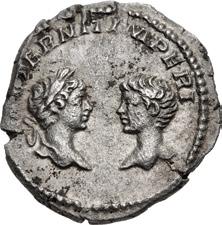
818. Septimius Severus, with Caracalla and Geta as Caesar. AD 193-211. AR Denarius (18mm, 2.72 g, 6h). Dynastic issue. Rome mint. Struck AD 201-202. Laureate head of Septimius right / Laureate head of Caracalla right and bare head of Geta left, facing one another. RIC IV 252; RSC 7. Toned, granular surfaces, deposits, slight bend in flan. Good VF. ($500)
From the Weise Collection. Ex Gorny & Mosch 115 (5 March 2002), lot 1703. Without an heir to take up the throne, the possibility of a civil war erupting after the death of an emperor was an enormous threat to public safety. This scarce issue proclaims the continuity – even the eternity – of the dynasty, depicting both of Severus’ successors.
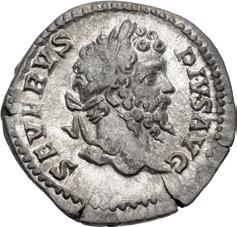
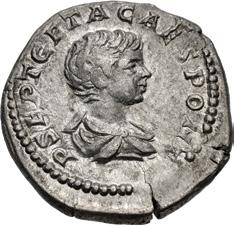
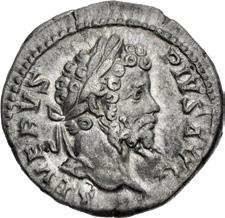
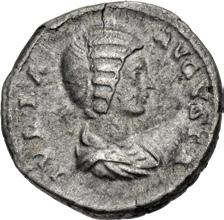
819. Septimius Severus, with Geta as Caesar. AD 193-211. AR Denarius (19mm, 3.01 g, 1h). Dynastic issue. Rome mint. Struck AD 201-205. Laureate head of Septimius Severus right / Bareheaded and draped bust of Geta right. Cf. RIC IV 281; RSC 2; BMCRE p. 221, note *. Toned, slightly granular surfaces, flan crack. VF. Rare. ($500)
From the Weise Collection, purchased from Jonathan K. Kern, Jan 16, 2002.
820. Septimius Severus, with Julia Domna. AD 193-211. AR Denarius (18mm, 3.54 g, 12h). Dynastic issue. Rome mint. Struck circa AD 202-205. Laureate head of Septimius Severus right / Draped bust of Julia Domna right. RIC IV 273; RSC 3. Toned, slightly granular surfaces, struck with a worn reverse die, flan crack. VF. ($750)
From the Weise Collection. Ex Classical Numismatic Group 57 (4 April 2001), lot 1319.
Circus Scene
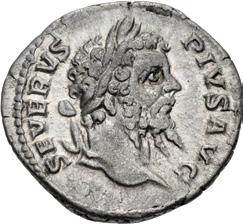


821. Septimius Severus. AD 193-211. AR Denarius (19.5mm, 3.19 g, 6h). Rome mint. Struck AD 202. Laureate head right / Ship with mast and sail in center of circus; above, four quadrigae driven left; below, ostrich, lion, zebra, bear and stag right, bull butting left, bear right, head left. RIC 274; RSC 253. Light toning. VF. ($500)
From the Weise Collection. Ex Triton V (15 January 2002), lot 2018.
After the victory over the Parthians, seven-day games were held in the Circus Maximus. A ship was set up in the middle of the arena and a hundred exotic animals were released from its belly every day. The reverse picture shows different sections of the festivities. The chariot races can be seen in the upper area, the ship in the middle, and the wild animals below.
215
819 820
The Arch of Septimius Severus
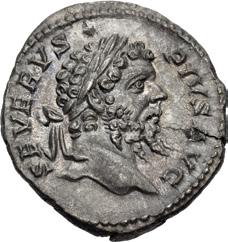


822. Septimius Severus. AD 193-211. AR Denarius (18.5mm, 3.46 g, 12h). Rome mint. Struck AD 203. Laureate head right / Arch of Septimius Severus: arch consisting of large central bay and two smaller flanking bays divided by four columns; attic surmounted by statues of Septimius in a chariot drawn by six horses, flanked by figures of Caracalla and Geta on horseback. RIC IV 259; RSC 104; Elkins, Monuments Figure 140. Iridescent toning, underlying luster, flan crack. EF. Impressive details on the historic Triumphal Arch of Severus. ($2000)
From the Wild Rose Collection, purchased from Antiqua, January 2017. Ex Edward J. Waddell inventory C36645 (2002); Rauch 67 (Part I, 26 February 2001), lot 518; Tkalec (29 February 2000), lot 295.
Unique
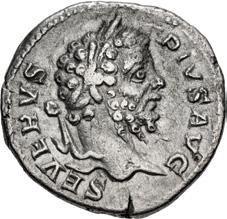
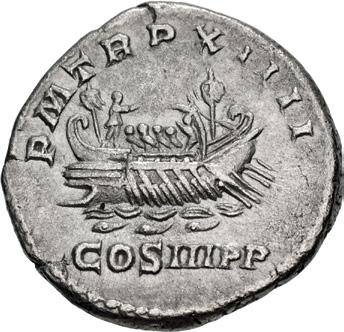
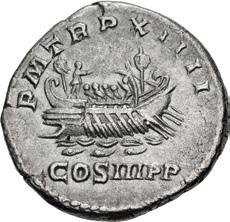
823. Septimius Severus. AD 193-211. AR Denarius (18.5mm, 3.02 g, 6h). Rome mint. Struck AD 206. SEVERVS PIVS AVG, laureate head right / P M TR P XIIII, COS III P P in exergue, galley left with rowers. Cf. RIC IV 215; cf. RSC 499. Lightly toned, granular surfaces. VF. Unique with this TR P XIIII. ($1000)
From the Weise Collection, purchased from Barry P. Murphy, 13 January 2006.



824. Septimius Severus. AD 193-211. AR Denarius (21mm, 2.59 g, 6h). Rome mint. Struck AD 207. Laureate head right / Small head of Medusa facing, on aegis. RIC IV 286; RSC 591; BMCRE 357. Some hard green deposits, flan crack. Good VF. Rare. ($1000)
From the Weise Collection. Ex Gorny & Mosch 134 (11 October 2004), lot 2888.
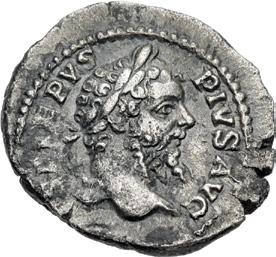
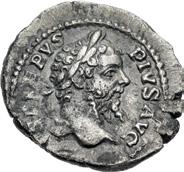
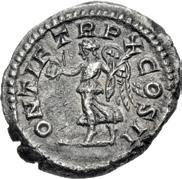
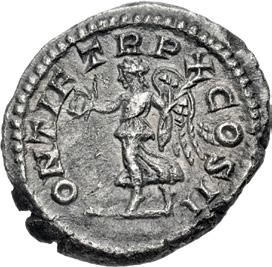
825. Septimius Severus. AD 193-211. AR Quinarius (15mm, 1.91 g, 1h). Rome mint. Struck AD 207. Laureate head right / Victory advancing left, holding wreath and palm frond. RIC IV 323; King 16; BMCRE p. 228, 22 (Septimius and Caracalla hybrids) and p. 381, 136 (Septimius, Caracalla, and Geta barbarous and irregular); RSC 569. Toned, some roughness and porosity, slightly ragged edge. Good VF. High grade for issue. An extremely rare issue muling a reverse intended for Caracalla. ($750)
From the Wiese Collection, purchased from Herb Kreindler, January 2008.
216


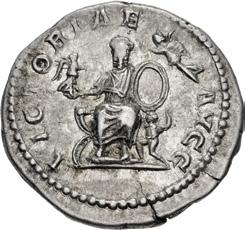
826. Septimius Severus. AD 193-211. AR Denarius (20mm, 3.15 g, 6h). Rome mint. Struck AD 208. Laureate head right / Septimius Severus seated facing on curule chair, holding small Victory and leaning on shield (or orb), born by small figure (Atlas?) kneeling left; above to right, Victory flying left crowning the emperor. RIC IV 301; RSC 717. Lightly toned, a couple of flan cracks. VF. Very rare. ($750)
From the Weise Collection. Ex Helios 5 (25 June 2010), lot 299 (hammer €1500).
The River Tyne?

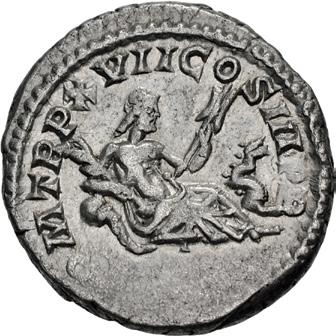
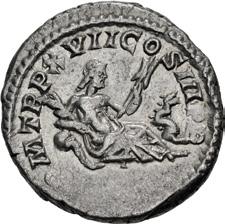
827. Septimius Severus. AD 193-211. AR Denarius (18mm, 3.32 g, 6h). Rome mint. Struck AD 209. Laureate head right / Sea or river god (Oceanus, Triton, or Tyne?) reclining right, holding shell and rudder; seahorse at feet. RIC IV 229; RSC 530. Small flan flaw on obverse. Good VF. Very rare. ($500)
From the Weise Collection. Ex Marc Melcher Collection (Classical Numismatic Group 61, 25 September 2002), lot 1906.
Although RIC identifies the figure on the reverse as a “Sea-god (Triton?),” it is suggested in RSC that: “The river-god on the reverse could easily be the Tyne in Northern Britain. Severus was on the Northern frontier in 209, when the coin was struck, and was engaged in repairing the Wall. The fort of Arbeia (South Shields), on the south bank of the Tyne, was the supply depot for the Scottish campaigns of Severus, which commenced in 209.”
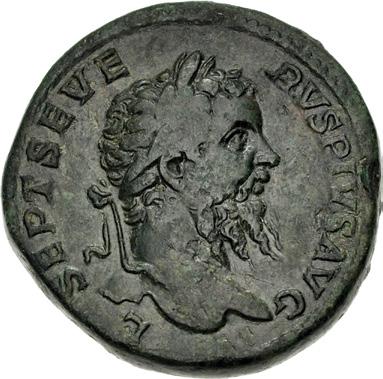
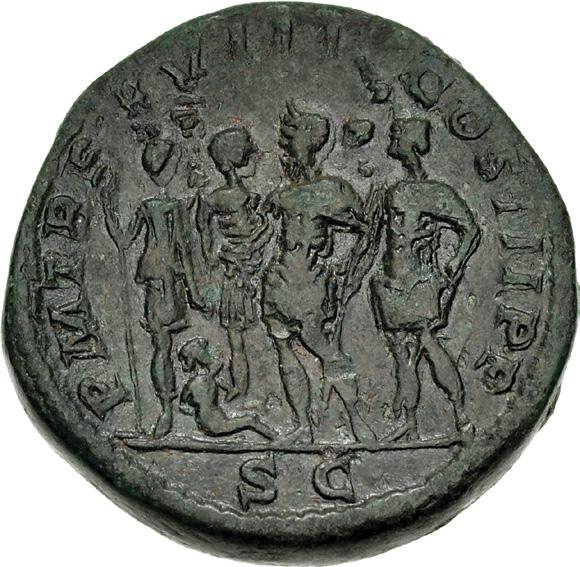
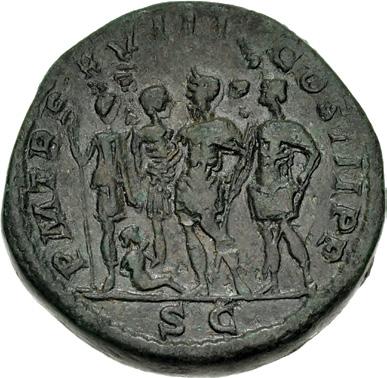
828. Septimius Severus. AD 193-211. Æ Sestertius (31mm, 27.42 g, 6h). British Victory issue. Rome mint. Struck AD 210. Laureate head right / ‘Triumph’ group: Septimius Severus in military dress, between Caracalla and Geta; to left, two soldiers, the one on left holding a spear, the other holding an aquila; on ground to left, Caledonian captive seated right. RIC IV 799a; Banti 128. Attractive dark green patina, smoothed. VF. Rare. ($1500)
From the Dr. Malcolm Lyne Collection, purchased from David Miller, 19 January 2010.
217
British Victory Sestertius
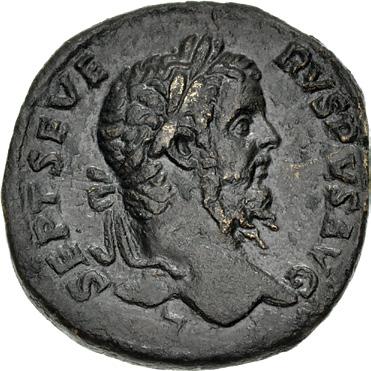
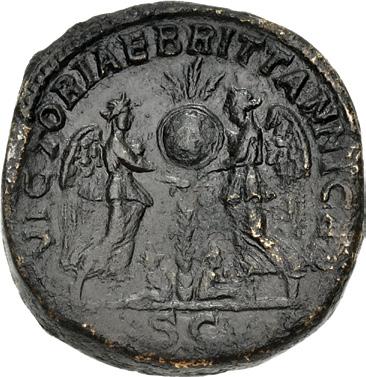
829. Septimius Severus. AD 193-211. Æ Sestertius (30mm, 25.68 g, 12h). British Victory issue. Rome mint. Struck AD 210. Laureate head right / VICTORIAE BRITTANNICAE, S C in exergue, two Victories hanging round shield on palm tree; at base, two captives seated left and right. RIC IV 818; Banti 167; SCBC 652. Dark brown surfaces, smoothing. VF. ($500)
From the Dr. Malcolm Lyne Collection, purchased from Baldwin’s, 10 April 2022. Ex Baldwin’s 26 (9 May 2001), lot 1839.

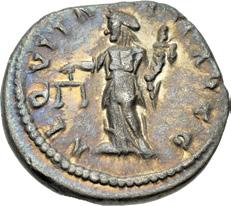
830. Septimius Severus. AD 193-211. AR Denarius (18mm, 2.79 g, 6h). ‘New style’. Laodicea ad Mare mint. Struck AD 198-202. L SEPT SEV AVG IMP XI PART MAX, laureate and cuirassed half-length bust right, wearing aegis on breast plate / AE QVITA T I AVGG, Aequitas standing left, holding scales and cornucopia. RIC IV 500 var. (bust type); RSC 21b; BMCRE p. 624, 650A; Numismatik Naumann 117, lot 860 (same obv. die). Colorful iridescent toning, slightly granular surfaces. VF. Very rare with this bust type. ($500)
From the Weise Collection, purchased from Mark Breitsprecher, 2003.
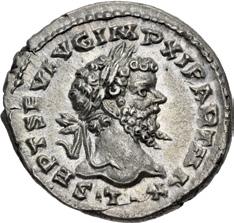
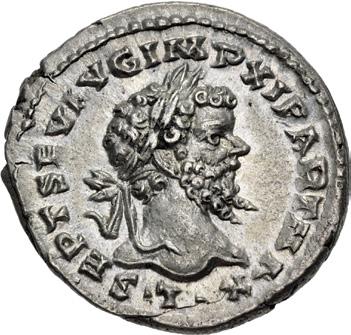
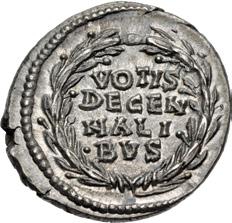
831. Septimius Severus. AD 193-211. AR Denarius (19mm, 3.49 g, 6h). ‘New style’. Laodicea ad Mare mint. Struck AD 198-200. Laureate head right / VOTIS/ DECEN/NALI/BVS in four lines within laurel wreath. RIC IV 520a; RSC 798. Lightly toned, traces of deposits, flan flaw on edge. EF. ($500)
From the Wild Rose Collection. Ex L. Herold Collection (Hess-Divo 324, 23 October 2013), lot 40.
One of Three Known

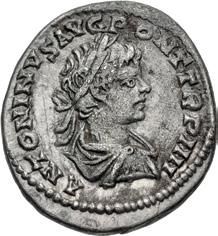
832. Septimius Severus, with Caracalla. AD 193-211. AR Denarius (17mm, 3.00 g, 12h). ‘New style’. Laodicea ad Mare mint. Struck AD 200-201. L SEPT SEV AVG IMP XI PART MAX, laureate head of Septimius Severus right / ANTONINVS AVG PONT TR P IIII, laureate, draped, and cuirassed bust of Caracalla right. Cf. RIC IV 521b; RSC 6a/4 (for obv./rev. types); cf. BMCRE p. 297, notes ‡ and §; Triton VI, lot 964 (same dies); Heritage 3054, lot 32114. Toned, porosity, minor deposits. VF. One of three known. Extremely rare. ($500)
From the Weise Collection. Ex Berk BBS 128 (15 August 2002), lot 341.
218
Ex Hartwig Collection – Pedigreed to 1910
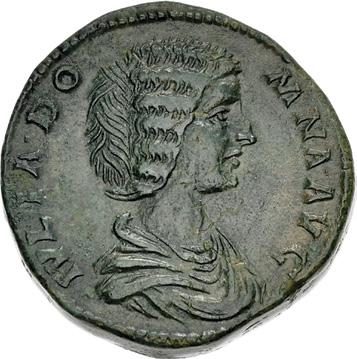

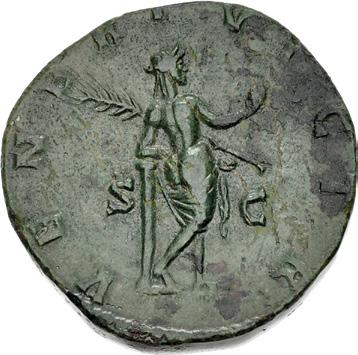
833. Julia Domna. Augusta, AD 193-217. Æ Sestertius (29mm, 23.34 g, 12h). Rome mint. Struck under Septimius Severus, circa AD 193-196. Draped bust right / Venus Victrix, naked to hips, standing right, leaning on column to left, holding palm frond and apple. RIC IV 842 (Septimius); Banti 45 (this coin cited and illustrated). Green patina. Good VF. Wonderful portrait and patina. ($1000)
From the Wayne Scheible Collection. Ex UBS 78 (9 September 2008), lot 1756 (hammer CHF 5250); Dr. Paul Hartwig Collection (Santamaria [2], 7 March 1910), lot 1723.
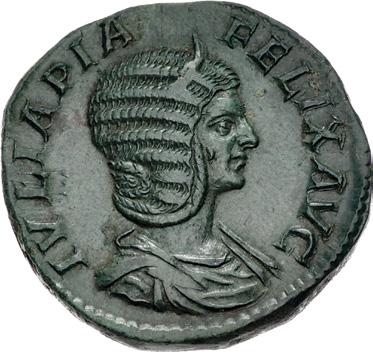
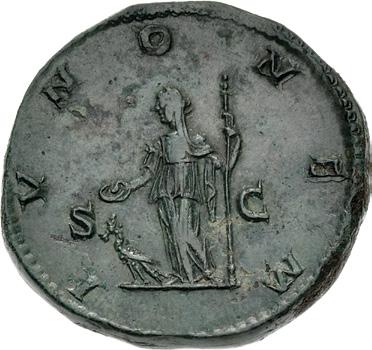

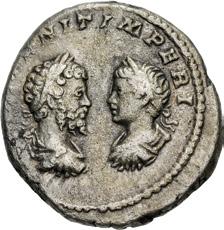
834. Julia Domna. Augusta, AD 193-217. Æ Sestertius (31mm, 24.58 g, 6h). Rome mint. Struck under Caracalla, AD 211-215. Draped bust right, wearing stephane / Juno standing left, holding patera and scepter; at feet to left, peacock standing left, head right. RIC IV 585a (Caracalla); Banti 22; A. Pangerl, Portraits: 500 Years of Roman Coin Portraits (München, 2017), no. 321 (this coin illustrated). Superb enamel-like dark green patina, minor area of weakness. EF. ($1500)
From the Wild Rose Collection, purchased from Martina Dieterle, October 2017. Ex Luc Girard Collection (Numismatica Ars Classica 54, 24 March 2010), lot 493 (hammer CHF 6500).
Rare Dynastic Denarius
835. Caracalla, with Septimius Severus. AD 198-217. AR Denarius (18.5mm, 2.60 g, 11h). Dynastic issue. Rome mint. Struck 199-201. Laureate, draped, and cuirassed bust of Caracalla right / Busts of Septimius Severus, laureate, draped, and cuirassed right, facing Caracalla, laureate, draped, and cuirassed left. RIC IV 32; RSC 2 (Caracalla and Septimius Severus). Toned, porosity. Near VF. Rare. ($500)
From the Weise Collection, purchased from Jonathan K. Kern.
Very Rare Severan Dynastic Issue
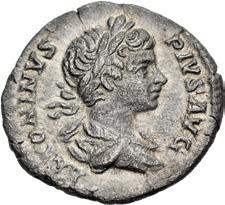
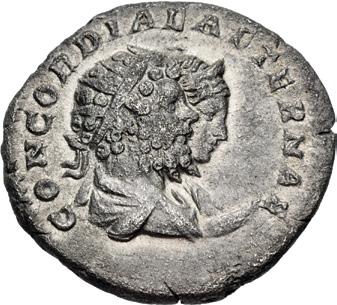

836. Caracalla, with Septimius Severus and Julia Domna. AD 198-217. AR Denarius (18mm, 2.27 g, 6h). Dynastic issue. Rome mint. Struck AD 201-202. Laureate and draped bust of Caracalla right / Jugate busts right of Severus, radiate and draped, and Domna, diademed and draped, set on crescent. RIC IV 125a; RSC 5a. Toned, porous surfaces. VF. Very rare. ($1000)
From the Weise Collection. Ex Marc Melcher Collection (Classical Numismatic Group 61, 25 September 2002), lot 1953.
219
834 835
Four Seasons Denarius
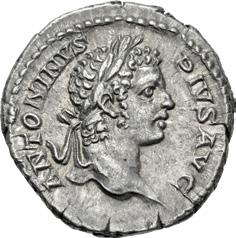
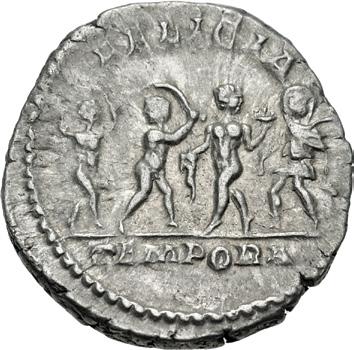
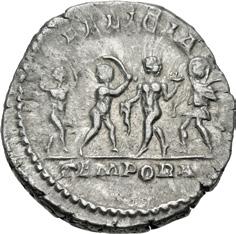
837. Caracalla. AD 198-217. AR Denarius (19mm, 3.79 g, 6h). Rome mint. Struck AD 206. Laureate head right / The Four Seasons as boys at play: from left to right, Spring carries a basket on his head, Summer holds a sickle above his head, Autumn holds a hare and a tray full of fruit, Winter wears a hood over his head and holds a bird which he has just captured, probably a wild duck. RIC IV 153; RSC 59. Lightly toned. Good VF. Rare. ($500)
From the Wayne Scheible Collection. Ex Berk BBS 169 (1 June 2010), lot 335; Tkalec (7 May 2009), lot 163.
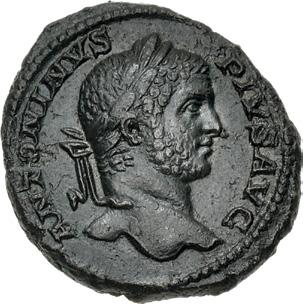
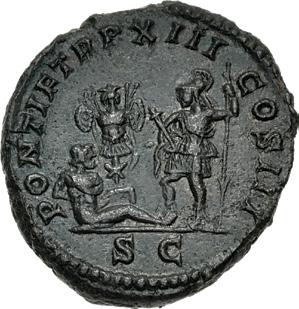
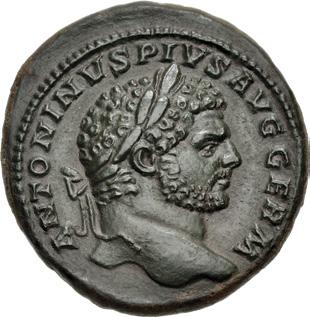
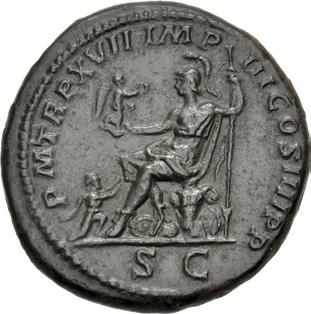
838. Caracalla. AD 198-217. Æ As (24.5mm, 10.59 g, 6h). Rome mint. Struck AD 210. Laureate head right / Virtus standing left, right foot on helmet, holding parazonium and spear; to left, captive seated right at base of trophy. RIC IV 458. Dark green-brown patina. Near EF. ($750)
From the Dr. Malcolm Lyne Collection. Ex Classical Numismatic Group 117 (19 May 2021), lot 578; Jack A. Frazer Collection (Classical Numismatic Group 114, 13 May 2020), lot 943; Classical Numismatic Group 69 (8 June 2005), lot 1659.
839. Caracalla. AD 198-217. Æ As (24.5mm, 8.91 g, 6h). Rome mint. Struck AD 214. Laureate head right / Roma seated left on cuirass, right foot resting on a helmet, holding Victory and inverted spear; to left, German kneeling right, raising hands to Roma. RIC IV 533. Green patina, minor cleaning/smoothing marks. Near EF. ($500)
Very Rare British Victory Issue – Banti Plate Coin
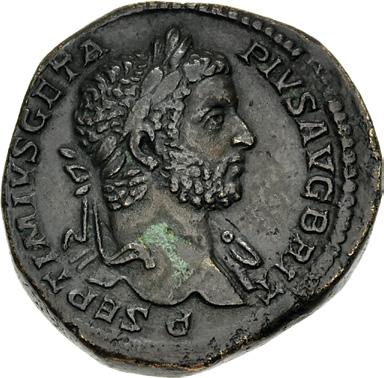

840. Geta. AD 209-211. Æ Sestertius (31.5mm, 26.71 g, 12h). British Victory issue. Rome mint. Struck AD 210-211. Laureate and bearded head right / VICTORIAE BRITANNICAE, S C in exergue, Victory standing right, foot on helmet, erecting trophy; on right, Britannia standing left, hands tied behind back; captive seated left at feet of Britannia. RIC IV 186; Banti 65 (this coin cited and illustrated). Olive green-brown patina, minor smoothing, hairline flan crack. Good VF. Very rare. ($1500)
From the Dr. Malcolm Lyne Collection, purchased from Sovereign Rarities, 21 February 2017. Ex Münz Zentrum XXXVIII (16 April 1980), lot 438.
220
838
839
Ex H. C. Levis Collection – Pedigreed to 1925

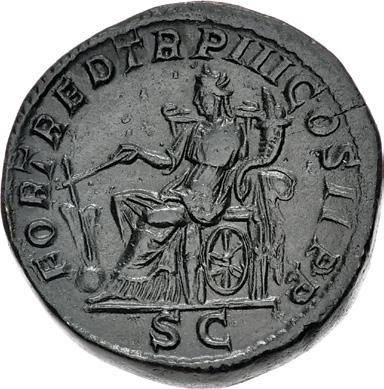
841. Geta. AD 209-211. Æ Sestertius (31mm, 28.03 g, 12h). Rome mint. Struck AD 211. Laureate head right / Fortuna seated left on throne, holding rudder on globe and cornucopia; wheel under throne. RIC IV 168a; Banti 20 (same obv. die as illustration). Dark green patina, hairline flan crack. Near EF. ($2000)
From the Wild Rose Collection. Ex CNG inventory 564473 (January 2021); Roma XX (29 October 2020), lot 645; Benito Collection (Classical Numismatic Group 114, 13 May 2020), lot 947; Gemini III (9 January 2007), lot 425; H. C. Levis Collection (Ars Classica XI, 18 June 1925), lot 761.
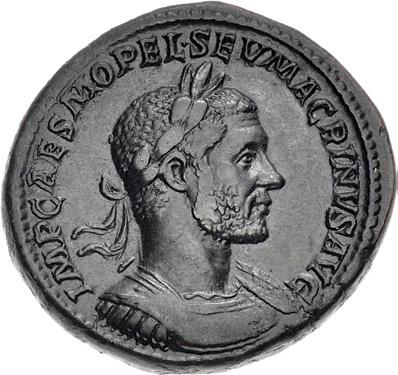

842. Macrinus. AD 217-218. Æ Sestertius (32mm, 27.10 g, 7h). Rome mint, 4th officina. 1st emission, AD 217. Laureate and cuirassed bust right, wearing short beard / Salus seated left, holding scepter and feeding from patera snake coiled around altar; S C in exergue. RIC V 197; Clay Issue 1; Banti 60. Glossy dark brown patina. Good VF. An attractive coin in hand. Rare. ($2000)
From the Wayne Scheible Collection. Ex Classical Numismatic Group 67 (22 September 2004), lot 1636; Philip DeVicci Collection (Triton IV, 5 December 2000), lot 623.
Pedigreed to 1964
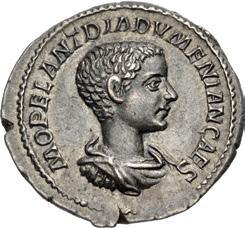

843. Diadumenian. As Caesar, AD 217-218. AR Denarius (19.5mm, 3.10 g, 12h). Rome mint. 2nd emission of Macrinus, AD 217-218. Bareheaded, draped, and cuirassed bust right / Diadumenian standing left, head right, holding signum and scepter; two signa to right. RIC IV 102 (Macrinus); Clay Issue 2; RSC 3b. Toned. EF. ($500)
From the Wild Rose Collection. Ex Jack A. Frazer Collection (Classical Numismatic Group Electronic Auction 456, 13 November 2019), lot 421; Numismatica Ars Classica 18 (29 March 2000), lot 619; Sternberg [1] (30 November 1973), lot 257; Münzen und Medaillen AG XXVIII (19 June 1964), lot 421.
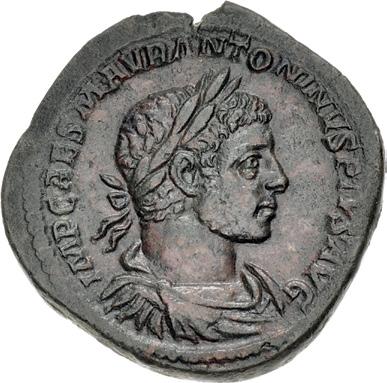
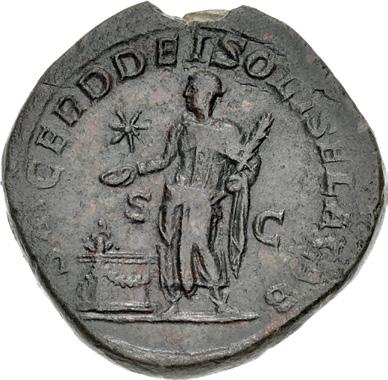
844. Elagabalus. AD 218-222. Æ Sestertius (32mm, 19.04 g, 12h). Rome mint. Struck AD 222. Laureate, draped, and cuirassed bust right / Elagabalus standing left, holding club and sacrificing from patera over lighted altar to left; star to left. RIC IV 369; Thirion 306; Banti 48 corr. (image mirrored). Dark green and brown patina with some red color, edge split. Good VF. ($750)
From the Wayne Scheible Collection, purchased from Harlan J. Berk. Ex Classical Numismatic Group 45 (24 June 1998), lot 1333.
221
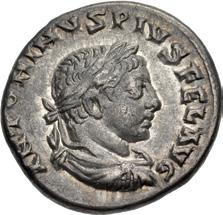

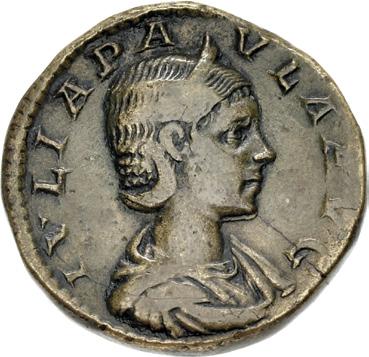
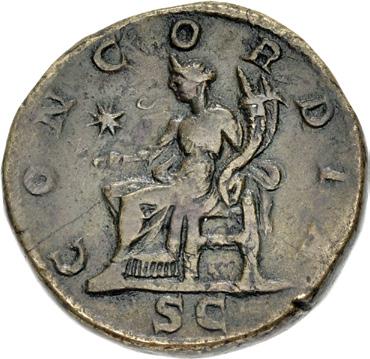
845. Elagabalus. AD 218-222. AR Denarius (18mm, 2.96 g, 11h). Uncertain eastern mint. Struck AD 218-219. Laureate, draped, and cuirassed bust right / Slow quadriga right, bearing the sacred stone of Emesa on which is an eagle, surrounded by four parasols. RIC IV 195; Thirion 360; RSC 268. Toned. VF. ($500)
From the Wild Rose Collection. Ex Roma IV (30 September 2012), lot 2801.
846. Julia Paula. Augusta, AD 219-220. Æ Sestertius (30mm, 21.99 g, 12h). Rome mint. Struck under Elagabalus, AD 220. Draped bust right, wearing stephane / Concordia seated left, holding patera and double cornucopia; star in left field. RIC IV 381 (Elagabalus); Thirion 459; Banti 7. Green-tan surfaces, some dark gray and red, hairline flan crack, slight strike doubling on obverse. VF. ($750)
Ex Oslo Myntgalleri 28 (6 May 2022), lot 391; RAM Collection (Triton XVIII, 6 January 2015), lot 1172, purchased from R. M. Smythe, October 2000.
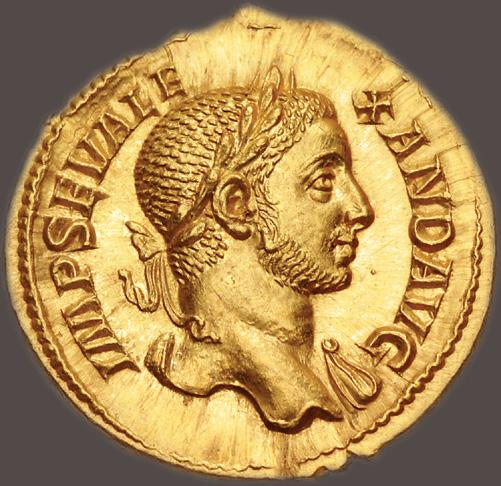
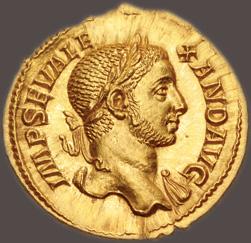

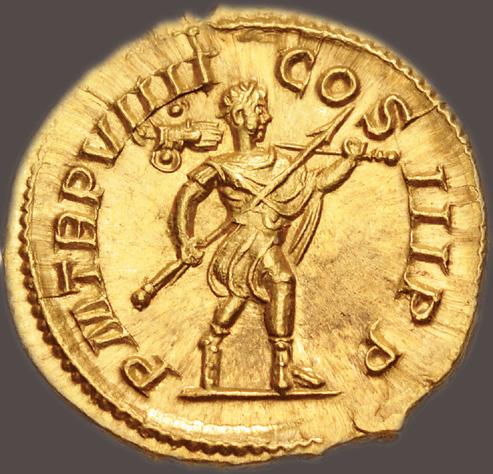
847. Severus Alexander. AD 222-235. AV Aureus (20mm, 5.85 g, 7h). Rome mint. 11th emission, AD 230. IMP SEV ALE XAND AVG, laureate bust right, slight drapery / P M TR P VIIII CO S III P P, Severus Alexander, as Romulus, in military dress, advancing right, holding transverse spear in right hand and trophy over left shoulder in left. RIC IV 103; Calicó 3121 (same dies as illustration); BMCRE 620; Biaggi 1330 (same dies); Jameson –; Mazzini –. Lustrous. Superb EF. ($7500)
From the Wild Rose Collection. Ex Künker 341 (1 October 2020), lot 6011; Lanz 117 (24 November 2003), lot 1013; Classical Numismatic Group 45 (18 March 1998), lot 2209.
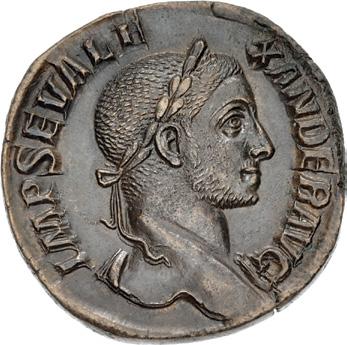
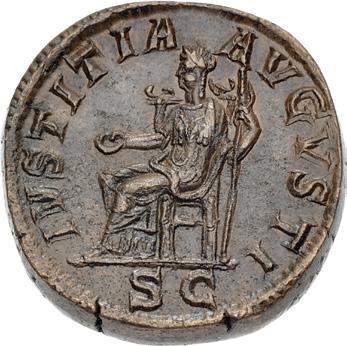
848. Severus Alexander. AD 222-235. Æ Sestertius (28mm, 22.38 g, 12h). Rome mint. 11th emission, AD 230. Laureate bust right, slight drapery / Justitia seated left, holding patera and scepter. RIC IV 563; BMCRE 612; Banti 28. Glossy brown patina, light roughness on reverse. EF. ($500)
From the Wild Rose Collection. Ex Ray Neff Collection (Triton XXV, 11 January 2022), lot 956; A. Lynn Collection (Freeman & Sear 5, 14 May 1999), lot 467; Numismatica Ars Classica E (4 April 1995), lot 3093.
222
845 846
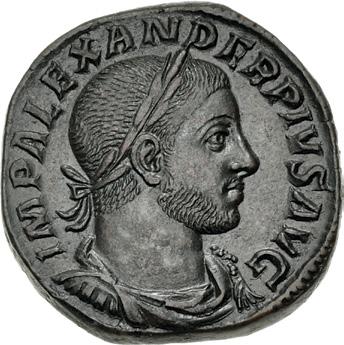
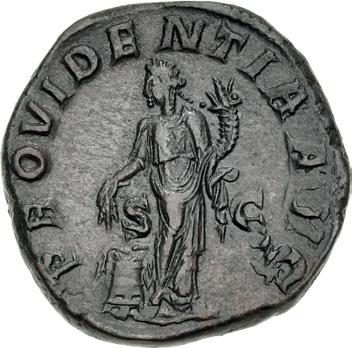
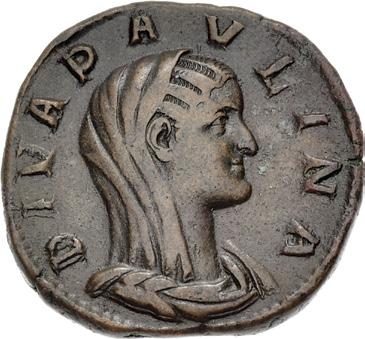

849. Severus Alexander. AD 222-235. Æ Sestertius (28mm, 21.56 g, 12h). Rome mint. 15th emission, AD 232. Laureate, draped, and cuirassed bust right / Providentia standing left, holding cornucopia and grain ears over modius filled with grain ears. RIC IV 642; BMCRE 881; Banti 148. Dark brown patina, some red. EF. Fine style portrait. ($1000)
Ex Mazzini Collection – Published in 1957
850. Diva Paulina. Died before AD 235. Æ Sestertius (30mm, 22.18 g, 11h). Consecration issue. Rome mint. 2nd emission of Maximinus I, AD 236. Veiled and draped bust right / Paulina, raising hand and holding scepter, reclining left on peacock flying upward to right. RIC IV 3 var. (position of S C); BMCRE 129-31 var. (same); Banti 3; Mazzini 3* (this coin). Even brown patina. VF. ($1000)
From the Wayne Scheible Collection. Ex Cederlind 132 (4 October 2004), lot 252; Giuseppe Mazzini Collection (publ. 1957).
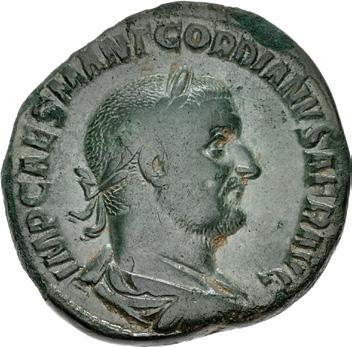

851. Gordian I. AD 238. Æ Sestertius (28.5mm, 16.05 g, 12h). Rome mint. Struck 1-22 April. Laureate, draped, and cuirassed bust right / Victory advancing left, holding wreath and palm frond. RIC IV 12; BMCRE 14-16; Banti 8. Even green patina, areas of chipping on edge. Near VF. ($750)
Purchased by the consignor from Herakles Numismatics, 2020. Ex Summer Haven Collection (Classical Numismatic Group Electronic Auction 460, 29 January 2020), lot 584.
Ex Lockett and Day Collections
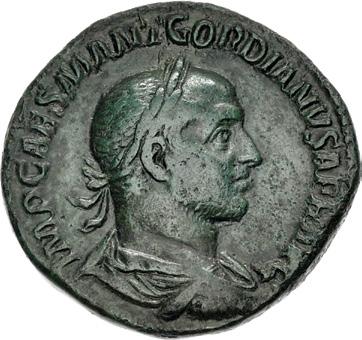
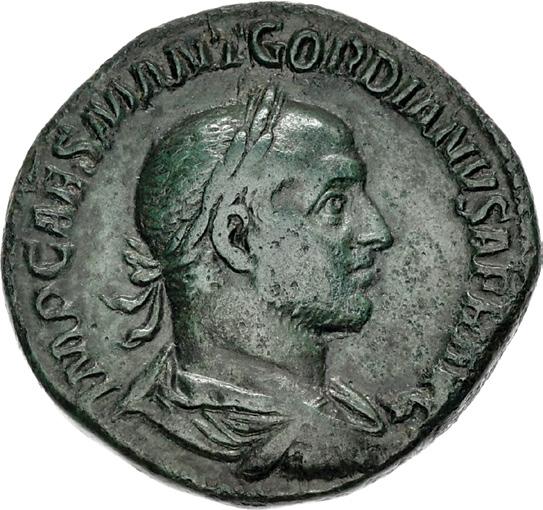

852. Gordian II. AD 238. Æ Sestertius (29.5mm, 18.61 g, 12h). Rome mint. Struck 1-22 April. Laureate, draped, and cuirassed bust right / Virtus, helmeted, in military attire, standing left, holding shield set on ground in right hand and spear in left. RIC IV 8; BMCRE 31-2; Banti 7. Green patina, some smoothing. Near VF. ($1500)
From the Wayne Scheible Collection, purchased from Harlan J. Berk, Ltd. Ex Numismatica Ars Classica I (19 May 1999), lot 2222; J. Schulman 258 (10 June 1974), lot 1929; Richard Cyril Lockett Collection (Part VIII, Glendining, 26 May 1959), lot 92; H. G. C. Day Collection.
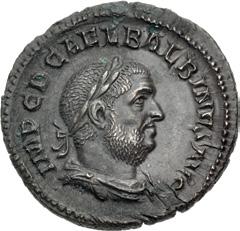
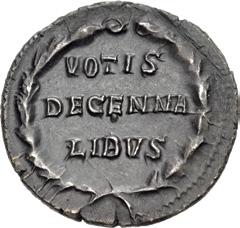
853. Balbinus. AD 238. AR Denarius (19mm, 2.89 g, 12h). Rome mint. Special emission. Laureate, draped, and cuirassed bust right / VOTIS/ DECENNA/LIBVS in three lines within wreath. RIC IV –; BMCRE 6; RSC 32. Dark find patina, scratches, minor green deposits. Near EF. The rarest of the Balbinus denarii. ($500)
223
849 850
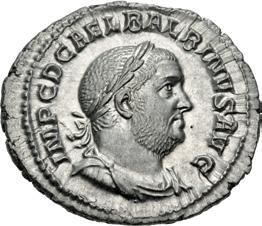
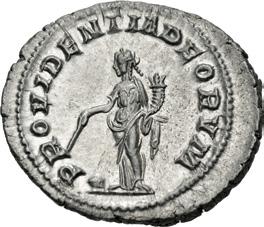

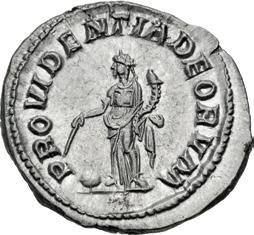
854. Balbinus. AD 238. AR Denarius (21mm, 3.03 g, 6h). Rome mint. 1st emission. Laureate, draped, and cuirassed bust right / Providentia, standing left, holding cornucopia and wand over globe set on ground to left. RIC IV 7; BMCRE 33; RSC 23. EF. ($500)
855. Balbinus. AD 238. AR Denarius (20.5mm, 3.37 g, 5h). Rome mint. 1st emission. Laureate, draped, and cuirassed bust right / Providentia, standing left, holding cornucopia and wand over globe set on ground to left. RIC IV 7; BMCRE 33; RSC 23. EF. ($500)
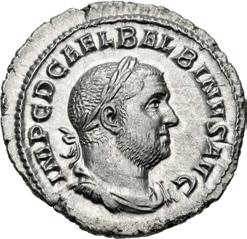
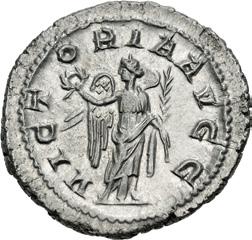
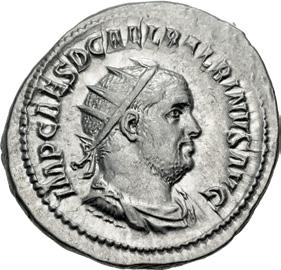
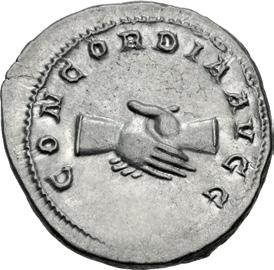
856. Balbinus. AD 238. AR Denarius (20mm, 2.89 g, 12h). Rome mint. 1st emission. Laureate, draped, and cuirassed bust right / Victory standing left, holding wreath and palm frond. RIC IV 8; BMCRE 37; RSC 27. EF. ($500)
857. Balbinus. AD 238. AR Antoninianus (22.5mm, 4.45 g, 6h). Rome mint. 2nd emission. Radiate, draped, and cuirassed bust right / Clasped right hands. RIC IV 10; BMCRE 67-70; RSC 3. EF. ($500)

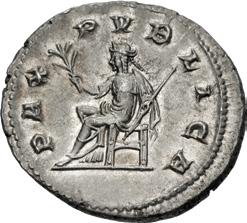
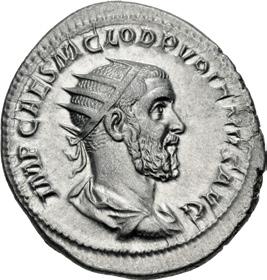
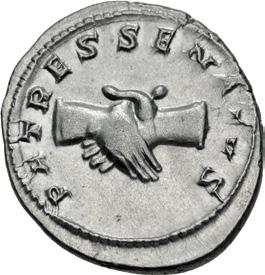
858. Pupienus. AD 238. AR Denarius (20mm, 3.11 g, 6h). Rome mint. 1st emission. Laureate, draped, and cuirassed bust right / Pax seated left on throne, holding olive branch and scepter. RIC IV 4; BMCRE 46-7; RSC 22. Attractive light toning, underlying luster. EF. Portrait of artistic merit. ($500)
From the Wild Rose Collection. Ex Classical Numismatic Group Electronic Auction 444 (15 May 2019), lot 394; Dr. Klaus Berthold Collection (Künker 318, 11 March 2019) lot 1538; Gorny & Mosch 121 (10 March 2003), lot 489.
859. Pupienus. AD 238. AR Antoninianus (21mm, 4.29 g, 7h). Rome mint. 2nd emission. Radiate, draped, and cuirassed bust right / PATRES SENATVS, clasped right hands. RIC IV 11a; BMCRE 81; RSC 19. EF. ($500)
Ex Webb Collection – Pedigreed to 1932

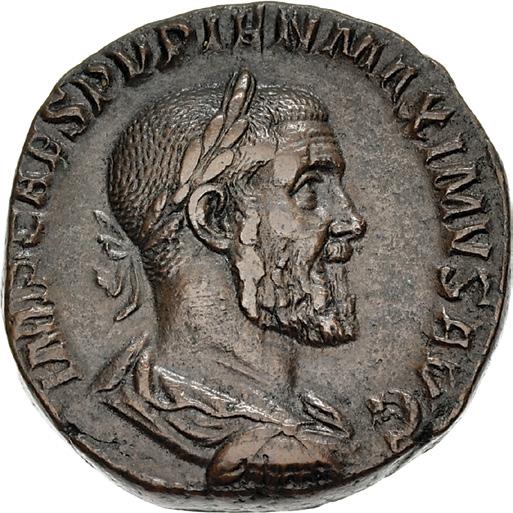
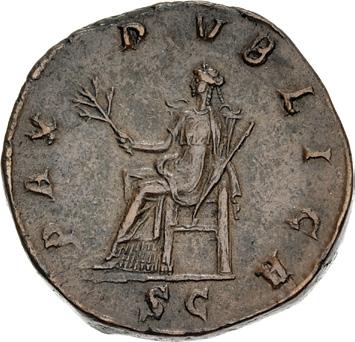
860. Pupienus. AD 238. Æ Sestertius (28mm, 19.47 g, 2h). Rome mint. Laureate, draped, and cuirassed bust right / Pax seated left, holding branch and short transverse scepter; SC in exergue. RIC IV 22; Banti 7 (this coin illustrated, but incorrect sales record noted). Attractive even brown patina, faint porosity on reverse. Good VF. A superb portrait of the short-reigning emperor. ($750)
From the Wayne Scheible Collection. Ex Triton I (2 December 1997), lot 1591; I. Vecchi 5 (5 March 1997), lot 710; Percy H. Webb Collection (A. Hess 211, 9 May 1932), lot 2399. 855
224
856 857 858 859 854
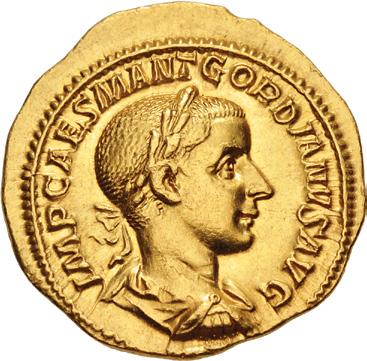
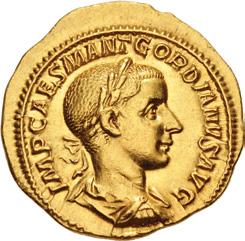
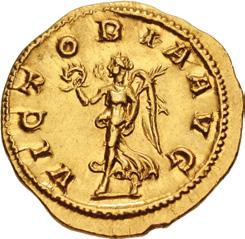
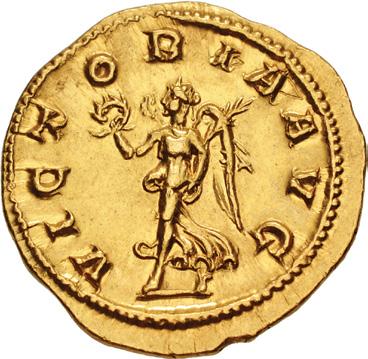
861. Gordian III. AD 238-244. AV Aureus (19.5mm, 4.86 g, 6h). Rome mint, 6th officina. 1st emission, AD 238. Laureate, draped, and cuirassed bust right / Victory advancing left, holding wreath and palm frond. RIC IV 11; Calicó 3238; Biaggi 1371. Minor graffiti on reverse. EF. ($2500)
Ex Nomos 23 (30 November 2021), lot 243.
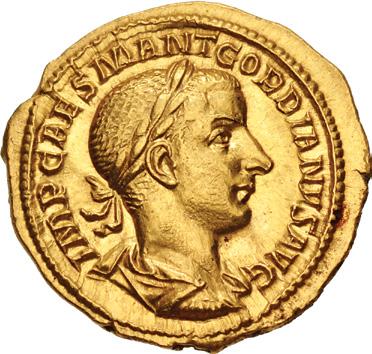

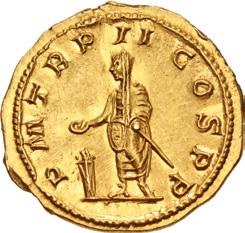
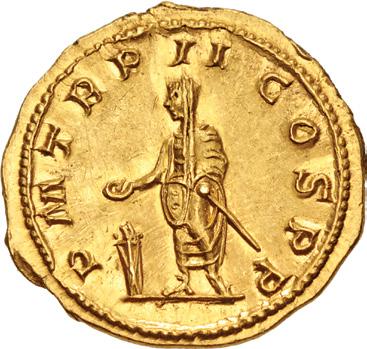
862. Gordian III. AD 238-244. AV Aureus (20mm, 5.00 g, 6h). Rome mint, 6th officina. 3rd emission, mid AD 239. Laureate, draped, and cuirassed bust right / Gordian III standing left, holding parazonium and sacrificing out of patera over lighted altar to left. RIC IV 43; Calicó 3216; Biaggi 1364 (same dies). Toned over lustous surfaces, hairlines. EF ($2500)
From the Wild Rose Collection. Ex Gorny & Mosch 244 (6 March 2017), lot 582; Gorny & Mosch 224 (13 October 2014), lot 614; Vico 139 (12 June 2014), lot 226; Aretusa 2 (13 May 1994), lot 430; Ponterio 47 (8 March 1991), lot 1185; Classical Numismatic Auctions VII (4 May 1989), lot 396.
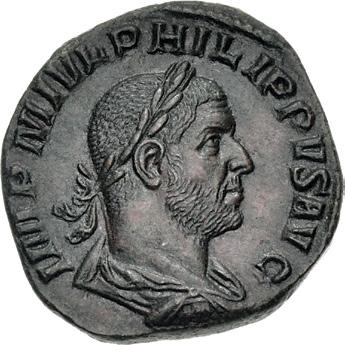
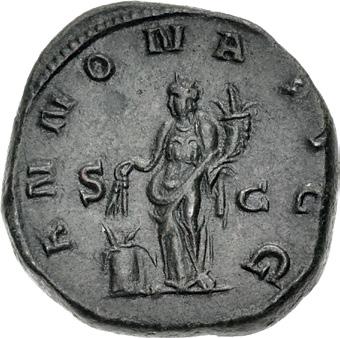
863. Philip I. AD 244-249. Æ Sestertius (28mm, 19.20 g, 12h). Rome mint, 5th officina. 5th emission, AD 246. Laureate, draped, and cuirassed bust right / Annona standing left, holding grain ears over modius and cornucopia. RIC IV 168a; Banti 9. Attractive dark green patina with touches of red. EF. Powerful portrait. ($1000)
From the Wild Rose Collection. Ex Classical Numismatic Review XLV.2 (Summer 2020), no. 531654; Jack A. Frazer Collection (Triton XXIII, 14 January 2020), lot 819, purchased from Freeman & Sear, September 1998.
Ex Biaggi & Apostolo Zeno Collections – MIR Plate Coin – Pedigreed to 1750
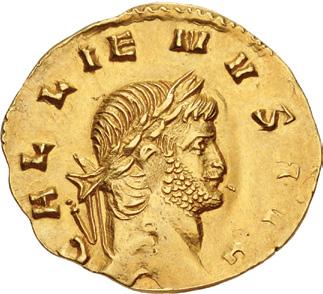
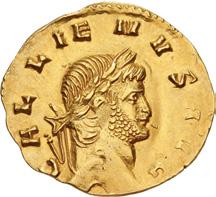
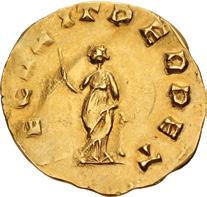
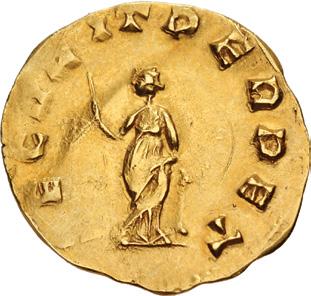
864. Gallienus. AD 253-268. AV Reduced Aureus or Quinarius (17.5mm, 1.43 g, 10h). Rome mint. 9th emission, AD 265-267. GALLIENVS AVG, laureate head right / SECVRIT PERPET, Securitas standing left, legs crossed, leaning on column, holding scepter. RIC V 118; MIR 36, 670b (this coin illustrated); Calicó 3588 (illustrated with a line drawing); Biaggi 1471 (this coin). Areas of weak strike, a few marks. EF. ($3000)
From the Wild Rose Collection. Ex Frank Reinhardt Collection (Roma E-Sale 66, 9 January 2020), lot 1116; Leo Biaggi de Blasys Collection (Numismatica Ars Classica 49, 21 October 2008), lot 375; Apostolo Zeno (†1750) Collection (Part I, Dorotheum, 13 June 1955), lot 2019.
225

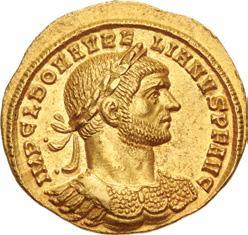
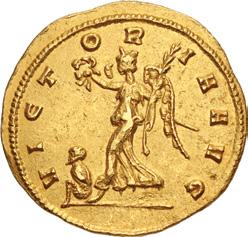

865. Aurelian. AD 270-275. AV Aureus (20mm, 4.27 g, 12h). Mediolanum (Milan) mint. 3rd emission, mid AD 272end 273. Laureate and cuirassed bust right, wearing aegis / Victory advancing left, holding wreath and palm frond; at feet, captive seated left. RIC V Online 1481; RIC V –; BN 422 (same dies); Toffanin 399/2 (same dies as illustration); Calicó 4041 (same obv. die as illustration); Biaggi –. Lightly toned, small flat spot on highest relief on either side, a few minor marks. Near EF. ($3000)
From the Wild Rose Collection, purchased from Calgary Coin Gallery, February 2017.
Zenobia,
Usurper
Queen of Palmyra
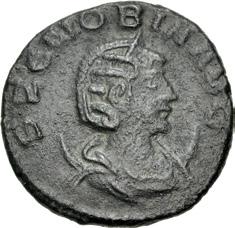

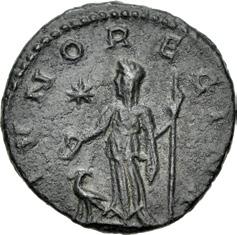
866. Zenobia. Usurper, AD 268-272. Antoninianus (19mm, 3.49 g, 6h). Antioch mint, 8th officina. 2nd emission, MarchMay AD 272. Draped bust right, wearing stephane, set on crescent / Juno standing left, holding patera and scepter; at feet to left, peacock standing left, head right; *|–//–. RIC V 2 corr. (star not noted); Bland, Coinage 29l (dies 45/Jun iii); BN pl. 86, 288 (same dies). Dark brown patina, minor roughness. VF. ($2000)
Very Rare Jugate Busts of Carus and Carinus
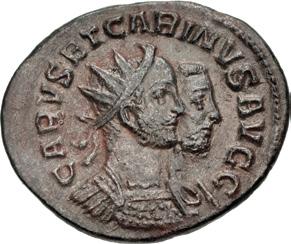
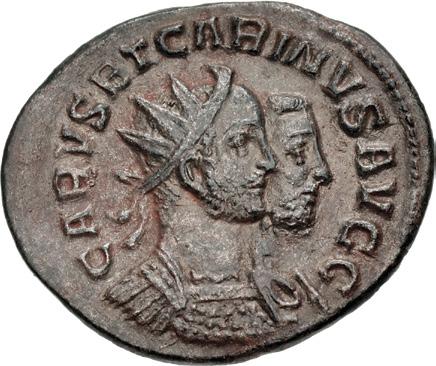
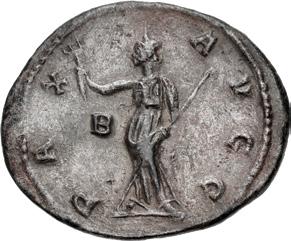
867. Carus & Carinus. AD 282-283. Antoninianus (24mm, 3.22 g, 6h). Lugdunum (Lyon) mint, 2nd officina. 3rd emission, November-end AD 282. CARVS ET CARINVS AVGG, jugate busts right of Carus, radiate and cuirassed, and Carinus, bareheaded and draped / PAX A VGG, Pax standing left, holding olive branch and transverse scepter; B|–//–. RIC V 140; Pink VI/2, p. 22; Lyon 477. Reddish-brown toning, some residual silvering, toned, slight wave in flan. Good VF. Very rare. ($750)
Julian of Pannonia, Usurper
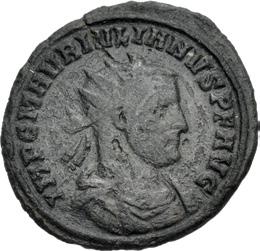

868. Julian of Pannonia. Usurper, AD 284-285. Antoninianus (21mm, 2.97 g, 6h). Siscia mint, 2nd officina. Struck December AD 284. Radiate, draped, and cuirassed bust right / Felicitas standing left, holding caduceus and scepter; S|B// XXI. RIC V 2; Pink VI/2, p. 49; Venèra 4398. Dark green-brown patina, some roughness and cleaning marks, flan crack. Near VF. ($750)
From the DFA Collection.
226
A Selection of Romano-British Coinage from the Dr. Malcolm Lyne Collection


869. Diocletian. AD 284-305. Æ Follis (25.5mm, 8.18 g, 6h). Londinium (London) mint. Struck circa AD 296. Laureate head right / Genius standing left, holding patera and cornucopia; LON. RIC VI 1a; RML 1 (forthcoming); C&T 1.01.001. Dark brown-green patina. Good VF. Rare. The first tetrarchic coin of London. ($500)
From the Dr. Malcolm Lyne Collection, purchased from Baldwin’s, 17 March 2015.
The first group from this outstanding collection appeared in Triton XXVII. This is the second selection of coins from this very impressive collection of British issues which includes many incredible rarities of the Romano-British usurpers Carausius and Allectus. Classical Numismatic Group would again like to thank Sam Moorhead for the updated forthcoming RIC V.5 reference numbers for these coins.
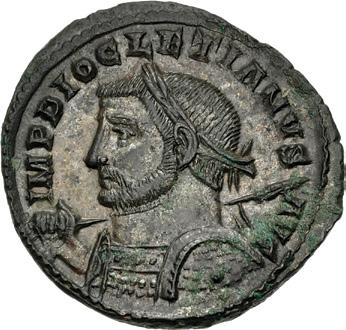
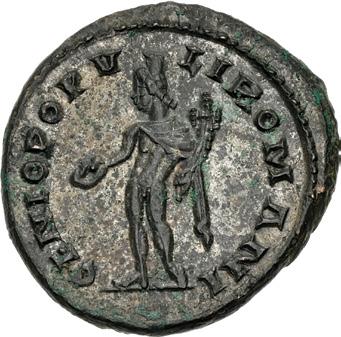
870. Diocletian. AD 284-305. Æ Follis (28mm, 9.44 g, 6h). Londinium (London) mint. Struck circa AD 303-1 May 305. Laureate and cuirassed bust left, holding spear over shoulder and shield / Genius standing left, holding patera and cornucopia. RIC VI 29a; RML 50 (forthcoming); C&T 3.01.006. Toned partial silvering and dark brown patina with verdigris. EF. Rare. ($500)
From the Dr. Malcolm Lyne Collection. Reportedly ex Numphil (22 March 2013), lot 341.
Illustrated in RML
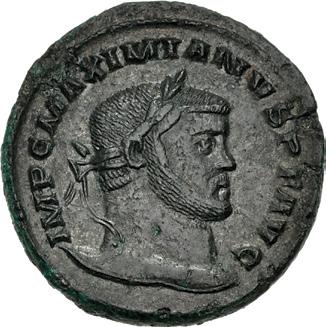
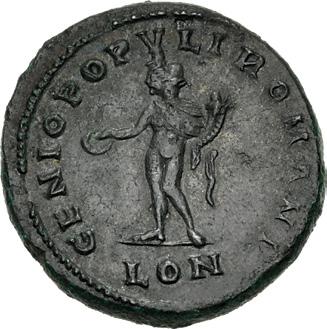
871. Maximianus. First reign, AD 286-305. Æ Follis (26.5mm, 9.95 g, 6h). Londinium (London) mint. Struck circa AD 296. Laureate head right / Genius standing left, holding patera and cornucopia; LON. RIC VI 1b; RML 4 (forthcoming; this coin illustrated); C&T 1.01.002. Toned partial silvering and dark brown patina with some verdigris at edge. Near EF. Rare. ($500)
From the Dr. Malcolm Lyne Collection, purchased from Baldwin’s, 1 July 1987.
227
Three Unique Denarii of Carausius
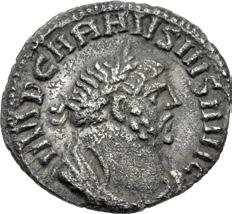
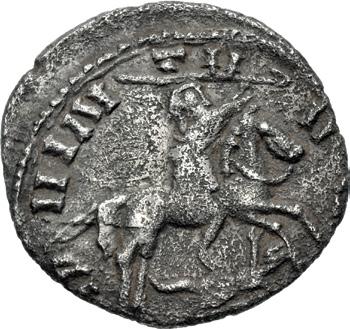

872. Carausius. Romano-British Emperor, AD 286-293. AR Denarius (18.5mm, 2.79 g, 12h). Uncertain mint. IMP CARAVSIVS AVG, laureate and draped bust right / Blundered legend, Carausius on horseback riding right, thrusting spear held over head and trampling enemy below. RIC V.5 33 note (forthcoming; this coin noted); cf. RIC V 540 (for similar issue); cf. Shiel p. 100, 9 (same); cf. RSC 11 (same). Toned, reverse slightly off center, light roughness. VF. Unique. Only this coin noted in RIC V.5. ($2000)
From the Dr. Malcolm Lyne Collection, purchased from David Miller, 30 March 2005 (PAS ID: WAW-D3B6B2).
The ‘RSR’ Mint Mark

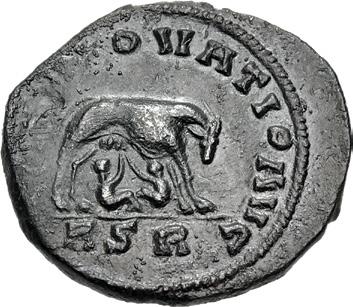
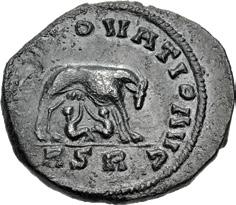
873. Carausius. Romano-British Emperor, AD 286-293. AR Denarius (17mm, 2.82 g, 9h). ‘RSR’ mint. IMP CARAVSIVS P F AV, laureate, draped, and cuirassed bust right / [REN]OVATIO AVG, She-wolf standing right, head facing, suckling the twins (Romulus and Remus); RSR. RIC V.5 125 (forthcoming; this coin noted); cf. RIC V 573 (for similar issue); cf. Shiel p. 113, 80a (same); cf. RSC 91 (same). Toned, find patina, reverse somewhat off center, slight roughness. Good VF. Unique. Only this coin noted in RIC V.5. ($2000)
From the Dr. Malcolm Lyne Collection, purchased from Baldwin’s, 22 February 2012.
Sir Arthur Evans suggested in 1928 that the ‘RSR’ mark in the exergue “[can] be explained as R[ationalis], S[ummae] R[ei] rather than a local mint mark” (as cited in Shiel 1977). Shiel followed Evans’ explanation and suggested that “one would expect to find such an officer based at the administrative centre of the area concerned, in this case London, and so the denarii ... must have been produced there also” (Shiel, 98).
Alternatively, Guy de la Bédoyère proposed a more literary explanation for the three letters in his article “Carausius and the Marks RSR and I.N.P.C.D.A.” in NC 1998. His explanation draws upon the enigmatic letters INPCDA found on a pair of large bronze Carausius medallions and extrapolates from the two sets of exergual letters that they are a reference to a passage from Virgil’s Ecologues iv.6-7 which reads “Redeunt Saturnia Regna, Iam Nova Progenies Caelo Demittitur Alto” (de la Bédoyère, 82). De la Bédoyère suggests that perhaps at the least the RSR-marked silver denarii of Carausius were likely not intended for widespread general circulation but were instead donatives for the state’s elite (ibid, 85). The substantial weight of the denarii and their metal quality lends some credence to this hypothesis.
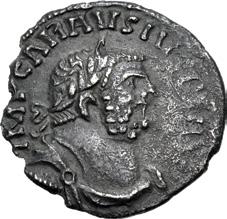

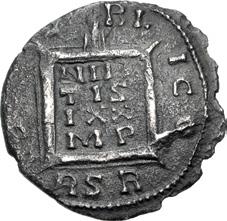
874. Carausius. Romano-British Emperor, AD 286-293. AR Denarius (18mm, 2.39 g, 12h). ‘RSR’ mint. IMP CARAVSIVS P F AV, laureate, draped, and cuirassed bust right / [...] BL ICA, altar inscribed MVL/TIS/ IXX/ MP in four lines; RSR. RIC V.5 178 (forthcoming; this coin noted); RIC V 595 var. (obv. legend); Shiel p. 117, 101 var. (same); RSC 115 var. (same). Deeply toned with some iridescence, find patina, light roughness, area of edge chips, thin scrapes under tone. VF. Unique. Only this coin noted in RIC V.5. ($2000)
From the Dr. Malcolm Lyne Collection, purchased from David Miller, 22 September 2006. Ex Classical Numismatic Group Electronic Auction 147 (6 September 2006), lot 381.
228
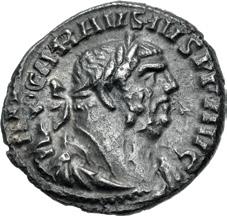
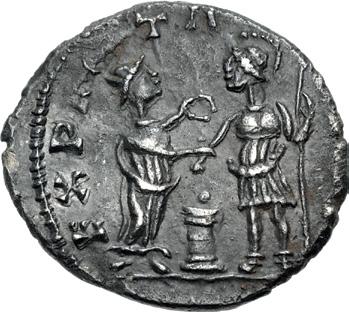

875. Carausius. Romano-British Emperor, AD 286-293. AR Denarius (18mm, 3.53 g, 6h). Uncertain mint. IMP
CARAVSIVS P F AVG, laureate, draped, and cuirassed bust right / EXPEC TA VENI, Britannia standing right, holding wreath and clasping hands with Carausius standing left, wearing military attire and holding spear; altar between them. RIC V.5 236 (forthcoming; this coin noted); RIC V –; Shiel p. 119, 9; RSC 36. Deeply toned, find patina, light deposits. Good VF. Extremely rare. Only two examples noted in RIC V.5 (this coin and the Triton XIV example). ($2000)
From the Dr. Malcolm Lyne Collection. Ex Spink 202 (25 March 2010), lot 432, found near Shenstone, Staffordshire in 2009 (PAS ID: WMID02BDE6).
Three More Unique Denarii
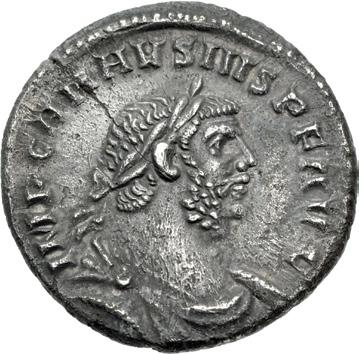

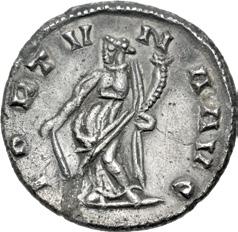

876. Carausius. Romano-British Emperor, AD 286-293. AR Denarius (19mm, 3.94 g, 6h). Uncertain mint. IMP
CARAVSIVS P F AVG, laureate, draped, and cuirassed bust right / FORTV N A AVG, Fortuna standing left, holding rudder and cornucopia. RIC V.5 245 (forthcoming; this coin noted); RIC V –; Shiel –; RSC –. Toned, flan crack, light roughness and porosity, minor marks. Near EF. Unique. Only this coin noted in RIC V.5. ($3000)
From the Dr. Malcolm Lyne Collection, purchased from David Miller, 18 November 2008.

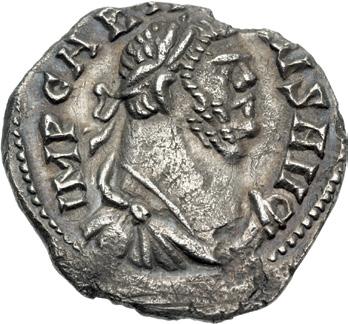
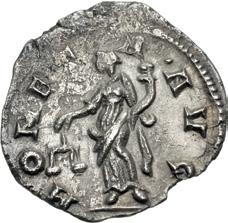
877. Carausius. Romano-British Emperor, AD 286-293. AR Denarius (18.5mm, 2.05 g, 6h). Uncertain mint. IMP
CARA[V]SIVS AVG, laureate and draped bust right / MONET A • AVG, Moneta standing left, holding scales and cornucopia. RIC V.5 254 (forthcoming; this coin noted); cf. RIC V 717 (for similar issue); cf. Shiel p. 122, 20 (same); cf. RSC 71 (same). Attractively toned with some iridescence, some porosity, minor edge chip, minor scratches under tone. Good VF. Unique. Only this coin noted in RIC V.5. ($2000)
From the Dr. Malcolm Lyne Collection, purchased from Spink, 28 February 2002.
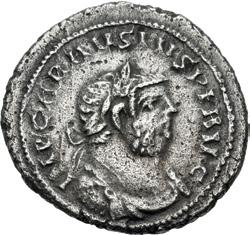
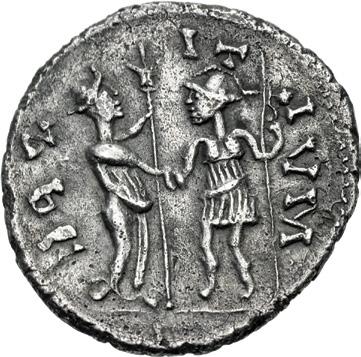

878. Carausius. Romano-British Emperor, AD 286-293. AR Denarius (20mm, 3.71 g, 12h). Uncertain mint. IMP
CARAVSIVS P F AVG, laureate, draped, and cuirassed bust right / C P S I T LVM(retrograde), Britannia standing right, holding standard and clasping hands with Carausius standing left, wearing military attire and holding spear. RIC V.5 259 (forthcoming; this coin noted); cf. RIC 715 (for similar issue); cf. Shiel p. 120, 10 (same); cf. RSC 41 (same). Toned, porosity. Good VF. Unique. Only this coin noted in RIC V.5. Interesting with blundered and retrograde reverse legend. ($3000)
From the Dr. Malcolm Lyne Collection, purchased from Baldwin’s, 15 April 2009.
229
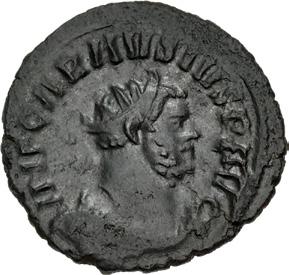
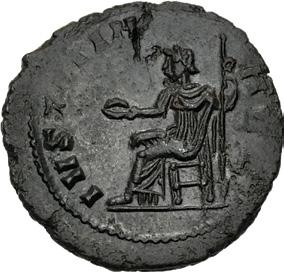
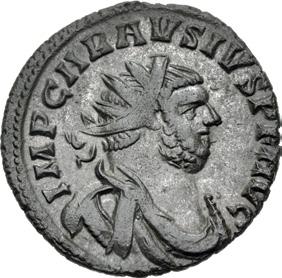
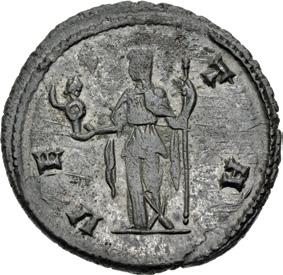
879. Carausius. Romano-British Emperor, AD 286-293. Antoninianus (23.5mm, 4.15 g, 8h). Uncertain mint. IMP
CARAVSIVS P AVG, radiate, draped, and cuirassed bust right / IVSTITIA AVG, Justitia seated left on throne, holding patera and long scepter. RIC V.5 1013 (forthcoming); cf. RIC V 818 (for similar issue). Toned trace silvering and dark brown patina, some obverse die wear, slight roughness, minor flan flaw. Good VF. Extremely rare. Only two examples noted in RIC V.5. A well struck reverse. ($500)
From the Dr. Malcolm Lyne Collection, purchased from David Miller, 16 February 2012.
880. Carausius. Romano-British Emperor, AD 286-293. Antoninianus (22.5mm, 4.34 g, 6h). Uncertain mint. IMP
CARAVSIVS P F AVG, radiate, draped, and cuirassed bust right / VE S TA, Vesta standing left, holding palladium and long scepter. RIC V.5 1661 (forthcoming); RIC V –. Toned partial silvering and olive green-brown patina, tiny flan crack. Near EF. Extremely rare. Only three examples noted in RIC V.5. ($750)
From the Dr. Malcolm Lyne Collection, purchased from David Miller, 22 September 2009.
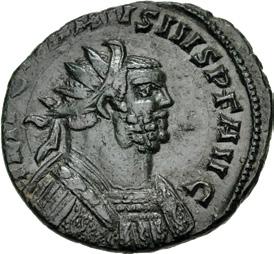

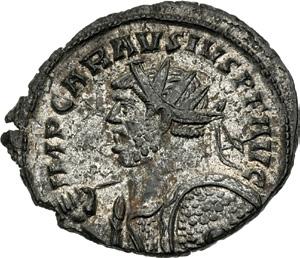

881. Carausius. Romano-British Emperor, AD 286-293. Antoninianus (21.5mm, 4.27 g, 12h). Londinium (London) mint. IMP CARAVSIVS P F AVG, Radiate and cuirassed bust right / CONCORD MIL, clasped hands; ML. RIC V.5 1856 (forthcoming); RIC V 24 var. (rev. legend). Wonderful dark green patina. EF. Extremely rare. Only four examples noted in RIC V.5. A vibrant early strike with most of the die engraver’s centering circle visible on the obverse. ($500)
From the Dr. Malcolm Lyne Collection, purchased from Baldwin’s.
882. Carausius. Romano-British Emperor, AD 286-293. Antoninianus (24mm, 4.32 g, 12h). Londinium (London) mint. IMP CARAVSIVS P F AVG, radiate and cuirassed bust left, holding spear over shoulder and shield / PA X AVG, Pax standing left, holding olive branch and long scepter; F|O//ML. RIC V.5 2037 (forthcoming); RIC V 103. Toned near complete silvering. Near EF. Very rare. Only ten examples noted in RIC V.5. Wonderful with such substantial silvering. ($750)
From the Dr. Malcolm Lyne Collection, purchased from Spink, 9 December 2002.

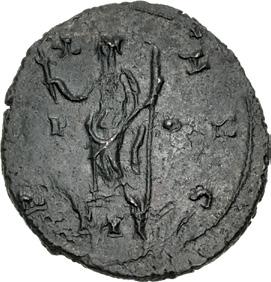
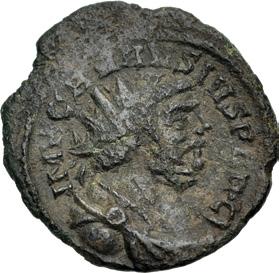
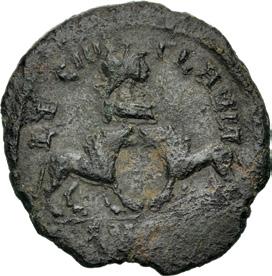
883. Carausius. Romano-British Emperor, AD 286-293. Antoninianus (22mm, 4.49 g, 12h). Londinium (London) mint. CARAVS IVS AVG, radiate, helmeted, and cuirassed bust left, holding spear over shoulder and shield / Pax standing left, holding olive branch and long scepter; F|O//ML. RIC V.5 2046 (forthcoming); RIC V 115. Dark brown patina, reverse die wear. Good VF. Very rare. Only sixteen examples noted in RIC V.5. ($500)
From the Dr. Malcolm Lyne Collection, purchased from Spink, 22 October 2001.
884. Carausius. Romano-British Emperor, AD 286-293. Antoninianus (22.5mm, 3.25 g, 9h). Londinium (London) mint.
IMP CARAVSIVS P AVG, radiate and draped bust right / LEG IIII FLAVIA, bust right above two confronted lions; SML. RIC V.5 2754 (forthcoming); cf. RIC V 71 (for similar issue). Rough dark brown-green patina. VF. Extremely rare. Only two examples noted in RIC V.5. ($500)
From the Dr. Malcolm Lyne Collection, purchased from Spink, 9 May 2001.
230
879
880
881
882
883
884

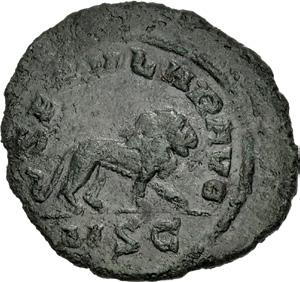

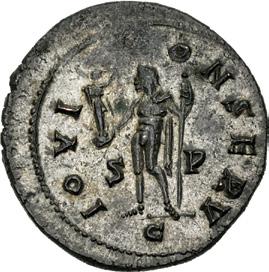
885. Carausius. Romano-British Emperor, AD 286-293. Antoninianus (24mm, 4.20 g, 12h). ‘C’ mint. IMP CARAVSIVS P AVG, radiate and draped bust right / SECVLAR AVG, lion walking right; MSC. RIC V.5 2794 (forthcoming); RIC V 391 var. (legends). Attractive dark green-brown patina. VF. Extremely rare. Only two examples noted in RIC V.5. ($500)
From the Dr. Malcolm Lyne Collection. Ex Frank Kovacs Collection (Helios 1, 17 April 2008), lot 384.
886. Carausius. Romano-British Emperor, AD 286-293. Antoninianus (22mm, 4.23 g, 6h). ‘C’ mint. IMP C CARAVSIVS AVG, radiate, draped, and cuirassed bust right / IOVI [C]ONSERV, Jupiter standing left, holding Victory on globe and long scepter; S|P//C. RIC V.5 3061 (forthcoming); RIC V –. Toned partial silvering and dark brown patina, slight spots of roughness, trace deposits. EF. Extremely rare. Only two examples noted in RIC V.5. ($750)
From the Dr. Malcolm Lyne Collection, purchased from David Miller, 22 July 2020.
Three Extremely Rare Antoniniani of Allectus
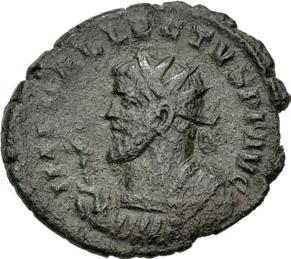

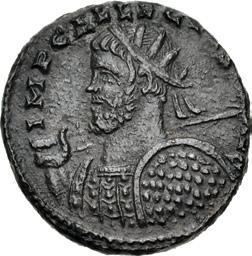
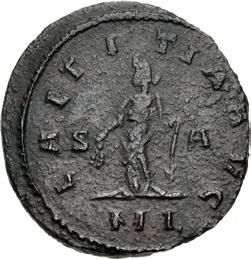
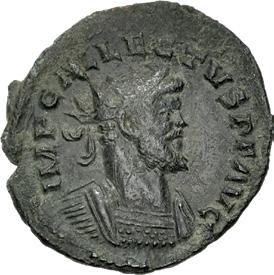
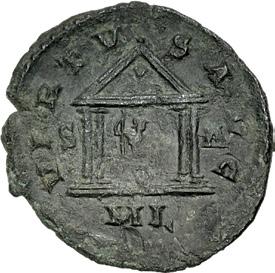
887. Allectus. Romano-British Emperor, AD 293-296. Antoninianus (22.5mm, 4.02 g, 6h). Londinium (London) mint. IMP C ALLECTVS P F AVG, radiate and mantled bust left, holding eagle-tipped scepter / PA X A VG, Pax standing left, holding olive branch and transverse scepter; S|P//ML. RIC V.5 56 (forthcoming); cf. RIC V 33 (for similar issue); Burnett, Coinage 14. Rough green-brown patina. VF. Extremely rare. Only three examples noted in RIC V.5. ($500)
From the Dr. Malcolm Lyne Collection. Ex Classical Numismatic Group 94 (18 September 2013), lot 1206.
888. Allectus. Romano-British Emperor, AD 293-296. Antoninianus (20mm, 4.38 g, 6h). Londinium (London) mint.
IMP C ALLECTVS P F AVG, radiate and cuirassed bust left, holding spear over shoulder and shield / LAETITIA AVG, Laetitia standing left, holding wreath and anchor; S|A//ML. RIC V.5 114 (forthcoming); RIC V 22; cf. Burnett, Coinage 5-8 (for similar issues); SCBC 684. Rough dark brown-red patina, reverse slightly off center. Good VF. Extremely rare. Only seven examples noted in RIC V.5. A wonderful and detailed bust. ($1000)
From the Dr. Malcolm Lyne Collection. Ex Numismatica Ars Classica 39 (16 May 2007), lot 181 (hammer CHF 2500); purchased from Harlan J. Berk.
889. Allectus. Romano-British Emperor, AD 293-296. Antoninianus (22mm, 2.65 g, 6h). Londinium (London) mint.
IMP C ALLECTVS P F AVG, radiate and cuirassed bust right / VIRTV S SVG, Roma(?) seated right in tetrastyle temple, holding spear; S|A//ML. RIC V.5 204 (forthcoming; this coin noted); RIC V –; Burnett, Coinage –. Attractive dark greenbrown patina. VF. Unique. Only this coin noted in RIC V.5. ($750)
From the Dr. Malcolm Lyne Collection. Ex Baldwin’s 100 (27 September 2016), lot 893.
[Conclusion of the Dr. Malcolm Lyne Collection]
231
885 886 887 888 889

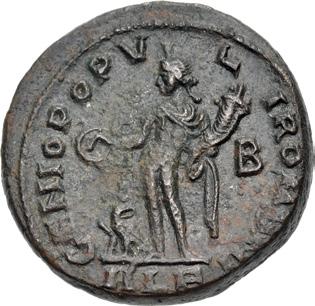
890. Domitius Domitianus. Usurper, AD 297-298. Æ Follis (25.5mm, 9.21 g, 12h). Alexandria mint, 2nd officina. Laureate head right / Genius standing left, holding patera and cornucopia; eagle at feet to left; –|B//ALE. RIC VI 20; Hunter 1 var. (officina). Brown surfaces, a few minor cleaning marks, slight roughness. VF. ($1000)
From the DFA Collection. Ex Joshua Lee Collection (Triton XXVI, 10 January 2023), lot 840 (cleaned since).
Apparently Unique – Calicó and Zanchi & Estiot Plate Coin
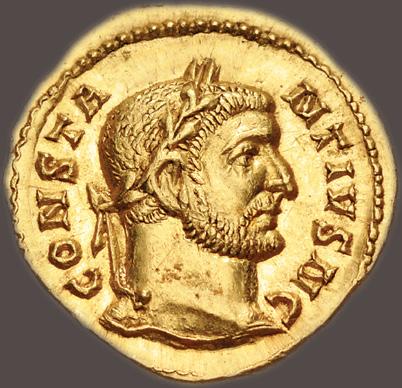
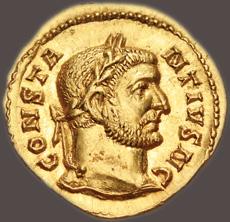


891. Constantius I. As Caesar, AD 293-305. AV Aureus (18.5mm, 5.06 g, 6h). Treveri (Trier) mint. 1st emission, autumn AD 293-early 294. CONSTA NTIVS N C, laureate head right / IOVI CONS ERVATORI, Jupiter enthroned left, holding thunderbolt in outstretched right hand and scepter in left; at feet to left, eagle standing left, head and tail right, with wings displayed, holding wreath in beak; PTR. RIC VI –; Zanchi & Estiot 14a (CCL 2/ R 6 – this coin, illustrated); Depeyrot –; Calicó 4847a (this coin illustrated). Lustrous, significant smoothing above head on obverse, graffiti on reverse. EF. The only example in CoinArchives. Apparently unique. ($7500)
Ex Numismatica Ars Classica 24 (5 December 2002), lot 250; Tkalec (25 October 1996), lot 270. Ex Bastien Collection and the 1922 Beaurains Hoard
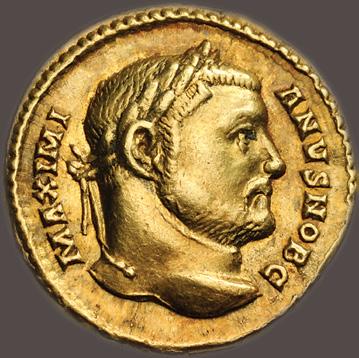

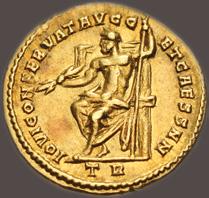
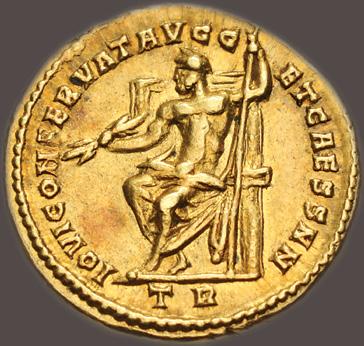
892. Galerius. As Caesar, AD 293-305. AV Aureus (17mm, 5.24 g, 6h). Treveri (Trier) mint. Struck 20 November AD 303. MAXIMI ANVS NOB C, laureate head right / IOVI CONSERVAT AVGG ET CAESS NN, Jupiter, naked to waist, seated left on throne, holding thunderbolt in right hand and scepter in left; TR. RIC VI 53; Depeyrot 10B/3; Calicó 4914 (same dies as illustration); Beaurains 329 (this coin); Adda 560; Biaggi 1859 (same dies); Mazzini 121 (same dies). Wonderful reddish tone. Good VF. Rare. ($10,000)
From the Jonathan K. Kern Collection. Ex Triton XXIV (29 January 2021), lot 1151; Pierre Bastien Collection (Part II, Numismatica Ars Classica 114, 6 May 2019), lot 855; Ciani & Vinchon (6 May 1955), lot 439; 1922 Arras – Beaurains Hoard.
The Beaurains (or Arras) Treasure is an important Roman coin hoard found in Beaurains, a suburb of Arras, France on 21 September 1922. Soon after its discovery by workmen in a clay pit much of the treasure was dispersed. In 1977, P. Bastien (the previous owner of the present coin), along with C. Metzger, published a reconstruction of the hoard from the known coins in public collections, as well as a careful analysis of coins that had been offered in the market since 1922. Although they admit the corpus is not complete, they were able to catalog 472 aurei and medallions, and surmised that the original total was upwards of 700 pieces. Due to the composition of the hoard, the authors suggest that the hoarder must have been a soldier at Trier who was present for the many <i>donativa</i> that occurred between AD 285-310.
232
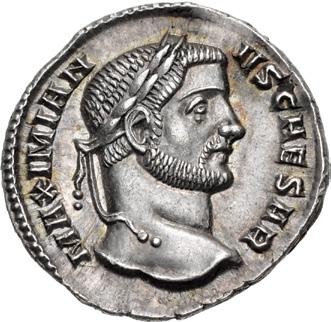
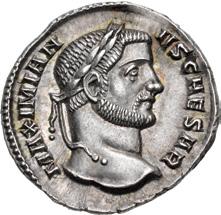

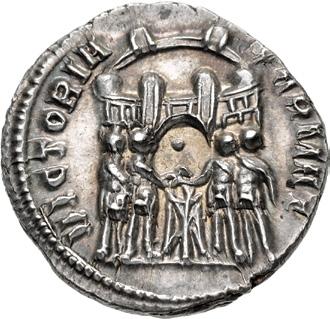
893. Galerius. As Caesar, AD 293-305. AR Argenteus (18mm, 2.78 g, 6h). Ticinum mint. 1st emission, 2nd series, AD 294-295. Laureate head right / VICTORIA SARMAT, four tetrarchs sacrificing over tripod before city enclosure with six turrets. RIC VI 17b; Gautier, Argent 12; RSC 208c. Attractive iridescent toning. EF. ($750)
Ex G.W. Trow Collection; Roma XX (29 October 2020), lot 683; ArtCoins Roma 19 (11 November 2015), lot 770.
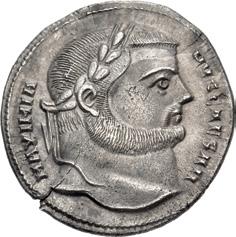

894. Galerius. As Caesar, AD 293-305. AR Argenteus (19mm, 3.18 g, 12h). Antioch mint, 8th officina. 8th emission, 1st phase. Laureate head right / Three-turreted city gate without doors; NANTHN. RIC VI 43b; Gautier, Argent 45r (this coin); RSC 225e. Toned, a couple of hairline flan cracks. Near EF. ($500)
From the Wild Rose Collection. Ex Marian A. Sinton Collection (Classical Numismatic Group 53, 15 March 2000), lot 1724.
Very Rare Solidus – Cited in RIC – Pedigreed to 1879
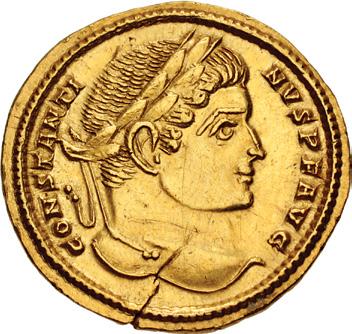

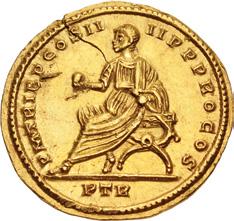

895. Constantine I. AD 307/310-337. AV Solidus (19.5mm, 4.47 g, 6h). Treveri (Trier) mint. Struck early AD 315. Laureate head right / Constantine, togate, seated left on curule chair, holding globe and short scepter; PTR. RIC VII 21 (this coin cited); Depeyrot 21/4; Biaggi –. Toned, flan crack, a couple digs on reverse, scratches under tone, faint hairlines. Near EF. Very rare. ($5000)
From the Wild Rose Collection. Ex Numismatica Ars Classica Spring Sale (25 May 2020), lot 1224; Heidelberger 76 (14 May 2019), lot 387; Sotheby’s “Two Hundred Highly Important Greek and Roman Coins” (5 July 1995), lot 182; Münzen und Medaillen AG FPL 449 (October 1982), no. 20; Münzen und Medaillen AG XXXV (16 June 1967), lot 134; Münzen und Medaillen AG FPL 159 (August 1956), no. 21; Arthur J. Evans Collection (Ars Classica III, 16 June 1922), lot 190; found at Winchester, 1879. Reportedly also ex Poindessault (13 December 1971), lot 81.
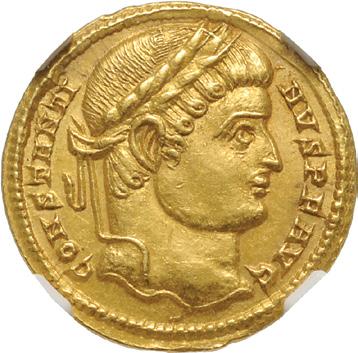
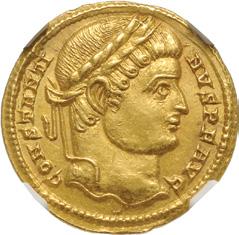
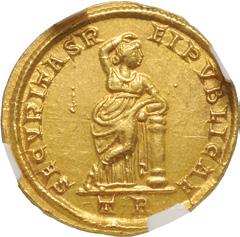
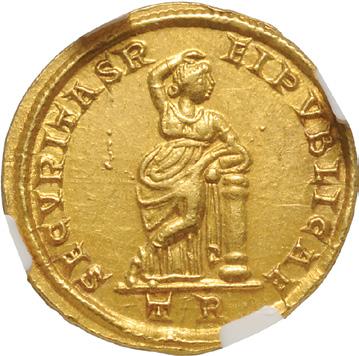
896. Constantine I. AD 307/310-337. AV Solidus (19mm, 4.45 g, 5h). Treveri (Trier) mint. Struck AD 326. CONSTANTI NVS P F AVG, laureate head right / SECVRITAS R EIPVBLICAE, Securitas standing facing with legs crossed, head right, hand on head and leaning on column; TR. RIC VII 502; Alföldi 457; Depeyrot 32/6; Biaggi –. In NGC encapsulation 4280244004, graded Ch AU, Strike: 5/5, Surface: 4/5. Rare. ($7500)
From the Jonathan K. Kern Collection.
233
Very Rare Aureus in High Relief
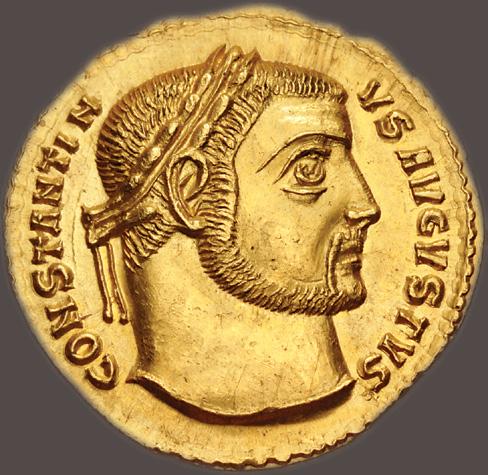
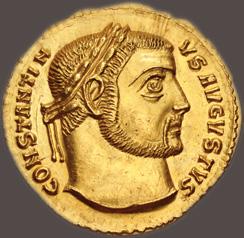

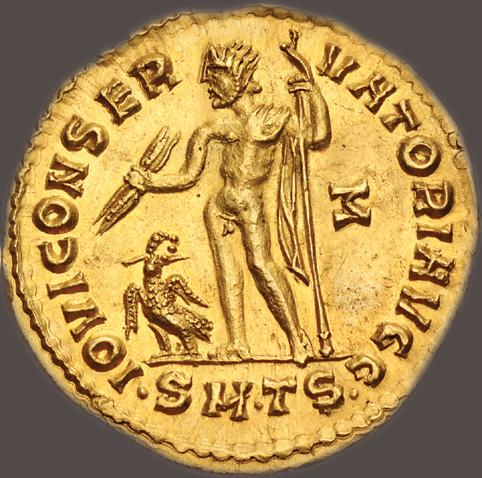
897. Constantine I. AD 307/310-337. AV Aureus (19.5mm, 5.54 g, 12h). Thessalonica mint. Struck AD 310. Laureate head right / Jupiter standing left, holding thunderbolt and long scepter, at feet to left, eagle standing left, head right, holding wreath in beak; |Σ(retrograde)//•SM•TS•. RIC VI 44c; Depeyrot 5/4; Calicó 5172; Biaggi 1980. Toned, some light hairlines, a couple of light edge marks. Superb EF. Very rare. Struck in outstanding high relief from exquisitely-detailed dies. ($7500)
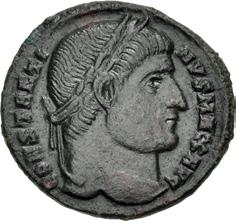
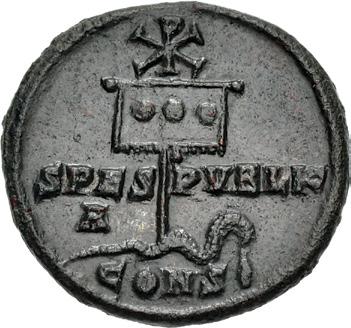
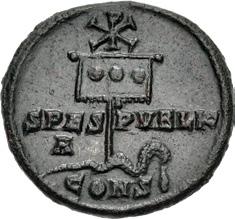
898. Constantine I. AD 307/310-337. Æ Follis (19mm, 2.96 g, 11h). Constantinople mint, 1st officina. Struck AD 327. CONSTANTI NVS MAX AVG, laureate head right / SPES PVBLIC, labarum, with Christogram at top and three medallions on drapery, spearing serpent; A|–//CONS. RIC VII 19. Dark green and brown surfaces, smoothed and tooled. Near EF. Very rare and an important type. ($3000)
This coin could reassure the populace that Constantine I and his rule, inspired by divine intervention and represented by the labarum, would ensure orthodox stability against all imperial enemies, represented by the serpent.

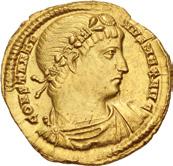

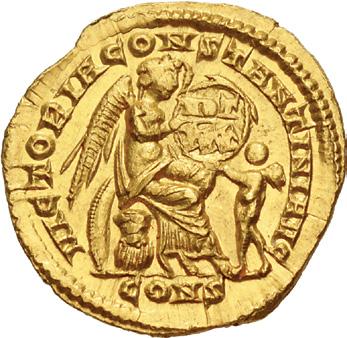
899. Constantine I. AD 307/310-337. AV Nine Siliquae – 1 1/2 Scripulum (14mm, 1.72 g, 12h). Constantinople mint. Struck AD 336. Rosette-diademed, draped, and cuirassed bust right / Victory seated right on cuirass with shield behind, holding stylus and inscribing VOT/ XXX in two lines on shield set on left knee and supported by left hand; to right, small genius standing left supporting the shield; CONS. RIC VII 117; Depeyrot 7/17; Biaggi 2022. Lightly toned, spot of weakness. Near EF. Rare. ($1500)
234
Anepigraphic “Eyes to God” Solidus


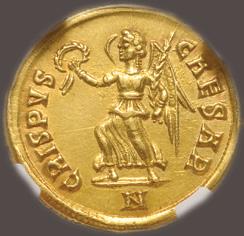
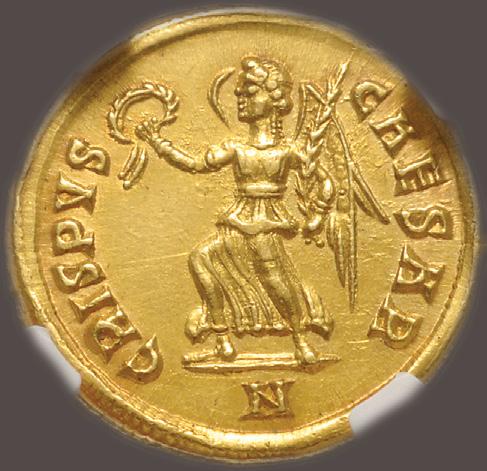
900. Crispus. Caesar, AD 316-326. AV Solidus (19mm, 4.40 g, 6h). Nicomedia mint. Struck AD 326. Head right, wearing plain diadem, eyes to God / CRISPVS CAESAR, Victory advancing left, holding wreath in outstretched right hand and palm frond in left; N. RIC VII 110; Depeyrot 38/3; Biaggi 2055. In NGC encapsulation 3987069-002, graded Ch AU, Strike: 5/5, Surface: 3/5. ($10,000)
From the Jonathan K. Kern Collection.



901. Constantine II. As Caesar, AD 316-337. AV Solidus (20mm, 4.45 g, 6h). Thessalonica mint. Struck AD 332. Diademed, draped, and cuirassed bust right / Constantine II, in military dress, standing left, holding vexillum and long transverse scepter; to right, two signa; TS. RIC VII 191; Depeyrot 15/4; Biaggi –. Polished, hairlines. EF. Rare. ($2000)
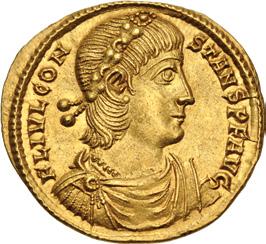

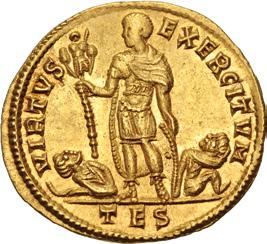
902. Constans. AD 337-350. AV Solidus (21.5mm, 4.38 g, 6h). Thessalonica mint. Struck AD 337-340. Pearl-androsette-diademed, draped, and cuirassed bust right / Constans standing left, wearing military attire, holding a trophy mounted on a spear and resting hand on shield set on ground to right, flanked by seated captives; the one on his left with hands bound behind back, and the one on his right holding his head in one hand and resting the other on ground; both captives looking upward at the emperor; TES. RIC VIII 34; Depeyrot 4/7; Biaggi 2126. Toned with some luster, faint scratches, spot of weakness on reverse. EF. ($2000)
Ex CJR Collection.
235

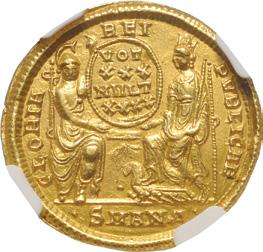
903. Constantius II. AD 337-361. AV Solidus (20.5mm, 4.46 g, 6h). Antioch mint, 4th officina. Struck AD 355-361. Pearl-diademed, helmeted, and cuirassed bust facing slightly right, holding spear over shoulder and shield / Roma seated facing and Constantinopolis seated half-left, foot on prow, each holding scepter, supporting shield between them inscribed VOT/ XXX/ MVLT/ XXXX in four lines; •//•SMANΔ•. RIC VIII 170; Depeyrot 11/1. In NGC encapsulation 6057941-001, graded Ch AU★, Strike: 5/5, Surface: 4/5. High-relief portrait. ($1500)
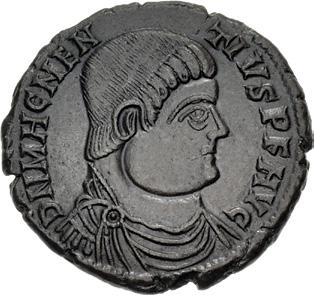

904. Magnentius. AD 350-353. Æ Double Centenionalis (26mm, 7.61 g, 6h). Lugdunum (Lyon) mint, 1st officina. 7th phase, beginning AD 353-August 353. Bareheaded, draped, and cuirassed bust right / Large Christogram; A|ω//LPLG. RIC VIII 154; Bastien 203; Lyon 197. Attractive brown patina. Choice EF. ($500)
Ex Dr. John Whitehead Collection (Triton XXV, 11 January 2022), lot 1010; Classical Numismatic Group 49 (17 March 1999), lot 1832.
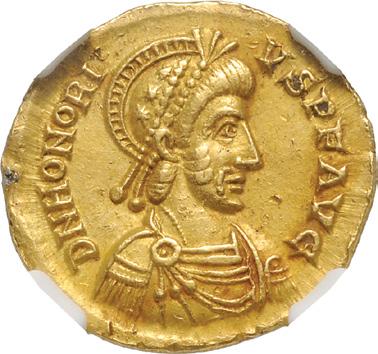
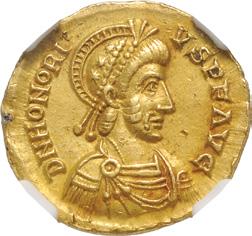
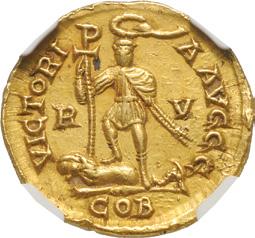

905. Honorius. AD 393-423. AV Solidus (20mm, 4.43 g, 12h). Ravenna mint. Struck AD 415. Pearl-diademed, helmeted, draped, and cuirassed bust right, wearing beard; helmet decorated with three small stars / Honorius standing facing, right foot on lion couchant left, holding long staff terminating in staurogram; above, manus Dei holding wreath; R|V//COB. RIC X 1310; Ranieri 16; Depeyrot 3/1. In NGC encapsulation 3987082-013, graded AU, Strike: 5/5, Surface: 4/5. ($3000)
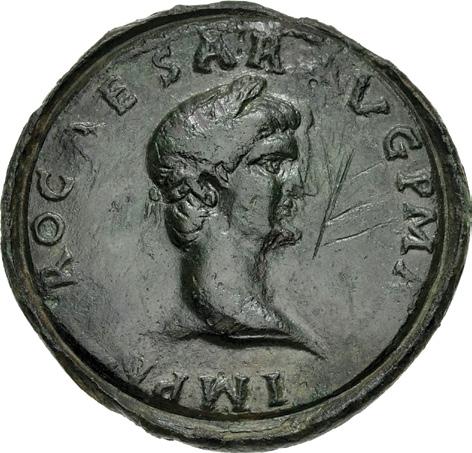

906. Contorniates. Late 4th century AD. Æ Contorniate (38mm, 19.39 g, 6h). In the name of Nero. IMP NERO CAESAR
AVG P MAX, laureate head right / Fortuna-Constantinopolis seated left on throne, holding rudder set on globe to left and long scepter; C - S across field. Alföldi, Kontorniat, p. 126, Rs. 46 and pl. 85, 7-9. Attractive dark green-brown patina, palm frond etched in obverse field. VF. Very rare. ($1000)
Ex Peus 405 (2 November 2011), lot 2685.
236
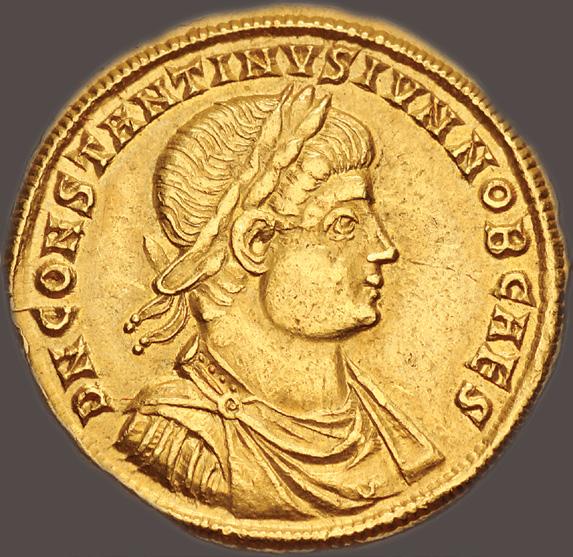

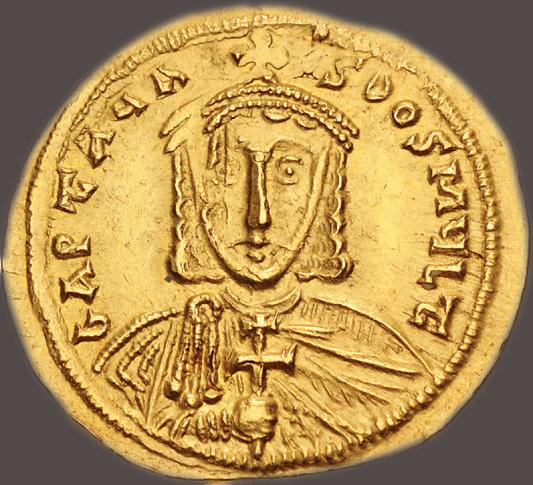
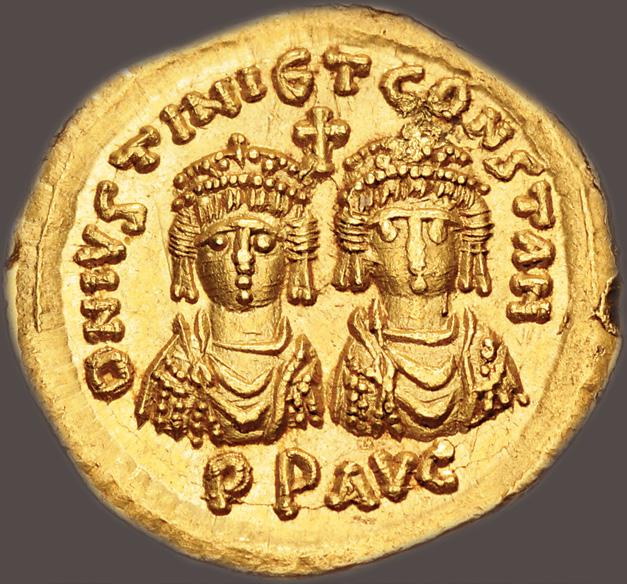



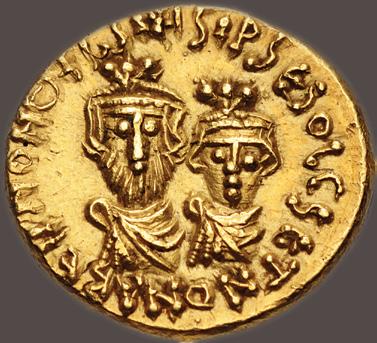
OF CONSTANTINE COLLECTION Lot 1010 Lot 1029 Lot 908 Lot 915 Lot 930 Lot 947 Lot 976 Lot 996
THE FAMILY
The Family of Constantine Collection
The Family of Constantine Collection was compiled by an American collector who had a lifelong interest in the nexus of European and Ottoman history. His collecting was informed by a deep understanding of the subject matter and wide reading of scholarly literature in English, French, German, and Turkish. A chance meeting with Geneva-based numismatist Roland Michel led to the two developing a friendship and to the collector receiving expert advice from Roland in building three important collections: one of the largest private collections of Ottoman coins, a unique collection of European and Ottoman medals (both now dispersed), and finally this impressive collection of Late Roman and Byzantine coins, offered in its entirety here in CNG Feature Sale 126. Classical Numismatic Group would like to thank Roland Michel for his assistance in documenting the pedigrees for this collection and for assisting with the recovery of lost pedigrees as well.
The eleven-hundred-year period of Byzantine history represented in this collection encompasses an array of cultural and historical development: the birth of Eastern Orthodox Christianity, the preservation of classical Greek civilization, the synthesis of Roman law under the Code of Justinian, and more. This collection was formed in part out of a love for the city of Constantinople (modern day Istanbul), and the vast majority of the coins in the collection are from the Constantinople mint. The collection thus begins with Constantine I (the Great), the first Christian emperor, who moved the capital of the Roman Empire from Rome to Constantinople in AD 330. It concludes with an example from the rare coinage of Constantine XI, the last of the Byzantine emperors, known for his gallant but ultimately doomed defense of Constantinople against the Ottomans in 1453. Between these momentous bookends in history is an impressive selection of coinage featuring a comprehensive array of emperors, empresses, and other ruling family members and associates. It also includes some exceptional rarities such as an extremely rare marriage solidus struck on the occasion of the wedding of Valentinian III and Licinia Eudoxia (the daughter of Theodosius II), and an extremely rare solidus from the brief nine-day joint reign of Justin II and Tiberius II.
The Family of Constantine Collection offers a wonderful opportunity for collectors of late Roman and Byzantine coinage both to appreciate this collector’s vision and to enjoy adding to their own collections. It is sure to be remembered as a notable pedigree for late Roman and Byzantine coinage in the years to come.

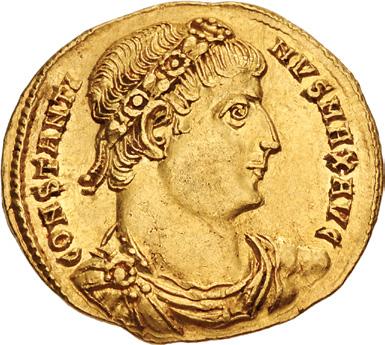
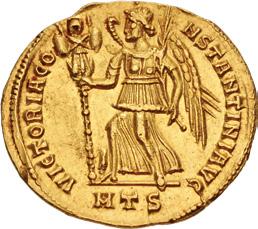
907. Constantine I. AD 307/310-337. AV Solidus (21mm, 4.41 g, 6h). Thessalonica mint. Struck AD 330-331. Rosettediademed, draped, and cuirassed bust right / Victory advancing left, holding trophy set on ground and palm frond; MTS. RIC VII 174; Depeyrot 14/1; Biaggi 2011. Lightly toned, scratches, marks, shallow dig, deposits. Near EF. ($5000)
Purchased from Numisart Genève, April 2000.
Ex Biaggi, Trau, and Montagu Collections – Pedigreed to 1896
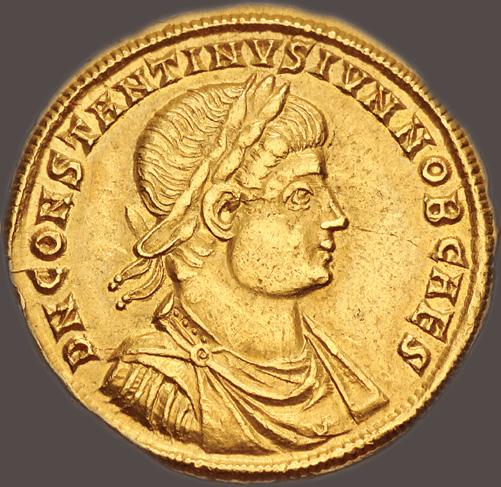
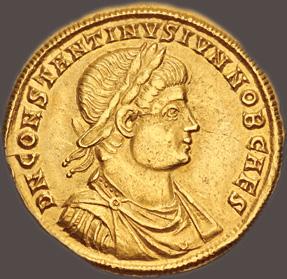

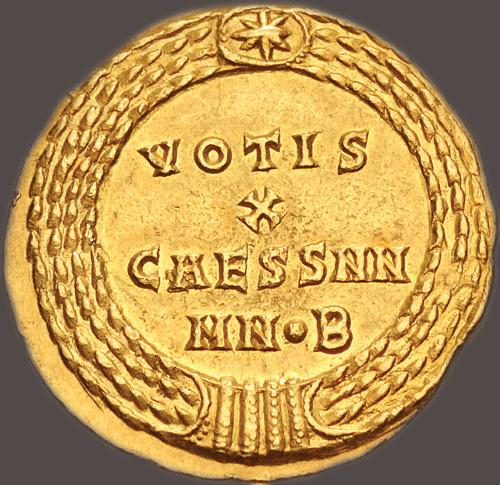
908. Constantine II. As Caesar, AD 316-337. AV Medallion of 1 1/2 Solidi (23mm, 6.72 g, 6h). Nicomedia mint. Struck AD 326-327. Laureate, draped, and cuirassed bust right / VOTIS/ X/ CAESS NN/ MN•B in four lines within laurel wreath with large central jewel decorated with star. RIC VII 118 (this coin cited); Depeyrot p. 154 (this coin cited); Gnecchi I, 24 (this coin cited); Biaggi 2088 (this coin); M. Alföldi, Die Constantinische Goldprägung 719 and pl. 10, 160 (this coin cited and illustrated). Lightly toned, minor marks. Good VF. Very rare. ($20,000)
Ex Numismatica Ars Classica 21 (17 May 2001), lot 565; Numismatica Ars Classica 11 (29 April 1998), lot 549; Leu 59 (17 May 1994), lot 335; Leo Biaggi de Blasys Collection; Franz Trau Collection (A. Hess, 28 April 1936), lot 2801; Franz Trau Collection (A. Hess, 22 May 1935), lot 4058; M. H. Montagu Collection (Rollin & Feuardent, 20 April 1896), lot 853.
238
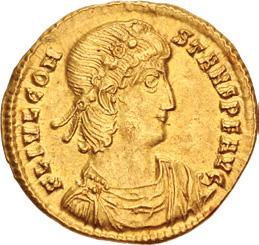
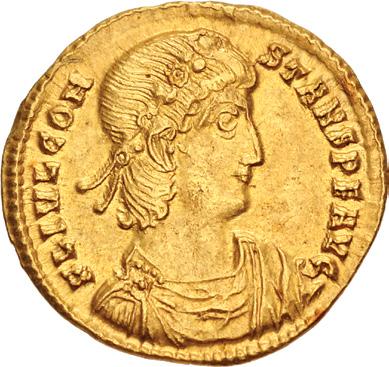
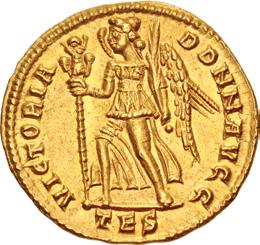
909. Constans. AD 337-350. AV Solidus (21mm, 4.65 g, 6h). Thessalonica mint. Struck AD 337-340. Rosette-diademed, draped, and cuirassed bust right / Victory advancing left, holding trophy set on ground and palm frond; TES. RIC VII 28; Depeyrot 4/3; Biaggi –. Toned, a few tiny die breaks, tiny abrasion, minor mark at edge. EF. ($1500)
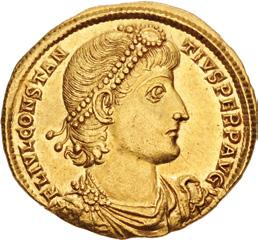
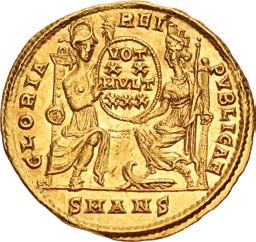

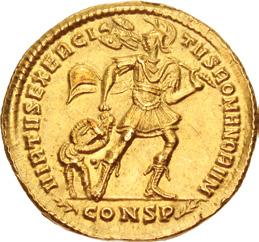
910. Constantius II. AD 337-361. AV Solidus (21mm, 4.42 g, 6h). Antioch mint, 6th officina. Struck AD 347-355. Pearldiademed, draped, and cuirassed bust right / Roma enthroned facing, holding spear, and Constantinopolis enthroned left, right foot on prow and holding scepter, together holding between them a shield inscribed VOT/ X X/ MVLT/ XXX in four lines; SMANS. RIC VIII 81; Depeyrot 6/3; Biaggi 2137 var. (officina). Toned, a few scratches and light marks, faint hairlines on obverse, tiny edge ding. EF. A well struck and captivating reverse. ($1000)
911. Julian II. AD 360-363. AV Solidus (21mm, 4.51 g, 6h). Constantinople mint. Struck AD 361-363. Pearl-diademed, draped, and cuirassed bust right / Soldier advancing right, head left, holding trophy and dragging bound captive; RCONSPS. RIC VIII 157; Depeyrot 8/1; Biaggi –. Toned, ex-mount. Near EF. ($2000)
Ex Gorny & Mosch 118 (15 October 2002), lot 2421; Gorny & Mosch 114 (4 March 2002), lot 420.
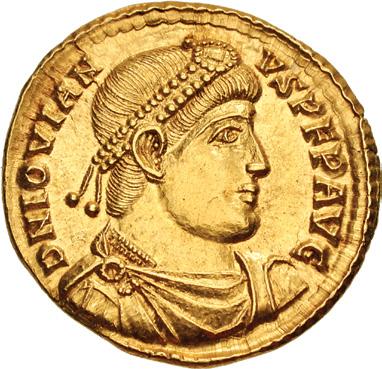
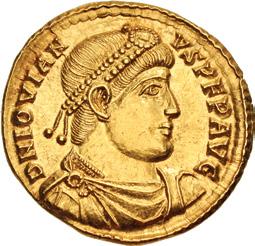
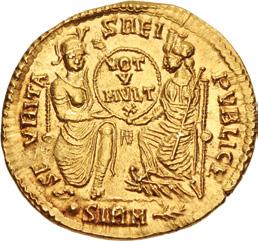

912. Jovian. AD 363-364. AV Solidus (20.5mm, 4.40 g, 6h). Sirmium mint. Pearl-diademed, draped, and cuirassed bust right / Roma enthroned facing, holding spear, and Constantinopolis enthroned left, right foot on prow and holding scepter, together holding between them a shield inscribed VOT/ V/ MVLT/ X in four lines; •SIRMS. RIC VII 115; Depeyrot 25/1; Biaggi 2226 var. (no stop in mintmark). Lightly toned with some luster, faint hairline scratches. EF. ($3000)
Ex Numismatica Ars Classica 18 (29 March 2000), lot 747; Leu 25 (23 April 1980), lot 447.




913. Valentinian I. AD 364-375. AV Solidus (21mm, 4.38 g, 6h). Antioch mint, 8th officina. Struck AD 364. Rosettediademed, draped, and cuirassed bust right / Emperor standing facing, head right, holding labarum with cross on banner and Victory on globe; cross to left; ANTHN. RIC IX 2b.xxx.4; Depeyrot 22/1; Biaggi –. Toned, ex-jewelry. Good VF. ($500)
914. Valens. AD 364-378. AV Solidus (20.5mm, 4.36 g, 5h). Antioch mint, 3rd officina. Struck AD 364. Pearl-diademed, draped, and cuirassed bust right / Emperor standing facing, head right, holding labarum with cross on banner and Victory on globe; cross to left; NANTΓN. RIC IX 2d.xxxvii.3; Depeyrot 20/2; Biaggi 2255 var. (officina). Toned, minor marks. Good VF. ($500) 910 911
239
913
914
Very Rare Solidus of Procopius: The Legitimate Usurper

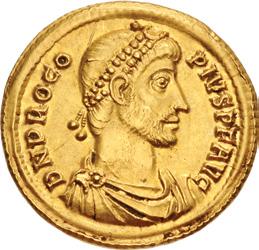
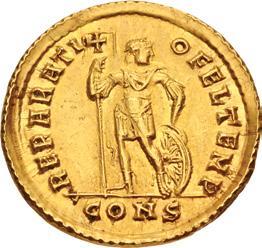

915. Procopius. Usurper, AD 365-366. AV Solidus (21mm, 4.40 g, 6h). Constantinople mint. Struck September–end of AD 365. Pearl-diademed, draped, and cuirassed bust right / Procopius standing facing, head right, holding labarum with cross on banner and resting hand on shield set on ground to right; CONS. RIC IX 2b; Depeyrot 14/3; Biaggi 2272. Toned, minor marks, some scratches, deposits. Near EF. Very rare. ($20,000)
Ex Numismatica Ars Classica 24 (4 December 2002), lot 317.
A maternal cousin of Julian II, Procopius had a successful career as a civil servant and was made a comes, or count, after Julian won the throne in AD 361. When Julian prepared his invasion of Persia a year later, he placed Procopius in command of a 30,000-man force intended to join with the allied Armenian army and Julian’s legions in Mesopotamia. Procopius later claimed that his cousin also gave him a purple cloak, along with instructions to succeed him as emperor should Julian be killed in battle. Regardless of the validity of this claim, Procopius failed miserably in his role, contributing to the defeat of Julian’s main force and his death in battle on June 27, AD 363. When the army chose Jovian as emperor, Procopius made no protest and took Julian’s body back to Tarsus for burial. But when Jovian abruptly died a few months later and the brothers Valentinian I and Valens came to power, Procopius decided to make a bid for the throne. While Valens was away from the capital, Procopius re-emerged at Constantinople on September 28, AD 365, wrapped in Julian’s purple cloak. The garrison proclaimed him emperor, and Procopius quickly established control of western Asia Minor. But he showed little strategic sense and soon some of his best officers and soldiers began defecting back to Valens. Meanwhile, Valens built his own forces and maneuvered Procopius into a decisive battle at Nicolea, Phrygia in May of 366. Procopius suffered a crushing defeat and was summarily executed in the aftermath, ending his eight-month usurpation.
The gold coinage of Procopius carries on the Constantinian tradition of fine portraiture and crisp execution. The exceptional portrait on this issue shows him wearing a close beard, probably a symbol of sympathy and mourning for his kinsman Julian II. His beard and the lack of substantial Christian imagery on the reverse of his solidi could allude to possible Pagan sympathies. The solidi of Procopius remain very rare.

916
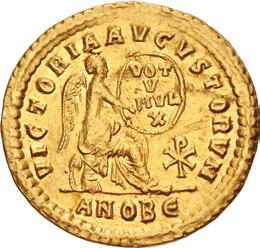
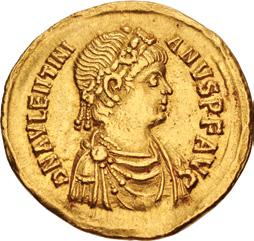
917

916. Gratian. AD 367-383. AV Solidus (21mm, 4.41 g, 12h). Quinquennalia issue. Antioch mint, 5th officina. Struck AD 372. Rosette-diademed, draped, and cuirassed bust right / Victory seated right on cuirass with shield behind, holding stylus and inscribing VOT/ V/ MVL/ X on shield set on left knee and supported by left hand; Christogram to right; ANOBЄ. RIC IX 21b; Depeyrot 38/8; Biaggi 2284. Toned, minor scratches and marks. Good VF. Rare. ($750)
917. Valentinian II. AD 375-392. AV Solidus (20.5mm, 4.41 g, 12h). Constantinople mint, 6th officina. Struck AD 383-385. Rosette-diademed, draped, and cuirassed bust right / Constantinopolis enthroned facing, head right, right foot on prow, holding scepter and globe; S//CONOB. RIC IX 46d.1; Depeyrot 38/4; Biaggi 2288. Toned, trace deposits. Good VF. ($500)
240
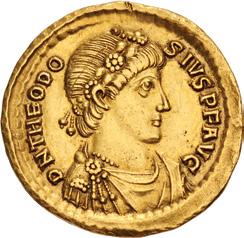

918. Theodosius I. AD 379-395. AV Solidus (20mm, 4.44 g, 6h). Sirmium mint. Struck AD 395-402. Rosette-diademed, draped, and cuirassed bust right / Emperor standing right, holding labarum and Victory on globe, placing foot on bound captive to right; S|M//COMOB. RIC IX 12b.1; Depeyrot 31/4; Biaggi –. Lightly toned with some underlying luster, scratches and marks. VF. A nice example. ($500)
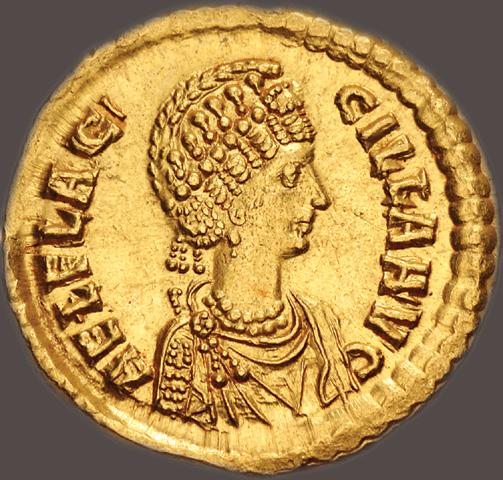
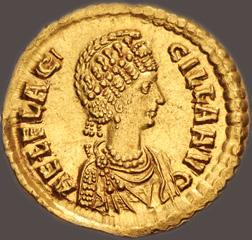


919. Aelia Flaccilla. Augusta, AD 379-386/8. AV Solidus (20.5mm, 4.47 g, 6h). Constantinople mint. Struck under Theodosius I, AD 383-384. Diademed, draped, and mantled bust right, wearing earring and necklace / Victory seated right, supporting shield set on column and left knee with left hand and inscribing Christogram on it with stylus; CONOB. RIC IX 48; Depeyrot 36/1; Biaggi 2308. Lightly toned with some underlying luster, trace deposits. EF. Very rare. ($20,000)
Ex Leu 86 (5 May 2003), lot 1038 (hammer CHF 26,000).
Empress Aelia Flaccilla is venerated as Saint Aelia Flaccilla in the Orthodox Church partly on account of her pious and dedicated maintenance of the Nicene Creed during a time where heretical beliefs (namely Arianism) were rampant throughout the empire. In one notable instance, Sozomen recounts in his Historia Ecclesiastica that Flaccilla orchestrated denying an audience between the emperor, Theodosius I, and Eunomius of Cyzicus (a leader of the radical Anomoean sect of Arianism). Arians rejected that Christ was “begotten not made, of one being with the Father,” or “consubstantial,” and instead considered Christ to be a created being. The Anomoeans went further by stating that Christ was neither of like nature with the Father.
Empress Flaccilla was wary of the influence Eunomius might have on the emperor and his Orthodox beliefs. Sozomen recounts that, “[Eunomius’] reputation reached the ears of the emperor, who would gladly have held a conference with him; but the empress Flacilla studiously prevented any interview from taking place between them, for she feared lest Eunomius might, by his powers of disputation, induce a change in the sentiments of the emperor” (Sozomen, Book VII, Chapter 6). Evidentially, Flaccilla was successful as Eunomius eventually ran afoul of Theodosius’ declaration of faith and was among the rebel leaders who were banished.


920. Arcadius. AD 383-408. AV Solidus (20.5mm, 4.47 g, 6h). Thessalonica mint. Struck AD 391-393 or AD 395-397. Pearl-diademed, draped, and cuirassed bust right / Constantinopolis enthroned facing, head right, holding spear and globe, right foot on prow; COMOB. RIC 64d; Depeyrot 41/4; Biaggi –. Lightly toned with some luster, light scratches and marks. EF. Rare. ($500)
Ex Hauck & Aufhäuser 16 (16 October 2001), lot 503.
241
Saint Aelia Flaccilla
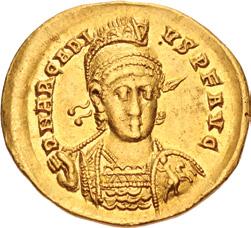
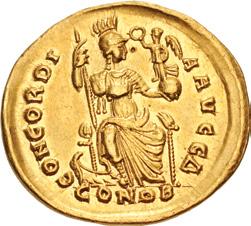
921. Arcadius. AD 383-408. AV Solidus (20.5mm, 4.44 g, 6h). Constantinople mint, 4th officina. Struck AD 397-402. Pearl-diademed, helmeted, and cuirassed bust facing slightly right, holding spear over shoulder and shield / Constantinopolis enthroned facing, head right, right foot on prow, holding scepter and Victory on globe; Δ//CONOB. RIC X 7; Depeyrot 55/1; Biaggi –. Lightly toned with some luster, a couple of small reverse die breaks, two small attempted piercings, some light scratches. Good VF. ($500)
The Venerable Eudoxia - Published in Tolstoi (1913)


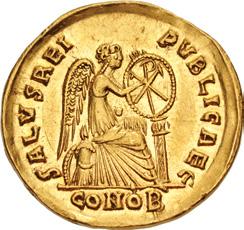
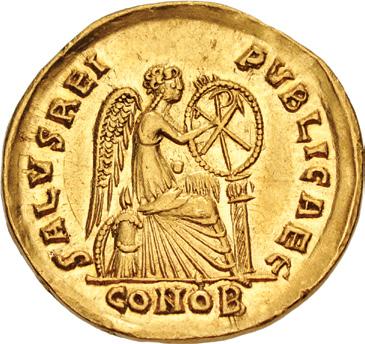
922. Aelia Eudoxia. Augusta, AD 400-404. AV Solidus (19.5mm, 4.49 g, 6h). Constantinople mint, 5th officina. Struck under Arcadius, AD 397-402. Pearl-diademed and draped bust right, wearing earring and necklace; being crowned by manus Dei above / Victory seated right on cuirass and shield; supporting shield set on column and left knee with left hand and inscribing Christogram on it with stylus; Є//CONOB. RIC X 14 (Arcadius); Depeyrot 55/5; Biaggi –; Tolstoi 138 (this coin). Lightly toned, lustrous, a few tiny marks. EF. Very rare. A vibrant early strike with much of the die engraver’s centering circle visible on both the obverse and reverse. ($4000)
Ex William H. Williams Collection (Triton VI, 14 January 2003), lot 1128; Hermitage Museum Collection (per Tolstoi); Photiades Pasha Collection (possibly Hoffmann, 23 May 1890, lot 21 [not illustrated]).
Aelia Eudoxia was a devout Christian and opponent of the heretical Arians. Nonetheless, Eudoxia found herself at odds with other Christian leaders. Her husband, the emperor Arcadius, showed little interest in serving as the benefactor of Christianity in the empire. Eudoxia subsequently stepped in to fill the void and became quite active in Church patronage. However, after the consul Eutropius was banished from the imperial court and subsequently executed, a friction developed between Eudoxia and the beheaded consul’s ally, the Patriarch of Constantinople, John Chrysostom. Eutropius had initially helped install Eudoxia as empress by arranging her marriage to Arcadius. However, the consul fell out of favor with Eudoxia and other officials and additionally developed a bad reputation leading to his downfall. John Chrysostom’s efforts delayed Eutropius’ execution, but within a year the consul lost his head. A damnatio memoriae was additionally issued against the disliked consul.
Tensions worsened between the two major figures in Constantinople’s church life, the Empress and the Patriarch, when Eudoxia took umbrage at comments made by John in his sermons condemning women’s elaborate dress, which Eudoxia took as aimed at herself. Eudoxia found cause against John on account of his failure to rebut Origen, the famous scholar from Alexandria whose teachings had found him out of favor with a number of church officials. Eventually, Eudoxia and her allies succeeded in ousting the Patriarch. However, his exile was short-lived. The populace threatened revolt and an earthquake suddenly struck, which Eudoxia interpreted as a sign of God’s displeasure. The reconciliation was not to last. Not long thereafter John denounced the dedication of a statue of Eudoxia (one pillar of which survives to this day) and compared her to Herodias demanding the head of John the Baptist. The lawyer and historian Salamanes Hermias Sozomenos, or Sozomen, recounts the incident in his Historia Ecclesiastica, writing, “Herodias is again enraged; again she dances; again she demands the head of John in a basin” (Sozomen, Book VIII, Chapter 20). This led to a second trial of John. After the second trial “John held no more assemblies in the church, but quietly remained in the episcopal dwelling-house” (ibid, Chapter 21). He subsequently survived an assassination attempt before being ordered into exile. Once the people discovered his exile, a riot broke out and amidst the chaos “the church was suddenly discovered to be on fire.” Subsequently, “[both] parties mutually accused each other of incendiarism” (ibid, Chapter 22). A mass arrest of John’s allies followed. Eudoxia’s victory was not to last, however, and she died shortly thereafter from an infection due to a failed seventh pregnancy.
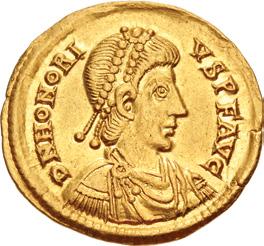
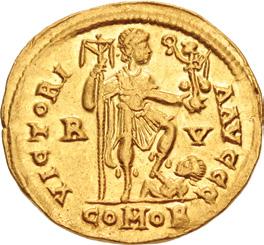
923. Honorius. AD 393-423. AV Solidus (21.5mm, 4.41 g, 6h). Ravenna mint. Struck AD 402-406. Pearl-diademed, draped, and cuirassed bust right / Honorius standing right, foot on captive, holding labarum and Victory on globe; R|V// COMOB. RIC X 1287; Ranieri 11; Depeyrot 7/1; Biaggi 2319. Lightly toned with some underlying luster, thin scratch on reverse. Good VF. ($500)
242
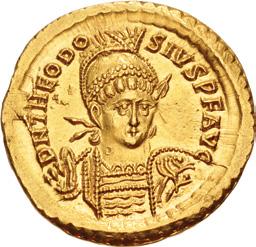
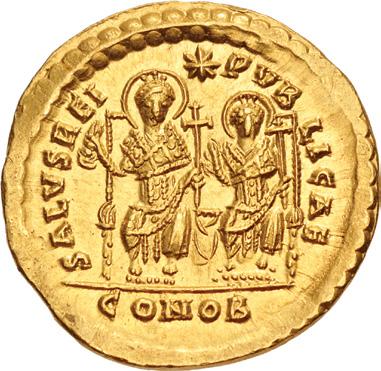
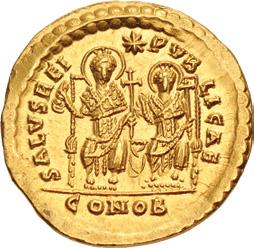
924. Theodosius II. AD 402-450. AV Solidus (20.5mm, 4.48 g, 6h). Constantinople mint. Struck AD 425-429. Pearldiademed, helmeted, and cuirassed bust facing slightly right, holding spear over shoulder and shield / Theodosius II and Valentinian III enthroned facing, both nimbate and wearing consular robes, both holding mappa and cruciform scepter; star above; CONOB. RIC X 239; Depeyrot 79/1; Biaggi –. Lightly toned, trace obverse die rust, minor mark, light scratch. EF. ($750)
Ex Numismatica Ars Classica 21 (17 May 2001), lot 591.
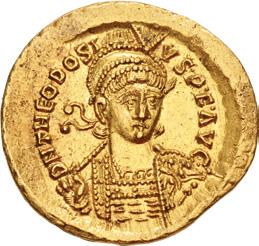
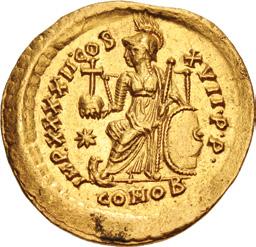
925. Theodosius II. AD 402-450. AV Solidus (21mm, 4.46 g, 7h). Constantinople mint. Struck AD 443-450. Pearldiademed, helmeted, and cuirassed bust facing slightly right, holding spear over shoulder and shield / Constantinopolis seated left on throne, holding globus cruciger and scepter, foot on prow; shield to right side of throne; star to left; COMOB. RIC X 301; Depeyrot 84/1; Biaggi –. Lightly toned with some luster, light deposits. Near EF. ($500)
The Rise and Fall of Empress Eudocia
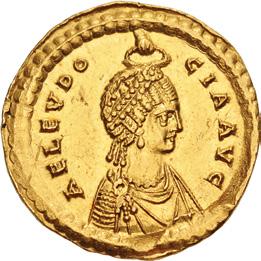
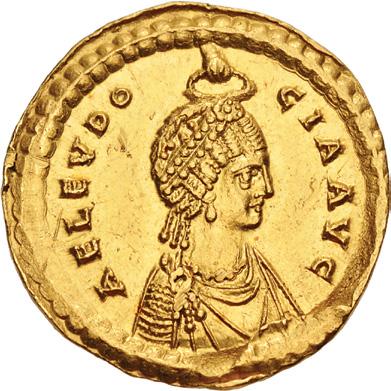
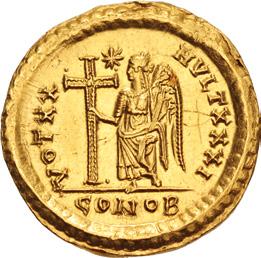
926. Aelia Eudocia. Augusta, AD 423-460. AV Solidus (21.5mm, 4.32 g, 6h). Constantinople mint, 10th officina. Struck under Theodosius II, AD 423-425. Pearl-diademed and draped bust right, wearing earring and necklace; being crowned by manus Dei above / Victory standing left, holding long cross; star in upper left field; I//CONOB. RIC X 228; Depeyrot 75/2; Biaggi 2334 var. (no officina). Lamination error, minor graffiti, a couple of scrapes, a few marks. Near EF. Rare. ($3000)
Ex Numismatica Ars Classica 21 (17 May 2001), lot 594.
Aelia Eudocia, the woman who would become empress as the wife of Emperor Theodosius II, came from an unusual background considering her eventual status. Born circa 400/1 in Athens to a Greek family, she was first named Athenais. Her father was a one of the last pagan professors of rhetoric in Athens. When he died when she was around twenty years old, she was dismayed to learn that her father had left the vast majority of his estate to her brothers and had left to her only “100 gold coins,” though he predicted a great destiny for her. After her brothers refused to include her in their substantial inheritance, she went to live with an aunt who suggested that she seek justice from the emperor. She gained an audience with Pulcheria, the emperor’s sister who guided him as he came of age. The emperor, having expressed a desire to marry, was delighted with Athenais and a match was arranged between the two; however, Pulcheria ensured that her brother’s new wife was baptized as a Christian, subscribed to the Christian faith, and was renamed. A rivalry eventually developed between the two principal women which greatly strained their relationship. It does seem as though Eudocia’s conversion was authentic, for she developed an interest in church matters and even acquired relics. During her time, her husband, Emperor Theodosius II alongside his sister Pulcheria, presided over the return of the relics of his parents’ rival, the former Patriarch of Constantinople, John Chrysostom. Theodosius reportedly went so far as to beg forgiveness before Chrysostom’s tomb for the sins committed against him by his parents.
Unfortunately for Eudocia, she eventually fell out of grace not only with her jealous sister-in-law, but ultimately with her husband as well. Eventually, Theodosius dismissed Eudocia from the imperial capital. Contemporary historians writing after this period make little to no mention of the empress due to her fall from grace. She lived for some time in exile, but remained a figure in church activities in the Holy Land before she died. In the end, Eudocia died retaining her dignity despite her sudden fall from power at court.
243



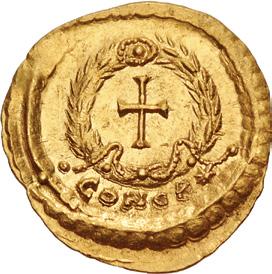
927. Aelia Eudocia. Augusta, AD 423-460. AV Tremissis (14.5mm, 1.47 g, 12h). Constantinople mint. Struck under Theodosius II, AD 441-450. Pearl-diademed and draped bust right, wearing earring and necklace / Cross within wreath with large central jewel; CONOBN. RIC X 335 (Theodosius II); Depeyrot 72/2; Biaggi 2359 var. (wreath ties). Toned, slight doubling. EF. ($750)
Ex Tkalec (19 February 2001), lot 423.
Wonderful Pulcheria Solidus
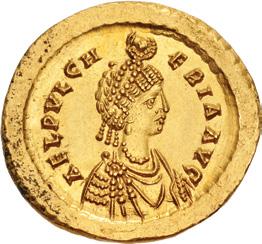
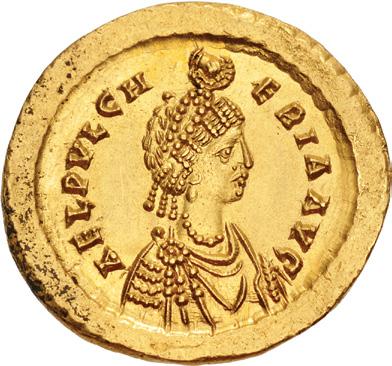
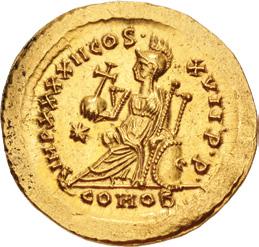
928. Aelia Pulcheria. Augusta, AD 414-453. AV Solidus (21.5mm, 4.47 g, 6h). Constantinople mint. Struck under Theodosius II, AD 443-450. Pearl-diademed and draped bust right, wearing earring and necklace; being crowned by manus Dei above / Constantinopolis seated left, holding globus cruciger and scepter, foot on prow; shield to right; star to left; COMOB. RIC X 295; Depeyrot 84/3; Biaggi –. Toned, trace find patina, a few faint scratches. EF. Rare. ($3000)
Ex Tkalec (19 February 2001), lot 425.
The sister of Emperor Theodosius II, Aelia Pulcheria, was a major force in the life of the young emperor. Governing him as a young man until he came of age, Pulcheria prepared the emperor for his duties and served as a constant guiding voice and counselor to him. Present throughout his accomplishments and major events, Pulcheria eventually won the contest between her and her brother’s wife, Aelia Eudocia, who was eventually dismissed from court. While she was a teenager, Pulcheria took a vow of virginity which she maintained until her death. This dedication to God inspired some of Theodosius’ imperial propaganda during wars with the Sasanian Persians, and the Romans considered Pulcheria’s pious dedication of her virginity to be a source of blessing upon the Empire from God. Theodosius died unexpectedly after being mortally injured during a hunting accident in AD 450. Upon his death, Pulcheria was tasked with appointing his successor. She chose a man of Roman stock, though not of nobility, named Marcian. She married the new emperor on the condition that he not make her violate her vow of virginity, to which Marcian agreed. This unconventional marriage was made possible by church officials, who sponsored the agreement and decreed that God approved of the union and arrangement.


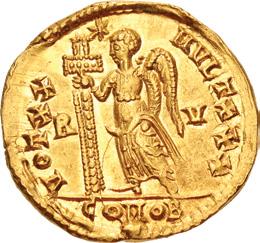

929. Galla Placidia. Augusta, AD 421-450. AV Solidus (21mm, 4.38 g, 12h). Ravenna mint. Struck under Valentinian III, AD 444-445. Pearl-diademed and draped bust right, wearing earring and necklace; being crowned by manus Dei above / Victory standing left, holding long jeweled cross; star to upper left; R|V//COMOB. RIC X 2020; Ranieri 76 corr. (cross on shoulder); Depeyrot 16/3; Biaggi 2333. Toned with some luster, die breaks, lamination error, a few light scratches, faint hairlines. Near EF. Rare. ($4000)
Ex Numismatica Ars Classica 21 (17 May 2001), lot 589.
244
Extremely Rare Imperial Marriage Issue
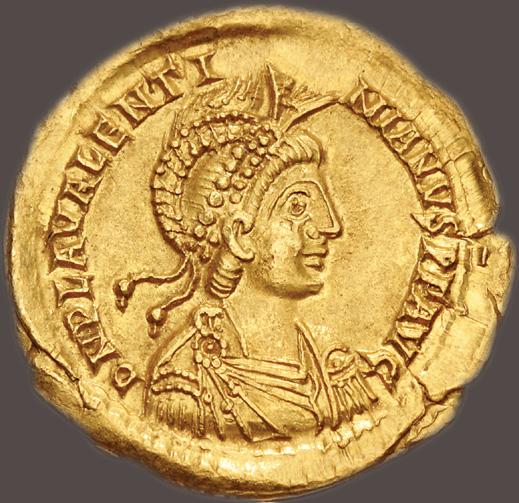
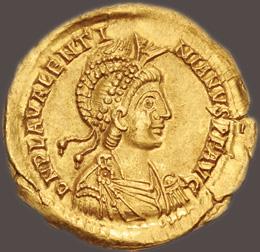


930. Valentinian III. AD 425-455. AV Solidus (21mm, 4.45 g, 7h). Imperial Marriage issue. Thessalonica mint. Struck Winter AD 437-438. Pearl-diademed, helmeted, draped, and cuirassed bust right / Theodosius II standing facing, clasping hands together with Valentinian III standing facing to left and Licinia Eudoxia standing facing to right; all three nimbate and wearing imperial regalia; COMOB. RIC X –; Depeyrot –; Biaggi –; Tkalec (29 February 2000), lot 452 = Triton V, 2227 = Triton VII, lot 1061; Tkalec (19 February 2001), lot 432 (this coin). Lightly toned with some luster. EF. Extremely rare, one of only six known, this coin having been the second known specimen. ($30,000)
Ex Tkalec (19 February 2001), lot 432.
After Galla Placidia’s falling out with Honorius, the young Valentinian accompanied his mother and sister to exile at the court of his cousin, Theodosius II, at Constantinople. The eastern attitude toward Valentinian changed in 423 when the usurper Johannes seized power in the west. Valentinian was first reaffirmed as Nobilissimus in 423/424, named Caesar in 424, and, in the same year, betrothed to his cousin Licinia Eudoxia, the daughter of Theodosius II. In 425 he was proclaimed Augustus at Rome, and in 437 he returned to Constantinople for his marriage. The wedding, on 29 October, was a great state occasion. Flavius Merobaudes, the 5th century poet and rhetorician and the official laureate of Valentinian III and Aëtius, describes that in the palace at Ravenna a series of mosaic pictures, now lost, depicted the occasion and the sequence of events that had led up to it. The mosaics showed the “exile” of Valentinian at Constantinople with Galla Placidia, his appeal to Theodosius, his restoration by the eastern government, and his betrothal to Licinia Eudoxia. They further showed the baby daughter of the young couple, born probably in 438 and baptized in infancy. Dominating the composition, however, in the middle of the ceiling, was the Emperor Theodosius and his wife Eudocia, “like the bright stars of the heavens on high.” It left no doubt which was the senior court, pre-eminent in power and authority. On their journey back to Rome, the newly-married imperial couple spent the winter of AD 437/8 in Thessalonica, during which time this extremely rare issue of solidi was struck.
Six specimens of this extremely rare issue are known, including the current example, all from the same pair of dies:
1) Numismatica Ars Classica 100 (29 May 2017), lot 724 = Künker 277 (21 June 2016), lot 167 = NGSA V (2 December 2008), lot 332 = Glenn Woods Collection (Triton VII, 13 January 2004), lot 1061 = Berk 116 (17 October 2000), lot 55 = Tkalec (29 February 2000), lot 452 = Triton V (15 January 2002), lot 2227.
2) Tkalec (19 February 2001), lot 432. (this coin).
3) J.J. Grano Collection (Numismatica Genevensis SA VIII, 24 November 2014), lot 204 = Numismatica Genevensis SA II (18 November 2002), lot 151.
4) Triton VI (14 January 2003), lot 1160.
5) Numismatica Ars Classica 34 (24 November 2006), lot 114 = Gemini I (11 January 2005), lot 485.
6) Triton XVIII (6 January 2015), lot 1273.
245

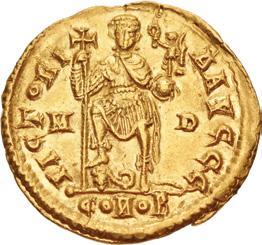
931. Valentinian III. AD 425-455. AV Solidus (21.5mm, 4.48 g, 6h). Mediolanum (Milan) mint. Struck AD 430-440. Rosette-diademed, draped, and cuirassed bust right / Valentinian, wearing military attire, standing facing, right foot on humanheaded serpent coiled below, holding long cross and Victory on globe; M|D//COMOB. RIC X 2025; Toffanin 514/1; Depeyrot 20/2; Biaggi –. Lightly toned, trace deposits. Near EF. ($750)
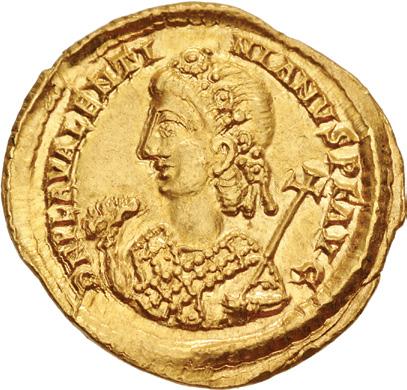
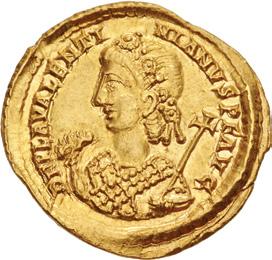
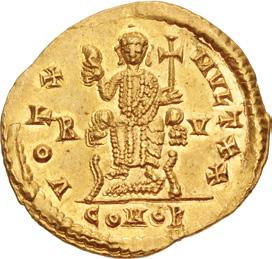

932. Valentinian III. AD 425-455. AV Solidus (22mm, 4.35 g, 6h). Consular issue. Ravenna mint. Struck AD 435. Rosette-diademed bust left, wearing consular robes, holding mappa and cruciform scepter / Valentinian enthroned facing, holding mappa and cruciform scepter; R|V//COMOB. RIC X 2036; Ranieri 99-100; Depeyrot 14/1; Biaggi –. Lightly toned with some underlying luster, doubling, tiny die breaks, tiny metal flaw. Near EF. Very rare. ($2000)
Ex Gorny & Mosch 107 (2 April 2001), lot 639.
Extremely Rare Issue – Unique for This Officina
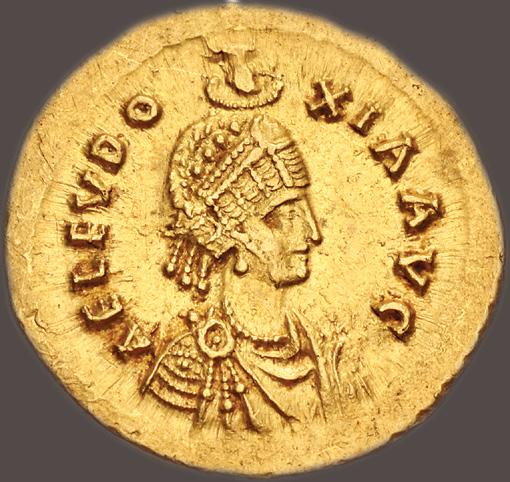
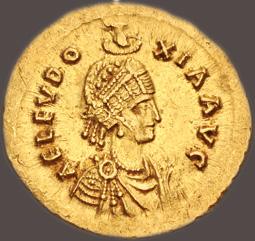
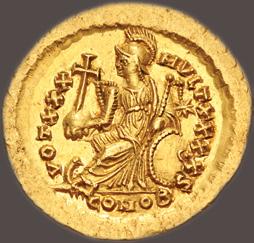
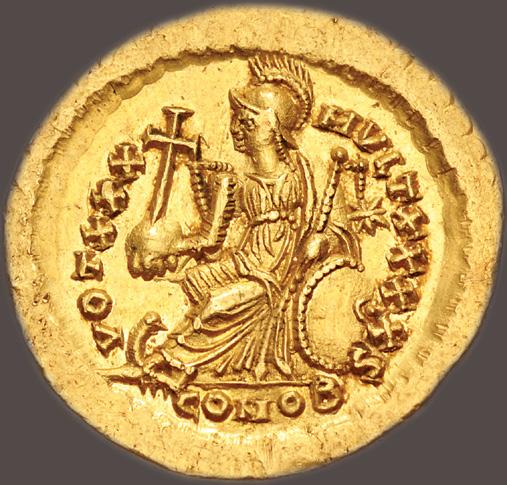
933. Licinia Eudoxia. Augusta, circa AD 439-490. AV Solidus (20.5mm, 4.44 g, 6h). Constantinople mint, 6th officina. Struck under Valentinian III, AD 439-440. Pearl-diademed and draped bust right, wearing earring and necklace; being crowned by manus Dei above / Constantinopolis seated left, holding globus cruciger and scepter, foot on prow; shield and star to right; S//CONOB. RIC X 264. var. (unlisted officina); Depeyrot 81/5 var. (same); Biaggi 2356 var. (officina). Lightly toned, faint scratches, light deposits. EF. Extremely rare issue. The only known example from this officina. ($5000)
Ex Numismatica Ars Classica 23 (19 March 2002), lot 1722.
246
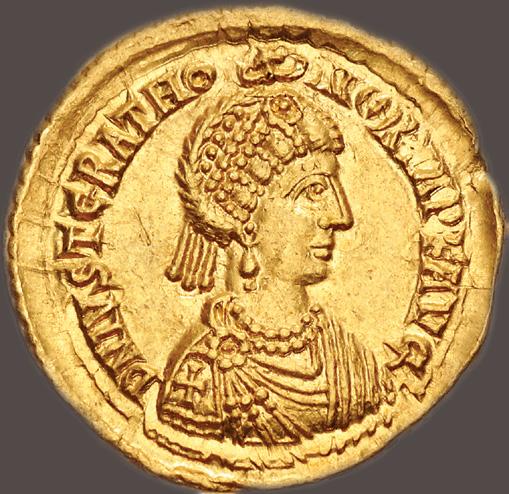


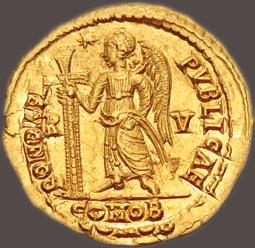
934. Justa Grata Honoria. Augusta, circa AD 426-450. AV Solidus (20.5mm, 4.41 g, 12h). Ravenna mint. Struck AD 439. Pearl-diademed and draped bust right, wearing earring and necklace; being crowned by manus Dei above / Victory standing left, holding long jeweled cross; star to upper left; R|V//COMOB. RIC X 2022; Ranieri 87-89; Depeyrot 15/1; Biaggi 2360. Some underlying luster, doubling, a few tiny metal flaws, minor marks. EF. ($5000)
Ex Tkalec (19 February 2001), lot 433.
Honoria was sister to the emperor Valentinian III. She was to be married to a Roman Senator named Bassus Herculanus, but she had no interest in this union and sought aid from the already infamous Hun, Atilla. In the Spring of 450, she sent him her ring and a plea for help. Whether Honoria intended this to be an invitation to wed is uncertain, but Atilla took it as such and accepted, asking for half the Western Empire as his dowry. In 452 he unsuccessfully invaded northern Italy after negotiations with Rome failed. Little is known of Honoria’s fate from this point on other than a brief exile and possible time in a Constantinople convent.

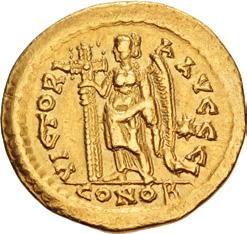
935. Marcian. AD 450-457. AV Solidus (20.5mm, 4.43 g, 6h). Constantinople mint, 10th officina. Pearl-diademed, helmeted, and cuirassed bust facing slightly right, holding spear over shoulder and shield / Victory standing left, holding long jeweled cross; star to right; I//CONOB. RIC X 510; Depeyrot 87/1; Biaggi –. Lightly toned with some luster, a few light scratches, a few minor deposits. VF. ($500)
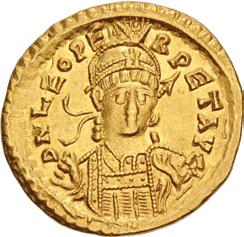

936. Leo I. AD 457-474. AV Solidus (20mm, 4.41 g, 6h). Constantinople mint, 1st officina. Struck AD 457-circa 468. Pearl-diademed, helmeted, and cuirassed bust facing slightly right, holding spear over shoulder and shield / Victory standing left, holding long jeweled cross; star to right; A//CONOB. RIC X 605; Depeyrot 93/1; Biaggi –. Lightly toned with some luster, scratch. Good VF. ($500)
247
Extremely Rare Verina: Imperial Intriguer

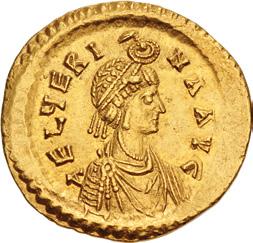
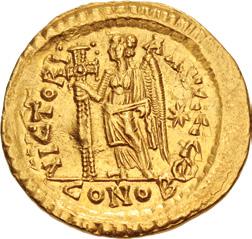
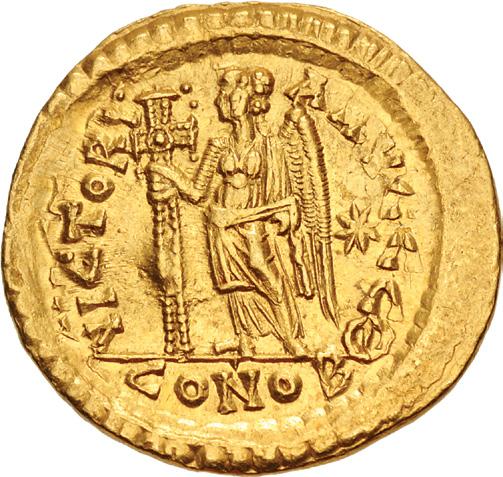
937. Aelia Verina. Augusta, AD 457-484. AV Solidus (20.5mm, 4.48 g, 6h). Constantinople mint, 9th officina. Struck under Leo I, AD 457-circa 468. Pearl-diademed and draped bust right, wearing earring and necklace; being crowned by manus Dei above / Victory standing left, holding long jeweled cross; star to right; Θ//CONOB. RIC X 607; Depeyrot 93/2; Biaggi –. Lightly toned, reverse die shift. Near EF. Very rare issue. Extremely rare in this officina. This coin is one of five cited in Depeyrot’s 2004 corpus (Depeyrot cites six examples; however, this coin is cited twice in two separate entries). Three of the five examples are in museum collections. This coin is one of two in private hands. ($15,000)
Ex Numismatica Ars Classica 23 (19 March 2002), lot 1725; Numismatic Fine Arts VI (27 February 1979), lot 985; Leu 15 (4 May 1976), lot 432; Dr. H. Longuet Collection (Platt, 17 March 1970), lot 279.
Aelia Verina, the wife of Leo I, had an extraordinary personal history. She was engaged in numerous plots both for and against her various relatives in numerous intrigues either to control the succession or seize the throne. From the limited historical sources available, Verina appears to have been the consummate imperial schemer who regularly instigated and switched sides in deadly dynastic disputes. She notably conspired after the death of her husband Leo I against her son-in-law, the Isaurian Zeno, who became emperor after the death of his son (Verina’s grandson) Leo II. During the short reign of Leo II, the young ruler raised his father to the rank of co-augustus alongside him. But upon Leo II’s untimely death, Verina took part in a conspiracy in which her brother Basiliscus successfully usurped the lawful emperor Zeno. The deposed emperor escaped the capital with his wife and fled to his native region of Isauria. This conspiracy, however, ultimately failed and Zeno orchestrated a successful return to power. Zeno’s second reign lasted another fifteen years until his death in AD 491. However, his second reign was not without incident. Verina, not dissuaded, emerged again in AD 484 for one last intrigue against her son-in-law, this time conspiring with the general Illus (who was also an Isaurian soldier). Zeno crushed the revolt, and Verina died during the siege of Papyrius, the last holdout of the rebel forces.
Brief Joint Reign Issue of Leo II & Zeno


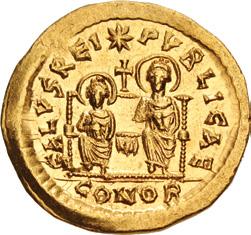
938. Leo II, with Zeno. AD 474. AV Solidus (20.5mm, 4.48 g, 6h). Constantinople mint. Struck 18 January-17 November. Pearl-diademed, helmeted, and cuirassed bust facing slightly right, holding spear over shoulder and shield / Leo and Zeno seated facing on double throne, both nimbate and holding mappa; star and cross above; CONOB. RIC X 803; Depeyrot 98/1; Biaggi –. Lightly toned and lustrous, light obverse die rust, mark at edge, minor deposits. EF. ($1000) Ex Peus 376 (29 October 2003), lot 1110.
Among the most pressing concerns of the aging East Roman Emperor Leo I was finding a successor. Without a son, his hope rested with his eldest daughter, Aelia Ariadne, who had married an Isaurian soldier named Zeno. The couple soon produced a son, Leo II. When the elder Leo’s health began to falter, he raised his eponymous grandson to the rank of Caesar in October AD 473, then Augustus in January AD 474. Leo I died a few days later, and the sickly seven-year-old Leo II became sole emperor. Leo’s widow Aelia Verina arranged for Leo II to appoint his own father, Zeno, co-emperor on 9 February AD 474, an arrangement that lasted until Leo II died in November of the same year. Afterwards, Zeno ruled as sole emperor. This solidus was struck during their brief joint-reign.
248
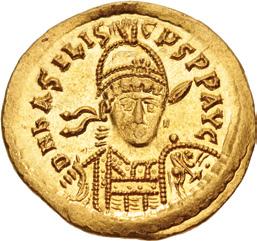
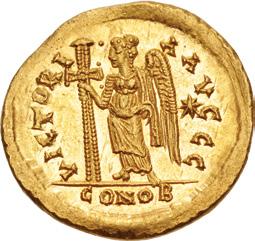
939. Basiliscus. AD 475-476. AV Solidus (21mm, 4.48 g, 6h). Constantinople mint. Pearl-diademed, helmeted, and cuirassed bust facing slightly right, holding spear over shoulder and shield / Victory standing left, holding long jeweled cross; star to right; CONOB. RIC X 1003; Depeyrot 101/1; Biaggi –. Lightly toned and lustrous, slight weakness, a few minor marks. EF. ($1500)
Ex Numismatica Ars Classica 18 (29 March 2000), lot 788.


940. Basiliscus & Marcus. AD 475-476. AV Solidus (20mm, 4.47 g, 6h). Constantinople mint, 8th officina. Pearldiademed, helmeted, and cuirassed bust facing slightly right, holding spear over shoulder and shield / Basiliscus and Marcus seated facing on double throne, both nimbate, both holding mappa and globe; star and cross above; H//CONOB. RIC X 803; Depeyrot 98/1; Biaggi –. Lightly toned with some luster, small metal flaw, graffito, minor marks, minor deposits. Good VF. Rare. ($1500)
Ex Peus 375 (29 October 2003), lot 1111.
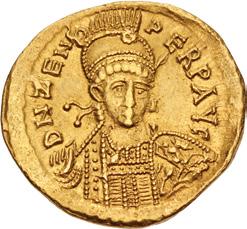

941. Zeno. Second reign, AD 476-491. AV Solidus (20.5mm, 4.43 g, 6h). Constantinople mint, 8th officina. Pearldiademed, helmeted, and cuirassed bust facing slightly right, holding spear over shoulder and shield / Victory standing left, holding long cross; star to right; H//CONOB. RIC X 911 and 930; Depeyrot 108/1; Biaggi –. Lightly toned with some luster, obverse die rust, a few light scratches and minor marks on reverse, minor deposits. Good VF. ($500)
Very Rare Ephemeral Leo Caesar
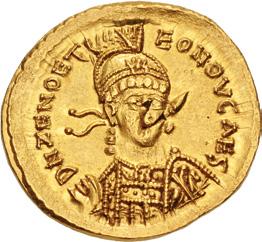
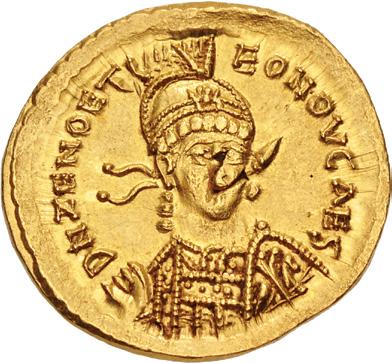
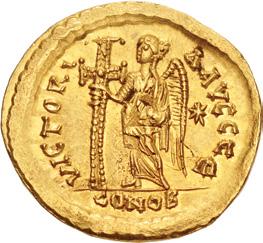
942. Zeno and Leo Caesar. AD 476-477. AV Solidus (21.5mm, 4.49 g, 6h). Constantinople mint, 5th officina. Pearldiademed, helmeted, and cuirassed bust facing slightly right, holding spear over shoulder and shield / Victory standing left, holding long jeweled cross; star to right; Є//CONOB. RIC X 906; Depeyrot 107/1; Biaggi –. Lightly toned, metal flaws and lamination errors, minor deposits. Good VF. Very rare. ($1500)
Ex Numismatica Ars Classica 24 (5 December 2002), lot 367; William Herbert Hunt Collection (Sotheby’s New York, 5 December 1990), lot 35.
This issue has long puzzled scholars and catalogers due to the wording of the obverse legend, D N ZENO ET L EO NOV CAES. The issue was previously thought to be a reference to two separate caesars under the usurper Basiliscus belonging to the period of his reign from 475-476 (cf. J. P. C. Kent, “Zeno and Leo, the Most Noble Caesars” in (NC 1959, pp. 93-98 and pl. VIII)). However, current scholarship has determined that the coin does in fact belong to the early period of Zeno’s second reign and that the Leo Caesar it references refers to Basiliscus, the son of the turncoat general Armatus, renamed to the more acceptable Leo. When Armatus betrayed the usurper emperor Basiliscus and aided the rightful deposed ruler Zeno in his return to power, he made Zeno promise to name his son as caesar. While this promise was briefly honored, once Zeno was securely restored, he disposed of his associate, the junior Basiliscus/Leo, and executed Armatus.
249

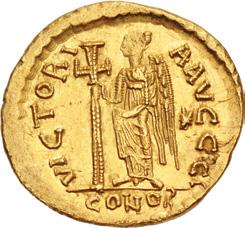
943. Anastasius I. 491-518. AV Solidus (20mm, 4.44 g, 6h). Constantinople mint, 10th officina. Struck 492-507. Helmeted and cuirassed bust facing slightly right, holding spear over shoulder and shield on left shoulder / Victory standing left, holding long jeweled cross; star to right; I//CONOB. DOC 3i; MIBE 4a; SB 3. Lightly toned with some underlying luster, trace obverse die rust, small metal flaw, hairlines, trace deposits. Good VF. ($500)


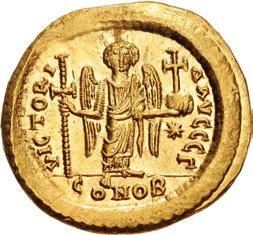

944. Justin I. 518-527. AV Solidus (20.5mm, 4.49 g, 6h). Constantinople mint, 3rd officina. Struck 522-527. Helmeted and cuirassed bust facing slightly right, holding spear over shoulder, shield on left shoulder / Angel standing facing, holding long cross and globus cruciger; star to right; Γ//CONOB. DOC 2c; MIBE 3; SB 56. Brilliant luster. Choice EF. ($750)
Joint Reign Issue

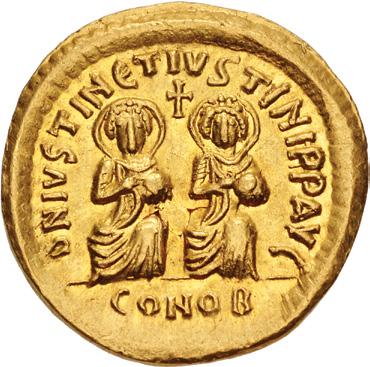
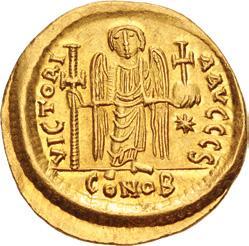
945. Justin I & Justinian I. 527. AV Solidus (20.5mm, 4.49 g, 6h). Constantinople mint, 6th officina. Struck 4 April-1 August. Justin and Justinian enthroned facing, both nimbate, both placing hand on breast and holding globus; cross between / Angel standing facing, holding long cross and globus cruciger; star to right; S/CONOB. DOC –; Metcalf, Joint Group Id, 17 (O8/S4); MIBE 1d; SB 117. Lightly toned, small metal flaw, a few minor marks. EF. Very rare. ($2000)
Ex William H. Williams Collection (Triton VI, 13 January 2003), lot 1196.
Justin was an illiterate peasant from Thrace who acquired the throne through his natural strengths and cunning. Though of little learning himself, he understood the value of education, especially for his relatives. Consequently, his nephew Peter was sent to Constantinople for his education. When Justin became emperor, his nephew was renamed Justinian and served as his trusted advisor. Justinian was the real driving force behind many of the wise policies adopted under the reign of his uncle. His true brilliance would come to light during his future sole reign. When Justin’s health began to fail in 527, Justinian was readily accepted as co-emperor and the transition of power was uneventful. The coming change was advertised by an extensive series of joint reign solidi, judging by the number of dies known. Presumably, these pieces were withdrawn from circulation after the accession of Justinian, accounting for their significant rarity today

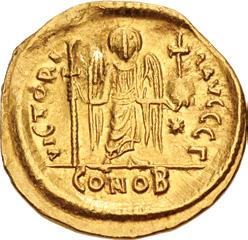
946. Justinian I. 527-565. AV Solidus (20.5mm, 4.41 g, 6h). Constantinople mint, 3rd officina. Struck 527-537. Helmeted and cuirassed bust facing slightly right, holding spear over shoulder, shield on left shoulder / Angel standing facing, holding long cross and globus cruciger; star to right; Γ//CONOB. DOC (3c); MIBE 5; SB 137. Lightly toned, lightly clipped, light scratch, minor marks. VF. ($500)
250
Extremely Rare Joint Reign Issue: Imperial Propaganda Through Coinage



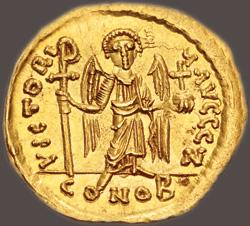

947. Justin II & Tiberius II Constantine. 578. AV Solidus (20.5mm, 4.40 g, 6h). Constantinople mint, 7th officina. Struck 26 September-5 October. D N IVSTINI ЄT CONSTAN P P AVG, crowned and draped facing busts of Justin and Tiberius; cross above / VICTORIA AVGGG, Angel standing facing, holding long staff surmounted by staurogram and globus cruciger; Z//CONOB. DOC (1); MIB 1 and pl. 10, 1 (this coin cited and illustrated [from a plaster cast copy in the British Museum]); MIBE 1 and pl. 10, 1 (this coin cited and illustrated [from a plaster cast copy in the British Museum]); SB 417. Thin obverse die break, clashing on reverse, minor metal flaw, light edge marks from mount, light hairlines. EF. Extremely rare. One of the absolute supreme rarities of all Byzantine coinage. This example one of the finest preserved of this incredibly difficult issue and recorded by Hahn in MIB as being in the Protonotarios collection in the early 1970’s. ($50,000)
Ex Glenn Woods Collection (Triton VII, 12 January 2004), lot 1082; Stack’s (1 December 1999), lot 40; Sotheby’s New York (2 November 1998), lot 121; William Herbert Hunt Collection (Sotheby’s New York, 5 November 1990, lot 124; P. N. Protonotarios Collection.
The extremely rare joint-reign solidi of Justin II and Tiberius II are attested to by precious few examples. First discovered among the solidi and medallions contained within the remarkable Kyrenia Girdle, the issue instantly became a grail coin for any Byzantine or late Roman gold collection. The example found here is among the finest-struck and best-preserved of the known examples (which number fewer than ten). Considering the brevity of the joint reign, it is remarkable that such coins were struck or that any have survived. But the existence of this extremely rare issue proves the ceremonial and legitimizing value of coinage. The production of the joint reign solidi must have been planned and probably implemented well in advance, and attests to the importance attached to such coinage in conveying the ideas of the successful transfer of power or the accession of a new ruler.
Succeeding his uncle by marriage, the formidable Justinian I, would have been a daunting task for Emperor Justin II even with his full faculties. Unfortunately, Justin was hampered by ill health, which may have included mental troubles. Pressure from his influential wife Sophia and the imperial court led to the nomination of Tiberius as Caesar in 574. Tiberius proved a competent administrator, and opinion mounted that the junior ruler should be elevated to full co-Augustus. The ailing Justin acceded to this, and Tiberius was elevated as Augustus on September 26th 578. The senior augustus Justin died only nine days later.
The Kyrenia Girdle was first discovered in 1902 (though published later in the 1955 Numismatic Chronicle). The incredible belt was ornamented with an unprecedented four six-solidi consular medallions of Maurice Tiberius (dated to 582) along with fifteen solidi including: an IMP XXXXII issue of Theodosius II, three Justin I and Justinian I join reign pieces, one Justin II and Tiberius II joint reign solidus, and ten consular solidi of Maurice (two of which were later discovered separately). Taken together, the coins demonstrate a consistent theme. The Theodosius issue marked his 42nd year as ruler, equal to the reign of the first emperor Augustus. The joint reign solidi denote dynastic continuity, and the consular issues of Maurice record the preservation of the ancient traditional office in Roman culture.
The belt, embellished with over one-half pound of coined gold must have been a donative presented to a very high ranking official. The pieces were likely selected not for their rarity, but for their propaganda value. Like the Kyrenia Girdle, the joint reign solidi of Justin II and Tiberius, such as this wonderful example, were struck for the same reason—to serve as a tangible reminder of the solidity of the imperial succession.
251
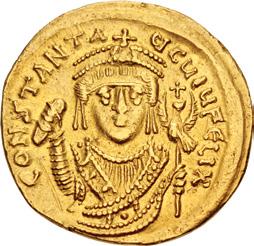
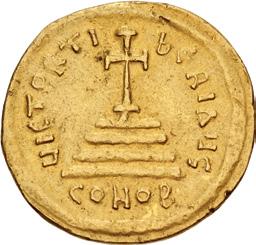
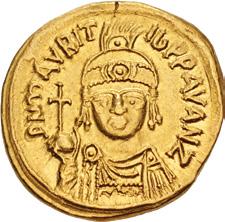

948. Tiberius II Constantine. 578-582. AV Solidus (20.5mm, 4.47 g, 6h). Constantinople mint. Crowned facing bust, wearing consular robes, holding mappa and eagle-tipped scepter surmounted by cross / Cross potent set on four steps; CONOB. DOC 2; MIBE 2; SB 420. Lightly toned, thin scrape, light scratches. Good VF. ($750)
949. Maurice Tiberius. 582-602. AV Solidus (18.5mm, 4.38 g, 6h). Carthage mint. Dated RY 7 (588/9). Helmeted and cuirassed bust facing, holding globus cruciger; Z (date) at end of legend / Angel standing facing, holding long staff surmounted by staurogram and globus cruciger; Z (date)//CONOB. DOC 221 var. (obv. legend); MIBE 25a; SB 548. Toned, a few small metal flaws, a few minor marks and light scratches. Good VF. ($500)

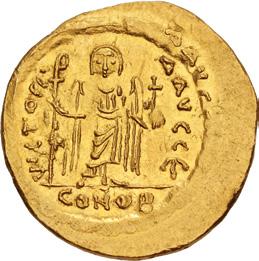

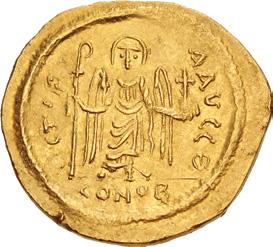
950. Phocas. 602-610. AV Solidus (21mm, 4.49 g, 7h). Consular issue. Constantinople mint, 5th officina. Struck December 603-604. Crowned facing bust, wearing consular robes, holding mappa and cross / Angel standing facing, holding long staff surmounted by staurogram and globus cruciger; Є//CONOB. DOC 4 var. (unlisted officina); MIBE 2; SB 623. Lightly toned with some luster, die rust, some doubling, thin scrape, a few light scratches and minor marks. Near EF. ($500)
Ex Numismatica Ars Classica 11 (29 April 1998), lot 581 (since conserved).
951. Phocas. 602-610. AV Solidus (22mm, 4.39 g, 7h). Constantinople mint, 9th officina. Struck 604-607. Draped and cuirassed bust facing, wearing crown without pendilia, holding globus cruciger / Angel standing facing, holding long staff surmounted by staurogram and globus cruciger; Θ//CONOB. DOC 5i; MIBE 7; SB 618. Toned with some luster, lightly clipped, obverse die shift, light die rust, area of weak strike, minor scrape, edge mark. Good VF. ($500)
Extremely Rare Eastern Mint Heraclius Solidus with Phocas Portrait
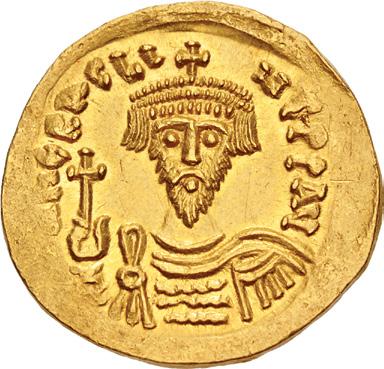
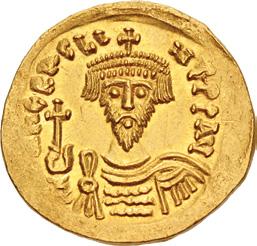

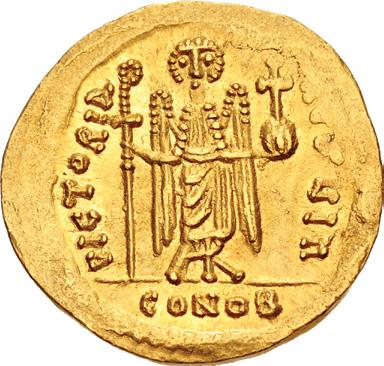
952. Revolt of the Heraclii. 608-610. AV Solidus (21mm, 4.48 g, 7h). Uncertain eastern mint. Crowned, draped, and cuirassed facing bust (resembling Phocas), holding globus cruciger / Angel standing facing, holding long staff surmounted by staurogram and globus cruciger; IΠ//CONOB. DOC 186 (Heraclius; Alexandria); MIB III 76 (Heraclius; Cyprus?, or eastern military mint); Bendall, Jerusalem 7 (Jerusalem?); SB 850 (Heraclius; Jerusalem). Lightly toned with some luster, minor peripheral weakness, minor marks and scratches. EF. Very rare. ($2000)
Ex Glenn Woods Collection (Triton VII, 12 January 2004), lot 1094.
This interesting issue belongs to the imperfectly understood subsidiary mint in the east that struck issues during the reign of Heraclius from his proclamation as emperor into the war with the Sasanian Persians. As of the present writing, no definitive conclusion has been drawn regarding its location(s) and origin. Nevertheless, the use of a Phocas portrait for this type, unique for a Heraclius solidus, suggests that this issue was struck near the end of the revolt of Heraclii (circa 610) specifically within the timeframe when Heraclius the younger was proclaimed emperor but before a formal imperial imago had been prepared. This nebulous subsidiary mint, usually signed I, IX, or IΠ (there are two known examples with an Є), likely struck solidi to pay eastern troops loyal to Heraclius. It may have continued to operate sporadically after the revolt as a replacement for the mint of Antioch, which was closed by Heraclius in 610. The issues from this mint appear to terminate sometime after the Sasanian invasion of the eastern provinces in 614.
The historical context during which this coin was struck was tumultuous. After Phocas deposed Maurice Tiberius, the Sasanians invaded the eastern borders of the Byzantine Empire. Byzantine-Sasanian relations had been at their zenith since Maurice supported Khosrau II’s successful bid for the Sasanian throne. But once Maurice, Khosrau’s supporter and father-in-law, was executed by Phocas, the Sasanian king used the unfavorable change in government to launch a retaliatory invasion. The war would drag on for over two decades and span the reigns of Phocas and Heraclius from 602-628. During the conflict, Jerusalem itself fell to the Sasanian forces in 614, and Egypt was occupied for the last ten years from 618-628. The losses and recaptures of major cities and mints during this conflict muddies the waters for better understanding this eastern series. Ultimately, it remains difficult to say at which mint this series was struck, or if it belongs to a transient military mint as Bendall suggested in 2003. The very limited historical find evidence is additionally inconclusive and could equally support the Alexandrian, Levantine, or transient military mint hypotheses.
Regardless of the mint’s location(s), this solidus is an extremely rare issue with precious few peers, rarely seen at auction. Furthermore, it serves as a fascinating linchpin between the end of the Revolt of the Heraclii, the demise of Phocas, and the ascension of the Heraclian dynasty.
252
948 949 950 951
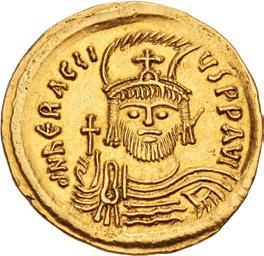


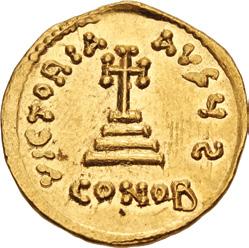
953. Heraclius. 610-641. AV Solidus (21.5mm, 4.45 g, 6h). Constantinople mint, 5th officina. Struck 610-613. Draped and cuirassed facing bust, wearing plumed helmet, holding cross / Cross potent set on three steps; Є//CONOB. DOC 3b; MIB 5; SB 731. Lightly toned with some luster, small die break, thin scrape on reverse, light scratches and marks, light deposits. Good VF. ($500)
954. Heraclius, with Heraclius Constantine. 610-641. AV Solidus (20mm, 4.45 g, 6h). Constantinople mint, 6th officina. Struck 629-631. Crowned facing busts of Heraclius and Heraclius Constantine, both wearing chlamys; cross above / Cross potent set on three steps; S(retrograde)//CONOB. DOC (26f) var. (officina not retrograde); MIB 29; SB 749. Lightly toned and lustrous, trace die rust, minor area of weakness, minor marks. EF. Two wonderfully struck portraits. ($500)
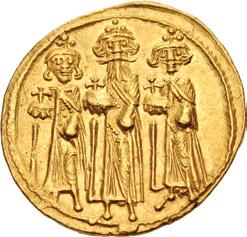
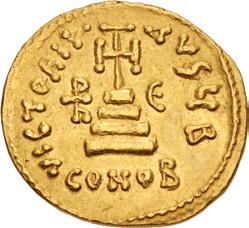

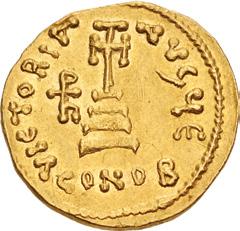
955. Heraclius, with Heraclius Constantine and Heraclonas. 610-641. AV Solidus (20mm, 4.42 g, 6h). Constantinople mint, 2nd officina. Struck circa 639-641. Heraclonas, Heraclius, and Heraclius Constantine standing facing, each wearing crown and chlamys and holding globus cruciger / Cross potent set on three steps;â to left; Є to right; B//CONOB. DOC (44b); MIB 53 (Heraclonas); SB 770. Toned, trace die rust, minor marks. Near EF. ($500)
956. Heraclius, with Heraclius Constantine and Heraclonas. 610-641. AV Solidus (19.5mm, 4.46 g, 6h). Constantinople mint, 5th officina. Struck circa 639-641. Heraclonas, Heraclius, and Heraclius Constantine standing facing, each wearing crown and chlamys and holding globus cruciger / Cross potent set on three steps; â to left; Є//CONOB. DOC 43d; MIB 50; SB 769. Toned with some luster, a couple of thin scrapes on reverse, a few minor marks at edge. EF. ($500)
Wonderful Eastern Mint Solidus
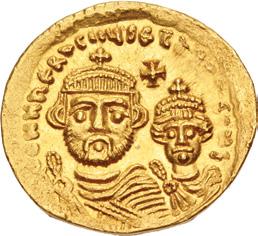


957. Heraclius, with Heraclius Constantine. 610-641. AV Solidus (21.5mm, 4.46 g, 6h). Uncertain eastern mint. Struck 613-619. Crowned, draped, and cuirassed facing busts of Heraclius and Heraclius Constantine; cross above / Cross potent set on three steps; IΠ//CONOB. Cf. DOC 187-8 (for series; Alexandria); MIB 77 (Cyprus?; or eastern military mint); Bendall, Jerusalem, Type 4, 16 (uncertain eastern military mint?); SB 852 (Jerusalem). Toned with some luster, trace die rust, light edge filing, light scratches. EF. A lovely specimen from the eastern mint. Outstanding portraits. ($500)
Extremely Rare Solidus of Heraclius Constantine
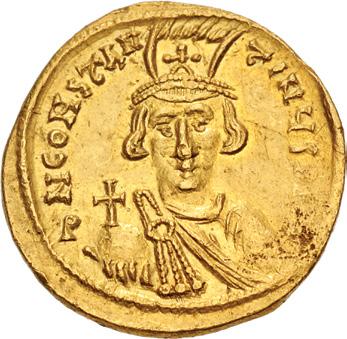
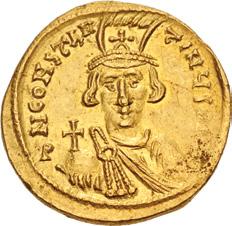

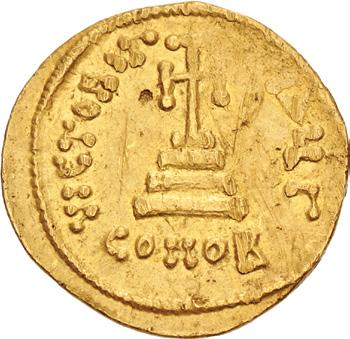
958. Heraclius Constantine. 641. AV Solidus (19mm, 4.35 g, 7h). Constantinople mint, 3rd officina. Struck 11 January-20 April. Crowned facing bust, wearing chlamys and plumed helmet, holding globus cruciger / Cross potent set on three steps; Γ// CONOB. DOC 1; MIB 1 (Constans II); SB 932. Lightly toned, clipped, minor spots of roughness, flan flaw, scrapes, scratches, marks, light hairlines. Good VF. Extremely rare, only three examples known in this officina. ($5000)
Ex Christopher Connell Collection (Triton VII, 12 January 2004), lot 1100.
The coinage of Heraclius Constantine from his very brief reign as senior augustus is extremely rare. There are only three specimens of this issue in CoinArchives, with only one other in this officina. 953 954 955 956
253

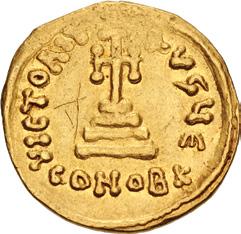
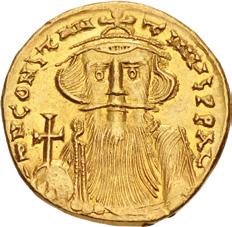
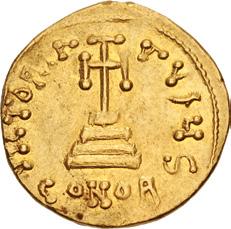
959. Constans II. 641-668. AV Solidus (19mm, 4.39 g, 6h). Constantinople mint, 5th officina. Struck 642-647. Crowned facing bust, wearing chlamys, holding globus cruciger / Cross potent set on three steps; Є//CONOBK. DOC (2b) (Heraclonas); MIB 4; SB 937. Lightly toned, clipped, graffiti, trace die rust, minor deposits. VF. ($500)
960. Constans II. 641-668. AV Solidus (18.5mm, 4.37 g, 6h). Constantinople mint, 6th officina. Struck 651-654. Crowned and draped facing bust, wearing long beard and mustache, holding globus cruciger / Cross potent set on three steps; S//CONOB. DOC 19f; MIB 23; SB 956. Toned with some luster, obverse die rust, area of edge filing, a couple of edge marks, minor marks and faint hairline scratches. Near EF. ($500)
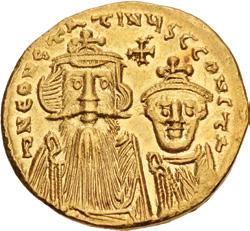
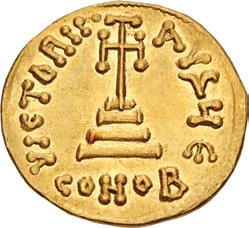
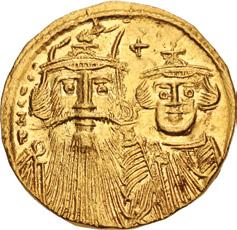

961. Constans II, with Constantine IV. 641-668. AV Solidus (20mm, 4.36 g, 6h). Constantinople mint, 5th officina. Struck 654-659. Crowned facing busts of Constans and Constantine, both wearing chlamys; cross above / Cross potent set on three steps; Є//CONOB. DOC (25e); MIB 26; SB 959. Toned with some luster, trace die rust, light edge filing, hairlines. Near EF. ($500)
962. Constans II, with Constantine IV, Heraclius, and Tiberius. 641-668. AV Solidus (19.5mm, 4.35 g, 6h). Constantinople mint, 1st officina. Struck circa 661-circa 663. Crowned facing busts of Constans, with long beard and mustache, wearing plumed helmet and chlamys, and Constantine, beardless, wearing chlamys; cross above / Cross potent set on three steps flanked by Heraclius and Tiberius, both wearing chlamys and holding globus cruciger; A//CONOB. DOC 30a; MIB 31; SB 964. Some luster, minor obverse die rust and breaks, edge filing. EF. ($500)
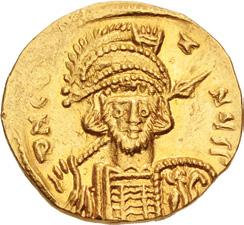
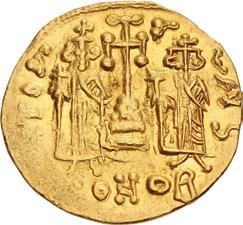
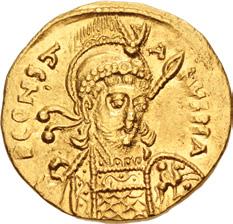
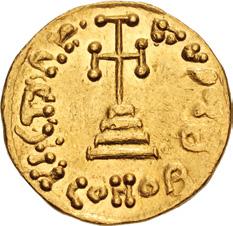
963. Constantine IV Pogonatus, with Heraclius and Tiberius. 668-685. AV Solidus (19.5mm, 4.42 g, 6h). Constantinople mint, 6th officina. Struck 674-681. Helmeted and cuirassed bust facing slightly right, holding spear over shoulder, shield on left shoulder / Cross potent set on three steps, flanked by crowned facing figures of Heraclius and Tiberius, both wearing chlamys and holding globus cruciger; S//CONOB. DOC (10a); MIB 7a; SB 1156. Lightly toned with some luster. Good VF. ($500)
964. Constantine IV Pogonatus. 668-685. AV Solidus (18.5mm, 4.42 g, 6h). Constantinople mint, 9th officina. Struck 681-685. Helmeted and cuirassed bust facing slightly right, holding spear over shoulder, shield on left shoulder / Cross potent set on three steps; Θ//CONOB. DOC 14c; MIB 10; SB 1157. Lightly toned with some luster, doubling on reverse. Near EF. ($500)
Ex Triton VI (14 January 2003), lot 1201.

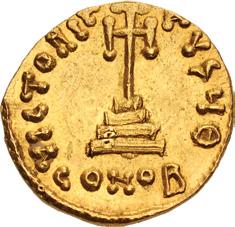
965. Justinian II. First reign, 685-695. AV Solidus (19mm, 4.44 g, 7h). Constantinople mint, 9th officina. Struck 685687. Crowned facing bust with slight beard, wearing chlamys, holding globus cruciger / Cross potent set on three steps; Θ// CONOB. DOC 4 var. (unlisted officina); MIB 4; SB 1245. Lightly toned, obverse die rust and breaks, marks and scratches, light deposits. Good VF. ($1000)
254
959
960
961
962
963
964
First Christ Portrait Coin: A Turning Point in Byzantine Coinage
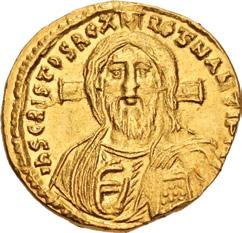
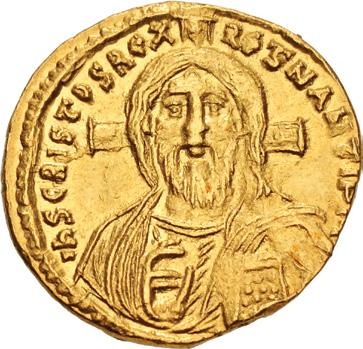

966. Justinian II. First reign, 685-695. AV Solidus (19.5mm, 4.45 g, 6h). Constantinople mint, 1st officina. Struck 692695. Nimbate facing bust of Christ Pantokrator, raising hand in benediction and holding Gospels / Justinian standing facing, wearing crown and loros, holding cross potent set on two steps and akakia; A//CONOP. DOC 7a; MIB 8a; SB 1248. Toned with some luster, light scrapes on reverse, edge marks. Good VF. ($1500)
The portrait of Christ that appears on this solidus issue marks the first representation of Christ on a coin. The Council in Trullo or the Quinisex Council was held during the reign of Justinian II in Constantinople following the Fifth and Sixth Ecumenical Councils. The assembly was called partly in order to address diverging practices in the east and west and to set church policy explicitly in written canons in order to discipline those who continued to engage in contrary practices. One of the canons set during the council concerned appropriate portrayals of Christ. Canon 82 cites 1st Corinthians 13:10 and makes use of similar language in Hebrews 10:1 to specify that “we decree that the figure in human form of the Lamb who takes away the sin of the world, Christ our God, be henceforth exhibited in images” (Quinisex Council, Canon 82). The text goes on to specify that Christ as a man ought be used in icons and visual depictions rather than the Agnes Dei. That same year, this issue of solidi was released into circulation by Justinian. The Council was very poorly received in the West and even denounced by some western thinkers. This monumental decision, however, greatly shaped the future of Byzantine coinage and concurrently stood in sharp contrast to the emergent Umayyad Caliphate’s contemporary practice of avoiding depicting religious figures on coinage.
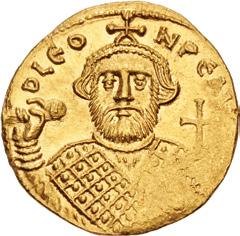
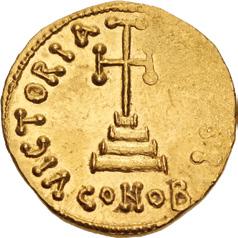
967. Leontius. 695-698. AV Solidus (19.5mm, 4.44 g, 6h). Constantinople mint, 10th officina. Crowned facing bust, wearing loros, holding akakia and globus cruciger / Cross potent set on three steps; I//CONOB. DOC (1i); MIB 1; SB 1330. Lightly toned with some luster, a couple areas of weakness, minor marks and light hairlines. Near EF. ($750)
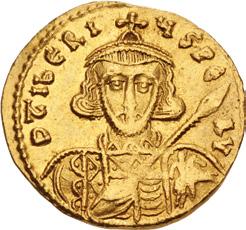
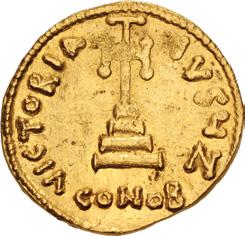
968. Tiberius III (Apsimar). 698-705. AV Solidus (20mm, 4.46 g, 6h). Constantinople mint, 7th officina. Crowned and cuirassed facing bust, holding transverse spear and shield on left shoulder / Cross potent set on three steps; Z//CONOB. DOC 1f; MIB 1; SB 1360. Lightly toned with some luster, slightly wavy flan, minor marks and light scratches, a few minor marks at edge. Good VF. ($500)
End of Session 3
255
Session 4 – Wednesday, May 29, 2024 — 2 PM

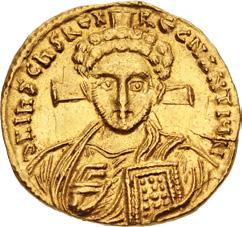
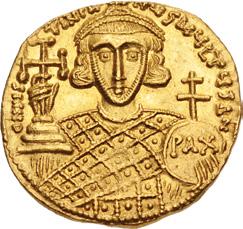
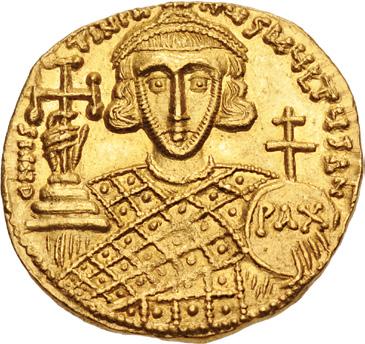
969. Justinian II. Second reign, 705-711. AV Solidus (19.5mm, 4.43 g, 6h). Constantinople mint. Struck 705. Nimbate facing bust of Christ Pantokrator, raising hand in benediction and holding Gospels / Crowned facing bust of Justinian, wearing loros, holding cross potent set on three steps and patriarchal globus cruciger inscribed PAX. DOC 1; MIB 1; SB 1413. Lustrous, faint rotated double strike on obverse, some faint hairlines, trace deposits. EF. An outstandingly bold strike from detailed dies. ($2000)
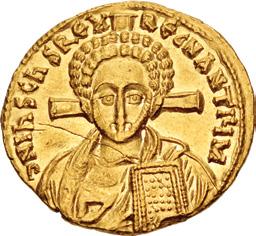

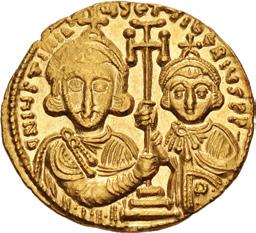
970. Justinian II, with Tiberius. Second reign, 705-711. AV Solidus (20.5mm, 4.45 g, 6h). Constantinople mint. Struck 705-711. Nimbate facing bust of Christ Pantokrator, raising hand in benediction and holding Gospels / Crowned facing busts of Justinian, and Tiberius, both wearing chlamys, holding between them cross potent set on two steps. DOC 2a; MIB 2a; SB 1414. Lustrous, obverse flan flaw, minor spot of weakness, hairlines. EF. ($2000)
Ex Leu 77 (11 May 2000), lot 946 (part of).
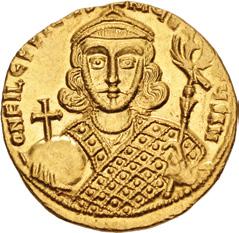


971. Philippicus (Bardanes). 711-713. AV Solidus (19mm, 4.50 g, 6h). Constantinople mint, uncertain (1st or 3rd) officina. Crowned facing bust, wearing loros, holding globus cruciger and eagle-tipped scepter / Cross potent set on three steps; [...]//CONOB. DOC 1; MIB 1; SB 1447. Lustrous, struck slightly off center, light scratches, hairlines on reverse. EF. A wonderful portrait. ($1500)
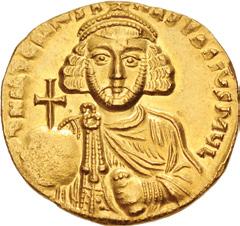
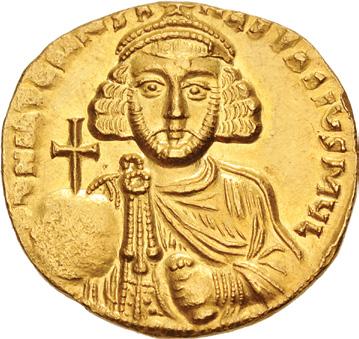
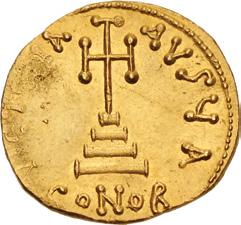
972. Anastasius II Artemius. 713-715. AV Solidus (19.5mm, 4.44 g, 6h). Constantinople mint, 1st officina. Crowned facing bust, wearing chlamys, holding globus cruciger and akakia / Cross potent set on three steps; A//CONOB. DOC 2a; MIB 2; Füeg 2.A.1; SB 1463. Toned with some luster, metal flaw on reverse, hairlines. EF. An excellent portrait. ($1500)
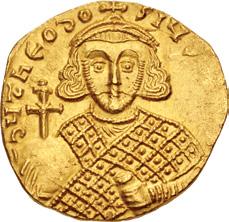

973. Theodosius III of Adramytium. 715-717. AV Solidus (18.5mm, 4.35 g, 6h). Constantinople mint, 7th officina. Crowned facing bust, wearing loros, holding patriarchal globus cruciger hand and akakia / Cross potent set on three steps; Z//CONOB. DOC (1c); MIB 1; Füeg 1.A.7; SB 1487. Lightly toned, clipped, marks and scratches. Near EF. Very rare in this officina. ($1500)
256

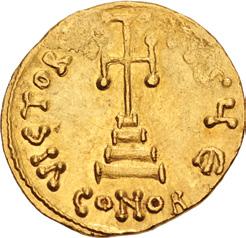
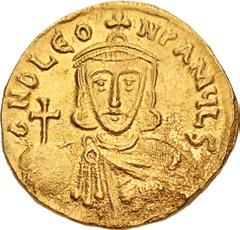

974. Leo III the “Isaurian”. 717-741. AV Solidus (19.5mm, 4.47 g, 6h). Constantinople mint, 5th officina. Struck 717720. Crowned facing bust, wearing chlamys, holding globus cruciger and akakia / Cross potent set on three steps; Є//CONOB. DOC 1c; MIB 1; Füeg 1.A.5 (same obv. die as 1.A.1 example); SB 1502. Toned with some luster, obverse slightly off center, area of roughness on reverse, light scratches and hairlines, minor deposits. Near EF ($750)
Ex Leu 91 (10 May 2004), lot 870.
975. Leo III the “Isaurian”, with Constantine V. 717-741. AV Solidus (19.5mm, 4.45 g, 6h). Constantinople mint. Struck circa 737-741. Crowned facing bust of Leo, wearing chlamys, holding globus cruciger and akakia / Crowned facing bust of Constantine, wearing chlamys, holding globus cruciger and akakia; Θ at end of legend. DOC 7d var. (rev. legend); Füeg 7.F.3 (same obv. die); SB 1504. Lightly toned, obverse die rust, a few light scratches and marks. Near EF. ($500)
Very Rare Solidus of the Usurper Artavasdus
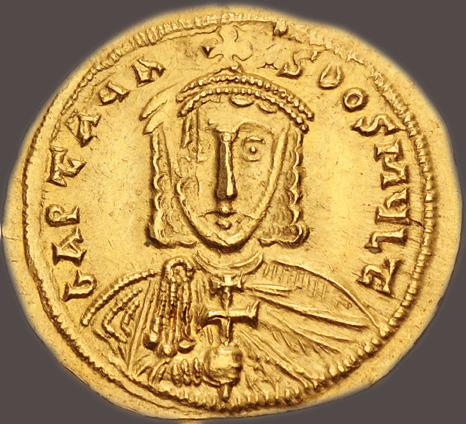


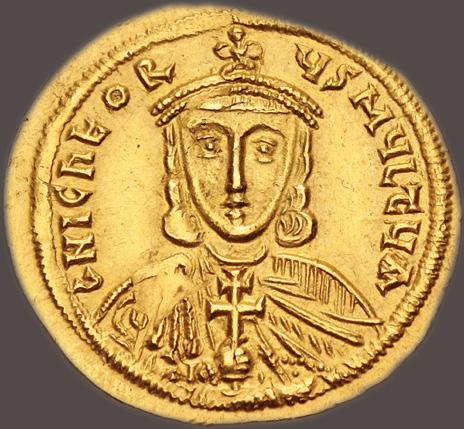
976. Artavasdus, with Nicephorus. 741/2-743. AV Solidus (21.5mm, 4.42 g, 6h). Constantinople mint. Struck 742/743. Crowned facing bust of Artavasdus, wearing chlamys, holding patriarchal cross / Crowned facing bust of Nicephorus, wearing chlamys, holding patriarchal cross; A at end of legend. DOC 2a; Füeg 2.A; SB 1542. Toned, slight rotated double strike on obverse, spot of weakness, some light hairline scratches. Near EF. Very rare. ($20,000)
Ex Numismatica Ars Classica 24 (5 December 2002), lot 426; William J. Conte Collection (Baldwin’s 2, 5 October 1994), lot 85; Numismatic Fine Arts XVIII (1 April 1987), lot 887.
Artavasdus was first appointed strategos of the Armenian theme by emperor Anastasius II. After Theodosius III usurped Anastasius, Artavasdus sided with and aided Leo III in his later revolt against Theodosius. In exchange for his loyalty, Artavasdus was granted the title kouropalates and given Leo’s daughter Anna in marriage. Upon the death of Leo III in 741, Artavasdus’ loyalty did not extend to Leo’s son and successor Constantine V. One year into Constantine’s reign, Artavasdus successfully usurped the throne for himself in July 742 after successfully ambushing and defeating Constantine’s forces as they set out to campaign against the Umayyads. Following the disastrous battle, Constantine fled into exile at Amorium where he began rallying support for his cause against Artavasdus. In contrast to Leo and Constantine, Artavasdus was an iconodule who restored the adoration of icons during his brief reign in opposition to the policies taken by Leo III. The controversy had been brewing since the decisions made by the Quinisex Council in 692 under emperor Justinian II, but the issue began to come to the forefront of Byzantine politics at this time. Unfortunately for the iconodules, Constantine and Artavasdus would meet in battle again, this time at Sardes, where Constantine emerged victorious and Artavasdus’ brief reign came to an end. Upon retaking the throne, Constantine promptly reinstated his father’s iconoclast policies and had Artavasdus and his son Nicephorus mutilated and exiled.
Illustrated in Füeg and Berk
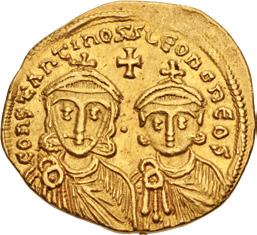
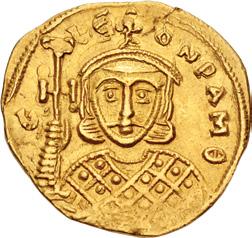
977. Constantine V Copronymus, with Leo IV and Leo III. 741-775. AV Solidus (21mm, 4.42 g, 6h). Constantinople mint. Struck 751-circa 757. Crowned facing busts of Constantine V and Leo IV, both wearing chlamys; cross above, • between / Crowned facing bust of Leo III, wearing loros, holding cross potent; Θ at end of legend. DOC 2c var. (rev. legend); Füeg 4.A.3 (this coin illustrated); SB 1551; Berk, Roman 228 (this coin). Toned, some doubling, spot of weakness, minor dig at edge. Good VF. ($500)
Ex “An Important Private Collection of Byzantine Coins” (Sotheby’s New York, 2 November 1998), lot 407.
257
974 975
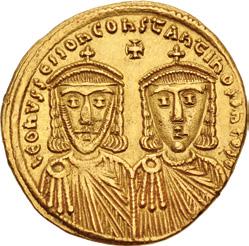
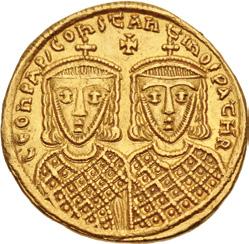
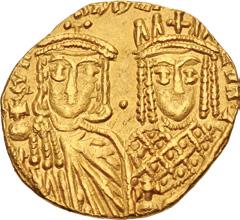
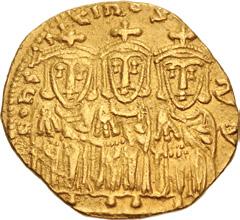
978. Leo IV the Khazar, with Constantine VI, Leo III, and Constantine V. 775-780. AV Solidus (20mm, 4.40 g, 6h). Constantinople mint. Struck 776-778. Crowned facing busts of Leo IV and Constantine VI, both wearing chlamys; cross above; Θ at end of legend / Crowned facing busts of Leo III and Constantine V, both wearing loros; cross above. DOC 1b; Füeg 2.A.1; SB 1583. Toned, a few minor marks, trace deposits. Near EF. A very nice example. ($750)
Ex UBS 52 (11 September 2001), lot 336 (hammer CHF 2400).
979. Constantine VI & Irene, with Leo III, Constantine V, and Leo IV. 780-797. AV Solidus (19.5mm, 4.30 g, 6h). Constantinople mint. Struck 780-790. Crowned facing busts of Constantine VI, wearing chlamys and holding globus cruciger, and Irene, wearing loros, holding globus cruciger and cruciform scepter; • between / Constantine V, Leo III, and Leo IV seated facing, each wearing crown and chlamys. DOC 1; Füeg Ir.2.18/C.2 (obv./rev.); SB 1593. Lightly toned, lightly clipped. VF. A popular issue. ($750)
Ex Peus 376 (29 October 2003), lot 1165.
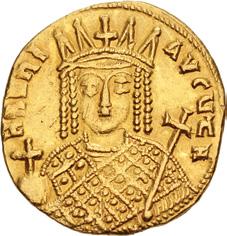

980. Constantine VI & Irene. 780-797. AV Solidus (19.5mm, 4.53 g, 7h). Constantinople mint. Struck 792-797. Crowned facing bust of Irene, wearing loros, holding globus cruciger and cruciform scepter / Crowned facing bust of Constantine, wearing chlamys, holding globus cruciger and akakia. DOC 3c.2 (same dies); Füeg 5.D; SB 1594. Toned, minor digs and marks. VF. ($1500)
Ex Numismatica Ars Classica 24 (5 December 2002), lot 431; N. K. Collection (Bourgey, 27 October 1992), lot 435.
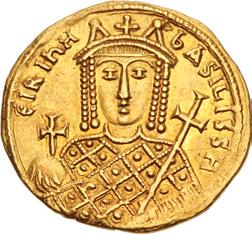


981. Irene. 797-802. AV Solidus (20.5mm, 4.39 g, 6h). Constantinople mint. Struck 797-802. Crowned facing bust of Irene, wearing loros, holding globus cruciger and cruciform scepter / Crowned facing bust of Irene, wearing loros, holding globus cruciger and cruciform scepter; at end of legend. DOC 1a.2; Füeg 2.B.1; SB 1599. Toned, minor doubling on obverse, slight rotated double strike on reverse. Near EF. An attractive coin in hand. ($1500)
Ex Leu 86 (5 May 2003), lot 1120.

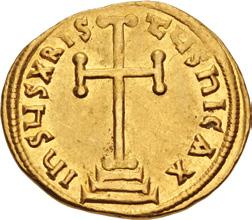
982. Nicephorus I. 802-811. AV Solidus (20.5mm, 4.40 g, 6h). Constantinople mint. Struck 802-803. Crowned facing bust, wearing chlamys, holding cross potent and akakia / Cross potent set upon three steps; X at end of legend. DOC 1b; Füeg 1.B; SB 1603. Toned with some luster, a few light scratches. Good VF. ($500)
258
978
979
Nicephorus at Pliska
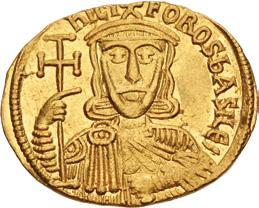
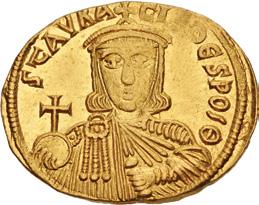
983. Nicephorus I, with Stauracius. 802-811. AV Solidus (21mm, 4.46 g, 6h). Constantinople mint. Struck 803-811. Crowned facing bust of Nicephorus, wearing chlamys, holding cross potent and akakia / Crowned facing bust of Stauracius, wearing chlamys, holding globus cruciger and akakia; Θ at end of legend. DOC 2b.3; Füeg 2.A.1; SB 1604. Lightly toned with some luster. Good VF. ($750)
Nicephorus’ career came to an abrupt end at the battle of Pliska on 26 July 811 during his Bulgarian campaign. The initial campaign was a rousing success, and the battle came immediately after the sack of Pliska (the Bulgarian capital) by Byzantine forces. The Bulgarian Khan Krum attempted to sue for peace after the disastrous loss of his capital city, but Nicephorus, confident from his great victory, refused and planned to retake all of Bulgaria. While the Byzantines were plundering the city, Krum blocked their exit from the valley with traps and fortifications including a wooden palisade. Nicephorus was unwilling to assault the newly-constructed battlements and elected to set up camp. This proved unwise. The Bulgarians spent the next few days across in their camp rattling their shields in an effort to intimidate the Byzantine forces. By the time the two armies met in battle, the Byzantine army’s morale had evaporated. Despite the Byzantines possessing superior numbers, the army was completely routed by the Bulgarian Khanate. Very few members of the approximately 30,000 strong Byzantine army escaped the slaughter. Emperor Nicephorus himself was slain and his son and successor Stauracius received a serious wound to his spine which left him partially paralyzed. Theophanes the Confessor summarized the aftermath in his Chronographia as follows: “Among the victims were ... the patrician Romanus, who was strategos of the Anatolics, and many protospatharioi and spatharioi, the commanders of the tagmata, including the domestic of the excubitors and the drungarios of the Imperial Watch, the strategos of Thrace, many officers of the themata, and an infinite number of soldiers so that the flower of Christendom was destroyed ... May not Christians experience another time the ugly events of that day for which no lamentation is adequate” (Theophanes, 491).
Nicephorus’ body was not recovered and Theophanes records that the Khan Krum “cut off the head of Nikephoros and for several days hung it on a pole so as to exhibit it to the tribes that came before him ... After that, he bared the skull, reveted it on the outside with silver and, in his pride, made the chieftains of the Sklavinians drink from it” (Theophanes, 491-2). This follows the ancient Skythian custom recorded by Herodotus in The Histories Book 4.65. Thus ended Nicephorus and Stauracius.
The Short Reign of Michael I

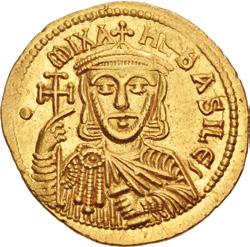
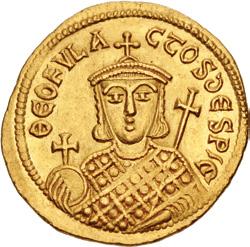
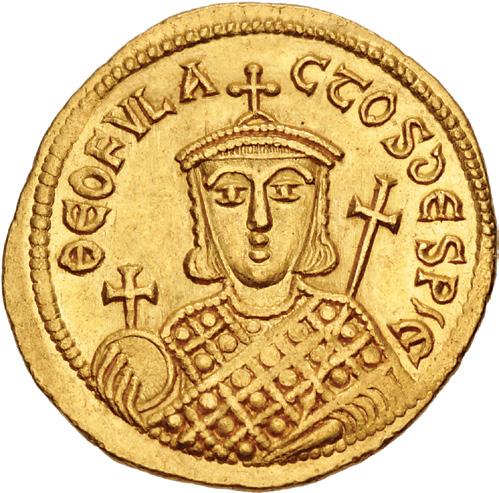
984. Michael I Rhangabe, with Theophylactus. 811-813. AV Solidus (20.5mm, 4.41 g, 6h). Constantinople mint. Crowned facing bust of Michael, wearing chlamys, holding cross potent and akakia / Crowned facing bust of Theophylactus, wearing loros, holding globus cruciger and cruciform scepter; Є at end of legend. DOC 1b; Füeg 1.A; SB 1615. Toned with some luster, a couple minor die breaks, light scratch under tone. EF. Rare. ($7500)
Ex Dr. Anton C. R. Dreesmann Collection (Part II, Spink 144, 13 July 2000), lot 606; Numismatic Fine Arts IV (24 March 1977), lot 805; Leu 15 (4 May 1976), lot 488.
Michael I Rhangabe was one of the few nobles to survive the disaster at Pliska. Theophanes records: “The caiopalates Michael, who escaped unharmed, received many entreaties from his friends that he should be proclaimed emperor, but did not consent because of his oath to Nikephoros and Staurakios” (Theophanes, 492). However, due to Stauracius being unfit to rule given the wound he received at Pliska, Michael succeeded his brother-in-law on 2 October 811. Unfortunately for Michael and his son Theophylactus, like their predecessors Nicephorus and Stauracius, the two emperors also suffered a disastrous defeat at the hands of the Bulgarian Khan Krum, this time at the battle of Versinikia which occurred less than two years into their reign. Following the disaster, the army proclaimed the strategos of the Anatolian theme, Leo as emperor. Michael quickly abdicated and retired to a monastery.
During his short reign, Michael notably reversed the iconoclast policies of his predecessor and recognized Charlemagne as emperor of the West in exchange for the return of Venice. The Venetians, however, simply ignored the edict, which Michael was unable to enforce. Michael’s coinage in all metals is quite rare.
259
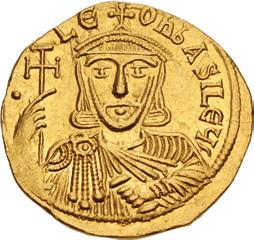

985. Leo V the Armenian, with Constantine. 813-820. AV Solidus (20.5mm, 4.43 g, 6h). Constantinople mint. Crowned facing bust of Leo, wearing chlamys, holding cross potent and akakia / Crowned facing bust of Constantine, wearing chlamys, holding globus cruciger and akakia; Є at end of legend. DOC 2a; Füeg 2.B.1; SB 1627. Toned with some luster, spot of edge filing, a few faint scratches. Near EF. ($1000)
Ex Leu 91 (10 May 2004), lot 882.



986. Michael II the Amorian, with Theophilus. 820-829. AV Solidus (21.5mm, 4.35 g, 6h). Constantinople mint. Struck 821-829. Crowned facing bust of Michael, wearing chlamys, holding cross potent and akakia / Crowned facing bust of Theophilus, wearing loros, holding globus cruciger and cruciform scepter; X at end of legend. DOC (5b); Füeg 4.A.2; SB 1640. Toned with some luster, minor marks at edge. Near EF. Rare. ($2000)
Ex Triton IV (5 December 2000), lot 802.
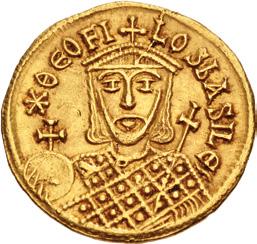
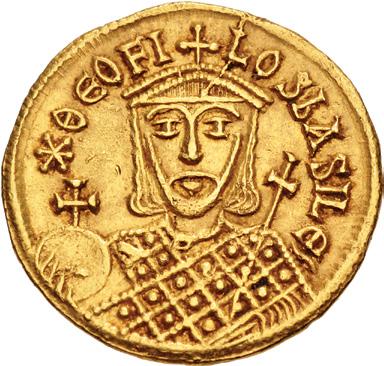

987. Theophilus. 829-842. AV Solidus (20.5mm, 4.41 g, 6h). Constantinople mint. Struck 829-830/1. Crowned facing bust, wearing loros, holding globus cruciger and cruciform scepter / Patriarchal cross potent set on three steps; *Є at end of legend. DOC 1a; Füeg 1.A.1; SB 1655. Toned, a few die breaks, marks, a few light scratches, minor edge marks, light deposits. Good VF. Rare. ($3000)
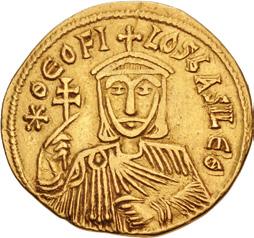
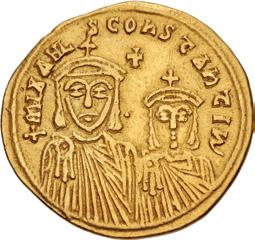
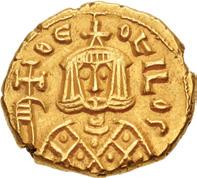

988. Theophilus, with Constantine and Michael III. 829-842. AV Solidus (20.5mm, 4.31 g, 6h). Constantinople mint. Struck 830/1-840. Crowned facing bust of Theophilus, wearing chlamys, holding patriarchal cross and akakia; * at beginning of legend, Θ at end / Crowned facing busts of Michael and Constantine, both wearing chlamys; cross above. DOC 3d; Füeg 3.H.1.y.6; SB 1653. Toned, light scratches, hairlines on reverse, minor deposits. VF. ($500)
989. Theophilus. 829-842. AV Solidus (15.5mm, 3.85 g, 6h). Syracuse mint. Struck 831-842. Crowned facing bust of Theophilus, wearing loros, holding cross potent / Crowned facing bust of Theophilus, wearing chlamys, holding globus cruciger. DOC 24; Anastasi 530c; SB 1670. Toned. Near EF. ($500)
Purchased from Numisart, October 2001. 988 989
260
Three Rare Solidi of Michael III
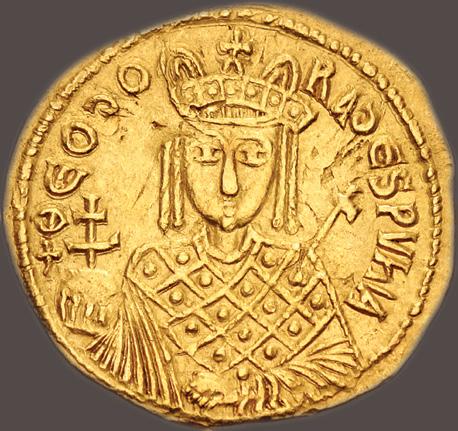
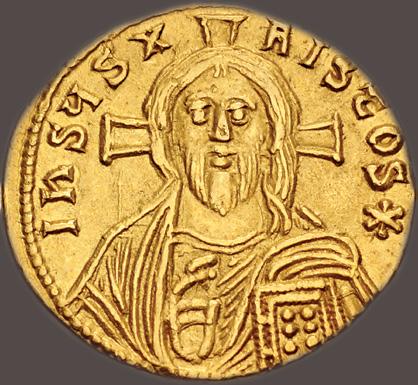

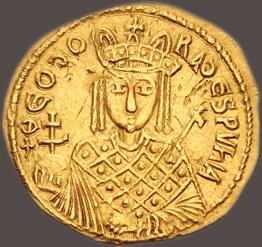
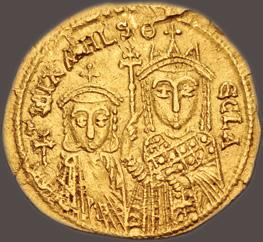






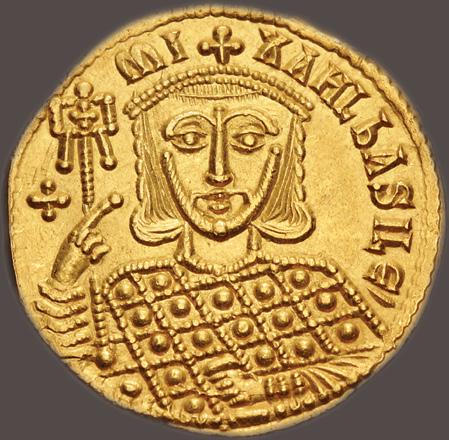
990. Michael III “the Drunkard”, with Theodora and Thecla. 842-867. AV Solidus (21.5mm, 4.40 g, 6h). Constantinople mint. Struck 842-circa 843. Crowned facing bust of Theodora, wearing loros, holding patriarchal globus cruciger and cruciform scepter / Crowned facing half-length figure of Michael, wearing chlamys, and holding globus cruciger, and crowned half-length figure of Thecla, to right, wearing loros, and holding patriarchal cross and akakia. DOC 1d; Füeg 1.B.2; SB 1686. Toned, slightly wavy flan, minor metal flaws, some die breaks and spots of die rust on reverse, minor dig, a few light scratches. VF. Very rare. ($7500)
Ex Malcolm W. Heckman Collection (Triton VIII, 11 January 2005), lot 1418. Michael III was only two years old when his father Theophilus died in 842. His mother Theodora as regent was the effective ruler of the empire, and the first coinage of his reign gives her prominence on the obverse. Michael was generally kept in the background, even overshadowed on the coins by his sister Thecla. With Michael in isolation, Theodora maintained the empire with the assistance of her brothers, Bardas and Petronas, along with Theoktistos, the logothete of the dromos. During Theodora’s regency, she brought an end the second iconoclastic controversy and demonstrated herself an effective and capable ruler. In a typical example of Byzantine family intrigue, Theoktistos moved against Bardas, who in turn conspired with the young emperor in 856 to remove his mother’s regency along with Theoktistos. Theoktistos was killed and Theodora removed from power and confined to a convent. The conspiracy continued and Bardas was murdered in 865 by Basil, an ambitious court official who befriended Michael and soon became co-emperor. He proceeded to promptly eliminate his benefactor shortly thereafter.
Although Michael was given the unflattering epithet “the Drunkard,” this smear on his name was perpetuated by Basil to justify his seizure of power. Michael appears to have been a conscientious ruler and capable military leader, his only and fatal failing being that he was too easily swayed by his unscrupulous associates.
991. Michael III “the Drunkard”, with Theodora. 842-867. AV Solidus (19mm, 4.40 g, 6h). Constantinople mint. Struck circa 843-856. Nimbate facing bust of Christ Pantokrator, raising hand in benediction and holding Gospels / Crowned facing half-length figures of Michael, wearing chlamys, and Theodora, wearing loros; cross above. DOC 2; Füeg 2.B; SB 1687. Toned. Good VF. Very rare. ($5000)
Ex Dr. Anton C. R. Dreesmann Collection (Part II, Spink 144, 13 July 2000), lot 631; Münzen und Medaillen AG 52 (19 June 1975), lot 860.
992. Michael III “the Drunkard”. 842-867. AV Solidus (20.5mm, 4.35 g, 6h). Constantinople mint. Struck 856-867. Nimbate facing bust of Christ Pantokrator, raising hand in benediction and holding Gospels / Crowned facing bust of Michael, wearing loros, holding labarum and akakia. DOC 3; Füeg 3.A; SB 1688. Toned, slightly clipped. EF. Rare. ($4000)
Ex Triton VIII (11 January 2005), lot 1419.
261
990
991
992
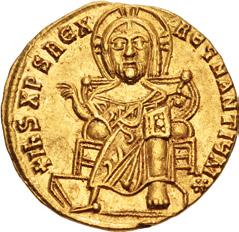

993. Basil I the Macedonian, with Constantine. 867-886. AV Solidus (19.5mm, 4.46 g, 6h). Constantinople mint. Struck 868-879. Christ Pantokrator enthroned facing on suppedion, nimbate, raising hand in benediction and holding Gospels / Crowned facing half-length figures of Basil, wearing loros, and Constantine, wearing chlamys, holding patriarchal cross between them. DOC 2b; Füeg 3.B; SB 1704. Toned with some luster. EF. A vibrant strike. ($500)
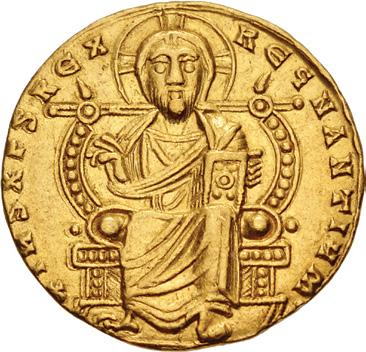
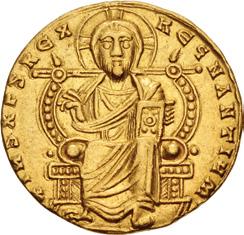
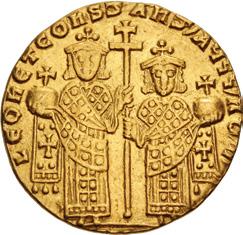
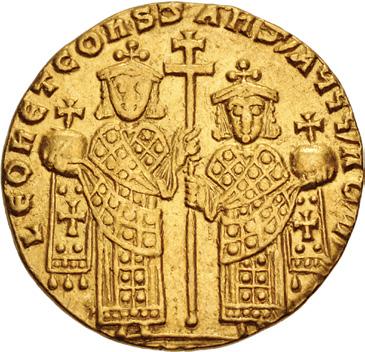
994. Leo VI the Wise, with Constantine VII. 886-912. AV Solidus (19.5mm, 4.33 g, 6h). Constantinople mint. Struck 908-912. Christ Pantokrator enthroned facing on suppedion, nimbate, raising hand in benediction and holding Gospels / Crowned facing figures of Leo and Constantine, both wearing loros decorated with a cross at end and holding globus cruciger, together holding patriarchal cross between them. DOC 2; Füeg 3.C.2 note; SB 1725. Toned, a couple of minor marks at edge. Good VF. ($1500)
Ex Gorny & Mosch 121 (10 March 2003), lot 540.
Very Rare Solidus of Alexander
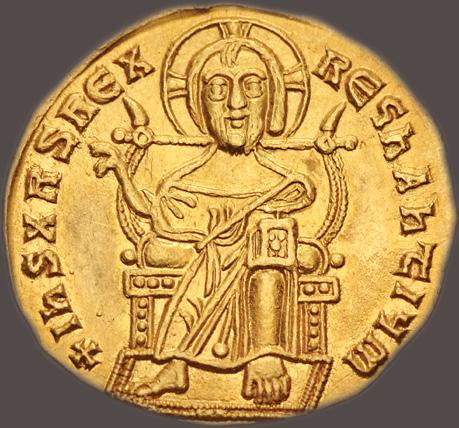
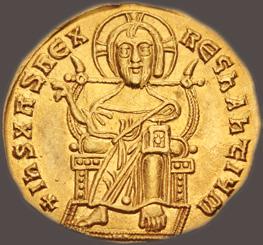

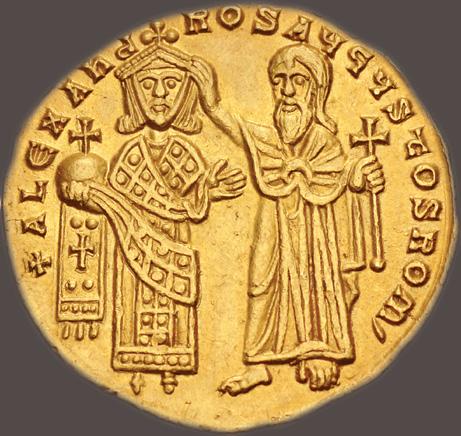
Ex Triton IV (5 December 2000), lot 828.
Alexander, the third son of Basil I, was co-emperor throughout his brother Leo VI’s reign, although he took no part in actual governing. Upon Leo’s death, he succeeded to the position of senior emperor, ruling alongside Leo VI’s young son Constantine VII. Contemporary sources are unanimous in proclaiming Alexander a self-indulgent drunkard, feckless and unfit to rule. In contrast to his brother Leo VI, deemed “the wise,” Alexander was anything but. He dismissed nearly all of Leo’s ministers and generals, whose diplomatic skills had kept the empire relatively stable and prosperous for the previous twenty-five years. He additionally broke a peace treaty with the Bulgarians by refusing to pay tribute upon his accession, which prompted a long and destructive war. Alexander also reportedly considered having his nephew (and prospective successor) Constantine castrated in order to end his line out of spite. Ultimately, Alexander was spared witnessing the consequences of his terrible decisions after he reportedly either contracted a stomach ailment or suffered internal bleeding from an injury during a ball game. He died after only a year and a month as senior ruler before he could do further damage to the empire. In his final act of disdain for his successor, Alexander set up a regency council on his deathbed to order to hamper the new ruler Constantine VII. Constantine’s mother Zoe was notably excluded from this first regency.
Despite Alexander’s notorious career as emperor, his very rare gold solidi are notable, however, for featuring a new reverse type for Byzantine coinage. This solidus features Saint Alexander, who is shown crowning the emperor on the reverse. This likely represents Alexander of Constantinople, the first archbishop of the city, who lived during the time of Constantine the Great. The reverse type of the emperor being crowned by a saint (often a namesake) would be adopted in future reigns. Additionally, this series of solidi was the first to feature a saint other than the Theotokos on Byzantine coinage.
262
995. Alexander. 912-913. AV Solidus (21.5mm, 4.35 g, 6h). Constantinople mint. Christ Pantokrator enthroned facing on suppedion, nimbate, raising hand in benediction and holding Gospels / Crowned facing figure of Alexander, wearing loros decorated with a cross at end and holding globus cruciger, being crowned by St. Alexander, to right, holding cross. DOC 2; Füeg 2.A; SB 1737. Toned, a couple light scratches. EF. Very rare. ($20,000)
The Long Reign of Constantine VII

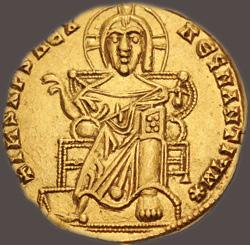
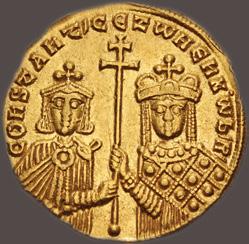
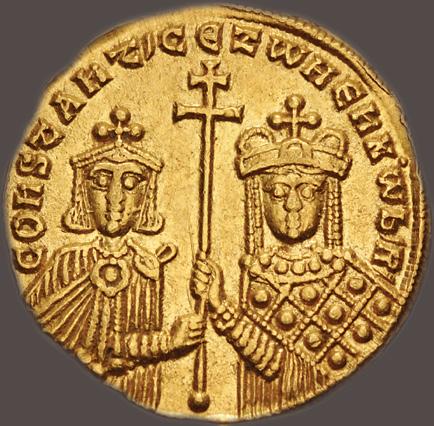
996. Constantine VII Porphyrogenitus, with Zoe. 913-959. AV Solidus (20mm, 4.38 g, 6h). Constantinople mint. Struck 914-919. Christ Pantokrator enthroned facing, nimbate, raising hand in benediction and holding Gospels / Crowned facing half-length figures of Constantine, wearing chlamys, and Zoe, wearing loros, holding patriarchal cross between them. DOC 2; Füeg 2; SB 1740. Toned, minor deposits. Good VF. ($15,000)
Ex Triton IV (5 December 2000), lot 829; Sotheby’s New York “An Important Private Collection of Byzantine Coins” (2 November 1998), lot 478; William Herbert Hunt Collection (Sotheby’s New York, 5 December 1990), lot 696; Leu 15 (4 May 1976), lot 504.
Constantine VII’s time as emperor had a very complex path to his eventual sole reign. Following the death of his uncle Alexander, Constantine began his reign under the regency of the Patriarch of Constantinople, Nicolas Mystikos. However, Nicolas’ regency was short-lived. After the Tsar of Bulgaria, Symeon, appeared outside Constantinople with a massive army, Nicolas capitulated to the Bulgarians’ demands and granted them numerous concessions. This lack of strength by Nicolas led to a palace revolt in which Nicolas’ regency was removed and replaced with that of Constantine’s mother Zoe Karbonopsina. This change in government led Symeon to invade the Byzantine empire and lay waste to numerous provinces. His destructive campaign was eventually stymied by the capable general Romanus Lecapenus. Upon Romanus’ initial victories, he assumed the regency from Zoe, whom he forced into a convent. Romanus additionally married his daughter Helena to Constantine. In December of 920, Romanus assumed the title of co-augustus and, though he did not depose Constantine, he kept all the power for himself. Romanus and Symeon continued to war against each other until Symeon’s death in 927. Symeon’s death seriously diminished the Bulgarians’ power, and Romanus was free to turn his attention towards matters of state.
Between 921 and 945, Romanus elevated three of his sons as co-augustus: Christopher, Stephen, and Constantine. All the while, the former senior augustus Constantine VII was completely sidelined for over thirty years (Romanus officially displaced Constantine as senior augustus around 921). However, matters eventually changed when Stephen and Constantine turned on their father and deposed him in December 944. This was precipitated by Romanus drafting a will in which he intended to leave Constantine VII as sole augusutus following his death. Constantine VII seized his chance and in turn successfully deposed Stephen and Constantine that following January. Finally, in the thirty-first year of his reign, Constantine VII was free of his domineering associates and became sole augustus. Later that year, he added his own son Romanus II as co-augustus. Constantine reigned for an additional fourteen years after he finally deposed the Lecapeni before dying in 959 after reigning for a total of forty-six years.
Ex Hunt Collection - Pedigreed to 1976
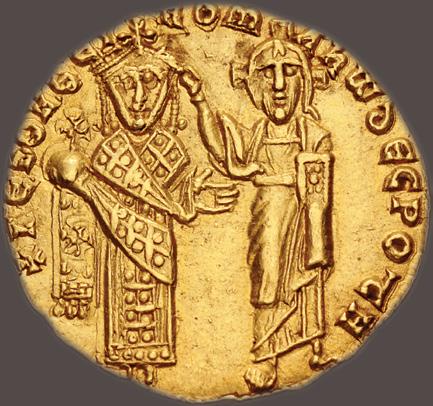



997. Constantine VII Porphyrogenitus, with Romanus I and Christopher. 913-959. AV Solidus (20mm, 4.35 g, 6h). Constantinople mint. Struck 921. Crowned facing figures of Romanus, wearing loros decorated with a cross at end, holding globus cruciger, and Christ, nimbate, crowning Romanus and holding Gospels / Crowned facing busts of Christopher, wearing loros, and Constantine, wearing chlamys, holding long patriarchal cross between them. DOC 5; Füeg 5; SB 1744. Toned, minor doubling on obverse, slightly clipped, some faint hairlines, minor deposits. Near EF. Very rare. ($10,000)
Ex Sincona 3 (25 October 2011), lot 3507; Numismatica Ars Classica 56 (8 October 2010), lot 714; Goldberg 53 (24 May 2009), lot 2265; Triton IV (5 December 2000), lot 830; “An Important Private Collection of Byzantine Coins” (Sotheby’s New York, 2 November 1998), lot 481; William Herbert Hunt Collection (Sotheby’s New York, 5 December 1990), lot 698; Leu 15 (4 May 1976), lot 508.
263


998. Constantine VII Porphyrogenitus, with Romanus I and Christopher. 913-959. AV Solidus (20mm, 4.34 g, 6h). Constantinople mint. Struck 921-931. Christ Pantokrator enthroned facing on suppedion, nimbate, raising hand in benediction and holding Gospels / Crowned facing busts of Romanus, wearing loros, and Christopher, wearing chlamys, holding long patriarchal cross between them. DOC 7; Füeg 7.B; SB 1745. Toned, graffito under tone, edge mark. Near EF. ($500)
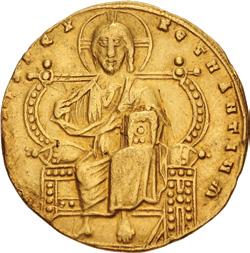

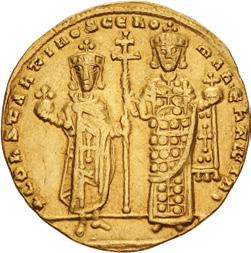
999. Constantine VII Porphyrogenitus, with Romanus I. 913-959. AV Solidus (20mm, 4.35 g, 6h). Constantinople mint. Struck 931-944. Christ Pantokrator enthroned facing on suppedion, nimbate, raising hand in benediction and holding Gospels / Constantine, wearing crown and chlamys decorated with cross, and Romanus, wearing crown and loros decorated with cross at end, standing facing on suppedion, both holding globus cruciger and patriarchal cross between them. DOC 10; Füeg 10.2.2; SB 1749 (Constantine VII and Romanus II). Toned, light scrape, light cleaning scratches, minor marks. Good VF. ($1500)
Very Rare Sole Reign Solidus

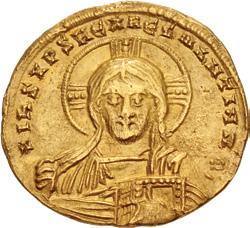
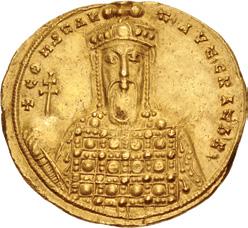
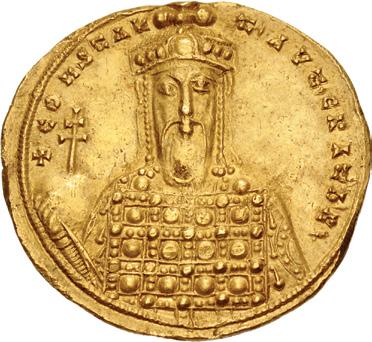
1000. Constantine VII Porphyrogenitus. 913-959. AV Solidus (20mm, 4.38 g, 6h). Constantinople mint. Struck JanuaryApril 945. Nimbate facing bust of Christ Pantokrator, raising hand in benediction and holding Gospels / Crowned facing bust of Constantine VII, wearing ornate jeweled loros, holding patriarchal globus cruciger. DOC 13b; Füeg 13.A.2.2; SB 1747. Lightly toned, minor edge marks. Good VF. Very rare. ($5000)
Ex Gorny & Mosch 125 (13 October 2003), lot 620.
The sole reign solidus was struck in the very brief period from January to April 945 when Constantine reigned without any associates after deposing his two domineering brothers-in-law on 27 January and before he added his son Romanus II as co-augustus on 6 April.
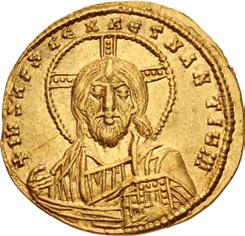
1001
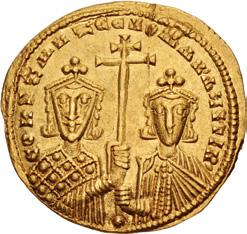
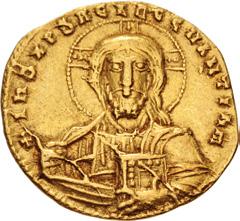
1002

1001. Constantine VII Porphyrogenitus, with Romanus II. 913-959. AV Solidus (19.5mm, 4.37 g, 6h). Constantinople mint. Struck 945-959. Nimbate facing bust of Christ Pantokrator, raising hand in benediction and holding Gospels; three pellets in each arm of nimbus / Crowned facing busts of Constantine, wearing loros, and Romanus, wearing chlamys, together holding patriarchal cross between them. DOC 15; Füeg 15.D; SB 1751. Toned, a few scratches mostly under tone. Good VF. ($500)
1002. Nicephorus II Phocas. 963-969. AV Histamenon Nomisma (19mm, 4.11 g, 6h). Constantinople mint. Nimbate facing bust of Christ Pantokrator, raising hand in benediction and holding Gospels / Facing half-length busts of the Theotokos and Nicephorus, wearing crown and loros, holding patriarchal cross between them. DOC 4; Füeg 3.A.3; SB 1778. Lightly toned, obverse die breaks, clipped, edge marks. Good VF. ($500)
264
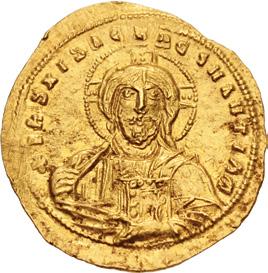
1003
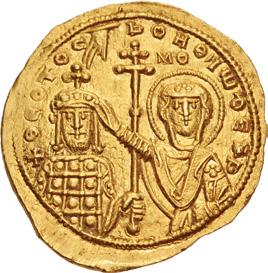

1004

1003. John I Zimisces. 969-976. AV Histamenon Nomisma (21.5mm, 4.37 g, 6h). Constantinople mint. Nimbate facing bust of Christ Pantokrator, raising hand in benediction and holding Gospels / Crowned facing half-length bust of John, holding long patriarchal cross and being crowned by the Theotokos to right; manus Dei to upper left. DOC 6a; Füeg 3.A.3; SB 1778. Toned, deposits. Near EF. ($750)
1004. Basil II Bulgaroktonos, with Constantine VIII. 976-1025. AV Histamenon Nomisma (21mm, 4.10 g, 6h). Constantinople mint. Struck 977-circa 989. Nimbate facing bust of Christ Pantokrator, raising hand in benediction and holding Gospels; pellet-in-annulet in each arm of nimbus cross / Crowned facing busts of Basil, wearing loros, and Constantine, wearing chlamys, holding patriarchal cross between them; small crossbar on shaft. DOC 2j.1-2; Füeg II 2.J; SB 1796. Toned, obverse metal flaw, edge filing. VF. ($500)
Illustrated in Berk
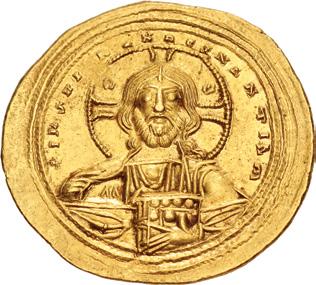
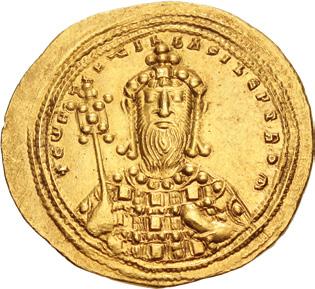
1005. Constantine VIII. 1025-1028. AV Histamenon Nomisma (25.5mm, 4.41 g, 6h). Constantinople mint. Nimbate facing bust of Christ Pantokrator, raising hand in benediction and holding Gospels; upturned crescents in upper two quarters of nimbus / Crowned facing bust of Constantine, wearing jeweled loros, holding labarum and akakia. DOC 1; Füeg II 1.A.6; SB 1815; Berk, Roman 292B (this coin). Toned, a few light scratches, minor deposits. EF. ($750)
Ex Jürgen K. Schmidt Collection (Triton V, 15 January 2002), lot 2302; “An Important Private Collection of Byzantine Coins” (Sotheby’s New York, 2 November 1998), lot 507.
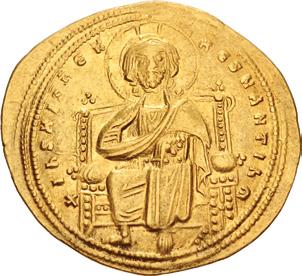

1006. Romanus III Argyrus. 1028-1034. AV Histamenon Nomisma (24.5mm, 4.39 g, 6h). Constantinople mint. Christ Pantokrator enthroned facing on suppedion, nimbate, raising hand in benediction and holding Gospels / Romanus, placing hand on chest and holding globus cruciger, standing facing, being crowned and blessed by the Theotokos, nimbate; four pellets in loros end; M Θ, both with macron above, in upper field. DOC 1d; Füeg II 1.D.4.y; SB 1819. Toned. Near EF. ($500)
Illustrated in Füeg
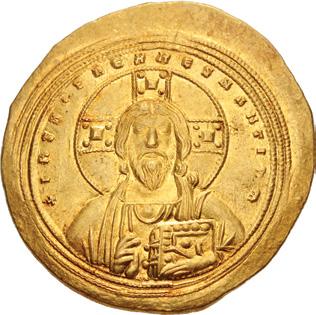
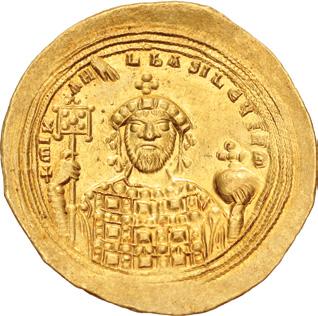
1007. Michael IV the Paphlagonian. 1034-1041. AV Histamenon Nomisma (25.5mm, 4.41 g, 6h). Constantinople mint. Nimbate facing bust of Christ Pantokrator, raising hand in benediction and holding Gospels / Crowned facing bust of Michael, wearing jeweled loros, holding labarum and globus cruciger, being crowned by manus Dei above. DOC 1d; Füeg II 1.C.1 (this coin illustrated); SB 1824. Attractively toned, a couple of minor scratches under tone. EF. ($1000)
Ex Jürgen K. Schmidt Collection (Triton V, 16 January 2002), lot 2305; Leu 65 (21 May 1996), lot 611.
265
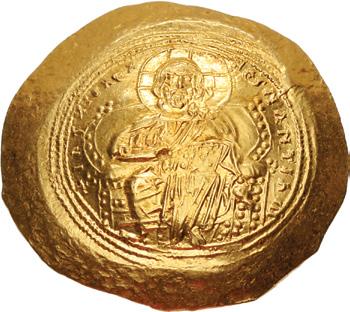

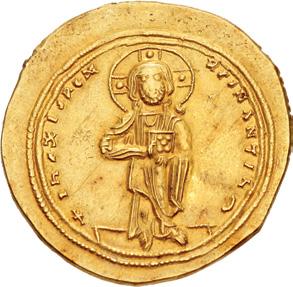
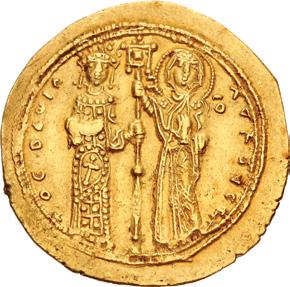
1008. Constantine IX Monomachus. 1042-1055. AV Histamenon Nomisma (28.5mm, 4.38 g, 6h). Constantinople mint. Christ Pantokrator enthroned facing on suppedion, nimbate, raising hand in benediction and holding Gospels / Crowned facing bust of Constantine, wearing loros, holding labarum and globus cruciger. DOC 2a; Füeg II 2.A; SB 1829. Toned and lustrous, scratch at reverse periphery. EF. ($500)
1009. Theodora. 1055-1056. AV Histamenon Nomisma (23.5mm, 4.42 g, 6h). Constantinople mint. Christ Pantokrator standing facing on suppedion, nimbate; one pellet in bars of nimbus / Theodora, wearing crown and loros decorated with cross, and the Theotokos standing facing, holding between them a labarum on long staff with pellet on shaft and beneath. DOC 1a; Füeg II 1.A; SB 1837. Toned with some luster, light reverse die rust, minor scratches and marks. Good VF. ($1500)
Very Rare Histamenon of Michael VI


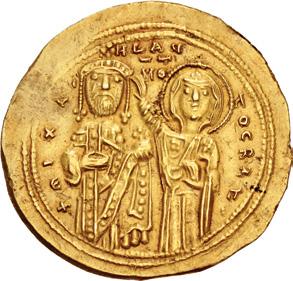
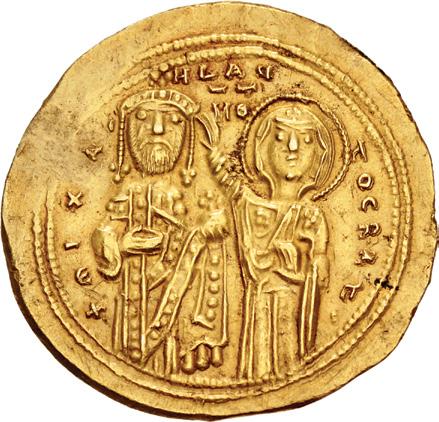
1010. Michael VI Stratioticus. 1056-1057. AV Histamenon Nomisma (24mm, 4.37 g, 6h). Constantinople mint. Nimbate facing bust of Christ Pantokrator, raising right hand in benediction and holding Gospels in left; (squares) in quarters of nimbus / Michael standing facing, wearing crown and jeweled chlamys, resting hand on chest and holding globus cruciger, being crowned by the Theotokos, nimbate, to right; M Θ, both with macron above between. DOC 1b; Füeg II 1.B; SB 1840. Toned, minor marks and scratches, edge marks, light deposits. EF. Very rare. ($10,000)
Ex Peus 376 (29 October 2003), lot 1210; Peus 361 (3 November 1999), lot 740; Giessener Münzhandlung 76 (22 April 1996), lot 651.

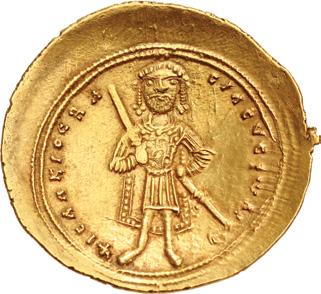
1011. Isaac I Comnenus. 1057-1059. AV Histamenon Nomisma (25mm, 4.38 g, 6h). Constantinople mint. Christ Pantokrator enthroned facing on suppedion, nimbate, raising hand in benediction and holding Gospels / Isaac standing facing, wearing military attire, holding drawn sword and resting hand on scabbard. DOC 2; Füeg II 2.B.x var. (rev. legend break); SB 1843. Toned and lustrous, slightly unusual edge. Near EF. ($750)
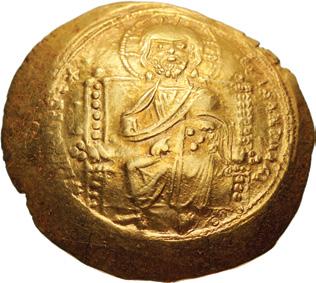

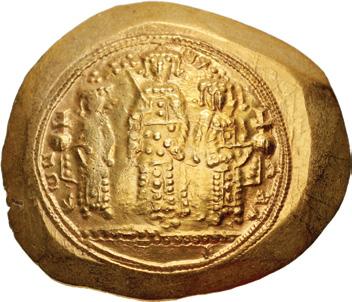
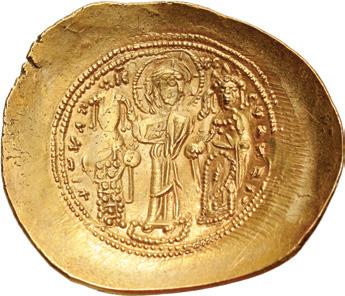
1012. Constantine X Ducas. 1059-1067. AV Histamenon Nomisma (24.5mm, 4.39 g, 6h). Constantinople mint. Christ Pantokrator enthroned facing, nimbate, raising hand in benediction and holding Gospels / Constantine standing facing on suppedion, wearing crown and loros, holding labarum and globus cruciger. DOC 1a; Füeg II 1.A; SB 1847. Toned and lustrous, slightly ragged edge. Near EF. ($500)
1013. Romanus IV Diogenes, with Eudocia, Michael VII, Constantius, and Andronicus. 1068-1071. AV Histamenon Nomisma (27.5mm, 4.46 g, 6h). Constantinople mint. Michael standing facing, holding labarum and akakia, between Constantius and Andronicus, both holding globus cruciger and akakia; all wearing loros and standing on double linear and pelleted base / Christ standing facing on suppedion, crowning Romanus to right and Eudocia to left, both wearing loros and holding globus cruciger. DOC 2; SB 1861. Toned and lustrous, minor doubling on obverse, light scratches at periphery. Good VF. ($500)
266
1012 1013 1008 1009

Pedigreed to 1968
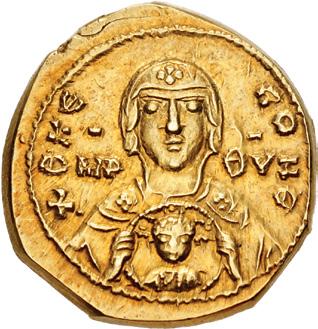
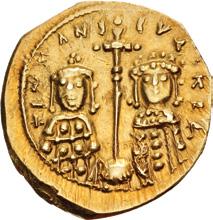
1014. Romanus IV Diogenes. 1068-1071. AV Tetarteron Nomisma (26.5mm, 4.04 g, 6h). Constantinople mint. Facing bust of the Theotokos, holding medallion containing nimbate facing bust of the Holy Infant / Crowned facing half-length figures of Romanus and Eudocia, both wearing loros and holding globus surmounted by jeweled long cross between them. DOC 3; SB 1862. Attractively toned, trace reverse die rust. Good VF. ($1000)
Ex Leu 77 (11 May 2000), lot 897; Peus 268 (24 April 1968), lot 419.
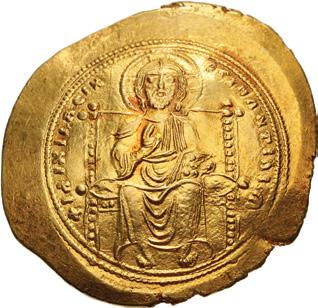

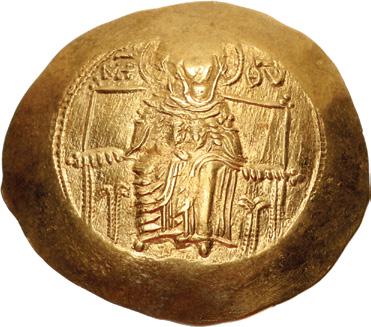
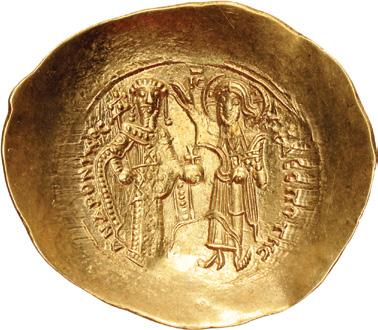
1015. Eudocia, with Michael VII and Constantius. 1071. AV Histamenon Nomisma (25mm, 4.43 g, 6h). Constantinople mint. Christ Pantokrator enthroned facing on suppedion, nimbate, raising hand in benediction and holding Gospels / Crowned facing figures of Eudocia, holding jeweled scepter, standing facing on suppedion, flanked by her sons Michael, to left, holding globus cruciger and akakia, and Constantius, to right, holding akakia and globus cruciger, all wearing loros. DOC 1; Füeg II 1.x.2; SB 1857. Toned and lustrous, slightly ragged flan. Near EF. ($750)
Ex Dr. Anton C. R. Dreesmann Collection (Part II, Spink 144, 13 July 2000), lot 690.
1016. Andronicus I Comnenus. 1183-1185. AV Hyperpyron (30mm, 4.39 g, 6h). Constantinople mint. The Theotokos enthroned facing, holding facing bust of the Holy Infant on lap / Andronicus standing facing, wearing loros, holding labarum and globus cruciger, being crowned by Christ, nimbate, holding Gospels. DOC 1; SB 1983. Lustrous. Good VF. ($500)
Ex Gorny & Mosch 122 (10 March 2003), lot 2385.
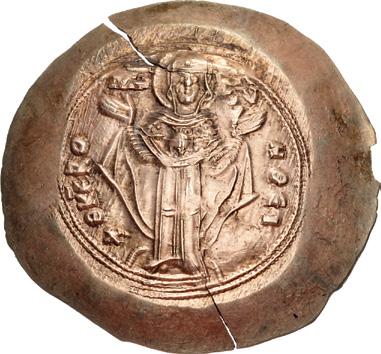

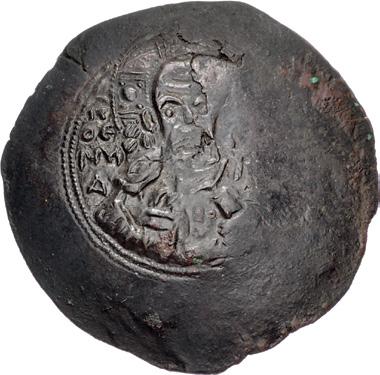
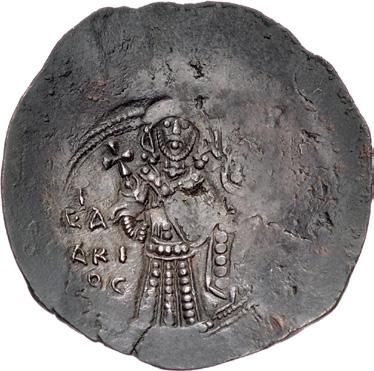
1017. Andronicus I Comnenus. 1183-1185. EL Aspron Trachy Nomisma (31mm, 4.36 g, 6h). Constantinople mint. The Theotokos, orans, standing facing on suppedion; facing head of the Holy Infant on breast / Andronicus standing facing, wearing crown and chlamys, holding labarum and akakia, being crowned by Christ, nimbate, holding Gospels. DOC 2a; SB 1984. Attractively toned and lustrous, a couple of flan cracks. EF. Well struck. ($500)
1018. Isaac Comnenus. Usurper in Cyprus, 1185-1191. BI Trachy (30.5mm, 4.60 g, 7h). Nicosia mint(?). Struck 1187-circa 1191. Facing bust of Christ Emmanuel, nimbate, holding scroll / Crowned facing figure of Isaac, holding cruciform scepter and akakia; manus Dei to upper right. DOC 3; SB 1992. Dark brown-green patina with some red, thin flan crack, minor weakness. Good VF. Nice detail for issue. ($500)
Purchased from Numisart.
267
1015
1016
1017
1018


1019. Theodore Comnenus-Ducas. As emperor of Thessalonica, 1227-1230. AR Aspron Trachy Nomisma (28.5mm, 2.76 g, 6h). Thessalonica mint. Christ Pantokrator enthroned facing, nimbate, raising hand in benediction and holding Gospels / Facing figures of Theodore, wearing crown and loros, and St. Demetrius, holding sword over shoulder, holding long staff with triangle and cross in circle between them. DOC 1b-c var. (no sigla); SB 2158. Toned with some luster, some weakness, scratch on reverse. Good VF. ($1000)
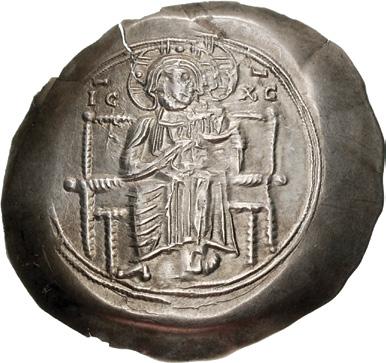
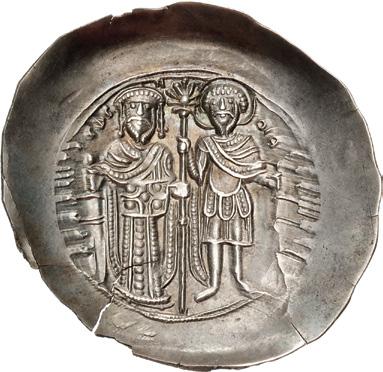
1020. Theodore I Comnenus-Lascaris. Emperor of Nicaea, 1208-1222. EL Aspron Trachy Nomisma (31mm, 3.17 g, 6h). Nicaea mint. Struck 1208-circa 1212. Christ Pantokrator enthroned facing, nimbate, holding Gospels / Facing figures of Theodore, wearing crown and loros, and St. Theodore, both holding sheathed sword and staff surmounted by star between them. DOC 2; SB 2064 (Magnesia). Attractively toned, a couple of flan cracks, minor surface metal flaws, light scratch on reverse, some faint hairline scratches. EF. ($500)
Ex Hauck & Aufhäuser 16 (16 October 2001), lot 527; Sternberg VI (25 November 1976), lot 1041.

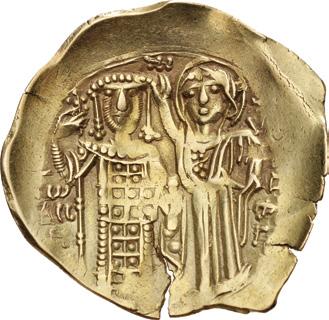
1021. John III Ducas (Vatatzes). Emperor of Nicaea, 1222-1254. AV Hyperpyron (26mm, 4.33 g, 6h). Magnesia mint. Struck 1232-circa 1254. Christ Pantokrator enthroned facing; sigla: – | (four pellets) / Crowned facing figure of John, wearing loros, holding labarum and akakia, being crowned by the Theotokos, standing facing to right. DOC (9f); SB 2073. Toned, flan crack, graffito. VF. ($500)
Very Rare Trachy
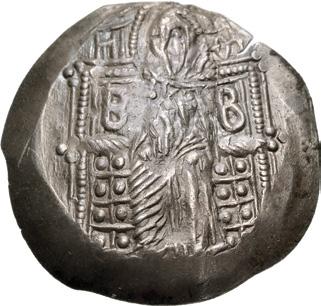
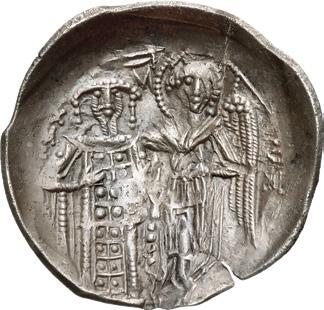
1022. Michael VIII Palaeologus. As Emperor of Nicaea, 1258-1261. AR Trachy (25.5mm, 2.04 g, 6h). Magnesia mint. Struck 1259/1260. The Theotokos enthroned facing, holding head of Holy Infant on lap; sigla: B | B / Facing figures of Michael, wearing crown and loros, resting hand on chest, and St. Michael the Archangel, resting hand on hip, holding akakia between them. DOC 27 (line drawing); SB 2246. Toned, minor edge split, slightly bent and straightened. Good VF. Very rare. ($750)
Purchased from Numisart. Ex Gorny & Mosch 200 (10 October 2011), lot 3151.
268
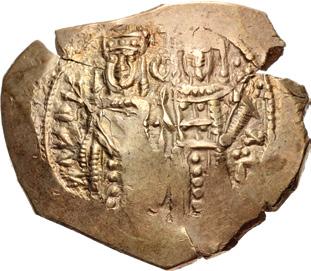
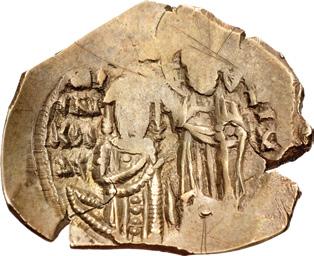
1023. John V Palaeologus, with Anna of Savoy (Regent). 1341-1391. AV Hyperpyron (24.5mm, 4.30 g, 6h). Constantinople mint. Struck 1341-1347. Crowned facing figures of Anna, holding trefoil scepter and placing hand on breast, and John, holding akakia and cruciform scepter, both wearing loros / Crowned figure of Andronicus III kneeling right, wearing loros, being blessed by Christ standing left; Christ nimbate and holding Gospels. DOC 942; LPC p. 116, 1; PCPC 190.1 (sigla 1; Andronicus III); SB 2466 (Andronicus III). Toned, flan cracks, surface metal flaws, graffiti. VF. ($500)


1024. John V Palaeologus, with Anna of Savoy (Regent). 1341-1391. AR Basilikon (20.5mm, 1.15 g, 12h). Constantinople mint. Struck 1341-1347. Christ Pantokrator enthroned facing, nimbate, raising hand in benediction and holding Gospels / Crowned facing figures of Anna, holding trefoil scepter and placing hand on breast, and John, holding akakia and cruciform scepter, both wearing loros. DOC Class IV (966–1178); LBC 847; LPC p. 132, 2; PCPC 277; SB 2503; S. Bendall, “A Hoard of Silver Basilika of Andronicus III and John V” in CH III, 3-23. Toned, deposits. Good VF. ($1000)
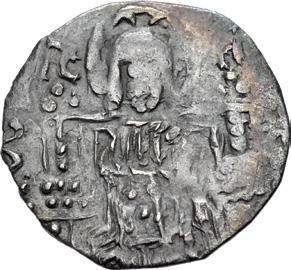
Published in 1972
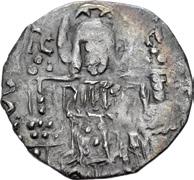

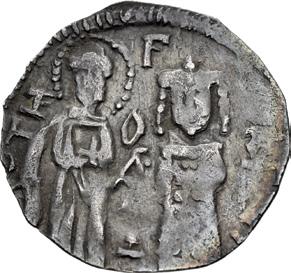
1025. John VI Cantacuzene. Second reign, 1353-1354. AR Basilikon (16mm, 0.72 g, 6h). Didymoteichon(?) mint. Christ Pantokrator enthroned facing, nimbate, raising hand in benediction and holding Gospels / St. Demetrius, nimbate, holding small cross to chest, standing slightly right, extending hand to John, wearing crown and loros, standing facing. DOC 1206; A. Veglery & A. Millas, “The silver coinage of John VI Cantacuzenus (1353-1354)” in NumCirc LXXX.9 (September 1972), 4 (this coin); LBC –; LPC p. 150, 3; PCPC (303); SB 2542. Attractively toned with some iridescence. VF. Very rare. ($1000)
Ex Leu 97 (10 May 2006), lot 329 (hammer CHF 3800); N. C. Georges Collection (cited in the 1972 Numismatic Circular).

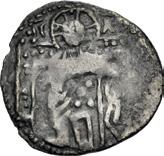
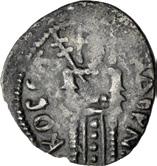
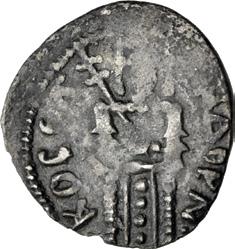
1026. Andronicus IV Palaeologus. Usurper, 1376-1379. AR Basilikon (13.5mm, 0.57 g, 8h). Uncertain mint. Christ Pantokrator enthroned facing, nimbate, raising hand in benediction and holding Gospels / Crowned facing figure of Andronicus, wearing loros, holding patriarchal cruciform scepter. DOC – (but cf. pp. 208-9 for issue); LBC 890; LPC p. 152, 2; PCPC 325.1; SB 2545. Toned, find patina, some weakness. VF. Extremely rare. ($1500)
Ex Leu 97 (10 May 2006), lot 348.
269
The Last Byzantine Emperor
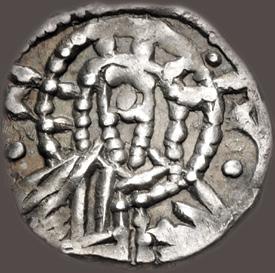
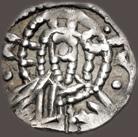
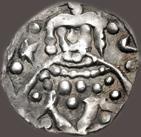
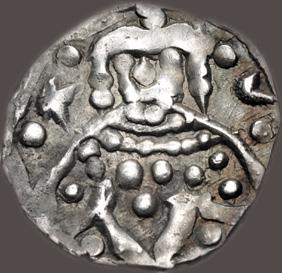
1027. Constantine XI Palaeologus (Dragases). 1448-1453. AR Eighth Stavraton (11.5mm, 0.59 g, 12h). Constantinople mint. Facing bust of Christ Pantokrator, nimbate, holding Gospels; sigla: • | • / Crowned facing bust of Constantine, wearing loros; •/K/• | •/C/• flanking. DOC 1789; Bendall, Coinage 135-54; SB –. Attractively toned with some iridescence. Good VF. Rare. ($10,000)
Ex Hauck & Aufhäuser 16 (16 October 2001), lot 526.
Constantine XI, a member of the last Byzantine dynasty, the Palaeologan, was a heroic figure despite being fated to be the final Byzantine ruler. One of the younger sons of Emperor Manuel II, Constantine distinguished himself during the siege of Constantinople in 1422 during the last days of Manuel II’s rule. After Manuel suffered a stroke and became incapable of governing, Constantine’s older brother, future emperor John VIII, took the reins of the government on behalf of his father. However, John’s first priority was to seek to rally support for the Byzantine state against the ascendant Ottomans. In pursuit of this objective, he embarked on a tour of Western Europe. In his stead, he left his younger brother Constantine as regent and granted him the title of despot. Constantine effectively administered what was left of the shrinking Byzantine State in his brother’s absence, but John’s quest to enlist western support for Byzantium was ultimately unsuccessful.
Once John assumed the imperial mantle upon the death of Manuel II, Constantine was tasked with governing one of the few remaining possessions of the once-illustrious Byzantine Empire—the Despostate of Morea. Constantine again proved himself a capable ruler and administrator, using the limited resources he had at his disposal to recover Morea from the Franks who had occupied the Peloponnesos since the Fourth Crusade. Ultimately, Constantine’s Morea encompassed the entire Peleponesos and, along with Epirus, constituted the bulk of Byzantine possessions outside of Constantinople which was itself quickly shrinking into a city-state as more and more territory was lost to the Ottomans.
When John died in 1448 without issue, Constantine was designated as his successor and called to assume the fateful position of emperor. Crowned at the citadel at Mystras, Constantine traveled from Morea to Constantinople in a hired Catalan galley—a succinct representation of how miserably Byzantine power had dwindled by the mid 15th century. The Byzantine fleet had been previously destroyed during the reign of John VI in a disastrous naval engagement in 1349 with the Genoese. All Constantine could do in his new station as emperor was prepare for the inevitable attack by the Ottomans. He worked to repair the city walls and recruit and muster as many soldiers as possible to mount his final defense of the city. As part of that effort, coins such as this rare example were minted to pay the mostly hired soldiers. The attack came in late May of 1453. Constantine himself manned the ramparts and fought valiantly during the city’s final defense. He was ultimately killed upon the city walls and his corpse mutilated by the invaders. Thus ended the Byzantine Empire, an institution that lasted nearly a millennium and outlasted its parent Western Roman Empire by five centuries.

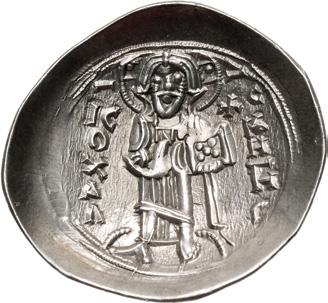
1028. Andronicus I Gidon. Emperor of Trebizond, 1222-1235. AR Aspron Trachy (25.5mm, 2.68 g, 6h). The Theotokos standing slightly right on suppedion, orans / Christ Pantokrator standing facing on suppedion, raising hand in benediction and holding Gospels. DOC IV.2 1 (Anonymous Magnesian); Retowski –; S. Bendall, An Introduction to the Coinage of the Empire of Trebizond 2.2; SB 2148 (Uncertain Nicaea). Lightly toned, lustrous, minor die breaks, area of light scrapes. Near EF. Well struck. ($750)
Purchased from Numisart.
270

Unique North African Umayyad Solidus
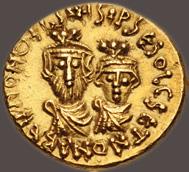
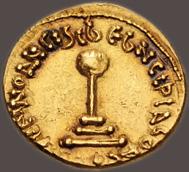

1029. Umayyad Caliphate. temp. ‘Abd al-Malik ibn Marwan to ‘Umar ibn Abd al-Aziz. AH 65-101 / AD 685-720. AV Solidus (16mm, 4.35 g, 6h). North Africa (Carthage) mint. Struck circa AH 79-90 (AD 698-710). NON ЄST dS NIS IPSЄ SOL CS ЄT NON ABЄII, crowned and draped Byzantine-style older and younger facing busts (modeled on Heraclius and Heraclius Constantine) / [...]NOΔNCI SIb ЄbNCIPIAS OΔЄI, modified cross potent, surmounted by globus and set on two steps. SICA 1 –; AGC I 9 (this coin illustrated); cf. Walker, Arab-Byzantine p. 55, HSA 1 and 145 (AV Semissis); cf. Album 115 (for similar issue with horizontal bar on steps). Iridescent toning, deposits in devices. Good VF. Unique. ($20,000)
Ex Triton VI (13 January 2003) lot 1189; Dr. Anton C. R. Dreesmann Collection (Part II, Spink 144, 13 July 2000), lot 846, purchased from J. Schulman, 14 November 1967.
The Muslim conquest of North Africa began during the caliphate of Mu’awiya (AH 41-60 / AD 661-680). Qayrawan, the capital of the new Umayyad province of Ifriqiya, was founded by the general ‘Uqba b. Nafi’ in AH 50 (AD 670). The Arab conquest, however, was met with determined resistance, from the Berbers as well as Byzantine forces, and the great city of Carthage remained a Byzantine stronghold in North Africa for a quarter of a century. It was only in AH 76 (AD 695) that the city first fell to the Arabs when the inhabitants surrendered to the besieging forces of Hassan b. al-Nu’man. While many of the wealthier inhabitants fled to Italy, Greece and Spain, the rest of the city’s population offered no resistance, and Hassan occupied Carthage without much bloodshed. Judging his position secure, Hassan constructed chains across the city’s harbor to deter the Byzantines from launching a counter-attack by sea, and then departed with most of his troops to meet the threat of the Berbers to the west.
Hassan’s faith in these chains proved misplaced. The Byzantine emperor Leontius sent a strong naval force under John the Patrician to retake Carthage. John equipped his largest ships with specially reinforced hulls, allowing him to smash through the chains and land safely in the city’s harbor. Outnumbered, the Arab garrison was no match for John’s Sicilian and Gothic troops. John quickly retook the city, and the defenders withdrew to Qayrawan. But the Byzantines were hopelessly slow to support John’s initial success, so that Hassan reappeared before the walls of Carthage with a fresh army before John’s reinforcements had even left the port of Constantinople. Now it was John’s turn to find himself helpless in the face of a far superior force, and he had little option but to withdraw. The Byzantine army held the walls long enough to allow a hasty but relatively orderly retreat; Hassan reoccupied Carthage in AH 79 (AD 698). Fearing the consequences of having to report their failure to Leontius, John’s troops mutinied, killing John and proclaiming one of their number, Apsimar, as emperor. Apsimar’s forces entered Constantinople later in AD 698, deposing and mutilating Leontius, and leaving Apsimar to rule as Tiberius III.
It is possible to trace the course of these momentous events in the coinage record. The Byzantine mint at Carthage was evidently still active in AH 76, since Carthaginian solidi are known dated to the tenth year of the reign of Justinian II (MIB 18b), so when the city first surrendered to Hassan b. al-Nu’man the Arabs would have taken control of an operational Byzantine mint for solidi. This in itself would have been a highly significant development, because there had been no active gold mint in any of the Byzantine provinces which the Arabs had previously conquered, leaving them dependent on imported solidi to maintain coinage stocks. Thus once Carthage was securely in Muslim hands after the defeat of John in AH 79, the victorious Arabs began to strike gold coins of their own there, including the unique piece offered here. Although ‘Abd al-Malik b. Marwan had introduced reformed, purely Islamic dinars at Damascus in AH 77 (AD 696/7), the Arabs continued to strike gold which copied earlier Byzantine types, recognizing the need to produce coins which would have been acceptable to the local population. Interestingly, they chose to copy an issue of Heraclius (AD 610-641) rather than the most recent solidi of Justinian II, probably to avoid the adverse political connotations of being seen to follow current Byzantine types; this preference for an older prototype is also seen on the Arab-Sasanian silver drachms struck in the Eastern Islamic territories, which usually bore the portrait of the long-dead Khusraw II rather than the last Sasanian ruler, Yazdigerd III.
The new Arab solidi, which maintain the familiar ‘globular’ fabric of their Byzantine predecessors, were struck to the local Byzantine weight standard and issued in three denominations: solidus, semissis, and tremissis. They bear the familiar twin facing busts of Heraclius and Heraclius Constantine, largely unaltered except for the removal of all overtly Christian crosses, and a similarly ‘de-Christianized’ crosson-steps on the reverse. The legends, written in abbreviated Latin rather than Arabic, are monotheistic rather than Islamic: the proclamation on the obverse of this coin that ‘There is no God but God alone and He has no associate’ would have been largely acceptable to Christians and Muslims alike. On virtually all surviving examples of this rare coinage, the modification of the cross-on-steps is used to indicate the denomination. Solidi and tremisses generally have the upper limb of the cross removed so that the shaft terminates in a T-bar, while semisses replace the cross with a globe. While there has been much scholarly debate over the symbolism of these changes, comparison with Byzantine prototypes suggests that the Arabs simply turned the Byzantine cross on each denomination upside-down, so that the base of the cross on the prototype became the top of the modified cross on the Arab adaptation. Thus the base of the cross potent on the tremisses becomes a T-bar set on a single step, the globe at the base of the cross potent on the semisses becomes a globe set atop a pole on two steps, and the cross-on-steps on the solidi also becomes a shaft surmounted by a T-bar set on three steps.
The unique solidus offered here appears to be the only known solidus of this type which has a globe on top of the cross shaft instead of a T-bar. It does not fit with the system of denominations and types which the Arabs used for their Carthaginian coinage, and instead appears to look back to the modified cross-on-steps dinars with Arabic legends issued at Damascus before the introduction of the reformed gold coinage in AH 77 (AD 696/7). This in turn raises the tantalizing possibility that this unique piece might have been struck circa AH 76-77, during Hassan’s first occupation of Carthage, and that Hassan simply followed current Damascus practice in striking solidi with a globe atop the cross-shaft on the reverse. It would only have been after the defeat and expulsion of John, when the Arabs had time to establish a structured denominational system for their Carthaginian gold coinage, that the decision would have been taken to use a T-bar instead of a globe on the solidi.
271
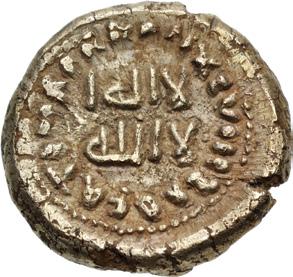

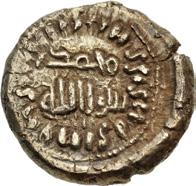

1030. Umayyad Caliphate. temp. Suleiman ibn ‘Abd al-Malik. AH 96-99 / AD 715-717. Pale AV Solidus – Dinar (4.28 g, 6h). North Africa (Carthage or Tripoli) mint. Dated AH 98 (AD 716/7). SΛD FRT IN ΛFRK ΛN XCVIII, la ilah i/la Allah in Arabic in two lines / [...]SSISИISIИIИSI[...], muhammad r/sul Allah in Arabic in two lines. SICA 1 –; AGC I 34Ca; cf. Walker, Arab-Byzantine 185 and p. 79, P. 50; Album 121M. Toned, deposits, hairline flan crack. Good VF. Very rare. ($5000)
Ex Gorny & Mosch 121 (10 March 2003), lot 545.
Extremely Rare Mule
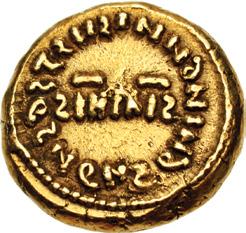
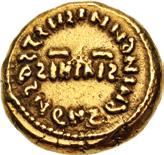
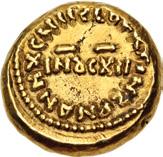
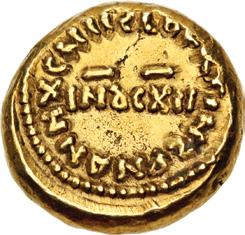
1031. Umayyad Caliphate. temp. al-Walid I ibn ‘Abd al-Malik. AH 86-96 / AD 705-715. Pale AV Solidus (14mm, 4.33 g, 9h). North African type. Spanish mint. Dated IY 12 and AH 94 (AD 712/3). IN N ∂NI N ∂S N ∂ NS∂S)τSIIS (sic), SIMIΛIS / SL∂ FRT IN SPN ΔNN XC IIII, IN∂C XII across field; macrons above IN∂ and CX. SICA 1 –; AGC I –, but cf. 19; cf. Balaguer 32 = Walker, Arab-Byzantine, p. 75, B. 13 (for rev.); cf. Album 119.2. Attractive toning, deposits in devices, edge marks. Good VF. Extremely rare mule, combining a North Africa mint obverse with a Spanish reverse. ($1500)
Choice Alfonso VIII Maravedí – Morabitino. Dated Safar Era 1226 = AD 1188
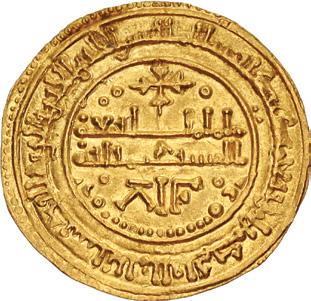
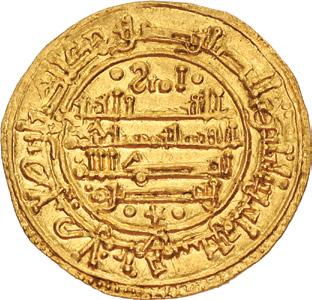
1032. SPAIN, Castile & León. Alfonso VIII el Noble (the Noble). King of Castile, 1158-1214. AV Maravedí – Morabitino (26.5mm, 3.79 g, 6h). Tulaitula (Toledo) mint. Dated Safar era 1226 (AD 1188). In center: cross above The spiritual leader of the Christians, the Pope (in Arabic) in two lines above ი ⍒ƩŊ ი ; in margin: In the name of the Father, Son and Holy Spirit, one God who so believes in Him and is baptized will be saved (in Arabic) / In center: Prince of the Catholics, Alfonso son of Sancho, May God protect and assist him (in Arabic) in two lines; in margin: This dinar was struck in the city of Tulaitula, the year six and twenty and two hundred and one thousand of Safar (in Arabic). ME 1019; MEC 6, 360-2 var. (date). Toned. Choice EF. ($2000)
272


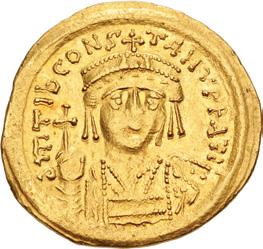
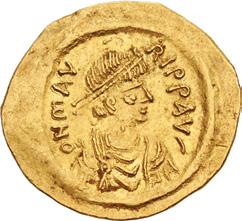
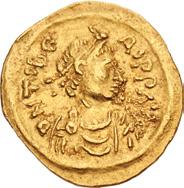
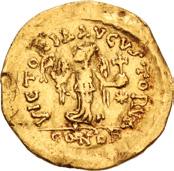
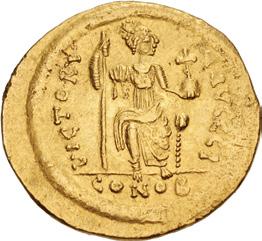
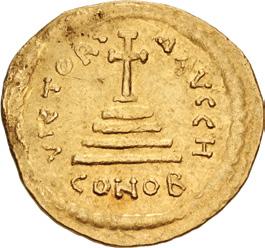

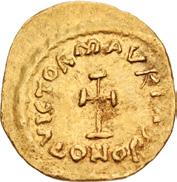
1033. Lot of ten (10) gold issues. Includes:
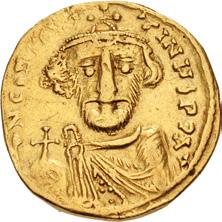

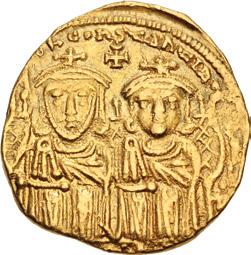




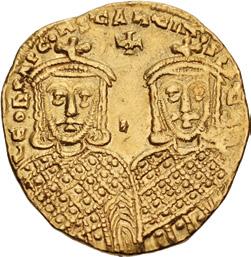

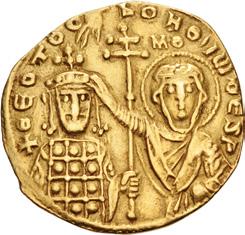
1) Justin I. 518-527. AV Tremissis (14.5mm, 1.41 g, 6h). Constantinople mint. DOC 4; MIBE 5; SB 58.
2) Justin II. 565-578. AV Solidus (21mm, 4.52 g, 6h). Constantinople mint, 10th officina. Struck 567-578. DOC 4i; MIBE 5; SB 345.
3) Tiberius II Constantine. 578-582. AV Solidus (21mm, 4.43 g, 6h). Constantinople mint, 8th officina. DOC 4h; MIBE 4; SB 422.
4) Maurice Tiberius. 582-602. AV Semissis (19.5mm, 2.16 g, 7h). DOC 11/12 (obv./rev.); MIBE 17b; SB 485.
5) Maurice Tiberius. 582-602. AV Tremissis (15mm, 1.46 g, 7h). DOC 14; MIBE 20; SB 488.
6) Constans II. 641-668. AV Solidus (18mm, 4.23 g, 6h). Constantinople mint, 9th officina. Dated IY 7 (648/9). DOC 13 var. (unlisted officina); MIB 16a; SB 949.
7) Leo III the “Isaurian”, with Constantine V. AV Solidus (20mm, 4.44 g, 6h). Constantinople mint. Struck circa 737741. DOC 7b var. (unlisted reverse legend); Füeg 7.D.5; SB 1504. Ex UBS 47 (14 September 1999), lot 344 (one of two examples cited in the Füeg corpus).
8) Leo IV the Khazar, with Constantine VI, Leo III, and Constantine V. AV Solidus (20.5mm, 4.41 g, 6h). Constantinople mint. Struck 778-780. DOC 2; Füeg 1.B.1 (Constantine VI); SB 1584.
9) Theophilus. 829-842. AV Tremissis (10.5mm, 1.11 g, 3h). Syracuse mint. Struck 831-842. DOC 27a; Anastasi 558; SB 1678.
10) John I Zimisces. 969-976. AV Tetarteron Nomisma (20mm, 3.87, 6h). Constantinople mint. DOC 6a; Füeg 3; SB 1789.
Average VF-Good VF. LOT SOLD AS IS, NO RETURNS. Ten (10) coins in lot. ($2000)
273
2 3 4 6 7 8 10 1 5 9

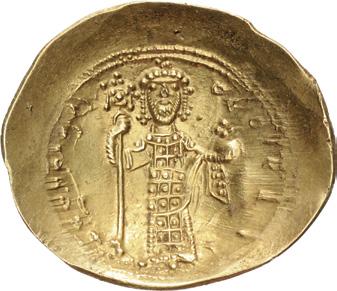
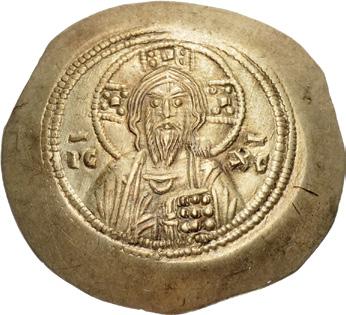
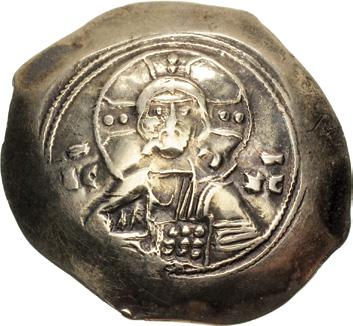



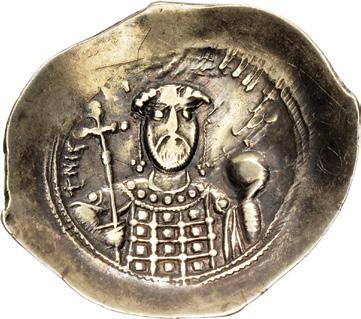
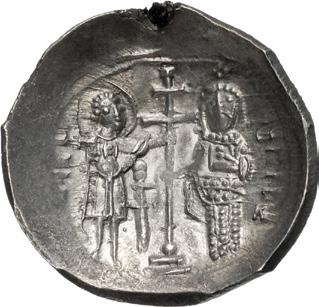
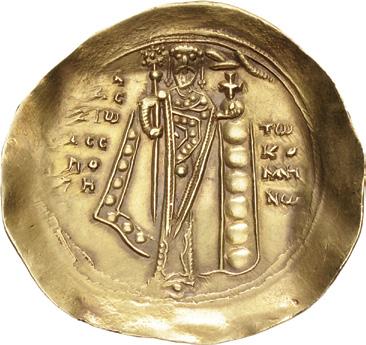
1034. Lot of nine (9) mostly gold and electrum issues. Includes:
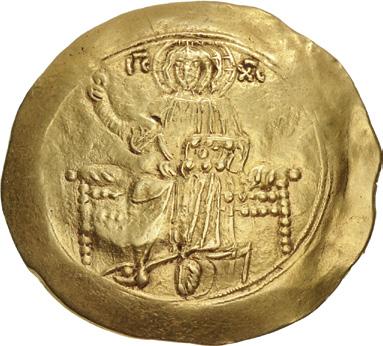
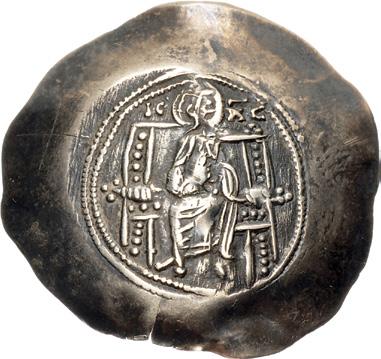
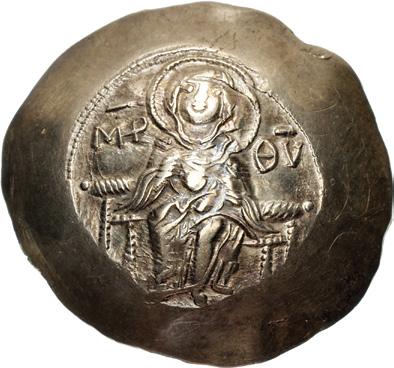

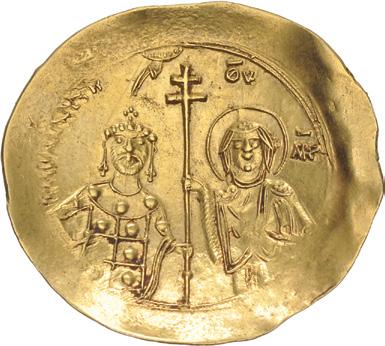
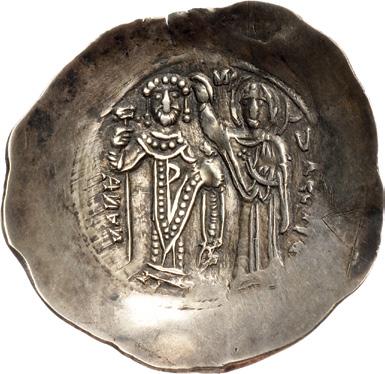
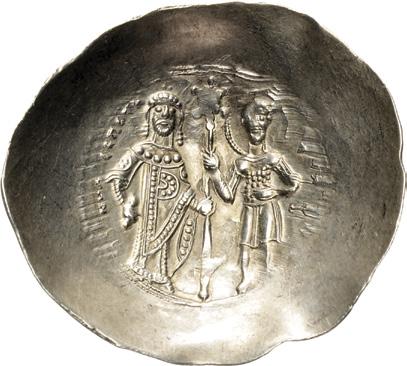

1) Constantine X Ducas. 1059-1067. AV Histamenon Nomisma (27mm, 4.42 g, 6h). Constantinople mint. DOC 1a; Füeg II 1.A; SB 1847.
2) Michael VII Ducas. 1071-1078. EL Histamenon Nomisma (28mm, 4.33 g, 6h). Constantinople mint. DOC 2d; SB 1868.
3) Nicephorus III Botaniates. 1078-1081. EL Histamenon Nomisma (28mm, 4.33 g, 6h). Constantinople mint. DOC 1; SB 1883.
4) Alexius I Comnenus. 1081-1118. AR Histamenon Nomisma (25.5mm, 4.24 g, 6h). Thessalonica mint. Struck 10821087. DOC 5a; SB 1905.
5) Alexius I Comnenus. 1081-1118. AV Hyperpyron (30.5mm, 4.32 g, 6h). Constantinople mint. Struck 1092/3-1118. DOC 20g; SB 1913.
6) John II Comnenus. 1118-1143. AV Hyperpyron (30.5mm, 4.32 g, 6h). Constantinople mint. Struck 1118-1122. DOC 1a; SB 1938.
7) Manuel I Comnenus. Byzantine emperor. 1143-1180. EL Aspron Trachy (30.5mm, 3.97 g, 6h). Constantinople mint. Struck 1167-circa 1183. DOC 6; SB 1961.
8) Manuel I Comnenus. Byzantine emperor. 1143-1180. EL Aspron Trachy (32mm, 4.50 g, 6h). Thessalonica mint. Struck circa 1160-circa 1167. DOC 9; SB 1974.
9) Isaac II Angelus. First reign, 1185-1195. AV Hyperpyron (26mm, 4.27 g, 6h). Constantinople mint. DOC 1d; SB 2001.
274
Average VF-Good VF. LOT SOLD AS IS, NO RETURNS. Nine (9) coins in lot. ($2000) 1 2 3 4 5 6 8 7 9
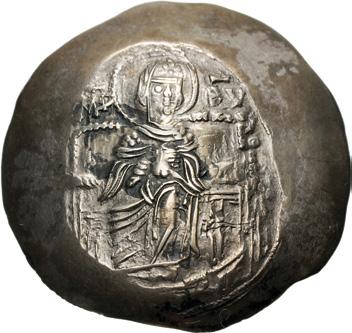
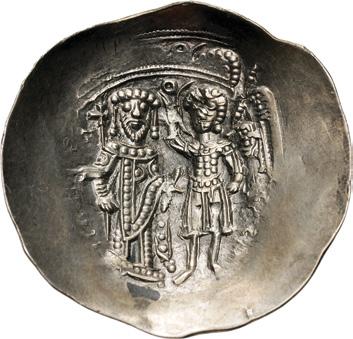

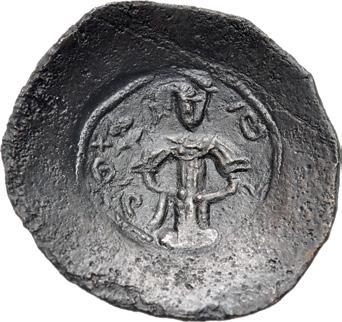


1035. Lot of six (6) mostly gold and electrum issues. Includes:


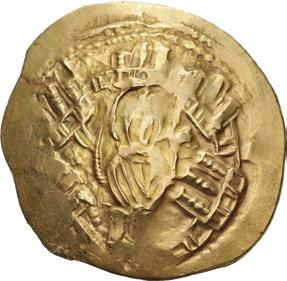

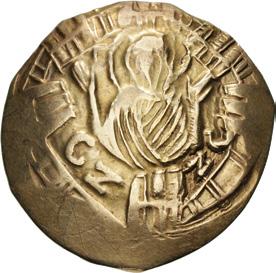

1) Isaac II Angelus. First reign, 1185-1195. EL Aspron Trachy (28.5mm, 3.31 g, 6h). Constantinople mint. DOC 2b; SB 2002.
2) Theodore Mancaphas. Usurper in Philadelphia, circa 1188-1189 and circa 1204-1206. BI Trachy (26mm, 4.72 g, 9h). Philadelphia(?) mint. Struck circa 1188-1189. DOC (2); SB –.
3) Alexius III Angelus-Comnenus. 1195-1203. EL Aspron Trachy (27.5mm, 3.88 g, 6h). Constantinople mint. Struck 1195-1997. DOC 2d.2; SB 2009.
4) John III Ducas (Vatatzes). Emperor of Nicaea, 1222-1254. AV Hyperpyron (26.5mm, 4.58 g, 6h). Magnesia mint. Struck 1232-circa 1254. DOC (4f); SB 2073.
5) Michael VIII Palaeologus. 1261-1282. AV Hyperpyron (23.5mm, 4.35 g, 6h). Constantinople mint. DOC Class IIa var. (unlisted sigla); PCPC 4 (sigla 7); SB 2242.
6) Andronicus II Palaeologus. 1282-1328. AV Hyperpyron (22.5mm, 4.03 g, 6h). Class Ia. Constantinople mint. Struck 1282-1294. DOC 220-228 var. (unlisted sigla); PCPC 91B (sigla 51A); SB 2326.
275
Average VF-Good VF. LOT SOLD AS IS, NO RETURNS.
coins in lot. ($1000) 1 2 3 4 5 6
Six (6)
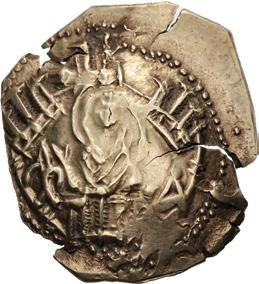
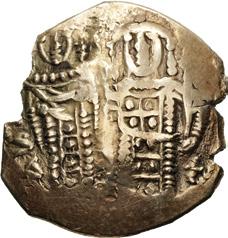
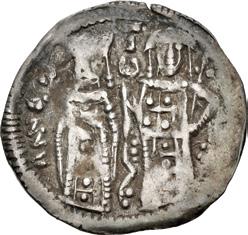
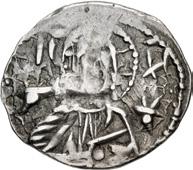
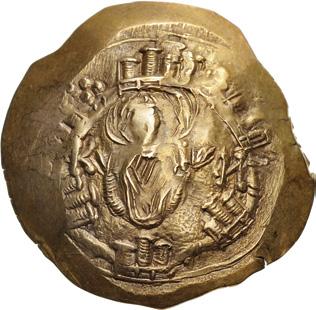


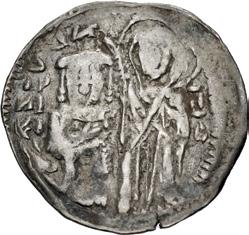
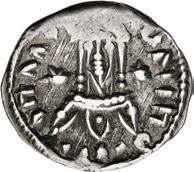
1036. Lot of nine (9) gold and silver issues. Includes:
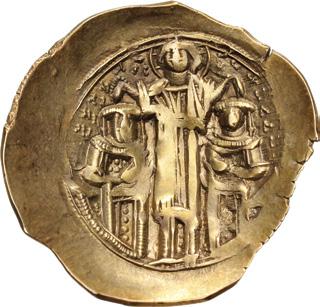



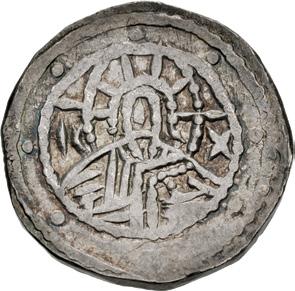
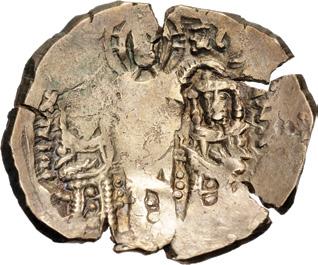

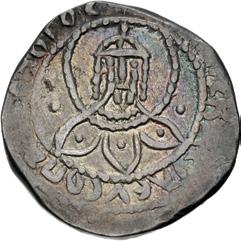
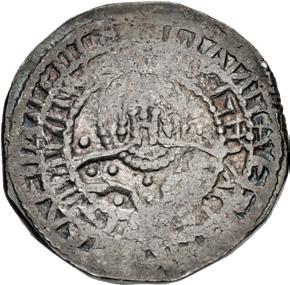
1) Andronicus II Palaeologus, with Michael IX. 1282-1328. AV Hyperpyron (25mm, 4.04 g, 6h). Constantinople mint. Struck 1294-1303. Cf. DOC 235-61 var. (unlisted sigla); PCPC 127 (sigla 43); SB 2396.
2) Andronicus II Palaeologus, with Andronicus III. 1282-1328. AV Hyperpyron (20.5mm, 3.48 g, 6h). Constantinople mint. Struck 1325-1328 (or later). DOC 494-497; PCPC 185.1 (sigla 4); SB 2461.
3) John V Palaeologus, with Anna of Savoy (Regent). 1341-1391. AV Hyperpyron (18mm, 3.05 g, 6h). Constantinople mint. Struck 1341-1347. DOC 942; LPC p. 116, 1; PCPC 190.1 (sigla 1; Andronicus III); SB 2466 (Andronicus III).
4) John V Palaeologus, with Anna of Savoy (Regent). 1341-1391. AR Basilikon (20.5mm, 1.19 g, 6h). Constantinople mint. Struck 1341-1342. DOC 954-61; PCPC 200 (Andronicus III); LPC p. 122, 8 (Andronicus III); SB 2475 (Andronicus III). Rare.
5) John V Palaeologus. 1341-1391. AR Eighth Stavraton (15.5mm, 1.05 g, 12h). Constantinople mint. Struck 13671376. DOC 1249-50; LPC p. 154, 3; SB 2512.
6) John V Palaeologus, with John VI. 1341-1391. AV Hyperpyron (24.5mm, 3.89 g, 6h). Constantinople mint. Struck 1347-1352. DOC 1193 var. (sigla); LPC p. 138, 1; PCPC 285 var. (uncertain sigla); SB 2526.
7) Manuel II Palaeologus. 1391-1425. AR Half Stavraton (19mm, 3.70 g, 6h). Constantinople mint. Struck 1394/51399. DOC 1320-24 var. (unlisted sigla) PCPC 334.16 (sigla 33); SB 2551.
8) John VII Palaeologus. Regent, 1399-1402. AR Half Stavraton (19.5mm, 3.75 g, 6h). Constantinople mint. DOC 1328; PCPC 346.6 (sigla 6); SB 2562.
9) John VIII Palaeologus. 1425-1448. AR Stavraton (23mm, 7.13 g, 12h). Constantinople mint. DOC 1665-1720; PCPC 348.17 (sigla 18); SB 2563.
VF-Good VF. LOT SOLD AS IS, NO RETURNS. Nine (9) coins in lot. ($2000)
276
1 2 4 3 6 5 7 8 9
BYZANTINE COINAGE

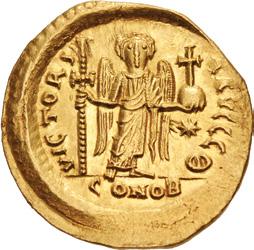
1037. Justin I. 518-527. AV Solidus (20.5mm, 4.38 g, 6h). Constantinople mint, 9th officina. Struck 522-527. Helmeted and cuirassed bust facing slightly right, holding spear over shoulder, shield on left shoulder / Angel standing facing, holding long cross and globus cruciger; star to right; Θ//CONOB. DOC 2h; MIBE 3; SB 56. Lustrous, clipped, a few light scratches. EF. ($500)

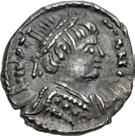

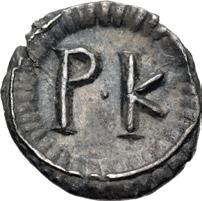
1038. Justinian I. 527-565. AR 120 Nummi (11mm, 0.70 g, 6h). Ravenna mint. Struck 552-565. Diademed bust right, wearing robe / Large P • K (mark of value) within wreath. DOC 336; MIBE 76 (Rome); Ranieri 355; SB 317. Attractive old cabinet tone, small flan crack. Near EF. Well centered and struck. ($500)
From the Iconodule Collection. Ex Gasvoda Collection; Artemide LIV (7 November 2020), lot 398.
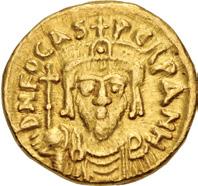
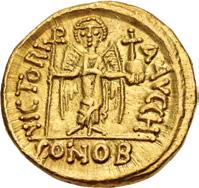
1039. Phocas. 602-610. AV Solidus (16.5mm, 4.46 g, 6h). Carthage mint. Dated IY 8 (604/5). Draped and cuirassed bust facing, wearing crown with pendilia, holding globus cruciger; AN H (date) at end of legend / Angel standing facing, holding long staff surmounted by staurogram and globus cruciger; H (date)//CONOB. DOC 109; MIBE 32; SB 681. Toned, minor obverse die wear. Good VF. Very rare. ($750)

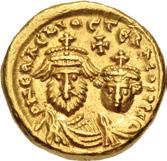
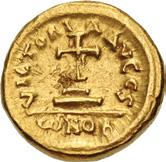
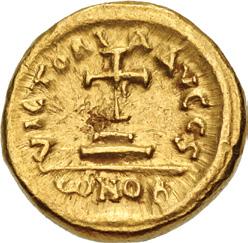
1040. Heraclius, with Heraclius Constantine. 610-641. AV Solidus (13.5mm, 4.48 g, 6h). Carthage mint. Dated IY 6 (617/8). Crowned facing busts of Heraclius and Heraclius Constantine, both wearing chlamys; S (date) at end of legend / Cross potent set on two steps; S (date)//CONOB. DOC 208; MIB 84a.6; SB 867. Toned, minor metal flaw on reverse, trace deposits. Near EF. ($500)
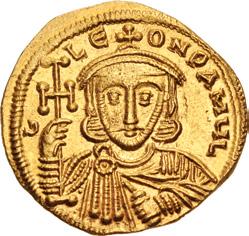
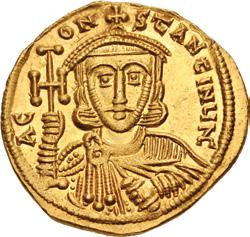

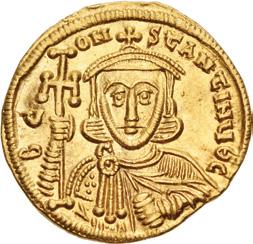
1041. Constantine V Copronymus, with Leo III. 741-775. AV Solidus (20.5mm, 4.50 g, 6h). Constantinople mint. Struck 741-751. Crowned facing bust of Leo, wearing chlamys, holding cross potent and akakia / Crowned facing bust of Constantine, wearing chlamys, holding cross potent and akakia; A at beginning of legend, (NC) at end. DOC (1e.2)/(1f) var. (legend) (for obv./rev.); Füeg 3.A.1; SB 1550. Lightly toned, lustrous, light scratch. EF. ($500)
1042. Constantine V Copronymus, with Leo III. 741-775. AV Solidus (20.5mm, 4.45 g, 6h). Constantinople mint. Struck 741-751. Crowned facing bust of Leo, wearing chlamys, holding cross potent and akakia / Crowned facing bust of Constantine, wearing chlamys, holding cross potent and akakia; B at beginning of legend, ΘC at end. DOC (1e.2)-(1f) var. (legends); Füeg 3.A.4; SB 1550. Toned with some luster. EF. ($500)
277
1042
1041
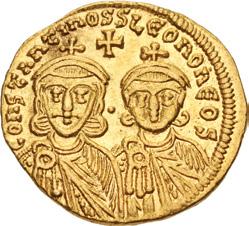
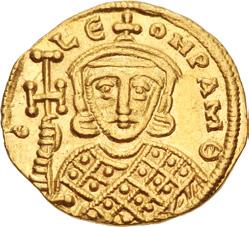

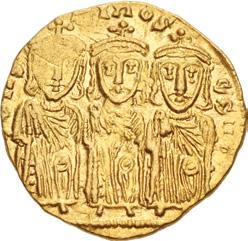
1043. Constantine V Copronymus, with Leo IV and Leo III. 741-775. AV Solidus (20mm, 4.44 g, 6h). Constantinople mint. Struck 751-circa 757. Crowned facing busts of Constantine V and Leo IV, both wearing chlamys; cross above, • between / Crowned facing bust of Leo III, wearing loros, holding cross potent; Θ at end of legend. DOC 2c; Füeg 4.A.3; SB 1551. Lightly toned with some luster. Near EF. ($600)
1044. Constantine VI & Irene, with Leo III, Constantine V, and Leo IV. 780-797. AV Solidus (20mm, 4.44 g, 6h). Constantinople mint. Struck 780-790. Crowned facing busts of Constantine VI, wearing chlamys and holding globus cruciger, and Irene, wearing loros, holding globus cruciger and cruciform scepter; cross above, • between / Constantine V, Leo III, and Leo IV seated facing, each wearing crown and chlamys. DOC 1; Füeg Ir.2.9/C.2.13 (obv./rev.); SB 1593. Lightly toned with some luster, thin scrape on reverse. Near EF. ($750)

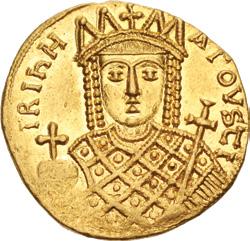
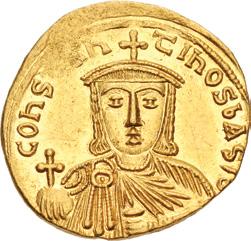

1045. Constantine VI & Irene. 780-797. AV Solidus (20mm, 4.41 g, 6h). Constantinople mint. Struck 792-797. Crowned facing bust of Irene, wearing loros, holding globus cruciger and cruciform scepter / Crowned facing bust of Constantine, wearing chlamys, holding globus cruciger and akakia. DOC 3a; Füeg 5.A; SB 1594. Lightly toned, lustrous, spots of weakness faint hairlines. EF. ($2000)

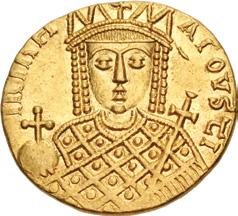
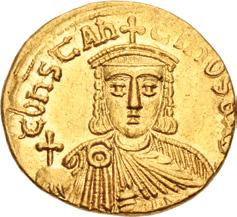
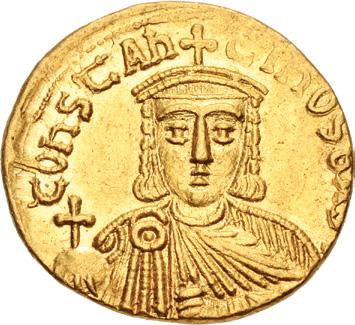
1046. Constantine VI & Irene. 780-797. AV Solidus (19.5mm, 4.47 g, 6h). Constantinople mint. Struck 792-797. Crowned facing bust of Irene, wearing loros, holding globus cruciger and cruciform scepter / Crowned facing bust of Constantine, wearing chlamys, holding globus cruciger and akakia. DOC 3a; Füeg 5.A; SB 1594. Lightly toned with some luster, minor die break. EF. ($2000)

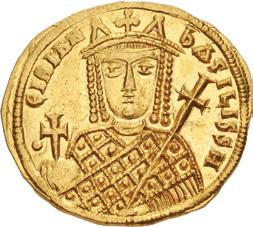
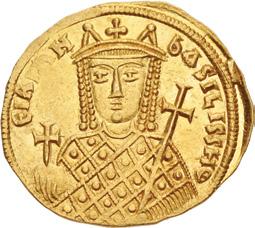

1047. Irene. 797-802. AV Solidus (20.5mm, 4.38 g, 6h). Constantinople mint. Struck 797-802. Crowned facing bust of Irene, wearing loros, holding globus cruciger and cruciform scepter / Crowned facing bust of Irene, wearing loros, holding globus cruciger and cruciform scepter; at end of legend. DOC 1a.2; Füeg 2.B.1; SB 1599. Toned with some luster, slightly clipped, tiny spots of weakness. Superb EF. ($2500) 1044 1043
278
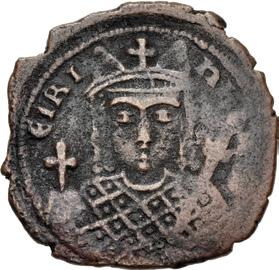
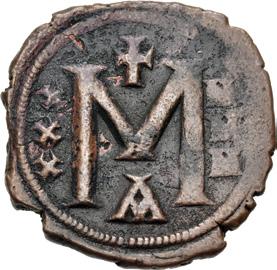
1048. Irene. 797-802. Æ Follis (21.5mm, 4.20 g, 6h). Constantinople mint. Crowned facing bust, wearing loros, holding globus cruciger and cruciform scepter / Large M; cross above; X/X/X/ - N/N/N across field; A. DOC 2; SB 1600. Thick dark brown and red patina with some light iridescent toning, small spots of bare metal showing on reverse. Near VF. A nice example for this difficult issue. ($500)
Ex Gorny & Mosch 274 (20 November 2020), lot 2848 (hammer €1300); Gorny & Mosch 251 (15 October 2017), lot 5195; Elsen 98 (13 December 2008), lot 643.
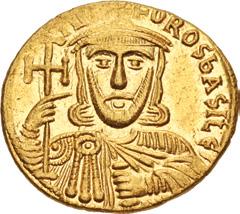


1049. Nicephorus I. 802-811. AV Solidus (19.5mm, 4.42 g, 6h). Constantinople mint. Struck 802-803. Crowned facing bust, wearing chlamys, holding cross potent and akakia / Cross potent set upon three steps; X at end of legend. DOC 1b; Füeg 1.B; SB 1603. Toned and lustrous, small reverse die breaks, minor spots of weakness, minor marks on reverse. EF. ($750)

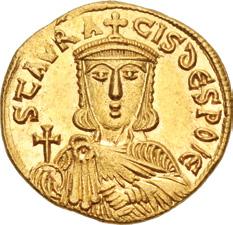
1050. Nicephorus I, with Stauracius. 802-811. AV Solidus (18.5mm, 4.44 g, 6h). Constantinople mint. Struck 803-811. Crowned facing bust of Nicephorus, wearing chlamys, holding cross potent and akakia / Crowned facing bust of Stauracius, wearing chlamys, holding globus cruciger and akakia; Є at end of legend. DOC 2a; Füeg 2.B.2; SB 1604. Toned and lustrous, minor spots of weakness. EF. ($750)
Outstanding Trachy of Theodore Comnenus-Ducas

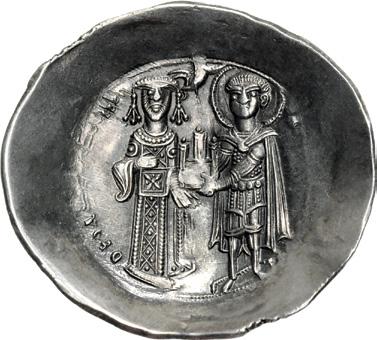
1051. Theodore Comnenus-Ducas. As emperor of Thessalonica, 1225/7-1230. AR Trachy (30mm, 3.94 g, 6h). Thessalonica mint. Struck circa 1227. The Theotokos standing facing, orans; (MHP) ΘV, both with macron above, flanking head; no sigla / Facing figures of Theodore, wearing crown and loros, resting hand on chest, and St. Demitrius, nimbate and wearing military attire, together holding city walls of Thessalonica between them; above, manus Dei crowning Theodore. DOC 2c var. (obv. legend); CLBC 12.1.2 var. (sigla); LBC 321 var. (same); SB 2159. Toned and lustrous. EF. Very rare. An outstanding example of this very rare issue. ($1000)
279
EARLY MEDIEVAL COINAGE
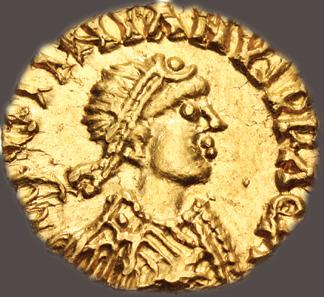



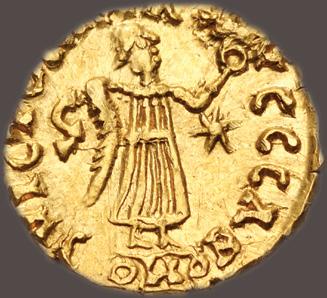
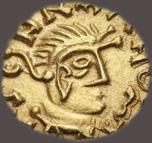

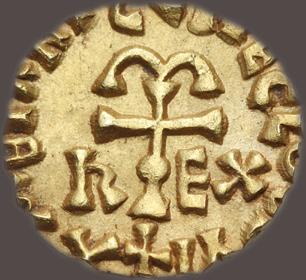
1052. BURGUNDIANS. Gundomar II. 524-532. AV Tremissis (14mm, 1.43 g, 6h). In the name of the Byzantine emperor Justinian I (527-565). Lugdunum (Lyon) mint. [ Ď n ƩV⌽ ] ˶ƩnƩ©nV⌽ P P ©ŲV , diademed, draped, and cuirassed bust right / VƩ⍛⍆⌴⎁Ʃ ม © ©V⍛⍛⍛ , Victory standing right, holding wreath in outstretched right hand; Ų (for Gundomar) to left, star to right; © // ⍛⌴Ƀ⌴B . Cf. Tomasini Group JAN 11a; Alise-Sainte-Reine Hoard 17-20; MEC 1, –, but cf. 341. Lightly toned, traces of die rust, scuffs on high points, underlying luster. EF. Very rare. ($5000)
Although struck bearing the name of the Eastern Roman emperors on the obverse, the late Burgundian gold issues are attributable to particular kings by the various monograms or letters placed in the reverse fields. Gundomar II was the last independent Burgundian ruler, losing his kingdom in battle with the Franks.
Amiens, City of Clovis the King
1053. MEROVINGIANS, Amiens. In the name of Clovis II (639-657). Circa 640-680. AV Tremissis (13mm, 1.32 g, 6h). Sigcharamnus, moneyer. [ ๘ ⌽Ʃ ] Ų⍛ Ɗʽșn⌴ ș© (sic), diademed and draped bust right / ๘ ©șBƩ©nƩ˝ ⍛ƩV⍟ ⍛Ǯ⌴ĕ⌴VƩ , ornate Greek cross ancrée set on base; ʽ eᛸ across field. NM 12; cf. Belfort 135-6; cf. Prou 1107 = Collection Amécourt 19; MEC 1, –. Lightly toned. Superb EF. Extremely rare and of considerable interest. ($15,000)
While Merovingian tremisses with mint and moneyers’ names are relatively plentiful, those bearing the name of kings are very rare. Clovis II was a child for much of his reign, coming to the throne of Neustria at the age of six. Initially the government was in the hands of his mother Nanthild, but after her death in 642 the real power was in the hands of the magnates. As a result Clovis is regarded as an early ‘roi faineant’ or ‘do-nothing king.’ Amiens held special importance to the Merovingian dynasty as it was there that Merovig, founder of the dynasty, was reported elected king of the Franks.
ISLAMIC COINAGE
Chingiz Khan
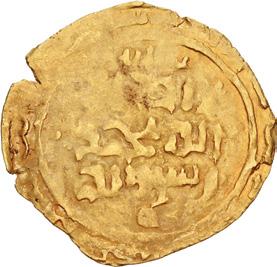

1054. Great Mongols. Chingiz (Genghis). AH 602-624 / AD 1206-1227. AV Dinar (23mm, 2.06 g, 5h). Bukhara mint. AH date off flan. la ilah illa/ ‘llah muhammad/rasul allah in three lines; bukhara above, pellet below / chingiz khan/al-’adil/ al-a’zam in three lines; lis above, pellet below. Nyamaa –; SNAT XVa-1, 267; Album 1964; cf. ICV 1940. Areas of weak strike, a couple of edge splits. Toned. VF. Rare. ($1500) 1052 1053
COLLECTORS of ISLAMIC COINAGE
See lots 1029-1032, above, for additonal offerings from the Family of Constantine Collection.
280
WORLD COINAGE
Very Rare Albanian Prova
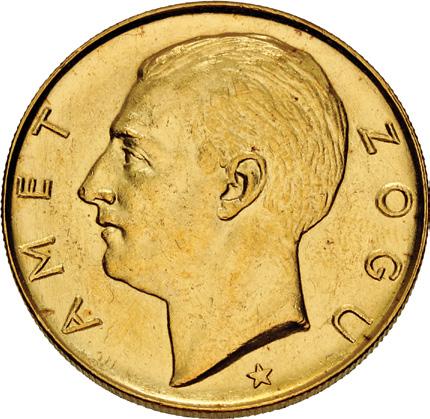

1055. ALBANIA. Amet Zogu. As President, 1925-1928. AV 100 Franga Ari Prova (35mm, 32.22 g, 7h). Rome mint. Dated 1926 R. Bare head left; one star below / Nude charioteer driving biga right; PROVA above. Montenegro 2; KM Pr15; cf. Friedberg 1 (for regular issue). In NGC encapsulation 6890912-004, graded MS 61. Very rare. Mintage of only 50 pieces. ($4000)
From the Alexander Christopher Collection.

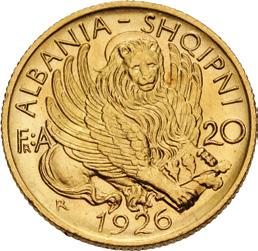
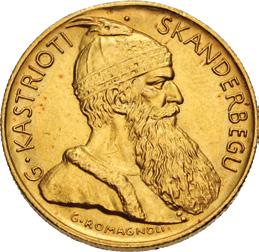

1056. ALBANIA. Amet Zogu. As President, 1925-1928. AV 20 Franga Ari (21mm, 6.45 g, 6h). Rome mint. Dated 1926
R. Bust of George Castriot (“Skanderbeg”) right / Lion of St. Mark facing slightly right, holding gospel and oak branch. Montengro 26; KM 12; Friedberg 4. In NGC encapsulation 6890912-006, graded MS 64. ($1500)
From the Alexander Christopher Collection.
1057. ALBANIA. Amet Zogu. As President, 1925-1928. AV 20 Franga Ari (21mm, 6.44 g, 6h). Vienna mint. Dated 1927
V. Bust of George Castriot (“Skanderbeg”) right / Lion of St. Mark facing slightly right, holding gospel and oak branch. KM 12; Friedberg 6. In NGC encapsulation 6890912-005, graded MS 65. ($1000)
From the Alexander Christopher Collection.

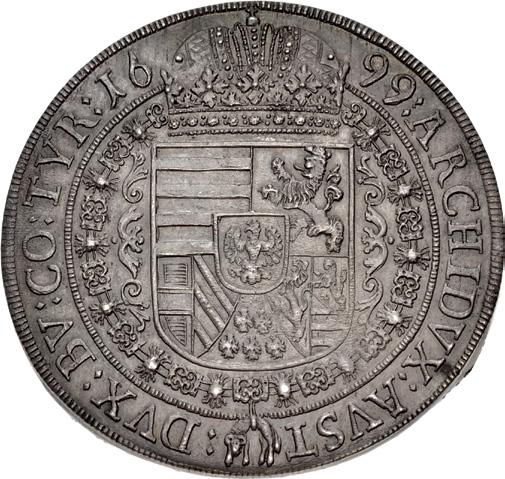
1058. AUSTRIA, Holy Roman Empire. Leopold I. Emperor, 1658-1705. AR Taler (42mm, 28.84 g, 12h). Hall mint. Dated 1699/8. Laureate and armored bust right / Crowned and collared coat-of-arms. Moser & Tursky 757; Davenport 3245; KM 1303.4 (unlisted date). Beautifully toned, minor edge marks. Choice EF. Sharp details. ($750)
281
1056
1057

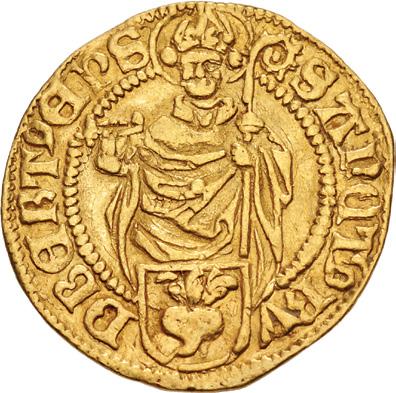
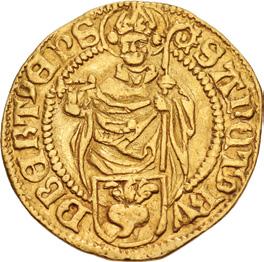
1059. AUSTRIA, Salzburg (Prince-Archbishophric). Leonhard von Keutschach. 1495-1519. AV Dukat (22mm, 3.39 g, 5h). Dated 1511. Coat-of-arms within trilobe / Half-length bust of St. Rupert facing, holding salt cellar and crozier; coat-of-arms below. Zöttl 24; Probszt 67; Friedberg 579. Toned, a few deposits. VF. Rare. ($1000)
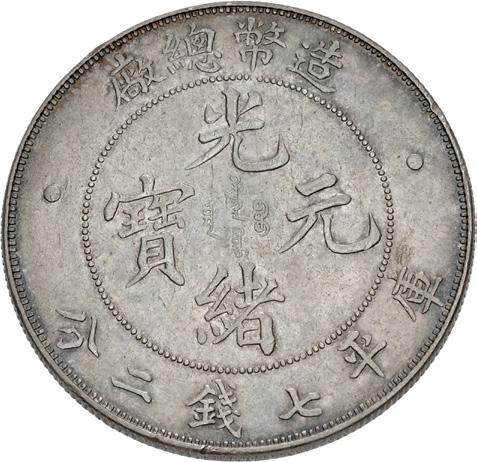
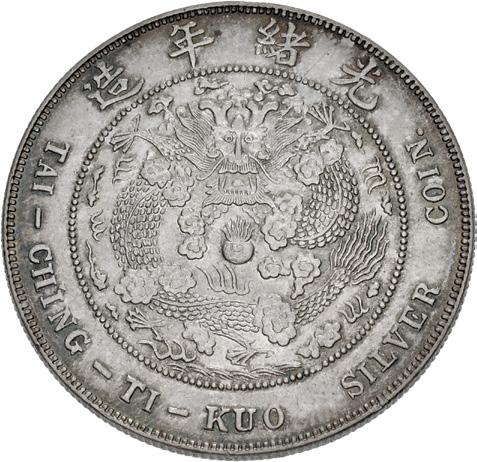

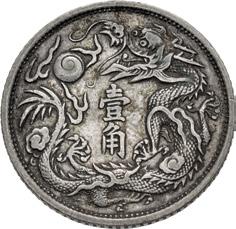
1060. CHINA, Qīng dynasty. General issues. AR Dollar (38mm, 26.81 g, 12h). Tiānjīn Central mint. Struck 1908. Legend in Hànzì characters and Manchu script / Flying imperial dragon facing, coiled leftward around fireball and surrounded by stylized clouds. L&M 11; KM (Y) 14. Toned. In PCGS encapsulation 49045611, graded AU Details, cleaned. ($1000)
From the Norman Frank Collection.
1061. CHINA, Qīng dynasty. General issues. AR 10 Cents (18mm, 2.09 g, 12h). Tiānjīn Central mint. Dated year 3 of Pǔyí (AD 1911). Legend in Hànzì characters / Flying imperial dragon coiled leftward around legend in Hànzì characters, with flaming pearl at mouth. L&M 41; KM (Y) 28. In PCGS encapsulation 49045607, graded XF Details, environmental damage. ($500)
From the Norman Frank Collection.
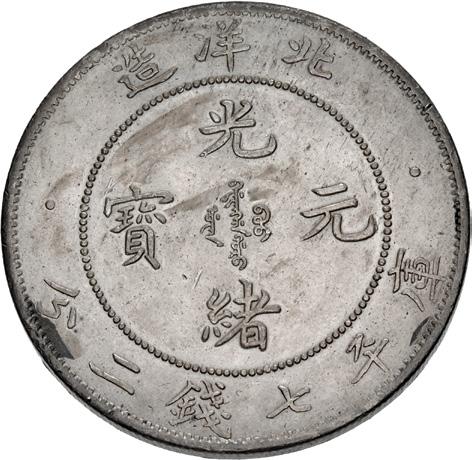
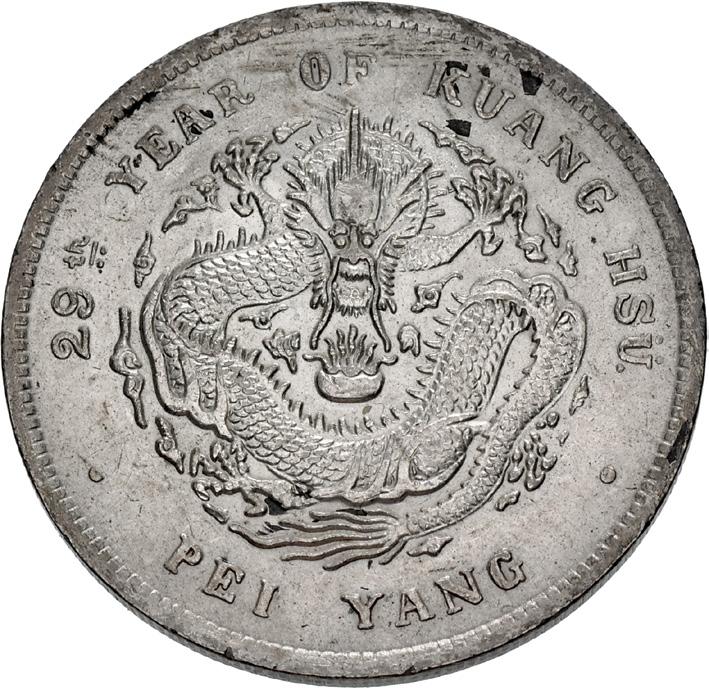
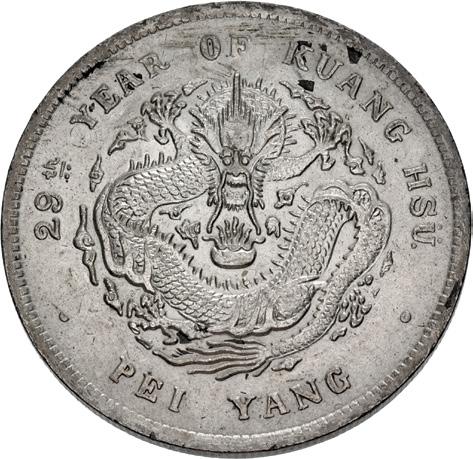
1062. CHINA, Qīng dynasty. Zhílì province. AR Dollar (38mm, 26.59 g, 12h). Běiyáng Arsenal (Tiānjīn) mint. Dated RY 29 of Dézōng (AD 1903). Legend in Hànzì characters / Flying imperial dragon facing, coiled leftward, no period after YANG. L&M 462A; KM (Y) 73.1. In PCGS encapsulation 49045610, graded AU 58. ($1500)
From the Norman Frank Collection.


1063. CHINA, Republic of China. General issues. 1912-1949. AR 20 Cents (23mm, 5.24 g, 11h). ‘Memento’ type. Struck 1912. Bust of Dr. Sun Yat-sen left / Crossed flags. L&M 61; KM (Y) 317. In PCGS encapsulation 49045609, graded AU 53. ($750)
From the Norman Frank Collection.
282
1060
1061

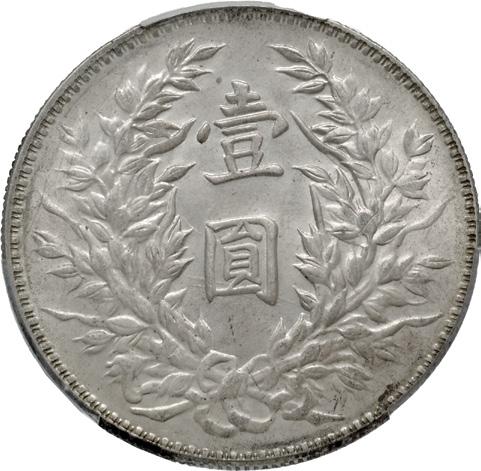


1064. CHINA, Republic of China. General issues. 1912-1949. AR Dollar (38mm, 12h). Central mint at Shànghǎi. Dated year 3 of the Republic (AD 1914). Bust of Yuán Shìkăi left / Denomination within wreath. L&M 63H; KM (Y) 329. In PCGS encapsulation 88744237, graded MS 63. ($500)
1065. CHINA, Republic of China. General issues 1912-1949. AR Dollar (38mm, 12h). Central mint at Shànghǎi. Dated year 10 of the Republic (AD 1921). Bust of Yuán Shìkăi left / Denomination within wreath. Dot in nien not connected. L&M 79; KM (Y) 329.6. In PCGS encapsulation 86136271, graded MS 63. ($500)

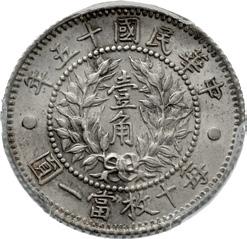


1066. CHINA, Republic of China. General issues. 1912-1949. AR 10 Cents. Tiānjīn Central mint. Dated year 15 of the Republic (AD 1926). Dragon and phoenix atop symbol of longevity / Denomination within wreath. L&M 83; KM (Y) 334. In PCGS encapsulation 48811183, graded MS 62. A well struck and lustrous example of this very popular type. ($2000)
1067. CHINA, Republic of China. Sìchuān province. 1912-1949. CU Horse Token (22mm, 5.13 g, 10h). Struck circa 1912. Horse prancing left, head lowered to right / Spray of orchid flowers. Duan 3621. In PCGS encapsulation 49045616, graded MS 63 BN. ($750)
From the Norman Frank Collection.
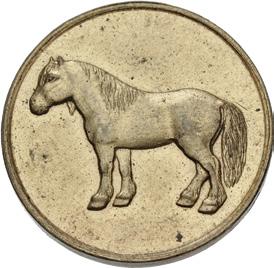

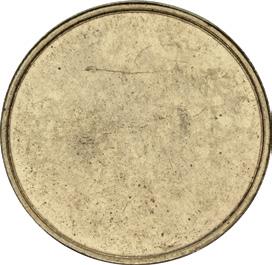
1068. CHINA, Republic of China. Sìchuān province. 1912-1949. Brass Horse Token (22mm, 5.06 g). Struck circa 1912. Horse standing left / Blank. Duan –. In PCGS encapsulation 49045617, graded MS 63. ($1500)
From the Norman Frank Collection.
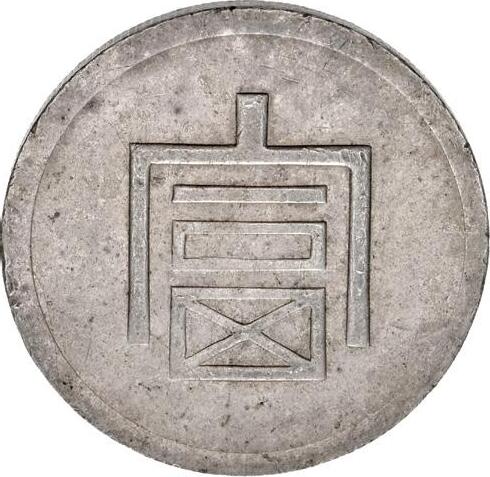
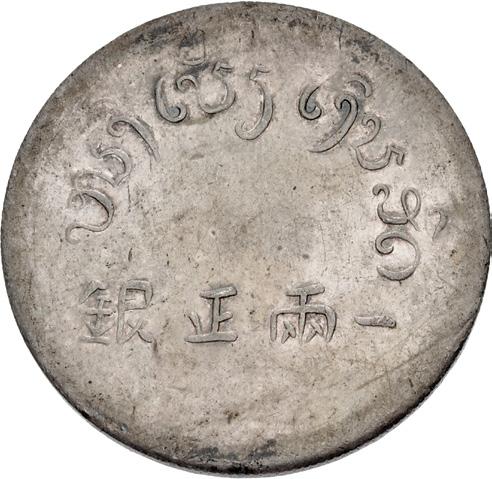
1069. CHINA, Republic of China. Húnán province 1912-1949. AR Tael (39mm, 37.5 g, 12h). Hanoi mint. Struck 1943. Fu in Hànzì characters / Legend in two lines in Burmese and Hànzì characters. L&M 433; MCF 324; KM (X) 1. Toned. In PCGS encapsulation 49045612, graded AU 58. ($1500)
From the Norman Frank Collection.
283
1066 1067 1064 1065
A Selection of Chinese Sycee
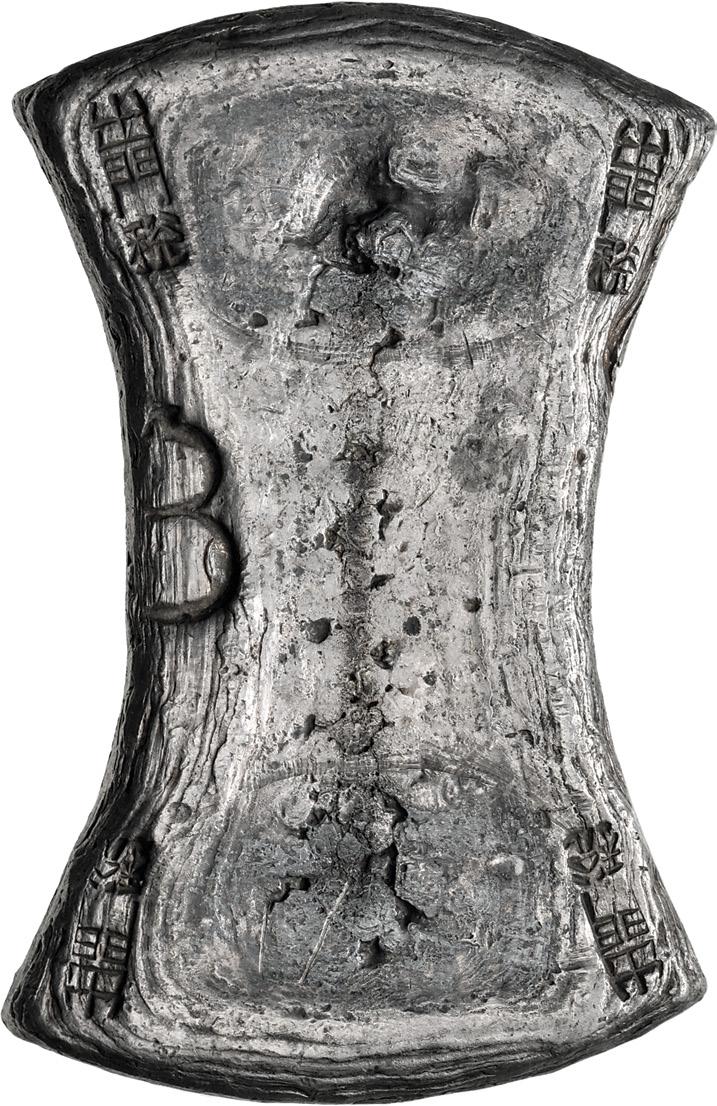
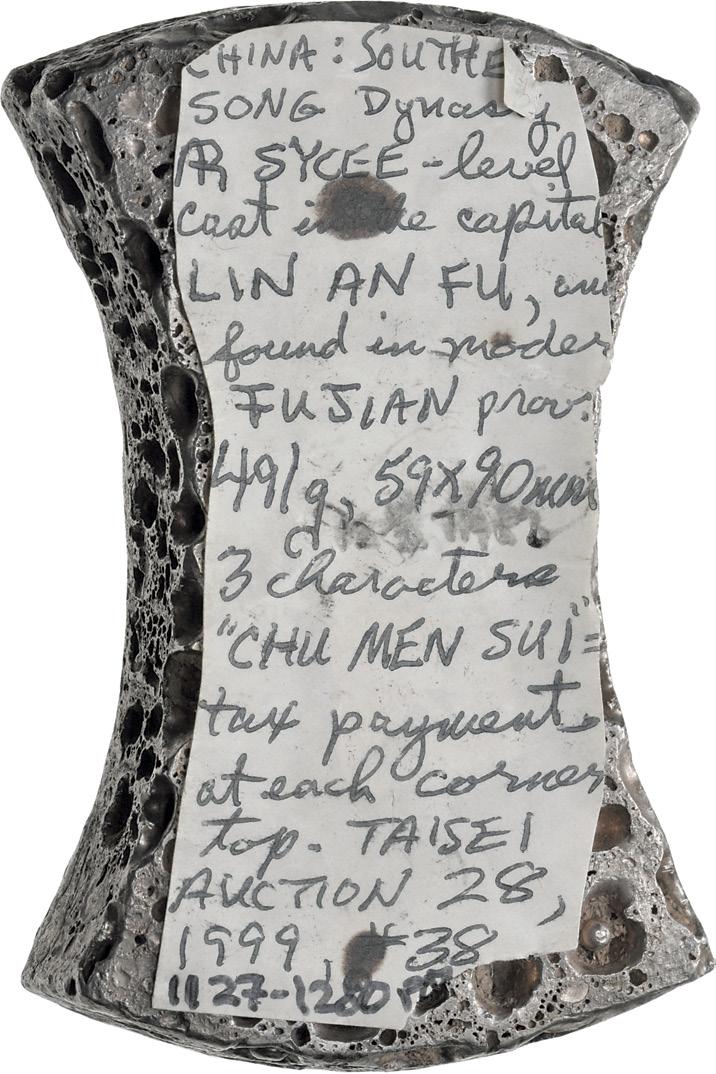
1070. CHINA, Sycee. Southern Sòng dynasty. 12th-13th centuries AD. AR 12.5 Tael Sycee (87x58x14mm, 490.5 g). 出 门税 (Chu Men Shui [Exit Gate Tax]) stamped in corners. Toned, some scratches and casting flaws on obverse, uncertain ‘3’ shaped mark, collector’s sticker on reverse. Fine. Rare. ($2500)
From the Norman Frank Collection. Ex Singapore Coin Auction 28 (4 March 1999), lot 38.
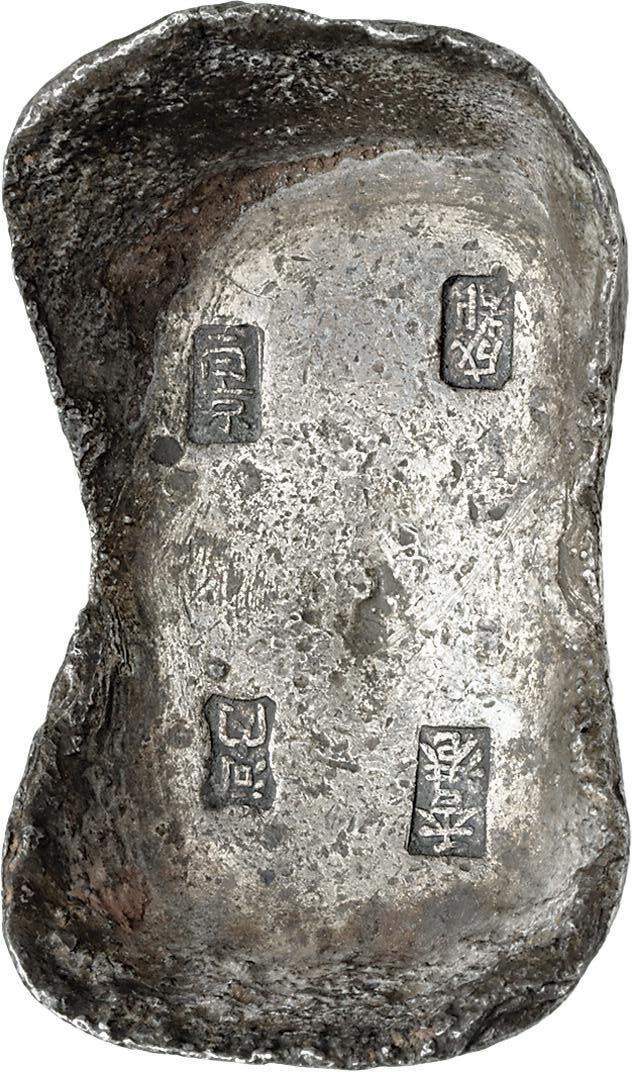
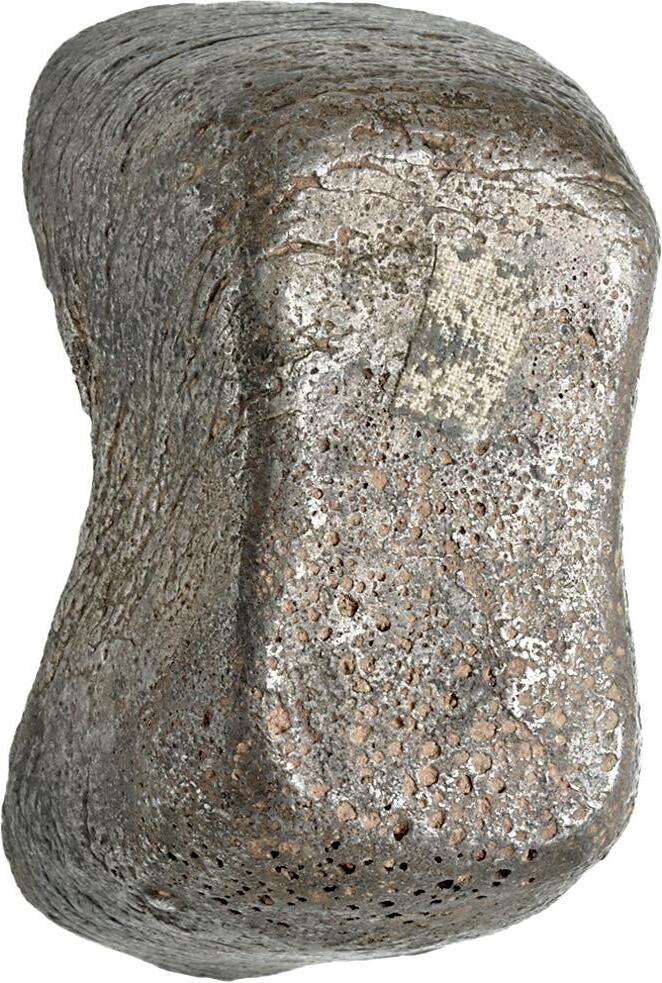
1071. CHINA, Sycee. Húběi province. Qīng dynasty, late 19th-early 20th centuries. AR 15 Tael (42x75x42mm, 534.2 g). Hubei Yuanbao (Hubei province principal ingot) type. Xiang Gang (Hong Kong), He Nei (Hanoi), Cheng Du, and Nan Jing (Nanking) in four stamps. Cf. BMC, Sycee type XIV. Toned, some scratches and marks, spot of tape on reverse. VF. ($2000)
From the Norman Frank Collection.
An interesting trade ingot that circulated not only in China, but in Hong Kong and Vietnam as well.
284
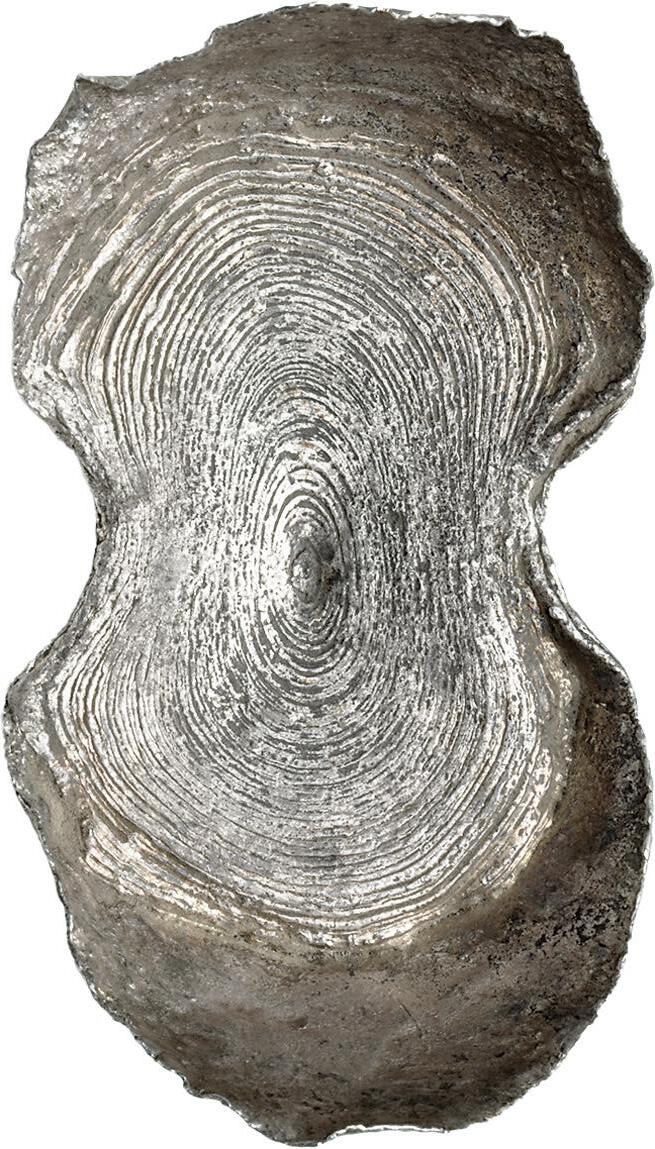
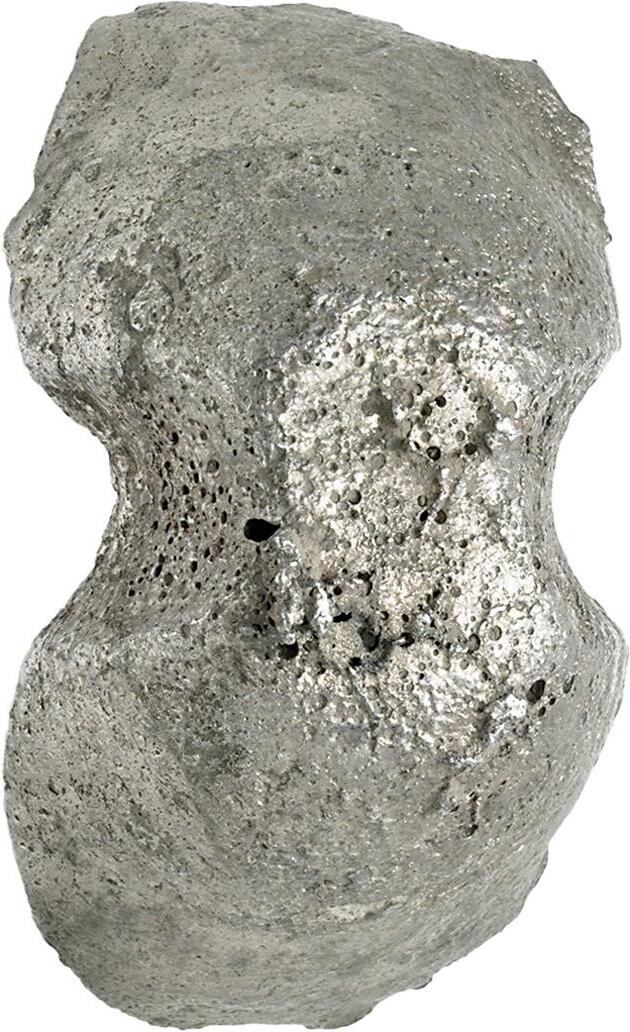
1072.
From the Norman Frank Collection.
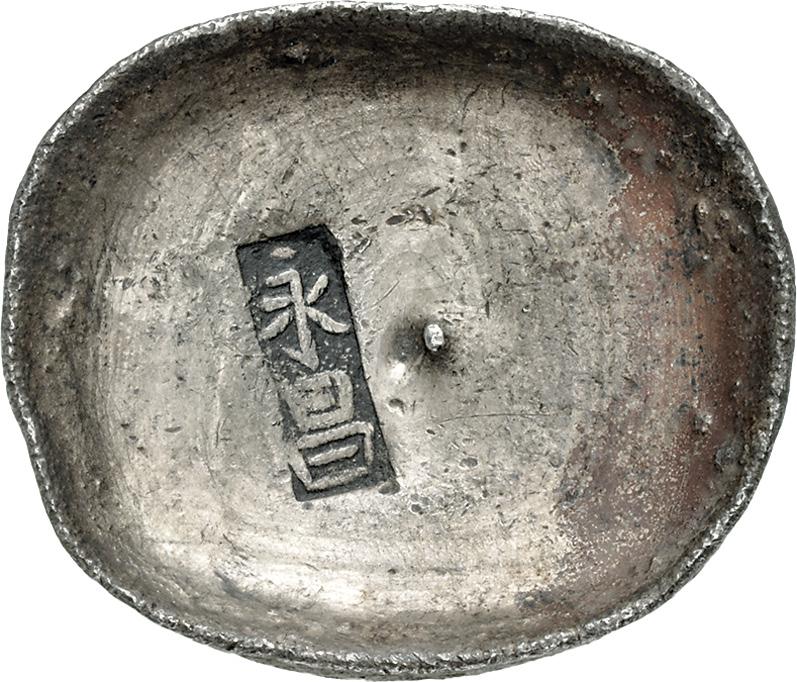
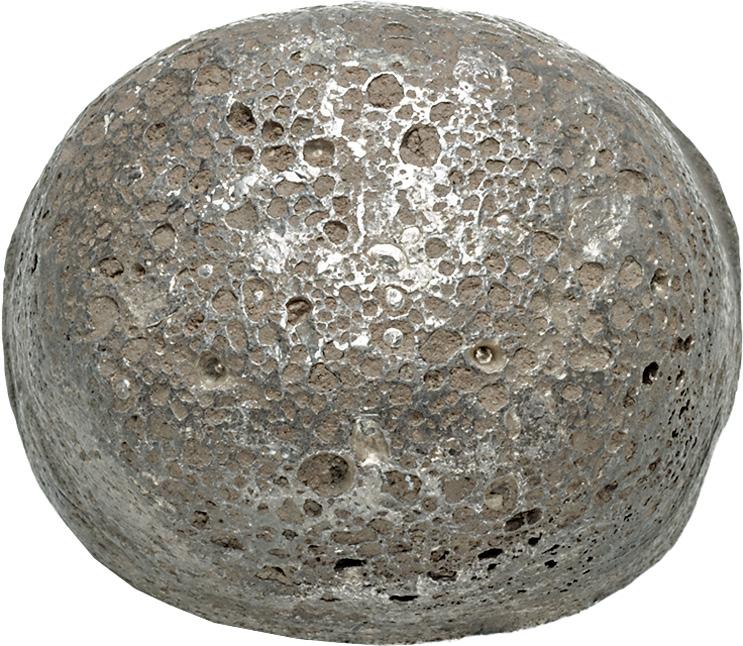
1073.
From the Norman Frank Collection.
285
CHINA, Sycee. Uncertain northern province. Qīng dynasty, late 19th-early 20th centuries. AR 10 Tael (81x48x53mm, 341.3 g). Cf. BMC, Sycee type XX (for similar shape, but with various stamps). Golden toning with traces of luster. Good VF. ($500)
CHINA, Sycee. Sìchuān Province. Qīng dynasty, late 19th-early 20th centuries. AR 12 Tael Sycee (59x52x27mm, 400.3 g). Sichuan Piaoding (Sichuan province certified ingots) type. 永昌 (Yong Chang district). BMC, Sycee type XL.F. Toned, red deposits, a few scratches. VF. ($1000)
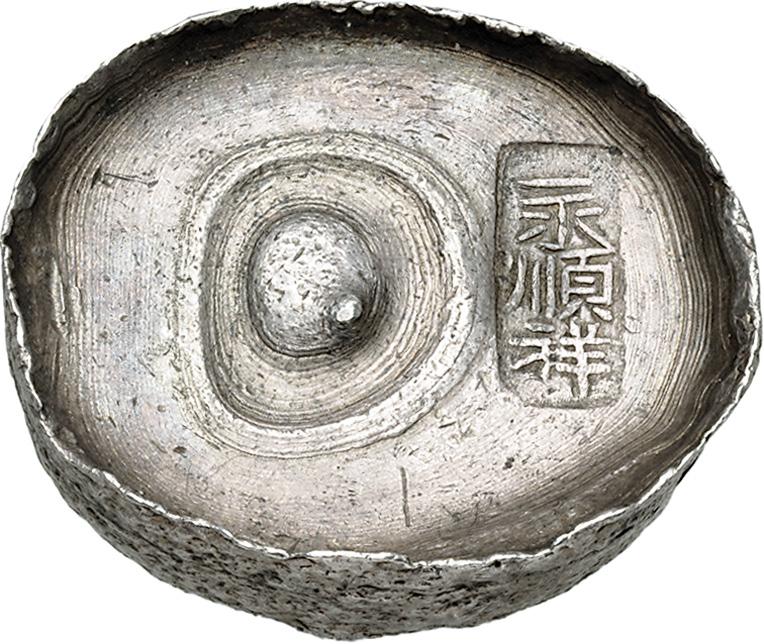
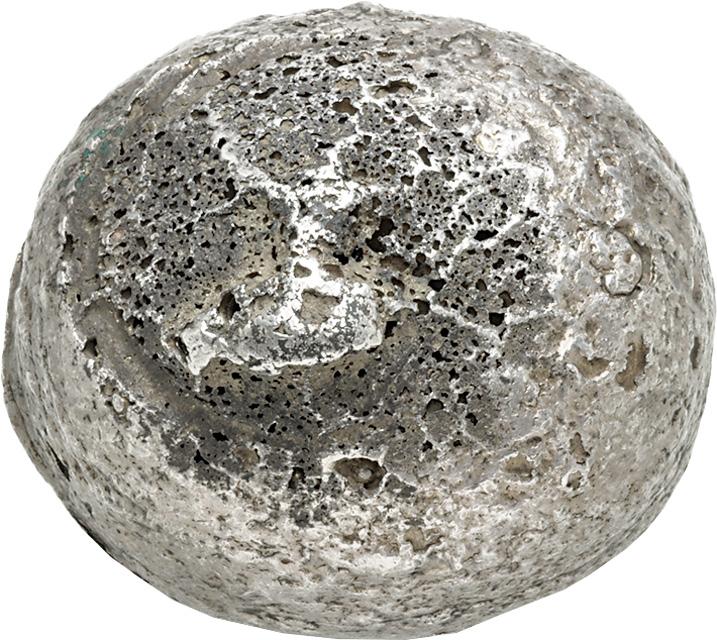
1074. CHINA, Sycee. Sìchuān Province. Qīng dynasty, late 19th-early 20th centuries. AR 10 Tael Sycee (57x59x28mm, 352.4 g). Sichuan Piaoding (Sichuan province certified ingots) type. 永顺祥 (Yong Shun Xiang [Yong Shun bank]) in single stamp. BMC, Sycee type XL.F. Toned. a few light scratches. VF. A charming example with a raised central dimple reminiscent of a shucked oyster. ($1000)
From the Norman Frank Collection.
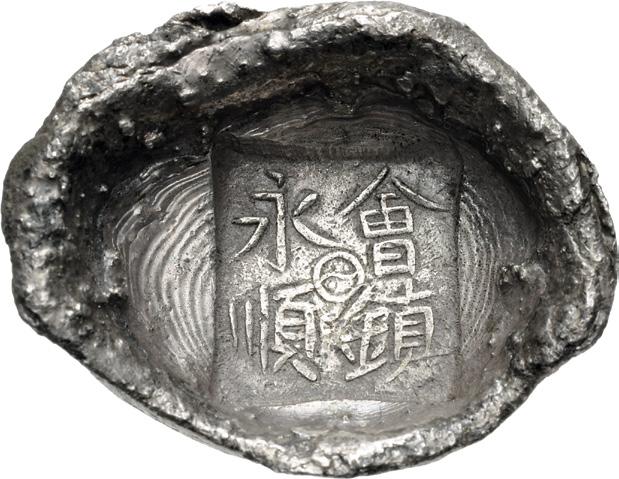

1075. CHINA, Sycee. Hénán province. Qīng dynasty, early 19th century. AR 3 Tael Sycee (46x37x25mm, 121.5 g). 会镇 (Hui Zhen) and 永顺 (Yong Shun). BMC, Sycee –. Toned. VF. ($2000)
From the Norman Frank Collection.
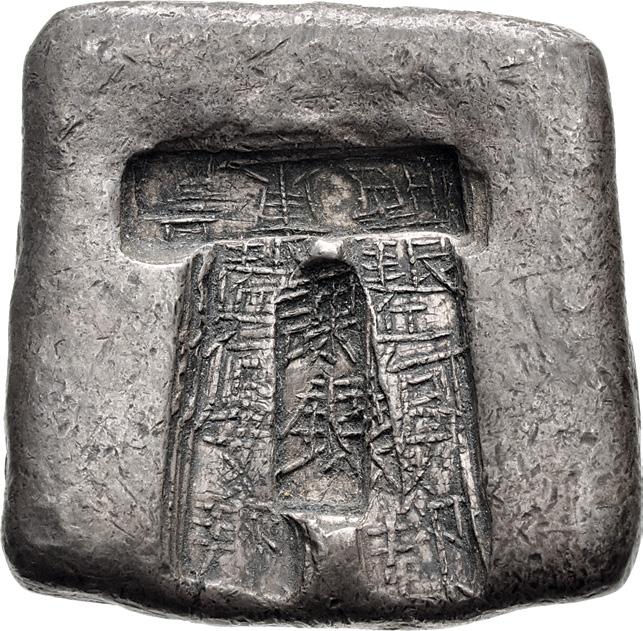
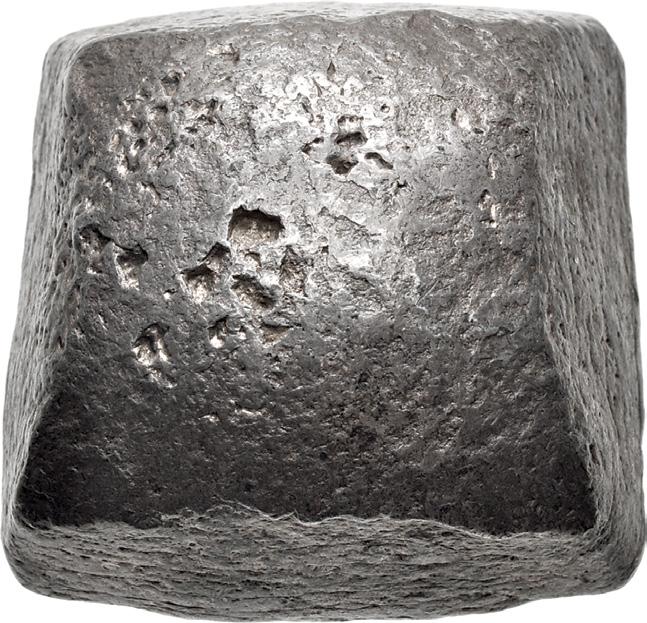
1076. CHINA, Sycee. Uncertain province. Qīng dynasty, late 19th-early 20th centuries. AR 10 Tael (49x48x22mm, 341.0 g). Fangcaoding (Square trough ingot) type. Upper stamp: 景东厅 (Jing Dong Ting [Jing Dong district]). Left and right stamps: 银匠何 忠秀 (Yin Hiang He Zhong Xiu [He Zong Xiu, silversmith]). Center stamp: 课银 (Ke Yin [Tax sycee]). Cf. BMC, Sycee type LVIII-LXII (for similar shape, but with various stamps). Toned, scattered marks. VF. ($750)
From the Norman Frank Collection.
286
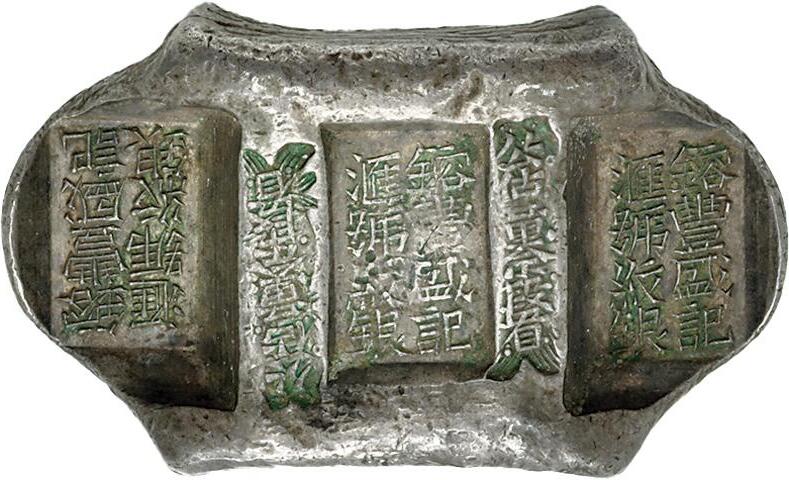
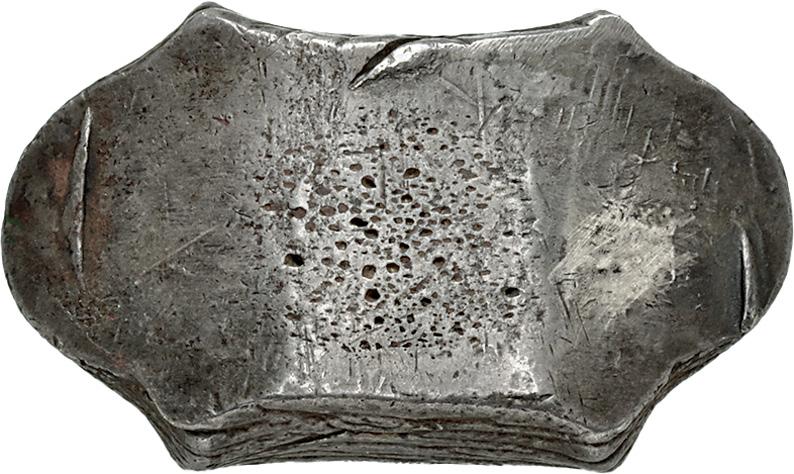
1077. CHINA, Sycee. Yúnnán province. Qīng dynasty, late 19th-early 20th centuries. AR 5.5 Tael (60x36x14mm, 185.5 g). Yunnan sanchuo paifangding (Yunnan three-stamp tablet ingot) type. Three main stamps: 镕丰盛记 汇号纹银 (Rong Feng Sheng Ji Hui Hao Wen Yi [Rong Feng Sheng Bank, remittance bank fine silver]). Two bridge stamps: 公估童佘段 看 (Gong Gu Tong She Duan Kan [Inspected by official public assayer Tong, She and Duan]). Fishtail pattern around. BMC, Sycee type LXIX. Toned, green deposits, collector’s note on back. Good VF. ($500)
From the Norman Frank Collection.
Rare Russo-Chinese Bank Sycee
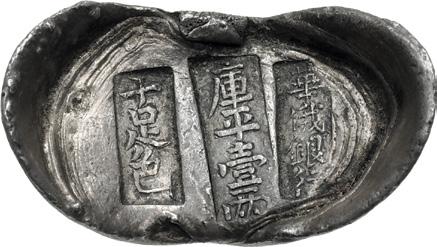
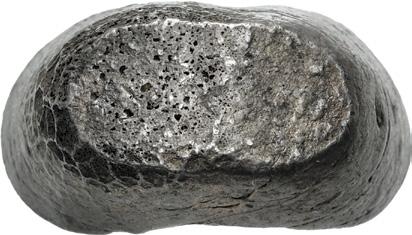
1078. CHINA, Sycee. Russo-Chinese Bank. Qīng dynasty, early 20th century. AR 1 Tael Sycee (34x18x20mm, 37.43 g). Hua-E Yinhang Xiaobao (Russo-Chinese Bank small ingots) type. Three stamps: 十足色 (Shi Zu Se [Pure quality]), 库平 一两 (Ku Ping Yi Liang [Treasury scale one tael]), and 俄银行 (Hua E Yin Hang [Russo-Chinese Bank]). BMC, Sycee type LXXXI.F. Toned. VF. ($3000)
From the Norman Frank Collection.


1079. CHINA, Sycee. Hong Kong. Xiangxin Gold Shop. Circa 1960s. AR 4 Tael – Ingot (22x81mm, 112.4 g). BMC, Sycee type XC.A, 1275. Toned, collector’s sticker on reverse. VF. ($500)
From the Norman Frank Collection.
287
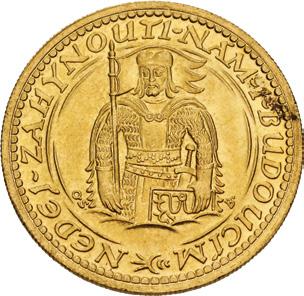

1080. CZECHOSLOVAKIA, Republic. 1918-1939. AV 2 Dukátů (34mm, 6.98 g, 12h). Kremnica mint. Dated 1933 Half-length armored bust of St. Wenceslaus, holding banner and resting hand on shield / Coat-of-arms. KM 9; Friedberg 1. In NGC encapsulation 6890896-003, graded MS 64. ($1000)
From the Alexander Christopher Collection.
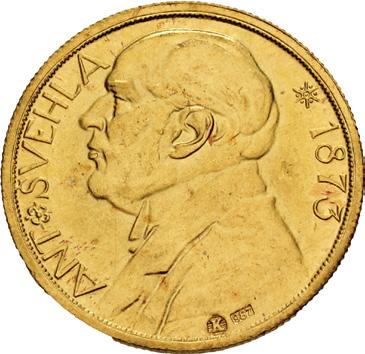

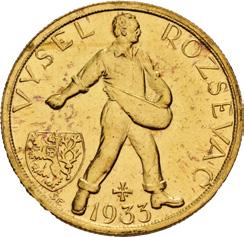
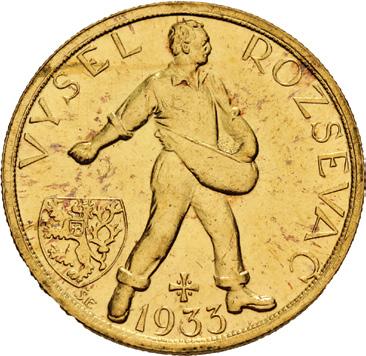
1081. CZECHOSLOVAKIA, Republic. 1918-1939. AV Medallic Dukát (20mm, 3.49 g, 12h). On the death of Prime Minister Antonín Švehla. Dated 1933. Bust of Antonín Švehla left / Male figure sowing right; coat-of-arms to lower left, cross between legs. KM (X) 16; Friedberg 12a. In NGC encapsulation 6890896-002, graded MS 63. Very rare. ($3000)
From the Alexander Christopher Collection.
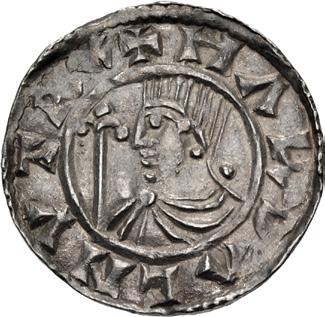


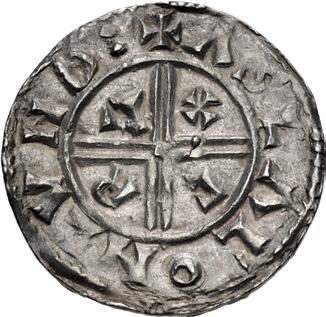
1082. DENMARK. Hardeknud (Knud III, the Hardy). 1035-1042. AR Penny (18mm, 1.09 g, 6h). Crux type. Lund mint; Aslac, moneyer. Struck circa 1040-1042. Draped bust left; trefoil-tipped scepter to left / ม ©S⌦©ü ɭn ⌦⎍nዝ Ḧ , voided short cross; ü – ʼ – ⎍ – ҟ in quarters. Becker, Coinages, dies H1/52; Becker Collection 23 (same dies); Hauberg 7; Hede –. Light golden toning, small peck on reverse. Choice EF. A superb example with lustrous surfaces. The most elegant and refined dies for all of Harthacnut’s Danish coinage. Very rare. ($4000)
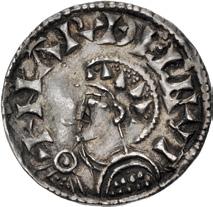
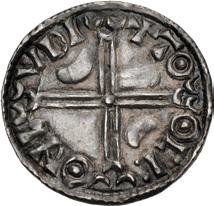
1083. DENMARK. Hardeknud (Knud III, the Hardy). 1035-1042. AR Penny (18mm, 1.08 g, 3h). Long Cross type. East Danish standard. Lund mint; Toki, moneyer. Struck circa 1040-1042. Helmeted and armored bust left / ม ˶∂ ∂üዢḦ ∂ n ⌦ ⎍ዝዢ , voided long cross with triple-crescent ends and pellet at center; crescents in first and third quarters. Becker, Coinages dies H28/226; Becker Collection 36 (this coin); cf. Hauberg 28 (for type); SCBC 1170. Toned, slightly wavy flan, peck mark. VF. ($600)
From the Causeway Collection. Ex C.J. Becker Collection (Høiland 3, 13 October 1998), lot 36.
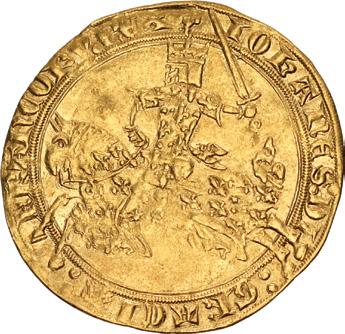
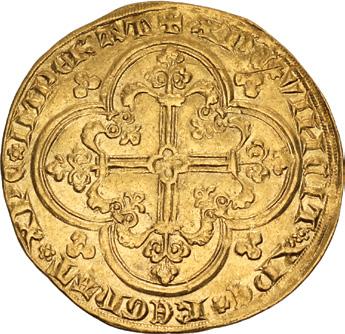
1084. FRANCE, Royal. Jean II le Bon (the Good). 1350-1364. AV Franc à cheval (28mm, 3.74 g, 12h). Authorized 5 December 1360. Jean, crowned and in full armor, left on caparisoned horse, holding sword / Cross tréflée and feuillue; at center, pellet within quadrilobe; all within quadrilobe, trefoil fleurée at end of each arc; trilobe in spandrels. Duplessy 294; Ciani 361; Friedberg 279. In NGC encapsulation 6865696-034, graded MS 62. ($2000)
288

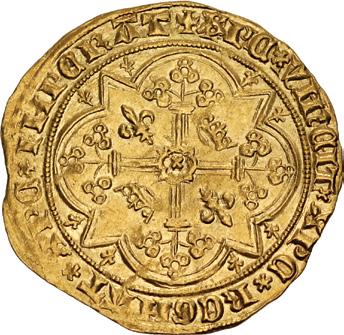
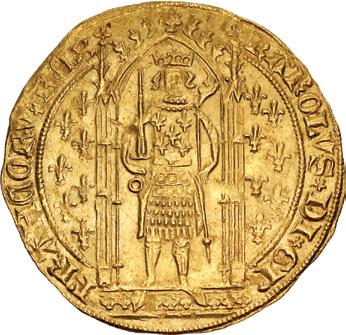
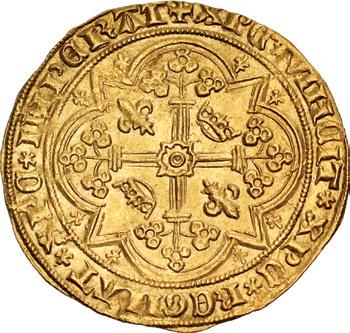
1085. FRANCE, Royal. Charles V le Sage (the Wise). 1364-1380. AV Franc à pied (28mm, 3.78 g, 4h). Authorized 20 April 1365. King standing facing within Gothic arch; semé of seven lis to left and right, holding sword with quatrefoil pommel, and main de Justice / Cross tréflée; in center of cross, quatrefoil within angled quadrilobe; lis in first and fourth quarters, crown in second and third; all within angled quadrilobe; lis in spandrels. Duplessy 360A; cf. Ciani 458-60; Friedberg 284. In NGC encapsulation 6865696-011, graded MS 63. ($1000)
1086. FRANCE, Royal. Charles V le Sage (the Wise). 1364-1380. AV Franc à pied (28mm, 3.74 g, 10h). Authorized 20 April 1365. King standing facing within Gothic arch; semé of seven lis to left and right, holding sword with annulet pommel, and main de Justice / Cross tréflée; in center of cross, pellet within angled quadrilobe; lis in first and fourth quarters, crown in second and third; all within angled quadrilobe; lis in spandrels. Duplessy 360A; cf. Ciani 461-4; Friedberg 284. In NGC encapsulation 6865696-020, graded MS 64. ($1500)
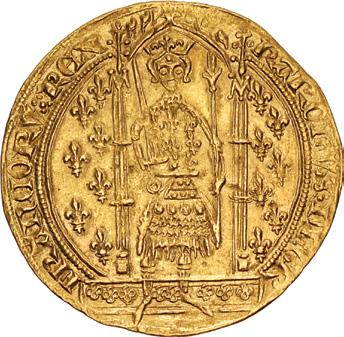
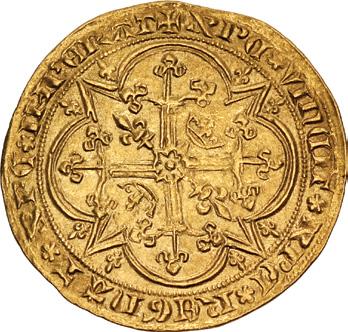
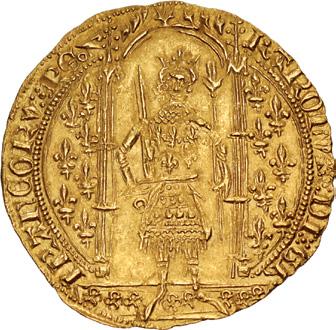
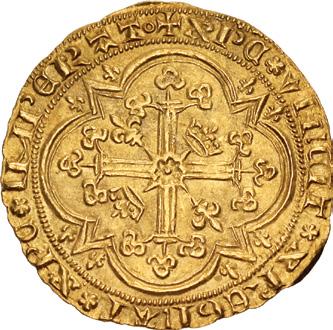
1087. FRANCE, Royal. Charles V le Sage (the Wise). 1364-1380. AV Franc à pied (28mm, 3.74 g, 10h). Authorized 20 April 1365. King standing facing within Gothic arch; semé of seven lis to left and right, holding sword with annulet pommel, and main de Justice / Cross tréflée; in center of cross, pellet within angled quadrilobe; lis in first and fourth quarters, crown in second and third; all within angled quadrilobe; lis in spandrels. Duplessy 360A; cf. Ciani 461-4; Friedberg 284. In NGC encapsulation 6865696-021, graded MS 63. ($1000)
1088. FRANCE, Royal. Charles V le Sage (the Wise). 1364-1380. AV Franc à pied (27mm, 3.78 g, 10h). Uncertain provincial mint. Struck after 1368. King standing facing within Gothic arch; semé of seven lis to left and right, holding sword with annulet pommel, and main de Justice / Cross tréflée; in center of cross, pellet within angled quadrilobe; lis in first and fourth quarters, crown in second and third; all within angled quadrilobe; lis in spandrels. Duplessy 360A/360 (obv./rev.); Ciani –; Friedberg 284. In NGC encapsulation 6865696-006, graded MS 64. ($1500)
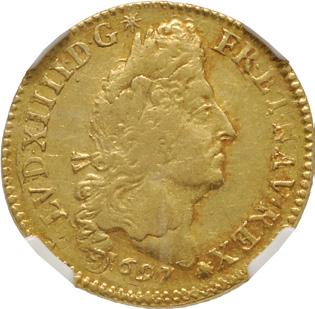
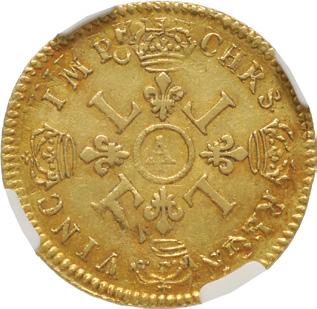
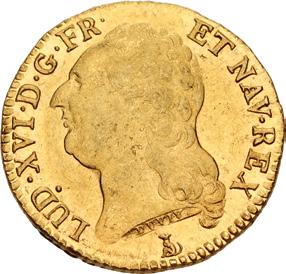

1089. FRANCE, Royal. Louis XIV le Roi Soleil (the Sun King). 1643–1715. AV Louis d’or aux quatre L (26mm, 5h). Paris mint; différent scallop. Dated 1697 A. Laureate head right / Crowned cruciform lis around central A in annulet; Ls in quarters. VG 252; Duplessy 1440A; KM 302.1; Friedberg 433. In NGC encapsulation 2790052-002, graded XF 45. ($750)
Ex Heritage 3305 (9 September 2014), lot 33310.
1090. FRANCE, Royal. Louis XVI. 1774–1793. AV Louis d’or à la tête nue (24mm, 7.66 g, 6h). Nantes mint; différents: seated greyhound/tree. Dated 1786 T. Head left / Two crowned coats-of-arms. VG 361; Duplessy 1707; KM 591.14; Friedberg 475. In NGC encapsulation 6887461-008, graded UNC Details, obv. cleaned. Highly lustrous nevertheless. ($500)
289
1085
1086
1087
1088
1089
1090
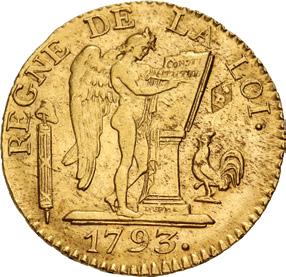

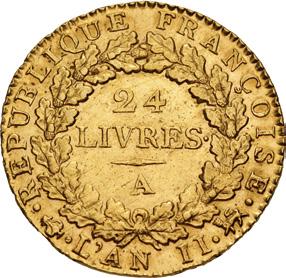
1091. FRANCE, First Republic. National Convention. 1792-1795. AV 24 Livres (24mm, 7.63 g, 6h). Paris mint; différents: leopard and lyre. Dated 1793 A. Winged genius of France standing right, inscribing tablet set on column; to left, fasces surmounted by phrygian cap; to right, rooster standing left; c/m: swan over B in lozenge / Denomination within wreath. VG 62; KM 626.1; Friedberg 478. In NGC encapsulation 6890912-012, graded UNC Details, private countermark. ($2000)
From the Alexander Christopher Collection.
The countermark on the obverse is most likely a private jeweler or goldsmith hallmark. The presence of a hallmark indicates that at least some merchants were distrustful of this type, which is not surprising, considering that this is the first gold coin of fully Republican types from France and lacks the usual portrait of a monarch on the obverse. For another example with a different hallmark, see Heritage 3019 (26 April 2012), lot 24287.



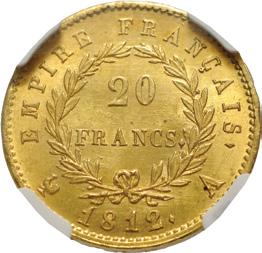
1092. FRANCE, First Empire. Napoléon I. 1804-1814. AV 20 Francs (22mm, 6h). Paris mint; différents: signature/ rooster. Dated 1808 A. Laureate head left / Denomination within wreath. VG 1025; KM 695.1; Friedberg 511. In NGC encapsulation 6887461-006, graded UNC Details, rev scratched. ($500)
1093. FRANCE, First Empire. Napoléon I. 1804-1814. AV 20 Francs (22mm, 6h). Paris mint; différents: monogram/ rooster. Dated 1812 A. Laureate head left / Denomination within wreath. VG 1025; KM 695.1; Friedberg 511. In NGC encapsulation 6846809-002, graded MS 63. ($1000)
From the James Fox Collection.
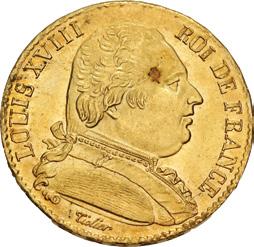

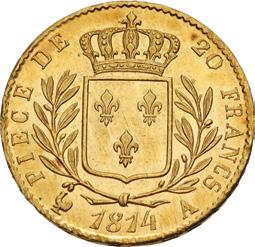
1094. FRANCE, Royal (Restored). Louis XVIII. 1814-1824. AV 20 Francs (21mm, 6.42 g, 6h). First restoration. Paris mint; différents: signature/rooster. Dated 1814 A. Bust right / Crowned coat-of-arms within wreath. VG 1026; KM 706.1; Friedberg 525. In NGC encapsulation 6890883-010, graded MS 65. ($1500)
From the Alexander Christopher Collection. 1092 1093
290

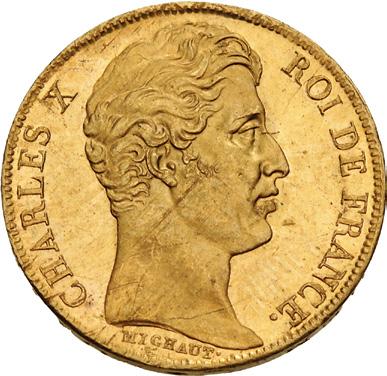
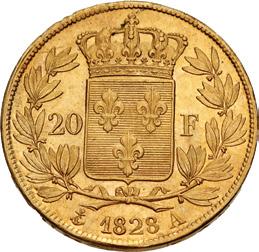
1095. FRANCE, Royal (Restored). Charles X. 1824-1830. AV 20 Francs (21mm, 6.46 g, 5h). Paris mint; différent: signature/anchor. Dated 1828 A. Bare head right / Crowned coat-of-arms within wreath. VG 1029; KM 726.1; Friedberg 549. In NGC encapsulation 6890912-009, graded MS 64. ($1000)
From the Alexander Christopher Collection.
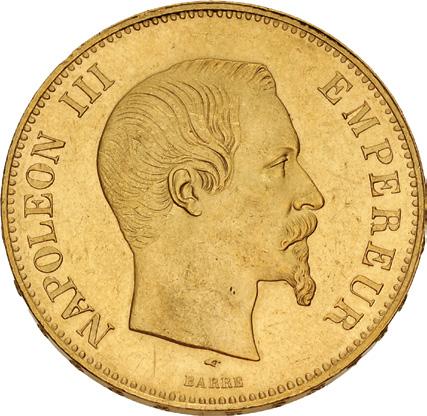

1096. FRANCE, Second Empire. Napoléon III. 1852-1870. AV 100 Francs à la tête neu (35mm, 32.26 g, 6h). Paris mint; différents: hand/anchor. Dated 1857 A. Bare head right / Crowned and mantled coat-of-arms over scepters crossed in saltire. VG 1135; KM 786.1; Friedberg 559. In NGC encapsulation 6890912-014, graded MS 62. ($1000)
From the Alexander Christopher Collection.
Very Rare Proof 10 Francs

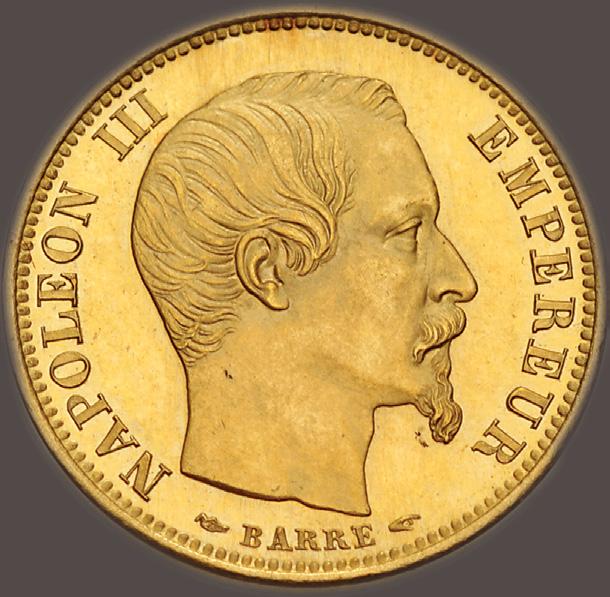
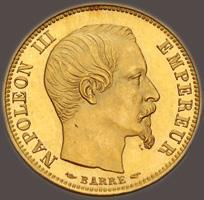

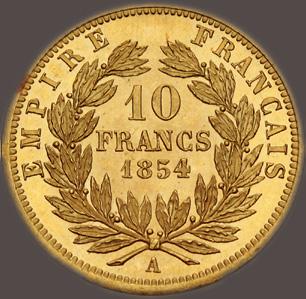
1097. FRANCE, Second Empire. Napoléon III. 1852-1870. Proof AV 10 Francs (16mm, 3.22 g, 6h). Paris mint; différents: hand and anchor. Dated 1854 A. Bare head right / Denomination and date within wreath. Edge: plain. VG 1013; KM 784.2; Friedberg 576. In NGC encapsulation 6890883-009, graded PF 64+ Cameo. Very rare. ($7500)
From the Alexander Christopher Collection. Ex Mortimer Hammel Collection (Stack’s, 15 September 1982), lot 97
Proof 10 Francs – 10 Francs flan bruni – for the year 1854 are very rare and can be distinguished by the superbly polished dies, the cameo effect on the devices, and the plain edge.
291
Selection of Early Dated Aachen Groschen
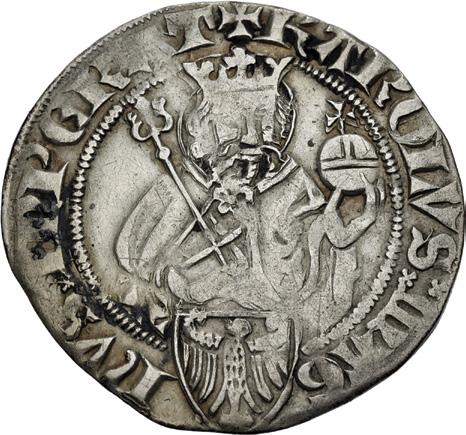
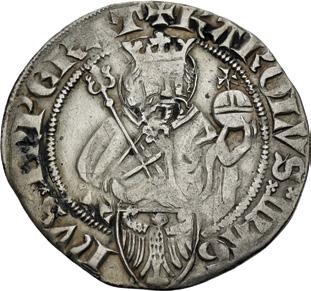

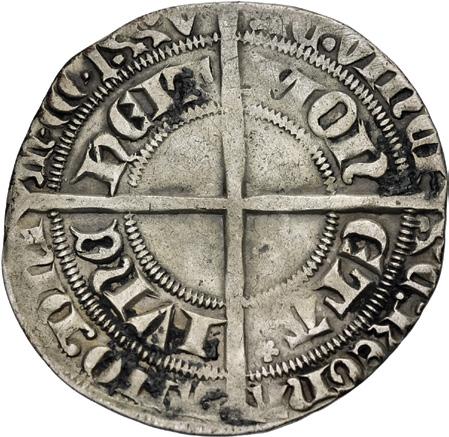
1098. GERMANY, Aachen (City). AR Groschen (26mm, 2.32 g, 2h). “Jungheit” mint. Dated 1375 (in Roman numerals). Crowned half-length bust of Charlemagne facing, head slightly right, holding trident-tipped scepter and globus cruciger; coatof-arms below / Long cross pattée. Levinson I-4a; Menadier 95. Toned, minor deposits, faint scratches. VF. Rare. Seldom offered. ($2000)
Purchased by the consignor from J. Schulman, December 1972.
The city of Aachen had been an important imperial town since the time of Charlemagne, when he spent his first Christmas there after being crowned king in 768. The chapel he ordered constructed there housed both his throne and his tomb, making the town the logical location for subsequent Carolingian coronations, and an important center for the Kings of the Germans. Consequently, Aachen remained an imperial city through much of the Middle Ages.
In 1360/1 the city was entrusted by the emperor to Wilhelm II, a member of the younger branch of the Dukes of Jülich. To commemorate this appointment in 1372, jungheitgroschen, so called from the German “Jungheit” in the legend, were minted. The inclusion of the Roman numeral date on these issues, like this specimen, make them the first dated German coinage. The meaning of “Jungheit” remains in dispute: either the term refers to the ascendancy of the younger branch in their acquisition of Aachen, or to the temporary status of the mint, independent of imperial control.

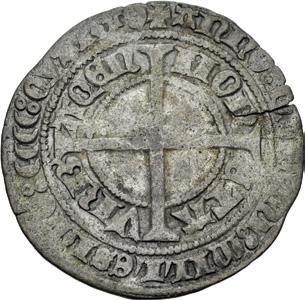
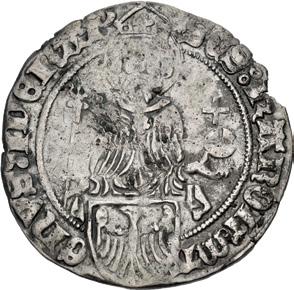

1099. GERMANY, Aachen (City). AR Groschen (25mm, 2.31 g, 11h). Aachen mint. Dated 1404 (in Roman numerals). Crowned half-length bust of Charlemagne facing, holding trident-tipped scepter and globus cruciger; coat-of-arms below / Long cross pattée. Levinson I-7; Menadier 100. Toned, minor scratches, edge split. Good Fine. ($500)
Ex Hans M.F. Schulman (25 July 1972), lot 739 (part of).
1100. GERMANY, Aachen (City). AR Groschen (24mm, 2.34 g, 6h). Aachen mint. Dated 1405 (in Roman numerals). Crowned half-length bust of Charlemagne facing, holding trident-tipped scepter and globus cruciger; coat-of-arms below / Long cross pattée. Levinson I-8; Menadier 101. Toned, scratches, deposits, slightly ragged edge. Near VF. ($750)
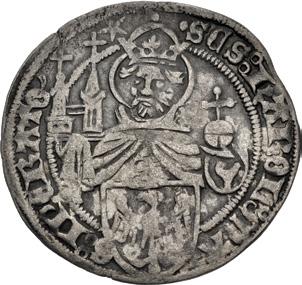
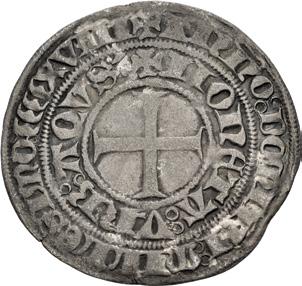
1101. GERMANY, Aachen (City). AR Groschen (25mm, 1.84 g, 6h). Aachen mint. Dated 1418 (in Roman numerals). Crowned half-length bust of Charlemagne facing, head slightly left, model of cathedral and globus cruciger; coat-ofarms below / Short cross pattée. Levinson I-13; Menadier 115. Toned, traces of horn silver, flan crack, a few scratches. VF. Rare. ($1000)
Purchased by the consignor from Bob Levinson, March 2010.
292
1099
1100
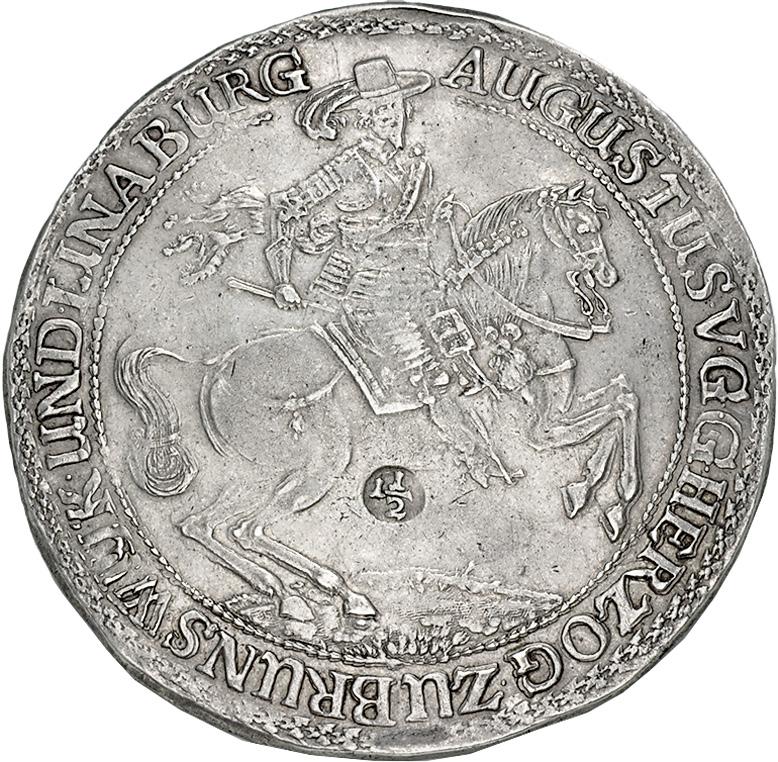
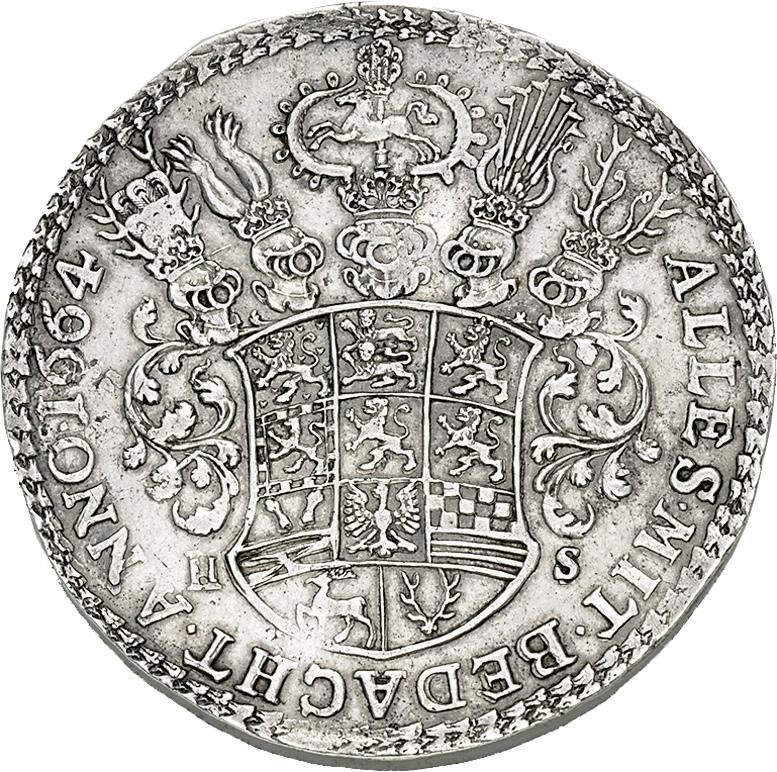
1102. GERMANY, Braunschweig-Wolfenbüttel (Principality). August the Younger. 1635-1666. AR Löser zu 1.5 Talern (63mm, 42.88 g, 6h). Zellerfeld mint. Dated 1664 HS. August on horseback right, holding baton and reins; 1½ stamped below / Coat-of-arms surmounted by five ornately crested helmets. Welter 773; Davenport 77; KM 450.4. Lightly toned, light scratches and hairlines, minor flan flaws, traces of mount. VF. ($1000)
Ex Rhenumis 6 (10 March 2022), lot 152.
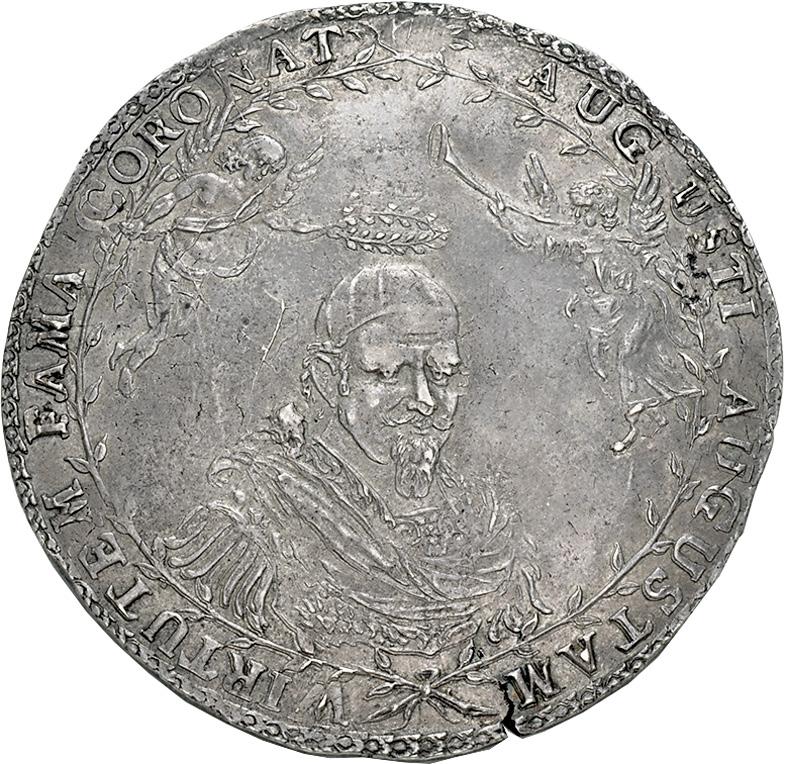
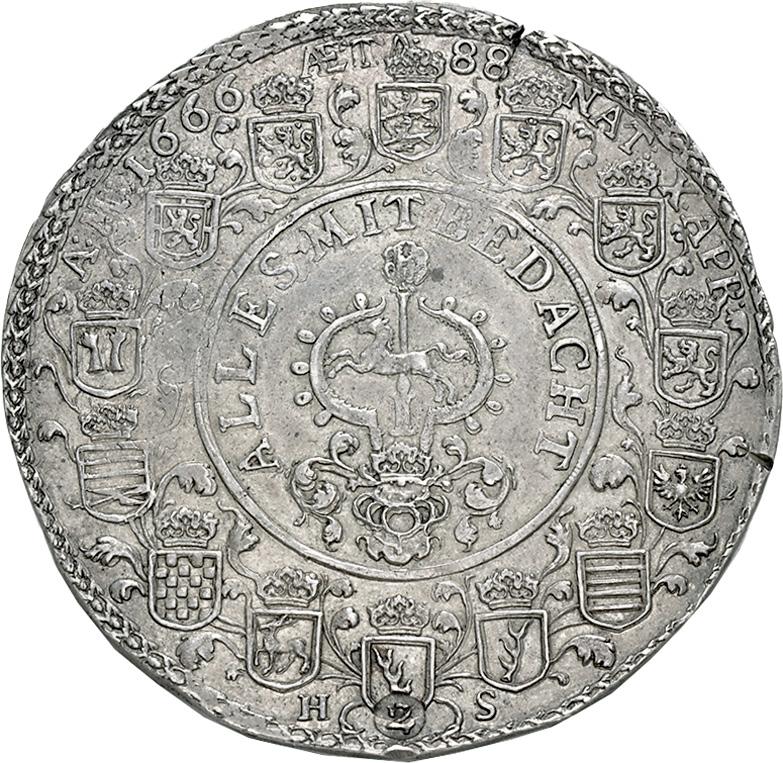
1103. GERMANY, Braunschweig-Wolfenbüttel (Principality). August the Younger. 1635-1666. AR Löser zu 2 Talern (63mm, 58.14 g, 6h). Commemorating his 88th birthday. Zellerfeld mint. Dated 1666 HS (though struck slightly later). Bust of August facing, wearing skullcap, two angels above, one crowning August, the other blowing trumpet; all within wreath / Helmet surmounted by arms of Braunschweig facing; all within wreath decorated with fourteen crowned coats-of-arms; 2 stamped below. Welter 785; Davenport 87; KM 482.1. Toned with some iridescence, flan crack, a few scratches, mount marks. Good VF. ($1000)
Ex BAC Numismatics 32 (7 September 2021), lot 398 (hammer €2500).
293
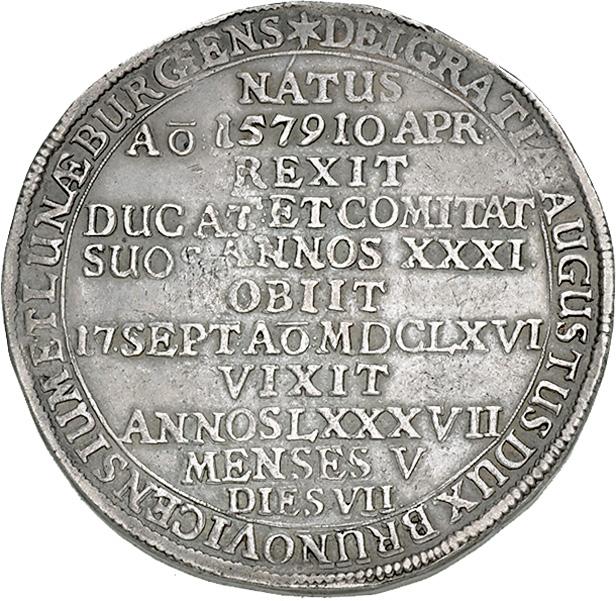
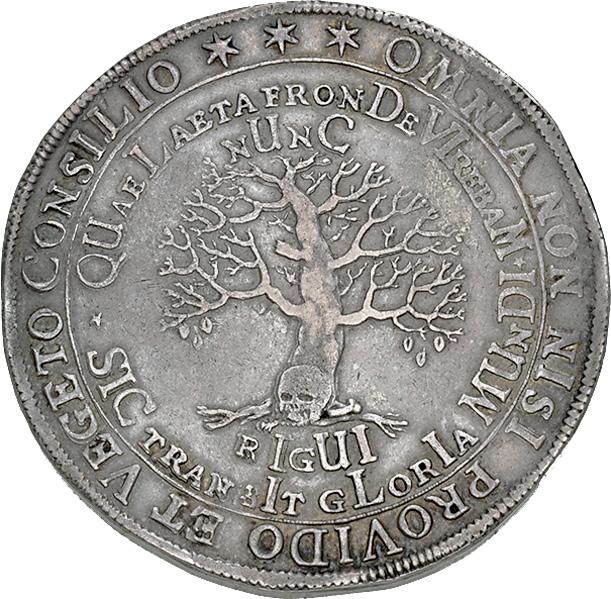
1104. GERMANY, Braunschweig-Wolfenbüttel (Principality). August the Younger. 1635-1666. AR Taler (49.5mm, 28.46 g, 8h). On his death. Zellerfeld mint. Dated 10 April 1579 and 17 September 1666. Biographical legend in eleven lines / Tree mostly bare of leaves; skull at base. Welter 824; Davenport 6376; KM 477. Toned, areas of weak strike, minor edge marks, a few scattered marks and scratches. VF. ($500)
Ex Sincona 63 (8 June 2020), lot 255.


1105. GERMANY, Braunschweig-Wolfenbüttel (Principality). Karl I. 1735-1780. AR Taler (40mm, 29.04 g, 6h).
Yield of the König Carl Mine. Clausthal mint. Dated 1752 IBH. Crowned coat-of-arms with wildman supporters / Two crowned columns flanking marker reading KC; in background, two mining surveyors, each holding stadia rod and surveying chain with level between then; above, banner reading PLVS VLTRA. Welter 2726; KM 946; Davenport 2168. Deep iridescent toning. Near EF. ($1500)
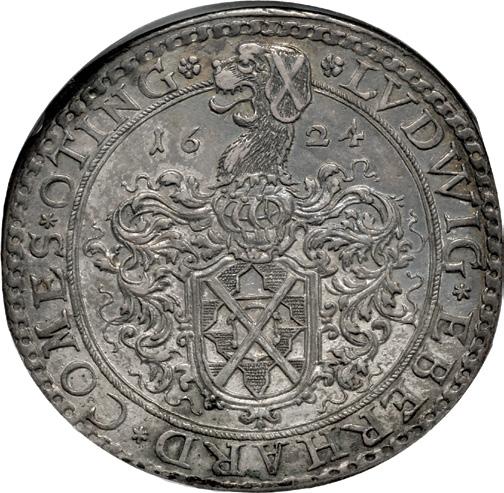
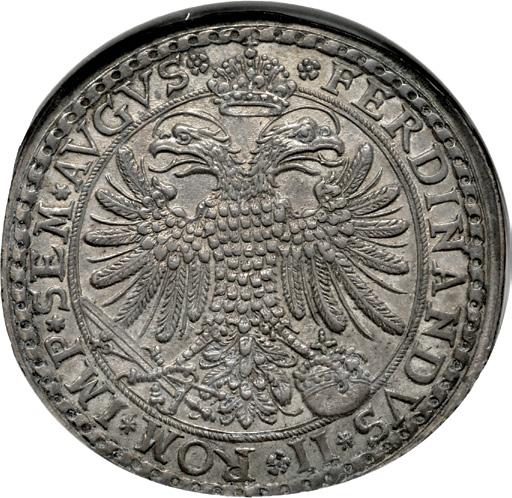
1106. GERMANY, Öttingen (County). Ludwig Eberhard. 1622-1634. AR Taler (40mm, 12h). In the name of Ferdinand II, Holy Roman Emperor. Dated 1624. Coat-of-arms surmounted by facing helmet topped by dog’s head left / Crowned doubleheaded eagle facing with wings spread, holding sword, scepter, and globus cruciger. Davenport 7136; KM 20. Attractive old cabinet toning. In NGC encapsulation 2039233-001, graded MS 61. Well struck. ($1000)
Ex Goldberg 81 (1 September 2014), lot 2159.
294
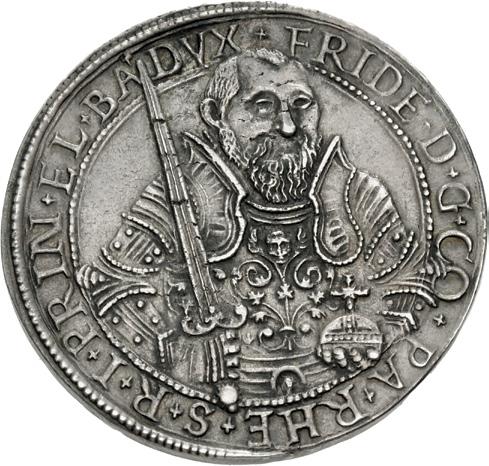
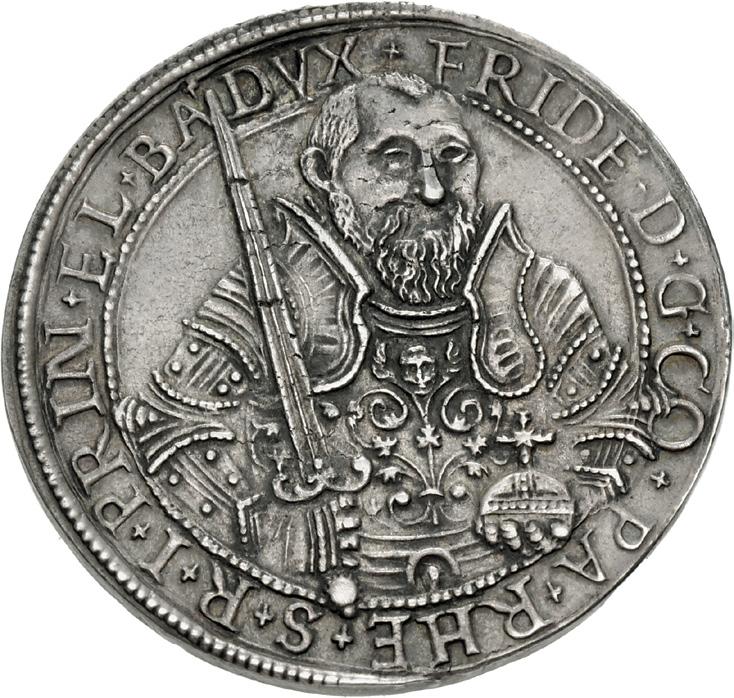
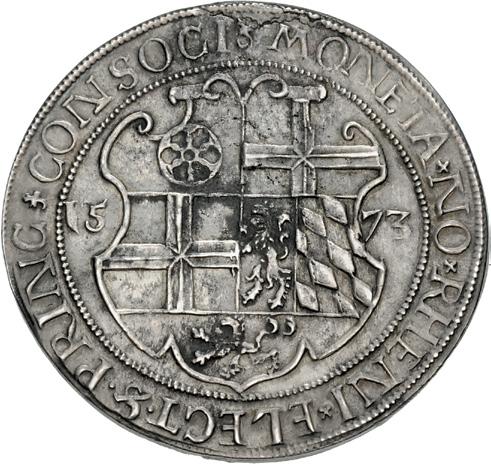
Ex Künker 140 (17 June 2008), lot 2519.
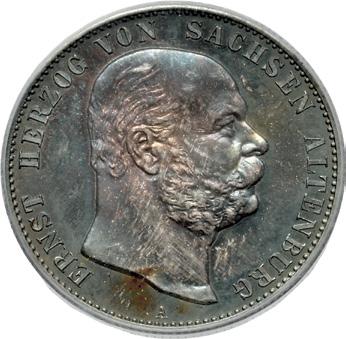
Ex Goldberg 81 (1 September 2014), lot 2162.
Top Pop

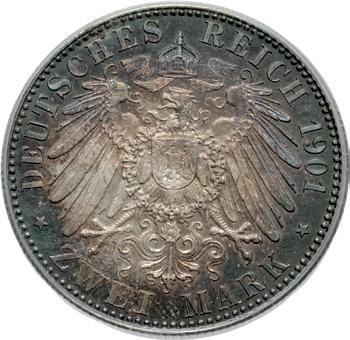
295
1107. GERMANY, Pfalz (Electorate & County Palatine). Friedrich III. 1559-1576. AR Taler (40mm, 27.65 g, 12h). Heidelberg mint. Dated 1573. Armored bust facing slightly right, holding sword and globus cruciger / Coat-of-arms. Davenport 9635. Toned, slightly weak strike, edge flaw, minor deposits. Good VF. Rare. ($2000)
1108. GERMANY, German Empire. Sachsen-Altenburg (Duchy). Ernst. 1853-1908. Proof AR 2 Mark (27mm, 12h). Berlin mint. Dated 1901 A. Bare head right / Crowned eagle facing with wings spread, head left; collared coat-of-arms on breast. Schaaf –; cf. Jaeger 142 (business strike); KM 36. Beautiful iridescent toning. In PCGS encapsulation 5496017, graded PR65. Top Pop. Only 500 minted. ($1500)
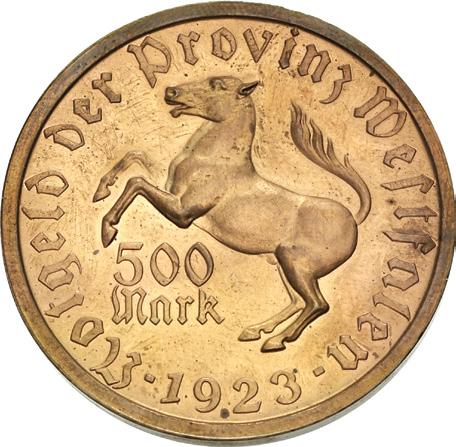


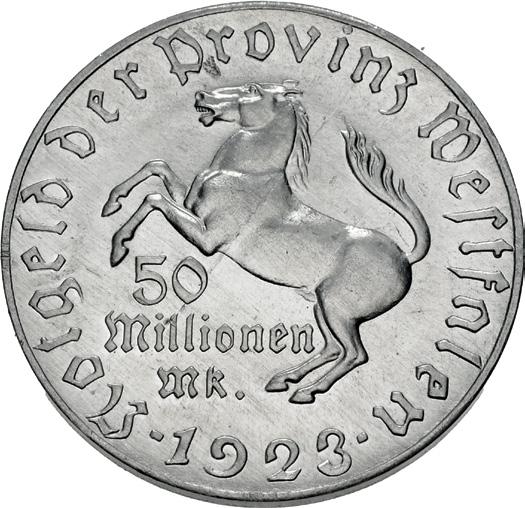
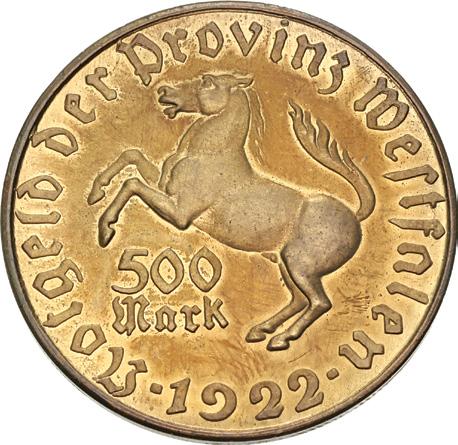
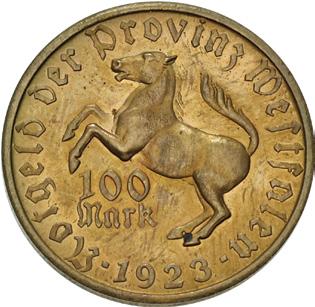
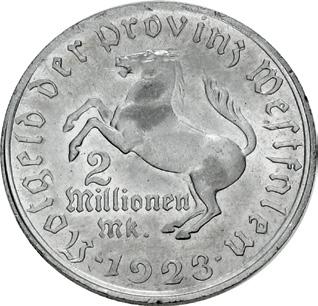

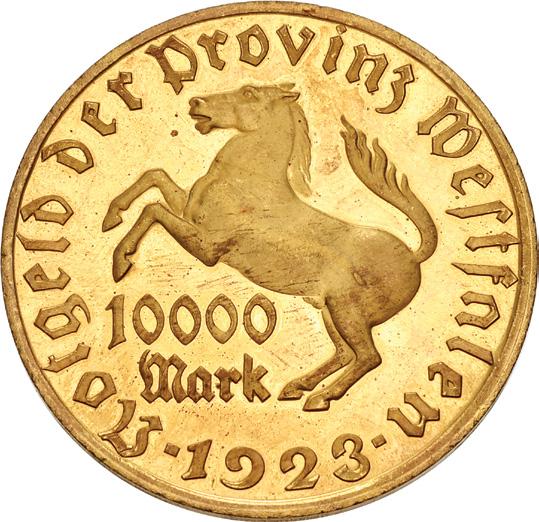
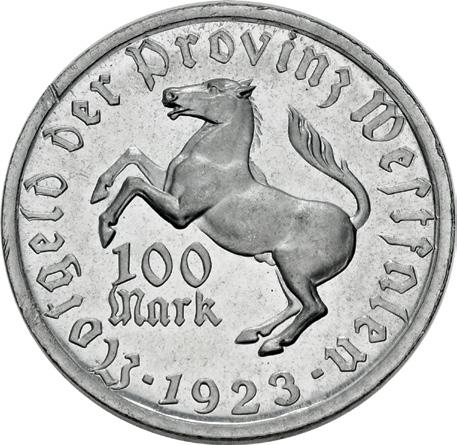
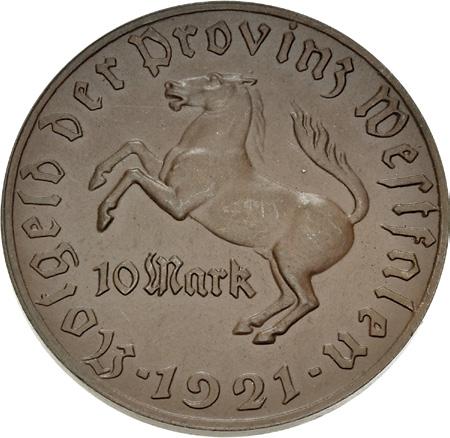
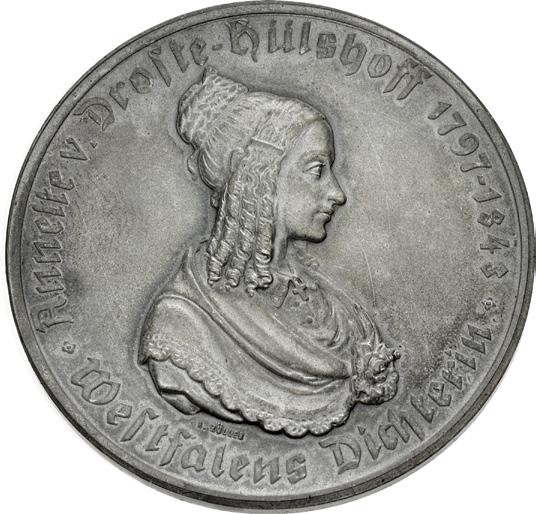
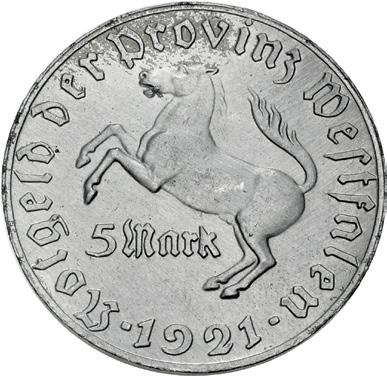
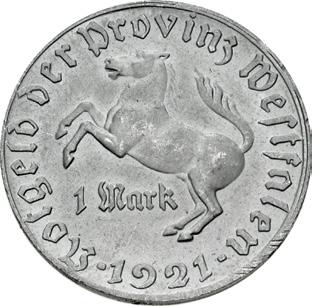

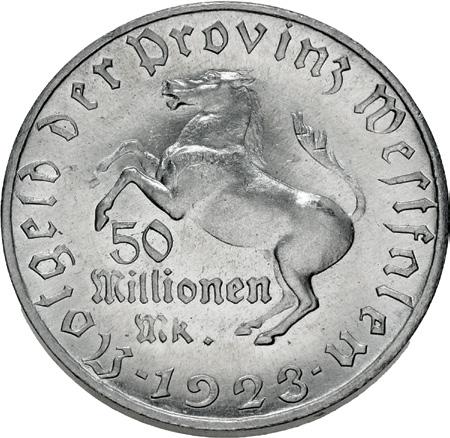
296
1109. GERMANY, Weimar Republic. 1918-1933. Set of sixteen (16) Westphalian notgeld issues. Includes: AL 1 Mark. Dated 1921 // AL 5 Mark. Dated 1921 // CU 10 Mark. Dated 1921 // AL 50 Mark. Dated 1923 // Brass 100 Mark. Dated 1922 // Dated 1823 // AL 100 Mark. Dated 1923 // Brass 500 Mark. Dated 1922 // Dated 1923 // Brass 10000 Mark. Dated 1923 // AL 2 Million Mark. Dated 1923 // Brass 5 Million Mark. Dated 1923 // AL 50 Million Mark (2, different sizes) // AR 1 Billion Mark. Dated 1923 // AR Medal. UNC. In original case of issue. A rare and impressive set. ($750) From the Libertas Collection.
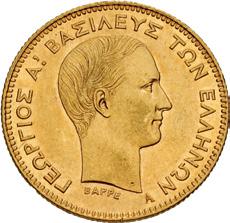
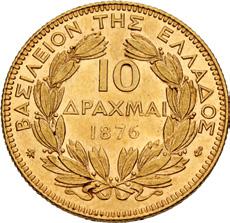
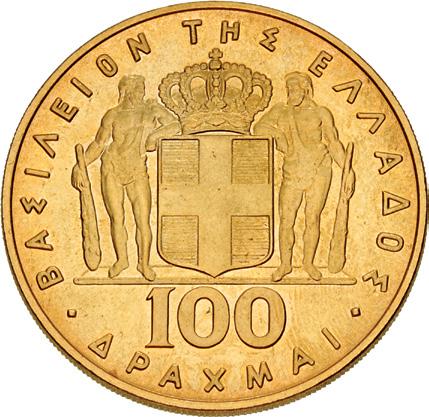
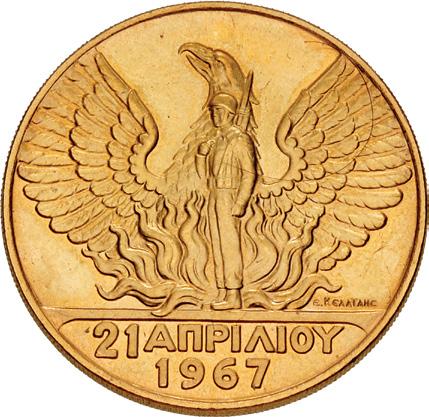
1110. GREECE, Kingdom. Georgios I. 1864-1913. AV 20 Drachmai (21.5mm, 3.22 g, 6h). Paris mint; différents: bee and anchor. Dated 1876 A. Bare head right / Crowned and mantled coat-of-arms. Karamitsos 162; Divo 48; KM 48; Friedberg 16. In NGC encapsulation 6890896-013, graded AU 58. ($1000)
From the Alexander Christopher Collection.
1111. GREECE, Kingdom. Konstantinos II. 1964-1973. AV 100 Drachmai (35mm, 32.24 g, 6h). Commemorating the 1967 Revolution. Kremnica mint. Dated 21 April 1967, though struck 1970. Crowned coat-of-arms with wildmen supporters / Soldier standing left; in background, phoenix rises from flames. Karamitsos 243; KM 95; Friedberg 21. In NGC encapsulation 6890896-009, graded MS 65. ($1000)
From the Alexander Christopher Collection.
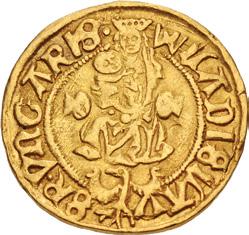

1112. HUNGARY, Kingdom of Hungary. Wladislaw II. 1490-1516. AV Goldgulden – Aranyforint (21mm, 3.57 g, 5h). Nagyszeben (Sibiu/Hermannstadt) mint. Struck 1495-1499. Crowned Holy Virgin enthroned facing, cradling Holy Infant; in exergue, raven facing with wings spread, head left; cushon tufts flanking / St. Ladislaus I standing facing, holding ax and globus cruciger; across field, n and hound with collar. Lengyel 94/13; Huszár 753; Friedberg 32. VF. ($1000)
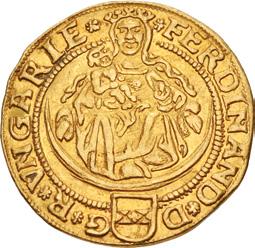
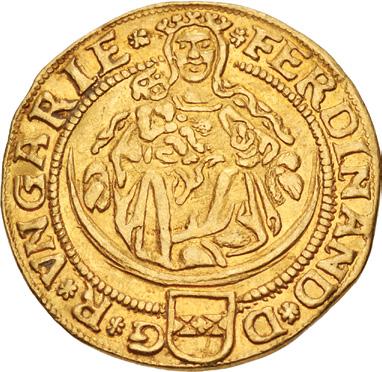
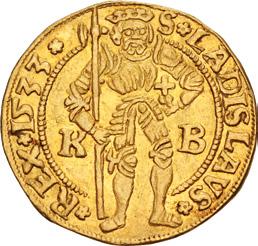
1113. HUNGARY, Holy Roman Empire. Ferdinánd I. 1526-1564. AV Aranyforint – Dukat (22mm, 3.46 g, 12h). Körmöcbánya (Kremnitz) mint. Dated 1533 K B. Crowned half-length bust of Madonna seated facing, holding Holy Infant; all set on crescent; coat-of-arms below / Crowned figure of St. Ladislaus standing facing, holding axe and globus cruciger; K-B across field. Huszár 895; Friedberg 48. Toned, some luster. Good VF. ($1500)
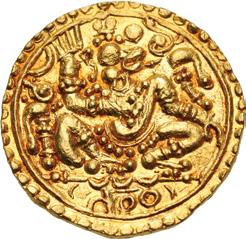
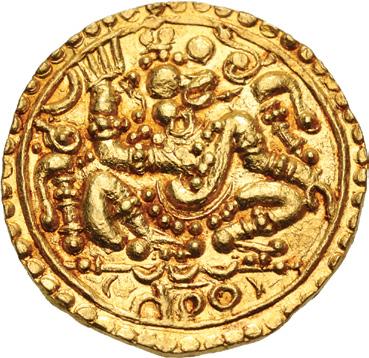

1114. INDIA, Medieval (Southern Deccan). Kadambas of Hangal. Uncertain ruler. 12th-13th centuries AD. AV Pagoda (21mm, 4.21 g). Śri Hanuman seated facing, head right; conch and ankus at feet; nakara in Kannada in exergue / Floral spray within lotus border. Chattopadhyaya 136-138; Mitchiner, South I, 229; MNI 665-6; Adams IV 85. Light reddish deposits. EF. ($1500)
Ex Classical Numismatic Group Electronic Auction 500 (22 September 2021), lot 893; Classical Numismatic Group Electronic Auction 294 (16 January 2013), lot 941.
297
1110 1111
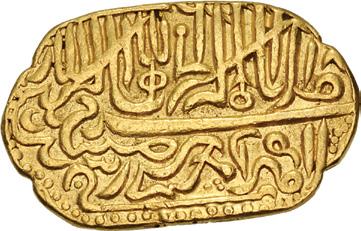

1115. INDIA, Mughal Empire. Jalal al-Din Muhammad Akbar. AH 963-1014 / AD 1556-1605. AV Mehrabi (31x20mm, 10.74 g, 12h). Later (probably jeweler’s) copy. Baldat Agra mint. Undated issue, but of 19th-20th century manufacture. Kalima and the names of the four Companions within dotted lozenge / Khallada mulkahu Jalauddin Muhammad Akbar
Padishah Ghazi; mint with epithet Baldat below. Cf. Liddle Type G-11 (dated AH 981); cf. KM 107; cf. Zeno 139472 = BM 50 (same). Traces of deposits, cleaning marks, edge marks. VF. ($1500)
Ex Spink 207 (23 March 2011), lot 981 (cleaned since).
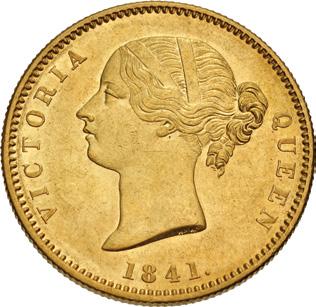
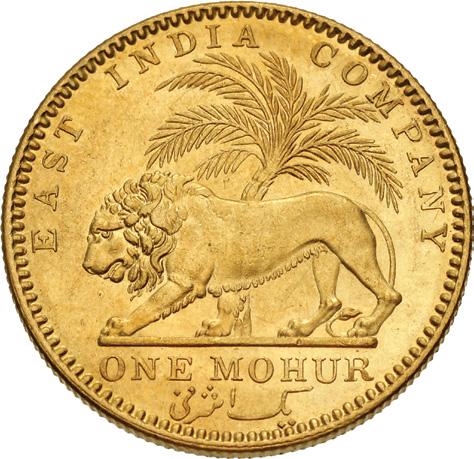
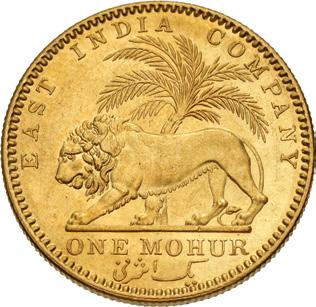
1116. INDIA, Colonial. British India. Victoria. 1837-1901. AV Mohur (25mm, 12h). East India Company Type II, Variety 1 issue. Calcutta mint. Dated 1841 (but struck 1850/1). Young head left; W · W · on truncation of neck; date below, no serif on crossbar of 4 / Lion advancing left; palm tree behind; value in English and Persian in exergue. UCI 3.7; Pridmore 22; Friedberg 1595a. In NGC encapsulation 6890896-001, graded AU Details, cleaned. ($2000)
From the Alexander Christopher Collection.
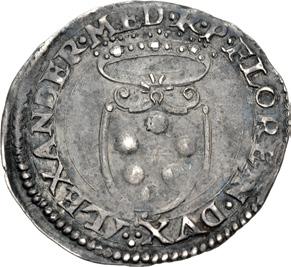
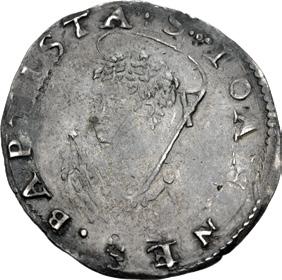
1117. ITALY, Firenze (Duchy). Alessandro de Medici. 1532-1537. AR Mezzo giulio (24mm, 1.66 g, 11h). Dies by Benvenuto Cellini. Struck 1534. Crowned coat-of-arms / Nimbate bust of St. John the Baptist facing slightly left, scepter over shoulder. MIR 105. Toned, minor deposits, a few scratches, areas of weak strike. VF. Very rare. ($2000)
From the J. Eric Engstrom Collection. Ex Aurora 10 (18 November 2017), lot 135 (hammer €5500).
Extremely Rare Genoa Zecchino of the Biennial Doges
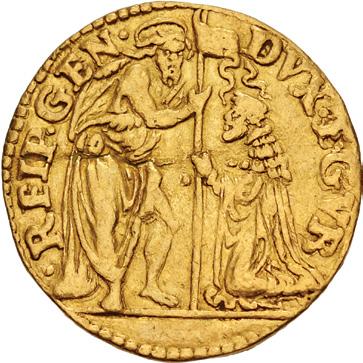
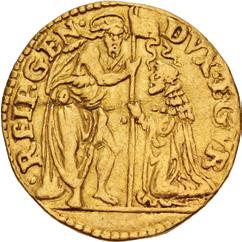

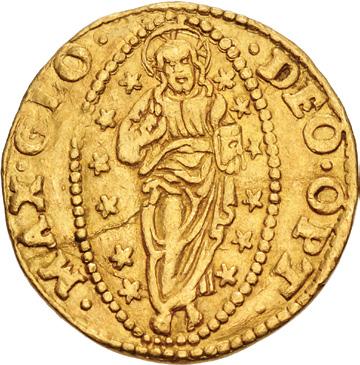
1118. ITALY, Genova. The Biennial Doges. 1528-1797. AV Zecchino (20mm, 3.56 g, 7h). Copying the types of Venice. Genova mint. Struck circa 1554. St. John standing right, presenting banner to doge kneeling left / Christ standing facing within mandorla containing twelve stars. Scarfea, Imitazioni 350; MIR 210; Friedberg 435. Toned, hairline flan crack. VF. Extremely Rare. ($10,000)
In the 16th century, the Venetian zecchino was the de facto trade coinage of the Mediterranean world. The Genovese began striking their own Venetian-style coins, including both the gold zecchino and various silver denominations, in 1554. The coins are today extremely rare. They were most likely withdrawn shortly after the initial issue, possibly due to protests from the Venetians. Other areas, particularly in India, continued to copy the zecchino with abandon, striking increasingly stylized imitations as late as the 20th century
298
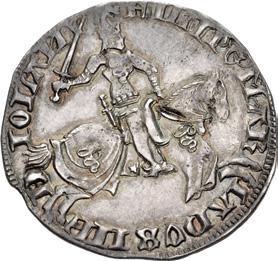
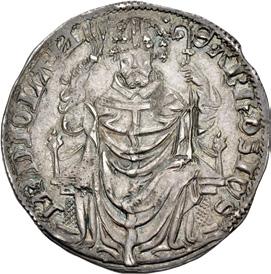
1119. ITALY, Milano (Duchy). Filippo Maria Visconti. 1412-1447. AR Grosso da 2 soldi – Berlinga (22mm, 2.12 g, 10h). Third period, high-value reform coinage. Struck 1436-circa 1438/40. Filippo on caparisoned horse right, holding sword and reins / St. Ambrosius seated facing, holding flail and crozier. MIR 155; Crippa 7; MEC 12, 675. Rich iridescent toning, tiny spot of porosity. Good VF. ($750)
From the J. Eric Engstrom Collection. Ex Nomisma S.p.a. 67 (13 April 2023), lot 516.


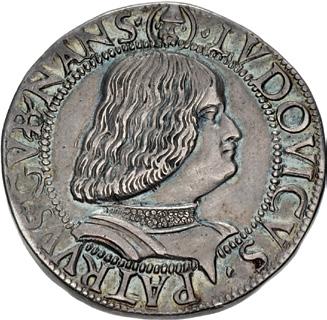
1120. ITALY, Milano (Duchy). Giovanni Galeazzo Maria Sforza, with Lodovico Maria Sforzo. 1476-1494. AR Grosso da 3 soldi (27mm, 9.55 g, 12h). Second period. Struck circa 1492/3-1494. Armored bust of Gian Galeazzo Sforza right / Armored bust of Lodovico Maria Sforza right. MIR 221; Crippa 3; MEC 12, 761. Blue and gold iridescent toning with traces of underlying luster. Near EF. A beautiful Renaissance coin with significant eye appeal. ($1500)
From the J. Eric Engstrom Collection. Impressive Medallic Type
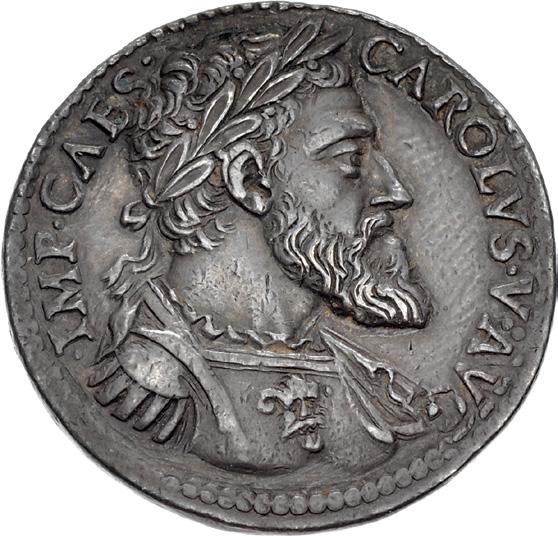

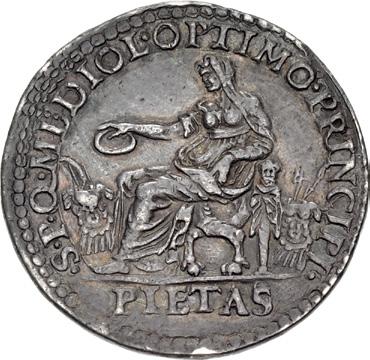
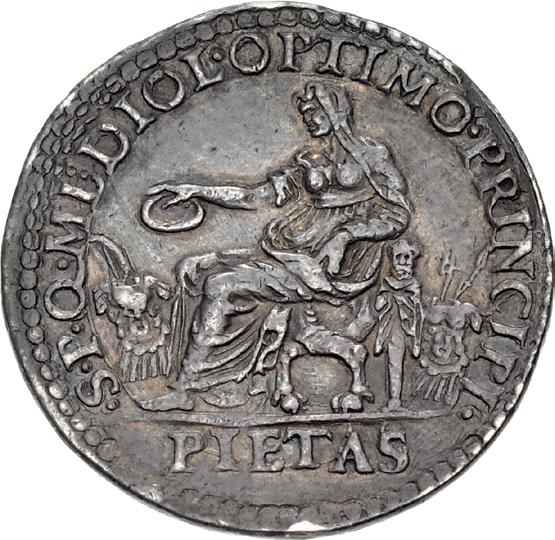
1121. ITALY, Milano (Duchy). Carlo I di Spagna (Carlo V, Holy Roman Emperor). 1535-1554. AR Medal (30mm, 11.94 g, 10h). Tribute of the Milanese Senate to the Emperor. By Leone Leoni. Struck circa 1535. CAROLVS · AVG · IMP · CAES ·, laureate, draped, and cuirassed bust right / · S · P · Q · MEDIOL · OPTIO · PRINCIPI ·, Pietas seated left on lionbacked altar, holding patera; arms and armor in background; PIETAS in exergue. MIR –; Crippa 26/B; MEC 12, 788. Old cabinet toning, chased and tooled, mount marks. Near EF. Rare. ($2000)
From the J. Eric Engstrom Collection. Ex Coin Galleries (20 October 2010), lot 767; Baldwin’s 48 (26 September 2006), lot 5070.
299
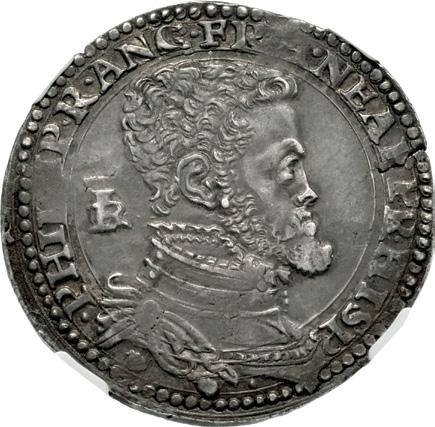
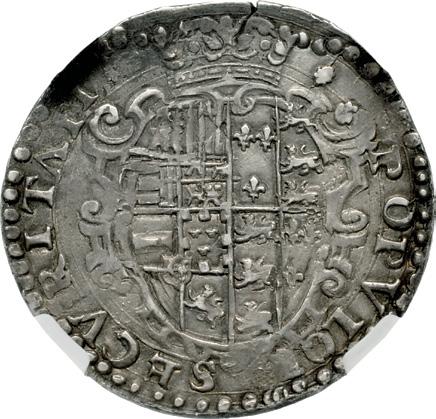
1122. ITALY, Napoli (Kingdom). Filippo II di Spagna. 1554-1598. AR Mezzo ducato (34mm, 9h). First Period. Napoli (Naples) mint. Struck 1554-1556. Bareheaded, armored, and draped bust right; (IBR) to left / Crowned coat-of-arms. MIR 160; Pannuti-Riccio 5. Old cabinet toning. In NGC encapsulation 3354656-007, graded AU 55. ($500)
From the J. Eric Engstrom Collection. Ex Heritage 3012 (2 January 2011), lot 24901.
The Only English Pope
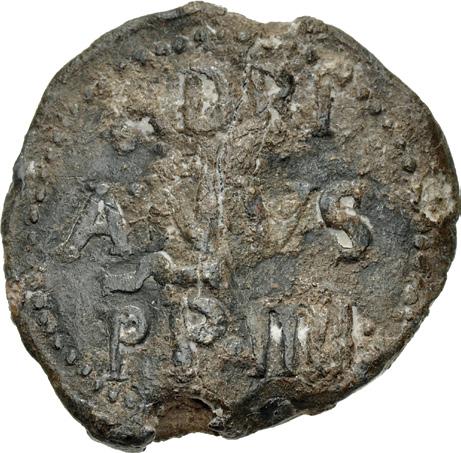

1123. ITALY, Papal (Papal state). Hadrian IV. 1154-1159. PB Seal – Bulla (36mm, 48.92 g). ADRI/ANVS/ PP • IIII • in three lines / Head of St. Peter and St. Paul facing slightly right and left, respectively; long cross between, S PA S PE above. Serafini 1. Roughness, split, deposits. VF. Very rare. ($1000)
Since no coins were issued in his name, the lead bullae of Hadrian IV are the only way to include Hardrian IV into a papal coin collection. The only Englishman elected to the throne of St. Peter, Nicholas Brekespear of St. Albans became Hadrian IV in 1154. His most famous and far-reaching papal act was the Donation of Ireland in 1156, granting Henry II of England dominion over Ireland.
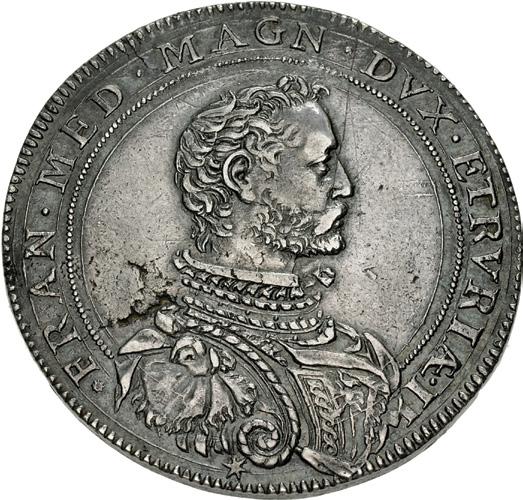
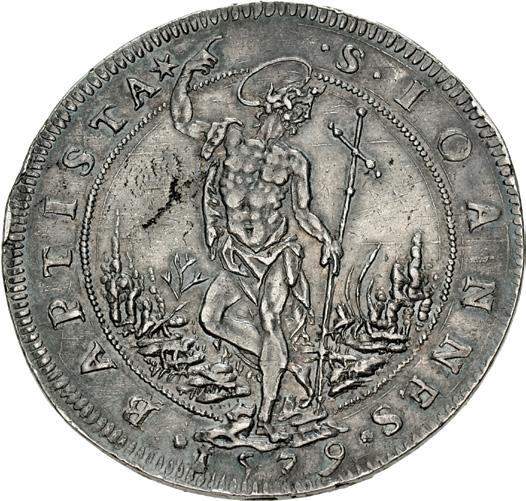
1124. ITALY, Toscana (Grand Duchy). Francesco I de Medici. 1574-1587. AR Piastra d’argento (43mm, 32.56 g, 6h). Firenze mint. Dated 1579. Draped and armored bust right / St. John the Baptist standing facing, head right, raising hand in benediction and holding long cross; forest in background. MIR 181/5; Davenport 8386. Toned, once cleaned, flan flaw, edge bumps. Good VF. Rare. ($2500)
Ex Varesi 61 (22 November 2012), lot 250.
300
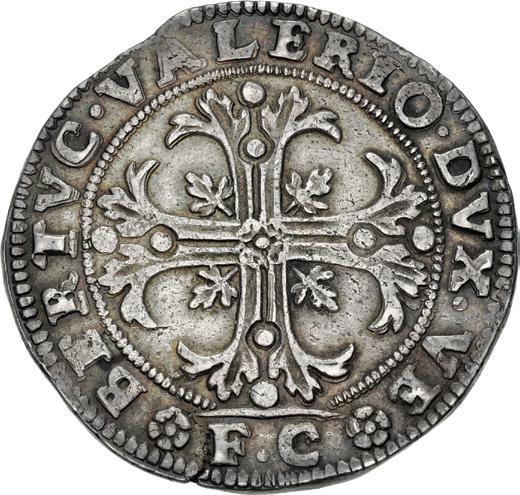
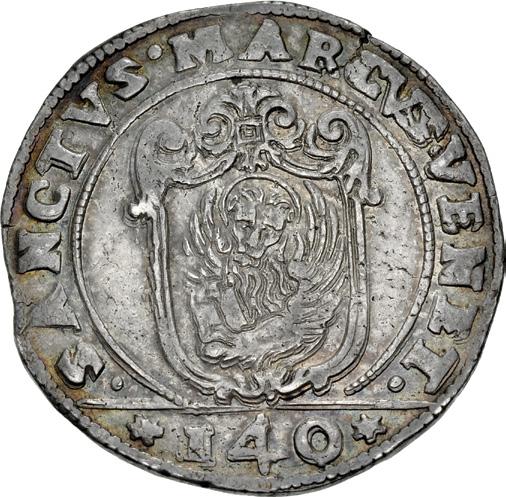
1125. ITALY, Venezia (Venice). Bertuccio Valiero. 1656-1658. AR Scudo della croce (43mm, 31.53 g, 4h). Struck 1656. Cross fleurée with leaves in quarters; F C in exergue / Coat-of-arms. Paolucci 7; Davenport 4258; KM 271. Toned with traces of iridescence and luster, a few scattered scratches, minor edge marks, edge split. Near EF. Rare. ($1000)
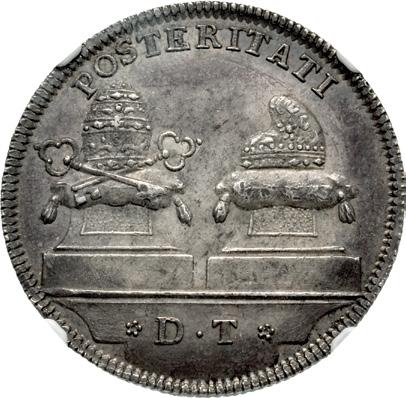
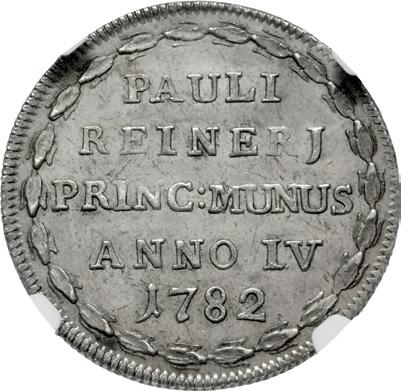
1126. ITALY, Venezia (Venice). Paolo Renier. 1779-1789. AR Osella (33mm, 9.8 g, 12h). Commemorating the visit of Pope Pius VI on his return from Vienna. Dually dated RY 4 and 1782 DT. Papal tiara atop crossed keys and corno Ducale each set on cushion and ornate base / Legend in five lines within wreath. Paolucci, Zecca 265; Werdnig 263. Toned. In NGC encapsulation 3899502-006, graded MS 63. ($750)
From the J. Eric Engstrom Collection. Ex Stack’s Bowers Galleries (9 January 2015), lot 1209.
Extremely Rare Venetian Piedfort
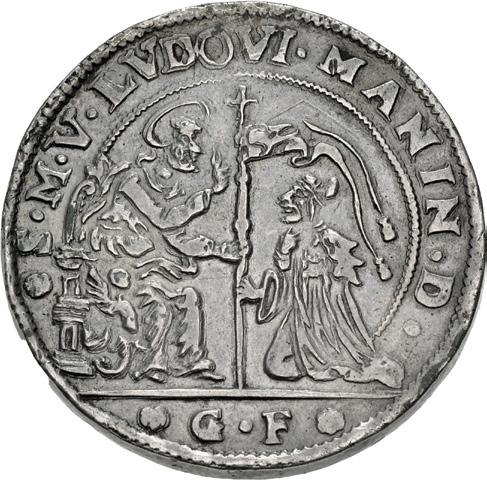

1127. ITALY, Venezia (Venice). Ludovico Manin. 1789-1797. AR Ducato di doppio peso – Piedfort (41mm, 44.49 g, 2h). Struck 1786-1789. St. Mark seated right, presenting banner to kneeling doge; G F in exergue / Lion of St. Mark standing left; three rosettes in exergue. CNI XVIII 27; Papadopoli 32 note; cf. Paolucci 28 (for regular ducato); cf. KM 746 (same). Toned, scratch, minor edge marks. VF. Very rare; this coin the finer of only two examples on CoinArchives. ($2500)
Ex Nomisma S.p.a. 63 (1 July 2021), lot 1069; Nomisma S.p.a. 60 (28 October 2019), lot 268; InAsta 73 (5 May 2018), lot 1046.
Top Pop
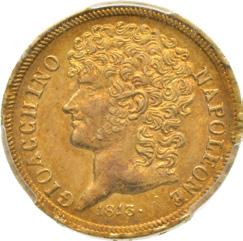
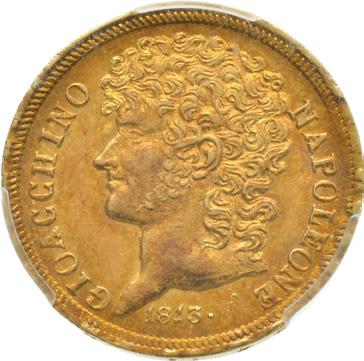

1128. ITALY, Kingdom of the Two Sicilies. Gioacchino Murat. 1808-1815. AV 20 Lire (20mm, 12h). Napoli mint. Dated 1813. Bare head right / Denomination within wreath; medium ties. MIR 440/2; Pannuti-Riccio 10; KM 264; Friedberg 860. Rich orange toning. In PCGS encapsulation 39807031, graded MS 62. Top Pop ($4000)
301
Rare Twelve-stamp Chogin

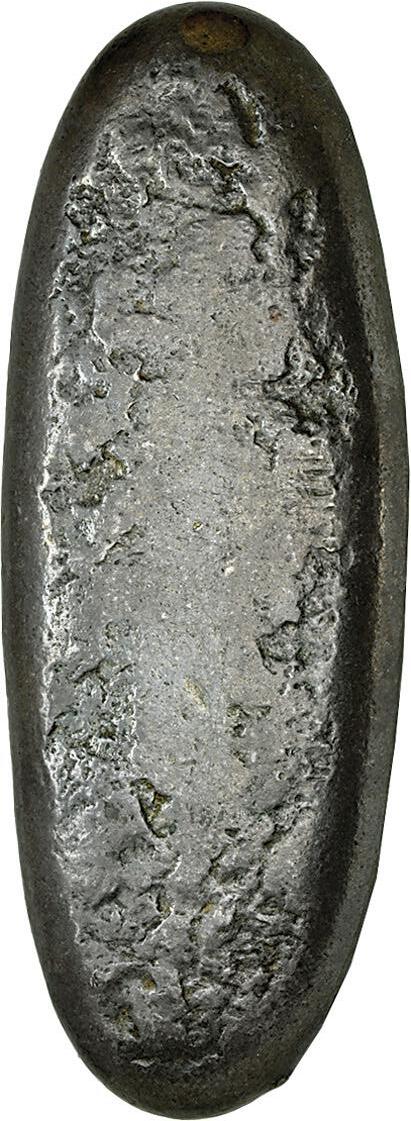
1129. JAPAN, Edo Period. Ansei Era. 1854-1860. AR Chogin (88x32.5mm, 161.55 g). Edo (Tokyo) mint. Struck 18591865. Sei in Kanji characters within circular stamps at extremities; twelve rectangular stamps depicting Daikoku (God of Wealth) around with five flanking on each side and one at end of each extremity / Rough textured surface. Hartill, Japanese 9.58; SCJC 05-12-2; JNDA 09-69. Dark toning with lighter golden toning in devices, minor marks. VF. Rare with twelve Daikoku stamps. ($5000)
From the Norman Frank Collection.
Ansei era chogin with twelve Daikoku stamps are extremely rare, with only one example in CoinArchives: Ginza 29 (18 November 2017), lot 158 (hammer ¥1,150,000).

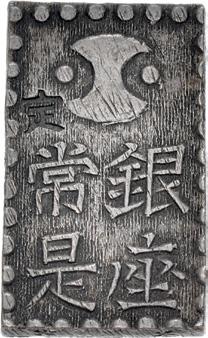
1130. JAPAN, Edo Period. Ansei Era. 1854-1860. AR Boeki Ni Shu (16x28mm, 13.60 g, 12h). Edo (Tokyo) mint. Struck 1859. Ni Shu Gin (2 Shu Silver) in Kanji characters / Fundo symbol over Ginza Joze in Kanji characters; Jo (Guaranteed) stamped to left. Hartill, Japanese 9.88; SCJC 04-08; JNDA 09-56. Toned. In PCGS encapsulation 49045604, graded AU 58. ($500)
From the Norman Frank Collection.
302
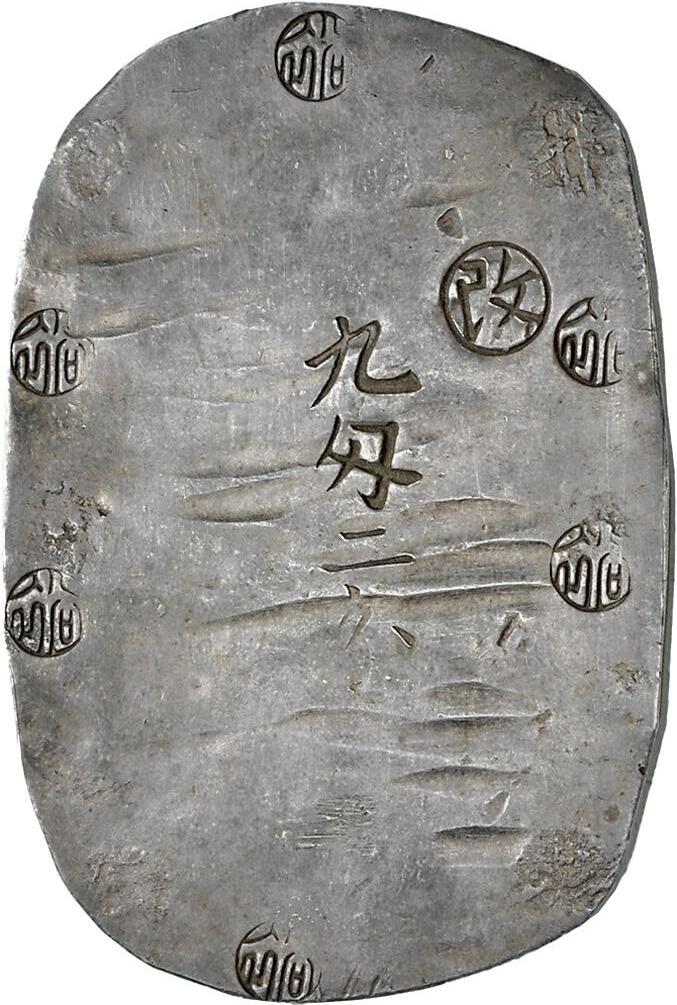
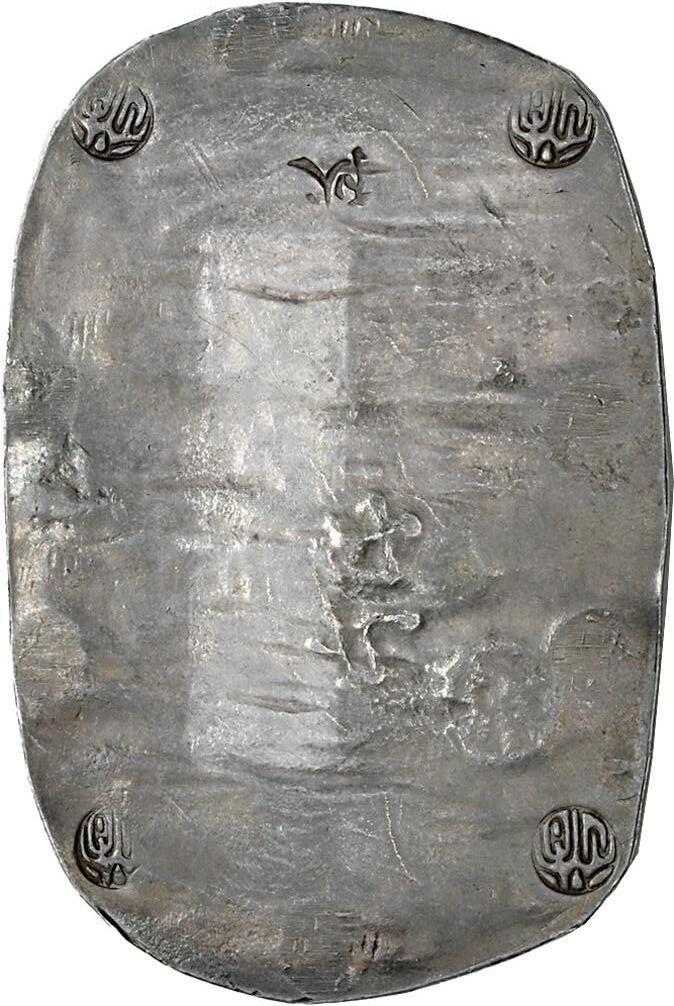
1131. JAPAN, Provincial coinage. Akita. Early 1860s. AR 9 Momme 2 Bu (56x81mm, 35.26 g, 12h). Kyu Momme Ni Bu (9 Momme 2 Bu) stamped in Kanji characters; around, Kai (Revised) and Yu (Abundant) in Kanji characters in incuse stamps / Aki (Akita) stamped in Kanji characters; Yu (Abundant) in Kanji characters in incuse stamps. Hartill, Japanese 9.90; SCJC 06-2-21; JNDA 09-71. Toned, old tape removed. Near EF. ($500)
From the Norman Frank Collection.

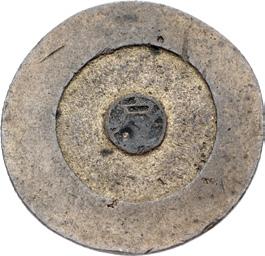
1132. KOREA, Joseon dynasty. Gojong (Gwangmu). As King, 1863-1897. AR Chon (21mm, 3.98 g, 12h). Hojo (Treasury Department) mint. Cast 1882. Tae Dong Il Chon in Hanja characters / Ho in Hanja characters; black enamel center. Hartill, Korean 65.1; KM 1081. Toned. In PCGS encapsulation 49045615, graded AU 55. ($500)
From the Norman Frank Collection.
303

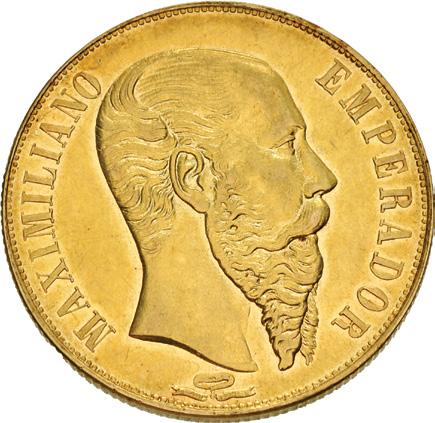
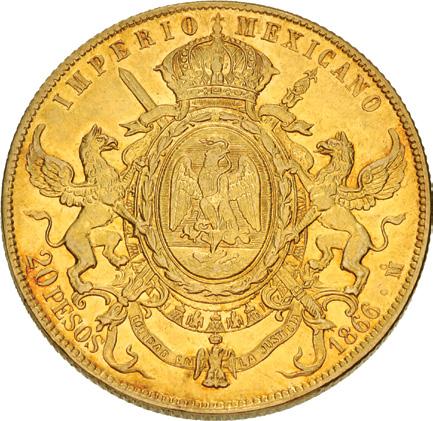

1133. MEXICO, Second Mexican Empire. Maximilian I. 1864-1867. AV 20 Pesos (35mm, 33.73 g, 6h). Mexico City mint. Dated 1866 Mo. Bare head right / Crowned coat-of-arms over scepter and sword crossed in saltire; with griffin supporters. BW 23 (Variety 3); KM 389; Friedberg 62. Toned. In NGC encapsulation 6890912-015, graded AU 55. Very rare. Reported mintage of only 8274 pieces. ($4000)
From the Alexander Christopher Collection.
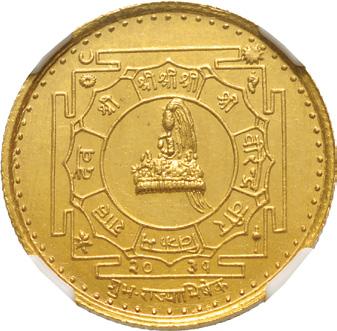
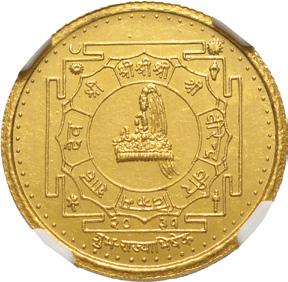
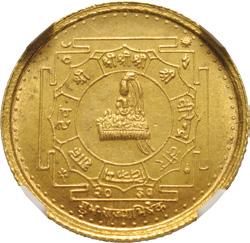
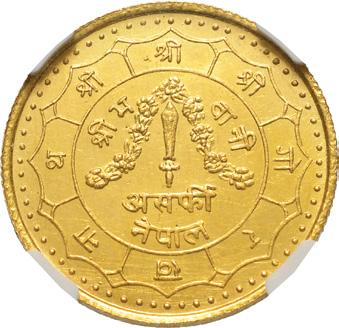
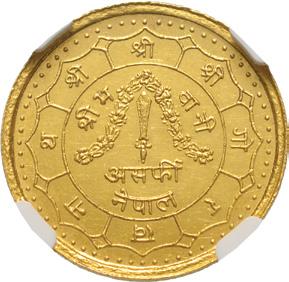
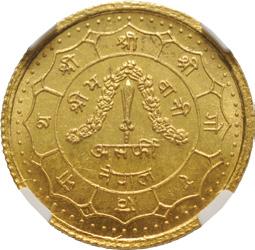
1134. NEPAL, Shah dynasty. Virendra Vira Vikrama. VS 2028-2058 / AD 1971-2001. Set of three (3) gold coins. Coronation. Dated VS 2031 (AD 1974). All coins: Shriprech (Nepalese royal crown) left within ornate border with legend / Garland over sword within ornate border with legend. Includes:
a) AV 10 Gram Asarfi. KM 829a; Fridberg 44. In NGC encapsulation 4863673-015, graded MS 64.
b) AV 5 Gram Asarfi. KM 822a; Friedberg 45. In NGC encapsulation 4863673-014, graded MS 63.
c) AV 2.5 Gram Asarfi. KM –; Friedberg 46. In NGC encapsulation 4863673-013, graded MS 64+.
Three (3) coins in lot. An attractive matching set. ($1500)
304
a b c
Two Very Rare Proof Gold Próbas
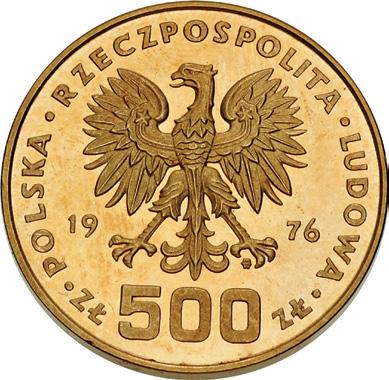
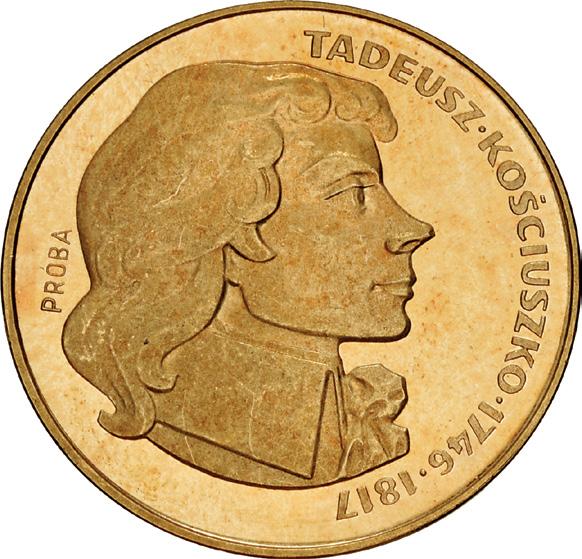
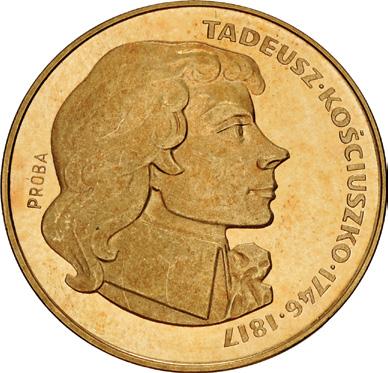
1135. POLAND, People’s Republic of Poland. 1952-1989. Proof Próba AV 500 Złotych (31mm, 29.90 g, 12h). Commemorating Tadeusz Kościuszko. Warsaw mint. Dated 1976 MW. Eagle facing with wings spread, head left / Bust of Tadeusz Kościuszko right. Parchimowicz P454a; KM Pr289; cf. Friedberg 117 (for regular issue). In NGC encapsulation 6890893-012, graded PF 65 Ultra Cameo. Mintage of only 300. ($1500)
From the Alexander Christopher Collection.
The Warsaw mint regularly produces “próba” strikes, special proof issues marked with the word PRÓBA, for sale to collectors. Nickel specimens are more common, but the gold specimens were struck in very limited numbers. Only 300 were produced for this and the following lot.
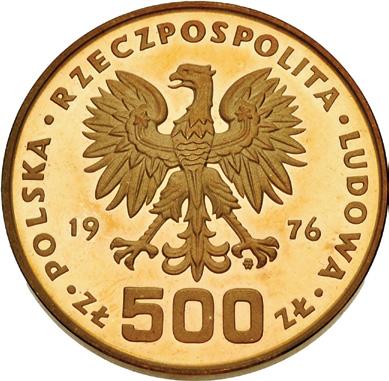
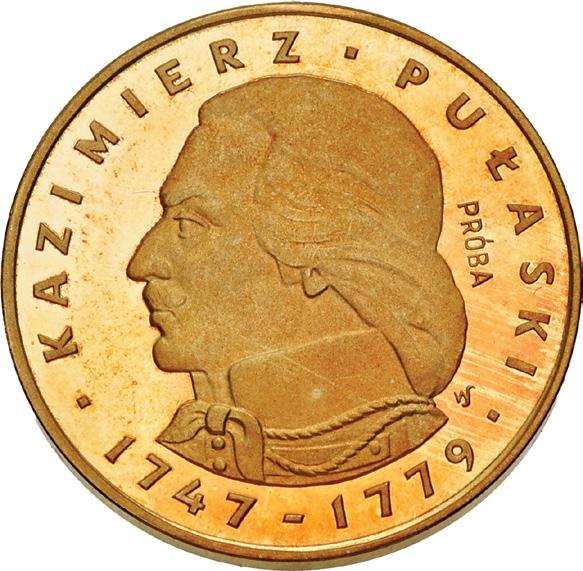

1136. POLAND, People’s Republic of Poland. 1952-1989. Proof Próba AV 500 Złotych (31mm, 29.90 g, 12h). Commemorating Kazimierz Pułaski. Warsaw mint. Dated 1976 MW. Eagle facing with wings spread, head left / Bust of Kazimierz Pułaski left. Parchimowicz P456a; KM Pr292: cf. Friedberg 118 (for regular issue). In NGC encapsulation 6890893-011, graded PF 68 Ultra Cameo. Mintage of only 300. ($2000)
From the Alexander Christopher Collection.
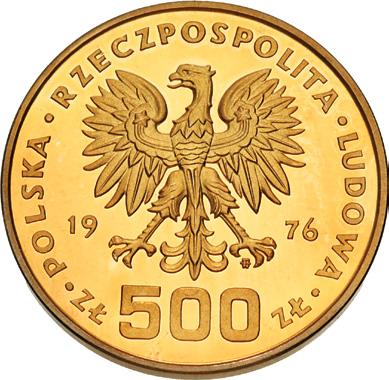


1137. POLAND, People’s Republic of Poland. 1952-1989. Proof AV 500 Złotych (31mm, 29.90 g, 12h). Commemorating Kazimierz Pułaski. Warsaw mint. Dated 1976 MW. Eagle facing with wings spread, head left / Bust of Kazimierz Pułaski left. Parchimowicz 321; KM (Y) 85: Friedberg 118. In NGC encapsulation 6890893-010, graded PF 68 Ultra Cameo. ($1000)
From the Alexander Christopher Collection.
305
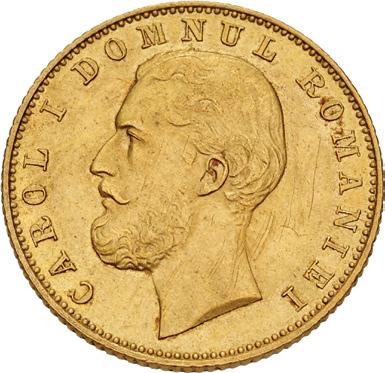
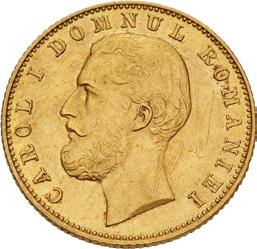
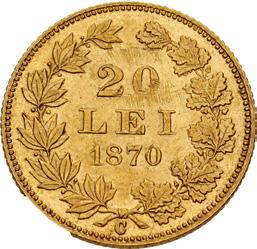

1138. ROMANIA, Principality. Carol I. As Domnitor, 1866-1881. AV 20 Lei (22mm, 6.44 g, 6h). Bucharest mint. Dated 1870 C. Bare head left / Denomination and date within wreath. MBR 24; KM 7; Friedberg 2. In NGC encapsulation 6890893009, graded UNC Details, scratches. Very rare. Mintage of 5000 ($2500)
From the Alexander Christopher Collection.


1139. SCANDINAVIA. 11th century AD. AR Penny (18.5mm, 1.41 g). Imitating a Pointed Helmet type of Cnut. Struck after 1023. Bust left, wearing pointed helmet; trefoil-tipped scepter before / Voided short cross, limbs united at base by two concentric circles with pellet in center; in each angle, broken annulet enclosing pellet. Cf. Hede I 28 (for an imitation with similarly crude legends). Lightly toned, peck mark, slightly double struck on obverse. Near EF. Very rare. ($500)
While this type was evidently struck in Denmark under Cnut, the legends are notably more crude than both those illustrated by Hauberg and the dies recorded by Malmer. This coin is also significantly heavier than the average weight of around 1.00 grams for contemporary pennies in either England or Denmark.
José Bonaparte Gold
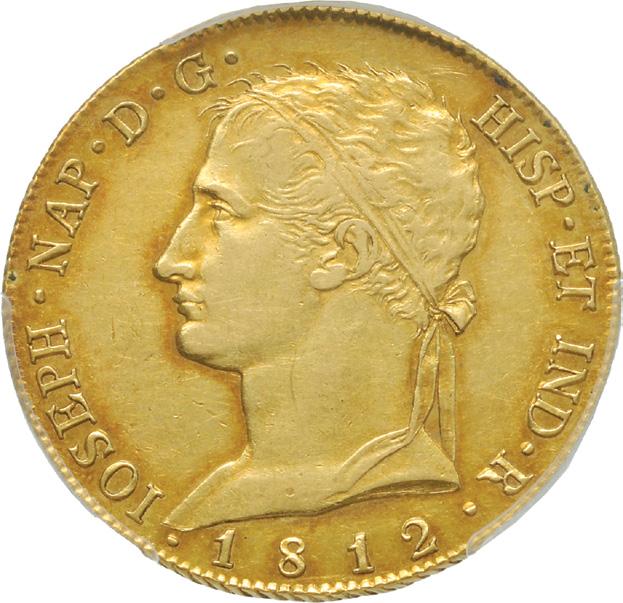

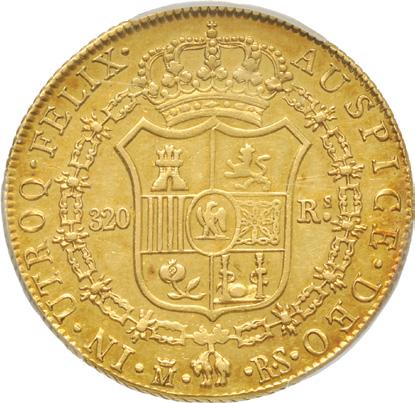
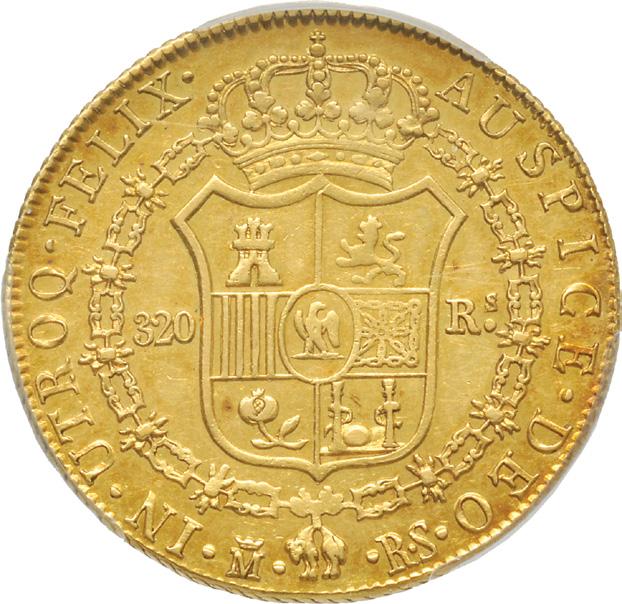
1140. SPAIN, Kingdom. José I Bonaparte. 1808-1813. AV 320 Reales (35mm, 12h). Madrid mint. Dated 1812 M RS. Head left, hair tied in fillet / Crowned coat-of-arms within garter. ME 14731; KM 545; Friedberg 300. Orange toning around periphery. In PCGS encapsulation 39807033, graded AU 53. Rare. ($7500)
306
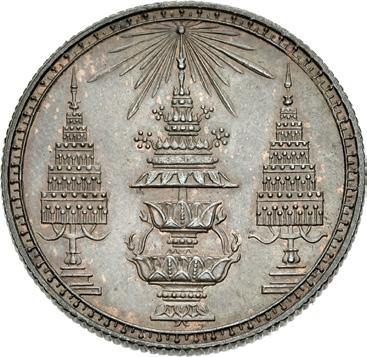
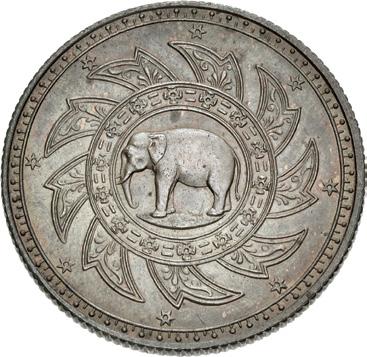
1141. THAILAND (SIAM), Rattanakosin Kingdom. Rama V. 1868-1910. Pattern CU Baht (31mm, 13.99 g, 12h). Bangkok mint. Struck AD 1868. Large radiate royal parasol flanked by two smaller ones / Elephant standing left within chakra. KM Pn28. Iridescent toning. In NGC encapsulation 6877475-003, graded MS 63 BN. Rare. ($1000)
From the Norman Frank Collection.

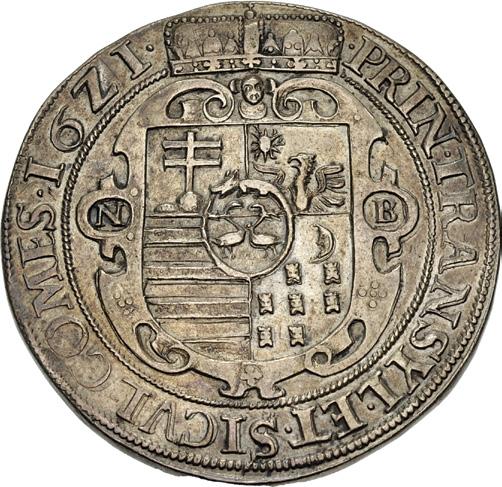
1142. TRANSYLVANIA, Principality. Gábor Bethlen. 1613-1629. AR Taler (42mm, 28.41 g, 6h). Nagybánya (Frauenbach / Baia Mare) mint. Dated 1621 NB. Armored half-length bust right, holding long scepter and hilt of sword; coatof-arms and Madonna with child in legend / Crowned coat-of-arms. Resch 114-8 var. (legends); MBR 1331-5 var. (same); Davenport 4711; KM 135. Toned, hairlines, some scratches and edge marks. Near EF. ($1500)


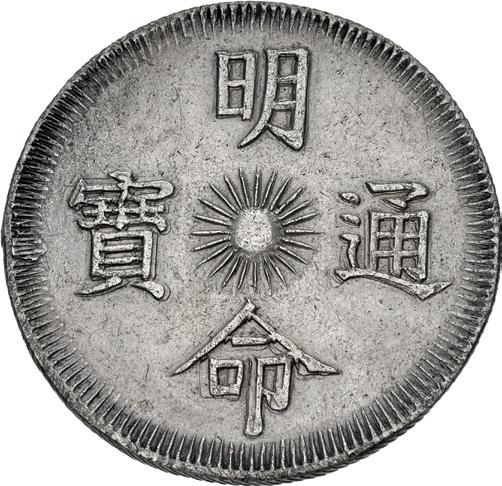

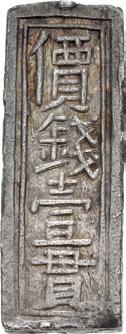
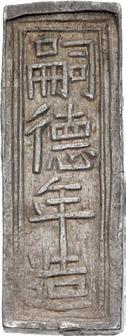
1143. VIETNAM (ANNAM), Nguyễn dynasty. Thế Tổ (Gia Long). 1802-1820. AR Lang (41x10mm, 37.38 g). Large characters type. Giao Long Nien Tao engraved in Han-nom characters / Tinh ngân nhất lạng in Han-nom characters / Left edge: Trị tiền nhị quán bát mạch in Han-nom characters / Right edge: Trung Bình hiệu in Han-nom characters; Top: Two concentric circle punches (the heavens); Bottom: Two concentric square punches (the earth). Schroeder 118; cf. BN Vietnam 1195 (for same type with small characters); KM 179. Toned. In PCGS encapsulation 49045623, graded XF Details, chop mark. ($500)
From the Norman Frank Collection.
1144. VIETNAM (ANNAM), Nguyễn dynasty. Thánh Tổ (Minh Mạng). 1820-1841. AR Philong – 7 Tìên (40.5mm, 27.19 g, 1h). Dated RY 15 (AD 1834/5). Ming Mang Bao Thong in Han-nom characters around central radiant sun / Dragon flying left; clouds around; Muoi Lam (date) below. Schroeder 183; BN, Vietnamiennes 403; KM 195. In PCGS encapsulation 49045621, graded AU Details, cleaned. ($2000)
From the Norman Frank Collection.
1145. VIETNAM (ANNAM), Nguyễn dynasty. Dực Tông (Tự Đức). 1847-1883. AR Quan (28x9.5mm, 5.44 g). Tu
Duc Nien Tao in Han-nom characters / Giá tiền nhất quán in Han-nom characters. Schroeder 340; cf. BN Vietnam II 232 (for similar); KM 502. Toned. In PCGS encapsulation 49045620, graded AU 58. ($1000)
From the Norman Frank Collection.
307
Rare Thai Pattern
1144
1145
1143

Beautiful Dragon 7 Tìên

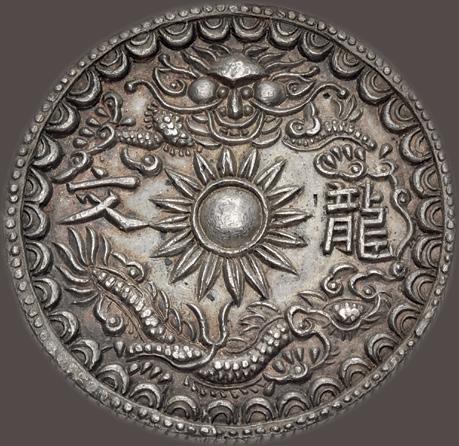
1146. VIETNAM (ANNAM), Nguyễn dynasty. Dực Tông (Tự Đức). 1847-1883. AR 7 Tìên (37mm, 26.71 g, 12h). ‘Dragon’ type. Tu Duc Thong Bao in Han-nom characters around central radiant sun; all within scalloped border / Dragon facing, coiled leftward around central radiant sun; Ling Van in Han-nom characters flanking. Schroeder 371B; BN, Vietnamiennes 502 var. (weight); KM 470. Toned. In PCGS encapsulation 49045619, graded MS 63. Rare. Top pop, one of only three certified in this grade. For another, see Stack’s Bowers Galleries (17 April 2023), lot 43134 (hammer $16,000). ($5000)
From the Norman Frank Collection.
WORLD MEDALS
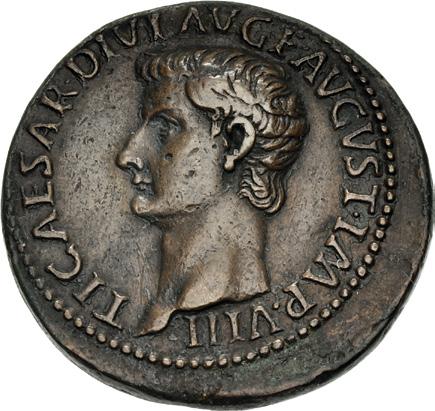

1147. ANCIENT THEMES. Tiberius. AD 14-37. Æ “Sestertius” (35mm, 21.48 g, 6h). Paduan type. Early cast after Giovanni da Cavino(?) (1500-1570). TI · CAESAR · DIVI · AVG · F · AVGVST · IMP · VIII ·, bare head left / CIVITATIBVS · ASIAE RESTITVTIS, Tiberius seated left, holding patera and long scepter; S C in fields. Johnson & Martini 1287-9; Klawans 4. Brown patina, a few scratches. Good VF. An exceptionally high quality and undoubtedly early cast. ($750)
From the Cabinet of Dr. Arnold R. Saslow, purchased from Edward J. Waddell.

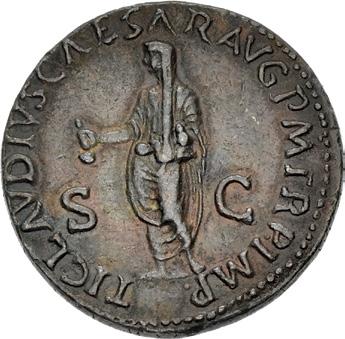
1148. ANCIENT THEMES. Antonia Minor. Augusta, AD 37 and 41. Æ “Dupondius” (29mm, 14.91 g, 6h). Paduan type. By Giovanni da Cavino(?) (1500-1570). ANTONIA AVGVSTA, draped bust right / TI CLAVDIVS CAESAR AVG P M TR P IMP, Claudius standing left, holding simpulum; S C flanking. Edge stamped XXI. Johnson & Martini 1645; Klawans 3. Brown surfaces, scattered marks. VF. A well made and challenging Paduan imitation that is frequently misidentified as an original ancient issue. ($750)
308
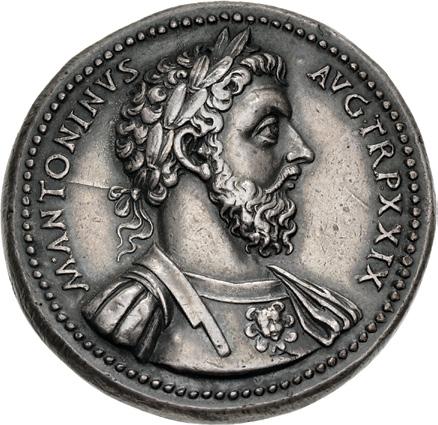


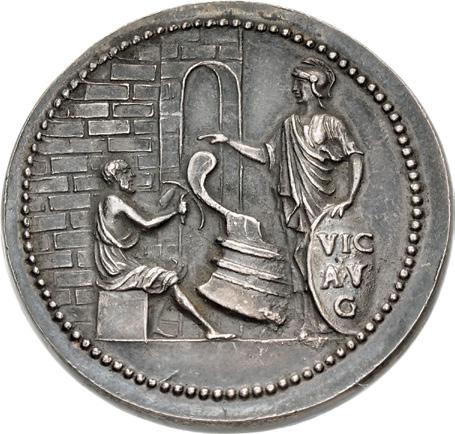
1149. ANCIENT THEMES. Marcus Aurelius. AD 161-180. Electrotype AR “Sestertius” (36mm, 27.88 g, 12h). Paduan type. After Giovanni da Cavino(?) (1500-1570). M · ANTONINVS · AVG · TR · P · XXIX, laureate, draped, and cuirassed bust right / IMP VII COS III, Victory seated right on pile of arms, holding palm frond and shield inscribed VIC/ AVG; trophy to right. Cf. Johnson & Martini 1717-8; Klawans 2. Toned. Choice EF. ($750)
From the Cabinet of Dr. Arnold R. Saslow.
1150. ANCIENT THEMES. Lucius Verus. AD 161-169. Electrotype AR “Sestertius” (38mm, 31.03 g, 4h). Paduan type. After Giovanni da Cavino(?) (1500-1570). L · VERVS · AVG · ARM · PARTH · MAX · TR · P · VIIII, laureate, draped, and cuirassed bust right / Argus seated right on low basis, working on bow of Argo; to right, Minerva standing left, directing him and holding shield inscribed VIC/AV/G; behind, stone building with arched entry. Cf. Johnson & Martini 1755/17214-5 (for obv./rev. type); Klawans 5. Toned. Choice EF. ($750)
From the Cabinet of Dr. Arnold R. Saslow.
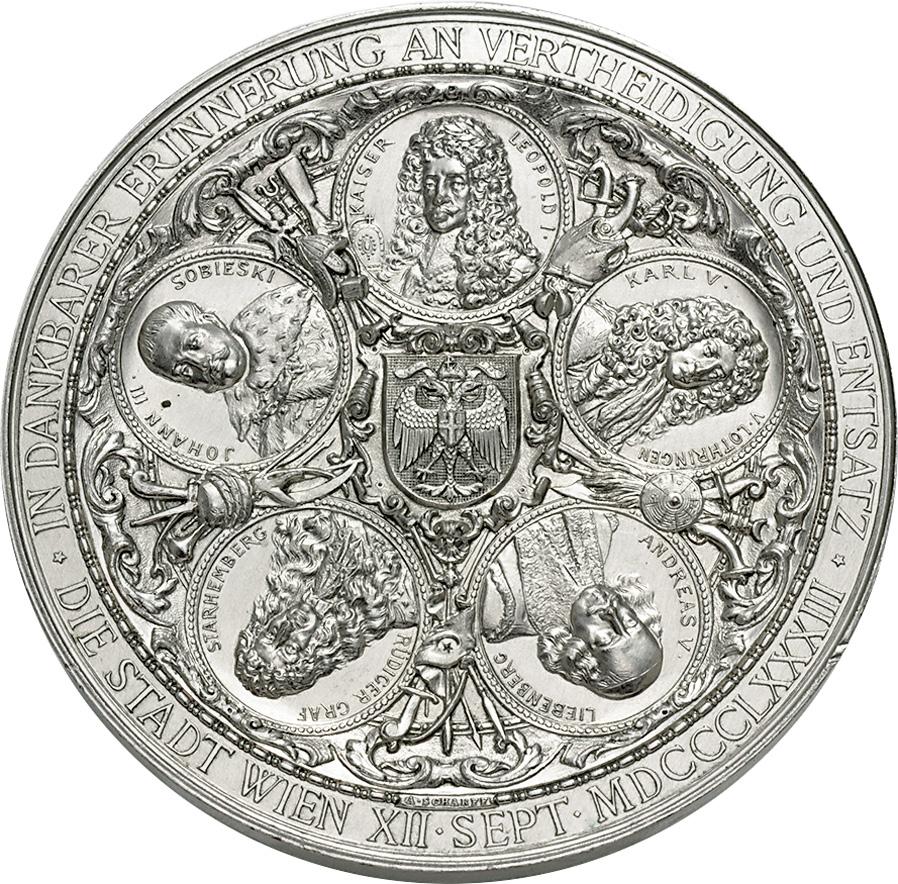
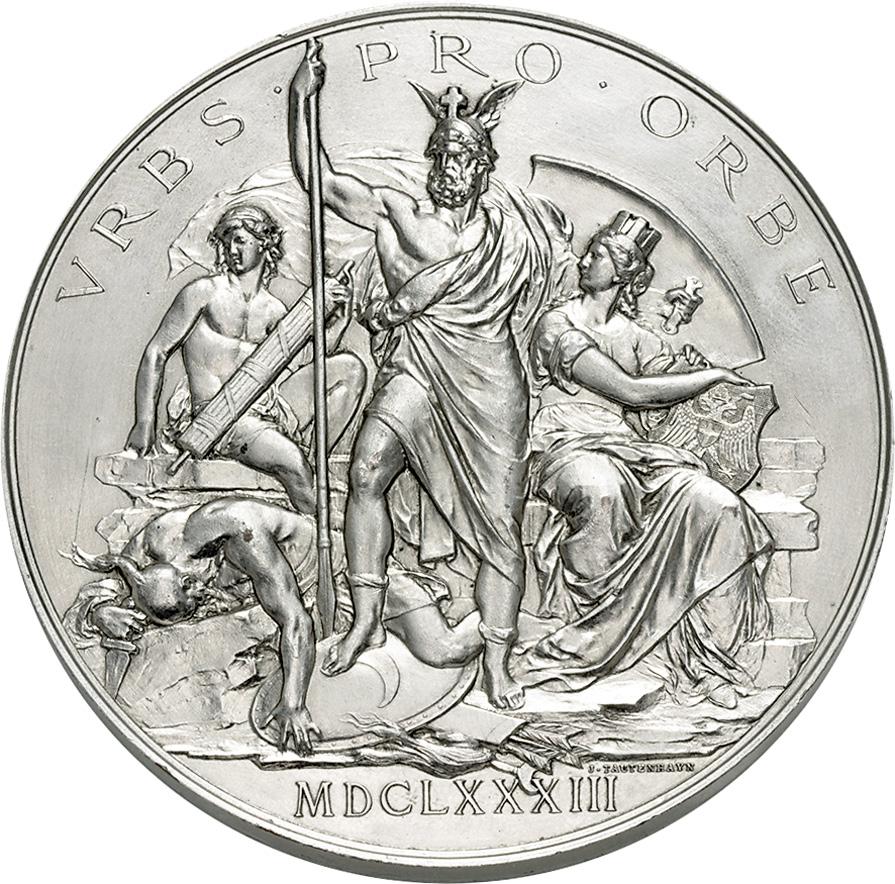
1151. AUSTRIA, Austro-Hungarian Empire. Franz Josef I. 1867-1916. Silvered Æ Medal (72mm, 136.0 g, 12h). Bicentennial of the Liberation of Vienna from the Turks. By A. Scharff and J. Tautenhayn. Dated 1693 and 12 September 1893 (in Roman numerals). * IN DANKBARER ERINNERUNG AN VERTHEIDIGUNG UND ENTSATZ * DIE STADT WIEN
XII · SEPT · MDCCCLXXXIII, five rondels depicting Emperor Leopold I, Karl V Duke of Lorraine, Andreas van Liebenberg, Rüdiger Count of Starhemberg, Jan II Sobieski around central coat-of-arms; all divided by arms and armor in ornate scroll / VRBS · PRO · ORBE, warrior standing facing, holding spear, atop fallen Ottoman and his shield; to either side, Law, seated left and hold fasces, and Vienna, seated right, head left, holding coat-of-arms; in exergue, MDCLXXXIII. Lightly toned, a few edge marks and scuffs. EF. ($500)
Ex Goldberg 80 (3 June 2014), lot 3953 (hammer $1800).
309
1149
1150

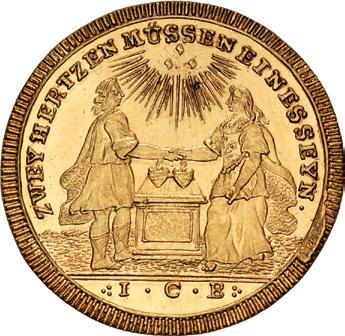
1152. GERMANY, Regensburg (city). AV Medal – 2 Dukats (29mm, 6.92 g, 12h). By J. Chr. Busch, mintmaster. Struck 1741-1763. ZWAR EINSAM DOCH NICHT CANITZ ALLEIN, figure walking left through woods, holding open book and staff / ZWEY HERTZEN MUSSEN EINESSEYN, male and female figures standing facing one another, hands clasped, with plinth between; entwined hearts draped over hands; above, three lozenges in glory of rays; ·: I · C · B :· in exergue. Lacquer removed. UNC. ($2000)
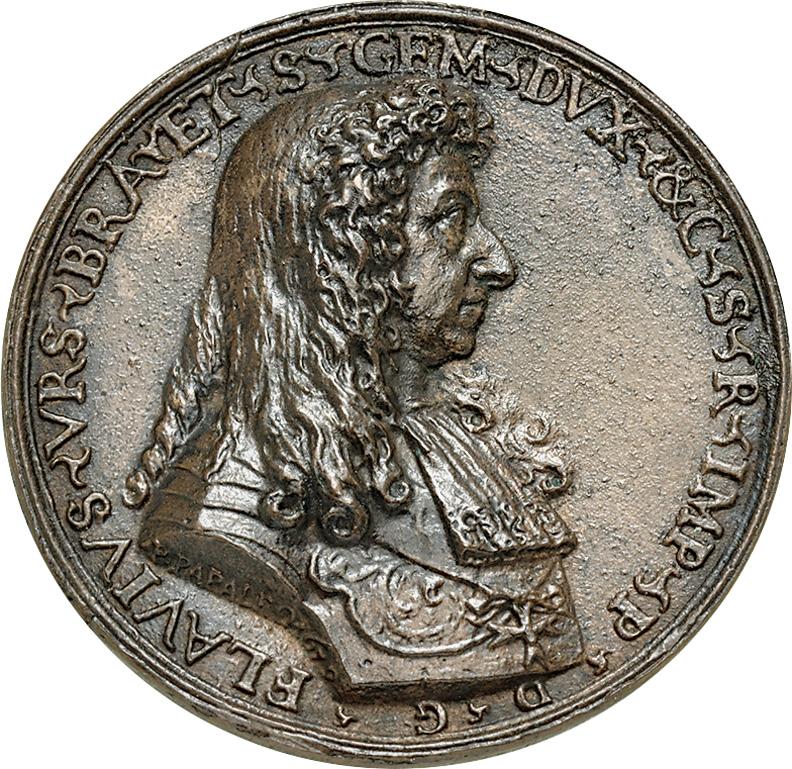
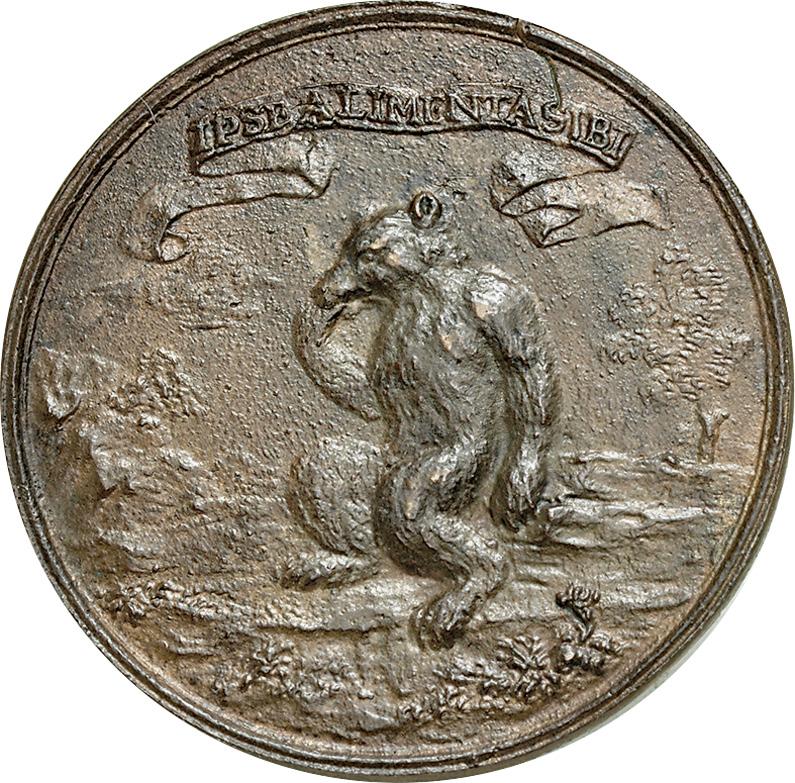
1153. ITALY, Bracciano (Duchy). Flavio Orsini. 1660-1696. Cast Æ Medal (63mm, 67.97 g, 12h). By Papaleo Pietro. Dated 1679. FLAVIVS · VRS · BRA · ET · S · GEM · DVX · & C · S · R · IMP · P · D · G ·, armored bust right / Bear seated left; above, banner inscribed IPSE · ALIMENTA SIBI. Forrer IV p. 378. Brown surfaces, some roughness, flan crack in host. EF. Very rare. ($500)
From the J. Eric Engstrom Collection, purchased from C. Hornby, March 1965.
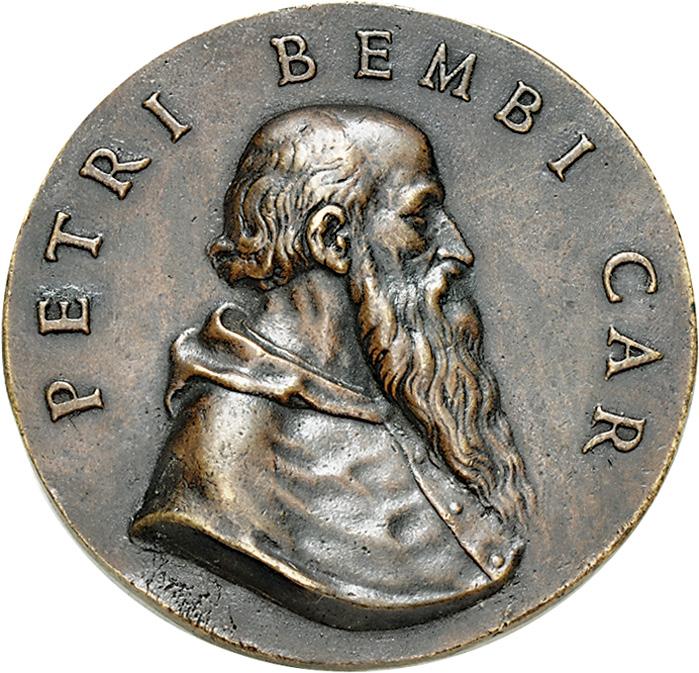
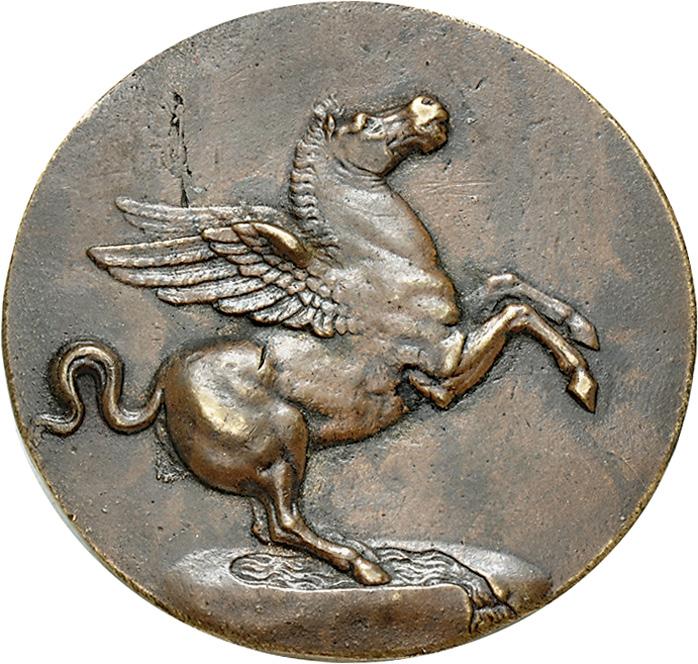
1154. ITALY, Papal (Papal state). Pietro Bembi, cardinal and scholar. 1470-1547. Cast Æ Medal (56mm, 58.20 g, 6h). By an uncertain medallist. Cast after 1538. PETRI BEMBI CAR, bust right, wearing cope / Pegasus leaping right. Pollard 562. Brown surfaces. EF. An exquisite original cast. ($1000)
From the J. Eric Engstrom Collection. Ex Glendining’s (18 February 1987), lot 46.
This medal is often attributed to the famous engraver Benvenuto Cellini, who is known to have prepared a design in wax for Bembi. However, the details given by Cellini in his autobiography indicate that the portrait on his design had a short beard, and that the pegasus was depicted in a myrtle wreath.
310
Presented to François Eugene Nepveu, architect
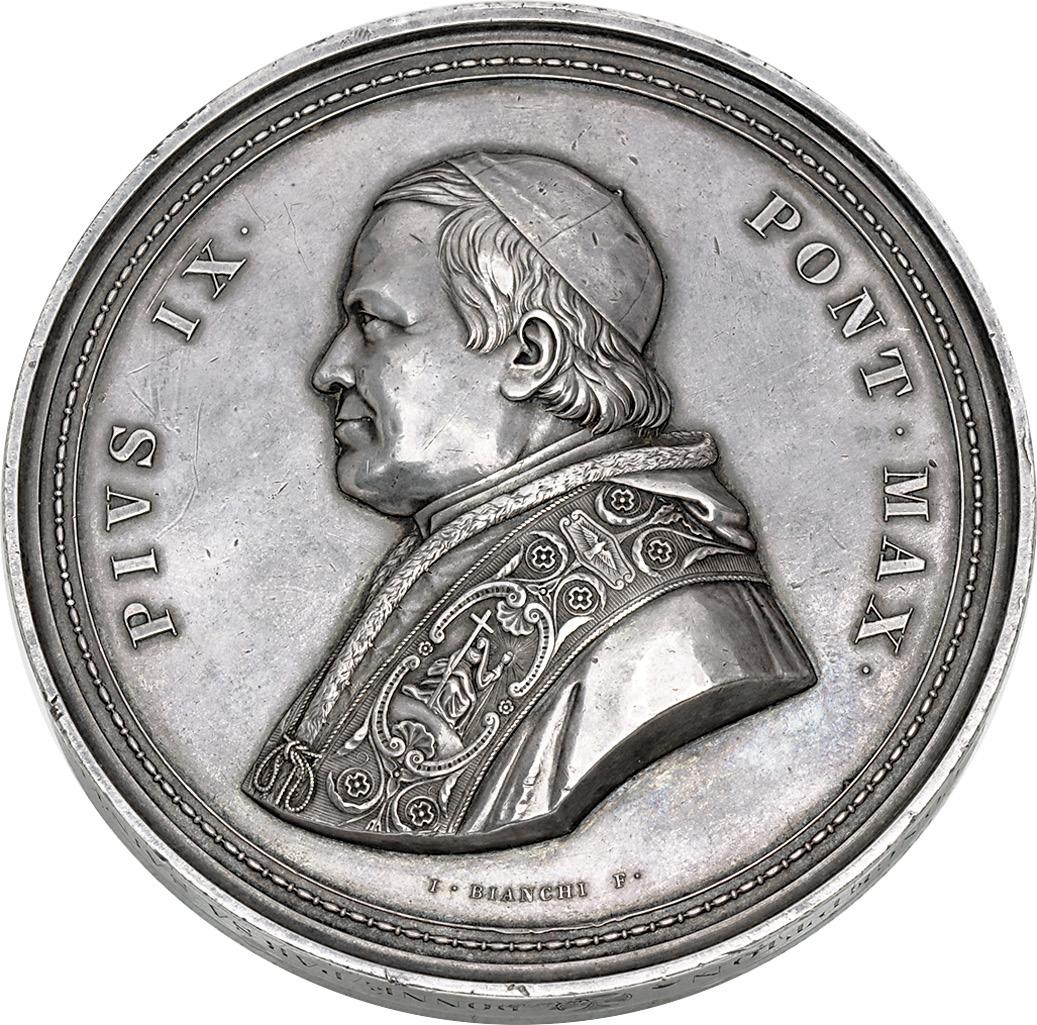
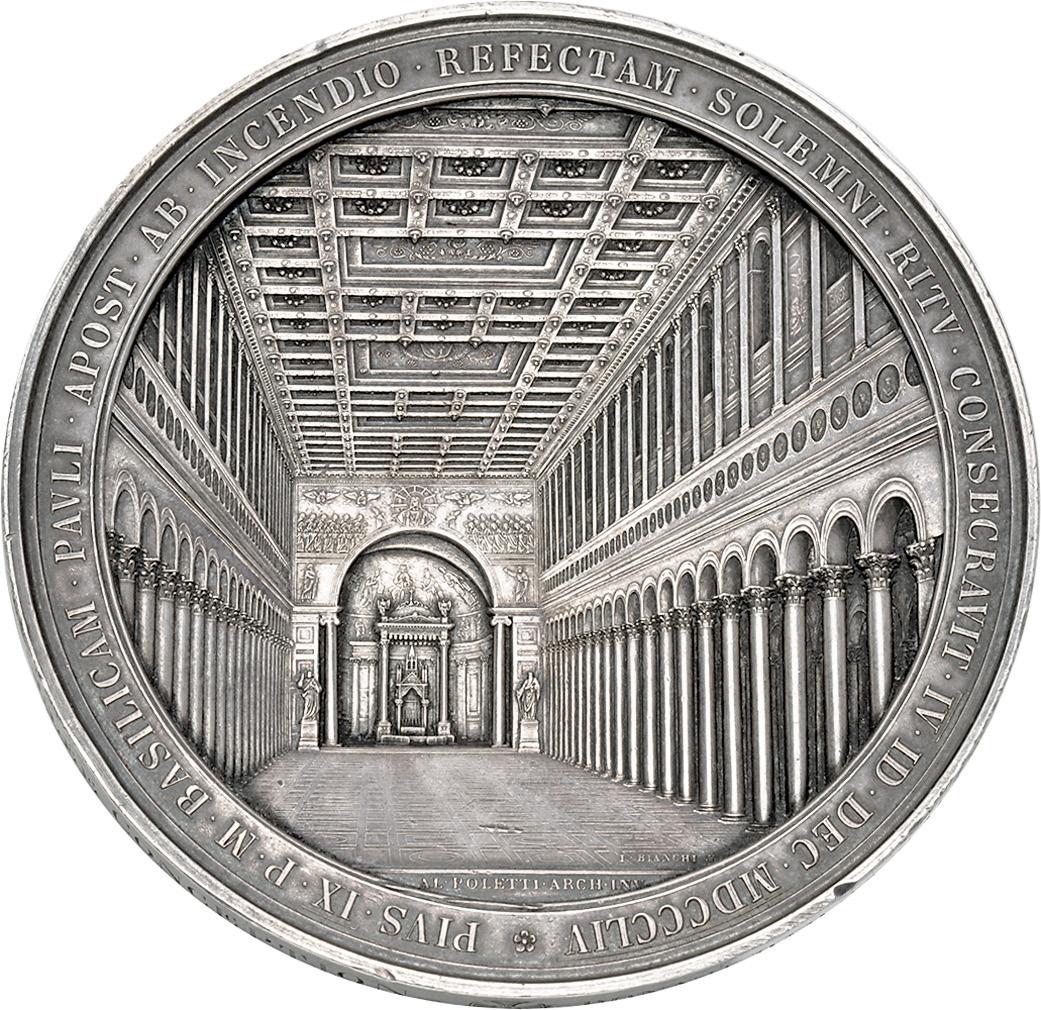
1155. ITALY, Papal (Papal state). Pius IX. 1846-1878. AR Medal (83mm, 275.3 g, 12h). Basilica of St. Paul Outside the Walls. By Bianchi. Dated 4 December 1854. Presented to François Eugene Nepveu, architect, by Pius IX on 5 March 1865 for his design of a proposed basilica. PIVS IX · PONT · MAX ·, bust left, wearing zucchetto, mozzetta, and mantum / * PIVS · IX · P · M · BASILICAM · PAVLI · APOST · AB INCENDIO · REFECTAM · SOLEMNI · RITV · CONSECRAVIT · IV · ID · DEC · MDCCCLIV, interior view of the basilica. Edge engraved: + DONNÉ PAR SA SAINTETÉ PIE IX LE 5 MARS 1865 À F· E· NEPVEU POUR SON PROJET D’ÉGLISE DÉDIÉE À L’IMACULÉE CONCEPTION. Mazio 731. Toned, once polished, a few scratches and dings. Near EF. ($750)
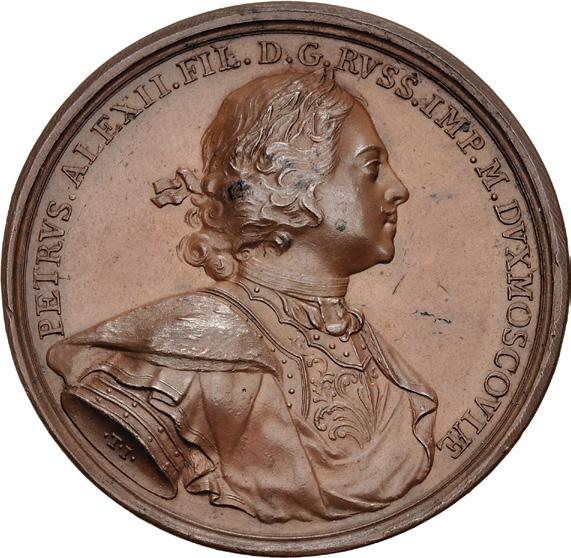
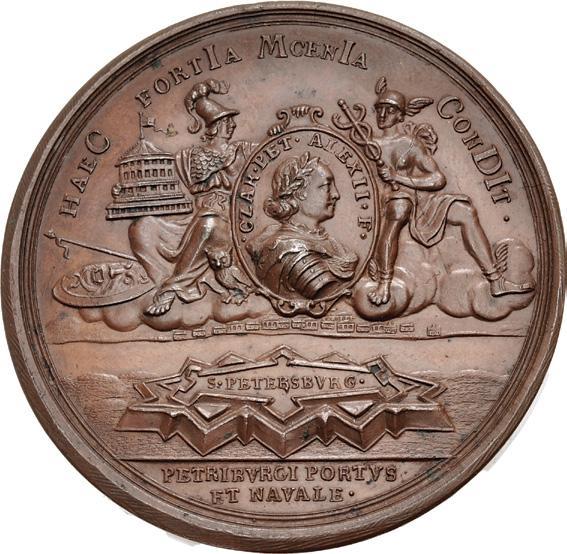
1156. RUSSIA, Tsardom of Rus. Petr I Alexeyevich Velikiy (Peter the Great). 1682-1725. Æ Medal (47mm, 50.36 g, 12h). The Foundation of St. Petersburg. By T. Ivanov. Dated 1703 (in chronogram on reverse). PETRVS · ALEXII · FIL · D · G · RVSS · IMP · M · DVX MOSCOVIÆ, laureate, draped, and armored bust right / HAEC FORTIA MŒNIA CONDIT (he established this powerful fortification), map of the fortifications at Sankt-Petrburg on the Neva River; above, oval medallion inscribed · CZAR · PET · ALEXII · F · and bearing the laureate, draped, armored bust of Petr right, with supporters: to left, Pallas seated slightly left, head right, holding city model and with owl at feet to right; to right, Mercury seated slightly right, head left, holding caduceus; in two lines in exergue, PETRIBVRGI PORTVS/ET NAVALE ·. Diakov 18.7. Brown surfaces, a few light spots. EF. ($500)
From the St. George Collection.
311
Iconic Large Cent

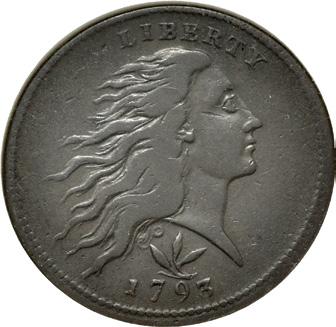

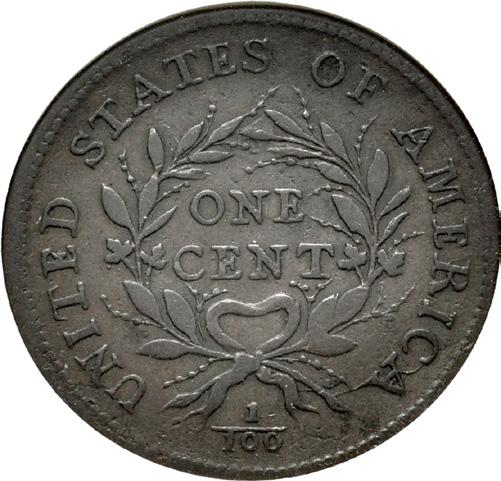





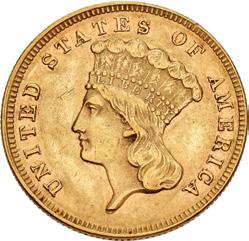
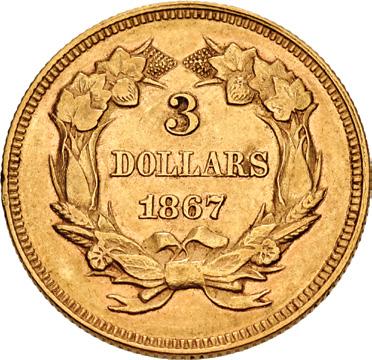

312
UNITED STATES COINAGE
1157. 1793 Flowing Hair Wreath Cent. Vine and Bars Edge. S-9. NGC VF 30 BN. 294191-001. ($5000)
1158. 1795 Flowing Hair Half Dollar. O-108. NGC VF 20. 280044-013. ($1500)
Charlotte Mint Gold
1159. 1852-C Liberty Head Quarter Eagle. ANACS EF 40 Details. 2511460. scratched/cleaned. ($750)
1160. 1867 Three Dollar Gold Piece. NGC AU 55. 6887584-001. Low mintage of 2,600 circulation strikes. ($2000)
BRITISH COINAGE
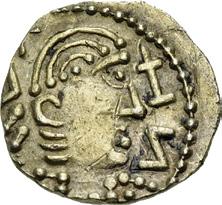
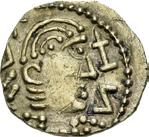
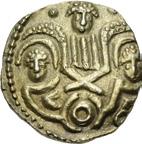
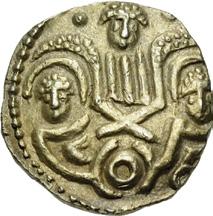
1161. ANGLO-SAXON, Pale Gold Phase. Circa 645-665/70. AV Thrymsa – Shilling (12mm, 1.26 g, 2h). Mint in Kent(?). Diademed and draped bust right; pseudo legend around / Two small busts facing; above, Victory with wings enfolding the figures; pellet to each side of Victory’s head. Abramson, Gold 830; Sutherland Type IIT.v; A&W Type V.xxvii; MEC 8 table 3, 30; North 20; SCBC 767. Light scratch on obverse, slightly off center. Near EF. Rare. ($3000)

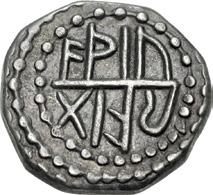
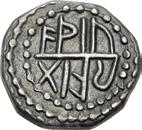
1162. ANGLO-SAXON, Primary Sceattas. Circa 710. AR Sceatt (12mm, 1.11 g, 2h). Aethiliraed Series (E), type 105. Mint in east Kent. ‘Porcupine’ right; wavy line below / ᚪᚦᛁᛚᛁ/ᚱᚪᛞ (AThILI/RAD in Runic) in two lines around central line; all within double pelleted border. Abramson 92.10; MEC 8 Series AEÐ; North 155; SCBC 780. Toned. Near EF. ($750)

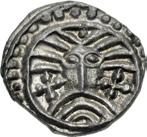
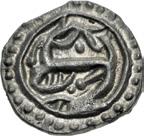

1163. ANGLO-SAXON, Continental Sceattas. Circa 715-800/20. AR Sceat (13mm, 1.01 g, 5h). Series X, type 31. Ribe mint. ‘Wodan’ head facing; pellet above, short cross pommée to left and right / Fantastic creature left, head right, with tail coiled leftward; pellet below chin and at end of tail. Abramson 103-10; MEC 8 Series X; North 116; SCBC 797. Lustrous. EF. Rare in this state. ($2000)
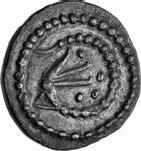


1164. ANGLO-SAXON, Secondary Sceattas. Circa 720/5-730. AR Sceatt (12mm, 1.07 g). Series K/R mule. Uncertain mint in the south-east. Wolf-headed, coiled serpent right / Saltire over square with pellets in angles; four pellets in each outer angle. Abramson 42-40; MEC 8 Series SP; North–; SCBC 830. Rich find patina, minute chip on reverse. EF. Very rare. ($1500)

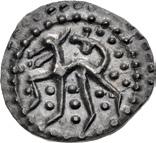
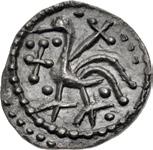
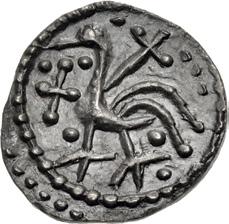
1165. ANGLO-SAXON, Secondary Sceattas. Circa 730-750. AR Sceatt (13mm, 0.86 g, 1h). Series QIID. Mint in East Anglia (Mid-Suffolk). Quadruped standing left, with cross-tipped tail; pellets around / Bird standing left; crosses over shoulder and to left, pellets around. Abramson 64-100; MEC 8 Series Qb; North –; SCBC 809. Glossy find patina. EF. Rare. A nice example. ($1500)
313

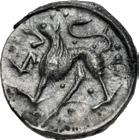
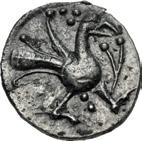

1166. ANGLO-SAXON, Secondary Sceattas. Circa 730-750. AR Sceatt (12mm, 0.88 g, 1h). Series QIVA, type 44. Mint in East Anglia (Mid-Suffolk). Lion walking left; pellets around / Bird standing right; to right, branch with two berries; pellets around. Abramson 66-10; MEC 8 Series Qd; North 136; SCBC 811. A few minor deposits. Glossy surfaces. EF. Exceptional detail. Rare. ($2000)

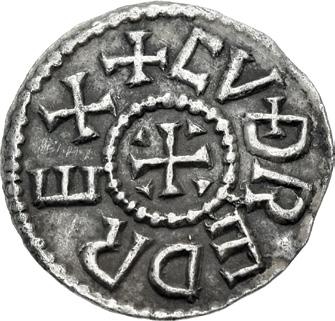
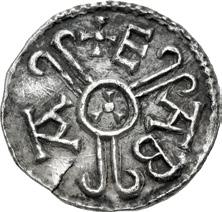
1167. ANGLO-SAXON, Kings of Kent. Cuthred. 798-807. AR Penny (18mm, 1.22 g, 12h). Canterbury mint; Eaba, moneyer. Struck 798-805. ม ü⎍ T ʼዞዝ ʼዞҟ , short cross pattée with wedges in angles / ม ዞ ¥ዛ ¥ in angles of two-lined tribrach moline with annulet at center containing small tribrach. Naismith C18.4; SCBI 67 (BM), 675; North 209; SCBC 876. Toned, small edge crack, slight porosity. Good VF. Rare. ($2000)


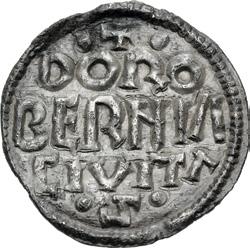
1168. ANGLO-SAXON, Archbishops of Canterbury. Wulfred. 805-832. AR Penny (20mm, 1.25 g, 6h). Anonymous issue under Ecgberht of Wessex. Canterbury mint; Wilnoth, moneyer. Struck circa 810-822/3. ม ⎍ዢ⌦/nɭዝ ዦɭnዞͿ© , tonsured facing bust / / ม / / ዝɭያɭ / ዛዞያዧዢ© / üዢ⎍ዢ˸© / / Ӳ / . Naismith C60; SCBI 67 (BM), 712; North 236; SCBC 890. Toned, minor lamination, some light porosity, slight bend. Good VF. Very rare. Naismith records only two examples of the anonymous type for moneyer Wilnoth. ($2500)
From the Causeway Collection, purchased from AMR Coins, July 2015.
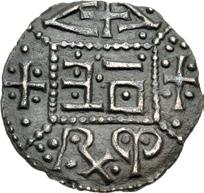
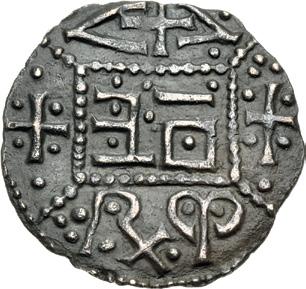

1169. ANGLO-SAXON, Kings of Mercia. Offa. 757-796. AR Penny (17mm, 1.29 g, 12h). Light coinage, non-portrait type. Canterbury mint; Eoba, moneyer. Struck circa 785-792/3. Inverted ∂ Ŗ (the later barred, the former underlined as contraction) in central dotted square with diagonal lines projecting from corners; cross between ornaments above, floral ornaments at sides, R m below / ģ ∂ B A in angles of a cross fleury with pelleted cross in central annulet. Chick 106g = EMC 1970.0504 (this coin); SCBI 1 (Cambridge), 390 = MEC 1, 1127 (same rev. die); North 271; SCBC 904. Toned, slightly irregular flan. Good VF. Rare. ($2000)
From the Causeway Collection, purchased from Silbury Coins, August 2013. Ex Künker 227 (11 March 2013), lot 2330; G. W. de Wit (Künker 137, 11 March 2008), lot 3035. Found at Newton Bromwswold, Northamptonshire, February 1988.
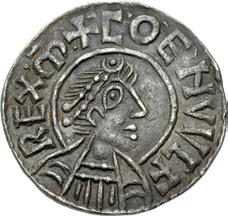
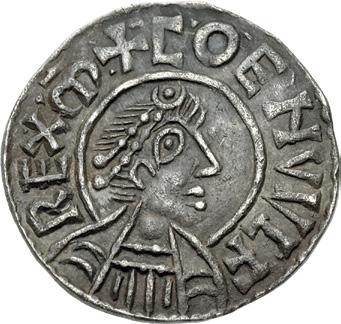
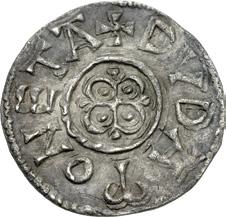
1170. ANGLO-SAXON, Kings of Mercia. Coenwulf. 796-821. AR Penny (18mm, 0.02 g, 8h). Portrait type. Canterbury mint; Duda, moneyer. Struck circa 800-821. ม üɭዞn⎍⌦ዟ ʼዞҟ M, diademed bust right / ม ዝ⎍ዝ¥ ȮɭnዞͿ¥ , cross pommée over quatrefoil; pellets in angles. Naismith C40b-c (same rev. die); SCBI 67 (BM), 133 (same rev. die); North 363; SCBC 915. Toned, slightly double struck on reverse. Good VF. ($2500)
From the Causeway Collection. Ex M. Rasmussen FPL 23 (Summer 2012), no. 6.
314
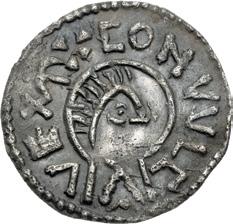
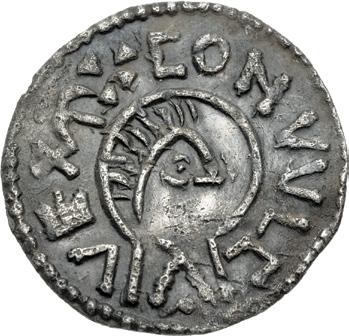
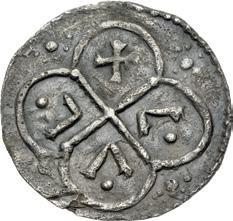
1171. ANGLO-SAXON, Kings of Mercia. Coenwulf. 796-821. AR Penny (19mm, 1.34 g, 9h). Portrait type. Mint in East Anglia (Ipswich?); Lul, moneyer. Struck circa 800-821. ส üɭn⎍⎍⌦ü ⎍ዞҟ M, diademed bust right / ม ⌦ ⎍ ⌦ within angles of long cross fourchée, with pelleted rosettes in each outer angle. EMC 2011.0243 (this coin); Naismith E10.2f (same obv. die); SCBI 67 (BM), 199; North 363; SCBC 919. Dark toning, uniform faint porosity. Good VF. Very rare. ($2000)
From the Causeway Collection, purchased from T. Owen, December 2014. Ex London Coins 146 (6 September 2014), lot 2057 (since straightened). Found at Cotgrave, Nottinghamshire, 2011.



1172. ANGLO-SAXON, Kings of Mercia. Coenwulf. 796-821. AR Penny (20mm, 1.35 g, 10h). Portrait type. Rochester mint; Ealhstan, moneyer. Struck circa 810-821. ม üɭዞn⎍⎍ቢ ዟ ʼዞ˝ M, bust right / ม ዞ¥⌦ዡәͿ¥n M ɭnዞͿ¥ , cross moline. Naismith R2.2b = Coin Register 1989, 76 (this coin); SCBI 2 (Hunterian), 341; North 352; SCBC 917. Toned, wavy flan, crack in margin, a few pinholes. VF. ($1500)
Ex Williams (Part I, Spink 252, 27 March 2018), lot 27; Baldwin’s 18 (12 October 1998), lot 1642; Christie’s (26 February 1991), lot 496. Found at Little Kimble, Bucks, spring 1990.
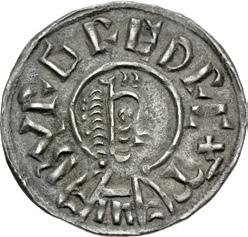
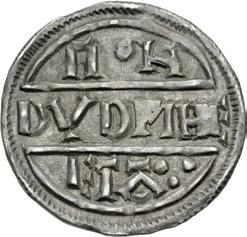
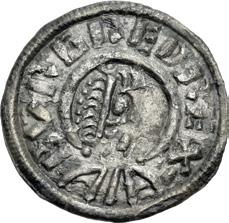

1173. ANGLO-SAXON, Kings of Mercia. Burgred. 852-874. AR Penny (21mm, 1.50 g, 6h). Lunette type D (BMC d). London mint; Dudwine, moneyer. Phase IIb, circa 866-868/70. Diademed bust right / ዝќዝዩዢnዞ across central field; ዦɭዡ ዞ˸⌈ Ḩ in lunettes above and below. MacKay V2.19 = MEC 8, 1146; North 423; SCBC 941B. Toned, slightly soft strike at center. Good VF. ($750)
From the Causeway Collection, purchased from KB Coins, September 2018. Ex M. Lessen (Part I, Dix Noonan Webb 146, 25 April 2018), lot 206, purchased from Spink, September 1963.
1174. ANGLO-SAXON, Kings of Mercia. Burgred. 852-874. AR Penny (19mm, 0.88 g, 11h). Lunette type D (BMC d). London mint; Godman, moneyer. Phase IIIa, circa 868/70-874. Diademed bust right / ű⎍ዝዦ⎍n across central field; Ḩ ዦɭዡ ዞ˸⌈ Ḩ in lunettes above and below. EMC 2011.0099 = MacKay V5.164 (dies O2/R3; this coin); SCBI 50 (Hermitage), 115; North 423; SCBC 942A. Toned, some roughness, deposits. VF. ($600)
From the Causeway Collection, purchased from Silbury Coins. Ex Dix Noonan Webb 104 (5 December 2012), lot 329; Spink 208 (22 June 2011), lot 607. Found at Torksey, Lincolnshire, 2011.
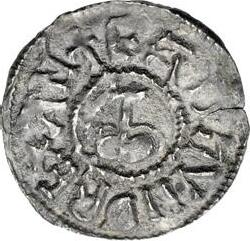

1175. ANGLO-SAXON, Kings of East Anglia. Edmund. 855-869. AR Penny (20mm, 1.18 g, 11h). Early phase. Mint in East Anglia (Ipswich?); Twicga, moneyer. Struck 855-circa 862. ม ዞ¥ዝዦ⎍nዝ ʽዞҟ ¥n , omega cross / ม Ϳዩዢű¥ ዦɭn , short cross pattée; pellets in angles. Naismith E60.2a-d (same obv. die); SCBI 67 (BM), 945 (same obv. die); North 462; SCBC 955. Toned, small edge split, minor deposits, struck from worn dies. VF. Rare. ($1000)
From the Causeway Collection, purchased from M. Vosper.
315
1173 1174
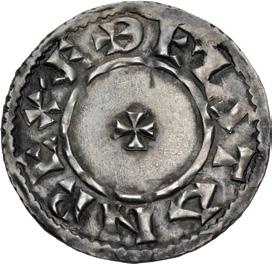
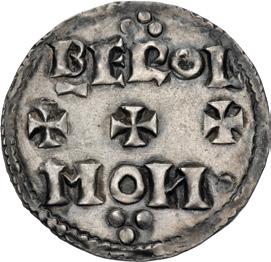
1176. ANGLO-SAXON, Kings of Wessex. Æthelstan. 924-939. AR Penny (23mm, 1.50 g, 6h). Small cross/HorizontalTrefoil 1 (HT 1) type (BMC i). North East I mint; Berol, moneyer. Small cross pattée / Bዞʼɭ⌦ / ዦɭɃ in two lines; three crosses pattée between, trefoil above and below. Blunt, Aethelstan 375 (same obv. die); SCBI 34 (BM), –; North 668; SCBC 1089. Toned. Good VF. Rare moneyer. ($1000)
From the Causeway Collection, purchased from T. Owen.
Aethelstan Helmet Type
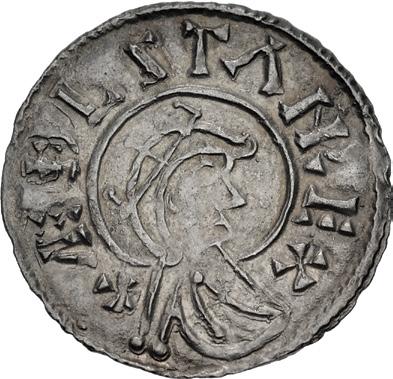
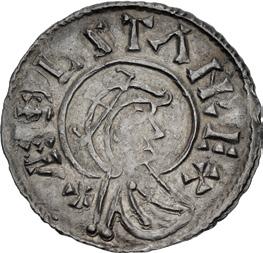
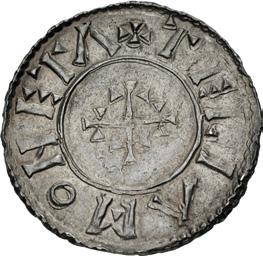
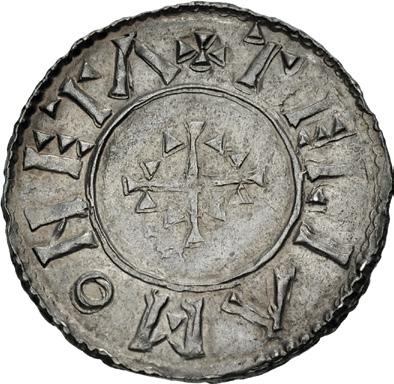
1177. ANGLO-SAXON, Kings of Wessex. Æthelstan. 924-939. AR Penny (22mm, 1.48 g, 1h). Helmet type (BMC xii). North Eastern II mint; Telia, moneyer. Crowned, helmeted, draped bust right / ม Ϳዞ⌦ዢ© ዦɭnዞͿ© , cross crosslet. Blunt, Aethelstan 418; SCBI 34 (BM), 250; North 686; SCBC 1104. Light golden toning, weakly struck at center. Good VF. Very rare. ($4000)
From the Causeway Collection. Ex M. Rasmussen FPL 25 (2014), no. 8.
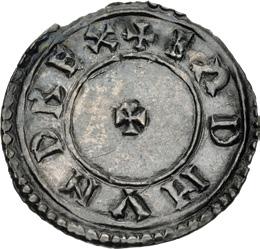
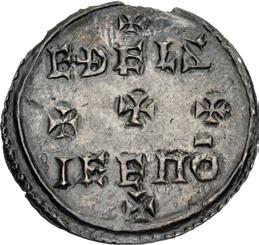
1178. ANGLO-SAXON, Kings of Wessex. Eadmund. 939-946. AR Penny (22mm, 1.08 g, 12h). Short cross/HorizontalCross 1 (HC 1) type (BMC i). Canterbury mint(?); Æthelsige, moneyer. Short cross pattée / ዞ T ዞ⌦Ӳ / ዢűዞ ዦɭ in two lines; three crosses pattée between, crosses above and below. CTCE 130 (same dies as illustration); SCBI 34 (BM), –; North 692; SCBC 1105. Toned, minor edge loss. Near EF. ($500)
From the Causeway Collection, purchased from N. Mills.
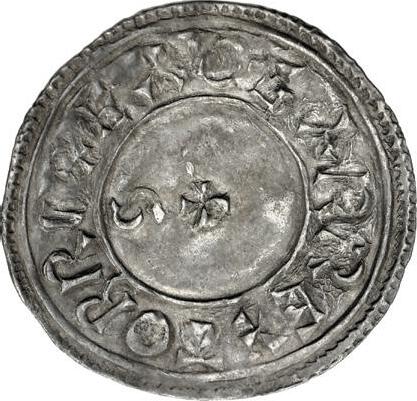
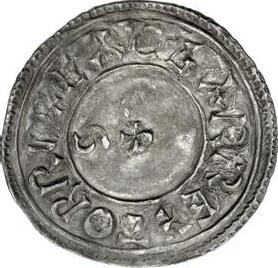

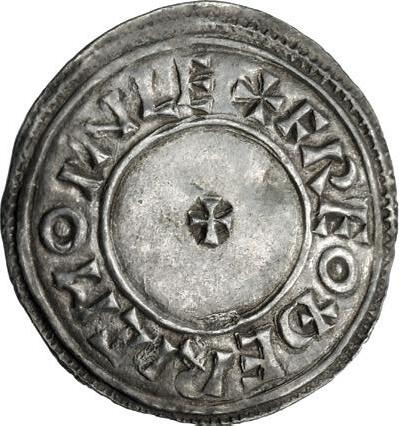
1179. ANGLO-SAXON, Kings of All England. Eadgar. 959-975. AR Penny (23mm, 1.48 g, 4h). Circumscription Cross (CC) type (BMC iii). Chester mint; Frithuric, moneyer. Struck circa 961-963. Small cross pattée; ⎄ to left / ม ዟያዞ∂ T ዞያዢü ዦ∂ ⌦ዞ , small cross pattée. EMC 2023.0241 (this coin); CTCE 289; CTCE 34 (BM), 1104 (same dies); SCBI 5 (Grosvenor), 74 (same dies); North 749; SCBC 1135. Toned, worn obverse die, wavy flan. Good VF. Very rare. ($2000)
Found near Downpatrick, Northern Ireland, 28 May 2023.
316
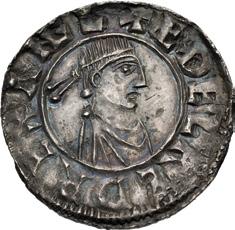
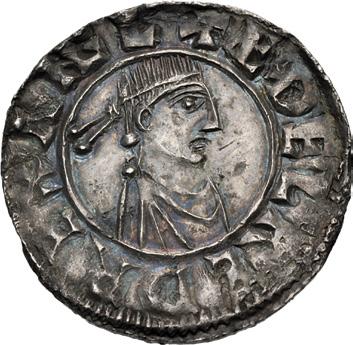
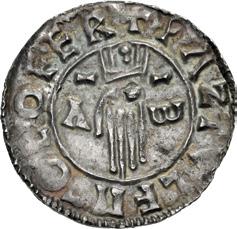
1180. ANGLO-SAXON, Kings of All England. Æthelred II. 978-1016. AR Penny (19mm, 1.33 g, 12h). First Hand type (BMC iia, Hild. B1). York mint; Fastulfr, moneyer. Struck circa 979-985. Diademed and draped bust right / ม ዟ©ZͿ⎍⌦ዟ ዦ!ɭ ዞɭዟዞʽ , manus Dei descending from clouds; barred Λ ω flanking. SCBI 50 (Hermitage), 2092 var. (obv. legend); North 766; SCBC 1144. Toned with blue iridescence at margins, a few very light marks. Near EF. A strong portrait. ($600)
Ex Classical Numismatic Group XXII (2 September 1992), lot 926.

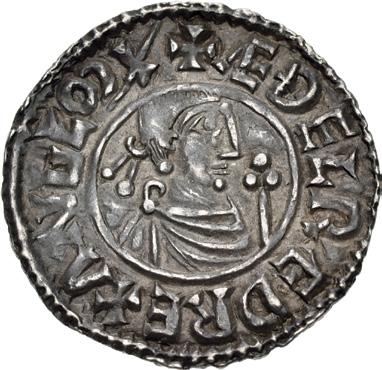
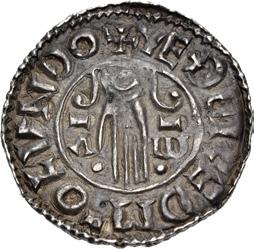
1181. ANGLO-SAXON, Kings of All England. Æthelred II. 978-1016. AR Penny (21mm, 1.54 g, 12h). Second Hand type (BMC iid, Hild. B2). London mint; Æthelred, moneyer. Struck circa 985-991. Diademed and draped bust right; scepter to right / ม ®T ዞʼዞዝ ዦ!ɭ ⌦⎍nዝɭ , manus Dei descending from clouds; across field, barred © ѽ above pellets. SCBI 7 (Copenhagen), 704-7; North 768; SCBC 1146. Toned. VF. ($500)
From the Causeway Collection, purchased from M. Vosper. Ex Spink Numismatic Circular CXI.5 (October 2003), no. HS1358.
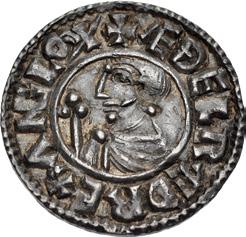
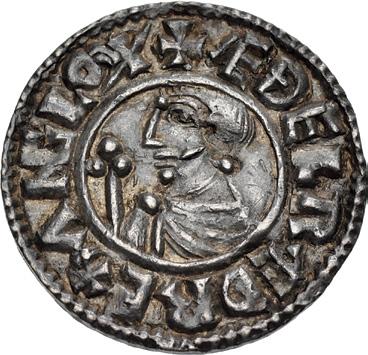
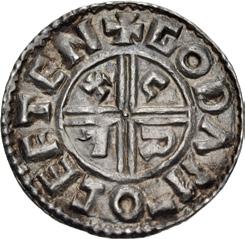
1182. ANGLO-SAXON, Kings of All England. Æthelred II. 978-1016. AR Penny (20mm, 1.63 g, 3h). Crux type (BMC iiia, Hild. C). Shaftesbury mint; Goda, moneyer. Struck circa 991-997. Draped bust left; trefoil-tipped scepter to left / ม űɭዝ© ዦɭ üዞዟͿዞn , voided short cross; ü ʽ ⎍ ҟ in quarters. SCBI 24 (West Country), 944; North 770; SCBC 1148. Toned, a few light scratches. Good VF. ($500)
From the Causeway Collection, purchased from T. Owen, May 2012. Ex Spink 212 (28 March 2012), lot 345, purchased from Spink, July 1984.
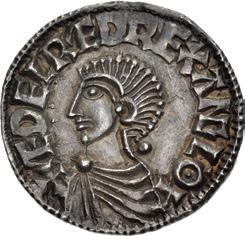
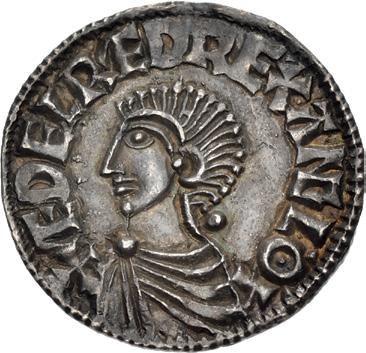
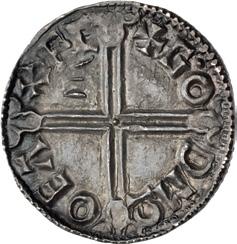
1183. ANGLO-SAXON, Kings of All England. Æthelred II. 978-1016. AR Penny (20mm, 1.67 g, 1h). Long Cross type (BMC iva, Hild. D). Exeter mint; Goda, moneyer. Struck circa 997-1003. Draped bust left; pellet behind neck / ม ű/ɭዝ
ҟዞü , voided long cross, with pellet at center and triple-crescent ends. SCBI 7 (Copenhagen), 181 (same dies); North 774; SCBC 1151. Toned, a few peck marks on reverse. Near EF. Bold portrait. ($500)
From the Causeway Collection. Ex CNG inventory 937592 (November 2012); Baldwin’s 77 (27 September 2012), lot 2539.
317
ዦቸ∂ ዞa

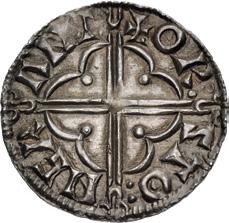
1184. ANGLO-SAXON, Kings of All England. Cnut. 1016-1035. AR Penny (19mm, 1.00 g, 12h). Quatrefoil type (BMC viii, Hild. E). Cambridge mint; Ornost, moneyer. Struck circa 1016-1023. Crowned and draped bust left within quatrefoil / ม ∂ʼ/ ӲͿḦ ɮn űʼ ©nͿ , voided long cross with triple-crescent ends and pellet at center; all over quatrefoil. SCBI 66 (Norwegian), 1881 (same dies); North 781; SCBC 1157. Toned, some weakness on face. Good VF. ($500)
From the Causeway Collection.

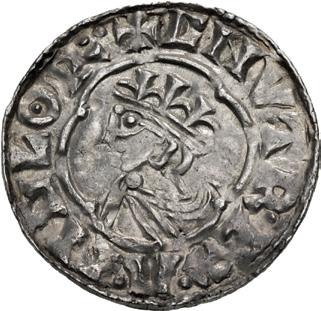

1185. ANGLO-SAXON, Kings of All England. Cnut. 1016-1035. AR Penny (18mm, 0.87 g, 7h). Quatrefoil type (BMC viii, Hild. E). Taunton mint; Eadric, moneyer. Struck circa 1016-1023. Crowned and draped bust left within quatrefoil / ม ዞዝ ʽዢü ɭ ˶© n˶⎍ , voided long cross with triple-crescent ends and pellet at center; all over quatrefoil. SCBI 15 (Copenhagen), 3755 (same dies); North 781; SCBC 1157. Lustrous, minor areas of soft strike. Near EF. Rare. ($500)
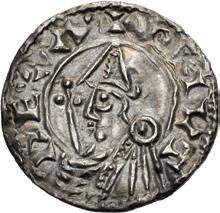
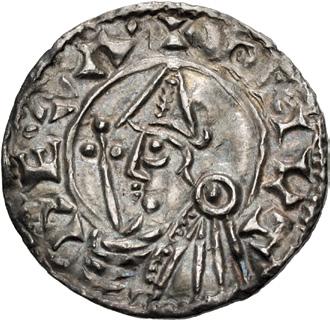
1186. ANGLO-SAXON, Kings of All England. Cnut.

1016-1035. AR Penny (18mm, 1.07 g, 12h). Pointed Helmet type (BMC xiv, Hild. G). Colchester mint; Ælfwine, moneyer. Struck circa 1023-1030. Bust left, wearing pointed helmet; trefoiltipped scepter before / ม ® ⌦ዟዩዢɉ Ḩ ɭn üɭ⌦ Ḩ , voided short cross, limbs united at base by two concentric circles with pellet in center; in each angle, broken annulet enclosing pellet. Turner 78; SCBI 26 (Helsinki), 756 (same dies); North 787; SCBC 1158. Much as struck with significant luster and attractive light golden toning. Choice EF. A charming, if unflattering portrait of Cnut. ($600)
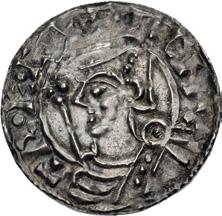
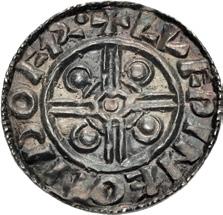
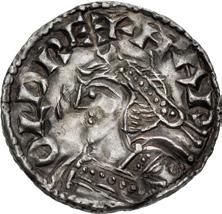

1187. ANGLO-SAXON, Kings of All England. Cnut. 1016-1035. AR Penny (19mm, 0.89 g, 3h). Pointed Helmet type (BMC xiv, Hild. G). Dover mint; Leofwine, moneyer. Struck circa 1023-1030. Bust left, wearing pointed helmet; trefoil-tipped scepter before / ม ⌦⎍ዟዩዢnዞ ɭɃ ዝɭዟʼ/ , voided short cross, limbs united at base by two concentric circles with pellet in center; in each angle, broken annulet enclosing pellet. SCBI 51 (Estonian), 675 (same rev. die); North 787; SCBC 1158. Toned, slightly wavy flan. Good VF. ($500)
From the Causeway Collection, purchased from Baldwin’s, November 2011.
1188. ANGLO-SAXON, Kings of All England. Harold I Harefoot. 1035-1040. AR Penny (18mm, 1.07 g, 12h). Jewel Cross type (BMC i, Hild. A). Lincoln mint; Aslakr, moneyer. Struck 1035-circa 1038. Diademed bust left / ม ∂˫⌦²ü ∂n ⌦ዢnü∂/⌦ , cross composed of four ovals united at base by two concentric circles enclosing a pellet. Mossop pl. LIX, 3 (dies A/a); SCBI 40 (Stockholm), 268 (same dies); North 802; SCBC 1163. Toned, creased, peck marks. VF. ($750)
From the Causeway Collection, purchased from AMR Coins.
318
1187
1188
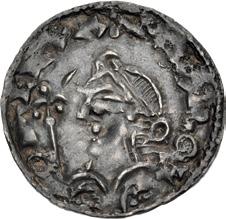

1189. ANGLO-SAXON, Kings of All England. Harold I Harefoot. 1035-1040. AR Penny (18mm, 1.16 g, 12h). Fleurde-lis type (BMC vc, Hild. B). London mint; Beorhtmær, moneyer. Struck circa 1038-1040. Diademed bust left; shield and listipped scepter to left / ม ዛʼ ዢዡͿዦ ʼ ɭn ⌦⎍n , voided long cross; pellet in circle in center, fleur-de-lis (flanked by pellets) in angles. SCBI 40 (Stockholm), 1026-8 (same dies); North 803; SCBC 1165. Toned, worn dies, peck mark. VF. ($750)
From the Causeway Collection, purchased from AMR Coins.
Rare Stamford Mint Harthacnut
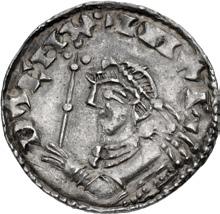


1190. ANGLO-SAXON, Kings of All England. Harthacnut. 1035-1042. AR Penny (18mm, 1.25 g, 12h). Arm and Scepter type (BMC ii, Hild. B). Stamford mint; Godwine, moneyer. Struck 1040-1042. Diademed bust left, holding trefoiltipped scepter / ม űɭዝዩዢnዞ ɭn SͿ©ዦ , quadrilateral, with pellet in center and angles, over voided short cross. Cf. SCBI 40 (Stockholm), 1714; North 811; SCBC 1168. Light golden toning, peck mark. Good VF. Rare. ($2000)
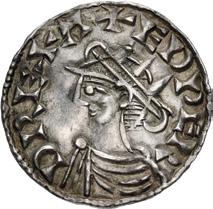

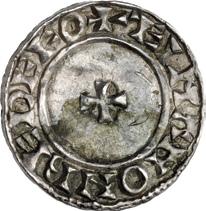
1191. ANGLO-SAXON, Kings of All England. Edward the Confessor. 1042-1066. AR Penny (18mm, 1.10 g, 10h). Radiate/Small Cross (BMC i, Hild. A). Bedford mint; Æthelman, moneyer. Struck circa 1044-1046. Radiate and draped bust left / ม ® ⌦ዦan ɭn ዛዞዝዞዟɭ , short cross pattée. Freeman 2; SCBI 18 (Copenhagen), 746 (same dies); North 816; SCBC 1173. Golden toning, wavy flan, small green deposit, a few peck marks. Good VF. ($500)
From the Causeway Collection, purchased from Baldwin’s.

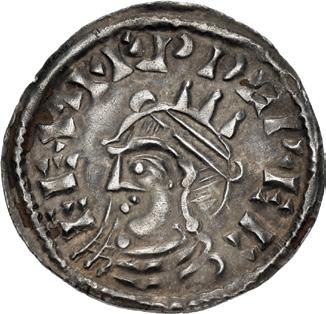

1192. ANGLO-SAXON, Kings of All England. Edward the Confessor. 1042-1066. AR Penny (17mm, 1.05 g, 3h). Radiate/Small Cross (BMC i, Hild. A). Lincoln mint; Ælfnoth, moneyer. Struck circa 1044-1046. Radiate and draped bust left / ม ® ⌦ዟnɭ T ɭ ó ⌦ዢnüɭ⌦ , short cross pattée. Mossop pl. LXVII, 30 (dies A/b); Freeman 22; SCBI 27 (Lincolnshire), 816; North 816; SCBC 1173. Attractively toned, light earthen deposits. VF. ($500)
From the Causeway Collection, purchased from AMR Coins. Ex Dix Noonan Webb 124 (16 September 2014), lot 2402.
319
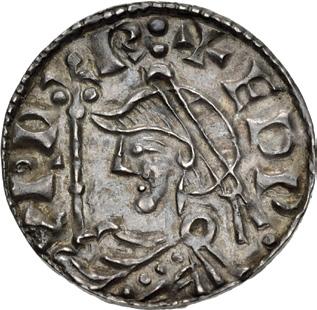


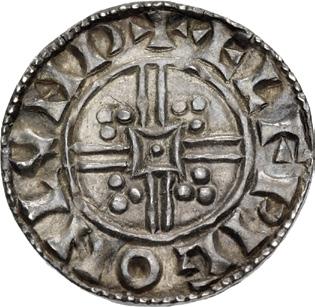
1193. ANGLO-SAXON, Kings of All England. Edward the Confessor. 1042-1066. AR Penny (17mm, 0.94 g, 6h). Trefoil Quadrilateral type (BMC iiic, Hild. Cd). London mint; Ælfwig, moneyer. Struck circa 1046-1048. Diademed and draped bust left; lis-tipped scepter to left / ม
, quadrilateral, with pellet in center and trefoils at angles, over voided short cross. Freeman 113; SCBI 36 (Berlin), 846 var. (rev. legend; same obv. die); North 817; SCBC 1174. Golden toning, slightly weak strike. Good VF. ($500)
From the Causeway Collection, purchased from AMR Coins. Ex E. Curti (Künker 227, 11 March 2013), lot 2368; G.W. de Wit (Künker 137, 11 March 2008), lot 3165.
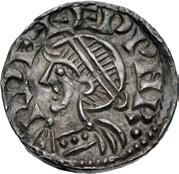
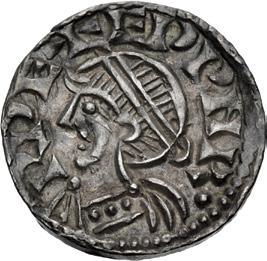
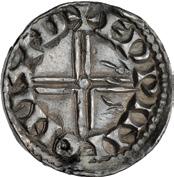
1194. ANGLO-SAXON, Kings of All England. Edward the Confessor. 1042-1066. AR Penny (14mm, 1.05 g, 4h). Small Flan type (BMC ii, Hild. B). London mint; Eadwine, moneyer. Struck circa 1048-1050. Diademed and draped bust left / ม ዞዝዩዢnዞ ɭn
1175. Toned,
, voided short cross with pellet at center. Freeman 344;
From the Causeway Collection.
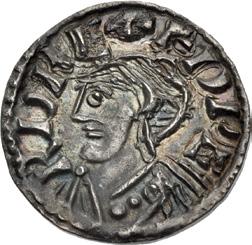
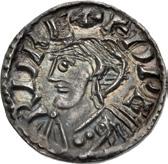

1195.
North

type (BMC ii, Hild. B). London mint; Godwine, moneyer. Struck circa 1048-1050. Diademed and draped bust left / ม űɭዝዩዢ ó ዞ ɭn ⌦ v, voided short cross with pellet at center. EMC 2013.0350 (this coin); Freeman 494; SCBI 20 (Mack), 1159 var. (legends); North 818; SCBC 1175. Iridescent toning, slightly double struck. Good VF. ($500)
From the Causeway Collection. Found at Broom, Bedfordshire, 2013.
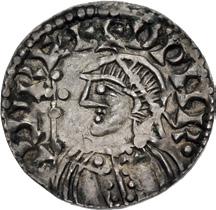
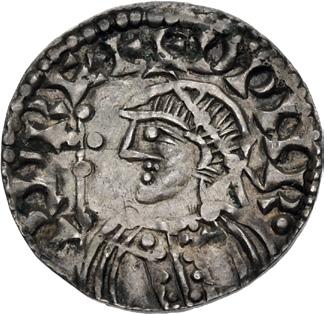

1196. ANGLO-SAXON, Kings of All England. Edward the Confessor. 1042-1066. AR Penny (18mm, 1.05 g, 10h). Expanding Cross type, light issue (BMC v, Hild. E). Steyning mint; Wulfgeat, moneyer. Struck circa 1050-1053. Diademed bust left; scepter to left / ม ዩ⎍⌦űዞͿ ɭn ˞Ϳዞnዢ , voided short cross with expanding limbs; at center, circle around pelletin-circle. King, Steyning 18; Freeman 25 (this coin cited); SCBI 20 (Mack), 1181 (this coin); North 820; SCBC 1176. Toned, some hard green deposits, a few very faint scratches. VF. ($500)
From the Causeway Collection, purchased from T. Owen. Ex R.P. Mack (Part II, Glendining, 23 March 1977), lot 208, purchased from Spink, 1961.
320
® ⌦ዟዩዢű ɭn ⌦⎍nዝ
⌦⎍ዝ
SCBI 20 (Mack), 1157 var. (legends);
818; SCBC
a few peck marks. Good VF. ($500)
ANGLO-SAXON, Kings of All England. Edward the Confessor. 1042-1066. AR Penny (14mm, 0.95 g, 9h). Small Flan
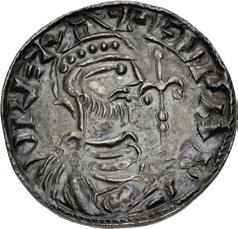


1197. ANGLO-SAXON, Kings of All England. Edward the Confessor. 1042-1066. AR Penny (20mm, 1.24 g, 3h). Pointed Helmet type (BMC vii, Hild. Fb). London mint; Brungar, moneyer. Struck circa 1053-1056. Bust right, wearing pointed helmet and holding scepter fleury / ม ዛʽ⎍nű²ʽ ɭn ⌦⎍nዝዞ , voided short cross with pellet-in-annulet at center and triple crescents at each end. Freeman 206; SCBI 9 (Ashmolean), 873 var. (rev. legend); North 825; SCBC 1179. Toned, slightly porous. VF. ($500)
From the Causeway Collection.
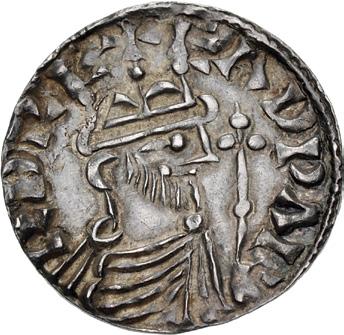
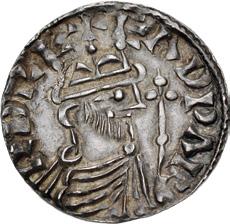
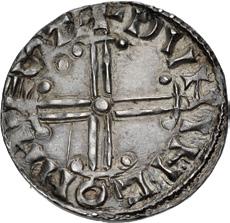
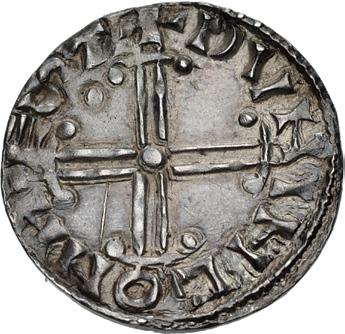
1198. ANGLO-SAXON, Kings of All England. Edward the Confessor. 1042-1066. AR Penny (19mm, 1.33 g, 3h). Hammer Cross type (BMC xi, Hild. G). Hastings mint; Dunning, moneyer. Struck circa 1059-1062. Crowned bust right, scepter before / ม ዝ⎍nዢnü ɭn ዡ ® ˞˸ , voided cross, arms terminating in inward-facing crescents; three pellets in first quarter. Freeman 38; SCBI 1 (Fitzwillian) 917 (same dies); North 828; SCBC 1182. Toned, die scratch, small mark. Good VF. ($500)
From the Causeway Collection, purchased from AMR Coins.

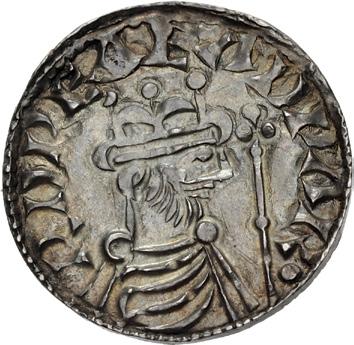

1199. ANGLO-SAXON, Kings of All England. Edward the Confessor. 1042-1066. AR Penny (19.5mm, 1.34 g, 9h). Hammer Cross type (BMC xi, Hild. G). Steyning mint; Deorman, moneyer. Struck circa 1059-1062. Crowned bust right, scepter before / ม ዝዢɭያዦ©n ɭn ˞˸ ® nዢű , voided cross, arms terminating in inward-facing crescents. King, Steyning 25 (same dies); Freeman 8; SCBI 30 (American) 636-8 (same dies); North 828; SCBC 1182. Iridescent toning, scratch. Good VF. ($500)
From the Causeway Collection, purchased from AMR Coins.
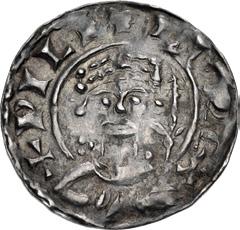


1200. NORMAN. William I ‘the Conqueror’. 1066-1087. AR Penny (20mm, 1.40 g, 1h). Paxs type (BMC viii). Winchester mint; Godwine, moneyer. Struck circa 1083-1086. Crowned facing bust, holding scepter; annulet on right shoulder
/ ม űɭዝዩዢnዞ ɭn ዩዢ ü, cross pattée; letters of ዩ a ҟ S in annulets within quarters. Harvey 2025 (dies F/f); SCBI 18 (Copenhagen), 1361 (same dies); BMC 1083 (same dies); North 848; SCBC 1257. Toned, areas of weak strike, slightly wavy flan. VF. ($500)
321
Rare Double Inscription – Unrecorded Moneyer
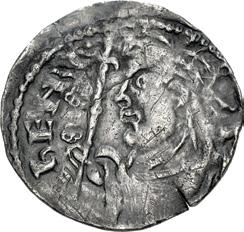
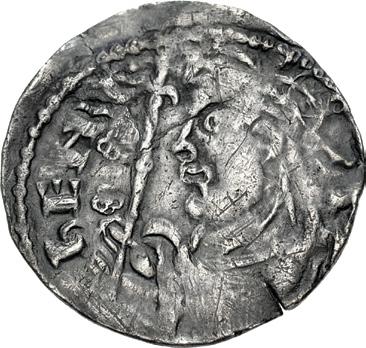
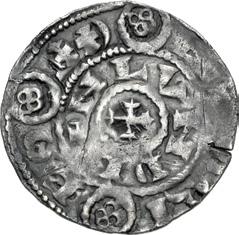
1201. NORMAN. Henry I. 1100-1135. AR Penny (20mm, 1.35 g, 12h). Double Inscription type (BMC xi). London mint; Thured, moneyer. Struck circa 1115. Crowned and draped bust left, holding cross-tipped scepter; two quatrefoils to left / ม T ዞ∂ያ ዢ ® ∂ / ⌦⎍nዝዢ , small cross pattée; quatrefoils-in-annulets in outer legend. SCBI –; BMC –; North 867; SCBC 1272. Toned, edge snick as usual, hairline crack in center, a few light marks and scratches. Near VF. Rare. Good portrait. An unrecorded issue for this moneyer. ($1500)
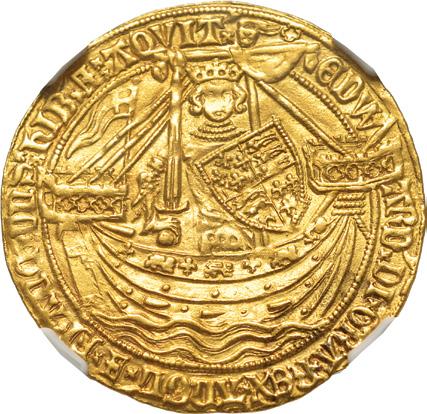


1202. PLANTAGENET. Edward III. 1327-1377. AV Noble (35mm, 7.62 g, 4h). Fourth coinage, Post-Treaty period, Group III. Calais mint. Struck 1369-1377. Edward standing facing in ship, holding sword and shield; ornaments 1-1-1-1, ropes 3/1, quatrefoils 4/4, lis 4; flag at stern / Voided short cross potent over cross fleurée, pellets flanking top and bottom lis; in each angle, crown over lion passant over voided trefoil; at center, E / within quadrilobe; all within polylobe, with trefoils in spandrels. Lawrence 7; Schneider 115 (for type); North 1281; SCBC 1521. In NGC encapsulation 2901843-016, graded MS 62. ($7500)
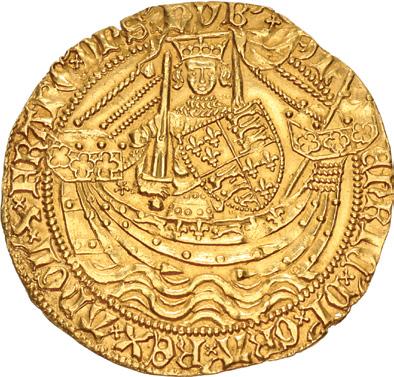
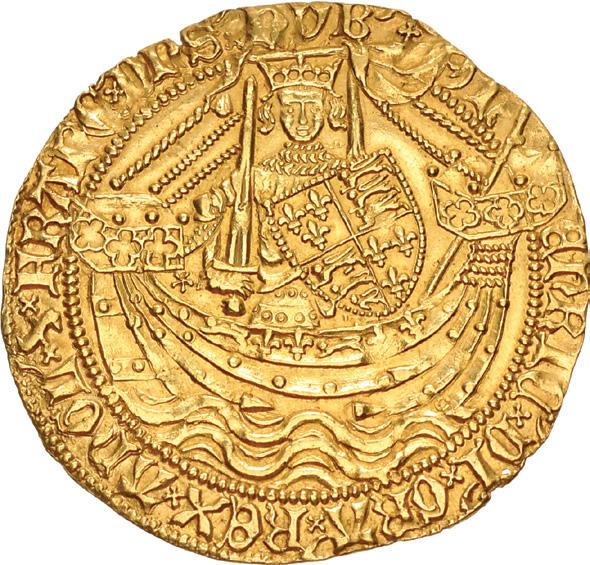
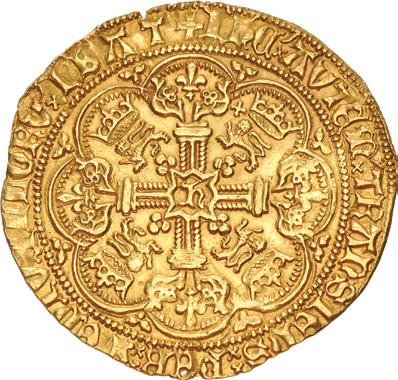
1203. LANCASTER. Henry V. 1413-1422. AV Noble (33mm, 7.05 g, 2h). Class C. Tower (London) mint. Henry standing facing in ship with bowsprit, holding sword and shield; rosette to left of hand; ornaments -11-11, ropes 3/2, quatrefoils 3/3, lis 1-2-1; broken annulet on hull / Voided short cross potent over cross fleurée; in each angle, crown over lion passant over trefoil; at center, ƌ within angled quadrilobe; all within polylobe, with trefoils in spandrels. Schneider 227 (same rev. die); North 1371; SCBC 1742. In NGC encapsulation 6891676-001, graded MS 61. Well struck. ($6000)
322
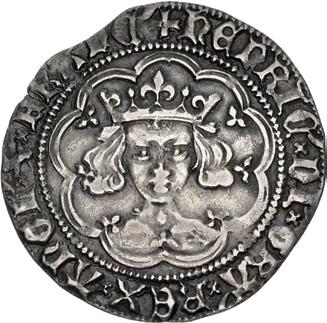
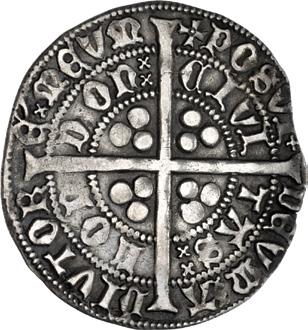
1204. LANCASTER. Henry V. 1413-1422. AR Groat (27mm, 3.40 g, 10h). Class C. London (Tower) mint; im: cross pattée with pellet center. Crowned facing ‘frowning’ bust within tressure of nine arches; mullet on breast / Long cross pattée; triple pellets in quarters. Potter VI; North 1387a; SCBC 1765. Toned, slightly irregular flan, minor porosity. VF. ($600)
Ex Lord Stewartby (Part IV, Spink 242, 29 November 2016), lot 1234, purchased from E.J. Harris, November 2005.

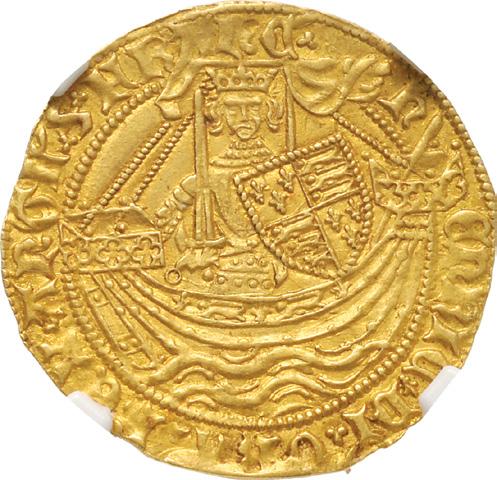
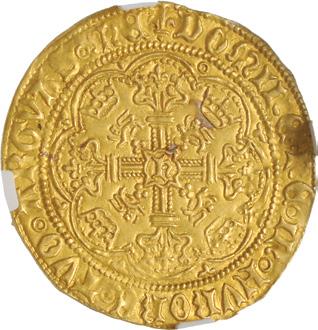
1205. LANCASTER. Henry VI. First reign, 1422-1461. AV Half Noble (26mm, 3.48 g, 2h). Annulet issue. Tower (London) mint. Struck 1422-circa 1430. Henry standing facing in ship, holding sword and shield; annulet to left of hand; ornaments: 1-1-1; quatrefoils: 3/3; f type 1 and N type 1 / Voided short cross potent over cross fleurée; in each angle, crown over lion passant over trefoil; at center, ƌ within angled quadrilobe; all within polylobe, with annulet and trefoils in spandrels. Whitton, Heavy 3b; cf. Schneider 293 (for type); North 1417; SCBC 1805. Richly toned. In NGC encapsulation 2130737-035, graded MS 62. Well struck on a neat, round flan. ($4000)
Ex Dr. Baumhauer Collection; UBS 55 (16 September 2002), lot 3541.
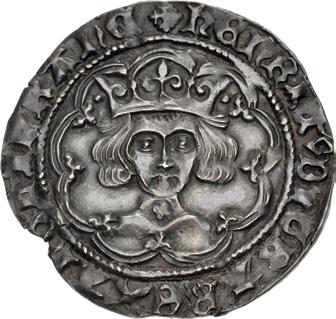
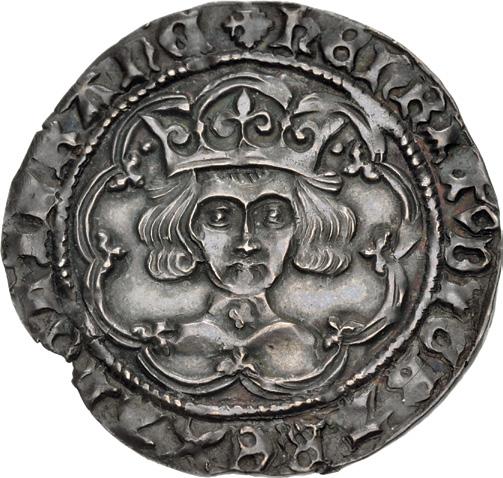
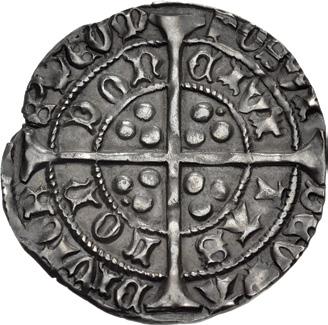
1206. LANCASTER. Henry VI. First reign, 1422-1461. AR Groat (27mm, 3.73 g, 7h). Cross-pellet issue. London mint; im: cross patonce. Struck 1454-1461. Crowned facing bust within tressure of arches; trefoils at cusps; saltire on neck / Long cross pattée; triple pellets in quarters, with additional pellets in second and third quarters. Whitton, Heavy 83d; North 1518; SCBC 1936. Rich old cabinet toning with iridescent highlights, small edge split. Near EF. ($600)
Ex Spink (3 July 2018), lot 544; Spink Numismatic Circular LXXXIV.11 (November 1976), no. 9221; E.C. Carter Collection (purchased en bloc by Baldwin’s, 1951); R. Carlyon-Britton (Seaby Coin & Medal Bulletin 374 [July 1949]), no. 8320.
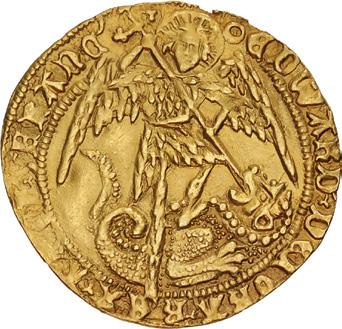
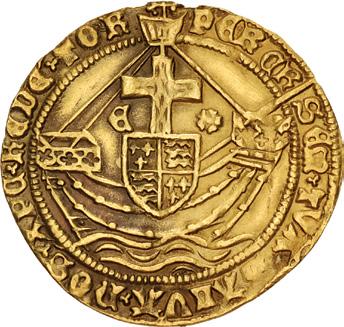
1207. YORK (Restored). Edward IV. Second reign, 1471-1483. AV Angel (29mm, 5.09 g, 11h). Type XIV. Tower (London) mint; im: annulet. Struck 1471-1472. Archangel Michael slaying the Dragon / Ship bearing shield and cross, E and rose flanking cross. Webb-Ware dies 8/15; Blunt & Whitton type XIV, 13 var. (obv. legend); cf. Schneider 455-6 (for type; same obv. die); North 1626; SCBC 2091. Once heated, smoothed and tooled on reverse. VF. Well struck. ($1500)
Ex Spink 111 (21 November 1995), lot 147.
323
Edward IV/V Penny
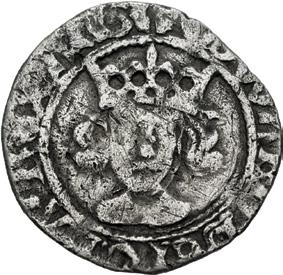
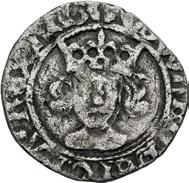
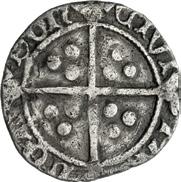

1208. YORK (Restored). Edward IV or V. 1483. AR Penny (16mm, 0.67 g, 5h). Tower (London) mint; im: halved sun and rose. Crowned facing bust / Long cross pattée; trefoils in quarters. Blunt, Edward, pl. 12 (boar’s head im); Stewart, Dies, p. 135; North 1641 (Edward IV); SCBC 2147. Porosity, a few marks. Fine. The king’s name and mintmark clear. Extremely rare. ($1500)
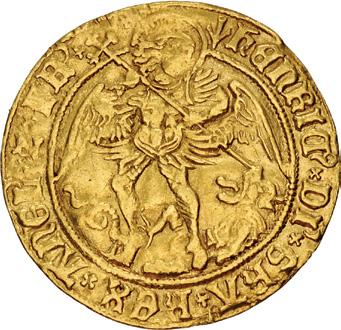

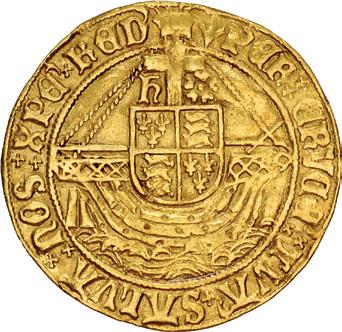
1209. TUDOR. Henry VII. 1485-1509. AV Angel (28mm, 5.03 g, 11h). Type V. Tower (London) mint; im: pheon. Struck 1505-1509. Archangel Michael slaying the Dragon / Ship bearing shield and cross, Ƈ and rose flanking cross. Cf. Schneider 542-4 (same); North 1698; SCBC 2187. In NGC encapsulation 6890893-014, graded AU 55. ($3000)
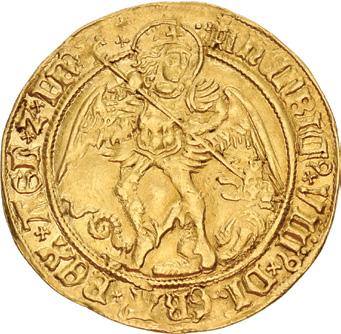

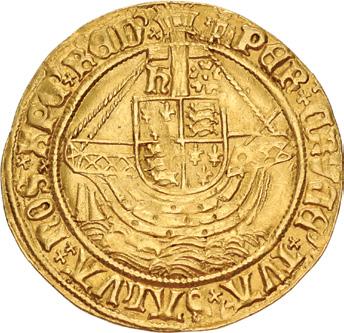
1210. TUDOR. Henry VIII. 1509-1547. AV Angel (28mm, 5.20 g, 7h). First coinage. Tower (London) mint; im: castle. Struck 1509-1526. Archangel Michael slaying the Dragon, spear topped by cross-crosslet / Ship bearing shield and cross, ƌ and rose flanking cross. Schneider 558 var. (legends); North 1760; SCBC 2265. Toned. In NGC encapsulation 6891676-002, graded AU 55. Well struck. ($3000)
Ex Classical Numismatic Auctions XX (25 March 1992), lot 1304.

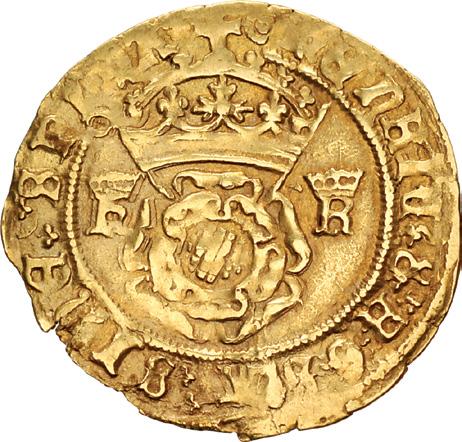
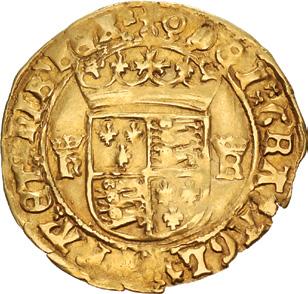
1211. TUDOR. Henry VIII. 1509-1547. AV Crown of the Double Rose (27mm, 3.05 g, 1h). Third coinage. Tower (London) mint; im: pellet-in-annulet. Struck 1544-1547. Crowned double rose; crowned ƌ ˊ flanking / Crowned coat-of-arms; ƌ ˊ flanking. Schneider 632; North 1834; SCBC 2307. In NGC encapsulation 6872545-004, graded AU 58. ($2000)
Ex Dr. Baumhauer Collection. Ex V.J.E. Ryan (Glendining, 28 June 1950), lot 164.
324
Extremely Rare ‘S’ Crown

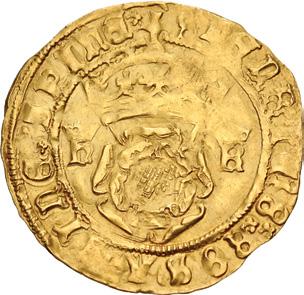

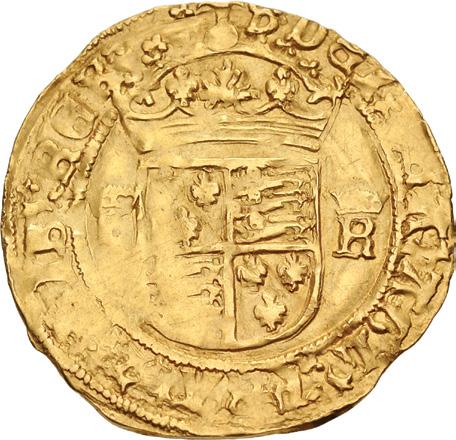
1212. TUDOR. Henry VIII. 1509-1547. AV Crown of the Double Rose (26mm, 3.25 g, 3h). Third coinage. Southwark mint; im: S. Struck 1544-1547. Crowned double rose; crowned ƌ ˊ flanking / Crowned coat-of-arms; ƌ ˊ flanking. Schneider –; North 1835; SCBC 2308. Toned. In NGC encapsulation 689676-003, graded MS 61. Extremely rare. ($5000)
Ex Spink Numismatic Circular CX.1 (February 2002), no. HG0122; V.J.E. Ryan (Glendining 28 June 1950), lot 167.
Whitton indicates that Southwark crowns with the S initial mark are rare, while the Numismatic Circular listing for this piece notes: “No Southwark crown with mint mark S appears to have come on the market since this specimen was offered in the Ryan sale in 1950.” There are no examples on CoinArchives.
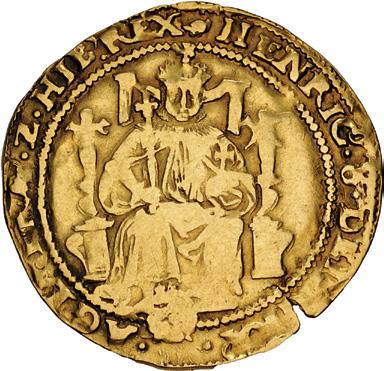
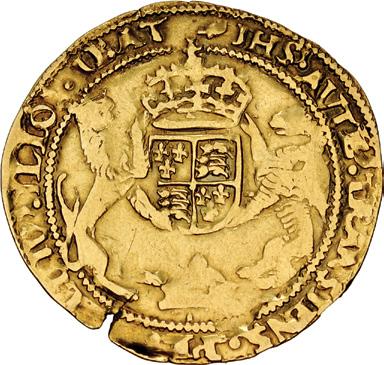
1213. TUDOR. Edward VI. 1547-1553. AV Half Sovereign (5.86 g). Tower (London) mint; im: martlet. Struck in the name of Henry VIII, 1547-1549. Edward seated facing on throne, holding scepter and orb; rose below / Crowned coat-ofarms with lion and griffin as supporters; crown below. Schneider 660 (same rev. die); North 1865; SCBC 2391. In NGC encapsulation 6890874-004, graded VF Details, cleaned. ($2000)
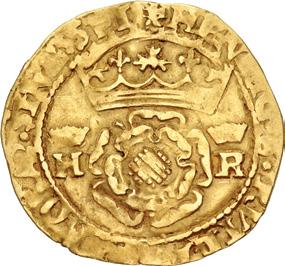
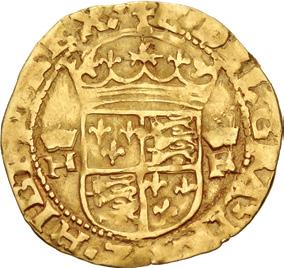
1214. TUDOR. Edward VI. 1547-1553. AV Crown of the Double Rose (23mm, 2.99 g, 12h). Southwark mint; im –/E. Struck in the name of Henry VIII, 1547-1551. Crowned double rose; crowned Ɗ ˊ flanking / Crowned coat-of-arms; Ɗ ˊ flanking. Cf. Schneider 667 (for type); North 1868; SCBC 2398. Lightly toned, clipped, scattered marks. Near VF. ($2000)
Ex P. Finn FPL 14 (1998), no. 10; P. Finn FPL 9 (1997), no. 11.
325
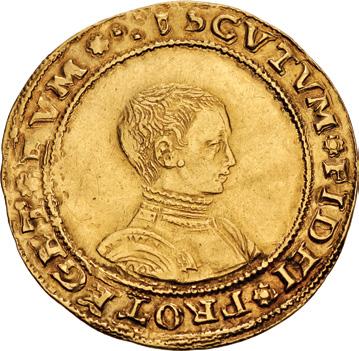
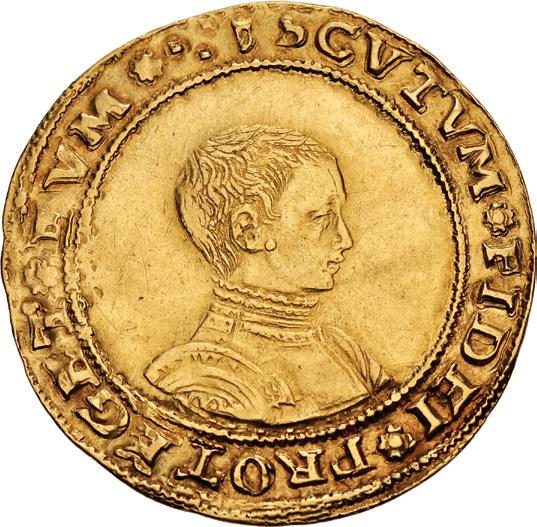

1215. TUDOR. Edward VI. 1547-1553. AV Half Sovereign (30mm, 5.36 g, 12h). Second period. Tower (London) mint; im: arrow. Struck January 1549-April 1550. Bareheaded and armored bust right / Crowned coat-of-arms; E R flanking. Schneider 670; North 1908; SCBC 2435. Toned, a few very light marks and scratches in field. Good VF. A handsome specimen with a well struck portrait. Rare. ($7500)
Ex Spink 129 (17 November 1998), lot 239.
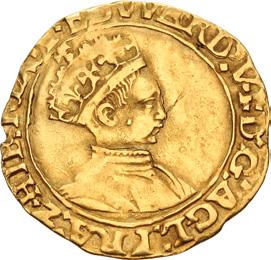
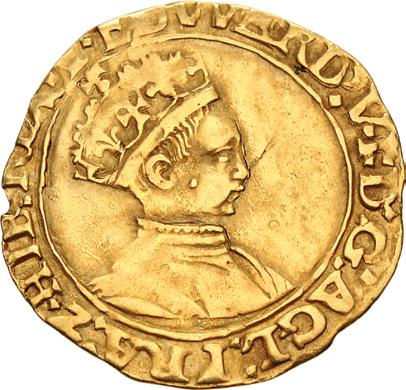
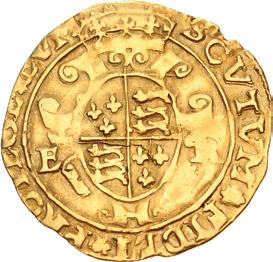
1216. TUDOR. Edward VI. 1547-1553. AV Crown (23mm, 2.69 g, 2h). Second period. Southwark mint; im: Y/–. Struck
January 1549-April 1550. Crowned and armored bust right / Crowned coat-of-arms; E R flanking; rosette stops. Schneider 688 var. (rev. stops); North 1914; SCBC 2442. In NGC encapsulation 6891676-005, graded AU 53. Very rare, particularly so with rosette stops. ($4000)
Ex Patrick Finn FPL 14 (1998), no. 12; V.J.E. Ryan (Glendining, 28 June 1950), lot 243.
Patrick Finn noted: “As far as I can see the only other recorded specimen with rosettes in the reverse legend is in the BM.”



1217. TUDOR. Edward VI. 1547-1553. AV Crown (23mm, 2.76 g, 6h). Second period. Southwark mint; im: Y/–. Struck
January 1549-April 1550. Bareheaded and armored bust right / Crowned coat-of-arms; E R flanking. Schneider –; North 1913; SCBC 2441. Some ghosting. Light scratch on bust. Richly toned. Good VF. Delightful portrait. A very rare coin. ($6000)
Ex Spink Numismatic Circular CIII.3 (June 1995), lot 3290; H. Hird (Glendining, 30 May 1961), lot 20.
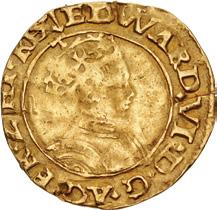

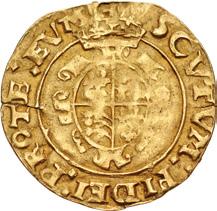
1218. TUDOR. Edward VI. 1547-1553. AV Halfcrown (18mm, 1.30 g, 12h). Second period. Tower (London) mint; im: arrow. Struck January 1549-April 1550. Crowned and draped bust right / Crowned and garnished oval coat-of-arms. Schneider 676 (same dies); North 1916; SCBC 2444. Wavy flan, flan crack, minor edge marks. Toned. VF. Very rare. ($3000)
326
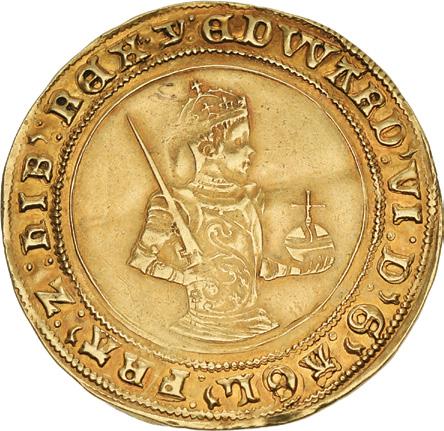
Pedigreed Edward Sovereign
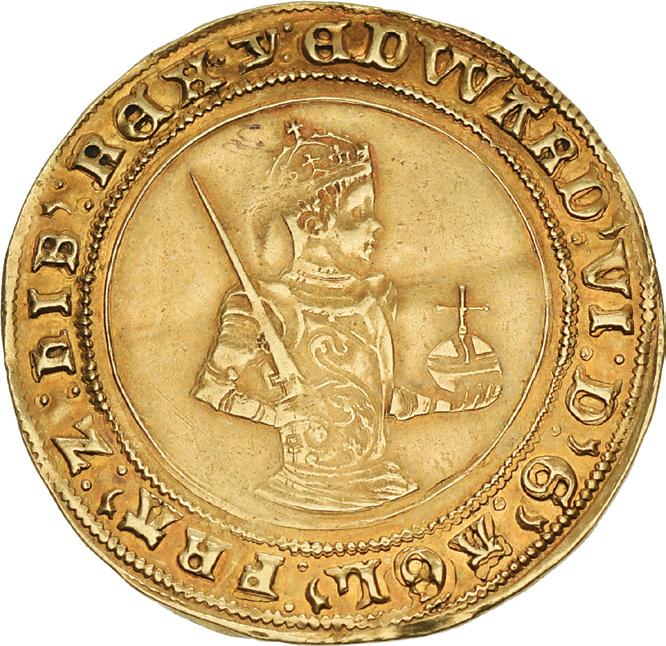
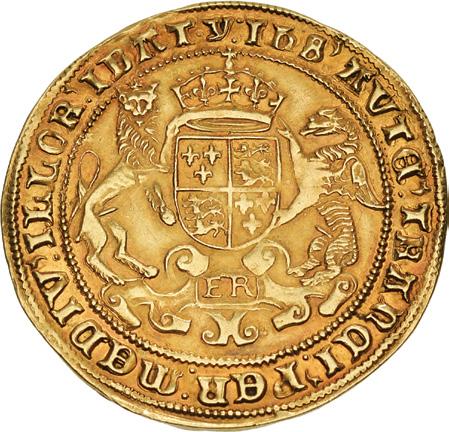
1219. TUDOR. Edward VI. 1547-1553. AV Sovereign (37mm, 11.16 g, 11h). Third period, crown gold coinage. Tower (London) mint; im: У. Struck 1551–1553. Crowned and armored half-length bust right, holding sword over right shoulder and globus cruciger in left hand / Crowned coat-of-arms with crowned leopard and griffin supporters; all set on ornate frame with central titulus inscribed ⌓ˊ . Schneider 690; North 1927; SCBC 2450. Richly toned with underlying luster. In NGC encapsulation 6844908-002, graded XF 45. A pleasing and well pedigreed example of this rare Sovereign. Conservatively graded by NGC in our opinion. ($15,000)
Ex Dr. Paul Broughton (Spink 235, 22 March 2016), lot 434; Spink 181 (30 March 2006), lot 1028; Glendining (6 June 1991), lot 841; Glendining (17 June 1962), lot 20; C.H.B. Morton, Earl of Ducie (Glendining, 5 October 1949), lot 16.
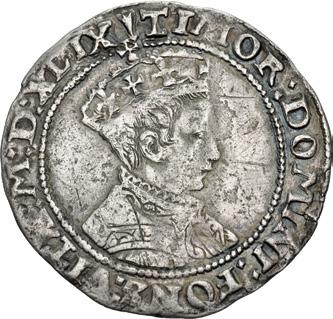
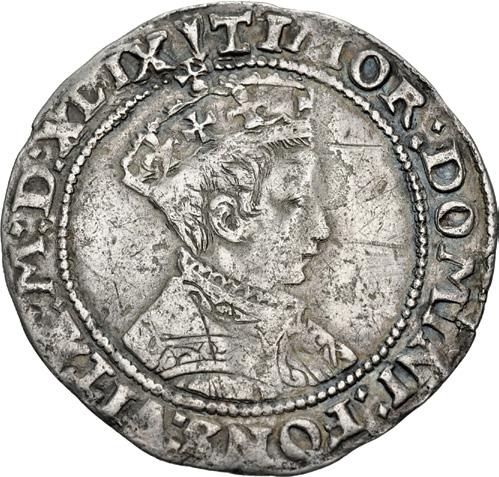
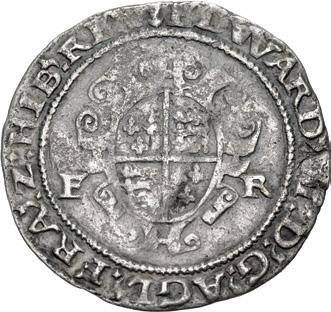
1220.
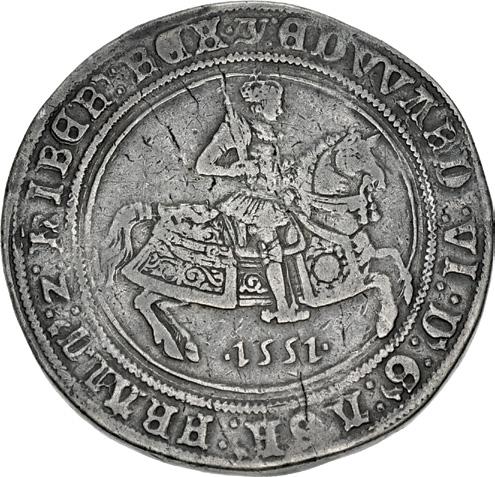

1221.
327
TUDOR. Edward VI. 1547-1553. Base AR Shilling (28mm, , 5h). Second period, first issue. Tower (London) mint; im: arrow. Dated 1549 (in Roman numerals). Crowned bust right (Bust 1) / Coat-of-arms; E R flanking. North 1918/1; SCBC 2465. Toned, porosity, scratches, light crease. Near VF. Rare. ($1000)
TUDOR. Edward VI. 1547-1553. AR Crown (41mm, 30.83 g, 3h). Third period; Fine Silver issue. Tower (London) mint; im: Y. Dated 1551. Edward, armored and holding sword, on caparisoned horse right / Coat-of-arms over long cross fourchée. Woodbridge dies A/8; North 1933; SCBC 2478. Toned, scattered marks and scratches. Near VF. ($1500)
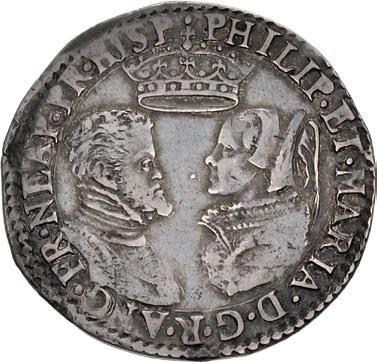
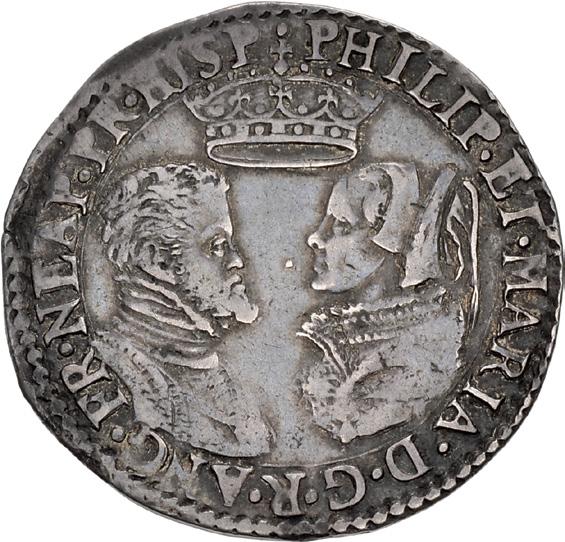
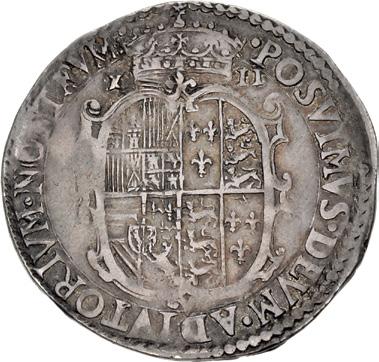
1222.
Ex Spink Numismatic Circular C.6 (July 1992), no. 4209.
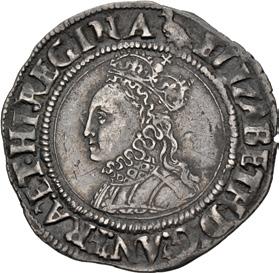
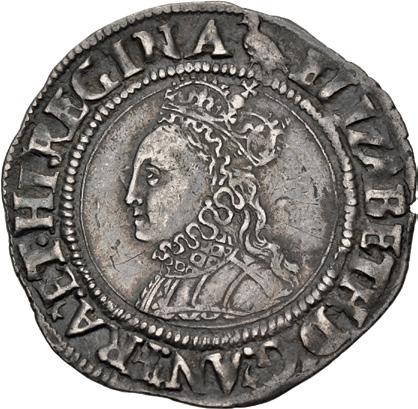
1223. TUDOR. Elizabeth I. 1558-1603. AR Groat (23mm, 2.19

1560-1561. Crowned bust 1F left, wearing ruff / Crowned coat-of-arms over long cross fourchée. BCW MR-1F/MRb4; North 1986; SCBC 2556. Toned, minor deposits in legend. Good VF. Exceptional portrait. ($600)
Ex Classical Numismatic Review 18.1 (First Quarter 1993), no. 586.

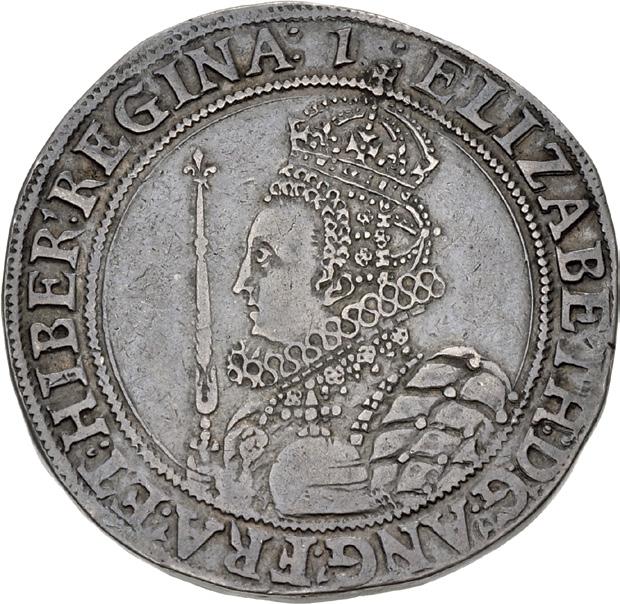
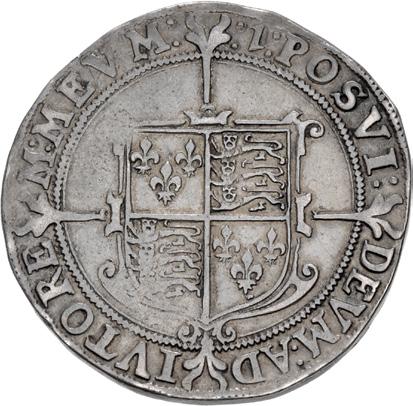
1224.
Ex Spink Numismatic Circular C.1 (February 1992), no. 196 (”An excellent specimen
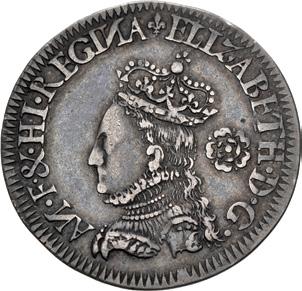
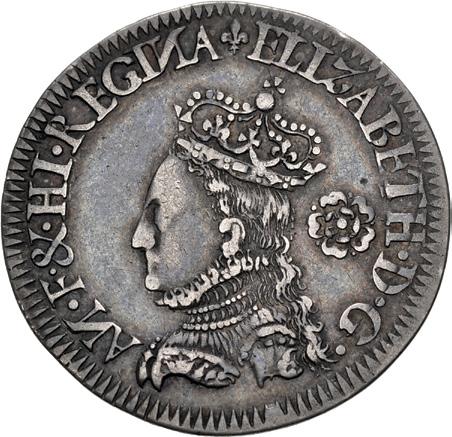

328
TUDOR. Philip & Mary. 1554-1558. AR Shilling (31mm, 6.25 g, 10h). Tower (London) mint. Confronted busts of Philip, armored, and Mary, veiled; crown above / Crowned coat-of-arms; X II (mark of value) flanking crown. North 1967; SCBC 2498. Richly toned. VF. A pair of well struck portraits. ($2500)
g, 5h). Second issue. Tower (London) mint; im: martlet. Struck
TUDOR. Elizabeth I. 1558-1603. AR Halfcrown (35mm, 14.98 g, 7h). Seventh issue. Tower (London) mint; im: 1. Struck 1601. Crowned and draped bust left, holding lis-tipped scepter and orb, and wearing ruff / Coat-of-arms over long cross fourchée. BCW 1-1/1-a1; North 2013; SCBC 2583. Attractive blue toning. Good VF. Evenly struck. ($2000)
with very good unblemished surfaces in the fields. Almost EF”).
1225. TUDOR. Elizabeth I. 1558-1603. AR Shilling (25mm, 2.88 g, 6h). Milled coinage. Tower (London) mint; im: lis. Dated 1570. Crowned bust G left, wearing ruff; rose to right / Coat-of-arms over long cross fourchée. Borden & Brown 42 (O1/R1); North 2031; SCBC 2600. Toned, circular die flaws on both sides, minor edge ding. Good VF. A high grade example of this rare late issue. ($1000)

Gloriana Defined


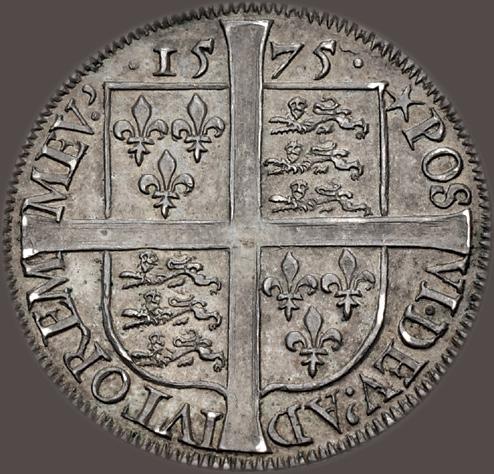
1226. TUDOR. Elizabeth I. 1558-1603. Pattern AR Threepence (20mm, 1.51 g, 6h). Milled coinage. Tower (London) mint; im: mullet. Dies by Derek Anthony(?). Dated 1575. ELIZABETH · D’· G’· ANG FRA & · HIB REGINA ★, crowned bust left, wearing ruff; rose to right / ★ POS VI · DEV’· AD IVTOREM MEV’·, plain cross over shield; · 15 75 · above. Borden & Brown 52 (O1/R1; this coin cited); North 2048. Richly toned with traces of underlying luster. Superb EF. A magnificent coin of the highest rarity. ($25,000)
Ex Saunders Collection, purchased from Seaby, February 1959; R. Carlyon-Britton Collection; R.C. Lockett (Part II, 11 October 1956), lot 2057; Sir John Evans Collection; J.G. Murdoch (Sotheby, Wilkinson, & Hodge, 31 March 1903), lot 663 (’a gem’); H. Montagu (Sotheby, Wilkinson, & Hodge, 13 November 1896), lot 130, purchased 1883; S. Addington Collection; R.M. Murchison (Sotheby, Wilkinson, & Hodge, 27 June 1864), lot 195; T.F. Dymock (Sotheby & Wilkinson, 1 June 1858), lot 271.
This beautiful coin belongs to a very small issue of pattern silver Sixpences and Threepences struck in 1574 and 1575 using the machinery installed in the mint by Eloy Mestrelle for his earlier milled coinage. The dies, most probably the work of Derek Anthony, were modeled on the earlier milled currency issues but engraved in much higher relief, portraying the Virgin Queen as Gloriana defined, wearing a richly jeweled dress and with flowing hair which prefigures Anthony’s later hammered gold portrait issues. Today only two Sixpences are known, both in museums. Four Threepences are recorded; one in the BM, another in the Fitzwilliam Museum, the Comber specimen, and the coin offered here which has a peerless pedigree and is also the finest known.
Pattern Penny

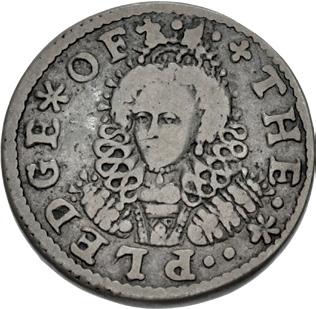

1227. TUDOR. Elizabeth I. 1558-1603. Cast AR Pattern Pledge Penny (18mm, 2.42 g, 6h). Dated 1601. · + THE · (star)
· · PLEDGE (star) OF + ·, crowned and draped bust facing slightly left, wearing elaborate collar / · · A · PEN NY · ·, crowned monogram; 16 01 across field. Peck 3; North 2051. Toned, faint edge scratches. Good Fine. Rare. ($750)
Ex Saunders Collection; Glendining (27 May 1957), lot 133.
329
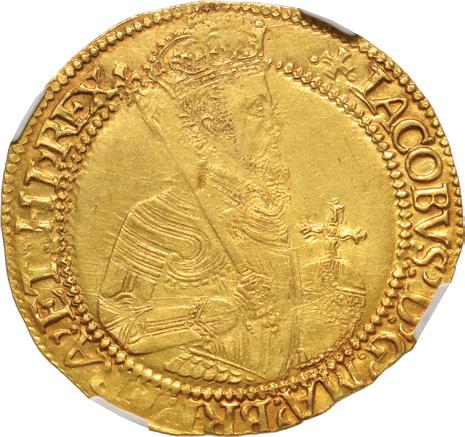
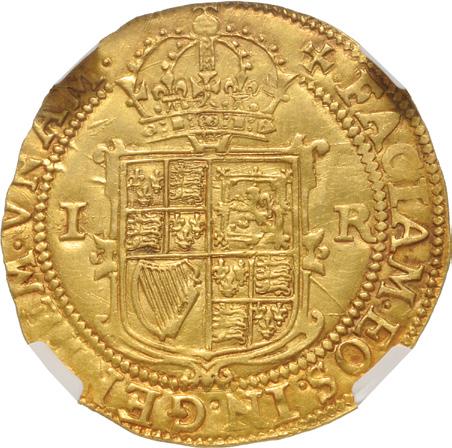
1228. STUART. James I. 1603-1625. AV Unite (37mm, 10.22 g, 9h). Second coinage, crown gold. Tower (London) mint; im: plain cross. Struck 1618-1619. Crowned and armored half-length bust right, holding lis-tipped scepter and globus cruciger / Crowned coat-of-arms; I R flanking. Schneider –; North 2085; SCBC 2620. In NGC encapsulation 6380983-009, graded “Genuine.” Our grade Good VF, hairlines, slightly weakly struck on face. ($2000)
Ex 2019 Ellerby Hoard (PAS: YORYM-18E848).
In 2019, a couple were undertaking renovations to their eighteenth century home in the village of Ellerby near Hull in North Yorkshire when they discovered a hoard of 266 gold coins in a stoneware vessel under their kitchen floor. The hoard comprised of coins from the reigns of James I to George I. As the original owner of the property where the hoard was found could be traced, the coins were not subject to the usual law of Treasure. The discovery and subsequent sale was widely reported around the world making the Ellerby hoard one of the most celebrated British coin finds of recent years.

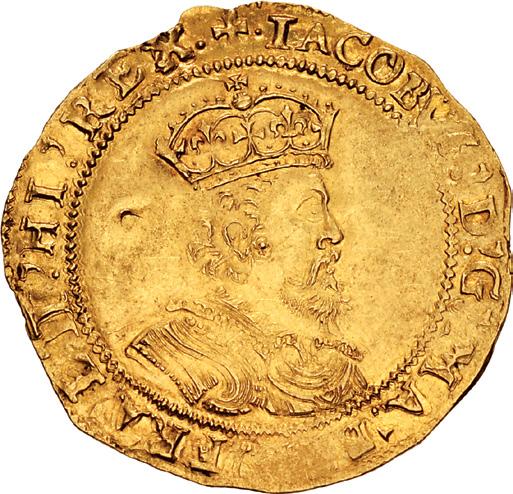
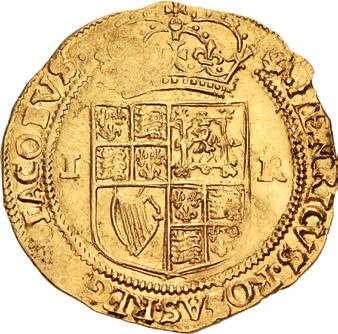
1229. STUART. James I. 1603-1625. AV Double Crown (29mm, 5.03 g, 10h). Second coinage, crown gold. Tower (London) mint; im: plain cross/(plain cross over crescent). Struck 1618-1619. Crowned fifth bust right / Crowned coat-ofarms. Cf. Schneider 41; North; SCBC 2623. Lustrous, area of weak strike, slightly wavy flan, small dig in obverse field. Good VF. ($1500)


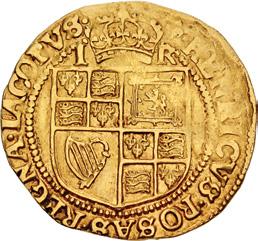
1230. STUART. James I. 1603-1625. AV Britain Crown (22mm, 2.36 g, 5h). Second coinage, crown gold. Tower (London) mint; im: lis. Struck 1604-1605. Crowned and mantled first bust right / Crowned coat-of-arms. Schneider 43-4; North 2090; SCBC 2624. Deposits, creased, slightly clipped, light scratches. VF. ($750)
330
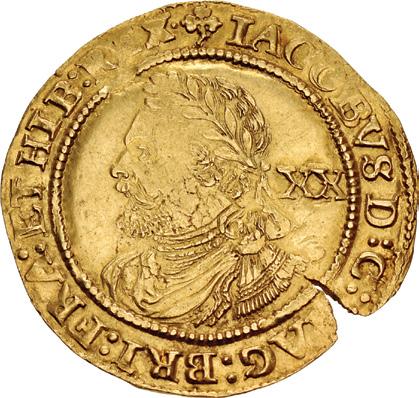
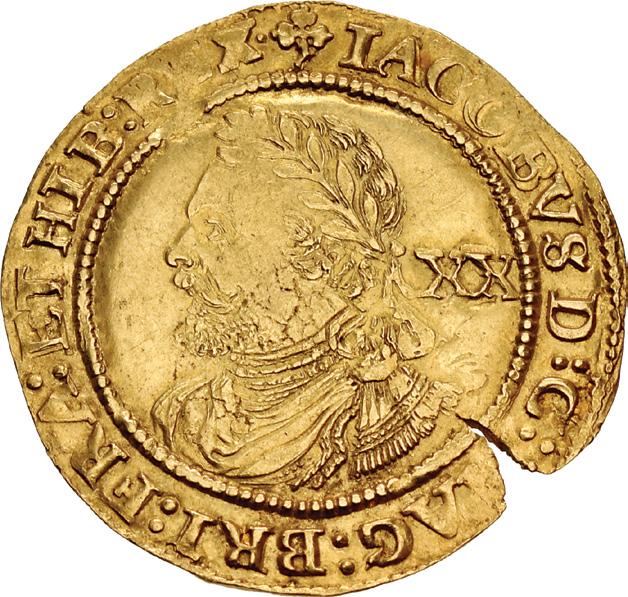
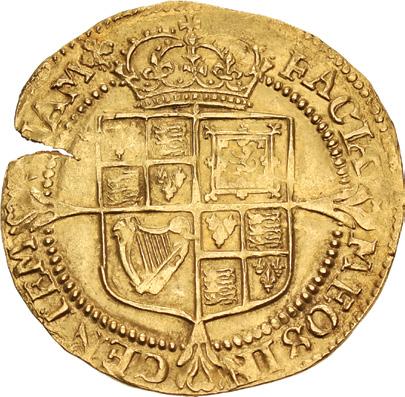
1231. STUART. James I. 1603-1625. AV Laurel (34mm, 8.95 g, 10h). Third coinage, crown gold. Tower (London) mint; im: lis. Struck 1623-1624. Laureate fourth bust left; XX (mark of value) to right / Crowned coat-of-arms over long cross fourchée. Schneider –; North 2114; SCBC 2638B. In NGC encapsulation 6872545-005, graded MS 61. Small striking split but highly lustrous. ($3000)
Ex Baldwin’s 52 (25 September 2007), lot 356.

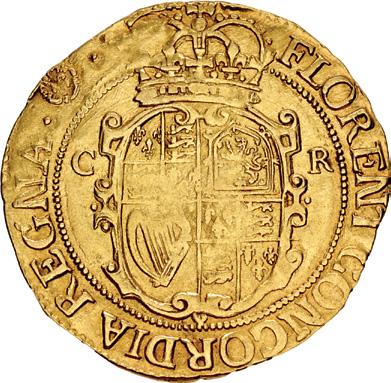
1232. STUART. Charles I. 1625-1649. AV Unite (33mm, 9.01 g, 5h). Group C, class IIa. Tower (London) mint; im: (rose over plumes)/rose. Struck 1631-1632. Crowned bust 3a left, wearing ruff; XX (mark of value) to right / Crowned and garnished coat-of-arms; C R flanking. Brooker 72 (same obv. die); cf. Schneider 143 (for type); North 2150; SCBC 2690. In NGC encapsulation 6877475-001, graded AU 55. ($2000)


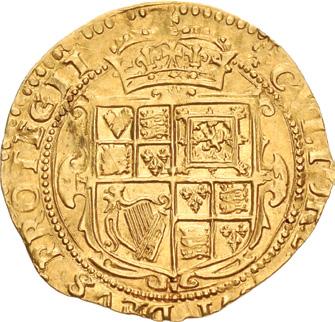
1233. STUART. Charles I. 1625-1649. AV Double Crown (28mm, 4.51 g, 4h). Group A, class II. Tower (London) mint; im: lis. Struck 1625. Crowned and mantled bust left, wearing ruff; X (mark of value) to right / Crowned coat-of-arms. Brooker 127 var. (obv. legend); Schneider 174 var. (same); North 2159; SCBC 2698. In NGC encapsulation 6529307-002, graded AU 58. Top Pop ($2500)
Ex Lord Stewartby (Part III, Spink 239, 26 September 2016), lot 1027, purchased from Baldwin’s, September 2003.
331
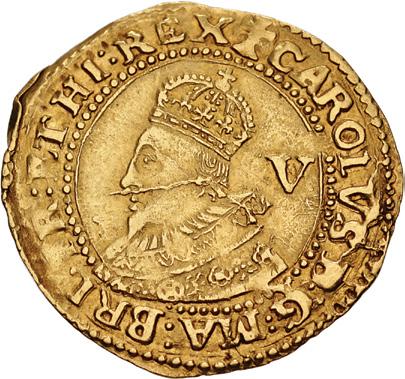

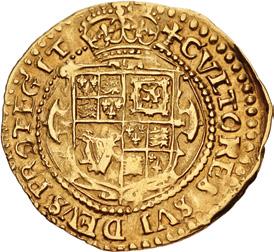

1234. STUART. Charles I. 1625-1649. AV Crown (23mm, 2.22 g, 11h). Group A, class Ia. Tower (London) mint; im: (cross calvary over lis)/cross calvary. Struck 1625-1626. Crowned bust 1 left, wearing ruff; V (mark of value) to right / Crowned and garnished coat-of-arms; C R flanking. Cf. Brooker 185-6 (for type); cf. Schneider 223 (same); North 2180; SCBC 2710. In NGC encapsulation 6887461-003, graded MS 61. Minor die flaws. Rare mint mark. ($1500)

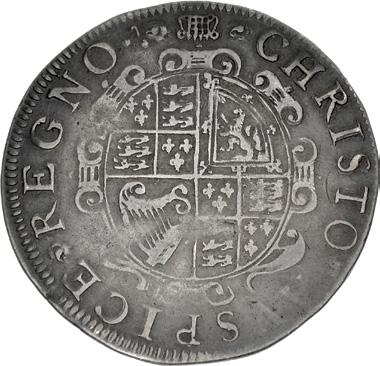
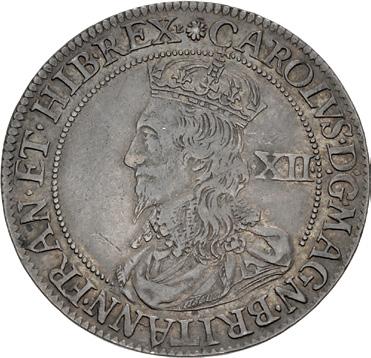
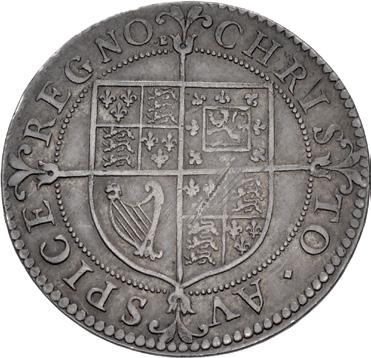
1235. STUART. Charles I. 1625-1649. Pattern AR Shilling (31mm, 5.95 g, 10h). Tower (London) mint; im: portcullis. Struck 1633-1634. (portcullis) CAROLVS · D’· MAG’· BR’· FR’· ET · HI’· REX ·, crowned bust left; XII (mark of value) to right / (rosette) (portcullis) (rosette) CHRISTO· AVSPICE · REGNO ·, coat-of-arms. Brooker 1265 (same dies); North 2698. Areas of weak strike. Fine. ($750)
Ex Saunders Collection; Seaby Coin & Medal Bulletin 522 (November 1961), no. 7854; W.D. Ferguson Collection; Seaby Coin & Medal Bulletin 491 (April 1959), no. 4672; R. Carlyon-Britton Collection; V.J.E. Ryan (Part II, Glendining, 22 January 1952), lot 1122.
1236. STUART. Charles I. 1625-1649. AR Shilling (31mm, 5.92 g, 6h). Briot’s First Milled issue. Tower (London) mint under Briot; im: B and flower/B. Struck 1631-1632. Crowned bust left; ·XII· (mark of value) to right / Coat-of-arms over long cross moline. Brooker 716 (same obv. die); North 2300; SCBC 2854. Toned, small scratch in reverse legend, minor adjustment marks. VF. Rare. ($1000)
Ex Saunders Collection; V.J.E. Ryan (Part II, Glendining, 22 January 1952), lot 1139 (part of).


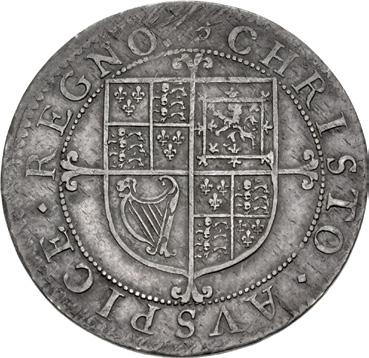
1237. STUART. Charles I. 1625-1649. AR Shilling (31mm, 5.73 g, 6h). Briot’s Second Milled issue. Tower (London) mint under Briot; im: B and anchor. Struck 1638-1639. Crowned bust left; XII (mark of value) to right / Coat-of-arms over long cross fourchée. Brooker 728a (same dies); North 2305; SCBC 2859. Toned, minor adjustment marks. Good VF. ($1000)
Ex Saunders Collection, purchased from Seaby, 1949.
332
1235
1236
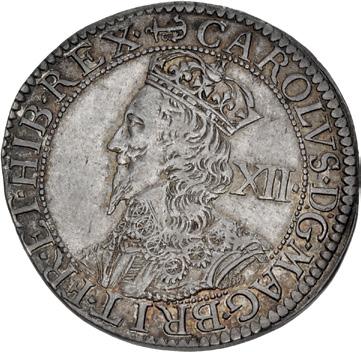
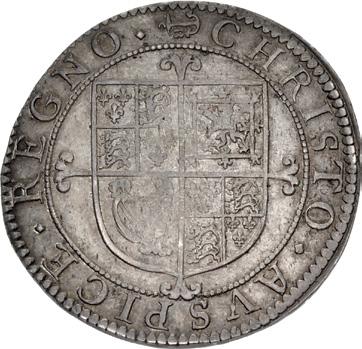
1238. STUART. Charles I. 1625-1649. AR Shilling (30mm, 5.85 g, 6h). Briot’s Second Milled issue. Tower (London) mint; im: anchor and в. Struck 1638-1639. Crowned and mantled; XII (mark of value) to left / Coat-of-arms over cross moline. Brooker 725 (same dies); North 2305; SCBC 2859. Attractive cabinet toning, faint scratch. Good VF. ($500)
Ex Arthur M. Fitts III (Triton XXIV, 19 January 2021), lot 1403; CNG inventory 942454 (March 2013); Dix Noonan Webb 104 (5 December 2012), lot 256.
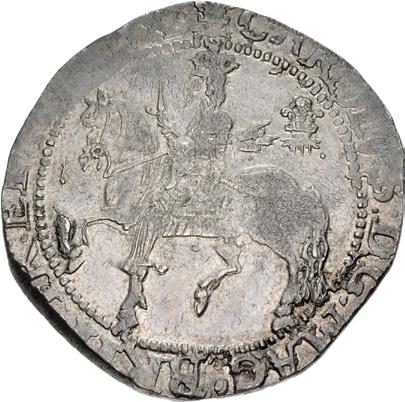
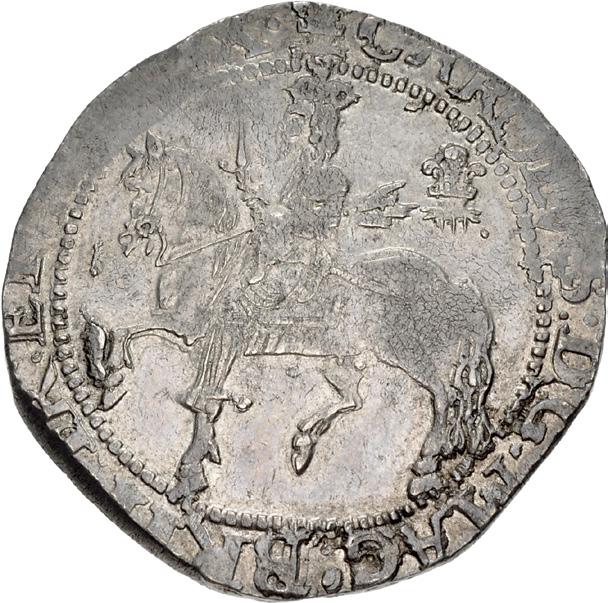
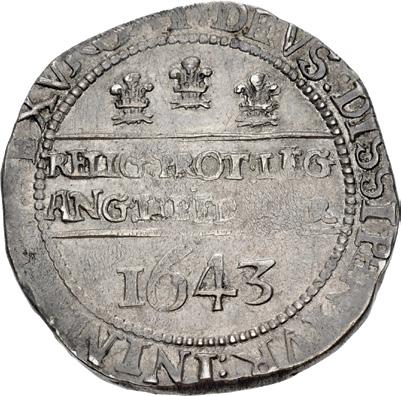
1239. STUART. Charles I. 1625-1649. AR Halfcrown (32mm, 14.29 g, 6h). Declaration type. Oxford mint; im: plumes/–. Dated 1643. Charles on horseback riding left, holding sword and reins; plumes to right / RELIG : PROT : LEG/ANG : LIBER : PAR in two lines between parallel lines; three plumes above; 1643 below. Bull, Oxford 601F; Bull 602/3; Brooker 888-90 (same obv. die); North 2413; SCBC 2954. In NGC encapsulation 6874768-004, graded AU 55. Much as struck. ($2000)
Ex M. Bull Collection; Spink Numismatic Circular CXIV.4 (August 2006), no. HS2555.

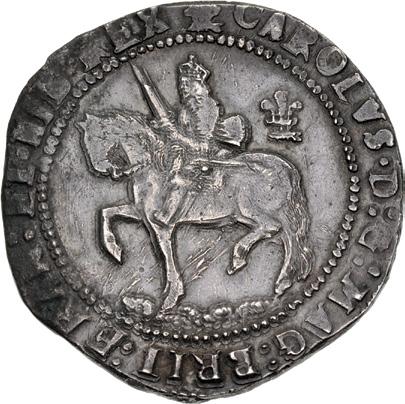
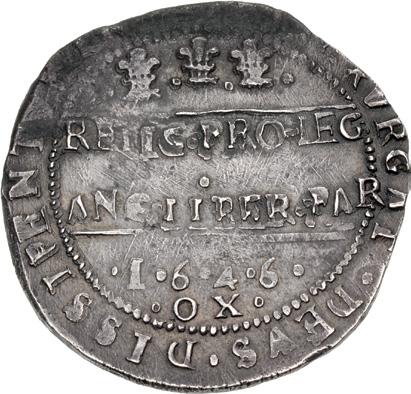
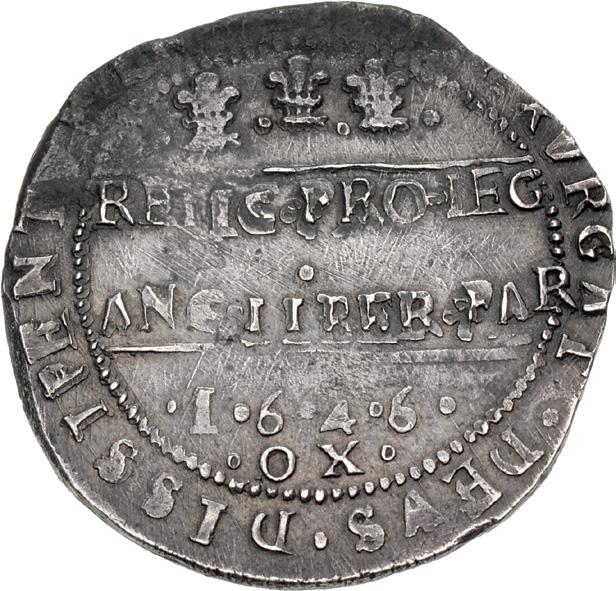
1240. STUART. Charles I. 1625-1649. AR Halfcrown (34mm, 14.73 g, 4h). Declaration type. Oxford mint; im: plumes/–. Dated 1646. Charles on horseback riding left, holding sword and reins; plumes to right / RELIG · PRO · LEG/ ·/ ΛNG · LIBER · PΛR in two lines between parallel lines; three plumes above; ·1·6·4·6·/ · OX · below (annulet stops). Bull, Oxford 625F; Bull 632/4; Brooker 923 (same rev. die); North 2434; SCBC 2961. Toned, small area of roughness near rim, slightly double struck. Near EF. Very rare. ($2000)
Ex M. Bull Collection; J. Hulett (Part V, Dix Noonan Webb 147, 12 June 2018), lot 384, purchased from P. Wallwork, March 1993.
333
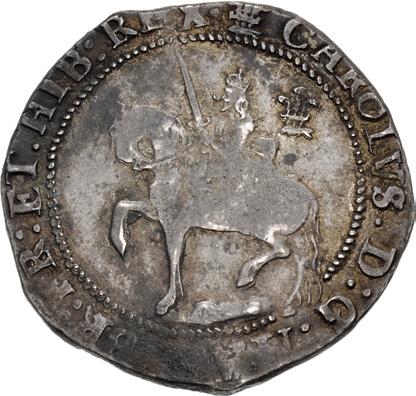

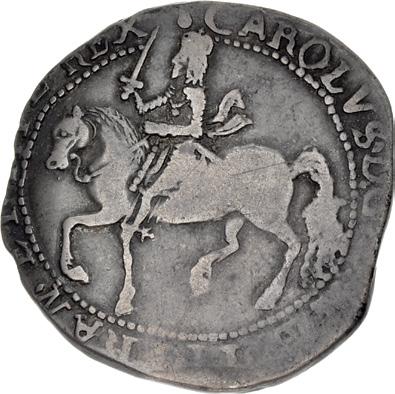

1241. STUART. Charles I. 1625-1649. AR Halfcrown (34mm, 14.99 g, 8h). Declaration type. Oxford mint; im: plumes/–.
Dated 1644. Charles on horseback riding left, holding sword and reins; plumes to right / RELIG : PROT : LEG :/ANG : LIBER : PARL : in two lines between parallel lines; large Oxford plume between two small Shrewsbury plumes above; 1644/ OX below. Bull, Oxford 616O; Bull 612/19 (unlisted combination); Brooker 907 (same rev. die); North 2425; SCBC 2965A. Toned, some deposits, area of weak strike. Near EF. ($1500)
Ex M. Bull Collection; A. Launchbury (Dix Noonan Webb 122, 2 April 2014), lot 114, purchased from Mrs. Sheen, January or November 1946; Circa 1910 Bledington Manor, Gloucestershire Hoard.
Around 1910, a hoard of eleven or so halfcrowns of Charles I was discovered in the roof of the manor house at Bledington, Gloucestershire. Bledington is a few miles from site of the last pitched battle of the first English Civil War, which was fought at Stow-on-the-Wold on 21 March 1646 resulting in a Parliamentary victory. The hoard was purchased by Arthur Lainchbury in two parcels in February and November 1946, and shortly afterward was shown to both Seaby and Spink. Reportedly six halfcrowns were of Oxford, two of Bristol, and three of the Tower.
1242. STUART. Charles I. 1625-1649. AR Halfcrown (33mm, 14.65 g, 12h). Hartlebury Castle, Worcester mint; im: pear/ three pears. Struck 1646. Charles on horseback left, holding reins and sword / Garnished coat-of-arms; H C in lower garnish. Bull 679 (same dies); Brooker 1137 (same dies); North 2626; SCBC 3129. Toned, edge bump. Near VF. Very rare. ($1500)
Hartlebury Castle, the residence of the Bishop of Worcester, was fortified and held by Royalist supporters during the English Civil War. Though prepared for a lengthy siege, the castle surrendered without a single shot fired after being besieged by Colonel Thomas Morgan for only two days. Morgan ordered fortifications to be slighted. The residence was later sold to a private citizen by the Parliamentary Commissioners.
High Grade Pontefract Shilling
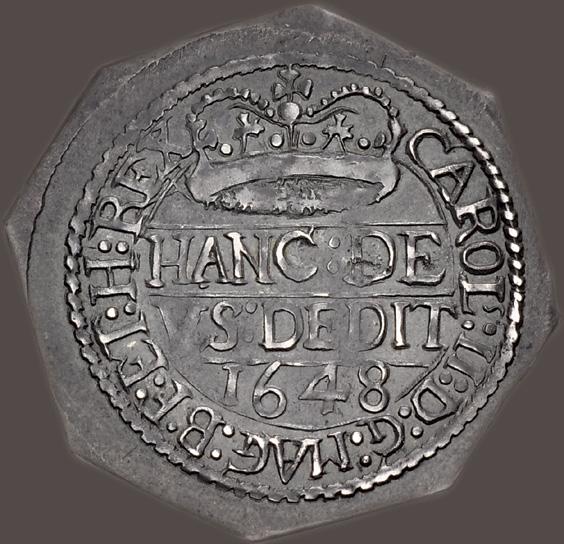
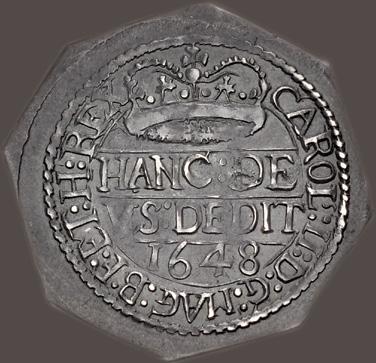
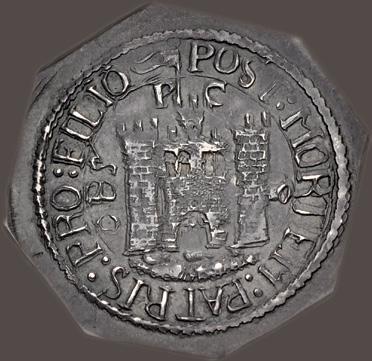

1243. STUART, Siege money. Pontefract. 1648-1649. AR Shilling (28mm, 3.85 g, 12h). In the name of Charles II. Dated 1648. CAROL’ : II : D : G : MAG : BR · ET : H : REX, crown; below, HANC : DE/VS : DEDIT/ I648 in three lines / POST : MORTEM : PATRIS : PRO : FILIO, castle gateway with flag; OBS to left, P C above, cannon protruding to the right. Brooker 1235 (same dies); North 2649; SCBC 3151. Deep old toning, minor cabinet friction on high points. EF. Well struck. Rare, especially so in this exceptional condition. ($10,000)
Ex Baldwin’s FPL (Summer 2014), no. BH146; ‘Wolfson Trust’ (Sotheby’s, 13 February 1986), lot 122.
334
1241 1242

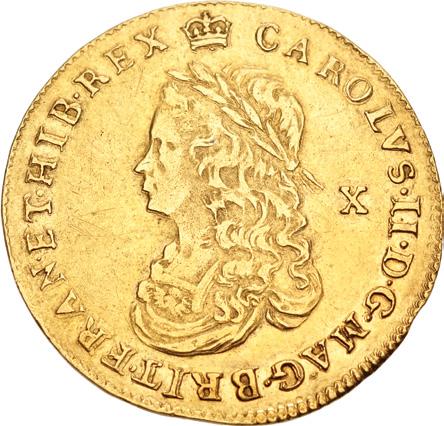
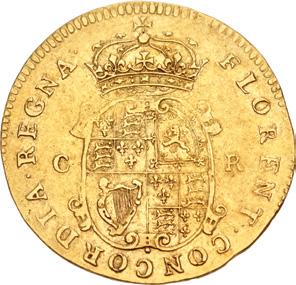
1244. STUART. Charles II. 1660-1685. AV Double Crown (25mm, 4.48 g, 3h). Hammered coinage, second issue. Tower (London) mint; im: crown. Struck 1660-1662. Laureate, draped, and cuirassed bust left; X (mark of value) to right / Crowned coat-of-arms. Schneider, Hammered dies O3/R5; Schneider 417 (same dies); North 2756; Bull, Gold I 161; SCBC 3305. In NGC encapsulation 6844936-001, graded AU Details, obv. scratched. Toned. Evenly struck on a broad flan. Very rare. ($4000)
Ex Glendining (18 November 1970), lot 1999.
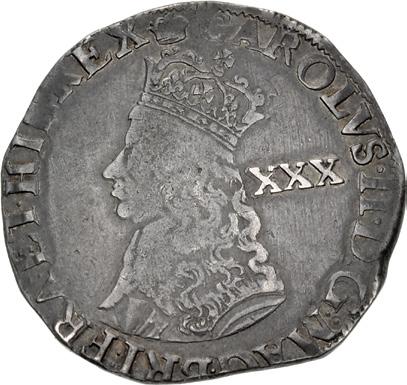
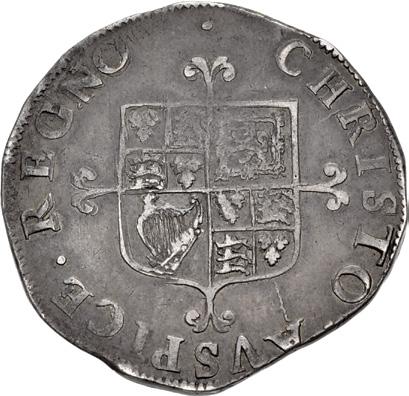
1245. STUART. Charles II. 1660-1685. AR Halfcrown (34mm, 14.62 g, 2h). Hammered coinage, second issue. Tower (London) mint; im: crown. Struck 1660-1662. Crowned bust left; XXX (mark of value) to right / Coat-of-arms over short cross moline. Bull 287; ESC 451; North 2760; SCBC 3313 . Toned. Good Fine. Very rare. ($1500)
Ex Westminster School (Sotheby’s, 26 May 1976), lot 499.
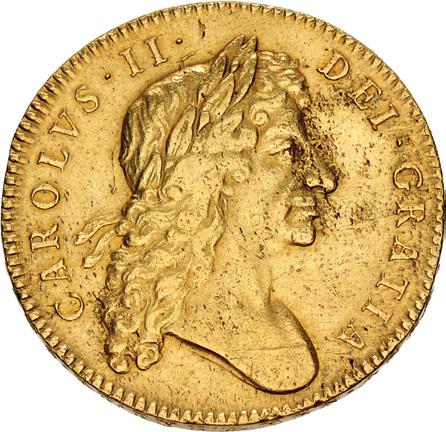

1246. STUART. Charles II. 1660-1685. AV Five Guineas. Dated 1684 and RY T. SEXTO. Bull, Gold 202; MCE 29; SCBC 3331. Toned. In NGC encapsulation 6874768-001, graded AU Details, cleaned. Rare. ($10,000)

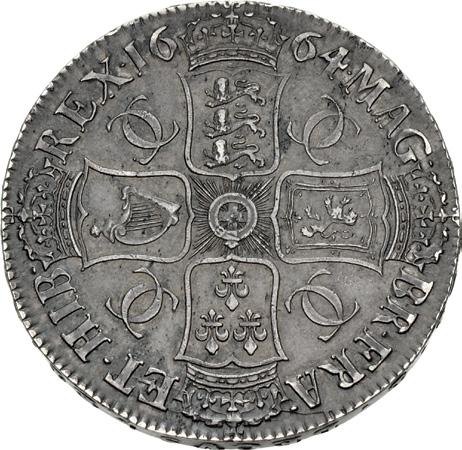
1247. STUART. Charles II. 1660-1685. AR Crown. Dated 1664 and RY XVI. Second bust. Die axis 4h. Bull 362; ESC 28; SCBC 3355. Some cabinet friction. Richly toned. Near EF. Very rare. ($4000)
Ex Gainsborough (Classical Numismatic Group 121, 8 October 2022), lot 1366.
Most unusual with 4 o’clock die alignment. See Spink 169, lot 271 for another example.
335
AU 58+ Five Guineas – Top Pop for First Bust Type
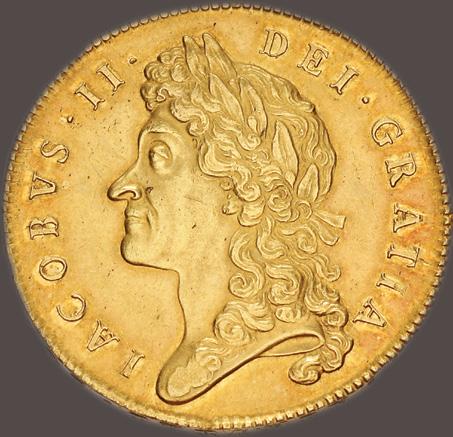
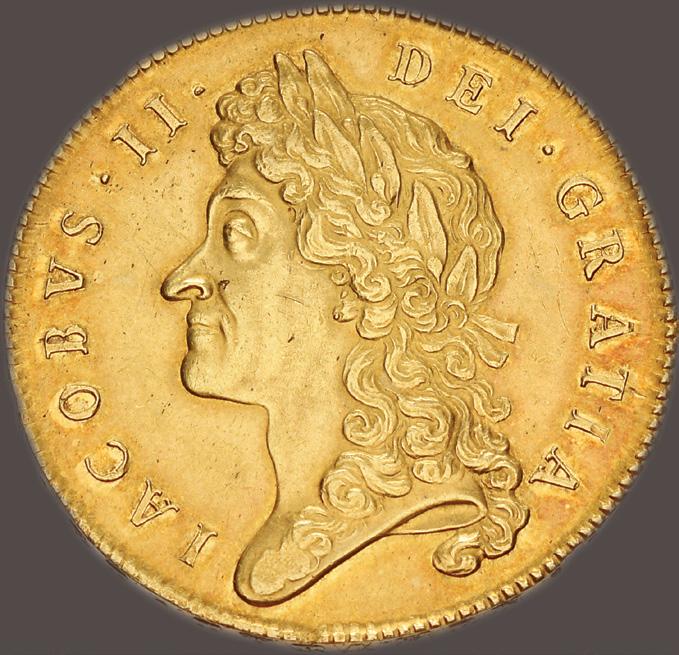
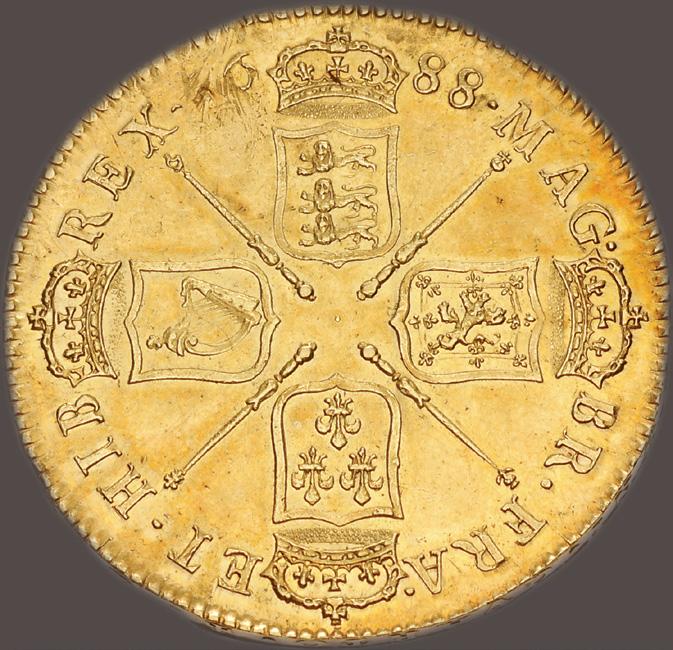


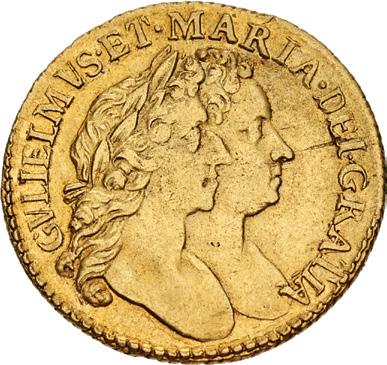
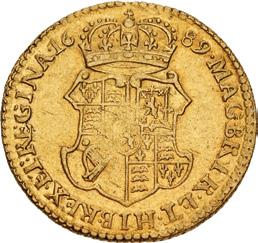
336
1248. STUART. James II. 1685-1688. AV 5 Guineas. Dated 1688 and RY QVARTO. First bust. Bull, Gold 316; MCE 119; SCBC 3397. Attractive orange toning and underlying brilliance. In NGC encapsulation 6891811-001, graded AU 58+. Rare. Top pop for the first bust type. ($30,000)
1249. STUART (ORANGE). William III & Mary. 1688-1694. AV Half Guinea. Dated 1689. First busts. Bull, Gold 380; MCE 161; SCBC 3429. Toned. In NGC encapsulation 6887461-002, graded XF Details, cleaned. Rare. ($1500)
Choice ‘Fine Work’ Five Guineas
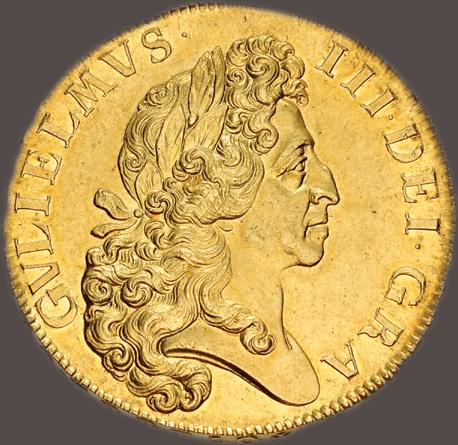
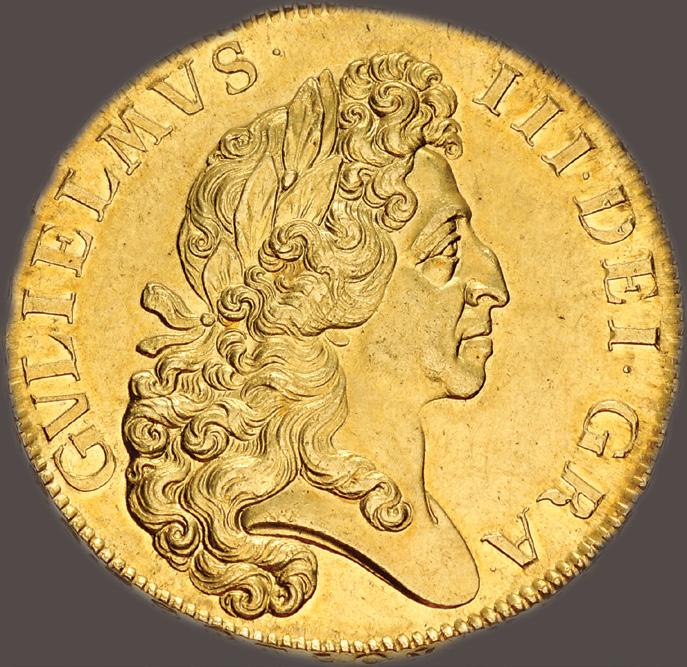


337
1250. STUART (ORANGE). William III. 1694-1702. AV 5 Guineas. Dated 1701 and RY DECIMO TERTIO. Second bust, plain scepters. A ‘Fine Work’ coin in high relief. Bull, Gold 400; MCE 172; SCBC 3456. Toned and lustrous. In PCGS encapsulation 49052751, graded MS 62. A most attractive specimen and rare in this condition. ($60,000)
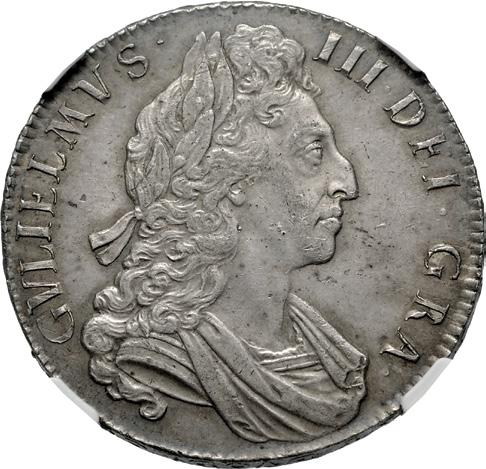

1251. STUART (ORANGE). William III. 1694-1702. AR Crown. Dated 1700 and RY DUODECIMO. Third bust. Bull 1010; ESC 97; SCBC 3474. In NGC encapsulation 4345392-001, graded MS 62. WINGS approved. ($1500)
From the Jonathan K. Kern Collection.

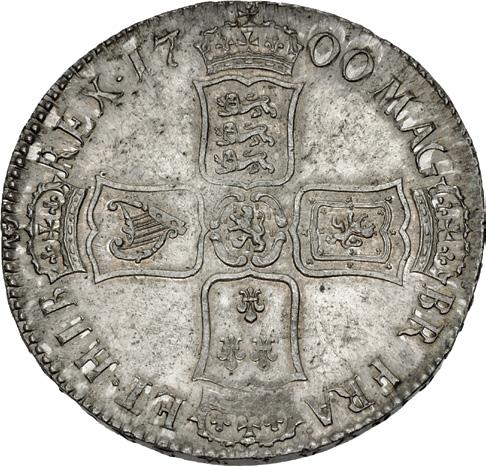
1252. STUART (ORANGE). William III. 1694-1702. AR Crown. Dated 1700 and RY DUODECIMO. Third bust. Bull 1010; ESC 97; SCBC 3474. Toned. In NGC encapsulation 6891668-003, graded MS 62. ($1500)
From the Alexander Christopher Collection.


1253. STUART (ORANGE). William III. 1694-1702. AR Halfcrown. Dated 1698 and RY DECIMO. Bull 1034; ESC 554; SCBC 3494. A superb example with iridescence toning, sharp details, and significant luster. In NGC encapsulation 3645306-008, graded MS 64. ($1000)
Ex Goldberg 81 (1 September 2014), lot 2224 (hammer $2,200).
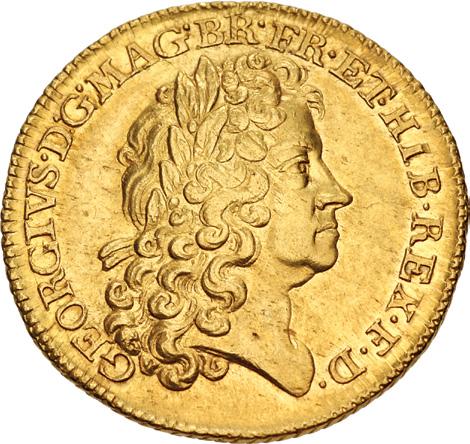
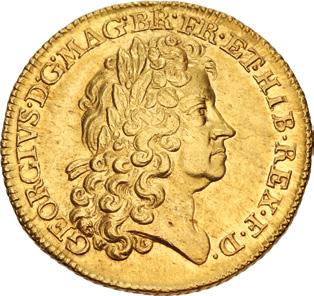
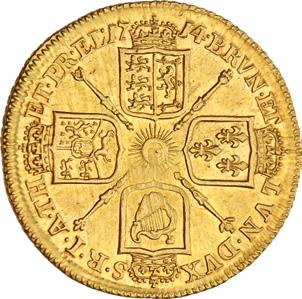

1254. HANOVER. George I. 1714-1727. AV Guinea. Dated 1714. ’Prince Elector’ type. Bull, Gold 502; MCE 245; SCBC 3628. In NGC encapsulation 6887461-011, graded UNC Details, cleaned. Rare one year type. ($3000)
338
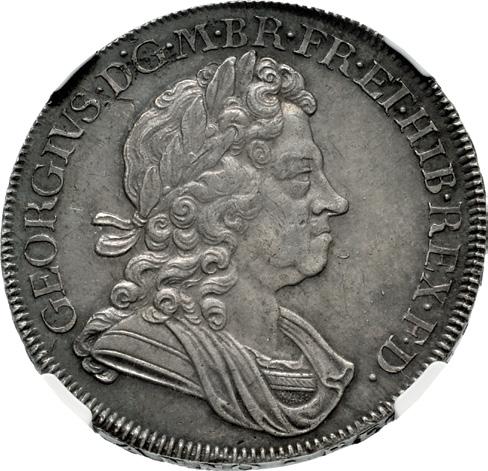
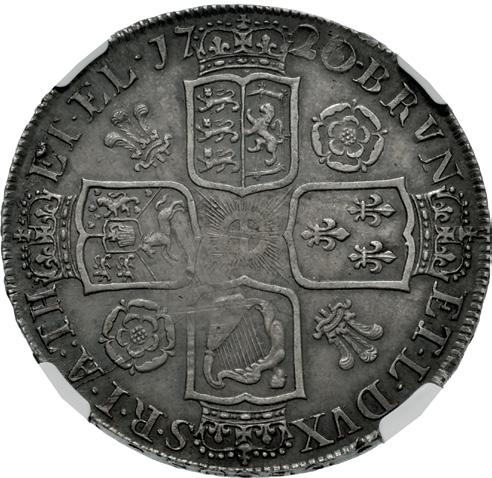
Well Struck East India Company Five Guineas

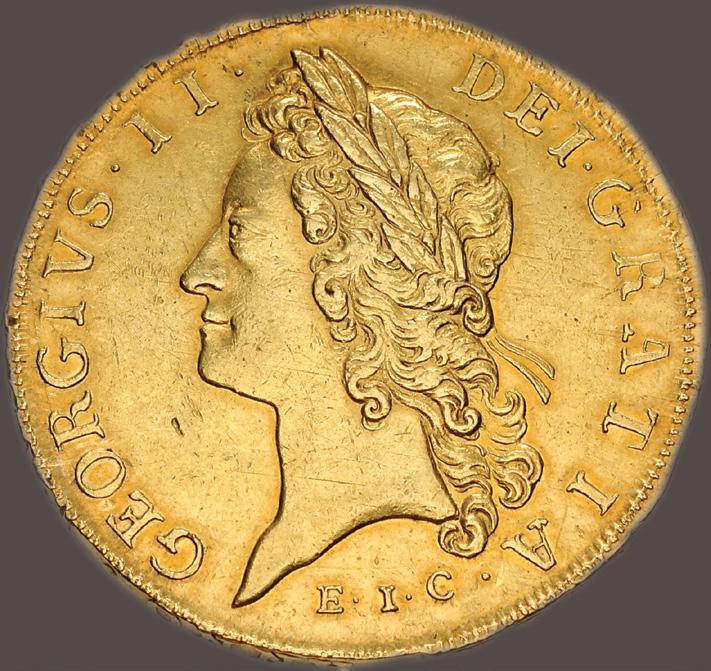

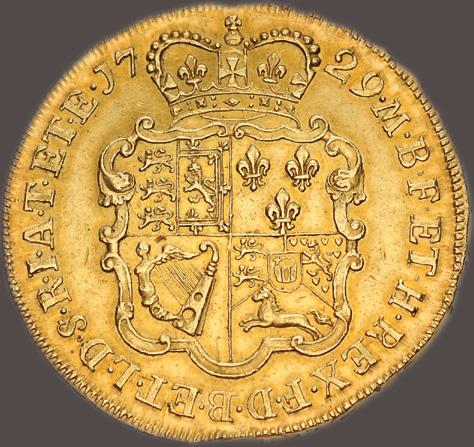
339
1255. HANOVER. George I. 1714-1727. AR Crown. Dated 1720/18 and RY SEXTO. Roses & plumes. Bull 1543; ESC 113; SCBC 3639. Toned. In NGC encapsulation 6622434-004, graded UNC Details, obverse scratched. ($1000)
1256. HANOVER. George II. 1727-1760. AV 5 Guineas. Dated 1729 EIC and RY TERTIO. Young head. Bull, Gold 553; MCE 279; SCBC 3664. In NGC encapsulation 6877152-001, graded AU 58. ($25,000)

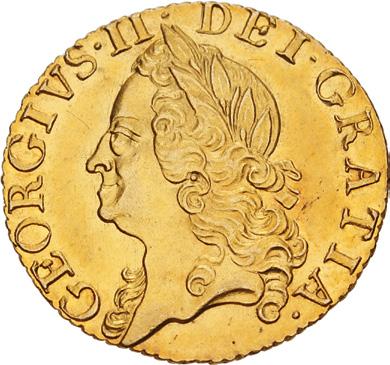

1257. HANOVER. George II. 1714-1727. AV Half Guinea. Dated 1760. Old head. Bull, Gold 662; MCE 366; SCBC 3685. In NGC encapsulation 6887461-014, graded MS 62. ($3000)
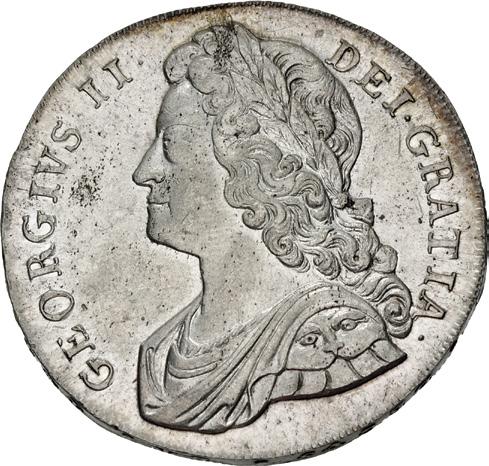
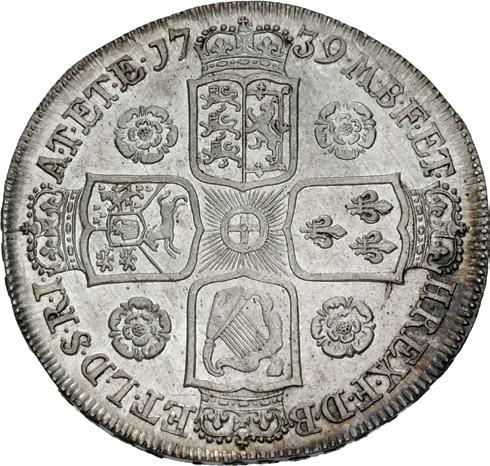
1258. HANOVER. George II. 1727-1760. AR Crown. Dated 1739 and DVODECIMO. Young head. Roses in angles. Bull 1665; ESC 122; SCBC 3687. Light golden toning. In NGC encapsulation 6891668-002, graded MS 62. ($2000)
From the Alexander Christopher Collection.
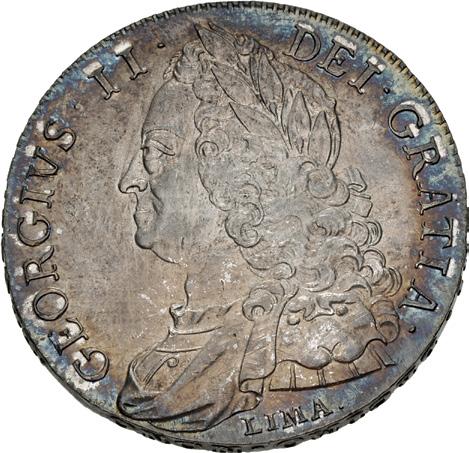
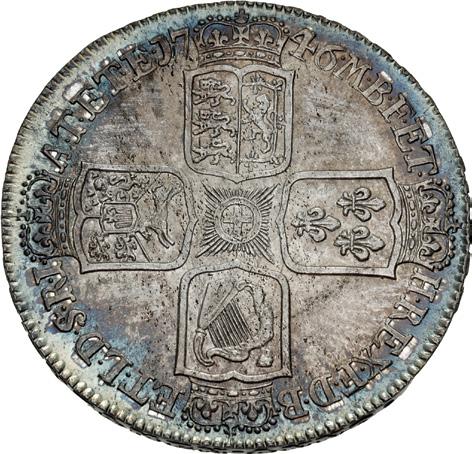
1259. HANOVER. George II. 1727-1760. AR Crown. Dated 1746 LIMA and RY D. NONO. Old head. Bull 1668; EMC 125; SCBC 3689. Toned. In NGC encapsulation 6891668-004, graded MS 61. ($1500)
From the Alexander Christopher Collection.

Proof Guinea

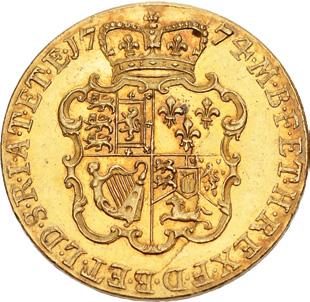
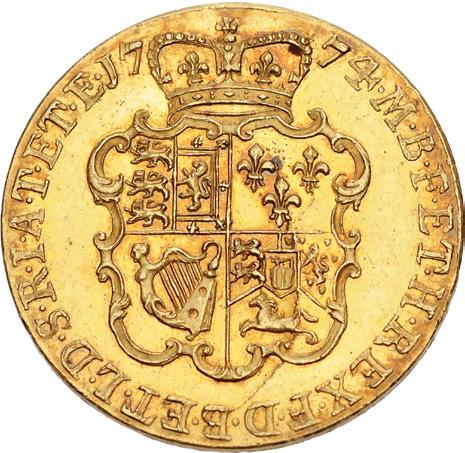
1260. HANOVER. George III. 1760-1820. Proof AV Guinea. Dated 1774. Fourth bust. No die flaw in field. W&R 95; Bull, Gold 690; MCE 379; SCBC 3728. Richly toned. In NGC encapsulation 6887461-012, graded PF 62+. ($7500)
340

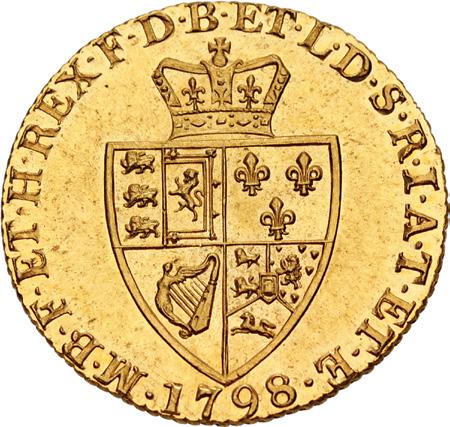
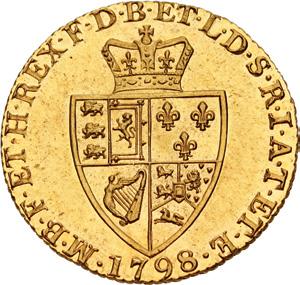
1261. HANOVER. George III. 1760-1820. AV Guinea. Dated 1798. Fifth bust. Spade type. Bull, Gold –; MCE 402; SCBC 3729. In NGC encapsulation 6887461-001, graded MS 65. ($2000)
Bull does not record an example of the 1798 guinea without any flaws or repunching in the date, as on this specimen.

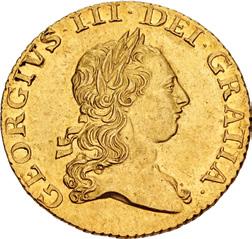
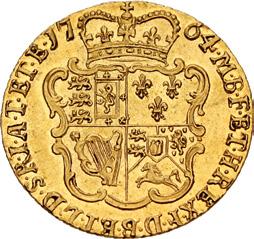

1262. HANOVER. George III. 1760-1820. AV Half Guinea. Dated 1764. Second bust, large crown. Bull, Gold 801; MCE 407; SCBC 3732. In NGC encapsulation 6887461-005, graded UNC Details. ($1500) Ex R. Sweetnam (Spink 21004, 17 January 2021), lot 59 (where graded NGC MS 62).
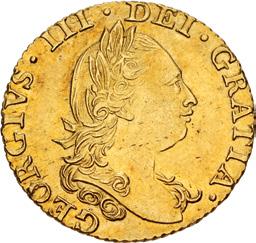

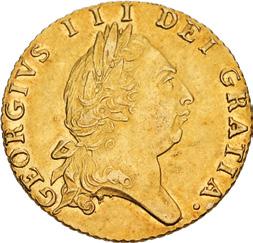
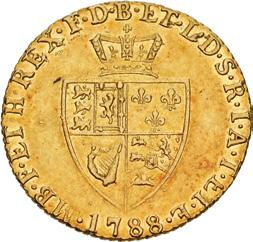
1263. HANOVER. George III. 1760-1820. AV Half Guinea. Dated 1775. Fourth bust, stringy love lock. Bull, Gold 815; MCE 418; SCBC 3734. In NGC encapsulation 6887461-015, graded MS 61. ($1000)
1264. HANOVER. George III. 1760-1820. AV Half Guinea. Dated 1788. Fifth bust, Spade type. Bull, Gold 830; MCE 427; SCBC 3735. In NGC encapsulation 6887461-013, graded AU 58. Rare. ($1000)
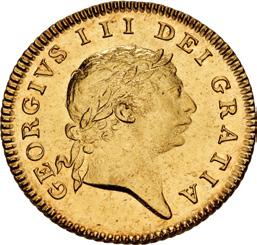
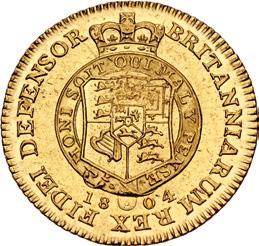

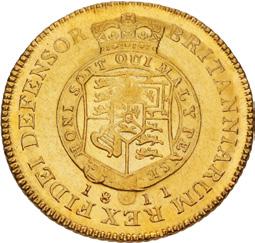
1265. HANOVER. George III. 1760-1820. AV Half Guinea. Dated 1804. Seventh bust. Bull, Gold 849; MCE 442; SCBC 3737. In NGC encapsulation 6887556-001, graded MS 63. ($750)
1266. HANOVER. George III. 1760-1820. AV Half Guinea. Dated 1811. Seventh bust. Bull, Gold 857; MCE 447; SCBC 3737. In NGC encapsulation 6887556-004, graded MS 61. ($500) 1263 1264 1265
341
1266

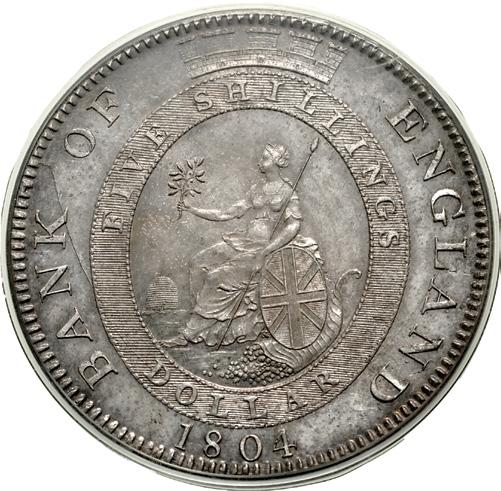


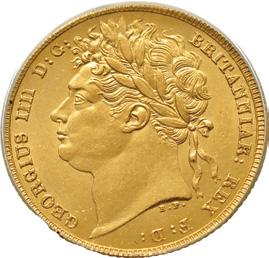
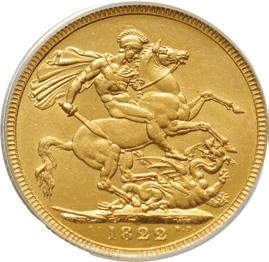
Ex Spink 4 (22 February 1979), lot 908.
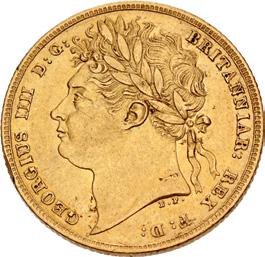

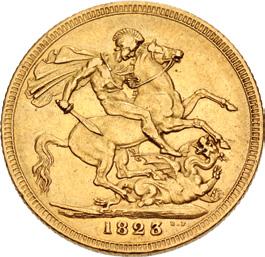

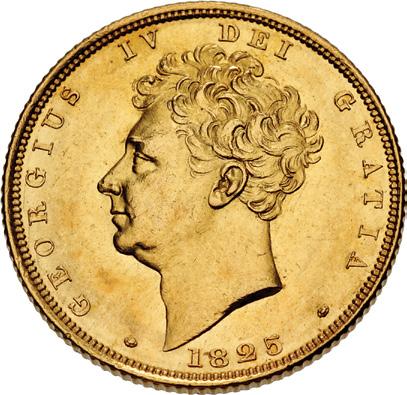
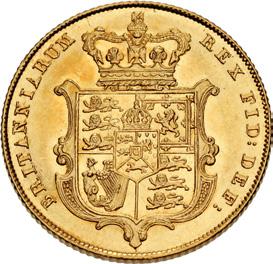
342
1267. HANOVER. George III. 1760-1820. AR Dollar. Dated 1804. No stop after REX. Bull 1951; ESC 164; SCBC 3768. Toned. In PCGS encapsulation 9456437, graded MS 64. ($1000)
From the Alexander Christopher Collection. Ex Stack’s (2 December 1998), lot 674.
1268. HANOVER. George IV. 1820-1830. AV Sovereign. Dated 1821. St. George type. Marsh 5; SCBC 3800. In NGC encapsulation 6887461-009, graded MS 61. ($1500)
1269. HANOVER. George IV. 1820-1830. AV Sovereign. Dated 1822. St. George type. Marsh 6; SCBC 3800. In ANACS encapsulation 7459447, graded MS 61. ($1500)
1270. HANOVER. George IV. 1820-1830. AV Sovereign. Dated 1823. St. George type. Marsh 7; SCBC 3800. In NGC encapsulation 6887461-010, graded AU Details, obv. rim damage. Rare date. ($1500)
1271. HANOVER. George IV. 1820-1830. AV Sovereign. Dated 1825. Shield type. Marsh 10; SCBC 3801. In NGC encapsulation 6887556-002, graded MS 61. ($1500)
1268
1269


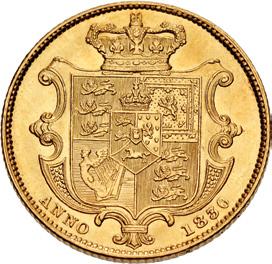
1272. HANOVER. William IV. 1830-1837. AV Sovereign. Dated 1836. Flawed 6 in date. Marsh 20; SCBC 3829B. In NGC encapsulation 6887461-004, graded AU 58. ($2000)
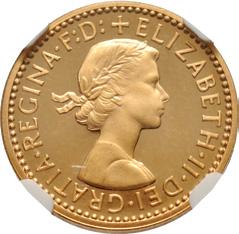
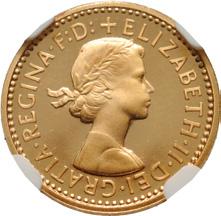


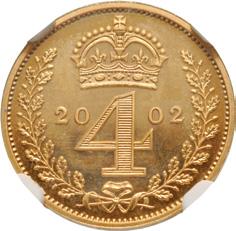
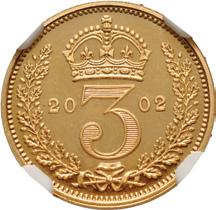
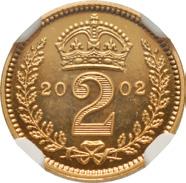

1273. WINDSOR. Elizabeth II. 1952-2022. Proof AV Maundy Set. Dated 2002. Includes: Proof AV Fourpence. In NGC encapsulation 2144274-042, graded PF 67 Ultra Cameo // Proof AV Threepence. In NGC encapsulation 2144274-043, graded PF 68 Ultra Cameo // Proof AV Twopence. In NGC encapsulation 2144274-044, graded PF 67 Ultra Cameo // Proof AV Penny. in NGC encapsulation 2144274-045, graded PF 68 Ultra Cameo. Four (4) coins in lot. ($1000)
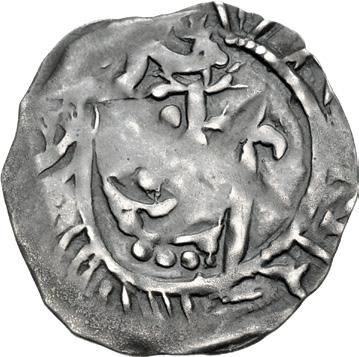
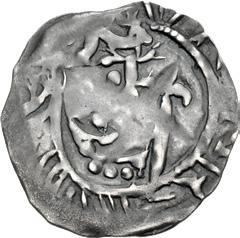
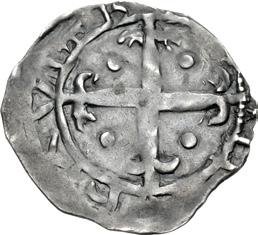
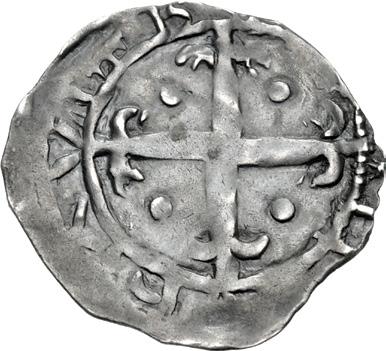
1274. SCOTLAND. David I. 1124-1153. AR Penny (20mm, 1.40 g). Period D. Uncertain mint and moneyer. Posthumous issue, struck 1153-1165. Crowned bust right; lis-tipped scepter to right / Cross moline; pellets in angles. Cf. Burns 13 (fig. 14A; for type); cf. SCBI 35 (Ashmolean & Hunterian), 9-11 (for type); SCBC 5009. Richly toned, some ghosting. VF. A lovely example of this crude type. ($2500)
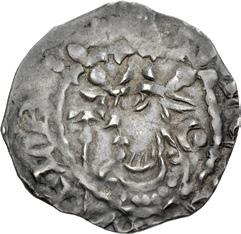


1275. SCOTLAND. William I ‘the Lion’. 1165-1214. AR Penny (20mm, 1.46 g, 1h). Cross and Pellet coinage, group II. Roxburgh mint; Raul, moneyer. Struck circa 1180-1195. Crowned head left; cross potent-tipped scepter to left; pellet-incresent over pellet to right / [ ม ʽ¥ ] ⎍⌦
[...], cross pattée crosslet; pellet-in-crescents in quarters. Burns 2; cf. SCBI 35 (Ashmolean & Hunterian), 34-9 (for type); SCBC 5024. Richly toned. VF. A good portrait of William paired with a clearly struck mint and moneyer. Rare. With an old ticket in the hand of Peter Seaby. ($1000)
Ex Seaby Coin & Medal Bulletin 399 (August 1951), no. Sc.6.
343
ዝģ ʽɭýģዛ⎍
a b c d
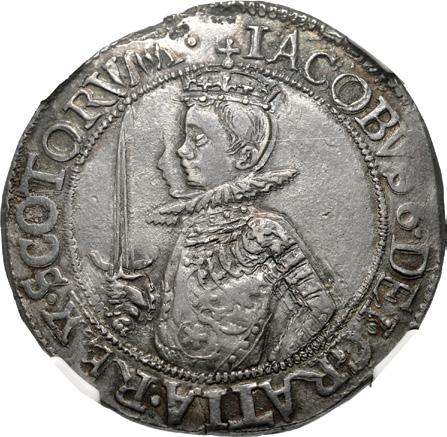
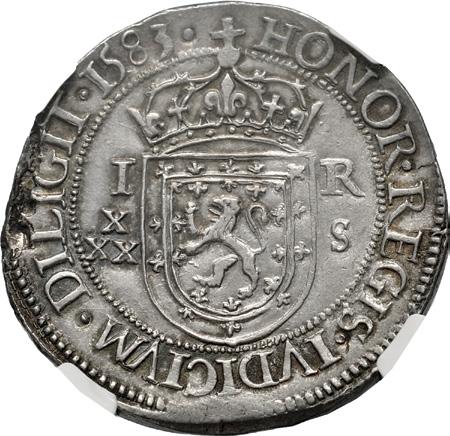
1276. SCOTLAND. James VI. 1567-1625. AR 30 Shillings (36mm, 4h). Fourth coinage. Edinburgh mint. Dated 1583. Crowned and armored half-length bust left, wearing ruff and holding sword / Crowned coat-of-arms; I R and X/XX S (mark of value) across field. Burns 3 (fig. 933); SCBI 58 (Edinburgh), 1464-6; SCBC 5487. Toned. In NGC encapsulation 2478910001, graded AU 50. ($2000)
Ex Heritage 3099 (5 May 2022), lot 32484.

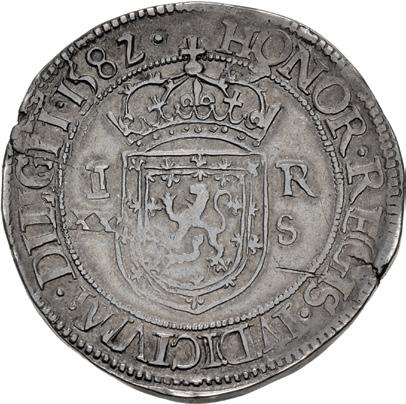
1277. SCOTLAND. James VI. 1567-1625. AR 20 Shillings (34mm, 15.33 g, 3h). Fourth coinage. Edinburgh mint. Dated 1582. Crowned and armored half-length bust left, wearing ruff and holding sword / Crowned coat-of-arms; XX S (mark of value) across field. Burns 1 (fig. 934); SCBI 58 (Edinburgh), 1474 (same rev. die); SCBC 5489. Richly toned, short scratch on reverse, double struck. Near VF. ($1000)

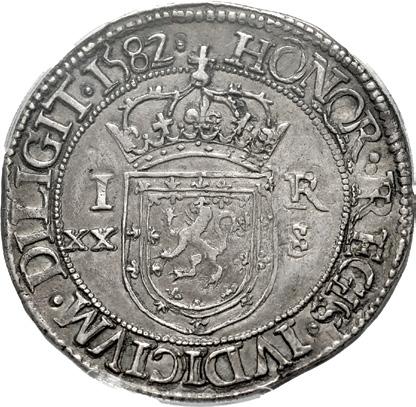
1278. SCOTLAND. James VI. 1567-1625. AR 20 Shillings (34mm, 14.96 g, 2h). Fourth coinage. Edinburgh mint. Dated 1582. Crowned and armored half-length bust left, wearing ruff and holding sword / Crowned coat-of-arms; I R and XX S (mark of value) across field. Burns 1 (fig. 934); SCBI 58 (Edinburgh), 1477-8 (same obv. die); SCBC 5489. Toned. In PCGS encapsulation 34613936, graded AU 50. ($2000)
Ex Jamestown Collection (Heritage 3064, 20 April 2018), lot 31643.
Third Known 1584 Twenty Shillings
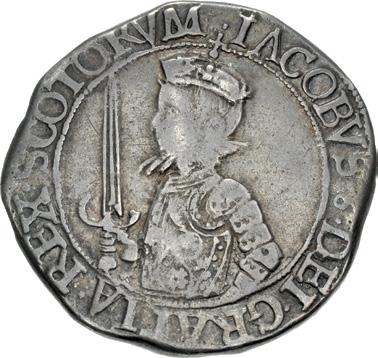
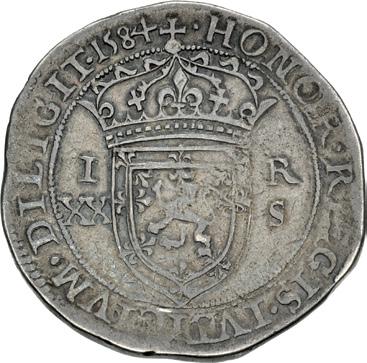
1279. SCOTLAND. James VI. 1567-1625. AR 20 Shillings (32mm, 15.06 g, 11h). Fourth coinage. Edinburgh mint. Dated 1584. Crowned and armored half-length bust left, wearing ruff and holding sword / Crowned coat-of-arms; I R and XX S (mark of value) across field. Burns –; SCBI 58 (Edinburgh), 1482 (same dies); SCBC 5489. Toned, minor edge mark. Fine. Extremely rare. ($1500)
Ex St. James’s 73 (15 March 2023), lot 102, purchased from Civitas Galleries. Only two other examples are known for this extremely rare date:
- H.M. Lingford (Part II, Glendining, 20 June 1951), lot 166 (part of) = SCBI 58 (Edinburgh), 1482
- Bridgewater House (Sotheby’s, 15 June 1972), lot 509
344
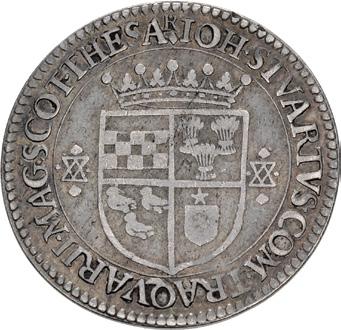
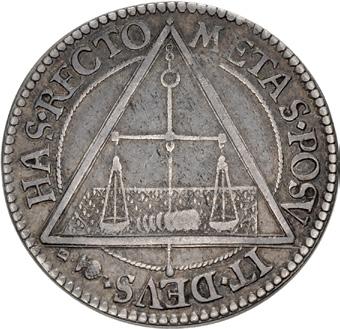
1280. SCOTLAND. John Stewart, Earl of Traquair and High Treasurer of Scotland. Circa 1599-1659. AR Jeton (28mm, 6.69 g, 6h). Edinburgh mint; mm: B and thistle. By N. Briot. Struck 1635. IOH · SVARTVS · COM · TRAQVAROO · MAG · SCOT · THESAR, crowned coat-of-arms; interlocking double triangles flanking / METAS · POSV IT · DEVS (small B over thistle) HAS · RECTO (lozenge stops), scales suspended from apex of triangle; below scales, a roll of coins set on a table diapered with lis. MI 276/77. Richly toned with traces of luster in legends. VF. Rare. ($750)
Very Rare Edward V Groat of Drogheda
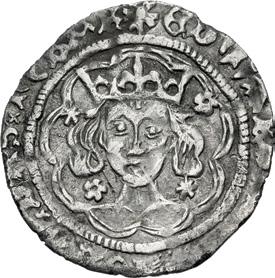

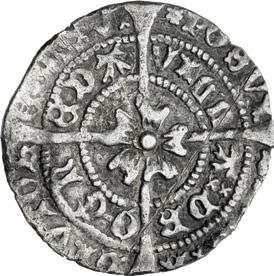
1281. IRELAND. Edward V. April–June 1483. AR Groat (23mm, 1.88 g, 10h). Suns and Roses/Rose on cross coinage. Drogheda mint. Crowned facing bust; stars to upper left and lower right, roses to upper right and lower left / Long cross pattée with rose at center. D&F 163 (Edward IV); SCBC 6392. Lightly toned, rough and porous, bent and flattened with associated stress cracks. VF. Very rare. ($2000)
In 1483, Edward IV prohibited the operations of the Drogheda mint. Accordingly, the Suns and Roses/Rose on cross groats and pennies must date to the brief reign of Edward V. The mint apparently took the king’s death as an opportunity to resume production.
Unrecorded Dated Bandon Bridge Farthing
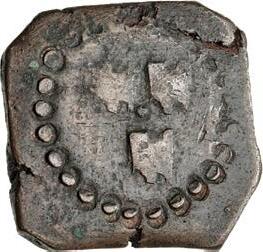
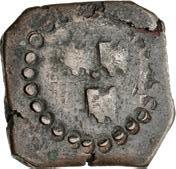
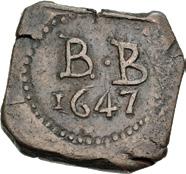

1282. IRELAND, The Great Rebellion. Issues of the ‘Cities of Refuge’. Bandon Bridge. 1642-1649. Æ Farthing (14mm, 2.32 g, 6h). Dated 1647. B • B/ 1647 / Three castles. An unrecorded dated issue, but cf. D&F 316 and SCBC 6560 for undated issue. Brown surfaces. VF. Extremely rare and apparently unrecorded. ($1500)
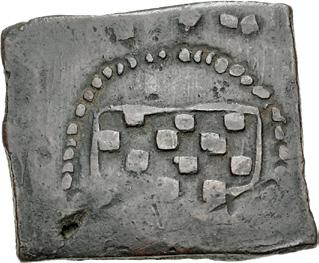
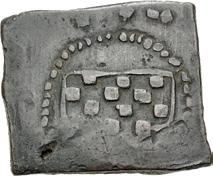

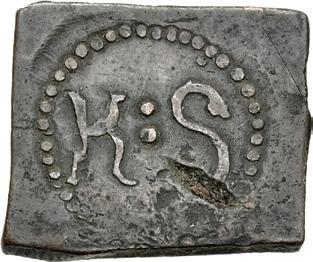
1283. IRELAND, The Great Rebellion. Issues of the ‘Cities of Refuge’. Kinsale. 1642-1649. Æ Farthing (16mm, 3.51 g, 12h). Coat-of-arms / K : S. D&F 318; SCBC 6563; Noonan’s 259, lot 786 (same dies). Brown surfaces, flan flaw. VF. Very rare this fine. ($1500)
345
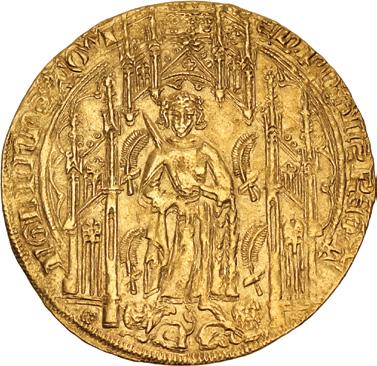
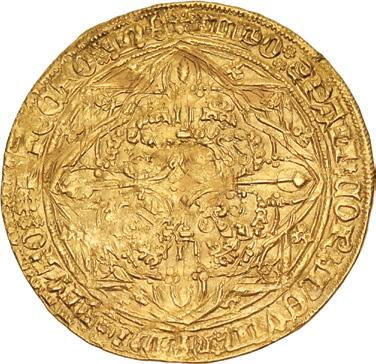
1284. ANGLO-GALLIC. Edward the Black Prince. As Prince of Aquitaine, 1362-1372. AV Noble guyennois à la rose – Pavillon d’or (31mm, 5.28 g, 4h). La Rochelle mint. Struck 1362(?). Edward wearing rose wreath, standing facing, holding sword up in right hand and raising left hand; at feet, two leopards couchant; to left and right, two ostrich feathers with tips curved inward; all within ornate Gothic portico / Ornate cross quernée with rose in center, lion passant and lis in opposite quarters; all within arched quatrefoil set on quadrate frame with roses in angles; pelleted cinquefoils in spandrals. AGC 157A, 8/o; cf. Schneider 47 (for type); SCBC 8123. In NGC encapsulation 6865696-046, graded MS 62. ($5000)
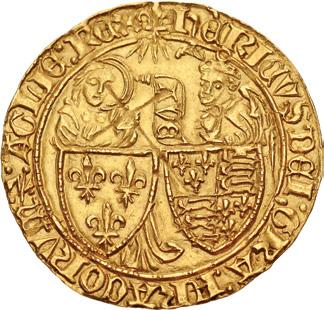


1285. ANGLO-GALLIC. Henry VI. 1422-1461. AV Salut d’or (27mm, 3.49 g, 2h). St. Lô mint. Struck 1422-1449. The Annunciation: the Virgin standing right, receiving tablet inscribed ¥ѝĚ from the Archangel Gabriel standing left; heavenly light above, two coats-of-arms below; annulet under third letter / Latin cross, with lis to left, lion passant guardant to right, and ƌ below; all within polylobe, with lis in each point; annulet under third letter. AGC 387B, 1/a; Beresford-Jones, Salutes 553/562; Schneider 122; SCBC 8164. In NGC encapsulation 6887461-007, graded MS 64. ($2000)
A rarer variety reading hERIC for hENRIC.
BRITISH MEDALS

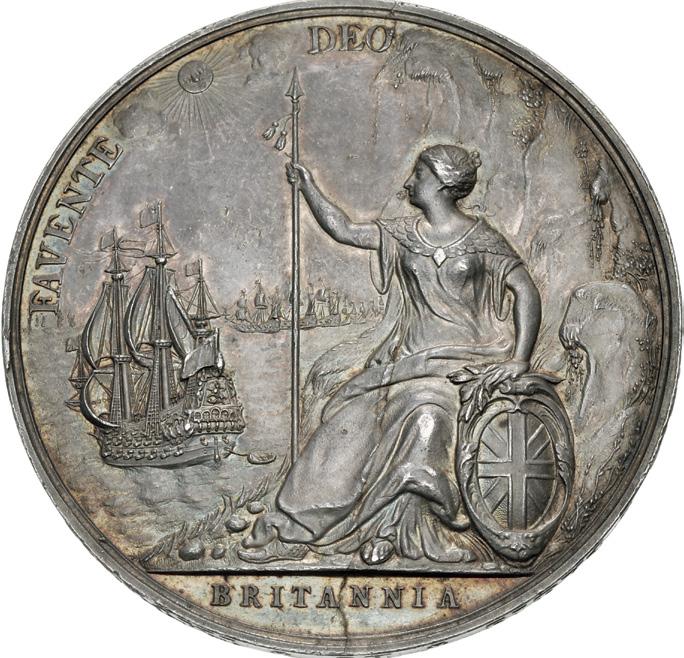
1286. STUART. Charles II. 1660-1685. AR Medal (56mm, 74.68 g, 12h). The Treaty of Breda – Peace with Holland. By J. Roettier. Struck 1667. * CAROLVS · SECVNDVS · DEI · GRATIA · MAG · BRI · FRAN · ET · HIB · REX, laureate head right / FAVENTE DEO, Britannia seated left on seashore, viewing fleet under sail left; favorable sun piercing through clouds; BRITANNIA in exergue. MI 535/186; Eimer 241. Attractively toned, slight cabinet friction and light contact marks, usual die flaw in hair. EF. ($1000)
End of Session 4
346
GENERAL BIBLIOGRAPHY
Please refer to our online bibliography at www.cngcoins.com for a complete listing of specialized and general references used, and abbreviations.
ANCIENT
Banti A. Banti. I grandi bronzi imperiali 9 Vols. Florence. 1983-1986.
BMC Various authors. Catalogue of Greek Coins in the British Museum. 29 Vols. London. 1873-1927.
BMCRE H. Mattingly et al. Coins of the Roman Empire in the British Museum. 6 Vols. London. 1932-1962.
BN J. Giard. Bibliothèque Nationale, catalogue des monnaies de l’empire romain 3 Vols. Paris. 1976-present.
Bodenstedt F. Bodenstedt. Die Elektronmünzen von Phokaia und Mytilene. Tübingen. 1981.
Boehringer E. Boehringer. Die Münzen von Syrakus. Berlin and Leipzig. 1929.
Bopearachchi O. Bopearachchi. Monnaies Gréco-Bactriennes et Indo-Grecques. Paris. 1991.
Depeyrot G. Depeyrot. Les monnaies d’or (Diocletian à Constantin I, Constantin II à Zenon). Wetteren. 1995-1996.
Calicó X. Calicó. The Roman avrei catalogue 2 Vols. Barcelona. 2002.
CNS R. Calciati. Corpus Nummorum Siculorum: la monetazione di bronzo. 3 Vols. Italy. 1983-87.
Crawford M. Crawford. Roman Republican Coinage. 2 Vols. Cambridge. 1974.
CRI D. Sear. The History and Coinage of the Roman Imperators 49-27 BC. London. 1998.
Fischer-Bossert W. Fischer-Bossert. Chronologie der Didrachmenprägung von Tarent 510-280 v.Chr. Berlin 1999. Flament C. Flament. Le monnayage en argent d’Athènes. De l’époque archaïque à l’époque hellénistique (c. 550-c. 40 av. J.-C.). Lovainla-Neuve. 2007.
Hendin D. Hendin. Guide to Biblical Coins. 6th Edition. New York. 2021.
HN Italy N.K. Rutter, ed. Historia Numorum. Italy. London. 2001.
Kumar S. Kumar. Treasures of the Gupta Empire. A Catalogue of Coins of the Gupta Dynasty. San Francisco. 2017.
Meshorer Y. Meshorer. A Treasury of Jewish Coins from the Persian Period to Bar Kokhba. Jerusalem. 2001.
MK R. Göbl. Münzprägung des Kušanreiches. Vienna. 1984.
MIR R. Göbl, et al. Moneta Imperii Romani. Vienna. 1984-present.
Price M.J. Price. The Coinage in the Name of Alexander the Great and Philip Arrhidaeus. London. 1991.
Prieur M. Prieur. A type corpus of the Syro-Phoenician tetradrachms and their fractions from 57 BC to AD 253. Lancaster. 2000.
RIC H. Mattingly, et al. The Roman Imperial Coinage. 10 Vols in 13 Parts. London. 1923-present.
RPC A. Burnett, et al. Roman Provincial Coinage. London and Paris. 1992-present.
RSC D. Sear, et al. Roman Silver Coins 5 Vols. London. 1978-1987.
SC A. Houghton & C. Lorber. Seleucid Coins: A Comprehensive Catalog. 2 Parts. Lancaster. 2002 and 2008.
Sellwood D. Sellwood. An Introduction to the Coinage of Parthia. 2nd edition. London. 1980.
SNG ANS Sylloge Nummorum Graecorum, American Numismatic Society. New York. 1969-present.
SNG BM Black Sea Sylloge Nummorum Graecorum, British Museum, 1: The Black Sea. London. 1993.
SNG Copenhagen Sylloge Nummorum Graecorum, Danish National Museum Copenhagen. 1942-1979.
SNG BN Sylloge Nummorum Graecorum, Cabinet des Médailles, Bibliothèque Nationale. Paris. 1993-2001.
SNG Kayhan Sylloge Nummorum Graecorum, Turkey I: The Muharrem Kayhan Collection. 2 Vols. Istanbul. 2002 and 2015.
SNG Levante Sylloge Nummorum Graecorum, Switzerland; E Levante - Cilicia Bern. 1986.
SNG Lloyd Sylloge Nummorum Graecorum, Lloyd Collection. London. 1933-1937.
SNG Lockett Sylloge Nummorum Greacorum, Lockett Collection. London. 1938-1949.
SNG München Sylloge Nummorum Graecorum, München Staatlische Münzsammlung Berlin. 1968-present.
SNG von Aulock Sylloge Nummorum Graecorum, Sammlung Hans Von Aulock. Berlin. 1957-1968.
Starr C. Starr. Athenian coinage 480-449 BC. London. 1970.
Svoronos J. Svoronos. Τὰ νομίσματα τοῦ κράτους τῶν Πτολεμαίων. Athens. 1904-08.
Traité E. Babelon. Traité des monnaies grecques et romaines. 9 Vols. Paris. 1901-1932.
Weidauer L. Weidauer. Probleme der frühen Elektronprägung Fribourg. 1975.
BYZANTINE, MEDIEVAL, WORLD, and BRITISH
Album S. Album. A Checklist of Popular Islamic Coins 3rd ed. Santa Rosa. 2011. Biaggi E. Biaggi. Monete e zecche medievali italiane dal seculo VIII al seculo XV. Torino. 1992.
Bitkin V. Bitkin. Composite Catalogue of Russian Coins. 2 vols. Kiev. 2003.
BMC Vandals W. Wroth. Catalogue of the Coins of the Vandals, Ostrogoths and Lombards and of the Empires of Thessalonica, Nicaea and Trebizond in the British Museum. London. 1911. (Reprinted as Western and Provincial Byzantine Coins in the British Museum.)
CIS S. Goron and J.P. Goenka. The Coins of the Indian Sultanates. New Delhi. 2001.
CNI Corpus Nummorum Italicorum. 20 Vols. Rome. 1910-1943.
Davenport J.S. Davenport. Various works on European crowns.
ESC H.A. Seaby & P.A. Rayner. The English Silver Coinage from 1649 London. 1992.
Friedberg R. Friedberg. Gold Coins of the World. 8th ed. Clifton. 2009.
KM C.L. Krause & C. Mishler. Standard Catalogue of World Coins. Krause Publications. Iola.
Levinson R.A. Levinson. The Early Dated Coins of Europe. Clifton, NJ. 2007.
Lunardi G. Lunardi. Le monete delle repubblica di genova. Genoa. 1975.
MEC P. Grierson & M. Blackburn. Medieval European Coinage. Cambridge. 1986.
MIB W. Hahn. Moneta Imperii Byzantini 3 Vols. Vienna. 1973-81.
MIBE W. Hahn and M.A. Metlich. Money of the Incipient Byzantine Empire. Vienna. 2000.
MIR Various. Monete Italiane Regionali. 5 Vols. Pavia. ND.
NM G. Depeyrot. Le numéraire mérovingien. 5 vols. Wetteren. 1998-2001.
North J.J. North. English Hammered Coinage. 2 Vols. London. 1963, 1975.
SB D. Sear, et al. Byzantine Coins and Their Values 2nd edition. London. 1987.
SCBC Standard Catalogue of British Coins. London. Annually.
SCBI Various authors. Sylloge of the Coins of the British Isles.
347
348
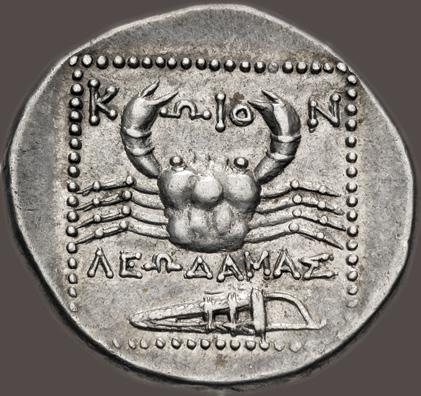
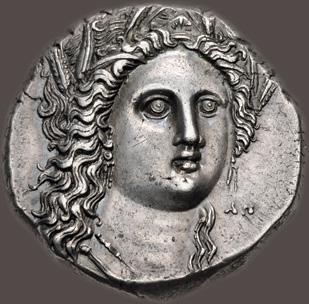
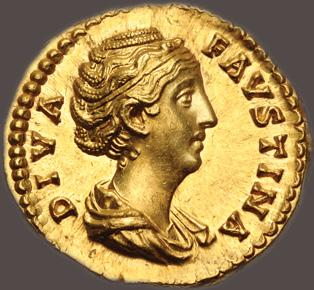
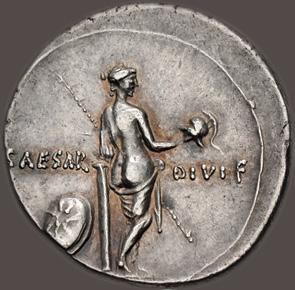
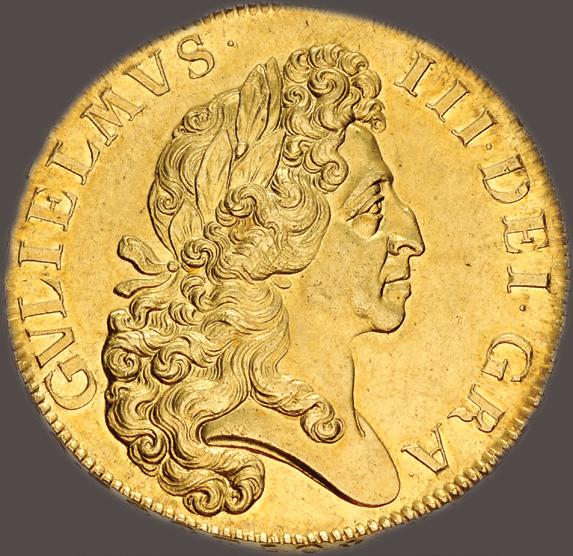


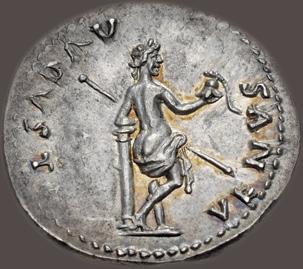


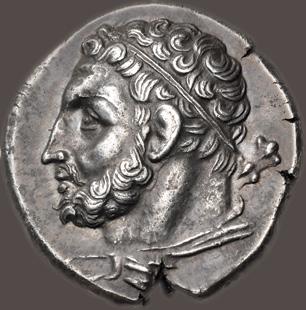
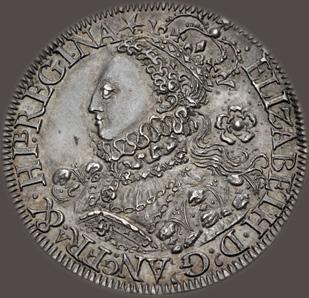

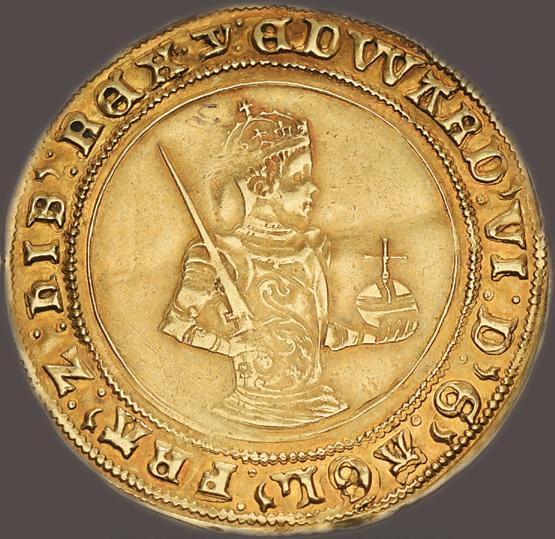
CNG Classical Numismatic Group, LLC Classical Numismatic Group, LLC (PA License Number AY002406) Jeffrey B. Rill (PA License No. AU006206); Brian Callahan (PA License No. AU005870) US OFFICE PO Box 479, Lancaster, PA 17608-0479 Phone (717) 390.9194 Fax (717) 390.9978 UK OFFICE 20 Bloomsbury Street, London WC1B 3QA, UK Phone +44.20.7495.1888 Fax +44.20.7499.5916 EU OFFICE Noordeinde 64a, 2514GK, The Hague, NL Phone +31.851.301.541 EMAIL & WEBSITE Email cng@cngcoins.com Website www.cngcoins.com



















 Mike Gasvoda Managing Director Lancaster Office
Victor England Consulting Director Lancaster Office
Eric McFadden Consulting Director London Office
Dave Michaels Director Shows & Consignments Lancaster Office
Caroline Holmes Numismatist London Office
Lance Hickman Managing Numismatist Consignment Staff Lancaster Office
Steve Lloyd Numismatist Islamic Specialist London Office
Julian Okun-Dubitsky Numismatist Lancaster Office
Jeffrey B. Rill Numismatist Lancaster Office
Bill Dalzell Managing Numismatist Cataloging Staff Lancaster Office
Bradley R. Nelson Senior Numismatist Lancaster Office
D. Scott VanHorn Senior Numismatist Lancaster Office
David Guest Director, London London Office
Paul Hill Director, London London Office
Max Tursi Director, EU EU Office
Tom Mullally Numismatist Lancaster Office
Mike Gasvoda Managing Director Lancaster Office
Victor England Consulting Director Lancaster Office
Eric McFadden Consulting Director London Office
Dave Michaels Director Shows & Consignments Lancaster Office
Caroline Holmes Numismatist London Office
Lance Hickman Managing Numismatist Consignment Staff Lancaster Office
Steve Lloyd Numismatist Islamic Specialist London Office
Julian Okun-Dubitsky Numismatist Lancaster Office
Jeffrey B. Rill Numismatist Lancaster Office
Bill Dalzell Managing Numismatist Cataloging Staff Lancaster Office
Bradley R. Nelson Senior Numismatist Lancaster Office
D. Scott VanHorn Senior Numismatist Lancaster Office
David Guest Director, London London Office
Paul Hill Director, London London Office
Max Tursi Director, EU EU Office
Tom Mullally Numismatist Lancaster Office















 Steve Pruzinsky Chief Financial Officer Lancaster Office
Kate Rill Customer Relations Manager Lancaster Office
David James III Photographer Lancaster Office
Dylan Ossman Office Manager Lancaster Office
Julia Motter Shipping Lancaster Office
Jennifer Ventura Shipping Lancaster Office
Dawn Ahlgren Shipping Lancaster Office
Lynn Gasvoda Administrative Assistant Lancaster Office
Travis Markel Manager IT & Production Lancaster Office
Christian Ventura Photographer Lancaster Office
Veronica Morris Office Manager London Office
Sharon Pruzinsky Accounting Lancaster Office
Bryan Kohn Numismatist Lancaster Office
Kan Liu (Vera) Consignments and Marketing Lancaster Office
Daniel Burch Numismatist Lancaster Office
Katie Vint Numismatist Lancaster Office
Steve Pruzinsky Chief Financial Officer Lancaster Office
Kate Rill Customer Relations Manager Lancaster Office
David James III Photographer Lancaster Office
Dylan Ossman Office Manager Lancaster Office
Julia Motter Shipping Lancaster Office
Jennifer Ventura Shipping Lancaster Office
Dawn Ahlgren Shipping Lancaster Office
Lynn Gasvoda Administrative Assistant Lancaster Office
Travis Markel Manager IT & Production Lancaster Office
Christian Ventura Photographer Lancaster Office
Veronica Morris Office Manager London Office
Sharon Pruzinsky Accounting Lancaster Office
Bryan Kohn Numismatist Lancaster Office
Kan Liu (Vera) Consignments and Marketing Lancaster Office
Daniel Burch Numismatist Lancaster Office
Katie Vint Numismatist Lancaster Office










































































































































































































































































































































































































































































































































































































































































































































































































































































































































































































































































































































































































































































































































































































































































































































































































 Further Selections from the Dr. Thomas E. Beniak Collection
Further Selections from the Dr. Thomas E. Beniak Collection




















































































































































































































































































































































































































































































































































































































































































































































































































































































































































































































































































































































































































































































































































































































































































































































































































































































































































































































































































































































































































































































































































































































